17TH & 18TH MAY 2023
LIVE IN EDINBURGH & ONLINE
& A PRIVATE COLLECTION OF SEALS: HIGHLIGHTS FROM THE MATRIX COLLECTION 19TH MAY 2023
LIVE ONLINE
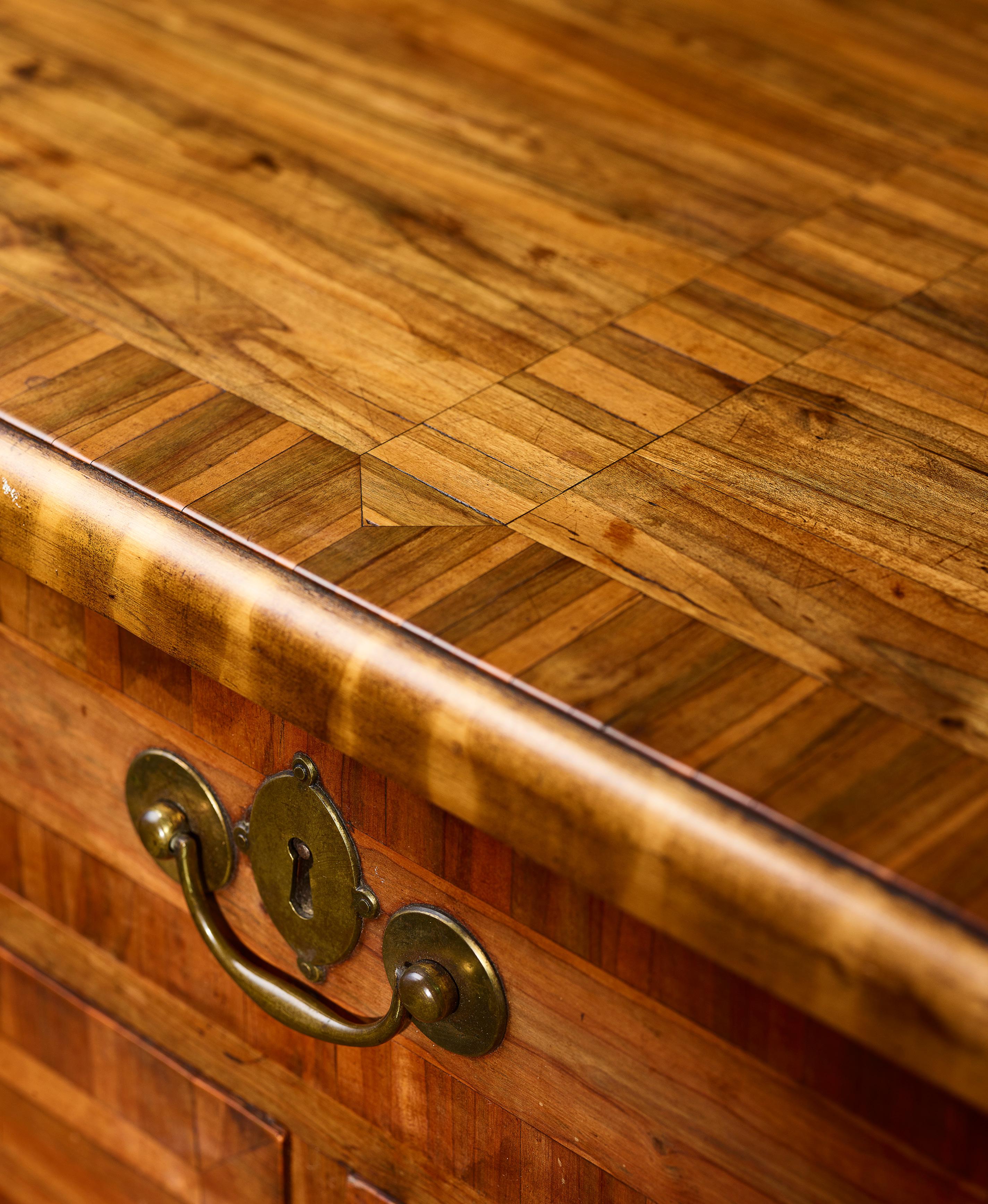

Front Cover Lot 64 [detail]
Inside Front Cover Lot 141 [detail, modified]
WEDNESDAY 17
Sale Number LT734
VIEWING
Saturday 13th May 12 noon-4pm
Sunday 14th May 12 noon-4pm
Monday 15th May 10am-5pm
& THURSDAY
18 MAY 2023 AT 10AM
& Turnbull 33 Broughton Place EDINBURGH EH1 3RR CONTACT EDINBURGH +44 (0) 131 557 8844 LONDON +44 (0) 207 930 9115
Tuesday 16th May 10am-5pm Days of sale from 9am Lyon
info@lyonandturnbull.com
BUYER'S GUIDE
This sale is subject to our Standard Conditions of Sale (available at the back of every catalogue and on our website).
If you have not bought at auction before we will be delighted to help you.
BUYER’S PREMIUM
The buyer shall pay the hammer price together with a premium, at the following rate, thereon:
26% up to £20,000
25% from £20,001 to £500,000 20% thereafter.
VAT will be charged on the premium at the rate imposed by law (see our Conditions of Sale at the back of this catalogue).
ADDITIONAL VAT
† VAT at the standard rate payable on the hammer price
‡ Reduced rate of 5% import VAT payable on the hammer price
Ω Standard rate of import VAT on the hammer price
Lots affixed with ‡ or [Ω] symbols may be subject to further regulations upon export /import, please see Conditions of Sale for Buyers Section D.2.
No VAT is payable on the hammer price or premium for books bought at auction.
DROIT DE SUITE
§ indicates works which may be subject to the Droit de Suite or Artist’s Resale Right, a royalty payment for all qualifying works of art. Under new legislation which came into effect on 1st January 2012, this applies to living artists and artists who have died in the last 70 years. This royalty will be charged to the buyer on the hammer price and in addition to the buyer’s premium. It will not apply to works where the hammer price is less than €1,000 (euros). The charge for works of art sold at and above €1,000 (euros) and below €50,000 (euros) is 4%. For items selling above €50,000 (euros), charges are calculated on a sliding scale. More information on Droit de Suite is available at www.dacs.org.uk
REGISTRATION
All potential buyers must register prior to placing a bid. Registration information may be submitted in person at our registration desk, by email, or on our website. Please note that first-time bidders, and those returning after an extended period, will be asked to supply the following documents in order to facilitate registration:
1 – Government issued photo ID (Passport/Driving licence)
2 – Proof of address (utility bill/bank statement).
We may, at our option, also ask you to provide a bank reference and/ or deposit. (Particularly for bidding on lots marked by the high value lot symbol ) By registering for the sale, the buyer acknowledges that he or she has read, understood and accepted our Conditions of Sale (available at the back of every catalogue and on our website).
BIDDING & PAYMENT
For information on bidding options see our Guide to Bidding & Payment at the back of the catalogue.
REMOVAL OF PURCHASES
Responsibility for packing, shipping and insurance shall be exclusively that of the purchaser. See Collections & Storage section for more info specific to this particular auction.
CATALOGUE DESCRIPTIONS
All item descriptions, dimensions and estimates are provided for guidance only. It is the buyer’s responsibility to inspect all lots prior to bidding to ensure that the condition is to their satisfaction. Our specialists will be happy to prepare condition reports and additional images. These are for guidance only and all lots are sold ‘as found’, as per our Conditions of Sale.
IMPORT/EXPORT
Prospective buyers are advised that several countries prohibit the importation of property containing materials from endangered species, including but not limited to; rhino horn, ivory, coral and tortoiseshell. Accordingly, prospective buyers should familiarise themselves with all relevant customs regulations prior to bidding if they intend to import lots to another country. It is the buyer’s sole responsibility to obtain any relevant export or import licence. The denial of any licence or any delay in obtaining licences shall neither justify the recession of any sale nor any delay in making full payment for the lot.
ENDANGERED SPECIES
Please be aware that lots marked with the symbol Y contain material which may be subject to CITES regulations when exporting outside Great Britain. For more information visit http://www. defra.gov.uk/ahvla-en/imports-exports/ cites
COLLECTION OF PURCHASED LOTS
All collections will be by appointment only (this applies to both carriers and personal collections). To make an appointment call 0131 557 8844 or email info@lyonandturnbull.com.
Please ensure payment has been made prior to collection. This can be done by bank transfer, and debit/credit card online (powered by Opayo) - details will be shown on your invoice.
Please note we are unable to take payments over the phone.
22.3
2
MEET THE SPECIALISTS
At Lyon & Turnbull we want to make buying at auction as easy and enjoyable as possible. Our specialist team are on hand to assist you, whether you are looking for something in particular for your home or collection, require more detailed information about the history or condition of a lot, or just want to find out more about the auction process.








 Nick Curnow Paintings & Drawings
Douglas Girton Head of Sale
Katherine Wright Ceramics & Glass
Gavin Strang Rugs & Carpets
Jamie Russell Furniture & Clocks
Kerstin Schaeffer Junior Specialist: Works of Art & Antiquities
Harry Fletcher Furniture, Clocks & Works of Art
Nick Curnow Paintings & Drawings
Douglas Girton Head of Sale
Katherine Wright Ceramics & Glass
Gavin Strang Rugs & Carpets
Jamie Russell Furniture & Clocks
Kerstin Schaeffer Junior Specialist: Works of Art & Antiquities
Harry Fletcher Furniture, Clocks & Works of Art
3
Katie Hannah Furniture & Works of Art
ORDER OF SALE
WEDNESDAY,
British Furniture & Works of Art Part I
Paintings Part I
British Furniture & Works of Art Part II
Paintings Part II
A Private Collection of Snuff Boxes
British Furniture & Works of Art Part III
THURSDAY, 18TH MAY AT 10AM
A Private Collection of Tunbridge Ware
British Furniture & Works of Art Part IV
Paintings Part III
Continental Furniture & Works of Art
Asian Furniture & Works of Art
Rugs & Carpets
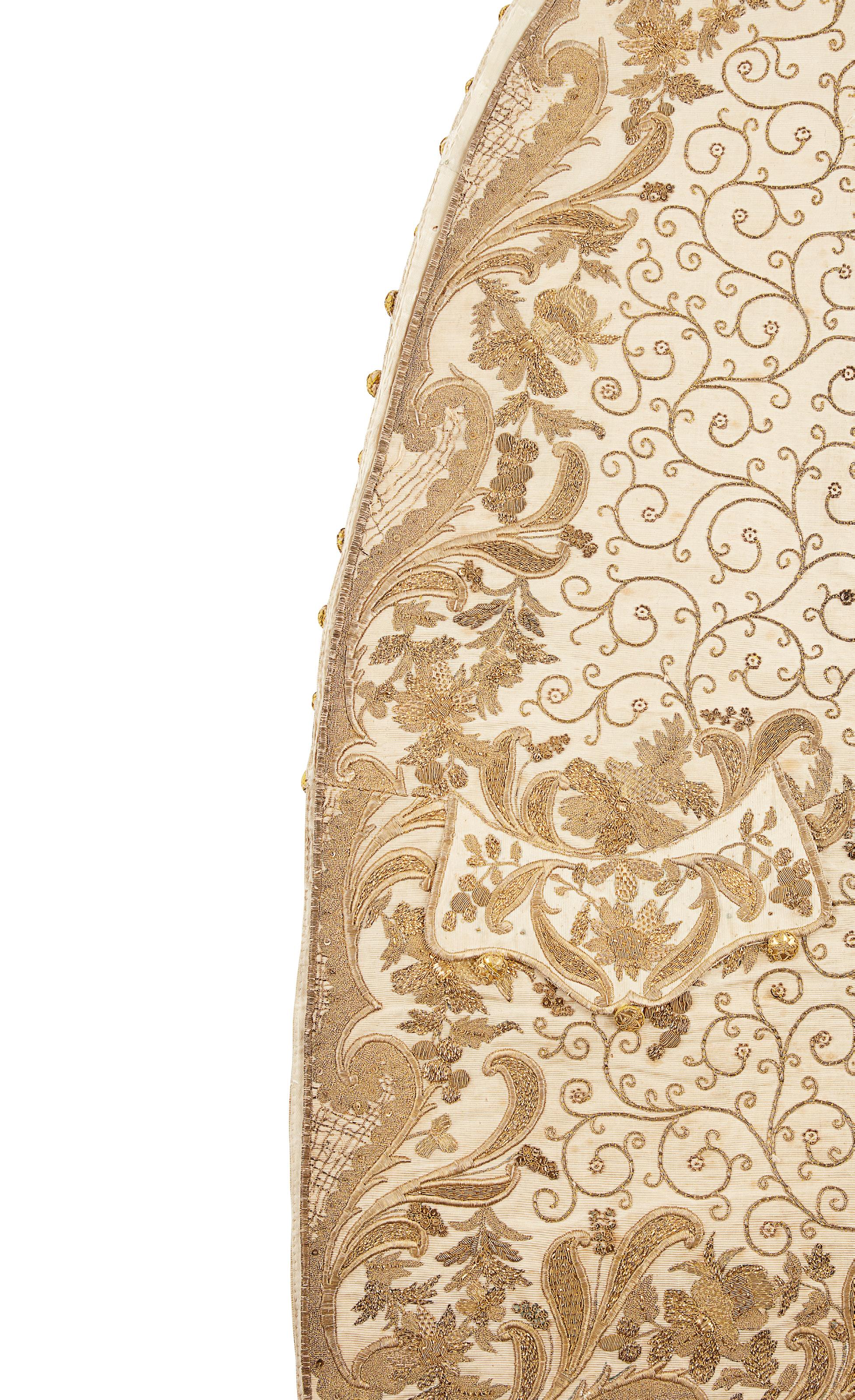
Taxidermy Garden
FRIDAY, 19TH MAY AT 10AM
A Private Collection of Seals: Highlights from The Matrix Collection - see page 255
Right Lot 69 [detail] 4
1-128 129-141 142-261 262-278 279-289 290-366 Lot No. 367-387 388-448 449-470 471-609 610-618 619-681 682-685 686-698
17TH MAY AT 10AM
NEEDLEWORK VALANCE PANEL FRAGMENT

EARLY 17TH CENTURY
worked in wool and silk with a central tree bearing fruit with a bird perched amongst the branches; flanked by large flower-filled vases; the background filled with parterres and formal gardens, with a church in the distance, and a domed pergola with a rose walkway and trellis arch to the edges; the foreground with animals including a squirrel, rabbits, a tortoise, a hen pecking a worm, and a fox with its kit; all within a brown line border
77cm wide, 28cm high approx.
Note: This panel was originally part of a long bed valance, and the motifs employed appear frequently on valances in the late 16th and early 17th centuries. Some images, like the hen pecking the worm, appear in emblem books which were frequently used as a source for designs. These emblems were often accompanied by moral sayings or poems which would have been understood by the educated at that time. Even today we recognise ‘the early bird catches the worm’.

£1,000-1,500
RARE OAK CHILD’S JOINT STOOL
MID 17TH CENTURY
the plank top with a thumbnail edge, above a leafy lunette carved seat rail on turned and tapered legs joined by a peripheral stretcher

31cm wide, 36cm high, 25cm deep
£600-800
1
2
BRITISH FURNITURE & WORKS OF ART PART I
5
53cm wide, 120cm high, 44cm deep £300-500
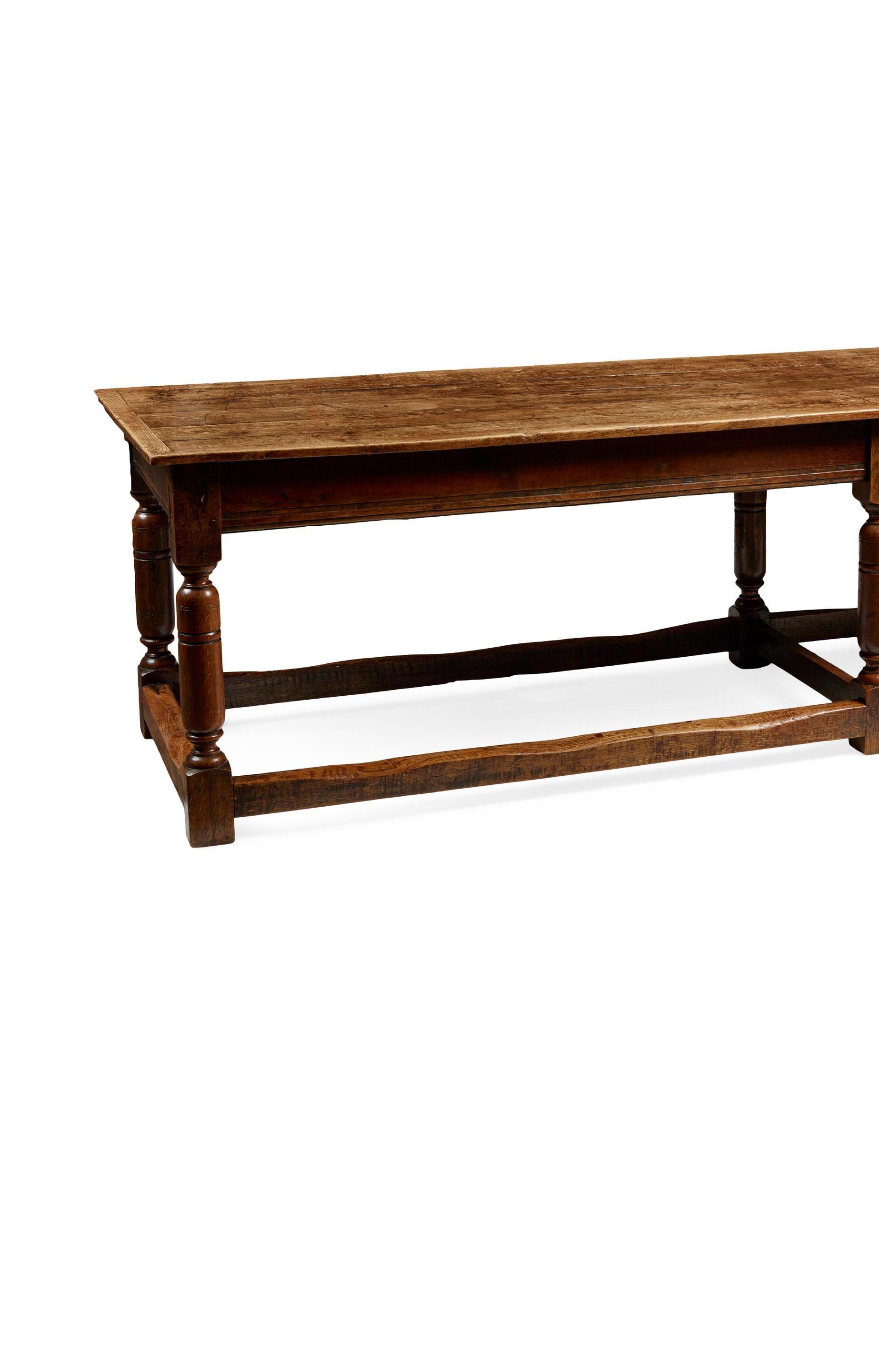
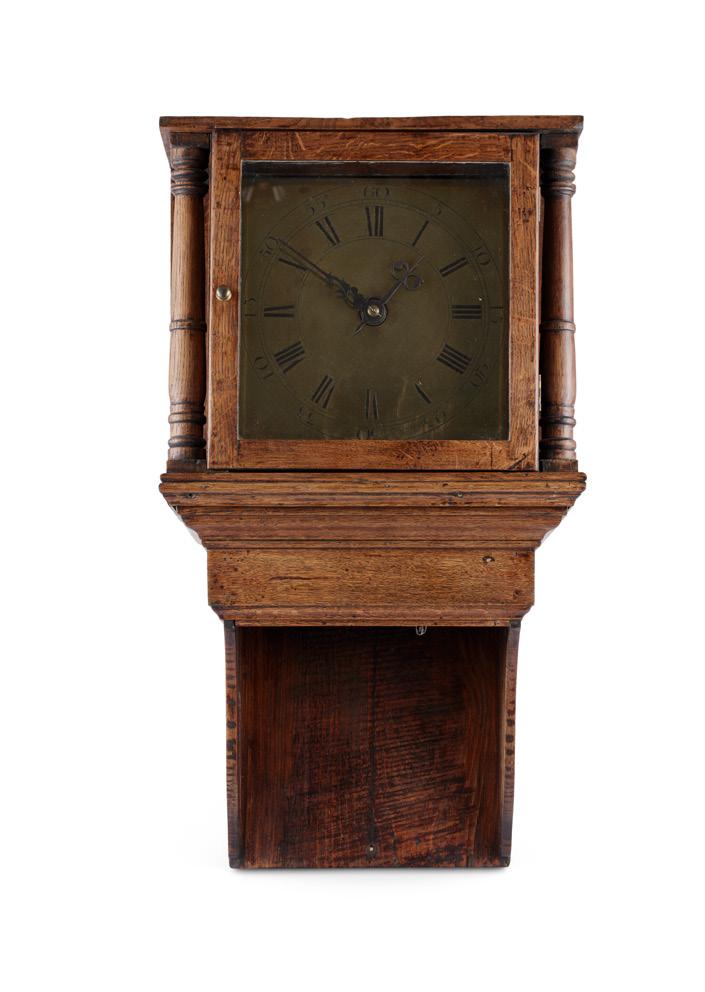
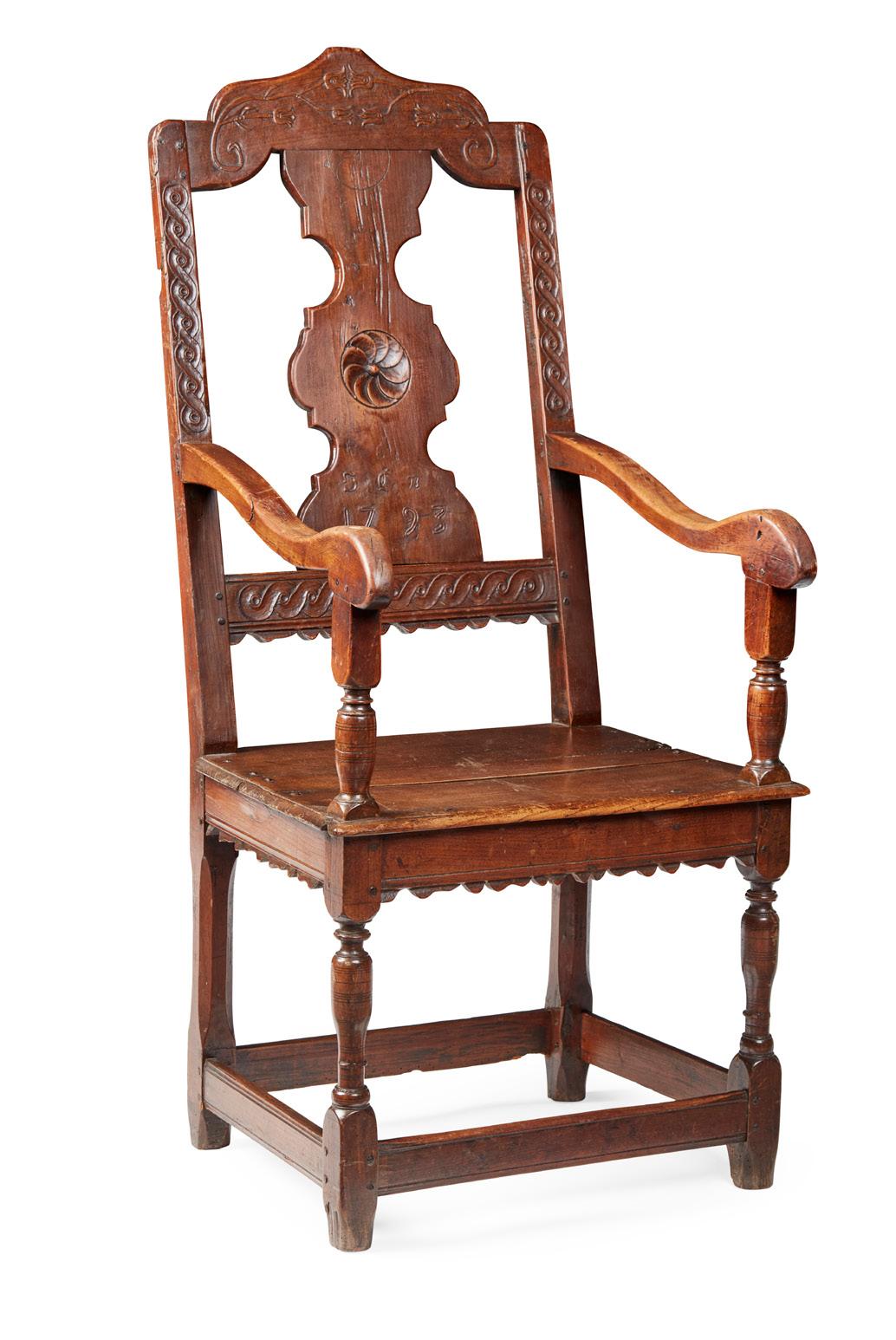
6 Other fees apply in addition to the hammer price: see the ‘Buyer’s Guide’ section on page 2
PAIR LARGE BARLEY TWIST BRASS CANDLESTICKS

the tall open twist stems on circular dished bases
GEORGIAN OAK FOUR PANEL SETTLE

18TH CENTURY, LANCASHIRE
the moulded top rail above four arched raised panels and a long brown leather covered squab cushion and web seat, raised on turned and block legs joined by a shaped front stretcher with peripheral stretchers to the rear
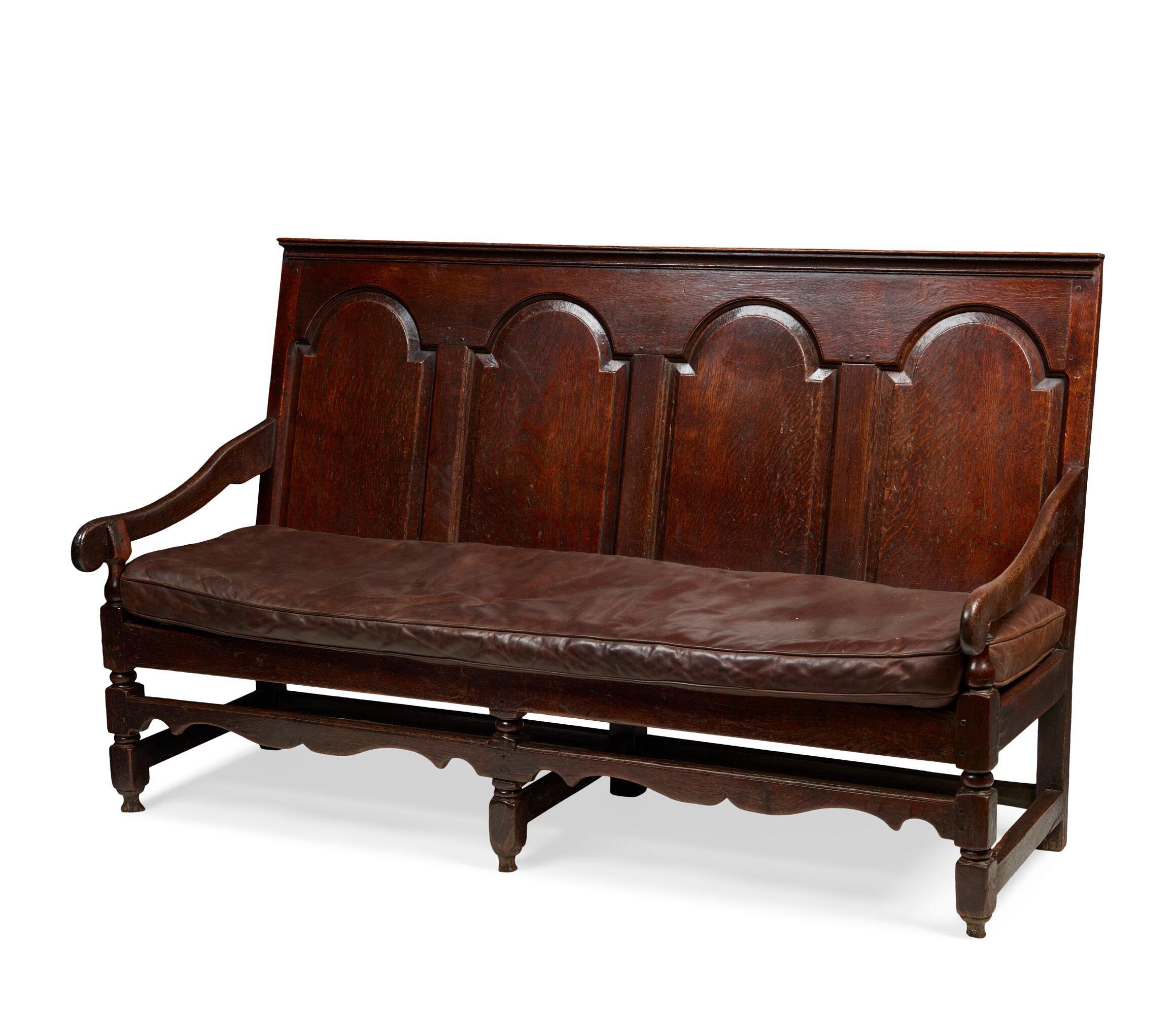
185cm wide, 113cm high, 54cm deep
£600-800
7
GEORGE III OAK DRESSING TABLE
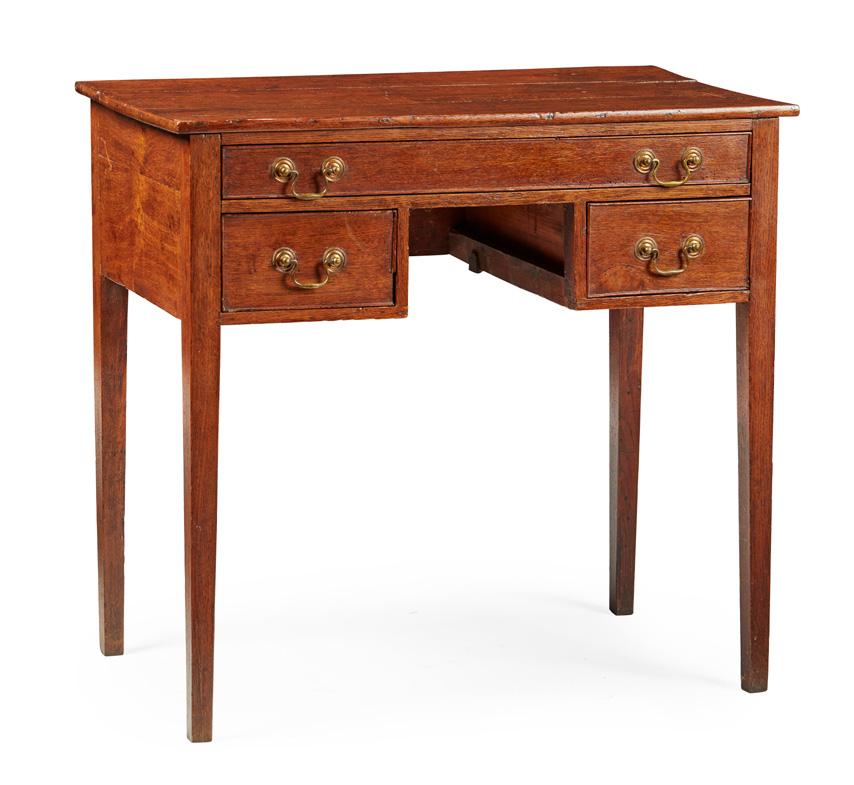
18TH CENTURY
the plain rectangular top above a long frieze drawer and two short drawers flanking a kneehole, raised on square straight legs
80cm wide, 70cm high, 42cm deep
£400-600
10
QUEEN ANNE WALNUT CHEST OF DRAWERS
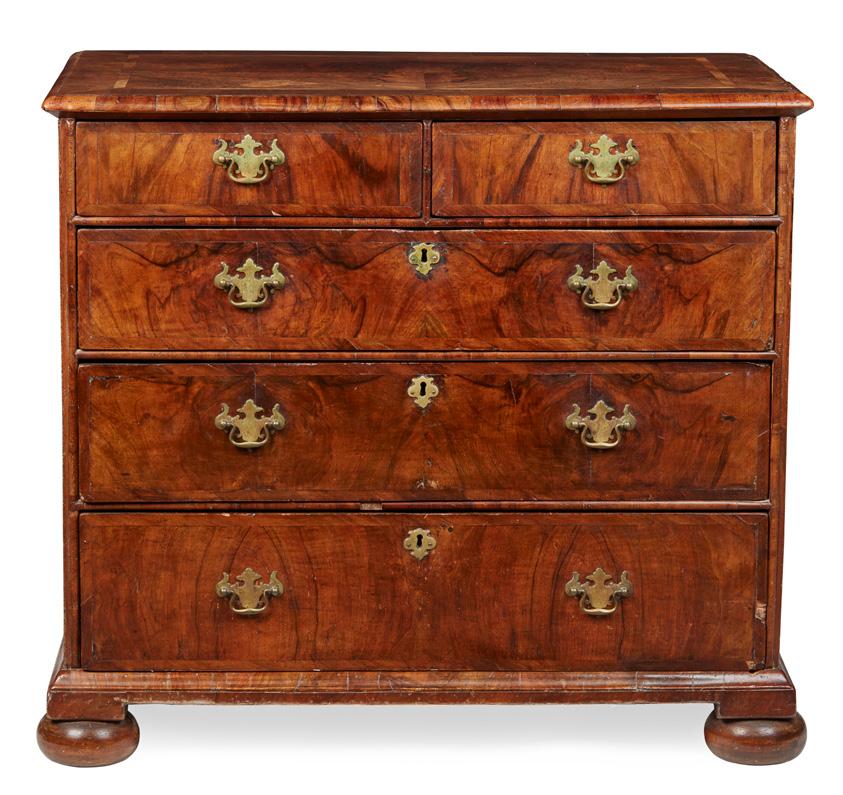
EARLY 18TH CENTURY
the quarter-veneered and crossbanded top with a moulded edge, above two short and three long crossbanded drawers, on bun feet
96cm wide, 84cm high, 53cm deep
£1,000-1,500
9
QUEEN ANNE OAK CABINET-ON-STAND
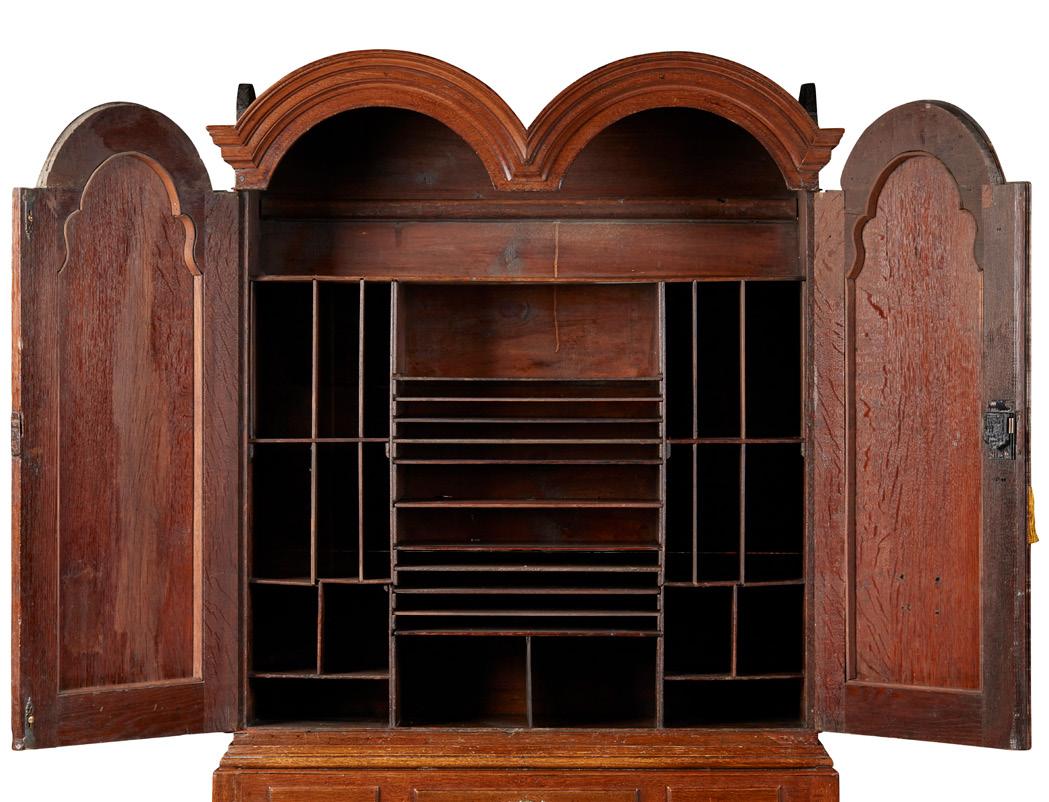

EARLY 18TH CENTURY, THE STAND LATER
double dome top with a moulded cornice above a pair of arched panel doors, opening to an interior with an arrangement of pigeon holes; on an associated Georgian base with three frieze drawers above a shaped apron, on square cabriole legs
97cm wide, 185cm high, 49cm deep
£600-800
8
8 Other fees apply in addition to the hammer price: see the ‘Buyer’s Guide’ section on page 2
PAIR OF LARGE BRASS CANDLESTICK LAMPS

19TH CENTURY
the flower cast nozzles over barley-twist columns, ending in circular bases with floral decoration, fitted for electricity, with white pleated shades (2)
46cm high
£700-1,000
QUEEN ANNE WALNUT SMALL CHEST-ON-STAND
EARLY 18TH CENTURY, THE STAND LATER
the crossbanded top above a pair of banded matchbook veneered doors opening to an arrangement of drawers enclosing a central cupboard with a secret drawer and compartment, on a stand with a shaped apron and raised on cabriole legs ending in pointed pad feet
87cm wide, 113cm high, 46cm deep
£600-800
12
GEORGE I WALNUT CHEST-ON-STAND

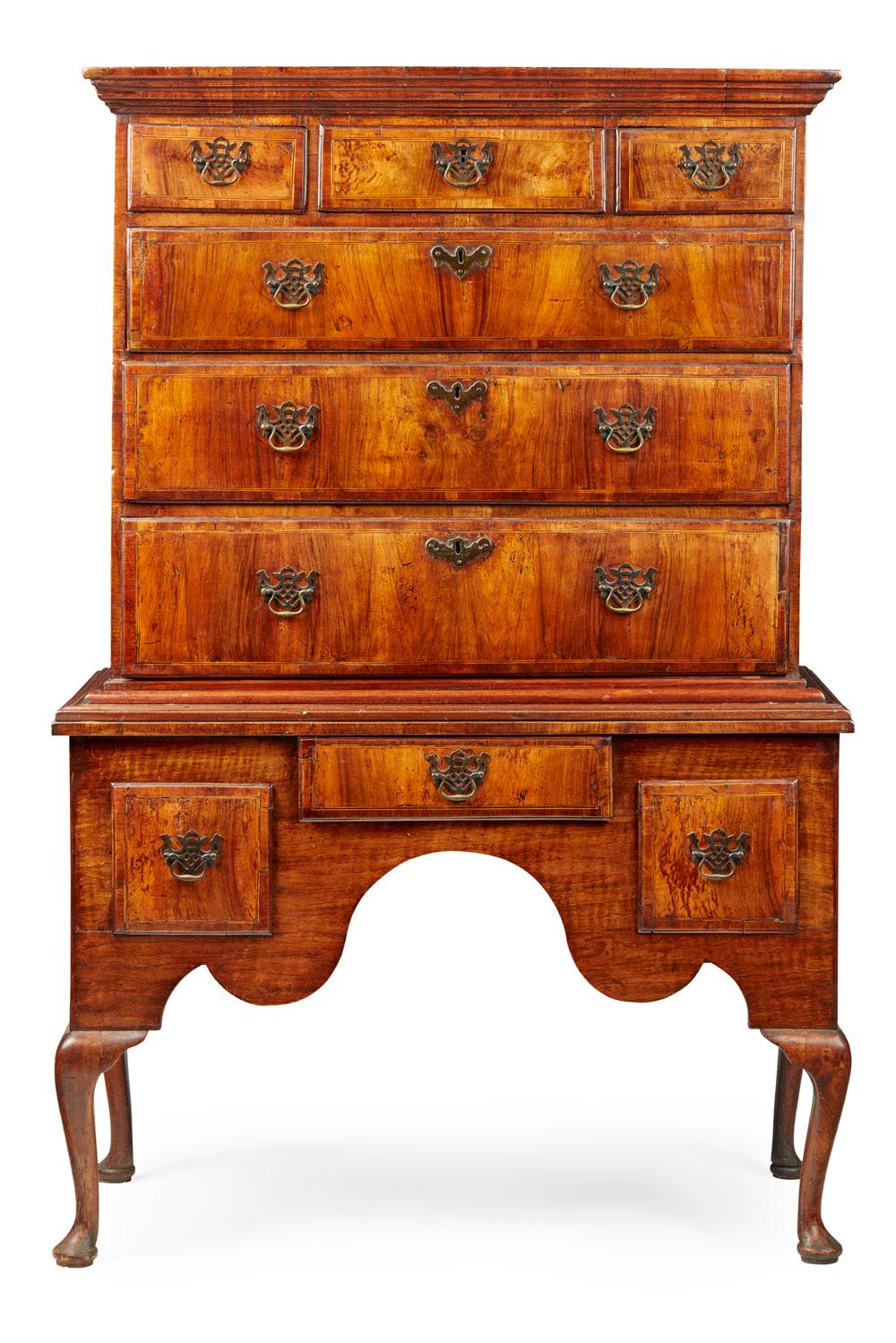

EARLY 18TH CENTURY
the moulded cornice above three short and three long graduated drawers, on a base with three short drawers arranged around a shaped apron, raised on cabriole legs ending in pad feet
105cm wide, 154cm high, 53.5cm deep
£600-800
13
11
9
GEORGE II RED WALNUT TWO-FOLD CARD AND TEA TABLE

MID 18TH CENTURY
the rectangular fold-over top opening to a green baize lined playing surface and counter wells, above a short frieze drawer, raised on cabriole legs ending in pad feet, opening on a single gate leg
80cm wide, 73cm high, 39cm deep
£700-1,000
GEORGE I STYLE WALNUT AND PARCEL-GILT MIRROR

19TH CENTURY
with the arched and bevelled plate in a gilt slip and moulded frame 56cm wide, 111cm high
£300-500 16
GEORGE II MAHOGANY CHEST-ON-CHEST
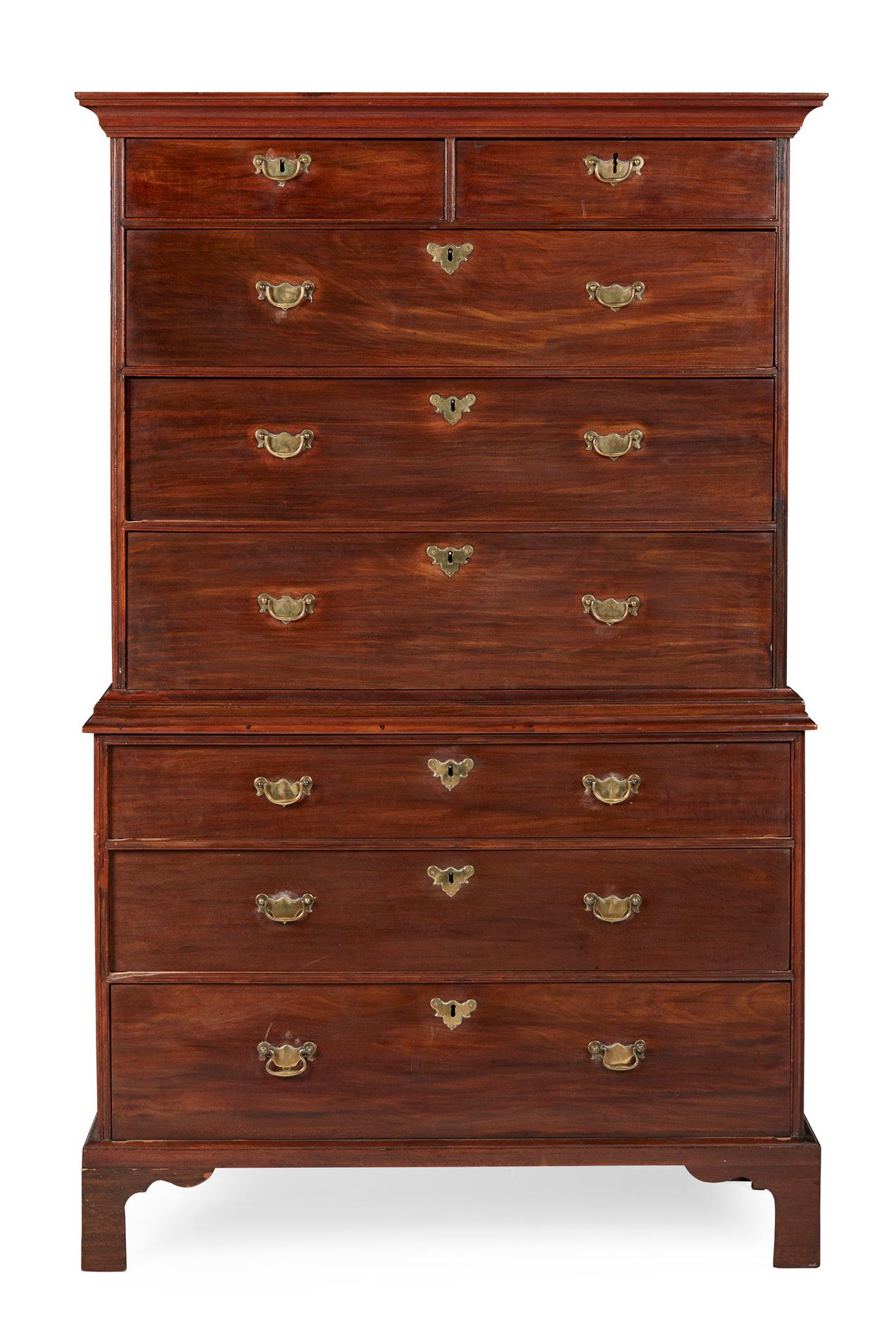
EARLY 18TH CENTURY
the plain moulded cornice above a pair of short drawers over three long drawers, the lower part with a moulded waist and three further long graduated drawers, raised on bracket feet 116cm wide, 171cm high, 57cm deep
£1,000-1,500
15
14
10 Other fees apply in addition to the hammer price: see the ‘Buyer’s Guide’ section on page 2
17
GEORGE I WALNUT BOX COMMODE
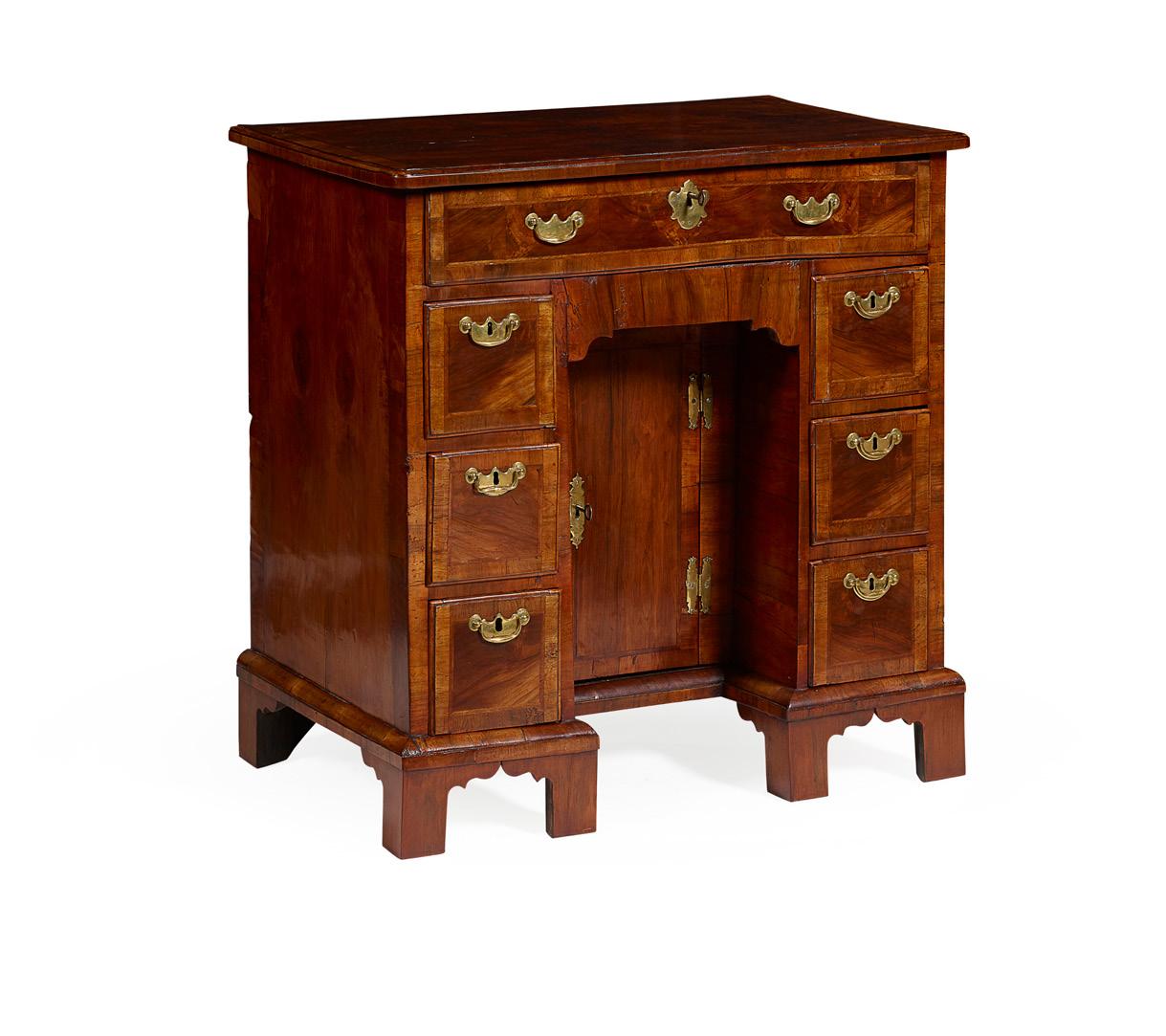
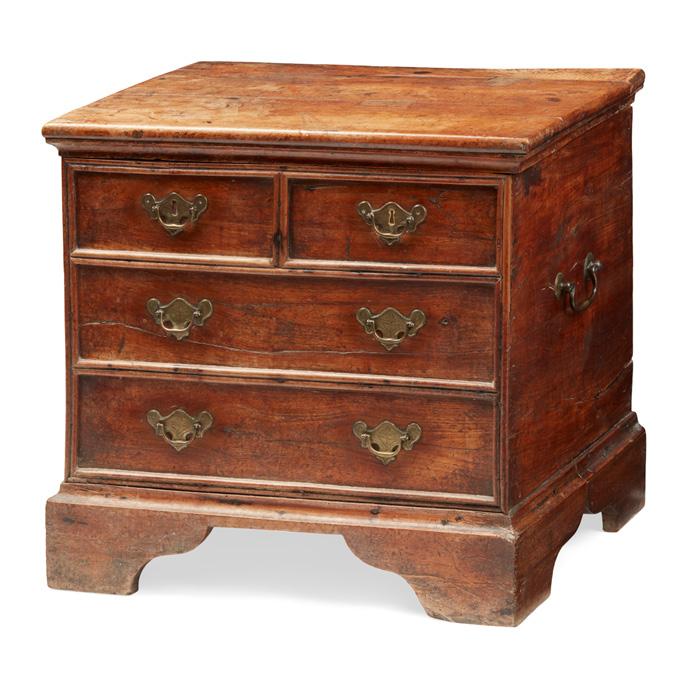
EARLY 18TH CENTURY
of small size, the hinged top opening to a void interior, the front with two short and two long dummy drawers, with brass handles to the sides, raised on bracket feet
56cm wide, 53cm high, 39cm deep
Provenance: Purchased Swan Gallery, Burford
£500-700
18
GEORGE I WALNUT SIDE CHAIR

EARLY 18TH CENTURY
the padded back and seat covered in 17th century tapestry fragments, raised on scroll carved cabriole legs ending in pad feet
56cm wide, 90cm high, 40cm deep £600-800
19
GEORGE II WALNUT FRAME STOOL
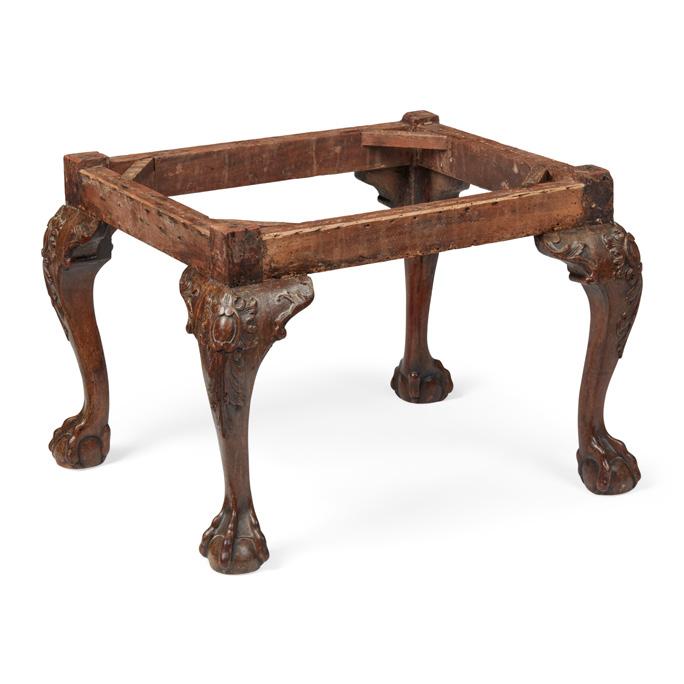
MID 18TH CENTURY
with cabriole legs carved with rocaille and acanthus ending on claw and ball feet
63cm wide, 44cm high, 52cm deep £500-700
20
GEORGE I WALNUT KNEEHOLE DRESSING TABLE
EARLY 18TH CENTURY
the quarter-veneered and crossbanded top with a moulded edge above a long frieze drawer and kneehole cupboard, flanked by banks of three drawers raised on bracket feet 77cm wide, 80cm high, 48cm deep £700-1,000
21
IRISH GEORGE I STYLE WALNUT MARBLE TOPPED SIDE TABLE
19TH CENTURY, THE TOP LATER
the rectangular veined green marble top above a plain frieze with serpentine apron, raised on shell and C-scroll carved cabriole legs ending on hoof feet
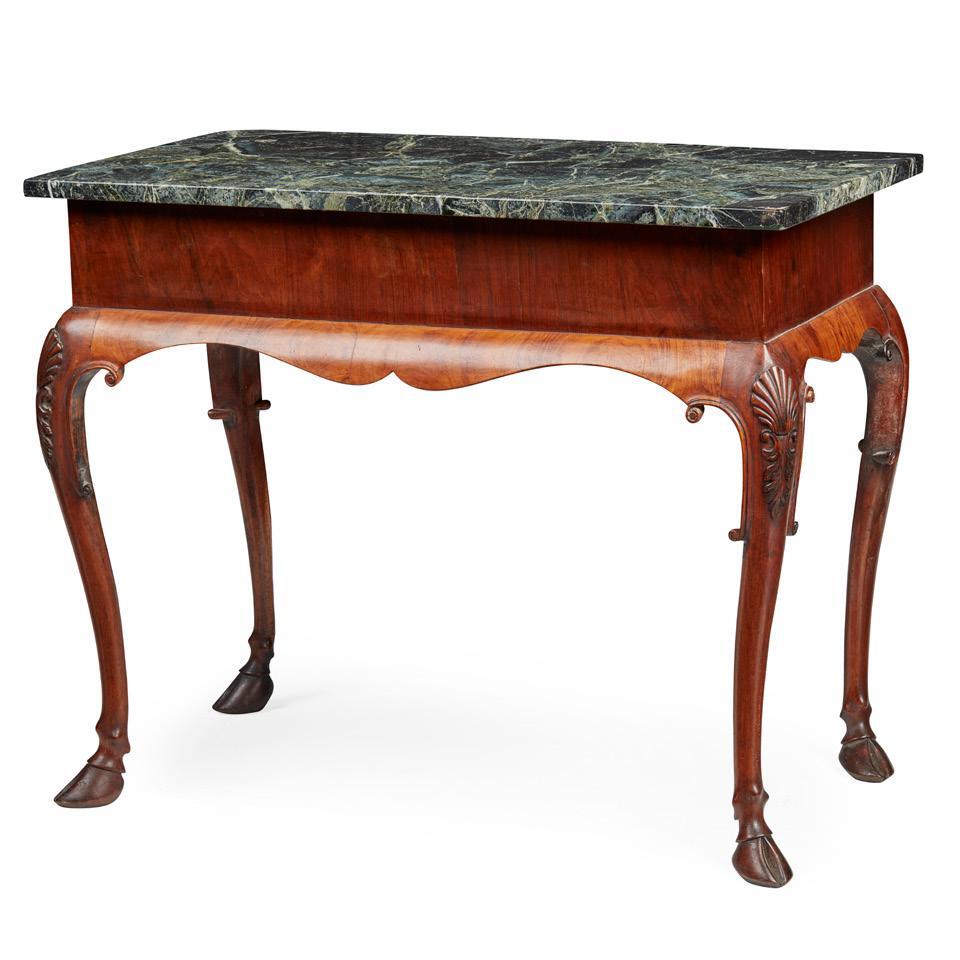
92cm wide, 74cm high, 51cm deep
£1,200-1,800
11
25
GEORGE III OAK DRESSER
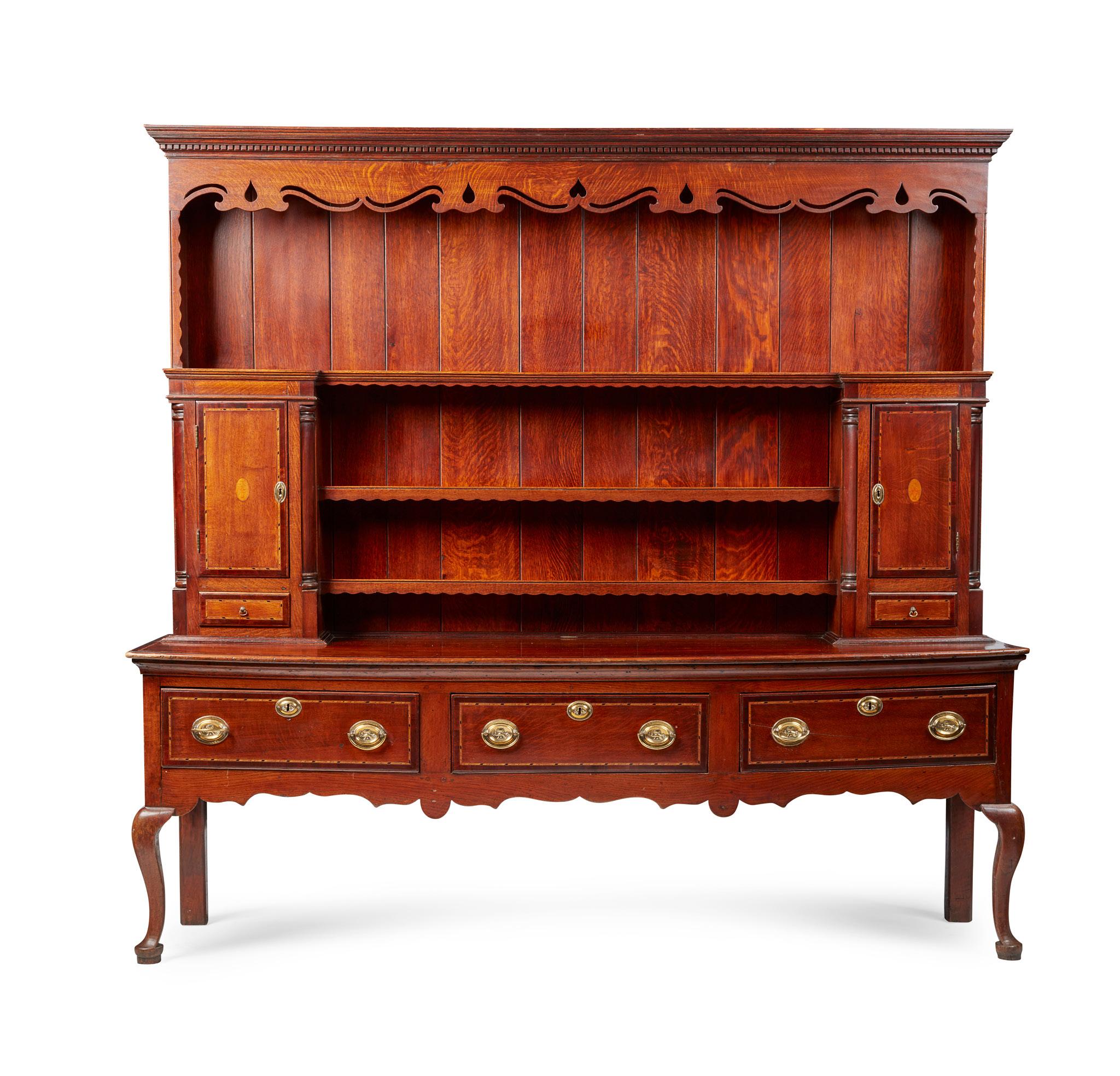
LATE 18TH CENTURY
the upper part with a closed back and dentil moulded cornice above a pierced and wavy frieze, over a long shelf and two further shelves flanked by banded cupboards and short drawers enclosed by quarter columns; the base with three deep frieze drawers above a wavy apron, raised on cabriole legs ending in pad feet
212cm wide, 202cm high, 50cm deep
Provenance: Private Scottish Collection, Morayshire
£800-1,200
SMALL GEORGIAN OAK DROP-LEAF TABLE
18TH CENTURY
the oval top with two drop leaf sides, raised on angled baluster turned legs with twin gateleg supports, joined by peripheral stretchers
61cm wide, 64cm high, 26cm deep, 76cm [open]
£300-500
23
SET OF SIX GEORGE II OAK DINING CHAIRS
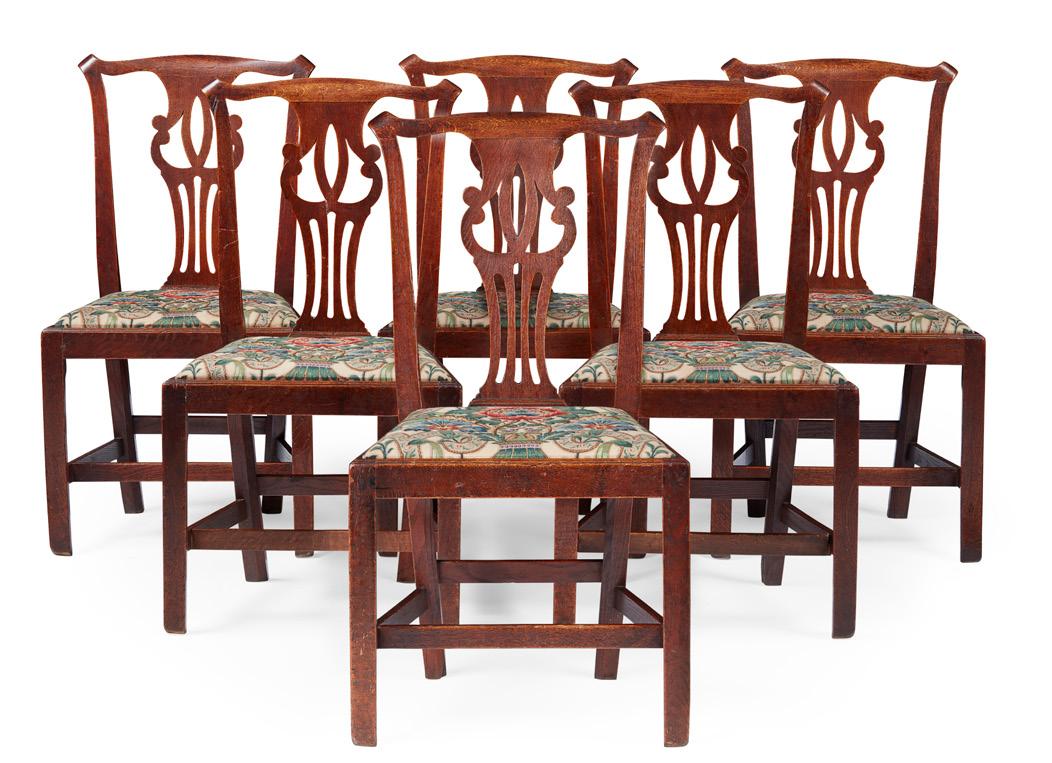
18TH CENTURY
24
GEORGE III OAK TRIPOD TABLE
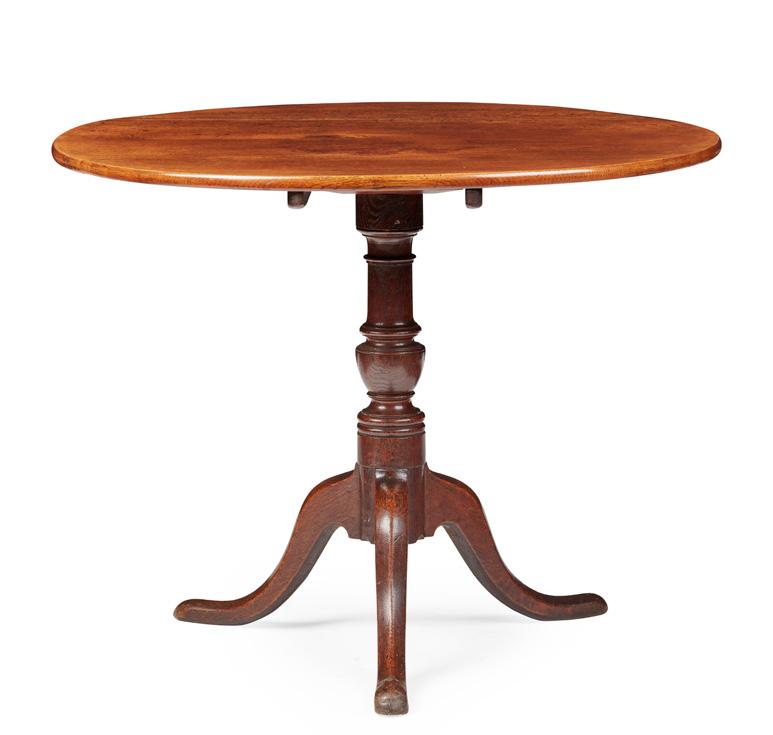
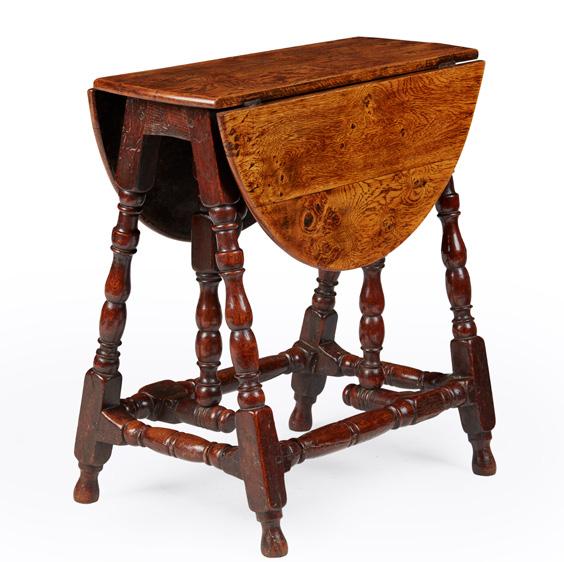
18TH CENTURY
the circular tilt top on a baluster column and tripod base ending in pointed pad feet 90cm diameter, 72cm high
£500-700
the serpentine top rails above pierced splats and drop-in seats, raised on square chamfered legs joined by stretchers (6)
51cm wide, 93cm high, 38cm deep
£400-600
22
12 Other fees apply in addition to the hammer price: see the ‘Buyer’s Guide’ section on page 2
IRISH CARVED OAK DROP LEAF TABLE
18TH CENTURY, THE CARVING 19TH CENTURY
the oval top with two deep drop leaves, all profusely carved with lunettes, stylised flowerheads, and foliate motifs, with a frieze drawer to one end, raised on spiral carved legs ending in carved paw feet on later lobed pads
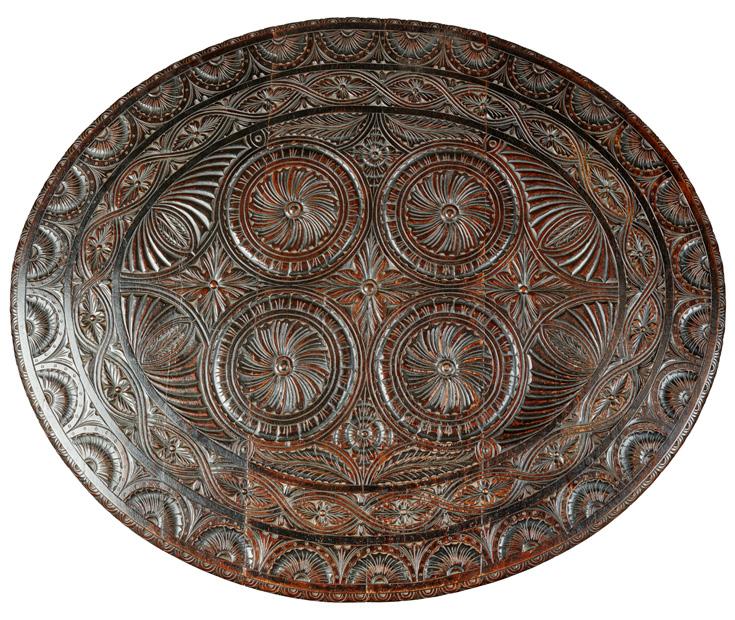

137cm wide, 77cm high, 56cm deep, 170cm [open]
£1,000-1,500 27
SCOTTISH CARVED OAK

LONGCASE CLOCK, BY ANDREW BAIRD, KILBRYDE
19TH CENTURY
the swan neck pediment centred by a carved winged hourglass, above an arched brass dial with a Roman numeral chapter with date aperture and subsidiary seconds dial, the arch boss signed by the maker, the trunk with an arched door carved with a figure of an archer, on a plinth base on bracket feet, the surface carved throughout with foliate scrolls, palmettes and stylised plant motifs, the eight-day twin chain movement striking a bell
232cm high, 52cm wide
£400-600
GEORGE III OAK DRESSER

18TH CENTURY
the moulded cornice above a frieze dated 1760, above three open shelves and three spice drawers flanked by arched panel doors; the base with three short frieze drawers over a pair of arched panel doors raised on stile feet
142cm wide, 191cm high, 55cm deep
£1,500-2,500
28
26
13
29
LATE GEORGE II MAHOGANY TRIPOD TEA TABLE
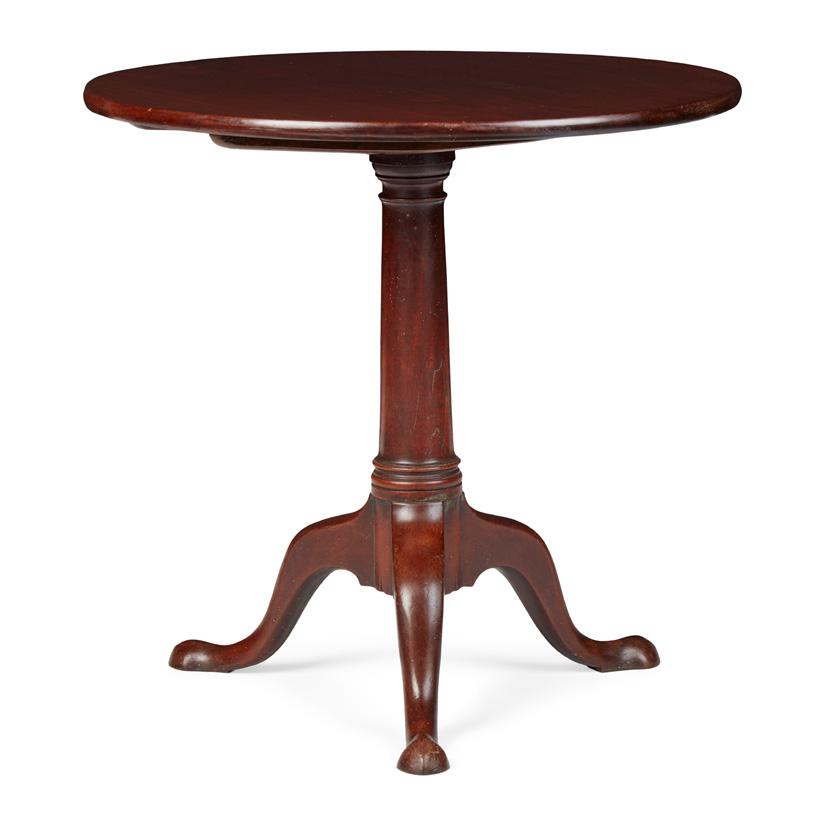
MID 18TH CENTURY
the circular tilt top on a cannon barrel column and tripod base ending in pointed pad feet
71cm diameter, 70cm high
£400-600
30
LARGE GEORGE III MAHOGANY ARMCHAIR
LATE 18TH CENTURY
in the Chippendale style, the foliate carved serpentine top rail above a carved and interlaced splat, scrolled arms and wide stuffover seat, raised on chamfered square legs joined by H-stretchers

74cm high, 99cm high, 50cm deep
£400-600
31
GEORGE II MAHOGANY CONCERTINA ACTION CARD TABLE
MID 18TH CENTURY
the rectangular fold-over top above a plain frieze, raised on cabriole legs ending in pad feet
91cm wide, 71cm high, 45cm deep
£800-1,200
32
LATE GEORGE II MAHOGANY KNEEHOLE DESK
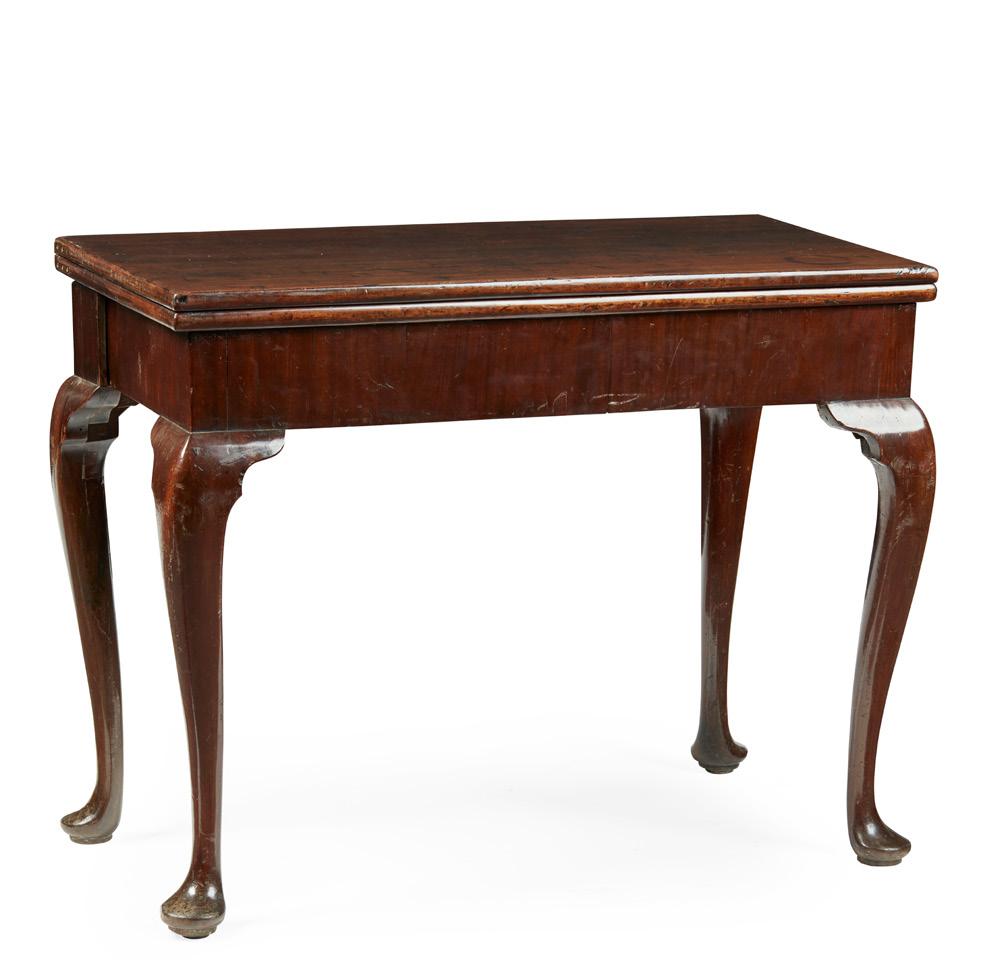
MID 18TH CENTURY
the caddy top above a long drawer fitted with a ratchetadjusted slope, mirror, and compartments, over a kneehole with apron drawer and recess cupboard flanked by banks of three drawers, raised on ogee bracket feet with brass castors
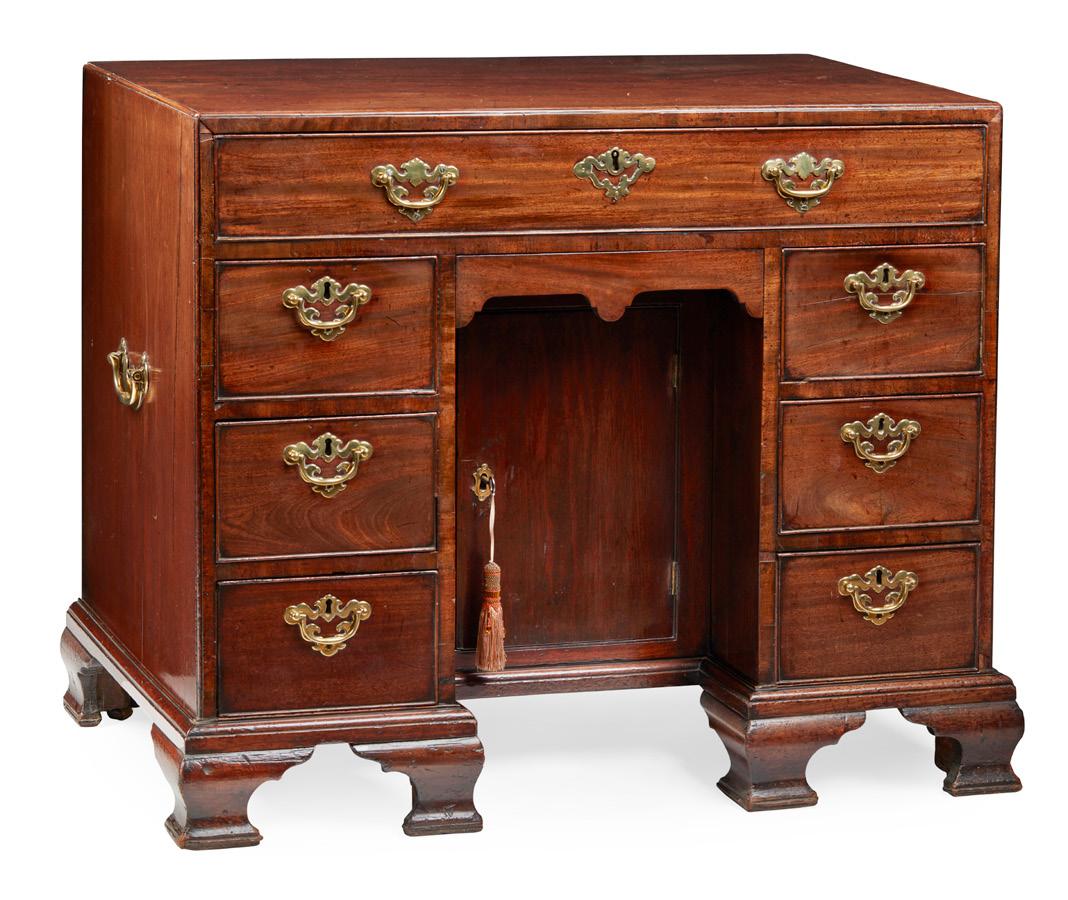
95cm wide, 80cm high, 55cm deep
Provenance: Private Scottish Collection, Morayshire
£800-1,200
14 Other fees apply in addition to the hammer price: see the ‘Buyer’s Guide’ section on page 2
GEORGE II GILTWOOD MARGIN PLATE MIRROR
18TH CENTURY
the arched shaped mirror plate within a margin plate border and giltwood moulded frame
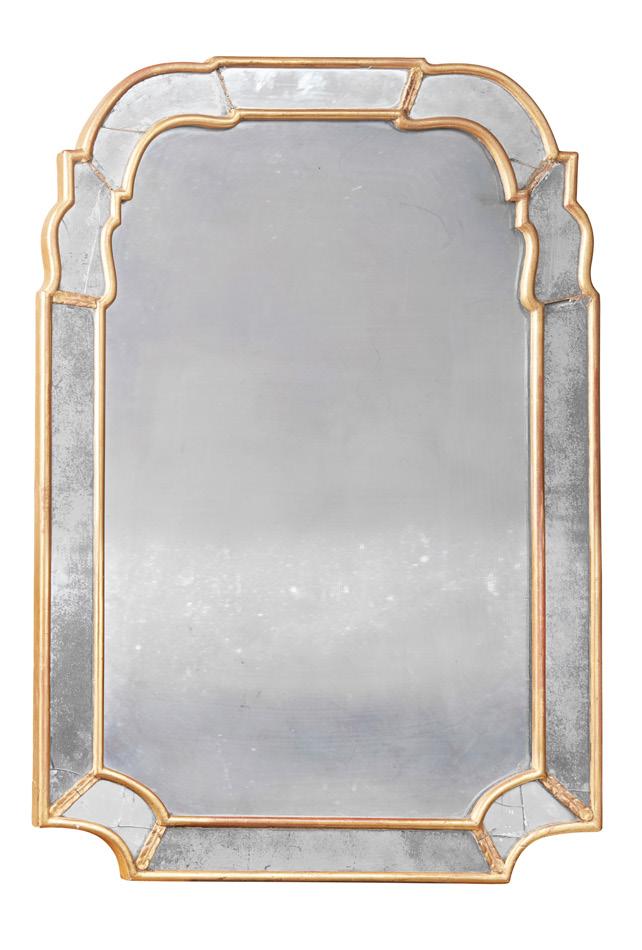
91cm high, 62.5cm wide
£800-1,200
GEORGE II MAHOGANY LOWBOY
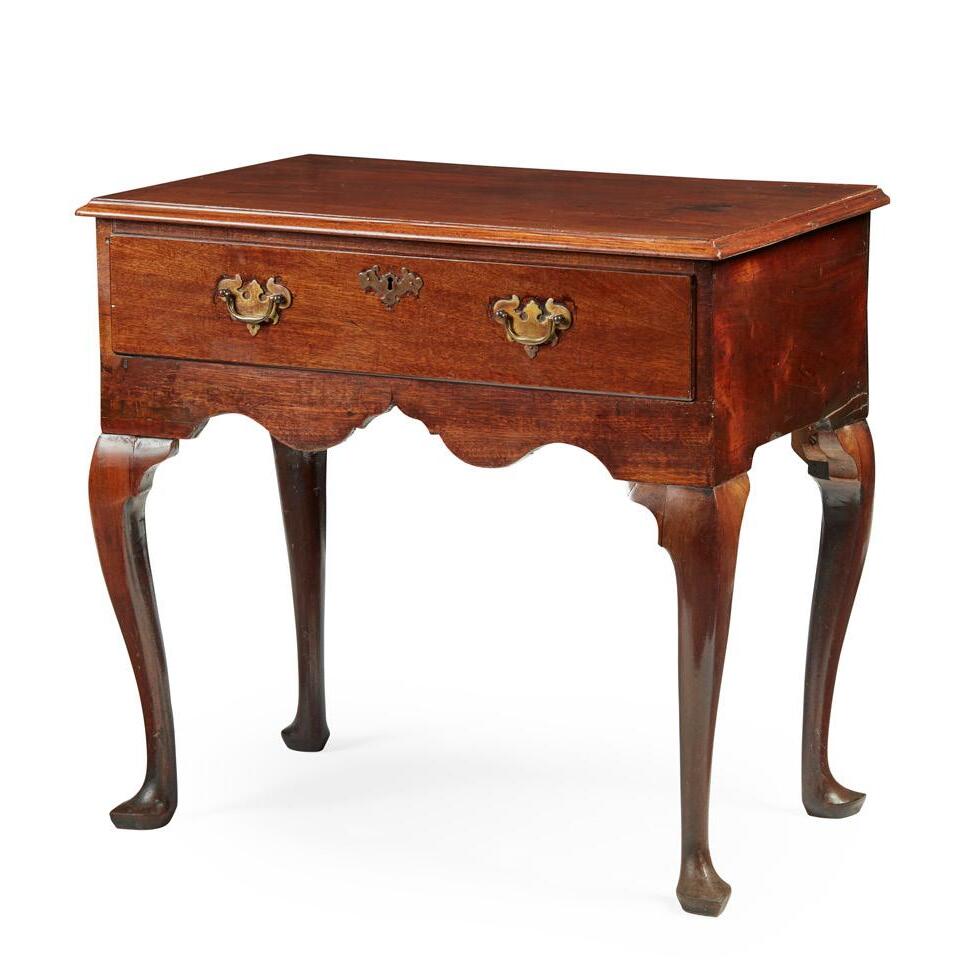
MID 18TH CENTURY
the top with a moulded edge above a long frieze drawer and shaped apron, raised on cabriole legs ending in pointed pad feet 76cm wide, 72cm high, 50cm deep
£800-1,200
GEORGE II MAHOGANY TWIN-FOLD TEA AND CARD TABLE
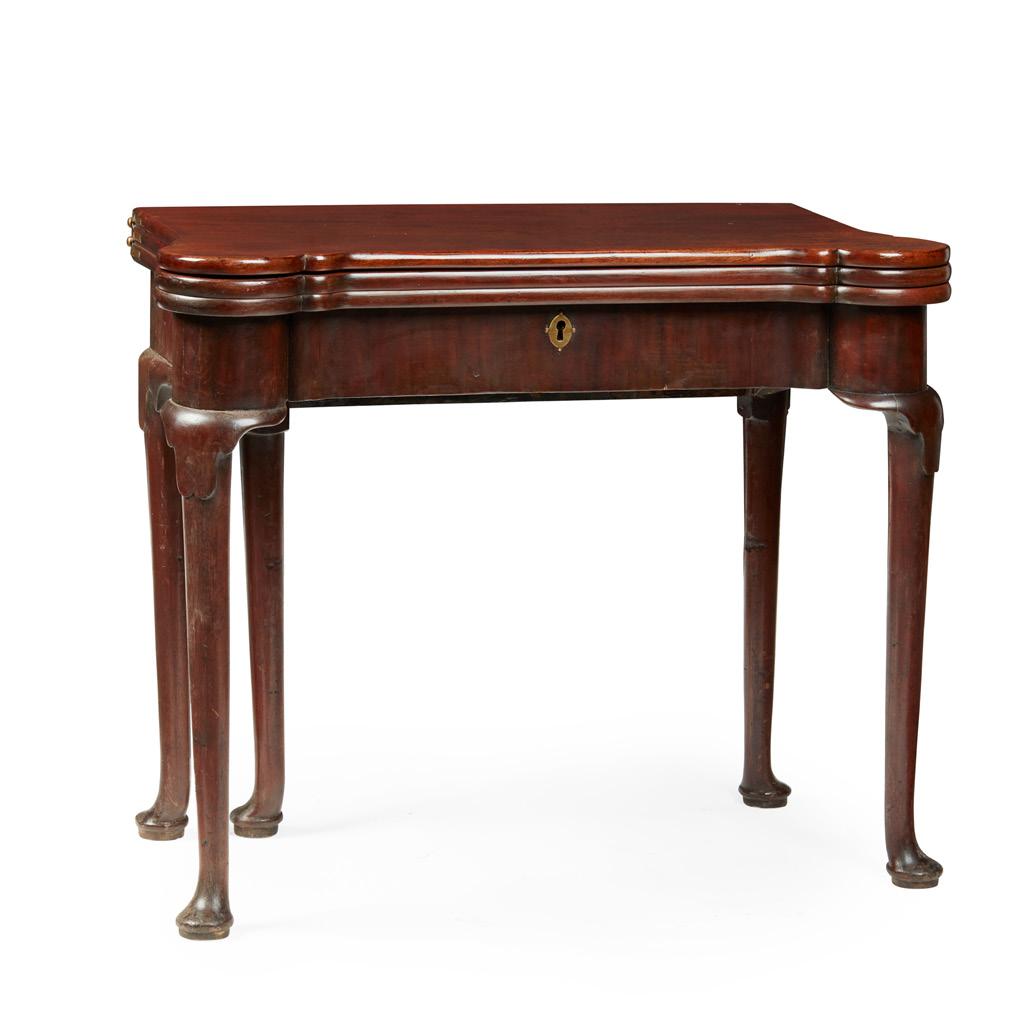
MID 18TH CENTURY
the fold-over top with outset rounded corners opening to a green baize lined playing surface with counter wells and further to a tea table, above a plain frieze, raised on lappet carved cabriole legs ending in pad feet 88cm wide, 72cm high, 44cm deep [closed]
£1,000-1,500
GEORGIAN STYLE
MAHOGANY FRAMED SOFA
19TH CENTURY
the low slightly arched back with a gadrooned top rail, above a loose cushion seat flanked by scrolled arms, raised on eight lambrequin carved cabriole legs with gadroon carving and ending in scrolled toes, covered in ivory upholstery

206cm long, 89cm high, 63cm deep
£1,200-1,800
36
34
33
35
15
37
AFTER WILLIAM HOGARTH, MARRIAGE A LA MODE

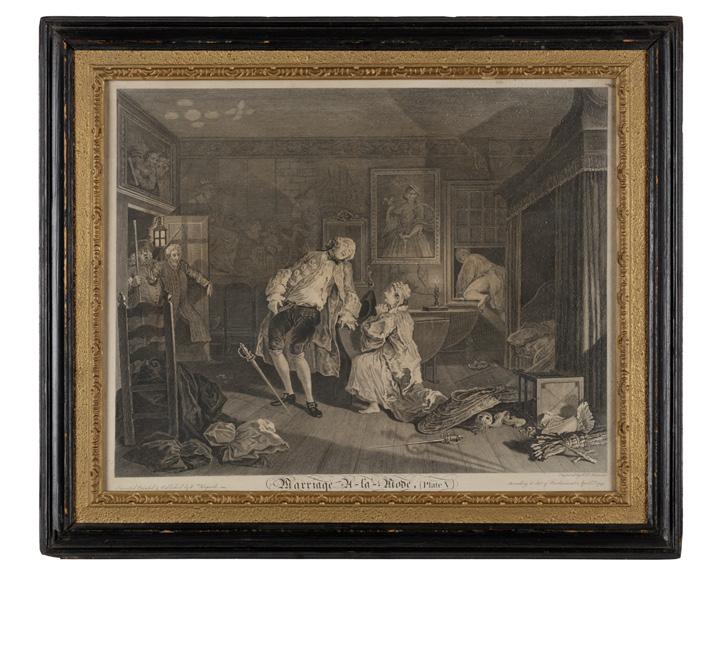

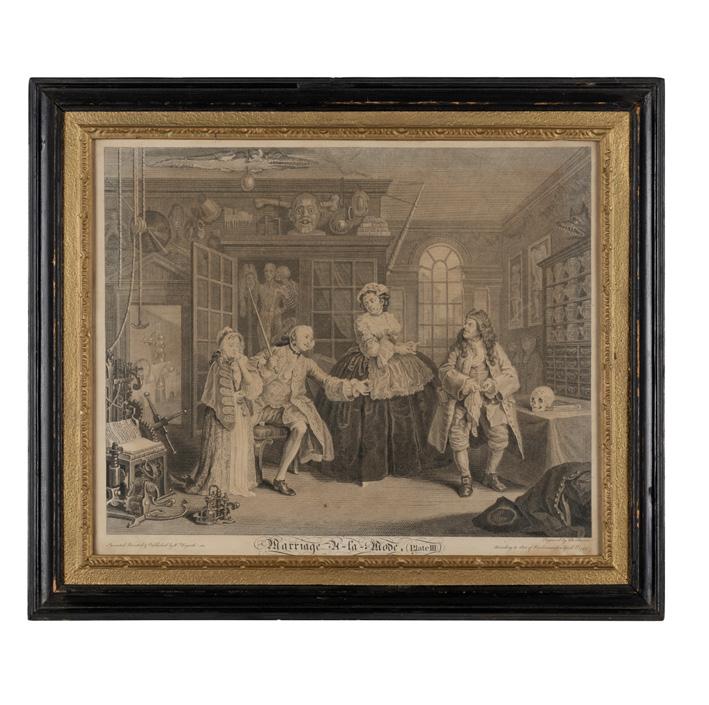
19TH CENTURY
complete set of six engraving, plates I-VI, paper laid on canvas, in period ebonised and gilt slip frames (6)
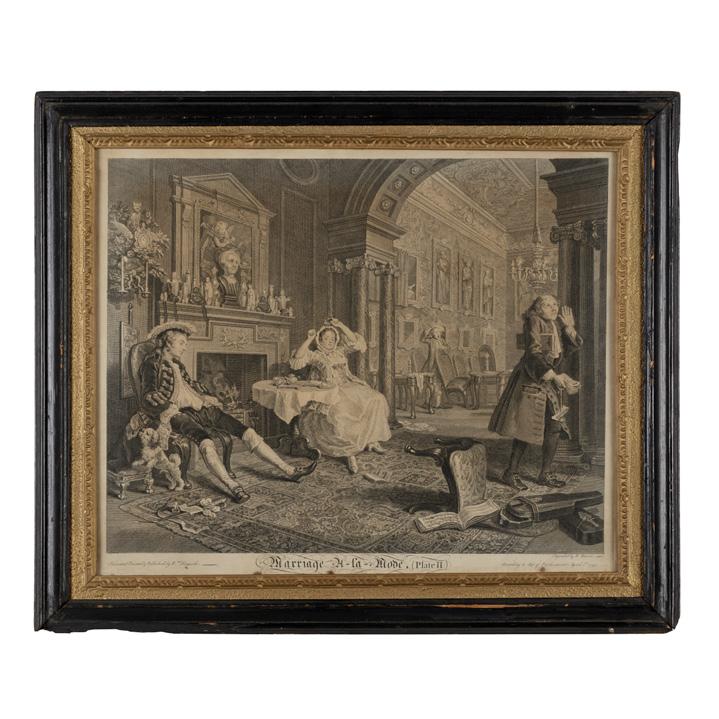

38.5cm x 46.5cm
£600-800
38
GEORGE III MAHOGANY DEMILUNE COMMODE, IN THE MANNER OF ROBERT ADAM
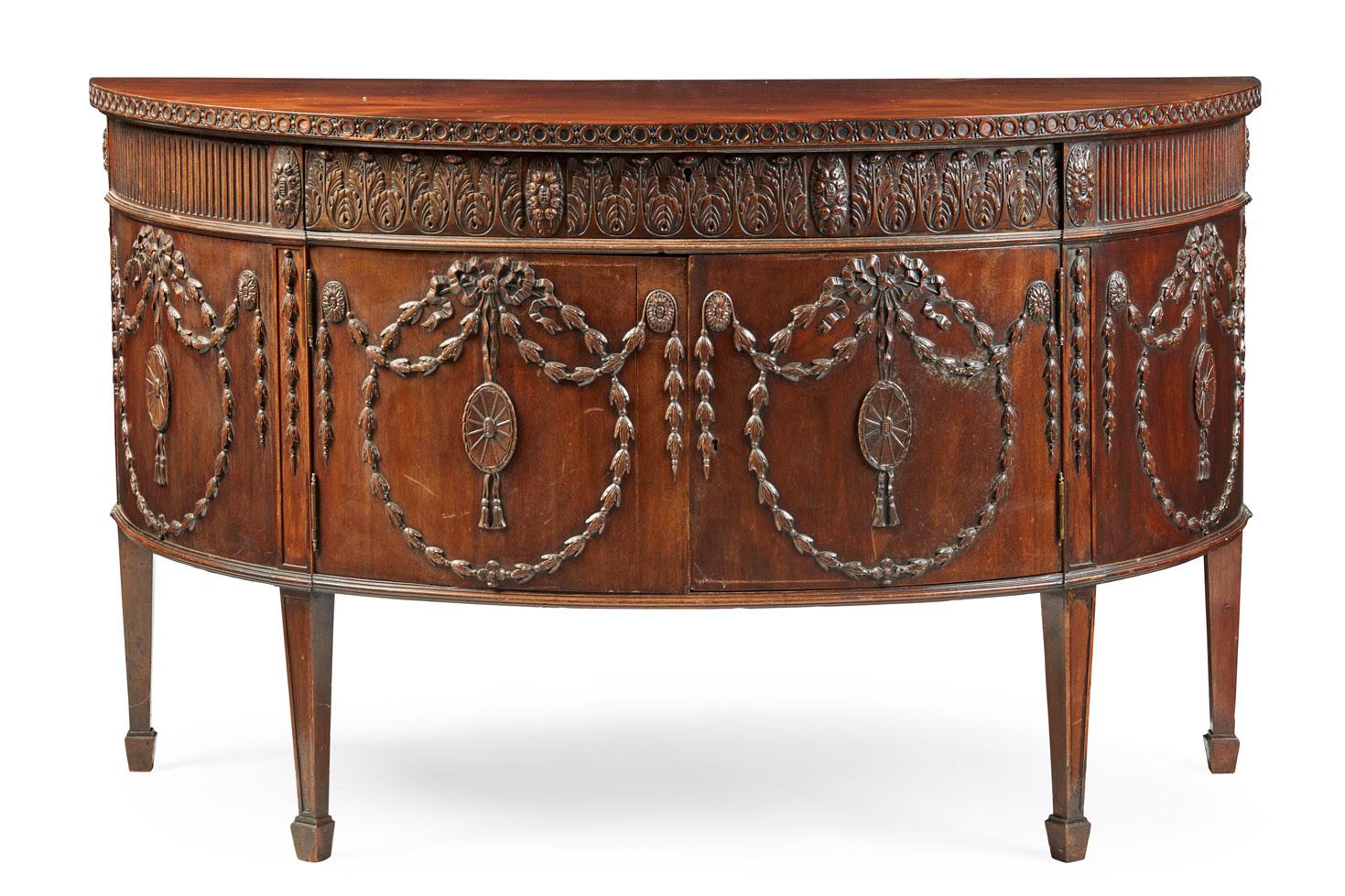
MID 18TH CENTURY
the demi-lune top with a key moulded edge, above an acanthus carved frieze flanked by fluted panels and divided by paterae, above a pair of cupboard doors carved with ribbon-tied husk garlands and pendant paterae, raised on square tapered legs ending in spade feet
146cm wide, 88cm high, 60cm deep
£3,000-5,000
16 Other fees apply in addition to the hammer price: see the ‘Buyer’s Guide’ section on page 2
39
EARLY GEORGIAN GILTWOOD AND GESSO MANTEL MIRROR
EARLY 18TH CENTURY
the rectangular mirror plate in a pierced scrolling acanthus frame 104cm wide, 50cm high £800-1,200
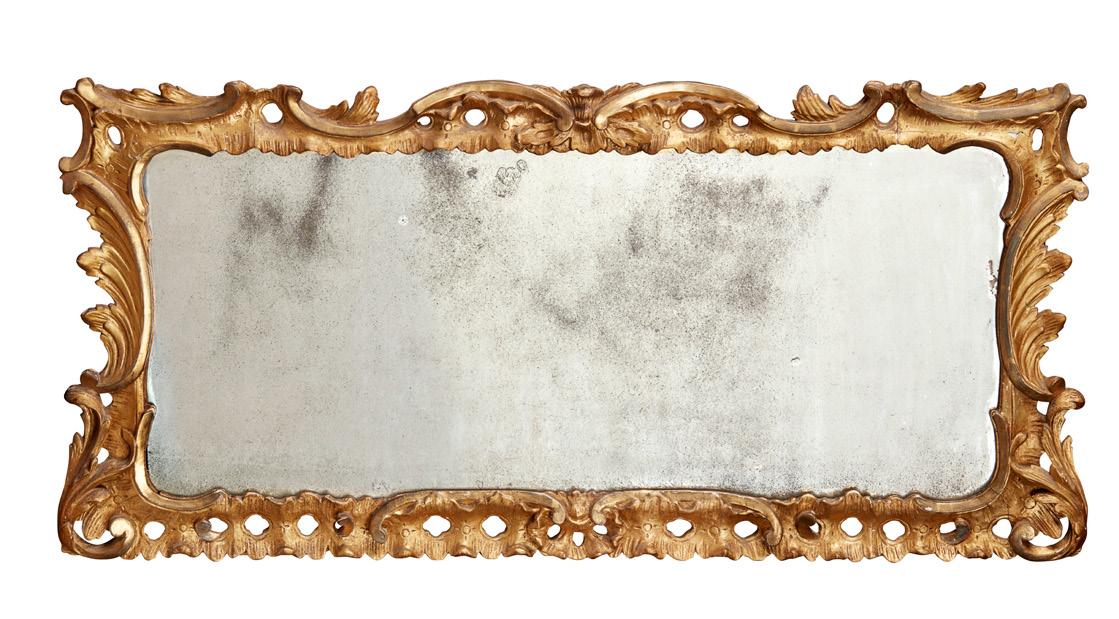
40
GEORGE III MAHOGANY ARMCHAIR, IN THE MANNER OF THOMAS CHIPPENDALE

MID 18TH CENTURY
of large size, the shaped top rail carved with rocaille and fluted scrolled terminals, above a pierced interlaced splat and needlework drop-in seat flanked by scrolled arms on serpentine supports, raised on acanthus carved cabriole legs ending in pad feet
70cm wide, 95cm high, 49cm deep £700-900
41
GEORGE III MAHOGANY AND SCAGLIOLA PORPHYRY HALL TABLE

18TH CENTURY
the rectangular top decorated with simulated porphyry scagliola, above a plain frieze and raised on square chamfered legs with scrolled brackets and ending in block feet
181cm wide, 84cm high, 82cm deep
£1,500-2,500
42
IRISH GEORGE III MAHOGANY TRIPLE CHAIRBACK SETTEE
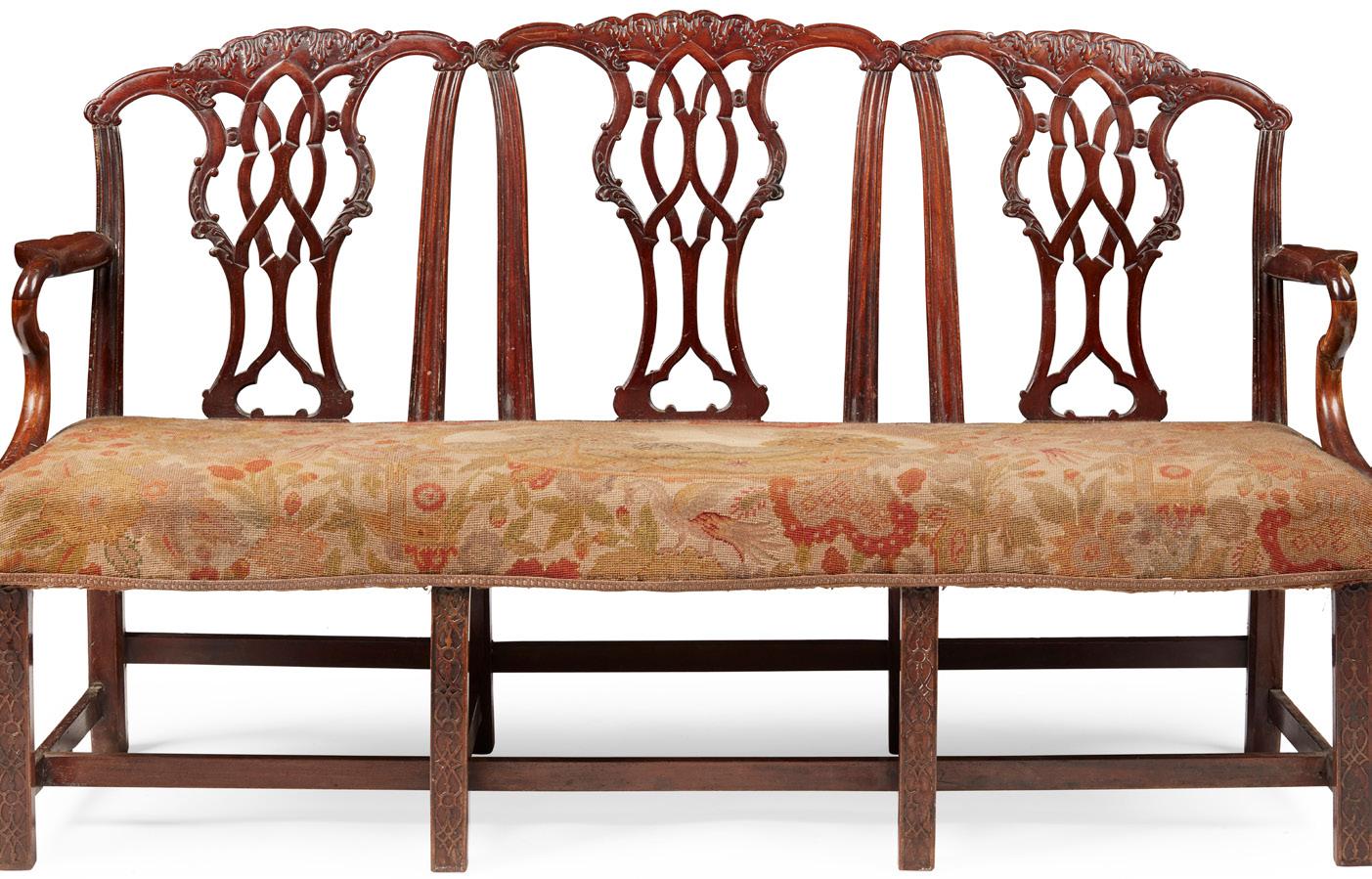
MID 18TH CENTURY
the shaped top rail carved with acanthus above three pierced and interlaced splats, over a serpentine padded seat covered in gros and petit point needlework with hoho birds, chrysanthemums and a garden reserve, raised on blind fret carved chamfered legs joined by stretchers
155cm wide, 82cm high, 55cm deep
£1,500-2,500
17
PAIR OF GEORGIAN PAINTED AND GILT GESSO BRACKETS
EARLY 19TH CENTURY
with gadroon moulded square platforms supported by scrolled ribbon acanthus leaves with foliate finials (2)
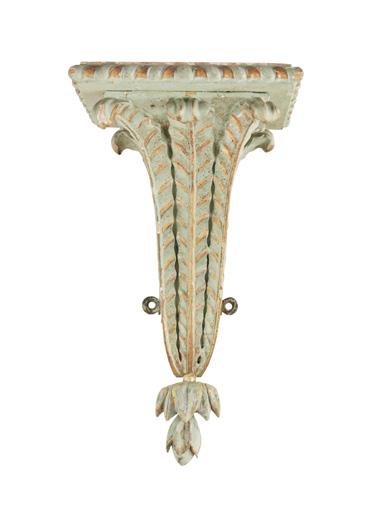

20cm wide, 34cm high, 17cm deep
£600-800
44
WHITE PAINTED ‘CLAYDON HOUSE’ STYLE CHINOISERIE PIER MIRROR RECENT MANUFACTURE
in the form of a Chinese fretwork tea house, the pierced and scrolling pagoda cornice with grotto motifs and hung with bells above a fenced terrace, over a rectangular mirror plate flanked by Chinese figural volutes and clambering vines
203cm high, 106cm wide
Note: This mirror takes its inspiration from the door surrounds in the Chinese Room at Claydon House, Gloucestershire, which was designed and executed by the Londonborn woodcarver Luke Lightfoot in the mid 1700s.
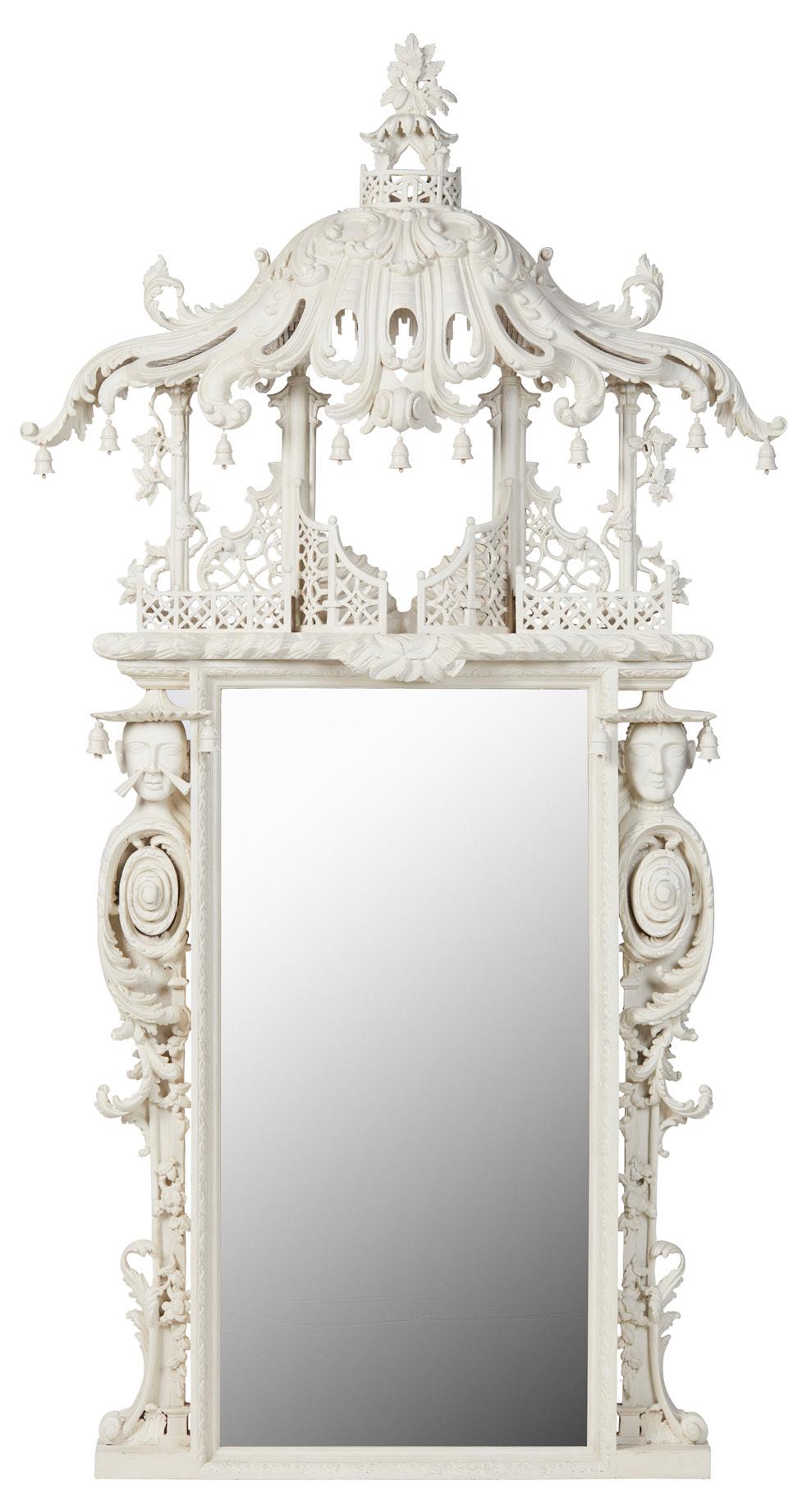
£1,500-2,500
45
EARLY GEORGE III MAHOGANY BUREAU

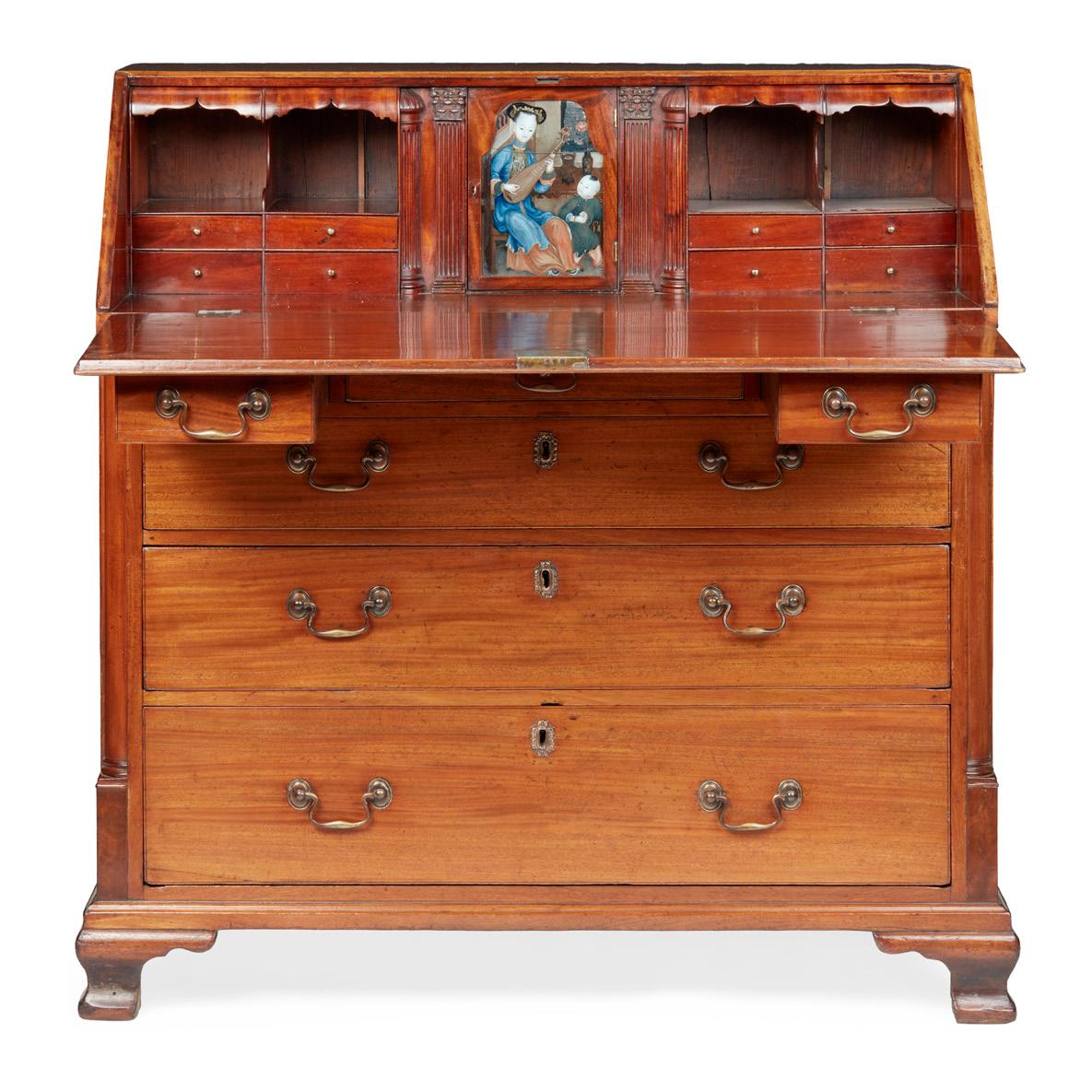
MID 18TH CENTURY
the slope front opening to an interior fitted with pigeon holes, drawers, secret compartments, and a central Chinese Export reverse painted panel depicting a young woman and child, above three short drawers and three long graduated drawers flanked by rounded quarter columns, raised on ogee bracket feet 115cm wide, 117cm high, 57cm deep
£600-800
43
18 Other fees apply in addition to the hammer price: see the ‘Buyer’s Guide’ section on page 2
46
GEORGE III STRIPPED PINE DOUBLE BOOKCASE

MID 18TH CENTURY
the fret-carved cornice with large carved urn finials to the corners, above a dentil moulded frieze and twin pairs of astragal glazed doors enclosing adjustable shelves, on projecting bases with long drawers over pairs of moulded panel doors, on plinth bases
178cm wide, 230cm high, 54cm deep
£5,000-7,000
47
GEORGE III CHINESE CHIPPENDALE STYLE MAHOGANY ARMCHAIR
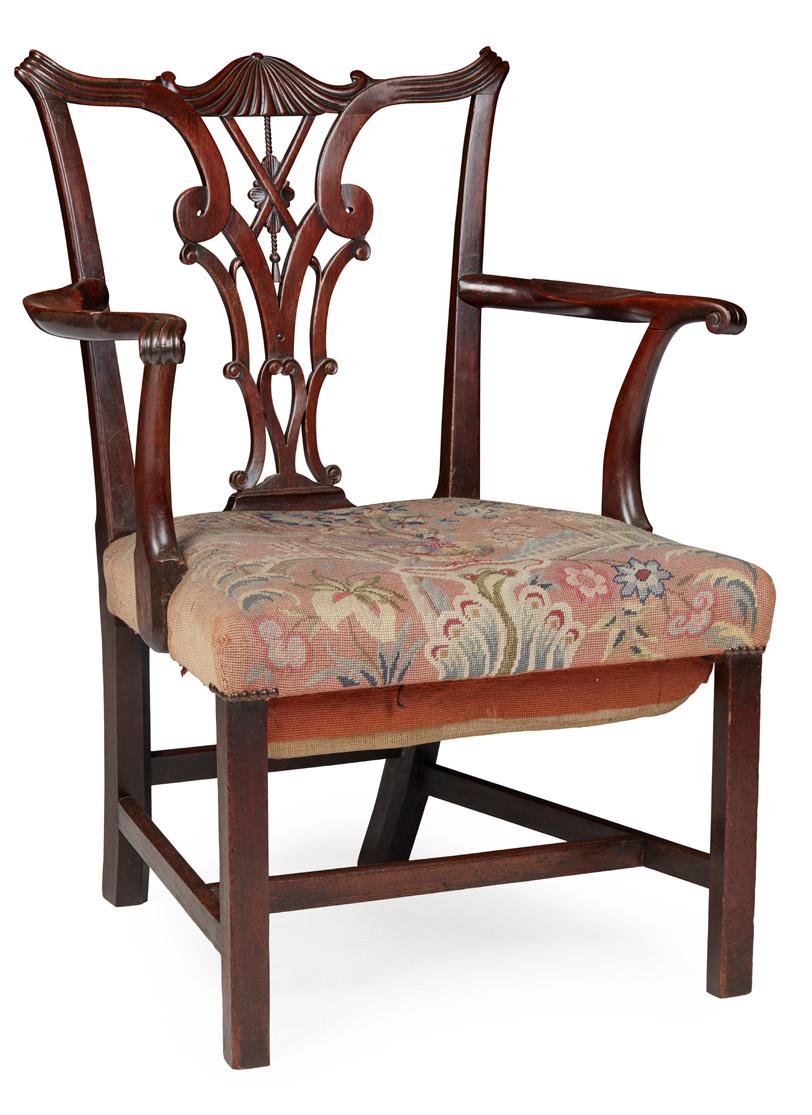
19TH CENTURY
the serpentine toprail with a carved Pagoda crest above a pierced and interlaced splat, over a stuffover needlework seat, on straight square legs united by an H-stretcher
69cm wide, 95cm high, 55cm deep
£600-800
19
GEORGE III MAHOGANY
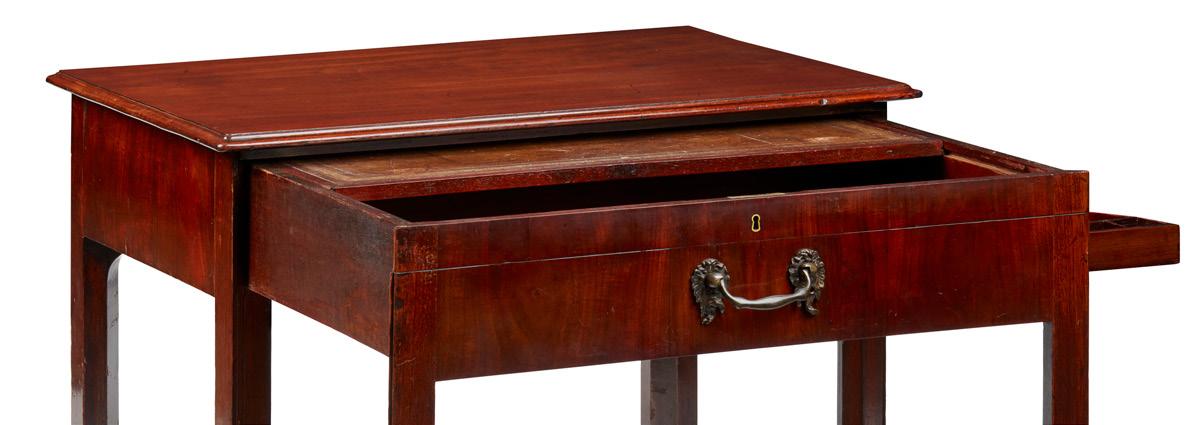

WRITING TABLE
18TH CENTURY
the top with a moulded edge, above a pull-out slide fitted with a sliding leather writing surface and pivot ink drawer, opening to reveal a compartmented interior, on straight chamfered legs with leather castors
91cm wide, 75cm high, 58cm deep
£400-600
IRISH GEORGE III MAHOGANY LONGCASE CLOCK, BY GEORGE FURNACE, DUBLIN

18TH CENTURY
the swan neck pediment centred by a pierced carved shell motif, above a brass dial with Roman number chapter, signed ‘Geo. Furnace/ Dublin’, with brass winged cherub spandrels, flanked by fluted columns, above a shaped long trunk door flanked by fluted quarter columns, on a moulded panel plinth on bracket feet; the eight-day, twin chain movement striking a bell 236cm high, 49cm wide
Provenance: Bearing two old paper trade labels ‘M. BUTLER, LTD.’ ROYAL ANTIQUE FURNITURE
GALLERIES: 26, 126, 127 & 128 UPPER ABBEY STREET, DUBLIN’
Note: George Furnace is recorded working in Dublin 1751-1781
£800-1,200
PAIR OF GEORGE III MAHOGANY SIDE CHAIRS

LATE 18TH CENTURY
the shaped moulded top rails carved with foliate detail, above pierced interlaced splats and drop-in seats, raised on chamfered square legs joined by H-stretchers (2)
50cm wide, 97cm high, 42cm deep
£400-600
49
48
50
20
PAIR OF GEORGE III MAHOGANY LADDERBACK CHAIRS, IN THE MANNER OF CHIPPENDALE

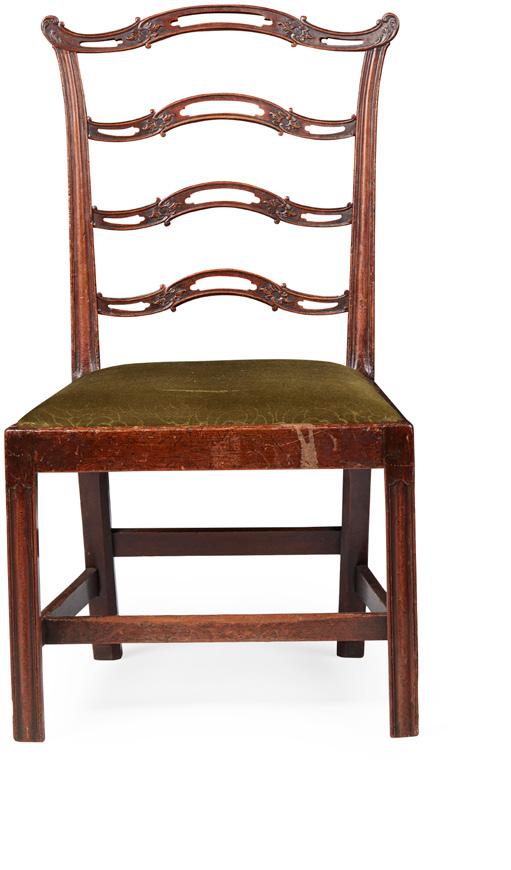
LATE 18TH CENTURY
the pierced and carved backs above drop-in seats, raised on moulded square chamfered legs united by H-stretchers (2) 55cm wide, 98cm high, 47cm deep
Provenance: Ex. Grosvenor House
£400-600
IRISH GEORGE III MAHOGANY CHEST-ON-CHEST

MID 18TH CENTURY
the dentil moulded cornice above an arrangement of six short graduated drawers and two long drawers, flanked by reeded quarter columns on moulded ‘stone’ pedestals, the base with two further long drawers flanked by ‘stone’ corner blocks, raised on shaped bracket feet
107cm wide, 178cm high, 53cm deep
£1,500-2,500 53
GEORGE III MAHOGANY TRIPLE-FOLD TEA AND GAMES TABLE
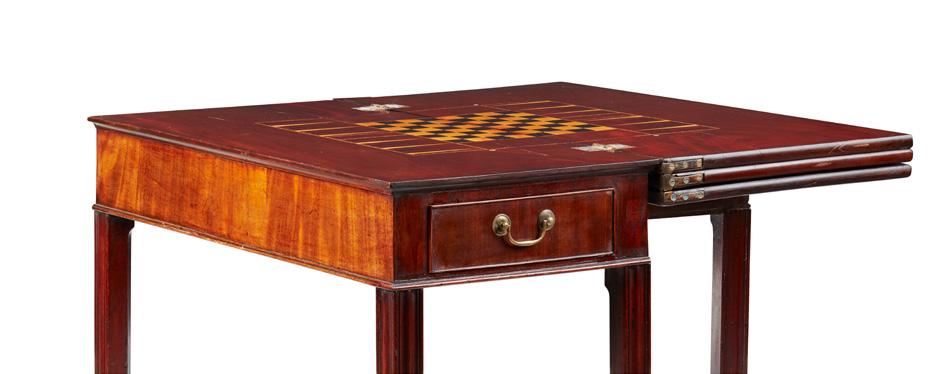
18TH CENTURY
the rectangular fold-over top with three leaves opening to a tea table, a blue baize lined card table, and an inlaid games table, with a frieze drawer to one side, raised on channel moulded square legs; opening on a single gate leg

79.5cm wide, 73cm high, 39cm deep [closed]
£800-1,200
51
52
21 Other fees apply in addition to the hammer price: see the ‘Buyer’s Guide’ section on page 2
GEORGE III MAHOGANY BRASS BANDED TRAY
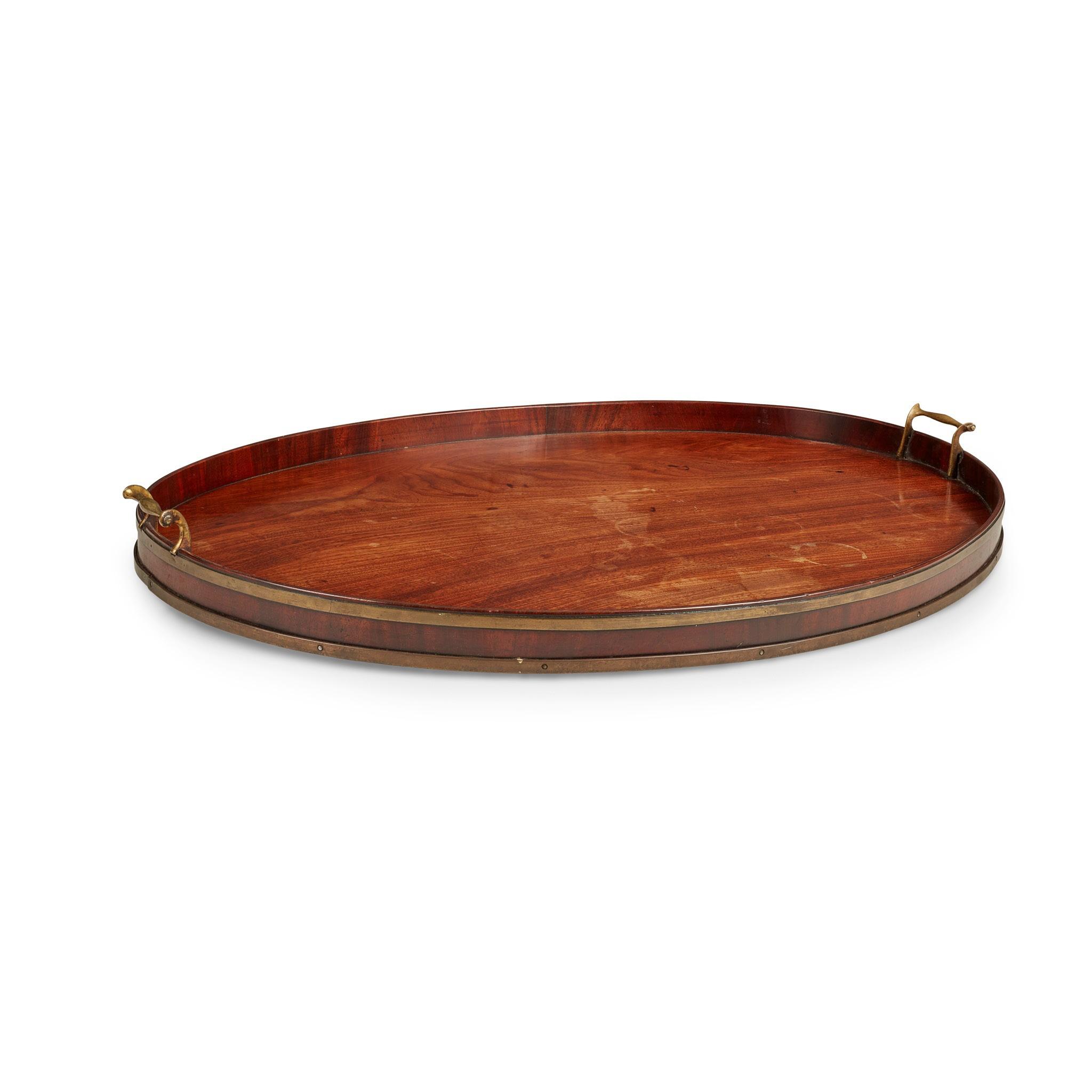
EARLY 19TH CENTURY
of large oval form with a low plain gallery and a pair of scrolling handles, bound with two brass bands
73cm long, 55cm wide, 7cm high
£300-500
GEORGE III MAHOGANY KETTLE STAND
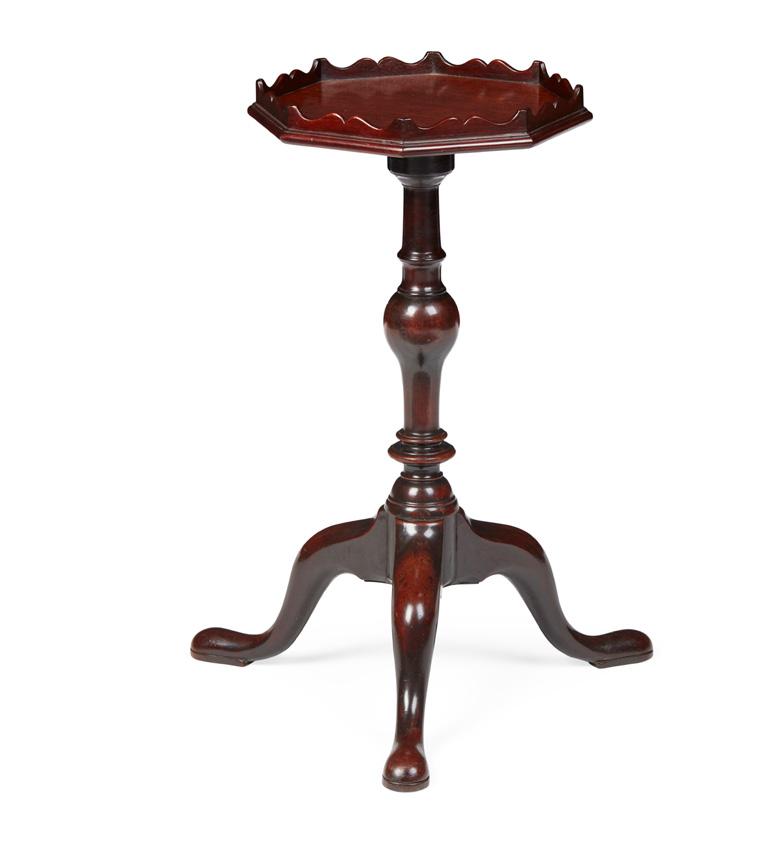
MID 18TH CENTURY
the octagonal top with a wavy gallery supported on a bulbous baluster column raised on a tripod base ending in weighted pad feet
31cm diameter, 62cm high
£2,500-3,500
GEORGE III MAHOGANY KNIFE BOX AND WINE CADDY
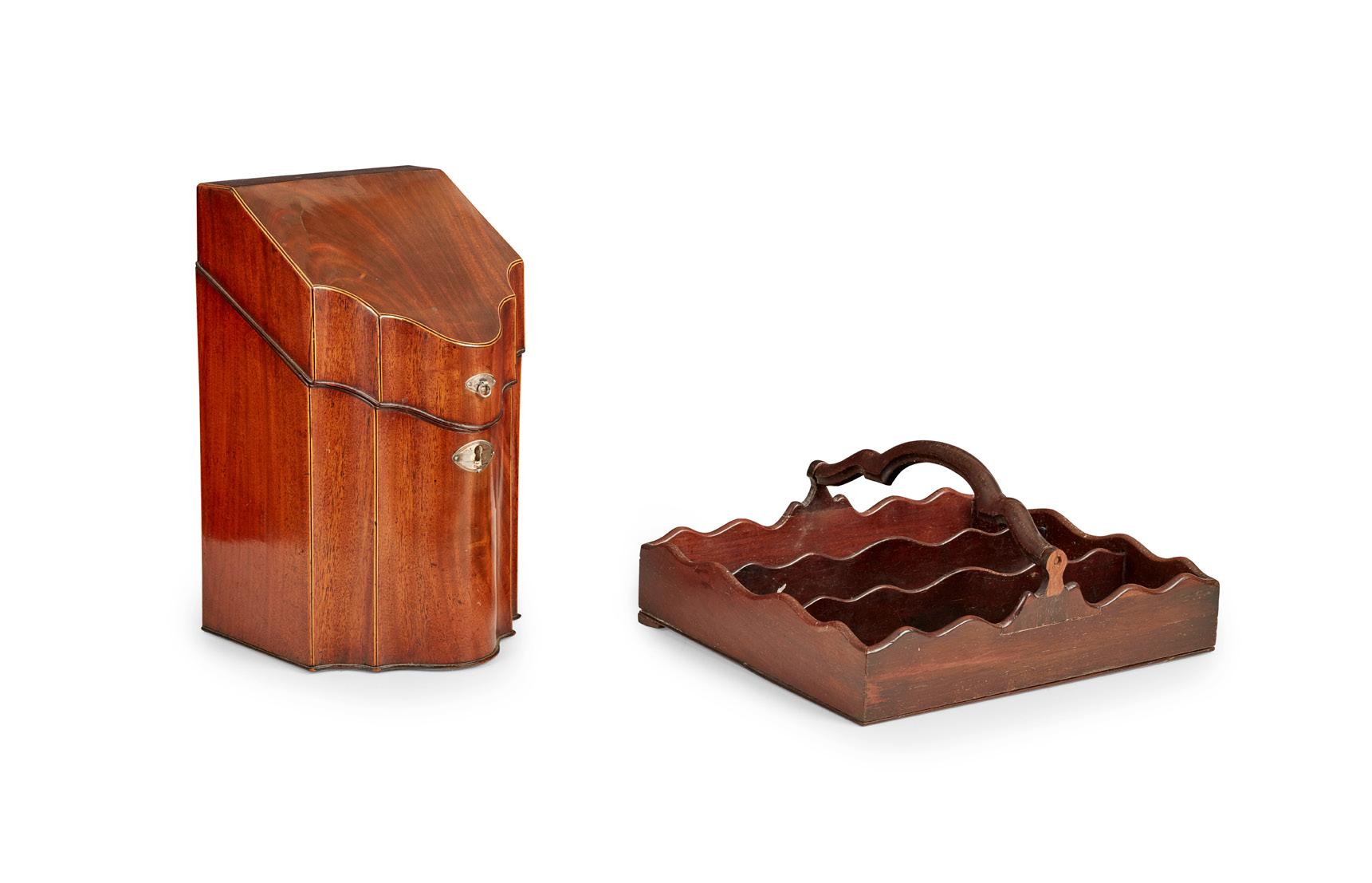
LATE 18TH/ EARLY 19TH CENTURY
the knife box of serpentine outline with a sloped lid inlaid with a star motif, opening to a fitted interior; the wine caddy with a serpentine edge and three divisions and an arched swing handle, with later baize lining 20cm wide, 33cm high, 20cm deep and 32.5cm wide, 11cm high, 28cm deep respectively
Provenance: Private Scottish Collection, Morayshire
£300-500
57
GEORGE III MAHOGANY CELLARETTE

EARLY 19TH CENTURY
of sarcophagus form, the crossbanded top opening to a void, lead-lined interior, the sides with brass lion’s head handles, above reeded base moulding and raised on carved paw lion feet with recessed brass castors
75cm wide, 47cm high, 46cm deep
Provenance: Private Scottish Collection, Morayshire
£400-600
54
55
56
22 Other fees apply in addition to the hammer price: see the ‘Buyer’s Guide’ section on page 2
GEORGIAN STYLE MAHOGANY AND GILT TRIPLE OVERMANTEL MIRROR LATE 19TH/ 20TH CENTURY

the three mirror plates in moulded gilt slips and scrolled frame with a pierced gilt eagle cresting
64cm high, 144cm wide
£300-500
59
SCOTTISH GEORGE III MAHOGANY LIBRARY ARMCHAIR, IN THE MANNER OF PETER ALEXANDER
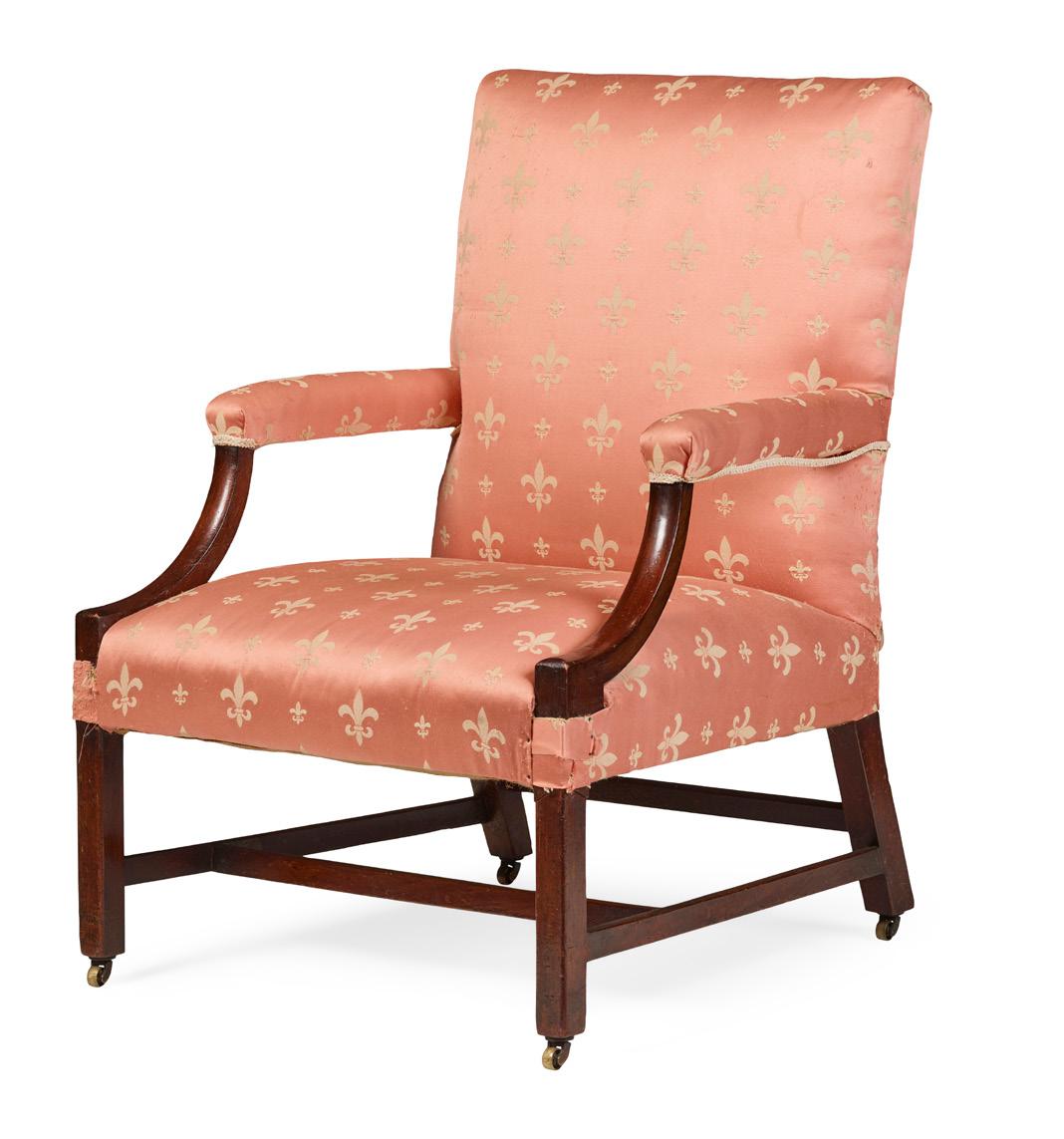
18TH CENTURY
the square padded back above a wide seat flanked by padded open arms on downswept mahogany supports, raised on square straight legs joined by stretchers and ending on brass castors
71cm wide, 101cm high, 53cm deep
£800-1,200
60
GEORGE III MAHOGANY CONCAVE BUREAU MID 18TH CENTURY
the slope front opening to an arrangement of pigeon holes and drawers, over two short drawers and three concave fronted long drawers, with brass handles to the sides, raised on short bracket feet
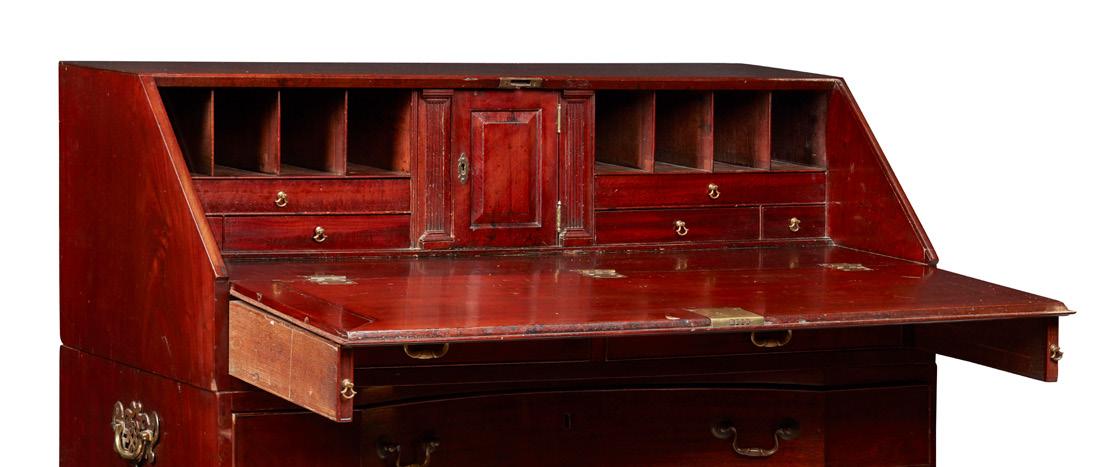

119cm wide, 105cm high, 58cm deep
£2,000-3,000
58
23
61
NEOCLASSICAL STYLE GILTWOOD OVERMANTEL MIRROR

19TH CENTURY
the rectangular mirror plate enclosed by margin plates and a bead moulded frame, surmounted by an urn finial issuing scrolling floral garlands, flaming torches and flanked by a pair of griffins, supported on paw feet with a central pendant shell 116cm wide, 109cm high
£600-800
62
SET OF SIX GEORGIAN MAHOGANY DINING

EARLY 19TH CENTURY
CHAIRS
with Chippendale Gothick style tracery splats above drop-in pad seats, on square legs united by H-stretchers (6)
53cm wide, 98cm high, 45cm deep
£800-1,200
63
SCOTTISH LABURNUM AND MAHOGANY BIRDCAGE TEA TABLE
MID 18TH CENTURY
the circular mahogany tilt top on a birdcage with locking pin mechanism, raised on a baluster column and tripod base ending in pointed pad feet 81cm diameter, 71cm high
£600-800
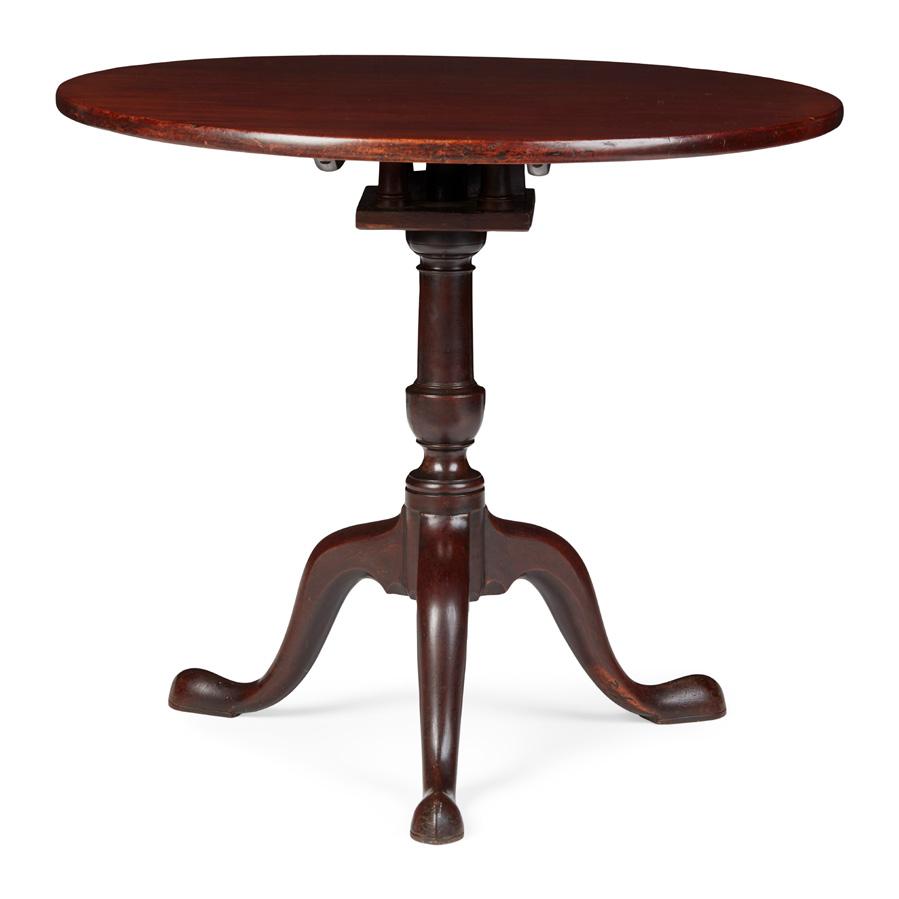
24 Other fees apply in addition to the hammer price: see the ‘Buyer’s Guide’ section on page 2
RARE SCOTTISH BROOM WOOD VENEERED CHEST OF DRAWERS, ATTRIBUTED TO GEORGE SANDEMAN OF PERTH

MID 18TH CENTURY
the top with two panels of long-section broom veneers enclosed by short-section crossbanded borders, above three short and two further short drawers over two further long drawers, all crossbanded with short-section broom veneers, the side panels with long-section veneer, applied to an oak carcass, the drawers lined in original blue sugar paper liners, raised on bracket feet
126cm wide, 92cm high, 63cm deep
£4,000-6,000
Note: This remarkable and rare example of a Scottish chest of drawers is most likely the work of George Sandeman (1724-1803) a Perth based cabinet maker. It is veneered entirely in Scots broom, a wood relatively unheard of outside of Scotland, and highly unusual to be found on such a substantial piece of furniture. The chest’s carcass is made of oak, consistent with known pieces by Sandeman, and the drawer linings still retain their original blue sugar paper linings, a feature specified in the ‘Edinburgh Cabinet Makers’ Book of Prices’, 1805. The chest’s form with three short drawers above others is also a characteristic typically associated with Scots furniture.
Scots broom, or cytisus scoparius, is a deciduous shrub rarely growing beyond three meters in height, with its stems generally being about five centimetres thick. The plant seldom reaches sufficient size to be of much value, but larger specimens were highly valued by cabinet makers for their distinctive veneers. When properly treated, the wood is
beautifully grained with high contrast between the heart and sap woods, but because of the limitations in size, it was used primarily for decorative borders and banding. Pieces made entirely from broom are exceptionally rare, as the cost to source and produce a piece would have been extremely high.
In 1758-59 George Sandeman was commissioned by the Duke of Atholl to make a suite of furniture for Blair Castle, Perthshire, using timber from the estate. Sandeman’s use of Scots broom was highly unusual, and must have come about at the request of the Duke, as broom is a notoriously challenging wood to use. Sandeman’s suite included a number of tables and a spectacular bureau cabinet, which is still on display in the Derby Dressing Room at Blair Castle. The bureau took five workmen 211 days to make at a cost of £19. 10s. 8d. A visitor to Blair Castle in 1769, Thomas Pennant, recorded seeing the furniture and remarked ‘A chest of drawers of Scotch broom, most elegantly striped, is a singular curiosity’.
64
25
67 Y
GEORGIAN DOUBLE-SIDED MOURNING PENDANT
LATE 18TH/ EARLY 19TH CENTURY
each oval on ivory, one side painted with a young couple weeping by a tomb with a large urn, within a seed pearl and black enamel border; the reverse painted with a weeping young woman presenting a chalice to a weeping old women with an angel visible through an open window, within a blue enamel border; in an unmarked yellow metal frame with suspension loop
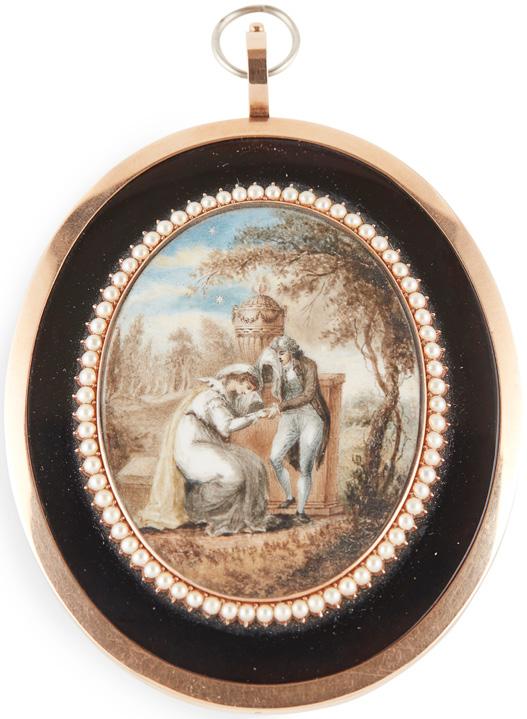
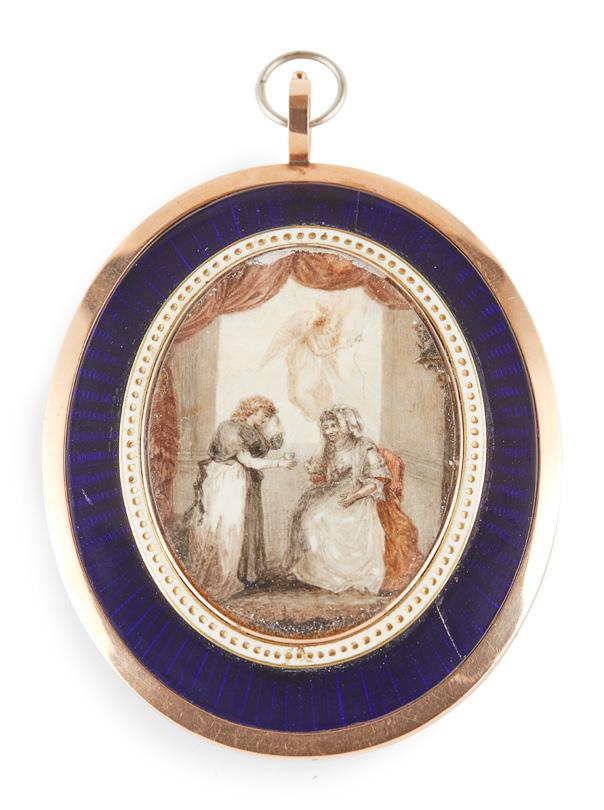
5.5cm high, 8.7cm overall
Note: Sold in compliance with UK Government and APHA regulations, with (non-transferable) exemption registration reference WUVAH43X
£800-1,200
THREE PORTRAIT MINIATURES
EARLY 19TH CENTURY
all watercolour and bodycolour on ivory, to include a portrait of a young man with blonde hair, in a gilt metal frame with rope-twist edge; a rectangular portrait of a young woman wearing a lace bandeau and gold hoop earrings, in a gilt metal frame; and a rectangular portrait of a man with dark hair wearing a red jewelled stickpin, in an embossed brass frame (3)
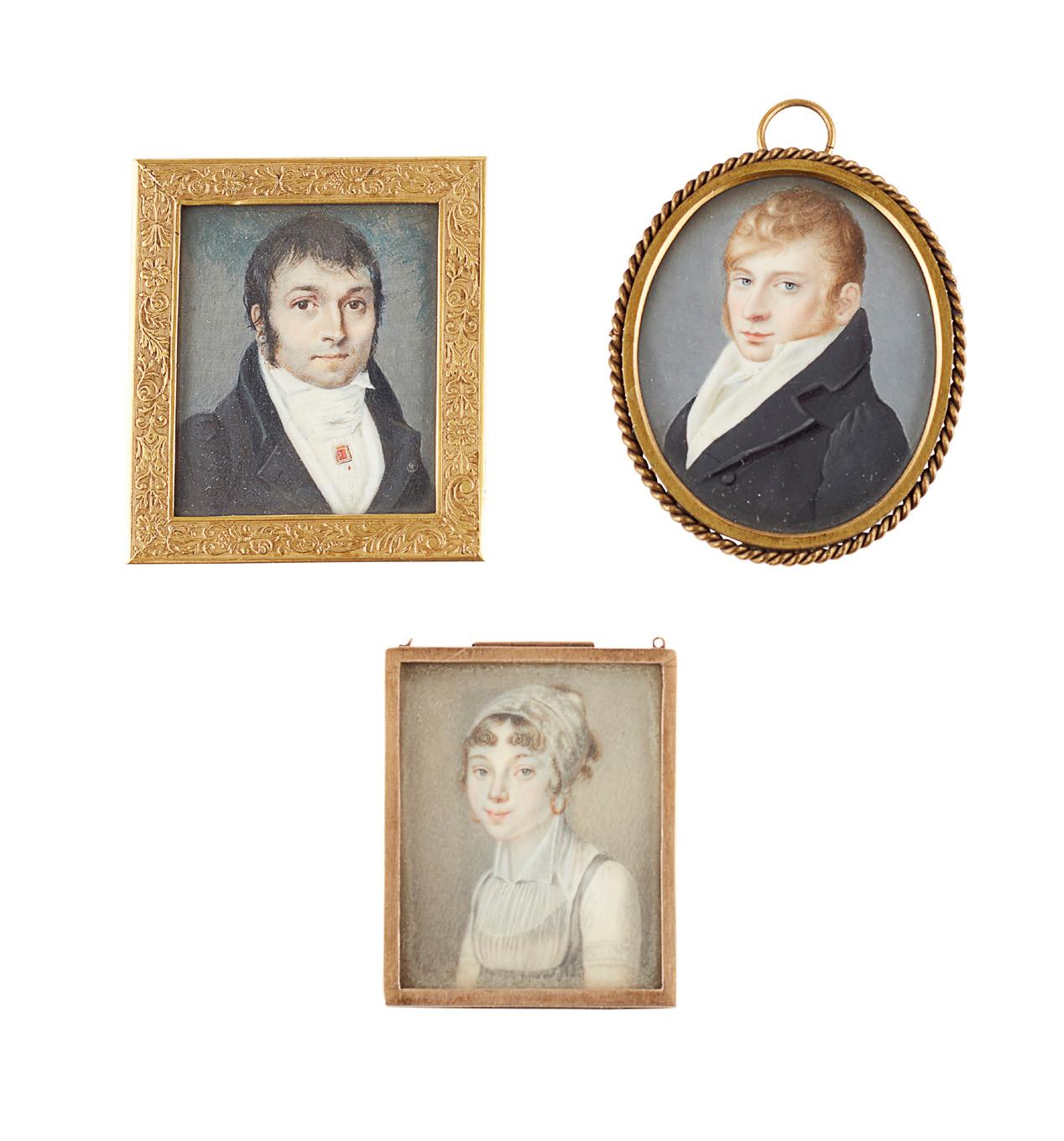
Largest 6.3cm high
Note: Sold in compliance with UK Government and APHA regulations, with (non-transferable) exemption registration submission Reference 30392417779
£400-600
66
ENGLISH ENAMEL PORTRAIT SNUFF BOX FOR THE MARQUIS DE LAFAYETTE
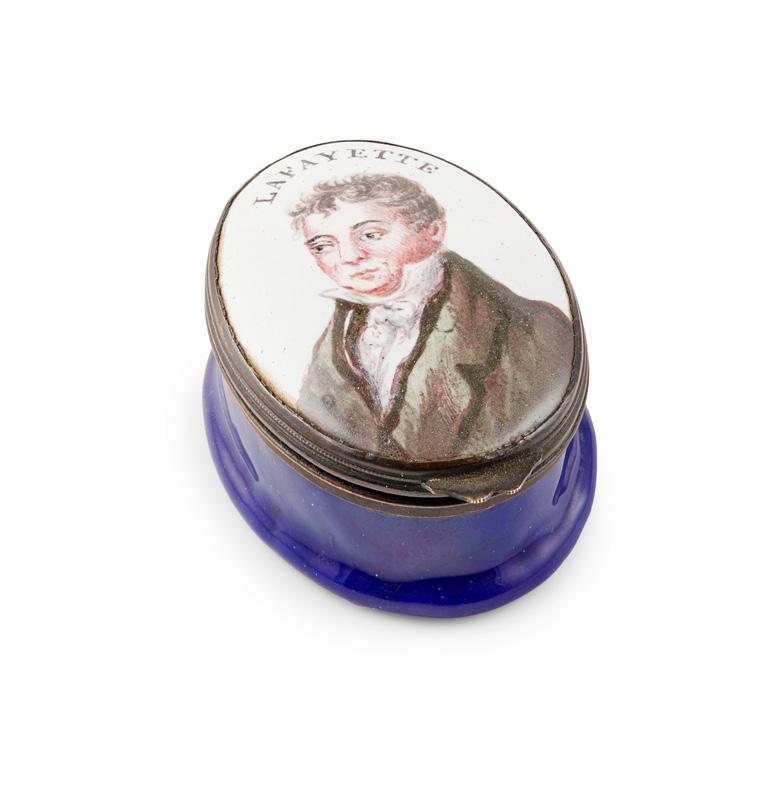
EARLY 19TH CENTURY
of oval form with a hinged domed cover and cobalt body, the cover polychrome decorated with a portrait of the sitter beneath the title LAFAYETTE; marked with an X to the interior
5cm long
£400-600
Note: Most likely a souvenir to commemorate the Marquis de Lafayette’s Farewell Tour of the United States in 1824-25.
68
PAIR OF GILT AND PATINATED BRONZE LAMPS
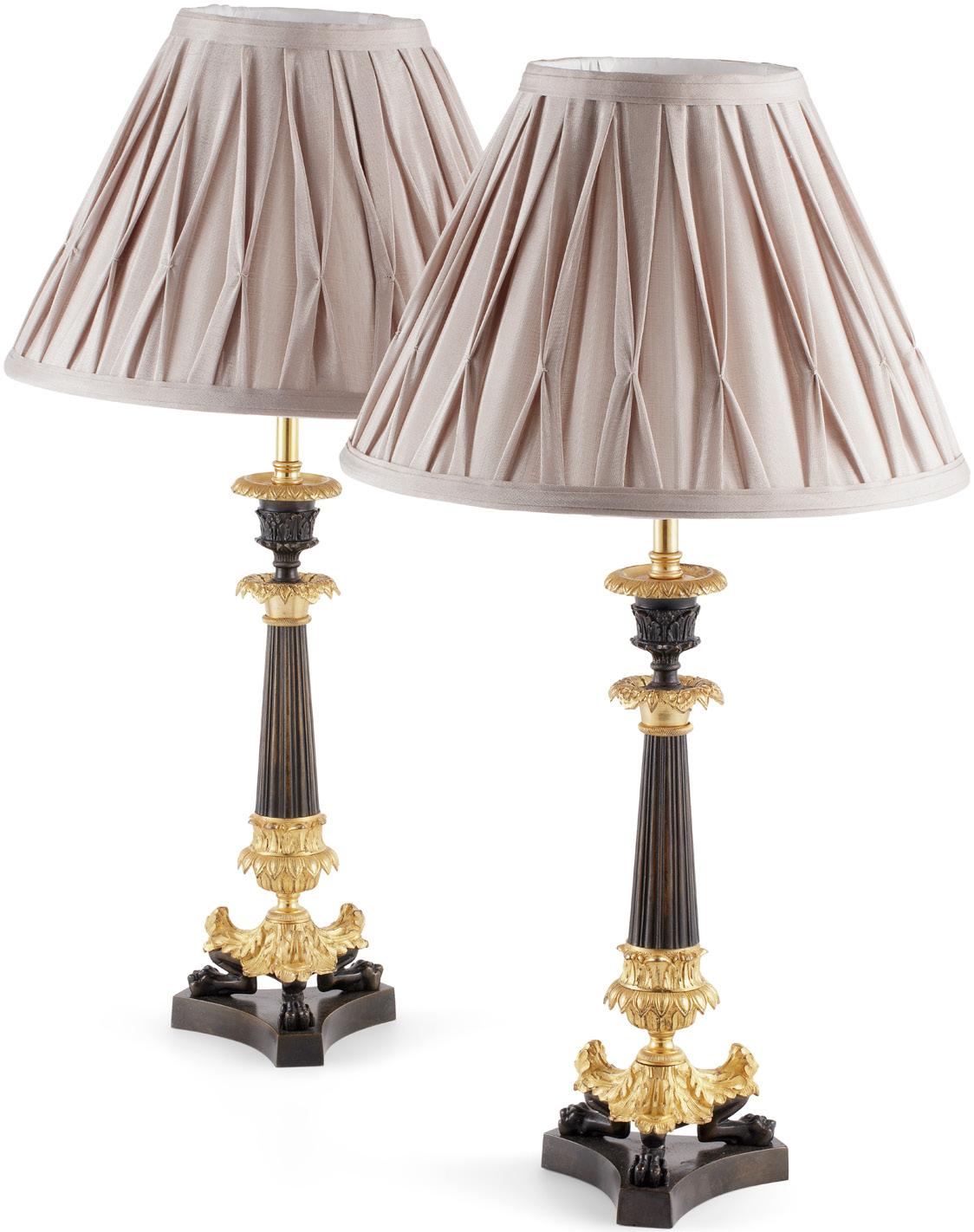
EARLY 19TH CENTURY
converted from candlesticks, with urn form nozzles above reeded stems on acanthus cast triform bases with paw feet, with pinchpleated taupe shades (2)
11cm diameter, 42cm high
£1,000-1,500
65
26
GEORGIAN SILK AND SILVER BROCADED GENTLEMAN’S WAISTCOAT MID 18TH CENTURY

the white silk brocaded in silver and gilt threads with an elaborate design of scrolling flowers and pomegranates, with twelve buttons and concealed button holes, the serpentine side pockets each with three decorative buttons, lined with cream linen and silk approx. 90cm long
Provenance: By repute from the family of The Erskine’s of Alva, which included James Erskine, Lord Barjarg and Alva (Scottish 1722–1796). This waistcoat was on longterm loan to The Museums of Scotland before being reclaimed by the current vendor’s mother, a descendant of the Fulton and Elibank families. Lord Alva was painted by Allan Ramsay (Scottish 1713 - 1784) wearing a very similar styled waistcoat, circa 1750. The painting is now in the collection of The National Galleries of Scotland, bequeathed by the 13th Baron Elibank in 1973, Accession Number PG 2216.
£800-1,200
Note: William Bardin is recorded as publishing globes from the 1780s onwards, a number of which were produced together with his contemporary Gabriel Wright (17401783). Bardin’s son, Thomas Marriott Bardin, joined the firm as an apprentice in 1783, shortly after the death of Gabriel Wright. Bardin operated on Fleet Street until 1795 when the company moved to Salisbury Square. Bardin’ son and granddaughter Elizabeth continued to make globes into the 1830s.


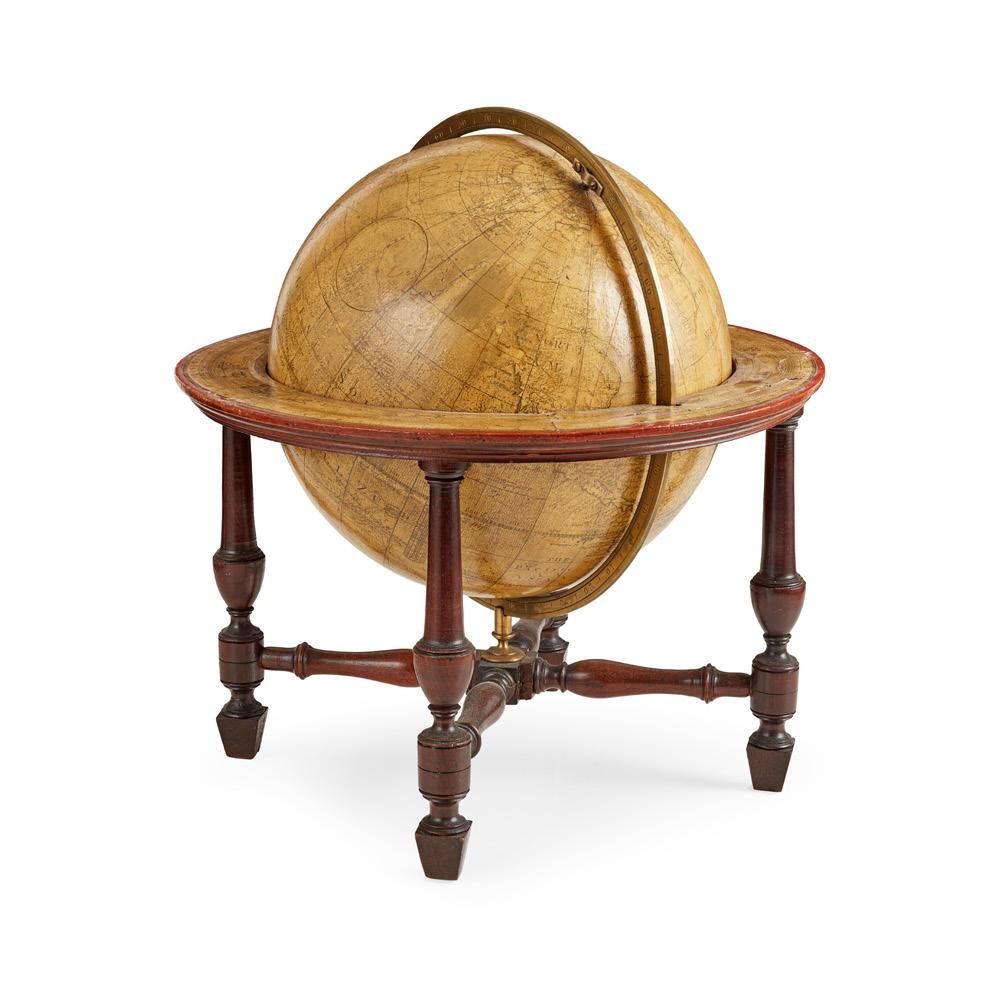
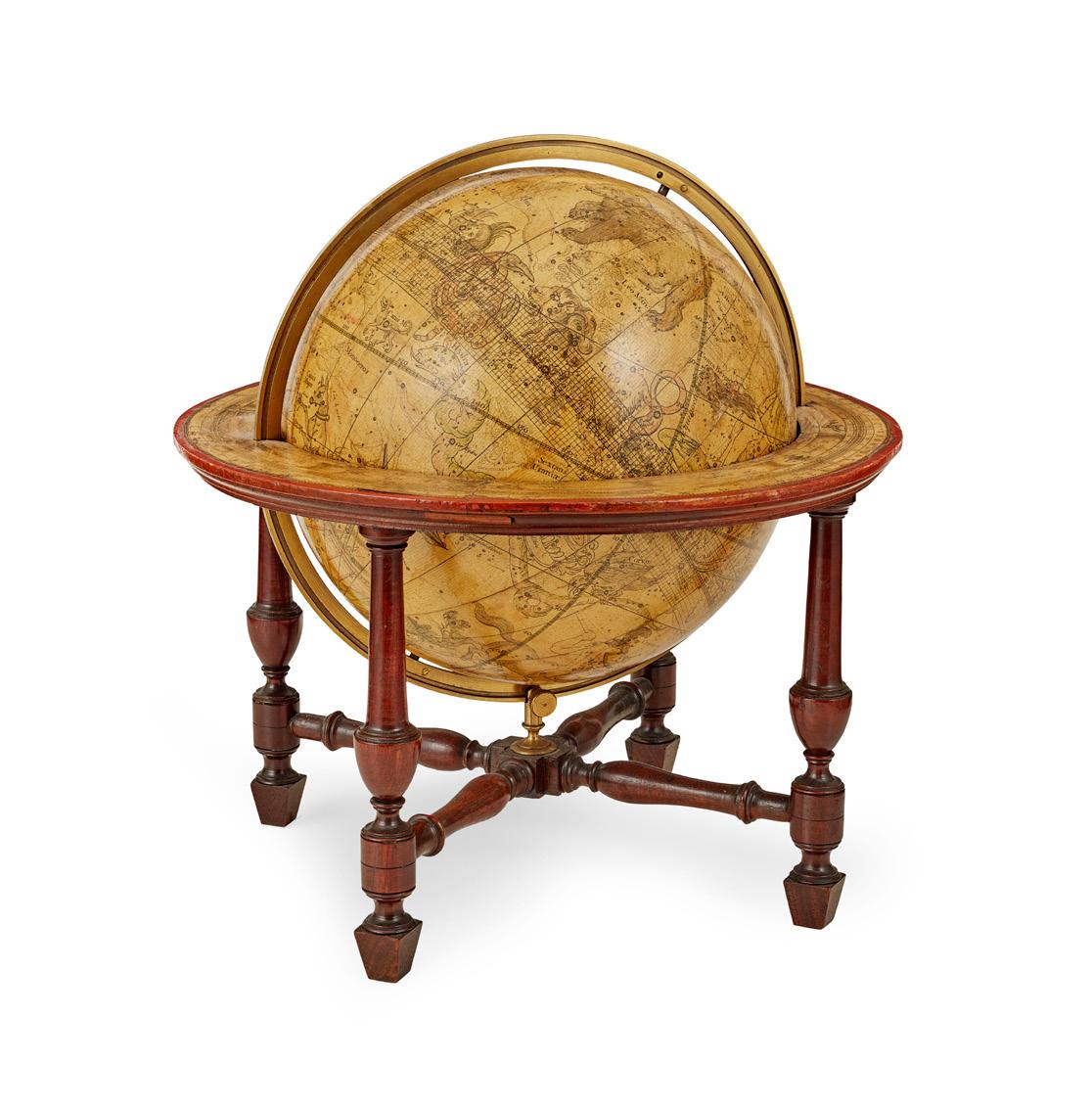
PAIR OF GEORGE III 9 INCH CELESTIAL AND TERRESTRIAL GLOBES BY WILLIAM BARDIN CIRCA 1785
the celestial cartouche reading, ‘The Celestial Globe, Accompanying the Geographical Magazine, Published as the act directs by Harrison & C° N° 18, Paternoster Row, Apr 1 1785, Made by W. Bardin Fleet Street, London’, the terrestrial cartouche indistinctly reading ‘...made by W. Bar... Fleet Street, London’, California is shown as a peninsula, Australia labelled ‘New Holland’, each globe mounted in a brass meridian within a horizon ring applied with astrological signs, on turned mahogany baluster stands with x-stretchers (2) 29cm diameter, 34cm high
Provenance: Purchased Christies, King Street, London, Fine English Furniture 25th Sept 1997, Lot 202
£3,000-5,000
69
70
27 Other fees apply in addition to the hammer price: see the ‘Buyer’s Guide’ section on page 2
James Erskine, Lord Barjarg and Alva (1722-1796) by Allan Ramsay, wearing a waistcoat similar to the present lot. © National Galleries of Scotland
71
SIX VARIOUS OPAQUE TWIST CORDIAL GLASSES

LATE 18TH CENTURY
three with an ogee bowl, three with a round funnel bowl, 14.6cm high - 16cm high; together with a PLAIN STEM GLASS with a single tear and flared trumpet bowl, 15.8cm high (7) largest 16cm high
£400-600
72

LARGE ENGRAVED COMMEMORATIVE RUMMER
DATED 1840
the flared bucket bowl engraved with a coat of arms, probably relating to the Grundy family, the shield surmounted by a leopard rampant crest; flanked to one side with an officer on horseback with a raised sword, and to the other side with a man hurling grenades alongside a British flag, above the date ‘1840’; further inscribed with the word ‘BLUE’ above the initials ‘J J W’, over a trumpeting angel; raised on a single knopped stem and a stepped circular foot
21cm high, the top of the bowl 14.2cm diameter
£250-350
73
SUITE OF BLOWN GLASS RUMMERS
20TH CENTURY
in the early 19th century style, each with a cupshaped bowl over a flattened knop and plain stem, on a circular foot; comprising twelve large glasses, eleven medium glasses and twelve smaller glasses (35)
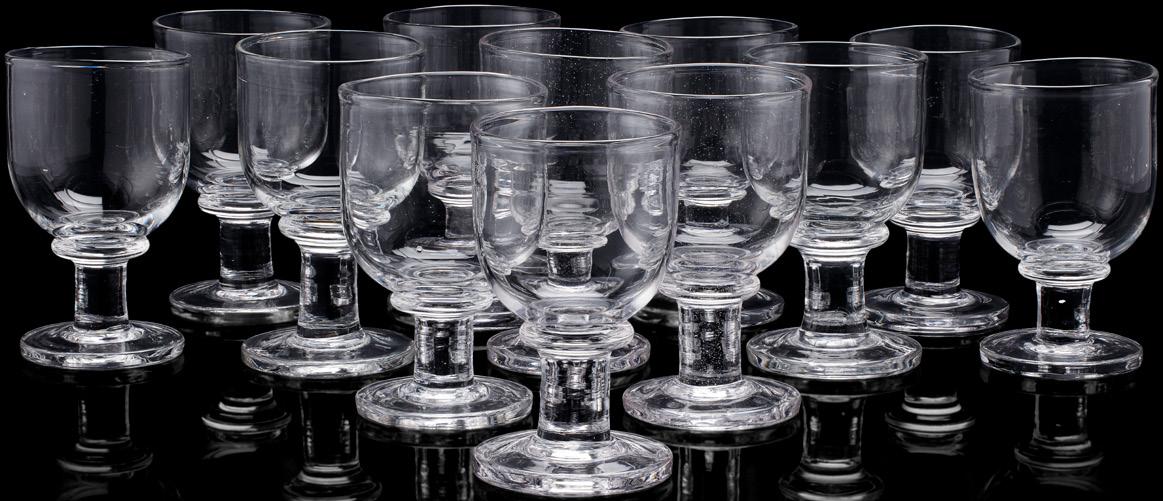
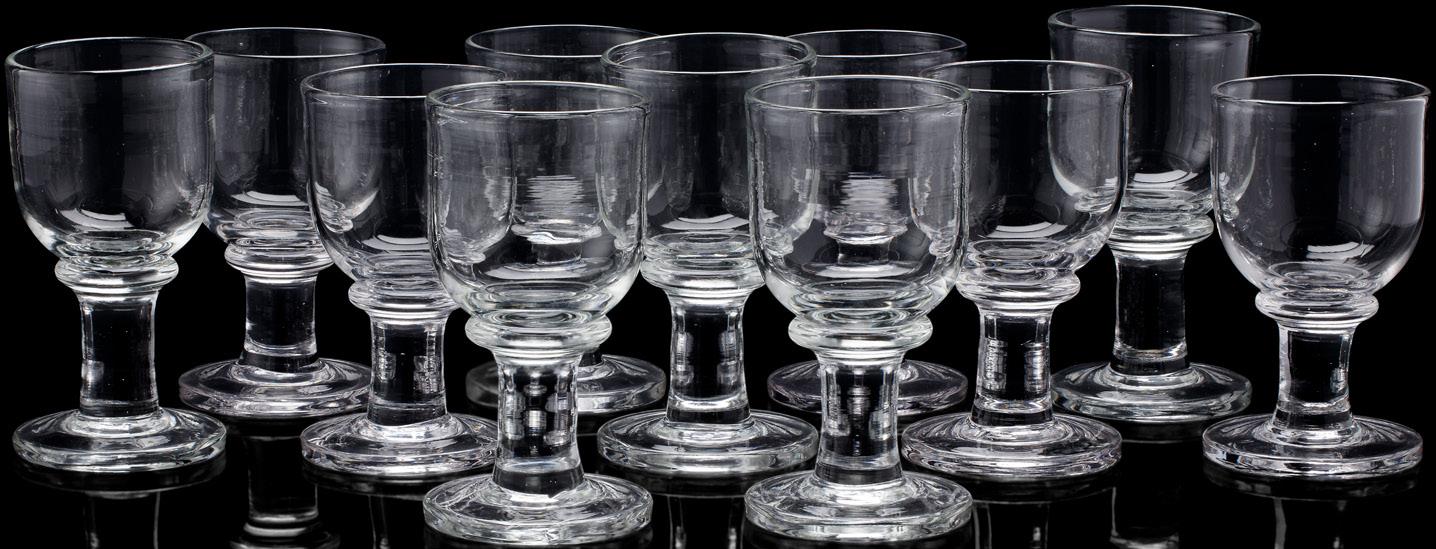
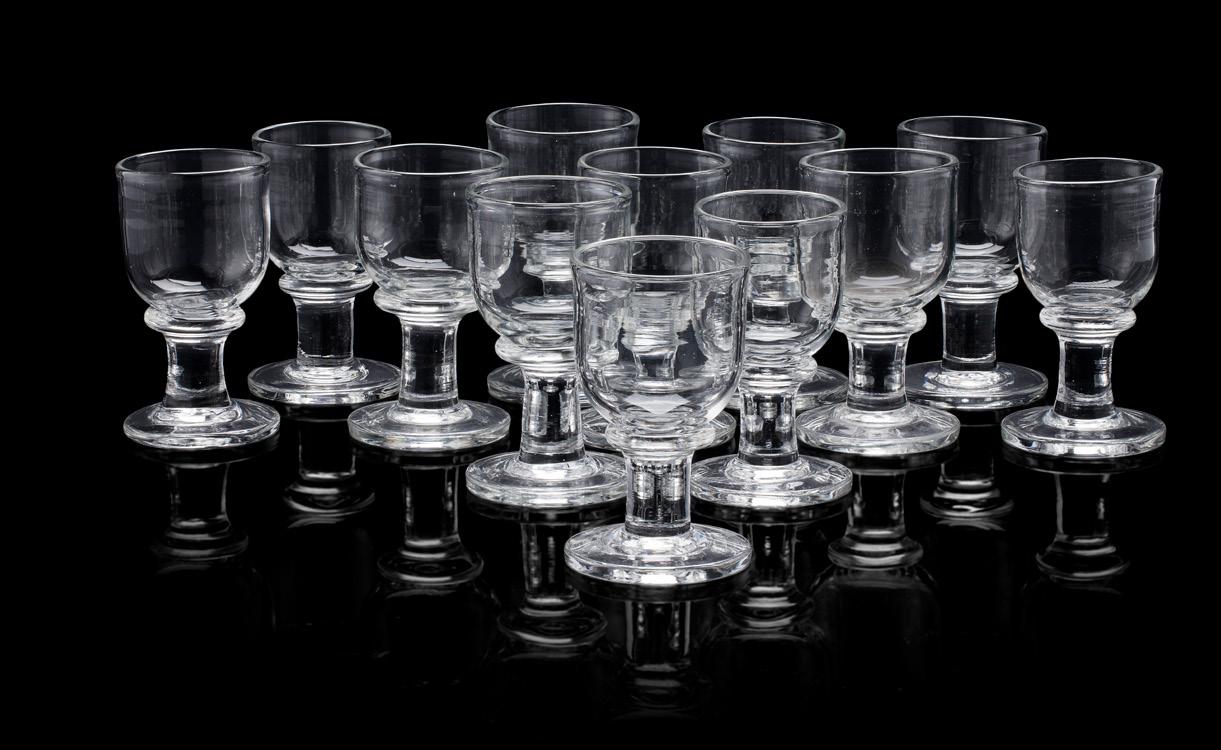

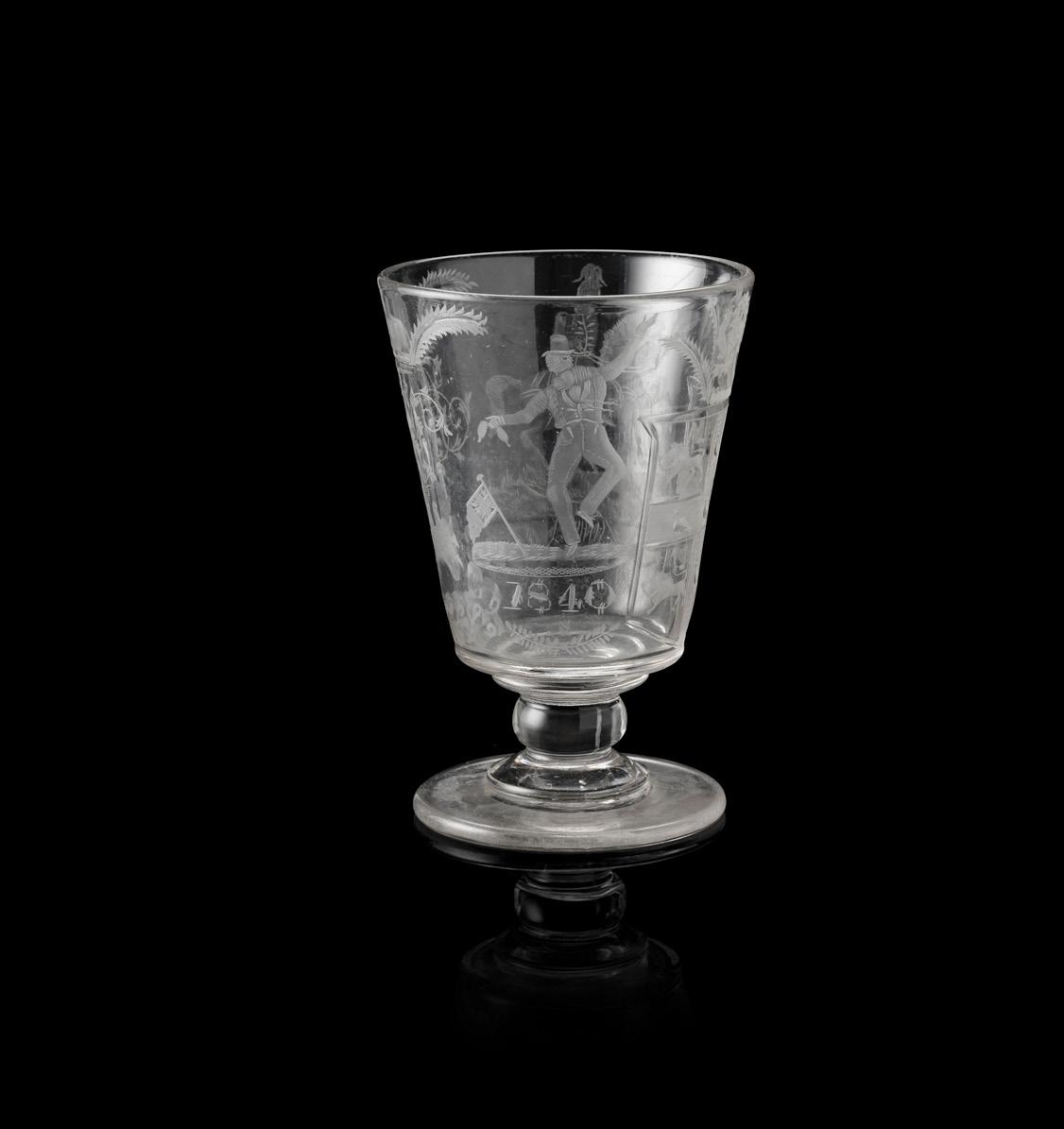
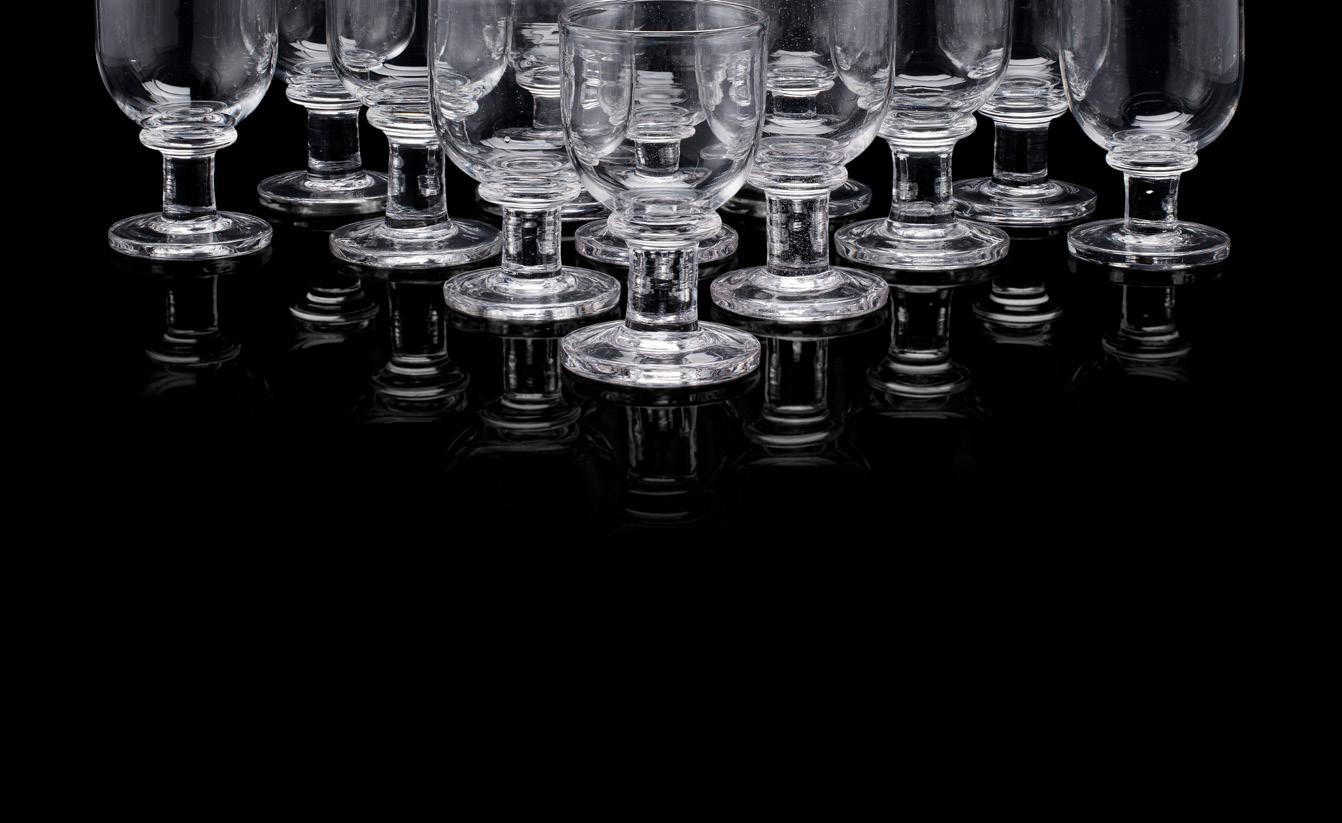
Sizes vary, the largest approx 15.4cm high, smallest approx 10.9cm high
£400-600
74
BURR ELM VENEERED MAHOGANY TEA CADDY
19TH CENTURY
of plain rectangular form, opening to two removeable caddies with hinged lids and a centre mixed bowl recess 33cm wide, 15.5cm high, 15.5cm deep
£200-300
28
GEORGE III MAHOGANY OCTAGONAL OCCASIONAL TABLE
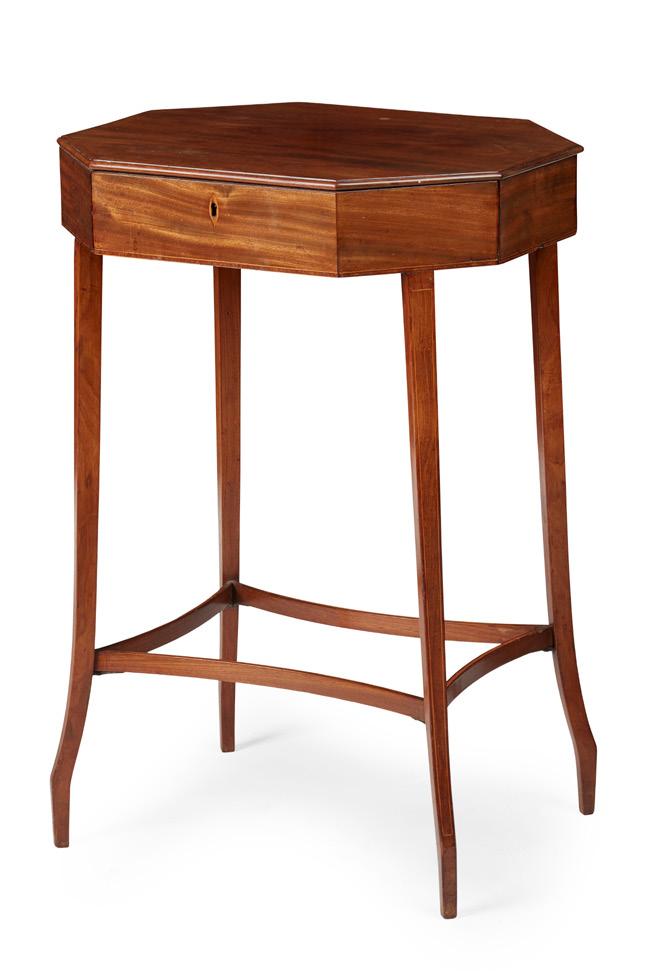
LATE 18TH CENTURY
the top with a moulded edge above dummy frieze drawer, raised on slender square legs joined by concave peripheral stretchers
53cm wide, 76cm high, 42cm deep
£300-500
SET OF SEVEN SATINWOOD LATTICE BACK CHAIRS, BY WRIGHT & MANSFIELD

LATE 19TH CENTURY
in the Sheraton style, with square lattice backs with corner paterae, above stuffover seats raised on tapering fluted legs, with black stencilled maker’s mark and stamped ‘A.R.H’ (7)
49cm wide, 88cm high, 48cm deep
£500-700 77
GEORGE III MAHOGANY BOWFRONT SIDEBOARD

LATE 18TH CENTURY with a central drawer above an arched recess, flanked by a deep drawer and a cupboard all divided by reeded panels and raised on square tapered legs ending in spade feet
180cm wide, 92cm high, 74cm deep
£400-600
76
75
29 Other fees apply in addition to the hammer price: see the ‘Buyer’s Guide’ section on page 2
LATE GEORGIAN CREAM PAINTED LIVERY CUPBOARD
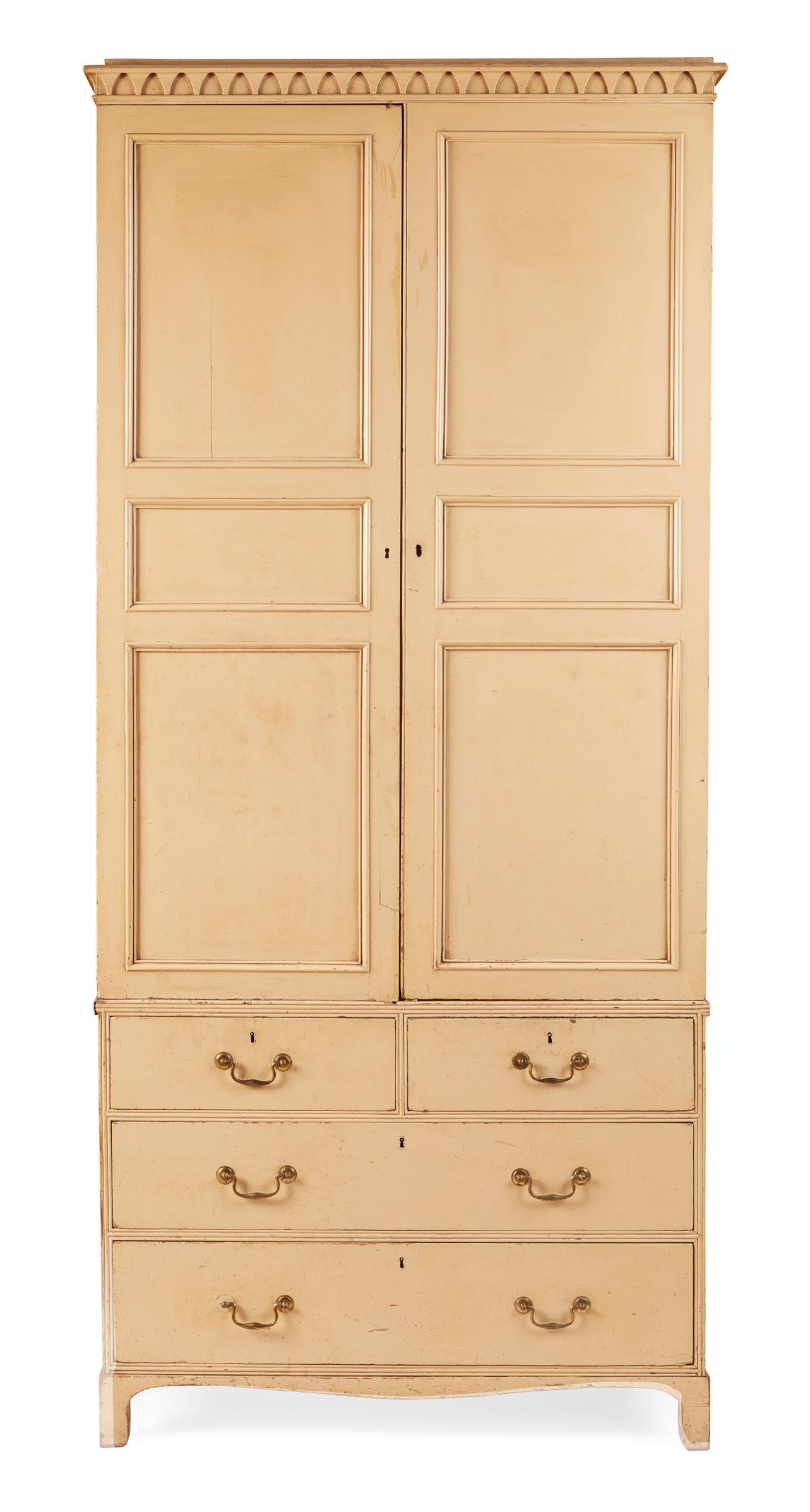
EARLY 19TH CENTURY
the arch moulded cornice above a pair of moulded triple panel doors enclosing four sliding trays, on a base with two short and two long drawers raised on bracket feet
104cm wide, 233cm high, 52cm deep
£500-800
ENGLISH CREWEL WORK PANEL
LATE 19TH CENTURY
worked with wool on canvas, depicting a climbing vine thick with flowers, birds and squirels, one corner with an embroidered numbered patch, unmounted approximately 260cm long x 55cm wide
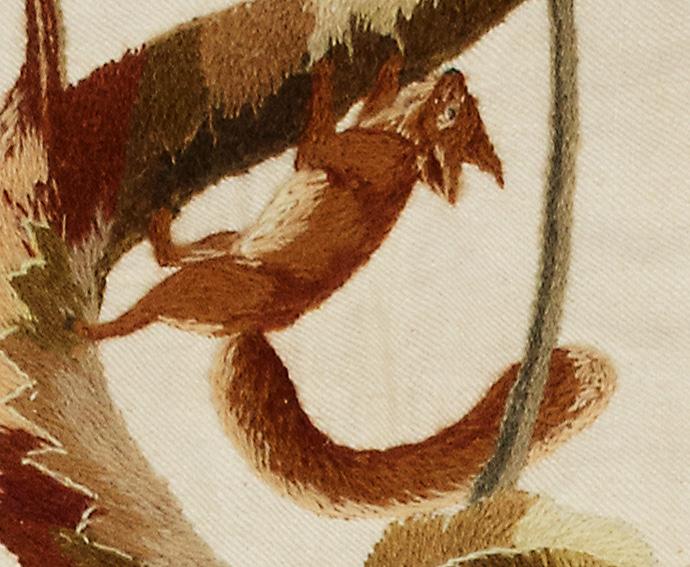

Provenance: Previously Morland House, Morland, Penrith, thence by Markham family descent to the present vendor
£400-600
78
79
30 Other fees apply in addition to the hammer price: see the ‘Buyer’s Guide’ section on page 2
81
TWO COPPER LOG BUCKETS
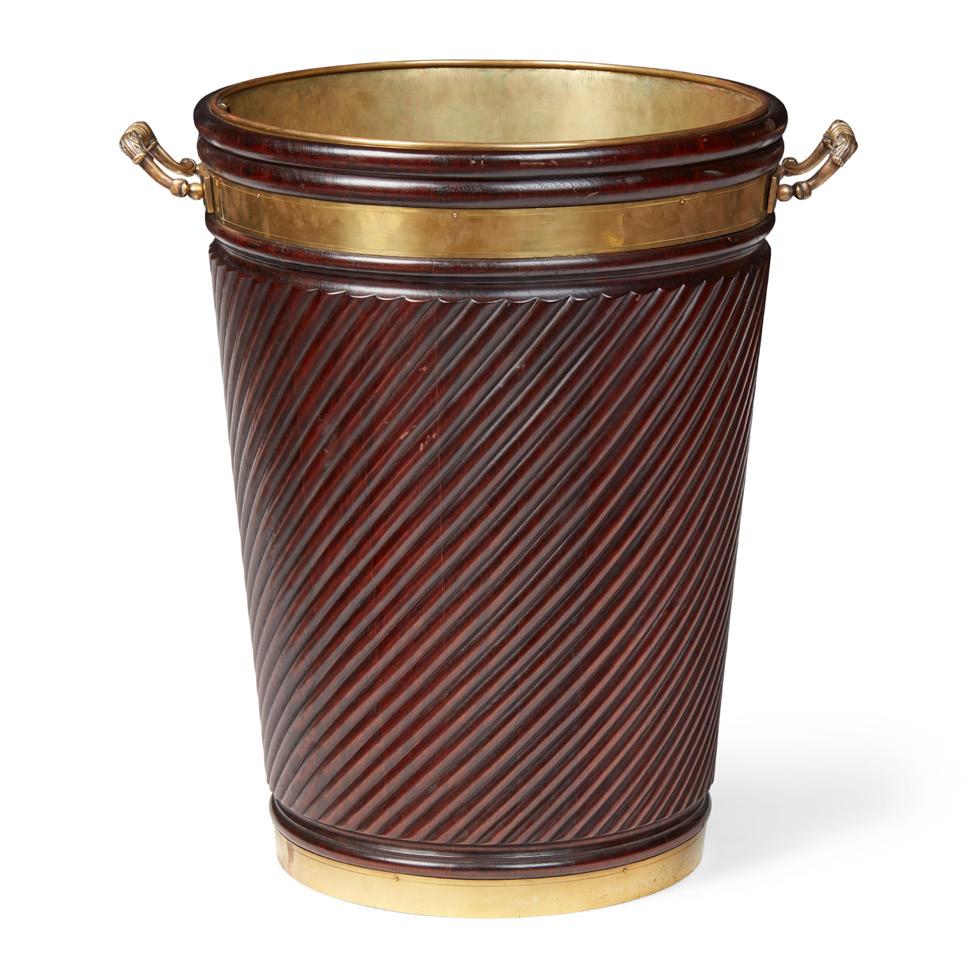
19TH CENTURY
the first with a riveted base and cast brass handles; the other ovoid with a planished copper top rim and brass body raised on three brass feet

48cm diameter, 31cm high and 45cm diameter, 43cm high
Provenance: Private Scottish Collection, Morayshire
£400-600
82
IRISH GEORGE III STYLE LARGE MAHOGANY AND BRASS PEAT BUCKET

LATE 20TH CENTURY with ribbed sides and brass bands and handles, the interior with a removable brass liner 51cm diameter, 66cm high £1,500-2,500

SET OF THREE GEORGIAN STEEL AND BRASS FIRE IRONS
EARLY 19TH CENTURY
comprising a shovel, a poker, and a pair of tongs, with cast knop handles with trellis design each 78cm long
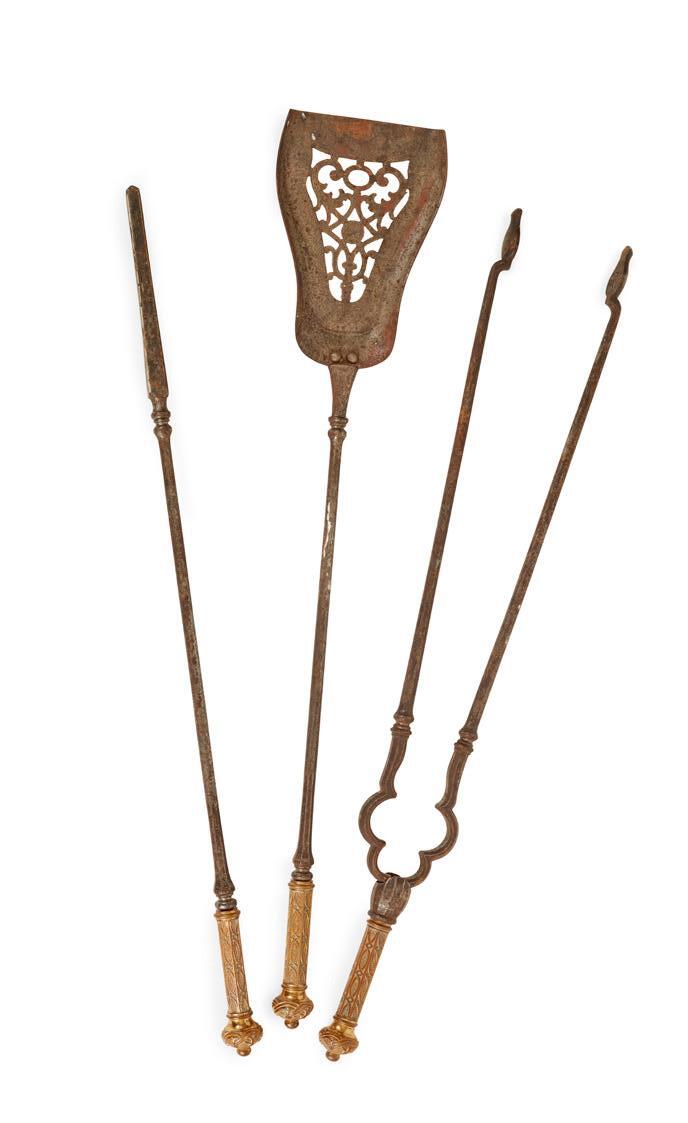
£300-500
83
ENGLISH ARTS & CRAFTS
STEEL, BRASS, AND CAST IRON ‘PHOENIX’ REGISTER GRATE
19TH CENTURY
the four bar grate with a castiron fireback depicting a phoenix rising from flames, flanked by steel quarter-round reflecting panels with freestanding brass baluster columns within an egg and dart surround 122cm wide, 99cm high [exterior]

Provenance: Auchendennan House, Argyll and Bute
£1,500-2,500
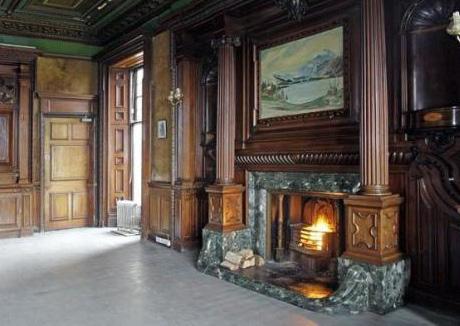
80
31
Lot 83 in situ at Auchendennan House
85
GEORGE III STYLE MAHOGANY LIBRARY ARMCHAIR
19TH CENTURY
the padded back with a serpentine top rail above a stuffover seat flanked by open padded arms on foliate carved mahogany supports, raised on shell-carved cabriole legs ending in ball and claw feet, covered in distressed blue and yellow silk damask
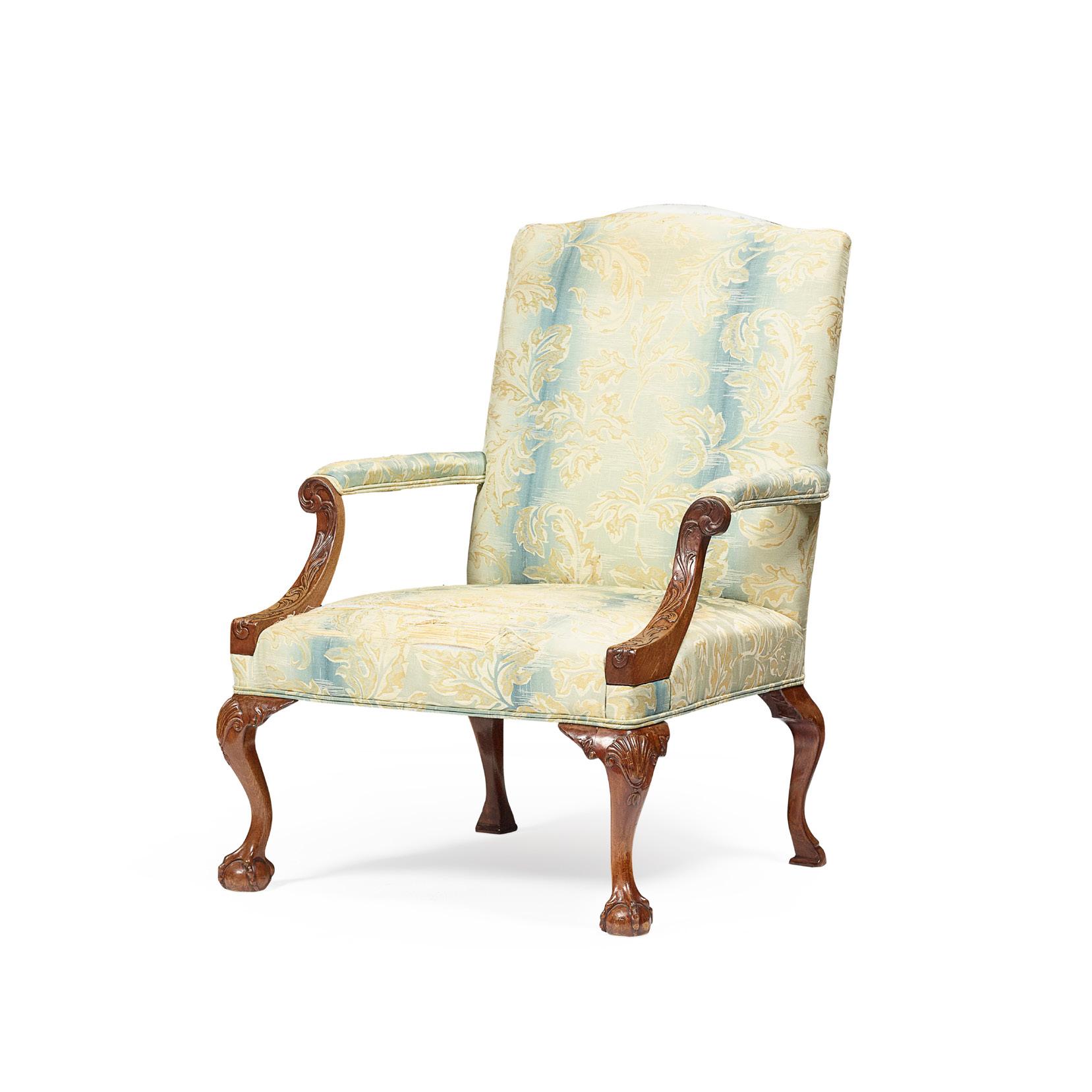
74cm wide, 102cm high, 56cm deep
£600-800
GEORGE III MAHOGANY SERPENTINE CARD TABLE
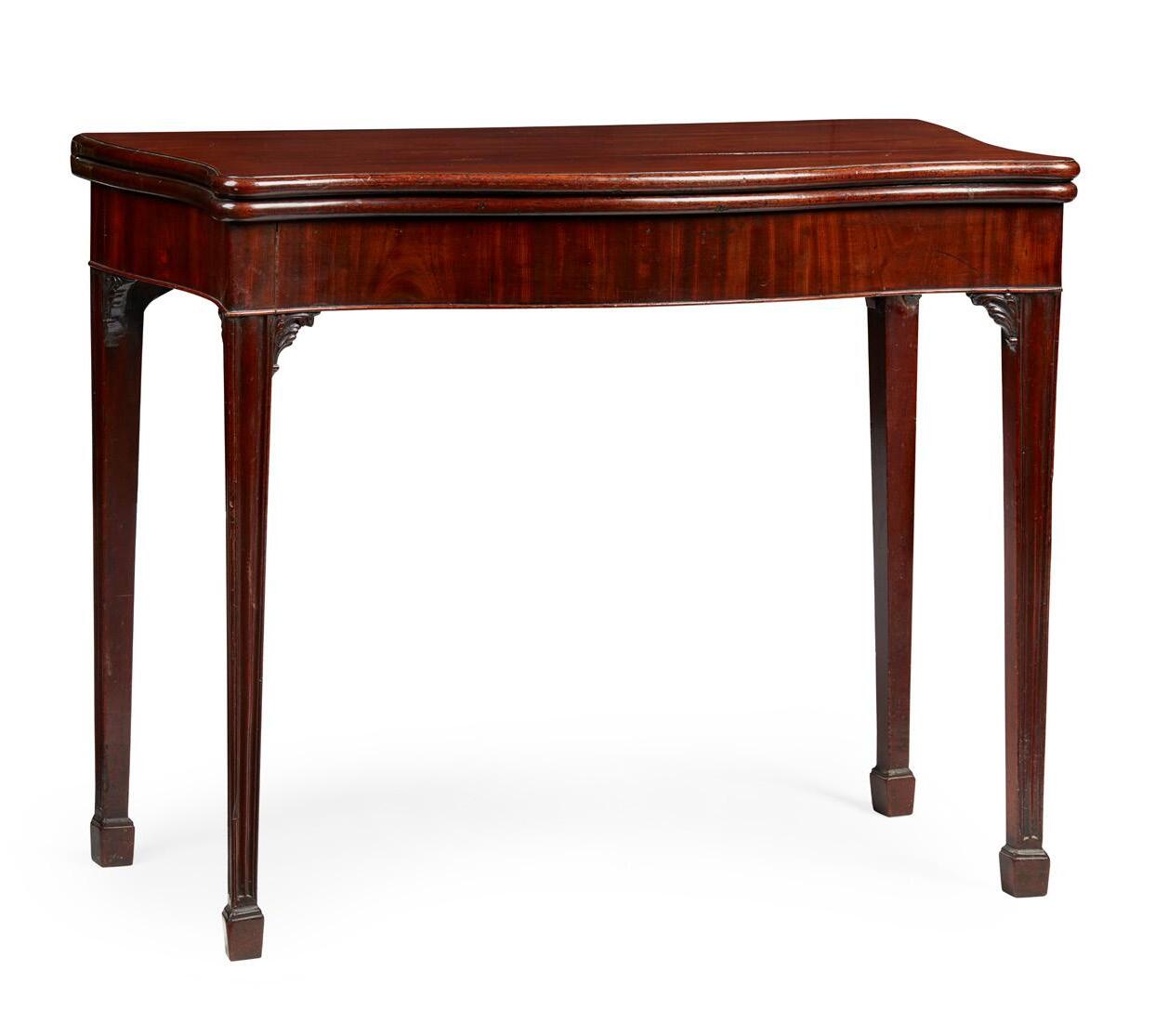
18TH CENTURY
the fold-over top opening to a green baize playing surface, raised on channel moulded square tapered legs with foliate carved brackets and ending in block feet, opening on a single gateleg
91cm wide, 72cm high, 42.5cm deep [closed]
£300-500
86
GEORGE III MAHOGANY CHEST OF DRAWERS

18TH CENTURY
the top with a moulded edge above two short and three long graduated drawers, on shaped bracket feet
96cm wide, 95cm high, 52cm deep
£800-1,200
84
32 Other fees apply in addition to the hammer price: see the ‘Buyer’s Guide’ section on page 2
87
LATE GEORGIAN EBONISED AND PARCEL-GILT MIRROR
LATE 18TH CENTURY
the rectangular mirror plate in a leaf tip moulded slip and moulded frame 90cm high, 76cm wide £300-500
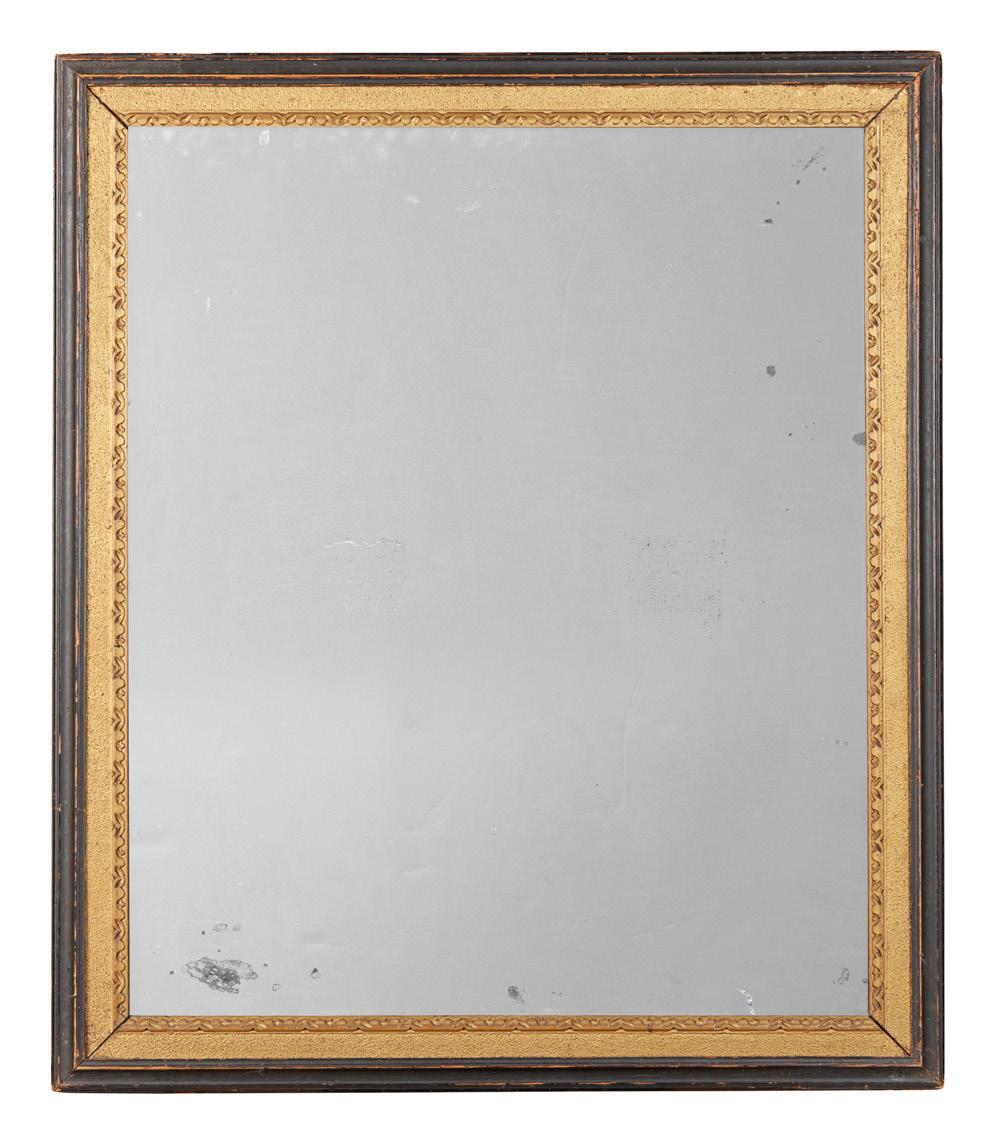
88
SCOTTISH GEORGE III MAHOGANY LONGCASE CLOCK, JOHN ADAMSON, KILMARNOCK

18TH CENTURY
the dentil moulded cornice above an arched brass dial with a silvered arch boss signed by the maker, over a silvered Roman numeral chapter ring and engraved silvered centre, subsidiary seconds dial and date aperture, with brass dolphin spandrels, above a plain trunk and plinth base; the eight-day, twin-chain movement striking a bell 223cm high, 48cm wide £500-700
89
SCOTTISH GEORGE III MAHOGANY TEA TABLE
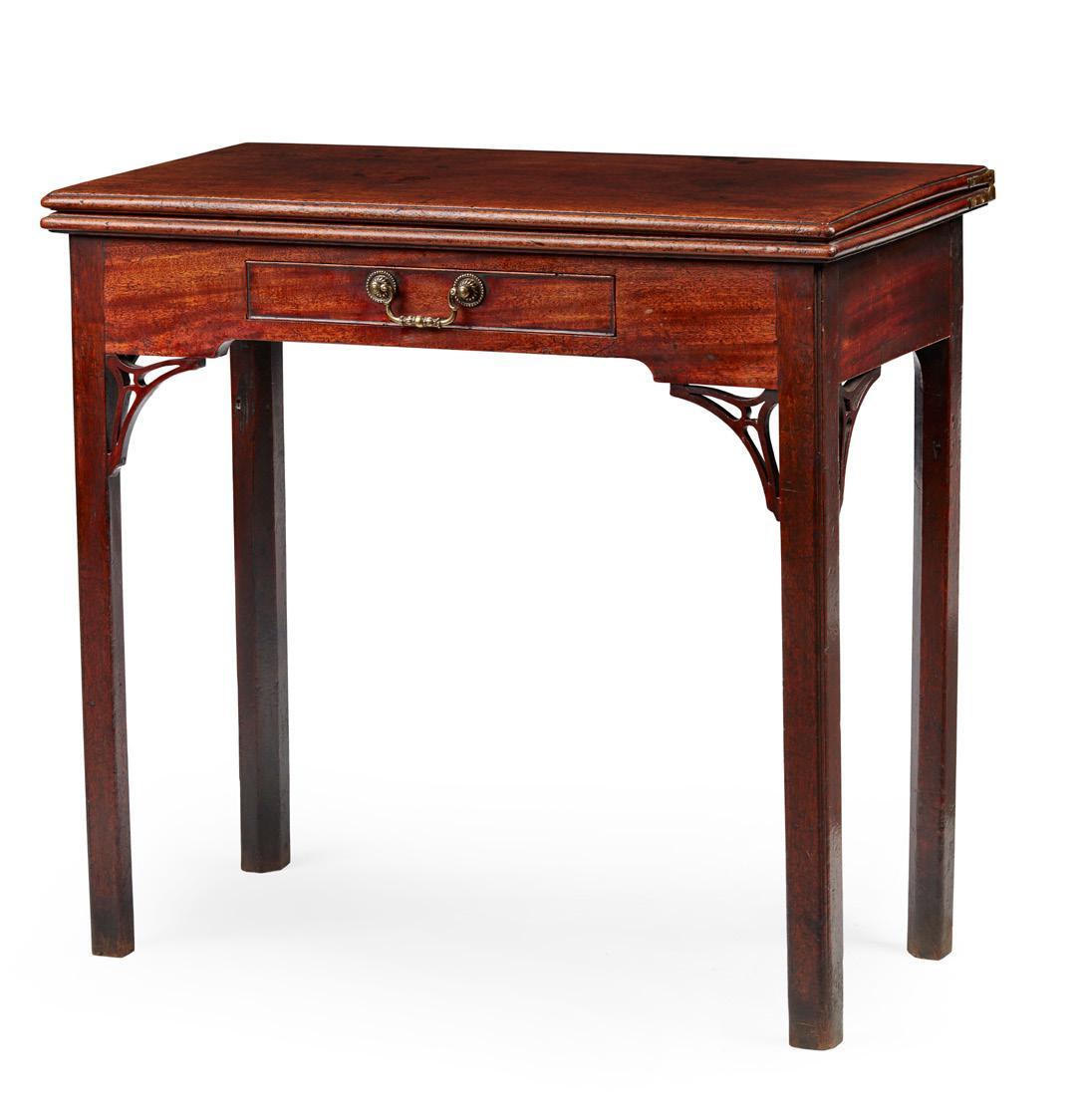
18TH CENTURY
the rectangular fold-over top above a short frieze drawer, raised on chamfered straight legs and opening on a single gateleg 76cm wide, 73cm high, 37cm deep [closed]
£300-500
33
90
GEORGE III MAHOGANY TRAY TOP BEDSIDE COMMODE
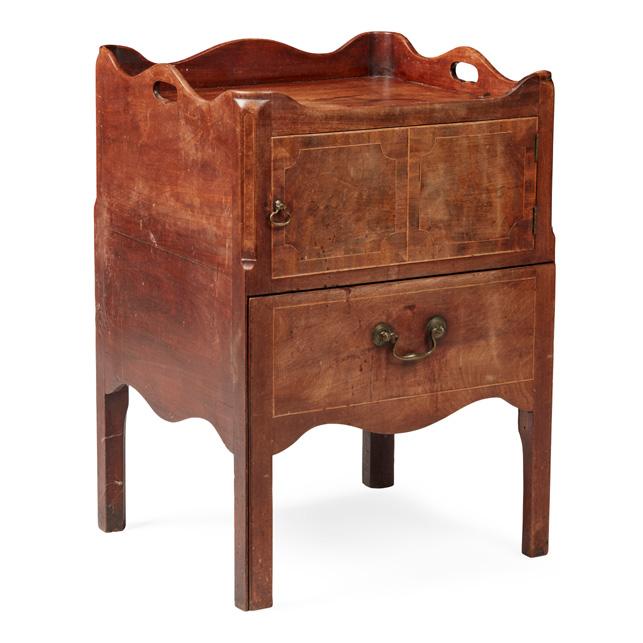
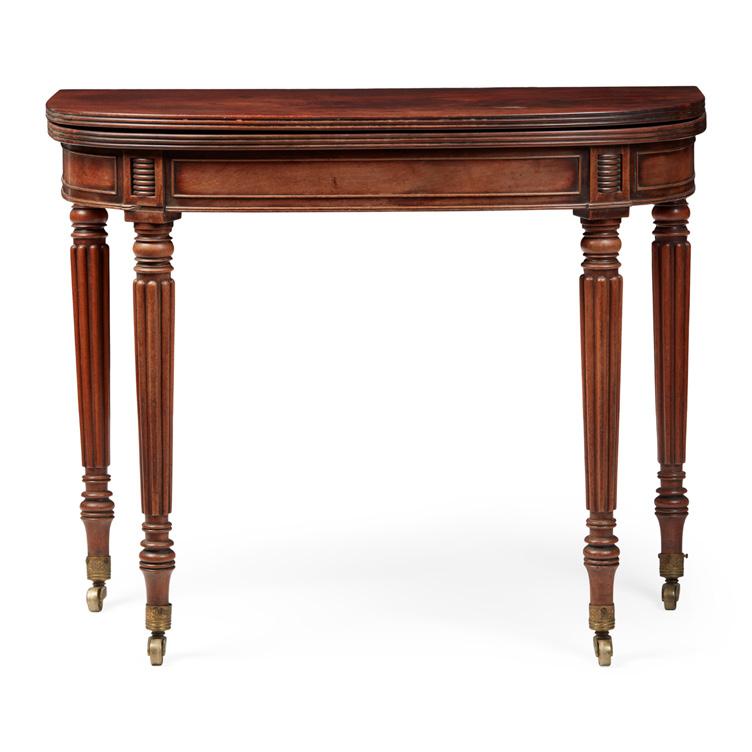
18TH CENTURY
the tray top with a wavy edge and cut-out handles, above a cupboard door and sliding potty drawer, raised on square chamfered legs 53cm wide, 75cm high, 48cm wide £400-600
91
TWO PAIRS OF GEORGIAN MAHOGANY BED POSTS



LATE 18TH/ EARLY 19TH CENTURY
one pair with egg and dart capitals over fluted columns and square bases; the other pair with stop-fluted columns on square bases, all with connecting bolts (4) 220cm and 221cm high
Provenance: Paxton House, Berwickshire, thence by descent to the current vendor £800-1,200
92
LATE GEORGIAN MAHOGANY TEA
TABLE, ATTRIBUTED TO GILLOWS
EARLY 19TH CENTURY
the D shaped fold-over top with a reeded edge, opening on double gatelegs, above a cockbead moulded frieze and raised on reeded tapered legs ending on brass caps and castors 91cm wide, 75cm high, 44.5cm deep [closed]
£400-600
93
GEORGE III MAHOGANY AND WALNUT PEMBROKE TABLE
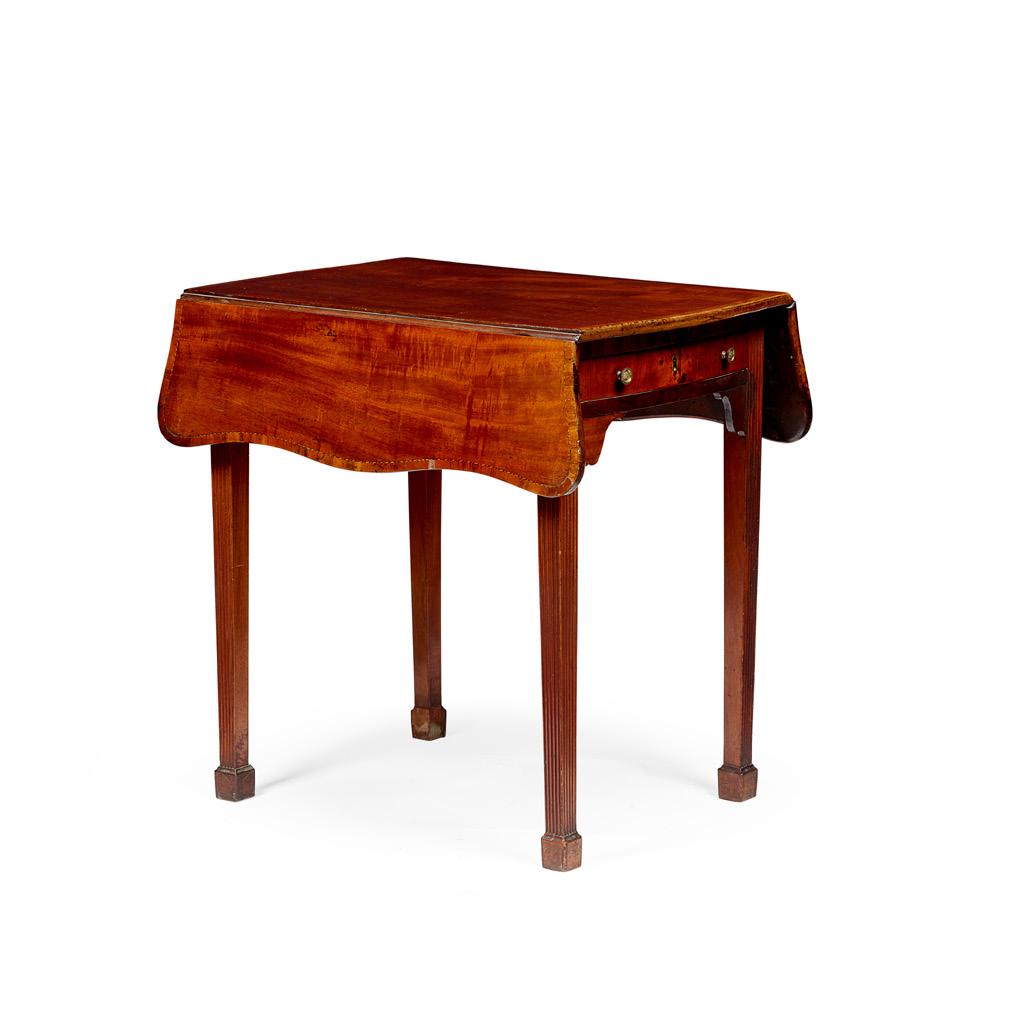
MID 18TH CENTURY
the serpentine crossbanded top with drop sides above a frieze drawer to one side, raised on reeded square tapered legs ending in block feet 74cm long, 73cm high, 51cm wide, 89cm [leaves up]

Provenance: Newton Don, Kelso; Harrietfield, Kelso; and thence by descent
£300-500
34 Other fees apply in addition to the hammer price: see the ‘Buyer’s Guide’ section on page 2
94
GEORGE III GILTWOOD OVAL MIRROR

LATE 18TH CENTURY
the oval mirror plate in a bead and flute moulded frame surmounted by an acanthus scroll pediment
77cm wide, 122cm high
£1,800-2,200
96
LATE GEORGE III MAHOGANY DRESSING CHEST OF DRAWERS
LATE 19TH CENTURY
the top with a deep three-quarter gallery and reeded edge above two short and two long drawers, raised on French bracket feet
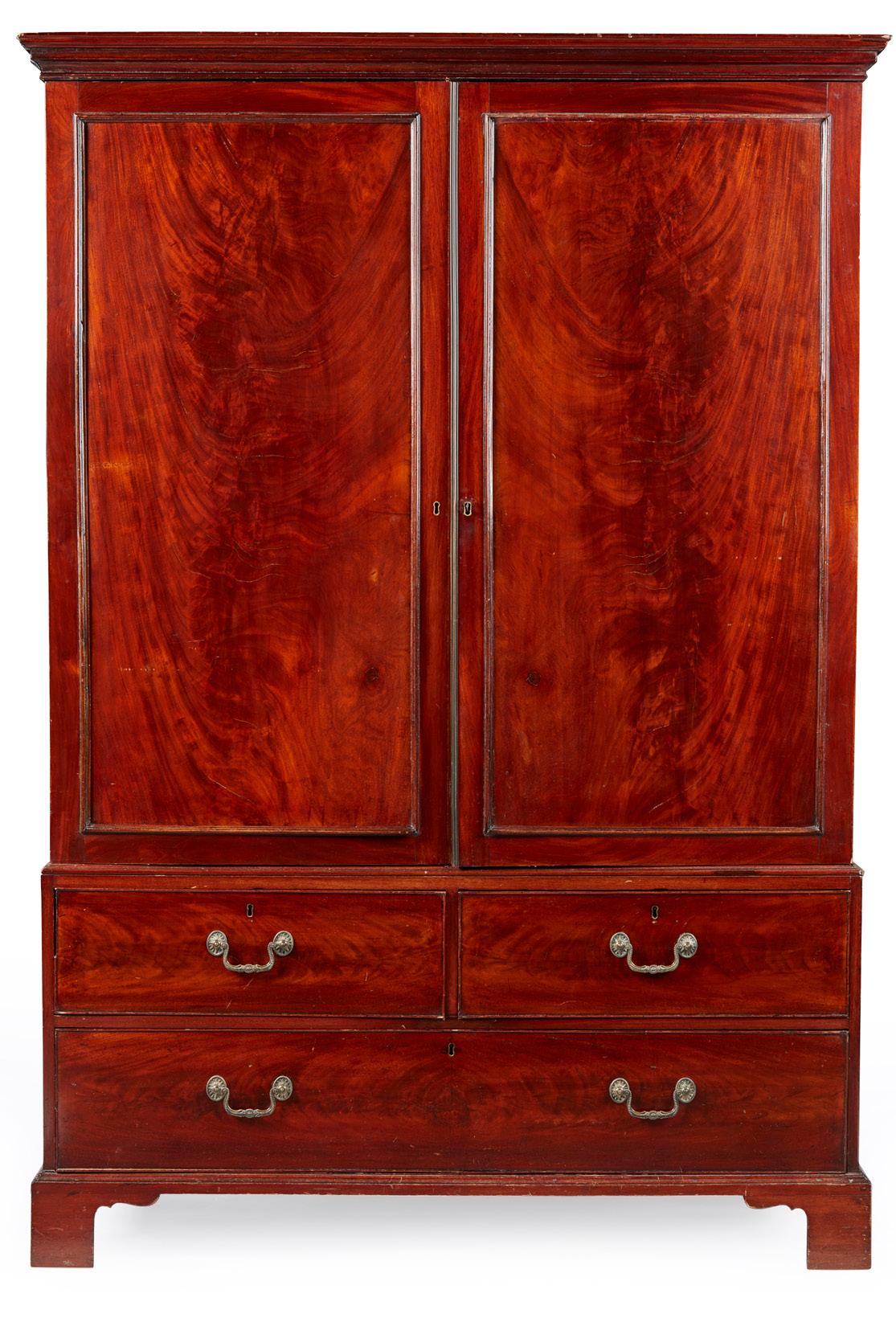


110cm wide, 113cm high, 52cm deep
£1,000-1,500
95
LATE GEORGIAN MAHOGANY LINEN PRESS
LATE 19TH CENTURY
the moulded cornice above a pair of panel doors opening to a later fitted interior with sliding trays and hanging space, the base with two short over a long drawer, raised on bracket feet
130cm wide, 189cm high, 65cm deep
£500-700
35
98
GEORGE III MAHOGANY SECRETAIRE BOOKCASE
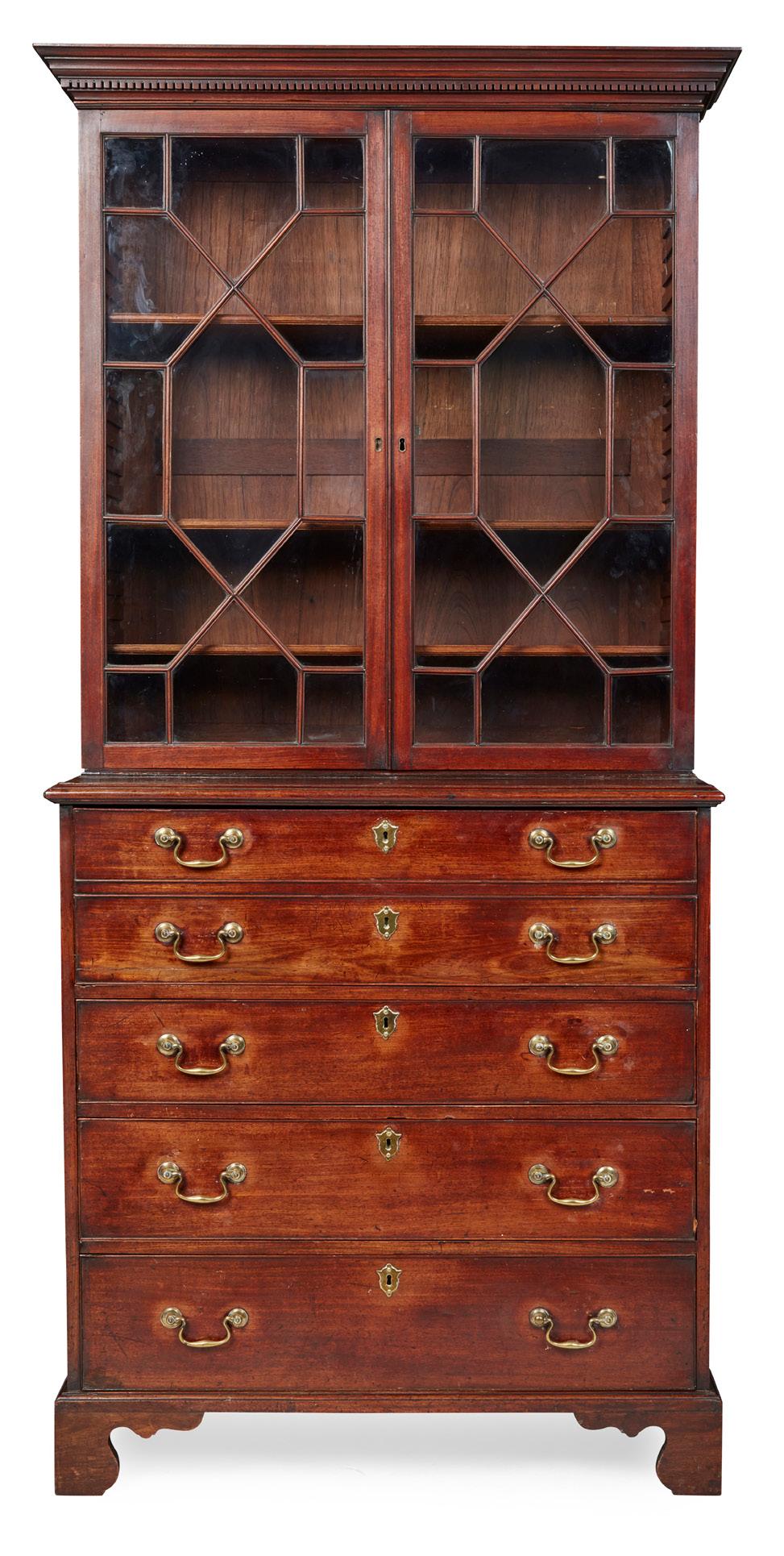
18TH CENTURY
the dentil moulded cornice above a pair of astragal glazed doors enclosing adjustable shelves; the lower part with a secretaire drawer fitted with pigeon holes and drawers, over three further long graduated drawers, raised on shaped bracket feet
97cm wide, 210cm high, 55cm wide
£1,200-1,800
97
LATE GEORGE III MAHOGANY TRIPOD READING TABLE


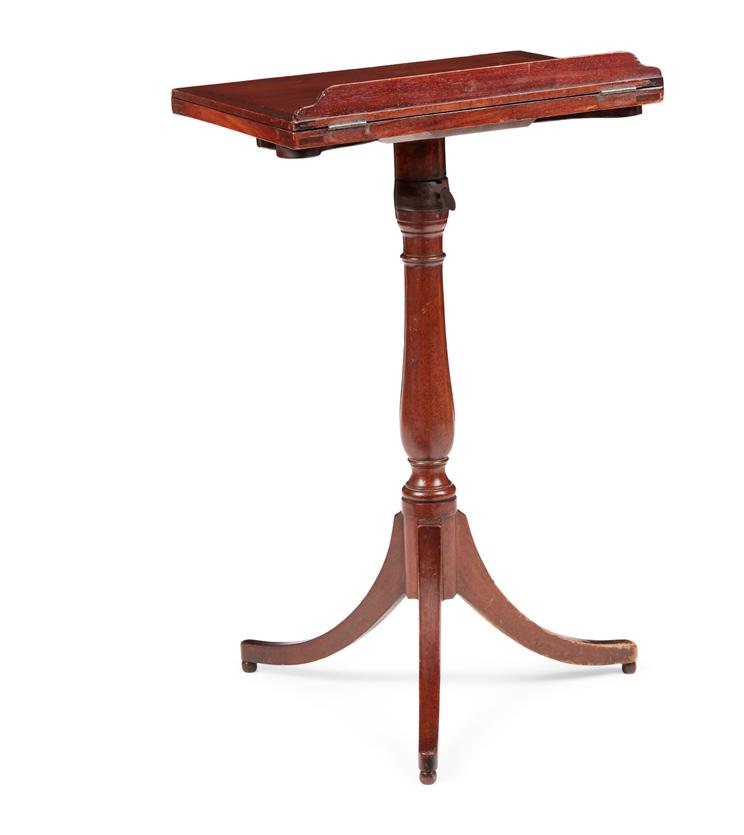
LATE 18TH CENTURY
the ratchet adjusted square top with a book rest and two swingout candle slides, raised on a slender baluster stem with rising mechanism and outswept legs
46 cm wide, 74cm high, 33.5cm deep
£400-600
99
GEORGE III MAHOGANY PEMBROKE TABLE
18TH CENTURY
the rectangular top with twin drop leaf sides, above a frieze drawer and shaped apron to one end, a dummy drawer opposing, raised on channel moulded square tapered legs headed by facet moulded blocks and ending in block feet with leather castors
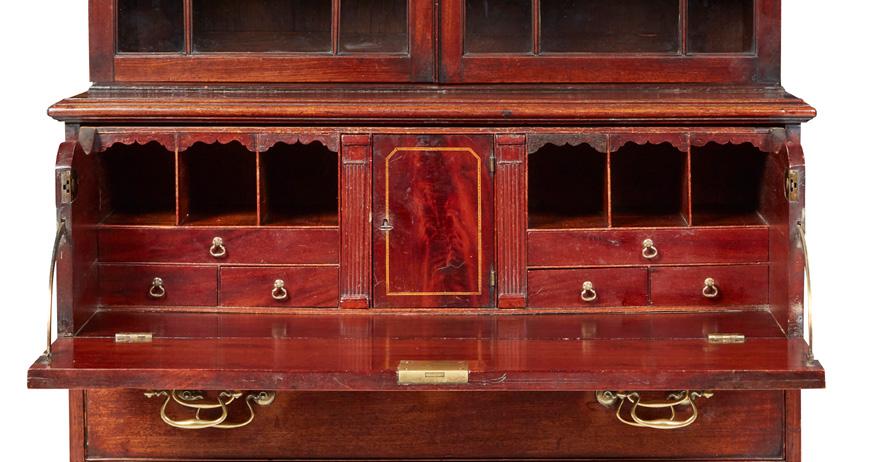
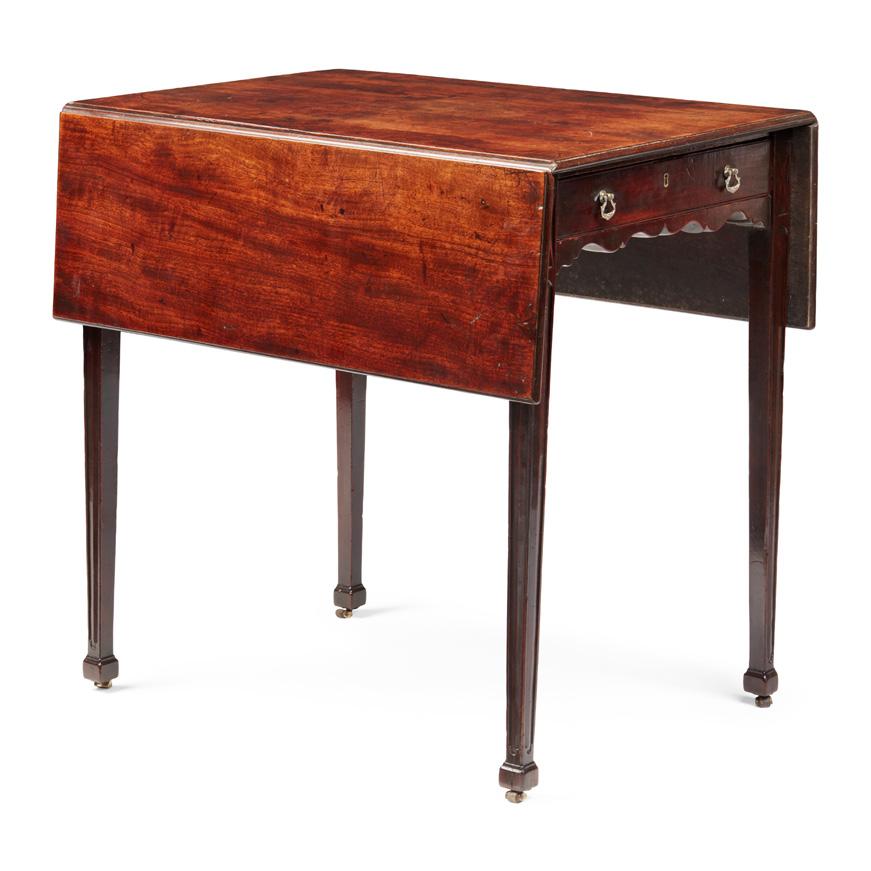
52cm wide 98.5cm [open], 71cm high, 71cm deep
£1,200-1,800
36 Other fees apply in addition to the hammer price: see the ‘Buyer’s Guide’ section on page 2
100
LATE GEORGE III MAHOGANY BREAKFRONT SECRETAIRE BOOKCASE
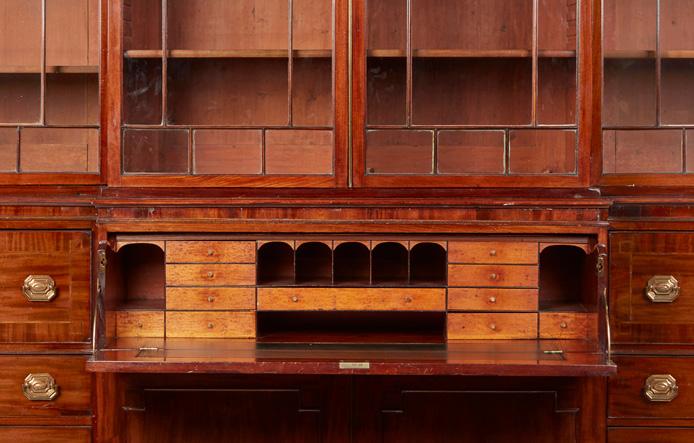
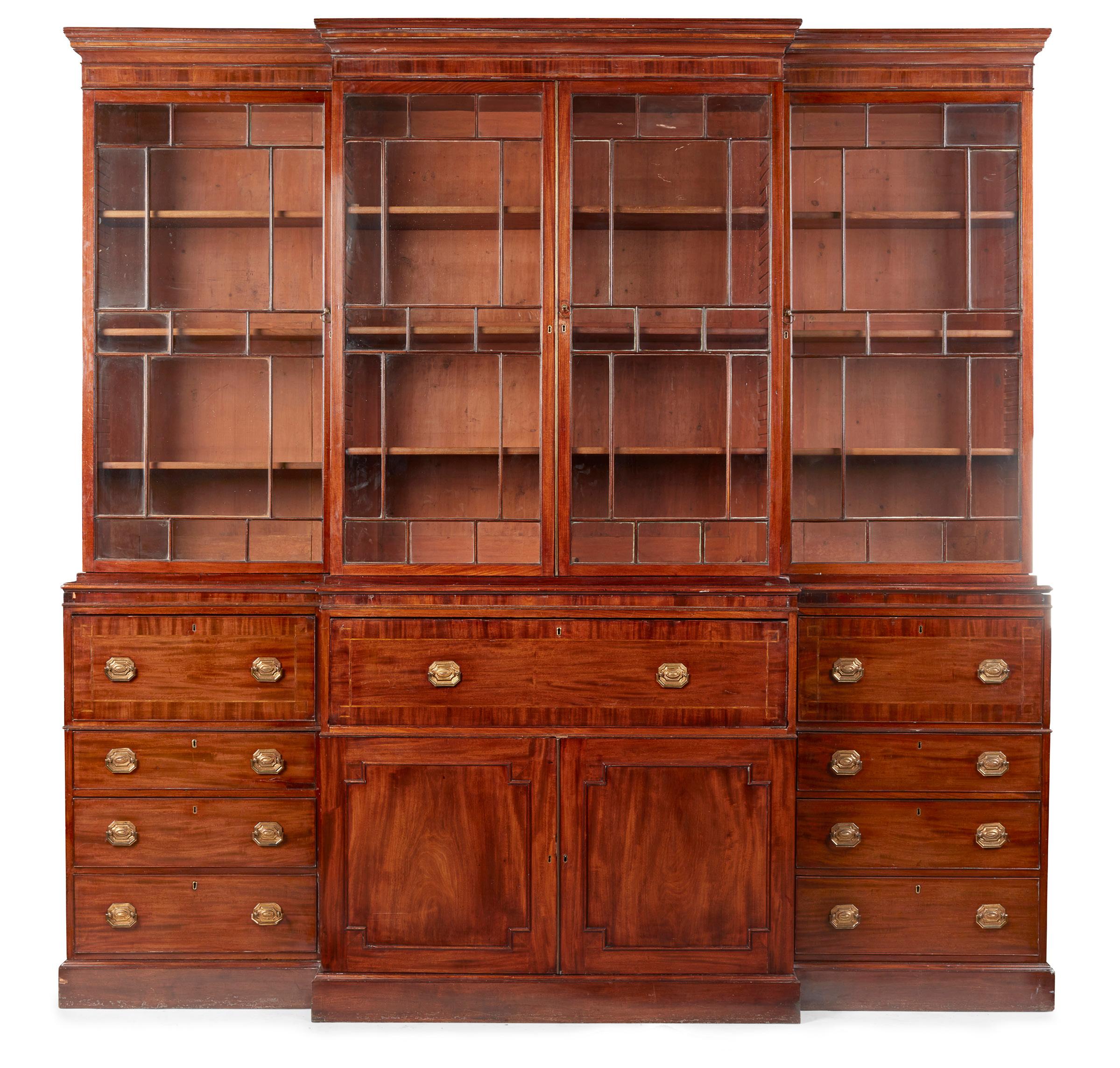
EARLY 19TH CENTURY
the moulded cornice above a pair of glazed doors with rectilinear mouldings, flanked by matching side cabinets, enclosing adjusting shelves; the base with a central secretaire drawer fitted with an arrangement of pigeon holes and drawers and a blue leather writing surface, over a pair of moulded panel doors, flanked by banks of drawers, on a conforming plinth base 292cm wide, 260cm high, 60cm deep
£4,000-6,000
37
101
GEORGE III MAHOGANY CANDLESTAND
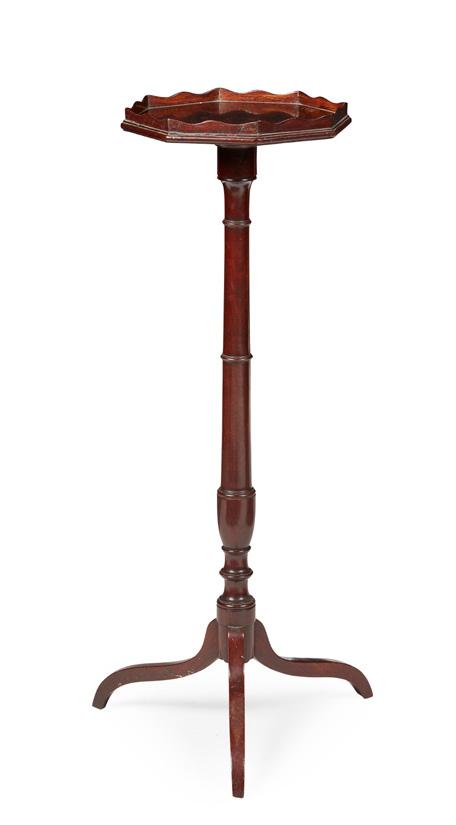
18TH CENTURY
the octagonal top with a wavy gallery raised on a slender baluster column and umbrella tripod base
21cm wide, 81cm high
£400-600
102
GEORGE III MAHOGANY CHILD’S HIGH CHAIR, IN THE MANNER OF HEPPLEWHITE
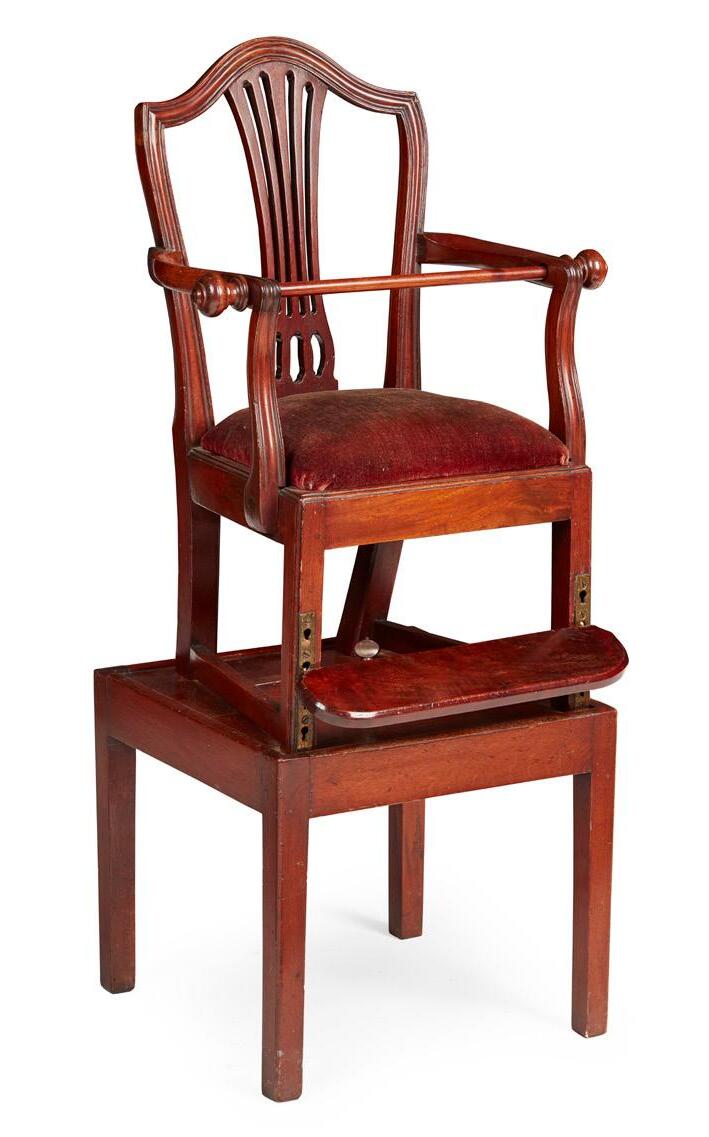
LATE 18TH CENTURY
with a pieced splat and drop-in seat pad and an adjustable footrest; mounted on a platform base with square straight legs
46cm wide, 97cm high, 41cm deep
£400-600
103
LATE GEORGE III MAHOGANY TEA TABLE
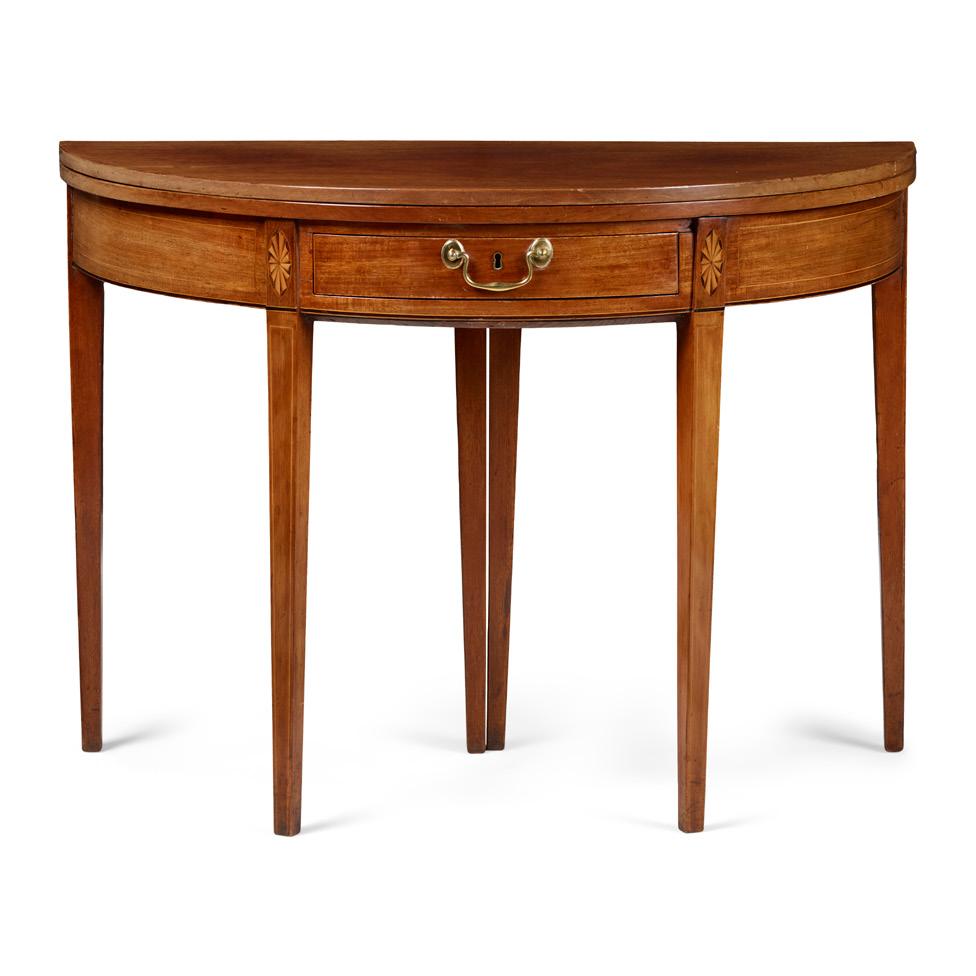
LATE 18TH CENTURY
the demilune fold-over top opening on twin gatelegs, above a single frieze drawer and raised on square tapered legs headed by inlaid fan medallions
102cm wide, 74cm high, 50.5cm deep [closed]
£300-500
104
LATE GEORGE III MAHOGANY AND SATINWOOD BOWFRONT CHEST OF DRAWERS
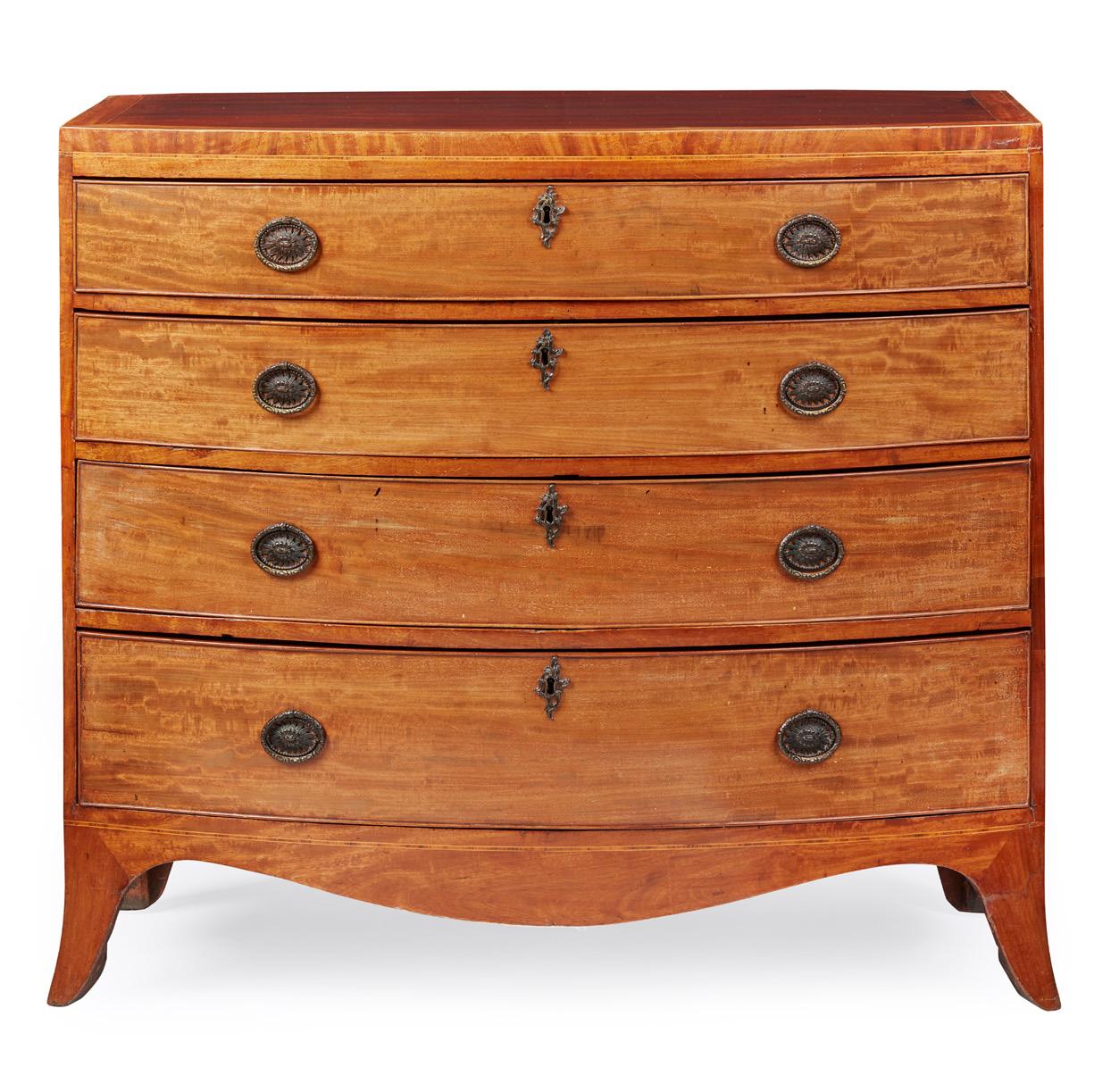
LATE 18TH CENTURY
the banded top above four long graduated drawers raised on French bracket feet
98cm wide, 92cm high, 51.5cm deep
£500-700
38
105
GEORGIAN MAHOGANY BRASS BANDED TRAY TABLE

LATE 18TH CENTURY, THE STAND LATER
the oval tray with a wavy brass gallery and handles to the ends, mounted on a later lacquered brass base
78cm wide, 53cm high, 47cm long £400-600
106
GEORGE III MAHOGANY DUMBWAITER
18TH CENTURY
with three graduated dished circular tiers raised and divided by baluster turned central supports, on outswept legs ending in pointed pad feet with brass castors 58cm diameter, 113cm high
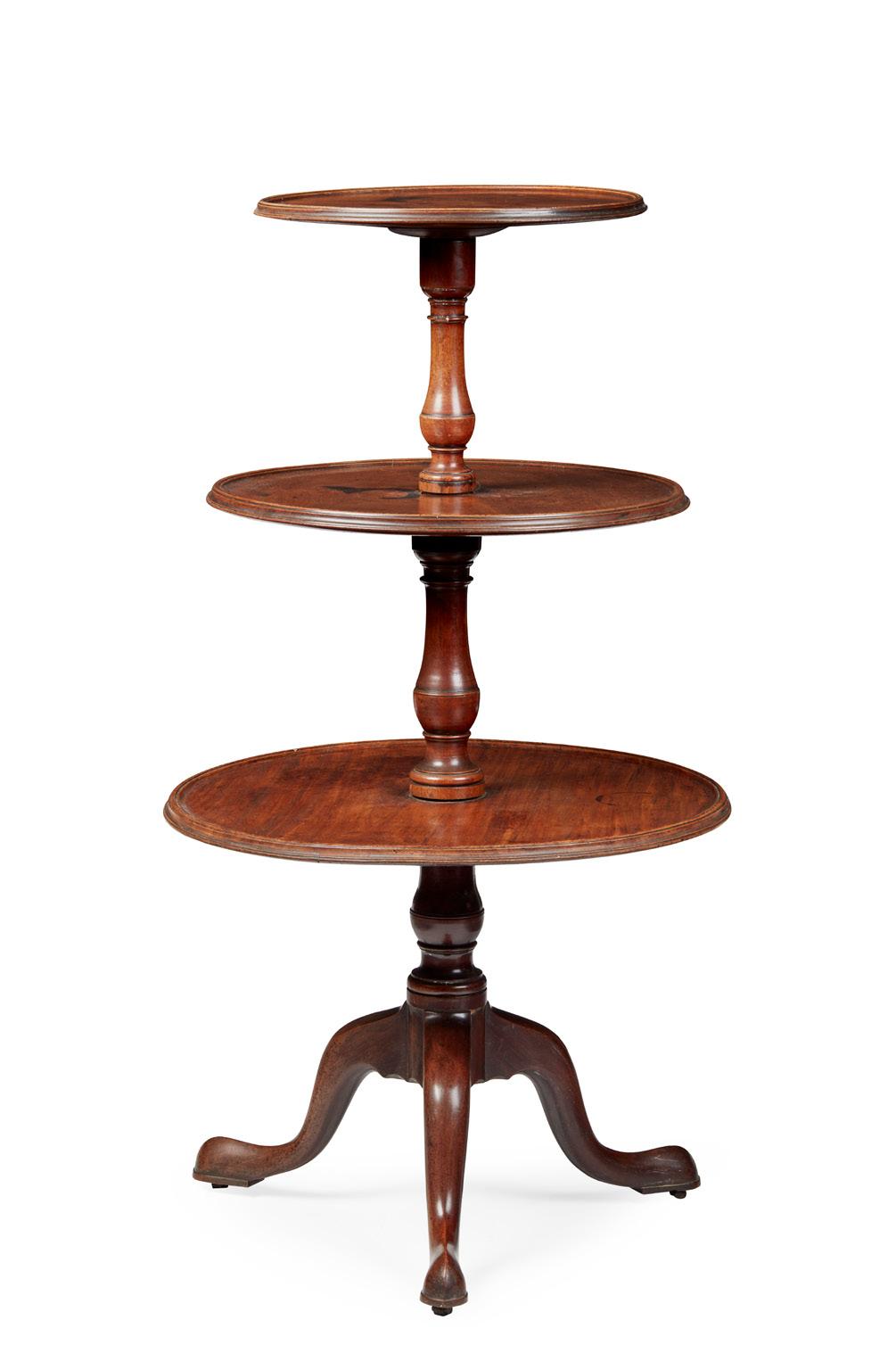
Provenance: Private Scottish Collection, Morayshire
£400-600
107
GEORGE III MAHOGANY BREAKFRONT SIDEBOARD
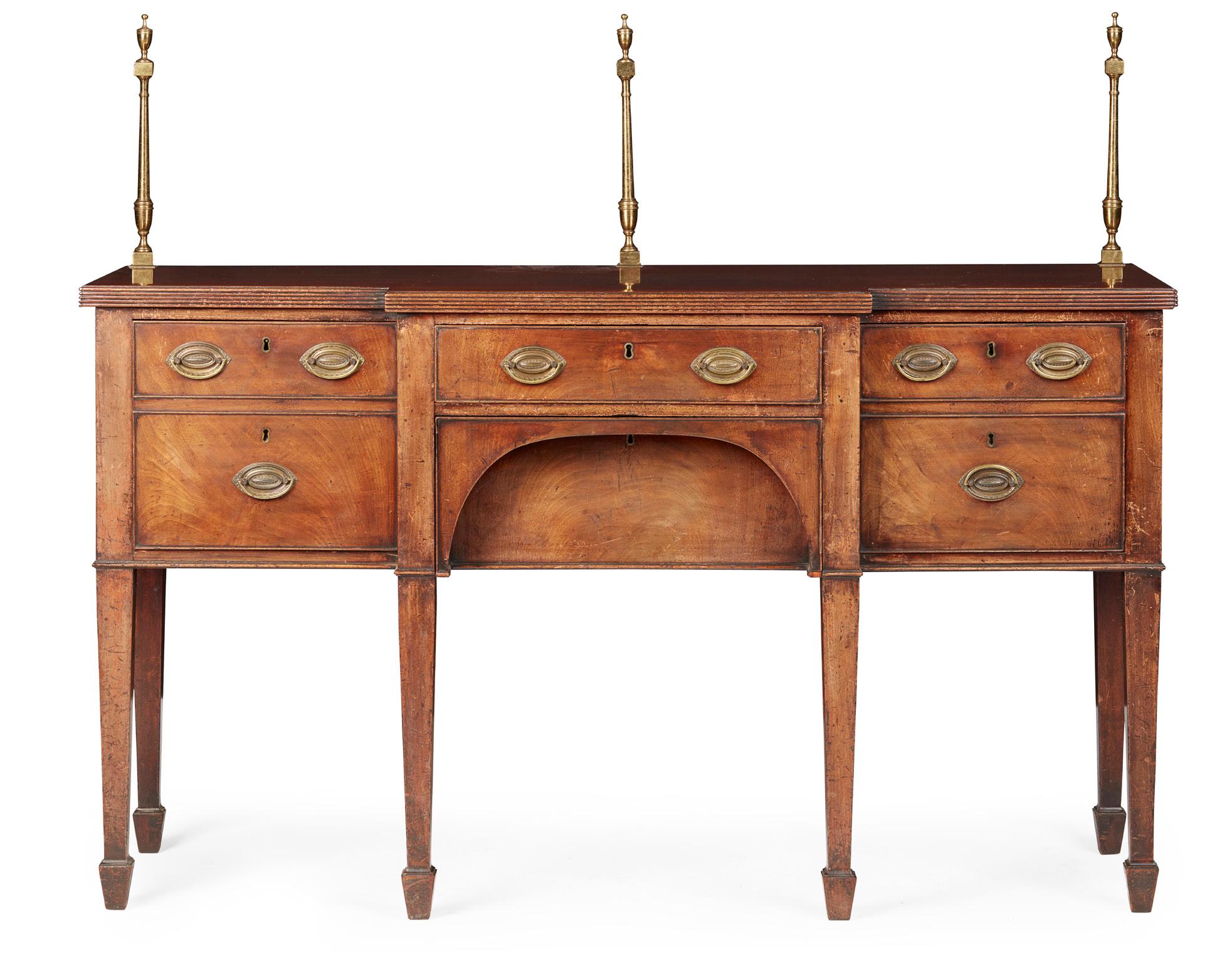
18TH CENTURY
the top with a reeded edge and partial brass gallery, above a centre long drawer and arch recess deep drawer, flanked by further deep drawers, raised on square tapered legs ending in spade feet
156cm wide, 130cm high, 48cm deep £1,000-1,500
39 Other fees apply in addition to the hammer price: see the ‘Buyer’s Guide’ section on page 2
108
GEORGIAN
19TH CENTURY
the oval bevelled mirror plate in a leaf tip and moulded frame with foliate scrolls, husk trails, and an urn finial 109cm high, 92cm wide
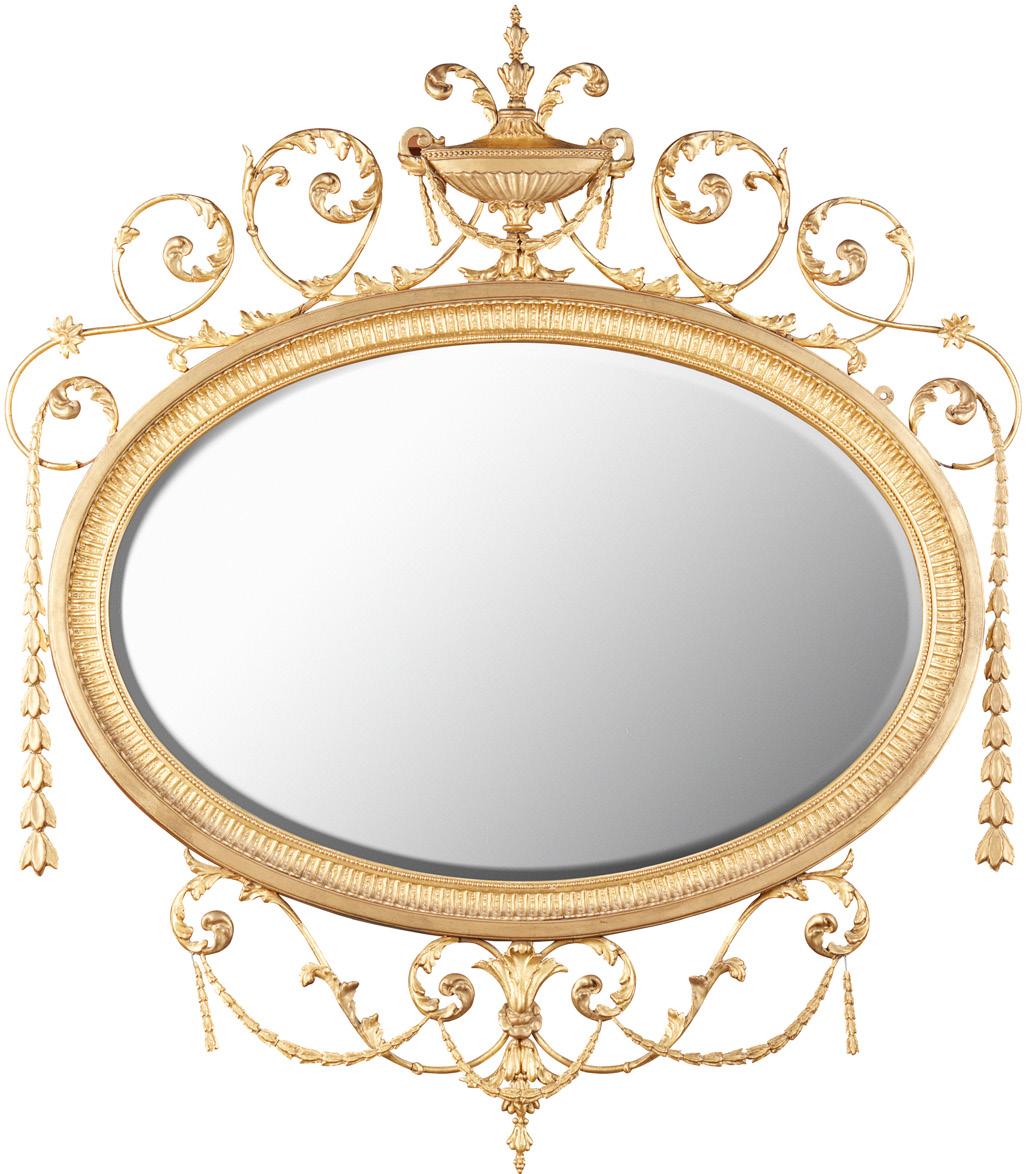
£600-800
109
the carved backs centred with gilt initial F above rounded seats, raised on turned and tapered legs (2)
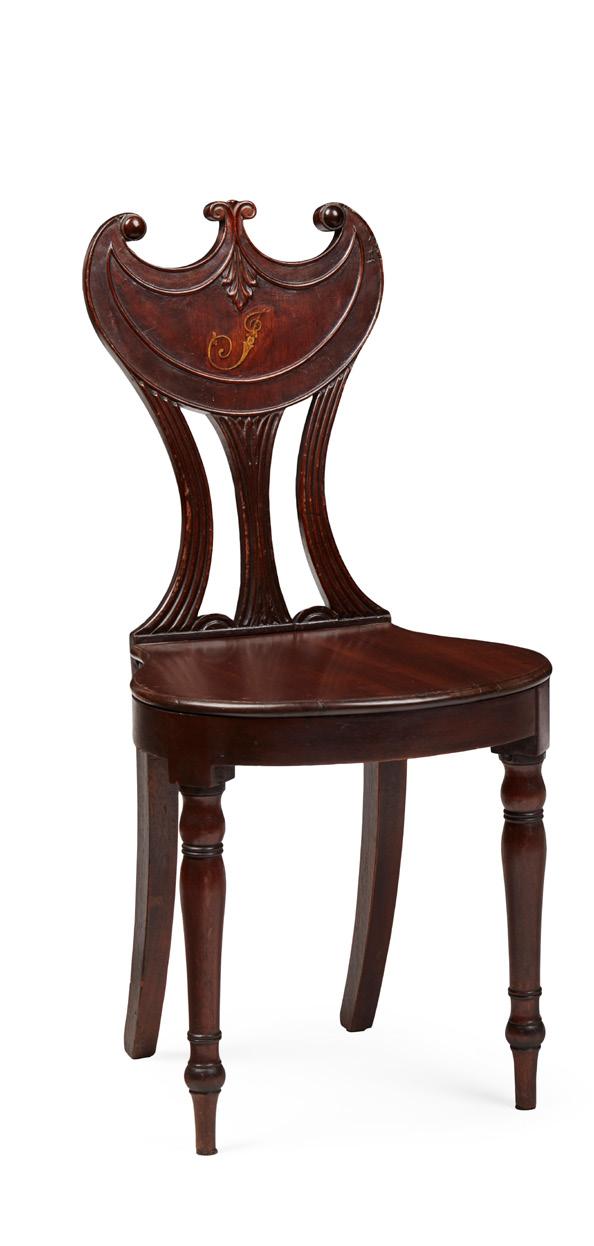
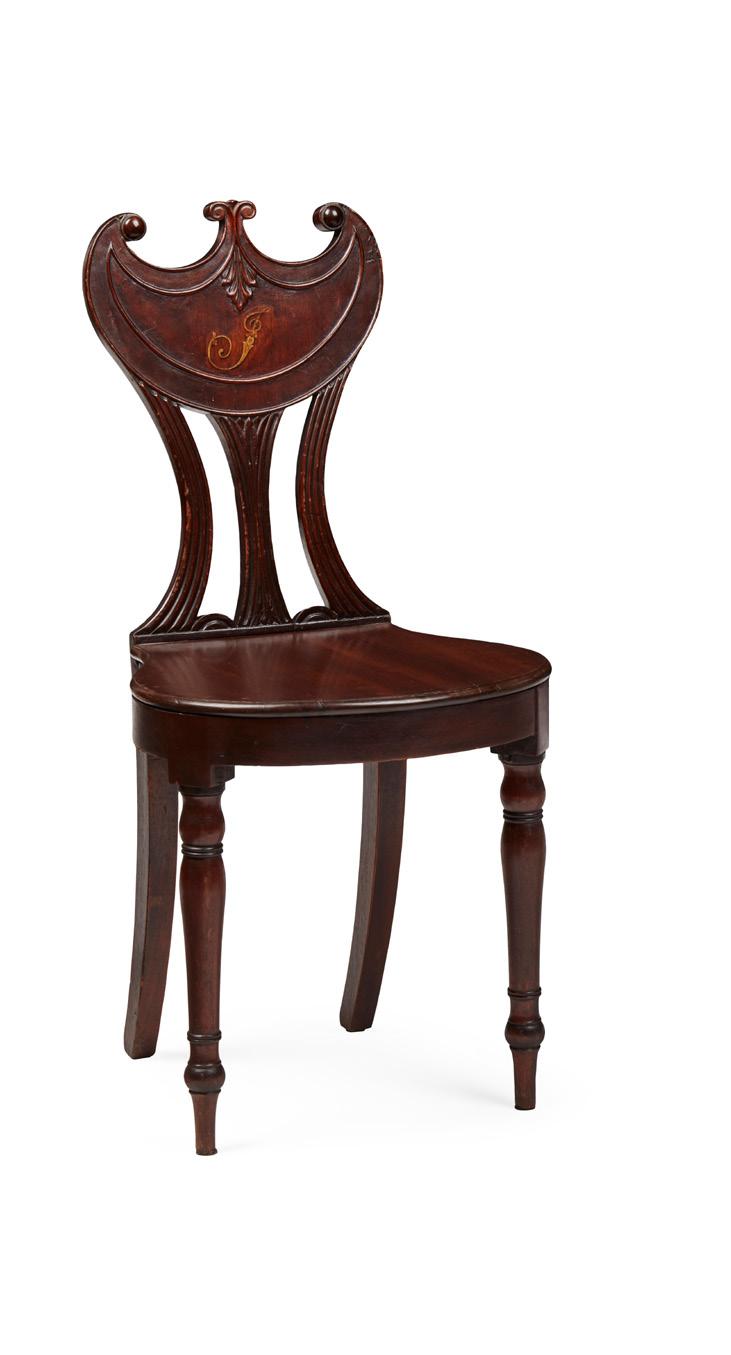
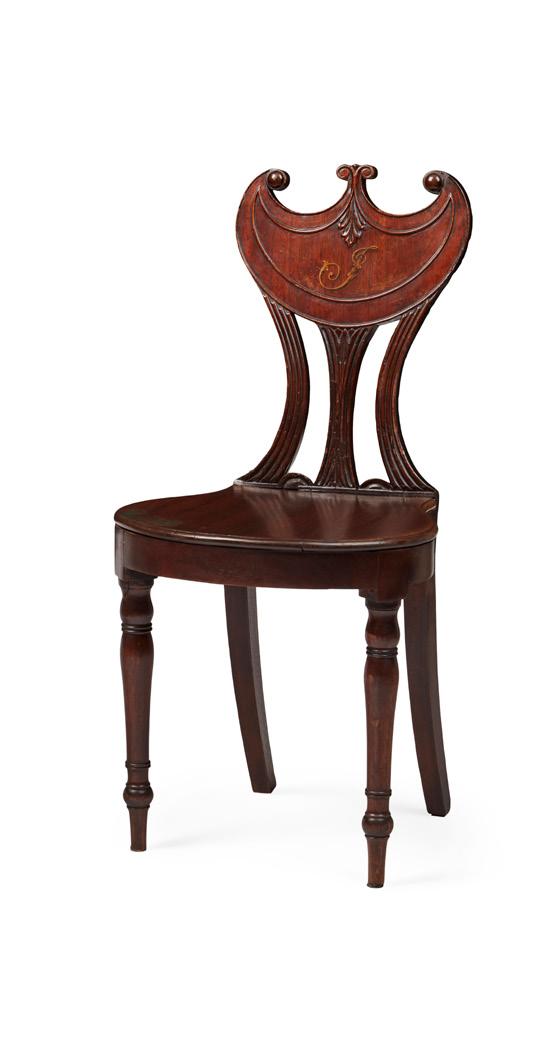
41cm wide, 87cm high, 36cm deep
£300-500
110
18TH CENTURY
the top with a later green leather insert and moulded edge, above three frieze drawers raised on banks of three drawers with ebonised roundels, the same on the reverse, raised on bracket feet 160cm wide, 82cm high, 85cm deep
£800-1,200
 GEORGE III
MAHOGANY PEDESTAL PARTNER’S DESK
PAIR OF LATE GEORGE III MAHOGANY PELTA BACK HALL CHAIRS LATE 18TH CENTURY
STYLE GILTWOOD MIRROR
GEORGE III
MAHOGANY PEDESTAL PARTNER’S DESK
PAIR OF LATE GEORGE III MAHOGANY PELTA BACK HALL CHAIRS LATE 18TH CENTURY
STYLE GILTWOOD MIRROR
40 Other fees apply in addition to the hammer price: see the ‘Buyer’s Guide’ section on page 2
GEORGE III MAHOGANY LONGCASE CLOCK, BY THOMAS ATKINSON, ORMSKIRK

LATE 18TH CENTURY
the Gillows type case with swan neck pediment and brass eagle finial above a brass dial with a silvered Roman number chapter and subsidiary seconds dial and dater aperture, flanked by fluted columns, above a trunk with blind fret carving and shaped door flanked by fluted quarter columns, on a moulded plinth with ogee bracket feet, the 30 hour movement striking a bell
215cm high, 52cm wide
£600-800
112
LATE GEORGE III MAHOGANY BUREAU BOOKCASE, ATTRIBUTED TO GILLOWS

LATE 18TH CENTURY
the lancet moulded cornice above a pair of astragal glazed doors enclosing shelves; the bureau with a cylinder front opening to an arrangement of drawers and pigeon holes over a green leather writing surface, the centre section with a ratchet adjusted slope, over a pair of frieze drawers with lion mask ring handles, raised on reeded tapered legs
111cm wide, 234cm high, 58cm deep
£4,000-6,000
111
41
113
LATE GEORGE III MAHOGANY TEA TABLE
LATE 18TH CENTURY
the breakfront fold-over top above a line inlaid frieze centred by a tablet, raised on square tapered legs ending in spade feet, opening on twin gatelegs 92cm wide, 72cm high, 45cm [closed]
£500-700
114
PAIR OF GEORGE III MAHOGANY SIDE CHAIRS
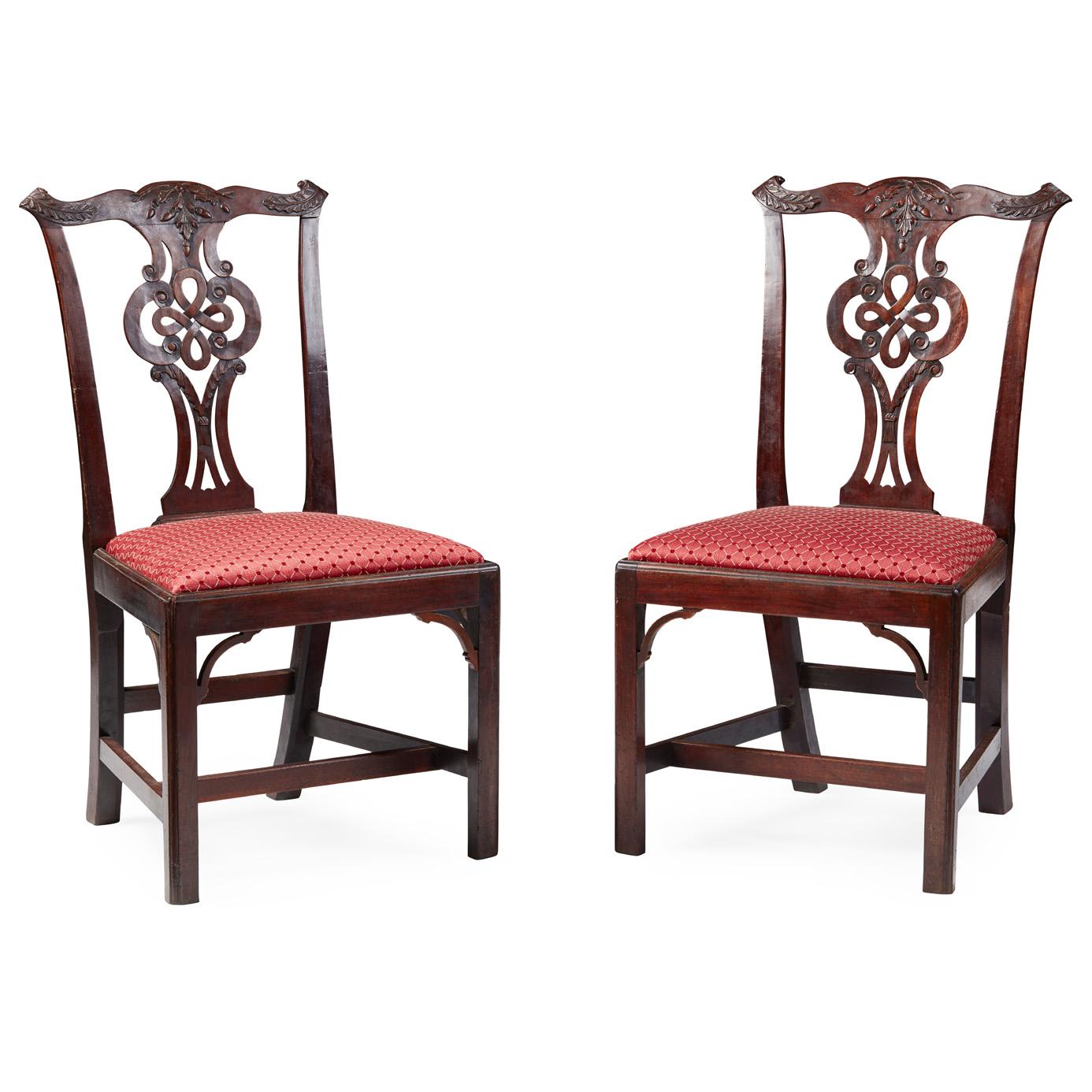
18TH CENTURY
the shaped top rails carved with acorns and foliate ears above carved and pierced interlaced splats, the drop-in seats with raspberry red covers. raised on moulded chamfered legs joined by H-stretchers (2)
52cm wide, 96cm high, 50cm deep
£300-500
115
GEORGE III MAHOGANY SERPENTINE

CHEST OF DRAWERS
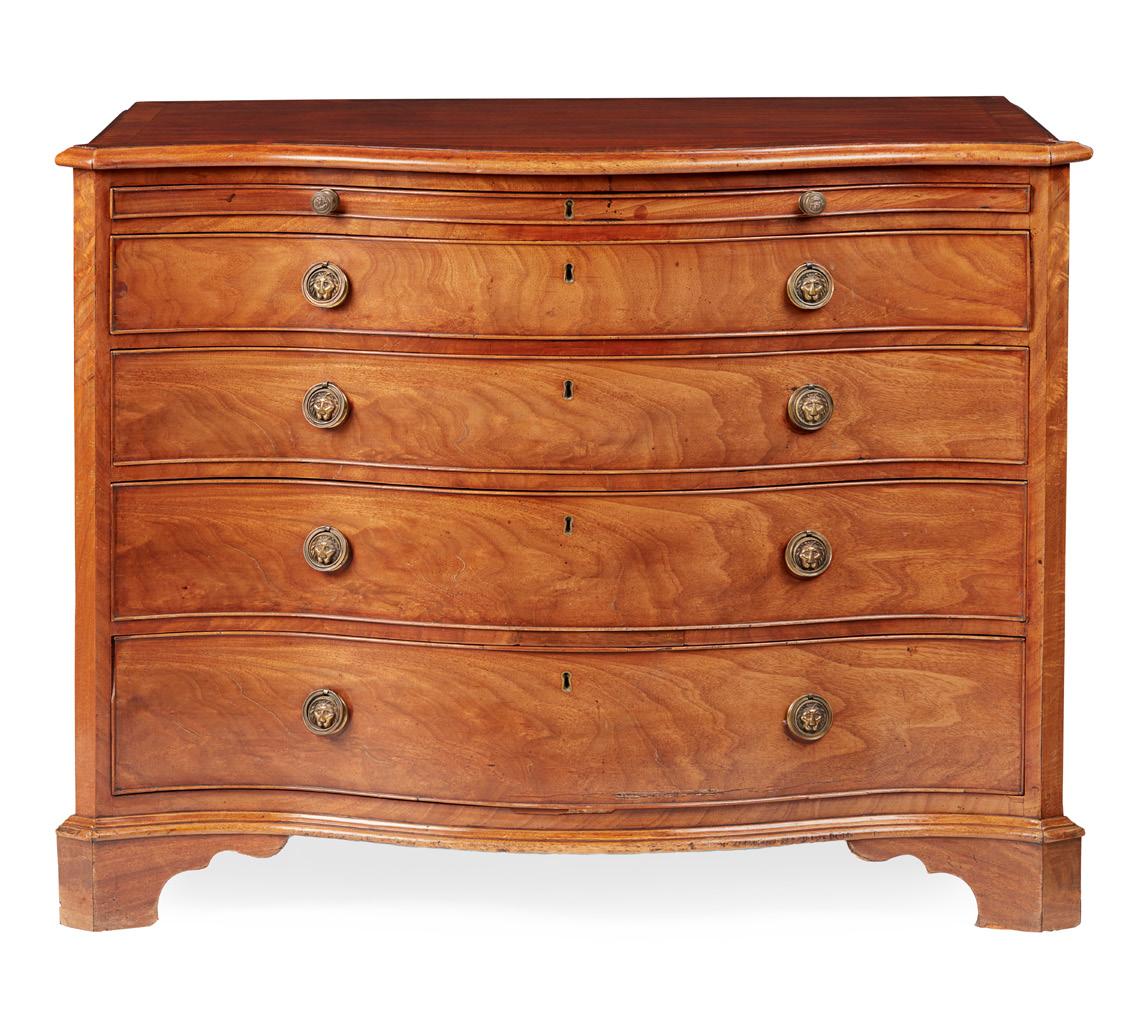
LATE 18TH CENTURY
the crossbanded serpentine top with a moulded edge above a green baize-lined brushing slide and four graduated long drawers, raised on shaped bracket feet 110cm wide, 88cm high, 63cm deep
£800-1,200
42 Other fees apply in addition to the hammer price: see the ‘Buyer’s Guide’ section on page 2
117
LARGE GILT PIER MIRROR
19TH CENTURY the rectangular mirror plate in a moulded giltwood frame
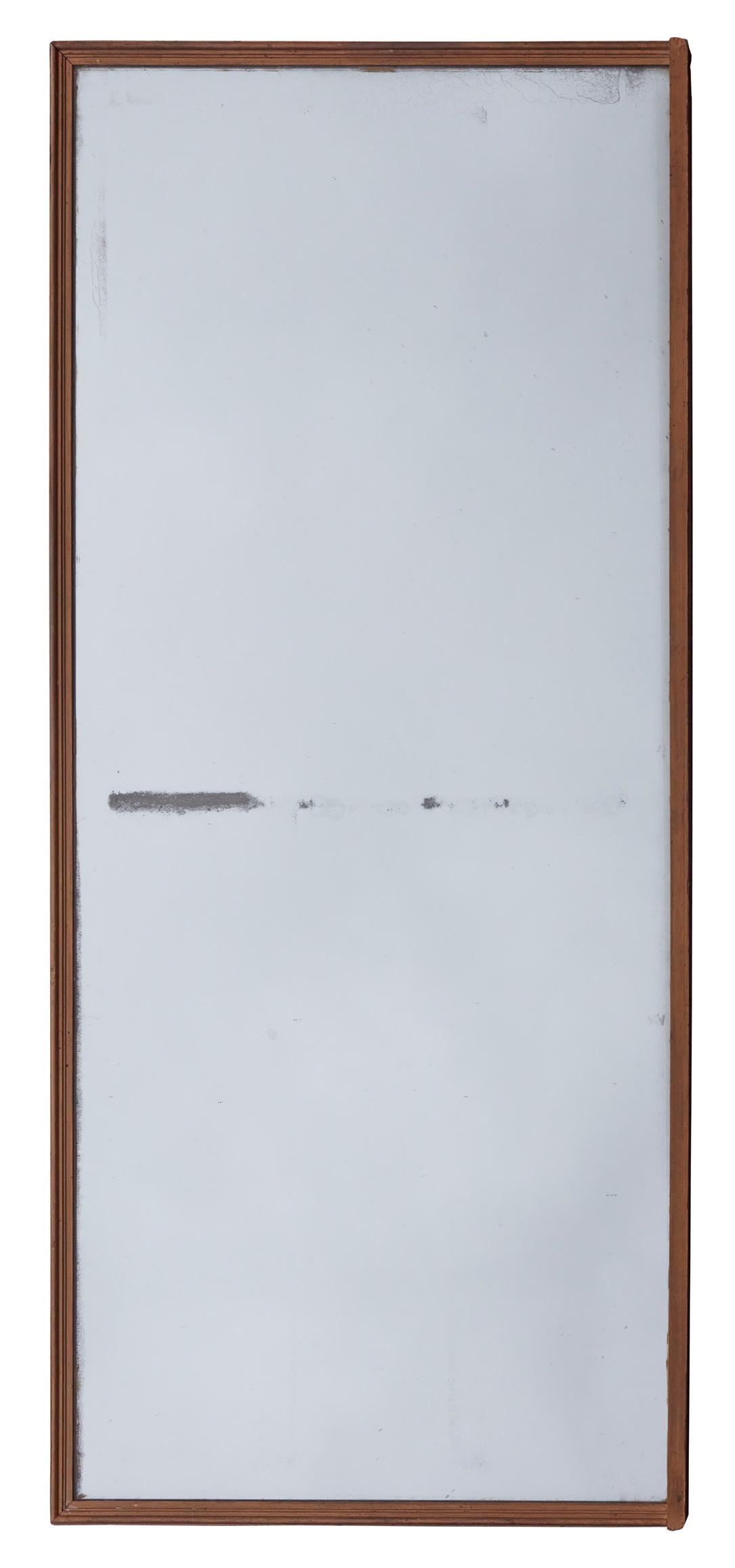
240cm wide, 112cm high
£400-600
118
GEORGE III MAHOGANY CHEST OF DRAWERS
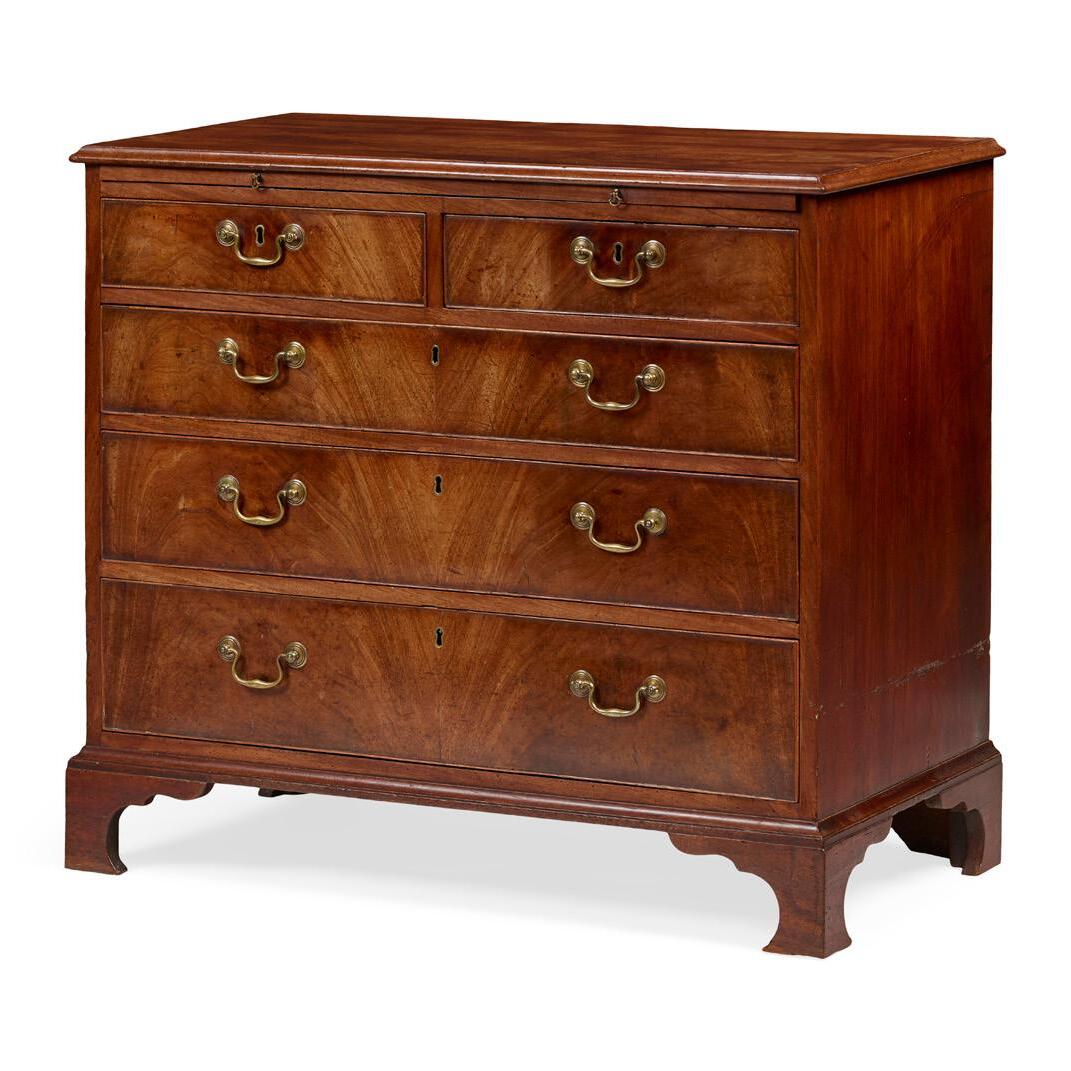
18TH CENTURY
the top with a moulded edge above a brushing slide and two short drawers, and three long graduated drawers, raised on bracket feet
95cm wide, 83cm high, 49cm deep
£400-600
116
LATE 18TH CENTURY
of large proportions, the back with an arched top rail carved with husk trails above a pierced splat, the wide stuffover seat flanked by scrolled open arms, raised on square tapered legs joined by stretchers
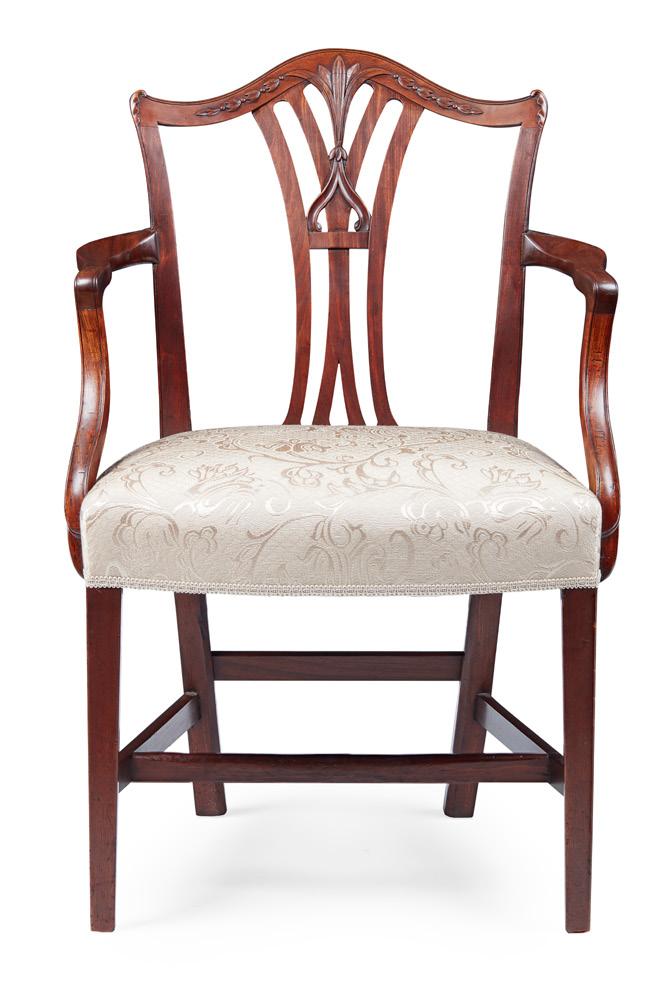
69cm wide, 74.5cm high, 50cm deep
£1,000-1,500
GEORGE III MAHOGANY ‘MASTER’S’ ARMCHAIR, IN THE MANNER OF HEPPLEWHITE
43
SET OF FOUR GEORGIAN STYLE MAHOGANY AND SATINWOOD BANDED NESTING TABLES

19TH CENTURY
all with a cockbeaded edge and raised on slender supports joined by a curved rear stretcher and ending on arched trestle bases
56cm wide, 70cm high, 38cm deep
£500-700
120
GEORGE III MAHOGANY AND SATINWOOD INLAID PEMBROKE TABLE
LATE 18TH CENTURY
the crossbanded oval top centred by an inlaid fan motif, above a frieze drawer to one end, raised on square tapered legs outlined with stringing and united by an X stretcher


68cm wide, 72.5cm high, 44.5cm deep, 88.5cm [open] £700-1,000
121
LATE GEORGE III SATINWOOD AND TULIPWOOD CARD TABLE
LATE 18TH CENTURY
of canted D shape, the banded top opening on twin gatelegs to a green baize playing surface, above a line inlaid frieze raised on square tapered legs ending in spade feet
89cm wide, 74cm high, 44cm deep [closed]
£600-800
122
SMALL GEORGE III SATINWOOD INLAID CORNER CABINET
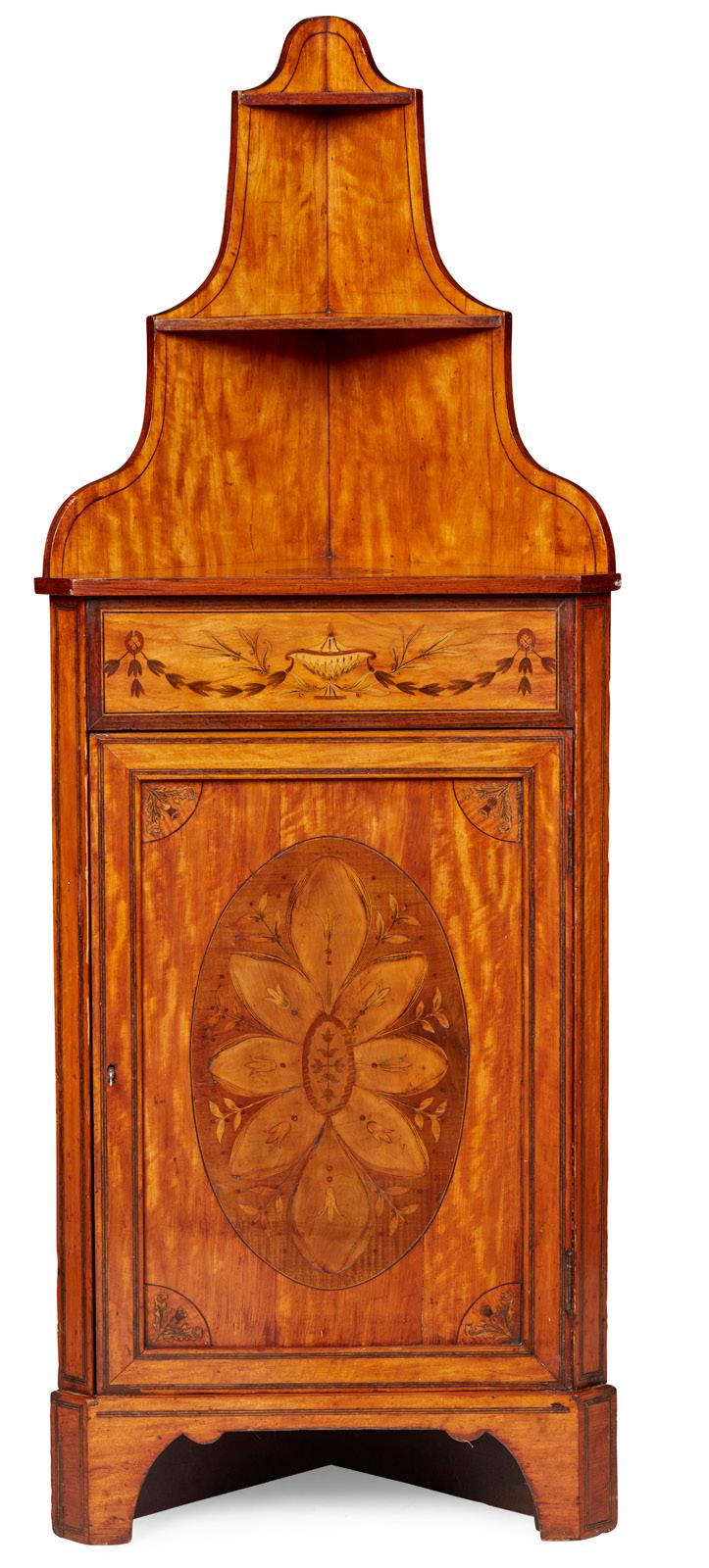
LATE 18TH CENTURY, WITH LATER INLAY
the shaped top with two tiers above a frieze with urn and harebell swags, above a door with a large sunflower inlay, raised on bracket feet
53cm wide, 149cm high, 30cm deep
£400-600
119
44
123
GEORGE III MAHOGANY OCTAGONAL WINE TABLE
LATE 18TH CENTURY
the oblong octangular top on a slender turned and tapered column ending on an umbrella tripod base
46cm wide, 71cm high, 35cm deep
£400-600
125
GEORGE III SATINWOOD PEMBROKE TABLE

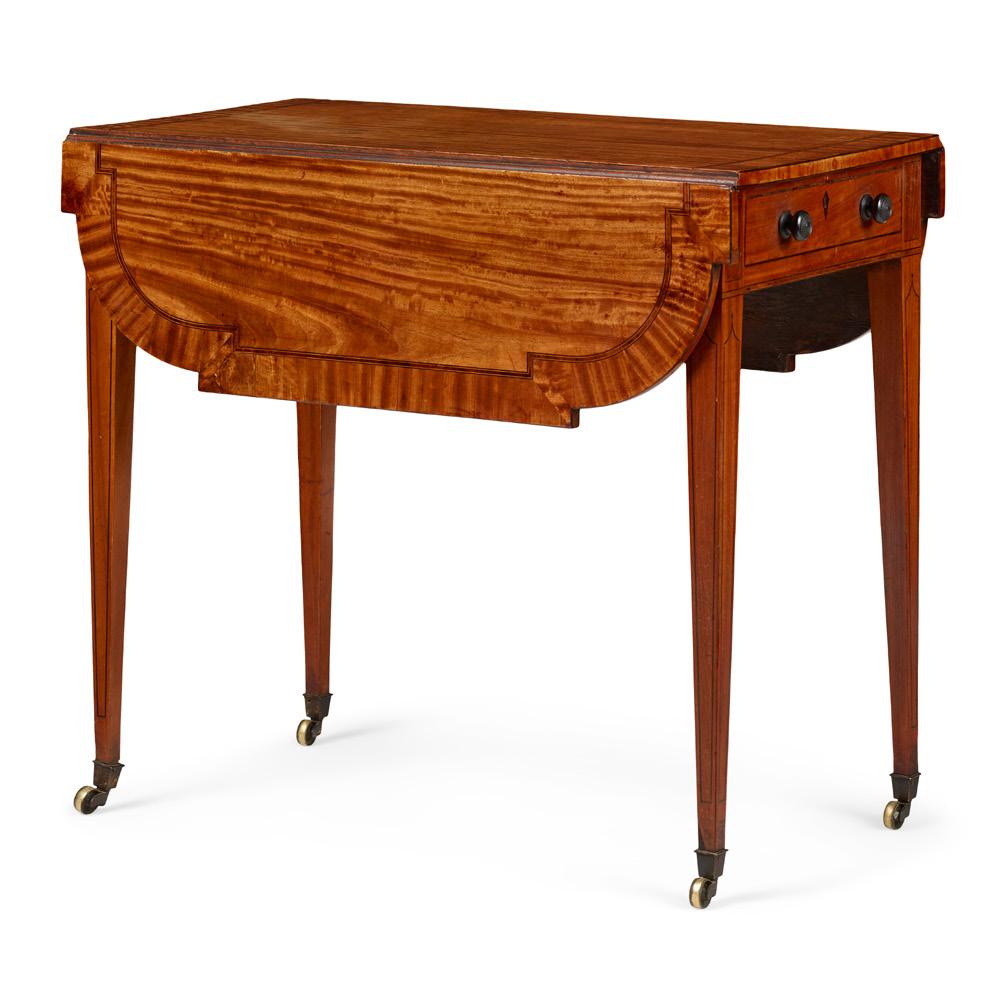
LATE 18TH CENTURY
the crossbanded top of breakfront outline, above a frieze drawer to one end and dummy drawer opposing, raised on line inlaid square tapered legs ending in brass caps and castors
81cm wide, 74cm high, 44cm deep, 94cm [open]
£800-1,200
124
GEORGE III STYLE LEATHER UPHOLSTERED WING ARMCHAIR
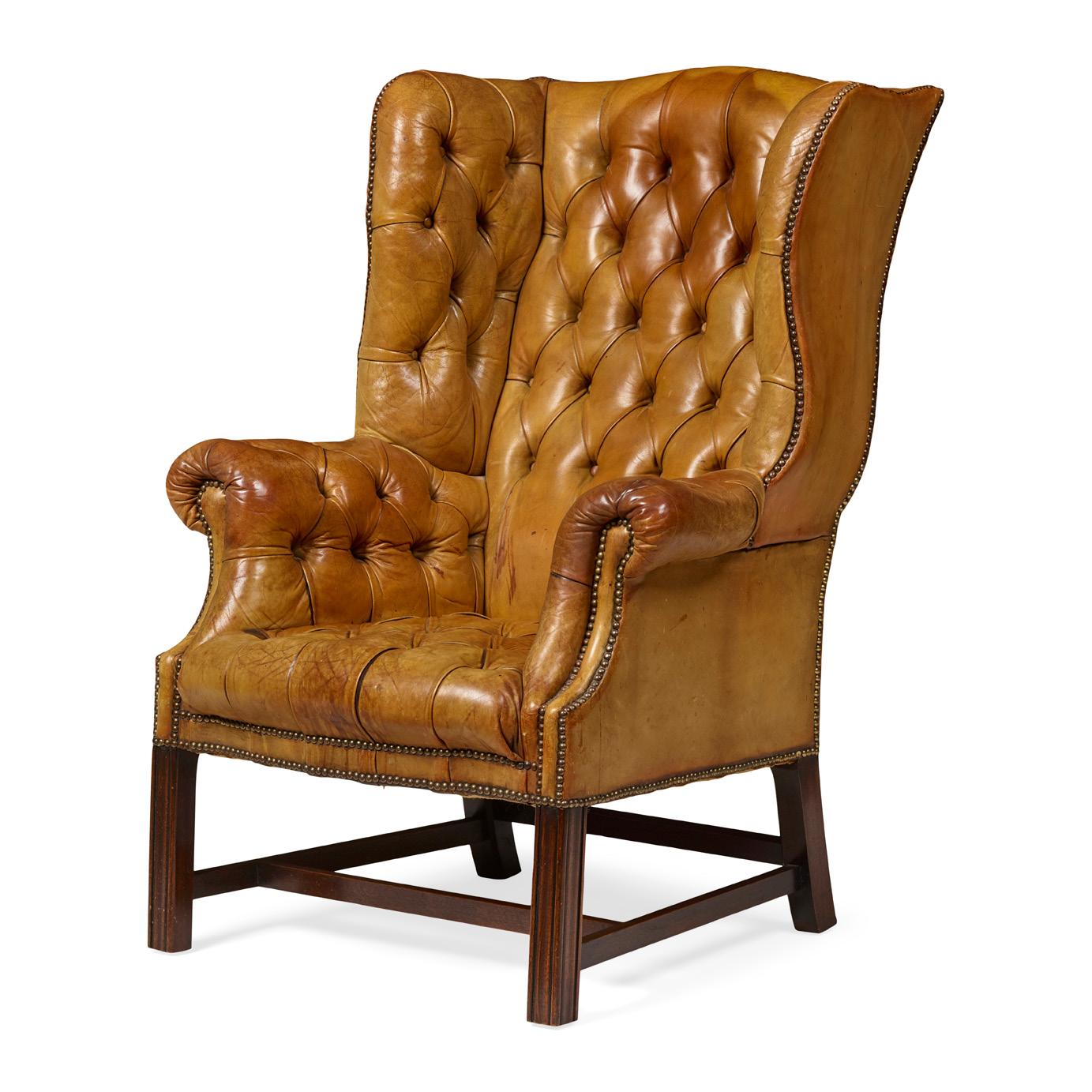
EARLY 20TH CENTURY
in buff brown buttoned leather outlined with close nail trim, on channel moulded square legs joined by an H stretcher
84cm wide, 116cm high, 56cm deep
£2,000-3,000
45 Other fees apply in addition to the hammer price: see the ‘Buyer’s Guide’ section on page 2
GEORGE III MAHOGANY, SATINWOOD AND INLAID PRESS CUPBOARD, IN THE MANNER OF INCE AND MAYHEW LATE 18TH CENTURY
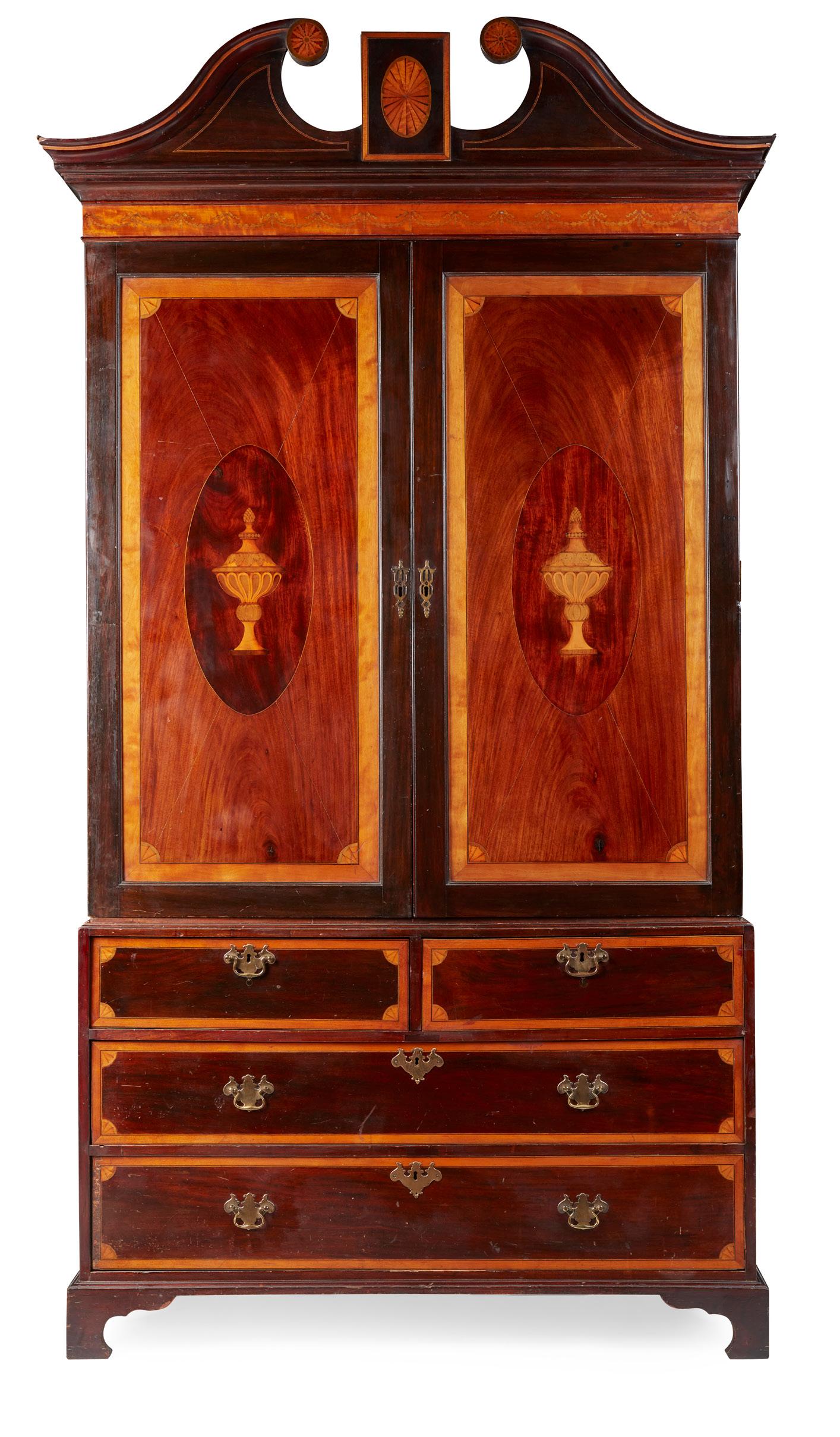
the swan neck cornice centred by a fan medallion tablet, above a frieze inlaid with ribbon-tied swags over a pair of banded panel door with urn inlay, opening to a void interior, the lower part with two short over two long banded drawers, raised on bracket feet
136cm wide, 246cm high, 61cm deep
£2,000-3,000
GEORGIAN STYLE GILTWOOD MARGIN PLATE OVERMANTEL MIRROR

19TH CENTURY
with three plates within a margin plate border in a leaf tip and harebell moulded frame marked with flowerheads
62cm high, 103cm wide
£500-700
127
126
46 Other fees apply in addition to the hammer price: see the ‘Buyer’s Guide’ section on page 2
Paxton House was built by Patrick Home between 1759 and 1763, most likely to designs by John and James Adam. When Patrick Home succeeded to the Wedderburn estates in 1766, Paxton was sold to his cousin Ninian Home who undertook completing the interiors. Between 1774 and 1791, Thomas Chippendale and his son were commissioned to furnish the house. With Ninian Home spending most of his time on his plantation in the West Indies, there doesn’t seem to have been any rush to complete the job, with things proceeding at a leisurely pace after the initial phase commenced in 1774. In a letter of instruction to Thomas Chippendale, Ninian requests furniture that is ‘done in a neat but not an expensive manner’. The furniture supplied was generally speaking true to that direction and of a simple and practical nature, unlike the other great Chippendale commission, the grander Dumfries House, to which Paxton is often compared.
Paxton now ranks as a major documented Chippendale house. Letters between patron and cabinet-maker cover a span of at least fifteen years. The archive of correspondence between Ninian Home and Haig and Chippendale is an invaluable aid in demonstrating the level of involvement between client and furniture maker, and the extant invoices supplied by Haig and Chippendale offer a rare insight into the costs of such a commission. Since Paxton and Wedderburn have remained in the same family, the Chippendale furniture was left largely in situ, although over the years there has been some interchange of furniture between houses and family members.
This pair of satinwood tables were at one time attributed to Thomas Chippendale and displayed for many years at Paxton as such. Research into the archives has now determined they cannot be accredited to Chippendale, but were made by another, unknown maker, however no bills from other cabinetmakers are known to exist in the archive.
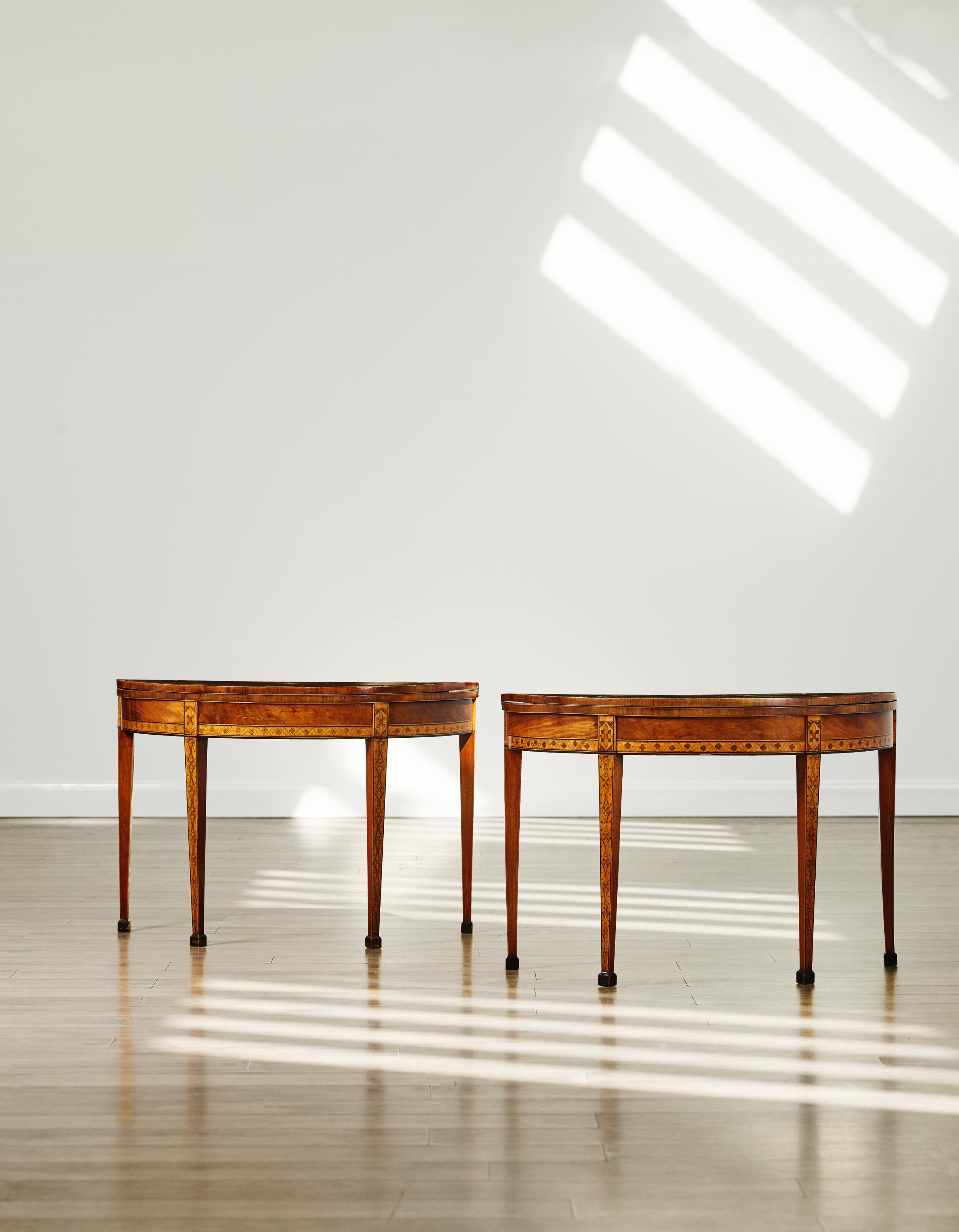
128
PAIR OF GEORGE III MAHOGANY, SATINWOOD, FRUITWOOD AND PENWORK CARD TABLES
LATE 18TH CENTURY
the crossbanded demilune tops decorated sunflower motifs within flower head and ribbon borders, opening to green baize playing surfaces, above friezes outlined with corresponding banded decoration and raised on square tapered legs ending in block feet (2) 107cm wide, 72cm high, 52cm deep [closed] Provenance: Paxton House, Berwickshire, and thence by family descent to the present vendor £6,000-8,000
PAINTINGS PART I
129
17TH CENTURY DUTCH SCHOOL


A COACHING PARTY AT AN INN
Oil on panel
71cm x 104cm (28in x 41in)
£2,000-3,000

48
130
18TH CENTURY SPANISH SCHOOL
CUTS OF MEAT AND COOKING
UTENSILS ON A KITCHEN TABLE

Oil on canvas
76cm x 96cm (30in x 37.75in)
£2,000-3,000

49 Other fees apply in addition to the hammer price: see the ‘Buyer’s Guide’ section on page 2
132
CIRCLE OF ALLAN RAMSAY
HALF LENGTH PORTRAIT OF LADY MARY CARNEGIE
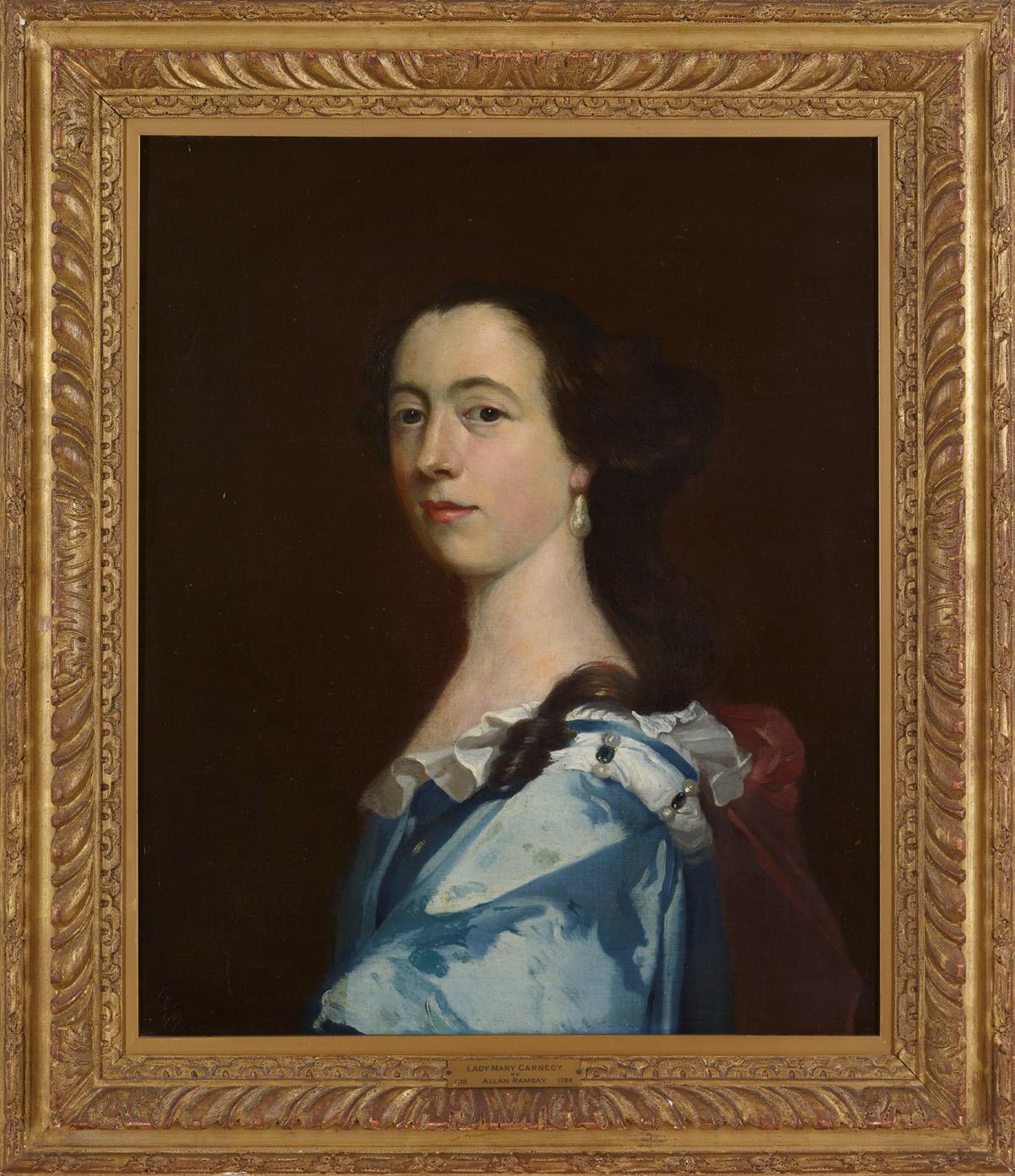
Oil
£1,200-1,800
131
17TH CENTURY BRITISH SCHOOL
THREE QUARTER LENGTH
PORTRAIT OF A GENTLEMAN

Oil on canvas
102cm x 84cm (40in x 33in)
£800-1,200
on canvas
57cm x 47cm (22.5in x 18.5in)
Note: Sir James Carnegie, Lady Mary’s father, was painted by Ramsay c.1749-51
50 Other fees apply in addition to the hammer price: see the ‘Buyer’s Guide’ section on page 2
133
17TH CENTURY DUTCH SCHOOL
STORM AT SEA
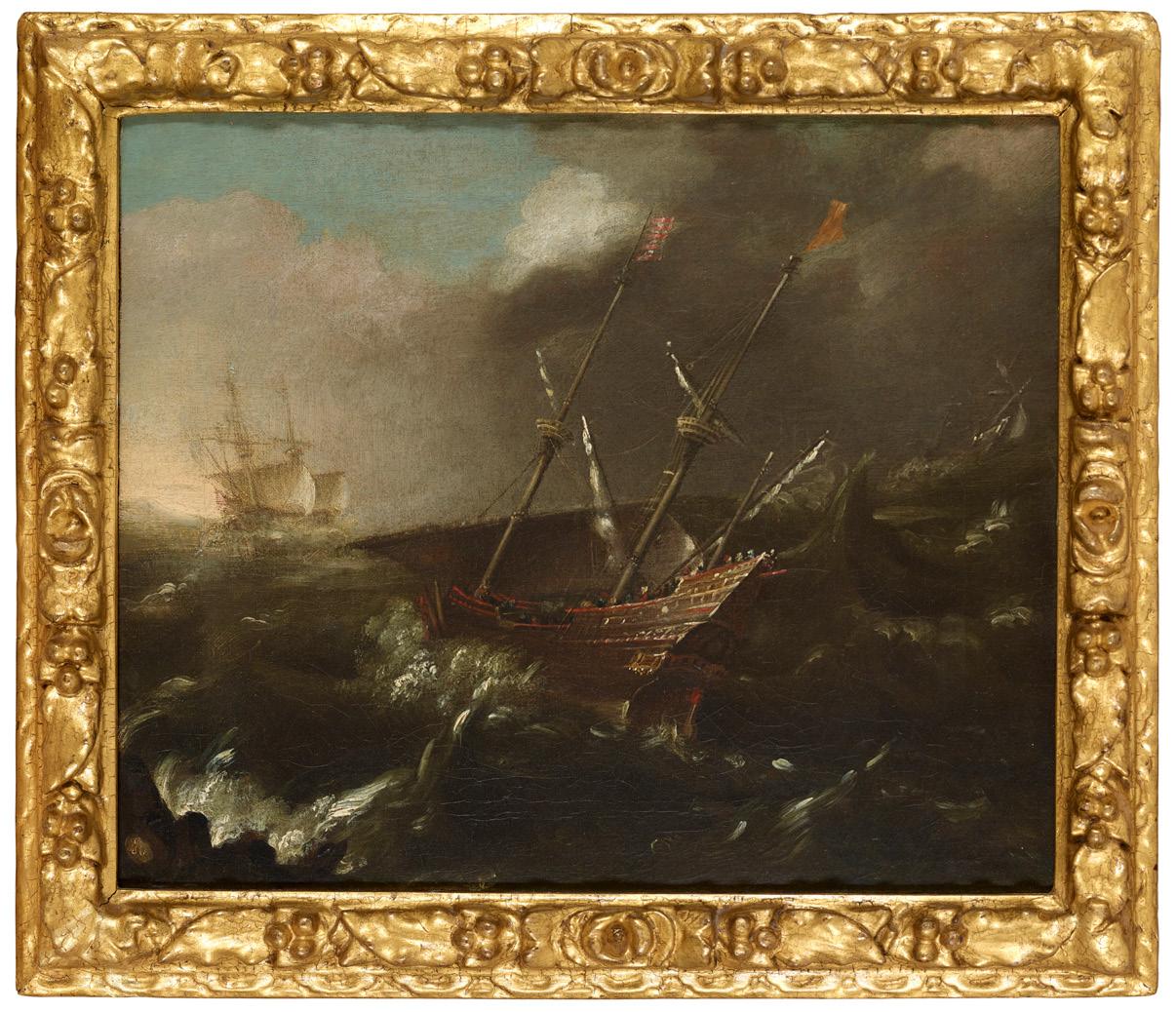
Oil on canvas
27cm x 33cm (10.5in x 13in)
£800-1,200
135
17TH CENTURY ENGLISH SCHOOL
HALF LENGTH PORTRAIT OF A BOY
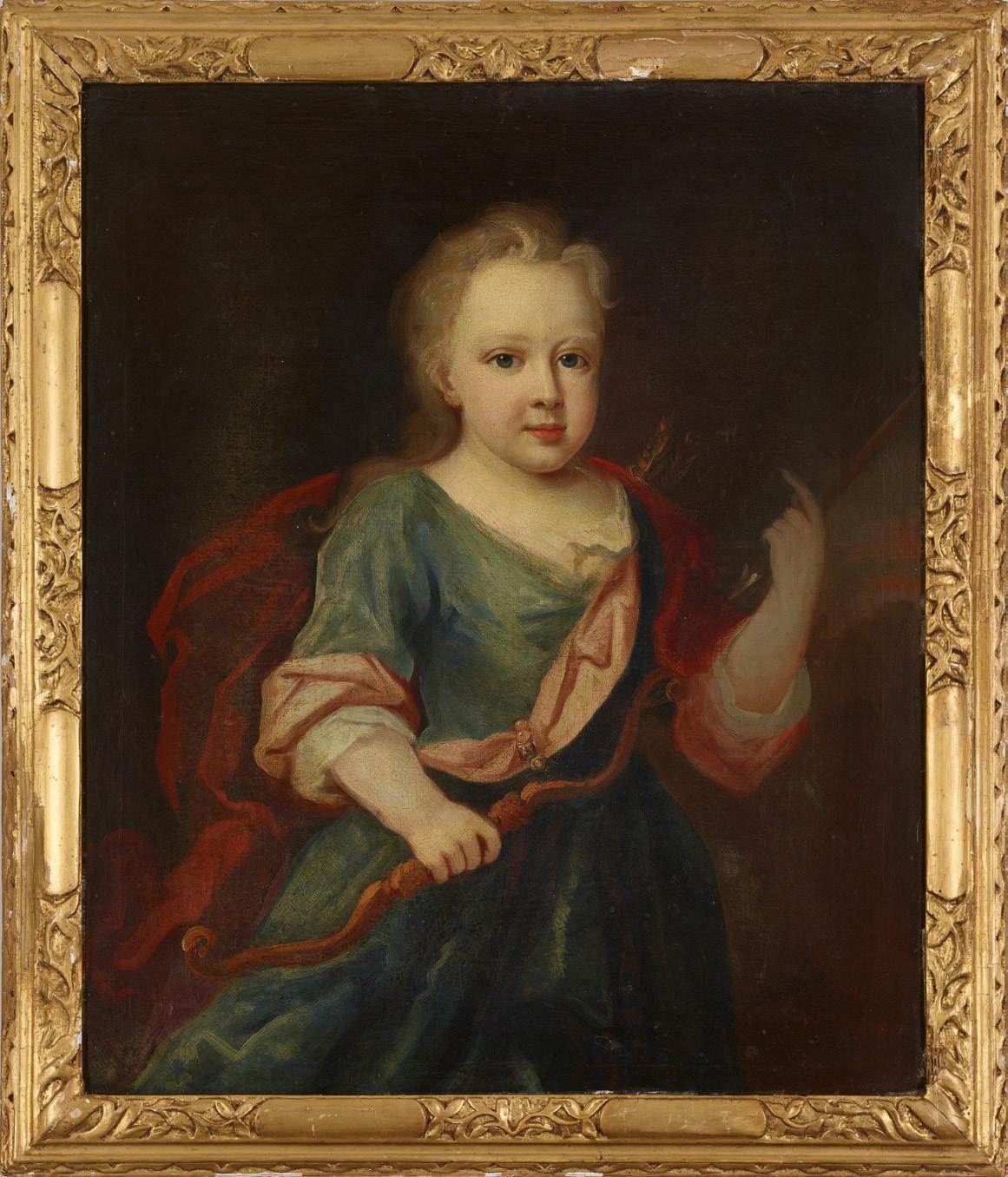
HOLDING A BOW
Oil on canvas
73cm x 61cm (28.75in x 24in)
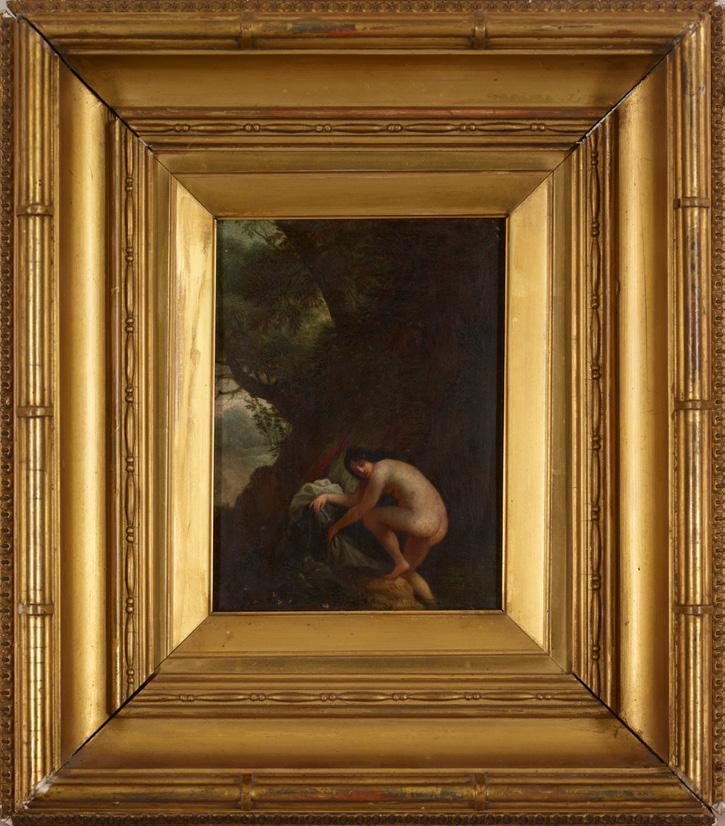
£600-800
134
FOLLOWER OF MOSES VAN UTTENBROECK DIANA DISTURBED WHILST BATHING
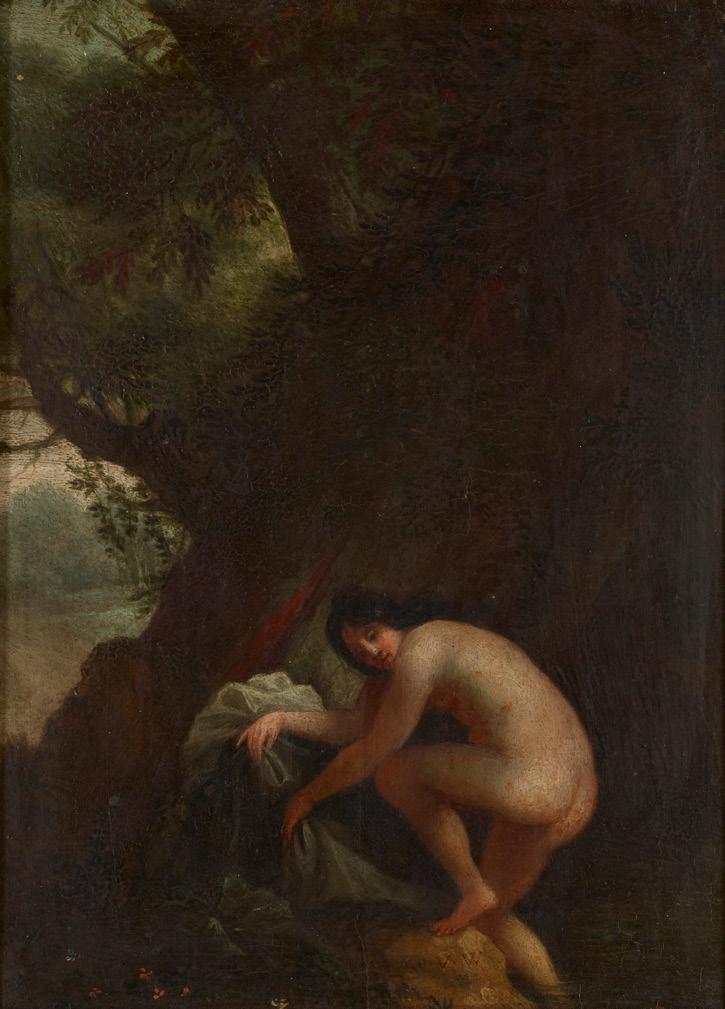
Signed with initials, oil on panel
18cm x 13cm (7in x 5in)
£500-800
51
HALF LENGTH PORTRAIT OF JAMES EDLINGTON

Pastel, oval
60cm x 44cm (23.5in x 17.25in)
Note: This painting was illustrated on the front page of Antique Finder Annual Guide 1969
£800-1,200
136
DANIEL
PORTRAIT OF A LADY AND DAUGHTER

Oval, mixed media
55cm x 47cm (21.75in x 18.5in)
Provenance: Leger Galleries, London, November 1974
£800-1,200
GARDNER (BRITISH 1750-1805)
137
JOHN RUSSELL (BRITISH 1745-1806)
52
138
FOLLOWER OF ALEXANDER ROSLIN
HALF LENGTH PORTRAIT OF A LADY IN BLUE
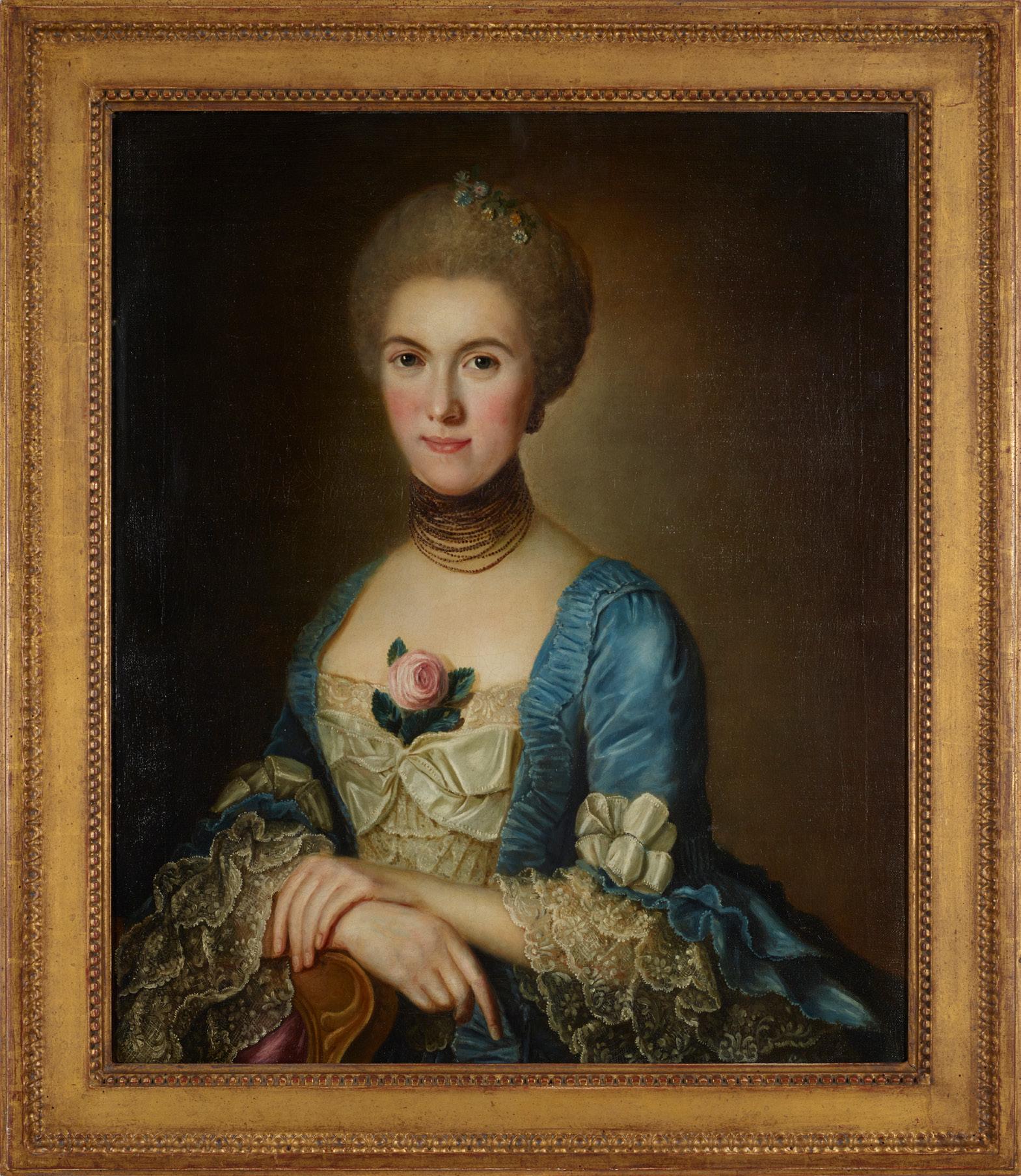
Oil on canvas
74cm x 62cm (29.25in x 24.5in)
£2,000-3,000
53 Other fees apply in addition to the hammer price: see the ‘Buyer’s Guide’ section on page 2
18TH CENTURY
ENGLISH SCHOOL
HALF LENGTH PORTRAIT OF A NAVAL OFFICER

Feigned oval, oil on canvas
91cm x 76cm (36in x 30in)
£500-800
140
RICHARD ROTHWELL (BRITISH 1800-1868)
FULL LENGTH PORTRAIT OF A YOUNG MAN IN A LANDSCAPE
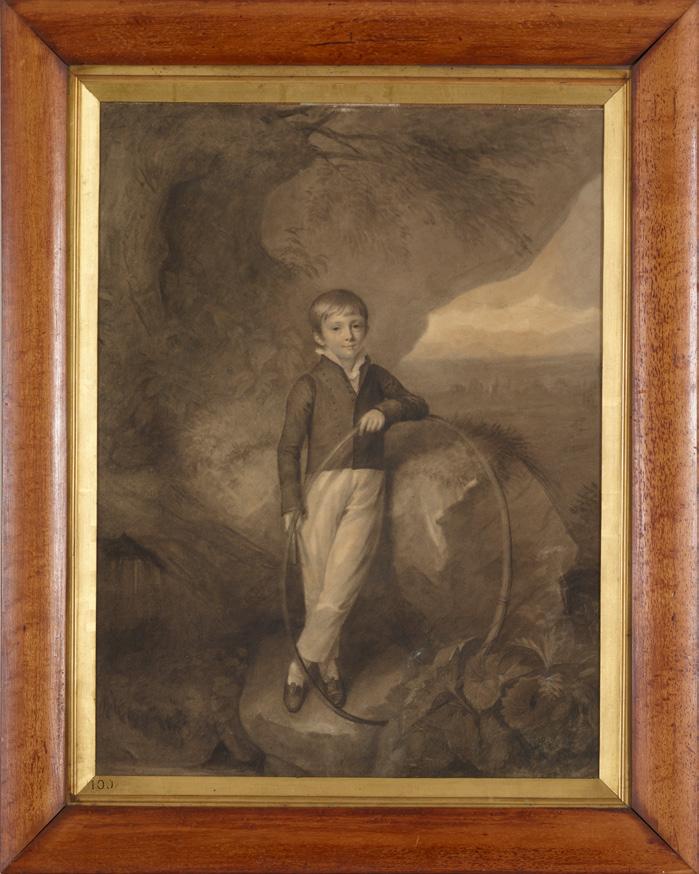

Signed, grisaille, and a companion by the same hand
‘Young Boy with Hoop’ (2) 49cm x 36cm (19.25in x 14.25in)
£500-800
139
54
141
THOMAS WOODWARD (BRITISH 1801-1852)
A SPOT OF KNITTING
Signed with the monogram and dated 1849, oil on canvas
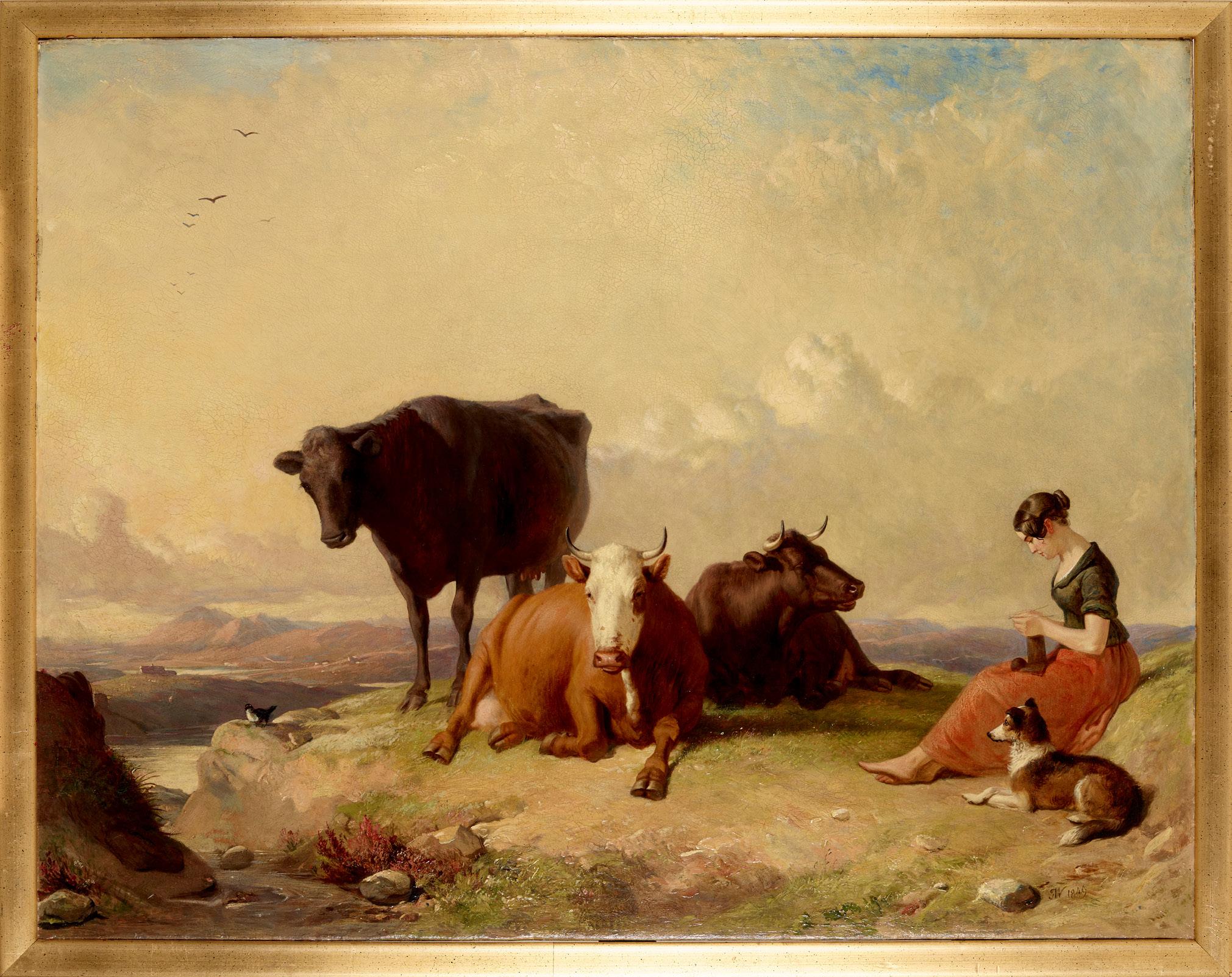
70.5cm x 91cm (27.75in x 60in)
£2,000-3,000
55 Other fees apply in addition to the hammer price: see the ‘Buyer’s Guide’ section on page 2
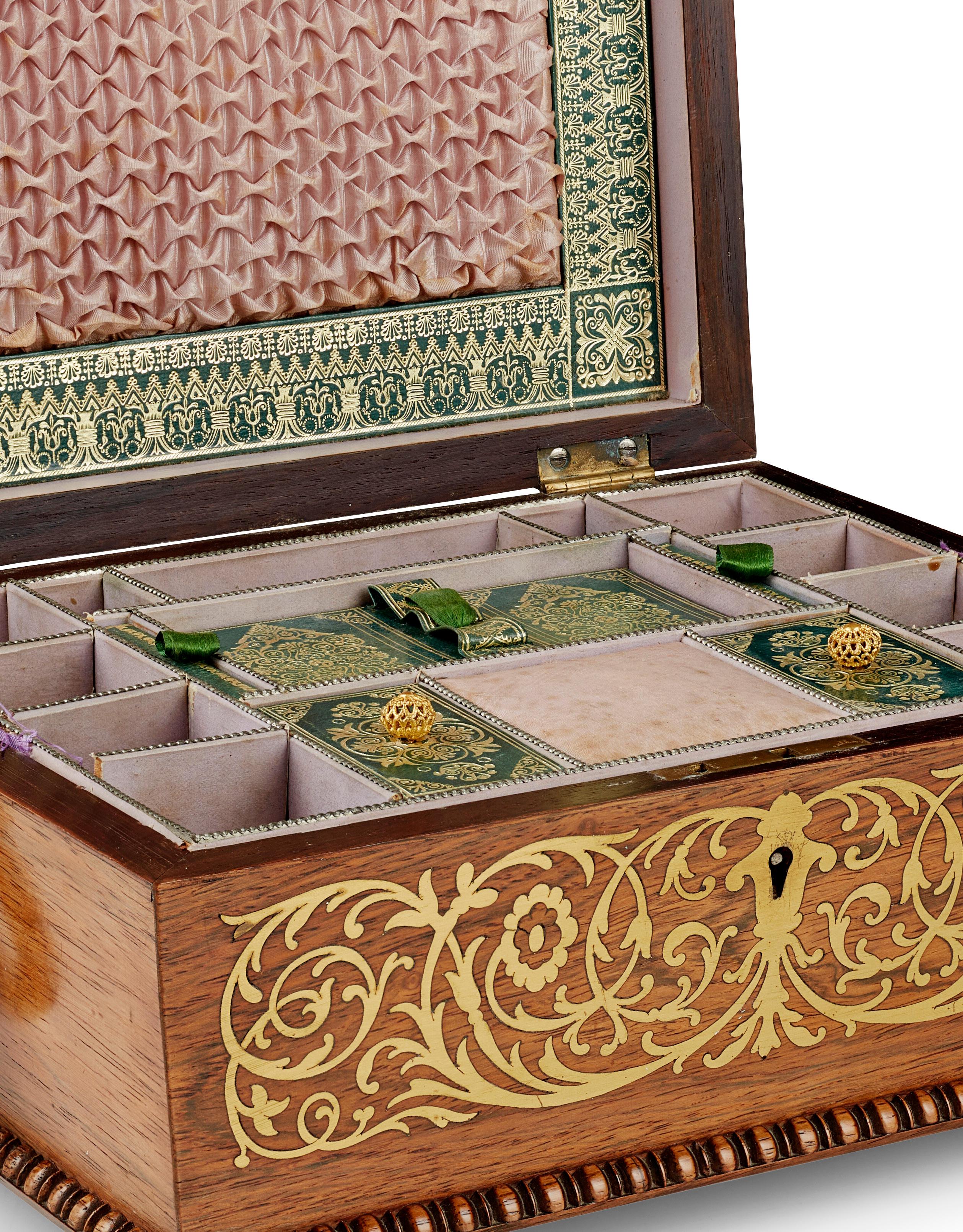
56
BRITISH FURNITURE & WORKS OF ART PART II
142
PAIR OF REGENCY MAHOGANY AND EBONY INLAID SIDE CHAIRS, IN THE MANNER OF GEORGE BULLOCK EARLY 19TH CENTURY

the bar backs inlaid with palmettes, raised above scroll carved caned panel backs over stuffover seats, raised on reeded sabre legs (2)
45cm wide, 90cm high, 48cm deep
£1,000-1,500
143 Y
REGENCY ROSEWOOD AND BRASS INLAID SOFA TABLE
EARLY 19TH CENTURY
the rounded rectangular crossbanded top with drop ends and brass inlay, above a brass inlaid frieze with a drawer, raised on a flat baluster column and quadripartite base with sabre legs ending in cast paw caps and castors
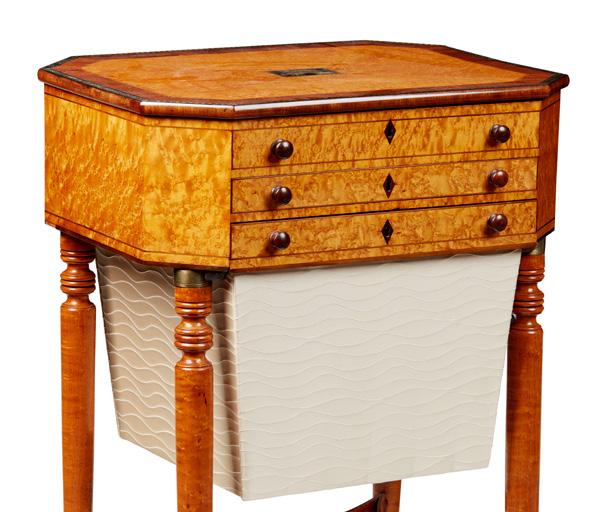

152cm wide(flaps up), 93cm wide (flaps down), 74cm high, 71cm deep
Provenance: Private Scottish Collection, Morayshire
£1,000-1,500
144
REGENCY BIRD’S EYE MAPLE, MAHOGANY AND BRASS INLAID WORK TABLE
EARLY 19TH CENTURY
the canted rectangular top banded and inlaid with brass with a central brass plaque depicting a wolf and two birds, opening to a fitted interior with a black leather writing slope, pen tray, and inkpots, above a dummy drawer, a real drawer, and a sliding work box lined with yellow silk lining, raised on ring turned and tapered legs joined by concave stretchers and ending in brass castors
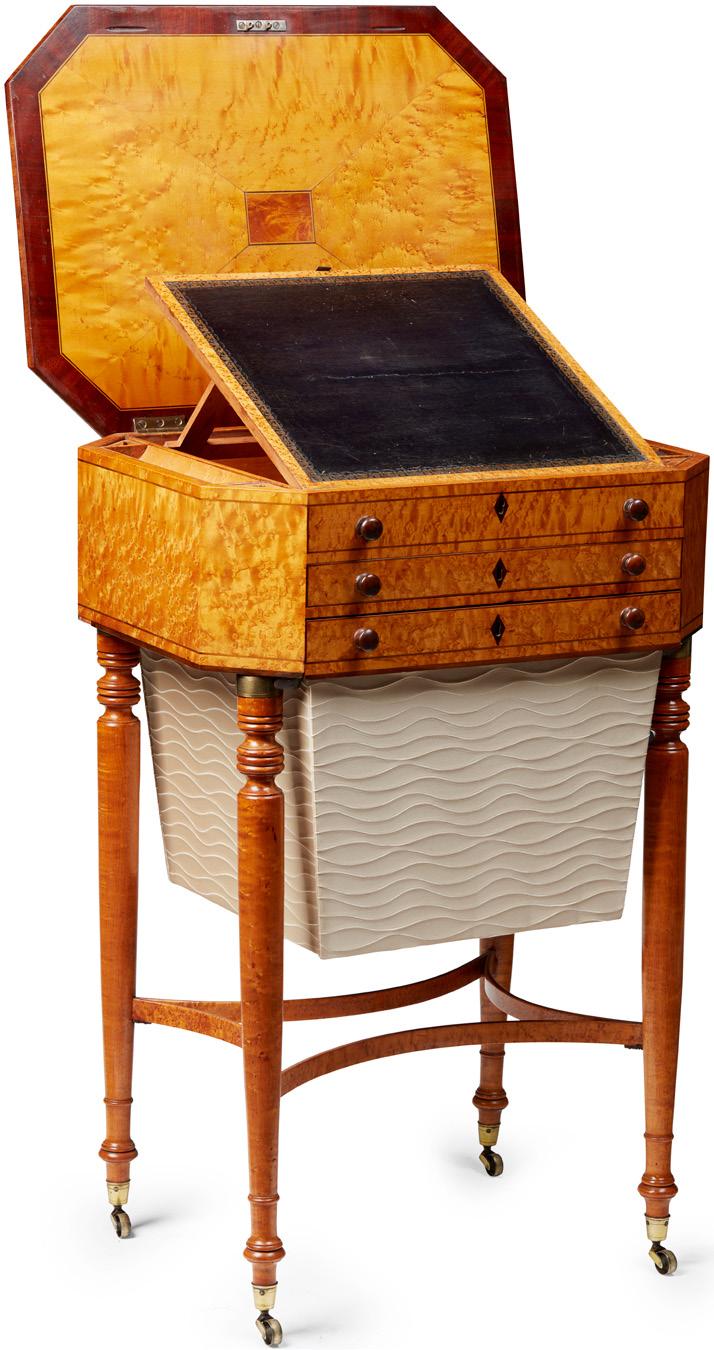
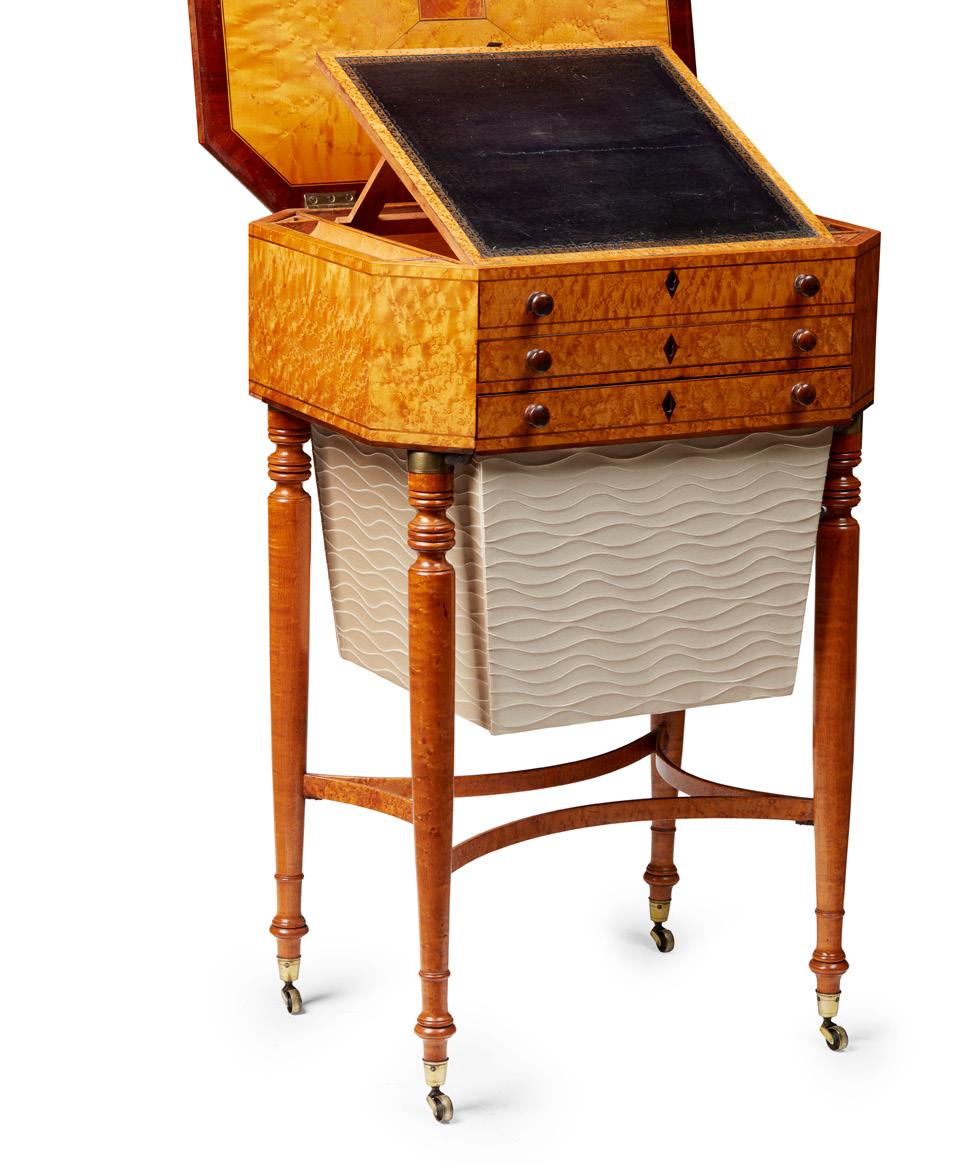
53cm wide, 73cm high, 41cm deep
Provenance: Purchased Mayorcas, Ltd, Jermyn Street, London
£1,200-1,800
57 Other fees apply in addition to the hammer price: see the ‘Buyer’s Guide’ section on page 2
145 Y
REGENCY ROSEWOOD AND BRASS INLAID SOFA TABLE

EARLY 19TH CENTURY
the rounded rectangular drop leaf top with boxwood strung border above two real and two opposing dummy frieze drawers with cut brass inlay, raised on twin lyre end supports, united by a shaped stretcher on sabre legs with carved acanthus details and ending in brass paw caps and castors
161cm wide, 72cm high, 66.5cm deep (extended)
£1,000-1,500
146 Y
REGENCY ROSEWOOD ÉTAGÈRE

EARLY 19TH CENTURY
with three rectangular tiers raised and divided by turned supports with urn finials, on turned legs with brass caps and castors
81cm wide, 96cm high, 39cm deep
£400-600
147 Y
REGENCY ROSEWOOD ARMCHAIR
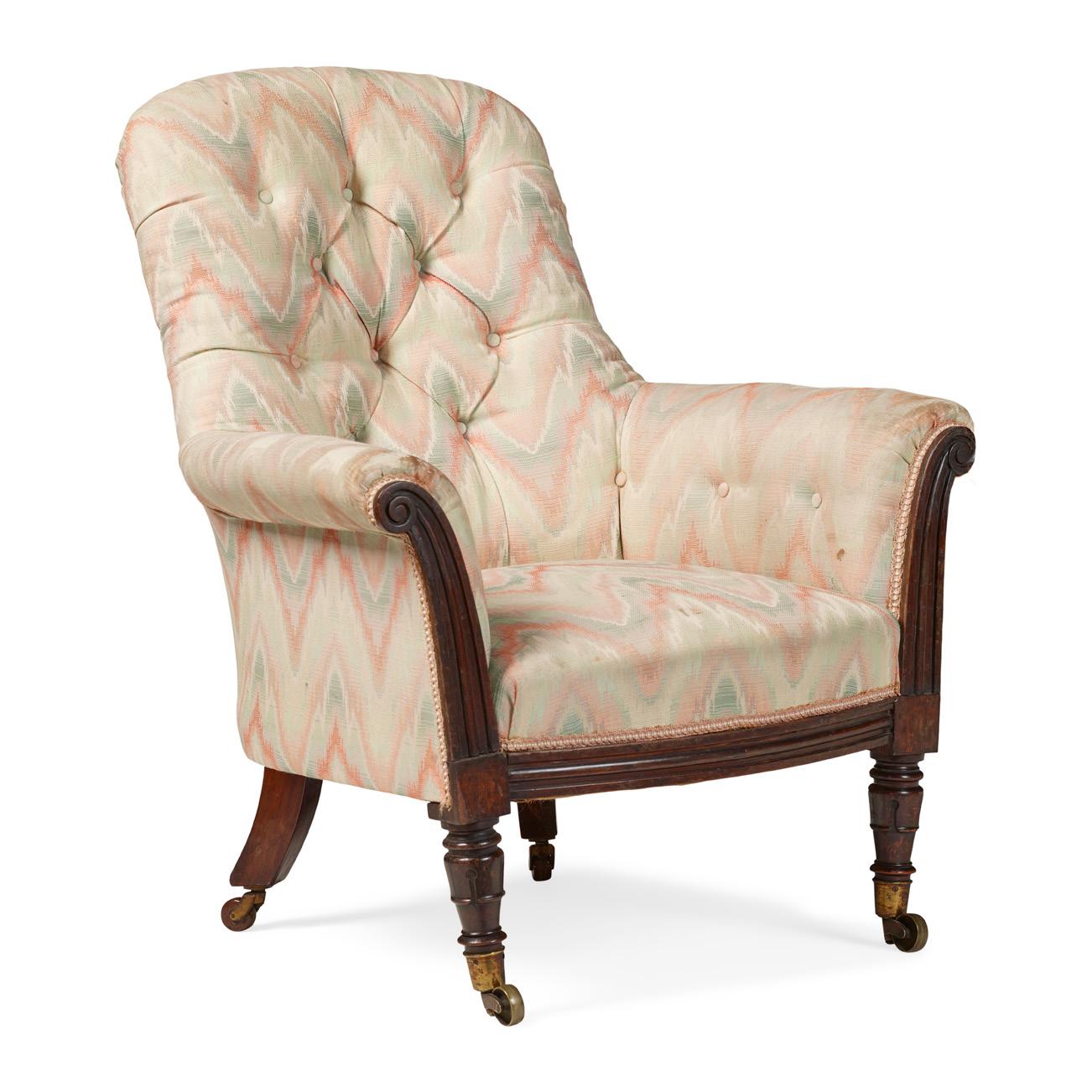
EARLY 19TH CENTUTRY
the button-upholstered curved back above a stuffover seat flanked by scrolled enclosed arms, raised on lotus carved legs with brass caps and castors
77cm wide, 94cm high, 54cm deep
£300-500
58 Other fees apply in addition to the hammer price: see the ‘Buyer’s Guide’ section on page 2
148
REGENCY GILTWOOD OVERMANTEL MIRROR
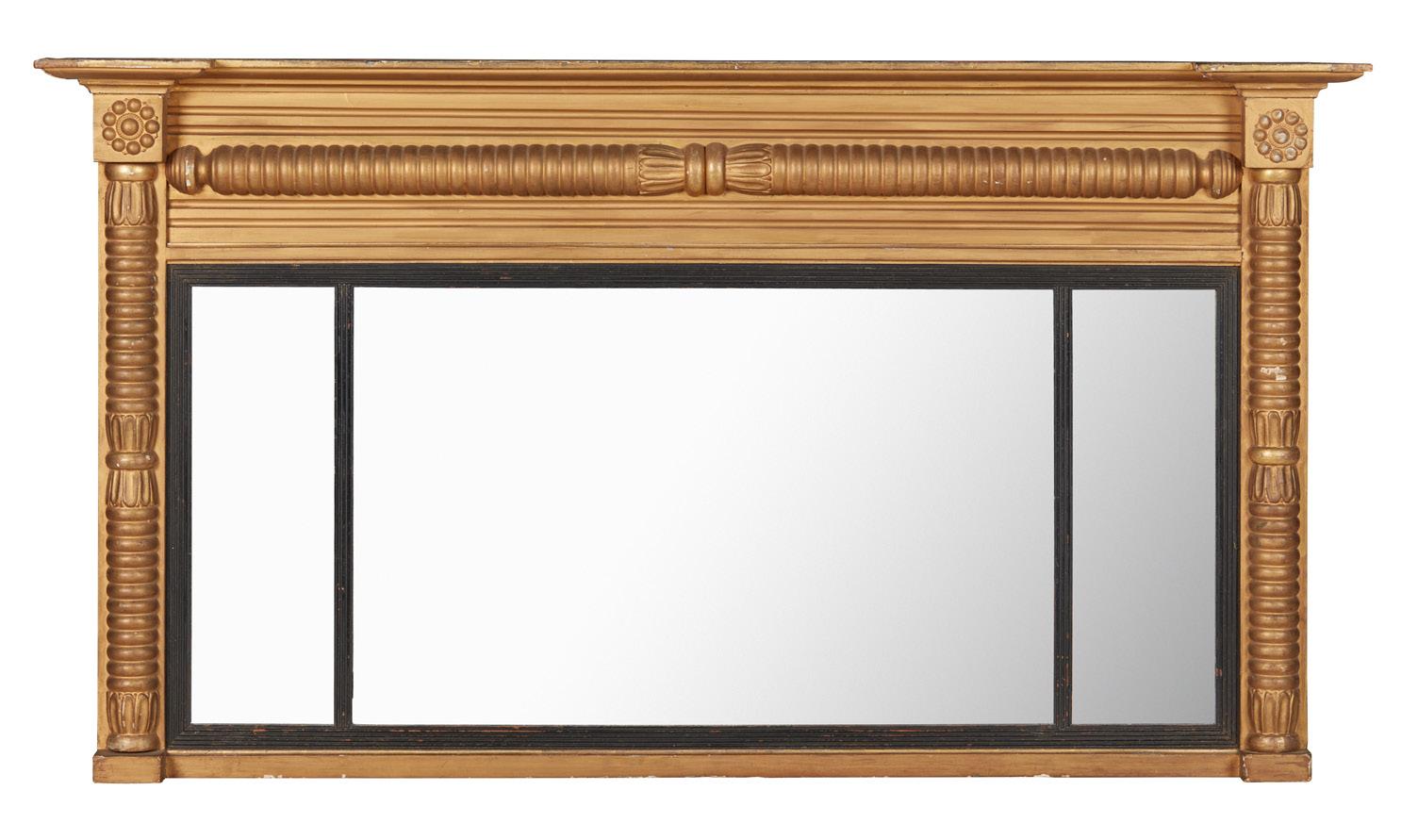
EARLY 19TH CENTURY
the moulded cornice above a rectangular triple mirror plate in an ebonised slip and leaf-clasped beaded column frame
74cm high, 131cm wide
£400-600
149 Y
REGENCY ROSEWOOD WORK TABLE
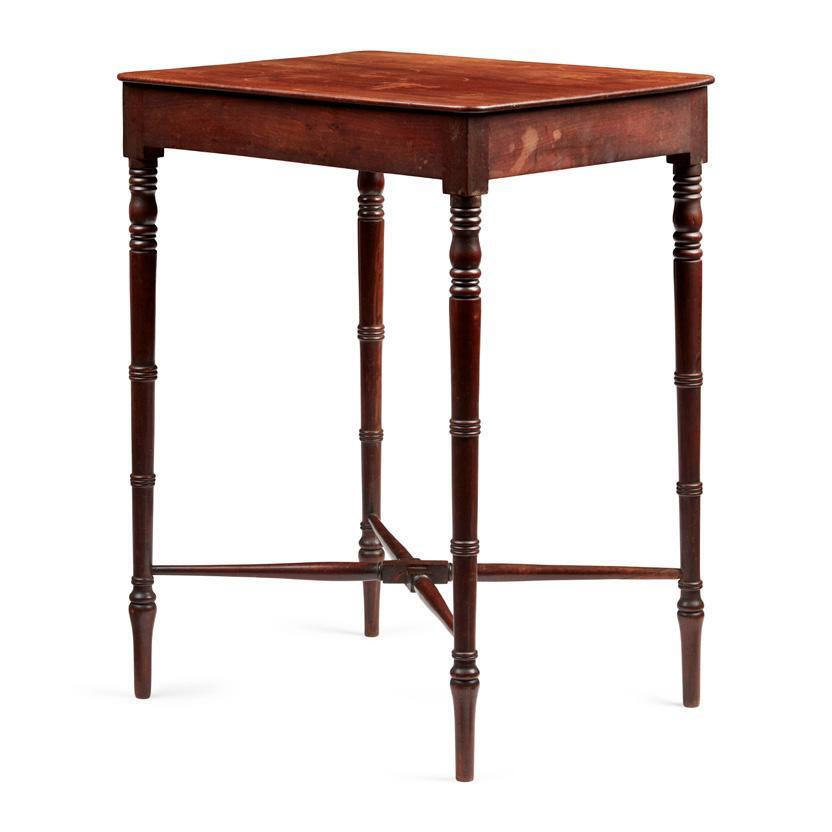
EARLY 19TH CENTURY
the hinged top above a long frieze drawer and a slide with red baize lining to one side, raised on turned legs joined by a concave undertier 51cm wide, 73cm high, 38cm deep
£400-600
150
REGENCY MAHOGANY LAMP TABLE
EARLY 19TH CENTURY
the rounded rectangular top above a plain frieze, raised on slender ring turned legs joined by a X form stretcher
55.5cm wide, 76cm high, 45cm deep
£300-400
151 Y
REGENCY ROSEWOOD LIBRARY TABLE, BY GILLOWS

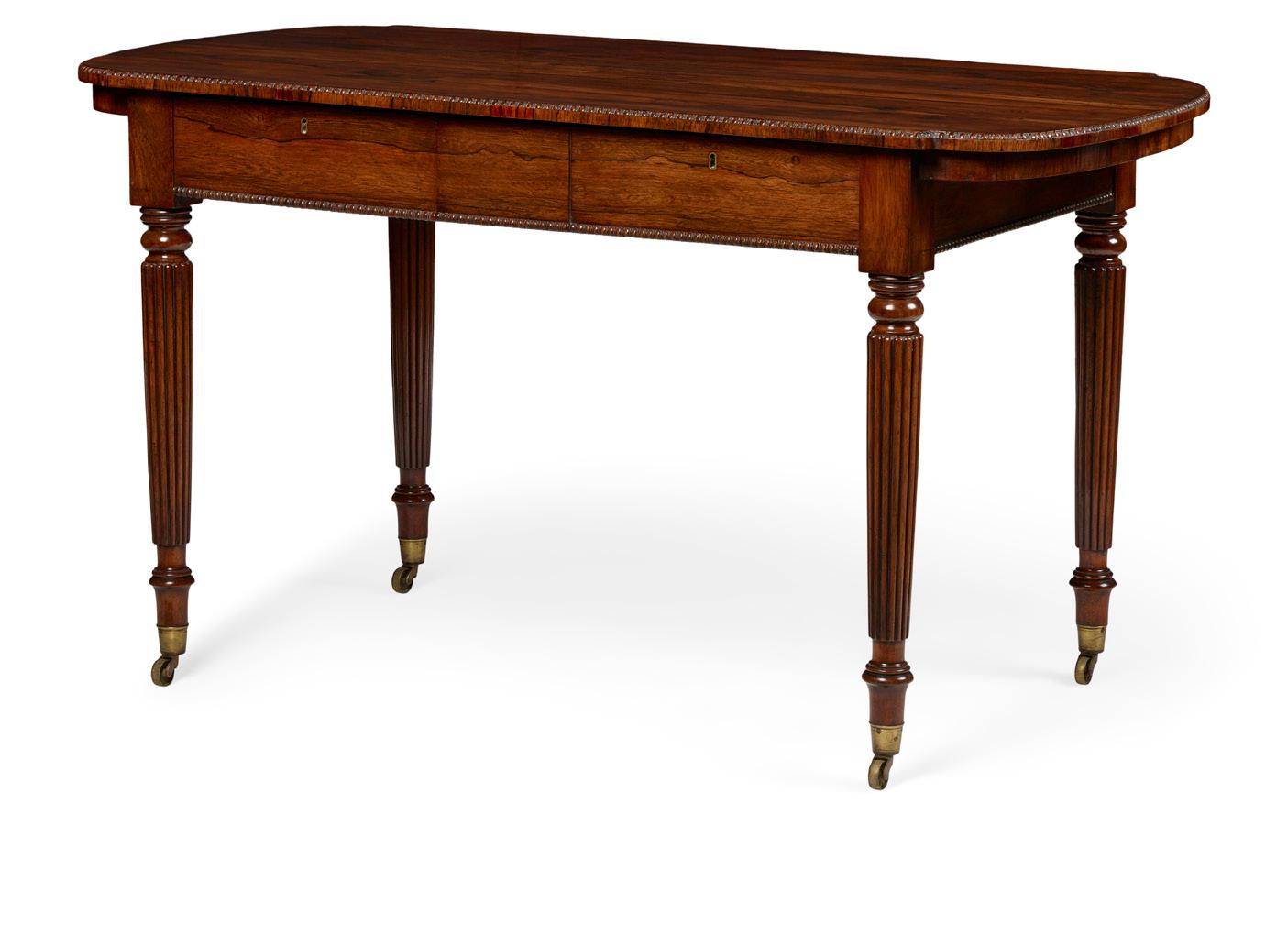
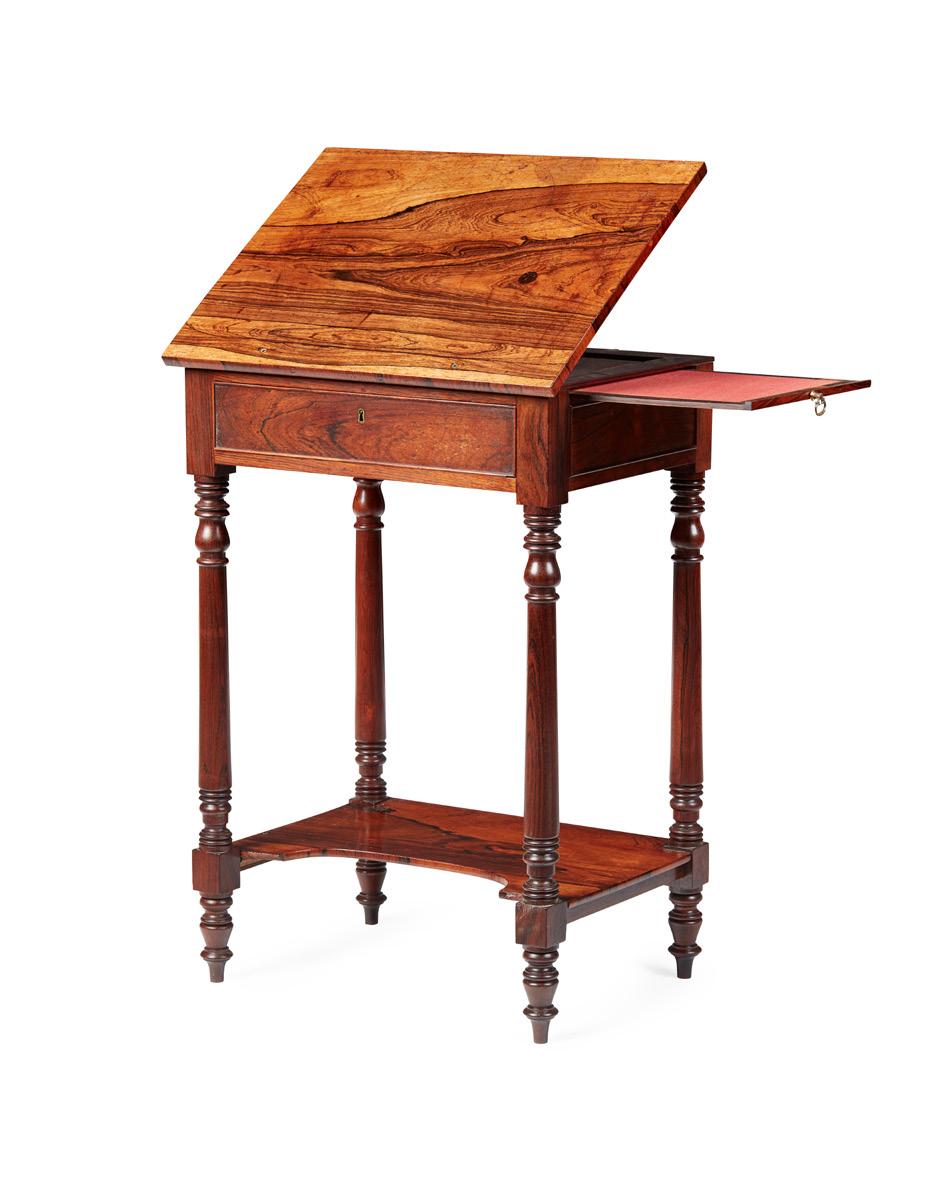
EARLY 19TH CENTURY
the shaped oval top outlined with bead moulding, above a pair of short frieze drawers, raised on reeded tapered legs ending in brass caps and castors, the drawer stamped GILLOWS
138cm wide, 75cm high, 67cm deep
£1,500-2,500
59
152
REGENCY MAHOGANY LIBRARY BERGÈRE

EARLY 19TH CENTURY
the curved caned back and scroll arms above a caned seat, on reeded tapered front legs with brass caps and castors
58cm wide, 100cm high, 68cm deep
£500-700
153
PAIR OF REGENCY STYLE
MAHOGANY CANED STOOLS
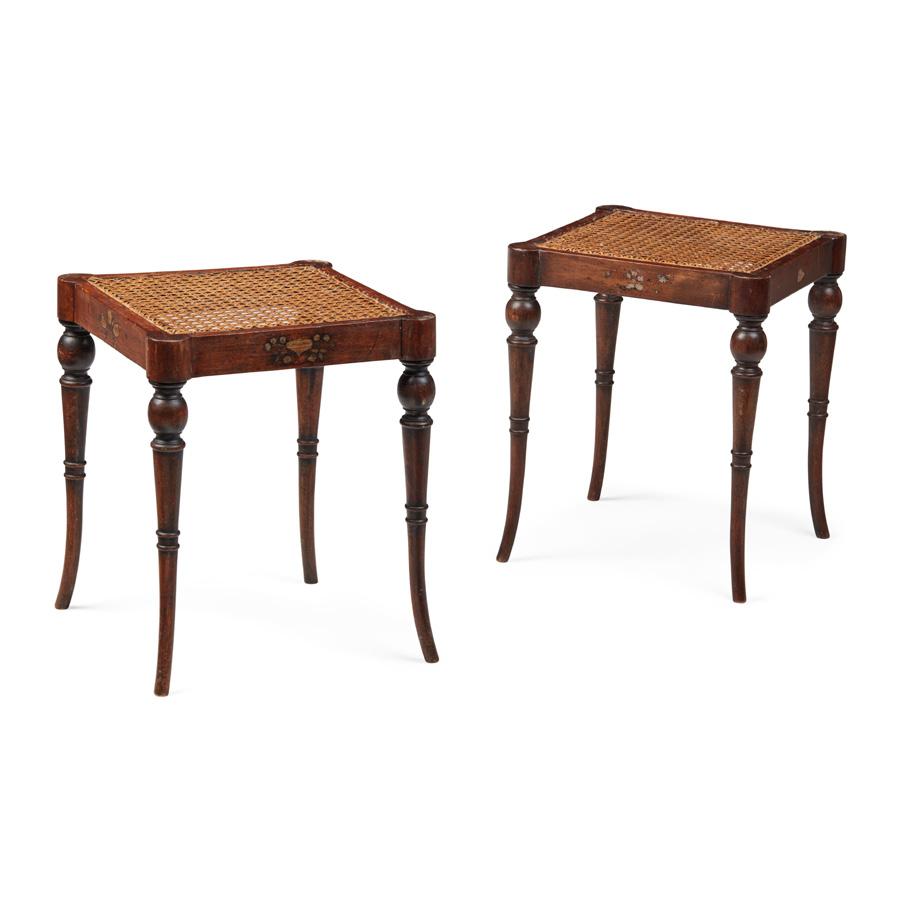
EARLY 20TH CENTURY
the caned square tops with outset rounded corners, the seat rails with traces of painted flower decoration, raised on turned and tapered legs with slightly outswept feet (2) 35cm wide, 42cm high, 35cm deep
£300-400
154
REGENCY MAHOGANY SECRETAIRE PRESS CUPBOARD
EARLY 19TH CENTURY
the moulded cornice above a pair of bead moulded panel doors enclosing four sliding trays, on an associated base with a central secretaire drawer flanked by deep drawers, over three further long drawers all with ebonised knobs, above a shaped apron and raised on French bracket feet
123cm wide, 236cm high, 58cm deep
£500-700
155
REGENCY GONCALO ALVES SIDE CABINET

EARLY 19TH CENTURY
the plain top above a foliate carved frieze and a pair of brass grille insert doors lined with pleated ecru fabric, opening to a shelved interior, on a plinth base

112cm wide, 92cm high, 33.5cm deep
£800-1,200
60
156
SET OF EIGHT REGENCY MAHOGANY DINING CHAIRS

EARLY 19TH CENTURY
with reeded bar backs with a horizontal rope twist spar, above caned seats raised on sabre legs (8) 49cm wide, 85cm high, 44cm deep £1,000-1,500
157
REGENCY MAHOGANY EXTENDING PEDESTAL DINING TABLE

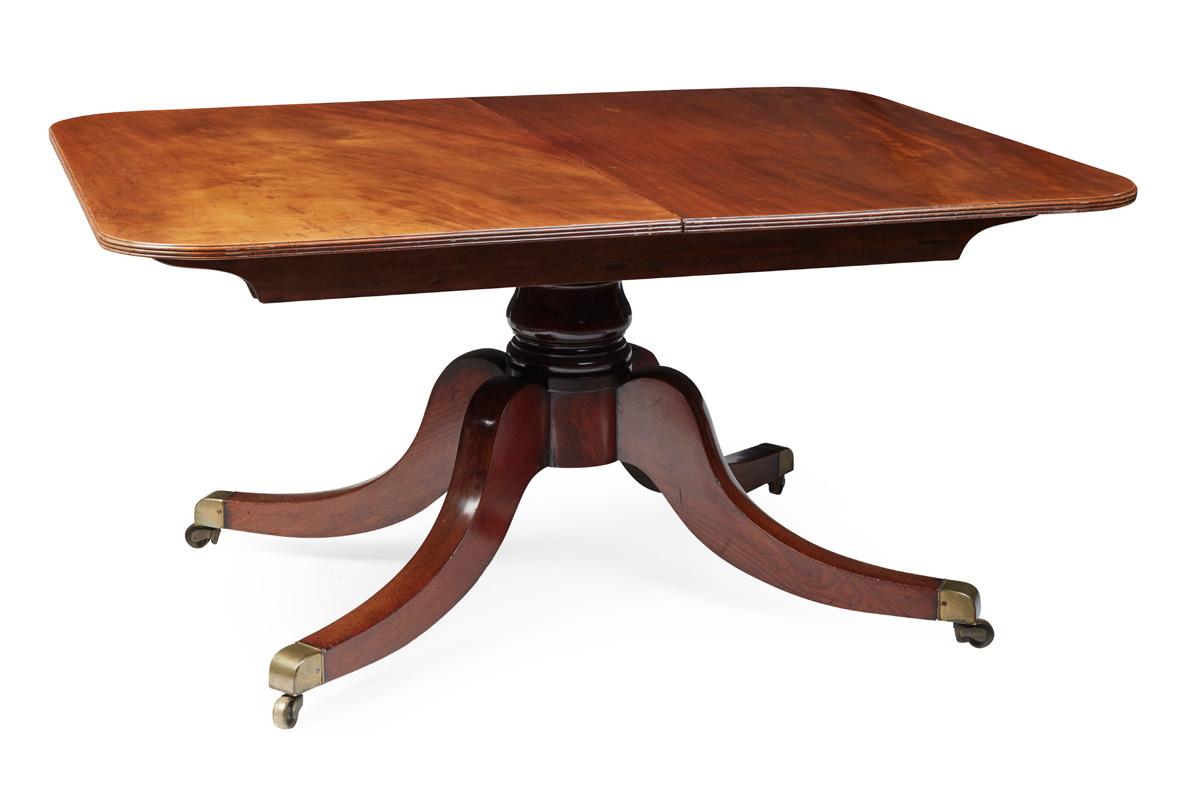
EARLY 19TH CENTURY
the rounded rectangular top with a reeded edge, extending above a wide turned baluster support, raised on outswept legs ending in brass caps and castors, with a single leaf insert 223cm wide [extended], 74cm high, 115cm; 149cm wide [closed]
£3,500-4,500
61 Other fees apply in addition to the hammer price: see the ‘Buyer’s Guide’ section on page 2
161
REGENCY MAHOGANY
DWARF OPEN BOOKCASE

EARLY 19TH CENTURY
the inverted breakfront top above three open compartments with adjustable shelves, on a conforming plinth base
153cm wide, 94cm high, 32cm deep
£600-800
158
REGENCY MAHOGANY LAMP TABLE
EARLY 19TH CENTURY
the rectangular top with a moulded edge above a single frieze drawer, raised on twin ring-turned end supports with trestle bases joined by a turned stretcher
46cm wide, 71cm high, 40.5cm deep
£300-500
159 Y
REGENCY ROSEWOOD DROP-LEAF WORK TABLE

EARLY 19TH CENTURY
the rounded rectangular top with drop sides above a single drawer and a sliding pleated silk covered work box, raised on a semi-circular support ending in a tapering column and four hipped sabre legs terminating in brass caps and castors
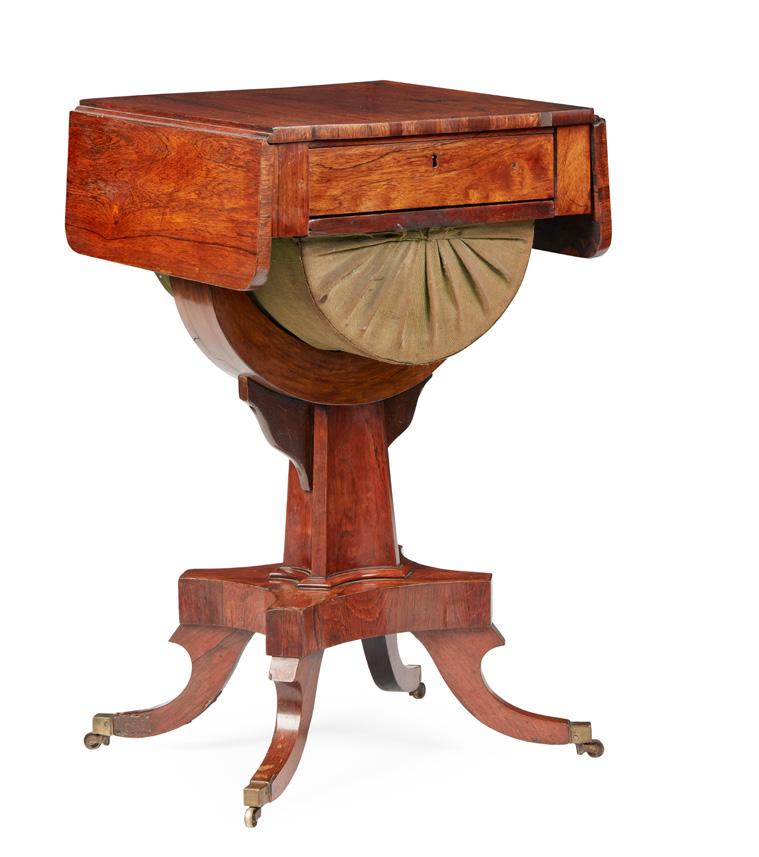
46cm wide 76cm [open], 78cm high, 46cm deep
£300-500
160
SET OF SIX REGENCY MAHOGANY DINING CHAIRS
EARLY 19TH CENTURY
with boxwood and ebony strung bar backs inlaid with Greek key motifs, above a horizontal splat and stuffover seats with burnt umber covers, raised on tapering turned legs, to include four side chairs and a pair of armchairs (6)
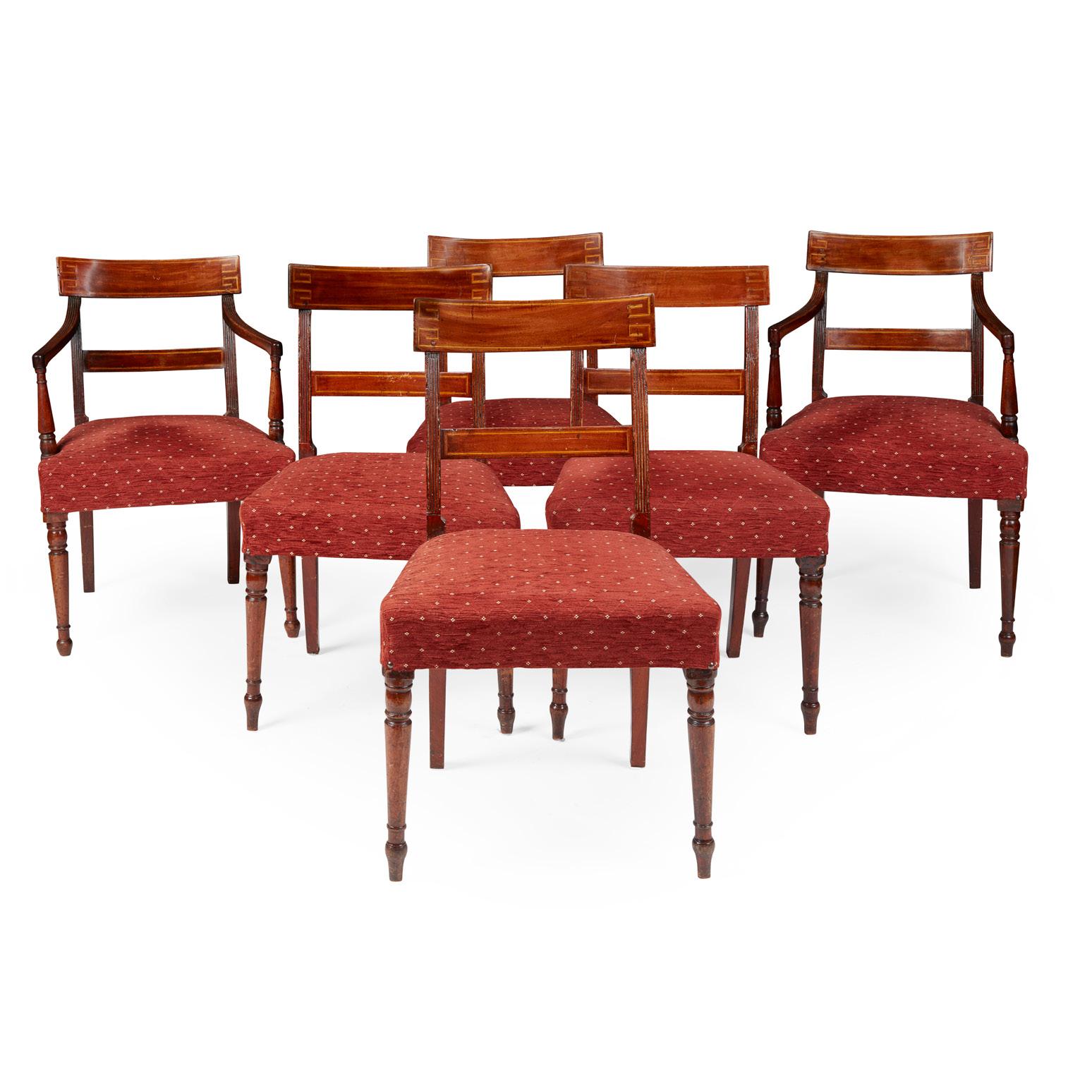
53cm wide, 77cm high, 43cm deep
£400-600
62
164 Y
REGENCY ROSEWOOD AND BRASS INLAID MARBLE TOP SIDE CABINET
EARLY 19TH CENTURY
the later Verde Antico marble top above a frieze centred by a brass inlaid tablet and corner blocks and outlined with bead moulding, above a pair of pleated silk lined doors enclosing shelves, raised on ebonised turned feet
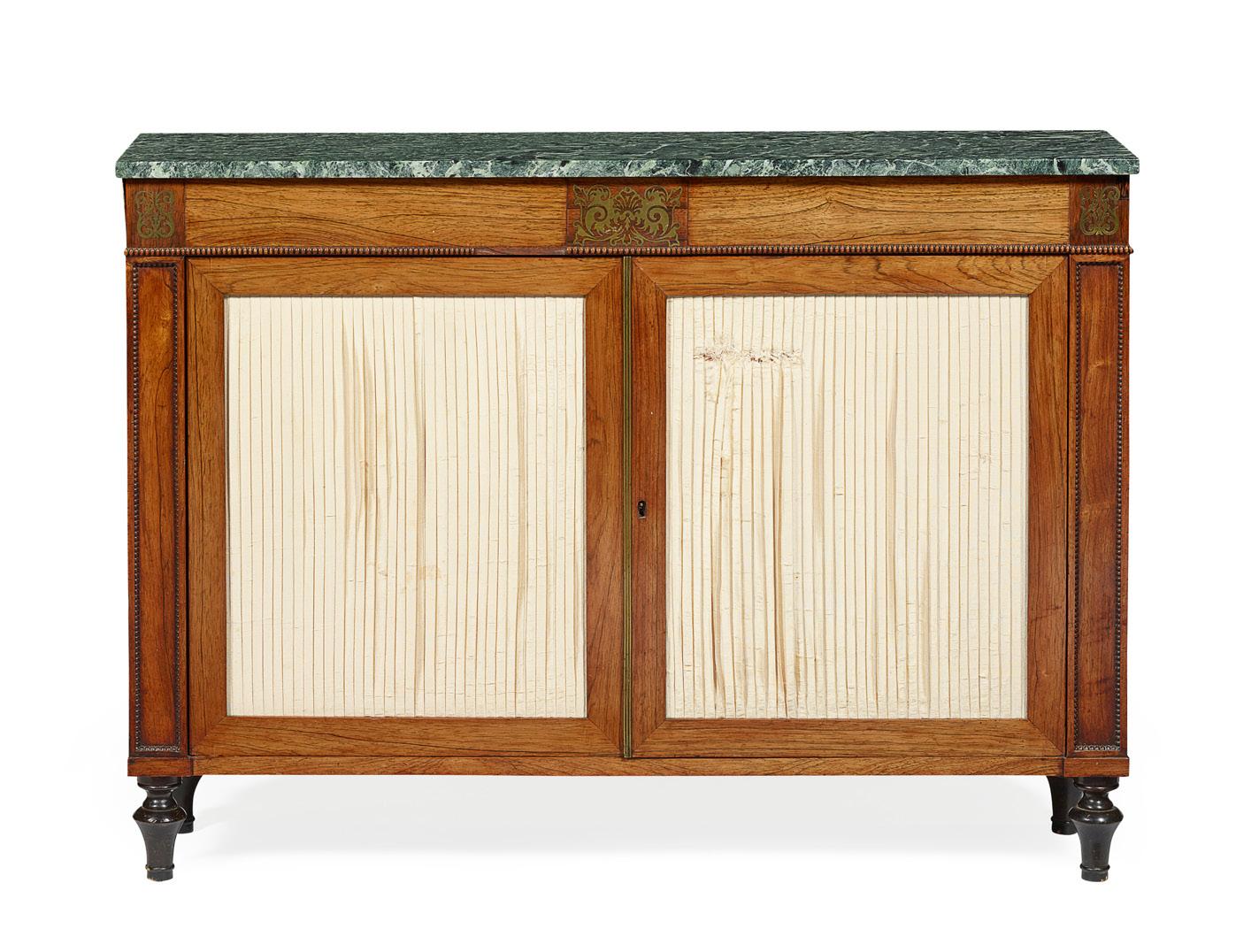
127cm wide, 92cm high, 31cm deep £400-600
162
REGENCY MAHOGANY, ROSEWOOD, AND EBONISED CARD TABLE
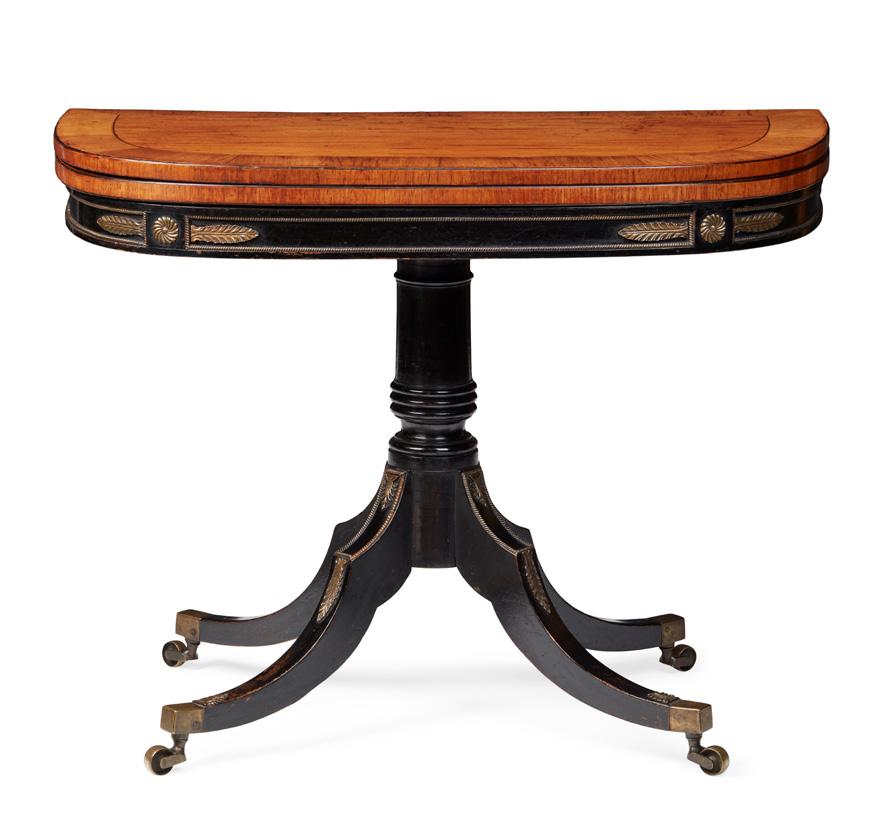
EARLY 19TH CENTURY
the D shaped and crossbanded fold-over top opening to a baize lined playing surface, above an ebonised frieze with brass palm and rosette mounts, on a ring-turned column support with outswept sabre legs with further brass mounts and terminating in cast brass caps and castors
95cm wide, 76cm high, 49cm deep
£1,500-2,500
163
REGENCY MAHOGANY DOUBLE OPEN BOOKCASE

EARLY 19TH CENTURY
the moulded cornice above open adjustable shelves; the lower part with a slide and long frieze drawer over further open shelves on a plinth base
73cm wide, 182cm high, 43cm deep
£1,000-1,500
63 Other fees apply in addition to the hammer price: see the ‘Buyer’s Guide’ section on page 2
TWO LATE GEORGIAN/REGENCY NEEDLEWORK SAMPLERS
EARLY 19TH CENTURY
166
REGENCY VERRE EGLOMISÉ PICTURE
EARLY 19TH CENTURY
painted with a country scene of two men with their horses and a spaniel on a country lane, the backboard painted with a cottage, within a black and gilt border and moulded gilt frame
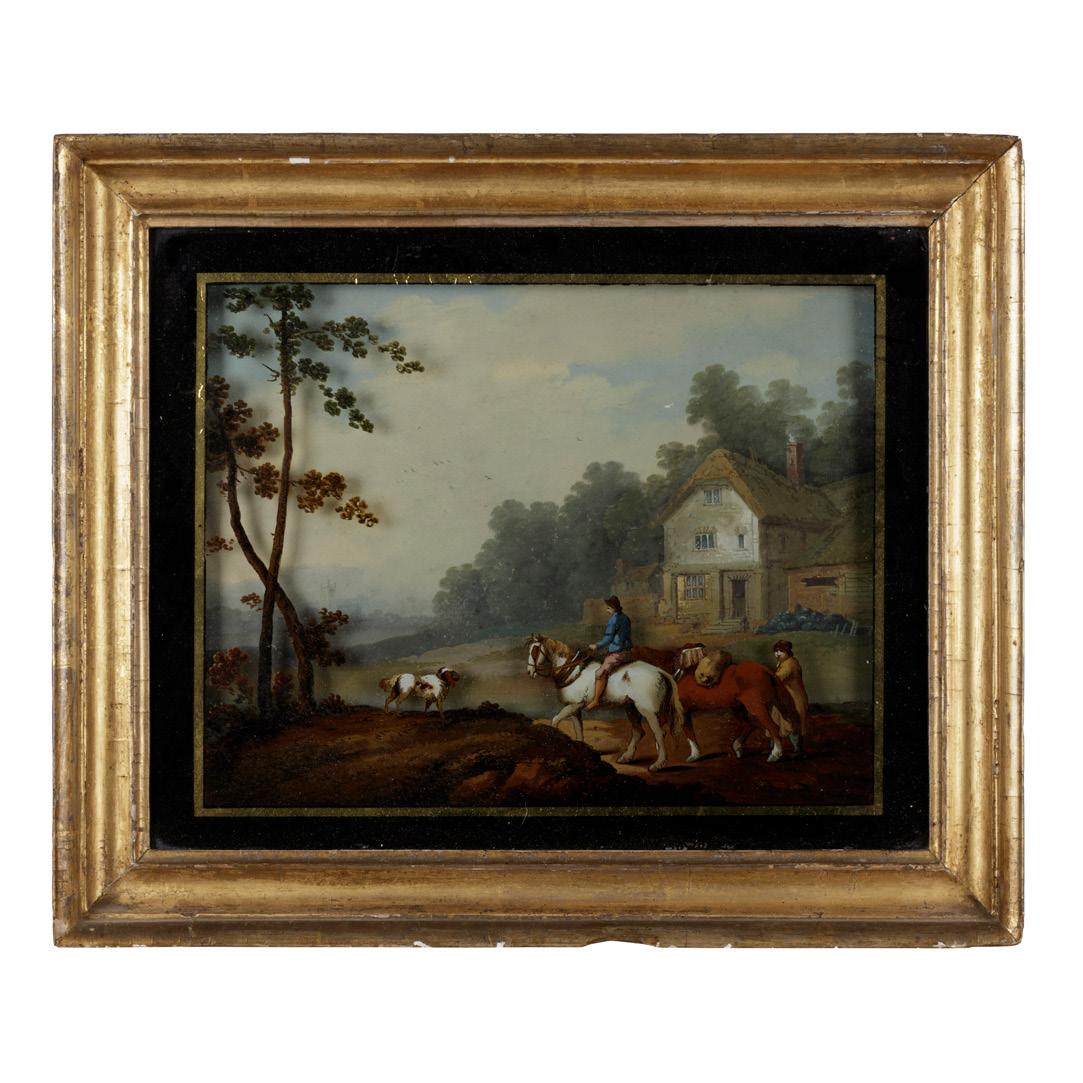
38cm x 46cm
£300-500
167 Y
TWO SCOTTISH NEEDLEWORK SAMPLERS
EARLY 19TH CENTURY
worked in silk on linen, the first with a wide band of stylised tulips above two reserves with bible passages, over a central fruiting tree, figures, cherubs, animals, and flowering plants, above a large house flanked by birds, flower baskets, in a painted rosewood frame; the second worked in silk on linen with a central four stanza hymn ‘Why should we start, and fear to die?’ by Isaac Watts, in a field filled with birds, insects, flowers, and trees, signed Sarah Ann Girm and dated June 16th 1831, inside a pink carnation border, in a cream mount and ebonised frame 41cm x 42.5cm & 40.5cm x 40.5cm respectively
£300-500
silk on linen, the first worked by Elizabeth Lawson, and inscribed ‘in the 10th year of her age 1811’, with her parent’s initials, a verse of ‘Christ on the Cross’ above flowering pots, birds, trees, and a windmill, bordered by fruiting vines, framed; the other worked by Elizabeth Kerby, aged 13, and dated 1833, with two alphabet and number series, above a personal passage ‘Elizabeth Kerby is my name and with my fingers I worked the same, and by my sampler that you may see what care my Father took of me’, above a field of flower pots, birds, trees, animals, the bible verse ‘Jesus wept’, in a wide meandering flower border and period rosewood frame (2) 32cm x 31.5cm and 33cm x 30cm (excluding frames)

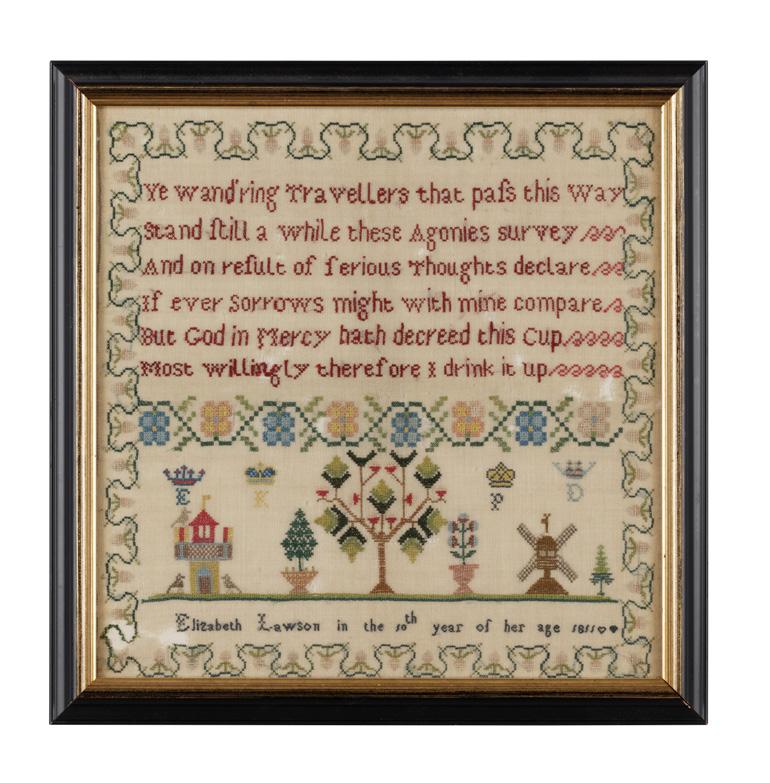
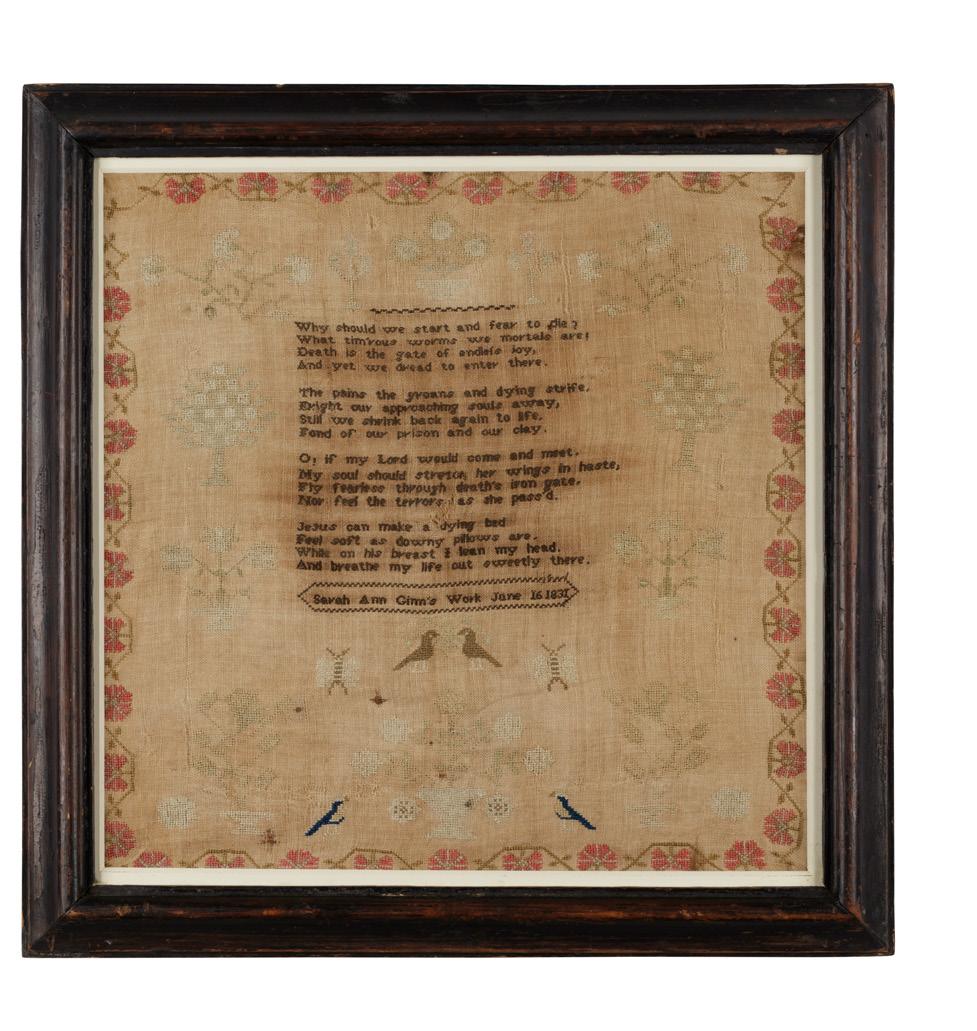
£400-600
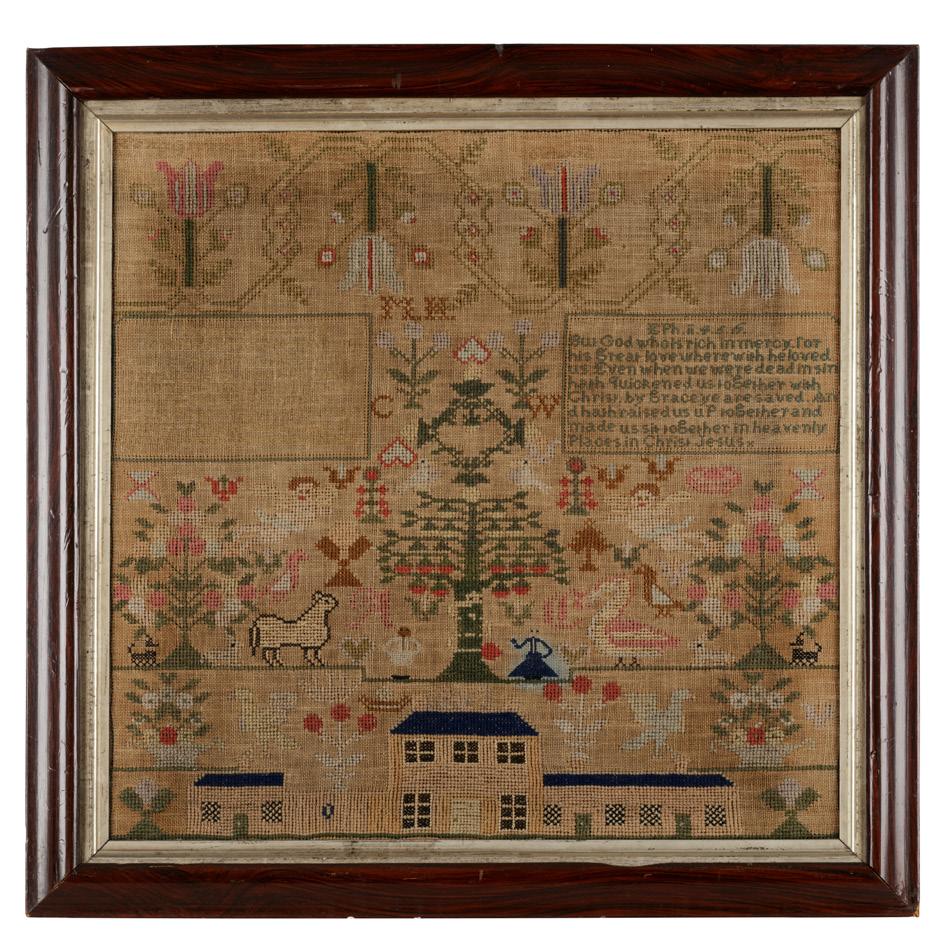
165 Y
64
168
PAIR OF REGENCY PATINATED AND GILT BRONZE CANDLESTICK LAMPS
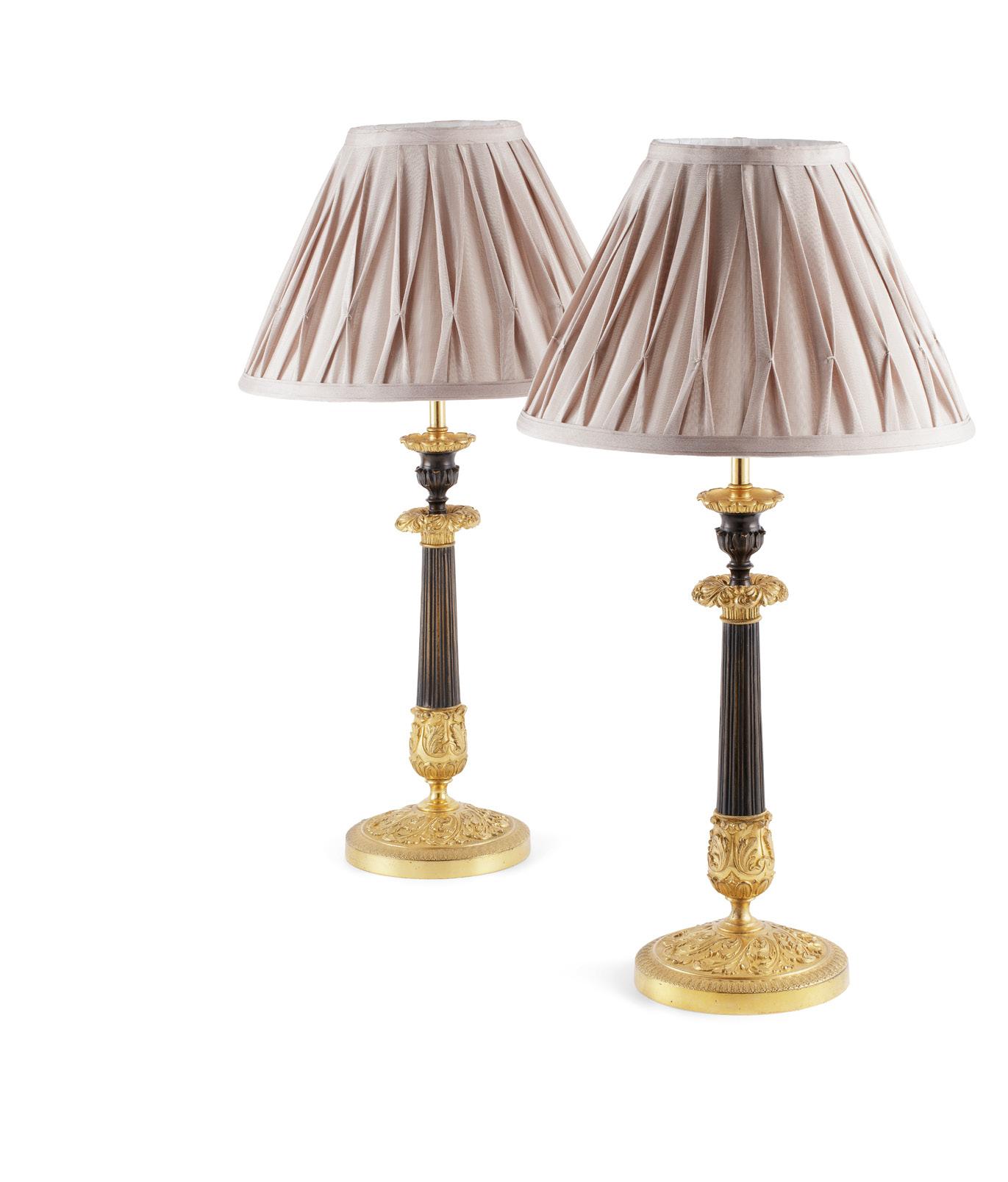
EARLY 19TH CENTURY
with urn-form candle sconces cast with palmettes, above tapered reeded columns, terminating in acanthus cast bases, with taupe pinch-pleated shades (2)
14cm in diameter, 42cm high £1,000-1,500
169
TROMPE L’OEIL PAINTED PINE BOX
19TH CENTURY, LATER DECORATION
painted to resemble a Georgian country house, with brass swing handle to the top 20cm wide, 23cm high, 17cm deep £300-400
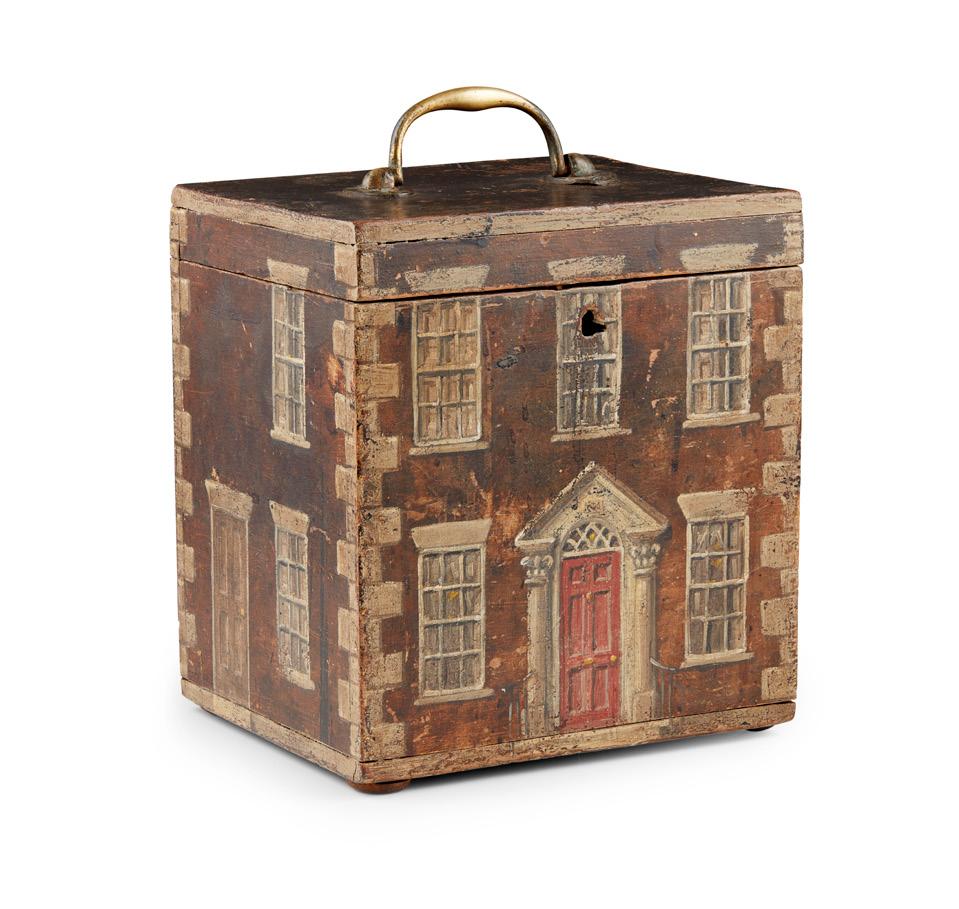
170
VICTORIAN NOVELTY PAINTED TROMPE L’OEIL TABLE CABINET
19TH CENTURY
painted to resemble a crenulated folly or turret, with five graduated drawers 27cm wide, 42cm high, 27cm deep £1,000-1,500

171
REGENCY MAHOGANY BOOK PRESS

EARLY 19TH CENTURY
the boxwood strung frame with a screw platform and turning handle, the rectangular base on bracket feet
41cm wide, 58cm high, 27cm deep £800-1,200
65 Other fees apply in addition to the hammer price: see the ‘Buyer’s Guide’ section on page 2
SCOTTISH REGENCY MAHOGANY COASTER, BY JAMES MEIN, KELSO
EARLY 19TH CENTURY
of plain circular turned form, on three leather and brass castors, stamped ‘MEIN’ to base

23cm in diameter, 5cm high £250-350
173
PAIR OF REGENCY PATINATED AND GILT BRONZE CANDLESTICKS
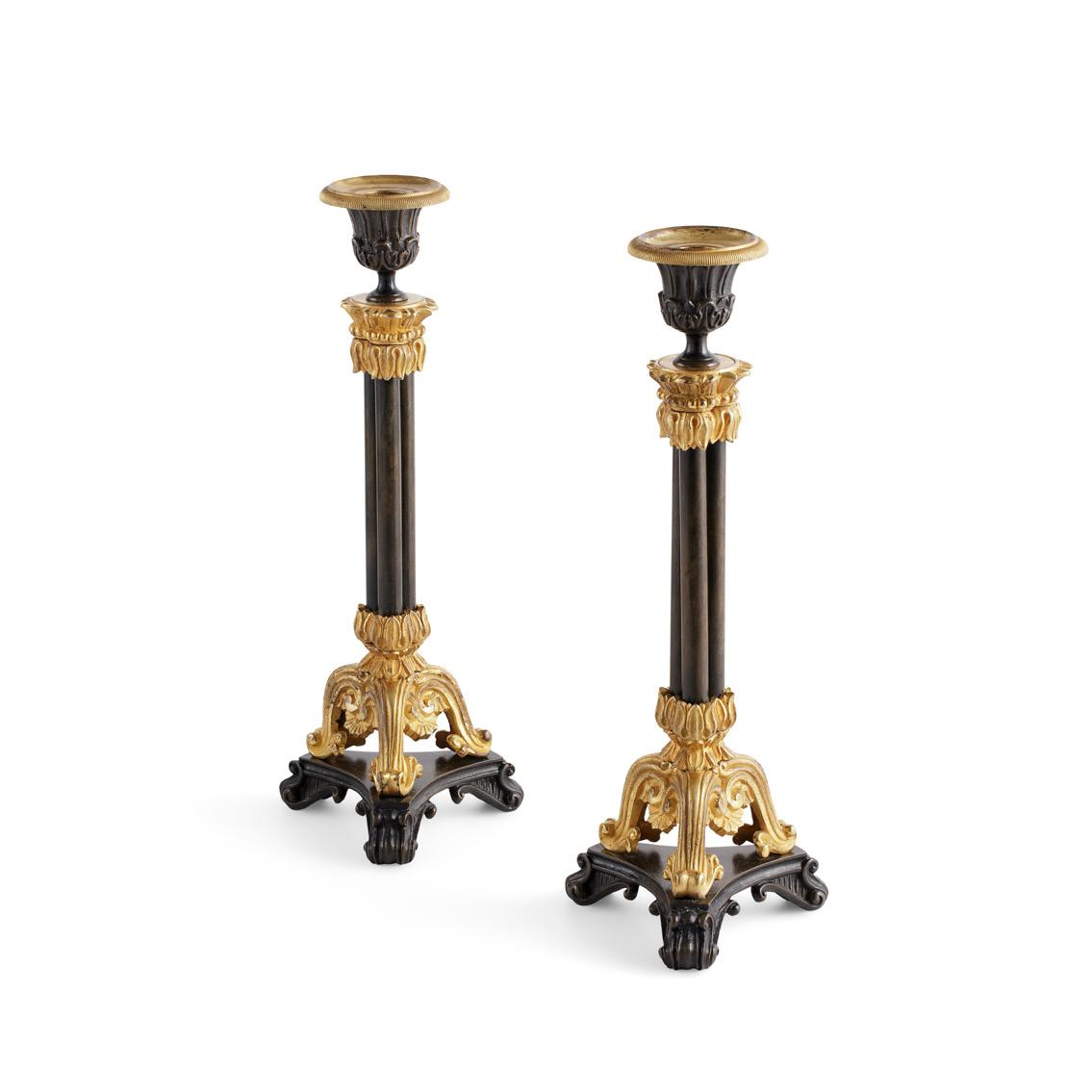
EARLY 19TH CENTURY
with cast foliate urn nozzles and reeded drip trays above trifid columns and downswept scrolling tripod legs on a plinth with bracket feet (2)
10cm diameter, 29cm high £600-800
174
REGENCY MAHOGANY BOTTLE POURER
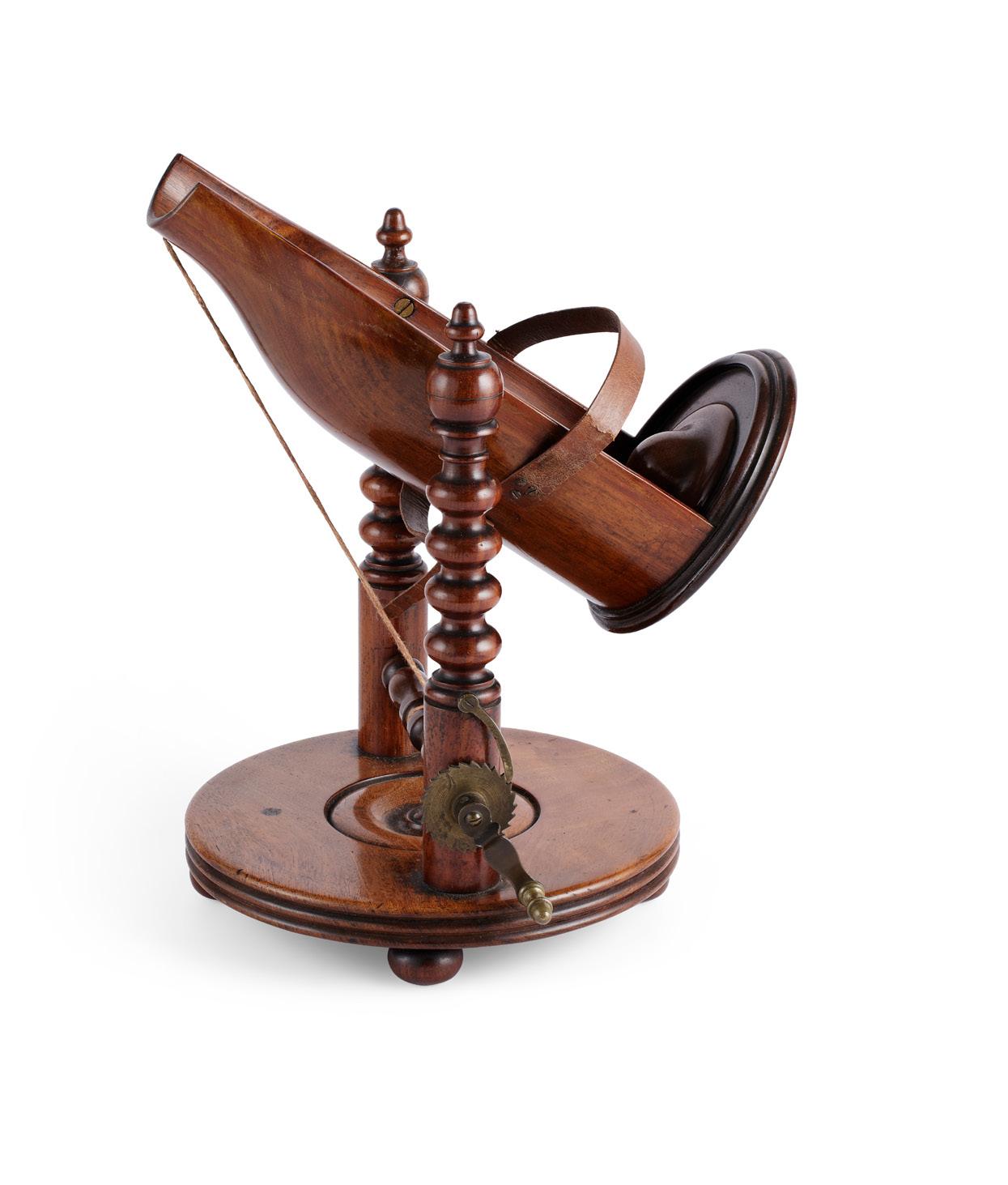
EARLY 19TH CENTURY
the cradle on turned supports with a brass pulley, on a turned circular base with bun feet 22cm wide, 34cm high, 20cm deep £800-1,200
175 Y
TWO REGENCY ROSEWOOD AND INLAY TEA CADDIES

EARLY 19TH CENTURY
of sarcophagus form, the first in rosewood with motherof-pear inlay and ring handles, opening to twin removeable caddies with hinged lids and a centre mixed bowl, on bun feet; the other with boxwood stringing, mahogany banding, and brass lion mask ring handles, with a similar interior (2)
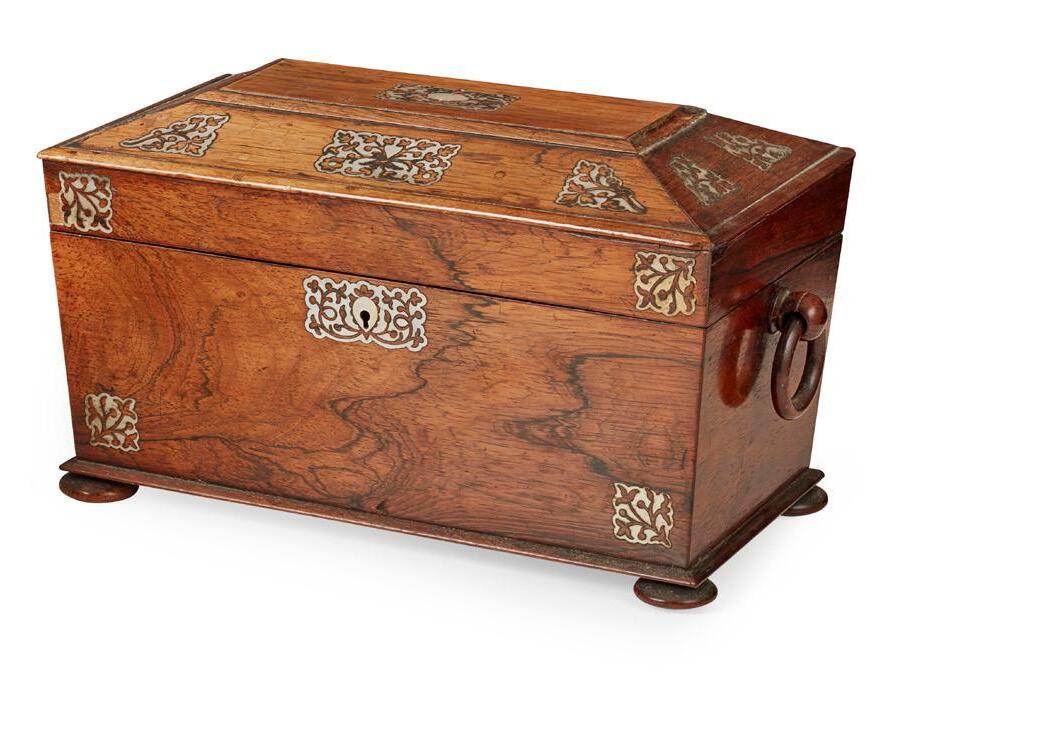
35cm wide, 19cm high, 17cm deep and 32cm wide, 18cm high, 16cm deep
Provenance: Private Scottish Collection, Morayshire
£300-500

172
66 Other fees apply in addition to the hammer price: see the ‘Buyer’s Guide’ section on page 2
176 Y
REGENCY ROSEWOOD CARD TABLE

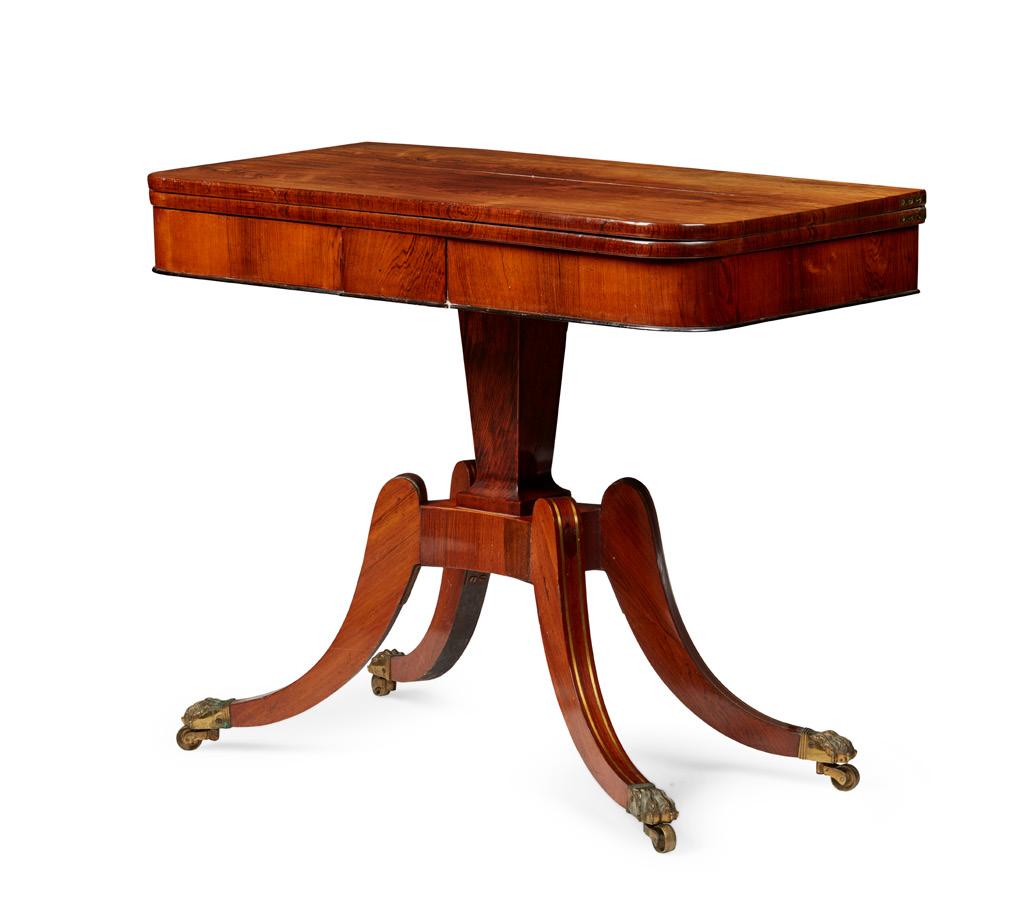
EARLY 19TH CENTURY
the rounded rectangular fold-over top opening to a green baize interior, on a tapered square column and brass inlaid outswept legs ending in brass hairy paw caps and castors
92cm wide, 46cm deep, 92cm deep (opened), 76cm high
Provenance: Private Scottish Collection, Morayshire
£400-600
REGENCY SIMULATED ROSEWOOD AND PARCEL-GILT SIDE CABINET

EARLY 19TH CENTURY
the rectangular top above a long frieze drawer and pair of arched cabinet doors with fabric inserts and decorated with gilt stringing and leaf motifs, flanked by columns, the interior with fixed shelves, raised on carved paw feet 107cm wide, 97cm high, 38cm deep
£800-1,200
178
REGENCY MAHOGANY AND EBONY SIDEBOARD, IN THE MANNER OF GILLOWS
EARLY 19TH CENTURY
the ebony banded top with a brass gallery rail above a long frieze drawer and arched recess deep drawer, flanked by a deep drawer and a cupboard, raised on reeded tapered legs
161cm wide, 131cm high, 63cm deep
£400-600
177 Y
67
179 Y
SCOTTISH REGENCY MAHOGANY AND ROSEWOOD TEA TABLE, ATTRIBUTED TO WILLIAM TROTTER

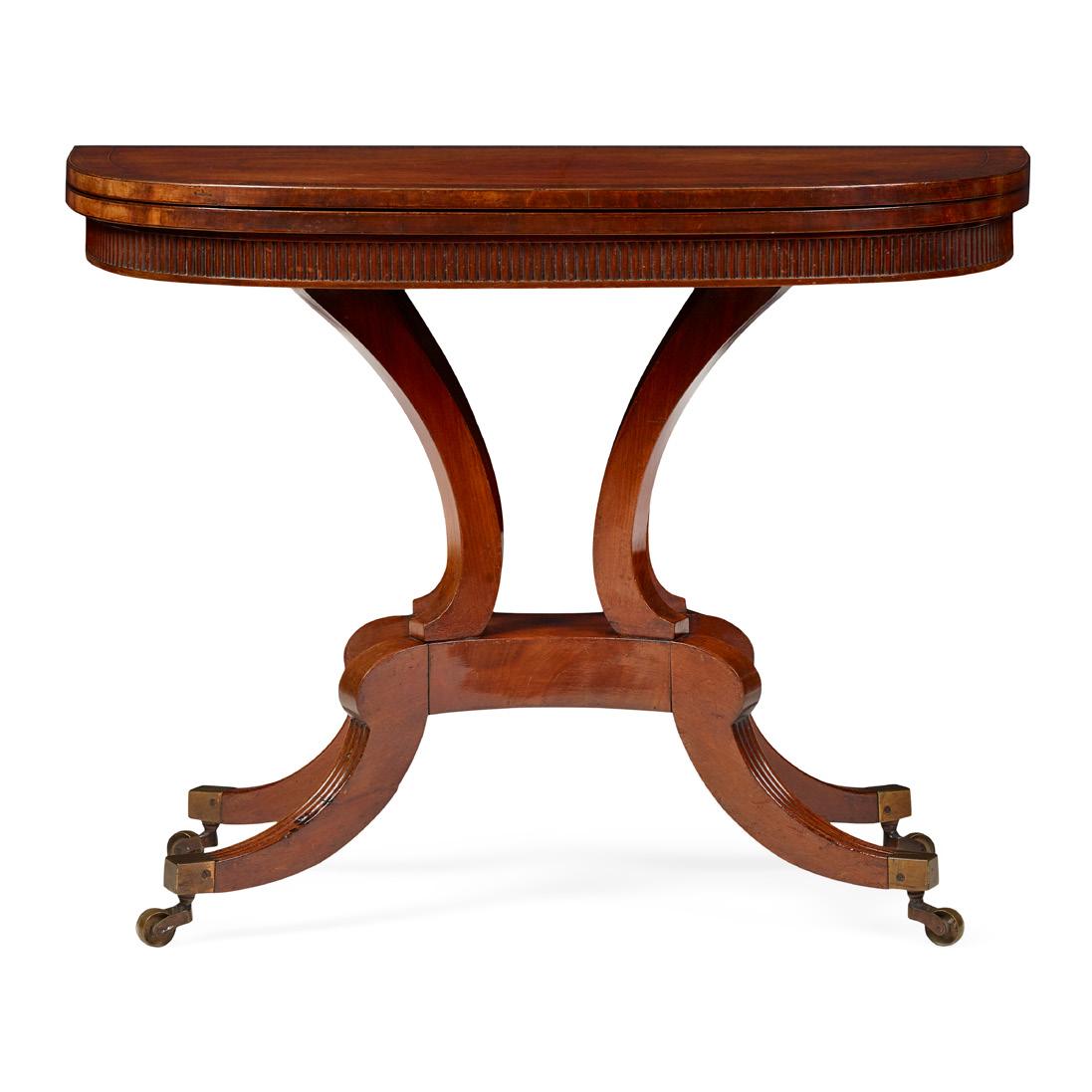
EARLY 19TH CENTURY
the crossbanded fold-over top with pivot action, above a reeded frieze, raised on four C scroll supports and platform base with hipped reeded sabre legs ending in brass caps and castors
96cm wide, 74cm high, 47.5cm deep [closed]
£2,000-3,000
180 Y
SCOTTISH REGENCY MAHOGANY AND ROSEWOOD CARD TABLE, ATTRIBUTED TO WILLIAM TROTTER


EARLY 19TH CENTURY
the crossbanded fold-over top opening to a green baize playing surface, raised on roundel mounted scrolled supports and a quadripartite platform with moulded sabre legs with further roundels ending in brass lobed caps and castors
91cm wide, 74cm high, 46cm deep [closed]
£2,000-3,000
181
GEORGE IV COROMANDEL AND MAHOGANY SIDE CABINET

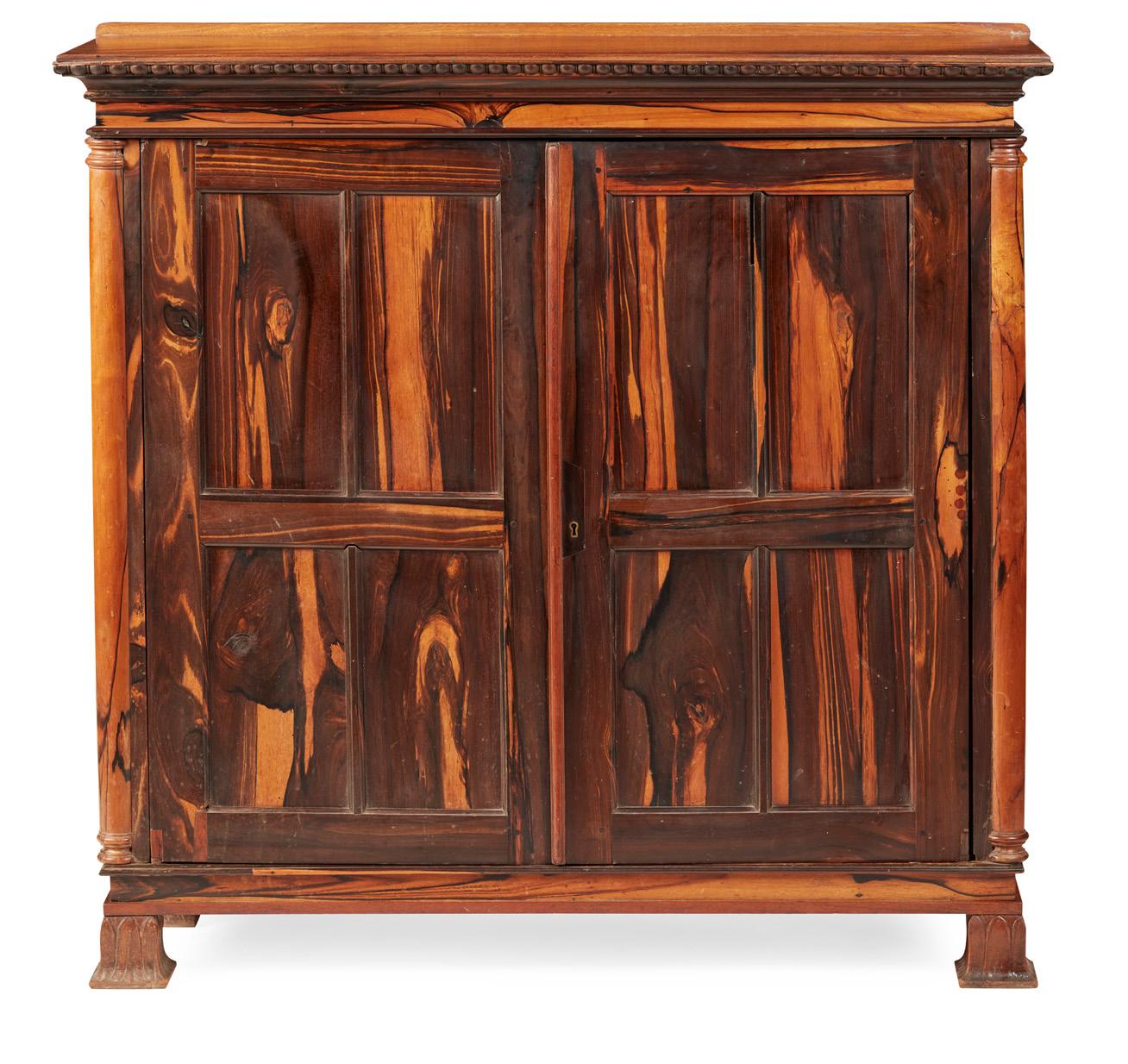
EARLY 19TH CENTURY
the top with a moulded edge above a beaded frieze, over a pair of recessed quarter-panel doors opening to shelves, flanked by turned columns to the corners, on a moulded base and raised on square carved lotus feet
113cm wide, 113cm high, 39cm deep
£1,500-2,500
68
182 SET OF TWELVE REGENCY MAHOGANY DINING CHAIRS

EARLY 19TH CENTURY
with palmette carved bar backs, above drop-in seats with pale green covers and raised on moulded sabre legs (12)
46cm wide, 86cm high, 45cm deep
£1,000-1,500
183
LARGE REGENCY STYLE MAHOGANY, COROMANDEL, AND EBONISED CENTRE DINING TABLE
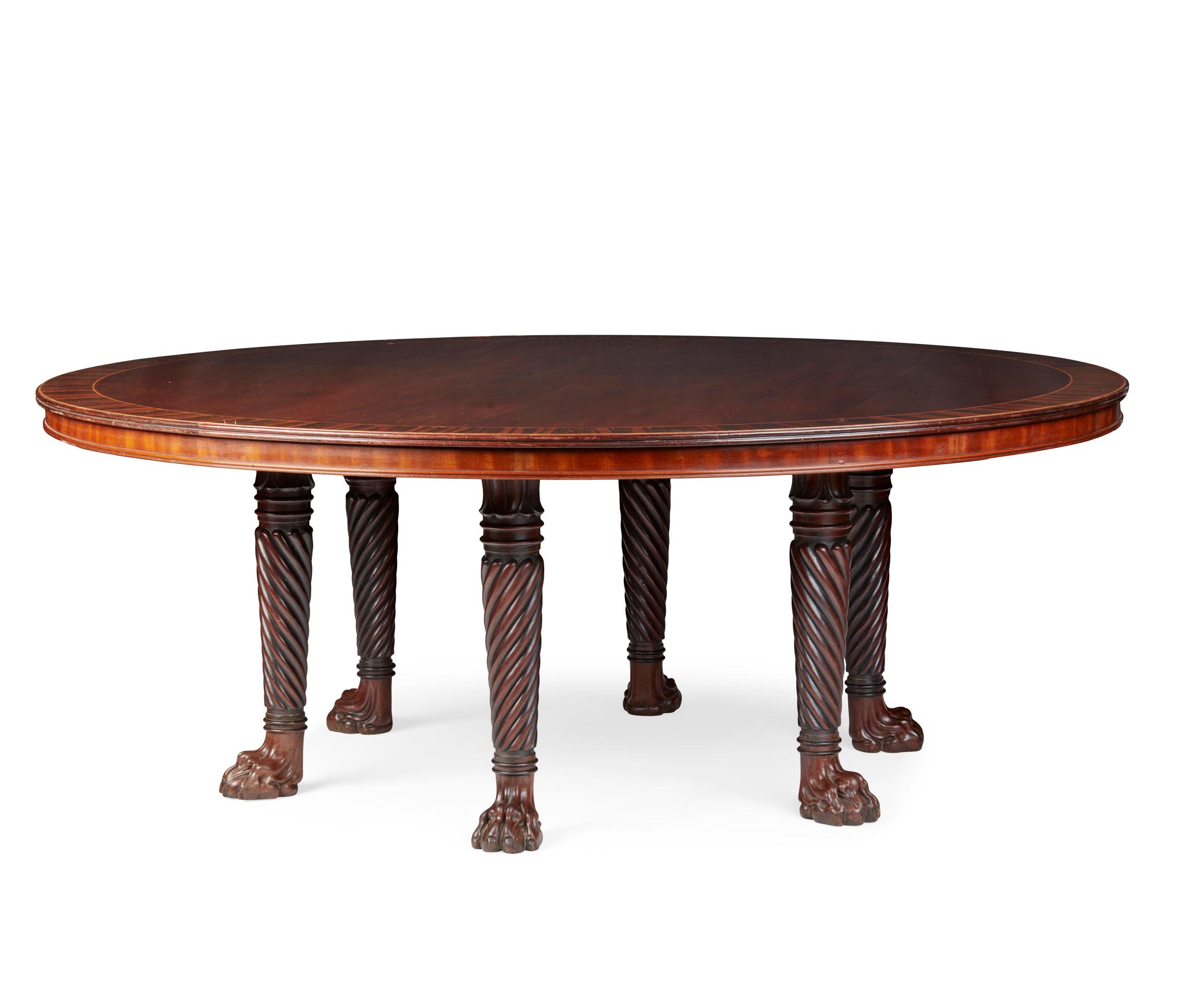
LATE 20TH CENTURY
the circular crossbanded top with a moulded edge, on six lotus and spiral carved legs ending hairy paw feet
198cm diameter, 74cm high
£3,000-5,000
69 Other fees apply in addition to the hammer price: see the ‘Buyer’s Guide’ section on page 2
184
REGENCY MAHOGANY WORK TABLE
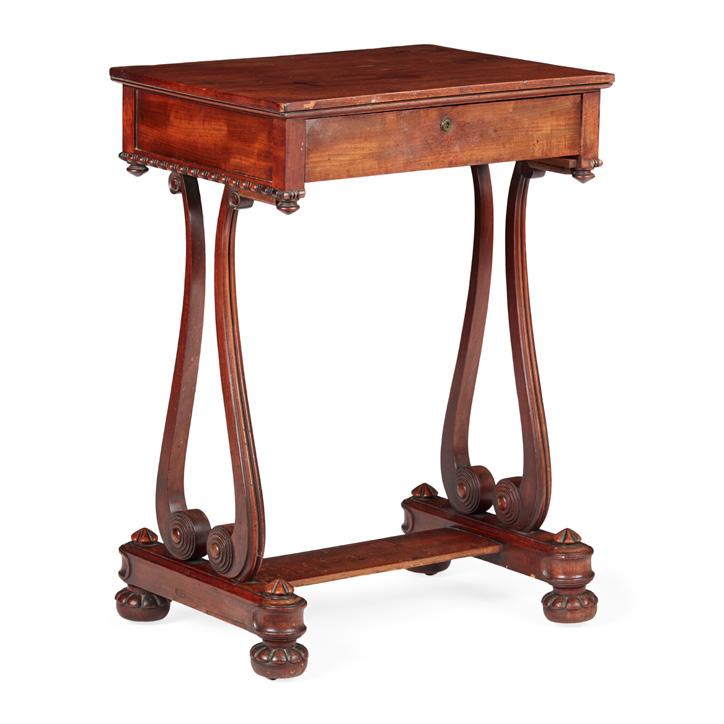
EARLY 19TH CENTURY
the rectangular top above a bead and reel moulded frieze with a long drawer, raised on scrolled lyre form end supports on trestle bases with lobed bun feet with brass castors and united by a stretcher panel, the drawer bearing a paper trade label DARTNALL/ MAKER/ CHELTENHAM
50cm wide, 72cm high, 40cm deep
Note: There was a William Dartnall, ‘Cabinet maker and Upholder’ recorded in Cheltenham in 1839 £800-1,200
185 Y
REGENCY ROSEWOOD, MAHOGANY AND GILT BRONZE
MOUNTED WRITING TABLE

EARLY 19TH CENTURY
the three-section blue leather-lined top with a central ratchet adjusted slope flanked by hinged side panels opening to voids, above a frieze with dummy crossbanded drawers outlined with stringing, raised on tapered end supports and scrolled trestle bases united by a turned stretcher, with brass castors
91cm wide, 70cm high, 53cm deep
£800-1,200
186
REGENCY MAHOGANY BOOKSTAND WHATNOT
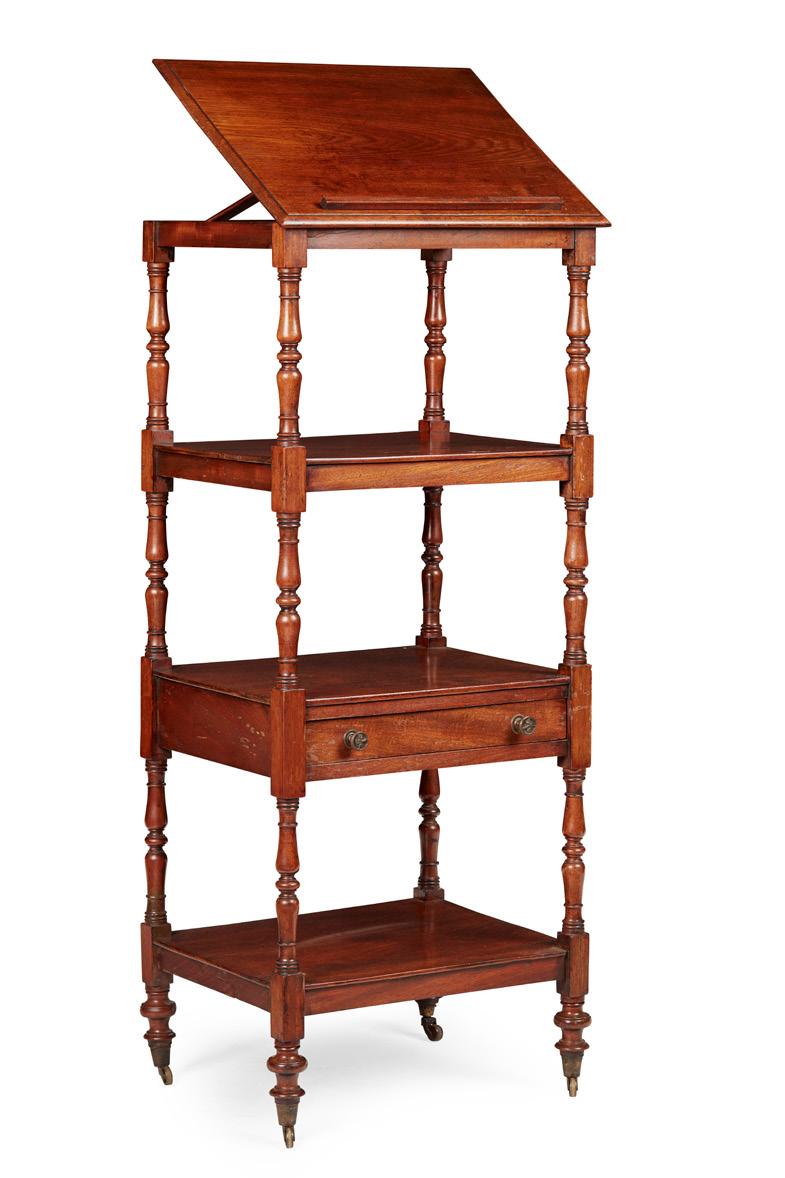
EARLY 19TH CENTURY
the hinged top with a ratchet adjusted slope over three further tiers, one fitted with a drawer, raised and divided by baluster turned supports and ending on brass caps and castors
54cm wide, 127cm high, 43cm deep
£400-600
187
SCOTTISH REGENCY MAHOGANY BOOKCASE CABINET

EARLY 19TH CENTURY
the moulded cornice above a pair of glazed doors with rectilinear mouldings, enclosing adjustable shelves; the base with a pair of recessed panel doors opening to five sliding trays, flanked by outset spiral and reeded columns and raised on lobed feet
127cm wide, 220cm high, 66cm deep
£1,000-1,500
70
188
LARGE REGENCY GILTWOOD AND GESSO OVERMANTEL MIRROR
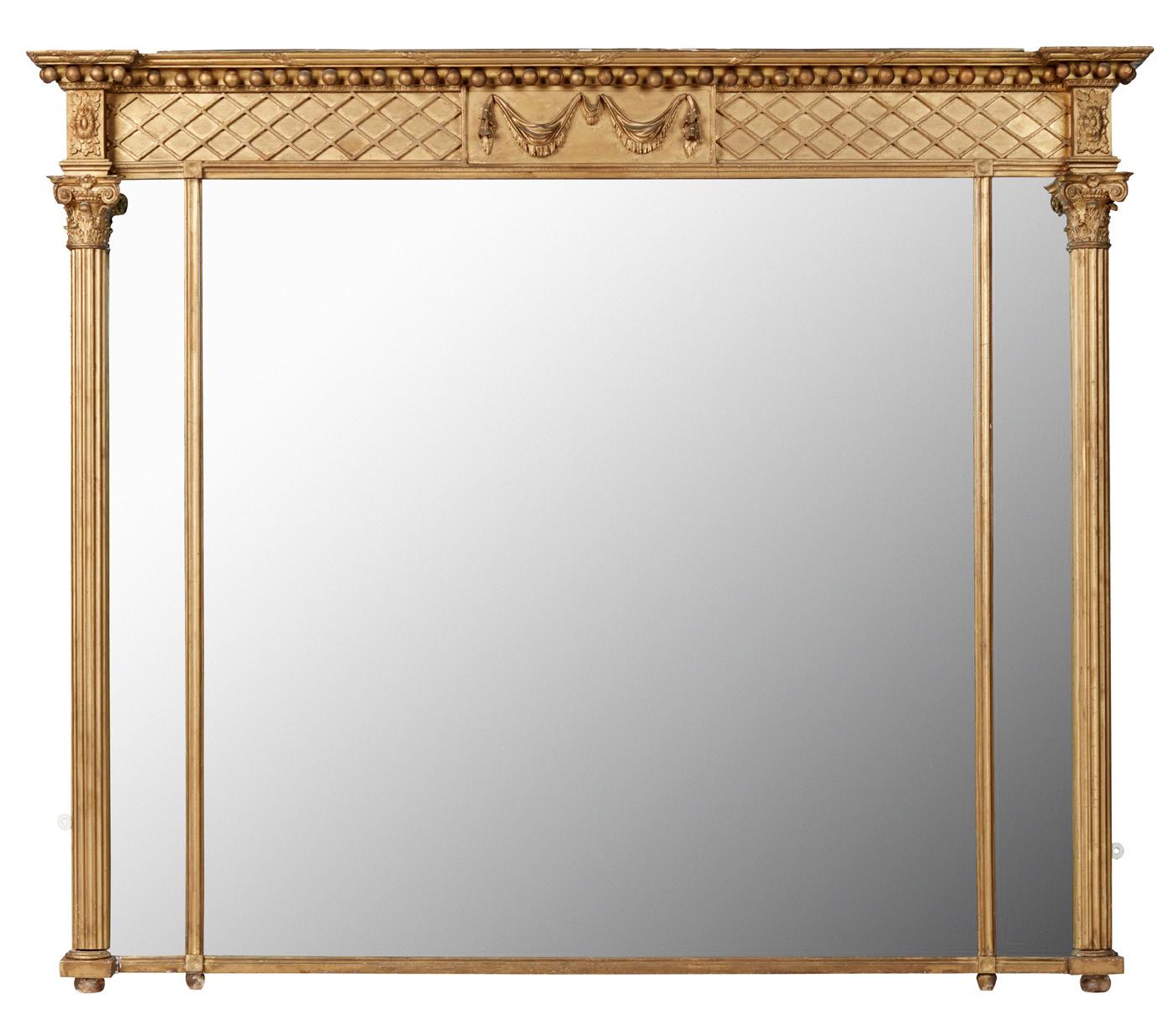
EARLY 19TH CENTURY
the inverted breakfront cornice with ball mounts above a trellis filled frieze centred by drapery swags, above a square mirror plate flanked by margin plates and fluted columns with acanthus capitals
163cm high, 136cm wide £600-800
189
SCOTTISH REGENCY MAHOGANY LONGCASE CLOCK, BY JAMES WHITELAW, EDINBURGH

EARLY 19TH CENTURY
the arched cornice above a circular silvered dial with a Roman number chapter and subsidiary seconds and calendar dials, signed ‘James Whitelaw/ Edinburgh’ above an arched trunk door flanked by reeded quarter columns, on a moulded plinth raised on bracket feet; the eight-day, twin chain movement striking a bell 211cm high, 46cm wide
Note: James Whitelaw came from a large and very skilled clockmaking family who appear to have specialised in longcase clocks. He worked from both Princes Street and Register Street and died in 1846 at the age of 70.
£1,000-1,500
190
PAIR OF REGENCY STYLE MAHOGANY BERGÈRES
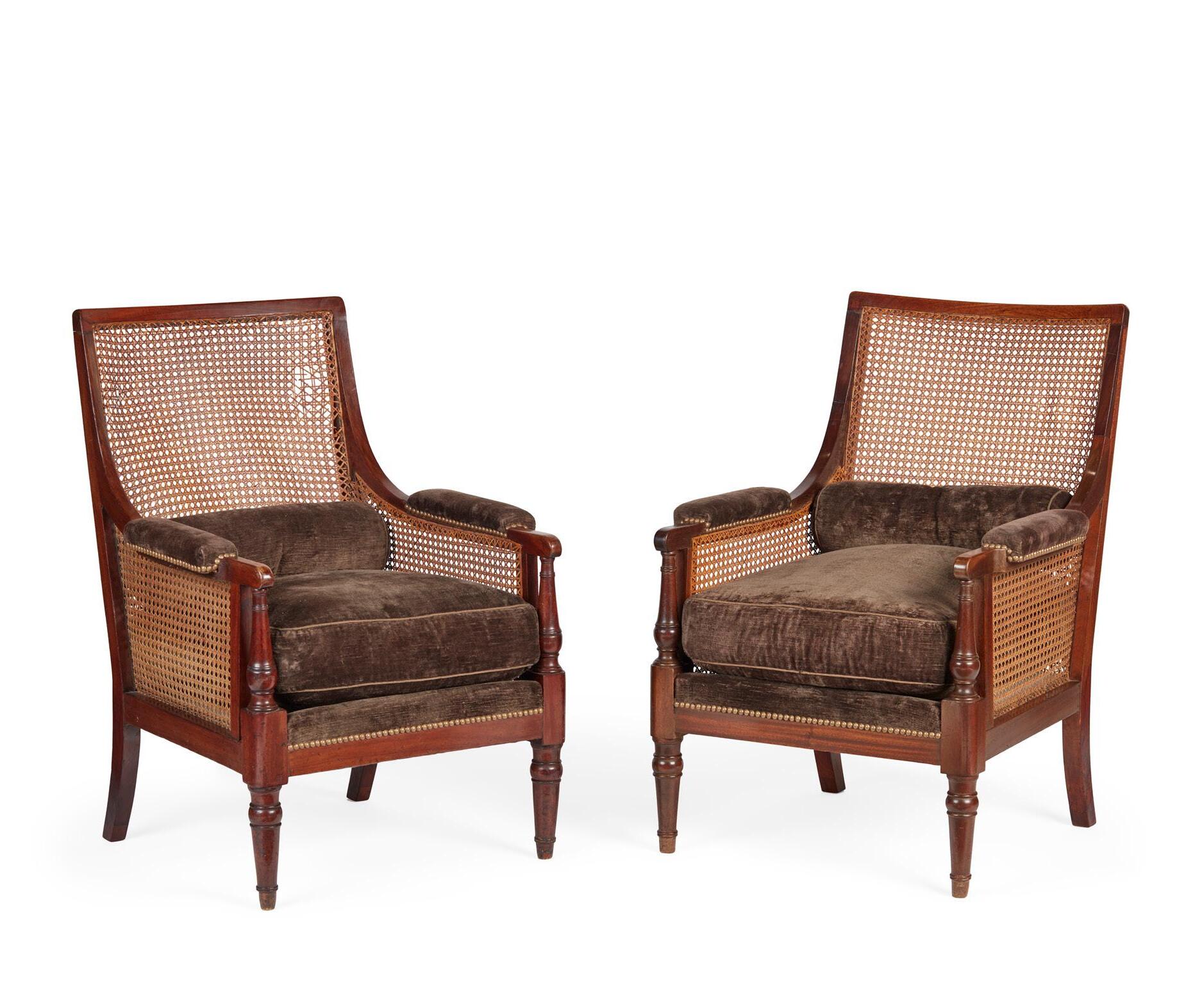
EARLY 20TH CENTURY
the caned square curved backs above enclosed caned panel partpadded arms, the loose cushion seats covered in brown velvet with matching bolster, raised on turned and tapered legs (2) 66cm wide, 91cm high, 55cm deep £1,000-1,500
71 Other fees apply in addition to the hammer price: see the ‘Buyer’s Guide’ section on page 2
191
SET OF SIX IRISH REGENCY DINING CHAIRS

EARLY 19TH CENTURY
with carved rope twist bar backs with a horizontal spar below, over drop-in pad seats with horsehair covers, raised on sabre legs (6) 45cm wide, 84cm high, 44cm deep £800-1,200
192
REGENCY MAHOGANY AND TULIPWOOD BREAKFAST TABLE

EARLY 19TH CENTURY
the rounded rectangular crossbanded and banded top on a plain baluster column and outswept tripod base with brass castors
135cm wide, 73cm high, 96cm deep £500-800
193 Y
LATE REGENCY ROSEWOOD CARD TABLE
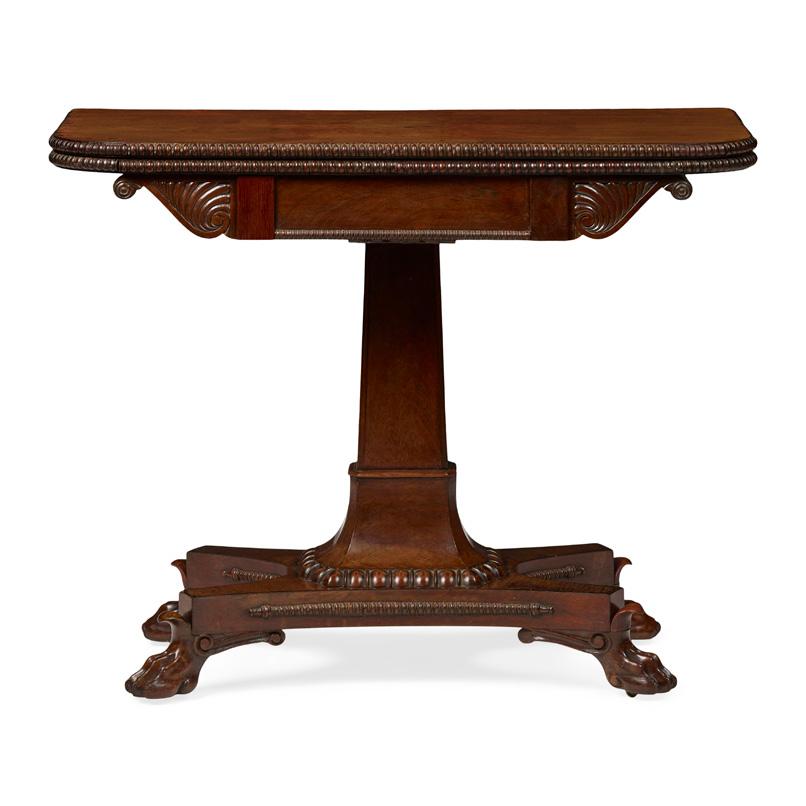
EARLY 19TH CENTURY
the fold-over pivot action top with a bead moulded edge, opening to a green baize playing surface, above a recess panel frieze flanked by palmette carved brackets, raised on a tapering faceted column and concave quadripartite base, on carved claw feet with brass castors
93cm wide, 75cm high, 46cm deep [closed] £1,000-1,500
194 Y
LATE REGENCY
ROSEWOOD AND GILT METAL MOUNTED SIDE CABINET
EARLY 19TH CENTURY
of breakfront outline, with a central pair of doors with brass grille inserts backed with floral needlework panels, flanked by gilt bronze mounted Egyptian terms and open shelved compartments, on a plinth base
156cm wide, 97cm high, 42cm deep £1,000-1,500
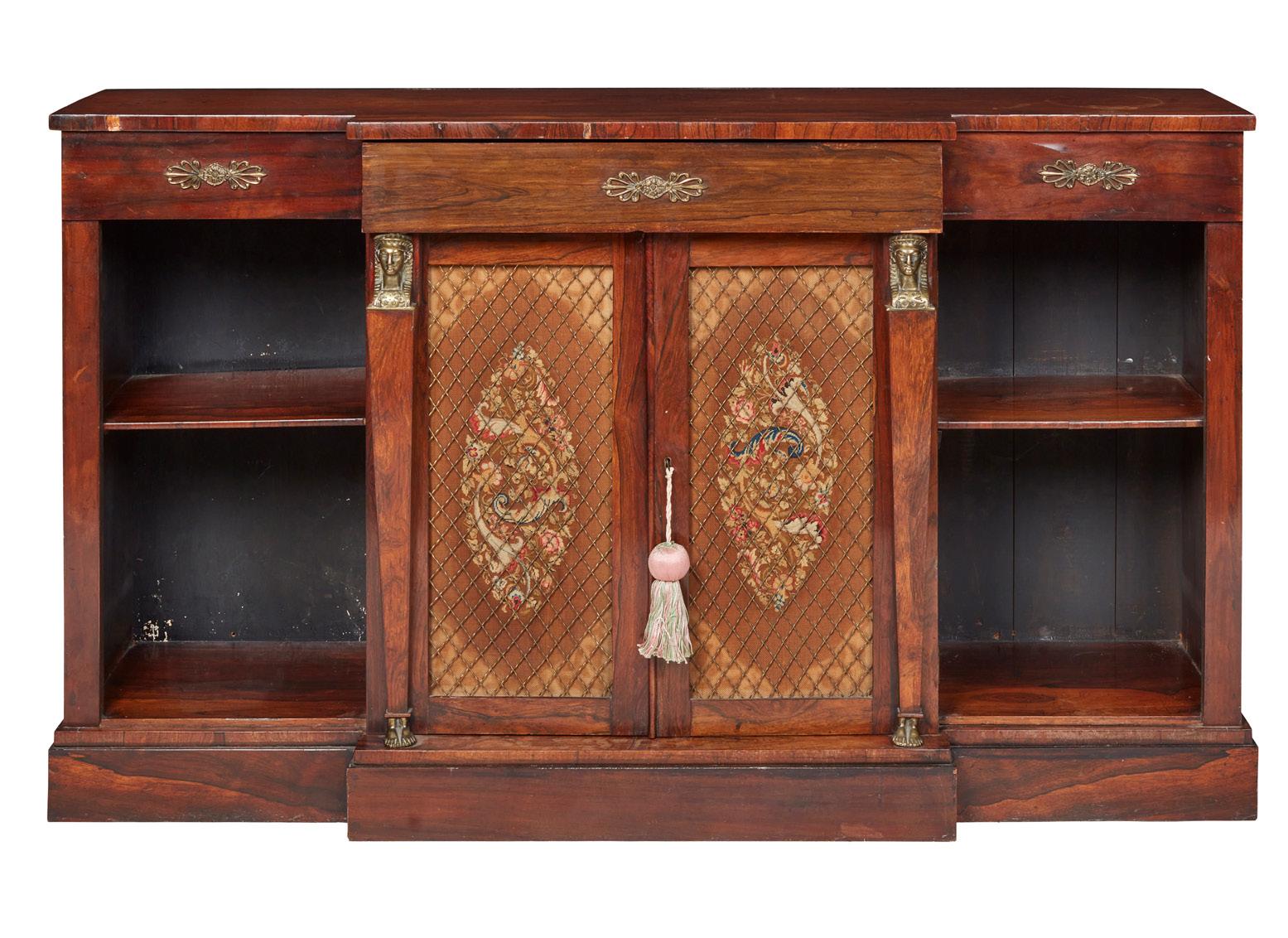
72 Other fees apply in addition to the hammer price: see the ‘Buyer’s Guide’ section on page 2
REGENCY GILTWOOD AND GESSO PIER MIRROR
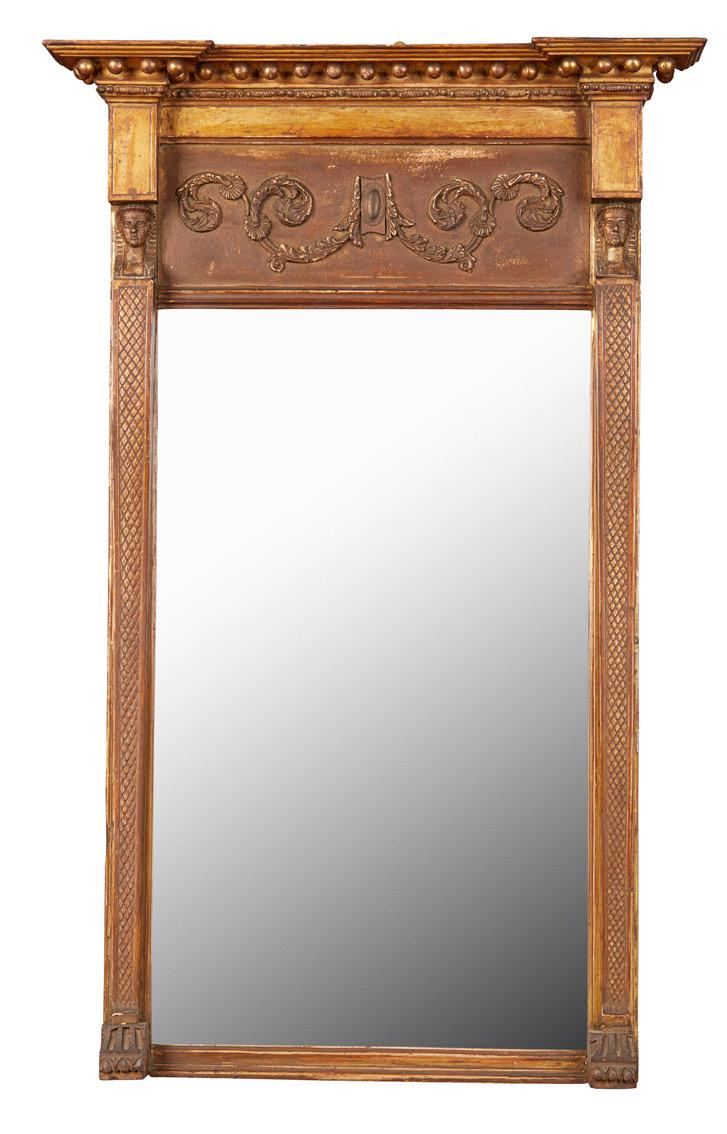
EARLY 19TH CENTURY
the inverted breakfront ball moulded cornice above a panel with scrolling moulding, over a rectangular mirror plate flanked by Egyptian pilasters
105cm high, 66cm wide
£300-500
196 Y
REGENCY MAHOGANY WORK TABLE
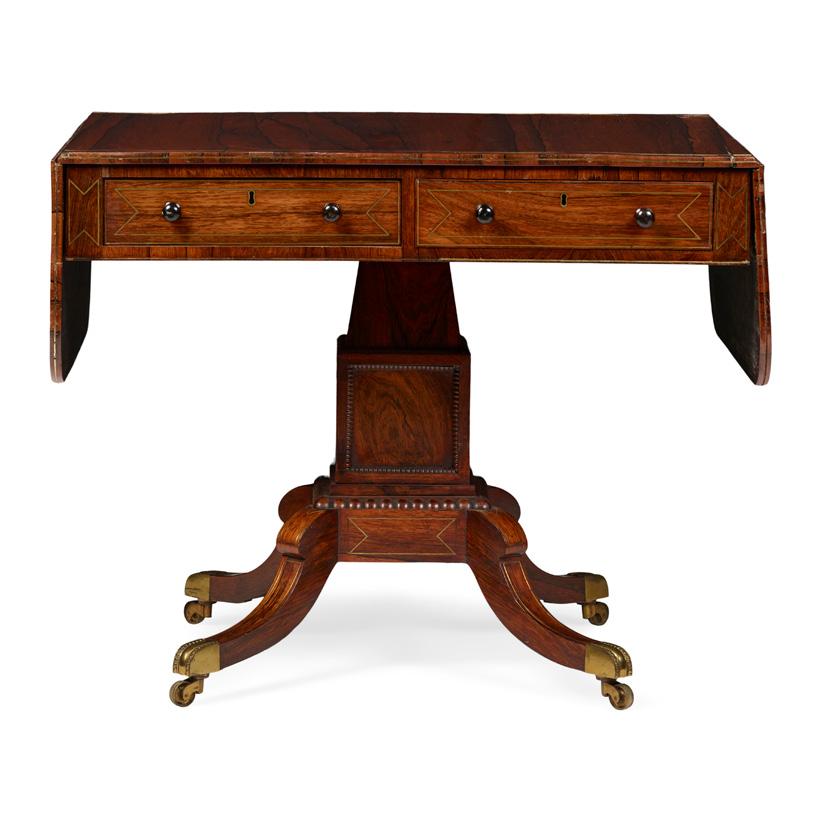
EARLY 19TH CENTURY
the rounded rectangular top with drop sides above three long drawers with ebonised handles, the reverse with dummy drawers, raised on a turned column and outswept legs terminating in carved paw legs with castors

84cm wide (flaps up), 38cm wide (flaps down), 73cm high, 61cm deep Provenance: Private Scottish Collection, Morayshire
£300-500
REGENCY ROSEWOOD BRASS INLAID SOFA TABLE, ATTRIBUTED TO WILLIAM TROTTER
EARLY 19TH CENTURY
the rounded rectangular top with drop down sides, above a pair of short frieze drawers, with dummy drawers opposing, on a square tapered column with bead moulded panels and a platform base raised on hipped sabre legs ending in cast brass caps and castors
92cm wide, 150cm [open], 75cm high, 71cm deep
£1,500-2,500
198 Y
REGENCY MAHOGANY
ROSEWOOD SIDE CABINET
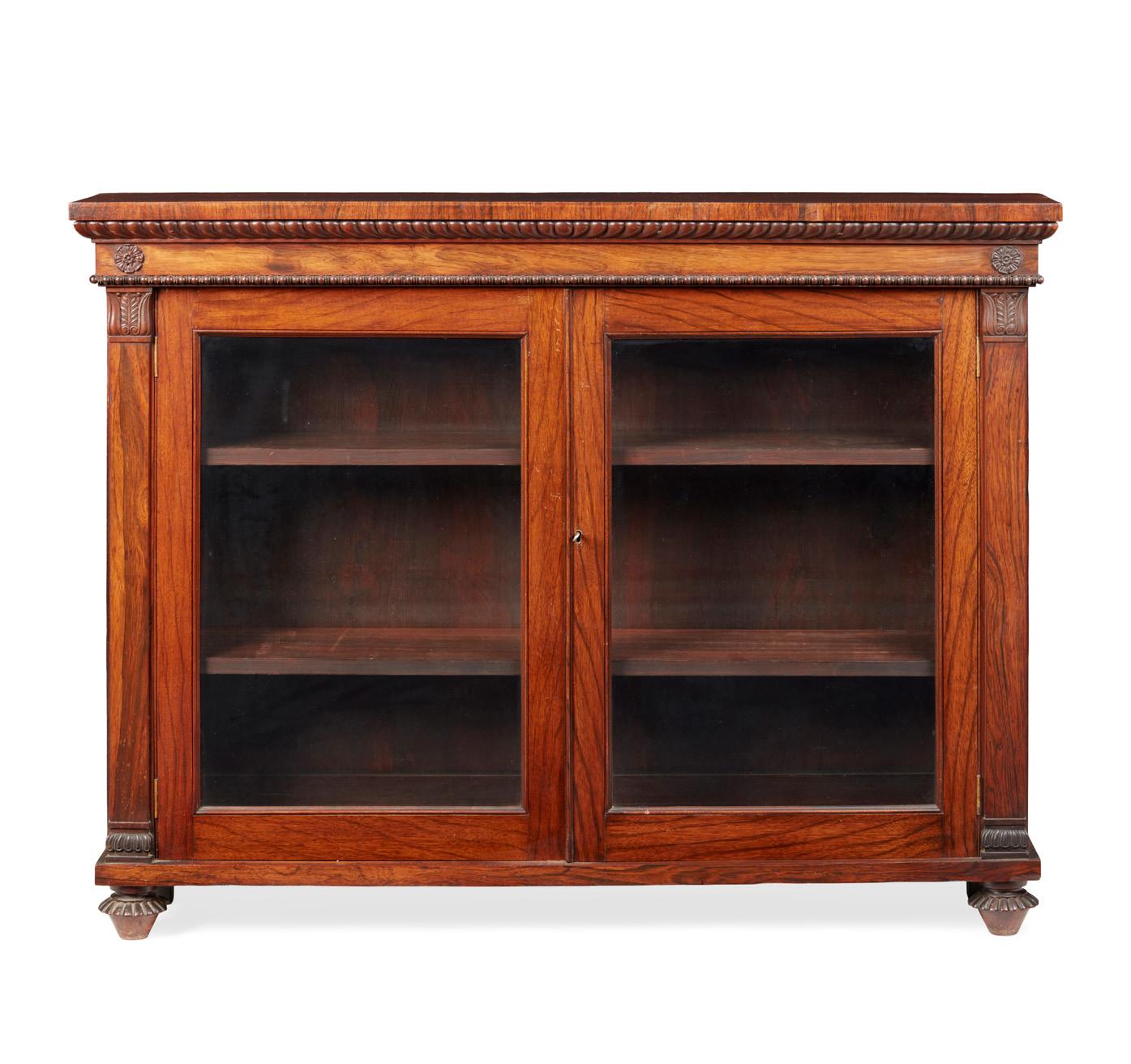
EARLY 19TH CENTURY
the top above a gadrooned and bead moulded frieze marked at the ends with flower heads, above a pair of glazed doors enclosing shelves and flanked by lotus capped pilasters, raised on lobed bun feet 128cnm wide, 97cm high, 27cm deep
£700-1,000
195
197 Y
73
199
MASON’S IRONSTONE PART DINNER SERVICE

EARLY 19TH CENTURY
with underglaze blue and overglaze ochre enamel decoration depicting a vase issuing flowers and foliage; comprising: twenty dinner plates, ten soup bowls, a meat drainer, five graduated ashets, a hexagonal twin handled soup tureen and cover, and three hexagonal low tureens and covers; impressed MASON’S PATENT IRON STONE CHINA, some with blue printed mark (qty) largest ashet 47cm long, plates 24cm diam, bowls 24cm diam, tureen 31cm high
£600-800
sides and three leaf inserts, opening on a concertina action and raised on ring-turned and tapered legs ending in brass caps and castors
344cm long [extended], 72cm high, 122cm deep
£700-900
201
LATE REGENCY MAHOGANY FOUR TIER WHATNOT
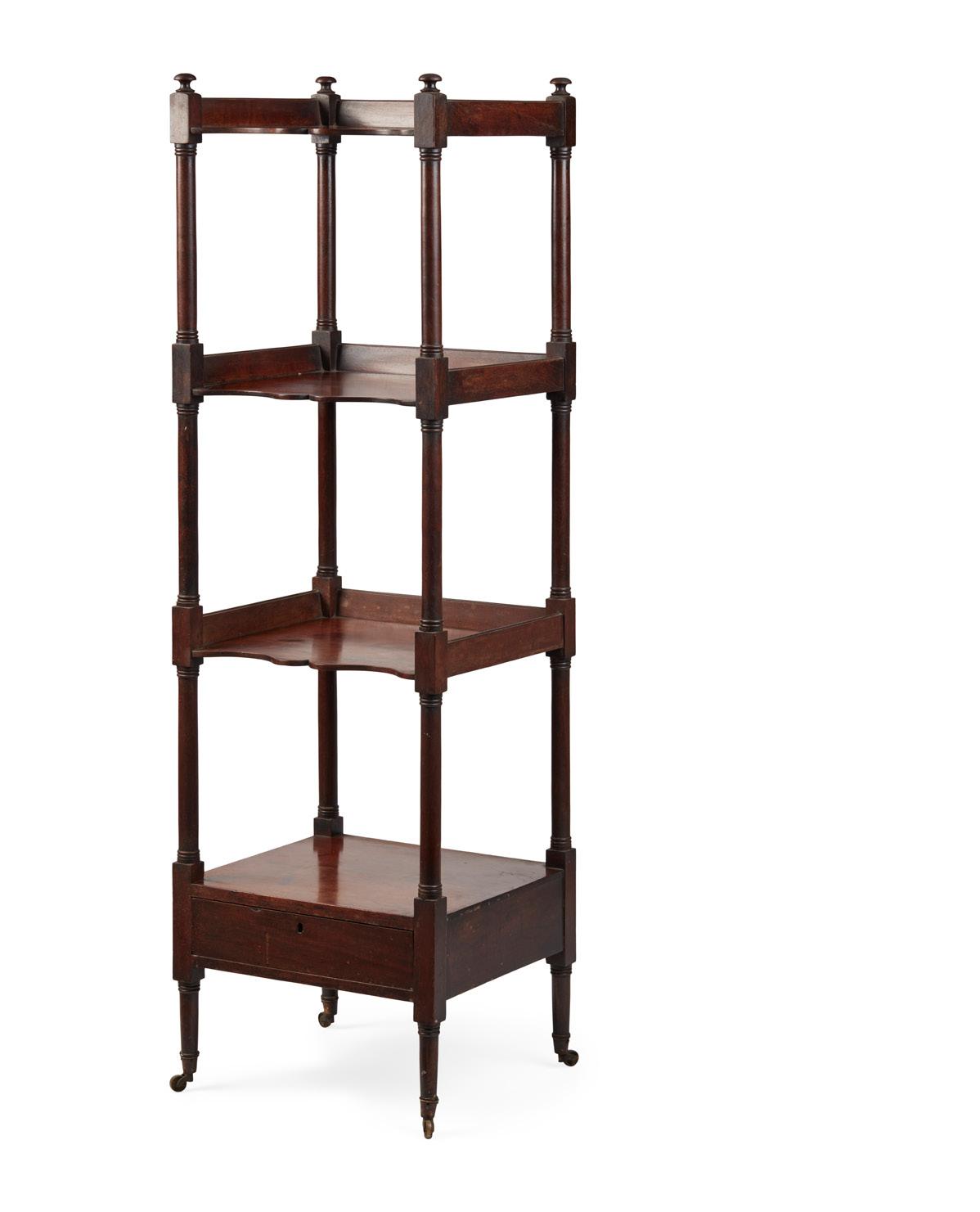
EARLY 19TH CENTURY
in two parts dividing at the mid-section; with three tiers with serpentine fronts above a base with a drawer, on tapered legs ending in brass caps and castors 46cm wide, 156cm high, 41cm deep
£300-500
202
REGENCY MAHOGANY AND SATINWOOD
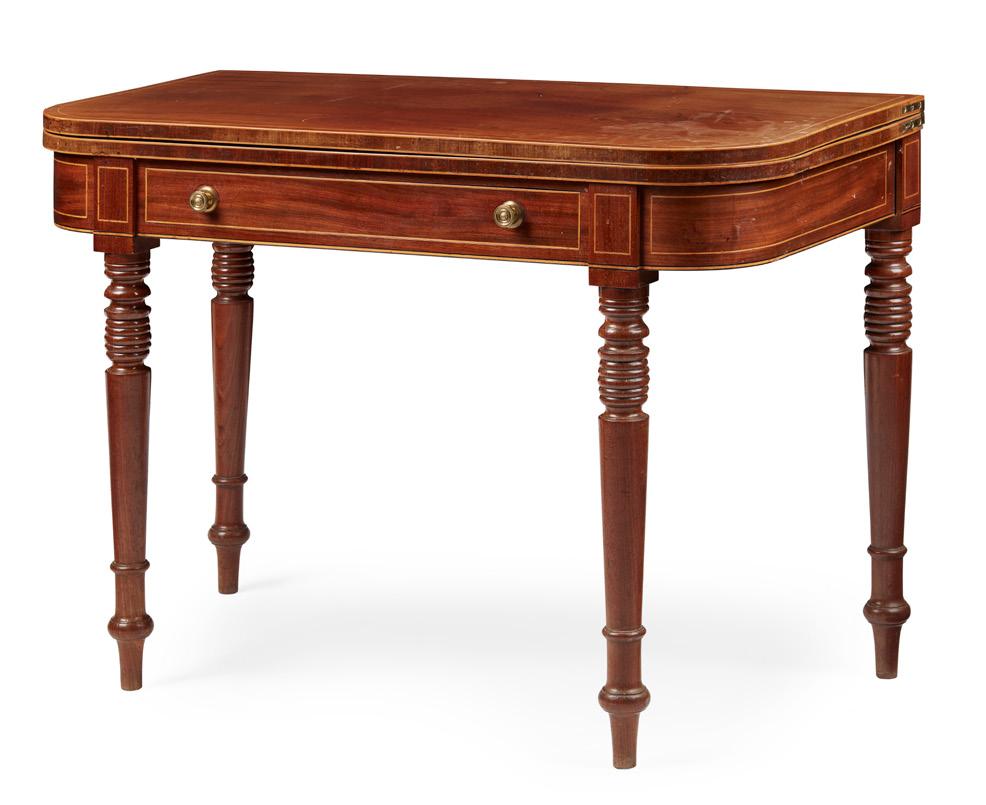
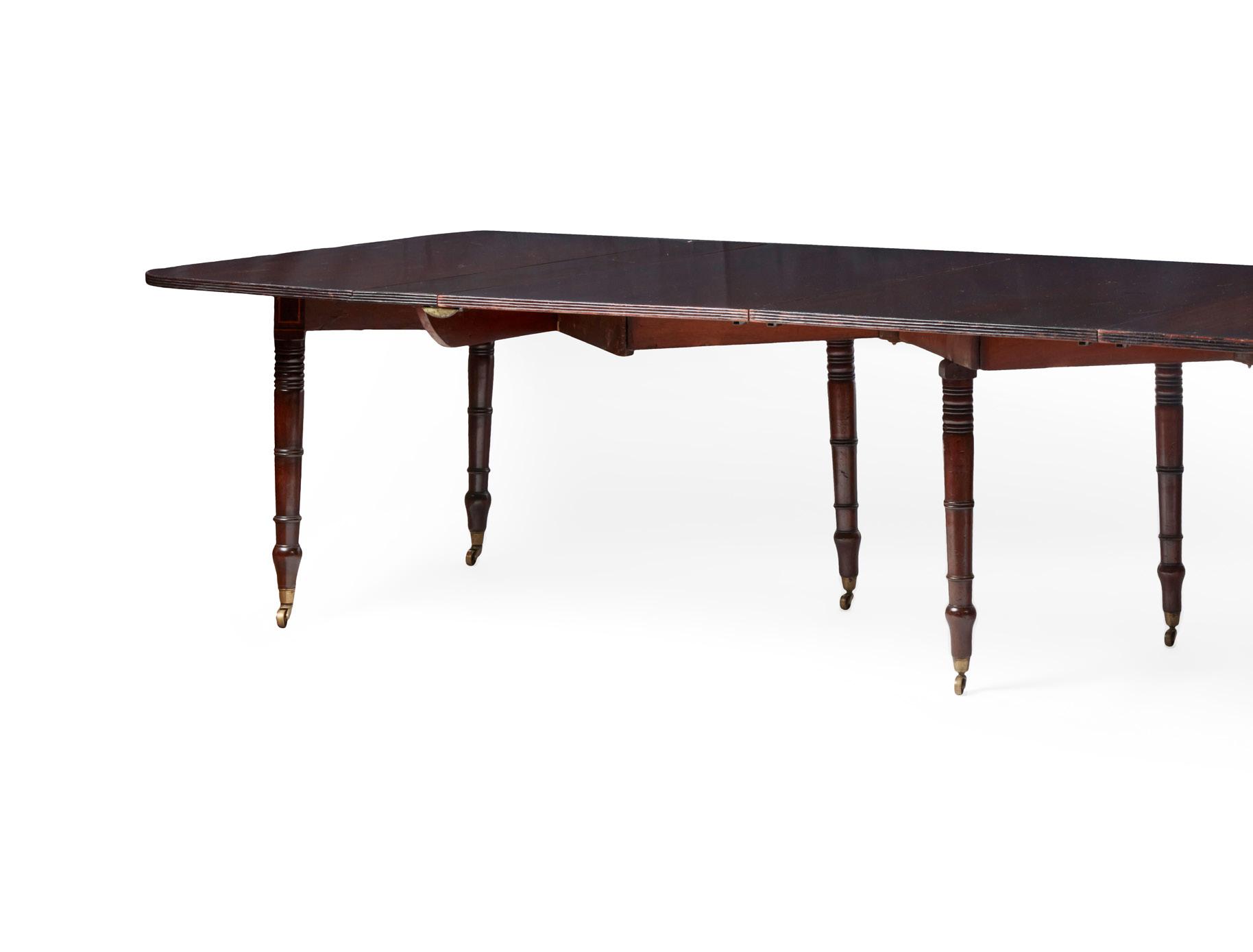
STRUNG TEA TABLE
EARLY 19TH CENTURY
the rounded rectangular foldover top opening on double gatelegs, above a plain frieze with a single long drawer, raised reeded tapered legs
102cm wide, 50cm deep, 100cm wide (opened), 74cm high
Provenance: Private Scottish Collection, Morayshire
£300-500
74
203
SET OF TEN REGENCY MAHOGANY DINING CHAIRS, PROBABLY GILLOWS
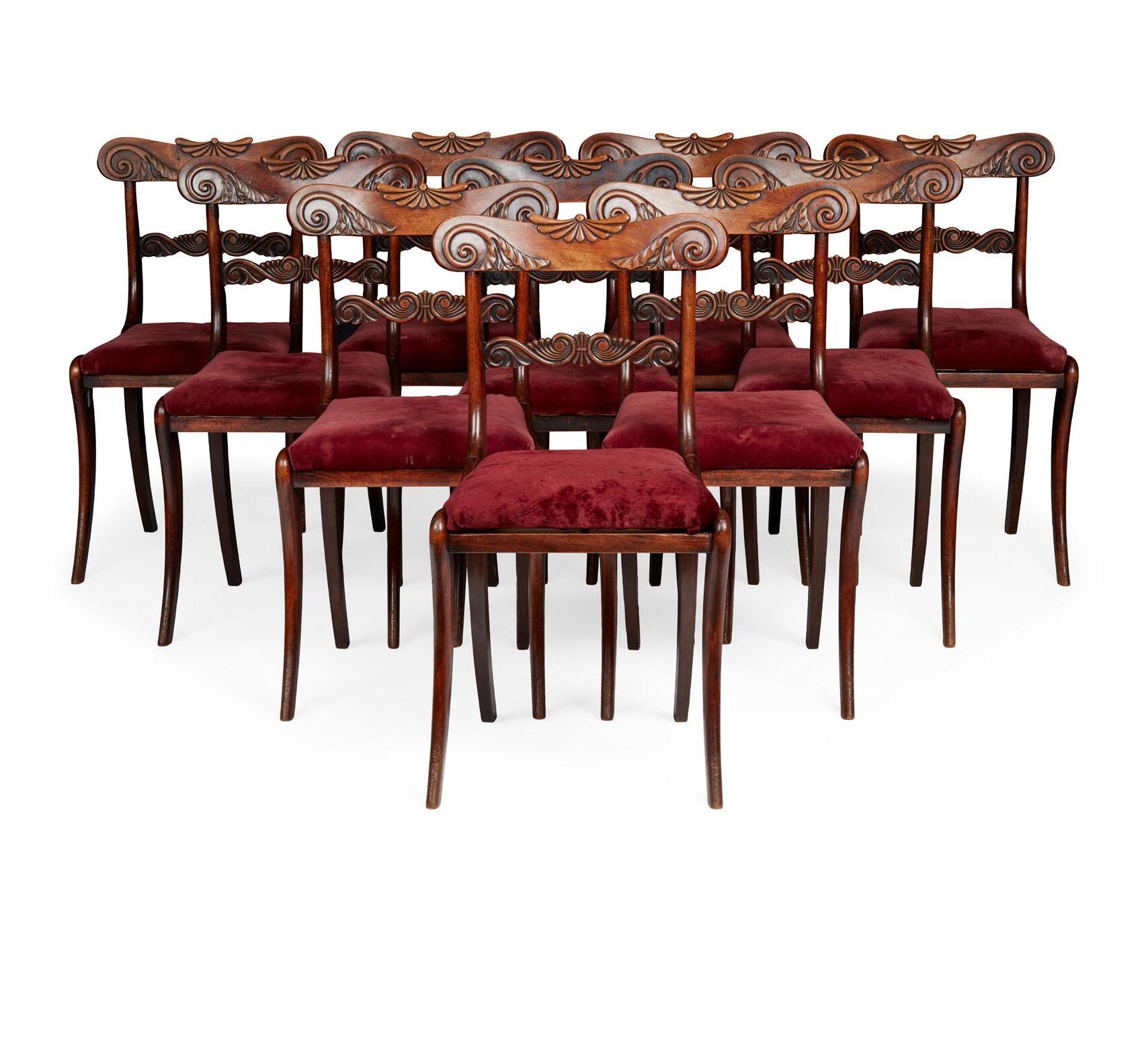
EARLY 19TH CENTURY
with foliate and scroll carved bar backs above scrolled spars, the red plush covered seat pads raised on sabre legs (10)
45cm wide, 86cm high, 41cm deep £2,000-3,000
204
LATE REGENCY MAHOGANY AND EBONY SIDEBOARD
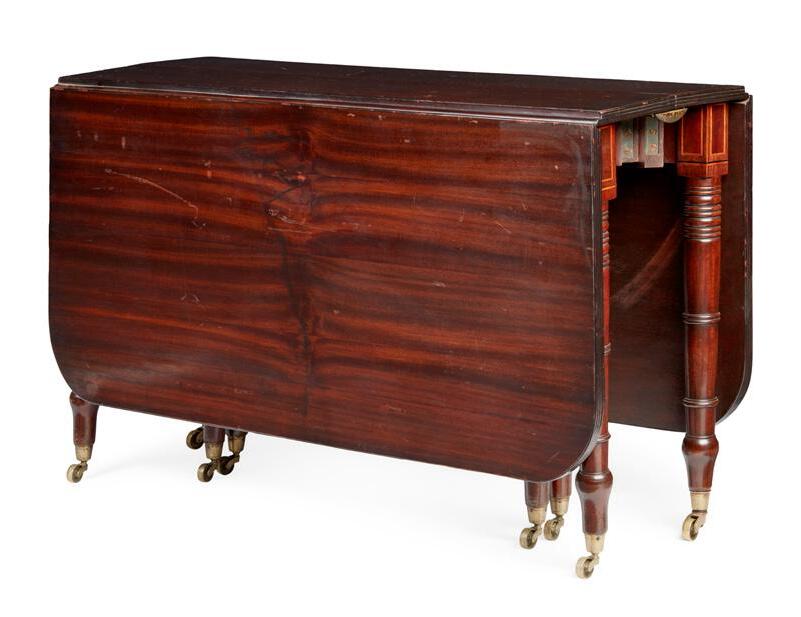
EARLY 19TH CENTURY of bowed breakfront outline, with a central frieze drawer and arched recess drawer flanked by a cellarette drawer and a cupboard, raised on tapered reeded legs with lobed collars
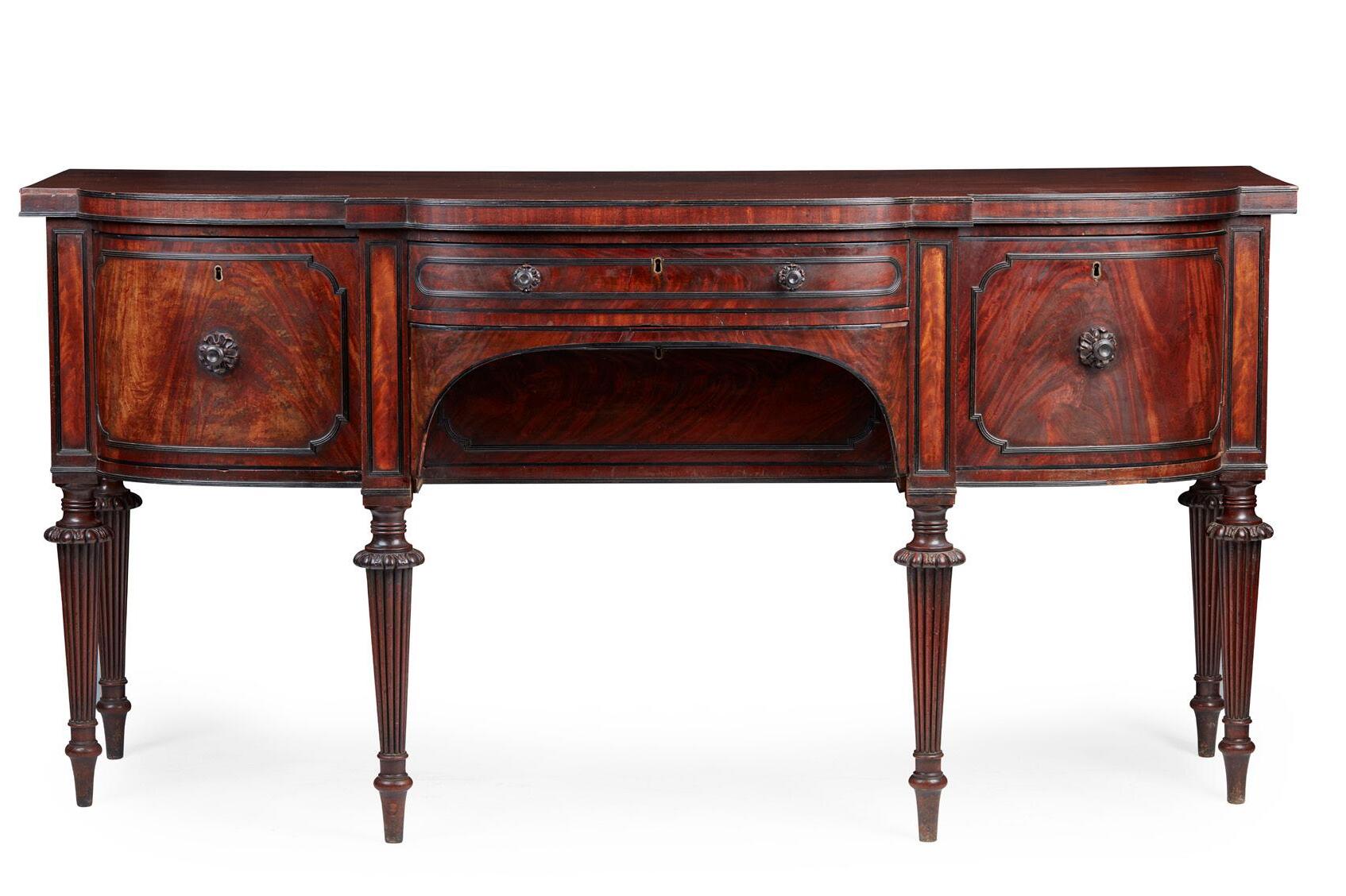
200cm wide, 100cm high, 83cm deep £700-1,000

75 Other fees apply in addition to the hammer price: see the ‘Buyer’s Guide’ section on page 2
REGENCY MAHOGANY DRUM LIBRARY TABLE
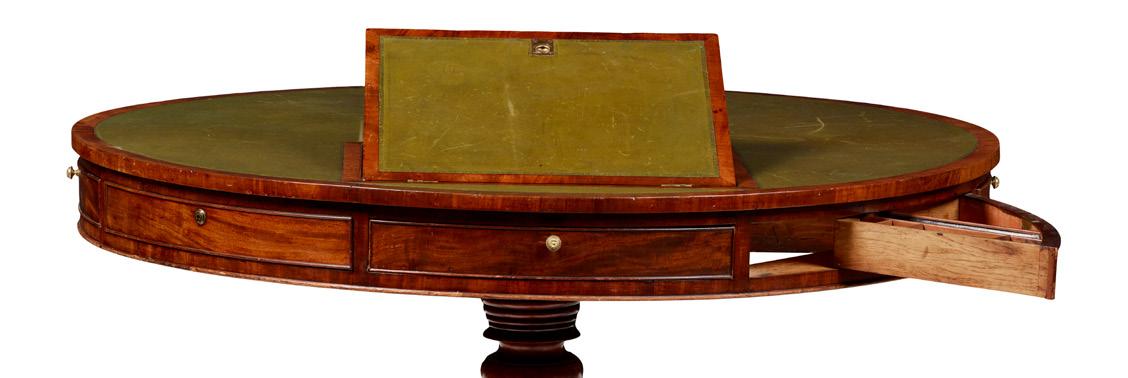
EARLY 19TH CENTURY
the circular top with a green leather insert and fitted with a ratchet adjusted slope, above a frieze with four real drawers, three dummy drawers, and a hinged pen drawer, raised on a ring-turned bulbous baluster column and four outswept legs ending in brass caps and castors
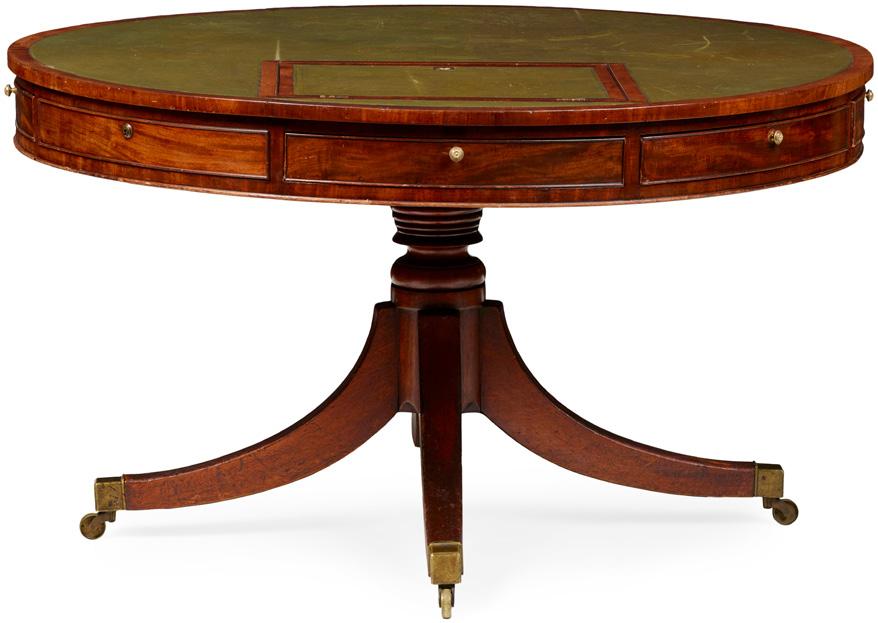
128cm diameter, 75cm high
£2,500-3,500
206
LATE REGENCY MAHOGANY AND EBONY BREAKFRONT BOOKCASE

EARLY 19TH CENTURY
the ball mounted cornice above a pair of lancet astragal glazed doors flanked by further glazed doors, all enclosing adjustable shelves, divided by diamond carved quarter columns marked with flower heads; the projecting base with four recessed panel short drawers over four panel cupboard doors flanked and divided by matching corner quarter columns, on a plinth base
294cm wide, 257cm high, 53cm deep
£3,000-5,000
205
76
207
IRISH REGENCY MAHOGANY BERGÈRE
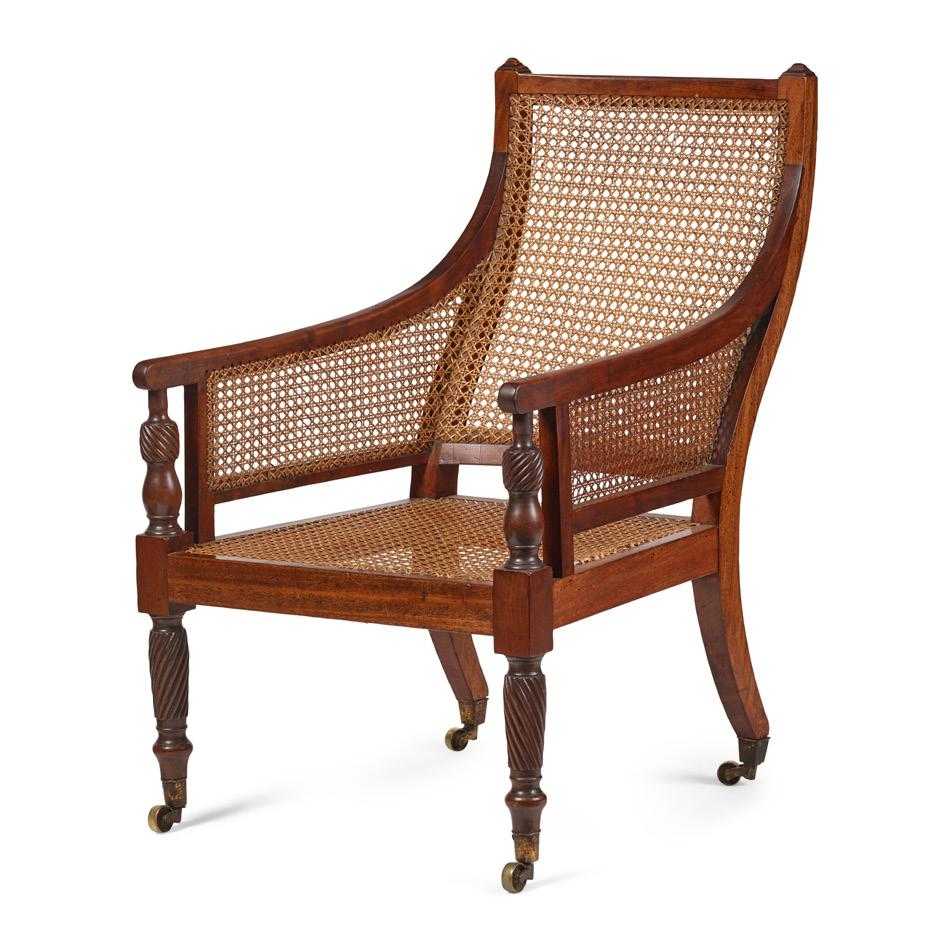
EARLY 19TH CENTURY
with caned back, seat and enclosed arms with spiral carved baluster supports, raised on spiral carved front legs ending in brass caps and castors, with button-upholstered cushions
63cm wide, 100cm high, 57cm deep
£800-1,200
208 Y
LATE REGENCY ROSEWOOD FOLIO STAND
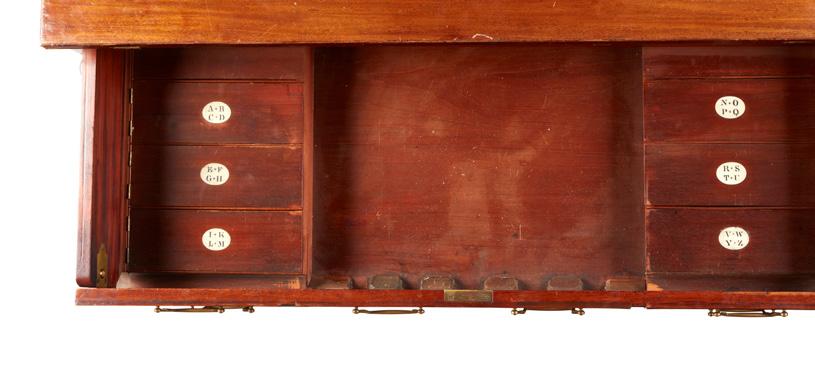
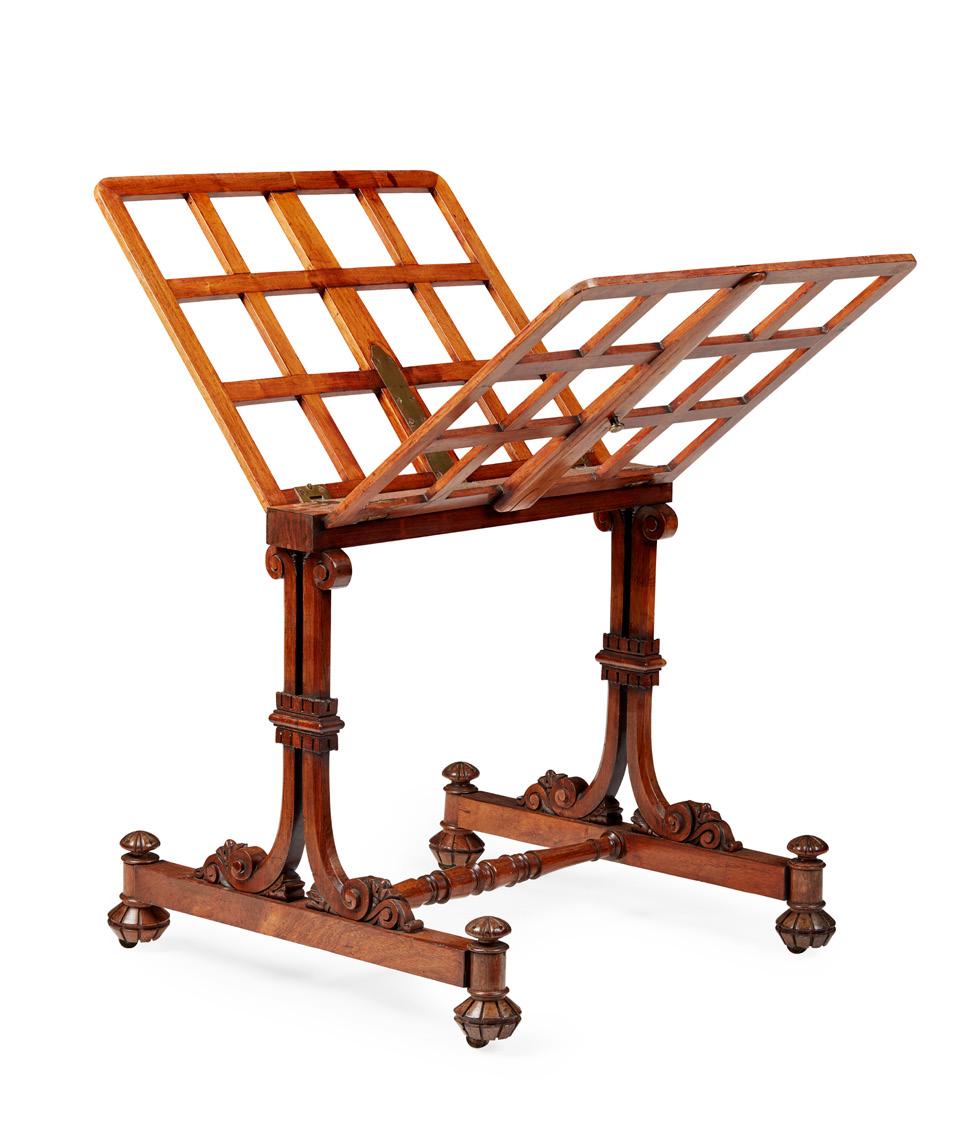
EARLY 19TH CENTURY
the hinged, adjustable sides on twin end supports with scrolled ends, on squared trestle bases joined by a turned stretcher, raised on lobed bun feet with sunken brass castors
68.5cm wide, 116cm high, 74cm deep
£1,500-2,500
209 Y
LATE REGENCY MAHOGANY ARCHITECT’S DESK, BY J. WARRINGTON IN THE MANNER OF GILLOWS

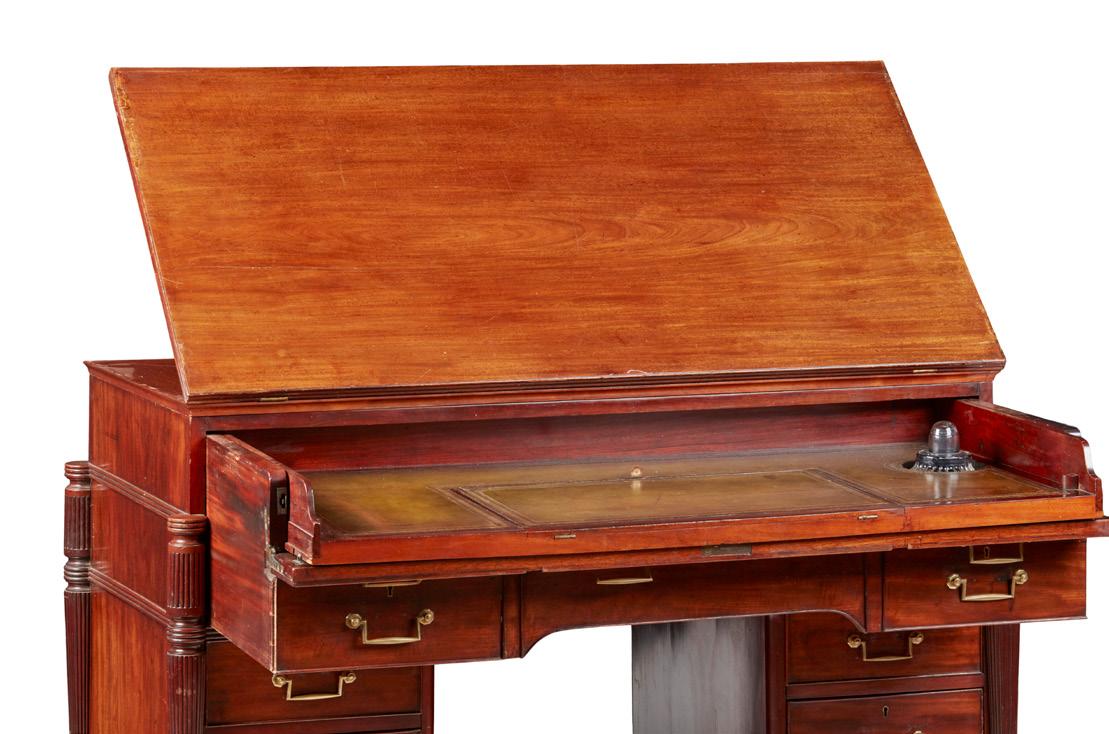

LATE 18TH CENTURY/ EARLY 19TH CENTURY
the double hinged and ratchet adjusted top with a reeded edge, above a secretaire drawer fitted with a green leather slide with a glass inkwell and ratchet adjusted slope, over a recess with covered compartments and hidden drawers, the hinged covers with ivory plaques inscribed with alphabet series, above an arched apron and raised on banks of three drawers and an arched apron, the corners with turned and reeded columns, the reverse with dummy drawers and cupboards, on castors; stamped twice on the drawer J. WARRINGTON
127cm wide, 93cm high, 68cm deep
Note: Sold in compliance with UK Government and APHA regulations, with (non-transferable) exemption registration reference GNTE33WJ
£2,500-3,500
77 Other fees apply in addition to the hammer price: see the ‘Buyer’s Guide’ section on page 2
210
SCOTTISH MAHOGANY CARD TABLE, IN THE MANNER OF WILLIAM TROTTER EARLY 19TH CENTURY

the rounded rectangular fold-over top above an egg and dart moulded frieze, raised on a turned baluster column on a quadripartite base with acanthus carved legs ending in brass paw feet and castors
94cm wide, 73cm high, 48cm deep, 96cm deep (opened)
Provenance: Private Scottish Collection, Morayshire £300-500

211
REGENCY MAHOGANY WINE PEDESTAL BY GILLOWS

EARLY 19TH CENTURY
the hinged folding top above a deep drawer and a cupboard with brass lion mask handles, the drawer fitted with a removable cellarette, on a moulded plinth; with two associated glass decanters with mother-of-pearl stoppers labelled ‘Brandy’ and ‘Whiskey’

53cm wide, 106cm [open], 86cm high, 50cm deep
Note: A design by Gillows for a similar wine pedestal, dated July 1825, is in the Westminster City Archives. Described as a ‘Mahogany pedestal with folding top’, it was commissioned by a C. Wilson Esq. and cost £9.6s.42d.
£1,000-1,500
212
PAIR OF GEORGE IV MAHOGANY ‘DAWS PATENT’ RECLINING ARMCHAIRS, BY ROBERT DAWS
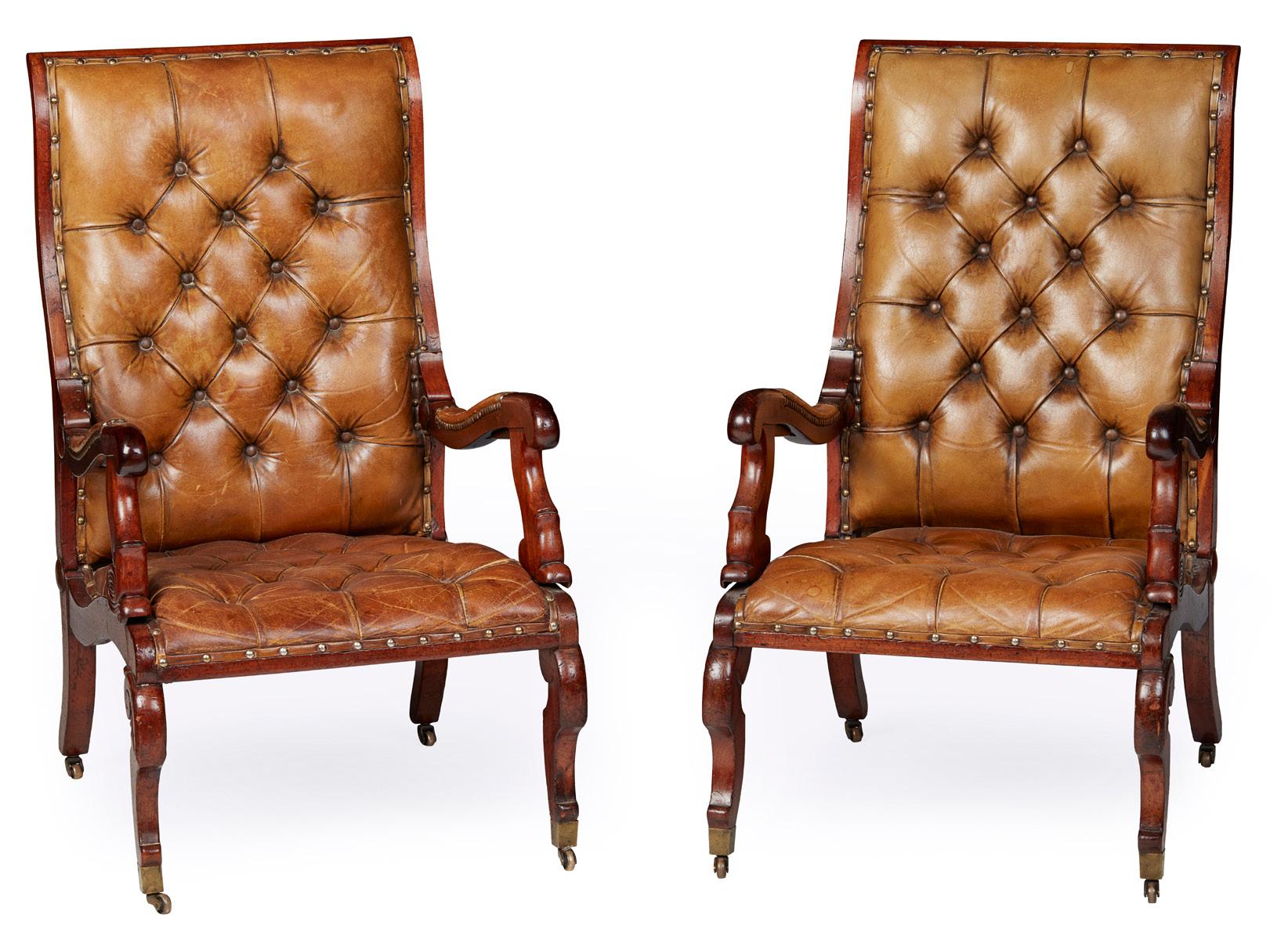
CIRCA 1830
the shaped rectangular backs joined with adjustable scrolling padded arm supports on brass ratchet grooves, the backs and seats in brown studded leather, on scrolling front legs terminating in brass caps and castors, with splayed back legs terminating in brass castors, stamped to each back leg ‘R. DAWS, B.Q.L, GR PATENT’ (2) 53cm wide, 94cm high, 77cm deep £1,000-1,500
Note: Robert Daws is recorded as being active between 1820-39 at 17 Margaret Street, Cavendish Square, London, and patented his improved recumbent chair in 1827. See C. Gilbert and G. Beard, “Dictionary of English Furniture Makers 1660-1840”, Leeds, 1986, p.282.
78
213
GEORGE IV BURR ELM CELLARETTE
EARLY 19TH CENTURY
of sarcophagus form, the moulded hinged cover with a gadroon moulded knop finial, opening to a void interior, the bombé panel sides bordered with leaf tip moulding, raised on waisted block feet
77cm wide, 60cm high, 50cm deep
£2,000-3,000
214
SCOTTISH REGENCY MAHOGANY BREAKFAST TABLE, ATTRIBUTED TO WILLIAM TROTTER
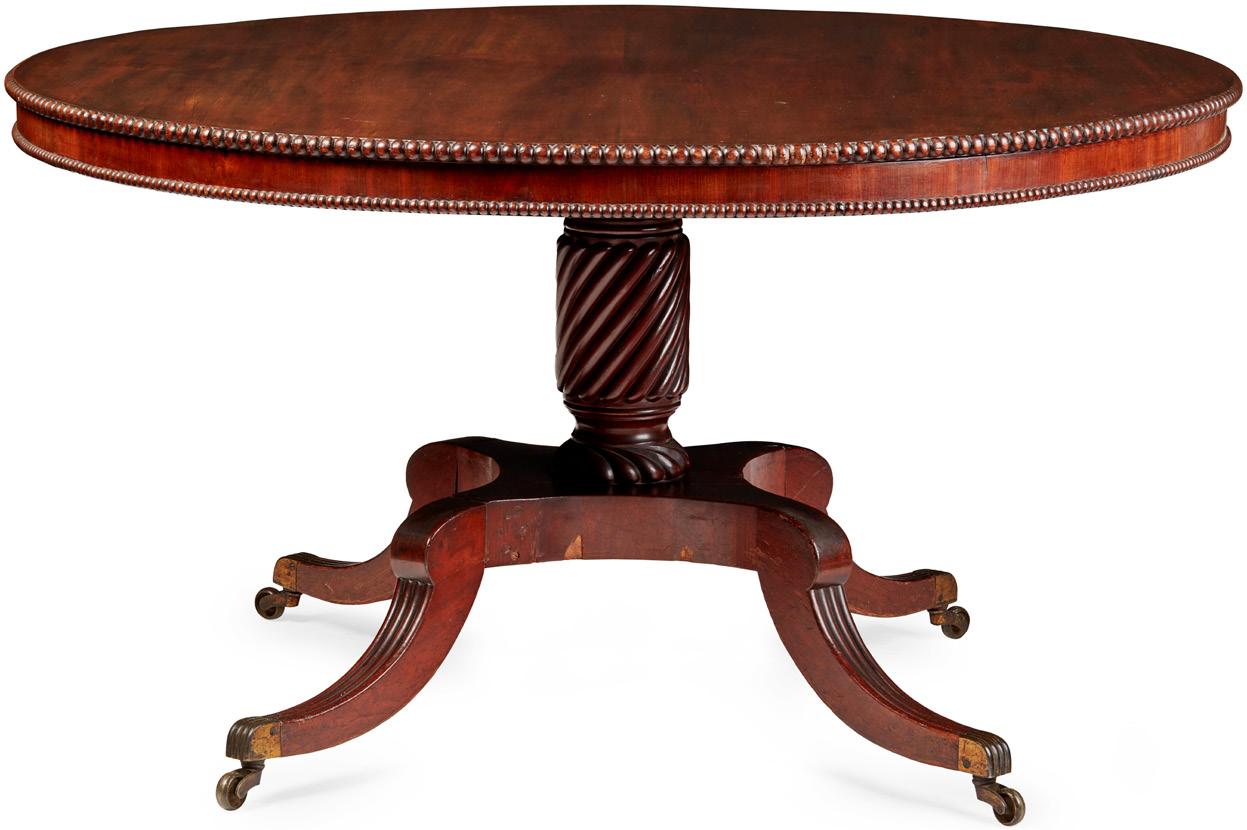
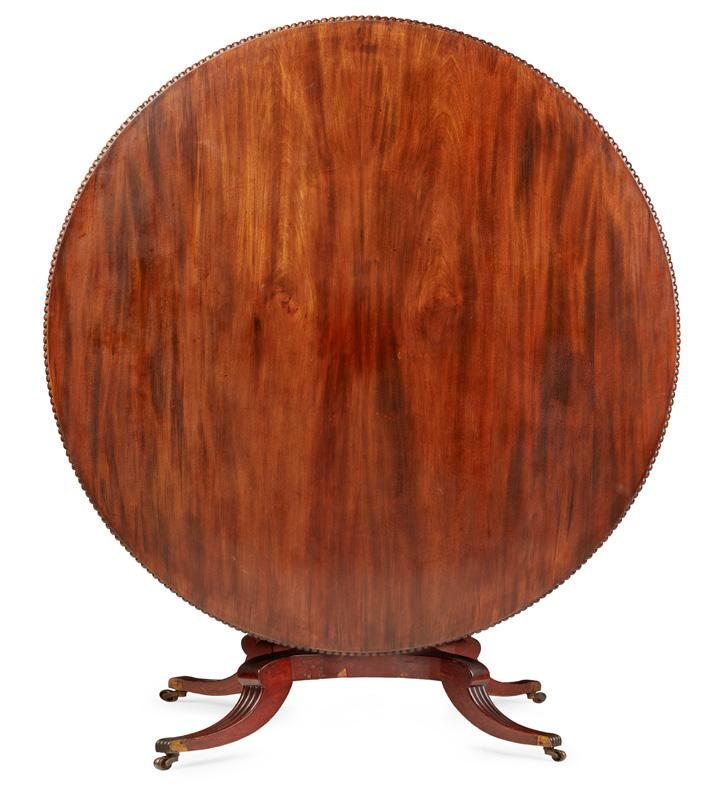
EARLY 19TH CENTURY
the circular tilt top with a bead moulded frieze, on a spiral carved and gadrooned pedestal and quadripartite concave platform raised on hipped and outswept reeded legs ending in reeded brass caps and castors
133cm diameter, 73cm high
£2,000-3,000
215 Y
SCOTTISH REGENCY ROSEWOOD SOFA TABLE, BY WILLIAM TROTTER

EARLY 19TH CENTURY
the rectangular top with drop leaf ends above a bead moulded frieze drawer and dummy drawer, the same opposing, raised on a leaf carved waisted square column and concave quadripartite base on bun feet
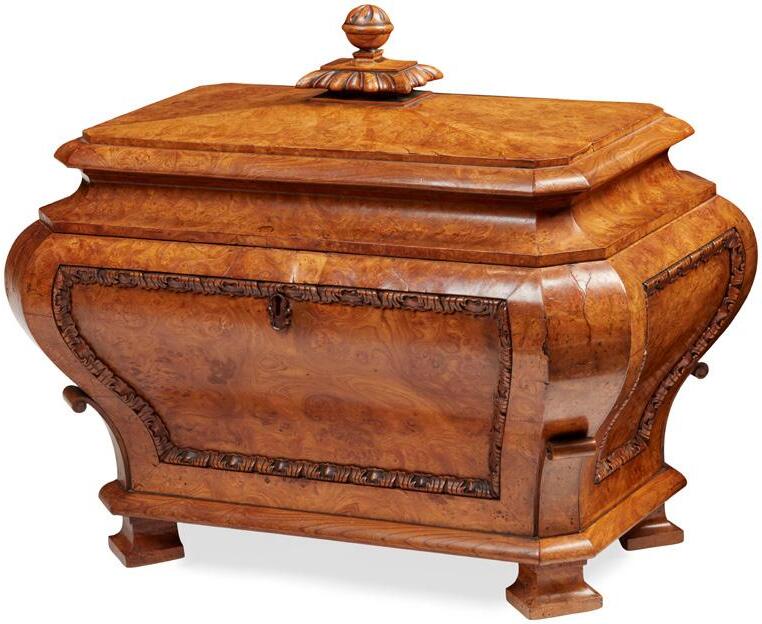

92cm wide, 152 (open), 74cm high, 72cm deep
£2,000-3,000
79 Other fees apply in addition to the hammer price: see the ‘Buyer’s Guide’ section on page 2
216
GEORGE IV MAHOGANY CANTERBURY, PROBABLY SCOTTISH
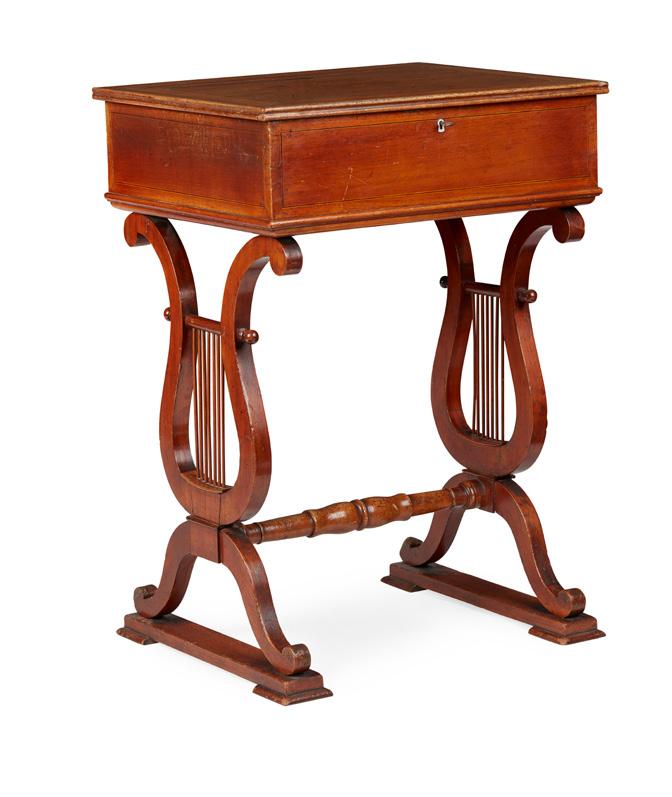
EARLY 19TH CENTURY
of large size, with four concave divisions above a long base drawer, raised on turned legs with brass caps and castors

59cm wide, 59cm high, 44cm deep
£1,000-1,500
217
GEORGE IV MAHOGANY AND EBONY LINEN PRESS
EARLY 19TH CENTURY
the scrolling cornice outlined with ebony and a central carved bull’s eye and marked with roundels, above a pair of ebony moulded panel doors flanked by bobbin-turned mouldings, opening to hanging space; the base with a pair of short drawers over two long drawers, raised on ring-turned legs
124cm wide, 219cm high, 55cm deep
£700-1,000
218
LATE GEORGE III
MAHOGANY AND ELM
WORK TABLE
LATE 18TH CENTURY
the hinged crossbanded top opening to a compartmented interior with a folding pin cushion and drawers, raised on lyre-form end supports on scrolled trestle bases united by a turned stretcher
55cm wide, 78cm high, 45cm deep
Provenance: Paxton House, Berwickshire, thence by family descent to the present vendors
£300-500
219
REGENCY MAHOGANY, EBONY, AND BRASS SIDE CABINET

EARLY 19TH CENTURY
with two short frieze drawers above a pair of brass grille insert doors outlined with ebony stringing and lined with pleated mustard yellow silk, opening to a shelved interior and raised on short ring-turned legs
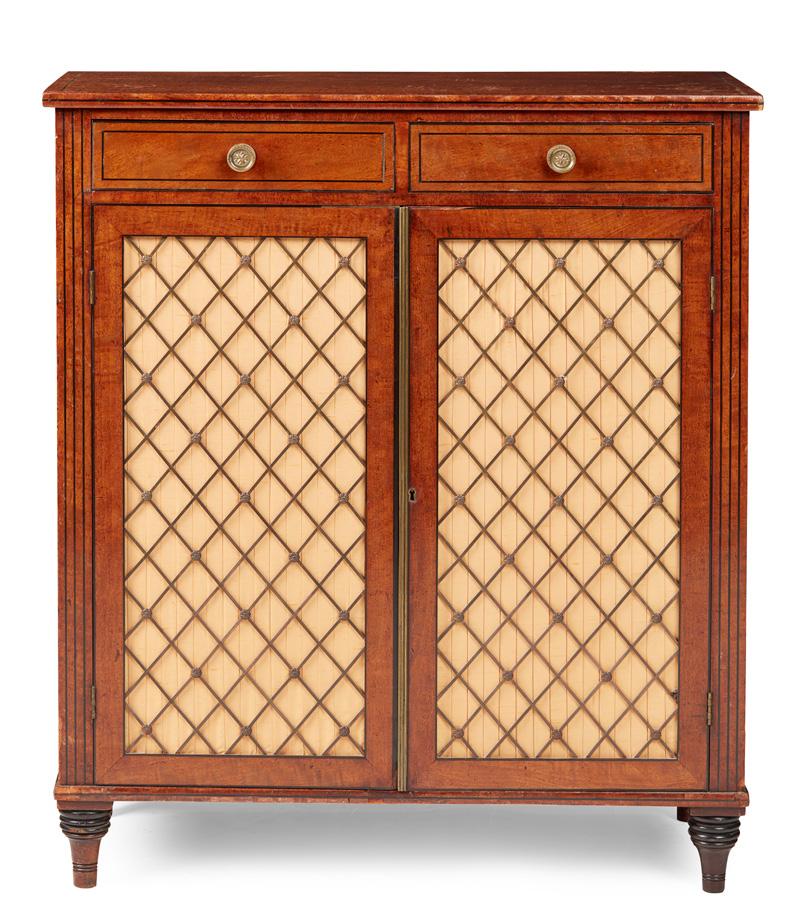
77cm wide, 89cm high, 35cm deep
£800-1,200
80
220
GEORGE IV PAINTED AND PARCEL-GILT OVERMANTEL MIRROR
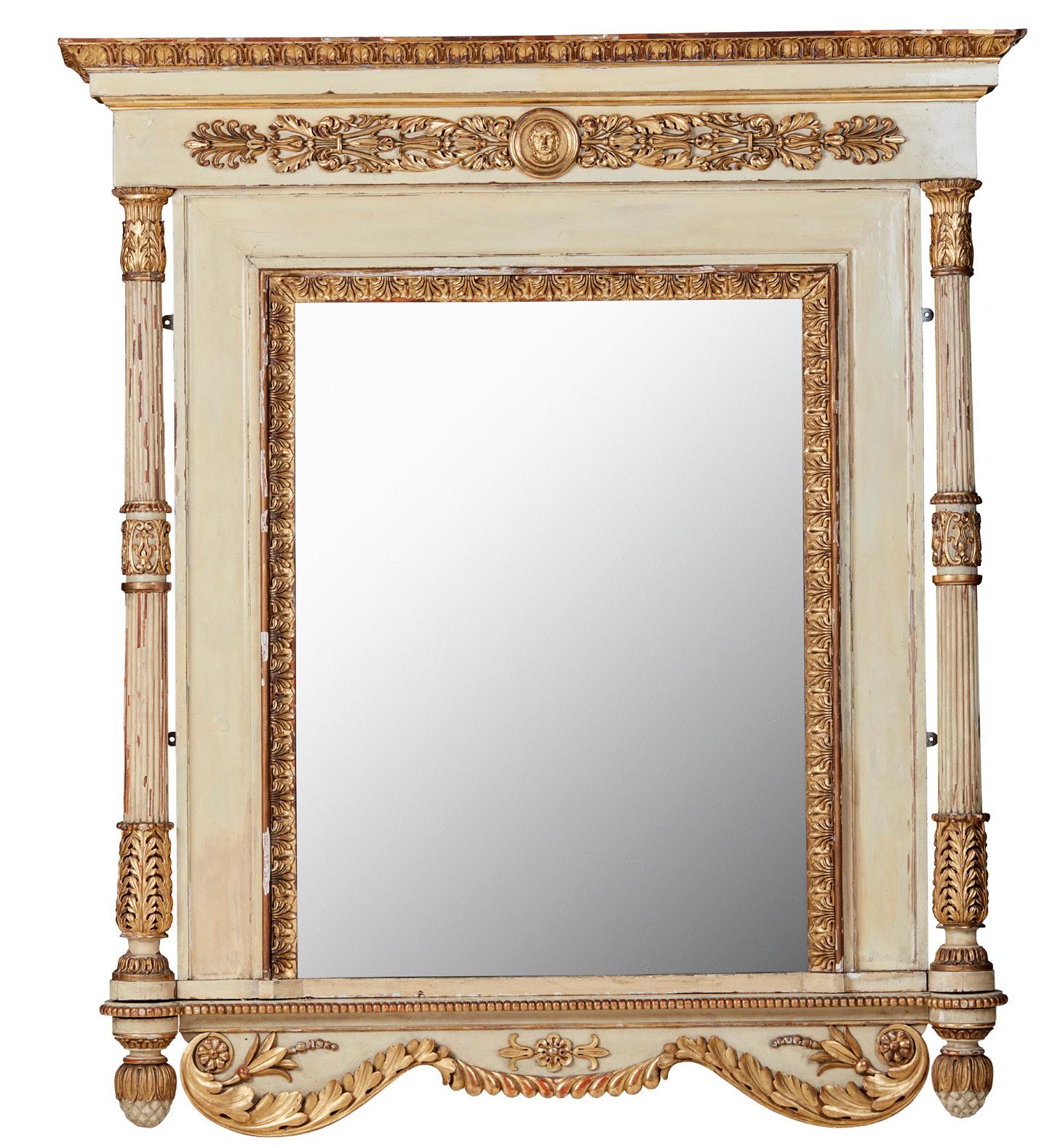
EARLY 19TH CENTURY
the leaf moulded cornice above an acanthus and palmette moulded frieze centred by classical mask medallion, above the rectangular mirror plate in an anthemion moulded slip flanked by acanthus clasped reeded columns with pendant pinecone finials 193cm high, 156cm wide £1,000-1,500
221 Y
GEORGE IV ROSEWOOD AND GRAIN PAINTED OCTAGONAL BREAKFAST TABLE


EARLY 19TH CENTURY
the octagonal tilt top on a concave triple column pedestal and tripartite base raised on carved winged claw feet 135cm diameter, 74cm high
£600-800
81 Other fees apply in addition to the hammer price: see the ‘Buyer’s Guide’ section on page 2
225
222
BLUE JOHN GOBLET
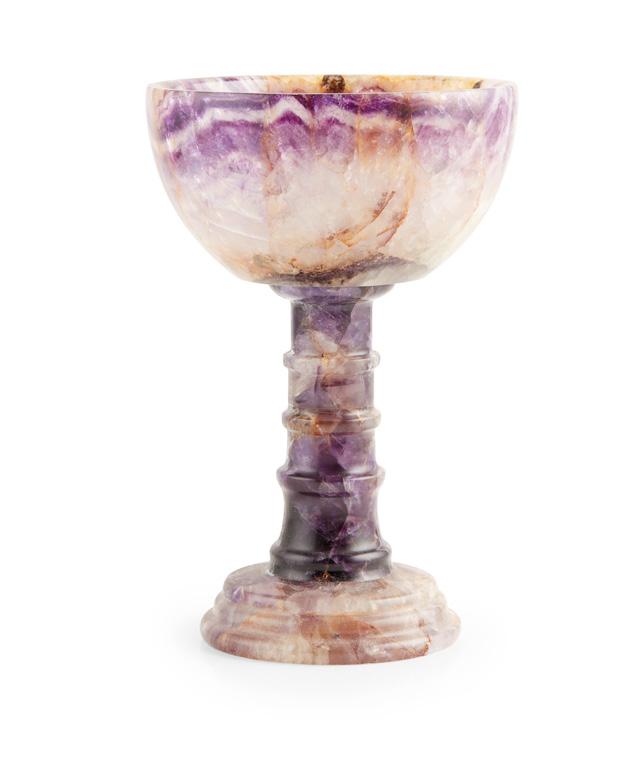
LATE 19TH/ EARLY 20TH CENTURY
the bowl on a turned stem with a circular foot 10cm in diameter, 15cm high
£700-1,000
223
TWO BLUE JOHN WARES
LATE 19TH/ EARLY 20TH CENTURY
including a deep bowl and a shallow dish (2)

Bowl 11cm diameter x 6.5cm high; dish 14cm in diameter
£500-700
224
BLUE JOHN COLUMN

19TH CENTURY
modelled as a Doric column on a square plinth, the mounts carved in white marble and black slate, together with BLUE JOHN OBELISK, of tapering square form with fills and losses (2)
column 8cm wide, 31cm high
Provenance: Paxton House, Berwickshire, thence by family descent to the current vendor
£700-1,000
19TH CENTURY
the adjustable and pivoting slope with a pair of brass page stops, raised on a turned support and circular base

33cm wide, 35cm high, 16cm deep
£300-500
MAHOGANY BOOK REST
82
OAK ARCHITECT’S MODEL OF A SPLIT STAIRCASE

20TH CENTURY
with scroll cut flat balustrades and chamfered supports 50cm wide, 44cm high, 30cm deep £400-600
227 Y
DOME CASED DIORAMA OF A CASTLE RUIN
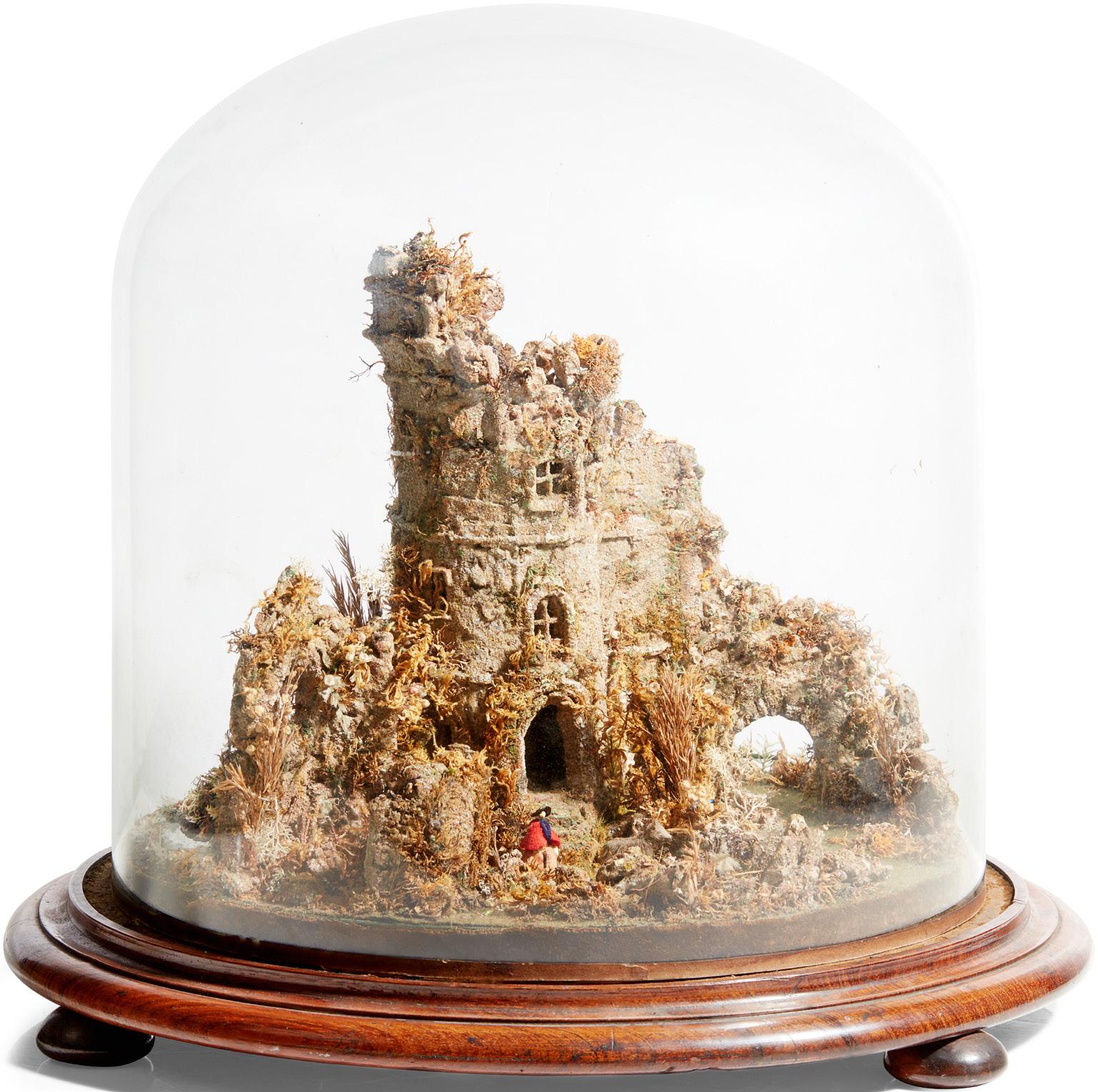
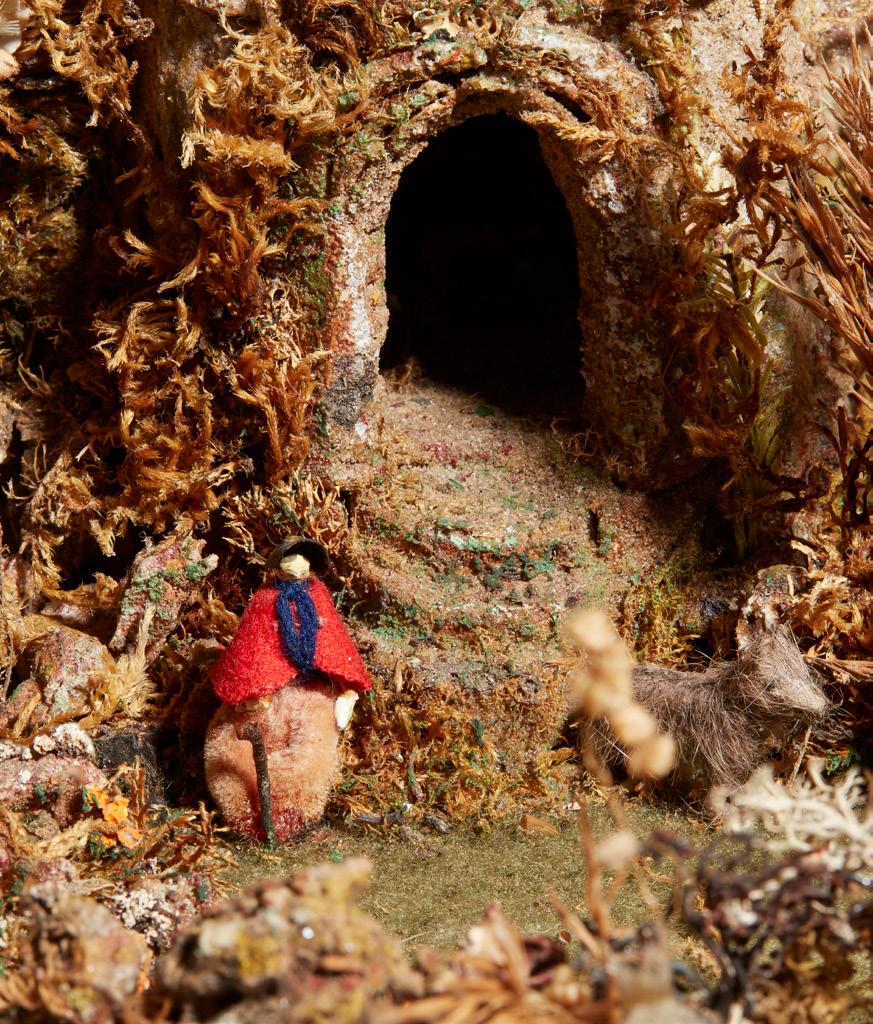
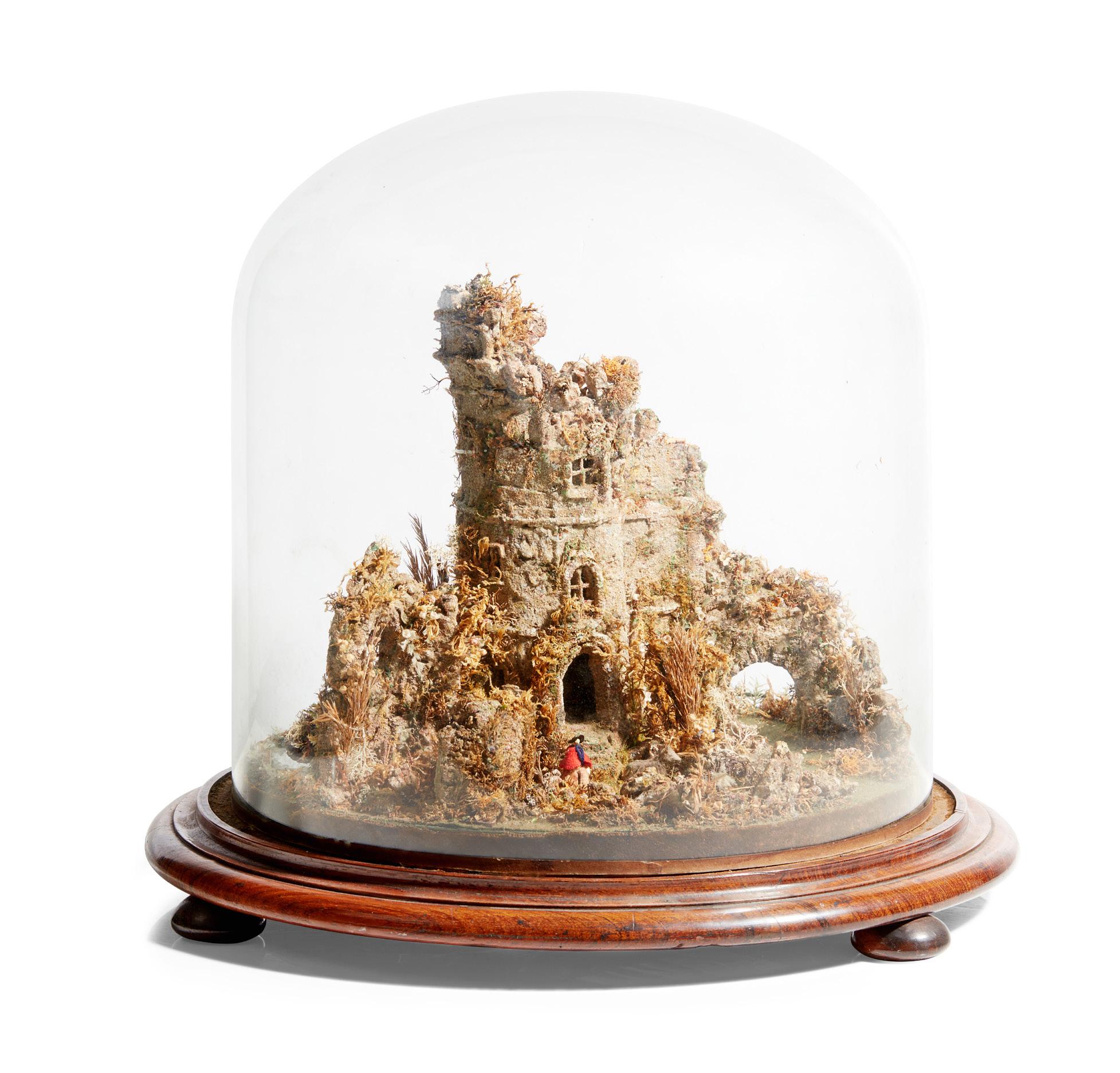
EARLY 19TH CENTURY painted cork and moss model of a ruined castle with a ruined tower and arches, with a small cottage at its base with two small figures and a mirror pond, on a turned rosewood stand with bun feet and a glass dome 43cm diameter, 40cm high £600-800
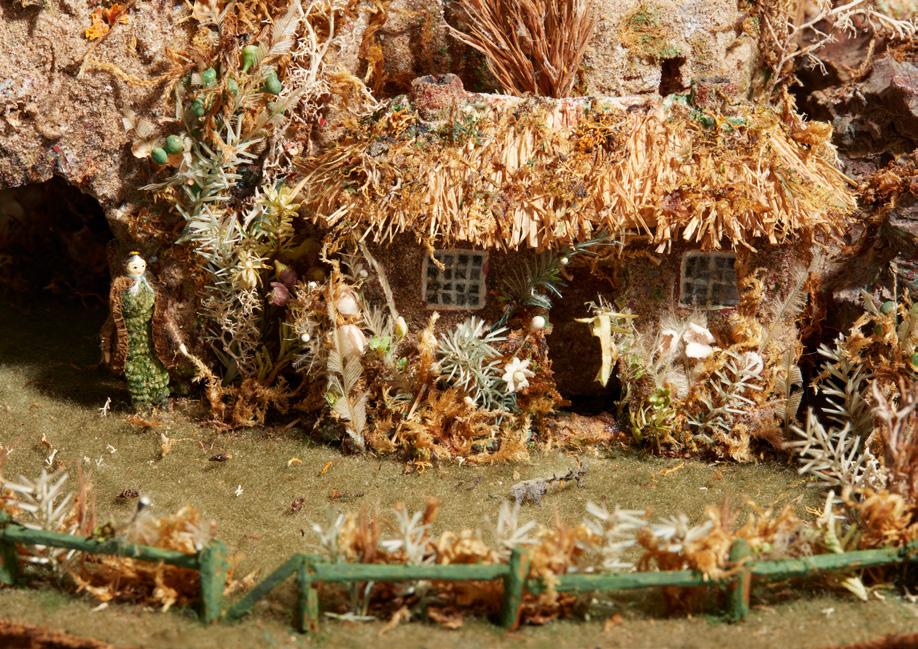
226
83 Other fees apply in addition to the hammer price: see the ‘Buyer’s Guide’ section on page 2
228
SIX COLOURED AQUATINTS, ‘CAR TRAVELLING IN THE SOUTH OF IRELAND IN THE YEAR 1856’
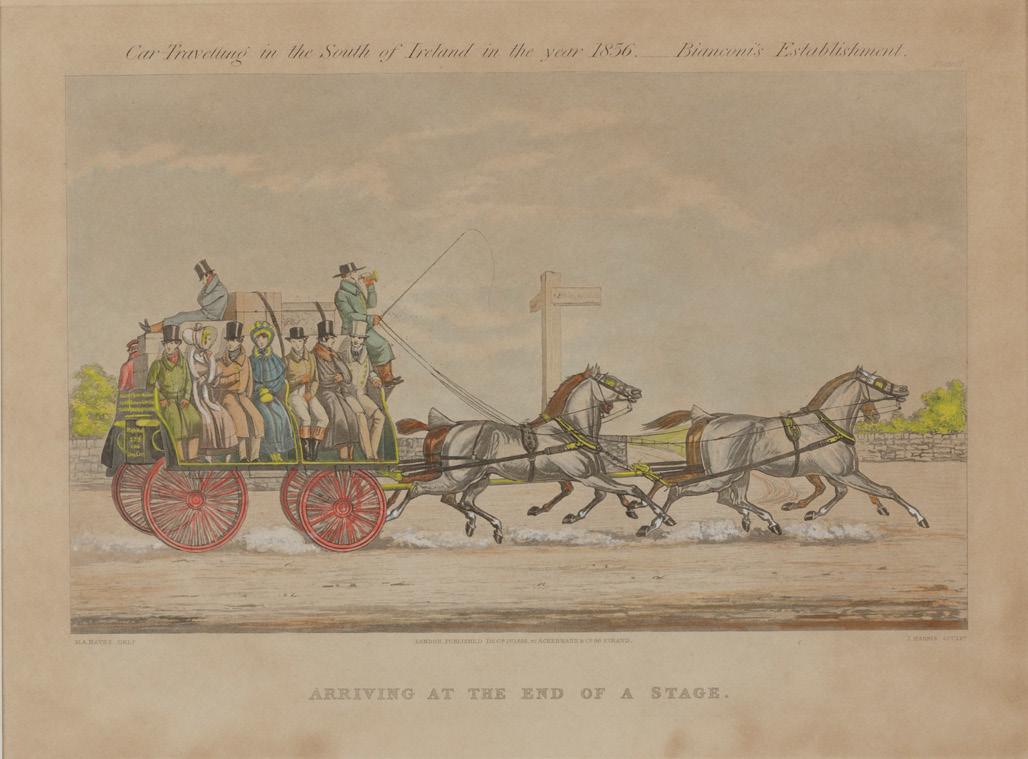
AFTER MICHAEL ANGELO HAYES RHA (1820-1877)
complete set, engraved by J Harris and published by Ackerman and Co., London, 1 December 1856; entitled ‘Getting Ready, Hearn’s Hotel, Clonmell’, ‘Arriving at the End of a Stage’, ‘On the Road at Full Pace’, ‘Taking Up a Passenger’, ‘Dropping a Passenger’, ‘The Arrival at Waterford, Commin’s Hotel’, framed (6)
37.5cm wide, 28cm high, 58cm wide, 42.2cm high including the frame
£250-350
229
PAINTED AND PARCEL GILT TOLE TEA CANISTER

19TH CENTURY
of oval shape with domed cover, decorated in black and gilt on a red ground with a central reserve depicting figures in an opium den between Greek key bands, numbered ‘5’
28cm wide, 44cm high
£400-600
230
UNUSUAL LARGE ROOTWOOD CASKET
LATE 19TH/ EARLY
20TH CENTURY
of rectangular form with rootwood panels, the plain interior relined in beige suede
27cm wide, 16cm high, 17cm deep
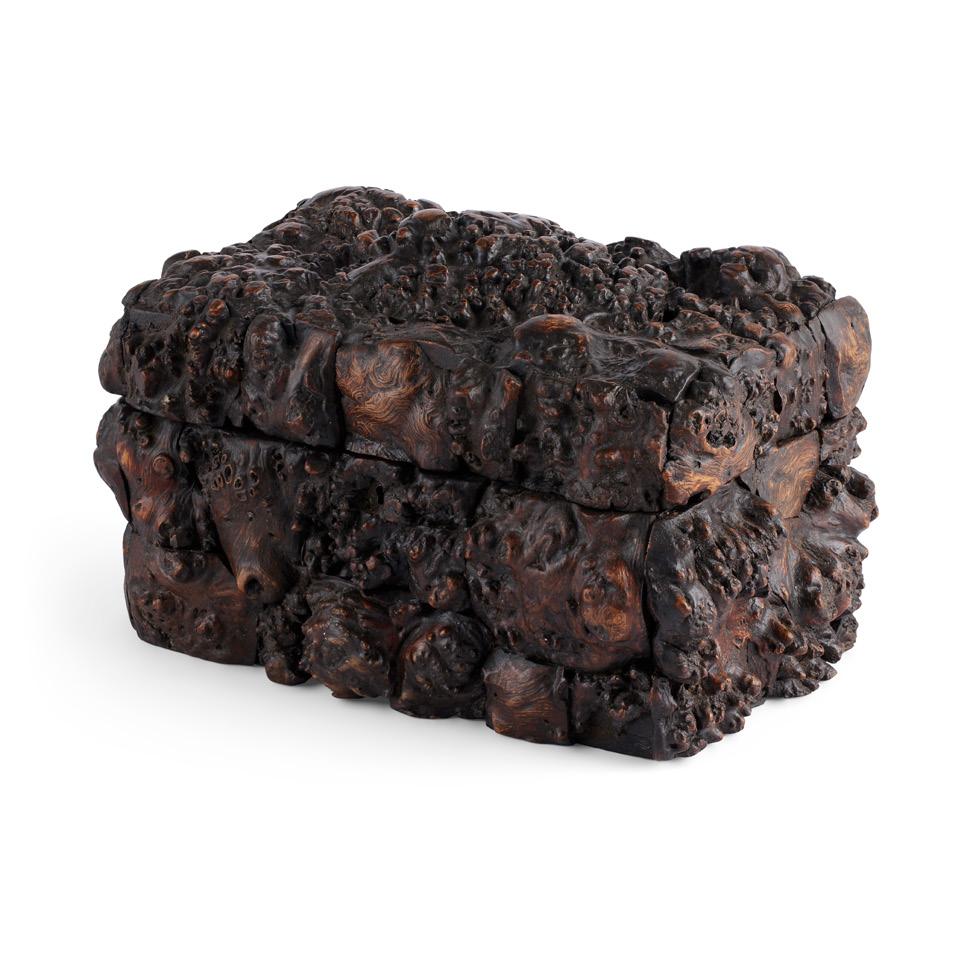
£700-1,000
231
FOUR PAINTED WOOD DUCK DECOYS
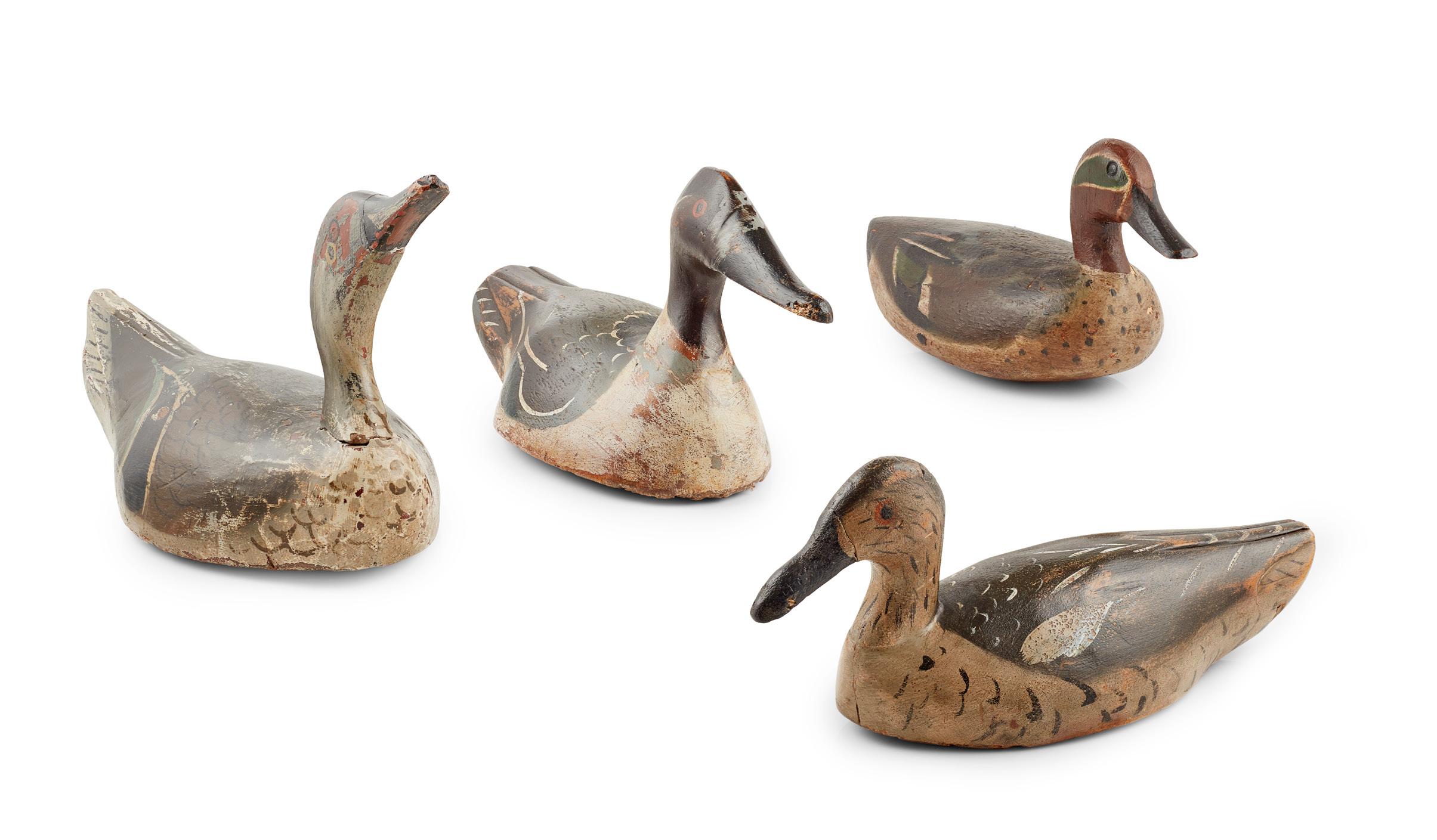
20TH CENTURY
various sizes, carved and polychrome painted feather and eye details (4)
Largest 38cm long
£300-500
84
ENGLISH PORTRAIT MINIATURE OF A YOUNG LADY CIRCA 1840
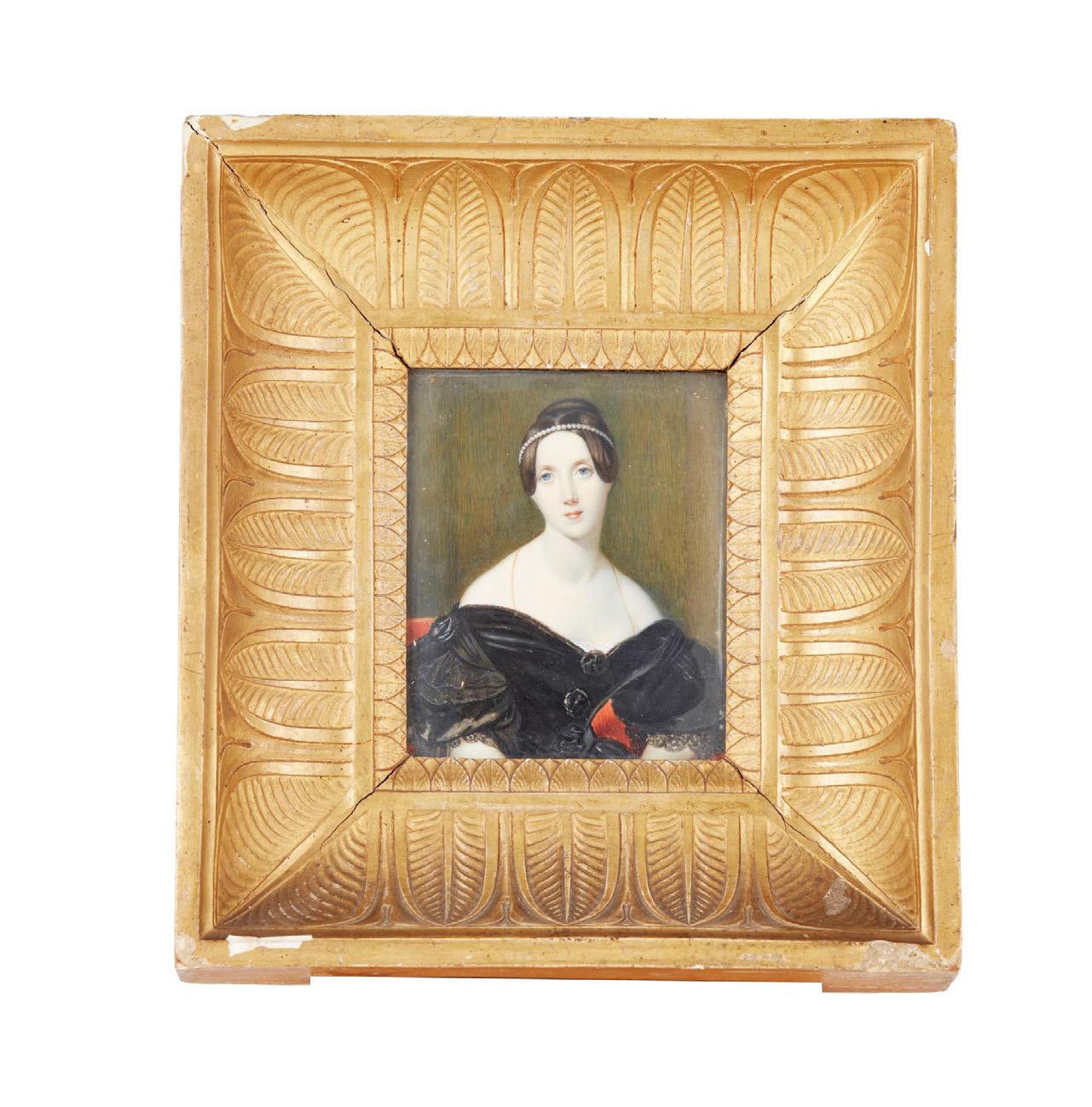
gouache and bodycolour on ivory, the sitter with dark hair and a bandeau of pearls in her hair, wearing a thin gold chain around her neck, seated on a red chair wearing a black silk dress with gigot sleeves and lace cuffs, in a giltwood gesso frame
13cm x 9.5cm (excluding frame)
Note: Sold in compliance with UK Government and APHA regulations, with (non-transferable) exemption registration reference U57XTQ5U
£300-500
233 Y
WILLIAM IV BRASS INLAID ROSEWOOD WORK BOX



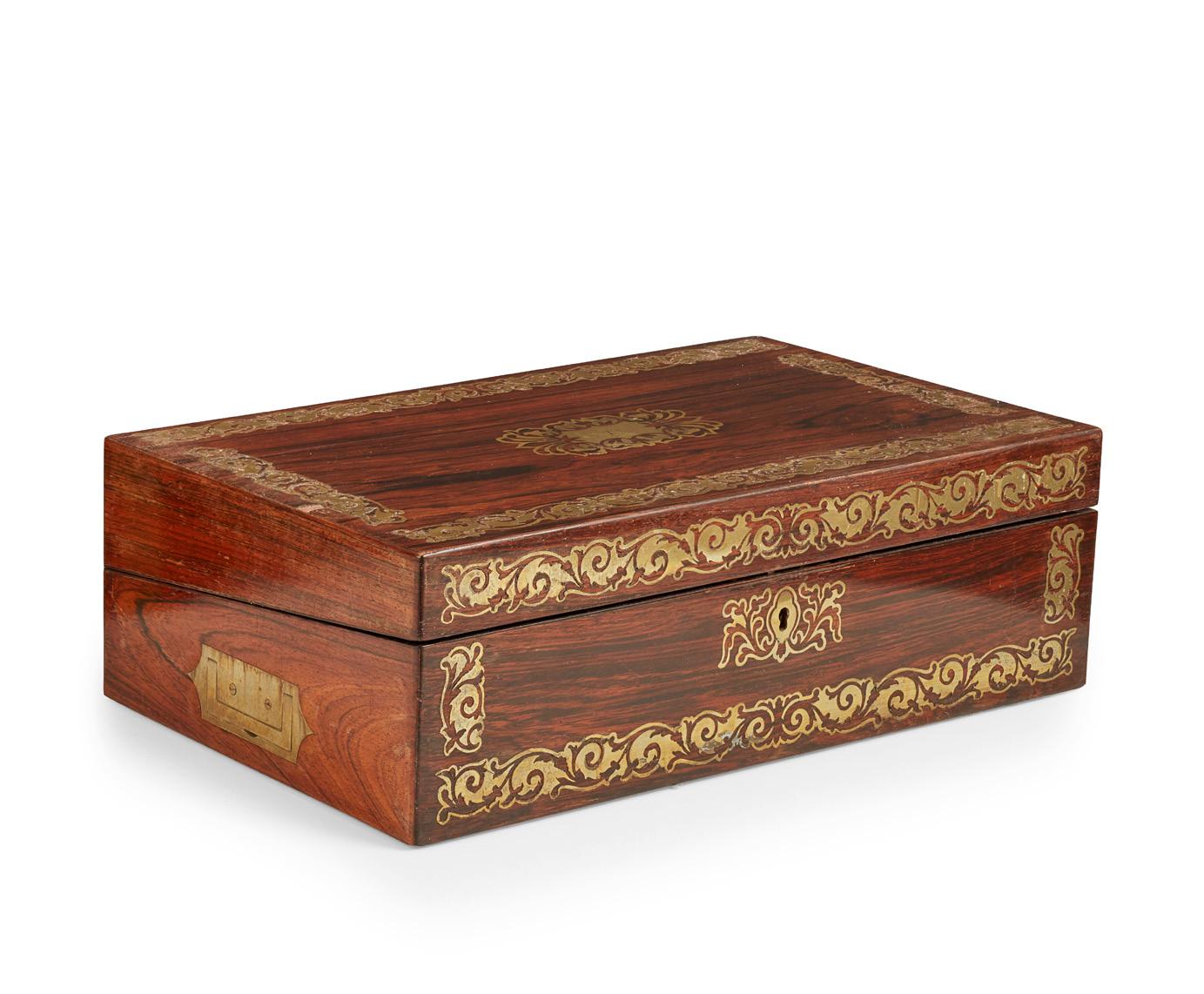
EARLY 19TH CENTURY
of sarcophagus form outlined with bead moulding, the cover and front panel inlaid with pierced scrolling brass borders, opening to a fitted lilac silk and green tooled leather interior with a fitted tray, on lobed feet
31cm wide, 16cm high, 22cm deep
£300-500
234 Y
TWO BRASS MOUNTED WRITING SLOPES
19TH CENTURY
one brass inlaid rosewood, opening to a green tooled leather skiver, bearing a monogram cartouche ‘JL’; the other brass bound walnut, opening to a black tooled leather skiver, bearing a brass cartouche ‘M Leggat, Xmas 1896’ (2) 40cm wide, 13cm high, 24cm deep and 35cm wide, 15.5cm high, 23cm deep respectively
Provenance: Private Scottish Collection, Morayshire
£300-500
232 Y
85 Other fees apply in addition to the hammer price: see the ‘Buyer’s Guide’ section on page 2
WILLIAM IV ROSEWOOD AND NEEDLEWORK POLESCREEN
EARLY 19TH CENTURY
the oval floral needlework panel inside a gilt mount and square moulded frame with corner rosettes, on a turned adjustable stem with a lobed baluster support and tripartite base with turned feet
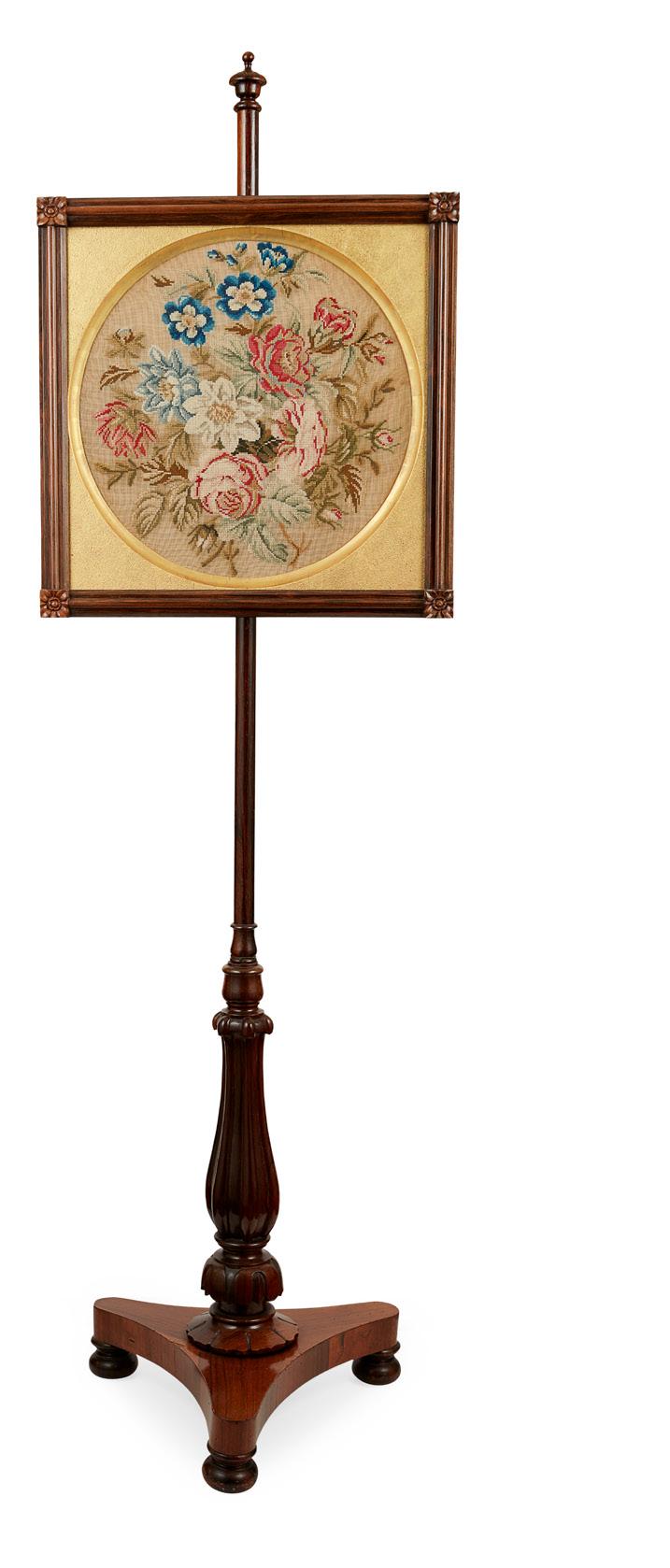
46cm wide, 157cm high
£300-500
238
LATE VICTORIAN FROGMORE
HOUSE LEATHER FIRE BUCKET, OF ROYAL INTEREST
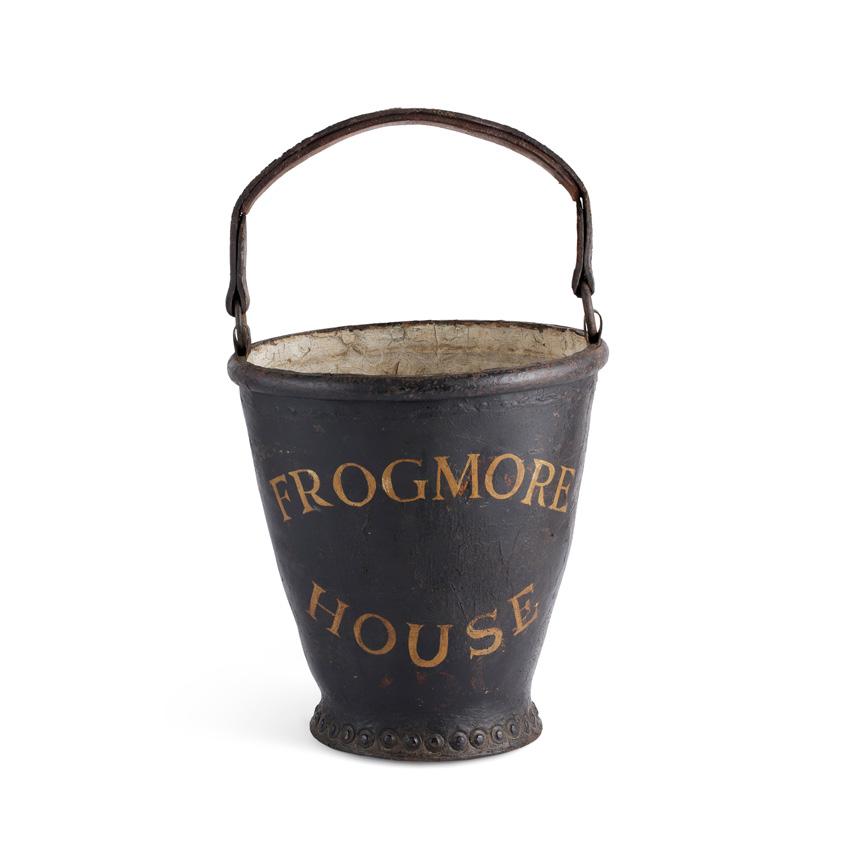
LATE 19TH CENTURY
of typical form, with strap handles and metal fittings, hand gilt
lettered ‘FROGMORE HOUSE’
25cm in diameter, 32cm high
£400-600
236
WILLIAM IV MAHOGANY
WING ARMCHAIR
EARLY 19TH CENTURY
the tall button-upholstered back above a padded seat and scrolled arms, with a reeded seat rail and raised on lotus carved, turned and tapered legs with brass castors
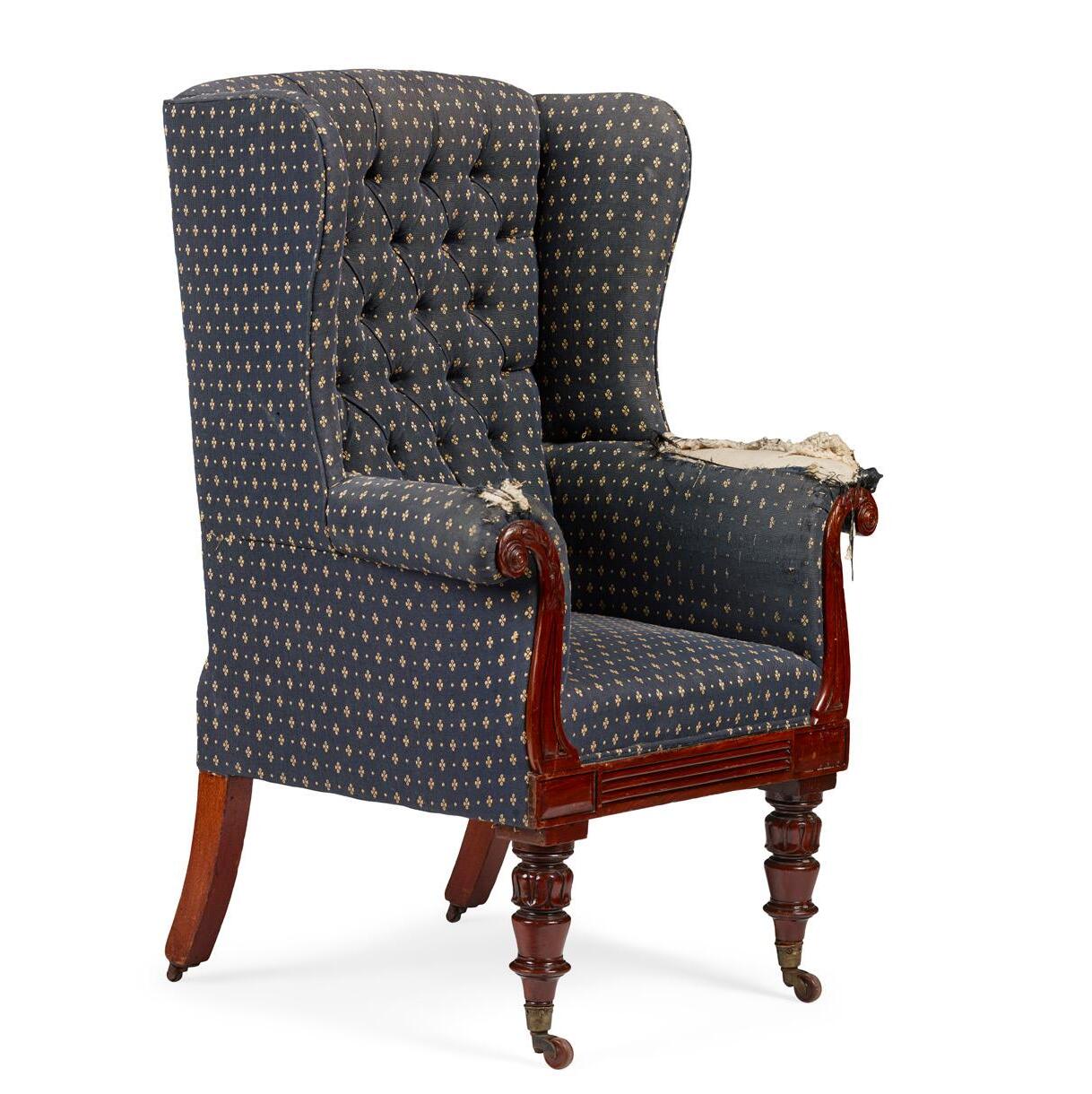
77cm wide, 114cm high, 44cm deep
£600-800
237
WILLIAM IV MAHOGANY WRITING TABLE

EARLY 19TH CENTURY
the rectangular top above a pair of short frieze drawers, raised on turned and fluted tapering legs ending in brass caps and castors
91cm wide, 72cm 53cm deep
£400-600
239
LARGE GOTHIC REVIVAL OAK AND WHITE MARBLE FIRE SURROUND
CIRCA 1830
the white oak surround of inverted breakfront outline, the moulded shelf marked with carved roses over an architectural Gothic arch frieze flanked by trefoil tracery panels, the outer supports with stylised tulip and linen fold panels on moulded plinth bases, the arched white marble insert carved with stylised leaf and flower motifs within deep moulded borders, fitted with a later copper hood and side panels embossed with fleur-de-lis, with a cast iron fire grate with wrythen stems and dragon head finials 214cm wide, 175cm high, 33cm deep overall; inside 109cm x 109cm
Provenance: Kilmaron Castle, Fife, until removed prior to demolition in the 1960s. After which installed in another private house in Fife until removed by the current owner.
£4,000-6,000
235 Y
86
Note: Kilmaron Castle, outside Cupar in Fife, was built circa 1820 for Sir David Baxter, the Dundee textile manufacturer. Designed by the prominent Scottish Architect James Gillespie Graham, Kilmaron was a large castellated three storey mansion built in the Gothic Revival style, who was influenced by the work of Augustus Pugin. The style was favoured by the architect and he was particularly adept with it. Graham’s designs for other country houses in the Gothic style include Duns Castle, Crawford Priory, Torrisdale Castle, and Cambusnethen Priory, all of which relate to the scheme employed at Kilmaron. In 1838 Graham was responsible for the fantastically remodelled Gothic interiors of Taymouth Castle. Like many Scottish country houses, the 20th century was not kind to Kilmaron Castle, with it eventually falling derelict by the 1970s. Deemed unsafe and beyond saving, it was stripped of its interiors blown up in 1985.

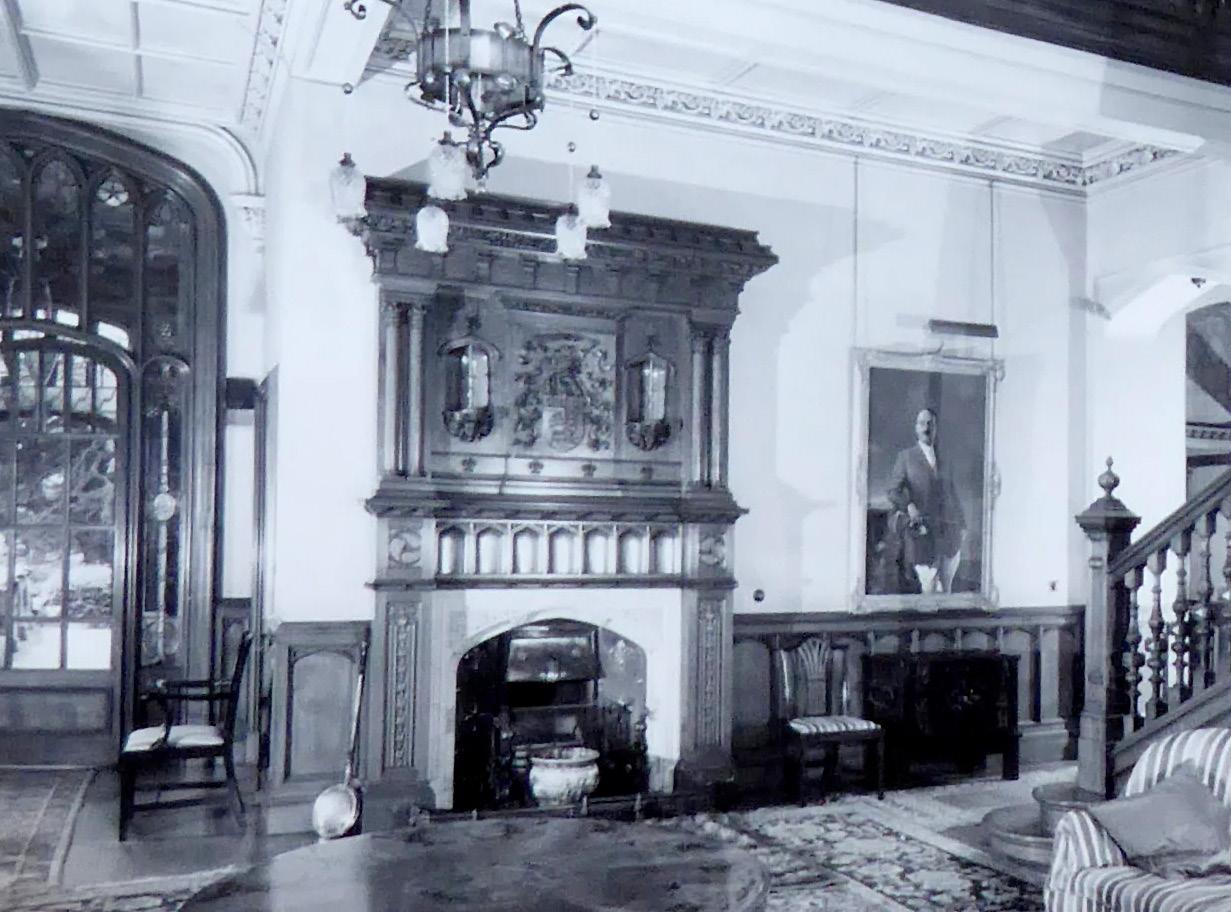
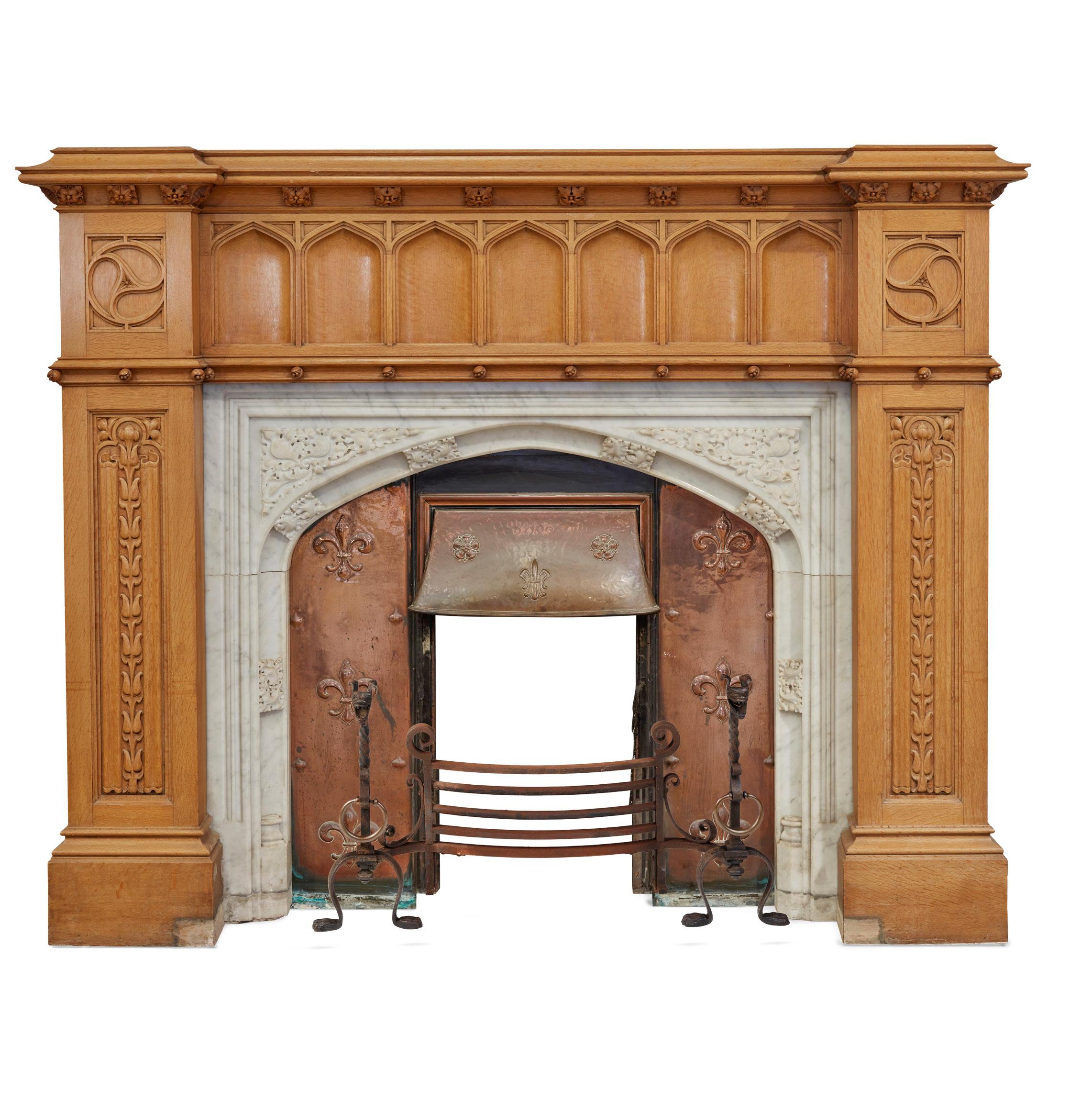
87 Other fees apply in addition to the hammer price: see the ‘Buyer’s Guide’ section on page 2
241
WILLIAM IV MAHOGANY EXTENDING DINING TABLE

EARLY 19TH CENTURY
the rectangular top above a plain frieze with flowerhead carvings on the corners, raised on turned reeded legs and brass castors, opening on a scissor action with three leaf extensions
267cm extended, 72cm high, 139cm wide £600-800
240
WILLIAM IV MAHOGANY
TEA POY, BY GILLOWS OF LANCASTER
EARLY 19TH CENTURY
the octagonal hinged top with radial veneers and a leaf tip carved border, opening to two removable demilune covered caddies, on a tapering faceted body raised on acanthus

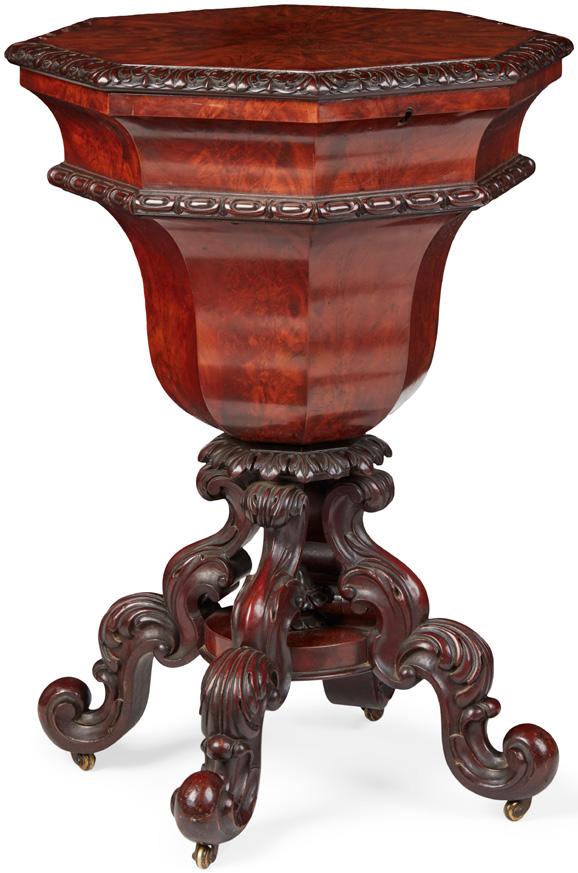
carved scrolling supports united by circular undertier, on brass castors, the base stamped ‘GILLOWS 8472’ 50cm diameter, 74cm high £1,200-1,800
242 Y
WILLIAM IV GONCALO ALVES PRESS CABINET
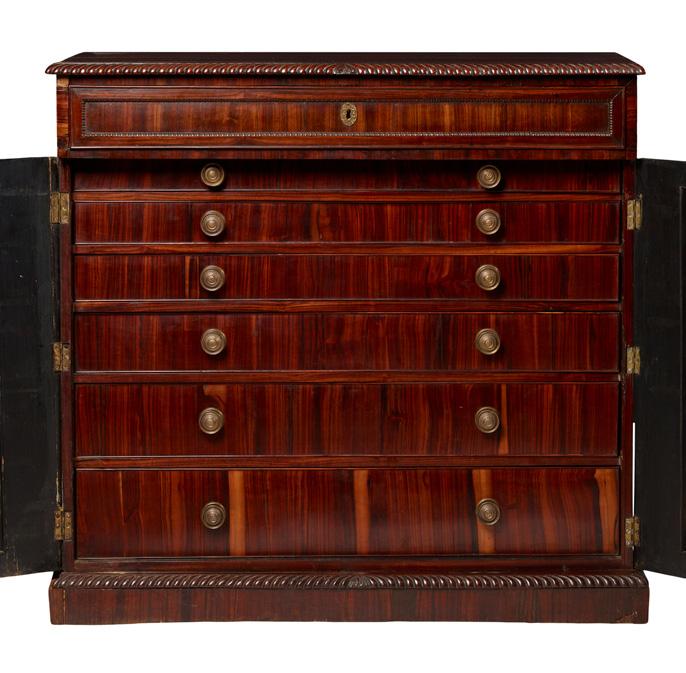

EARLY 19TH CENTURY
the top with a gadrooned edge above a long frieze drawer, over a pair of bead moulded panel doors opening to six graduated drawers, on a plinth base 123cm wide, 116cm high, 35cm deep £1,500-2,500
88 Other fees apply in addition to the hammer price: see the ‘Buyer’s Guide’ section on page 2
EARLY 19TH CENTURY
the shaped bar backs with lyre form splats above caned seats, raised on sabre legs, the frames gilt decorated with putti, garlands, and rosettes (4) 46cm wide, 87cm high, 45cm deep £400-600
244
LARGE WILLIAM IV RED
WALNUT LAZY SUSAN
MID 19TH CENTURY
the circular tray top on a base with turntable mechanism and stylised carved flowerhead details; with an accompanying table pad
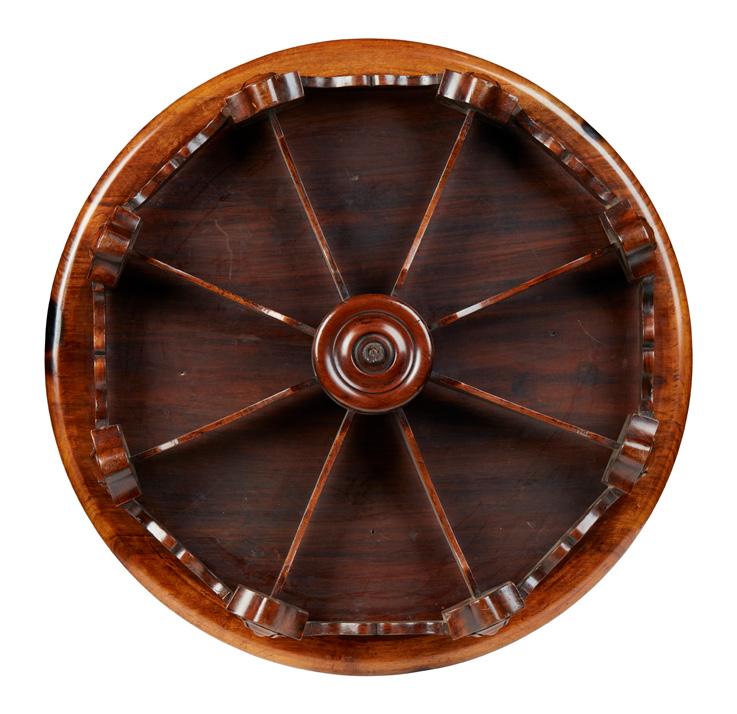
61cm diameter, 9cm high
£1,000-1,500
245 Y
EARLY VICTORIAN ROSEWOOD CENTRE TABLE
MID 19TH CENTURY
the shaped oval top with a moulded edge, on scroll carved supports and outscrolling legs with ceramic castors and united by a central urn finial
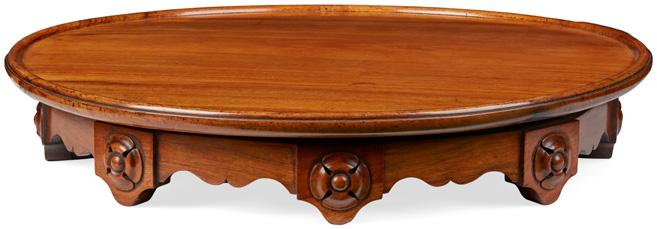
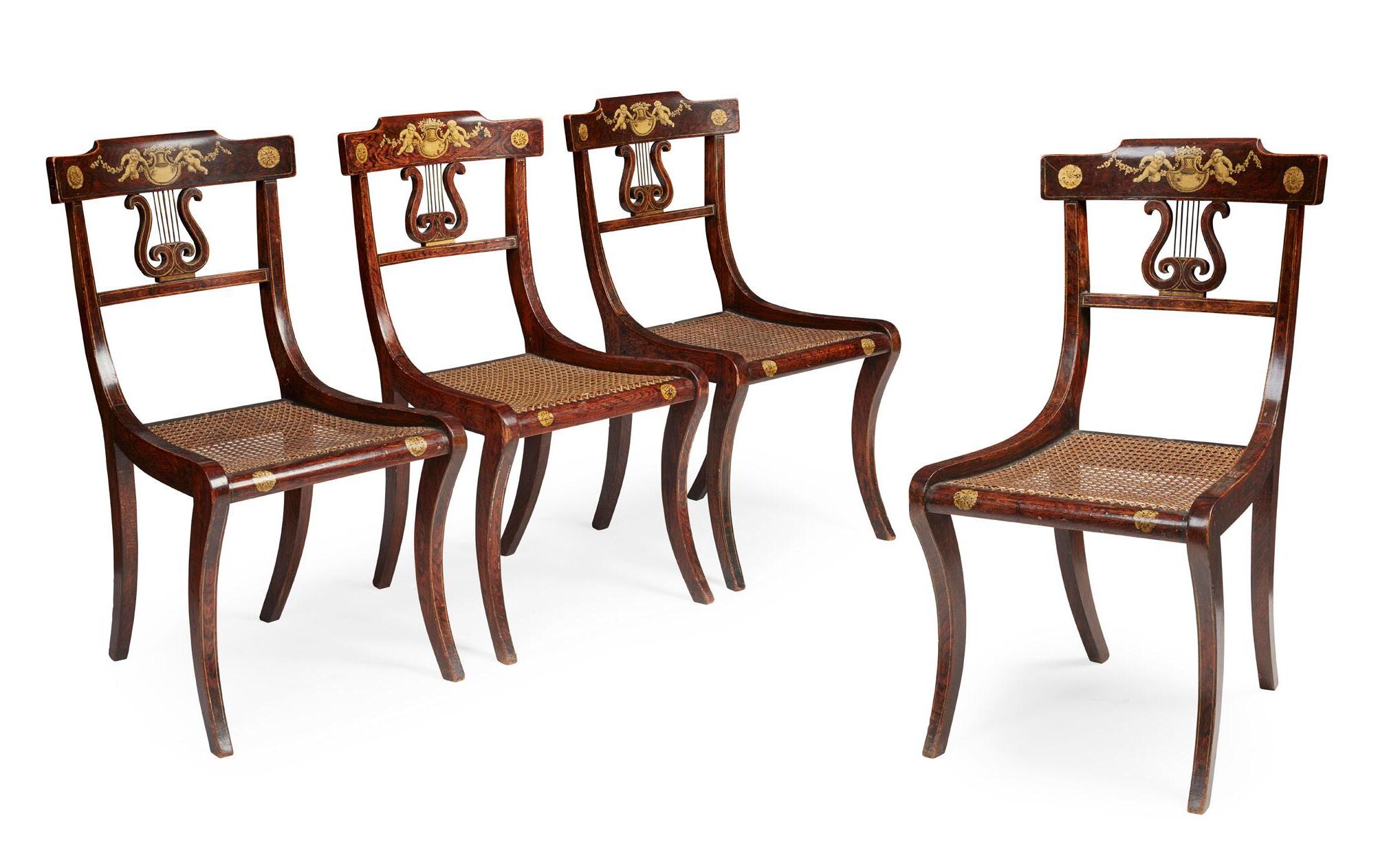
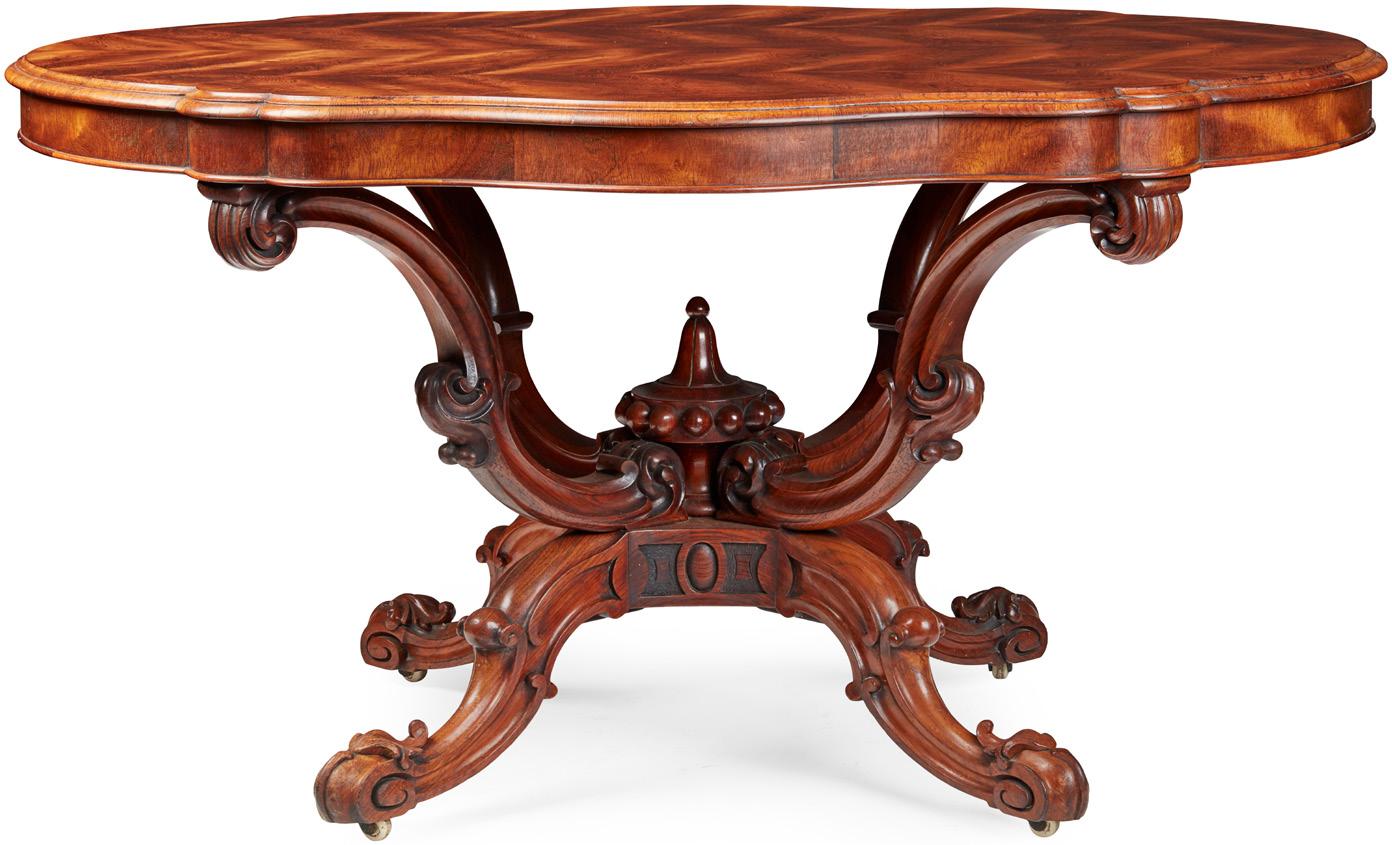

137cm wide, 73cm high, 104cm deep
£1,000-1,500
89
246
WILLIAM IV MAHOGANY LIBRARY ARMCHAIR
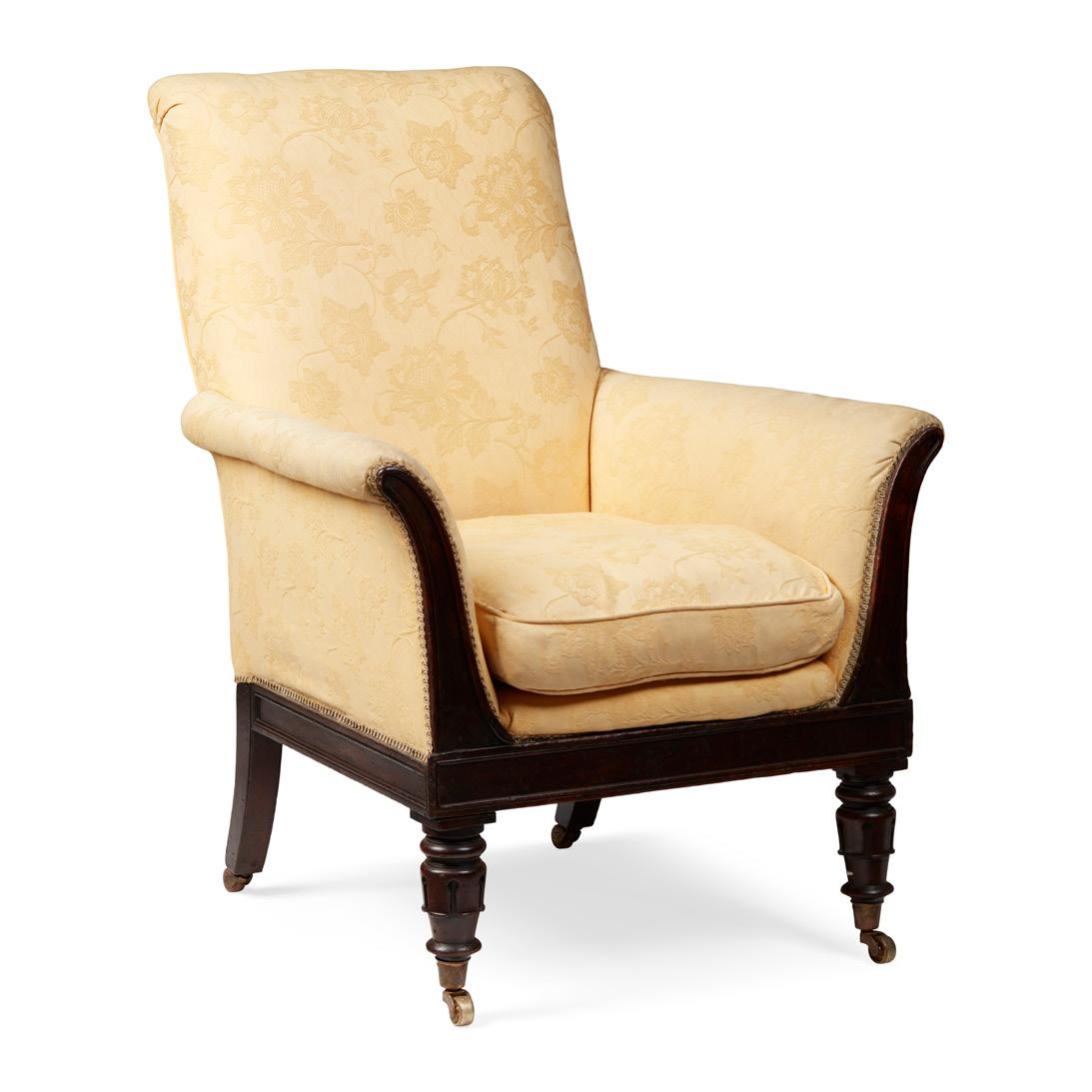
EARLY 19TH CENTURY
the tall scroll back above a deep loose cushion seat flanked by enclosed outscrolled arms, raised on lotus carved front legs with brass castors, the rear legs with ceramic castors
82cm wide, 110cm high, 60cm deep
£600-800
247
WILLIAM IV MAHOGANY CHIFFONIER
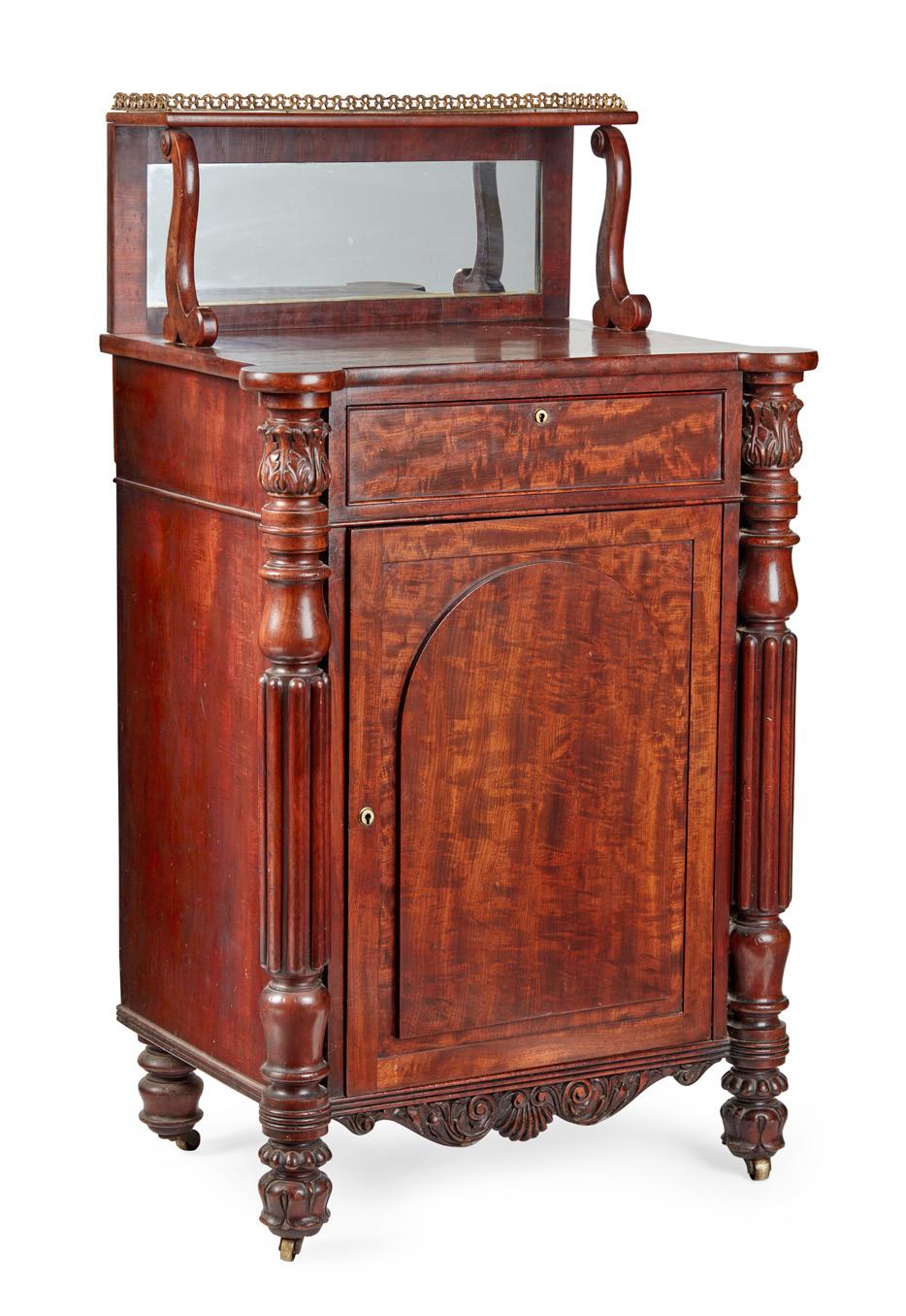
EARLY 19TH CENTURY
the mirror-backed superstructure with a pierced brass gallery and S scroll supports, above a long frieze drawer and arch panel door enclosing shelves, flanked by reeded outset corner columns carved with acanthus and lotus motifs, on brass castors
68cm wide, 119cm high, 50cm deep
Provenance: Private Scottish Collection, Morayshire
£400-600
248
WILLIAM IV MAHOGANY CHEST-ON-CHEST
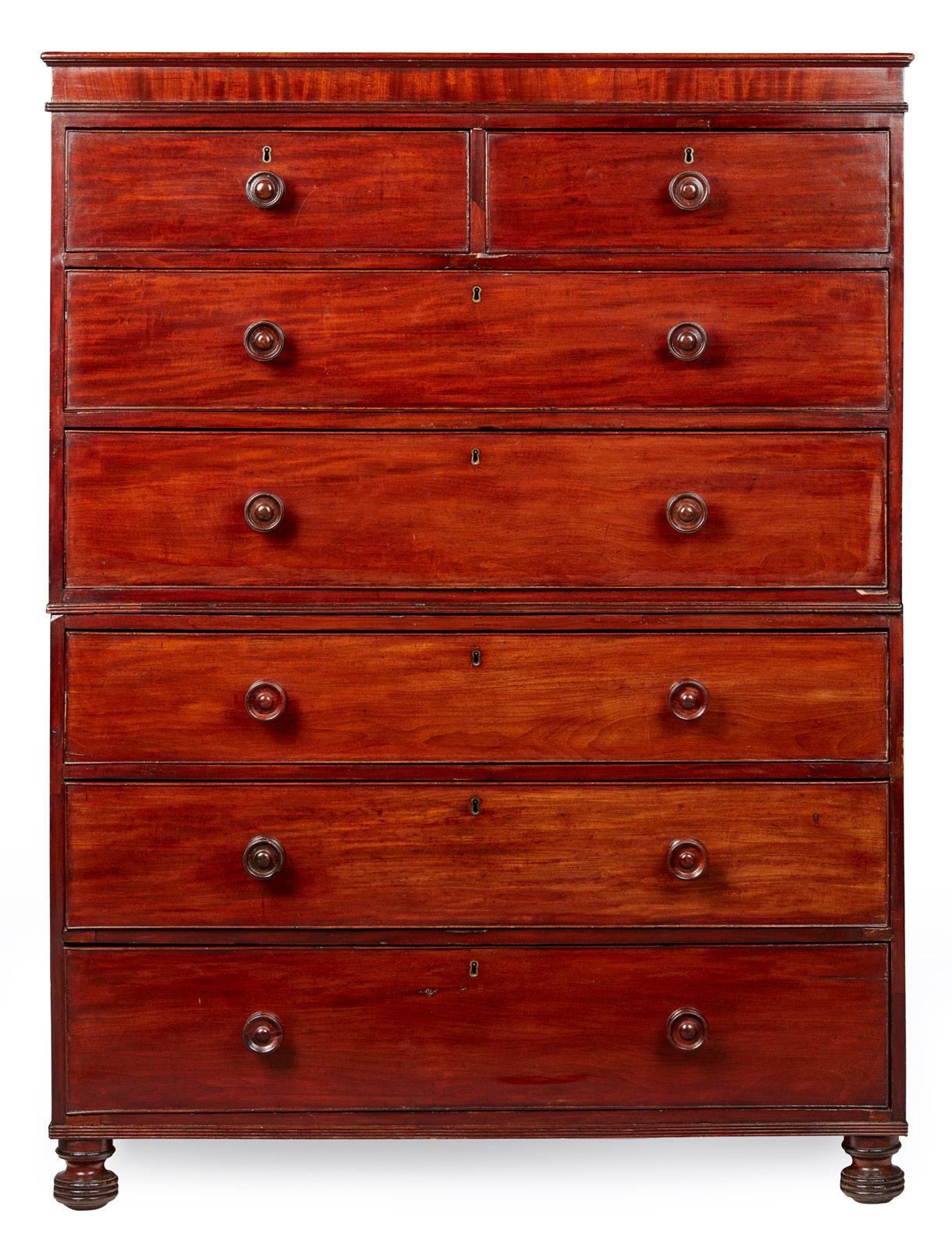
EARLY 19TH CENTURY
the top with two short over two long drawers, on a base with three further long graduated drawers, on turned feet
117cm wide, 154cm high, 51cm deep
£500-700
90
249
WILLIAM IV MAHOGANY TEAPOY
19TH CENTURY
of sarcophagus form with a gadrooned body, opening to two covered removable tea caddies, raised on a reeded baluster column on a lobed circular base with three scroll carved feet
45cm wide, 76cm high, 37cm deep
Provenance: Private Scottish Collection, Morayshire
£300-500
250
WILLIAM IV ANGLO-INDIAN PADOUK LIBRARY TABLE


EARLY 19TH CENTURY
the rectangular top with a gadrooned edge above two foliate carved frieze drawers and corner brackets, raised on leaf and paterae carved end supports joined by a lotus carved arched stretcher, on arched trestle bases carved with acanthus and raised on brass castors
135cm wide, 80cm high, 60cm deep
£1,500-2,500
251
LARGE WILLIAM IV MAHOGANY CENTRE TABLE
EARLY 19TH CENTURY
the circular tilt top with a moulded edge, on a lotus carved tapered column and concave tripartite base raised on scroll and lion paw feet with brass castors
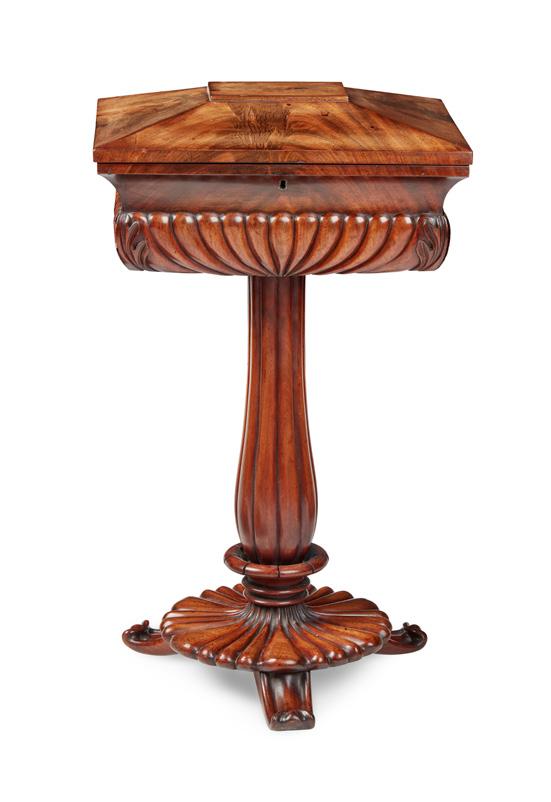
137cm diameter, 73cm high
£1,000-1,500
252
WILLIAM IV LEATHER UPHOLSTERED MAHOGANY LIBRARY ARMCHAIR
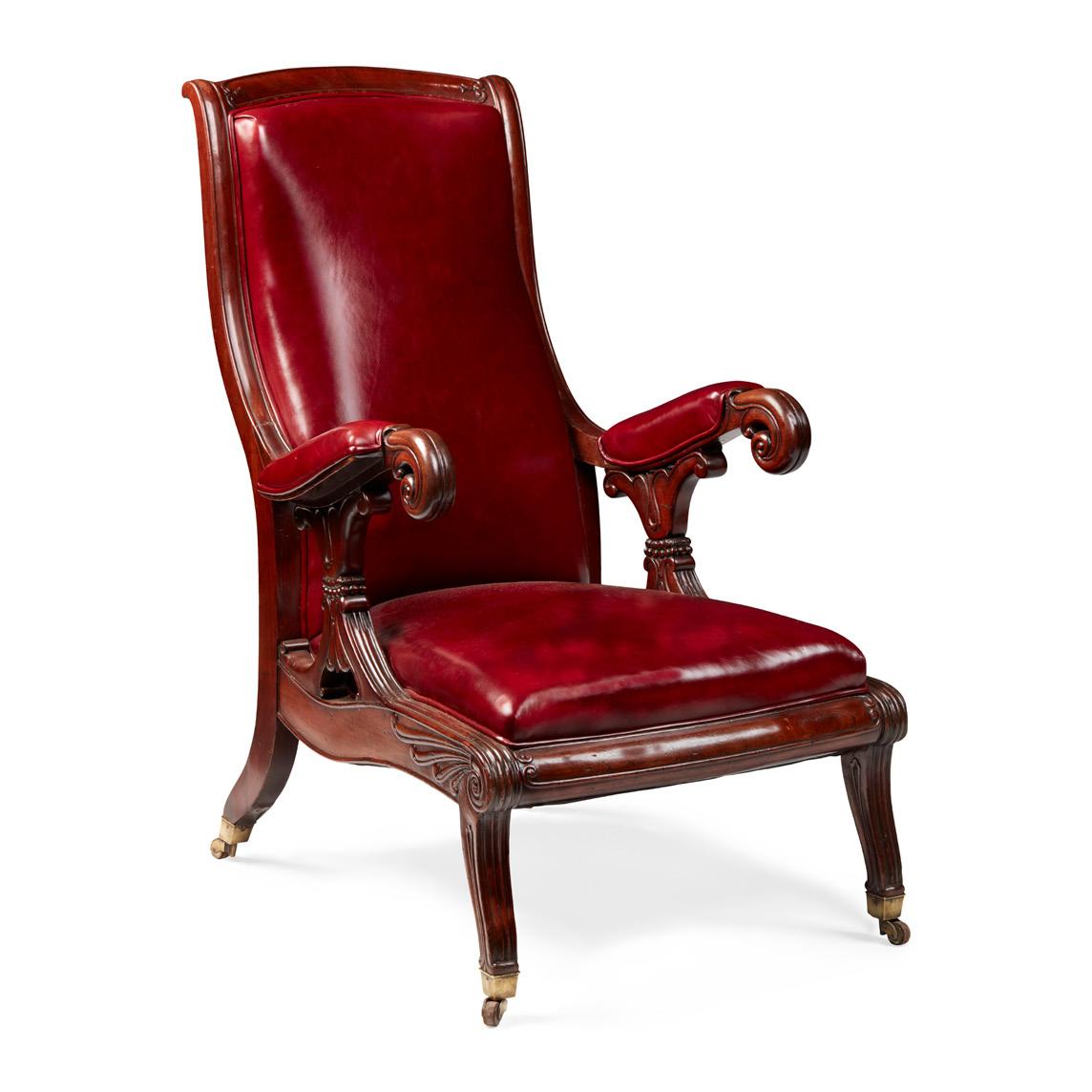
EARLY 19TH CENTURY
the curved padded back above a deep seat flanked by part-padded open arms with lotus carved supports and ending in lotus carved scrolled terminals, on reeded scrolling legs with brass caps and castors, covered in oxblood red leather 64cm wide, 105cm wide, 57cm deep
£1,800-2,200
91 Other fees apply in addition to the hammer price: see the ‘Buyer’s Guide’ section on page 2
Note: The firm of Mack, Williams and Gibton were established at 39 Stafford Street, Dublin and were appointed Upholsterers & Cabinet Makers to his Majesty, His Excellency the Lord Lieutenant and His Majesty’s Board of Works. The firm is recognised for the high quality of their workmanship and were compared in quality to their English contemporary, Gillows
255
IRISH WILLIAM IV BREAKFAST
TABLE, BY WILLIAMS & GIBTON, DUBLIN
EARLY 19TH CENTURY
the circular tilt top on a lappet carved tapered column and concave tripartite base raised on carved bun feet with brass castors, makers stamp and numbered 44245
123cm diameter, 76cm high
£500-700
253
WILLIAM IV CARVED MAHOGANY LIBRARY CHAIR
MID 19TH CENTURY
the scrolling acanthus carved back rail above a tapestry upholstered back and seat, raised on acanthus carved scrolling front legs and sabre back legs, with brass castors
47cm wide, 80cm high, 54cm deep
£300-500
256
WILLIAM IV SIMULATED ROSEWOOD BERGÈRE, BY GILLOWS
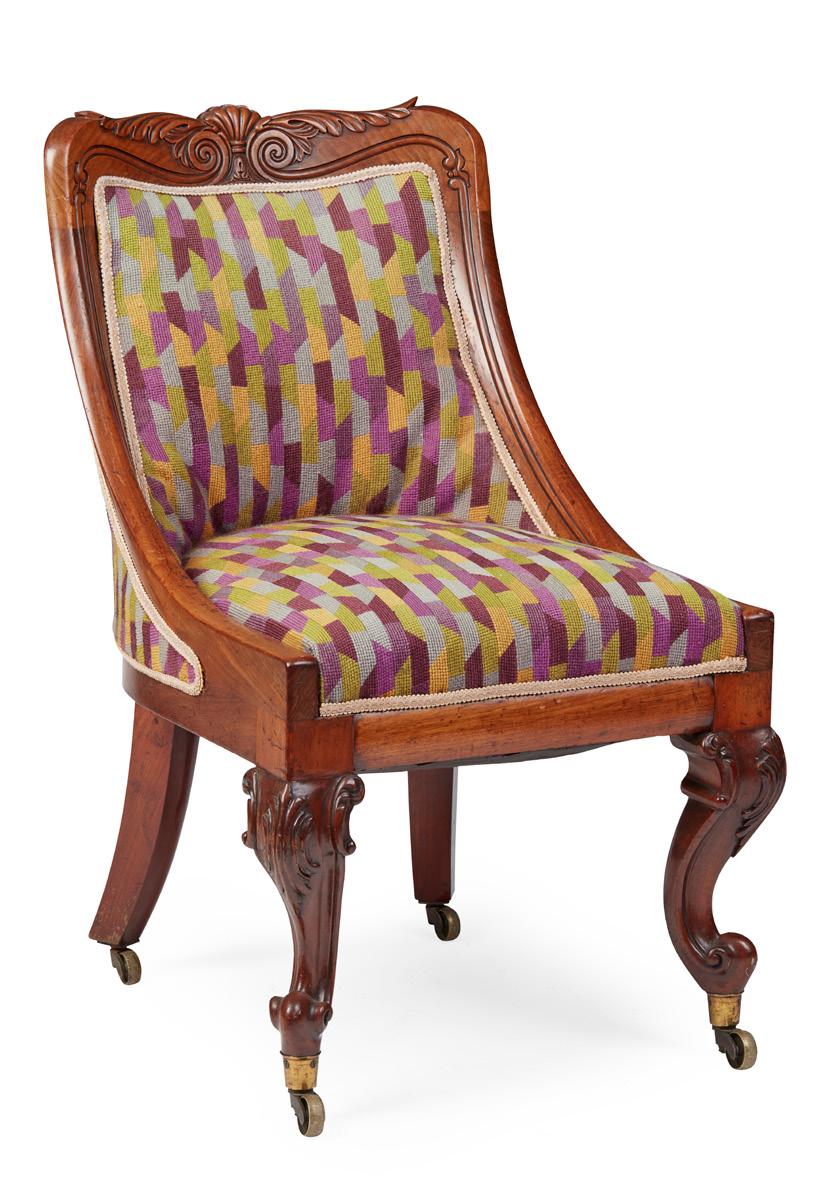
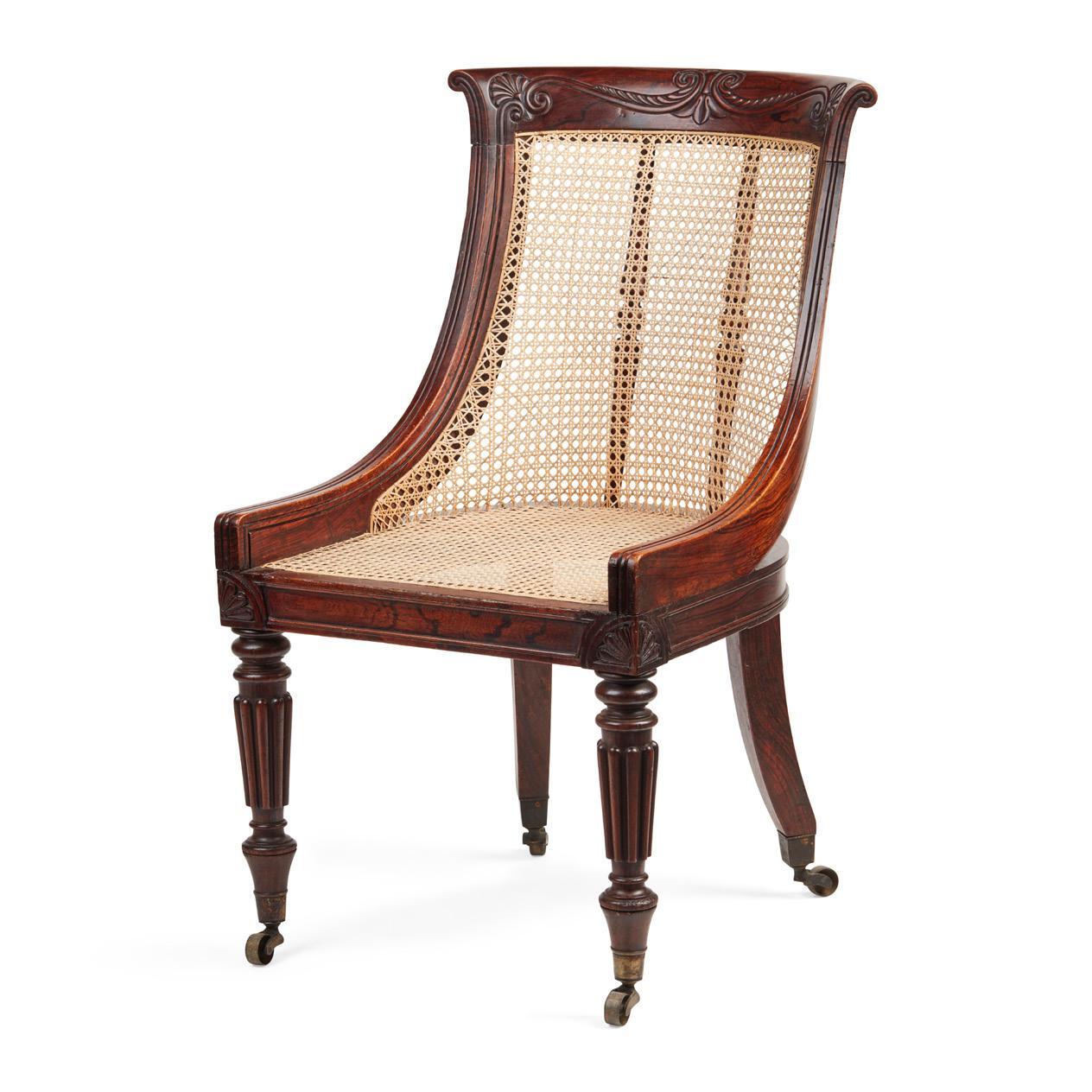
EARLY 19TH CENTURY
the curved back with a scroll and palmette carved top rail above a caned back and seat, raised on reeded tapered legs ending in brass caps and castors, stamped on the seat rail GILLOWS.LANCASTER
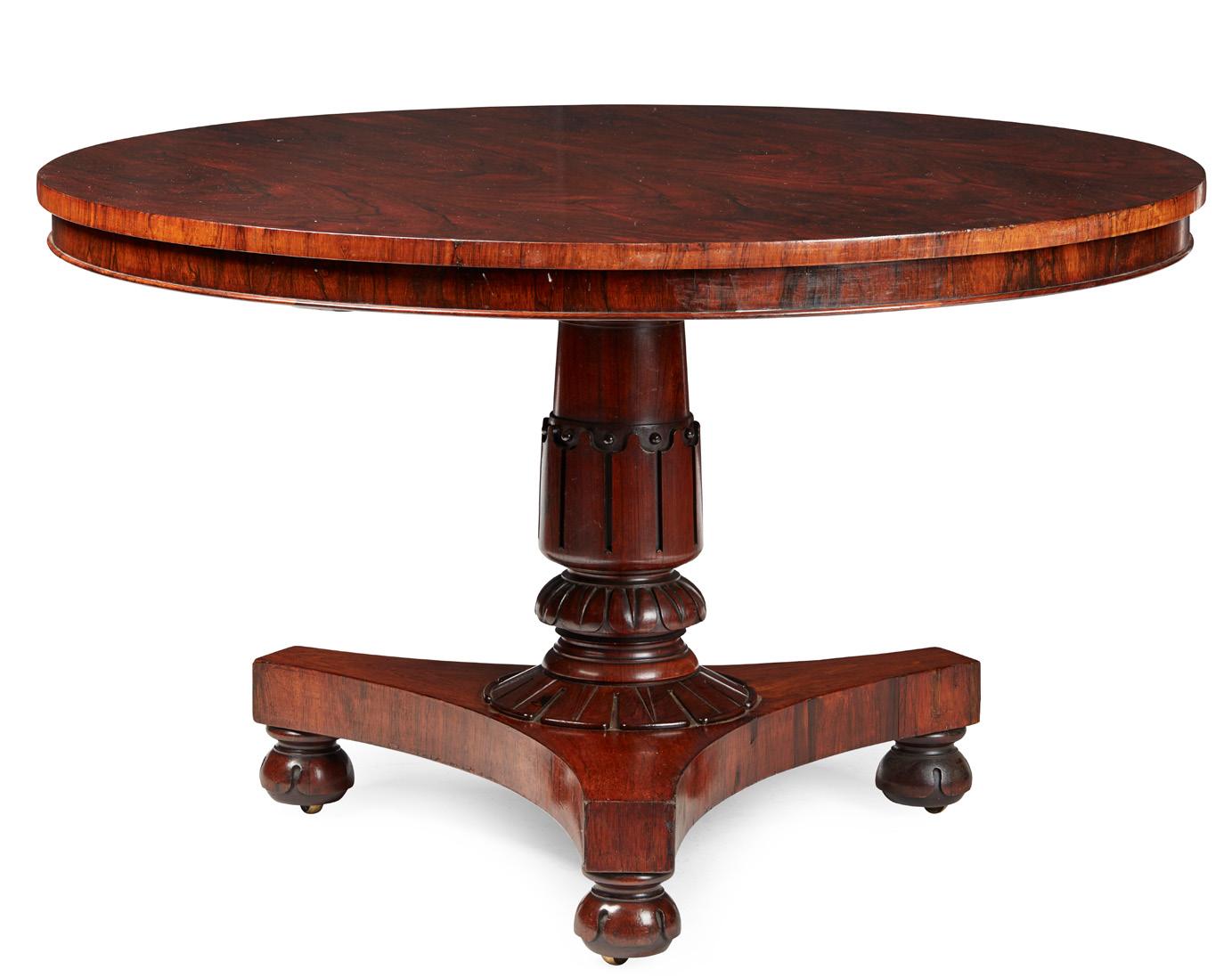
49cm wide, 86cm high, 46cm deep
£400-600
254
WILLIAM IV MAHOGANY HALL BENCH, IN THE MANNER OF GILLOWS
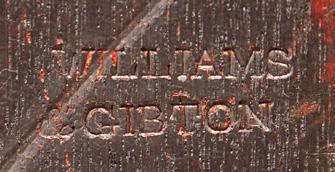


EARLY 19TH CENTURY
the long plank seat with cylinder bolster ends, raised on reeded tapered baluster legs 107cm wide, 52cm high, 32cm deep
£800-1,200
92
257 Y
WILLIAM IV ROSEWOOD TEAPOY

19TH CENTURY
of sarcophagus form with canted corners, the hinged cover outlined with bead moulding, opening to a void interior, raised on a reeded and turned baluster support and quadripartite base, on scroll carved feet with brass castors
49cm wide, 74cm high, 36cm deep
Provenance: Private Scottish Collection, Morayshire
£300-500
258 Y
WILLIAM IV ROSEWOOD, BRASS, AND PORCELAIN MOUNTED MARBLE TOPPED CREDENZA

EARLY 19TH CENTURY
the superstructure with a pierced brass gallery and bead moulding above a central mirror plate flanked by shelved compartments, flanked and divided by gilt metal columns and trellis supports; on a breakfront base with a white marble top over three frieze drawers with Sèvres style porcelain mounts, over mirrored doors enclosing shelves, all flanked and divided by spiral turned columns, on a bead moulded plinth base
186cm wide, 166cm high, 45cm deep
£2,500-3,500
93 Other fees apply in addition to the hammer price: see the ‘Buyer’s Guide’ section on page 2
259 Y
WILLIAM IV BURR WALNUT, MAHOGANY, AND EBONISED TEAPOY
EARLY 19TH CENTURY
of sarcophagus form outlined with bead moulding, opening to an interior with four hinged caddies with ivory knobs and glass waste bowls, above a base drawer, raised on a tapered square support with further bead moulding, on a concave quadripartite base on scrolled fan feet with brass castors 50cm wide, 79.5cm high, 37cm deep
Note: Sold in compliance with UK Government and APHA regulations, with (non-transferable) exemption registration reference HZF2YX4Y
£300-500
260
WILLIAM IV POLLARD OAK PEDESTAL TABLE
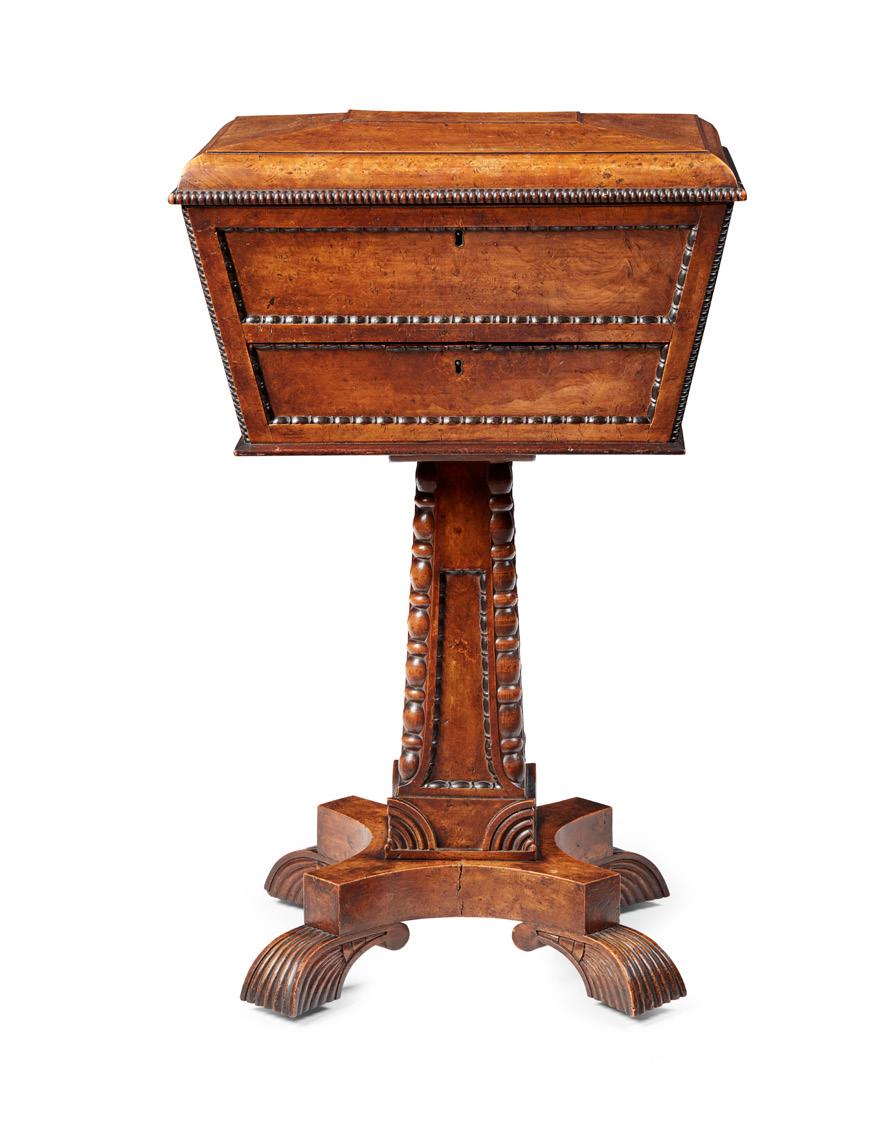
EARLY 19TH CENTURY
the circular tilt top on a faceted column and concave tripartite base on bun feet with ceramic castors
63cm diameter, 75cm high
£1,200-1,800
261 Y
WILLIAM IV ROSEWOOD BRASS
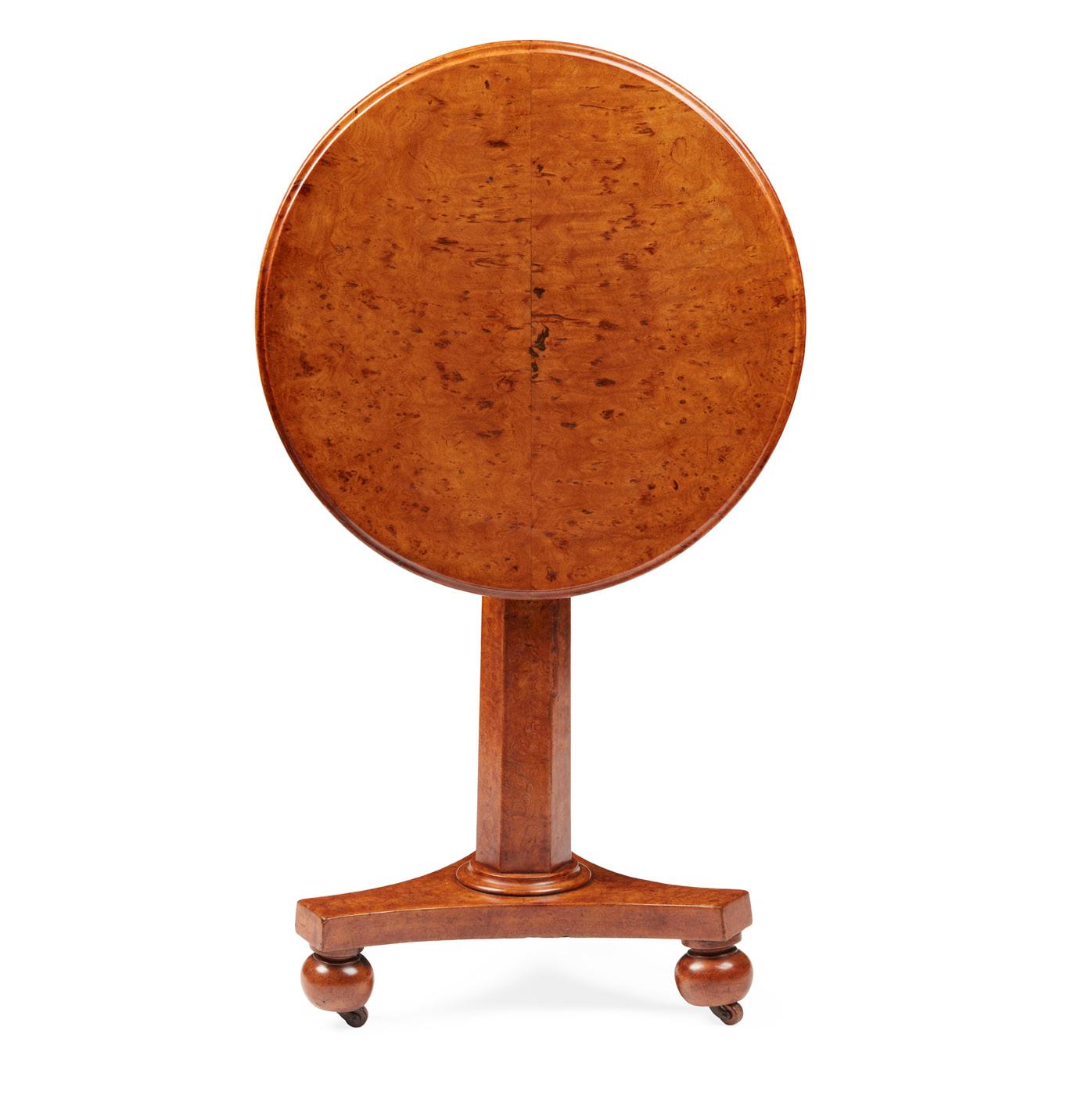
MOUNTED LIBRARY TABLE

EARLY 19TH CENTURY
the rounded rectangular top with a reeded edge and green tooled leather insert, above a pair of short frieze drawers with dummy drawers on the reverse, all outlined with brass moulding, raised on end supports with trestle bases and scrolled feet with gilt brass mounts and castors
122cm wide, 72cm high, 66cm deep
£2,000-3,000
94 Other fees apply in addition to the hammer price: see the ‘Buyer’s Guide’ section on page 2
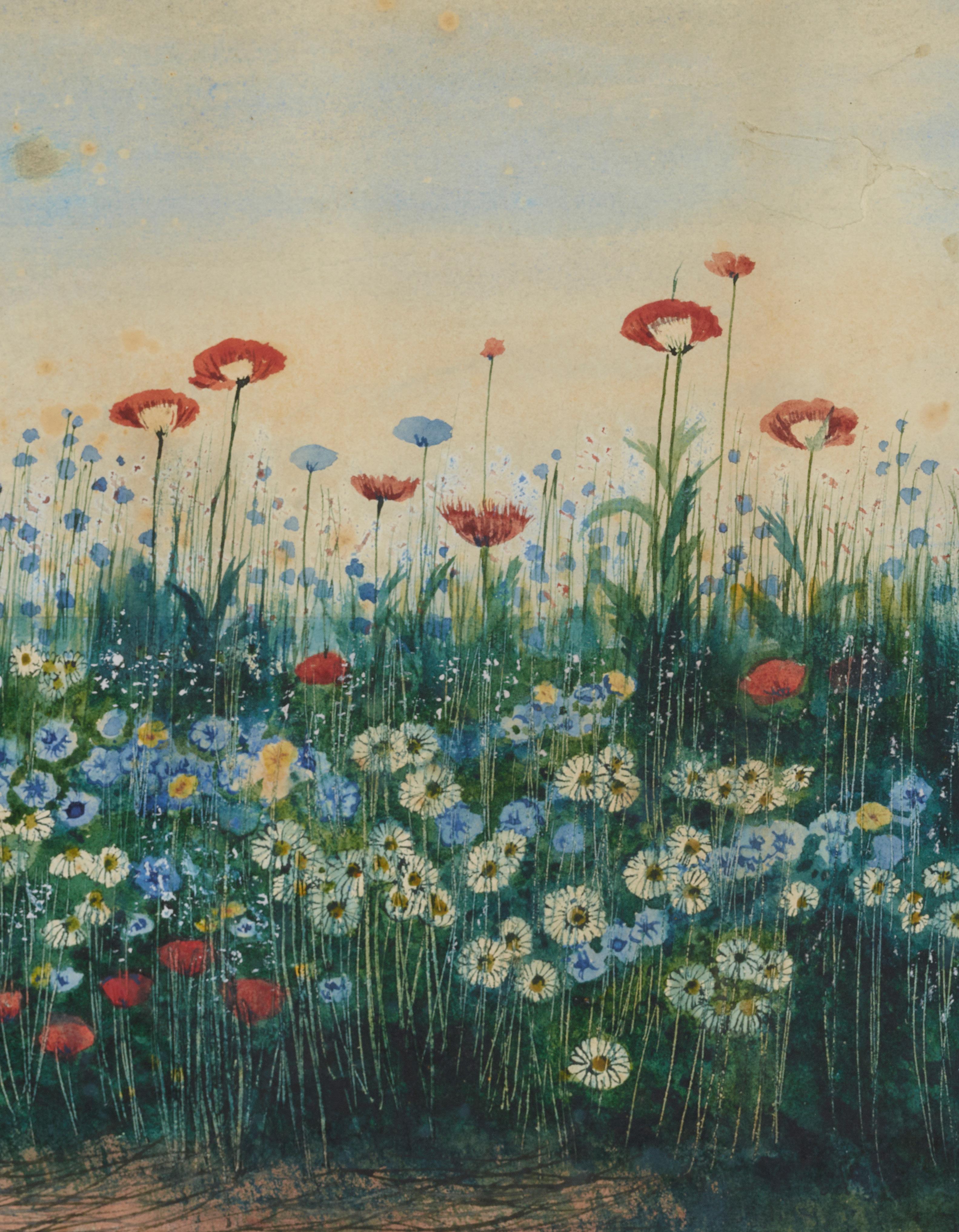
PAINTINGS PART II
263
THOMAS CRESWICK
R.A. (BRITISH 1811-1869)
THE YOUNG ANGLER
Inscribed on a contemporary label to stretcher, oil on canvas
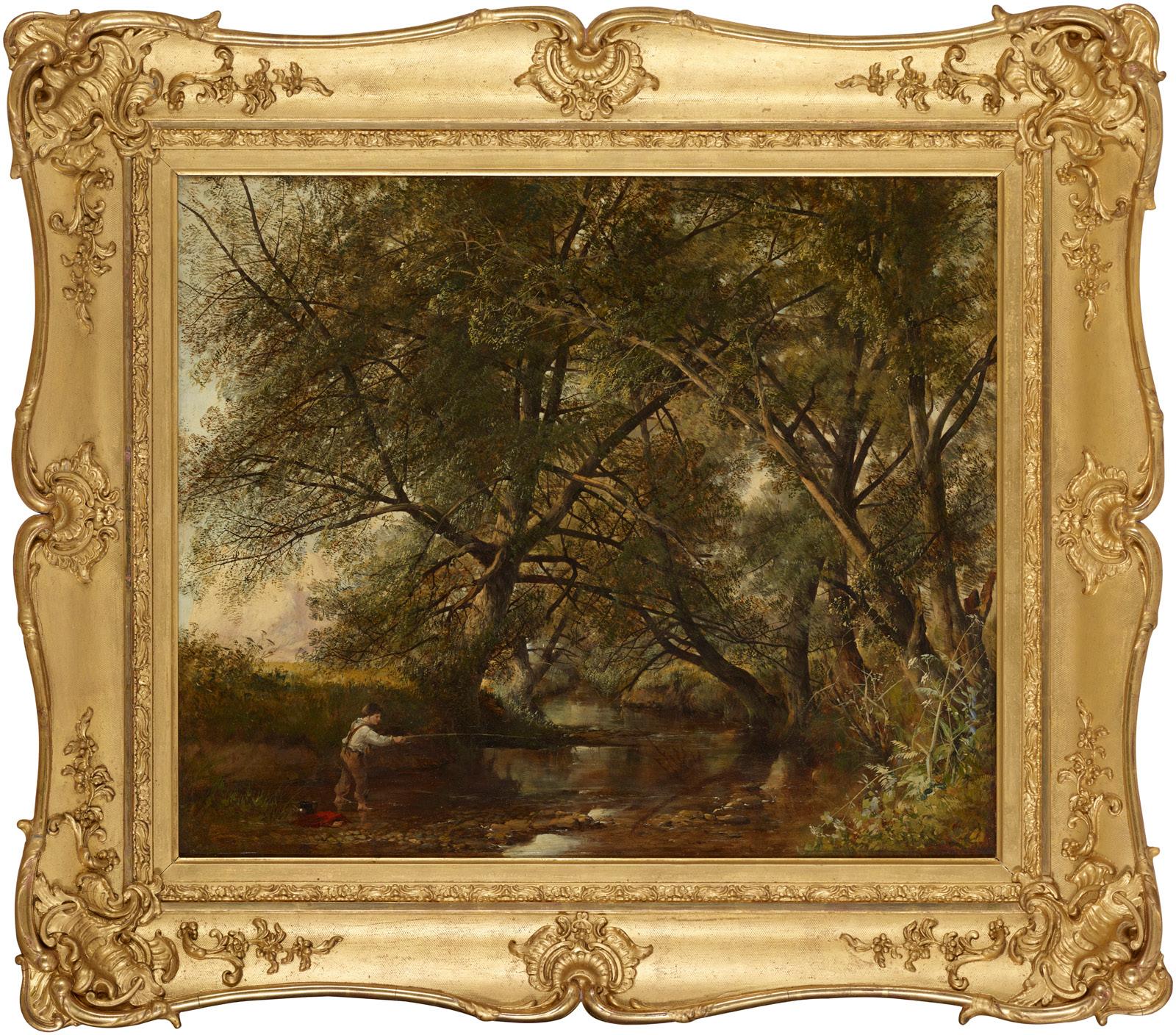
63.5cm x 76cm (25in x 30in)
£700-1,000
262
MANNER OF ALEXANDER NASMYTH BARSKIMMING BRIDGE

Oval, oil on canvas
61cm x 74cm (24in x 29in)
£800-1,200
96
264
GEORGE PAUL CHALMERS R.S.A., R.S.W. (SCOTTISH 1833-1878)
THE FISHING PARTY
Oil on canvas 59cm x 105.5cm (23.25in x 41.5in)
Provenance: Sotheby’s Gleneagles, Scottish & Sporting Pictures & Sculpture, 28 August 2002, lot 888 as ‘Anglers on a Loch’, where acquired by the present owner’s father £800-1,200
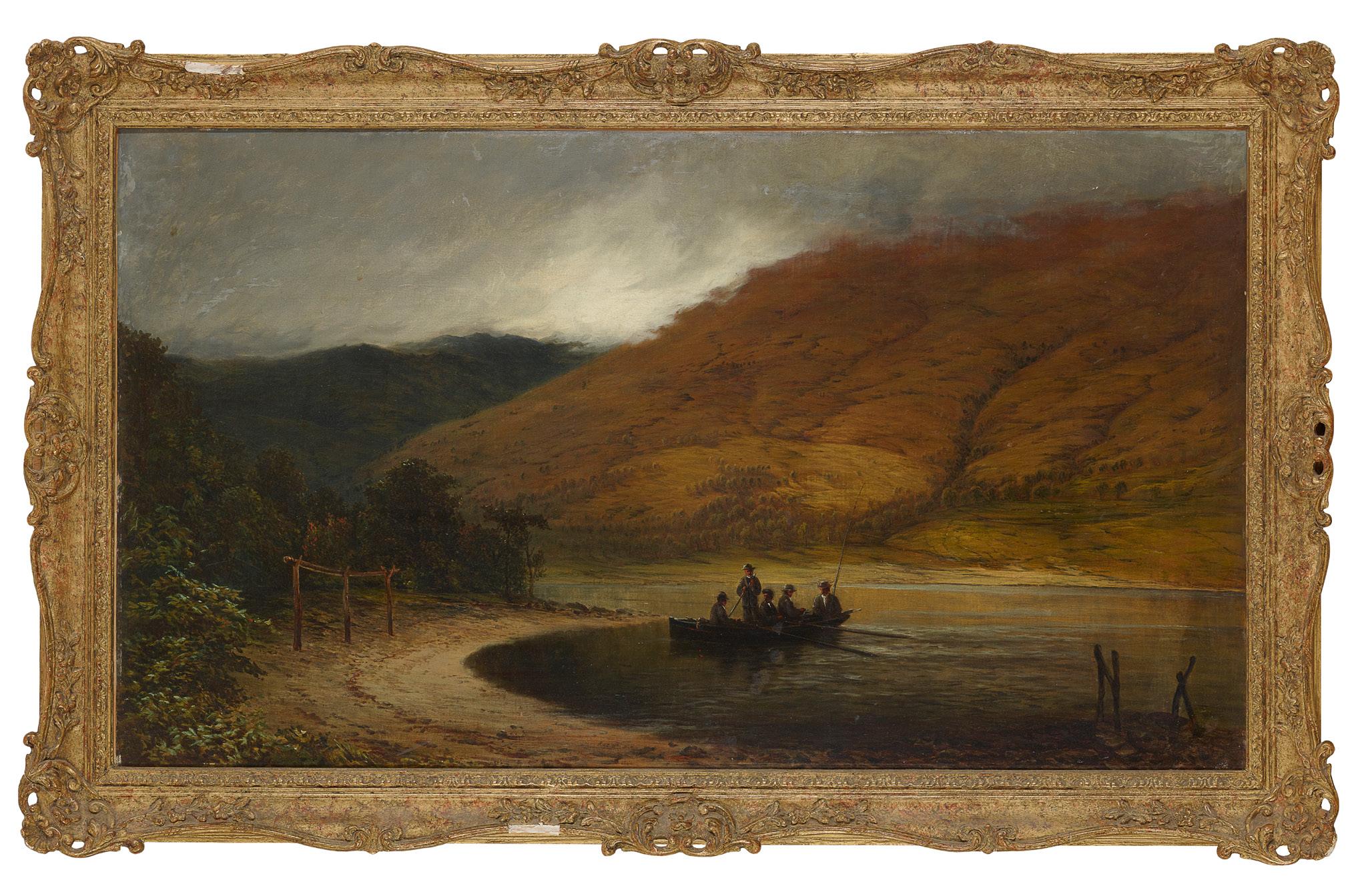
265
FREDERICK HENRY
HENSHAW (1807-1891)
FISHING FOR TIDDLERS
With contemporary label on the stretcher verso, oil on canvas
53.5cm x 76cm (21in x 30in)
Provenance: The Henshaw Collection, May 12, 1892, lot 118 £600-800
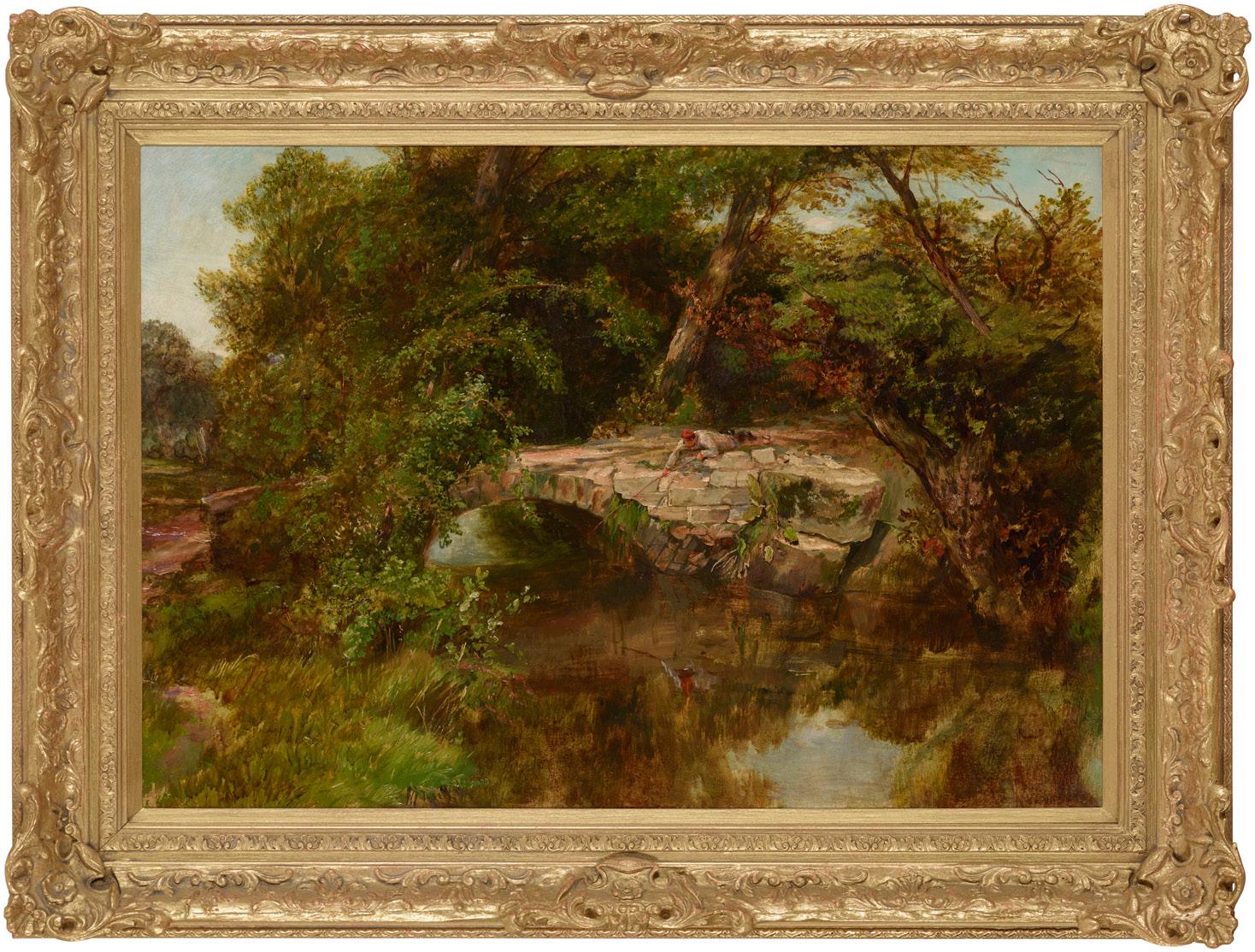
97 Other fees apply in addition to the hammer price: see the ‘Buyer’s Guide’ section on page 2
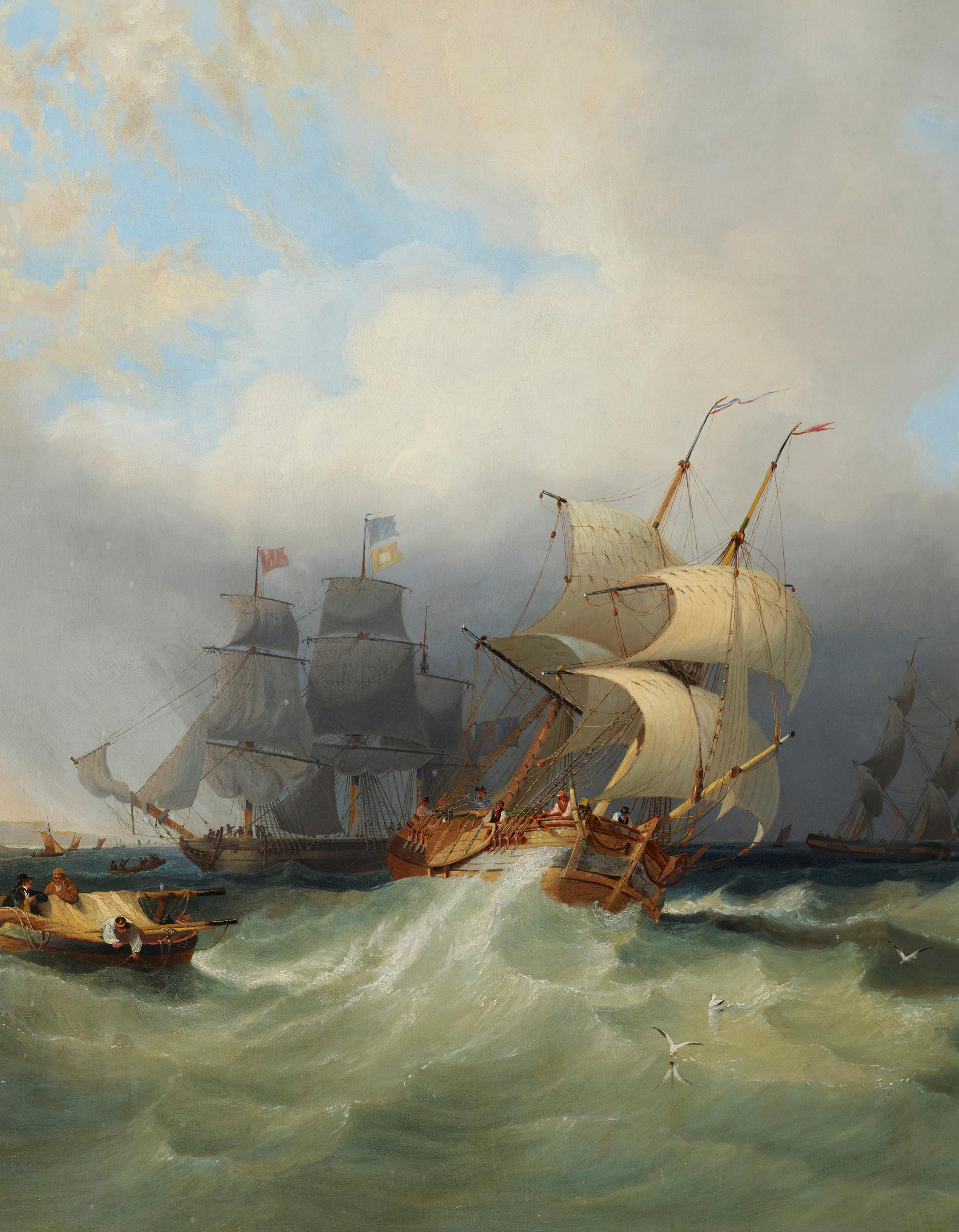
98 Other fees apply in addition to the hammer price: see the ‘Buyer’s Guide’ section on page 2
268
ANDREW NICHOLL R.H.A. (IRISH 1804-1886)
WILDFLOWER MEADOW
Signed lower left, watercolour
29.5cm x 46cm (11.75in x 18in)
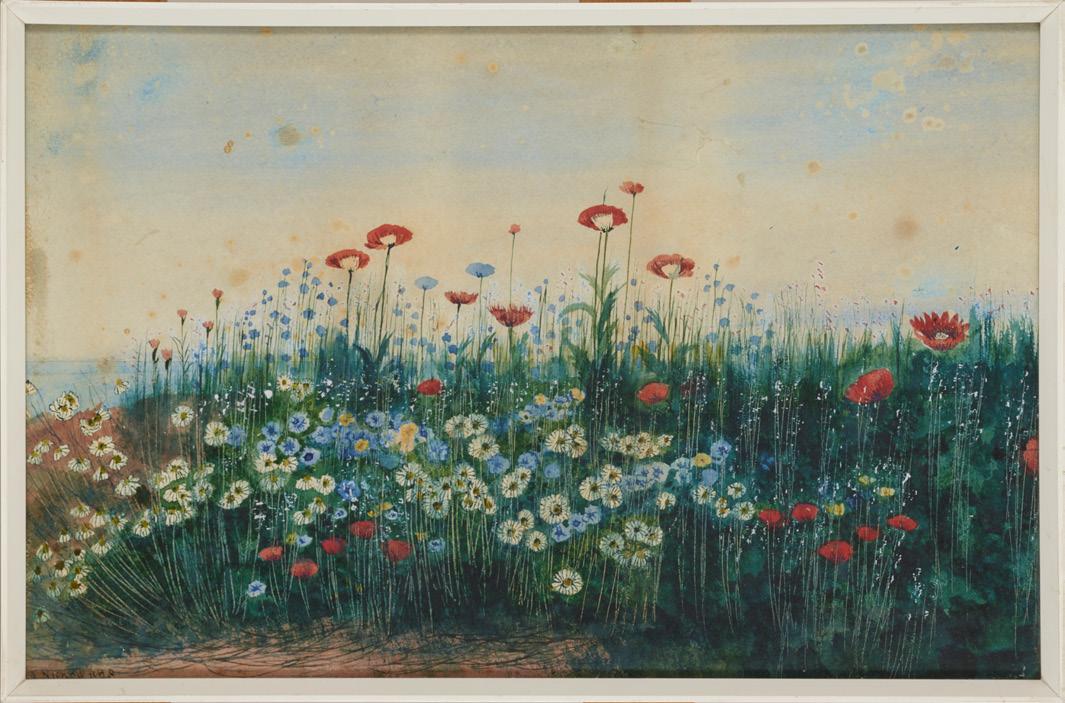

£700-1,000
267
WILLIAM OLIVER (BRITISH 1804-1853)
PERUGIA
Signed, inscribed on contemporary label verso, oil on canvas (1) 28cm x 36cm (11in x 14in)
£500-800
266
JOHN WILSON CARMICHAEL (BRITISH 1800-1868) OFF THE HARBOUR BREAKWATER
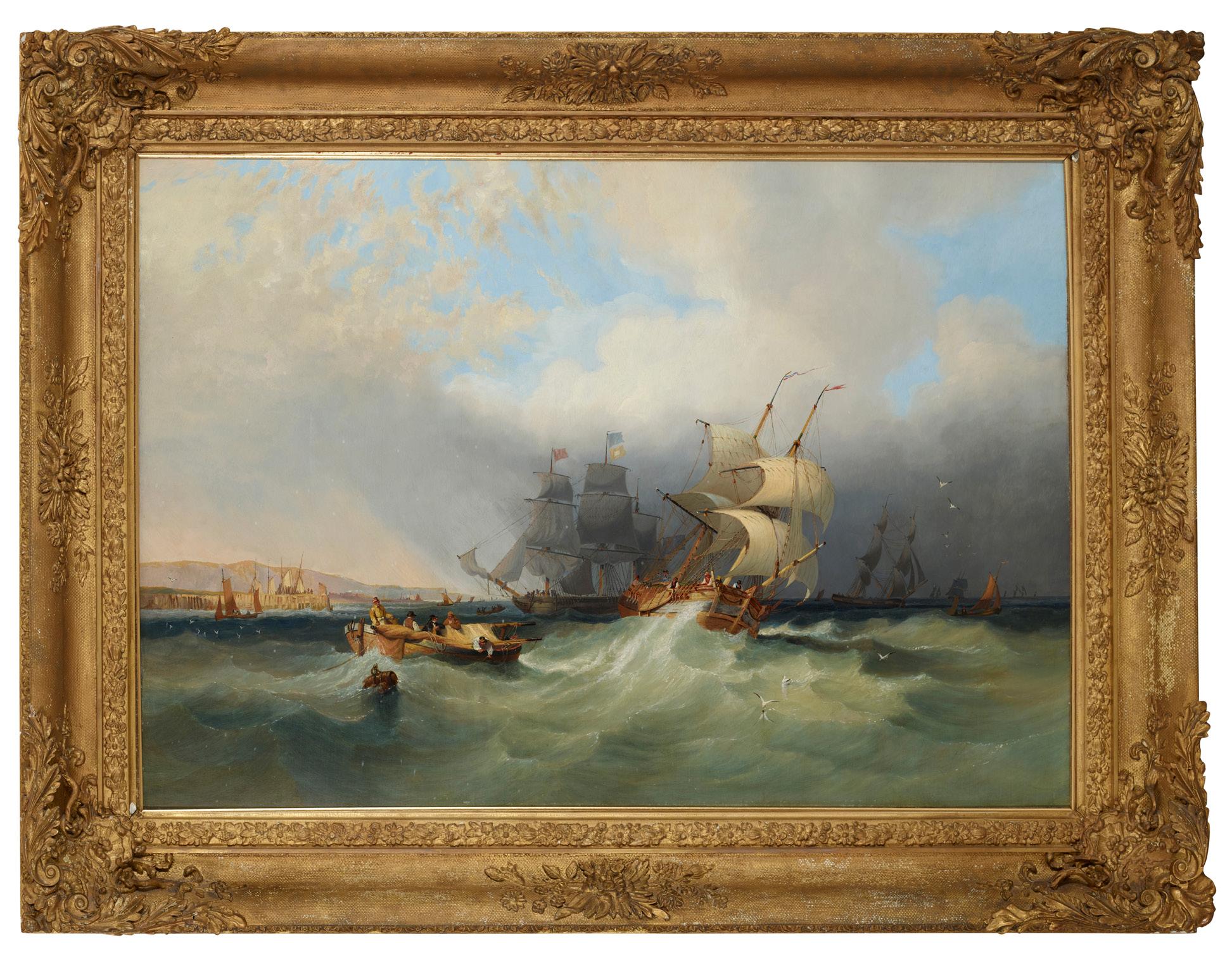
With initials ‘J.C.’ to barrel, oil on canvas 82cm x 120cm (32.25in x 47.25in)
£10,000-15,000
99 Other fees apply in addition to the hammer price: see the ‘Buyer’s Guide’ section on page 2
269
EDWARD PRITCHETT (BRITISH 1807-1876)
ST. MARKS SQUARE AND THE CAMPANILE VENICE
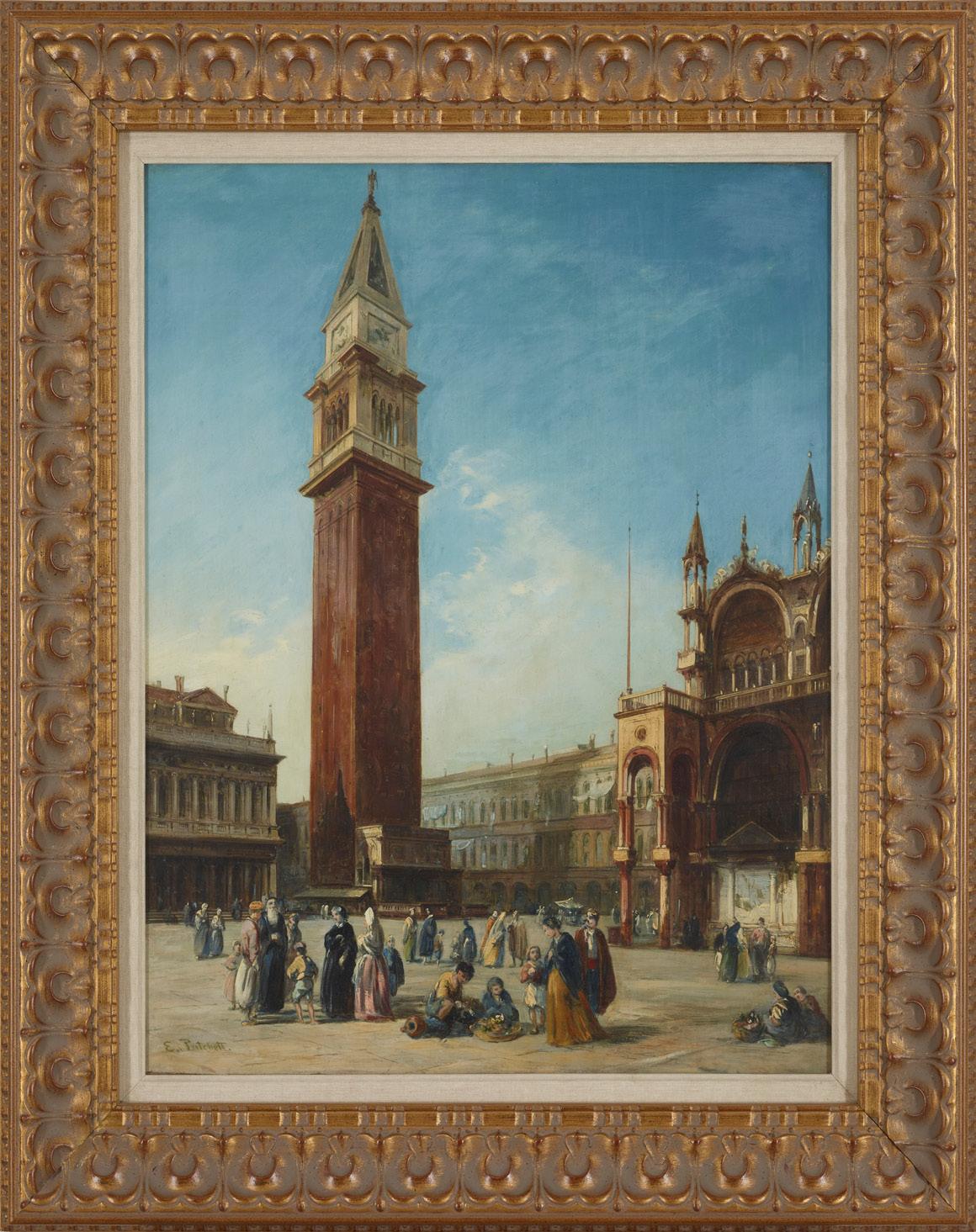
Signed, oil on canvas
61cm x 51cm (24in x 20in)
Provenance: Frost & Reed, London, 7697
£2,000-3,000
270
GEORGE F. BUCHANAN (SCOTTISH FL.1848-1864)
A DESERTED HIGHLAND LOCH
Signed and dated 1858, oil on canvas

80cm x 131cm (31.5in x 51.25in)
£600-800
100
271
JAMES WEBB (BRITISH 1825-1895)
THE FERRY
Signed and dated 1870, oil on canvas 94cm x 86cm (37in x 33.75in)
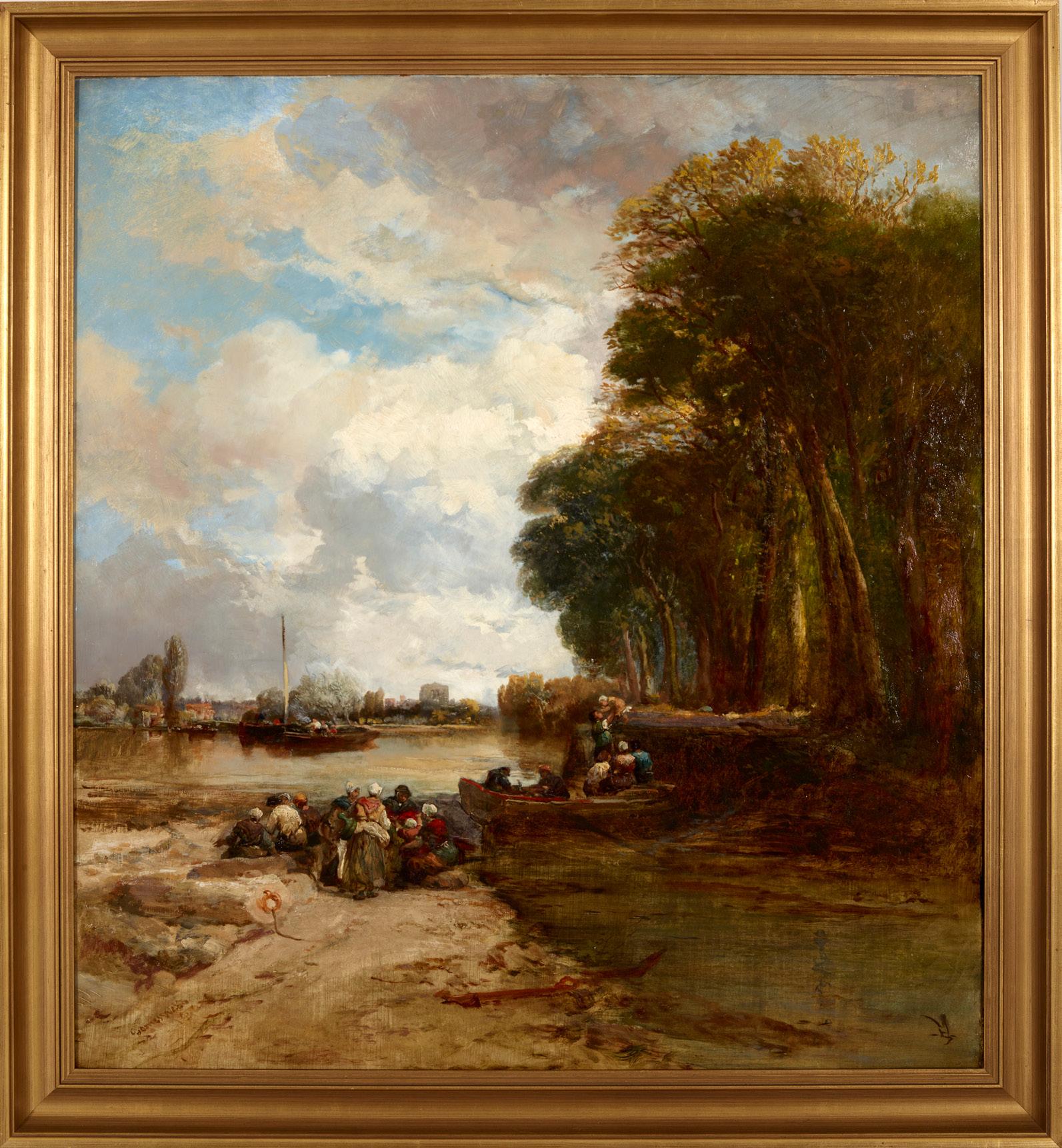
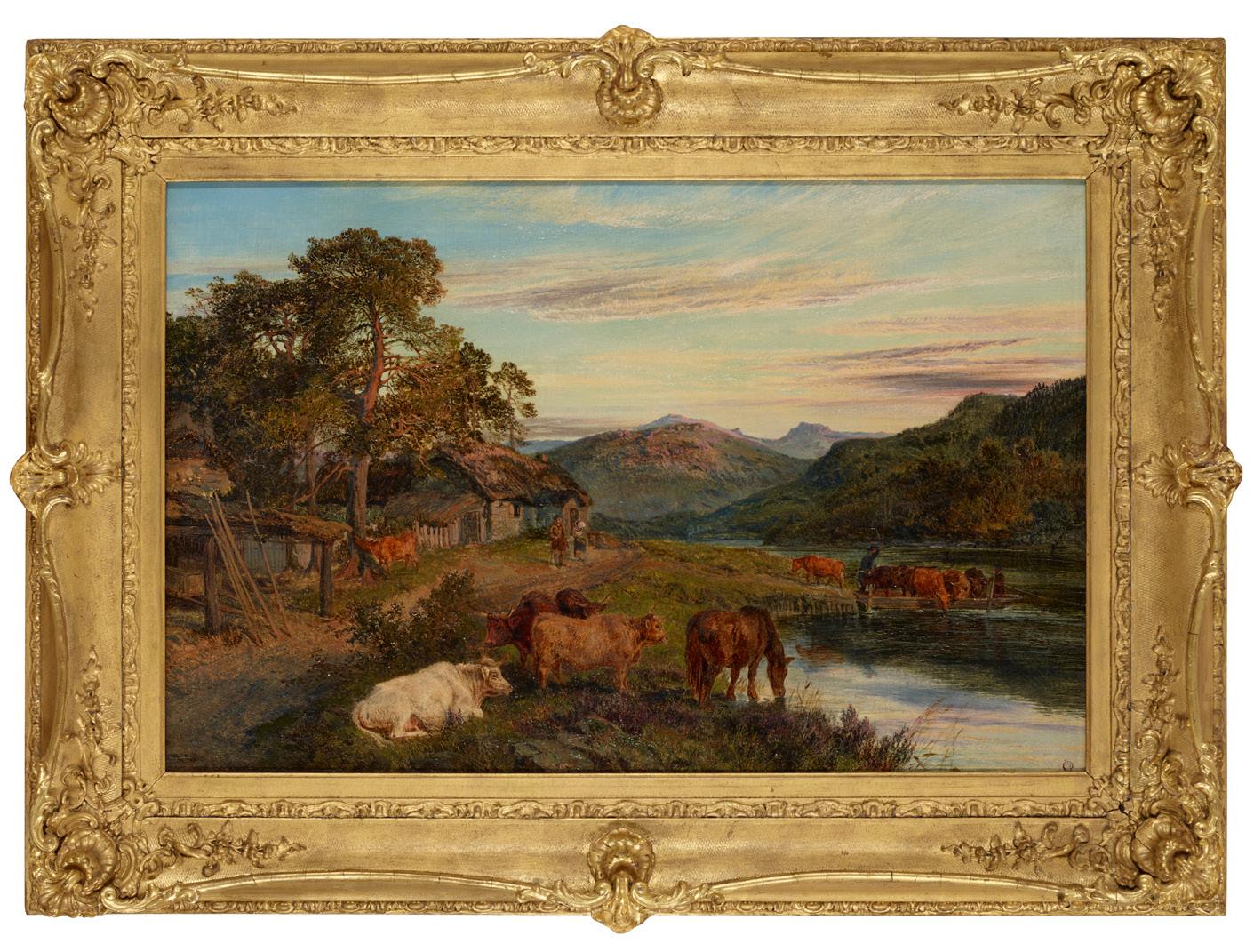
£1,500-2,000
272
HENRY MOORE (BRITISH 1831-1895)
A HIGHLAND FERRY
Signed with the monogram and dated 1861, oil on canvas 46cm x 71cm (18in x 28in)
£700-1,000
101 Other fees apply in addition to the hammer price: see the ‘Buyer’s Guide’ section on page 2

273 DAVID COX (BRITISH 1783-1859)
THE EEL CATCHER
Signed and dated 1841, oil on canvas
71cm x 102cm (28in x 40in) £2,000-3,000
274
JAMES FRANCIS DICKSEE
R.A. (BRITISH 1819-1895)
BUBBLES
Signed with initials and dated 1869, titled with contemporary label verso, oil on canvas
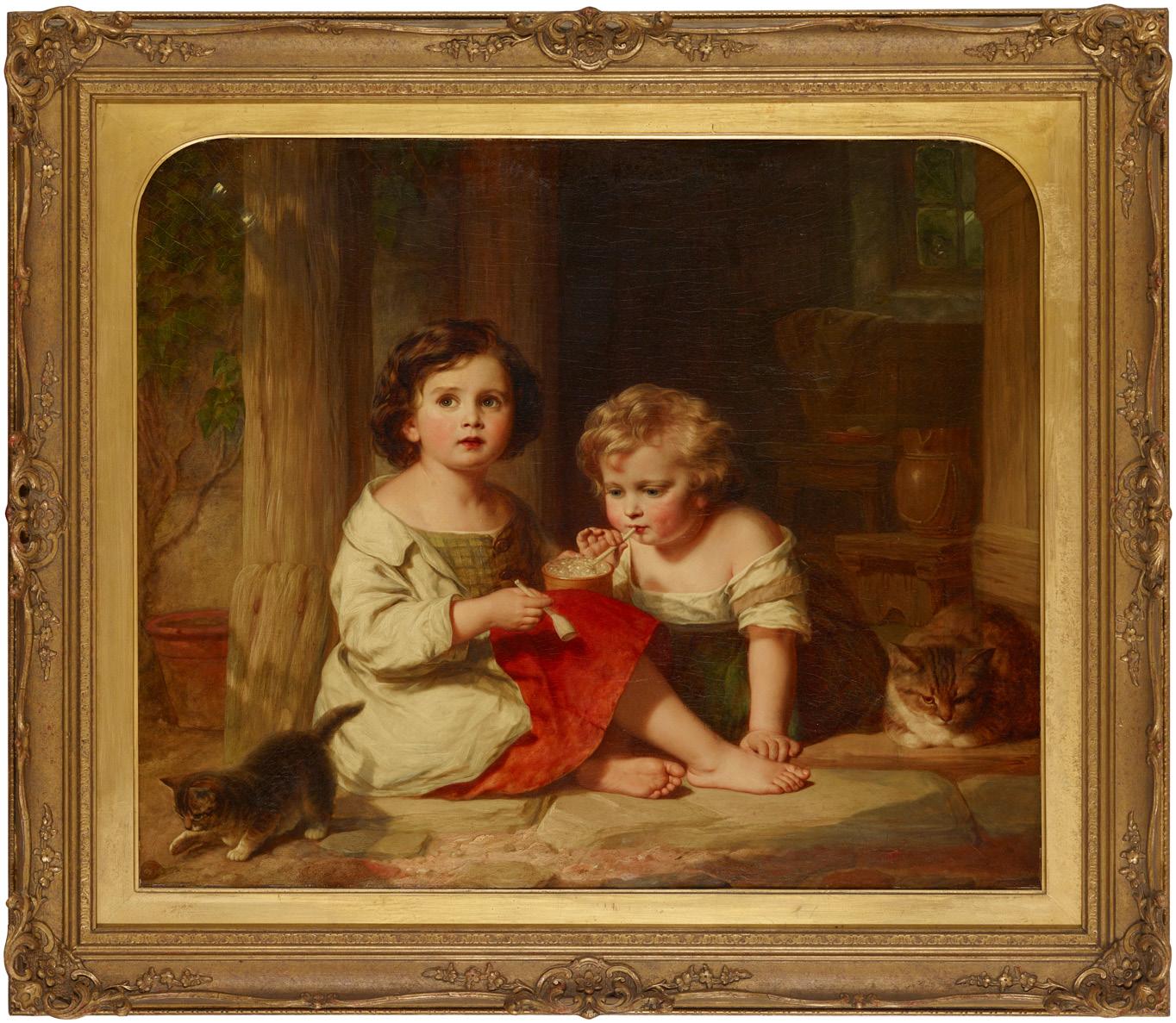

63.5cm x 76cm (25in x 30in)
£3,000-5,000
103 Other fees apply in addition to the hammer price: see the ‘Buyer’s Guide’ section on page 2
275
H. MORIS (19TH CENTURY BRITISH)
SHIPPING OFF THE SOUTH COAST
Signed and dated 1879, oil on canvas laid down on board
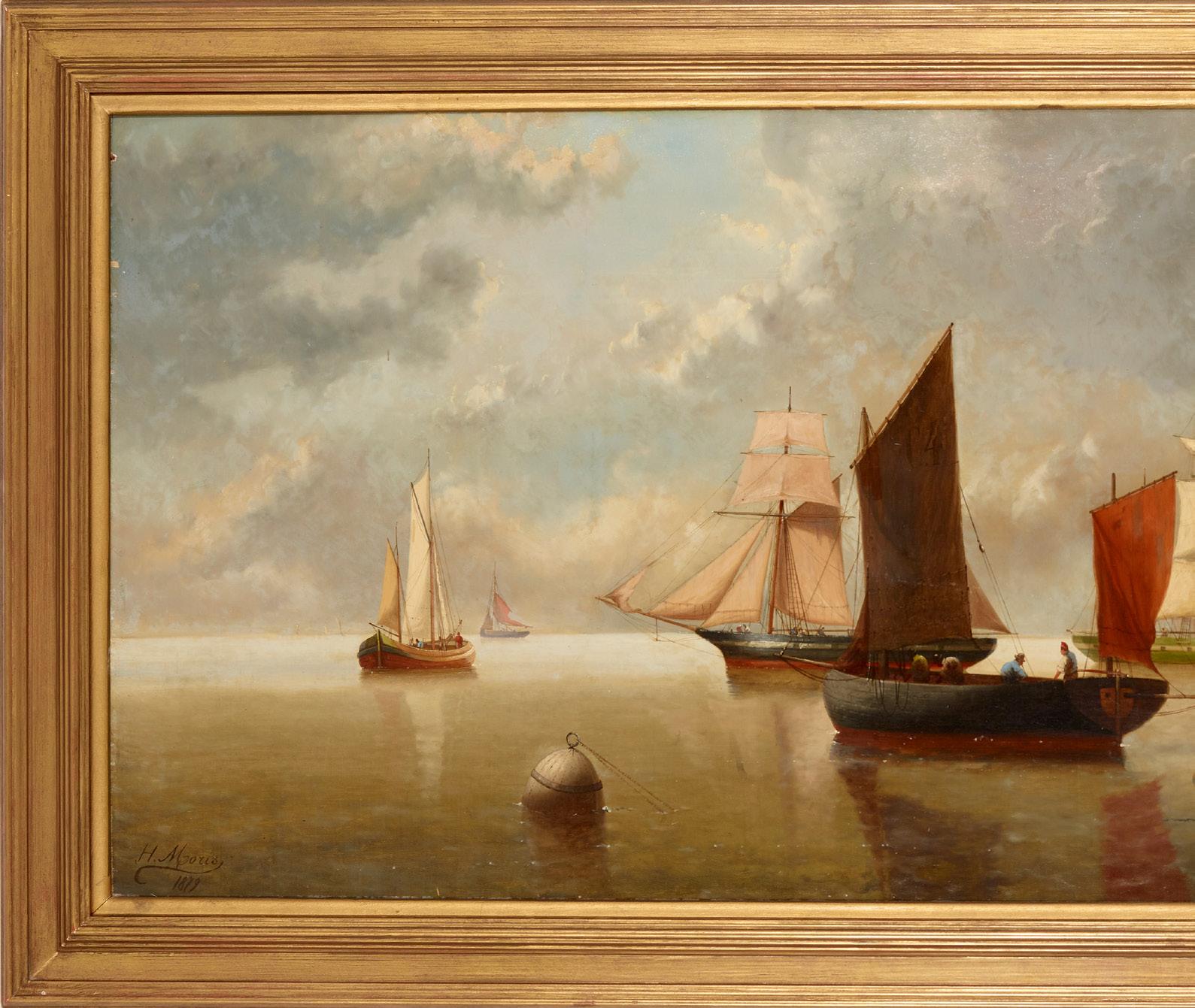
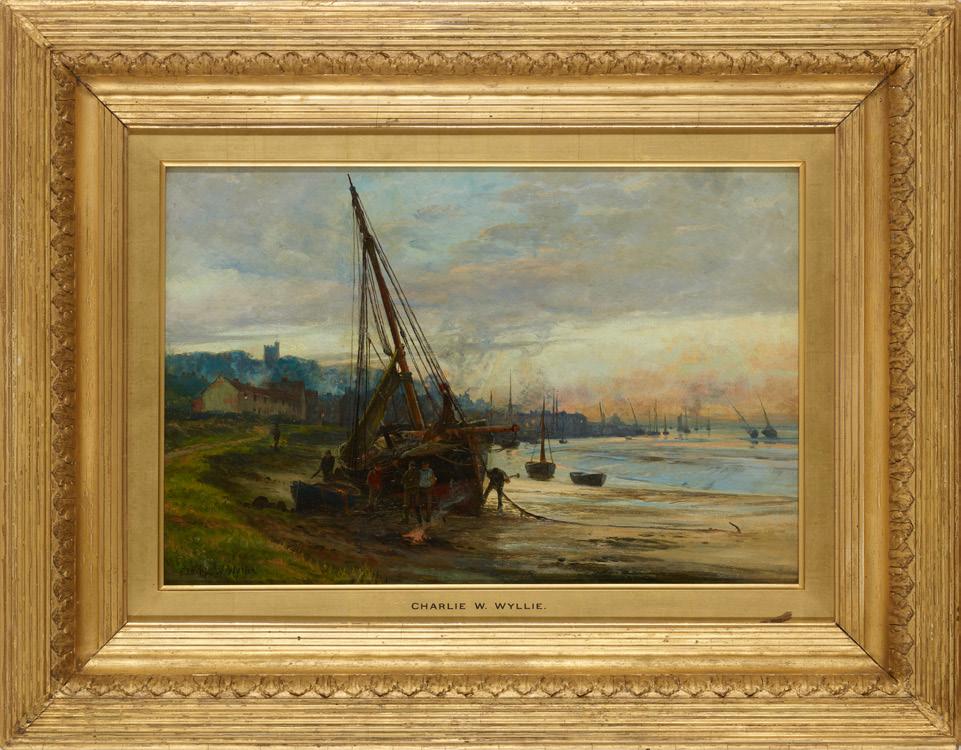
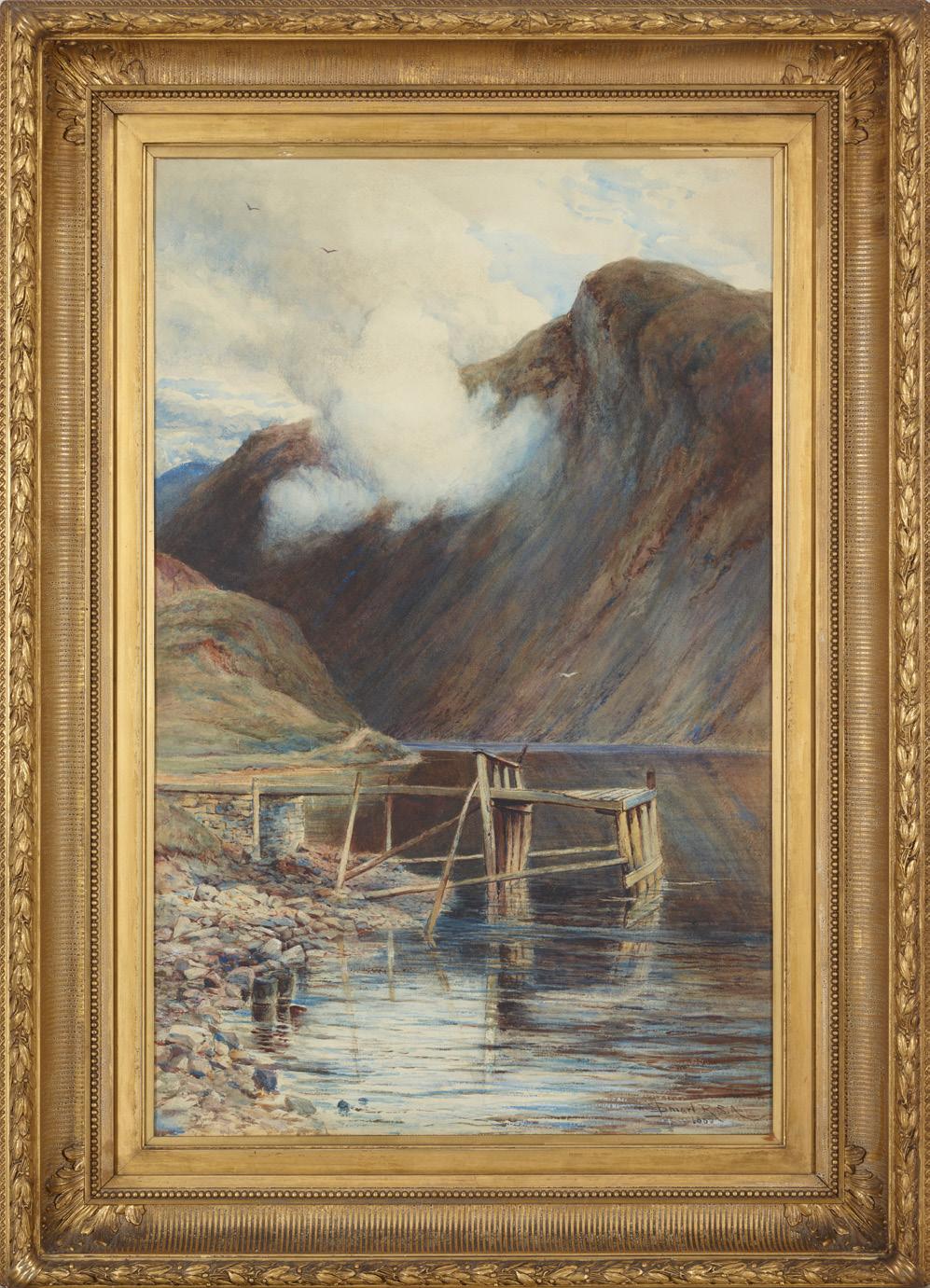
63.5cm x 203cm (25in x 80in)
Acquired from Phillips London: Tuesday, December 17, 1996 [Lot 00128], Early British and Victorian Paintings, and thence by descent.
£2,000-3,000
276 §
CHARLES WILLIAM WYLLIE (BRITISH 1853-1923)
RIVERSIDE REPAIRS, SUNSET
Signed, oil on canvas
30.5cm x 46cm (12in x 18in)
£800-1,200
277
JOHN SMART R.S.A., R.S.W., R.B.A (SCOTTISH 1838-1899)
THE PASS OF BRANDER, LOCH AWE
Signed and dated 1885, watercolour
98cm x 61cm (38.5in x 24in)
£800-1,200
104 Other fees apply in addition to the hammer price: see the ‘Buyer’s Guide’ section on page 2
278
LUDWIG MUNTHE (NORWEGIAN 1841-1896)
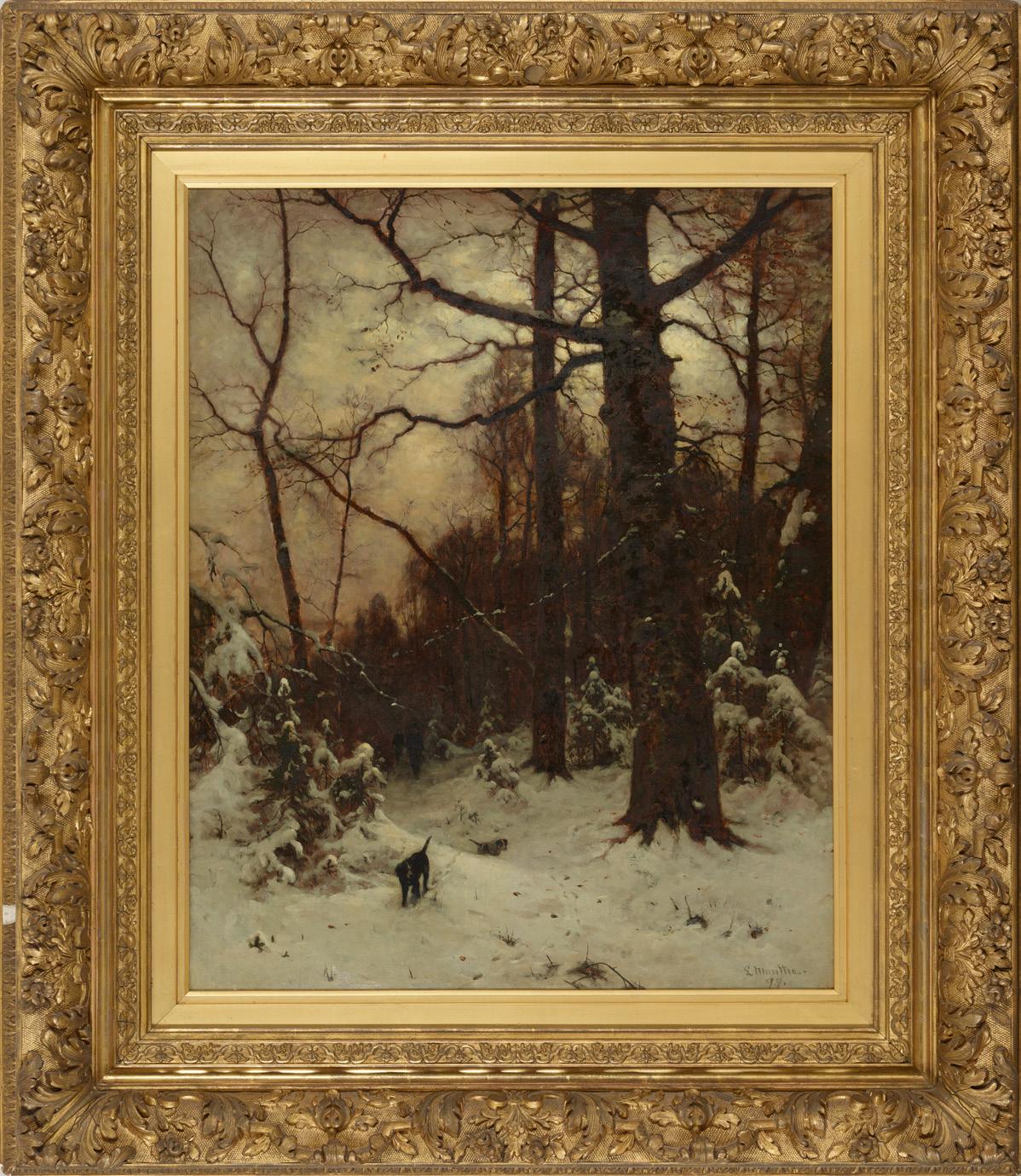
A SHOOTING PARTY IN THE SNOW
Signed and indistinctly dated, oil on canvas
81cm x 63.5cm (32in x 25in)
£1,000-1,500
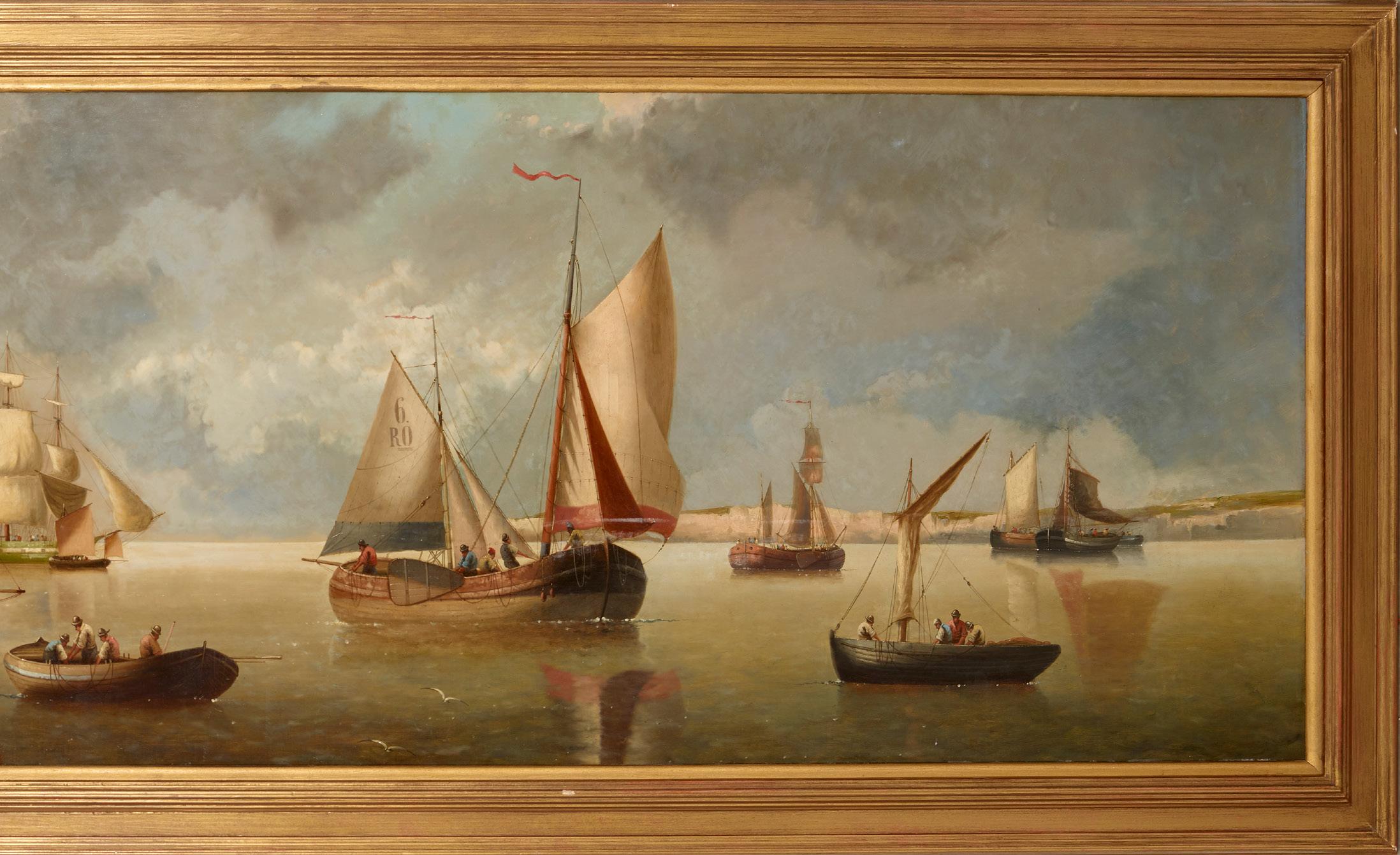
105
A PRIVATE COLLECTION OF SNUFF BOXES

279
CARVED COQUILLA NUT FIGURAL SNUFF BOX OF A FROG

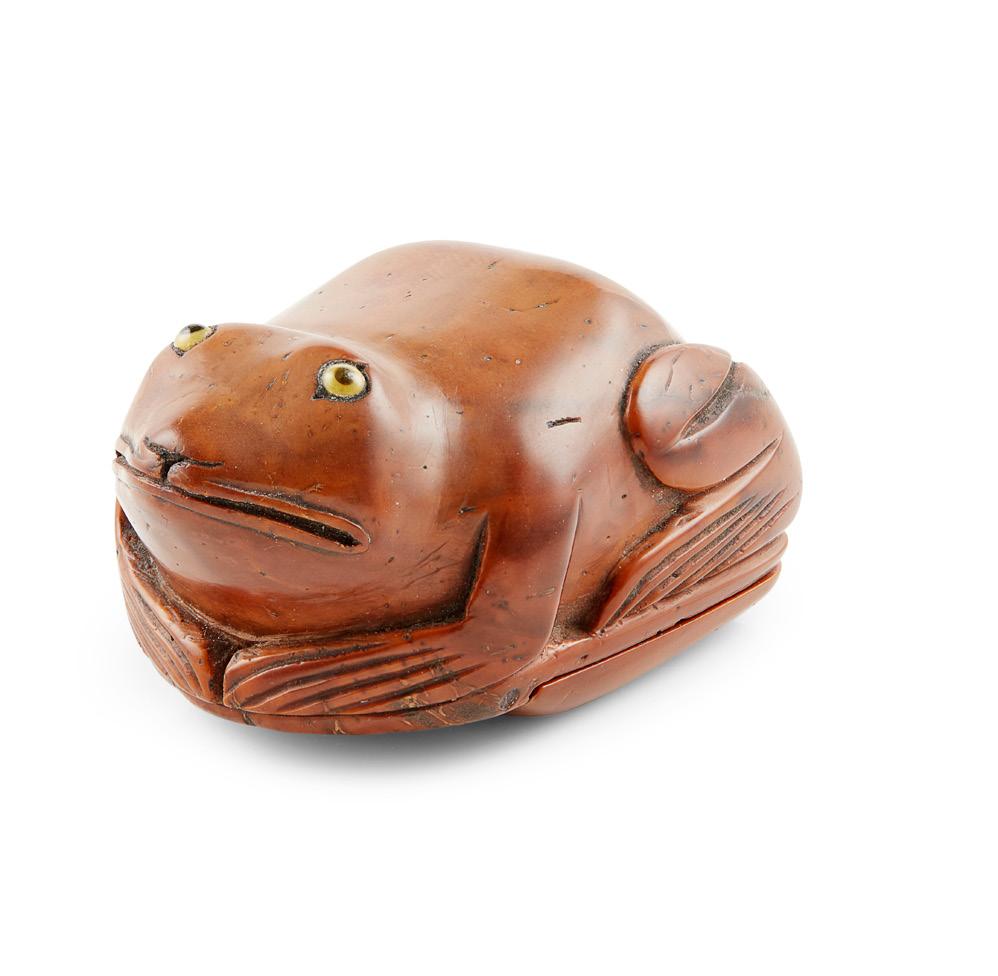
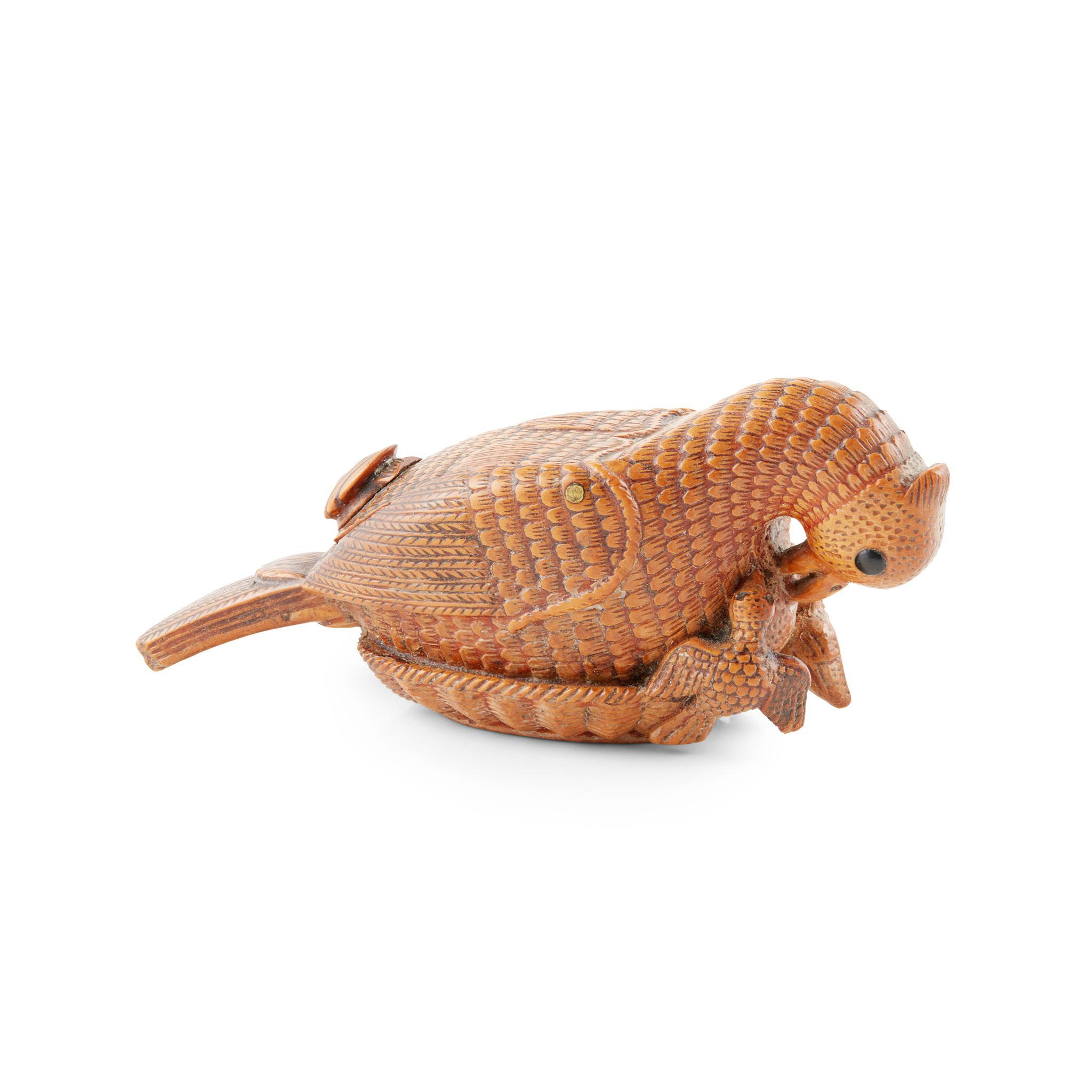
19TH CENTURY
with glass bead eyes, the hinged base opening to a void interior
6.3cm long
£300-500
281
THREE CARVED COQUILLA NUT BOXES
19TH CENTURY
to include a snuff box carved in the form of a rabbit with glass bead eyes, it’s hinged back opening to a void interior; a snuff box in the form of a tortoise [head and one leg lacking], with a hinged shell opening to a void interior; and a pierced and carved pomander of ovoid form with screw-thread opening (3)

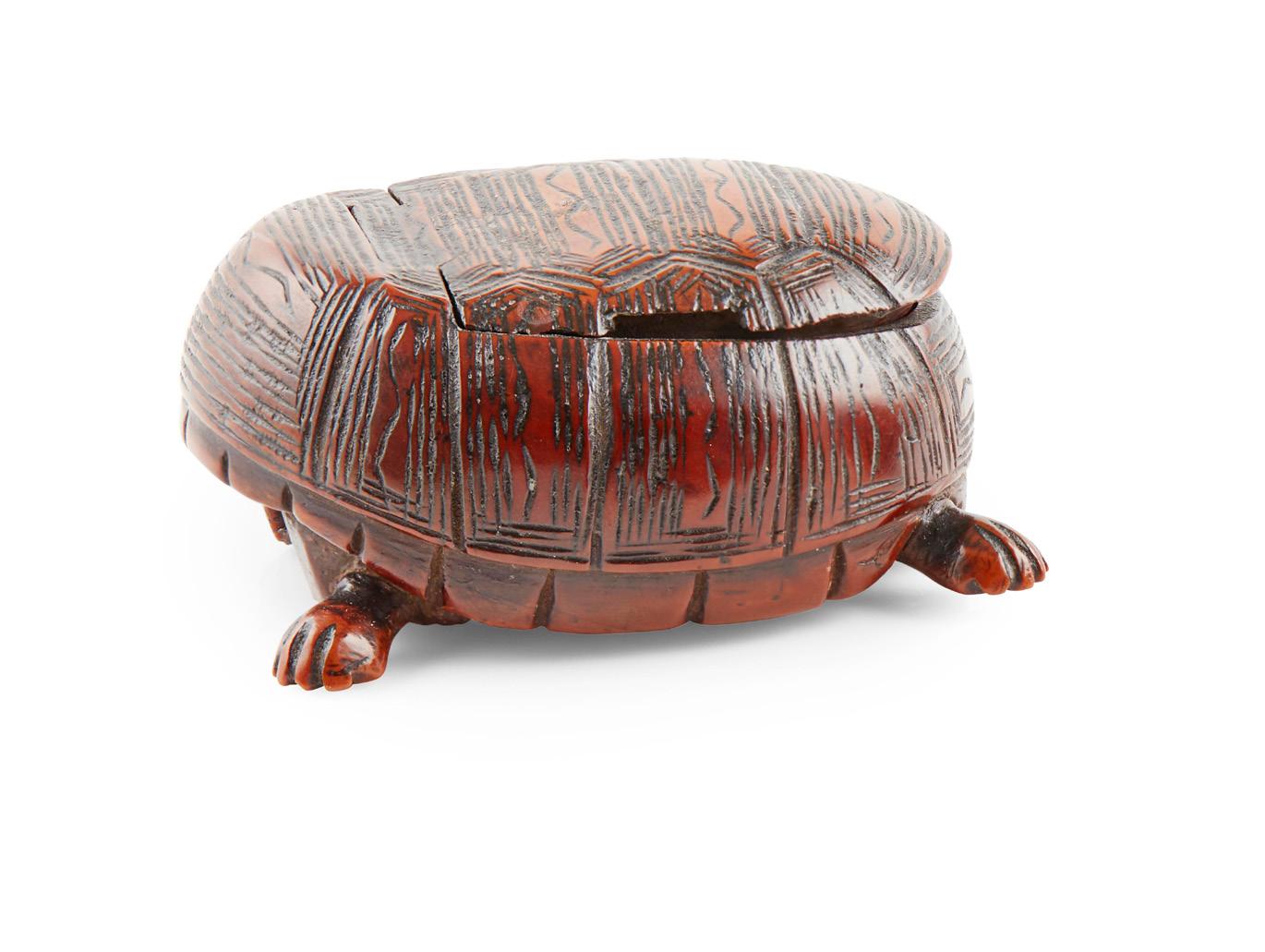
7.5cm, 6.8cm and 6cm long
£400-600
280
ENGLISH CARVED BOXWOOD SNUFF BOX
19TH CENTURY
in the form of a ruffed grouse and her chicks, modelled as an allegory of the Pelican in her Piety, with ebonised eyes, the hinged back with a scallop shell thumb catch
11cm long
£400-600
107 Other fees apply in addition to the hammer price: see the ‘Buyer’s Guide’ section on page 2
282
CARVED COQUILLA NUT CHARACTER SNUFF BOX
19TH CENTURY
depicting a man with a wide face and toothy grin, wearing an overcoat with whale tooth buttons, his right hand tucked inside, the coat tails hinged and opening to a void interior
7cm high
£300-500
283 Y
CARVED COQUILLA NUT CHARACTER SNUFF BOX
19TH CENTURY
depicting a man with a flat face carved with a wide toothy grin and set with glass eyes, wearing a long overcoat with double rows of whale tooth buttons, the coat tails hinged to a void interior
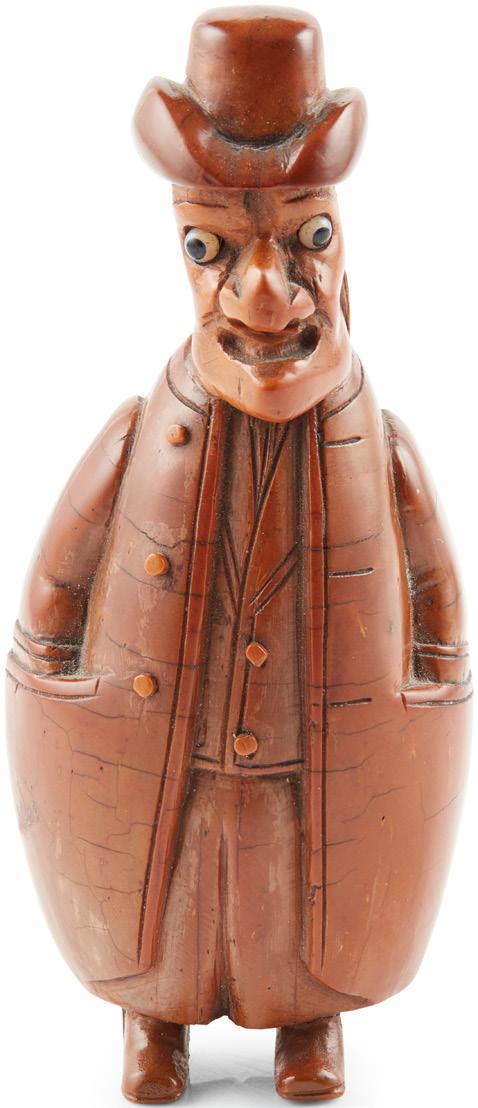
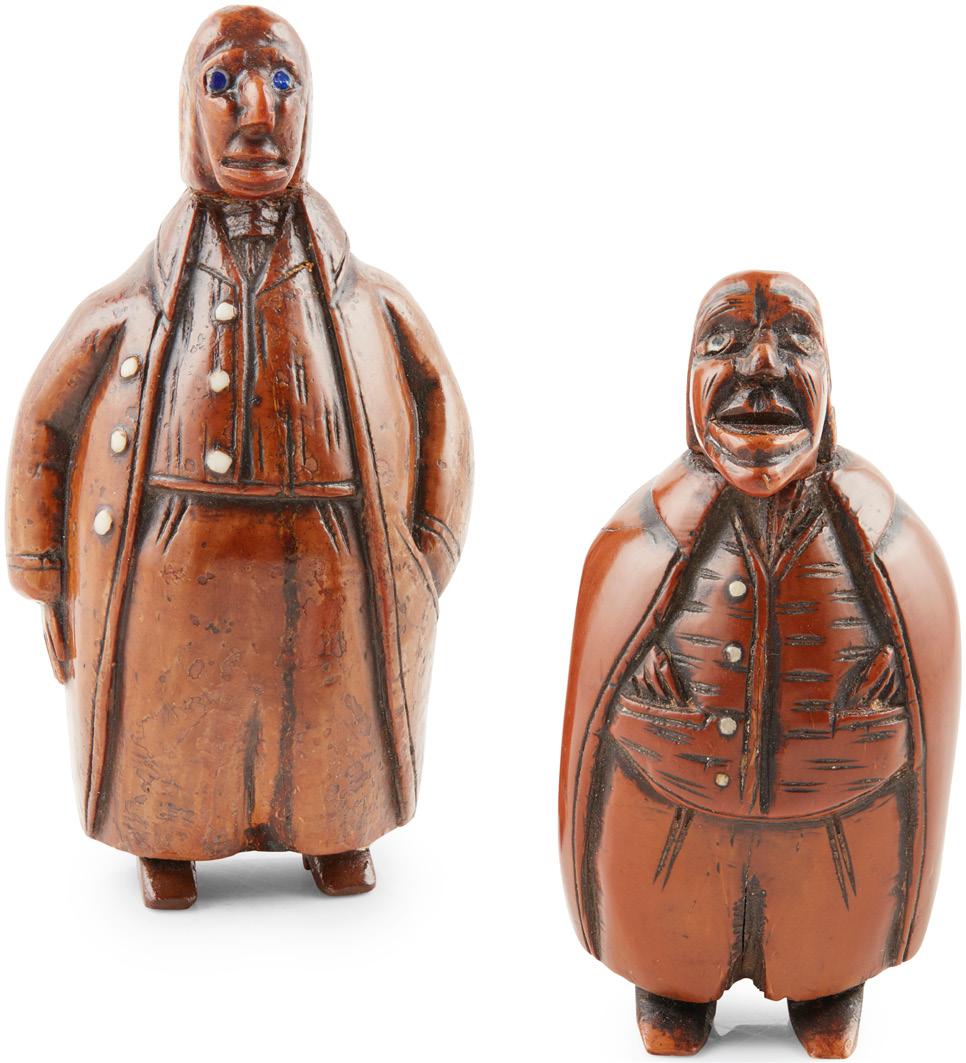

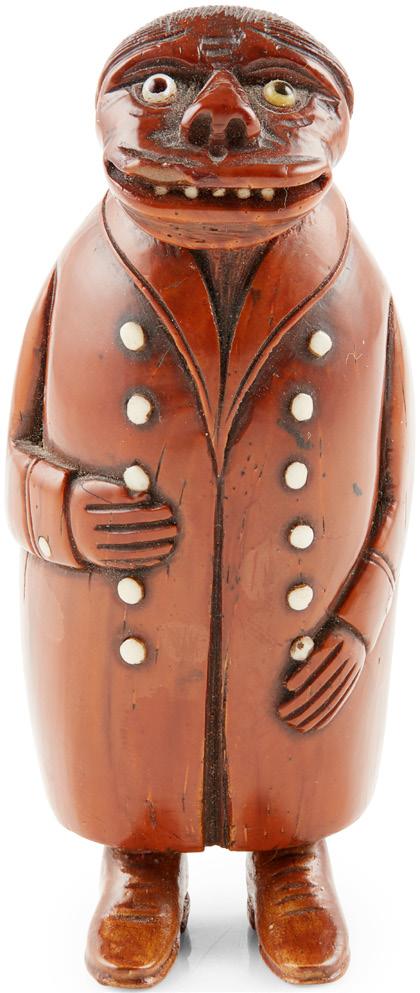

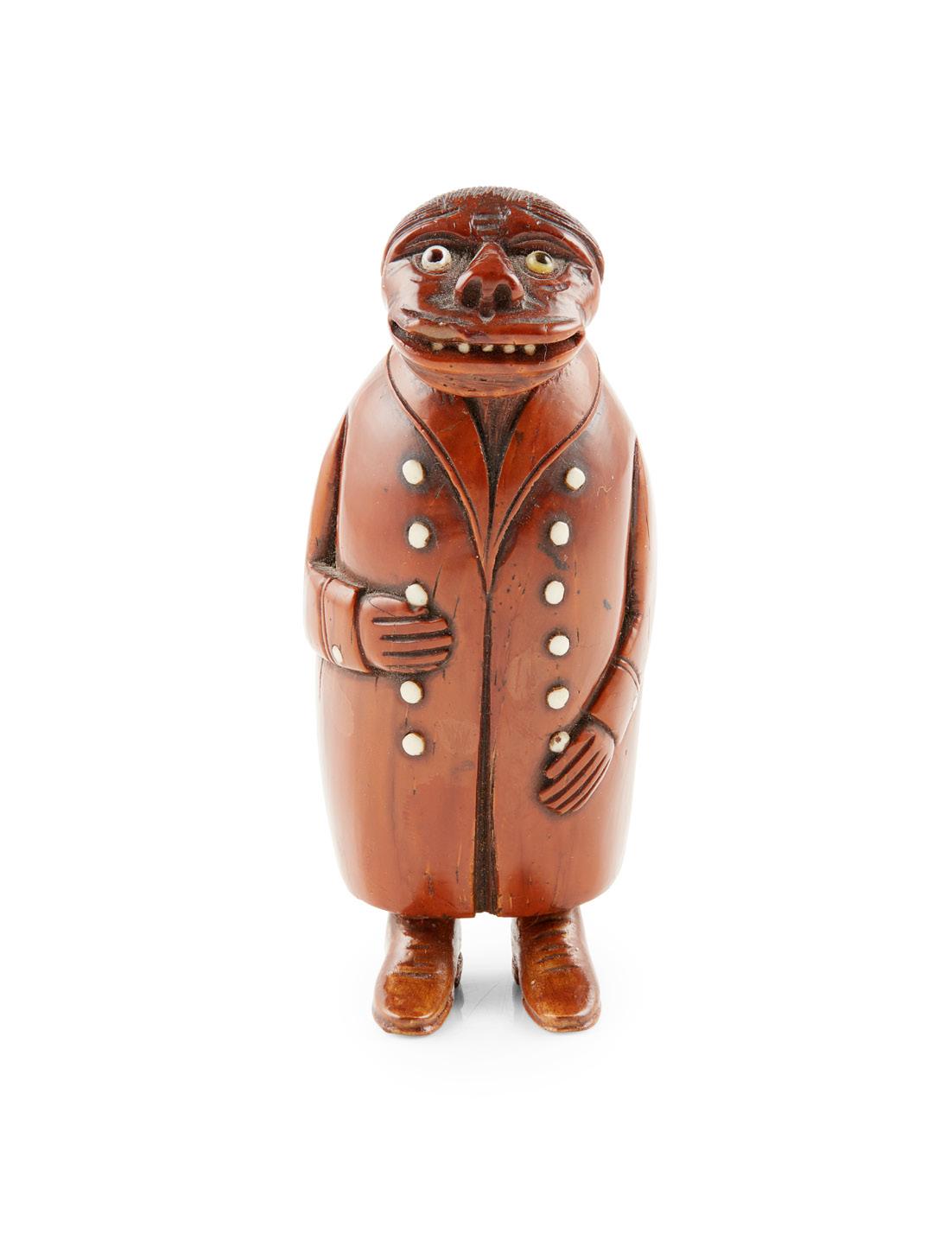
9cm high
£300-500
284
TWO CARVED COQUILLA NUT CHARACTER SNUFF BOXES
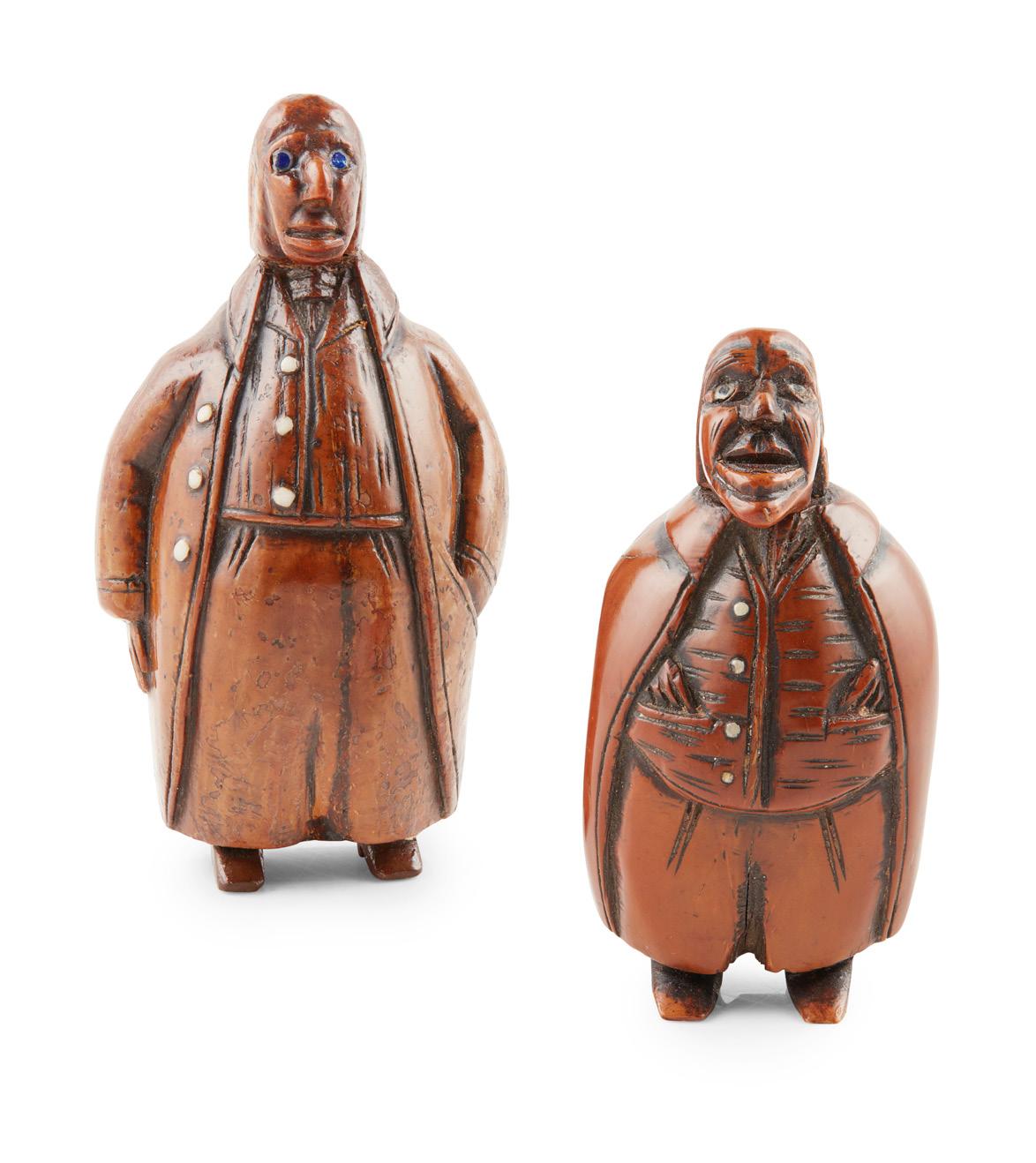
19TH CENTURY
the larger example depicting a rotund man with a hook nose and glass bead eyes, wearing an open greatcoat over a waistcoat and trousers, with whale tooth buttons, the hinged coat tails opening to a void interior; the second with a jutting chin and long hair, wearing an open greatcoat with his hands in his waistcoat pockets, whale tooth buttons, the hinged coat tails opening to a void interior (2)
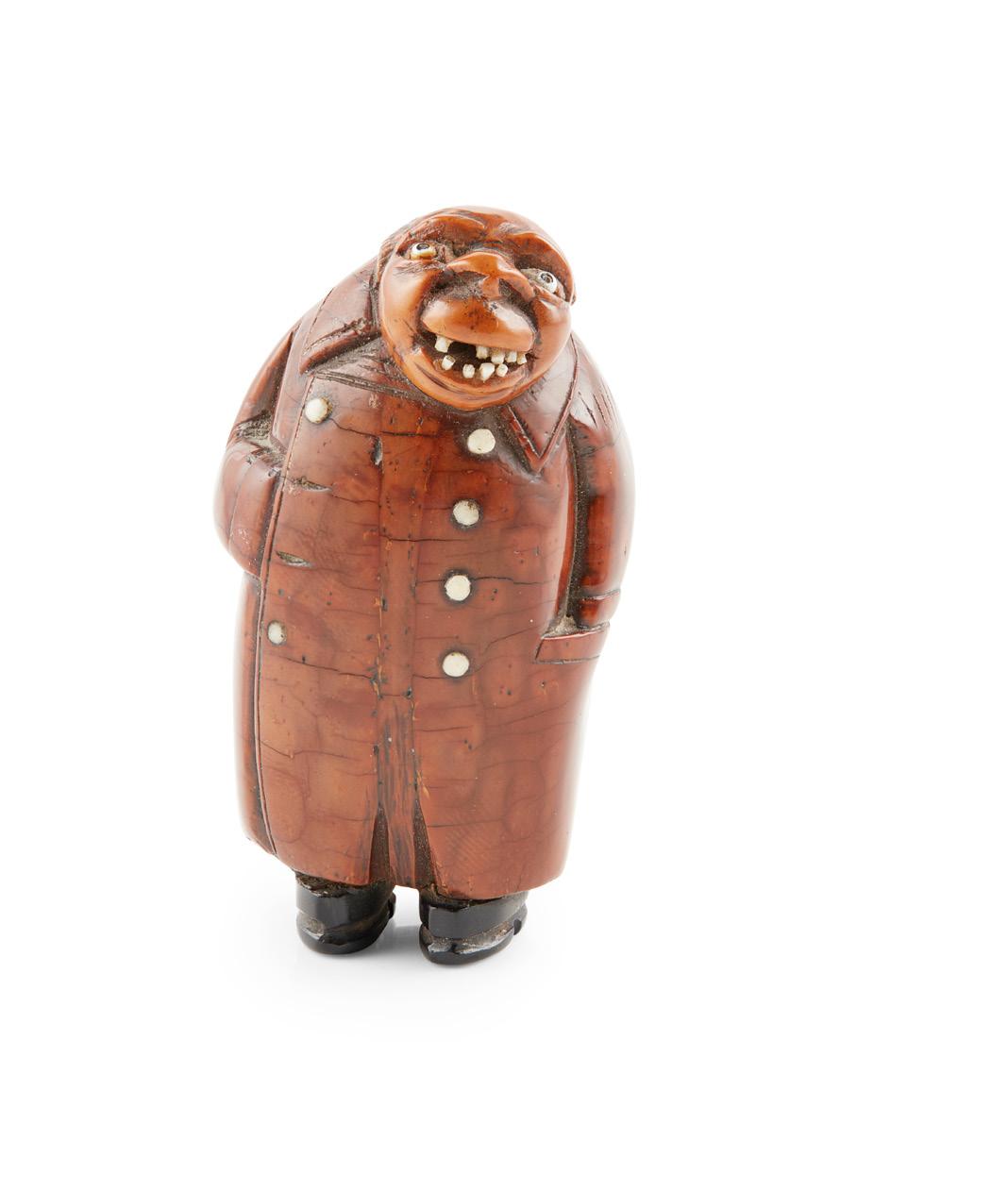
9.3cm and 7cm high
£400-600
285
CARVED COQUILLA NUT CHARACTER SNUFF BOX
19TH CENTURY
depicting a man with a hook nose, prominent chin, long hair and glass bead eyes, wearing a hat with a wide folded brim and open topcoat with his hands in the pockets, the hinged coat tails opening to a void interior
9.8cm high
£300-500
108 Other fees apply in addition to the hammer price: see the ‘Buyer’s Guide’ section on page 2
286
CARVED COQUILLA NUT CHARACTER SNUFF BOX
EARLY 19TH CENTURY
depicting a man with a wide flat face wearing a great coat with double rows of whale tooth buttons, his hands in his pockets, the hinged coat tails opening to a void interior
7.7cm high
£300-500
287
CARVED COQUILLA NUT CHARACTER SNUFF BOX
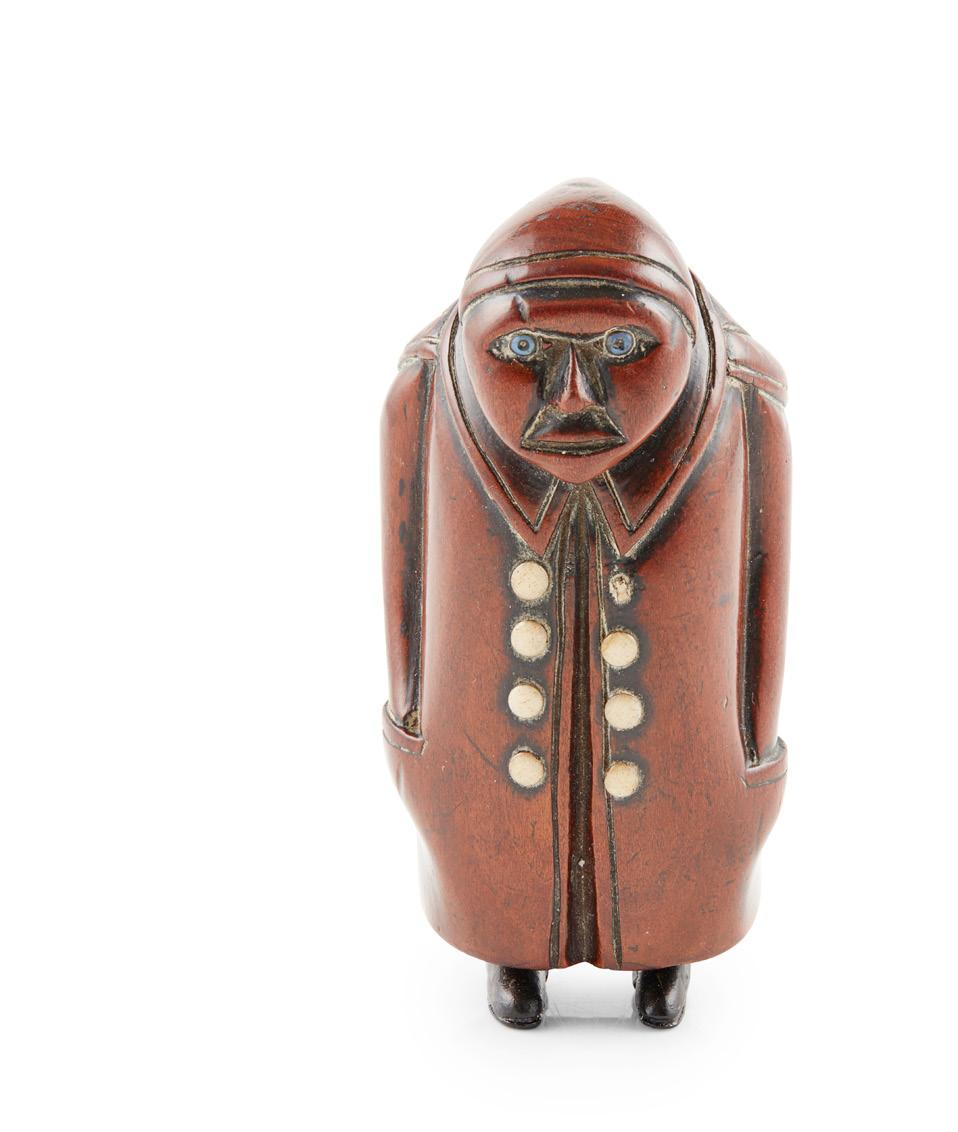

19TH CENTURY
depicting a man with a broad nose and glass eyes, wearing a tricorn hat and cut-away tail coat, the hinged coat tails opening to a void interior
8.8cm high
£300-500
288
TWO CARVED COQUILLA NUT CHARACTER SNUFF BOXES
19TH CENTURY
the first example depicting a man with a bulbous nose and long hair, wearing a greatcoat with whale tooth buttons, the hinged coat tails opening to a void interior; the second depicting a man with a round face wearing an open greatcoat and waist sash, the hinged coat tails opening to a void interior
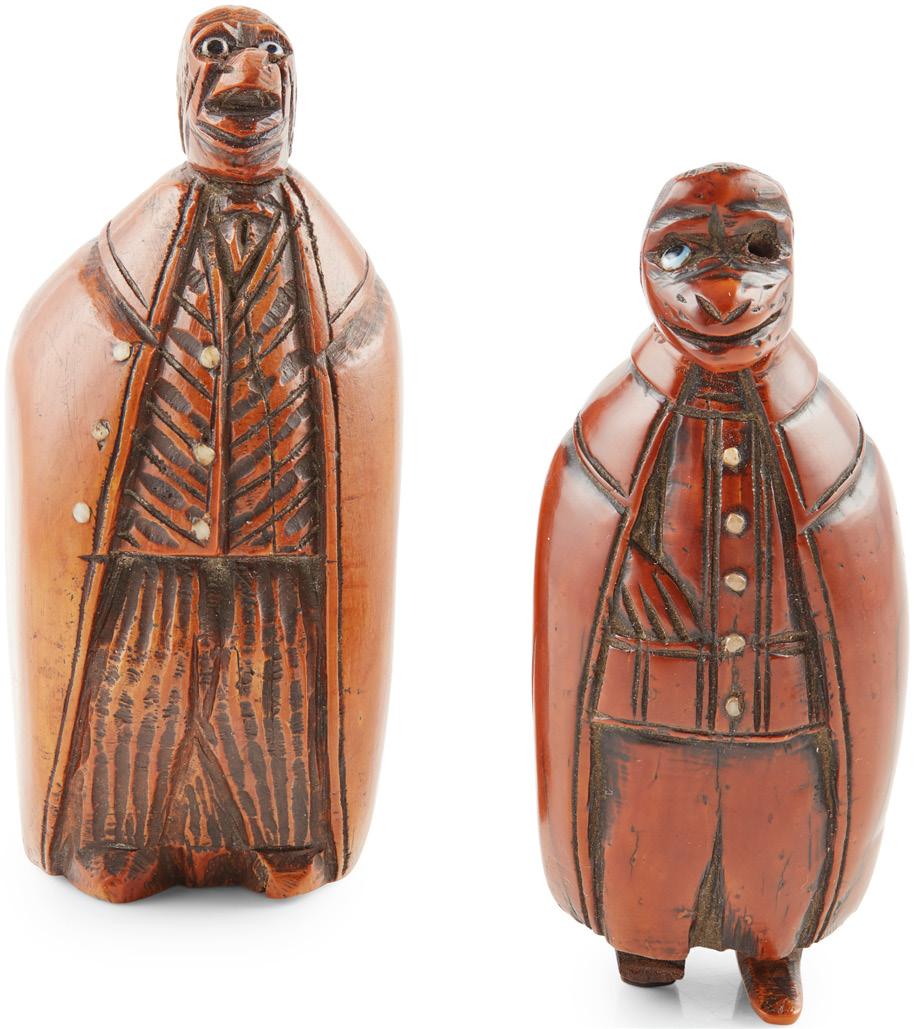
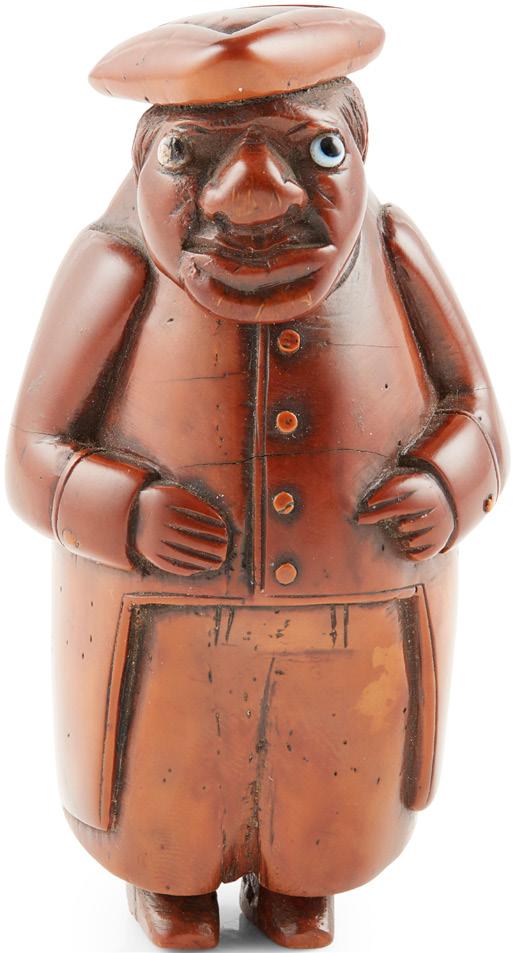
8cm and 7.5cm high
289
TWO CARVED COQUILLA NUT CHARACTER SNUFF BOXES
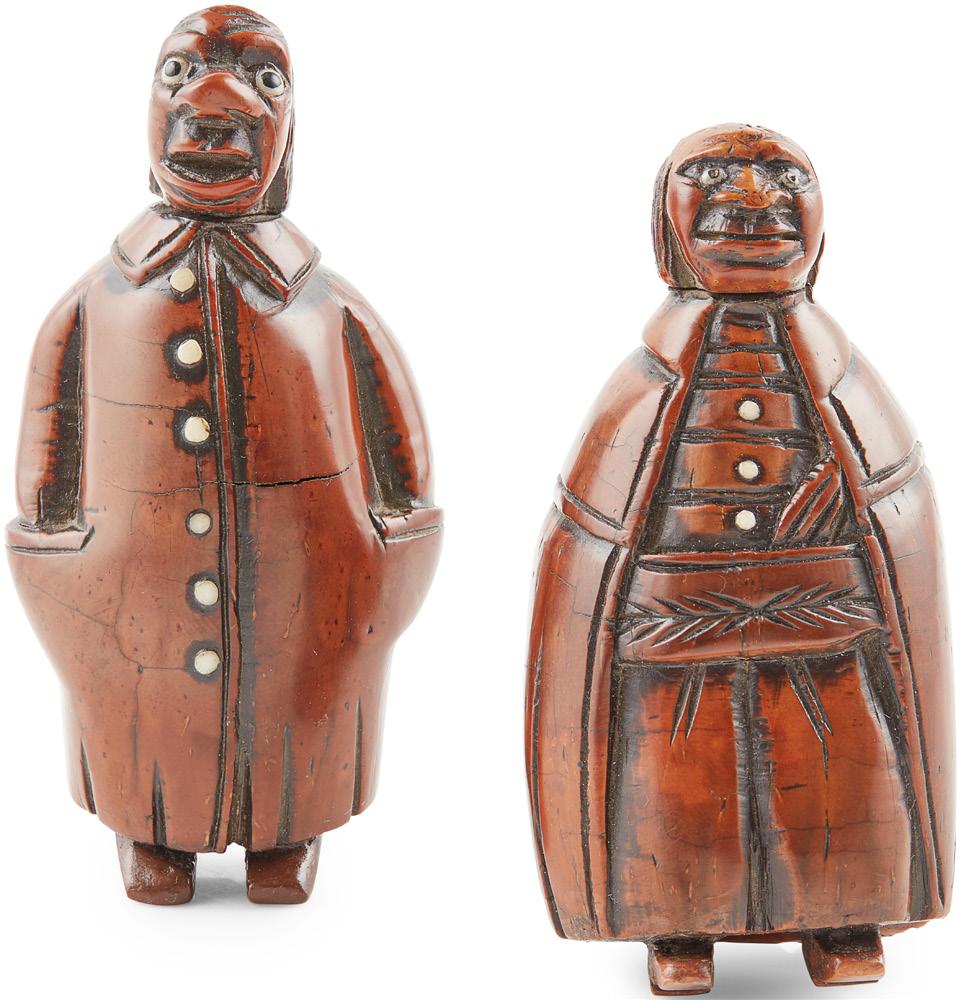

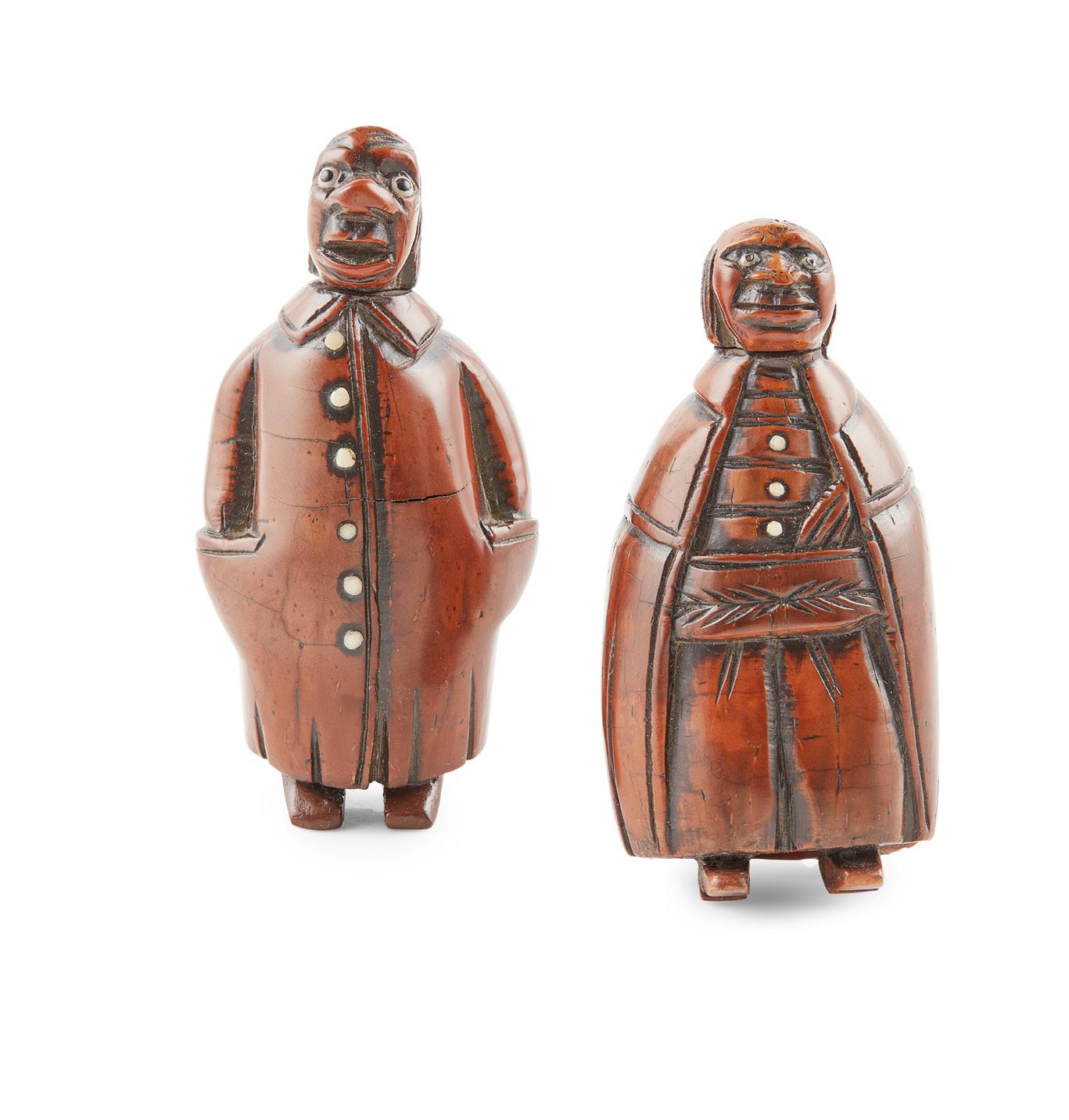
19TH CENTURY
the first example depicting a man with a hook nose and glass bead eyes wearing an open greatcoat and ribbed waistcoat and trousers, with whale tooth buttons, the hinged coat tails opening to a void interior; the second depicting a man with an open greatcoat and striped waistcoat with horn buttons, the hinged coat tails opening to a void interior
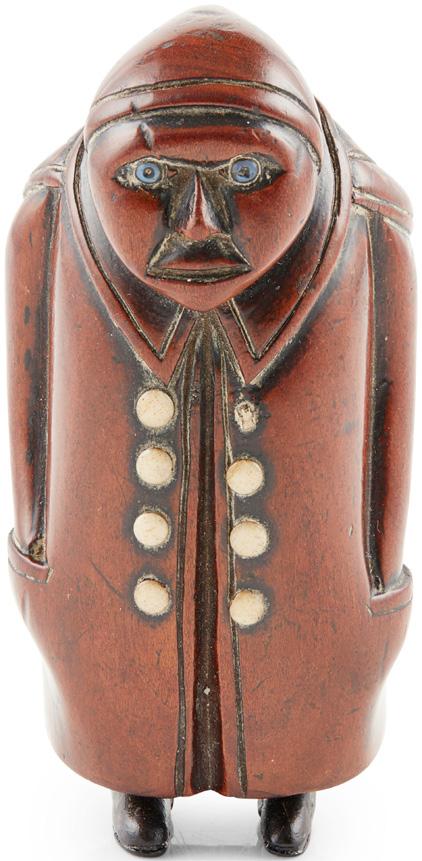
8.5cm and 8cm high
£300-500
109
Note: Probably a period presentation piece referring to the sieges of the time. For example, Sir Alexander Arthur Hood 1st Viscount Bridport supported the relief of Gibraltar in 1782 under the threat of a Franco/Spanish armada.
293
TWO ENGRAVED POWDER HORNS
LATE 18TH/ EARLY 19TH CENTURY
one possibly Australian Colonial with and engraved of a coat of arms including a hand clasping an arrow, exotic birds in a tree and a kangaroo, tapering to a facetted end, the other end with a serrated rim; the other American example engraved with the Great Seal of the Unites States of America of eagle with motto ‘E PLURIBUS
UNUM’ above a continuous scene of deer hunting on horseback, with monogram ‘J.B.C’ and partial signature ‘J. Krer...’, the end smoothed with a turned rib for a handle (2)
36cm and 42cm long respectively
£300-500
290
SCOTTISH CARVED COCONUT BUGBEAR FLASK
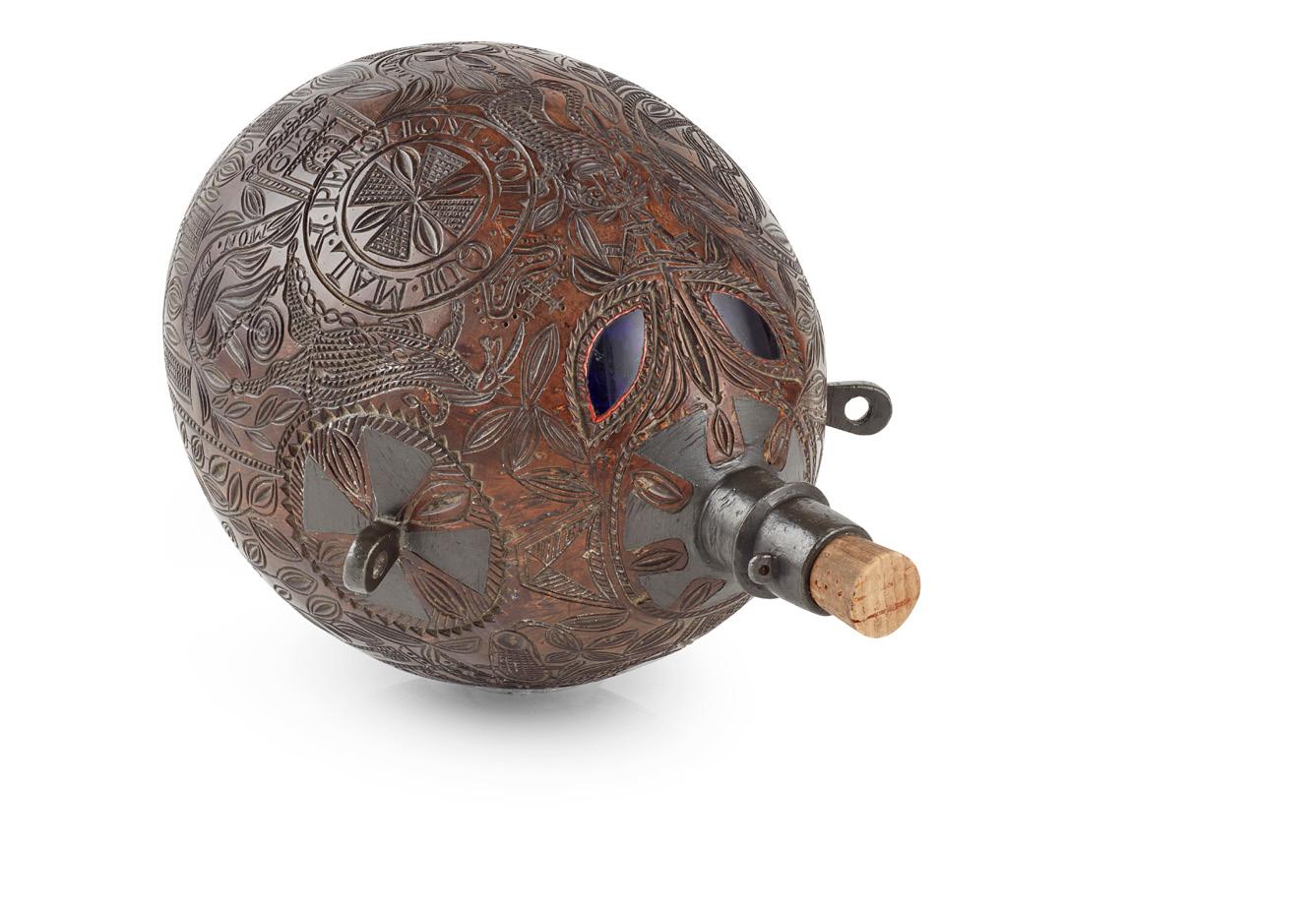
DATED 1819
with incised Royal Coat of Arms, Naval roundels and a scene of a churchyard in a foliate landscape with crocodiles, also dated and signed ‘D.J. Laird’, inlaid with a pair of blue glass eyes and several spots, with pewter neck and three loops for suspension
18cm long, 10cm wide
£300-500
BRITISH FURNITURE & WORKS OF ART PART III
291
ENGLISH 40 BORE FLINTLOCK POCKET
PISTOL, BISSELL EARLY 19TH CENTURY short turn-off barrel and brass action engraved ‘Bissell’ with sliding safety and folding trigger, the chequered walnut grip with butt cap, stamped proof marks, barrel 3cm 14cm long, 8cm high
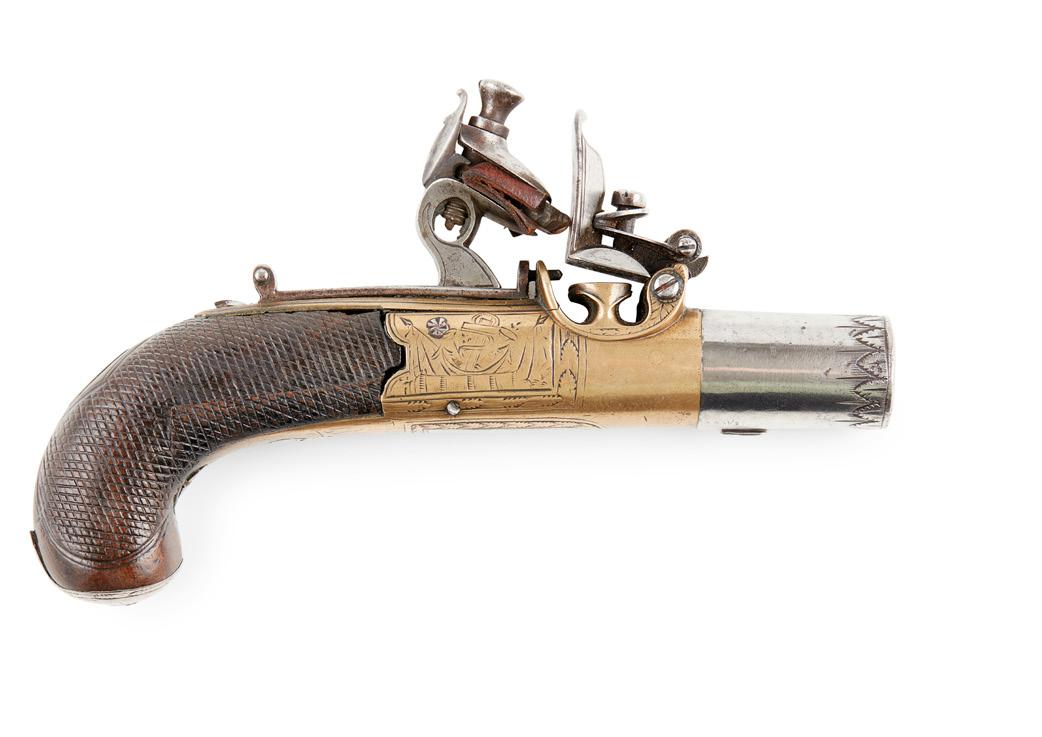
£300-500
292
BRITISH ENGRAVED ARMORIAL POWDER HORN
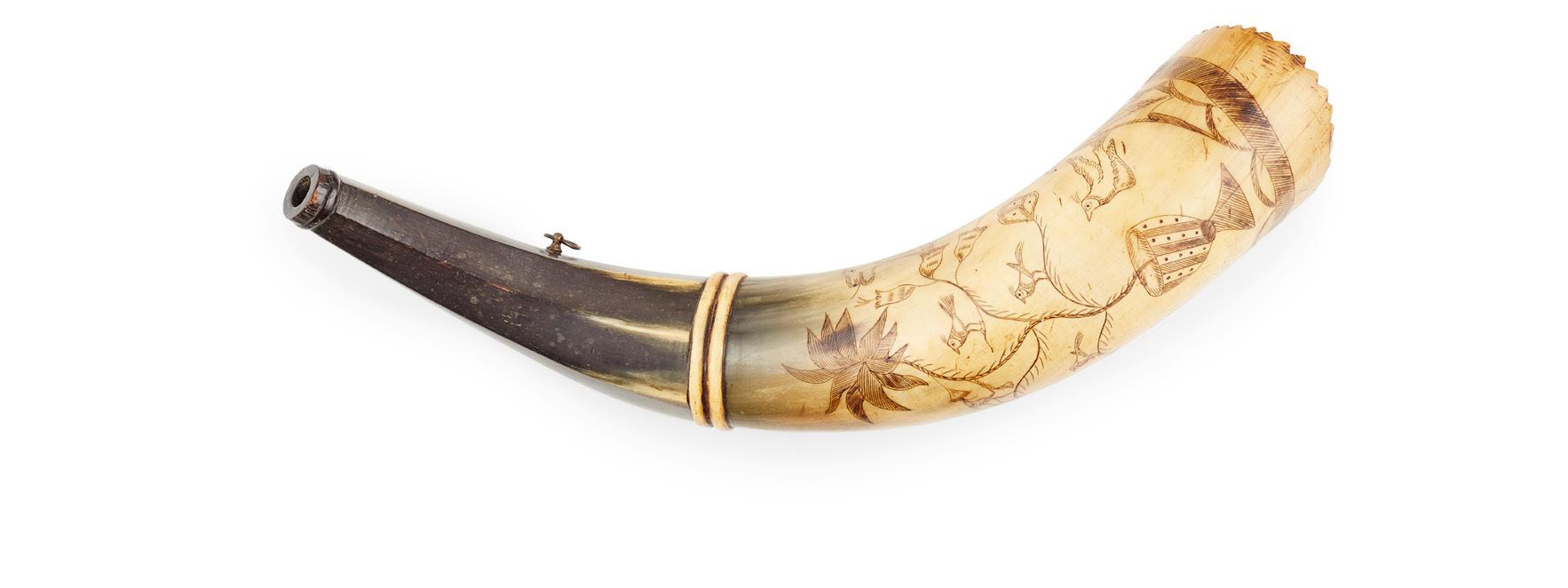
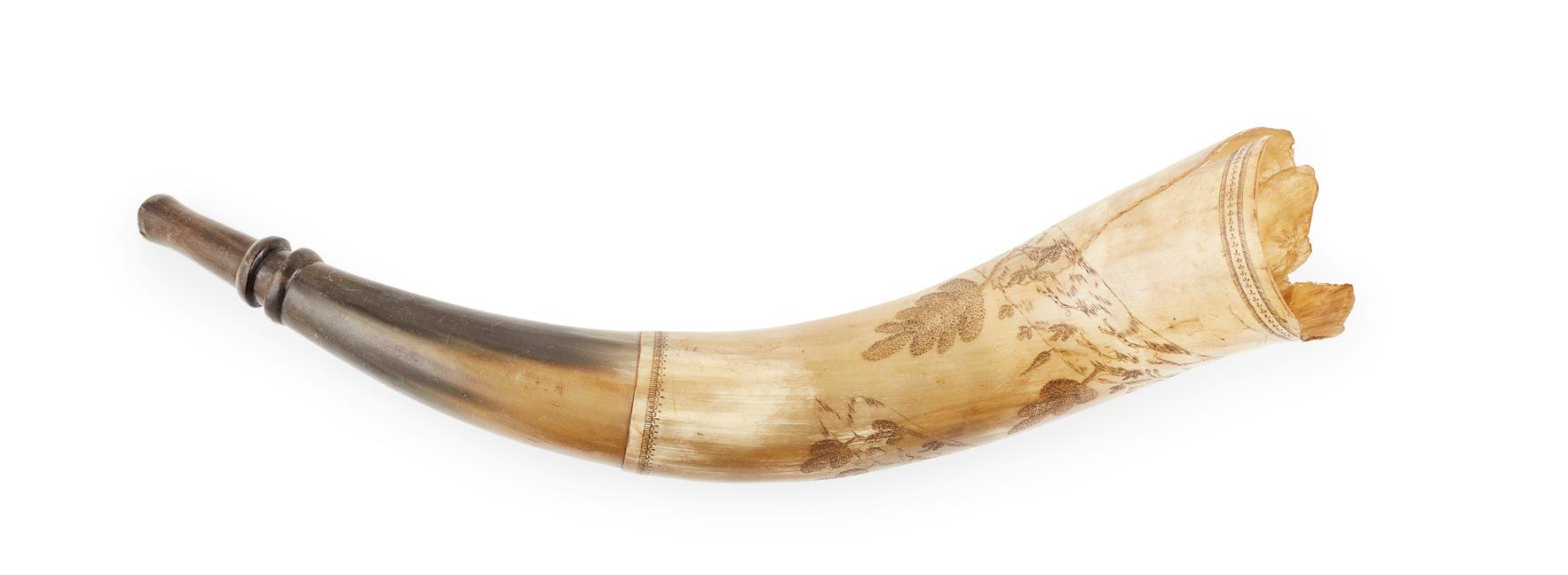
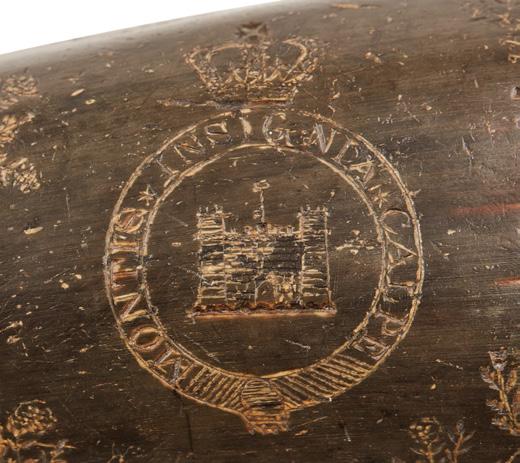
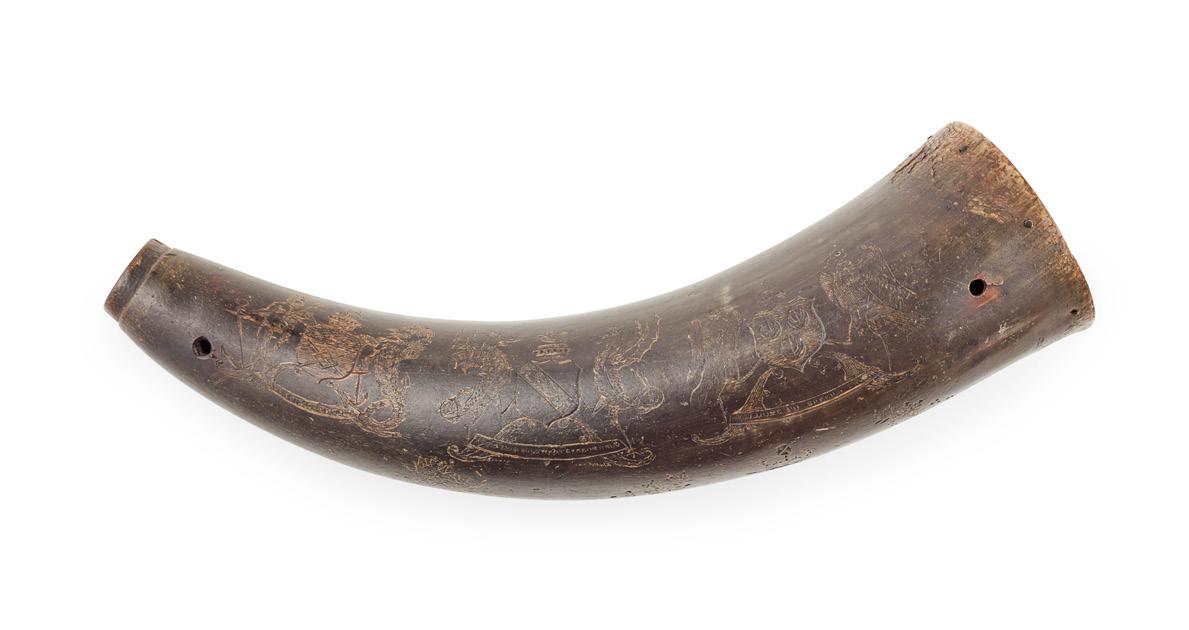
LATE 18TH CENTURY
engraved with the coat of arms of Gibraltar (British Crown Colony, Montis Insignia Calpe) accompanied by six British noble family coats of arms, including Earl of Sussex (Foy En Tout), Scottish Clan/ Earl Cathcart (I Hope to Speed), Baron Clifford (Le Roy Leveut) and Baron Hood (Ventis Secundis) and two others 30cm long
£400-600
110
294
ROYAL NAVY FULL DRESS UNIFORM
EARLY 20TH CENTURY
belonging to Surgeon Lieutenant Commander J L Malone, including a Royal Navy officers’ dress sword with lion’s head pommel, wire bound shagreen grip, Gothic guard with crown and fouled anchor and original bullion dress knot, together a black toleware case containing full dress of a pair of gold epaulettes, a black bicorn hat, a black leather belt and a black and gilt sword belt, all by J. Grieve & Sons, also with four sets of rank epaulettes, a badge, a set of buttons, a set of WWII medals including the War Medal 19391945, The 1939-1945 Star and The Atlantic Star, a small photograph of his grave, service Christmas cards, other photographs and ephemera sword 97cm long
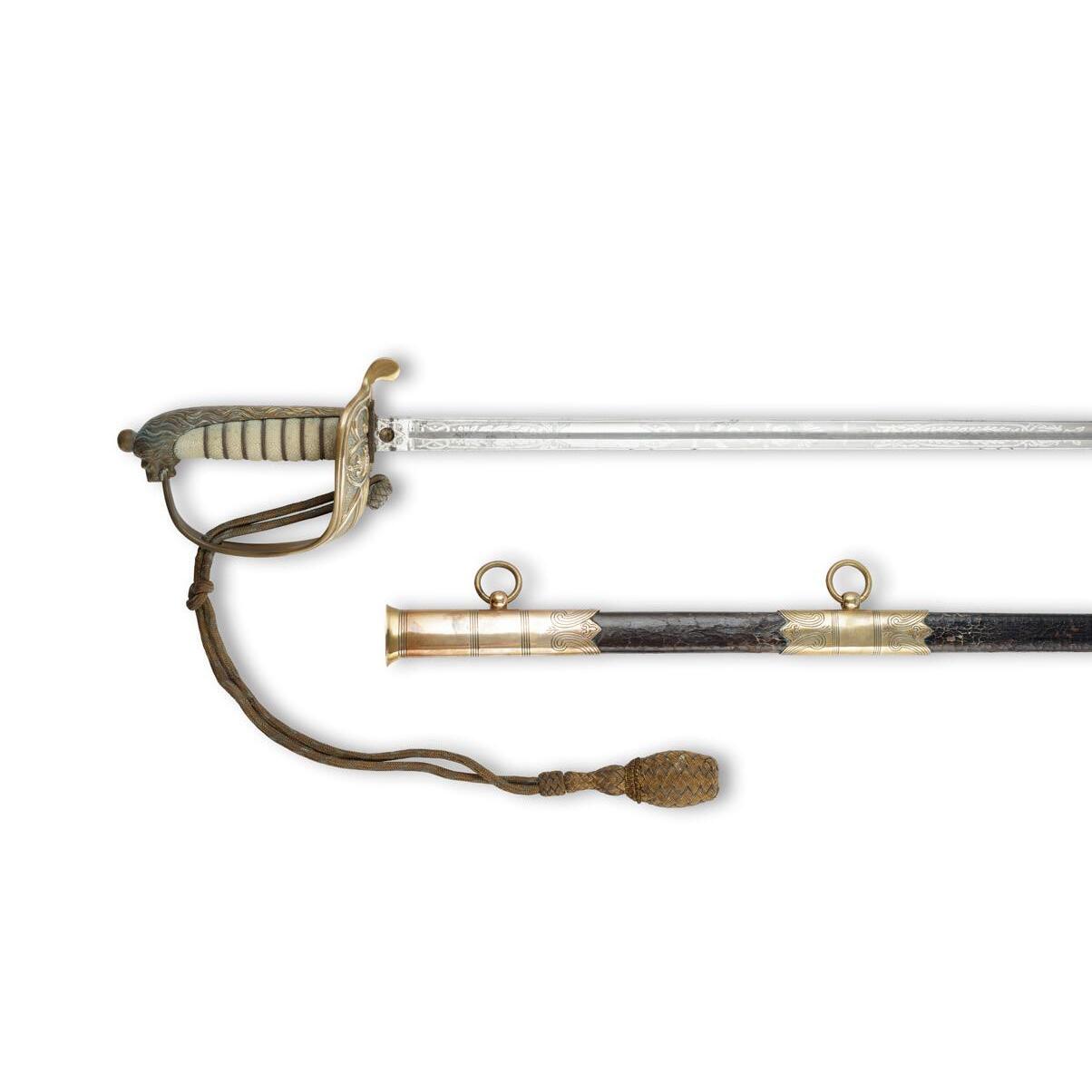
£800-1,200
THE CAPTAIN WILLIAM PROWSE SEA CHEST
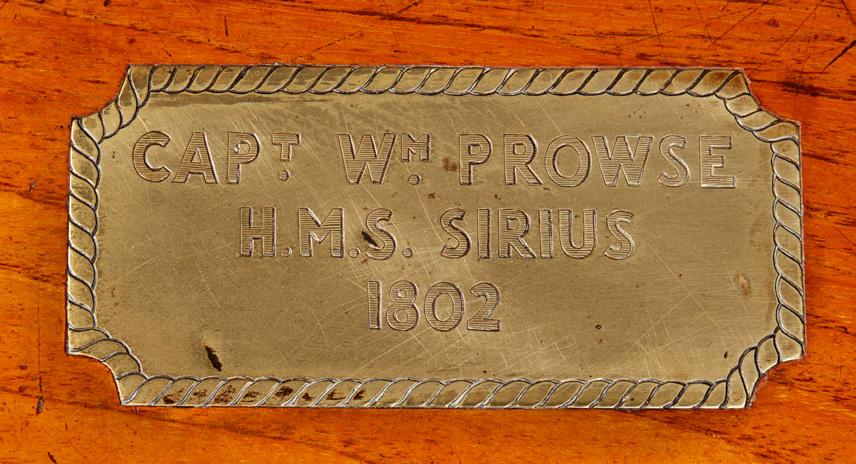

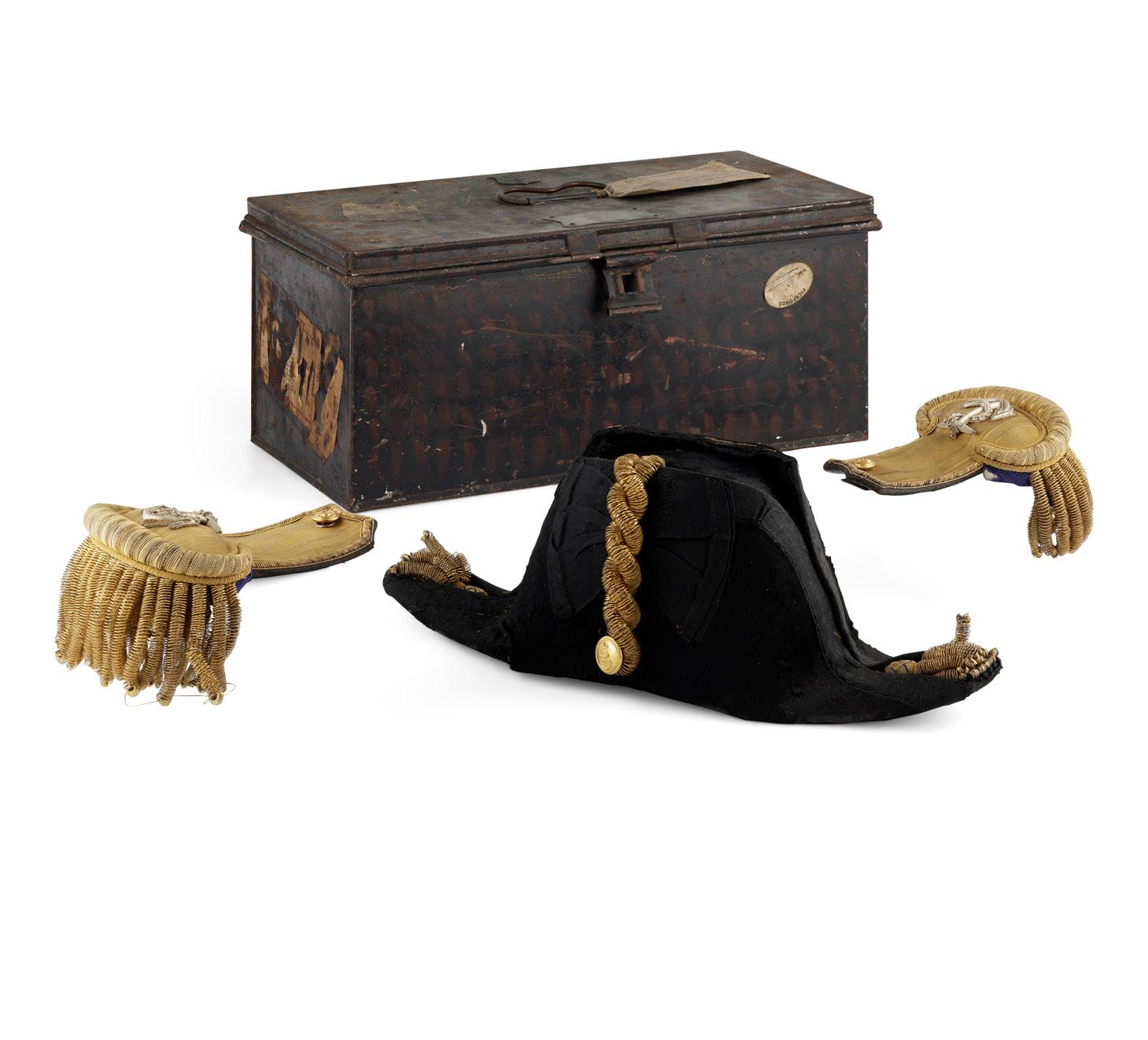
EARLY 19TH CENTURY
teak with brass mounts, the hinged top with an engraved brass plaque CAPT. WM PROWSE/ H.M.S. SIRIUS/ 1802, with brass band reinforced corners and rope handles, opening to a void interior
79cm 55cm high, 48cm deep
£3,000-4,000
Note: William Prowse was born in 1753, and joined the Royal Navy in 1771 at the age of 18. He served during the War of American Independence, attaining the rank of lieutenant in 1782. During the French Wars, he served on HMS Barfleur, and during the Battle of the Glorious First of June was badly wounded and lost a leg. After recovering from his injuries, he was made master and commander of HMS Raven and took part in the Battle of Cape St. Vincent in 1797. He was subsequently made captain of HMS Sirius, a thirty-six gun fifth-rate frigate, in 1802. During Admiral Nelson’s Trafalgar campaign, was part of the small ship and frigate squadron that operated as the ‘eyes of the fleet’, to repeat signals and assist ships in distress. As such, he was
with Nelson on board the Victory in the hours preceding the commencement of the battle, before returning to his own ship. In 1806 Prowse, while still in command of the Sirius, attacked a French flotilla in the mouth of the Tiber, and despite being heavily out-numbered and out-gunned, captured the French ship-corvette Bergère. For this distinguished conduct Prowse was mentioned in dispatches and received a sword of honour from the Lloyd’s Patriotic Fund. In 1810 he was appointed to HMS Theseus, and continued to command that ship in the North Sea. He was nominated a Commander of the Bath in 1815, a colonel of the Royal Marines in 1819, and rear admiral in 1821. He died in London in 1826.
295
111 Other fees apply in addition to the hammer price: see the ‘Buyer’s Guide’ section on page 2
296
LARGE 6 1/2 FOOT TEAK, BRASS AND IRON SHIP’S WHEEL

LATE 19TH CENTURY/ EARLY 20TH CENTURY with ten turned spokes, brass banding and cap, and a cast iron hub
198cm diameter
£1,500-2,500
297
TEAK AND STEEL BANDED

NAVAL OFFICER’S CHEST
19TH CENTURY
the hinged cover with a brass plaque E. SOAMES R.N., the brass escutcheon embossed GIEVE
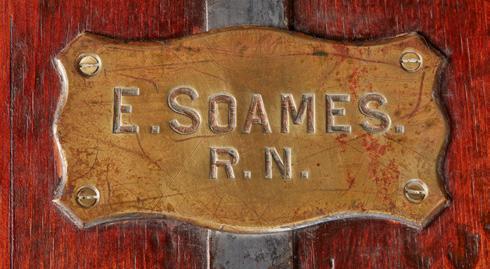
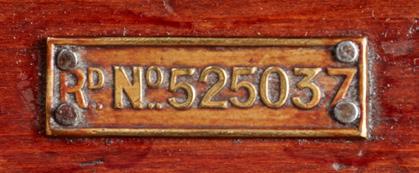
MATTHEWS AND SEAGROVE LTD, opening to a fitted interior with a lift-out tray with compartments and tole canisters, the lid mounted with a mirror, associated telescopic eyeglass, and dress sword, brass plaque Rg.N 525037 and trade label to the interior
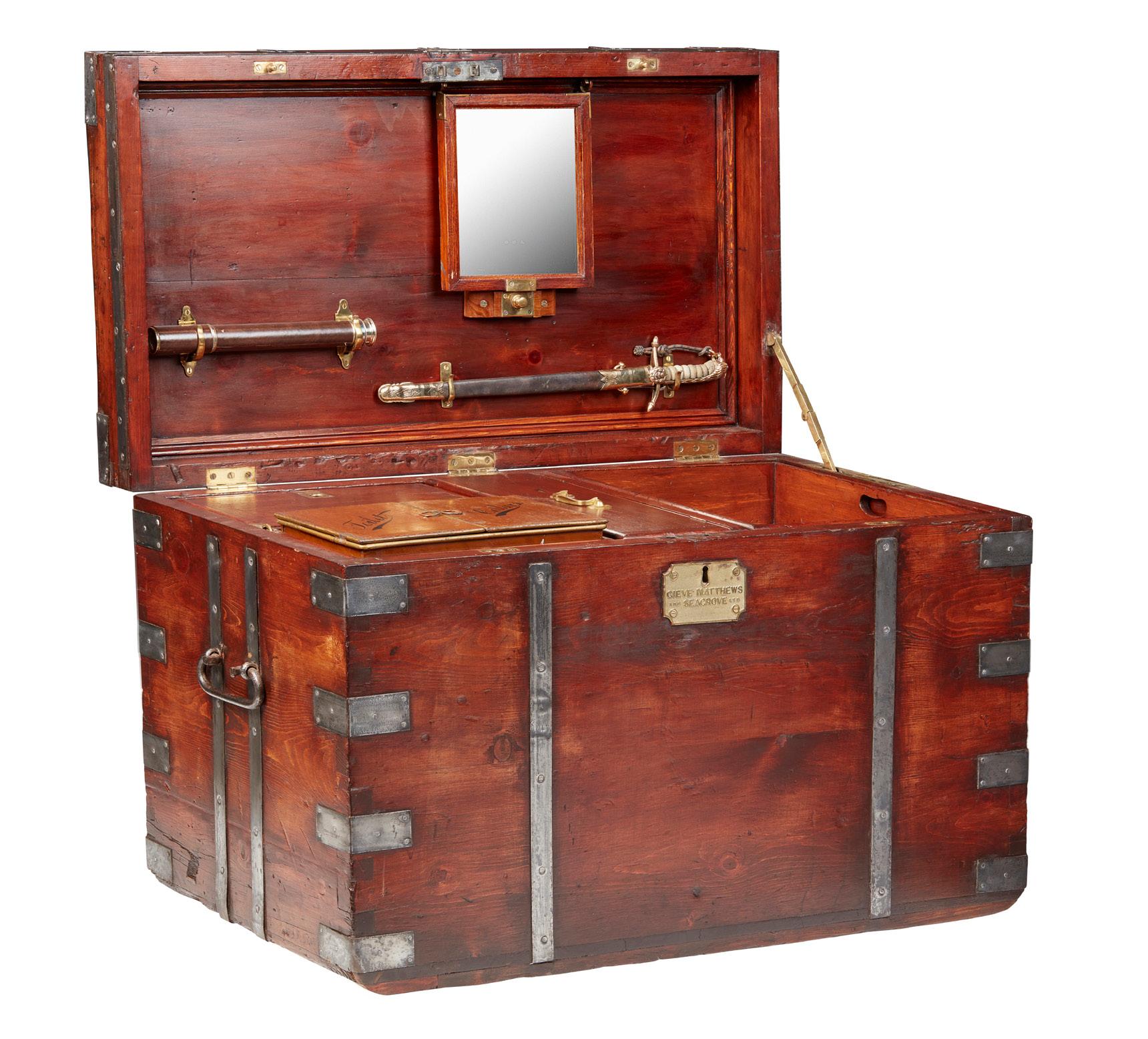
107cm wide, 69cm high, 61cm deep
Note: Royally appointed and originally established in 1785 as ‘Gieve Matthews Seagrove Ltd’, Gieves has a rich history as outfitters to the British Royal Navy. Following World War I, the company changed its name to Gieves Ltd, trading from 21 Old Bond Street, London.
£3,000-5,000
112
FRAMED SILK COMMEMORATIVE NAVAL NEEDLEWORK
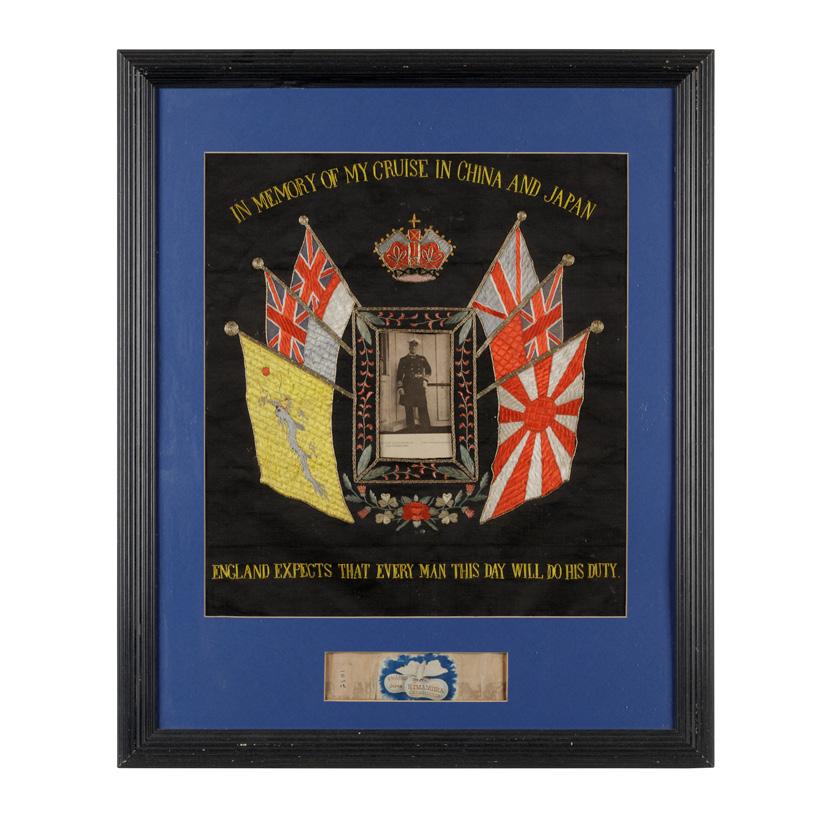
EARLY 20TH CENTURY
mounted with a photograph of Lord Charles Beresford taken from the 1908 Queen Alexandra’s Christmas Gift Book: Photographs From My Camera, the photograph flanked by an array of international flags including the Japanese Rising Sun and the yellow flag of the Qing Dynasty, the top inscribed ‘IN MEMORY OF MY CRUISE IN CHINA AND JAPAN’, the bottom inscribed ‘ENGLAND EXPECTS THAT EVERY MAN THIS DAY WILL DO HIS DUTY’, with an original embroiderer’s tag for H. Imamura of Nagasaki, Japan, framed the textile 41.5cm x 38cm
Note: Lord Charles Beresford (10 February 1846 – 6 September 1919) was a British admiral and Member of Parliament who served in the Royal Navy between 1859 and 1911. During his years of service, he spent time in China and Japan. Textiles like this one were bought by sailors as souvenirs for their tours overseas. Commissioned from Japanese embroidery shops, they often feature a similar design. The photograph featured on this one is from Queen Alexandra’s Christmas gift book - a compilation of 134 of her amateur photographs published to make money for charity.
£300-500
299
ROYAL NAVY FULL DRESS UNIFORM
EARLY 20TH CENTURY
belonging to Commander Wilfred St. Aubyn Malleson VC (British 1896–1975), including a black toleware case containing a pair of gold epaulettes, a black bicorn hat, a black and gilt sword belt, all by Grieve Ltd, also with a sets of rank epaulettes, the box hand painted with ‘Lieut. W. St. A. Malleson’ box 47cm long, 21cm high, 24cm deep
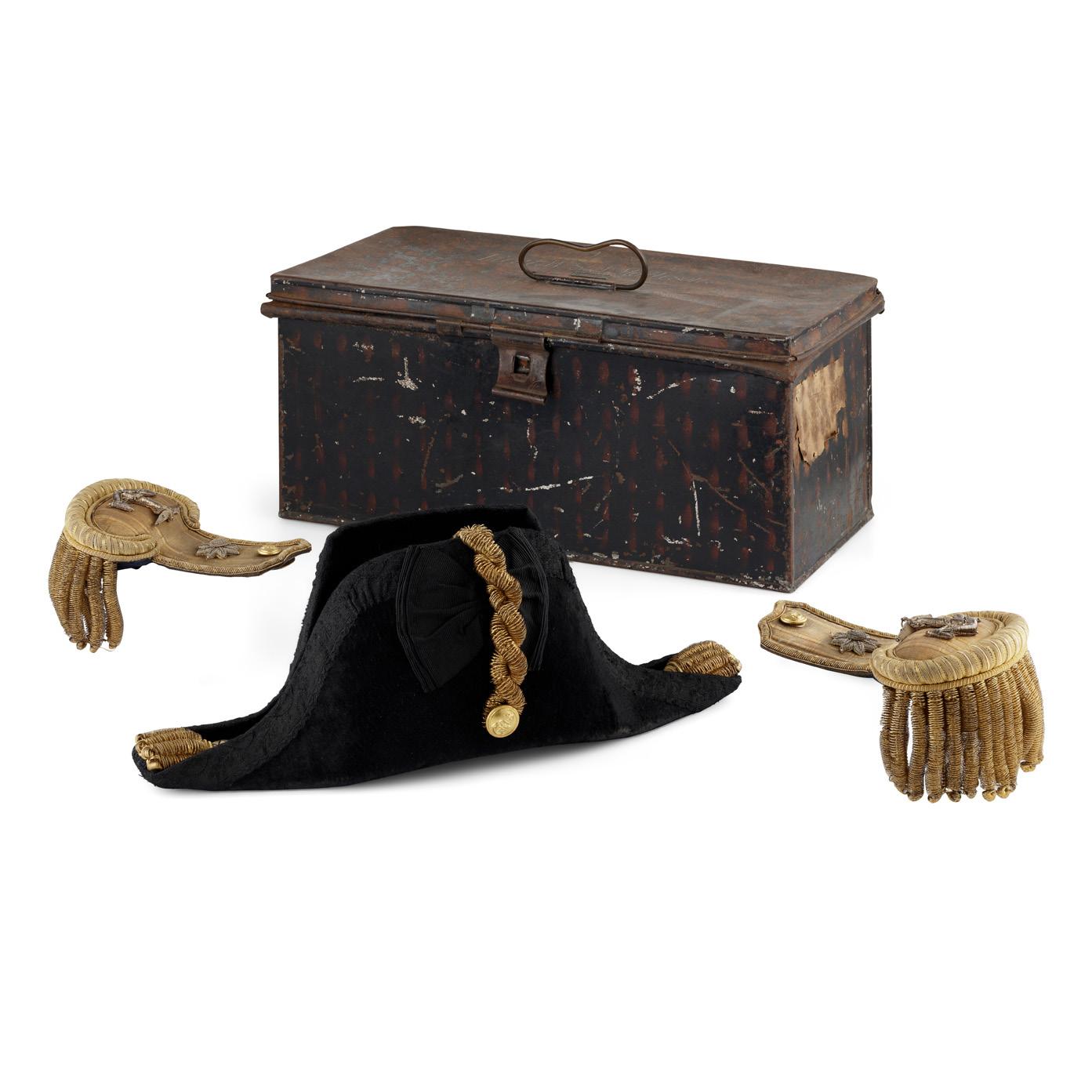
£300-500
Note: Commander Wilfred St. Aubyn Malleson VC was a British recipient of the Victoria Cross. Born in Kirkee, India, the son of Major-General Sir Wilfrid Malleson KCIE CB and Ida Kathleen King, daughter of Frederick St Aubyn King. On 25 April 1915 during the landing at V Beach, Cape Helles, Gallipoli, Turkey, Midshipman Malleson and three others of HMS River Clyde assisted the commander of the ship at the work of securing the lighters under very heavy fire. When the other midshipman with the party had failed, through sheer exhaustion to get a line from lighter to lighter, Midshipman Malleson swam with it himself and succeeded. The line subsequently broke and he afterwards made two further unsuccessful attempts at his self-imposed task. His VC is on display at the Lord Ashcroft Gallery in the Imperial War Museum, London.
300
SCOTTISH VICTORIAN ADMIRAL NELSON CAST-IRON UMBRELLA STAND, BY JONES & CAMPBELL
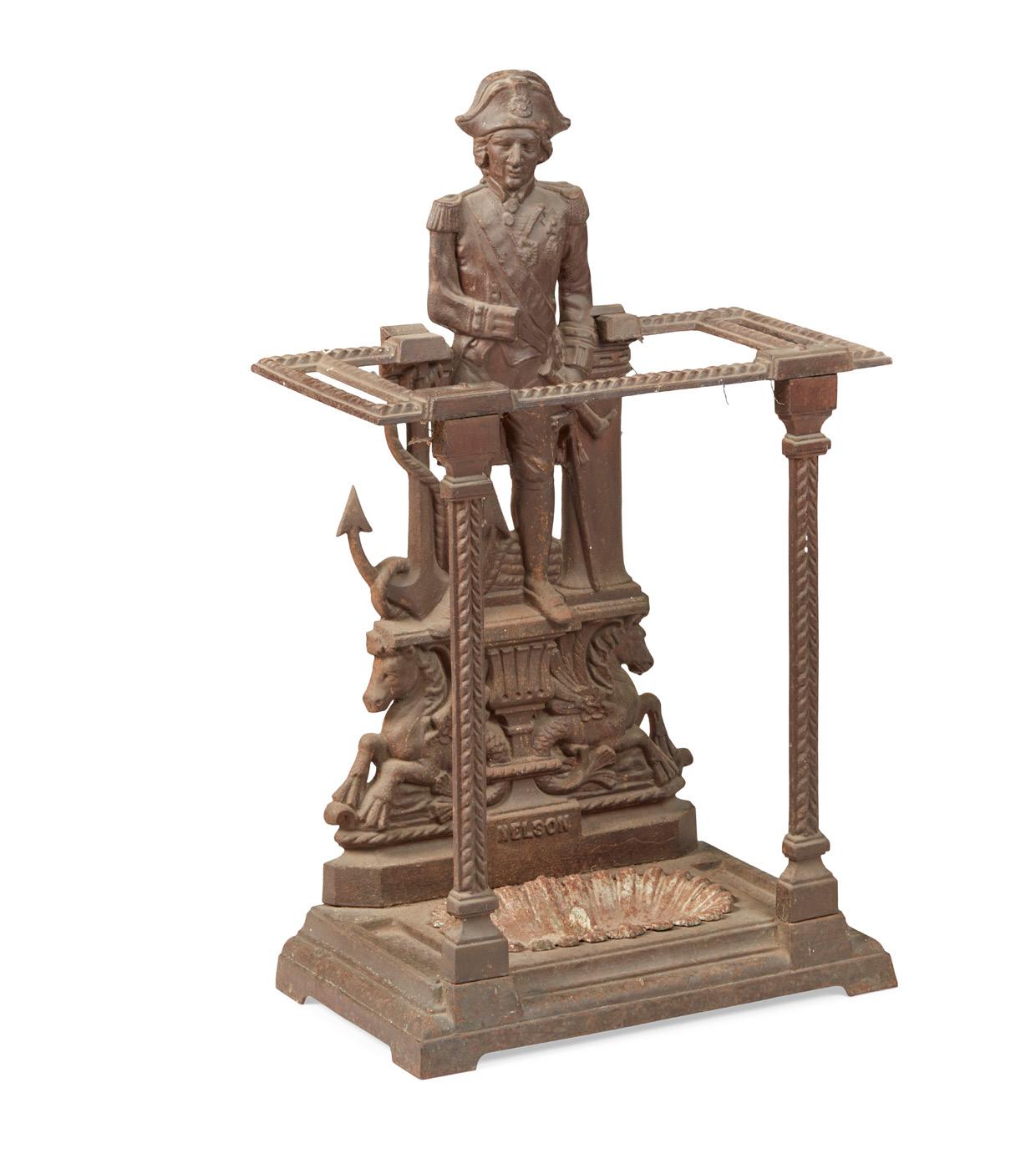
LATE 19TH CENTURY
the backplate cast in relief with his effigy atop a trident flanked by a pair of seahorses and titled to the front NELSON, the back stamped Rd 114928, the centre of the base with a lift out scalloped drip tray 49cm wide, 78cm high, 24.5cm deep
Note: This design, number 114928, was registered and patented by Jones & Campbell, the Forwood Foundry, Larbert, Stirlingshire at the Public Records Office on 26th November 1888.
£300-500
298
113 Other fees apply in addition to the hammer price: see the ‘Buyer’s Guide’ section on page 2
302
SET OF FIVE BEECH AND ELM WINDSOR ARMCHAIRS

MID 19TH CENTURY
the deep U-shaped backs with turned spindle supports above deep saddle seats, raised on turned legs joined by double H stretchers (5)
59cm wide, 79cm high, 48.5cm deep £1,000-1,500
301
GEORGIAN MAHOGANY BRASS BANDED CHEST
EARLY 19TH CENTURY
of cubic form with recessed brass handles, the hinged top with a painted reserve and monogram AD, opening to a void interior 49cm wide, 45cm high, 49cm deep
Provenance: Private Scottish Collection, Morayshire
£300-500
303
VICTORIAN WALNUT COACHING TABLE
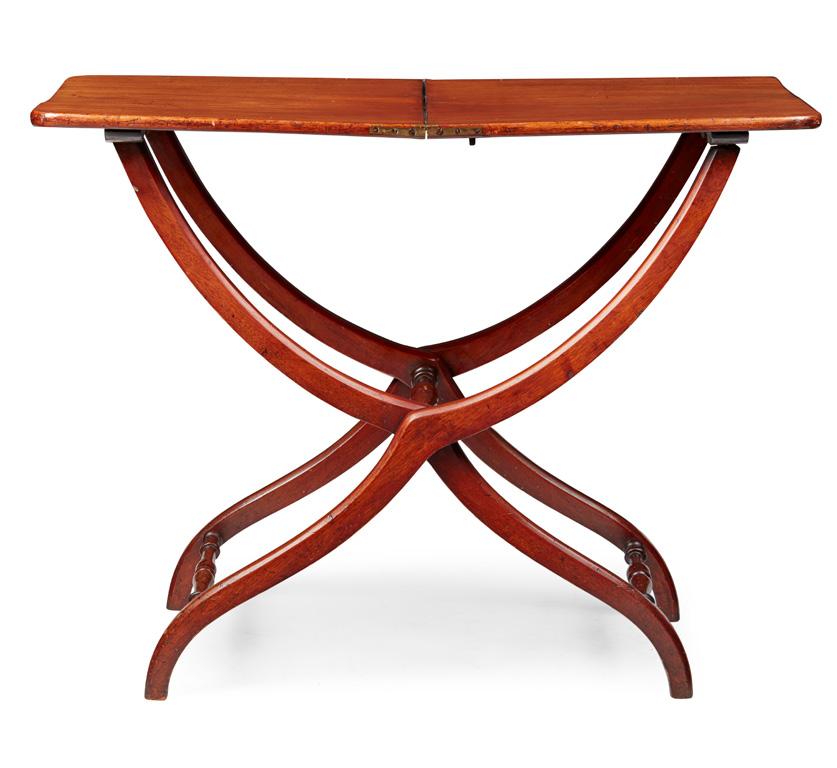
19TH CENTURY
the rounded rectangular folding top raised on x-frame supports, joined by turned stretchers
73cm wide, 93cm high, 51cm deep
£300-500
304
PADOUK CAMPAIGN CHEST AND CUPBOARD 19TH CENTURY

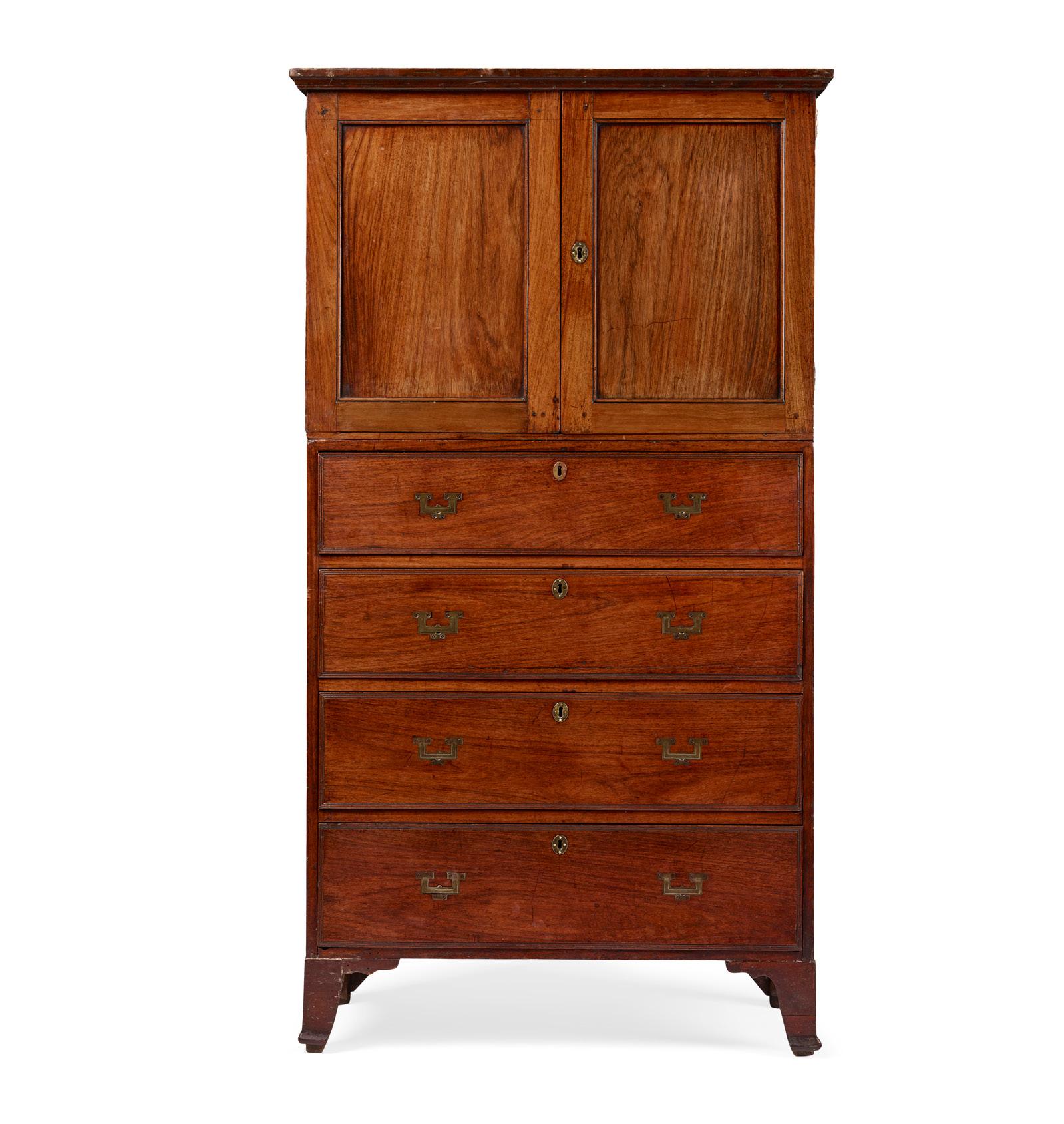
the cupboard with a later moulded cornice above a pair of panel doors enclosing two trays; the base with four long graduated drawers outlined with reeding and fitted with sunken brass handles, raised on later French bracket feet
92cm wide, 178cm high, 54cm deep
£2,000-3,000
114 Other fees apply in addition to the hammer price: see the ‘Buyer’s Guide’ section on page 2
305
PAINTED CAST IRON BRITISH ROYAL COAT OF ARMS
LATE 19TH/ EARLY 20TH CENTURY
cast in one piece with crest, arms, lion and unicorn supporters and motto and a pair scrolling foliate branches, painted black

50cm wide, 44cm high
£300-500
306
BRITISH MILITARY RED COAT AND BLACK FROCK COAT

EARLY 20TH CENTURY
the red coat made by Henry Poole & Co, 37-39 Saville Row, London, with annotated label dated 1906, with full gilt EVIIR buttons, epaulettes and aiguillette; the black frock coat of similar construction, the lining with label ‘Brig. Gen. C.J.Cuthbert C.B.’, with full gilt GVR buttons and epaulettes (2)
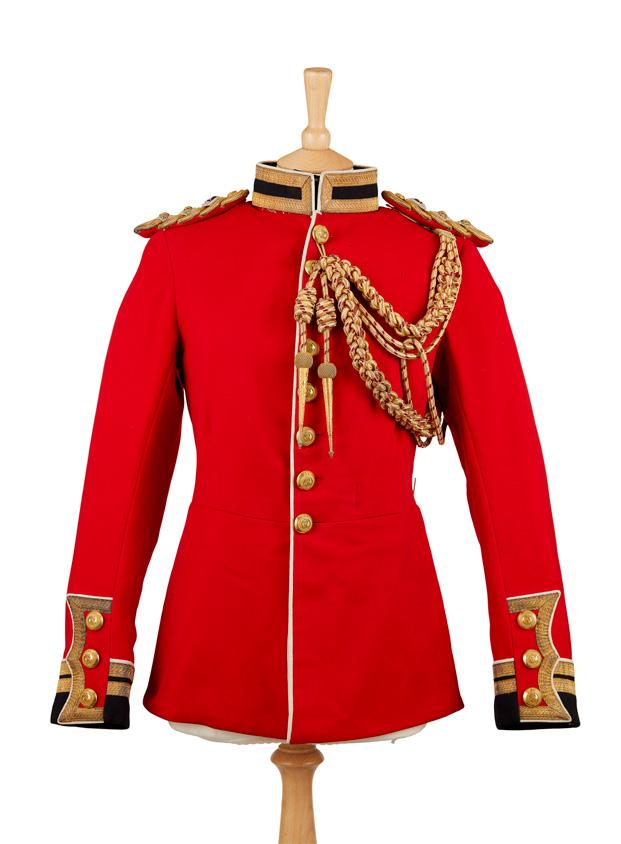
red coat 71cm long, black frock coat 109cm long
£300-500
Note: Major-General Gerald James Cuthbert CB CMG (British 1861 – 1931) was a British Army officer who commanded a battalion in the Boer War and a division in the First World War. Cuthbert joined the Scots Guards in 1882 and served in Egypt and the Sudan during the late 19th century. During the Boer War he served with his regiment, rising to command a battalion and after the war he was given command of a brigade in the Territorial Force and then in the British Expeditionary Force of 1914. He served on the Western Front from 1914 to 1917, rising to command 39th Division, then returned to home service before retiring in 1919.
307
VICTORIAN OAK AND BRASS BANDED STICK STAND
19TH CENTURY
of flattened barrel form with six brass bands
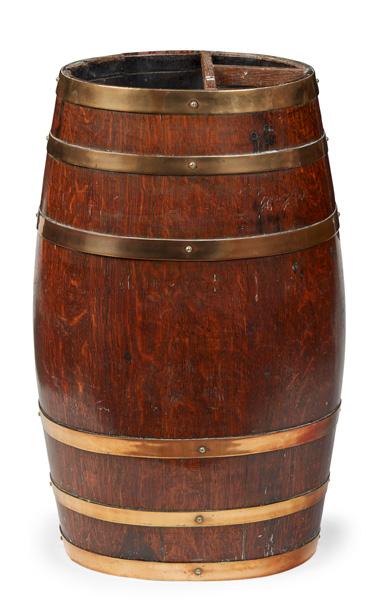
33cm wide, 66cm high, 27cm deep
Provenance: Private Scottish Collection, Morayshire
£300-500
308
TEAK AND BRASS CAMPAIGN SECRETAIRE CHEST OF DRAWERS

MID 19TH CENTURY
in two parts, the upper part with two short drawers, one fitted as a secretaire, the other with two lift-out trays, the base with three long graduated drawers, on removable turned feet
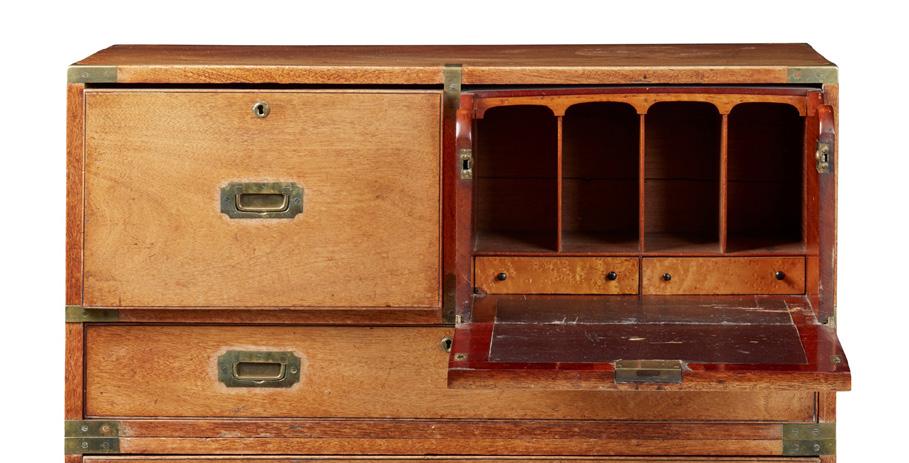
91cm wide, 105cm high, 48cm deep
£800-1,200
115
310
ENGLISH BRASS SURVEYOR’S LEVEL, BY TROUGHTON & SIMMS
LATE 19TH CENTURY
the sight set with a bubble level above, on a pivoting base signed ‘Troughton & Simms London’, on a large wooden tripod level 39.5cm long, tripod 145cm high
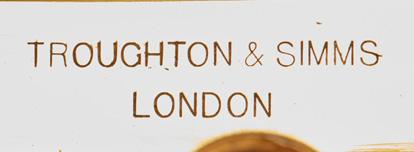
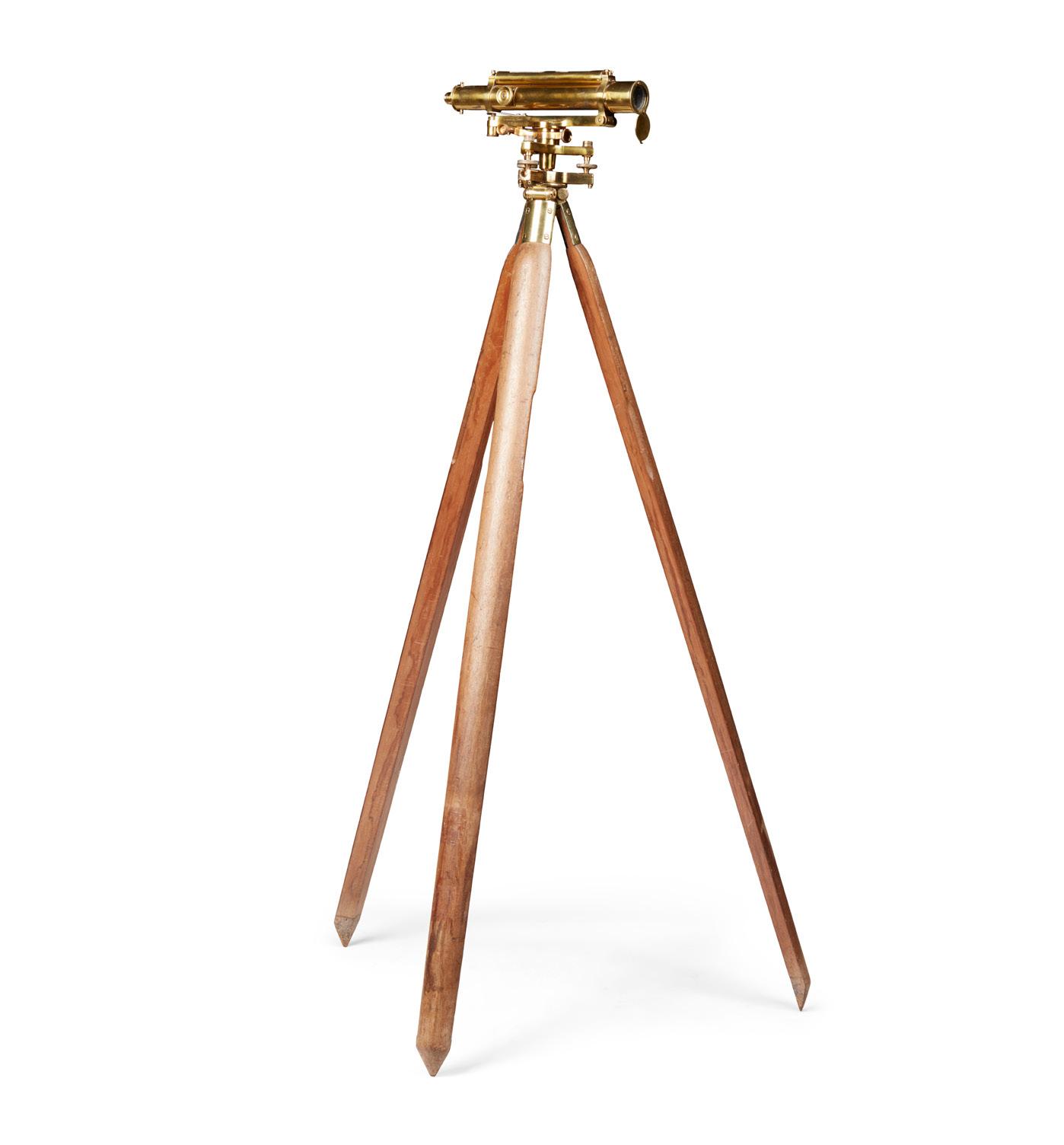
Provenance: Property of the late Frederick Ernest Noble, Consulting Engineer, of George Street Edinburgh and Short Road Chiswick
£500-800
311
LEATHER CRICKET BAG AND BAT

20TH CENTURY
the brown leather case with brass hardware and Gladstone type fastenings, monogramed with initials ‘L.M.C.’; together with a Gradidge Woolwich ‘Imperial Driver Super Extra Special’ willow cricket bat, stamped ‘Stokes, London, 24 Queen Victoria Street’, signed in ink ‘Lorne M Campbell’ Bag 95cm wide, 25cm high, 28cm deep
Provenance: Alastair Lorne Campbell of Airds (Scottish 1937-2022)
£300-500
309
FIVE ENGLISH ROWING RACE TROPHY OARS
LATE 19TH CENTURY
all won by Robert Octavius
Pitman, and made by Ayling & Sons, Vauxhall, London; the full length blades with paddles painted with the race and competitors that won, including the Grand Challenge Cup (Eights), Henley 1895, Grand Challenge Cup (Eights), Henley 1897 (New College, Oxford), Visitor Challenge Cup (Fours), Henley Royal Regatta 1898 (New College, Oxford), Grand Challenge Cup (Eights), Henley 1900 (Leander) and Stewards Challenge Cup (Fours), Henley 1900 (Leander) (5) all approximately 380cm long, 15cm wide
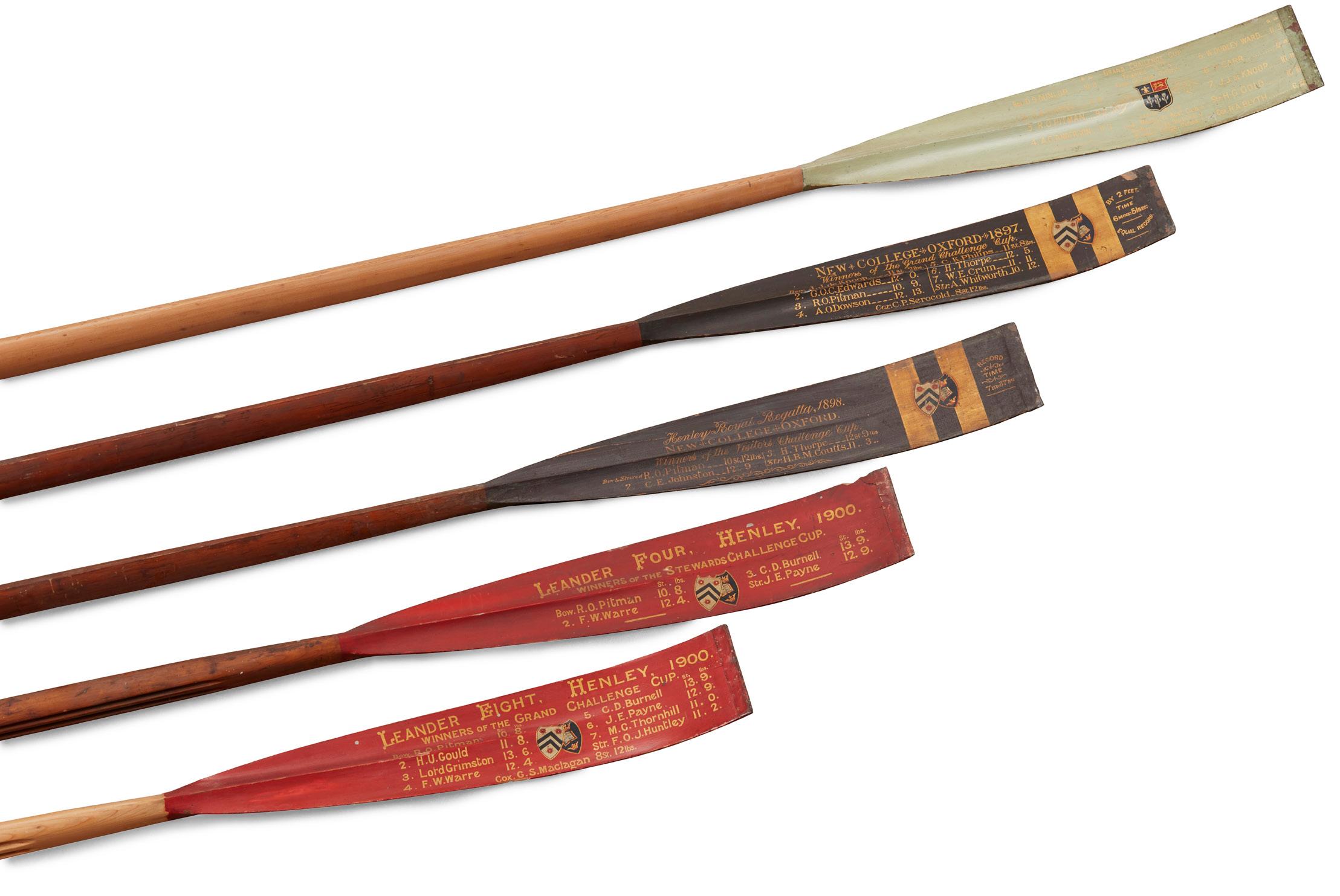
Provenance: Robert Octavius Pitman W.S. was a member of the Pitman family who were partners in the legal firm of J & F Anderson of 42 Castle Street Edinburgh, later amalgamated into Anderson Strathern. After his rowing career for New College Oxford and Leander Rowing Club he settled at The Corner House, Gullane, with his wife Beatrice (née Sanderson). Robert was also part of the eight that won the 55th Oxford and Cambridge Boat Race of 1898 and the Leander Eight that won the Grand Challenge Cup, Henley in 1899. Hence by decent to his son and now to the present owner.
£500-800
116
312
PHILIPS 13 INCH TERRESTRIAL GLOBE
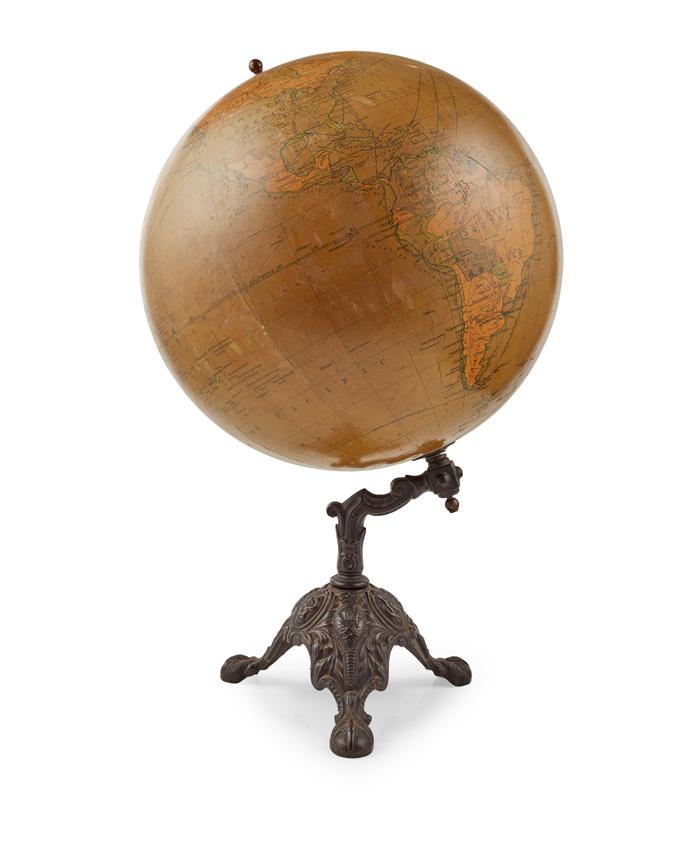
LATE 19TH/ EARLY 20TH CENTURY
with twelve gores and maker’s cartouche ‘PHILIPS/ NEW COMMERICAL TERRESTRIAL GLOBE/ Principal Shipping Routes with distances in Nautical Miles/ Principal Railroads/ All British Cables/ LONDON, GEORGE PHILIP & SON LTD 32 FLEET STREET’, with brass screw axis on a cast iron triform base 57cm high (in total)
£300-500
313
JACQUES ‘STAUNTON’ TOURNAMENT CHESS SET

EARLY 20TH CENTURY complete set of thirty-two weighted pieces in boxwood and ebony, the kings stamped ‘JACQUES LONDON’ in red, crown marks on the half the rooks and knights, in a mahogany box with two compartment interior fitted with green felt box 21.5cm wide, 11cm high, 15cm deep £1,000-1,500
314
BRASS ROCKING CHAIR, BY R.W. WINFIELD & CO.
MID 19TH CENTURY
the frame of tubular brass, with later buttoned brown leather upholstery
60cm wide, 118cm high approx.
£1,200-1,800
315
BRASS ROCKING CHAIR, BY R.W. WINFIELD & CO.

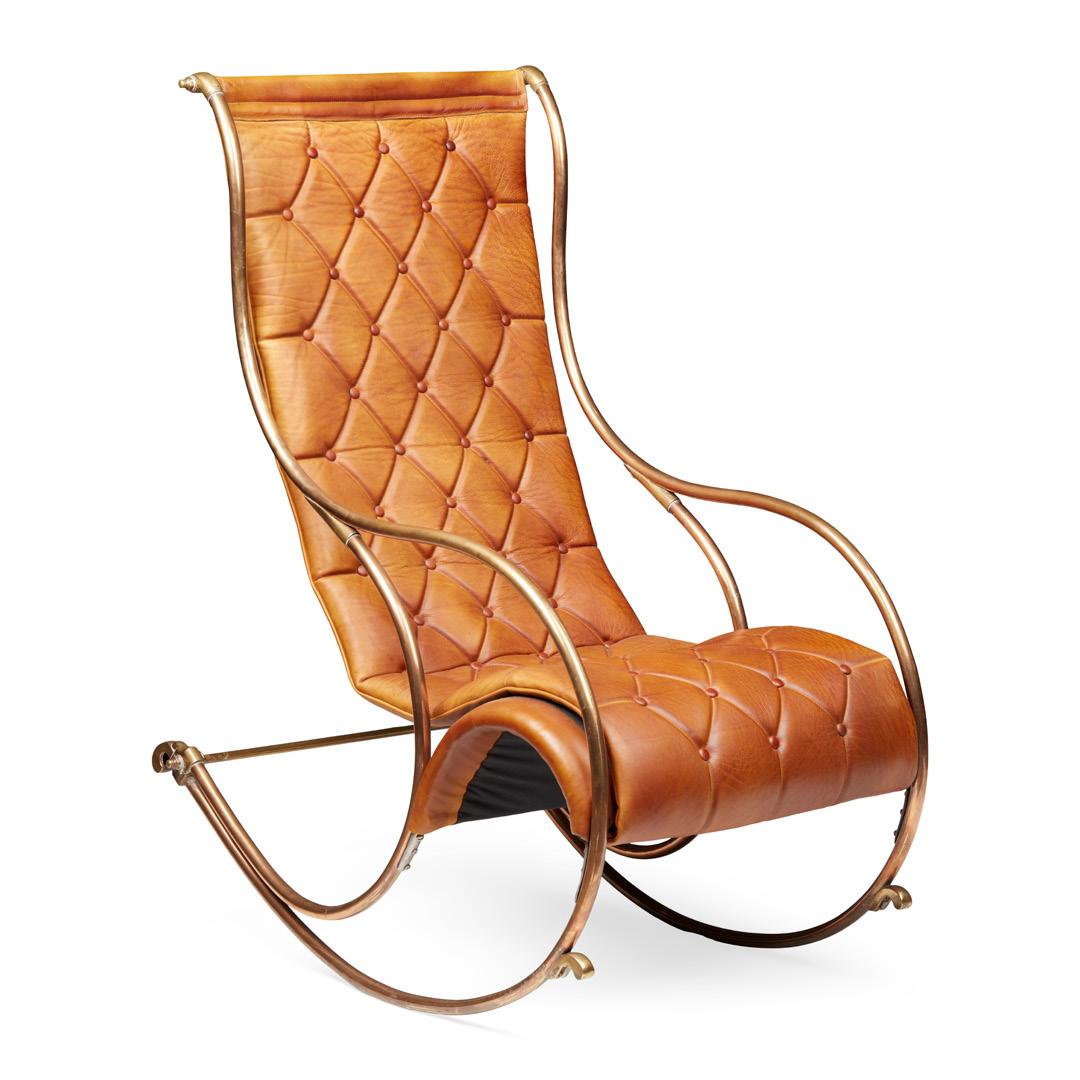
MID 19TH CENTURY
the frame of tubular brass, with later buttoned brown leather upholstery
60cm wide, 117cm high approx
£1,200-1,800
Note: The original designer and manufacturer of this rocking chair has not been identified. The firm of R.W. Winfield specialised in metal furniture, particularly beds, and between 1827 and 1854 took out several patents relating to the construction of beds and sofas using iron tubing. Their stand at the Exhibition of 1851 included a rocking chair of tubular brass, similar to this one. They showed another example in strap brass at the London International Exhibition of 1862
117 Other fees apply in addition to the hammer price: see the ‘Buyer’s Guide’ section on page 2
316
EARLY HOVIS ADVERTISING MIRROR LATE 19TH CENTURY

the rectangular plate reverse painted in green and parcel-gilt letters ‘HOVIS/ THE WORLD’S BEST BREAD/ TRADEMARK’, in an oak moulded frame
152cm high, 76cm wide
£2,000-3,000
317
SCOTTISH CARVED OAK WALL BRACKET DIAL CLOCK, BY BRYSONS, EDINBURGH
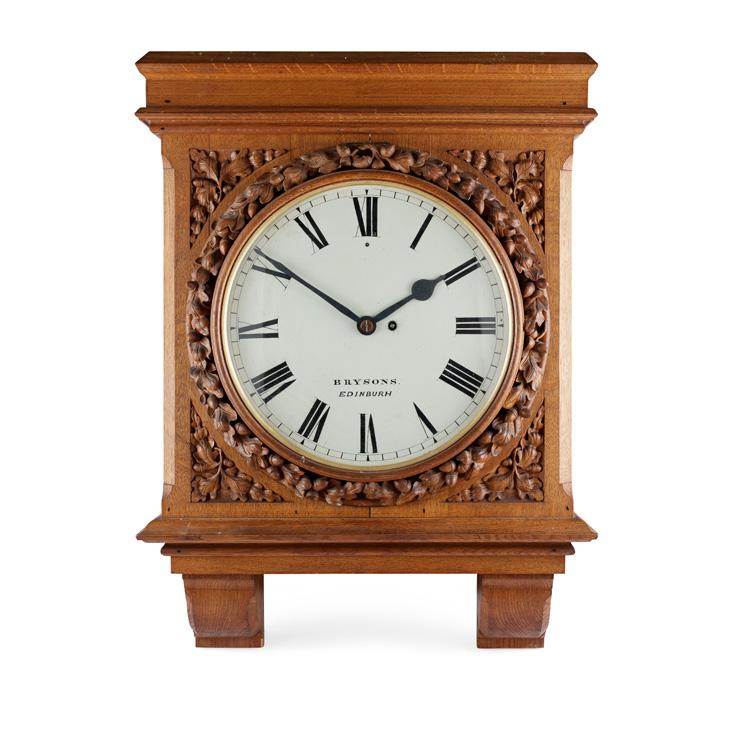
LATE 19TH CENTURY
the circular 13 inch cream enamel dial with black painted Roman numerals and a single winding hole, the square case carved in deep relief with oak leaves and acorns, above an integrated bracket, the brass single chain fusée timepiece movement with an anchor escapement
57cm wide, 78cm high, 17cm deep
£500-700
318
EARLY VICTORIAN STAINED ASH HOUSEKEEPER’S CABINET
19TH CENTURY
the top with a moulded cornice above a pair of panel doors enclosing a shelved interior, the lower part with two short over three long graduated drawers, all with turned lignum vitae knobs, on a shaped plinth base
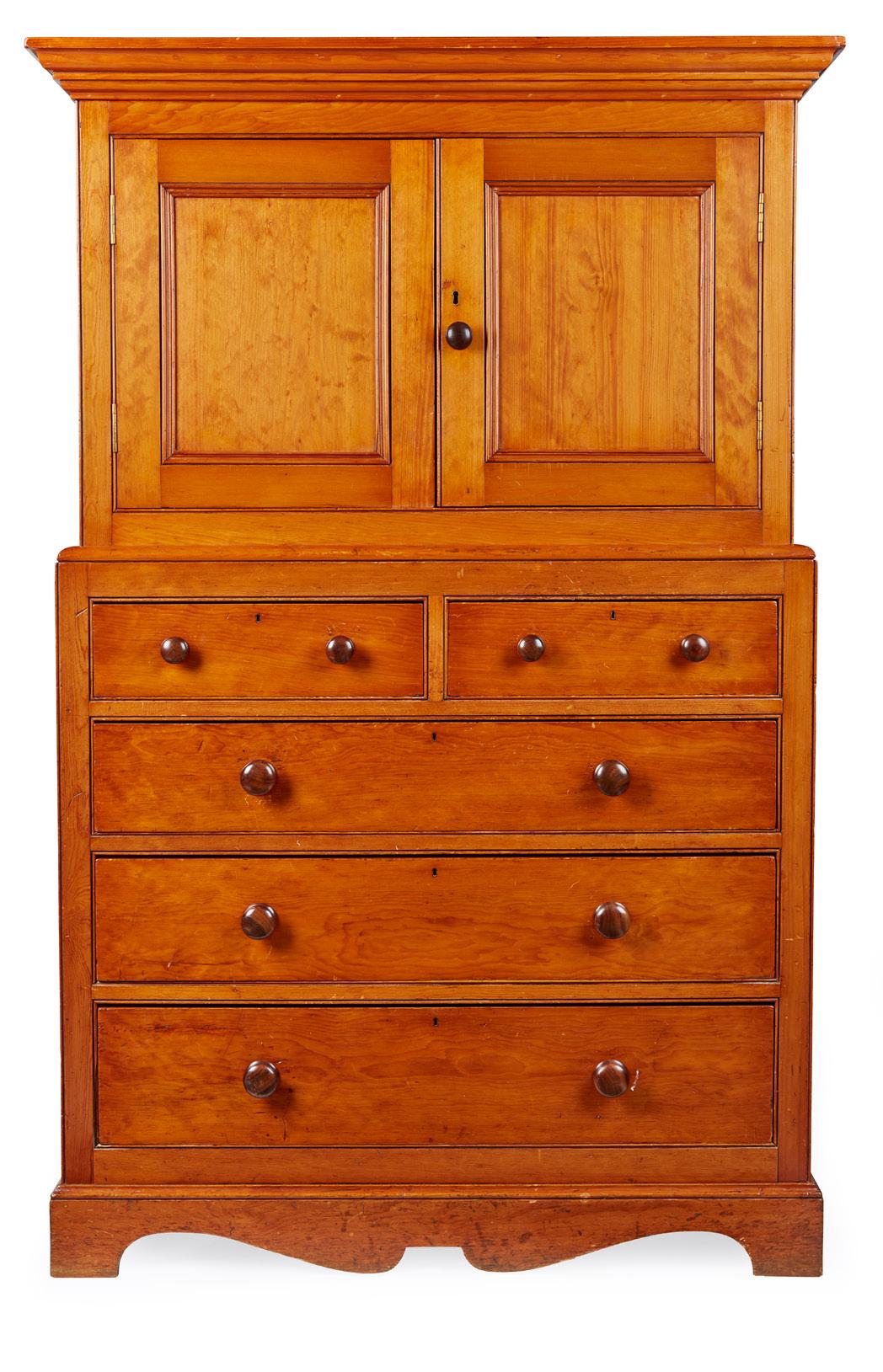
127cm wide, 198cm high, 57.5cm deep
£500-700
319
GEORGIAN YEW WOOD TEA TABLE, POSSIBLY IRISH LATE 18TH CENTURY

the rectangular tilt top on a reeded column and base with outswept legs ending in brass caps and castors
75cm wide, 86cm high, 73cm deep
£300-500
118 Other fees apply in addition to the hammer price: see the ‘Buyer’s Guide’ section on page 2
320
ROWNTREE’S CHOCOLATES MAHOGANY GLAZED DISPLAY CABINET

EARLY 20TH CENTURY
the scroll carved pediment with an eglomise mirror panel painted with cacao beans and inscribed ‘ROWNTREE’S CHOCOLATES’, with fully glazed sides and glass shelves, on a moulded base
82wide, 96cm high, 44cm deep
£1,200-1,800
321
VICTORIAN FRUITWOOD PARQUETRY GAMES TABLE
MID 19TH CENTURY
the rectangular top with a moulded edge and inlaid with a games board and chequer and diamond motifs, above three short drawers, raised on turned and tapered legs
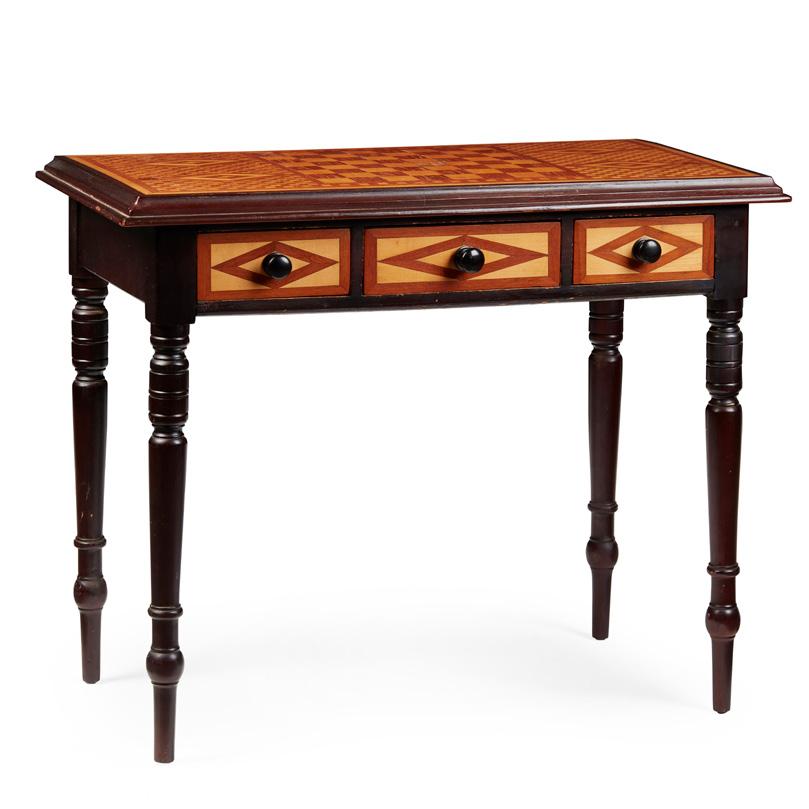

93cm wide, 77cm high, 52cm deep
£300-500
322
EARLY VICTORIAN ELM AND BEECH CHILD’S WINDSOR ARMCHAIR
MID 19TH CENTURY
the hoop back with spindles above U-shaped arms, above a shaped seat with separate cushion, raised on ring-turned legs joined by an H stretcher
49cm wide, 79cm high, 40cm deep
£400-600
323
THAMES VALLEY YEW WOOD AND ELM WINDSOR ARMCHAIR
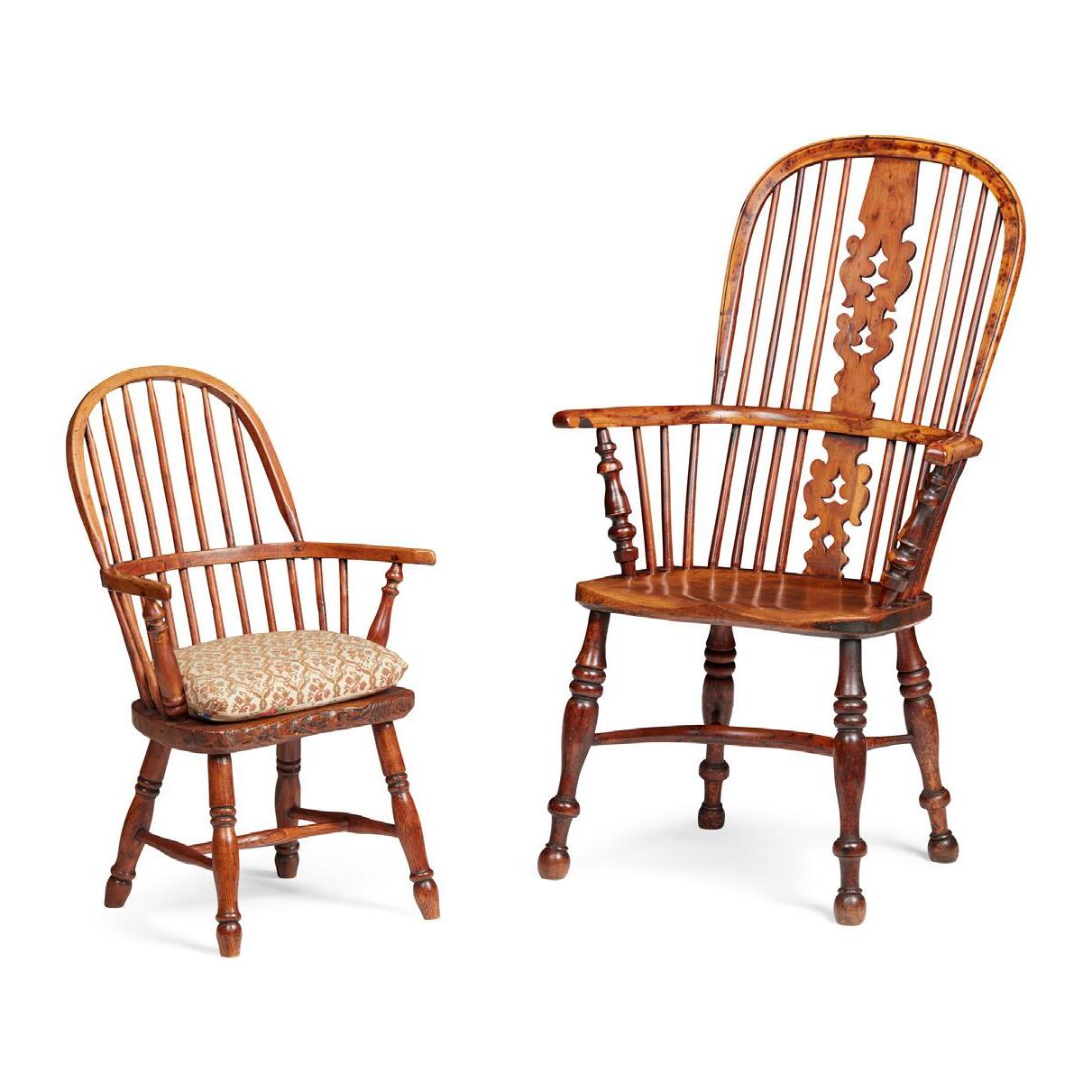
EARLY 19TH CENTURY
the well-figured yew wood hoop back with spindle supports and a pierced vasiform splat, above a horseshoe shaped arm rail on further spindles and pierced splat, over a saddle seat raised on turned and tapered legs joined by a crinoline stretcher
66cm wide, 111cm high, 42cm deep
£800-1,200
324
VICTORIAN STRIPPED PINE DRESSER BASE
19TH CENTURY
the top with a bevelled edge above a pair of panel door flanked by banks of three short drawers, raised on later bun feet
209cm wide, 79cm high, 80cm deep
£600-800
119
325
LATE GEORGIAN/ REGENCY BRASS FIREPLACE INSERT
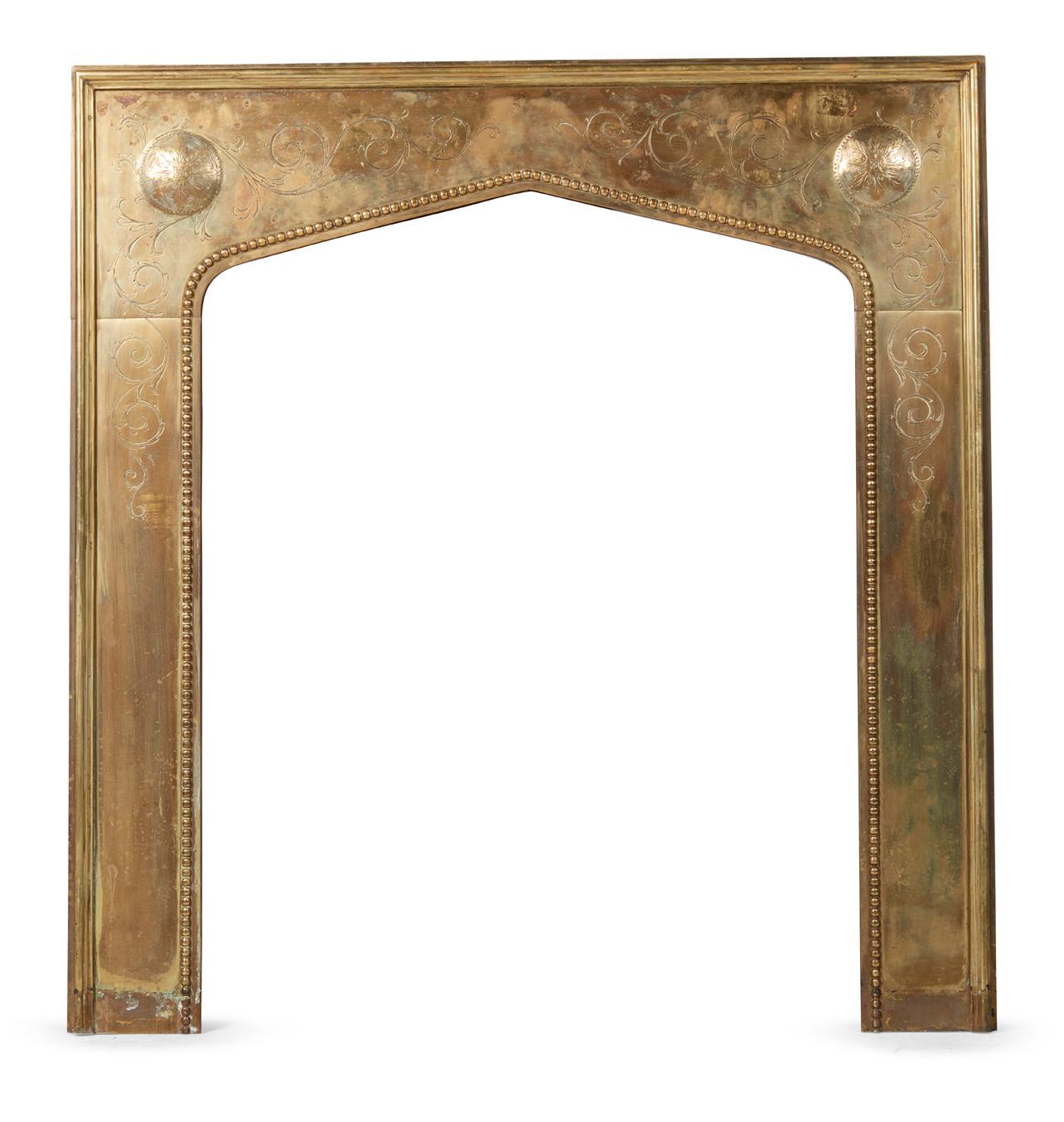
EARLY 19TH CENTURY
neo-gothic style with an arched opening outlined with beading, the panels engraved with foliate scrolls and flower head engraved corner bosses
97cm high, 91cm wide
£1,000-1,500
326
EARLY VICTORIAN GOTHIC REVIVAL CAST IRON FIRE BASKET
MID 19TH CENTURY
the arched pediment backplate with strapwork detail, above a four bar grate and canted scrolling andirons with flower heads
79cm wide, 74cm high, 45cm deep
£400-600
327
VICTORIAN RENAISSANCE REVIVAL CAST IRON FIRE GRATE
MID 19TH CENTURY
the arch pediment backplate with cast with initials TF & SK and dated 1861, above a two bar grate supported on integral acanthus cast andirons of baluster form on tripartite bases cast with masks, on scrolling feet
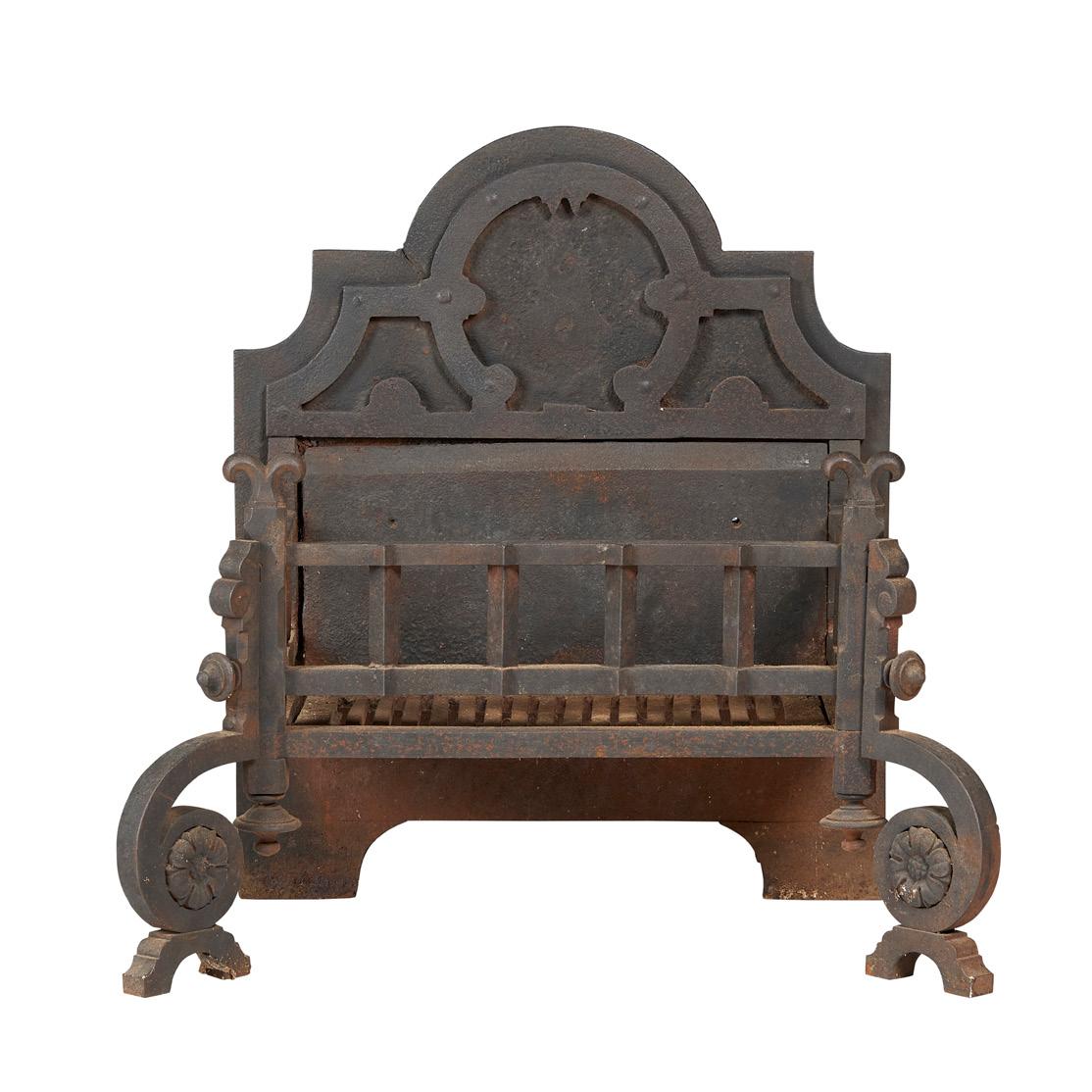

132cm wide, 73cm high, 73cm deep £800-1,200
328
BRASS AND LEATHER CLUB FENDER
20TH CENTURY
with L shaped black leather fender pads on an adjustable brass spindle base
126cm wide [shortest] 154cm [longest], 43cm high, 40cm deep
£250-350
120
FRAMED COLLECTION OF SCOTTISH FREEMASONS CARTES DE VISITE

19TH CENTURY
comprising sixty-five cartes de visite and photographs of gentlemen, members of Rifle Lodge 405, some wearing fraternal regalia and enhanced with hand colouring, mounted in an oak frame with gilt slip, with a brass plaque engraved RIFLE LODGE 405./ THOMAS FORD R.W.M./ 1872.
87cm high, 124cm wide £300-500
330
SCOTTISH LONGCASE CLOCK, OF MASONIC INTEREST

EARLY
19TH CENTURY
the swan neck pediment with a brass eagle finial, above a painted Roman numeral dial with subsidiary seconds and calendar dials, the arch painted with Masonic symbols and the spandrels with figures representing the seasons, flanked by stop-fluted columns, above a crossbanded and inlaid trunk door flanked by quarter columns, on a conforming plinth raised on bracket feet, the twin-chain, eight day movement striking a bell 221cm high, 50cm wide £600-800
Note: The Rifle Lodge 405, a member of The Grand Lodge of Ancient Free and Accepted Masons of Scotland held their first meeting on 10th May 1860, three days after its charter had been granted and signed by the Duke of Atholl, the then Grand Master Mason. The inauguration of the Lodge and the installation of the first office-bearers took place in Freemasons’ Hall, George Street, on 5th June 1860. The Lodge originally met on the first and third Tuesdays of each month from September to May with touches of Masonic spirit flavouring the meetings such as the giving of the Right Hand of Fellowship to each member on admission.

331
VICTORIAN LARGE OAK ‘COUNTRY HOUSE’ STICK STAND

19TH CENTURY
with chamfered corner posts with pyramidal finials, comprising eight divisions, on a moulded base with the original metal liner
125cm wide, 61cm high, 31cm deep £800-1,200
329
121 Other fees apply in addition to the hammer price: see the ‘Buyer’s Guide’ section on page 2
335
VICTORIAN EBONISED, GILT BRASS, AND PORCELAIN MOUNTED SIDE CABINET
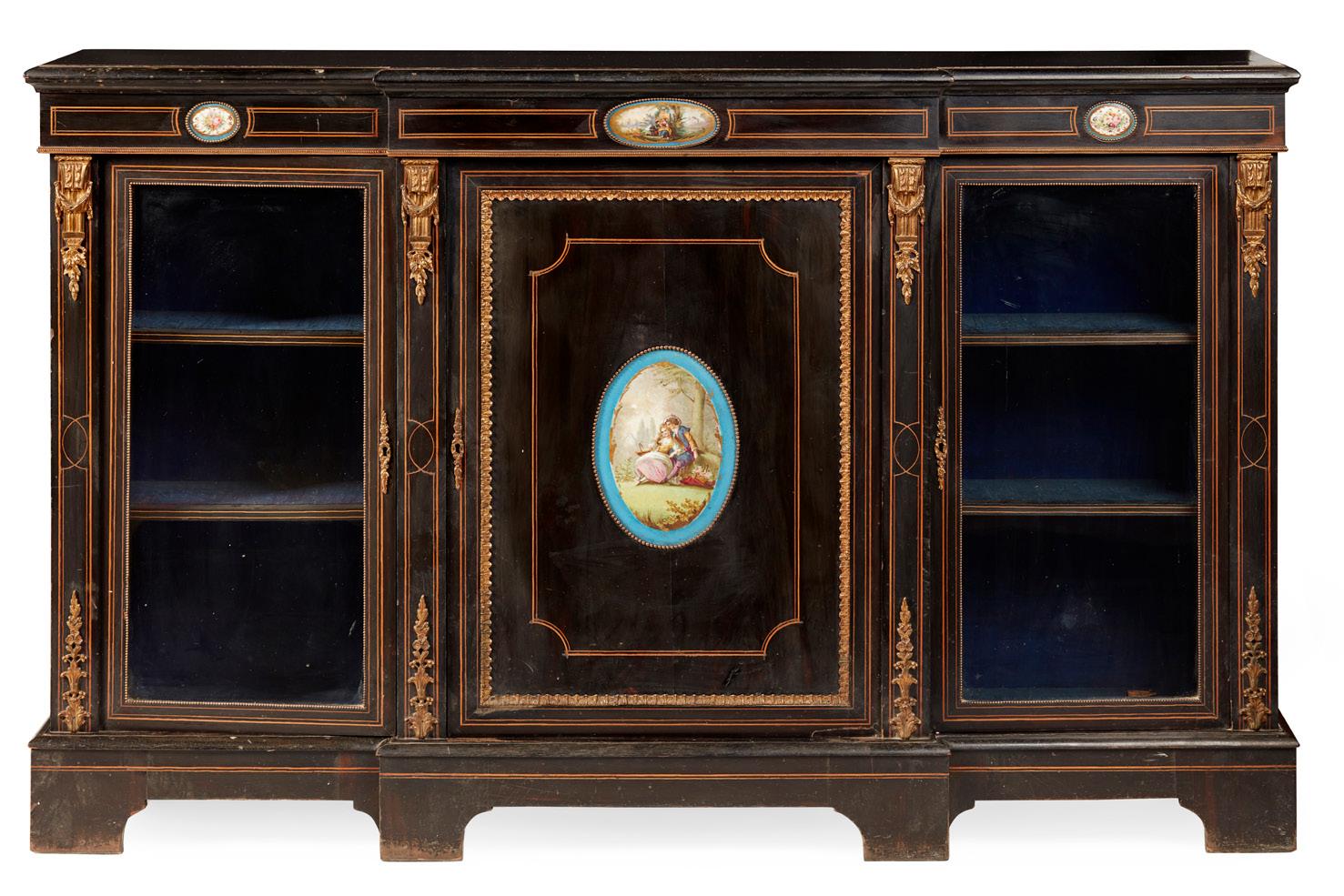
19TH CENTURY
of breakfront outline above a frieze mounted with Sèvres style porcelain plaques, over a central door mounted with a large oval porcelain plaque painted with a courting couple, flanked by glazed doors enclosing shelves lined with blue velvet, on bracket feet, the whole outlined with gilt brass mounts
167cm wide, 107cm high, 38cm deep
£1,000-1,500
332
YEW WOOD OCCASIONAL TABLE
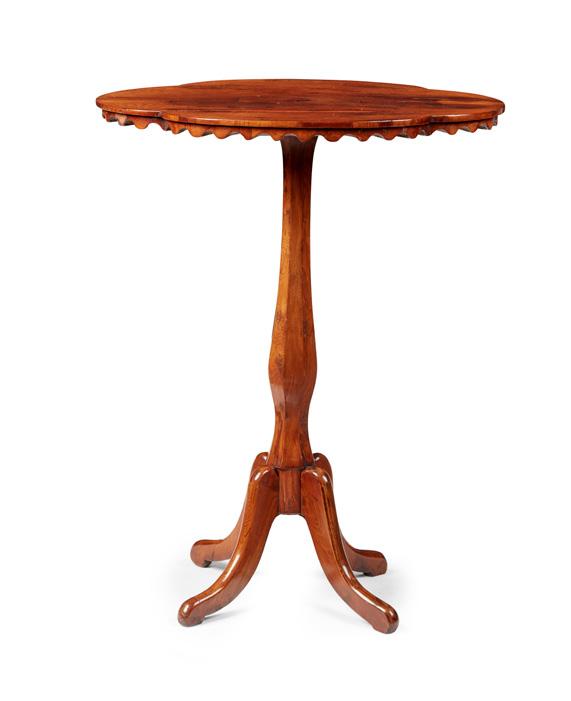
19TH CENTURY
the lobed oval top on a faceted baluster support and outswept legs 56cm wide, 72cm high, 41cm deep
£300-500
333
LARGE VICTORIAN MAHOGANY CHEVAL MIRROR
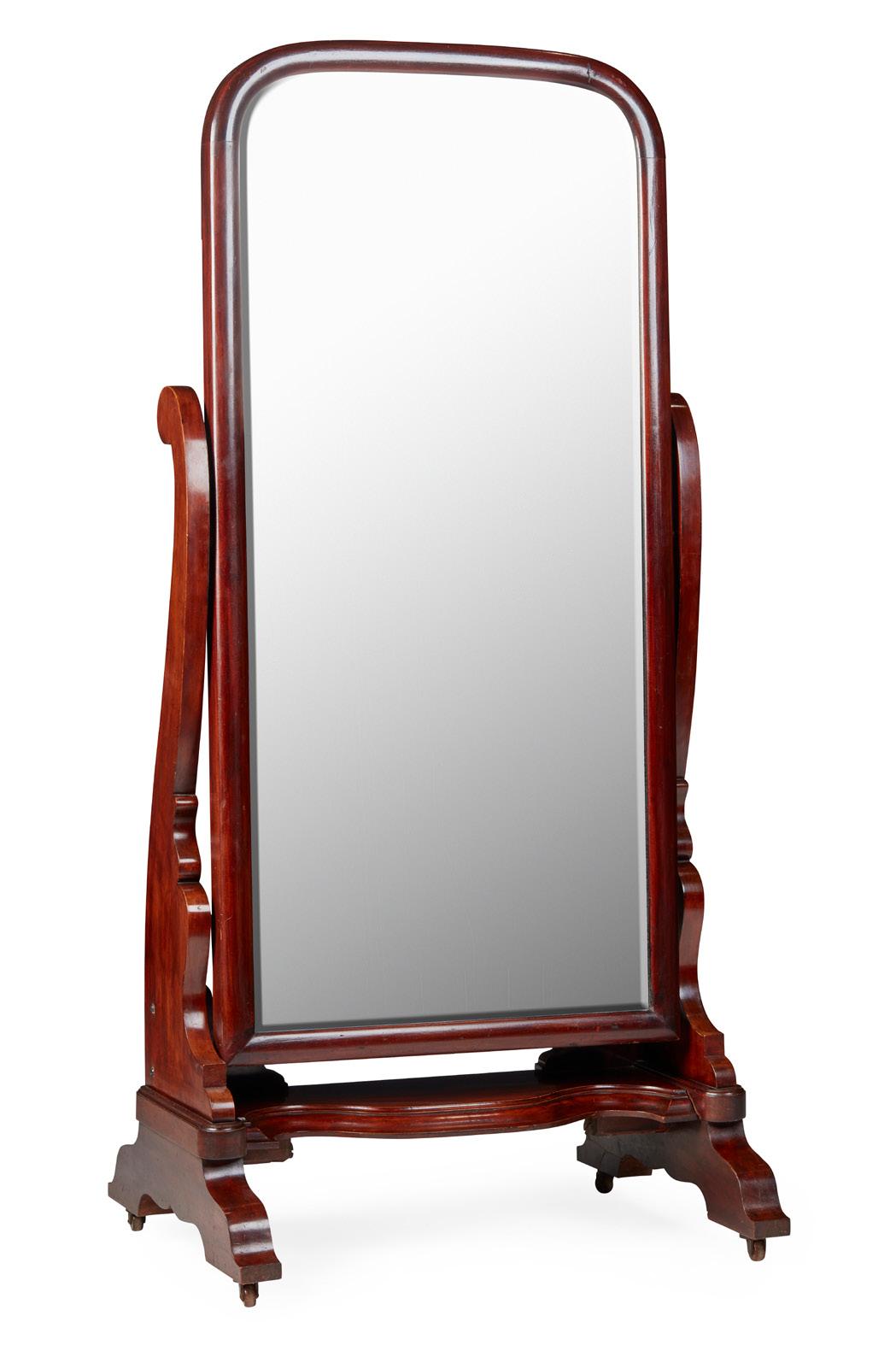
19TH CENTURY
the arched and bevelled mirror plate in a moulded frame flanked by scrolled supports, on a shaped platform raised on trestle bases with brass and porcelain castors
84cm wide, 181cm high, 69cm deep
£800-1,200
334
EARLY VICTORIAN MAHOGANY WHATNOT
MID 19TH CENTURY
the rectangular galleried tiers with shaped and moulded apron, raised and divided by bobbin turned supports, on tapered feet ending in ceramic castors

46cm wide, 98cm high, 38cm deep
Provenance: Private Scottish Collection, Morayshire
£400-600
122 Other fees apply in addition to the hammer price: see the ‘Buyer’s Guide’ section on page 2
336
EARLY VICTORIAN MAPLE AND NEEDLEWORK FOURPANEL SCREEN
MID 19TH CENTURY
each panel comprising three individual panels worked in wools and silks with botanical studies within arched gilt mounts
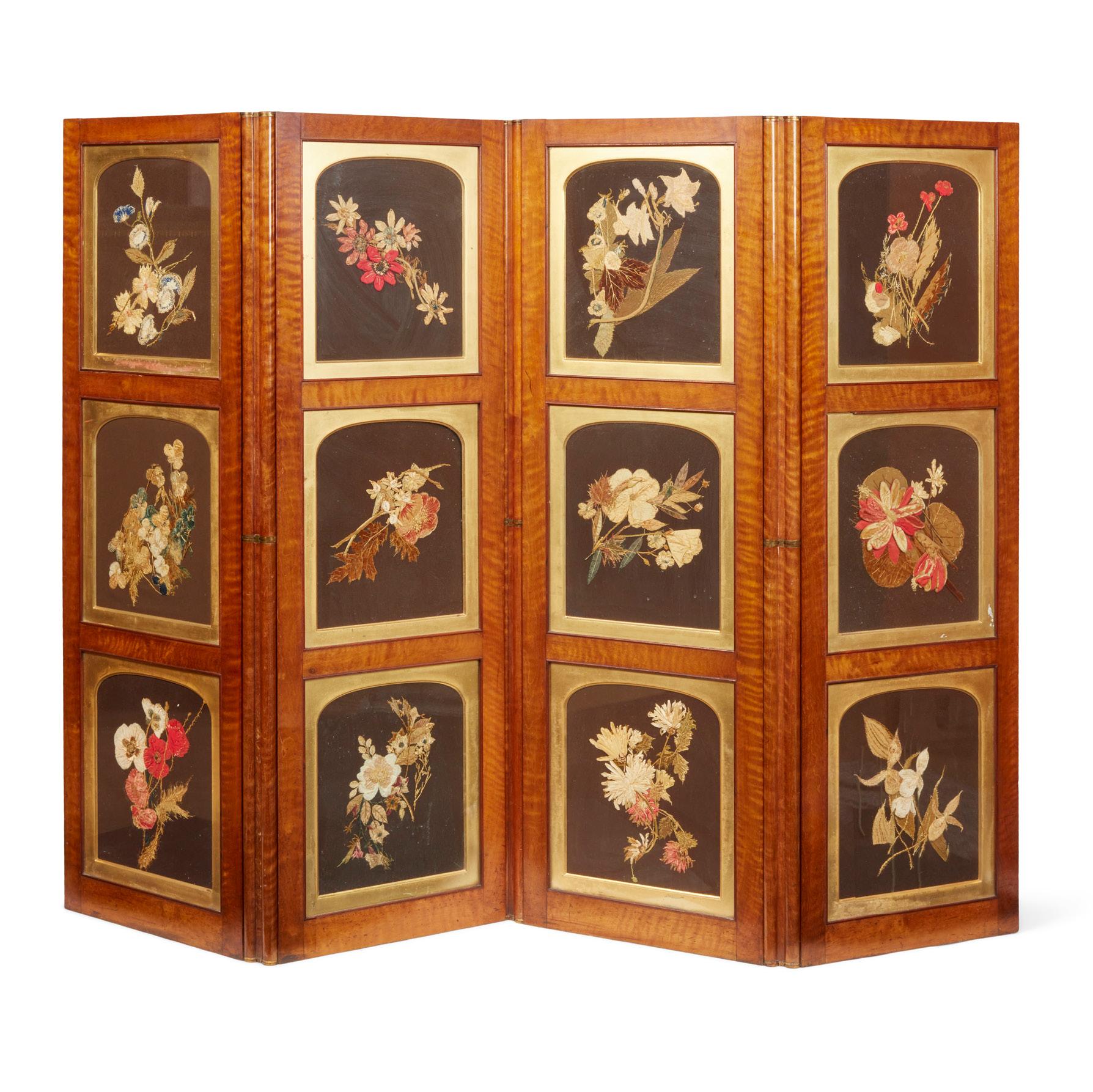
217cm wide, 160cm high
£800-1,200
337
EARLY VICTORIAN WALNUT
TRIPOD TABLE, G. HINDLEY & SONS
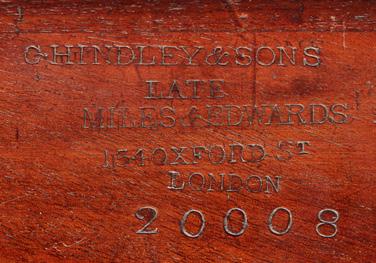
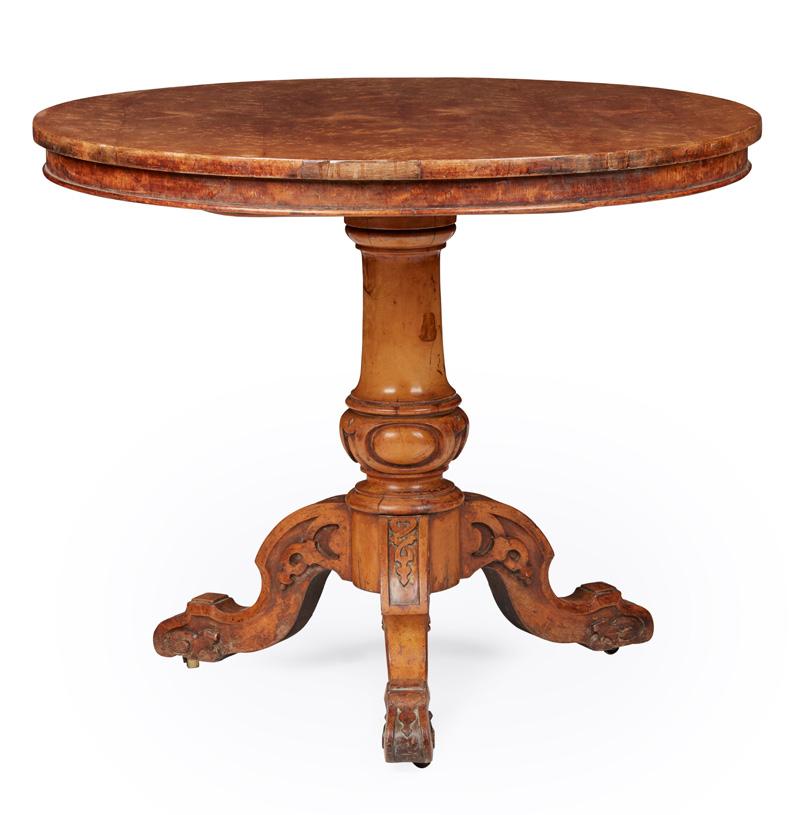
MID 19TH CENTURY
the circular tilt top on a carved baluster column and carved scroll legs with brass castors, stamped G. HINDLEY & SONS/ LATE MILES & EDWARDS/ 134 OXFORD ST/ LONDON/ 20008
91cm diameter, 74cm high
£600-800
338
VICTORIAN MAHOGANY SPOONBACK SOFA
MID 19TH CENTURY
the serpentine back above a serpentine stuffover seat, the frame carved with flower garlands and foliate scrolls, raised on scrolled legs with brass castors, covered in plum red plush upholstery
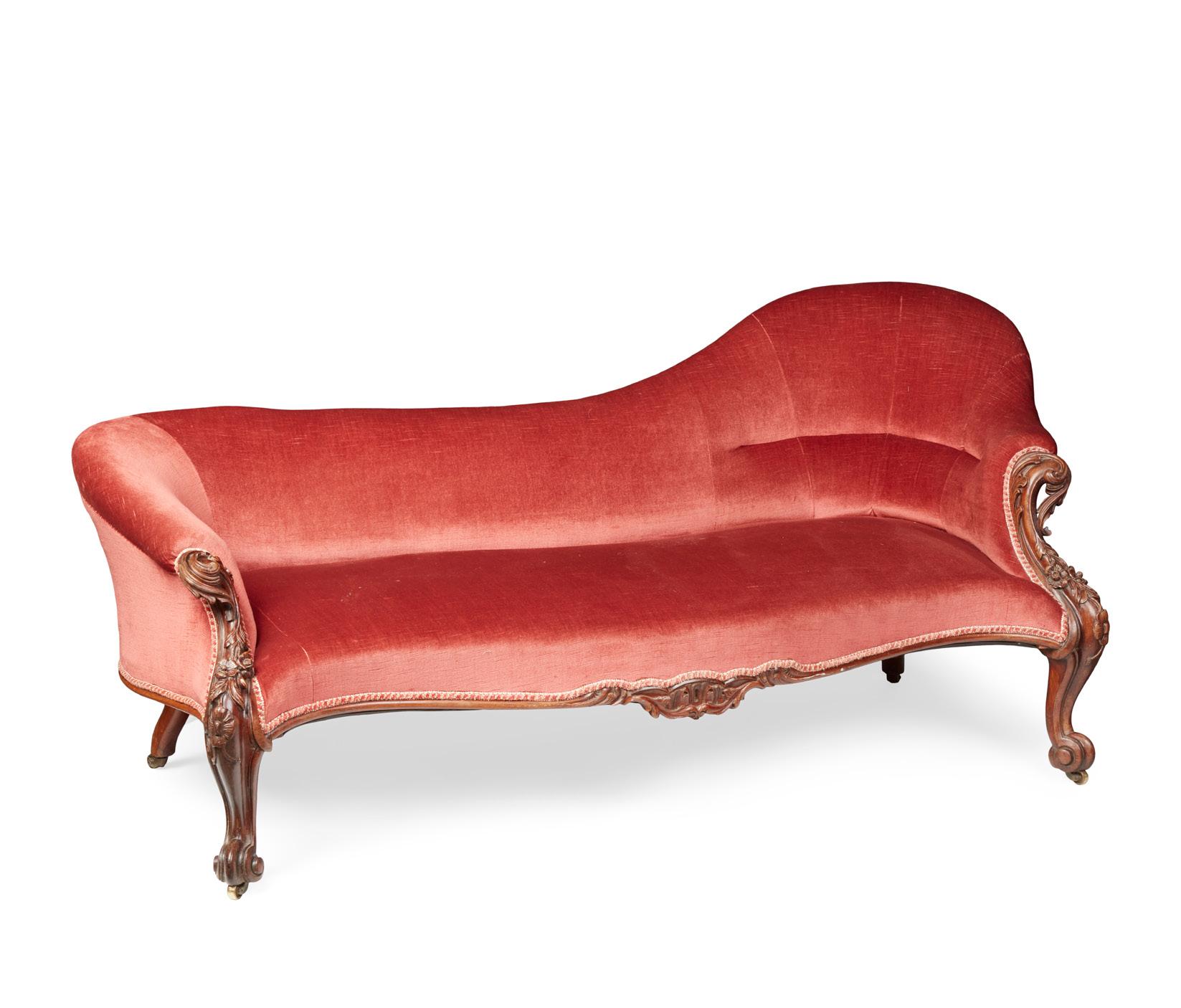
192cm long, 85cm high, 58cm deep
Provenance: Private Scottish Collection, Morayshire
£400-600
123
339 Y
ROSEWOOD, POLLARD OAK, AND INLAID HEXAGONAL PEDESTAL TABLE
19TH CENTURY
the banded tilt top with a moulded edge and inlaid with a star motif and scrolling flower motifs, on a triple cluster column support and scrolled tripod base
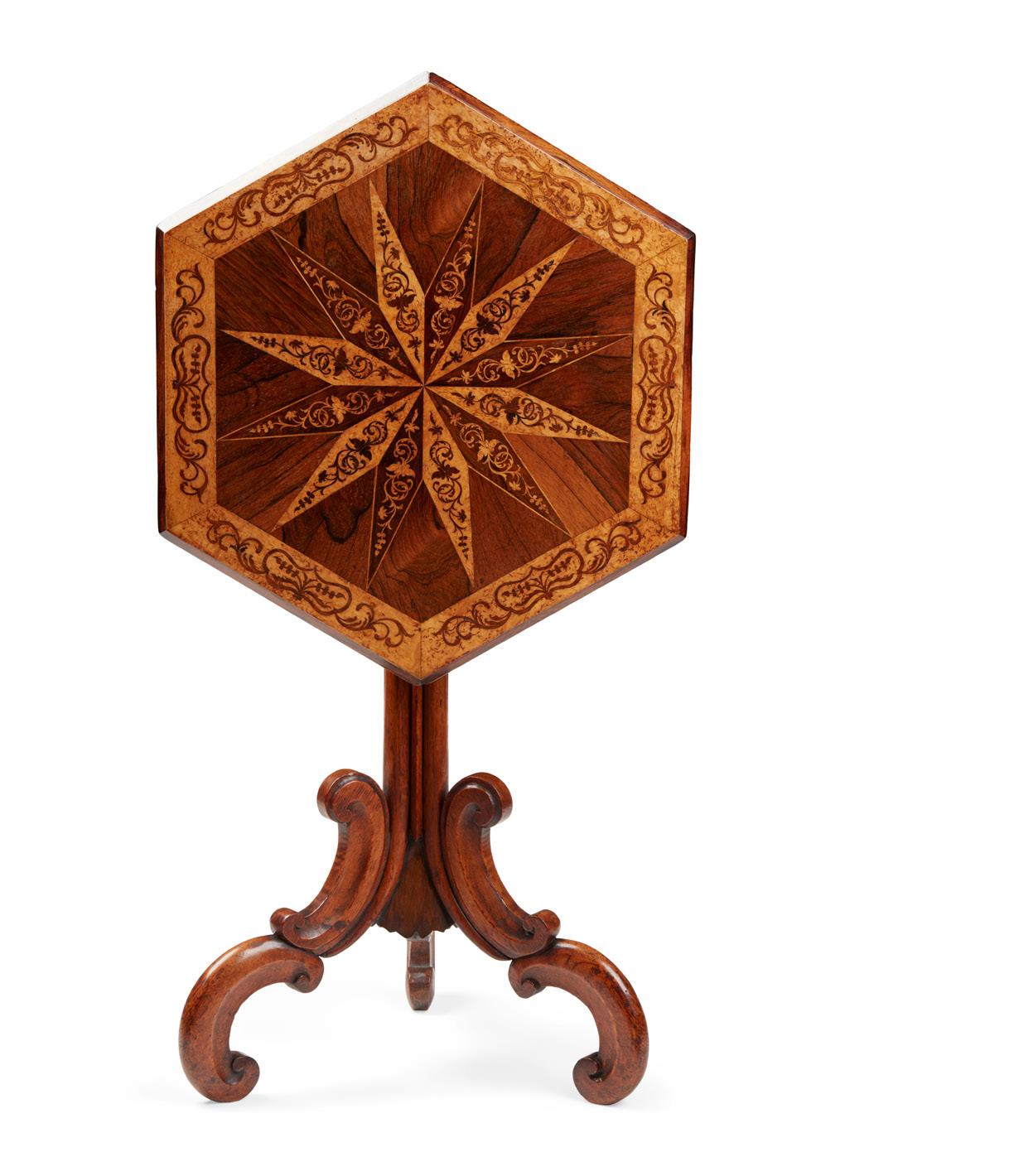
67cm diameter, 74cm high
£900-1,200
340
EBONISED, AMBOYNA, KINGWOOD AND MARQUETRY, GILT METAL MOUNTED BUREAU PLAT, BY EDWARD & ROBERTS
EARLY 20TH CENTURY
the shaped rectangular brass banded top inlaid with flower and trophy marquetry borders, above a shaped frieze with a central drawer and dummy drawers, with dummy drawers on the reverse, raised on cabriole legs outlined and highlighted with gilt metal mounts, the drawer stamped EDWARD & ROBERTS

126cm wide, 76cm high, 65cm deep
£1,500-2,500
341 Y
VICTORIAN ROSEWOOD MARQUETRY GILT


METAL MOUNTED PIER CABINET
19TH CENTURY
the top with a moulded edge above an inlaid frieze and glazed door enclosing purple velvet lined shelves, flanked by gilt metal mounts, on a plinth base
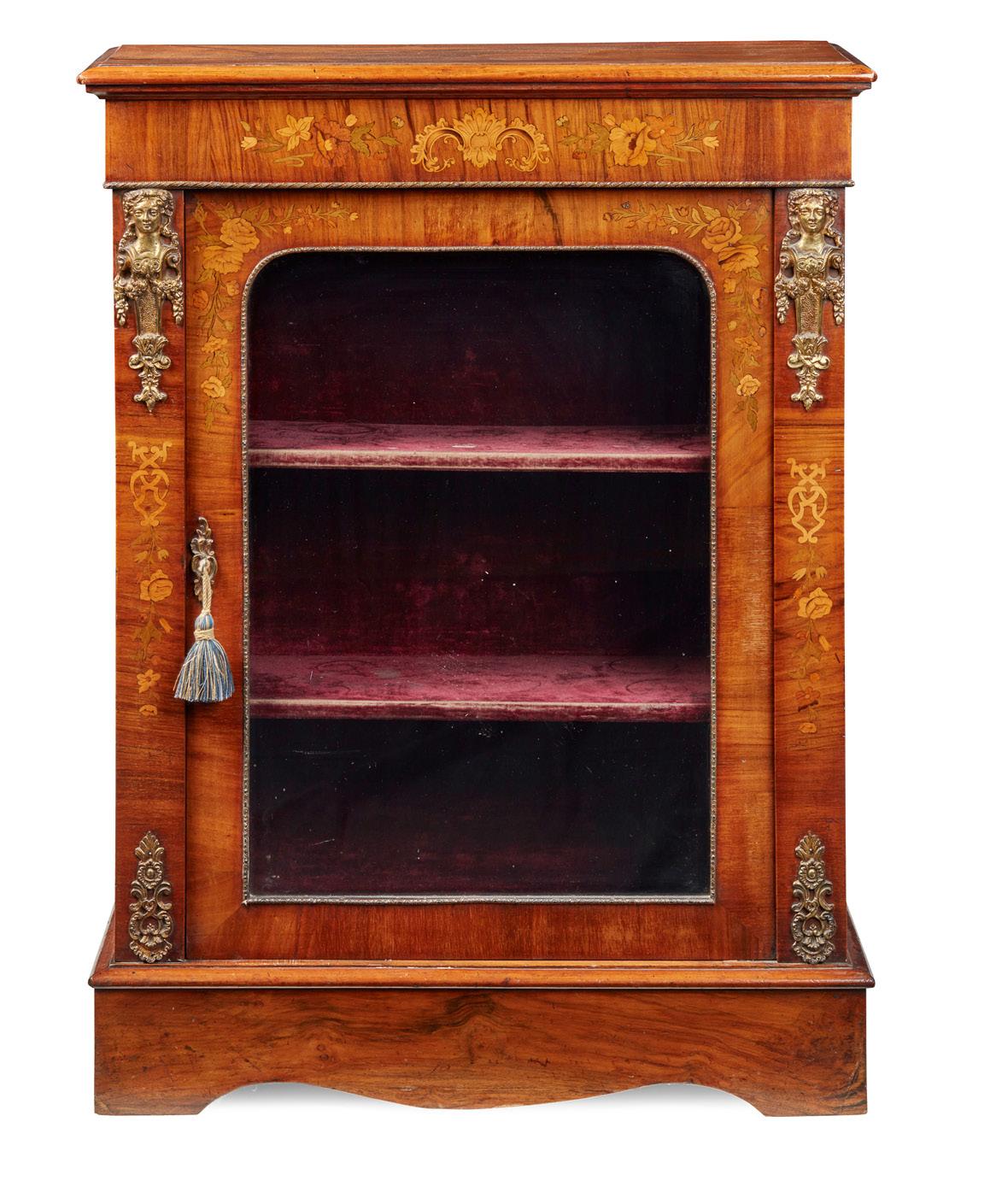
78cm wide, 107cm high, 32cm deep
Provenance: Private Scottish Collection, Morayshire
£300-500
124
342
KINGWOOD AND GILT METAL MOUNTED LOW DISPLAY CABINET, ATTRIBUTED TO GILLOWS
MID 19TH CENTURY
in the Louis XV style, of breakfront serpentine outline, with a central pair of glazed doors enclosing shelves, flanked by open shelves all outlined with gilt metal mounts, on a shaped plinth base
232cm wide, 90cm high, 42cm deep
£6,000-8,000
Note: In the 19th century Gillows produced furniture increasingly in a variety of revival styles, including their take on Gothic, Elizabethan, or the ‘antique’ styles of the 18th century. They were making furniture in the French ‘Louis’ style in the mid-19th century, no doubt in response to customer demand, as there was an increased interest in the French interior for British homes.
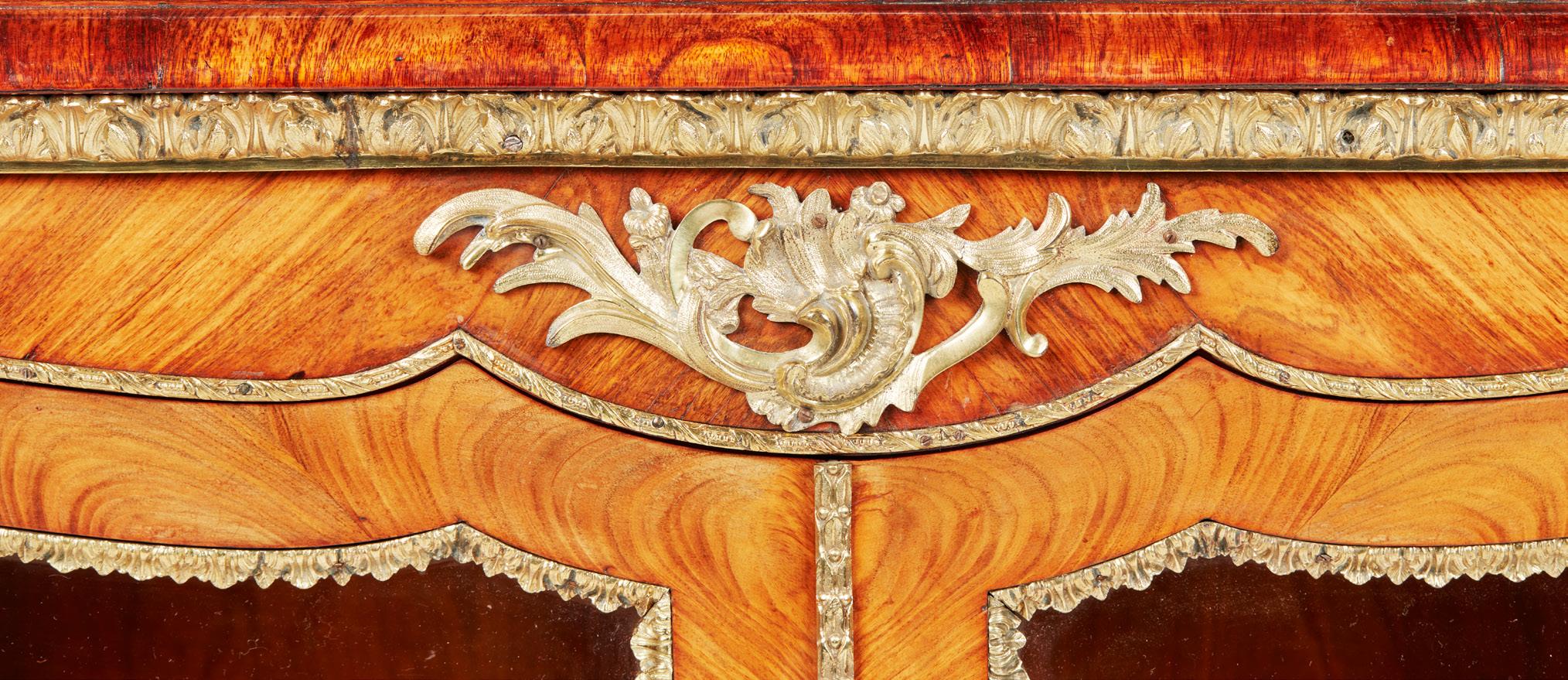
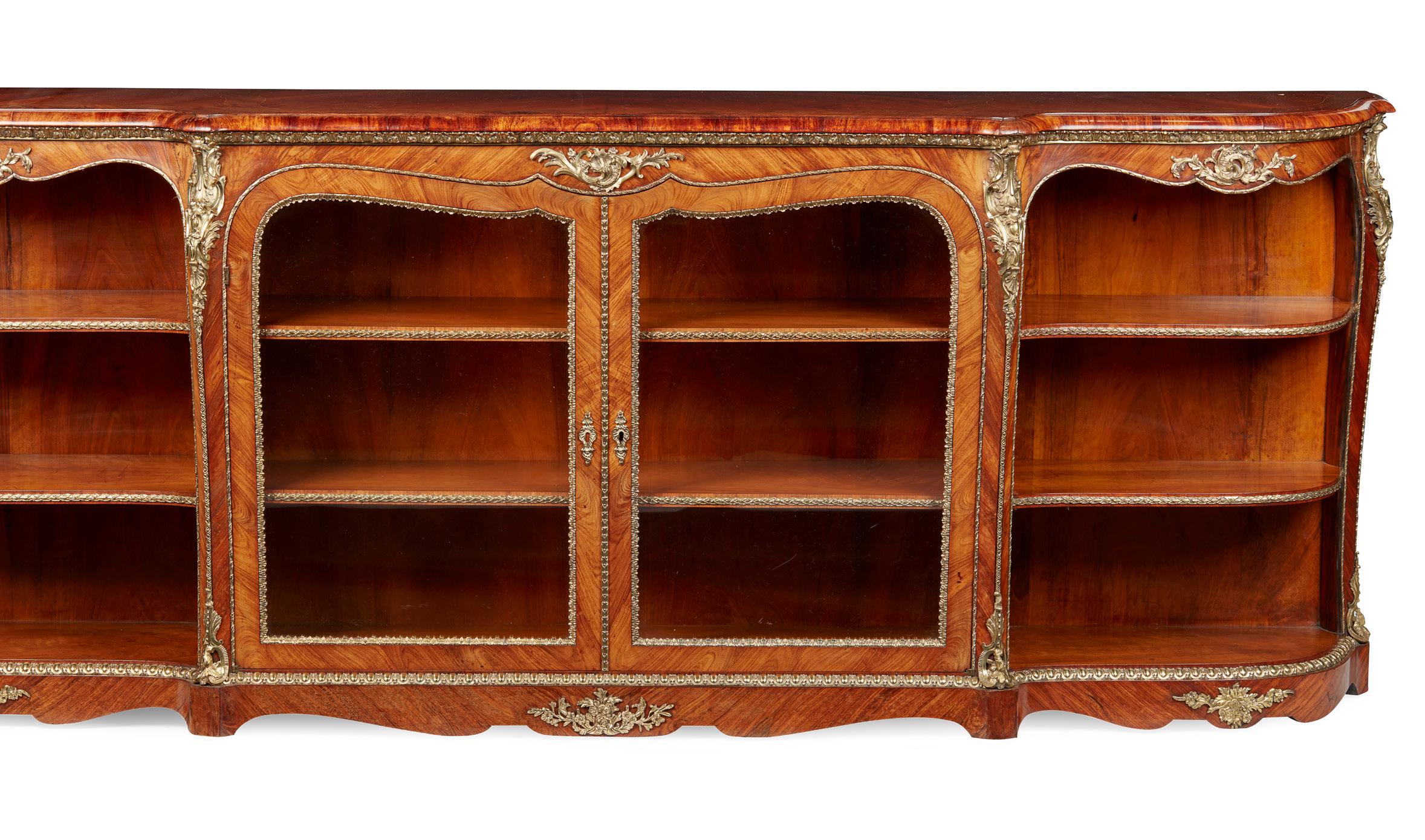
125 Other fees apply in addition to the hammer price: see the ‘Buyer’s Guide’ section on page 2
343
EARLY VICTORIAN WALNUT FRAMED OPEN ARMCHAIR
MID 19TH CENTURY
the button upholstered back leading to downswept padded open arms ending in carved scrolling hand terminals, above a wide stuffover seat with a flower carved seat rail and cabriole legs with brass castors, covered in rose pink plush upholstery

64cm wide, 86cm high, 55cm deep
Provenance: Private Scottish Collection, Morayshire
£300-500
344
PAIR OF VICTORIAN WALNUT FOOTSTOOLS
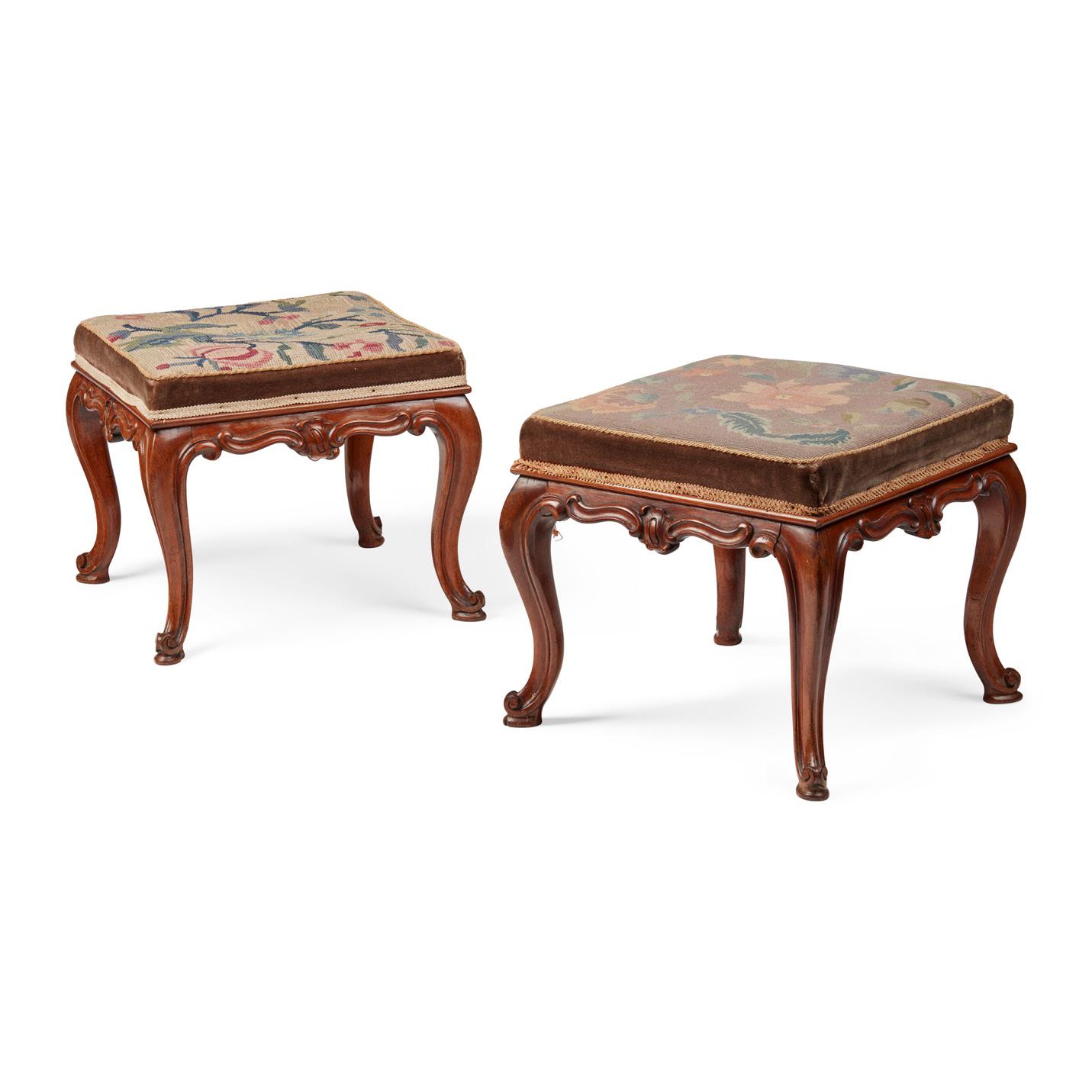
MID 19TH CENTURY
the square padded tops with flower needlework covers, on scroll carved seat rails raised on cabriole legs with scrolled toes (2) 47cm wide, 40cm high, 47cm deep
£800-1,200
345
VICTORIAN WALNUT, EBONISED AND FRUITWOOD MARQUETRY CARD TABLE
MID 19TH CENTURY
the rounded rectangular fold-over top with a moulded edge, inlaid with stylised flowers and line inlay, opening on a pivot action to a red baize playing surface, raised on four ring-turned supports centred by a turned finial and raised on carved outswept legs with ceramic castors

91cm wide, 72cm high, 43.5cm [closed]
£600-800
126
346
EARLY VICTORIAN WALNUT CARD TABLE, C. WILKINSON & SON
MID 19TH CENTURY
the top with bookmatched veneers and a moulded edge, pivoting to open to a green baize playing surface, raised on spiral carved end supports with scrolled trestle bases and brass castors, stamped ‘C.
WILKINSON & SON 13648 8 OLD BOND STREET’
91.5cm wide, 76cm high, 46cm deep
Note: Established by Joshua Wilkinson in 1766, the firm was later named C. Wilkinson & Son and operated from 8 Old Bond Street from 1855.
£600-800
347 Y
BURR WALNUT, ROSEWOOD, AND FRUITWOOD MARQUETRY OCCASIONAL TABLE
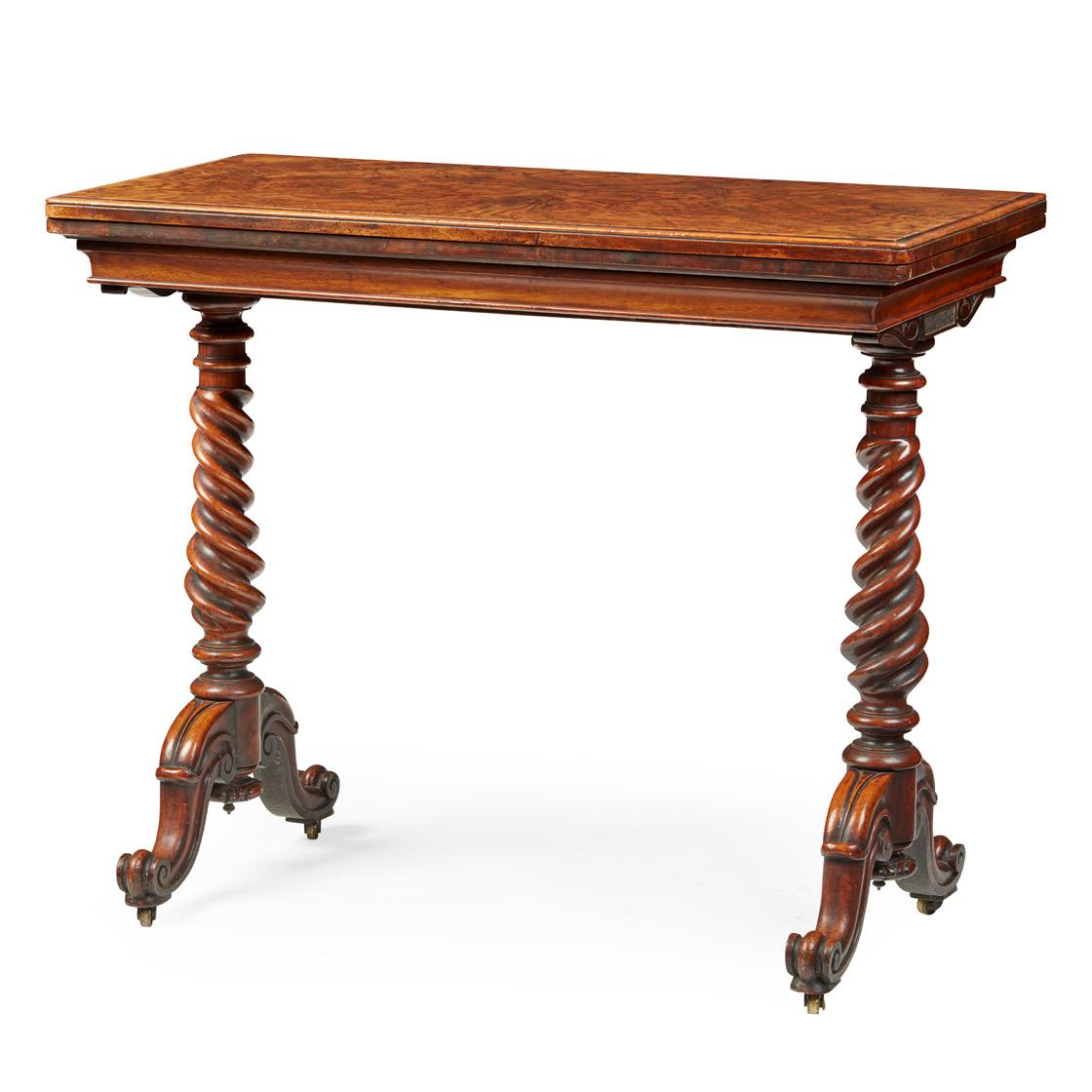
MID 19TH CENTURY
the circular tilt top inlaid with star and sunburst motifs on a baluster column and scrolling tripod base
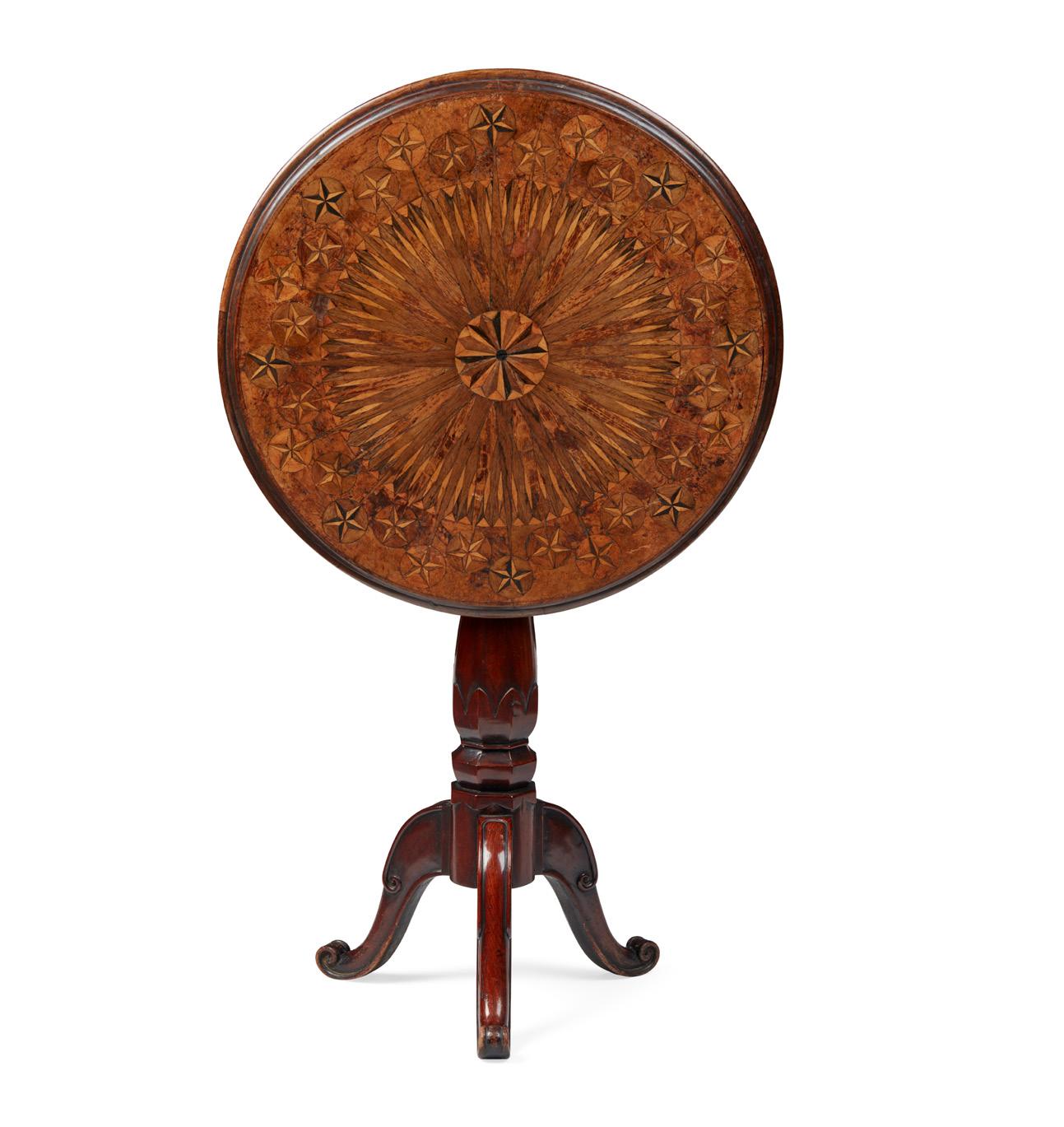
63.5cm diameter, 78cm high
£400-600
348
VICTORIAN WALNUT, EBONISED AND INLAID BURR WALNUT SIDE CABINET
19TH CENTURY
the top with an ebonised moulded edge above a pair of glazed doors enclosing blue velvet-lined shelves, raised on ebonised turned feet 107cm wide, 107cm high, 29cm deep
£700-1,000
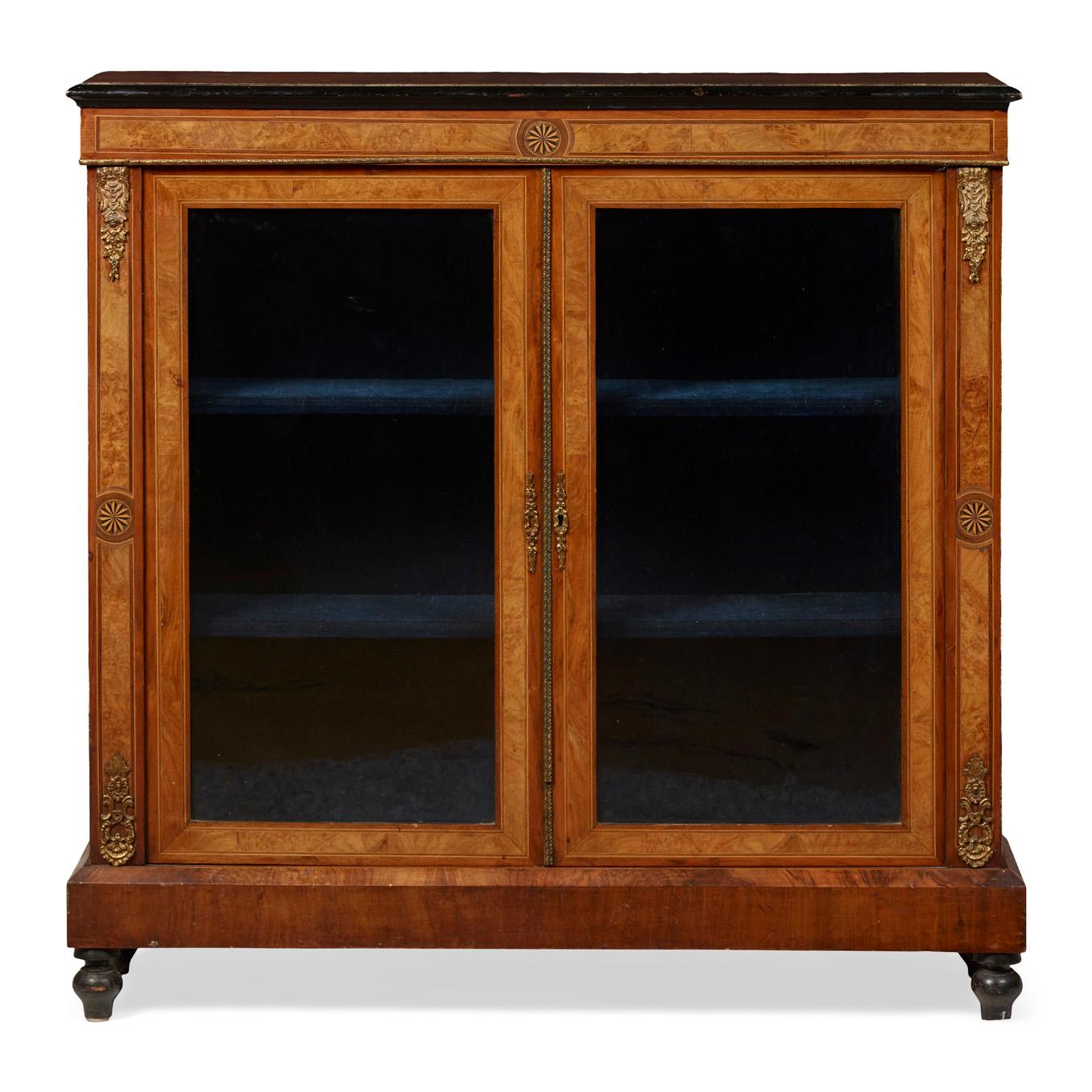
127 Other fees apply in addition to the hammer price: see the ‘Buyer’s Guide’ section on page 2
349
VICTORIAN WALNUT, EBONISED, SATIN BIRCH AND FRUITWOOD MARQUETRY WORK TABLE
MID 19TH CENTURY
the rounded rectangular hinged top with ivy inlay corner panels, opening to a ratchet adjusted leather writing slope, compartments and pen tray, above a long compartmented drawer and sliding work box with further marquetry, raised on twin turned end supports on arched trestle bases with ceramic castors and joined by a turned stretcher; the drawer stamped 8074 60.5cm wide, 73cm high, 41cm deep
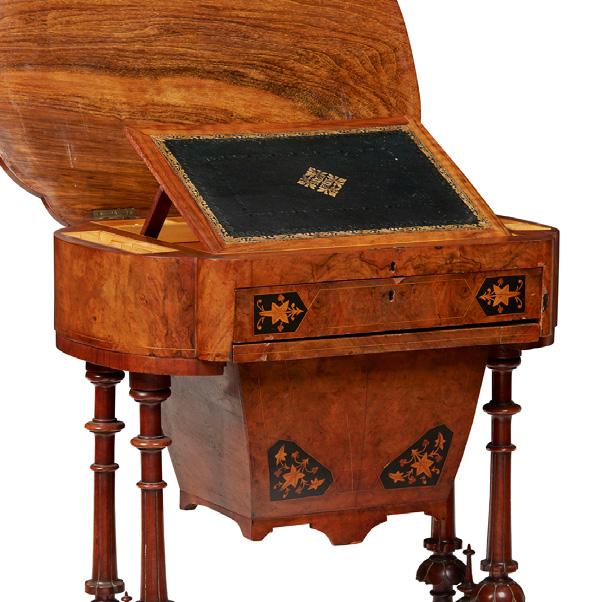
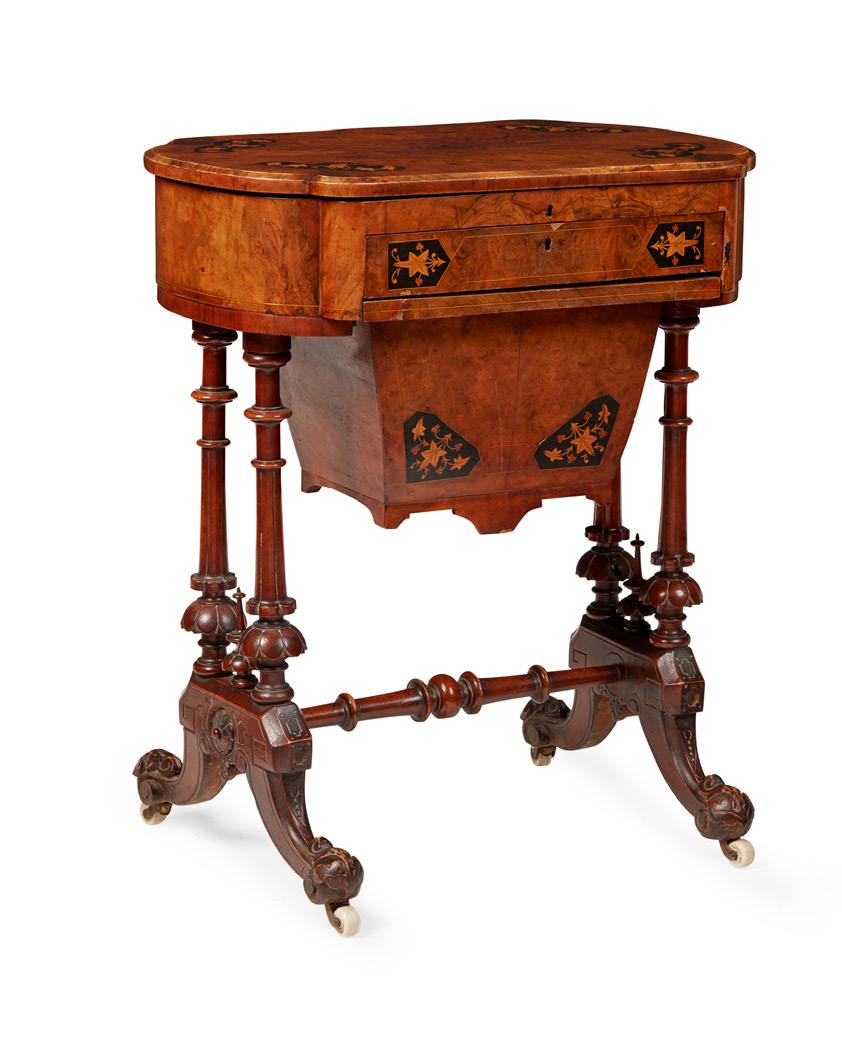
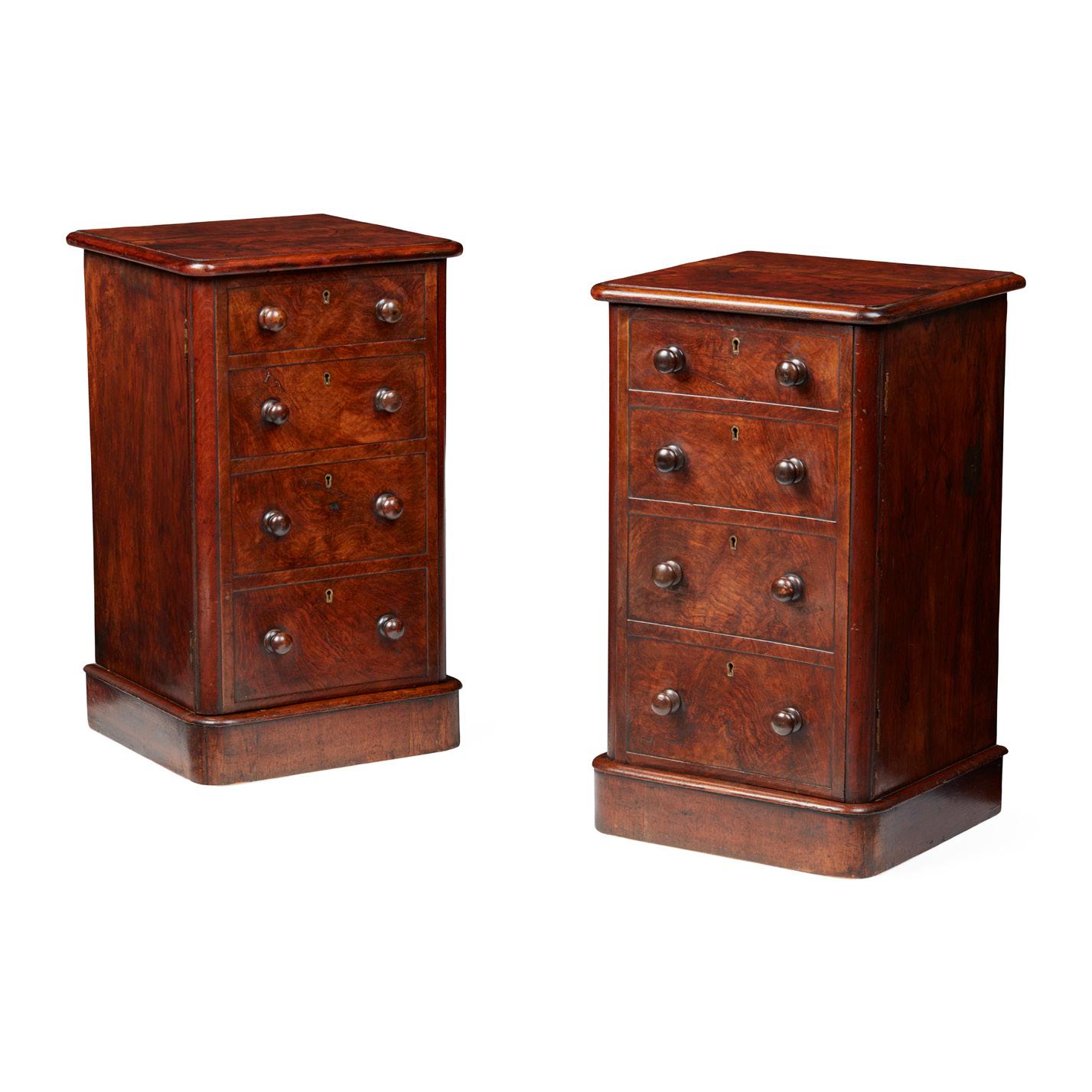
£300-500
MID 19TH CENTURY, WITH ALTERATIONS
the rectangular tops above single doors with dummy drawer fronts and turned knob handles, opening to shelved interiors, on moulded plinth bases
43cm wide, 71cm high, 40cm deep
£1,000-1,500
351
VICTORIAN WALNUT AND GRAIN PAINTED SOFA
MID 19TH CENTURY
the low back and short scrolled arms above a long padded seat, the arms carved with acanthus and flower pendants, raised on cabriole legs ending in trifid feet, covered in red plush upholstery 208cm long, 69cm high, 53cm deep
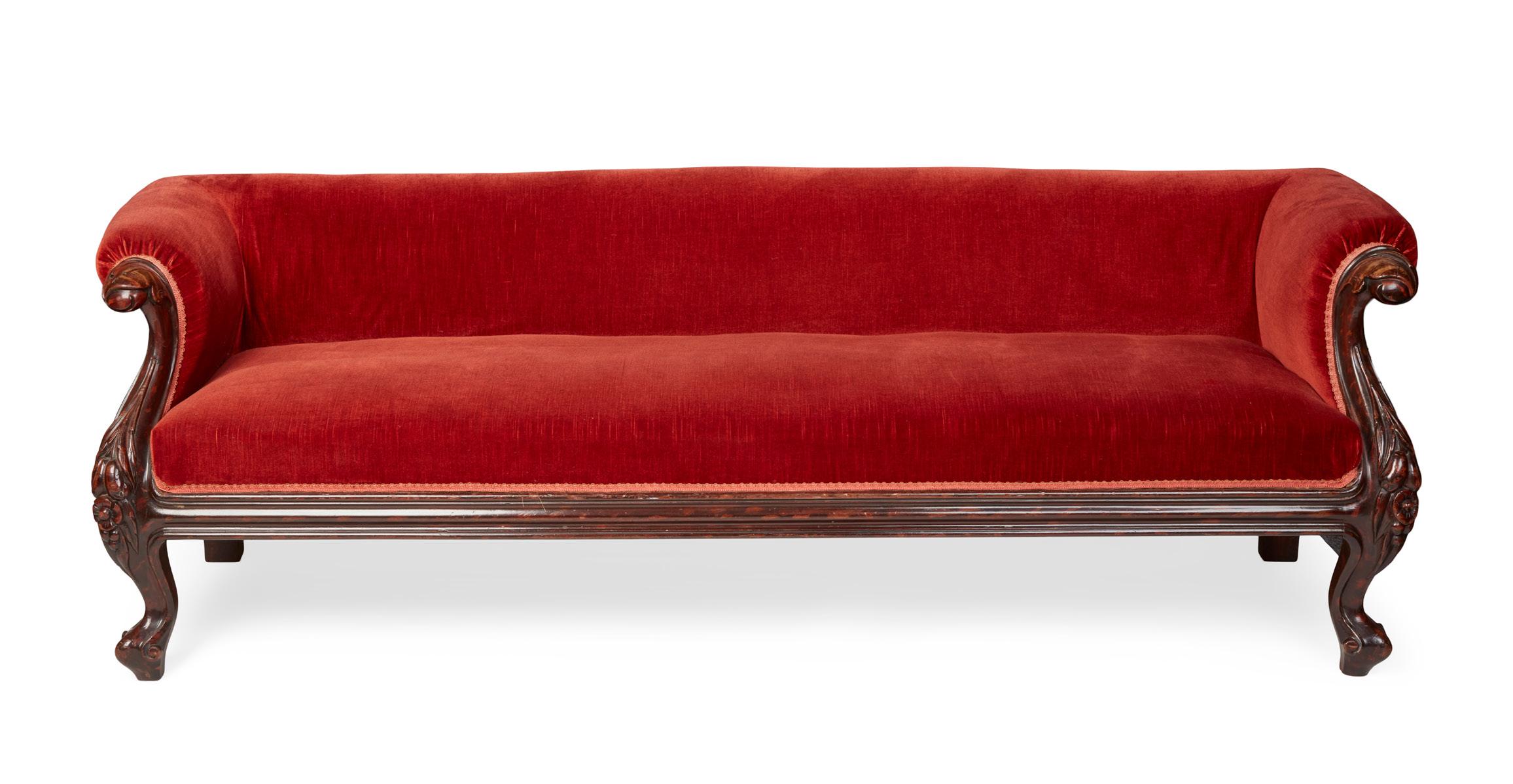
Provenance: Private Scottish Collection, Morayshire
£400-600
350 PAIR OF VICTORIAN BURR WALNUT BEDSIDE CABINETS
128
352
LARGE VICTORIAN WALNUT SUTHERLAND TABLE
19TH CENTURY
the lobed oval quarter-veneered top with a moulded edge, raised on bead carved end supports on scroll bases with brass castors and joined by a turned stretcher, opening on turned and tapered legs
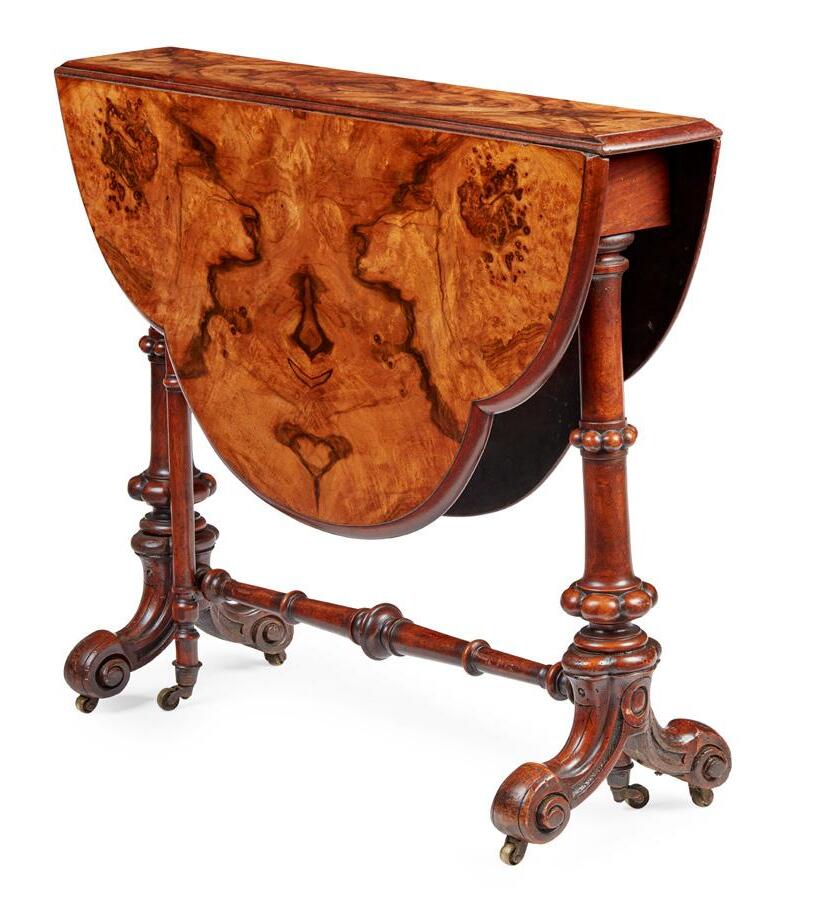
90cm wide, 73cm high, 17cm deep, 105cm [open]
£600-800
353
VICTORIAN WALNUT SALON STOOL
MID 19TH CENTURY
the serpentine padded top covered in cream upholstery, raised on cabriole legs ending in scrolled toes
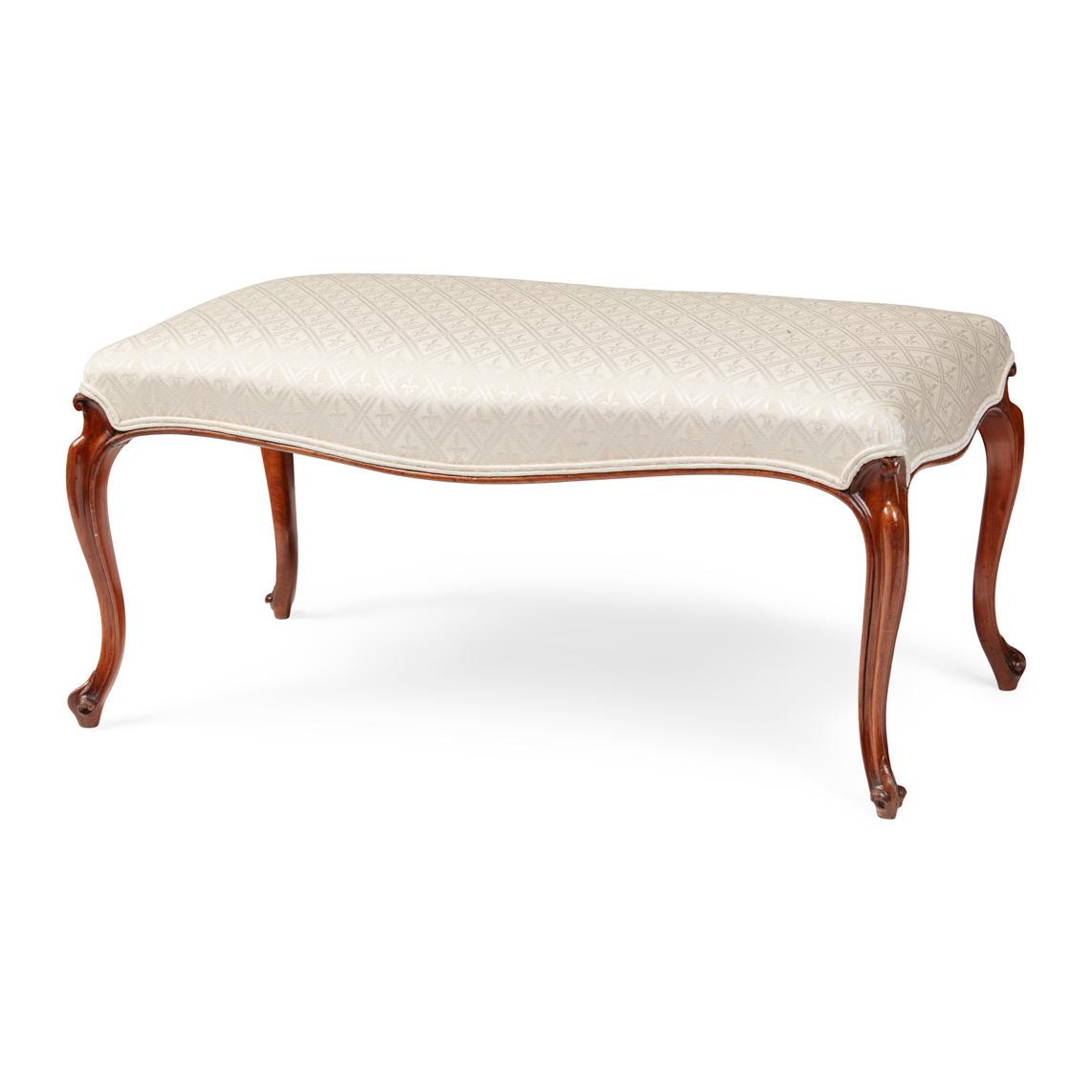
99cm wide, 47cm high, 52cm deep
£600-800
354
VICTORIAN WALNUT LOW OPEN BOOKCASE
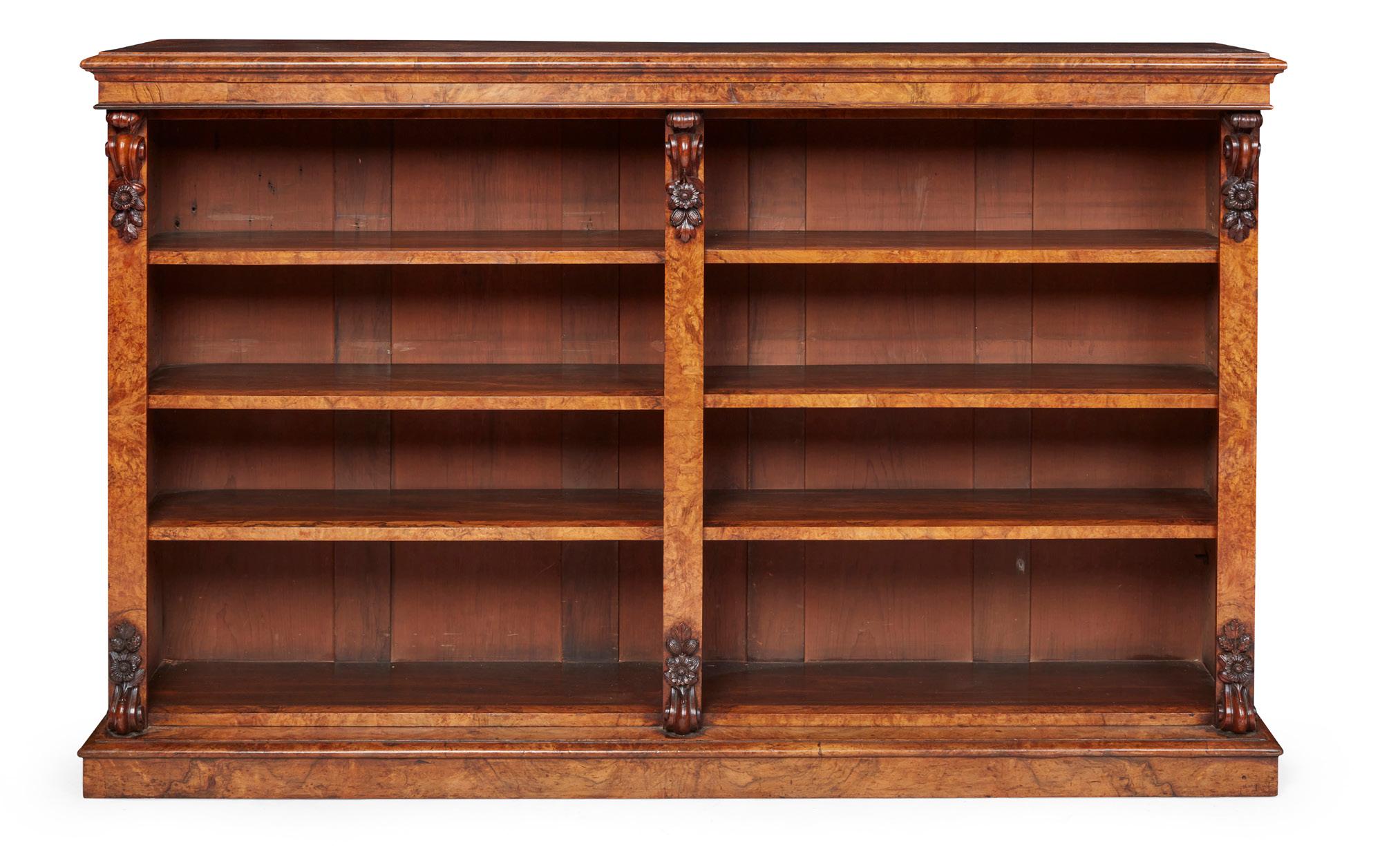
MID 19TH CENTURY
the top with a moulded edge above a plain frieze and two open compartments with adjustable shelves, all flanked and divided by flower carved brackets, on a projecting plinth base
169cm wide, 112cm high, 38cm deep
£2,000-3,000
129 Other fees apply in addition to the hammer price: see the ‘Buyer’s Guide’ section on page 2
COLLECTION OF VARIOUS MINIATURE SILVER MOUNTED SCENT BOTTLES

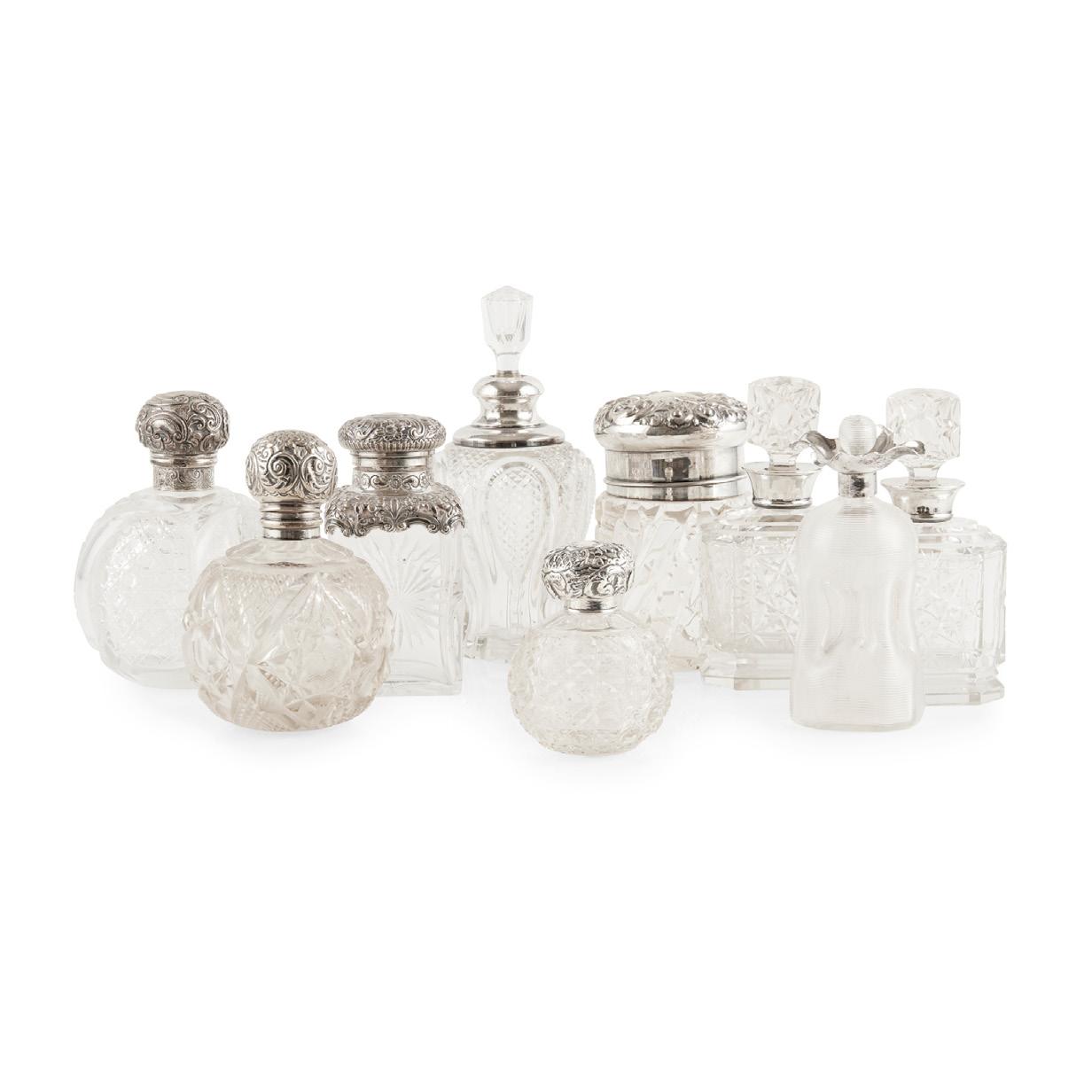
19TH CENTURY AND LATER
comprising three silver cylindrical examples, all with hinged covers and internal stoppers, with chased foliate or scroll decoration, one also incised with monogramed initials, two hallmarked for Birmingham, one for London; a cylindrical glass scent bottle with a white metal stopper and encased within a pierced silver body, marks rubbed; a white metal Japanese bottle, the body with chrysanthemums and irises with enamel details, two suspension rings; a bullet shaped scent bottle, the plain glass body with a white metal cover with chased floral and scroll designs; a feather-shaped white metal bottle with hinged cover, the body with chased scrolling decoration; a cut glass cylindrical bottle, with a silver cover inscribed ‘Xmas 1911’, ‘Undine’, Birmingham, maker J.G & S, 1910; a cylindrical jadeite bottle with a silver lid, hallmarks rubbed; together with an early 19th century TORTOISESHELL AND SILVER INLAID NEEDLE HOLDER AND A BRASS SEAL WITH CYLINDRICAL GLASS HANDLE (11) largest bottle 7.6cm long, smallest bottle 4.5cm long, seal 8.5cm long
Provenance: Private Scottish Collection, Morayshire
£300-500
356
COLLECTION OF COLOURED AND CLEAR GLASS SCENT BOTTLES

19TH CENTURY, VARIOUS DATES AND MAKERS to include four double-ended examples in coloured facetted glass with white metal mounts; and eleven other examples in coloured glass, clear glass and blue and red flash glass, some with white metal mounts (15)
Longest 14cm long
Provenance: Private Scottish Collection, Morayshire
£300-500
357
COLLECTION OF SILVER MOUNTED
CUT GLASS SCENT BOTTLES AND JARS
19TH CENTURY
including a pair of flattened octagonal bottles cut with star motifs with a silver collar and flattened star cut stoppers, 16.3cm high; a square section bottle and stopper, each side cut with a stylised flower motif, with chased floral and scroll silver mounts and hinged cover, 14.5cm high; a bottle of baluster form with hobnail and star cutting and a hexagonal stopper, 20.5cm high; three globular vessels with silver covers; and a cylindrical jar and foliate chased cover, 15cm high; together with a ribbed glass small glug-glug decanter with silver mounted collar, 16cm high (9)
largest 20.5cm high
Provenance: Private Scottish Collection, Morayshire
£300-500
358
MINTON PINK GROUND VASE AND COVER
CIRCA 1850-60 with pierced twin handles, the domed cover with a leaf finial, the body painted with classical maidens with a swans, within a border of ribbands and cornucopia; the reverse with a portrait roundel flanked by winged putti and floral garlands; the neck painted en grisaille, on a round socle foot and square plinth base; ermine mark and incised numeral 469
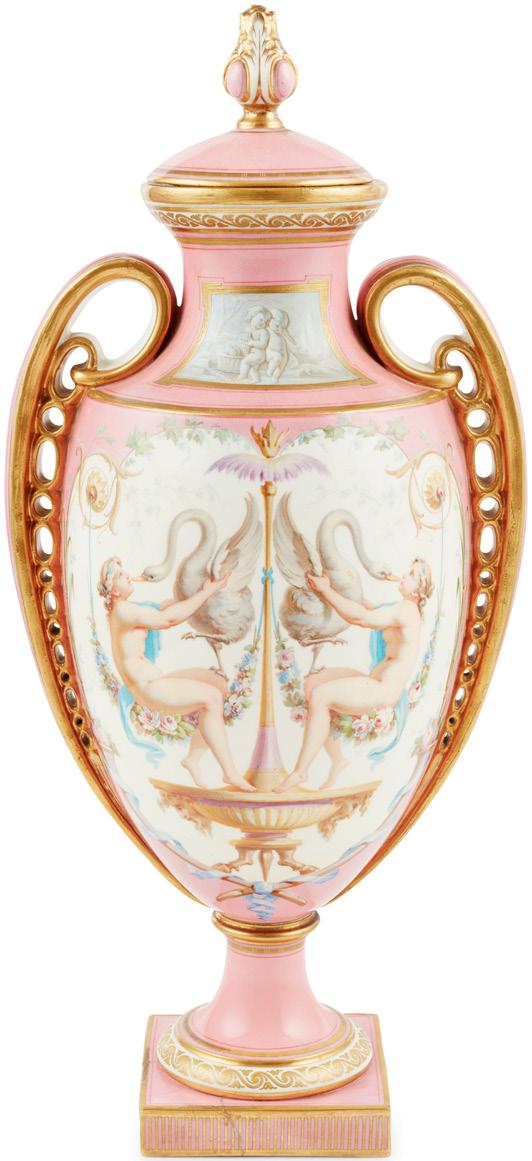
43cm high
£250-350
355 Y
130 Other fees apply in addition to the hammer price: see the ‘Buyer’s Guide’ section on page 2
359 ENGLISH BRASS CARRIAGE CLOCK BY
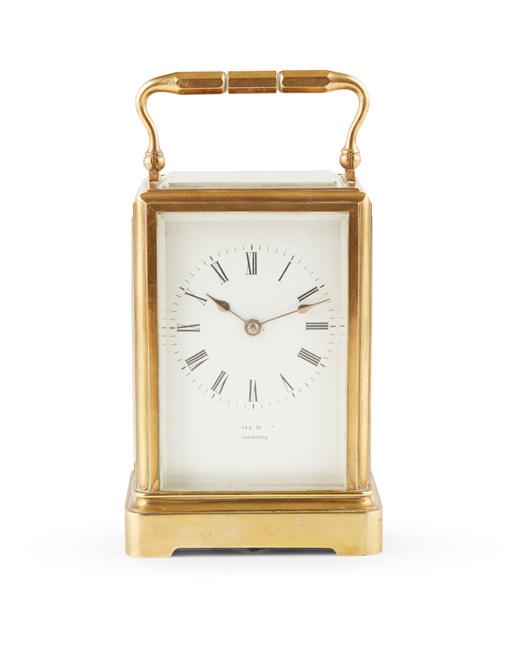
HALL & CO, MANCHESTER
LATE 19TH CENTURY
the signed white enamel dial with black Roman numerals, plain gorge case with swing handle and bevelled glass panels, the twin train brass movement with silvered platform escapement, striking the full and half hours to a bell
9.5cm wide, 17cm high (including handle), 8cm deep
Provenance: Private Scottish Collection, Morayshire
£300-500
360
VICTORIAN GILT BRASS MOUNTED COROMANDEL SCENT BOTTLE CASKET
19TH CENTURY
of cantered square form with Gothic style gilt brass strapwork mounts, the cover with a central pietra dura floral roundel, opening to a fitted blue velvet interior with four square gilt brass topped bottles
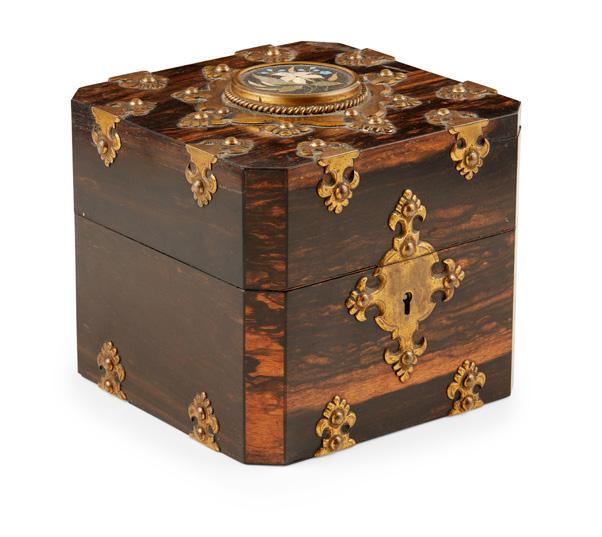
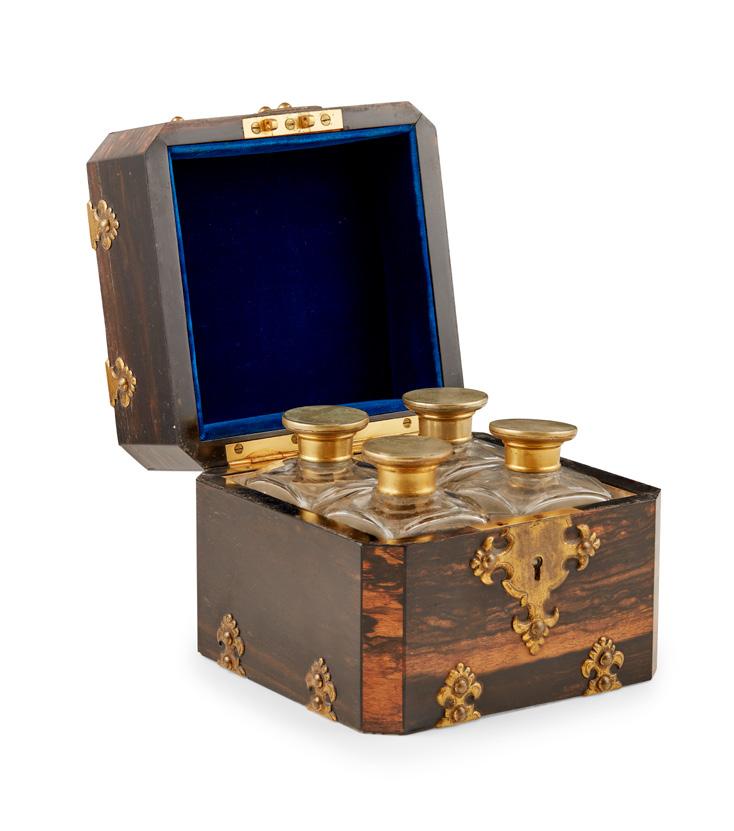
14.5cm square, 13cm high
Provenance: Private Scottish Collection, Morayshire
£300-500
361
VICTORIAN BLACK MOROCCO LEATHER DISPATCH BOX

19TH CENTURY
the lid with brass swing handle and gilt tooled ‘VR’ cypher, stamped ‘Dr W. R. DUGUID’, the plain interior stamped ‘Wickwar & Co, 6 Poland Street’
46cm wide, 15.5cm high, 31cm deep
£700-900
Note: This box most likely belonged to William Robert Duguid who served as Provost of Buckie, and later appointed to Fishery Board of Scotland. A portrait of Dr W. R. Duguid by Allan Newton Sutherland (c.1885–1918) dated 1913 is in the collection of Falconer Museum, Moray Council Museums
362
RED MOROCCO LEATHER DISPATCH BOX
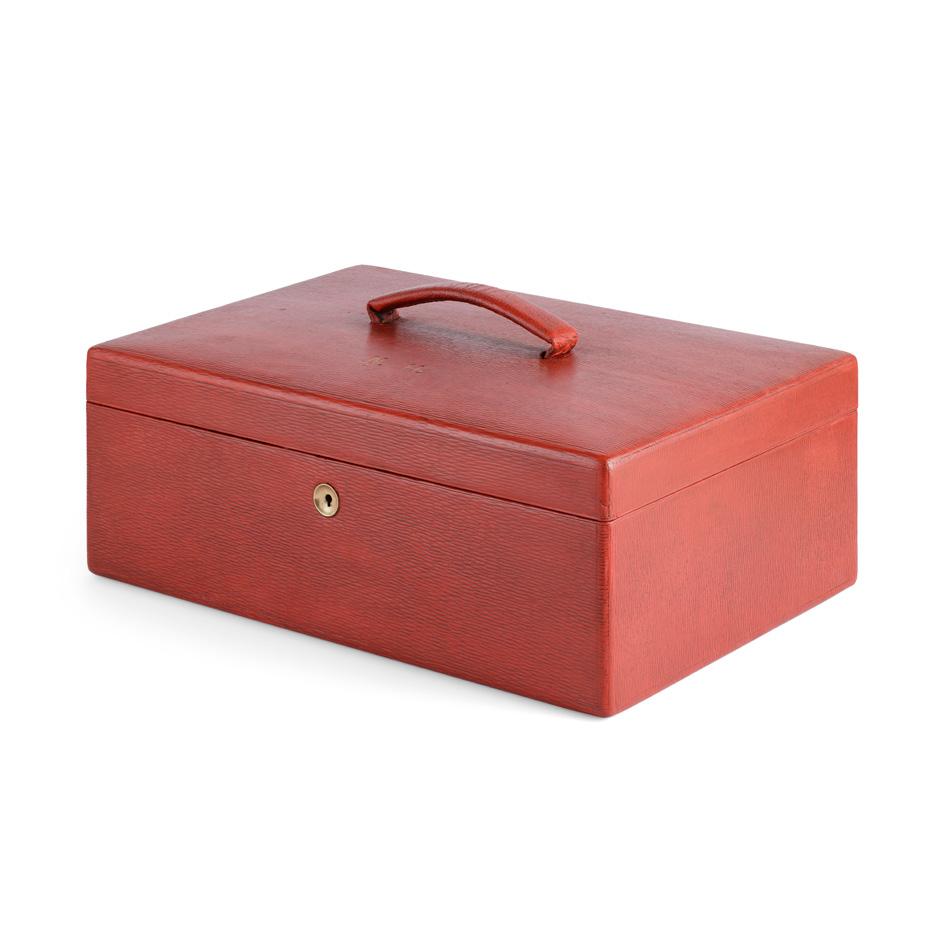
EARLY 20TH CENTURY
the hinged lid with a leather handle and gilt tooled initials ‘N.H.’, the plain interior and lock stamped ‘Best & Co, 64A S. Audley St. W.’

43cm wide, 18cm high, 29.5cm deep
£500-700
363
LATE VICTORIAN WALNUT BRASS MOUNTED TANTALUS, BY BETJEMANN’S, LONDON
LATE 19TH CENTURY
the handle marked ‘THE TANTALUS’ and ‘BETJEMANN’S/ PATENT 17151/ LONDON’, with three squared strawberry cut glass decanters with facetted knop stoppers
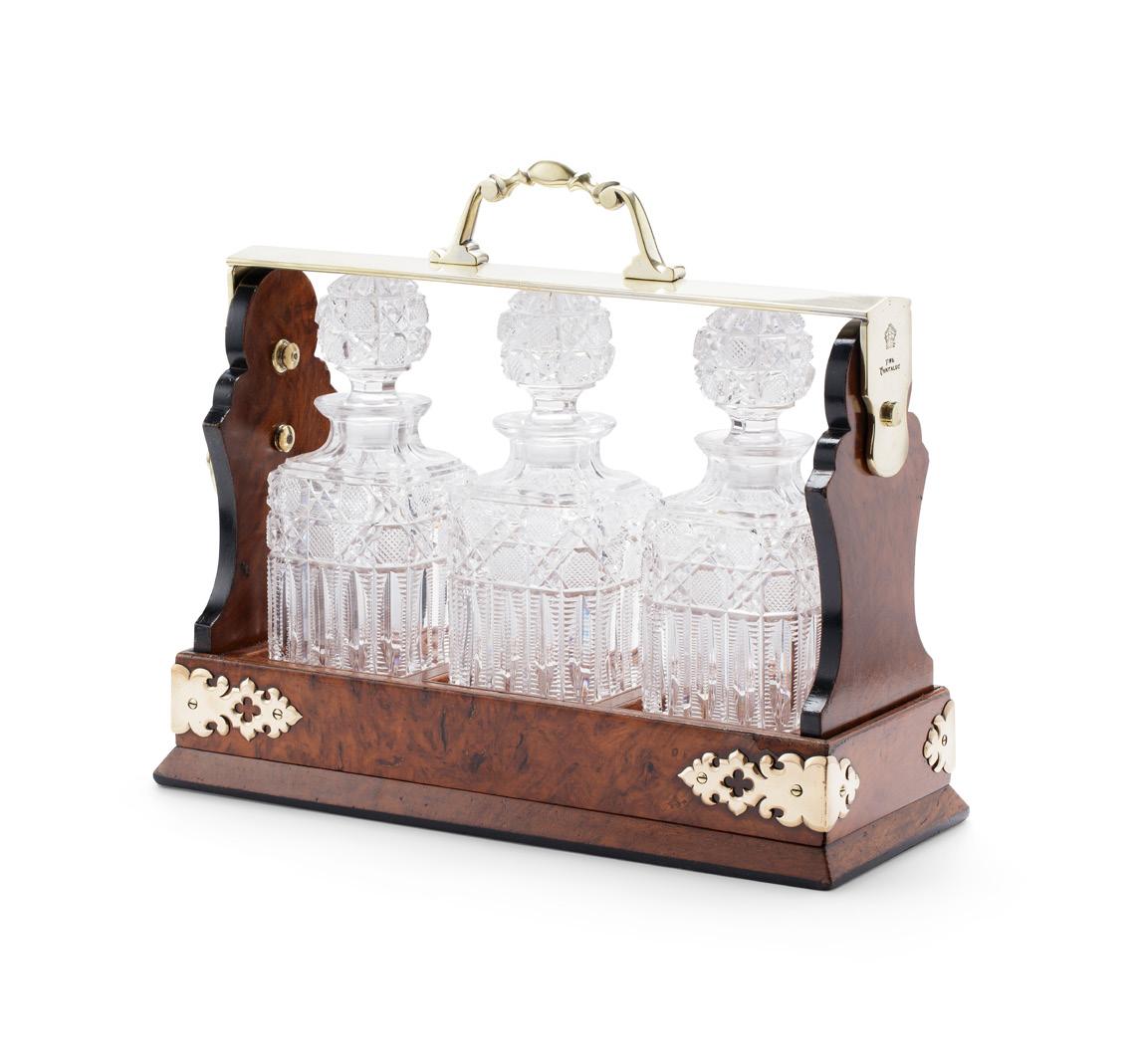
34cm wide, 29cm high, 13cm deep
£500-700
131
364
EARLY VICTORIAN CURLY MAPLE WORK TABLE
MID 19TH CENTURY
the banded and line inlaid rectangular top above a long frieze drawer, with baize lined slides to the sides, raised on turned and tapered legs joined by a curved X form stretcher with a central urn finial
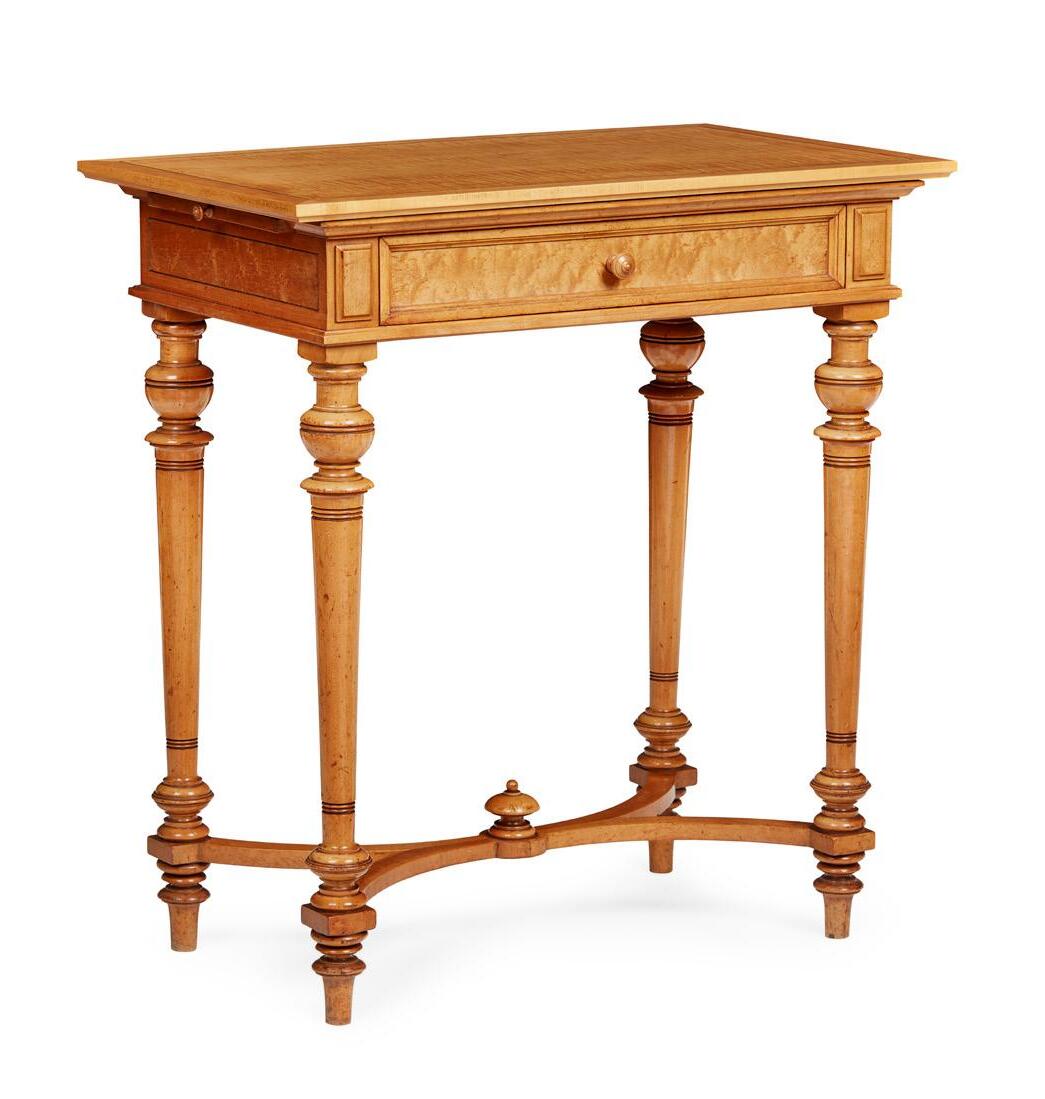
71cm wide, 76cm high, 42.5cm deep
£400-600
365
EARLY VICTORIAN MAHOGANY PEDESTAL LIBRARY TABLE
MID 19TH CENTURY
the circular top with a brown leather insert and moulded edge, on a baluster column and foliate carved scrolled legs with ceramic castors

135cm diameter, 78cm deep
£600-800
366
VICTORIAN LARGE MAHOGANY AND NEEDLEWORK SALON STOOL
19TH CENTURY
the padded rectangular top in foliate needlework upholstery, the seat rail carved with acanthus and raised on short cabriole legs ending on porcelain castors
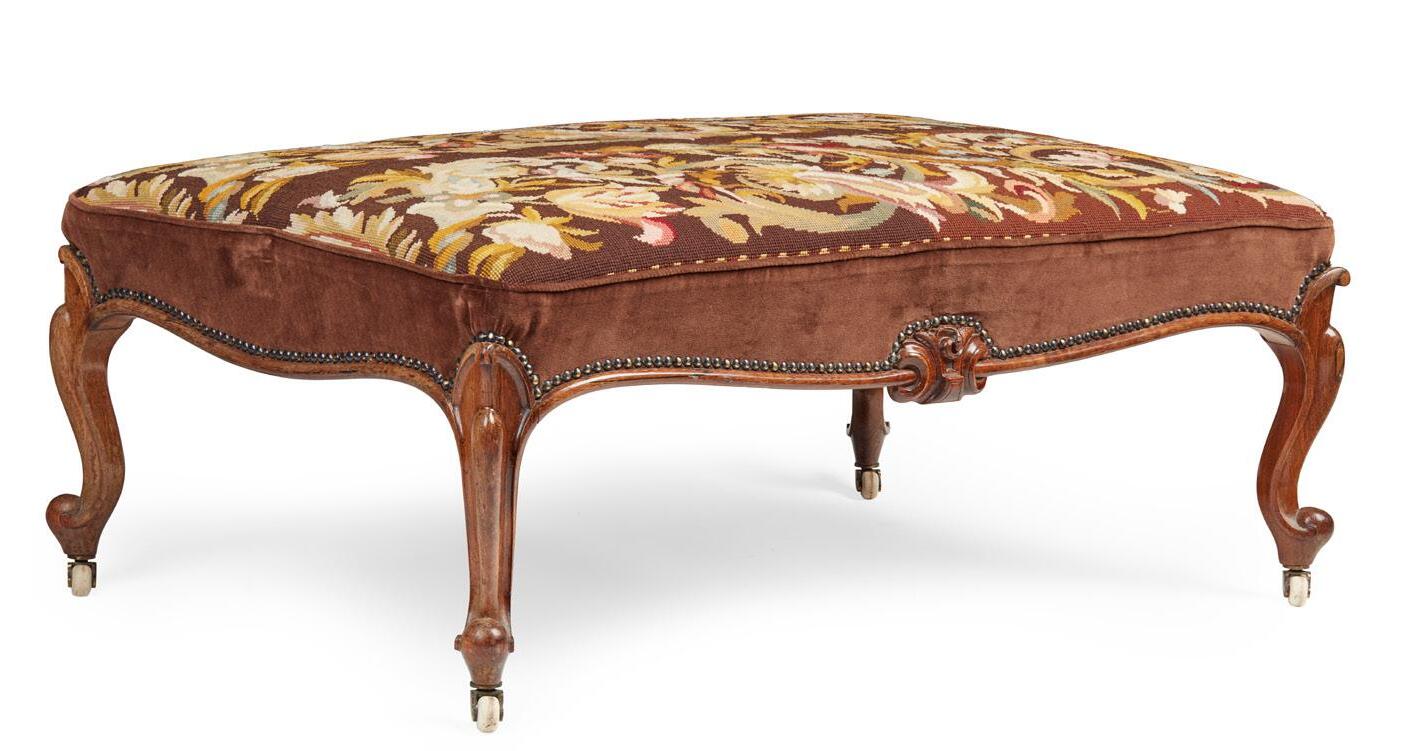
99cm wide, 38cm high, 65cm deep
Provenance: Private Scottish Collection, Morayshire
£400-600
132 Other fees apply in addition to the hammer price: see the ‘Buyer’s Guide’ section on page 2
DAY TWO: THURSDAY 19 MAY 2023 FROM 10AM
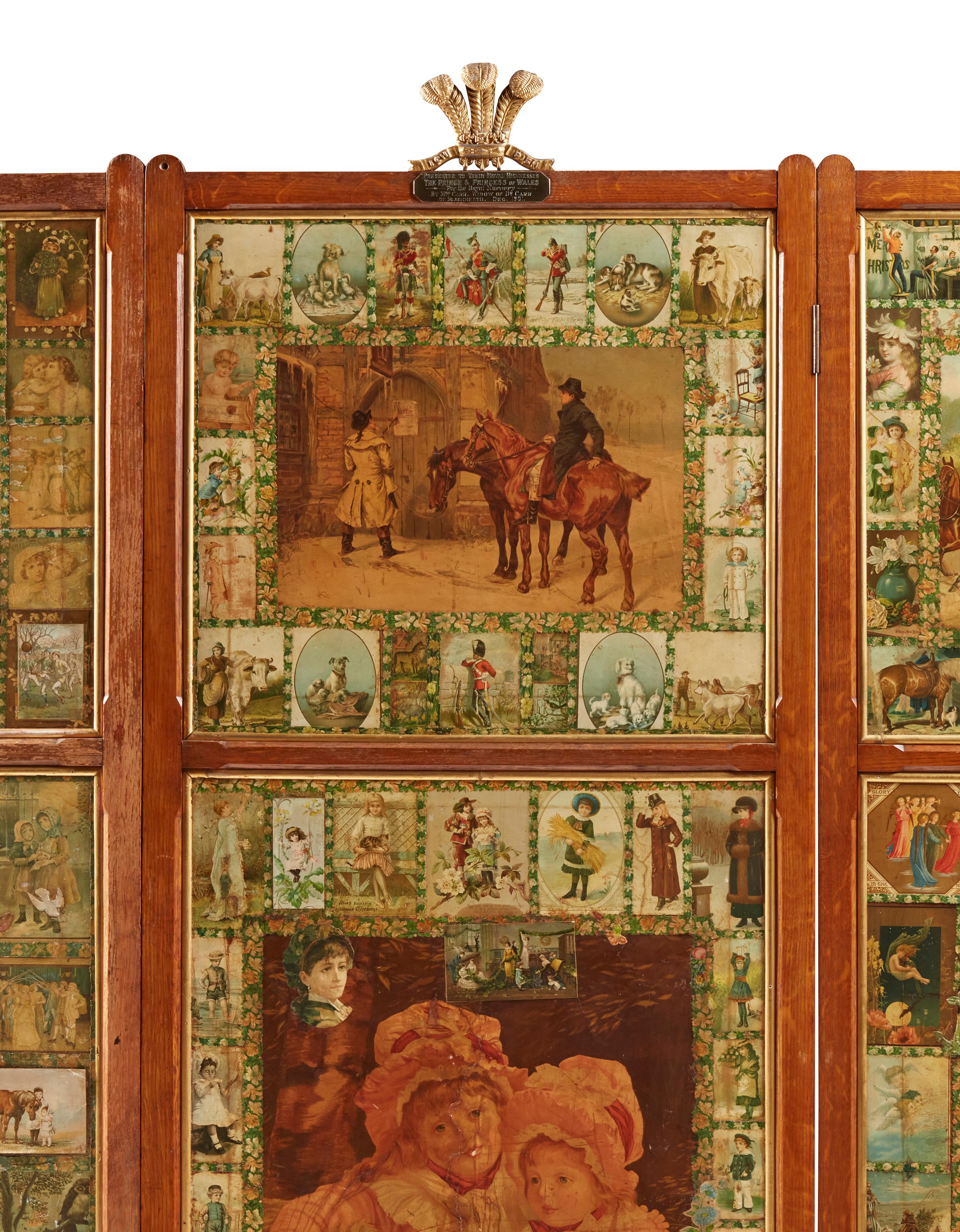
A PRIVATE COLLECTION OF TUNBRIDGE WARE

Tunbridge ware was produced primarily in the 18th and 19th centuries. It was made in Tonbridge and Tunbridge Wells in Kent, about 40 miles south-east of London. Originally pieces took the form of wooden objects made as a side line by local woodworkers to sell as souvenirs to visitors who flocked to the spa town of Tunbridge Wells to ‘take the waters’. Early Tunbridge ware featured inlaid marquetry and parquetry decoration or was often in the form of boxes applied with published prints of well-known local scenes or buildings. The style of Tunbridge ware that we are most familiar with today evolved in around 1830 when William Burrows invented an ingenious technique for creating distinctive tessellated mosaic veneers which were applied to a wide range of smaller items, often boxes, such as tea caddies, work boxes, sewing or desk accessories etc.
The technique for creating this work was intricate and labour intensive. Very thin rods or slivers of wood of triangular or diamond-shaped cross section were arranged to form the desired pattern or design and then stuck together using high quality animal glue. Then they were put under pressure and left to dry. This cluster of rods was then cut with a fine saw into thin slices of veneer which could be applied to various items. The end product was given a hand polished finish or applied with a shellac varnish. Designs were many and varied, ranging from depictions of recognisable local views
or buildings, geometric cube work patterns such as ‘tumbling block’, and scenes copied from Berlin wool work pictures, which were very popular at the time. Around forty different species of wood, both British and continental, were used to create the tesserae. These provided different colours and effects and they were of a natural colour and never dyed. Green wood was sourced from fallen oaks which were infected with a fungus that created rich green coloured veins within the wood.
The creation of Tunbridge ware was something of a cottage industry with around ten different makers concentrated in the areas of Tunbridge Wells and nearby Tonbridge. Three of these craftsmen exhibited their work at the Great Exhibition in 1851, where the maker Edmund Nye received a commendation for his work, a table depicting a ship at sea, in which 110,800 tesserae were used to create the scene.
The rise and fall of the craft was linked to tourism and an eventual change in public taste. By the end of the 19th century the industry was in decline, with skilled workers hard to find, and demand for such wares waning. The final surviving firm, Boyle, Brown & Kemp, closed its doors in 1927. We are pleased to offer this delightful collection of Tunbridge Ware, which demonstrates the variety and range of the craft in terms of form and design.
367 134
367 Y
FOUR VARIOUS TUNBRIDGE WARE TABLE CABINETS
19TH CENTURY
comprising a rosewood example, the top with a view of Muckross Abbey, the two front doors with flowers, opening to four graduated drawers containing dominoes and draught pieces, on a plinth base with four bun feet, 17cm high, 20.3cm wide, 16cm deep; two cabinets, one rosewood and one birds eye maple, each with mixed floral sprays, opening to three graduated drawers with bands of decoration, the rosewood example with bun feet, the rosewood example 16cm wide, 14.5cm high, 14cm deep, the birds eye maple example 16.5cm wide, 13.5cm high, 12.8cm deep; and a rosewood example, the bevelled top with a stylised foliate motif within barber’s pole banding and two stylised borders, the hinged front panel labelled ‘Hurstwood Cottage’ within barber’s pole banding and a stylised border, opening to four graduated drawers, three inlaid with a geometric panel, 17cm wide, 14.5cm high, 12.4cm deep (4)
largest 21cm wide
£600-800
ROSEWOOD TUNBRIDGE WARE LAP DESK
19TH CENTURY
the hinged slope with a castle within floral borders, the interior with a plush velvet slope and fitted compartments enclosing two lidded ink wells, a pen tray and a further lidded compartment; with a lock and key 29.5cm wide, 24cm deep, 7.8cm high
£250-350
370 Y
TWO TUNBRIDGE WARE BOXES

19TH CENTURY
comprising a burr elm box of rectangular form, the flat hinged top with a scene of a boy with his dogs within a chequer band and foliate border, the sides with a band of floral decoration, the interior lined with blue paper with gilt highlights, 27.5cm wide, 10cm high, 17.5cm deep; and a rosewood box of slightly waisted form, with a domed top with a spray of mixed flowers within a floral border, the sides with a band of flowers, 27cm wide, 10.5cm high, 22cm deep (2) larger 27.5cm wide
£250-350
368 Y
FOUR VARIOUS TUNBRIDGE WARE STATIONERY BOXES
19TH CENTURY
comprising a birds eye maple letter box, the sloped hinged top with a castle within a scroll border, the front with a butterfly within geometric borders, the compartmented interior with a green lining, with a lockplate and key, 21.5cm wide, 13cm high, 11.5cm deep; a velvet lined casket of octagonal form, with stylised designs including a Greek Key border, 15.7cm wide, 6.5cm high, 10.5cm deep; a postcard box with stylised borders, the cover labelled ‘POSTCARDS’, 8.5cm high; and a rosewood box with a sloping hinged cover, with alternating bands of geometric and floral designs, 9.5cm high, 12.5cm wide, 6.8cm deep (4)
largest 21.5cm wide
£250-350
THREE TUNBRIDGE WARE PIECES
19TH CENTURY
comprising an ebonised box of canted rectangular form, the hinged cover with a penwork scene of two maids milking a cow, opening to a plush velvet lined interior, 19cm wide, 5.5cm high, 11.5cm deep; a rosewood rectangular box, the hinged cover with an architectural ruin within a geometric border, silk lined interior, 23cm wide, 6.8cm high, 15.4cm deep; and a rosewood book rest with named views of ‘Glena Cottage’ and ‘Ross Castle’, within an oak leaf border, 23cm wide, 6.8cm high, 15.4cm deep (3) largest 23cm wide
£250-350
 371 Y
369 Y
371 Y
369 Y
135
370
372 Y
TWO TUNBRIDGE WARE DESK STANDS
MID 19TH CENTURY
the first with a canted rosewood body, inset to the centre with an inkwell with cover, flanked by two inset boxes with covers, and with a covered quill box with a castle, all within a floral borders, on turned feet, 28cm wide, 21cm deep, 5.2cm high; the other with a rosewood body, inset to the centre with a glass ink well flanked by two integrated lidded boxes and incorporating a quill rest, all with geometric decoration, the sloping front with a floral panel, on bun feet, 21.5cm wide, 17cm deep, 10cm high (2) larger 28cm wide
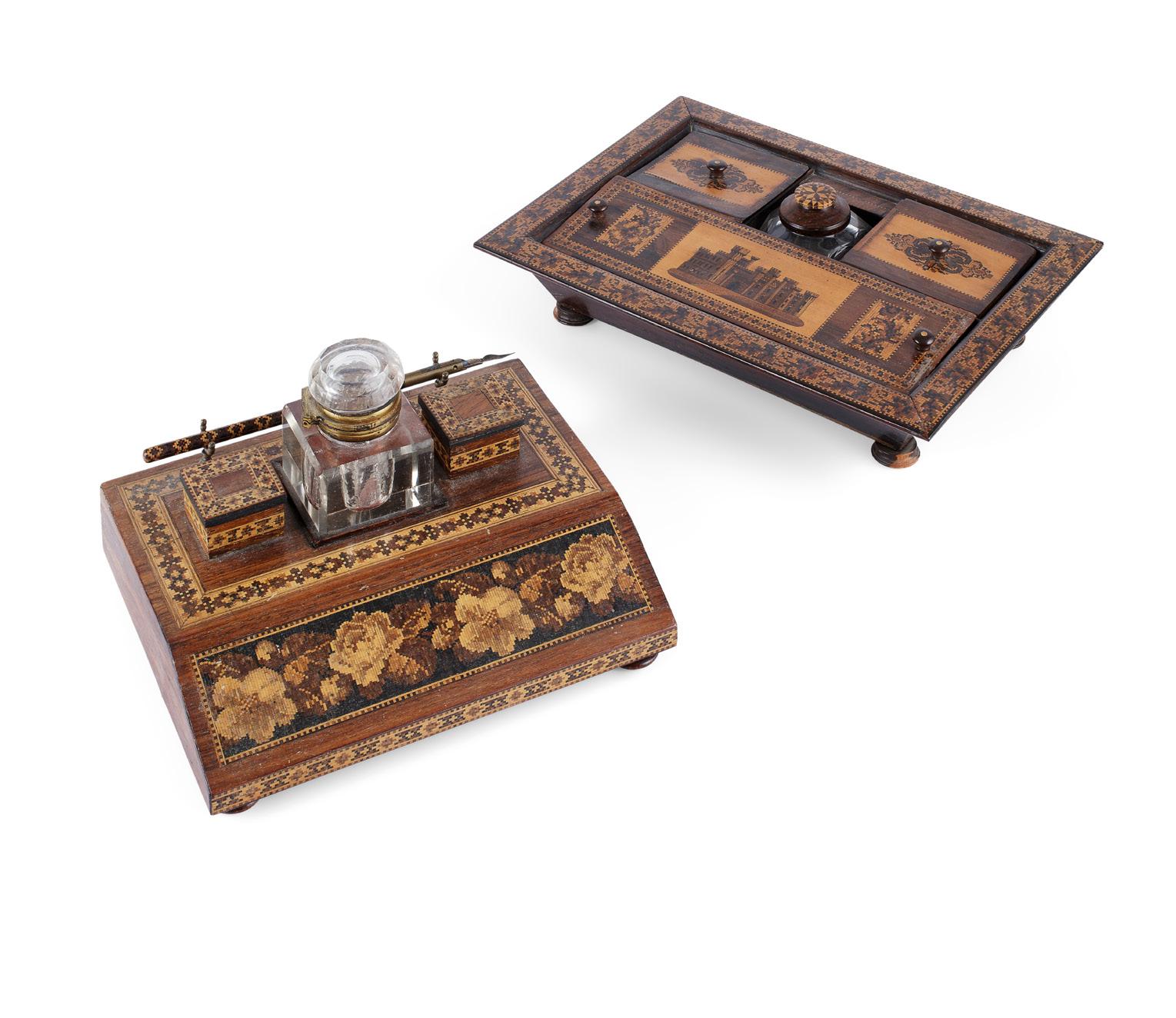
£250-350
373 Y
SIX TUNBRIDGE WARE GLOVE BOXES
19TH CENTURY
comprising two rosewood examples with a floral panel cover and geometric border, 23 and 23.5cm wide; a rosewood box, painted with a landscape scene within an octagonal chequer band border, within a further stylised geometric border, 24.2cm wide; a rosewood box, the cover with specimen woods in a diamond pattern within a geometric border, 24.5cm wide; a burr elm box with hinged domed cover with a castle, the sides a band of flowers, 26.8cm wide; and a rosewood box of slightly waisted form, the domed cover with a castle, the body with a band of flowers, 24.5cm wide (6)

largest 27cm long
£250-350
374 Y
ROSEWOOD TUNBRIDGE WARE LAP DESK
19TH CENTURY
the slope with an architectural scene within a floral inlaid border, the interior with a plush velvet writing slope and fitted compartments containing two lidded glass inkwells, a pen tray and a further lidded compartment; containing various Tunbridge ware desk items such as letter openers, rulers, a spectacle case with spectacles etc, together with TWO SMALL
LEATHER CASED PHOTO FRAMES (qty)
the lap desk 31cm wide, 7.8cm high, 25.6cm deep
£250-350
375
GROUP OF FOUR TUNBRIDGE WARE
‘BUTTERFLY’ DESK ITEMS
19TH CENTURY
comprising a blotter, with felt interior, 31cm wide, 22cm wide; a glove box, inscribed to the bottom ‘Edith Hawthorne from her aunt Mrs Wilmart, Thornton Manor House, about 1838’, 24cm long, 7cm high, 9.5cm deep; a jewellery box with fitted interior, 17cm wide, 6cm high, 12cm high; and a small box with lift-off lid, 9.5cm wide, 3.5cm high, 6.5cm deep (4)
largest 31cm wide
£250-350
372
136 Other fees apply in addition to the hammer price: see the ‘Buyer’s Guide’ section on page 2
375
376
GROUP OF FOURTEEN TUNBRIDGE WARE STAMP BOXES
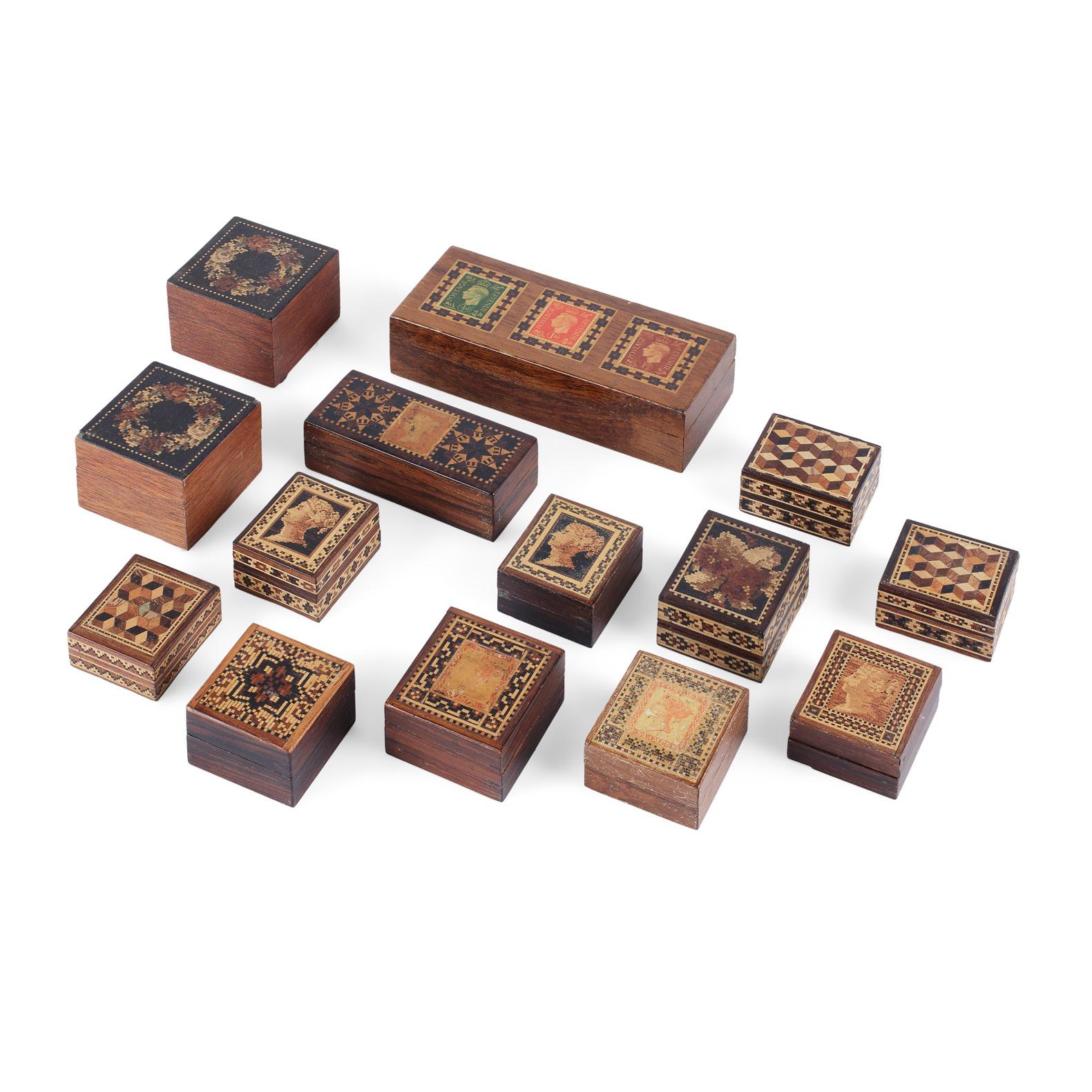
19TH CENTURY
comprising of one box with three George IV stamps and geometric patterns, 12cm long, 5cm wide; one box with a Queen Victoria stamp and star motifs, 8cm long, 3cm wide; three boxes with Queen Victoria’s head, 4.5cm long, 3.5cm wide; two square flower wreath boxes, 5cm by 5cm; three ‘tumbling cubes’ boxes, 3.5cm long, 4cm deep; two boxes with Queen Victoria stamps enclosed by a wavy pattern, 4.5cm long, 4cm wide; one box with a floral bouquet, 4.5cm long, 4cm wide; one square box with a star motif, 4cm by 4cm (14)

largest 12cm long
£250-350
377
COLLECTION OF TWELVE TUNBRIDGE WARE SEWING UTENSILS
19TH CENTURY
comprising of a floral basket with apricot fabric sides and a swing handle, 8cm high, 16cm diameter; a pin cushion shaped as a teapot, 4,5cm high; a floral needlecase, 8cm high; a ‘Go to Bed’ chamber stick, 6cm high; one combination pin cushion and tape measure, 4.5cm high; one combination pin cushion, waxer and tape measure, 7cm high; one ‘Tumbling boxes’ inlaid knitting sheath, 15.5cm long; a star thread waxer, 3.5cm diameter; small star nesting box, 2.5cm high; and three small star screw-top boxes, 2,5 cm and 3cm diameter (12)
Basket 8cm high, 16cm diameter
£250-350
378
COLLECTION OF TUNBRIDGE WARE
‘TUMBLING BLOCK’ PATTERN ITEMS
19TH CENTURY
comprising two cigarette boxes with hinged covers, with maker’s stamp for Tunbridge Wells Manufacturing Co, both 12cm wide; a square box with a slightly domed hinged cover with red silk lined interior, 15.5cm wide; a playing card box; a box with hinged domed cover, 10cm wide; a rectangular coromandel jewellery box with plush velvet lined interior, containing some gaming counters, with lock and key, 18cm wide; a birds eye maple handkerchief box, 15.3cm wide; a rectangular tray with makers label for T . Barton, Mount Ephraim, Tunbridge Wells, 22.5cm wide; and a pair of spill vases of tapering rectangular form, each side inlaid to the centre with a star motif, on a stepped base with gilt highlights, 11.4cm high (10)
largest 22.5cm wide
£300-500
19TH CENTURY with various design patterns, comprising a letter rack on bun feet with geometric decoration, 19.3cm wide; a clothes brush with a floral panel; a square hinged pocket watch holder; a rosewood pocket watch stand with an arch, the hook suspending a German white metal pocket watch, 15cm wide, 18cm high; a rectangular geometric paperweight; a square section stand with a bird, 9.5cm high; a thermometer of obelisk form, 19.5cm high; an octagonal shallow dish with flowers, 12cm wide; and a rectangular dish with a dog, 12.5cm wide (9)
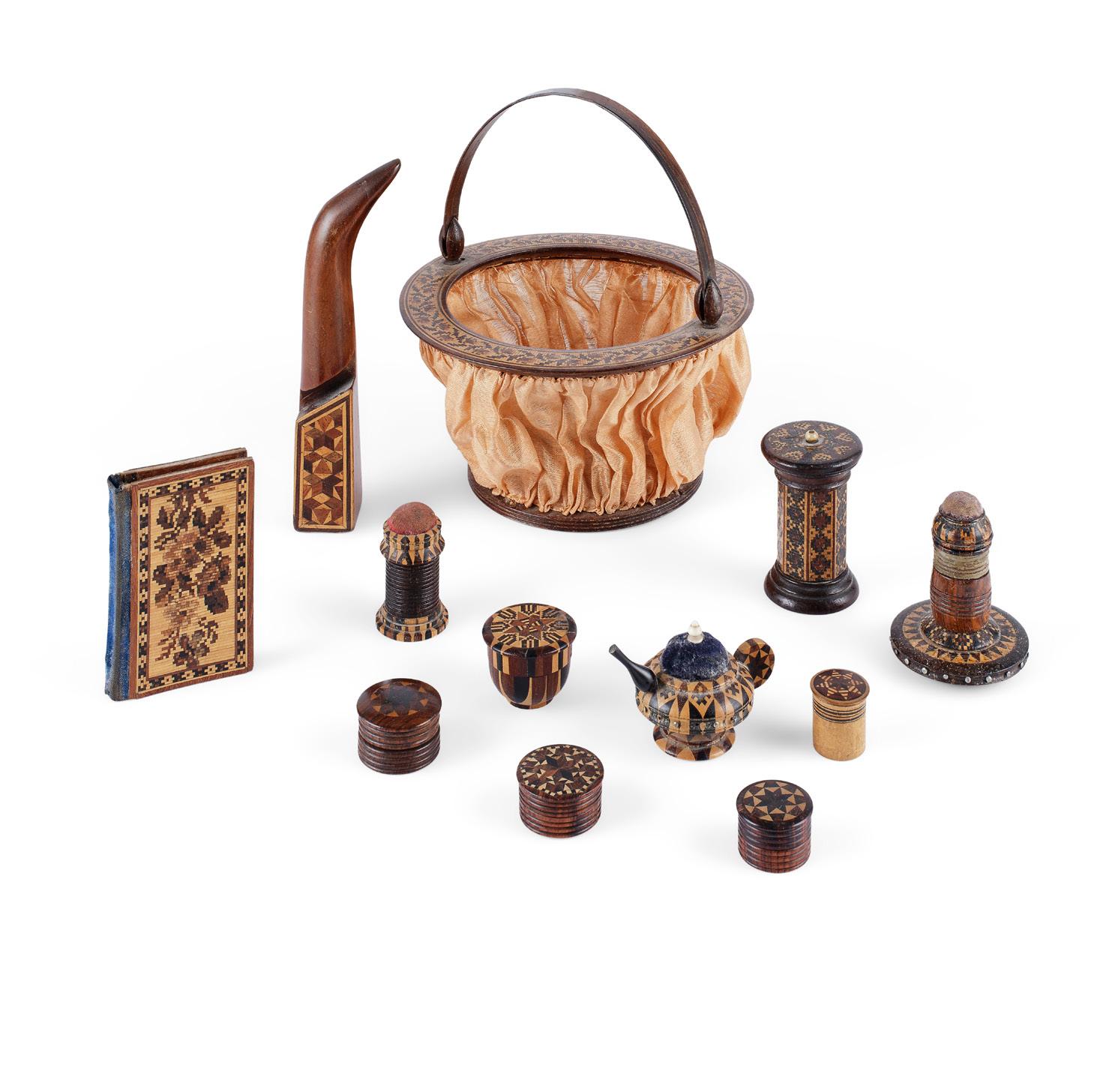
laregst 19.5cm wide
£250-350
379 Y COLLECTION OF TUNBRIDGE WARE DESK ITEMS
377 374 376 137
380
GROUP OF SMALL TUNBRIDGE WARE UTENSILS
19TH CENTURY
comprising of three nutmeg graters, two with kaleidoscopic stars, 5cm and 4 cm high, one with fox’s head, 6cm high; five striped napkin holders, 4.5cm diameter; two small tapers, 3cm high and 2.5cm high; one ring tree, 10cm high; one floral inlay toothpick holder, inscribed in pencil ‘Miss H. Roberts [?], for 3rd prize for Geography of Europe, 8th March 1865’, 6cm high; one small striped perfume bottle holder with a tiny glass bottle and stopper inside, 4.5cm high; one star match holder with striker at the bottom, 5cm high; one mosaic square box containing a puzzle, 5cm by 5cm; one ‘Go to Bed’ taper holder, 10cm high; and three round star screw top boxes, 6cm, 5cm and 4cm diameter (19)
largest 10cm high
£300-500
382
FOUR TUNBRIDGE WARE HAT PIN CUSHIONS
19TH CENTURY
comprising two hat pin cushions with floral designs, 23cm long, 5.5cm high, 8cm deep; and 21cm long, 6.5cm high, 8.5cm deep; one square cushion with removable needlework inset panel, 17cm by 17cm, 4cm high; and one of box form with geometric sliding cushion cover, 12cm long, 7cm high, 8cm deep (4)
laregst 23cm long
£250-350
381
COLLECTION OF FIFTEEN SMALL TUNBRIDGE WARE BOXES
19TH CENTURY
comprising one mosaic square box, 10.5cm by 10.5cm; one octagonal kaleidoscope mosaic box, 8cm diameter; one geometric box, 12cm wide, 6.5cm deep; one box inscribed with A PRESENT FROM TUNBRIDGE WELLS, 10cm wide, 6cm deep; one square star box, 8.5cm by 8.5cm; one ‘tumbling blocks’ and geometric box, 8cm wide, 5cm deep; two ‘tumbling blocks’ boxes, one inscribed as to be arbutus wood from Killarney, 6cm long, 3.5cm deep; four floral boxes, one 15cm wide, 6.5cm deep, the other 9cm wide, 4.5cm deep, two 6cm wide, 3.5cm deep; one star box, 9.5cm wide, 3.5cm deep; one square box with geometric inlay, 5cm by 5cm (15)
largest 15cm wide
£250-350
383
GROUP OF FIVE TUNBRIDGE WARE GAME BOARDS
19TH CENTURY
comprising a chess board with flower border, 35.5cm by 35.5cm; three cribbage boards, two 23cm long, 5.5cm wide; one 30cm long and 8cm wide; and one circular cribbage board, 8.5cm diameter (5)
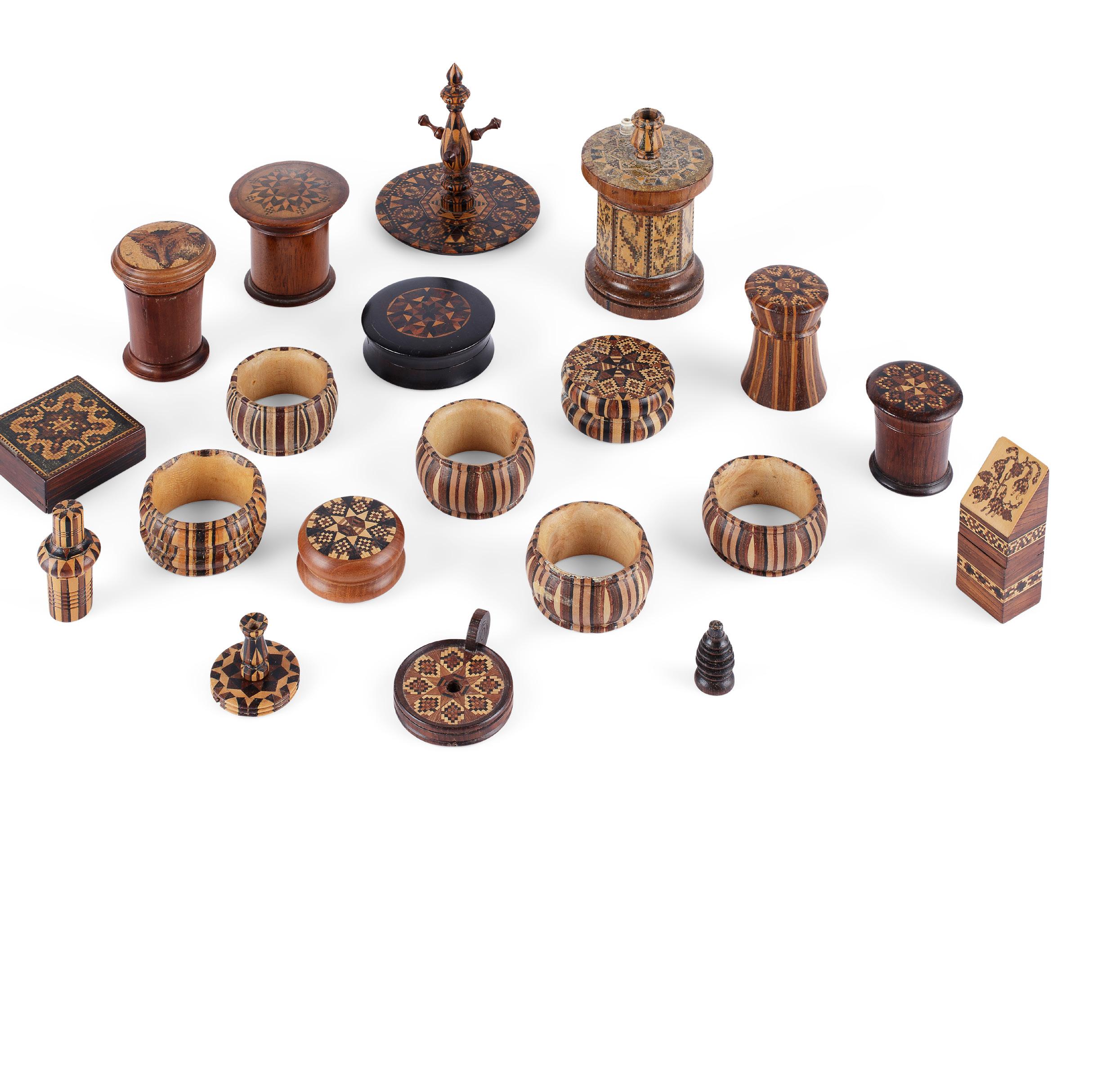
largest 35.5cm wide
£250-350
380 138
384
FIVE TUNBRIDGE WARE BOXES
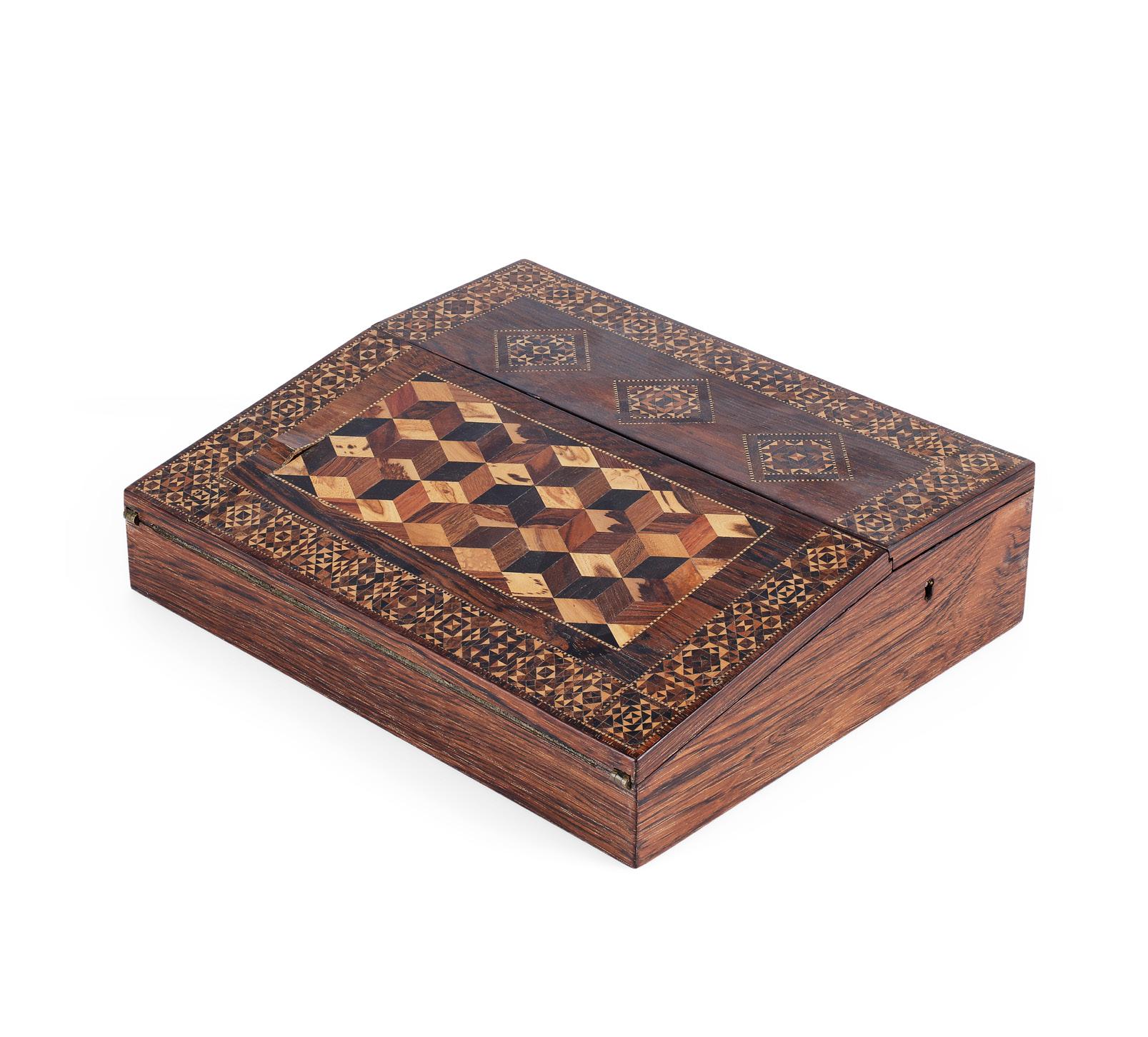
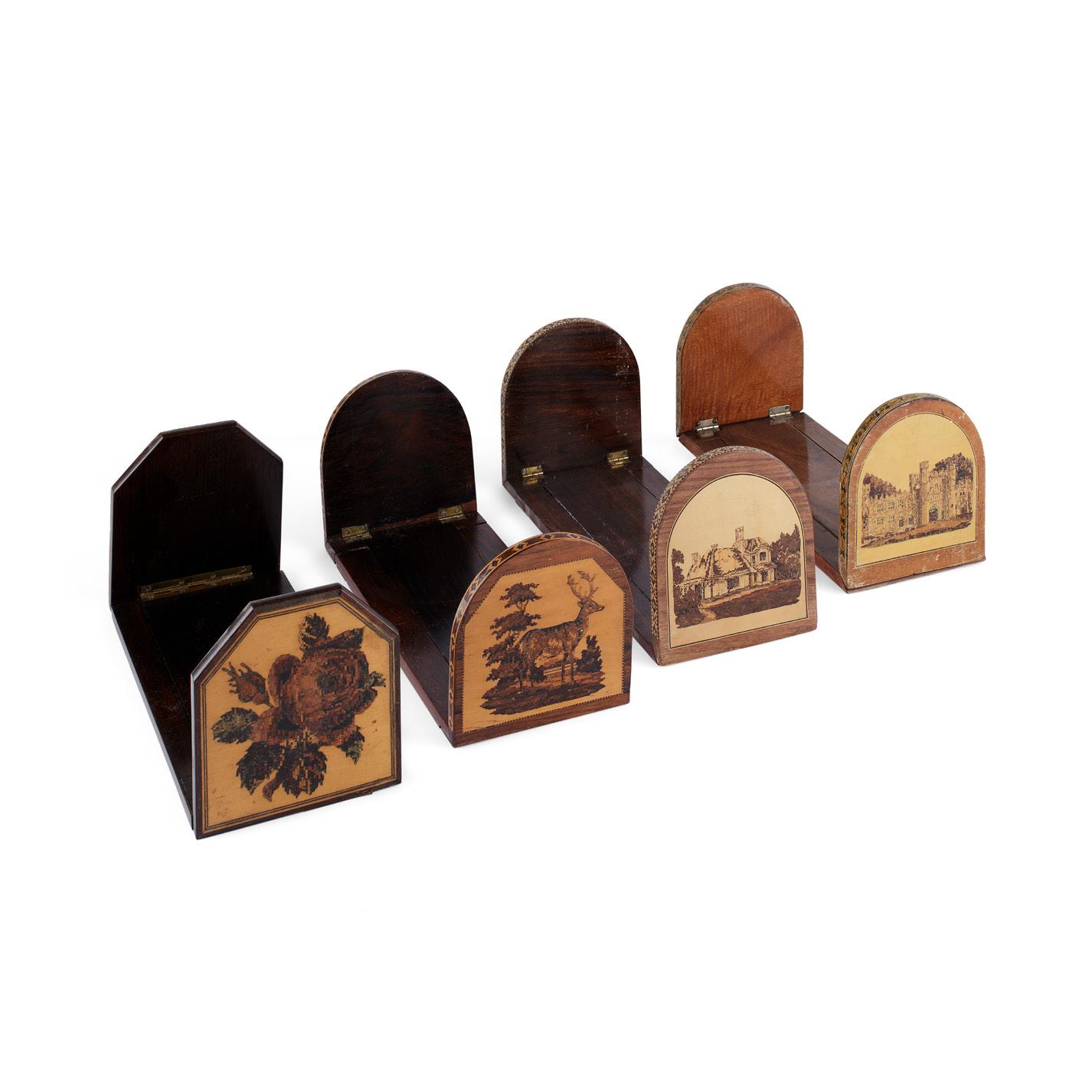
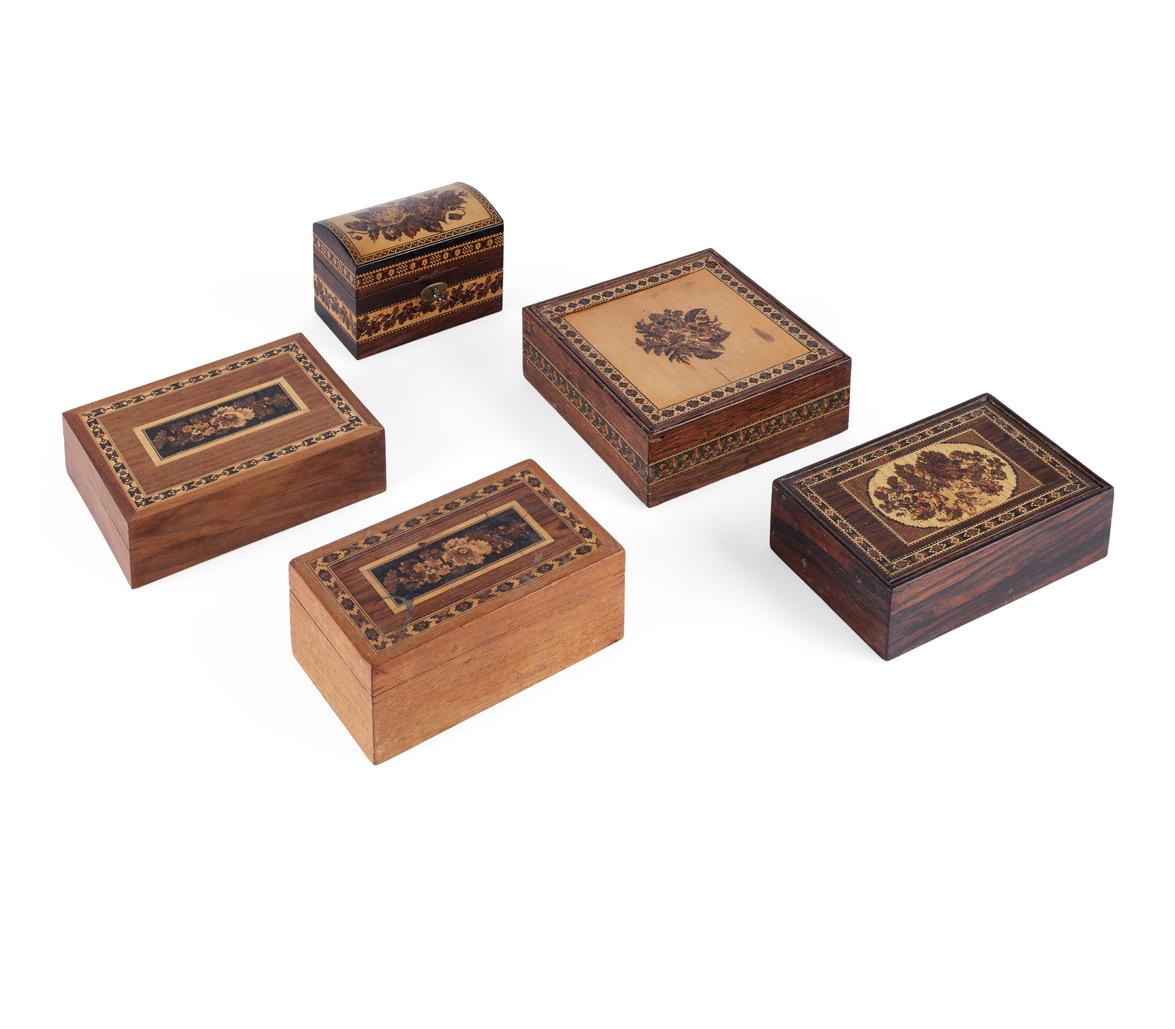
19TH CENTURY
all with various floral decoration within geometric borders, comprising two handkerchief boxes, one of square and one of rectangular form, a casket with hinged domed cover and plush velvet interior, with lock and key, 11.6cm wide, 8cm high, 7cm deep; a rectangular cigarette box, the interior with twin compartments, 16cm wide, and a cigar box, the interior with a maker’s stamp, 15.5cm wide (5)
largest 16cm wide
£250-350
FOUR TUNBRIDGEWARE BOOK STANDS
19TH CENTURY
the first with Eridge castle on one side and a cottage on the other; the second with a stag on one side and and a floral bouquet on the other; the third with a rose on one side and tumbling blocks on the other; and the last with a cottage on one side and tumbling blocks on the other (4)
28cm wide, 14.5cm high, 13cm deep
£250-350
386
TWO TUNBRIDGE WARE TEA CADDIES

19TH CENTURY
of waisted rectangular form, the larger with a slightly domed lid with Warwick Castle with floral banding, opening to an interior fitted with two leaded tea caddies and a later glass bowl, 30.5cm wide, 7cm high, 15cm deep; the smaller with a slightly dome lid with a floral bouquet enclosed by wavy pattern banding, opening to an interior fitted with two leaded tea caddies, 21cm wide, 12cm high, 11cm deep (2)
larger 30.5cm wide
£250-350
TUNBRIDGE WARE ‘TUMBLING BLOCKS’ LAP DESK
19TH CENTURY
with kaleidoscopic banding, opening to a fitted interior with bl writing surface, two ink bottles with inlaid caps and compartments
31cm wide, 8cm high, 26cm deep (closed), 42cm deep (opened)
£250-350
385
387
139 Other fees apply in addition to the hammer price: see the ‘Buyer’s Guide’ section on page 2
388
GILT BRONZE EIGHT BRANCH CHANDELIER
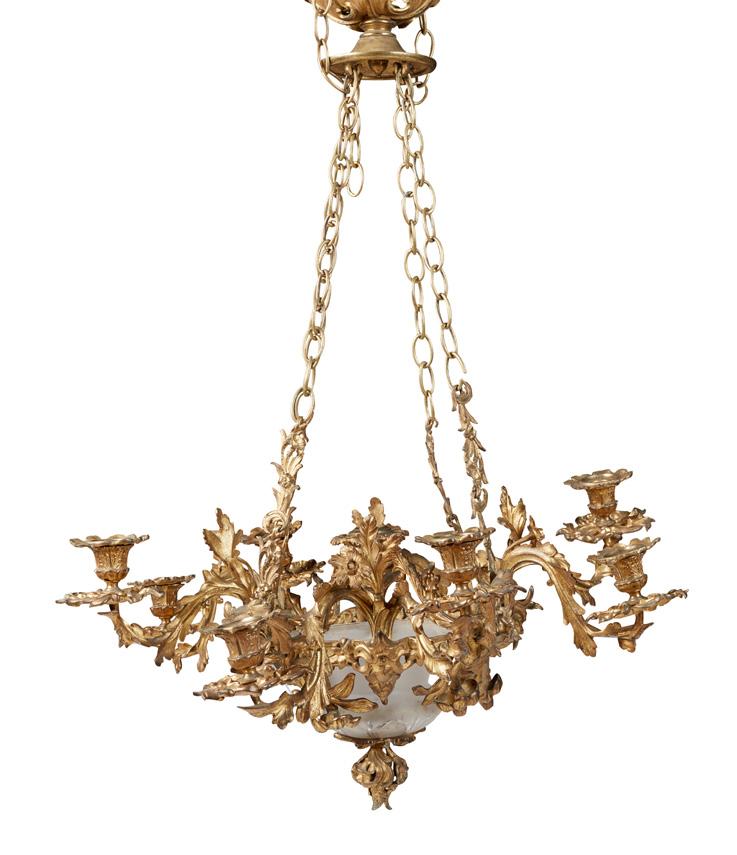
19TH CENTURY
with four pairs of acanthus and floral cast candle arms with foliate nozzles and drip pans, a frosted glass bowl to the centre with a foliate pendant knop, hanging from chains 65cm diameter, 90cm drop approx.
£400-600
BRITISH FURNITURE & WORKS OF ART PART IV
389
PORTRAIT MINIATURE OF QUEEN ALEXANDRA
EARLY 20TH CENTURY
oval, painted on card, Her Highness with her crown and coronation regalia, signed ‘H Dennis’, set in a cast brass oval frame with hinged easel back surmounted with a Royal Coat of Arms, the back with label for ‘Henri, 224, Rue de Rivoli, Paris’
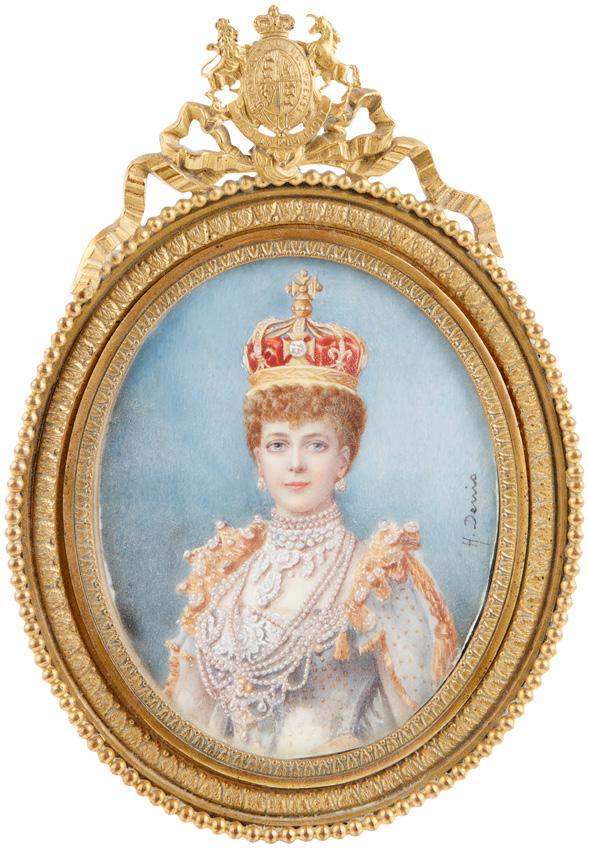
11.5cm wide, 15cm high
£400-600
390
LATE VICTORIAN PAINTED SATINWOOD BOW FRONT DISPLAY CABINET

LATE 19TH CENTURY
the lancet moulded cornice above an astragal glazed door and side lights enclosing shelves, the lower panels with painted reserves depicting classical maidens with putti, on short cabriole legs ending in carved claw and ball feet, the whole painted with floral garlands, trails, and foliate scrolls
115cm wide, 214cm high, 55cm deep
£2,000-3,000
140 Other fees apply in addition to the hammer price: see the ‘Buyer’s Guide’ section on page 2
391
LATE VICTORIAN OAK AND PARCEL-GILT
THREE PANEL SCRAP SCREEN, OF ROYAL INTEREST
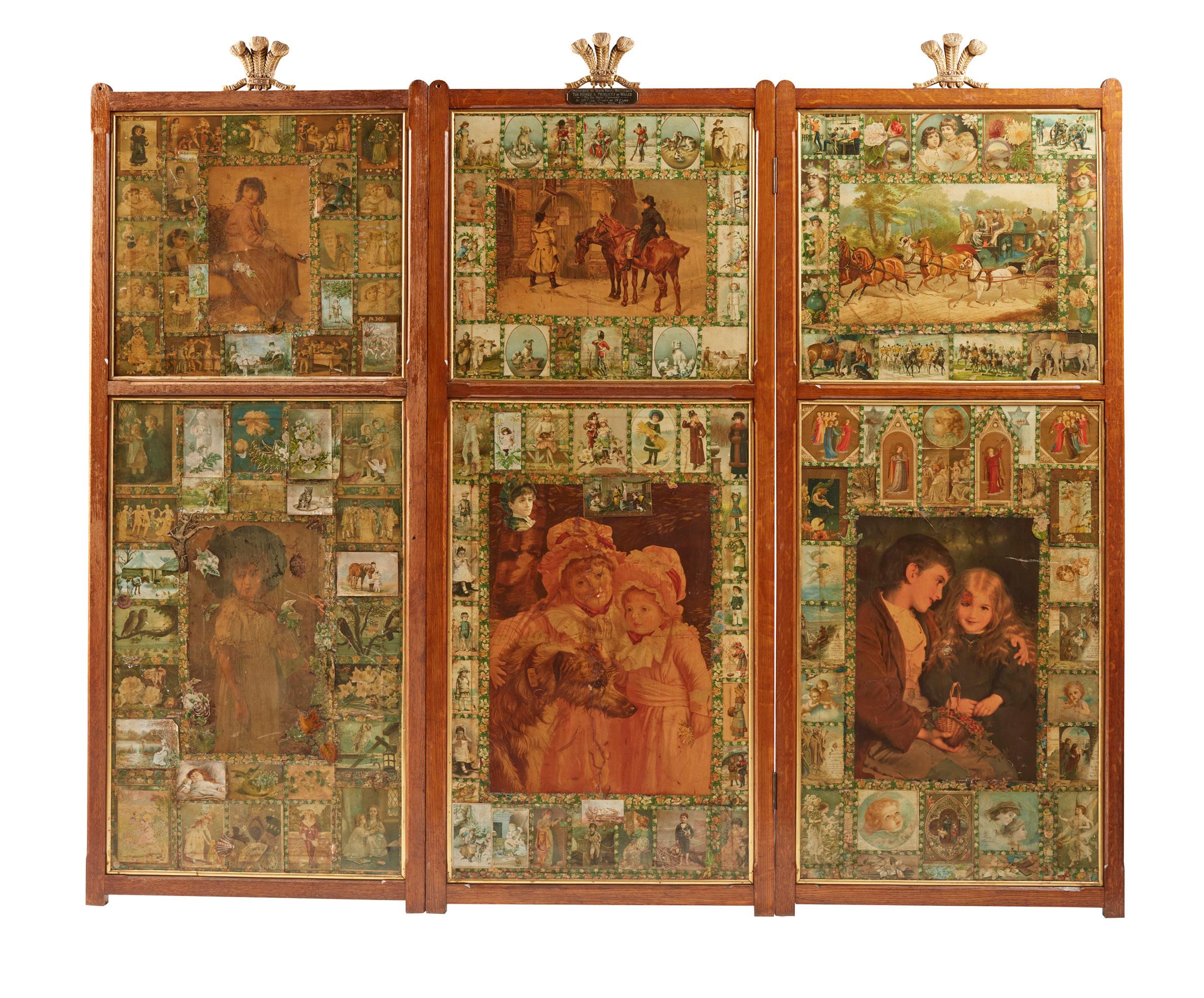
DATED 1901
each screen comprising an arrangement of lithographic images and surmounted by carved gilt Prince-of-Wales plumes, the same on the reverse, bearing a brass presentation plaque ‘PRESENTED TO THEIR ROYAL HIGHNESSES THE PRINCE & PRINCESS OF WALES/ For the Royal Nursery/ By
MRS
CARR, WIDOW OF DR. CARR OF BLACKHEATH DEC. 1901’
219cm wide, 190cm high
Provenance: Presented to H.M. King George V (1865-1936) and H.M. Queen Mary (1867-1953) when Prince and Princess of Wales, December 1901.

The Royal Nursery, York Cottage, Sandringham.
H.R.H. Princess Mary, The Princess Royal, Countess Harewood (1897-1965), the nursery, Goldsborough Hall, Yorkshire.
The Hon. Gerald and Mrs Angela Lascelles, the nursery, Fort Belvedere, Runnymede, Surrey, 1956-1976.
Virginia Water Cottage, Windsor Great Park, Berkshire and by descent.
Literature: Christopher Hussey, ‘Fort Belvedere, Surrey-II; The Residence of the Hon. Gerald Lascelles’, Country Life, 26 November 1959, fig. 9., p. 963.
£6,000-8,000
141
£400-600

VICTORIAN PITCH PINE DOUBLE WARDROBE, IN THE MANNER OF HOWARD & SONS
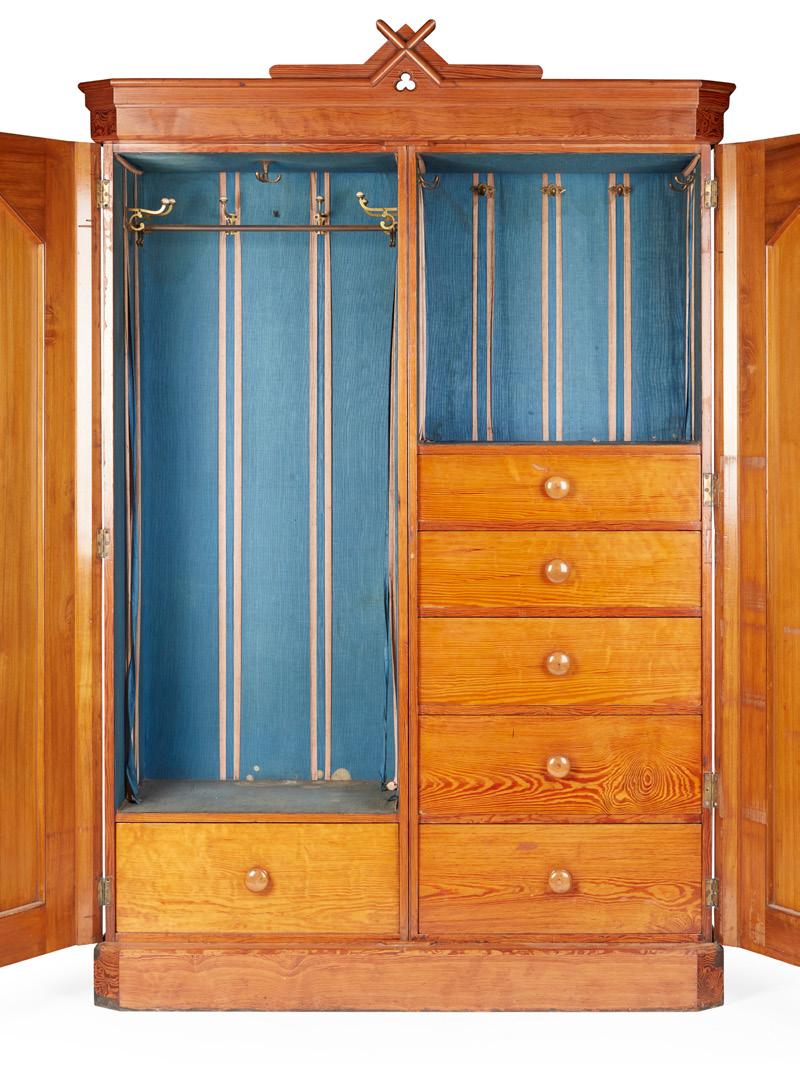
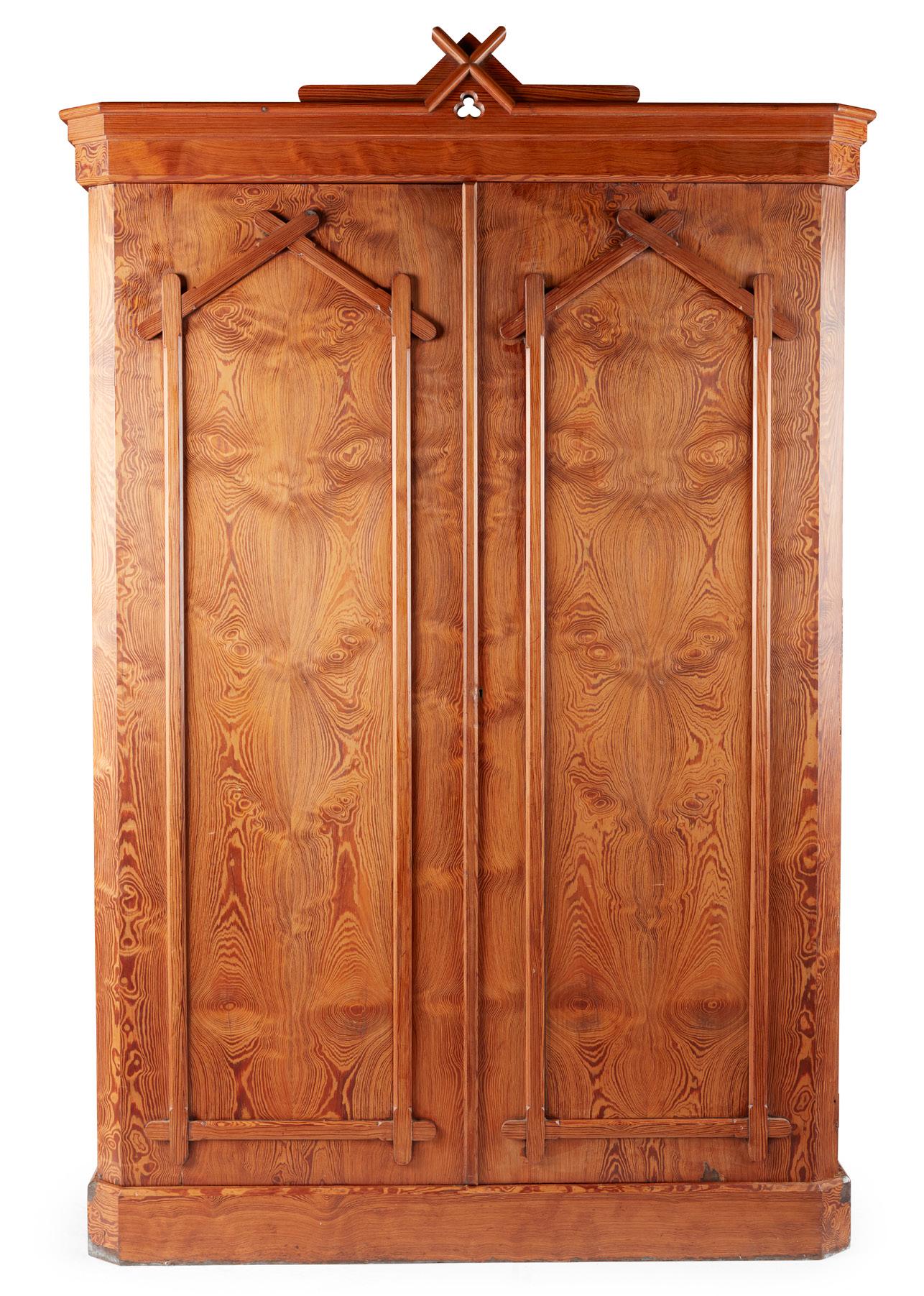
LATE 19TH CENTURY
the moulded cornice above pair of cupboard doors, opening to a fitted fabric-lined interior with drawers and hanging space, on a plinth base 144cm wide, 225cm high, 58cm deep £800-1,200
392
142
396
BLONDE
LATE 19TH CENTURY
the four-panel back above a box seat with hinged cover flanked by open arms, above a base with corresponding linen-fold carved panels
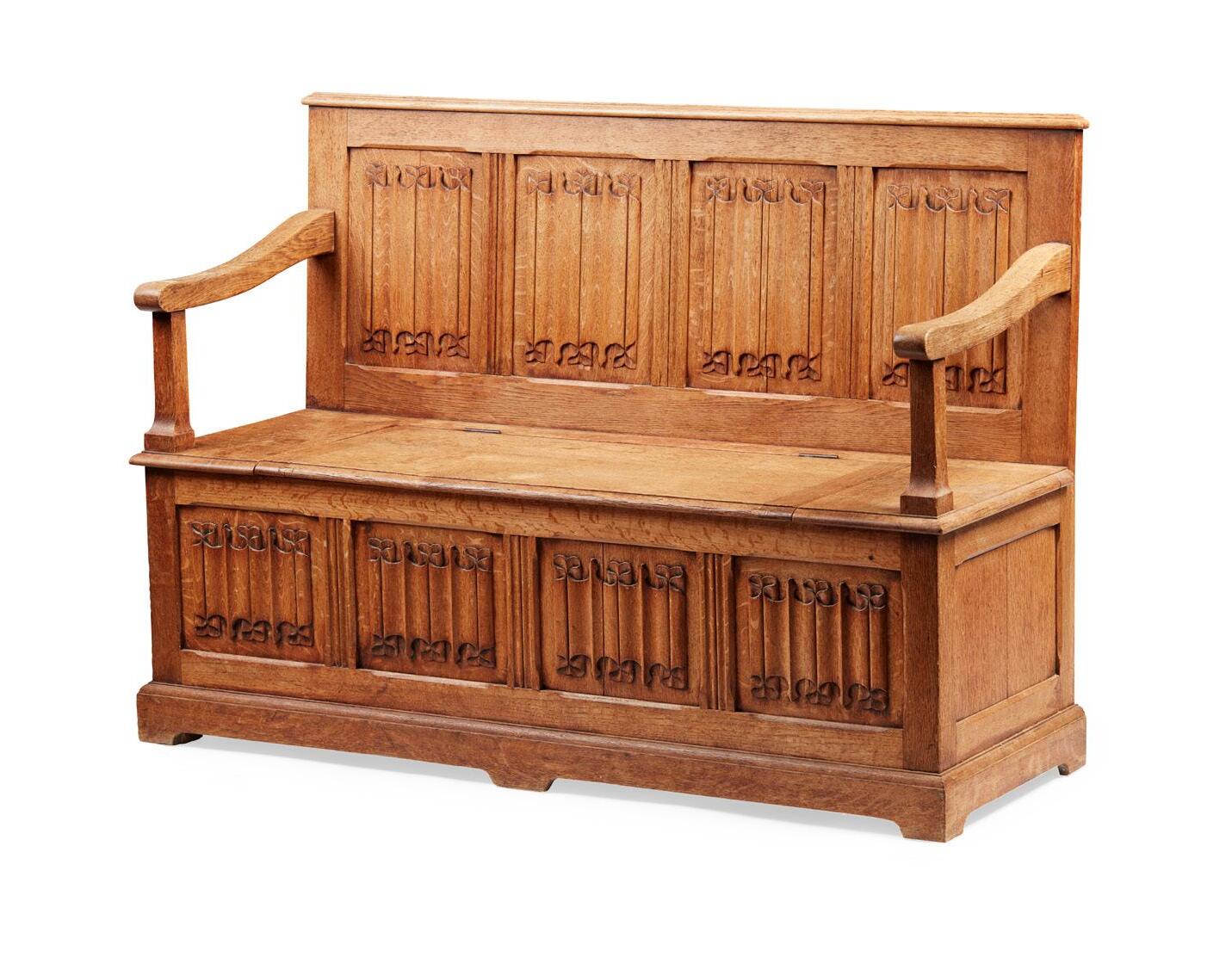
137cm wide, 97cm high, 45cm deep £500-700
394
ENGLISH ARTS & CRAFTS
COTSWOLD SCHOOL OAK TABLE
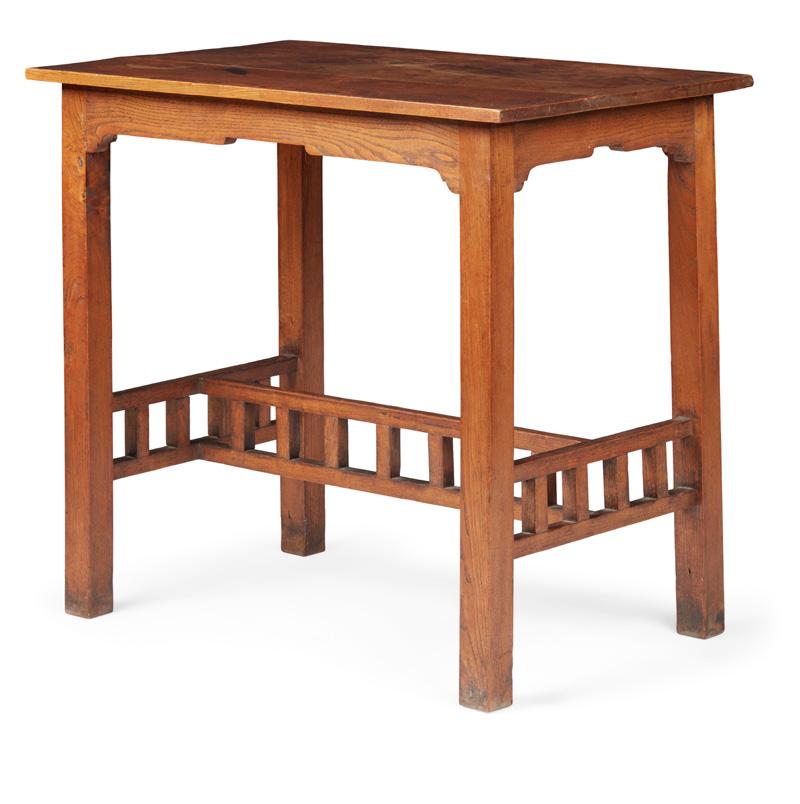
EARLY 20TH CENTURY
the two-board top above a shaped frieze, raised on straight square legs joined by an open-work H stretcher 83.5cm wide, 78cm high, 55cm deep £600-800
395
VICTORIAN PITCH PINE WARDROBE, ATTRIBUTED TO HOWARD & SONS
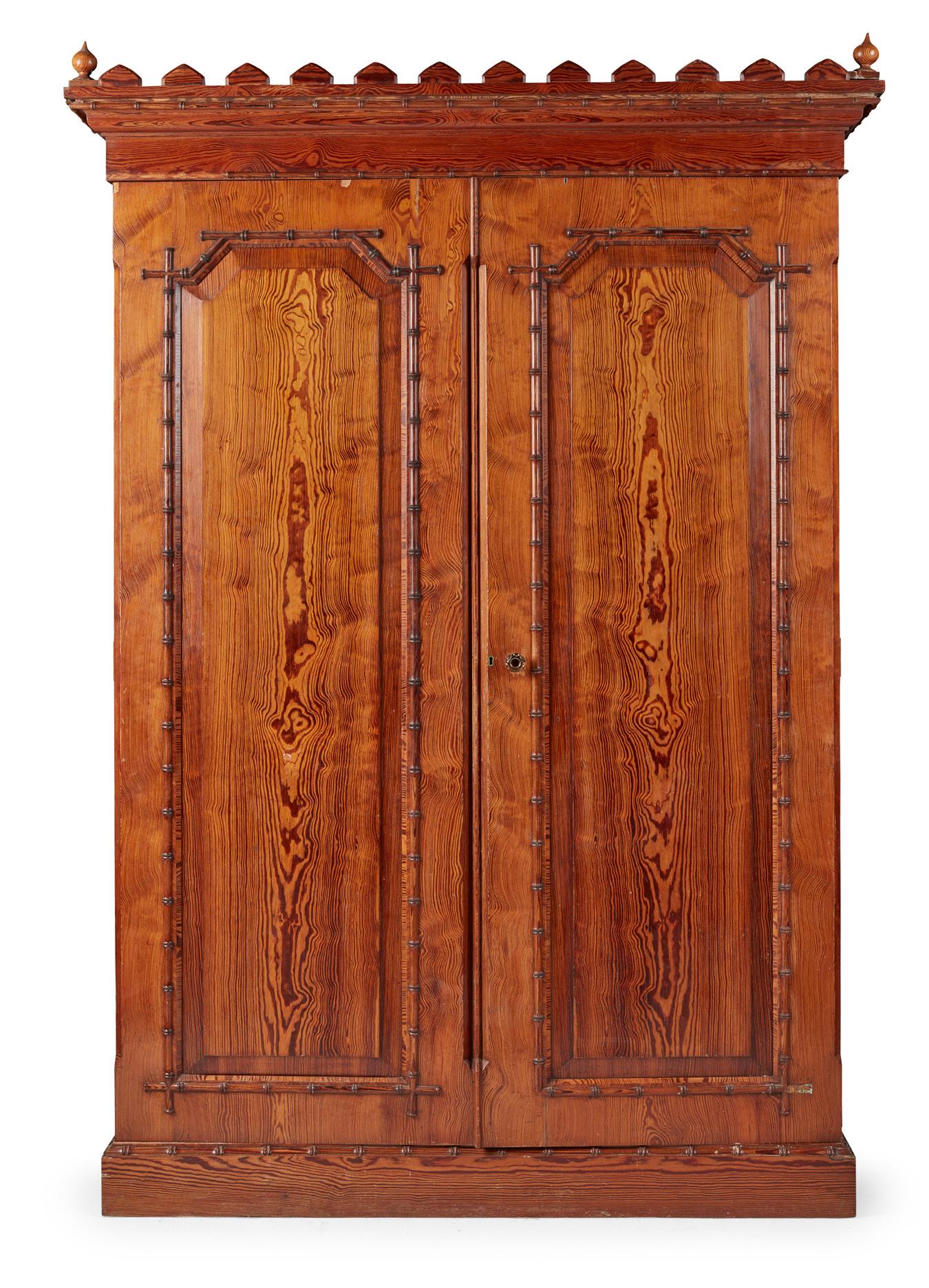
LATE 19TH CENTURY
the crenelated cornice with urn finials to the corners, above a pair of raised panel door all outlined with faux bamboo moulding, on a plinth base; the interior with hanging space, sliding trays and two deep drawers
151cm wide, 225cm high, 63cm deep £1,000-1,500
OAK CARVED LINEN FOLD BOX SETTLE
143 Other fees apply in addition to the hammer price: see the ‘Buyer’s Guide’ section on page 2
397
PAIR OF BRASS WALL LANTERNS MODERN

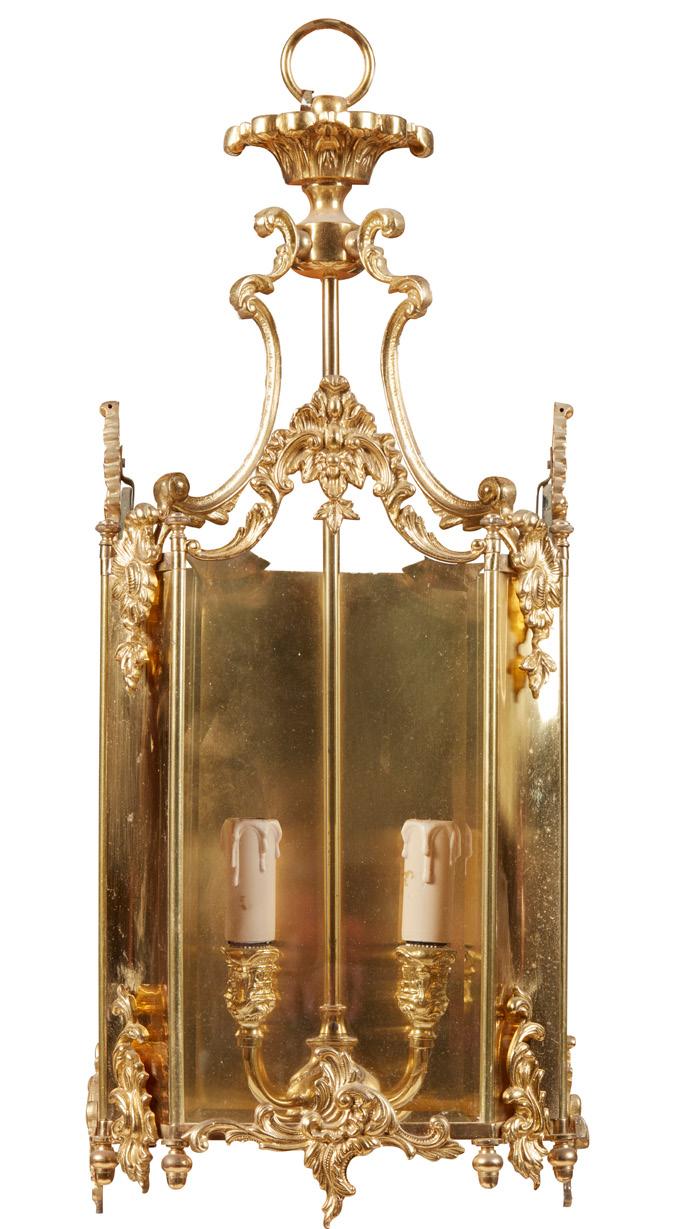
with bevelled break arch panels framed by rococo style appliques (2)
27cm wide, 71cm high, 15cm deep
£300-500
398
VICTORIAN CARVED OAK PEDESTAL DESK
19TH CENTURY
the rectangular top with three red leather inserts and leaf carved edge, over three frieze drawers, raised on pedestal supports of three short drawers carved with Green Man masks, flanked trailing laurel garlands on the corners
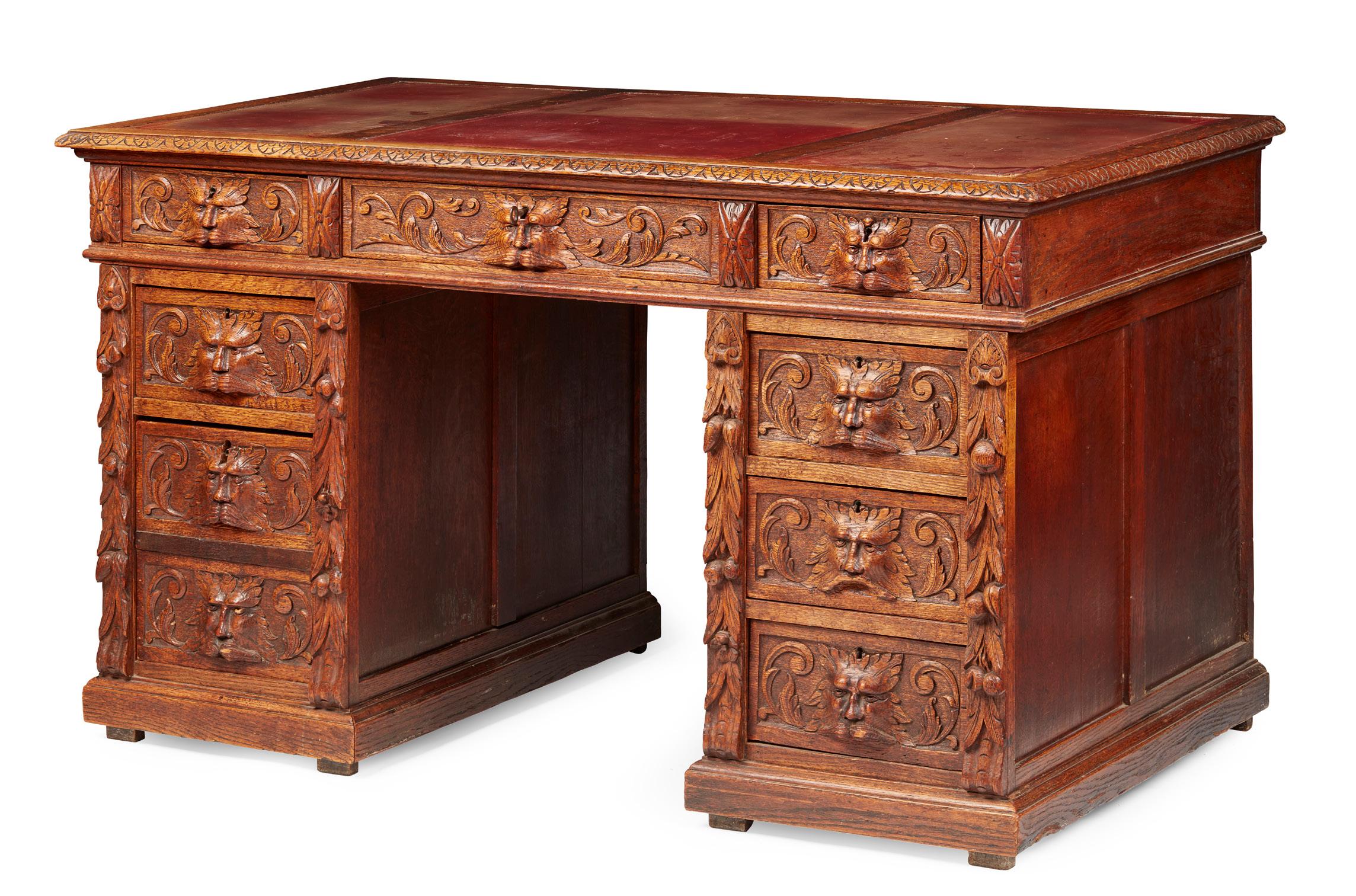
135cm wide, 80cm high, 80cm deep
£400-600
144 Other fees apply in addition to the hammer price: see the ‘Buyer’s Guide’ section on page 2
399
LATE VICTORIAN GILT METAL MOUNTED OAK BRACKET CLOCK
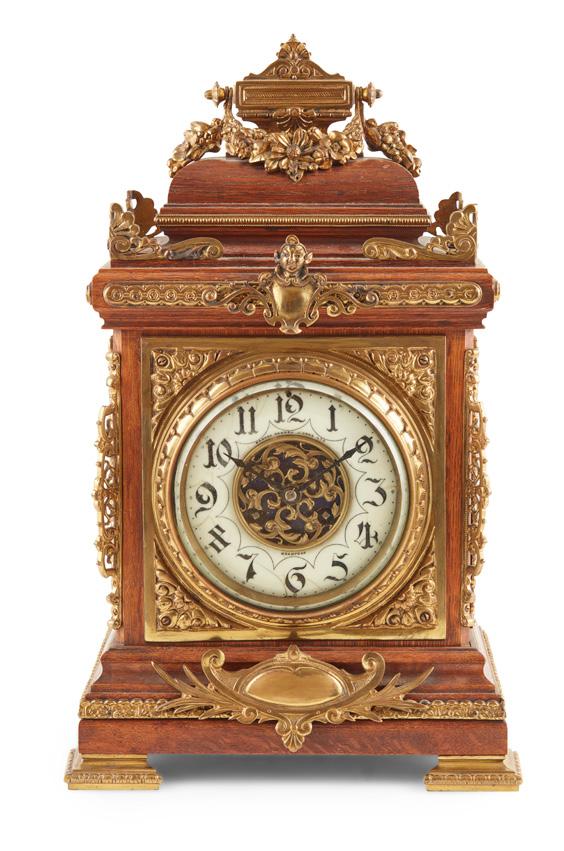
LATE 19TH CENTURY
the circular dial with a cream enamel chapter ring with Arabic numerals and a pierced brass centre, signed ‘Manoah Rhodes & Sons Ltd, Bradford’, the oak case with a caddy top mounted with Orientalist style gilt metal mounts, on bracket feet, the French twin-train brass movement by Vincenti et Cie stamped ‘23196’, striking a gong, with matching number pendulum
27cm wide, 44cm high, 21.5cm deep
£300-500
400
PAIR OF BRASS AND GLASS COLUMN LAMPS
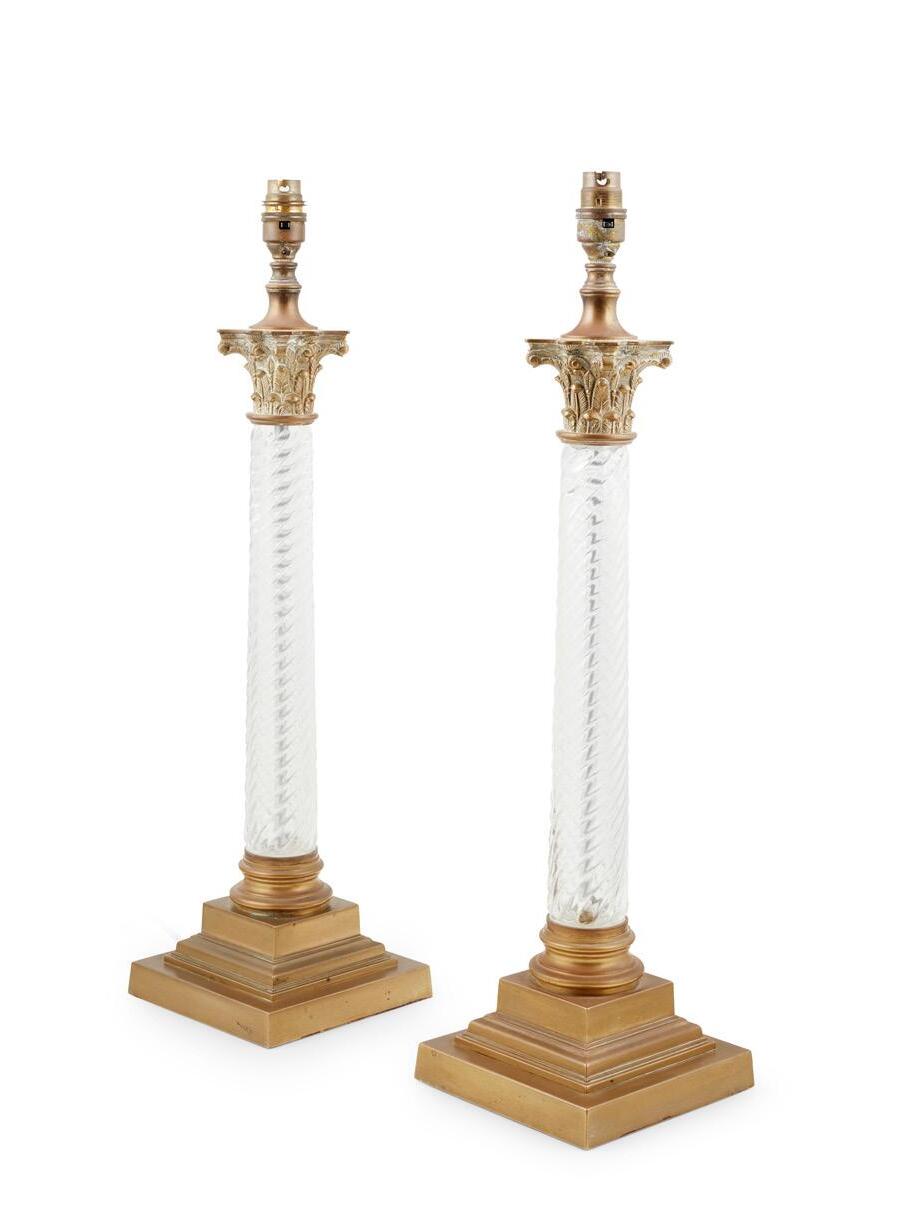
EARLY 20TH CENTURY
the wrythen glass columns with brass Corinthian capitals and square stepped bases, fitted for electricity (2) 58cm high (including fittings)
£400-600
401
VICTORIAN MAHOGANY PERPETUAL DESK CALENDAR

19TH CENTURY
the moulded pediment with a fluted sunburst above glazed apertures for day, date, and month, flanked by columns, on a moulded base
40cm wide, 66cm high, 16cm deep
£1,000-1,500
402
LARGE CARLTONWARE
BLUE AND GILT LAMP
EARLY 20TH CENTURY
of covered baluster form in the Chinese style, decorated with scenes of temple gardens, black stamp to base, mounted on a brass foot, fitted for electricity 57cm high (excluding fitting)

£300-500
403
EDWARDIAN MAHOGANY CANED WASTE PAPER BASKET

EARLY 20TH CENTURY
of tapered hexagonal form with canework panels and pierced handles, on bracket feet 32cm in diameter, 37.5cm high
£300-500
145
404 Y
VICTORIAN ROSEWOOD, FRUITWOOD AND MARQUETRY WRITING TABLE MID 19TH CENTURY

the shaped oval top with a moulded edge and a green leather insert enclosed by floral marquetry sprays, above a shaped frieze with further floral marquetry and raised on squared cabriole legs with gilt metal mounts
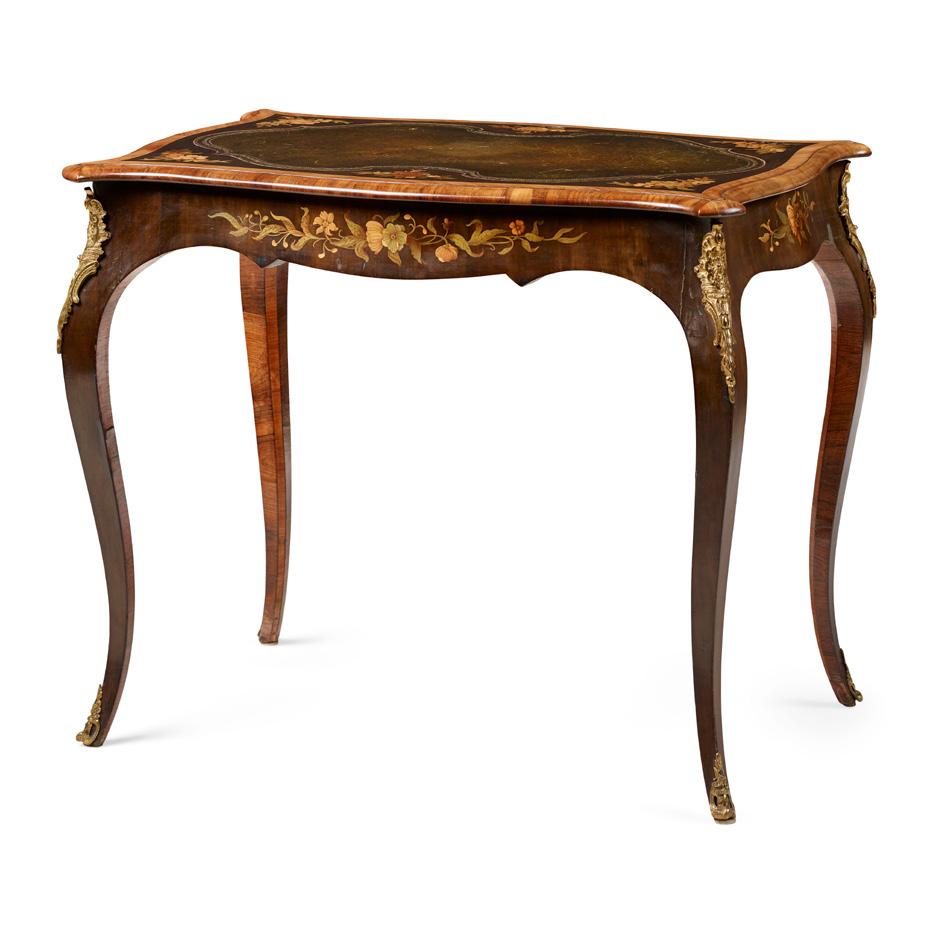
98cm wide, 73cm high, 48cm deep
£400-600
405
EDWARDIAN PAINTED SATINWOOD DISPLAY CABINET
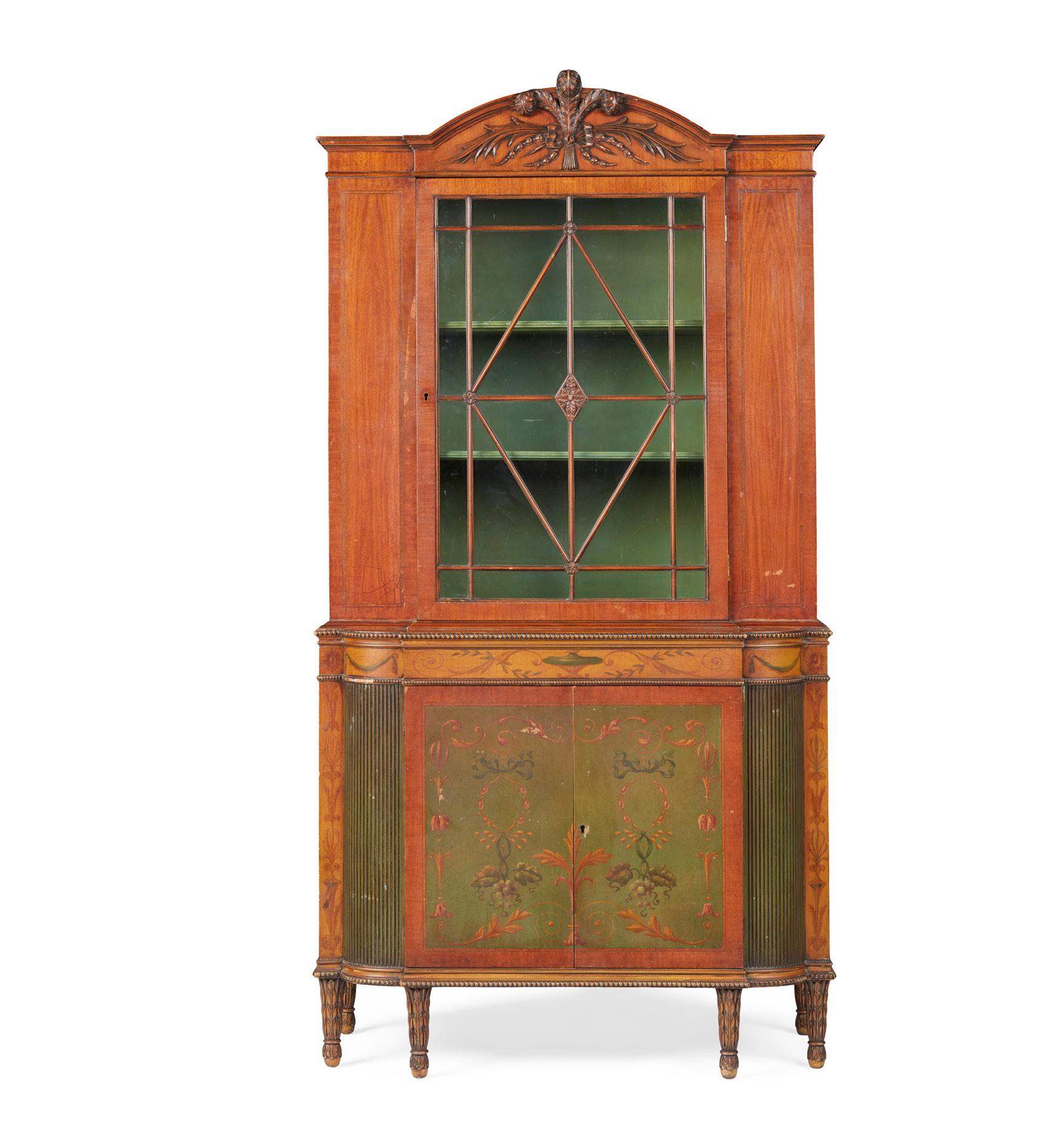
EARLY 20TH CENTURY
the arch moulded cornice with carved Prince-of-Wales plumes above an astragal glazed door enclosing green-painted shelves, the base of breakfront D shape, the frieze and pair of doors painted with flower garlands and ribbon-tied swags and flanked by reeded quarter panels, raised on foliate carved tapered feet 99cm wide, 197cm high, 47cm deep
£400-600
406
VICTORIAN MAHOGANY AND BRASS INLAID CENTRE TABLE LATE 19TH CENTURY
the shaped oval top with a central brass inlaid foliate reserve withing brass banded inlay, above a long frieze drawer raised on fluted tapered legs joined by a wavy X form stretcher centred by a brass mounted urn finial 129cm wide, 78cm high, 73.5cm deep
£500-700
146
Note: This costume was designed by Oliver Messel (19041978), an artist and one of the foremost stage designers of the mid-20th century. He mastered every aspect of entertainment - ballet, drama, film, musical, opera and revue - as well as working in interior decoration and textile design. His lavish, painterly and romantic concepts were perfectly in tune with the times and earned him an international reputation.
The Sleeping Beauty, designed for the Sadler’s Wells (now Royal) Ballet in 1946, is Messel’s most enduring production, running from February 1946 through January 1967. The fairy costumes and fantasy elements he anchored in a ‘real’ world, inspired by the soaring architectural fantasies of the 17th and 18th centuries and costumes based upon mid-late 17th-century fashions, mixing English, Spanish and French period styles.
Desmond Doyle danced this role at Covent Garden in 1960 and toured in the part at Leeds in 1959. John Gilpin danced this role at Covent Garden in 1961.
The original production of Sleeping Beauty has currently been revived by the Royal Opera and will run until 6 June.
407
OLIVER MESSEL FOR THE ROYAL BALLET, ‘SLEEPING BEAUTY’ PRINCE FLORIMUND COSTUME
CIRCA 1960S
the scarlet velvet 18th century style coat with gold brocade faux waistcoat panels, gold lamé sash and jewelled medallion, with Royal Opera House label; worn by both Desmond Doyle and John Gilpin as Prince Florimund in Act II in separate productions

Provenance: Sold Sotheby’s, 1 October 1980, the Royal Opera House Covent Garden Royal Gala Auction, lot 110 And Sotheby’s, 27 March 1996, Fabric Swatch Books, Quilts, Costumes and Textiles, lot 460
£800-1,200
Robert Helpmann and Margot Fonteyn in the original 1946 Sadler’s Wells Ballet production of The Sleeping Beauty designed by Oliver Messel. Image ©Frank SharmanRoyal Opera House

408 Y
LARGE WALNUT, ROSEWOOD, AND PARCEL GILT SERVING TABLE BY WHYTOCK & REID, AFTER A DESIGN BY SIR ROBERT LORIMER 20TH CENTURY
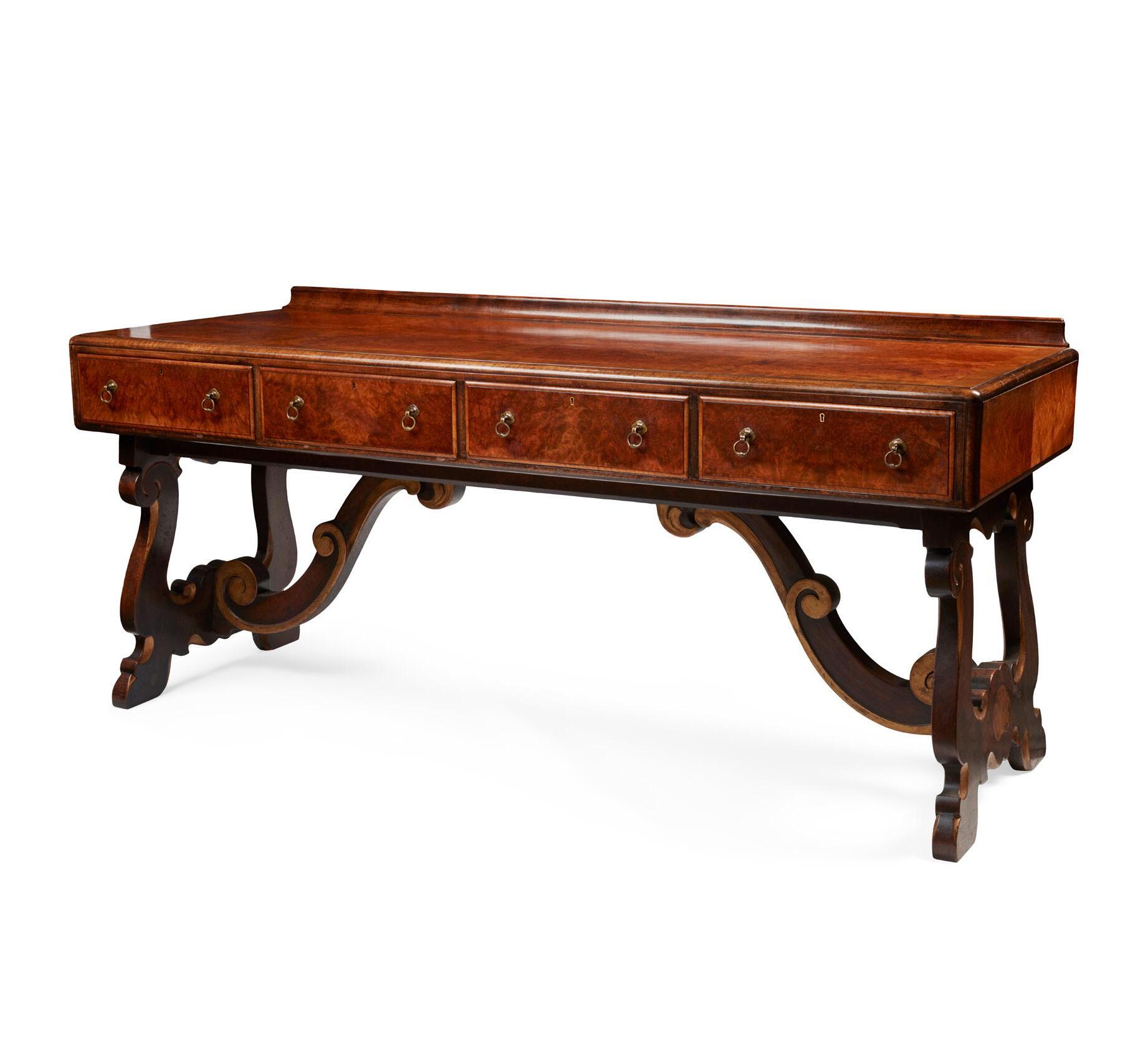
in the Spanish style, the crossbanded top above four short frieze drawers, raised on scrolled trestle supports with carved brackets, stamped in the drawers WHYTOCK & REID EDINBURGH
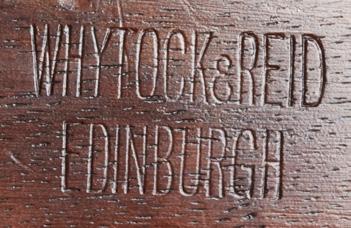
214cm wide, 97cm high, 83cm deep
£3,000-5,000
147 Other fees apply in addition to the hammer price: see the ‘Buyer’s Guide’ section on page 2
409
LARGE MAPLE & CO. PAINTED WOOD ADVERTISING TRAM
BOARD SIGN
EARLY 20TH CENTURY
painted in yellow letters on a dark green ground ‘MAPLE & CO. LTD.
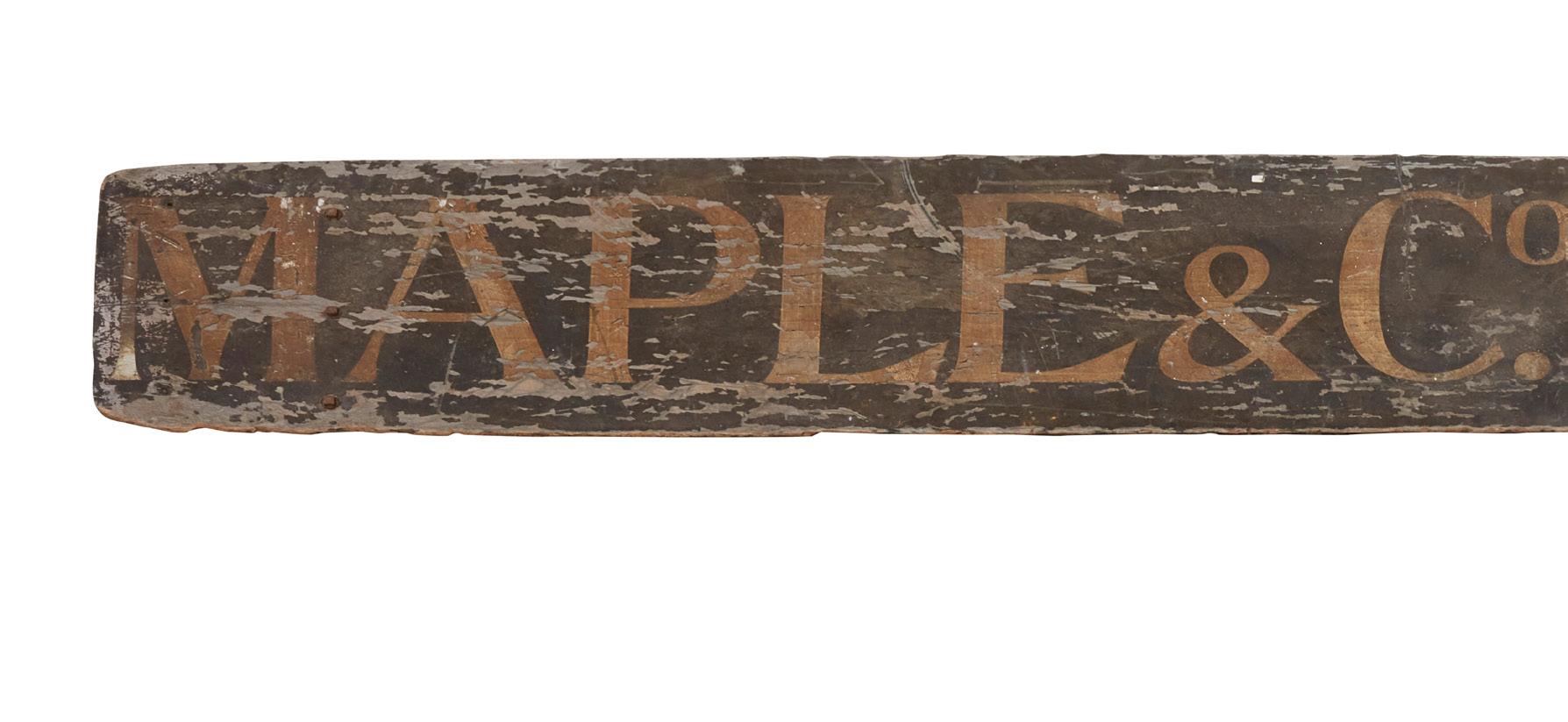
TOTTENHAM CT. RD.’
428cm wide, 45cm high £600-800
410
EDWARDIAN MAHOGANY AND INLAID KIDNEYSHAPED WRITING TABLE, BY MAPLE & CO.
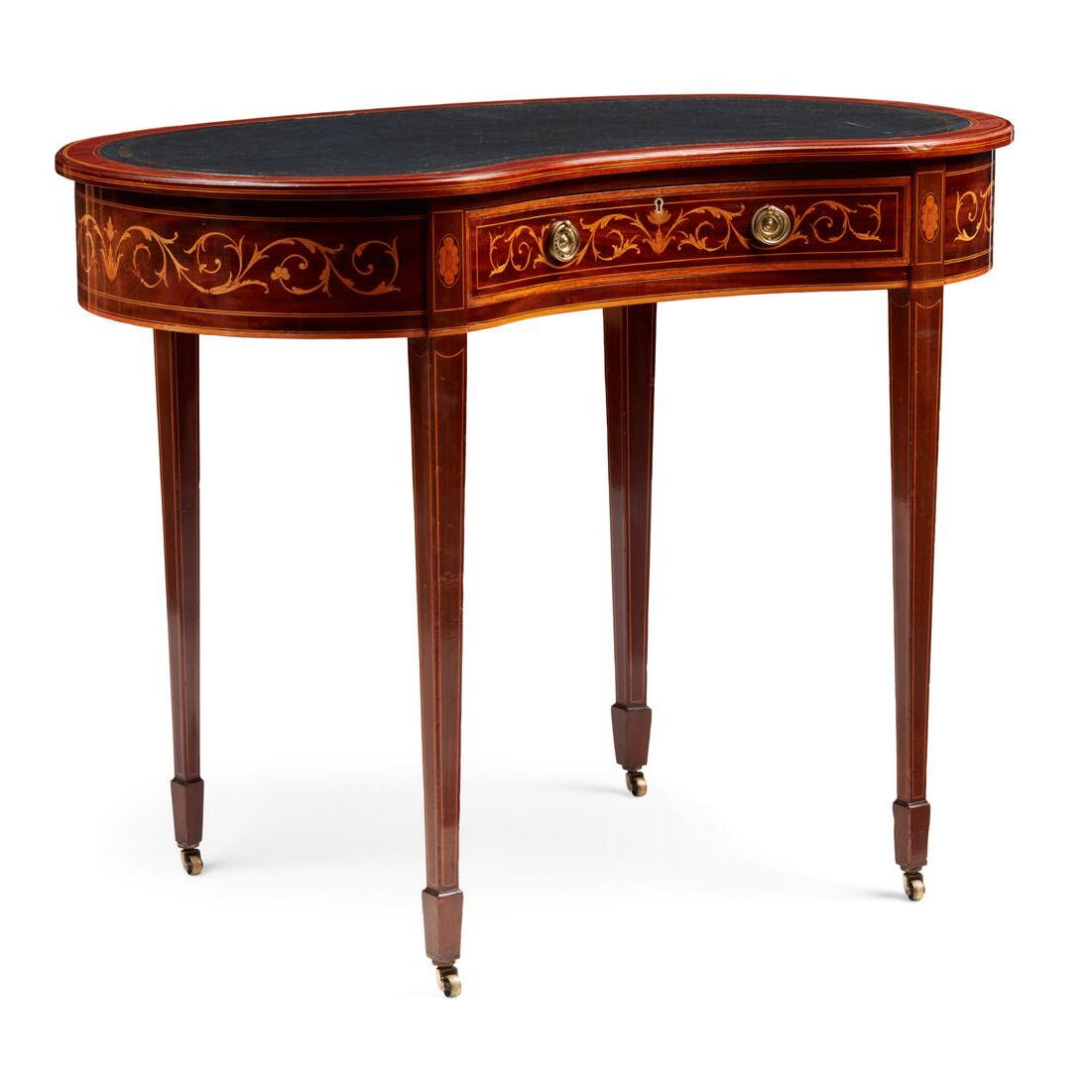
EARLY 20TH CENTURY
the reniform top with a blue and gilt tooled leather surface, above a frieze with a long drawer and foliate scroll inlay, raised on line inlaid square tapered legs ending in spade feet with brass castors
100cm wide, 76cm high, 57cm deep
£1,500-2,000
411
EDWARDIAN CREAM PAINTED AND PARCEL
GILT SIDE CABINET, BY MAPLE & CO.
EARLY 20TH CENTURY of shaped demilune outline, with a flower painted frieze above a pair of doors painted with oval reserves of courting couples, flanked and divided by columns and raised on tapered feet; trade label to the interior 104cm wide, 111cm high, 49cm deep £500-700

148 Other fees apply in addition to the hammer price: see the ‘Buyer’s Guide’ section on page 2
412
VICTORIAN AESTHETIC PERIOD MAHOGANY AND SATIN BIRCH THREE PIECE BEDROOM SUITE, BY MAPLE & CO.
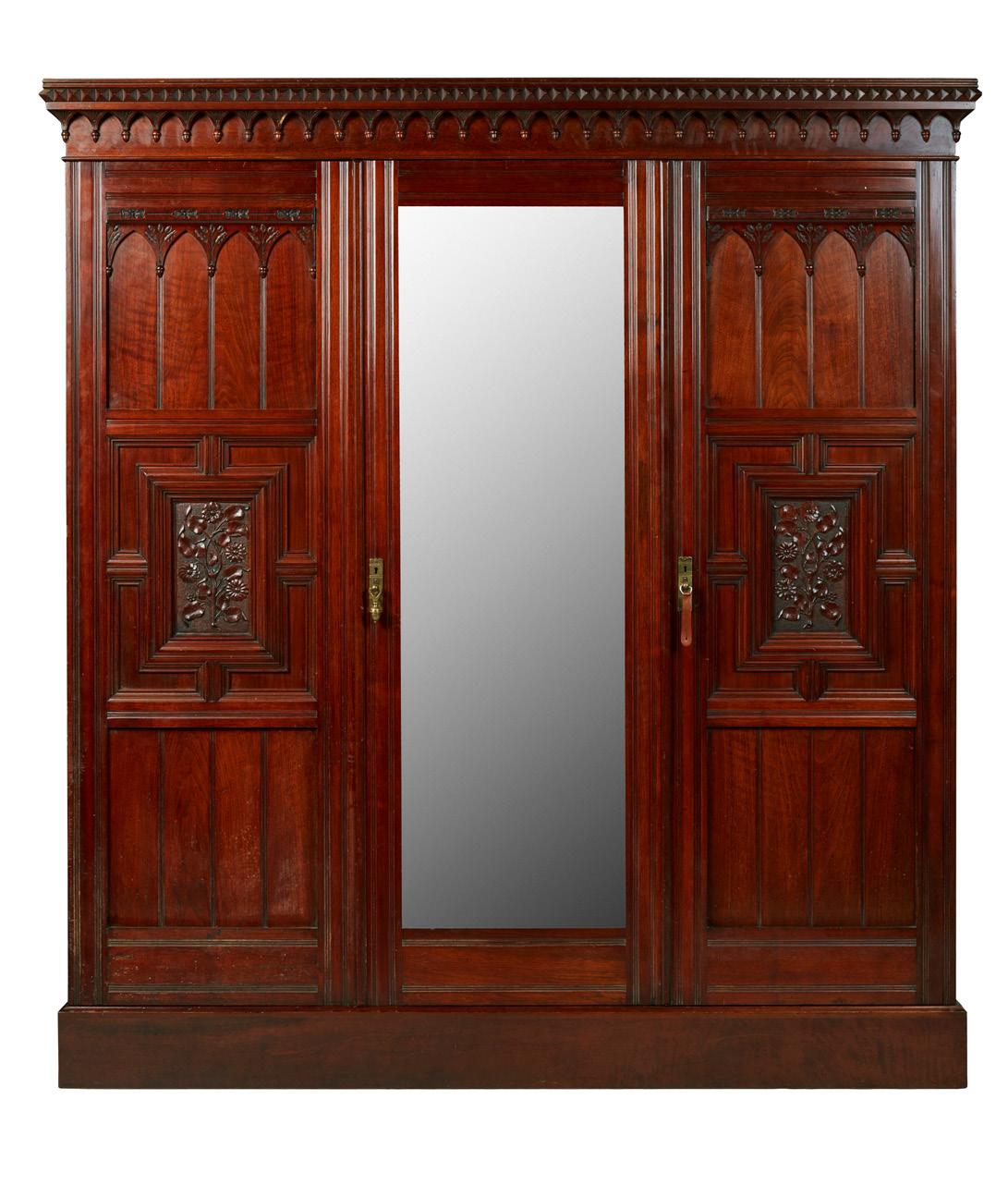
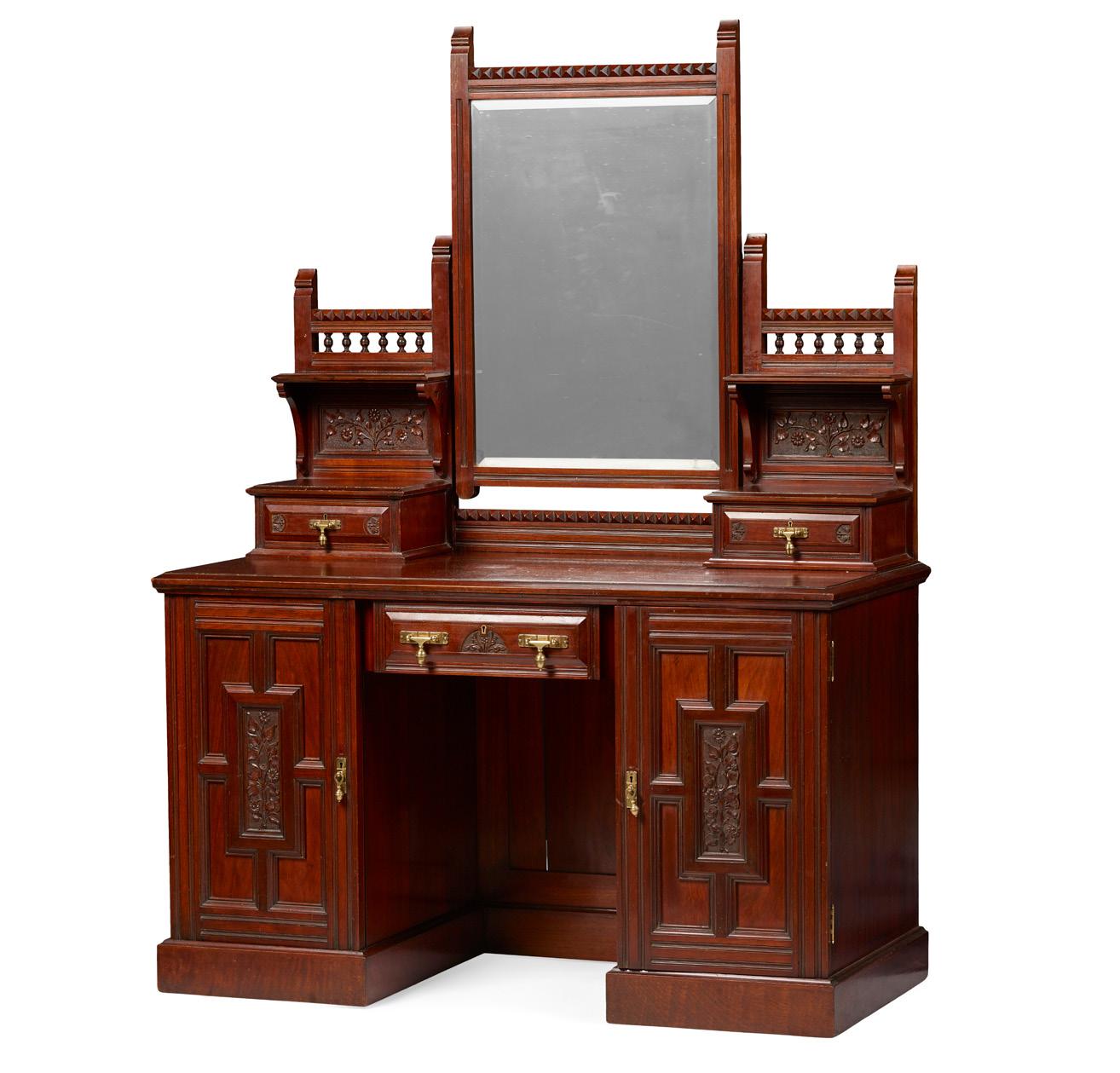
LATE 19TH CENTURY
comprising a dressing table with mirror, marble topped washstand with tile back and mirror, and wardrobe with mirrored door, sliding trays, drawers, and a hanging cupboard, bearing ivorine trade label and stamped MAPLE & CO. (3)
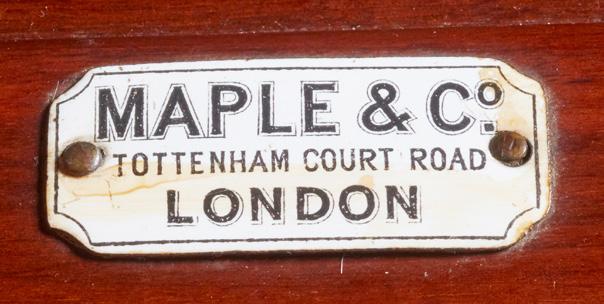
dressing table 130cm wide, 178cm high, 61cm deep; washstand 130cm wide, 171cm high, 61cm deep; wardrobe 205cm wide, 221cm high, 59cm deep
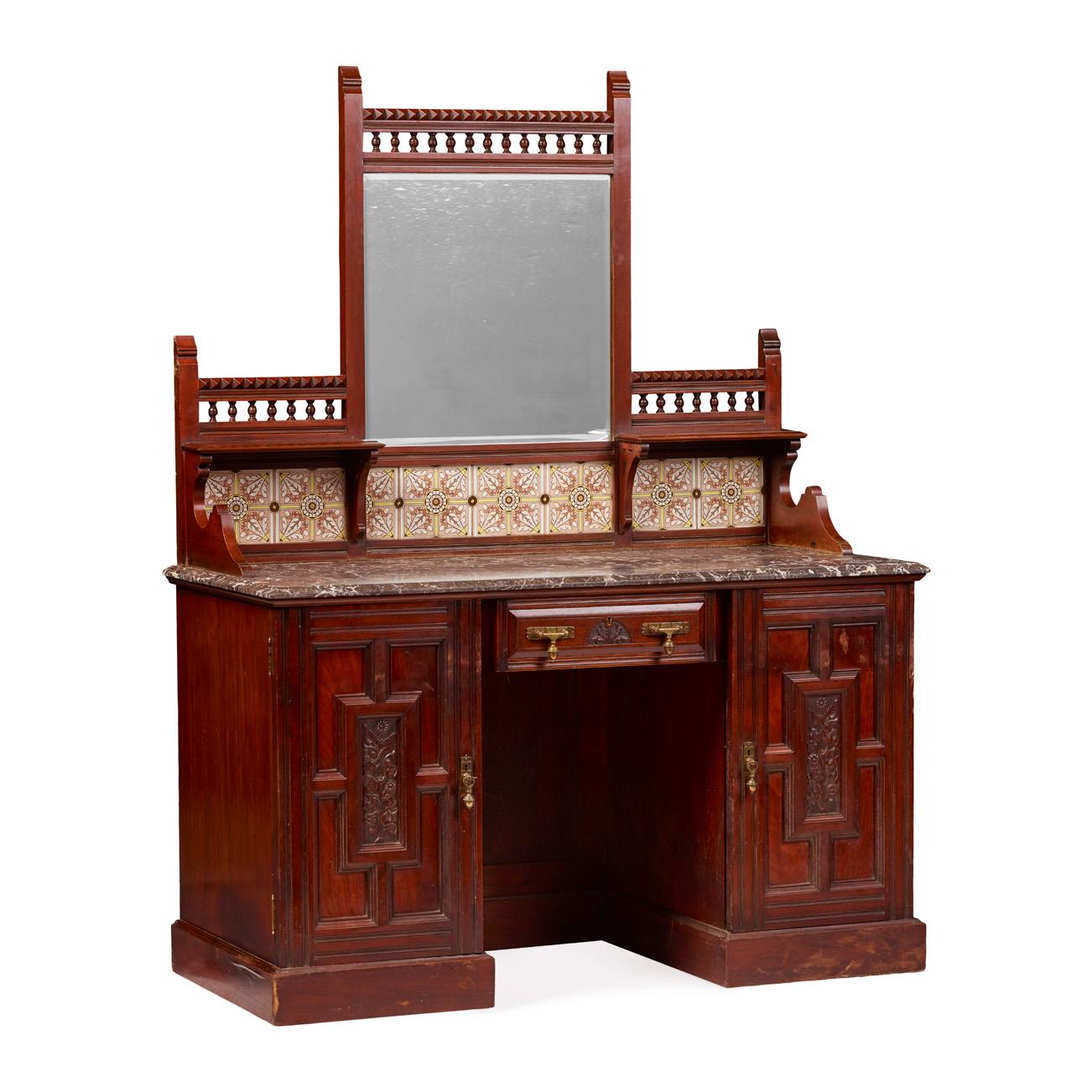
£1,000-1,500

149
413
EDWARDIAN MAHOGANY AND INLAY VITRINE TABLE
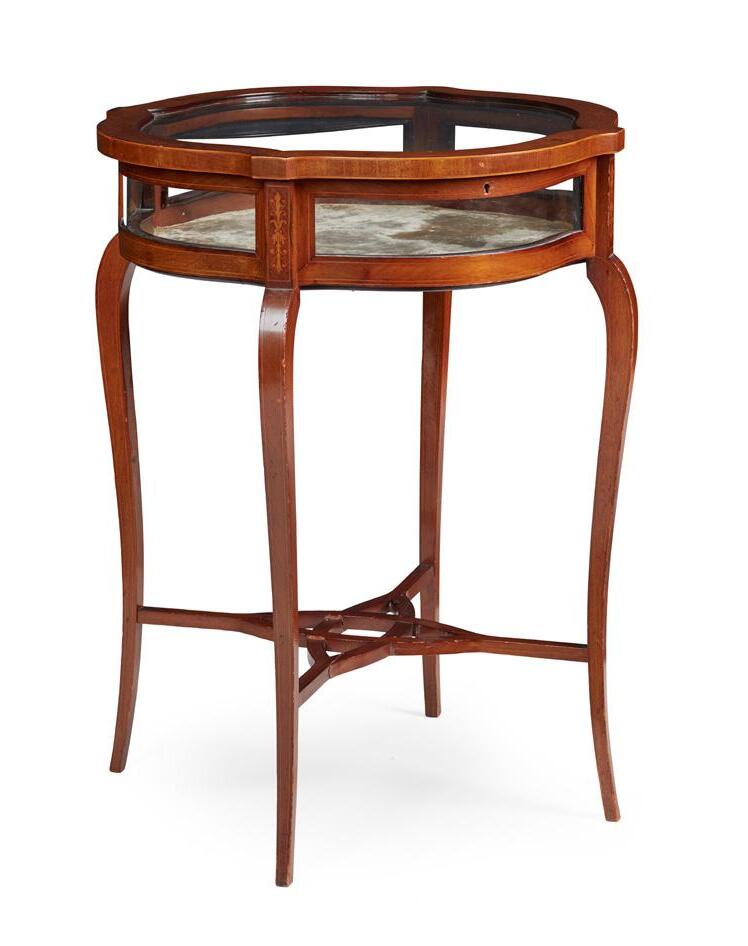
EARLY 20TH CENTURY
the shaped circular glazed top above conforming glazed sides, opening to a plush lined interior, raised on scrolled legs joined by a pierced X stretcher
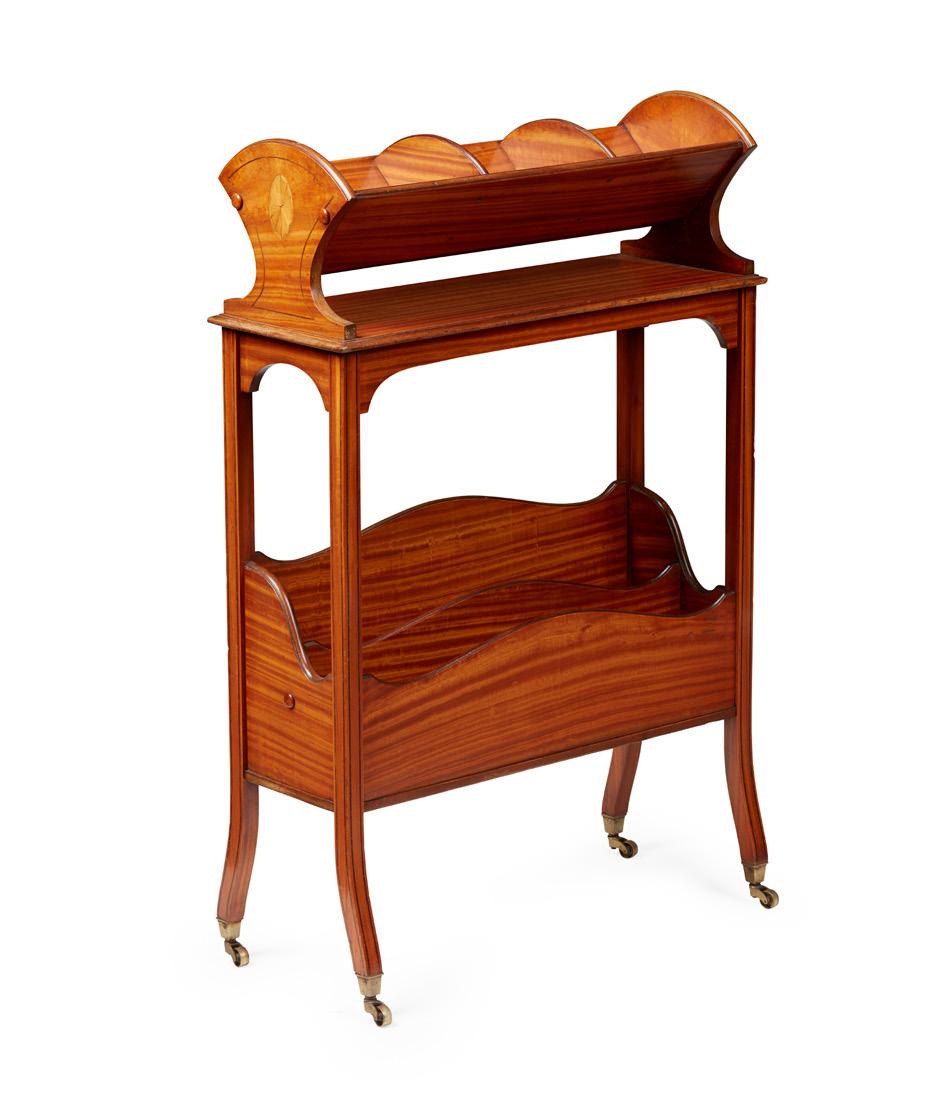
57cm diameter, 76cm high £300-500
414
EDWARDIAN SATINWOOD BOOK TROUGH
EARLY 20TH CENTURY
the top with three divisions, above a sectioned base, on slender square legs ending in brass caps and castors
56cm wide, 85cm high, 21cm deep
£400-600
415 Y
PAIR OF GEORGIAN STYLE SATINWOOD, ROSEWOOD, AND INLAID TEA TABLES OF RECENT MANUFACTURE
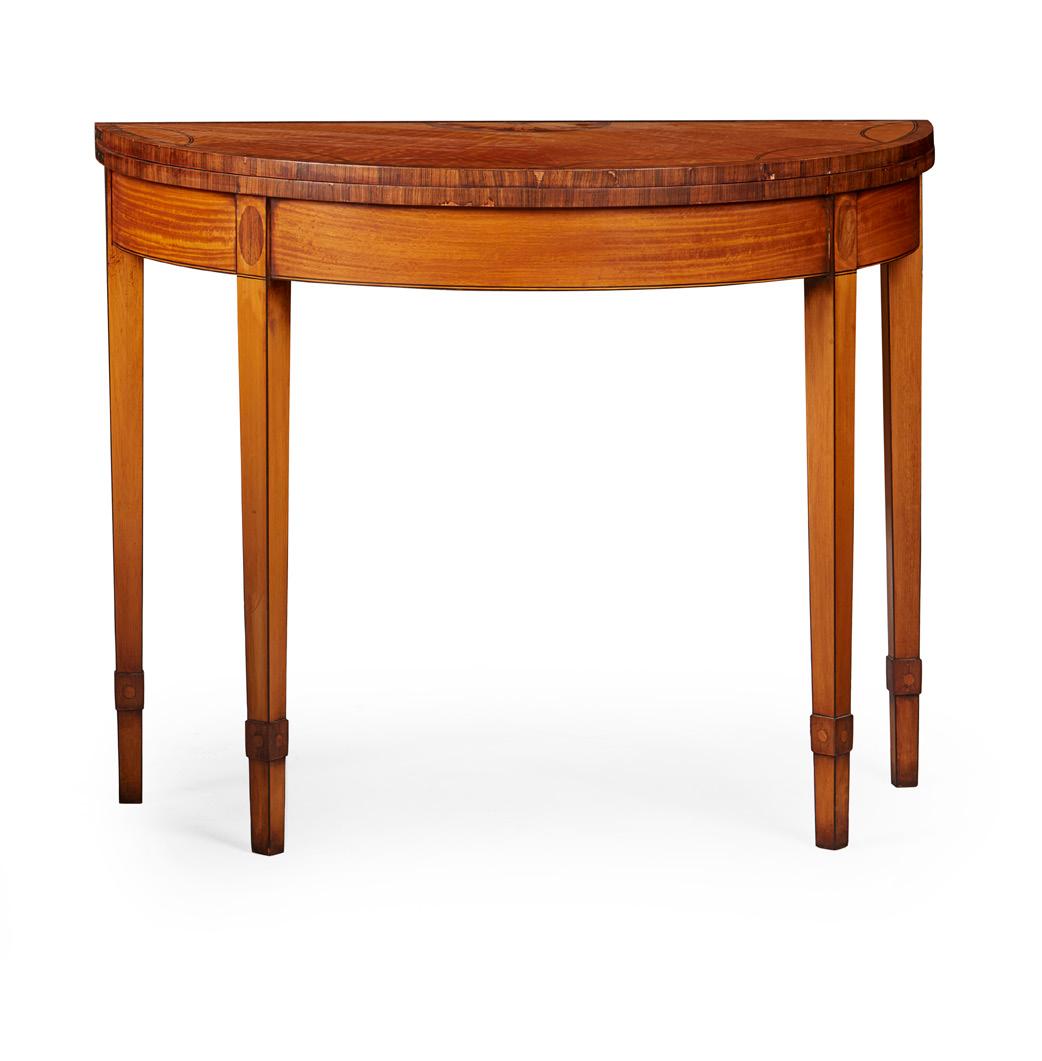

the crossbanded fold-over tops with foliate demi-paterae and fan line inlay, above plain friezes and raised on square tapered legs outlined with stringing, opening on double gatelegs (2)
91.5cm high, 74cm high, 46cm deep £1,500-2,500
150 Other fees apply in addition to the hammer price: see the ‘Buyer’s Guide’ section on page 2
416
EDWARDIAN SATINWOOD VITRINE TABLE
EARLY 20TH CENTURY
with ebonised stringing and kingwood banding, the hinged glazed rectangular top of plain form above glazed side panels and a maroon velvet lined interior, raised on tapering legs with spade feet


61cm wide, 71cm high, 38cm deep
£400-600
417
SHERATON STYLE PAINTED SATINWOOD AND MARQUETRY DISPLAY CABINET

LATE 19TH CENTURY
the moulded pediment above a pair of arched astragal doors opening to a plush lined interior with adjustable shelves, the base with two short drawers raised on square tapered legs, painted and inlaid with bows, flower scrolls and garlands

108cm wide, 195cm high, 35cm deep
£800-1,200
418
SHERATON REVIVAL SATINWOOD AND INLAY CARD TABLE
LATE 19TH CENTURY
the shaped demilune top crossbanded and inlaid with paterae and bell flower trails, opening to a green baize surface, the frieze with urn and swag motifs flanked by faux fluting, raised on square tapered legs with pendant husk trails and ending on spade feet, with a secret drawer to the reverse
91wide, 78cm high, 47cm deep
£500-700
151
419
PAIR OF EDWARDIAN MAHOGANY VITRINE TABLES
EARLY 20TH CENTURY
the moulded and hinged rectangular tops with glass panels and sides opening to a red plush lined interior, raised on square tapered legs (2)
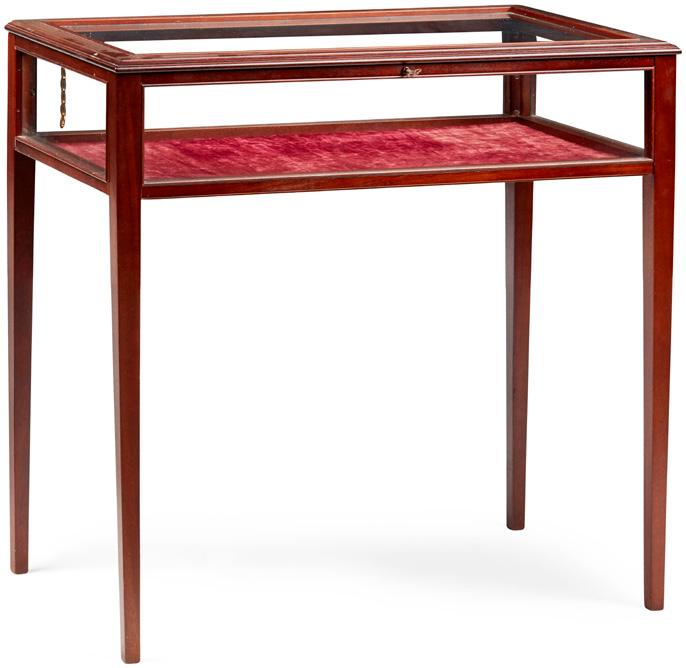

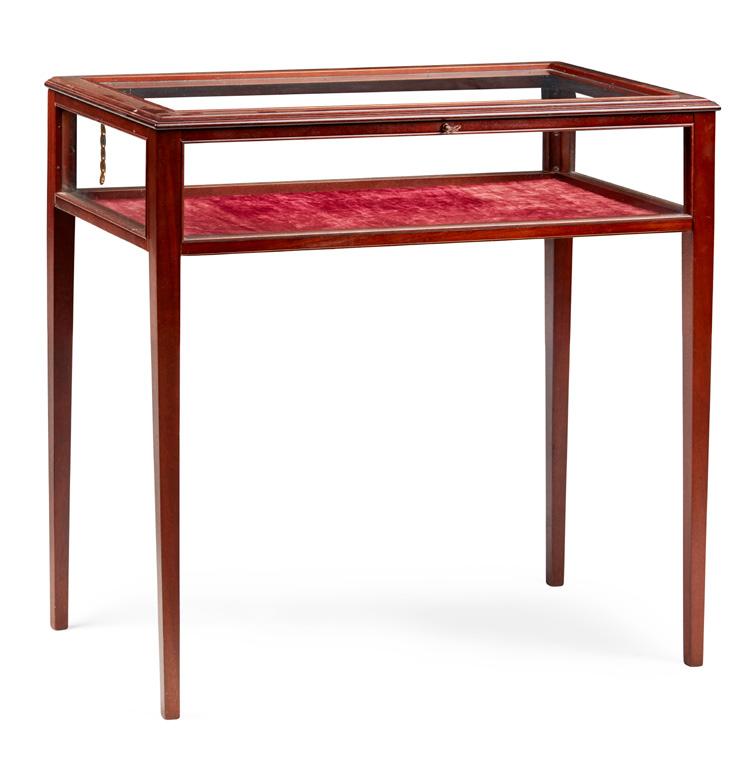
76cm wide, 74cm high, 42cm deep £600-800
421
PAIR OF KNOLE STYLE
THREE SEAT SOFAS MODERN
with low two cushion backs and seats flanked by drop sides, in terracotta and gold foliate upholstery, raised on square tapered legs with brass caps and castors on the forelegs; each with a complement of matching scatter cushions (2)
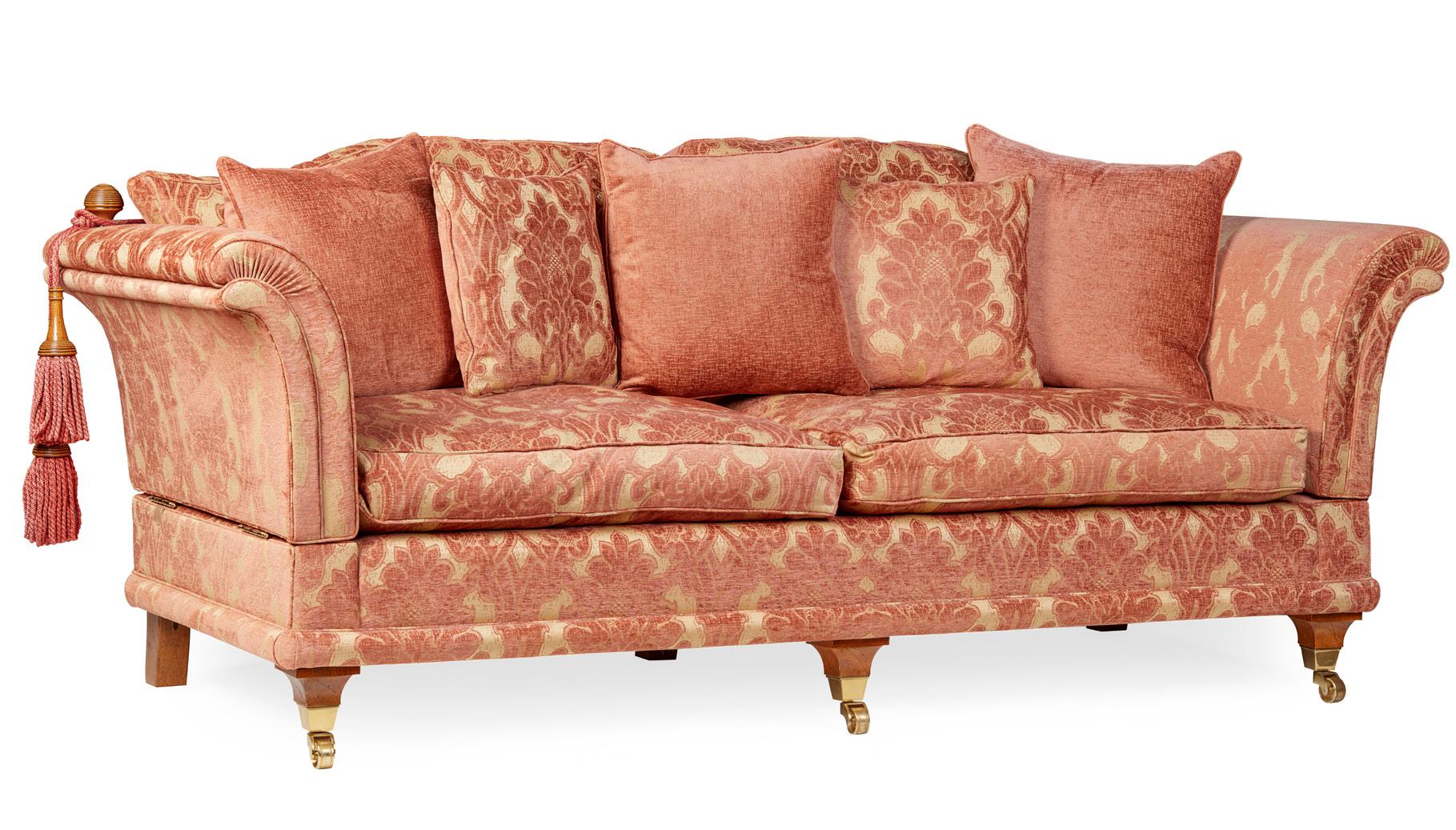
228cm wide, 85cm high, 72cm deep £1,500-2,500
420
LATE VICTORIAN MAHOGANY AND SATINWOOD MARQUETRY DISPLAY CABINET
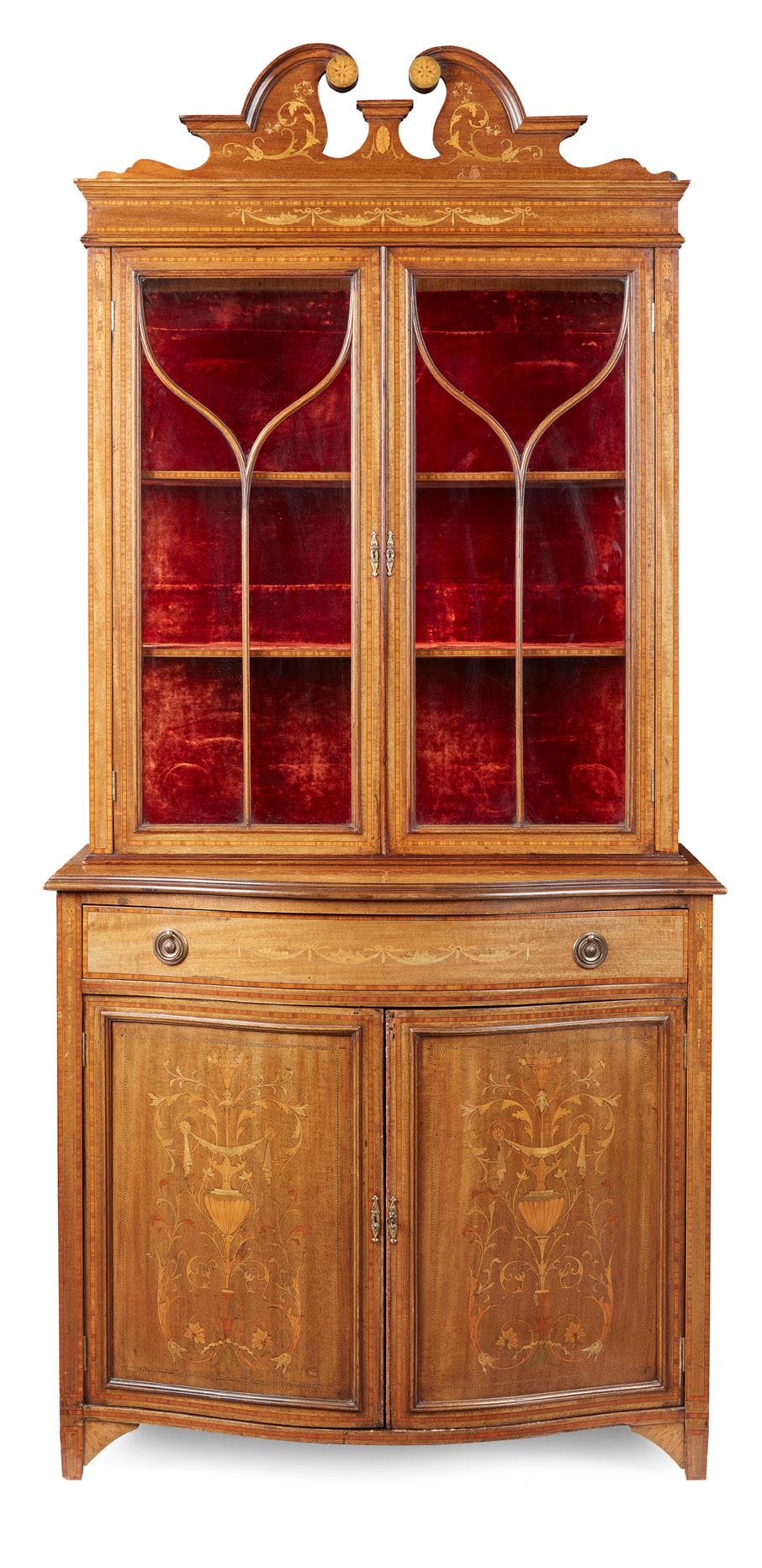
LATE 19TH CENTURY
in the Sheraton style, the upper part with a swan neck pediment above a pair of glazed astragal doors enclosing red plush-lined shelves; the base of serpentine outline with a long frieze drawer above a pair of cupboard doors with urn and foliate scroll inlay with, raised on bracket feet 103cm wide, 218cm high, 50cm deep £800-1,200
152
422
GROUP OF THREE FLORAL DÉCOUPAGE TABLE LAMPS

LATE 20TH CENTURY
possibly Vaughan Designs of Chelsea, to include a large shouldered vase and a pair of baluster vases, all with applied printed tulip designs and gilt metal mounts, with cream pleated shades (3)
Larger 47cm high, 25cm in diameter
£300-500
423
PAIR OF GEORGIAN STYLE YEW AND MAHOGANY DEMILUNE TABLES

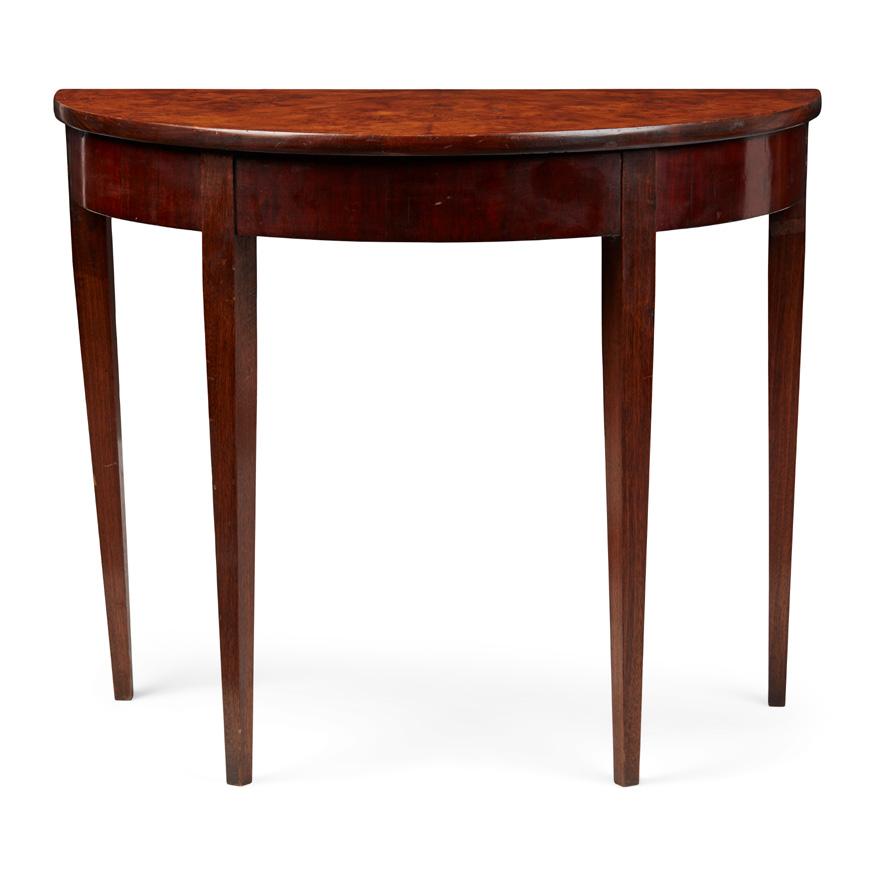
LATE 19TH CENTURY WITH ALTERATIONS
the radial veneered tops above plain friezes, raised on square tapered legs (2) 91cm wide, 75cm high, 46cm deep
£600-800
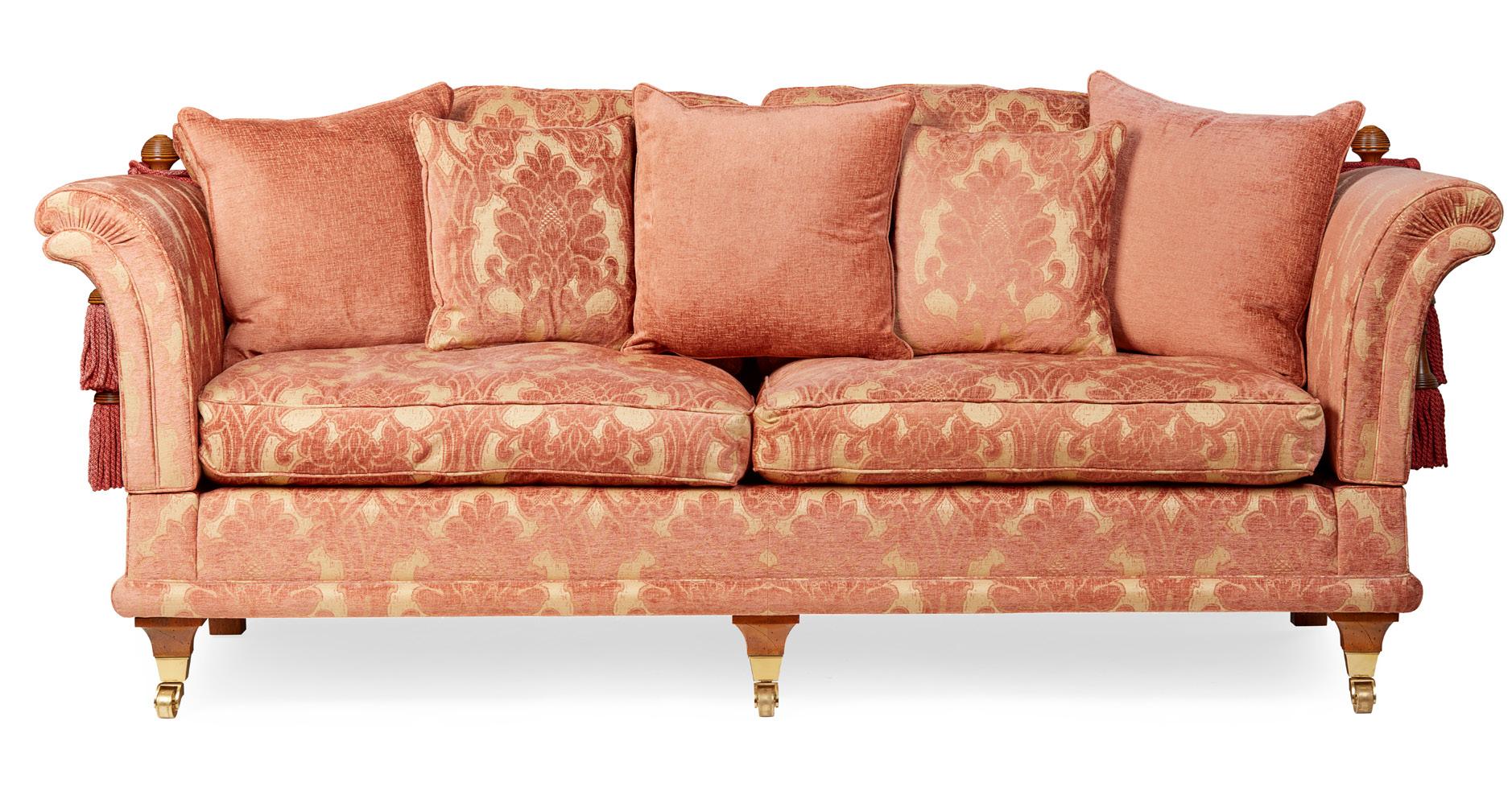
153 Other fees apply in addition to the hammer price: see the ‘Buyer’s Guide’ section on page 2
424
GEORGIAN STYLE MAHOGANY BREAKFRONT BOOKCASE
LATE 19TH/ EARLY 20TH CENTURY
the moulded cornice above astragal glazed doors enclosing shelves, the lower part with a pair of panel doors flanked by further doors, enclosing a shelved interior, on a conforming plinth base 205cm wide, 219cm high, 46cm deep
£2,000-3,000
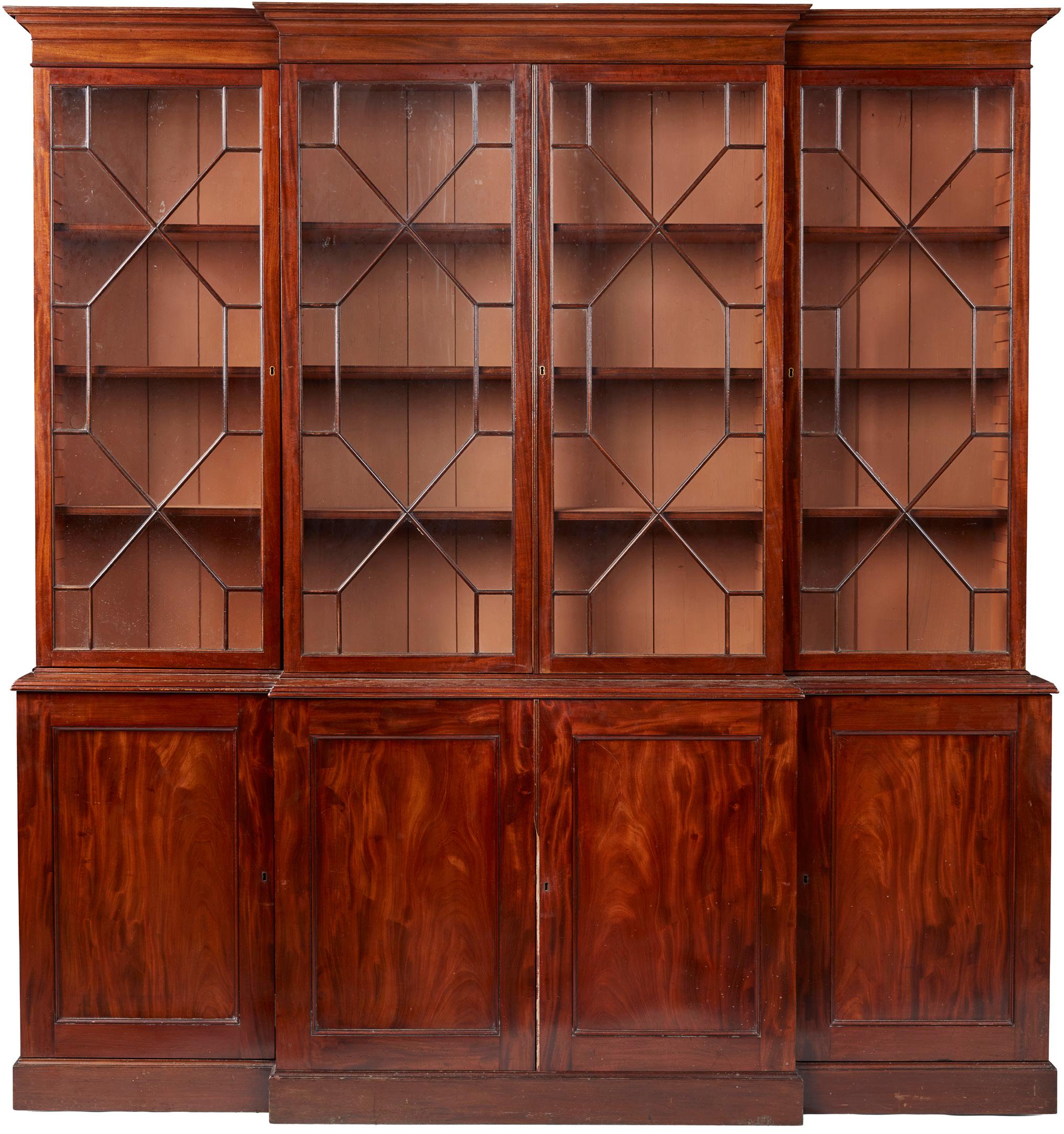
154 Other fees apply in addition to the hammer price: see the ‘Buyer’s Guide’ section on page 2
425
PAIR OF GEORGE III STYLE URN STANDS
LATE 19TH CENTURY/ EARLY 20TH CENTURY
the oval tops with a cockbead moulded border, with a cup slide to the wavy friezes, raised on slender square tapered legs ending in delicate spade feet (2)
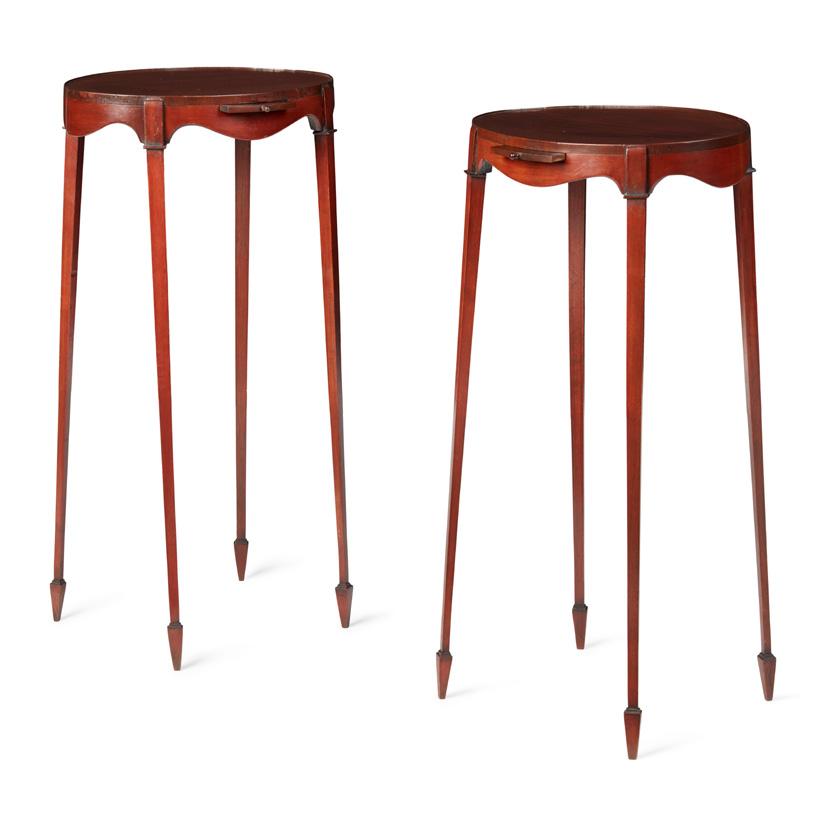
37cm wide, 73cm high, 28cm deep
£1,000-1,500
426
PATINATED BRONZE STANDARD LAMP
20TH CENTURY
in the neoclassical style, the fluted column on a tripod base with anthemions and claw feet, wired for electricity

156cm high, excluding fitting
£300-500
427
PAIR OF CHINESE FAMILLE JAUNE
PORCELAIN LAMPS
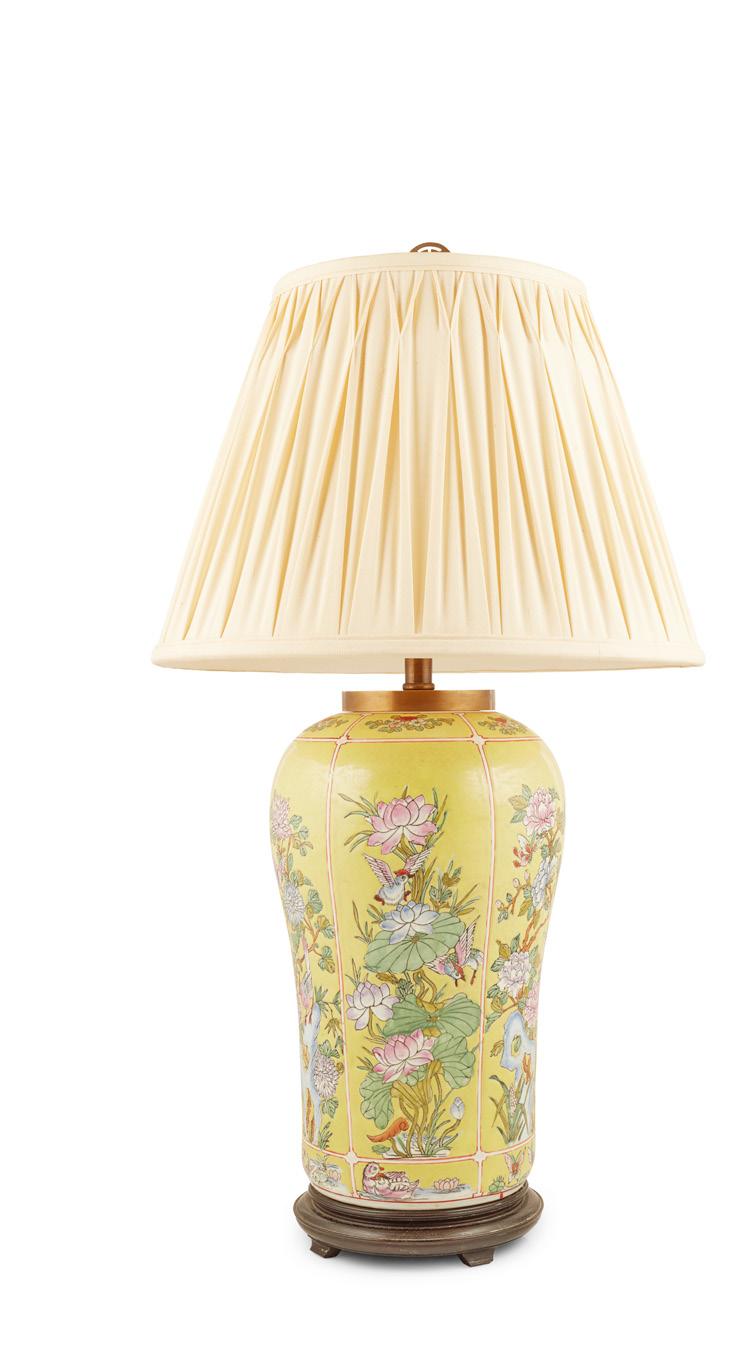
20TH CENTURY
the high shouldered vases with panelled decoration of birds and fish in a rock garden, on Chinese style wooden stands and brass mounts, with shou symbol finials and cream pinch-pleated shades; retailed by Whytock & Reid (2) 92cm high including fittings, shades 50cm diameter
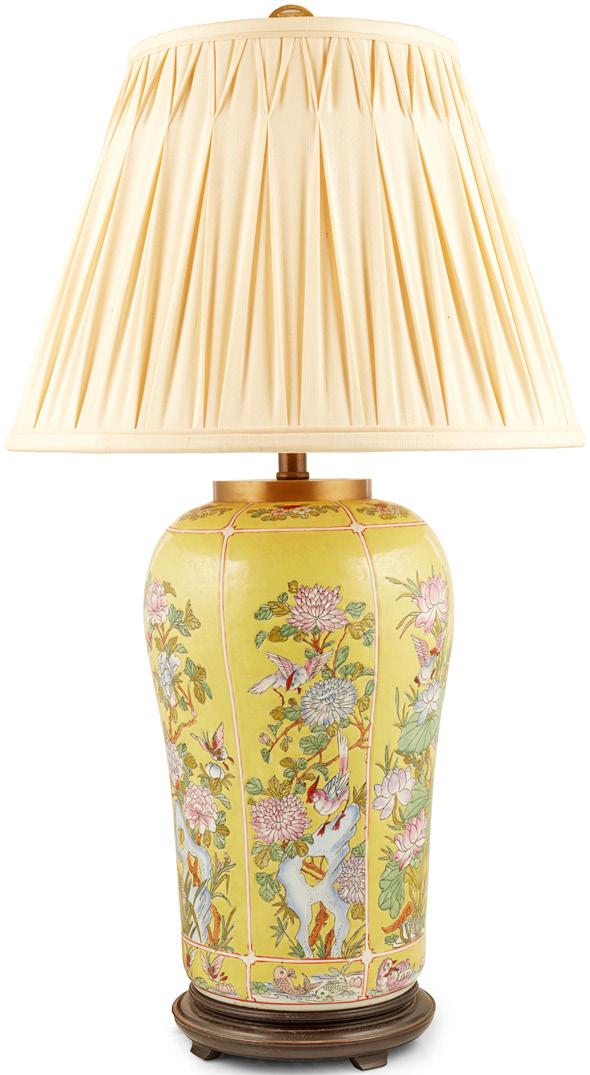
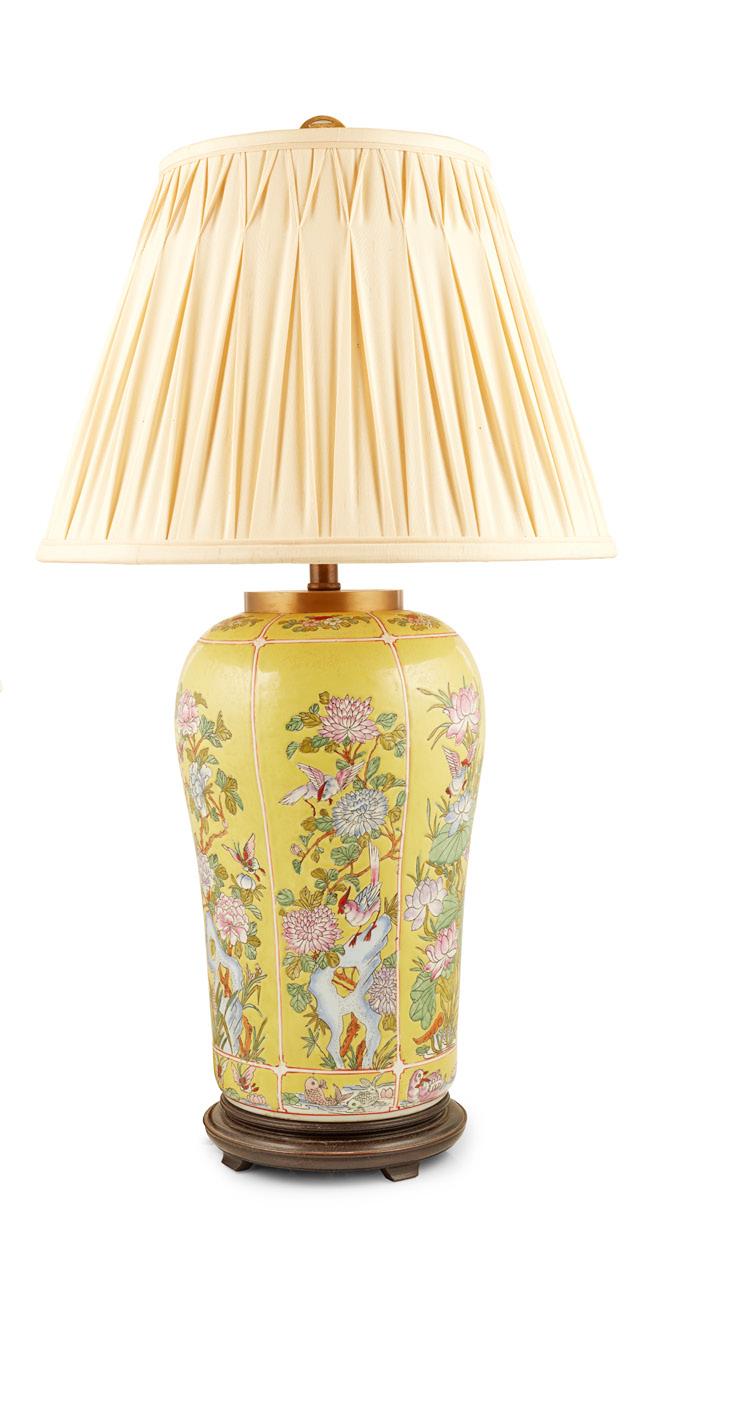
£400-600
428
STAINED OAK AND BRASS HUMIDOR ON STAND 19TH CENTURY, LATER ADAPTED
converted from a gun case, with brass handles and corner braces, opening to a refitted interior with a compartmented lift-out tray for cigars, on a late moulded mahogany stand with square straight legs 89cm wide, 64cm high, 33cm deep
£1,200-1,800
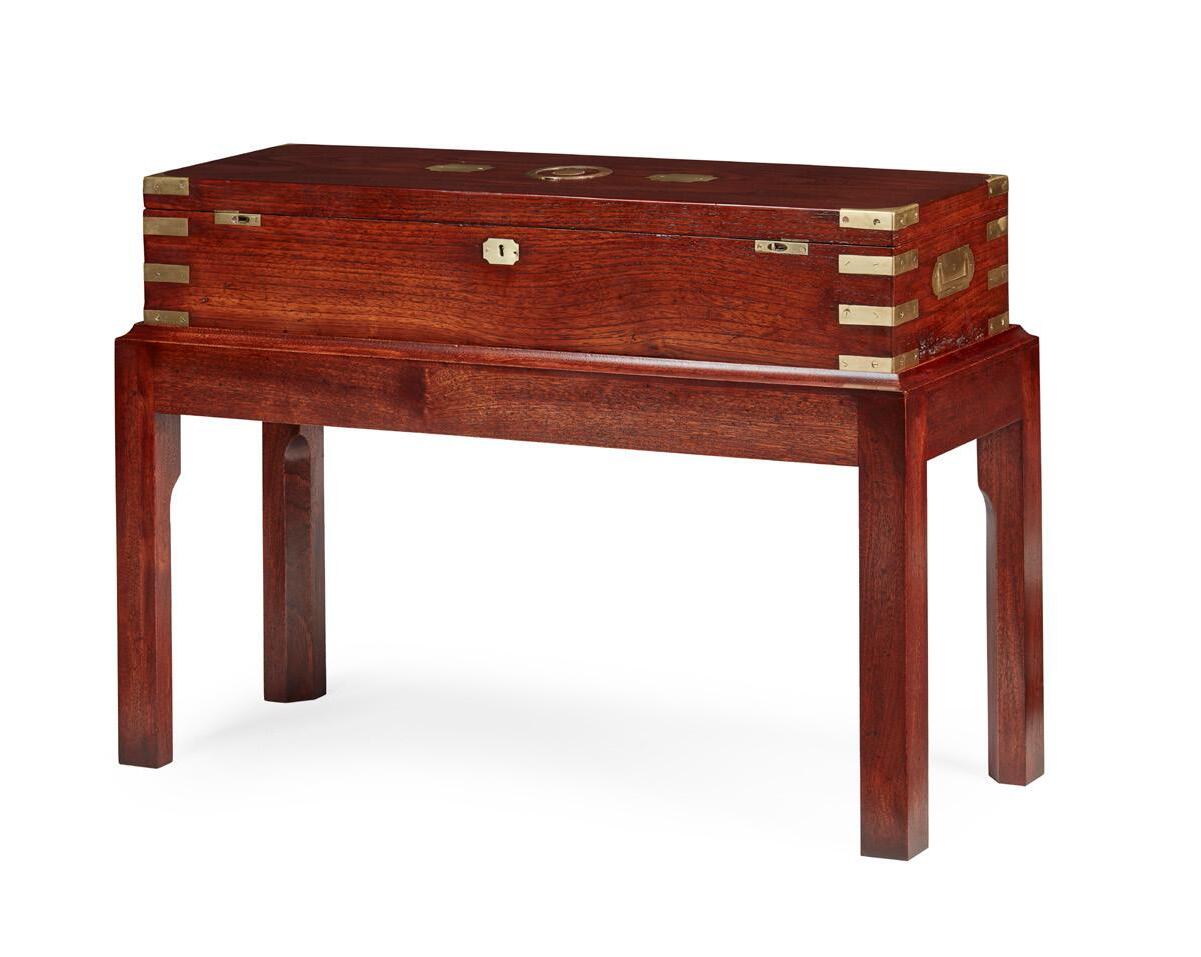
155
431
GEORGIAN STYLE MAHOGANY EXTENDING DINING TABLE
20TH CENTURY
the extending rounded rectangular top with a leaf carved edge, raised on carved cabriole legs ending in claw and ball feet, with two leaf inserts 244cm long (extended), 72cm high, 124cm deep
£250-350
429
PAIR OF GEORGIAN STYLE MAHOGANY

ARMCHAIRS, BY WHYTOCK & REID

20TH CENTURY
the square backs over a pierced and interlaced splat and concave stuffover seats, flanked by open arms, raised on moulded and beaded square legs joined by H-stretchers (2)
62cm wide, 88cm high, 50cm deep
£300-500
430
PAIR OF GEORGIAN STYLE MAHOGANY SERPENTINE PRESS COMMODES, BY HOWARD & SONS
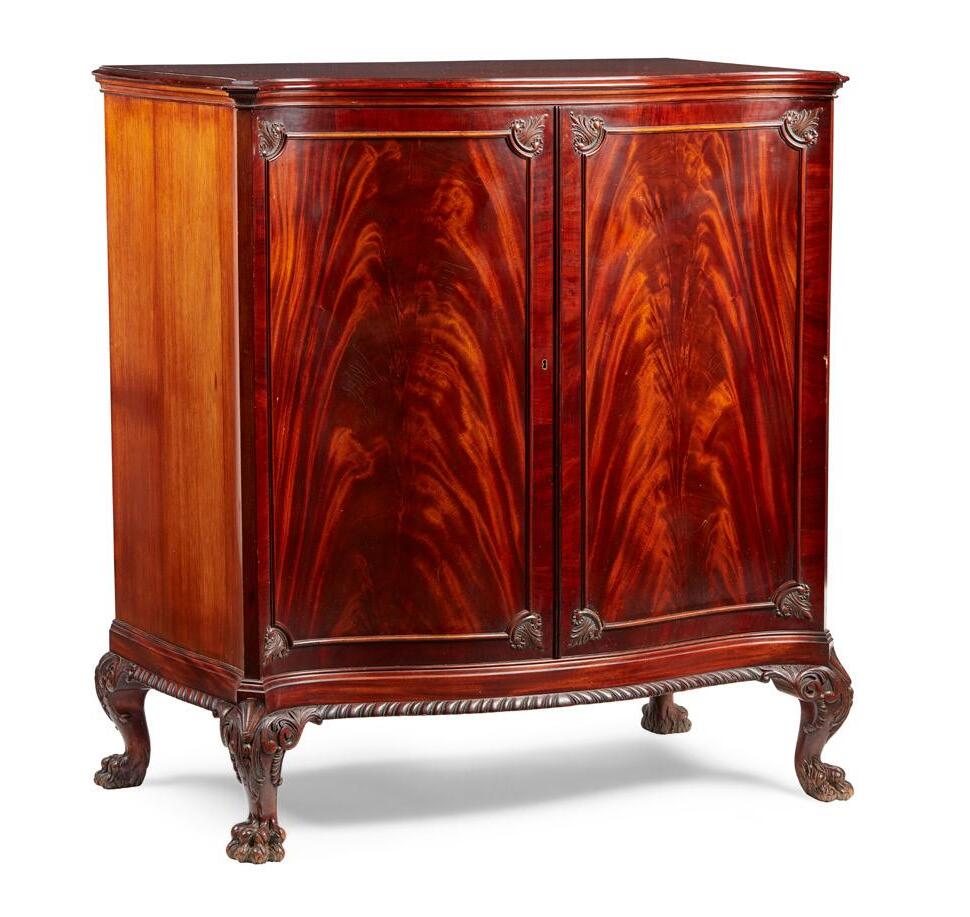
EARLY 20TH CENTURY
the serpentine tops with moulded edges above pairs of moulded doors marked at the corners with leaf carvings, opening to green baize lined interiors with sliding trays, on gadrooned bases raised on shellcarved cabriole legs ending in hairy paw feet, bearing ivorine labels
‘HOWARD & SONS LTD 25, 26, 27, BERNERS ST., LONDON. W.’ (2)
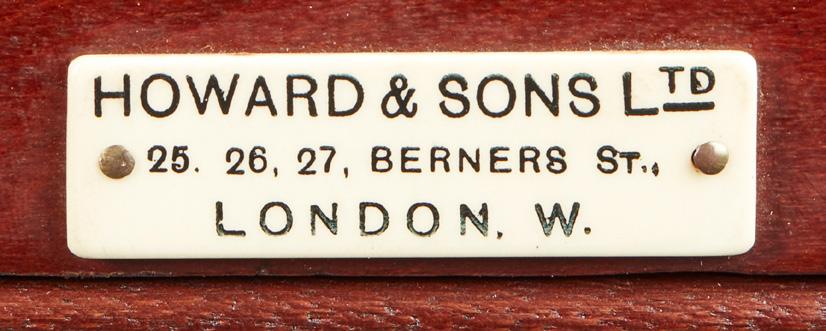
112cm wide, 122cm high, 62cm deep
£800-1,200
156 Other fees apply in addition to the hammer price: see the ‘Buyer’s Guide’ section on page 2
433
PAIR OF IRISH GEORGIAN STYLE MAHOGANY SIDE TABLES, IN THE MANNER OF HICKS OF DUBLIN RECENT MANUFACTURE
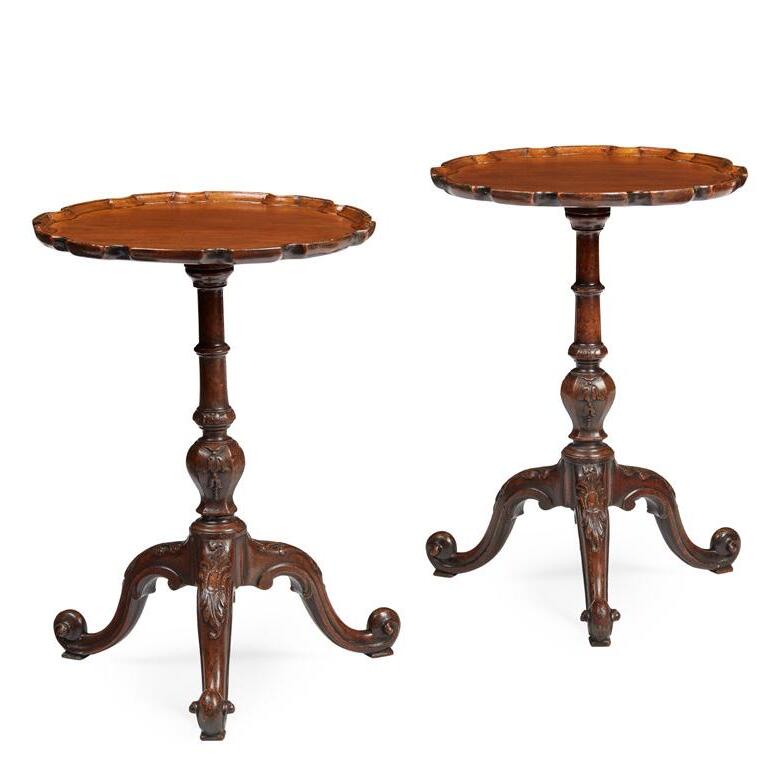
the rectangular tops with a moulded edge above an acanthus carved frieze centred by large shells, raised on acanthus carved cabriole legs ending in carved hairy paw feet (2)
106cm wide, 85cm high, 58cm deep
£1,800-2,200
432
PAIR OF GEORGE III STYLE MAHOGANY WINE TABLES


LATE 19TH CENTURY
the circular top with a moulded pie crust edge on a turned column with a foliate carved baluster stem, on acanthus carved cabriole legs ending in scroll feet (2) 42cm in diameter, 59cm high £800-1,200
434
VICTORIAN PAINTED LEATHER DEMILUNE COACH TRUNK ON STAND, OF HUNTING INTEREST
LATE 19TH CENTURY, THE STAND AND DECORATION EARLY 20TH CENTURY
with a hinged top and brass nail head trim, the entire surface painted with a continuous hunting scenes with dogs, equestrian figures, and a stag in a hilly landscape, opening to a void interior with ticking lining; on a later mahogany stand raised on cabriole legs carved with shells and acanthus and ending in claw and ball feet
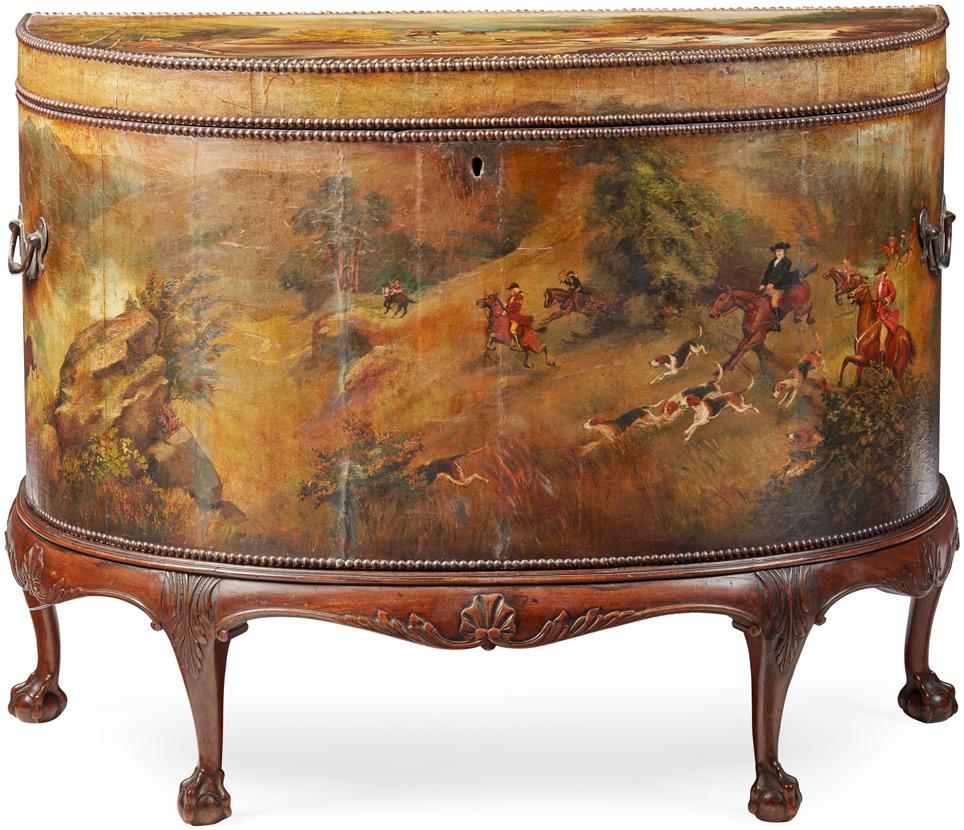

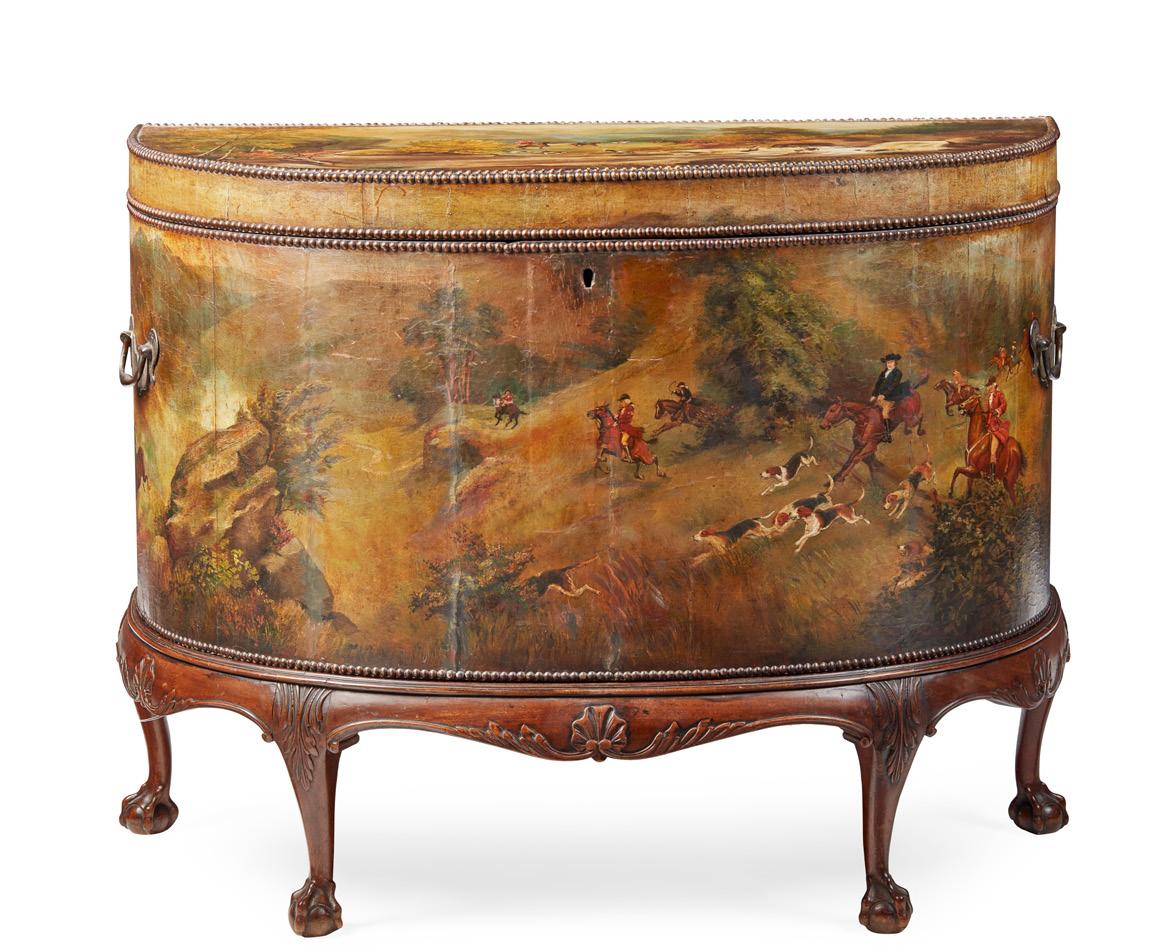
120cm wide, 92cm high, 55cm deep
£3,000-5,000
157
435
ENAMELLED GLASS LEMONADE SET, OF HUNTING INTEREST 20TH CENTURY
to include a pitcher and six footed glasses, printed and enamelled with equestrian hunting scenes, with an associated chromium and teak mirrored tray with a printed hunting scene to match, stamped REGENT PRODUCTS (8)
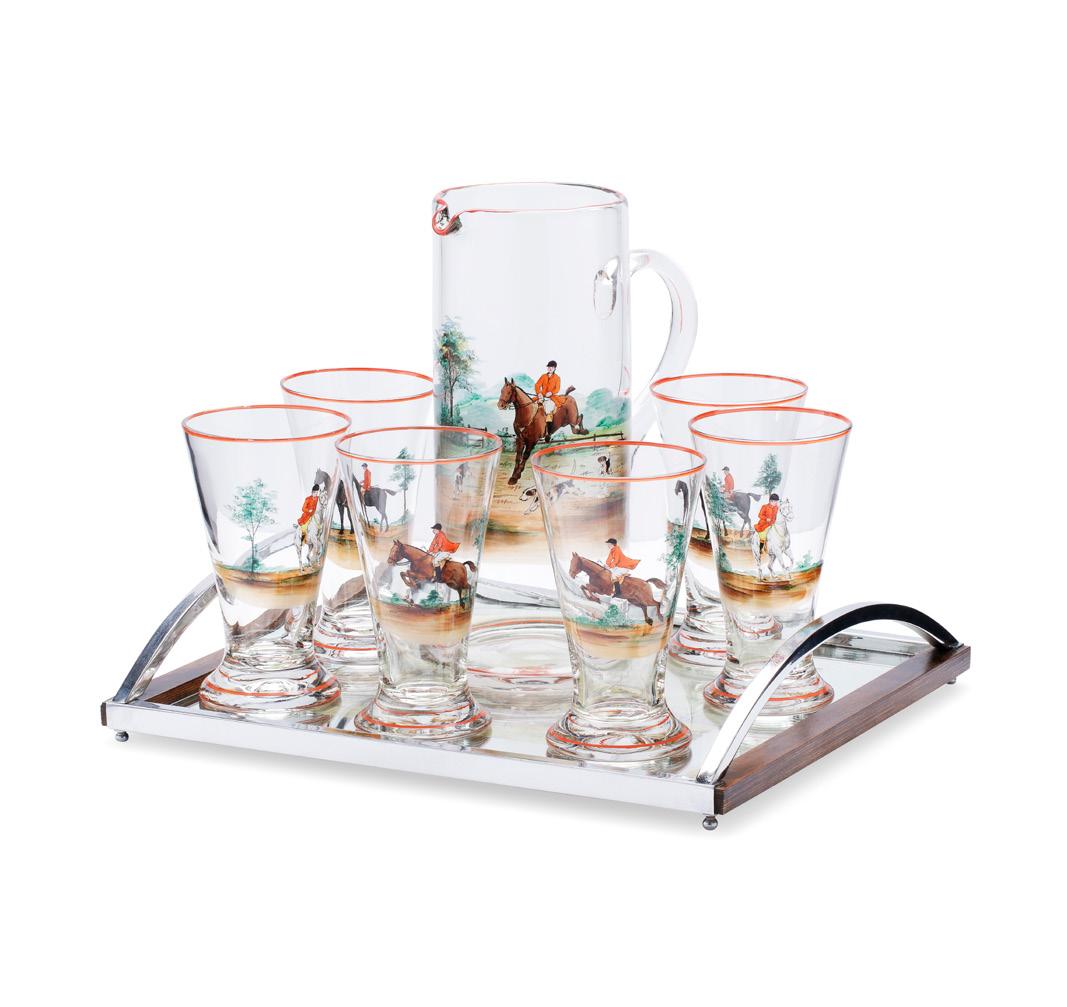
tray 37cm wide, pitcher 30cm high
£600-800
436
EDWARDIAN MAHOGANY AND NICKEL-PLATED FOLDING CAMPAIGN DESK
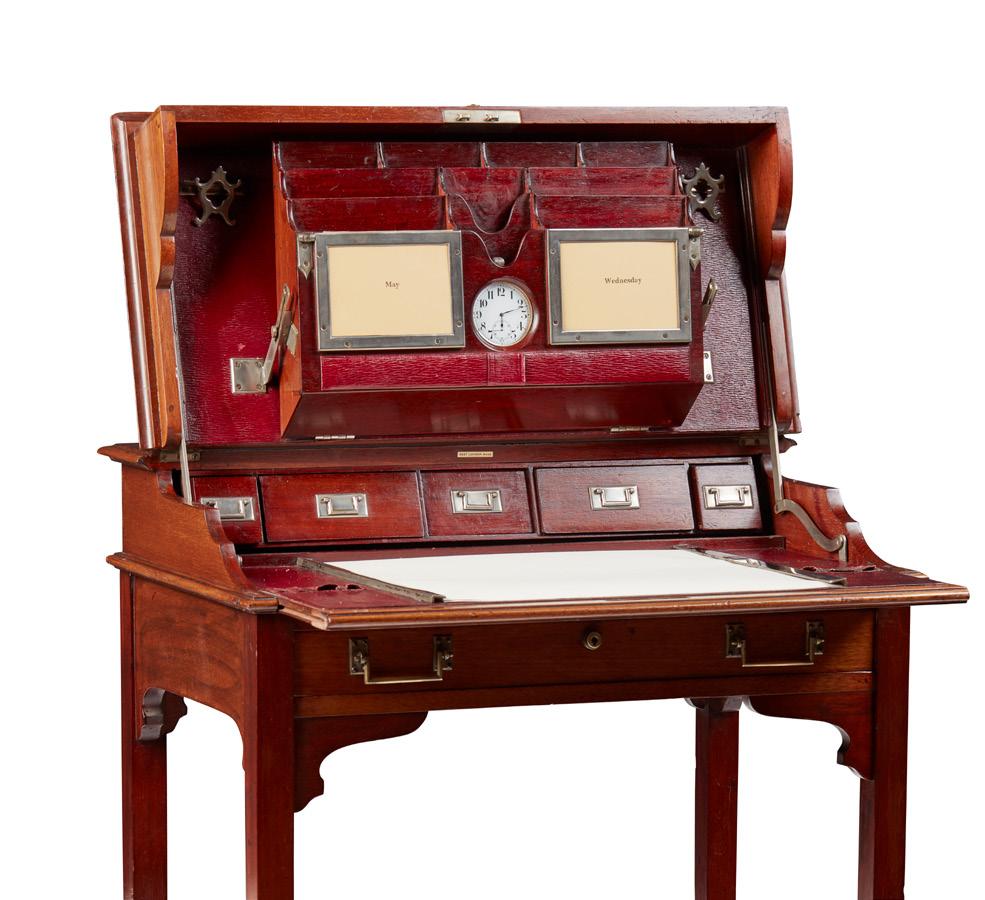

EARLY 20TH CENTURY
the plain hinged top opening to a projecting leather-covered writing surface and small drawers, with a stationery rack, clips, calendar and desk watch holder above, raised on splayed supports joined by curved stretchers, bearing an ivorine label marked ‘Best London Make’
65cm wide, 82cm high, 44cm deep
£2,000-3,000
437
JUPE STYLE MAHOGANY EXTENDING DINING TABLE MODERN

the circular top extending to include five peripheral leaves and a separate central lazy Susan, on four turned column supports raised on outswept legs ending brass caps and castors; with an accompanying fitted leaf holder
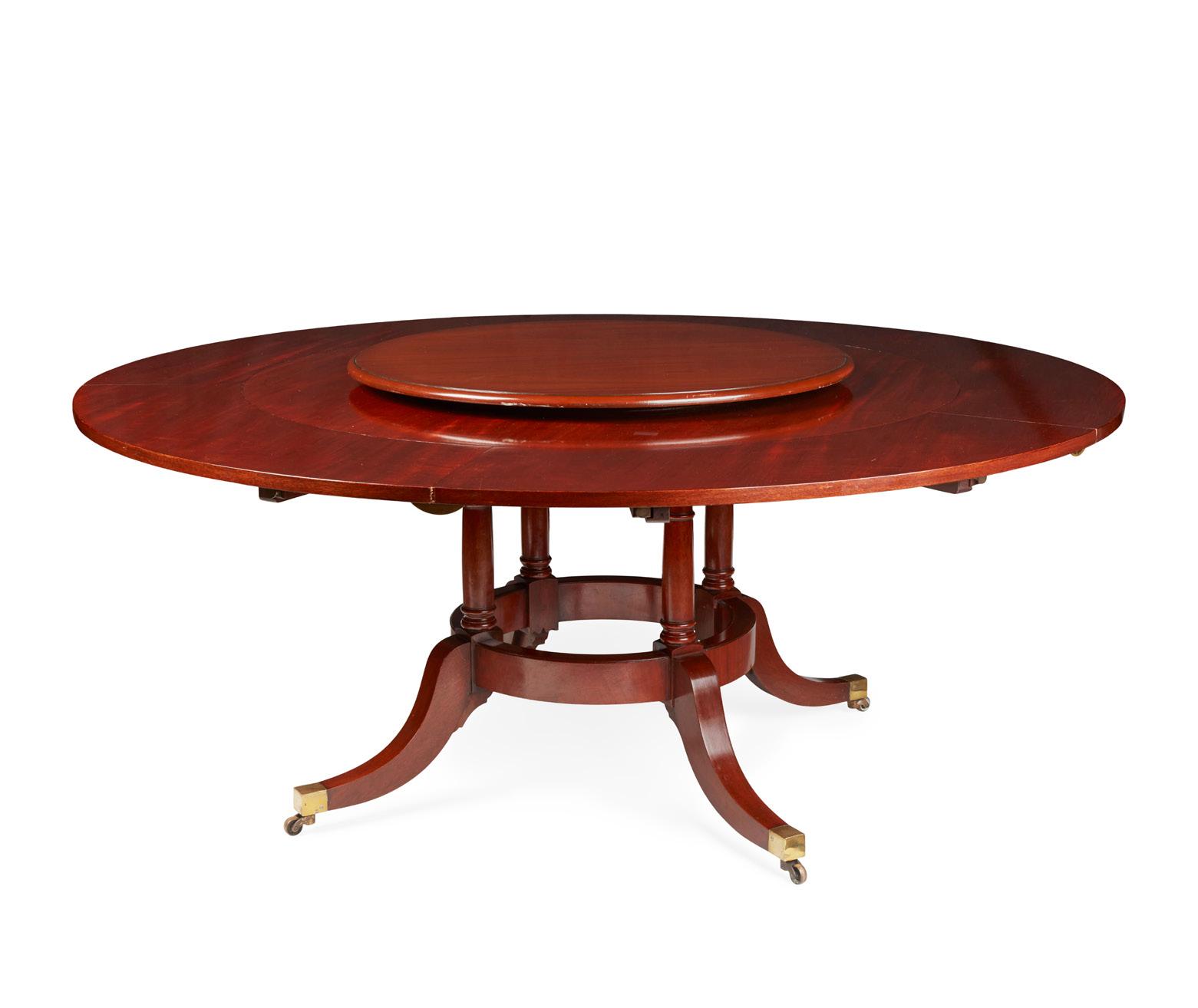
183cm diameter 127 [smallest diameter], 74cm high
£800-1,200
158 Other fees apply in addition to the hammer price: see the ‘Buyer’s Guide’ section on page 2
438

LATE VICTORIAN SILVER-PLATED TANTALUS, BY GEORGE WISH OF SHEFFIELD
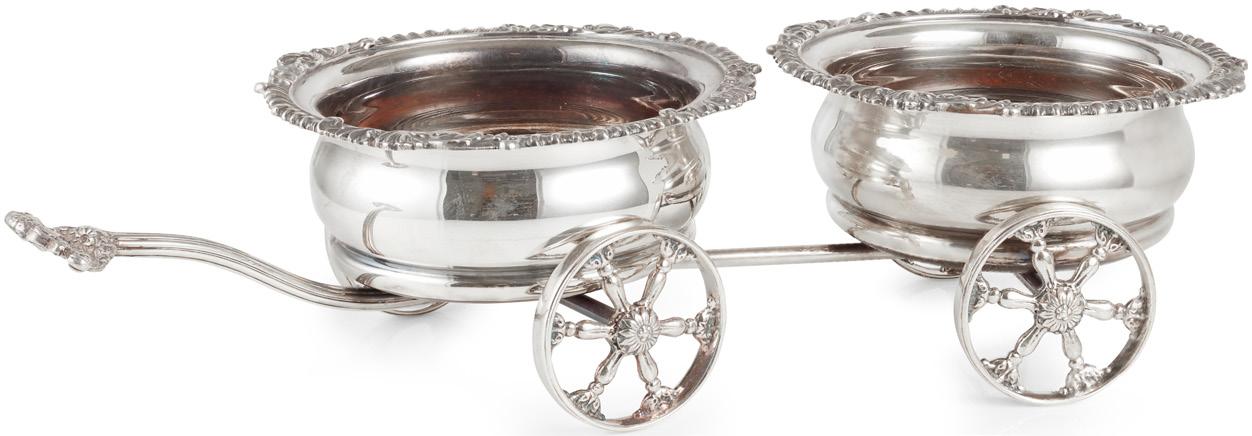
LATE 19TH CENTURY
of rounded rectangular form with an engraved lid and pierced body with repeating rosettes, the sides with ring handles, raised on bun feet, the base with a maker’s stamp, fitted with three square section glass decanters with faceted stoppers 30cm long, 26cm high, 10cm deep £500-700
439
THREE SILVER MOUNTED DECANTERS AND DRINKS TRAY


20TH CENTURY
including a square plain decanter with facetted stopper and silver collar, hallmarked Birmingham 1933, Goldsmiths & Silversmiths Co Ltd; an American bottle decanter with pierced silver grill overlay and shield stamped ‘Sterling’; and a facet moulded bottle decanter with silver collar engraved ‘Whisky’, hallmarked Birmingham 1907, Norton & White; and an associated Art Deco chromium mirrored tray mounted with demilune handles (4) the tray 42cm wide, 7cm high, 32cm deep £1,000-1,500
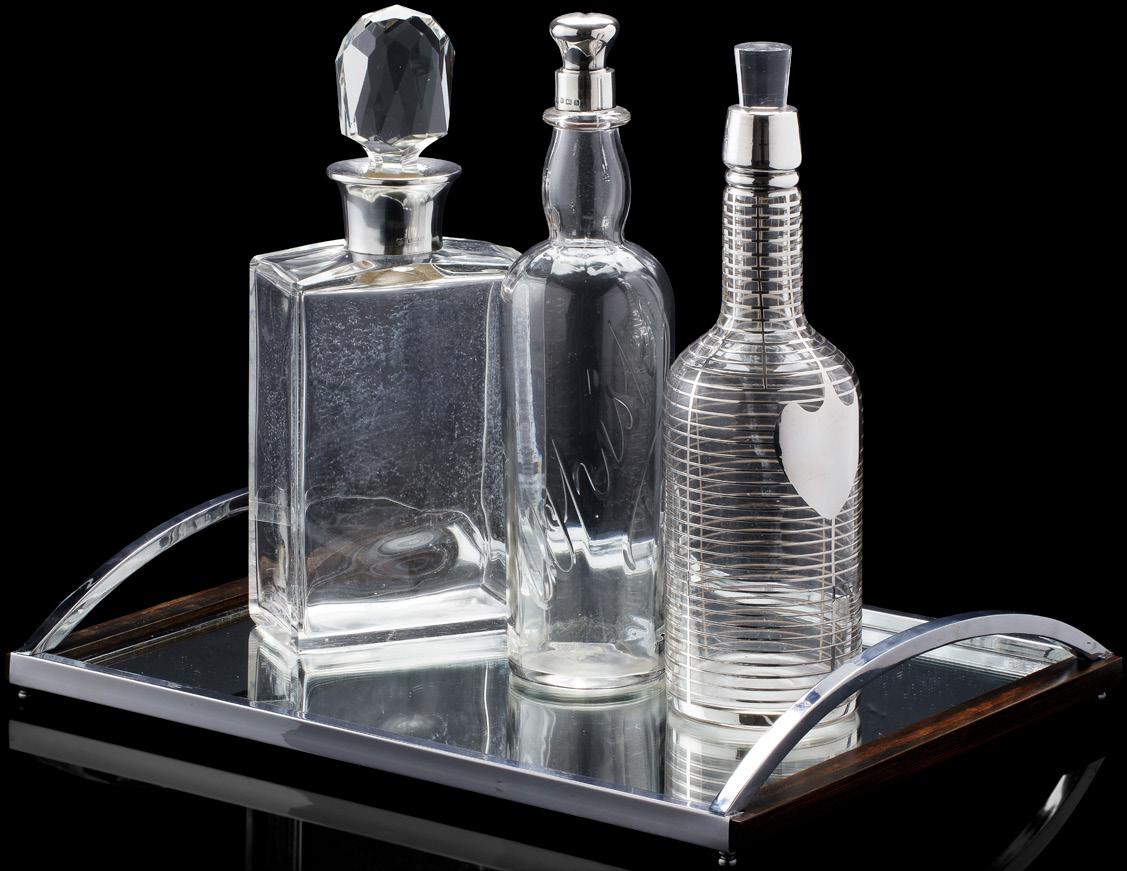
440 SILVER-PLATED DOUBLE WINE COASTER CARRIAGE, BY ISRAEL FREEMAN & SON, SHEFFIELD

EARLY 20TH CENTURY
in the Georgian style with two wine coasters with gadrooned shell rims and turned mahogany bases, mounted on an articulated carriage with large cast wheels, maker’s stamp 44cm long, 11cm high, 17cm deep £300-400
441
SUITE OF ROWLAND WARD GLASS
SECOND HALF 20TH CENTURY engraved with various birds and animals including foxes, pheasants, grouse, hares, stags, etc. in naturalistic settings; comprising eight flutes, eight tumblers, a pitcher, and two decanters of mallet form with faceted necks and stoppers (19) decanters 28cm high £400-600

159
442
EDWARDIAN MAHOGANY BANDED VITRINE TABLE

EARLY 20TH CENTURY
with a hinged rectangular top with a bevelled glass and side panels, raised on line inlaid square tapered legs ending in spade feet and joined by an X stretcher centred by a circular platform
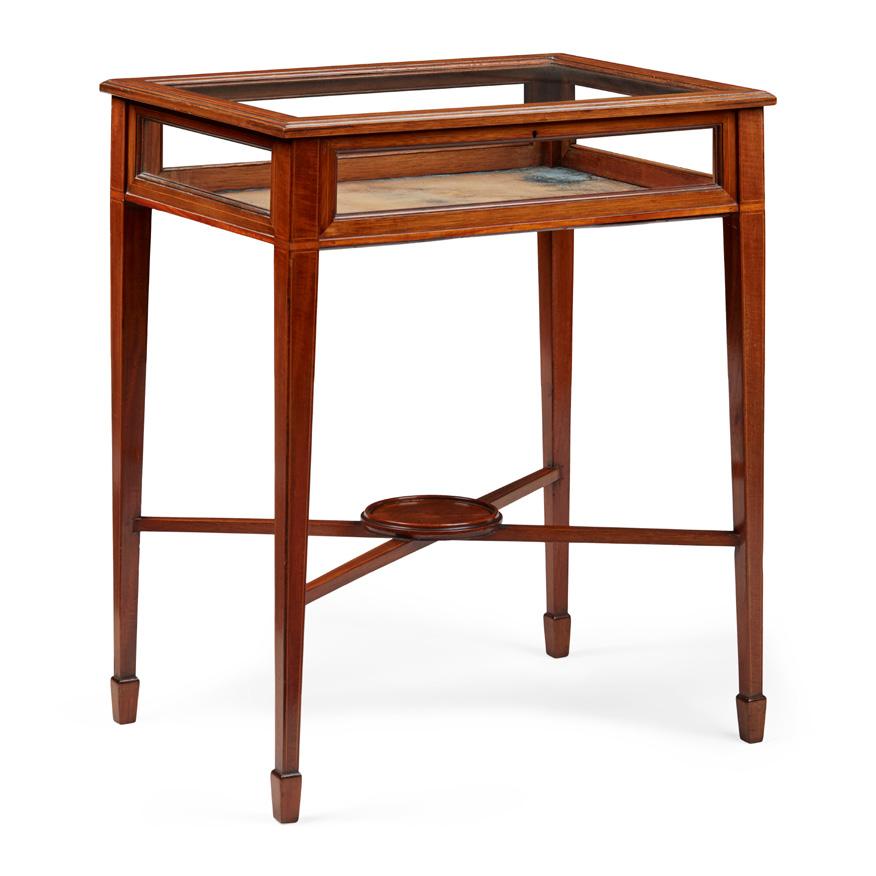
61cm wide, 74cm high, 43cm deep
£300-500
443
PAIR OF GEORGIAN STYLE MAHOGANY DISPLAY CASES, IN THE MANNER ROBERT ADAM

LATE 19TH CENTURY
the moulded cornices above friezes carved with anthemion and foliate scrolls, above glazed doors and side lights enclosing shelves and blue silk lined backs; the bases with Vitruvian scroll and bead moulding above doors with carved urns and anthemions, on fluted plinth bases (2) 55cm wide, 222cm high, 40cm deep
£2,000-3,000
444
PAIR OF MAHOGANY BEDSIDE CHESTS
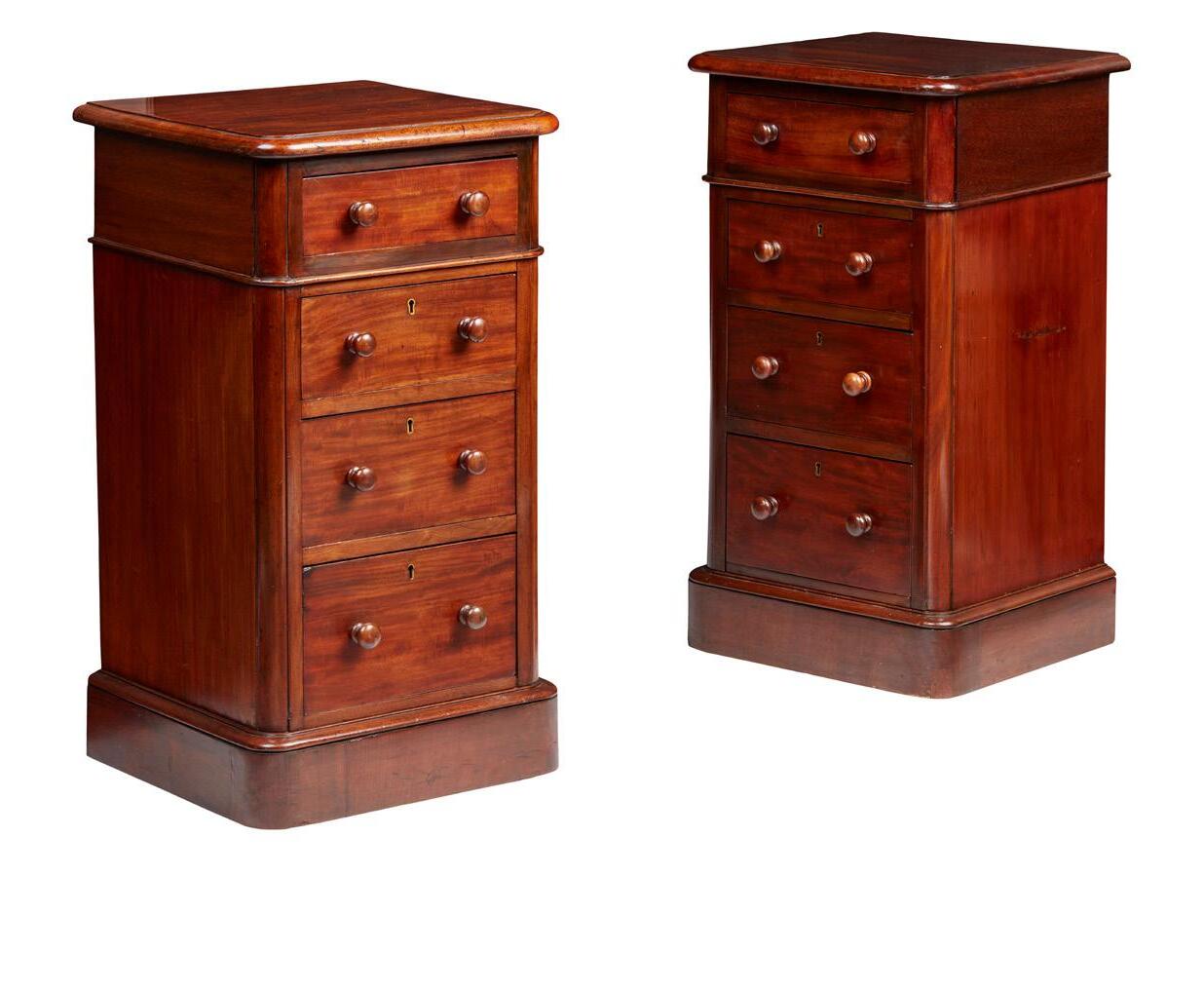
19TH CENTURY WITH LATER ADAPTATIONS
the tops with moulded edges above four graduated drawers with turned knob handles, on moulded plinth bases (2)
40cm wide, 74cm high, 39cm deep
£1,000-1,500
160
445
EARLY ROYAL AUTOMOBILE CLUB FULL MEMBER’S CAR BADGE BY ELKINGTON & CO. LTD.
CIRCA 1910-1912
brass with enamel union jack badge and copper king’s head medallion on the reverse, issue number
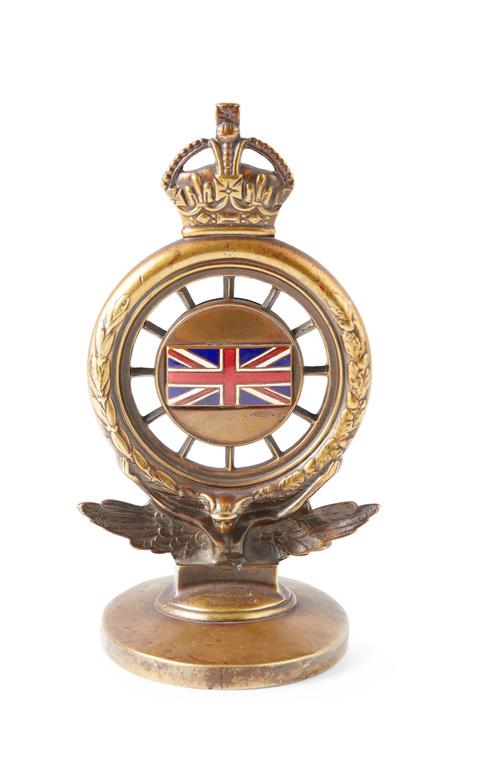
B2587, mounted on an oval brass base
8cm high
£400-600
446
TWO WWII CARVED AND PAINTED WOOD AIRCRAFT MODELS
CIRCA 1940
including two American Air Force models of a Boeing B-17 Flying Fortress and a Lockheed P-38 Lightning, both painted in dark green with metal propellers, on later enamel and black painted wood stands (2)

the larger 47cm wide, 25cm high, 33cm deep
£700-1,000
447
MAHOGANY AND BRASS STANDING FLOOR SCALES, BY DE GRAVE, SHORT, & FANNER

LATE 19TH CENTURY
the counter balanced platform scales with a rising measuring stick, bearing a brass plaque engraved DE GRAVE/ SHORT & FANNER/ MAKERS./ LONDON.
122cm high [lowest]
£800-1,200
448
CHICAGO MILLS NOVELTY CO. ‘TOTALISATOR’ CLUB BELL SLOT MACHINE
CIRCA 1930
Six Pence Bell fruit 3-reel type floor standing console slot machine in an Art Deco oak standing case 52cm wide, 153cm high, 38cm wide

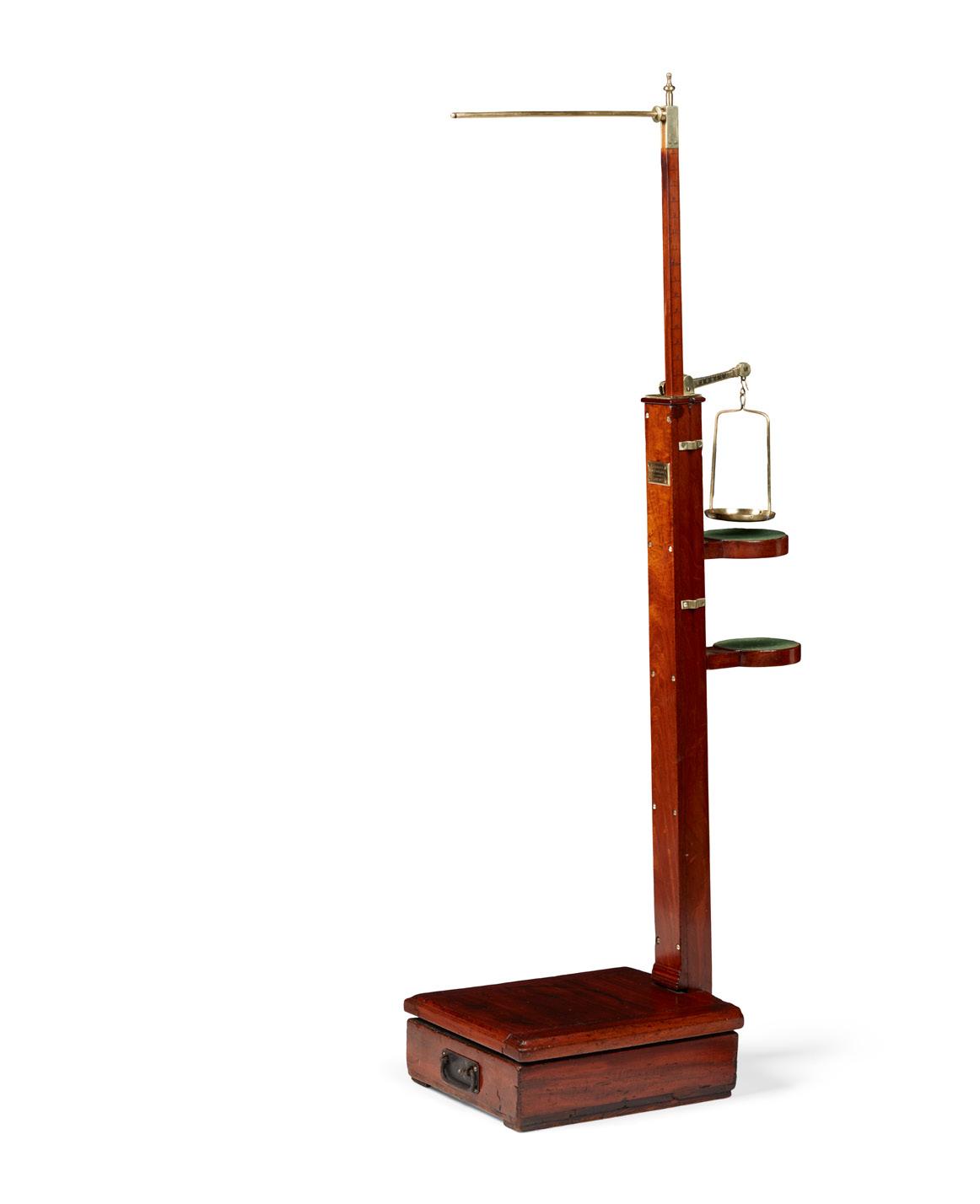
Note: Made in the USA by Chicago Mills Novelty Co. of Chicago, and distributed in Europe by the Samson Novelty Co. of London. Samson were the sole distributors for Mills Novelty Co. slot machines from 1928.
£1,500-2,500
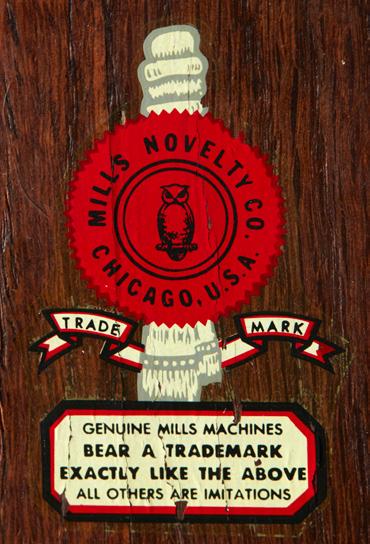
161 Other fees apply in addition to the hammer price: see the ‘Buyer’s Guide’ section on page 2
PAINTINGS PART III
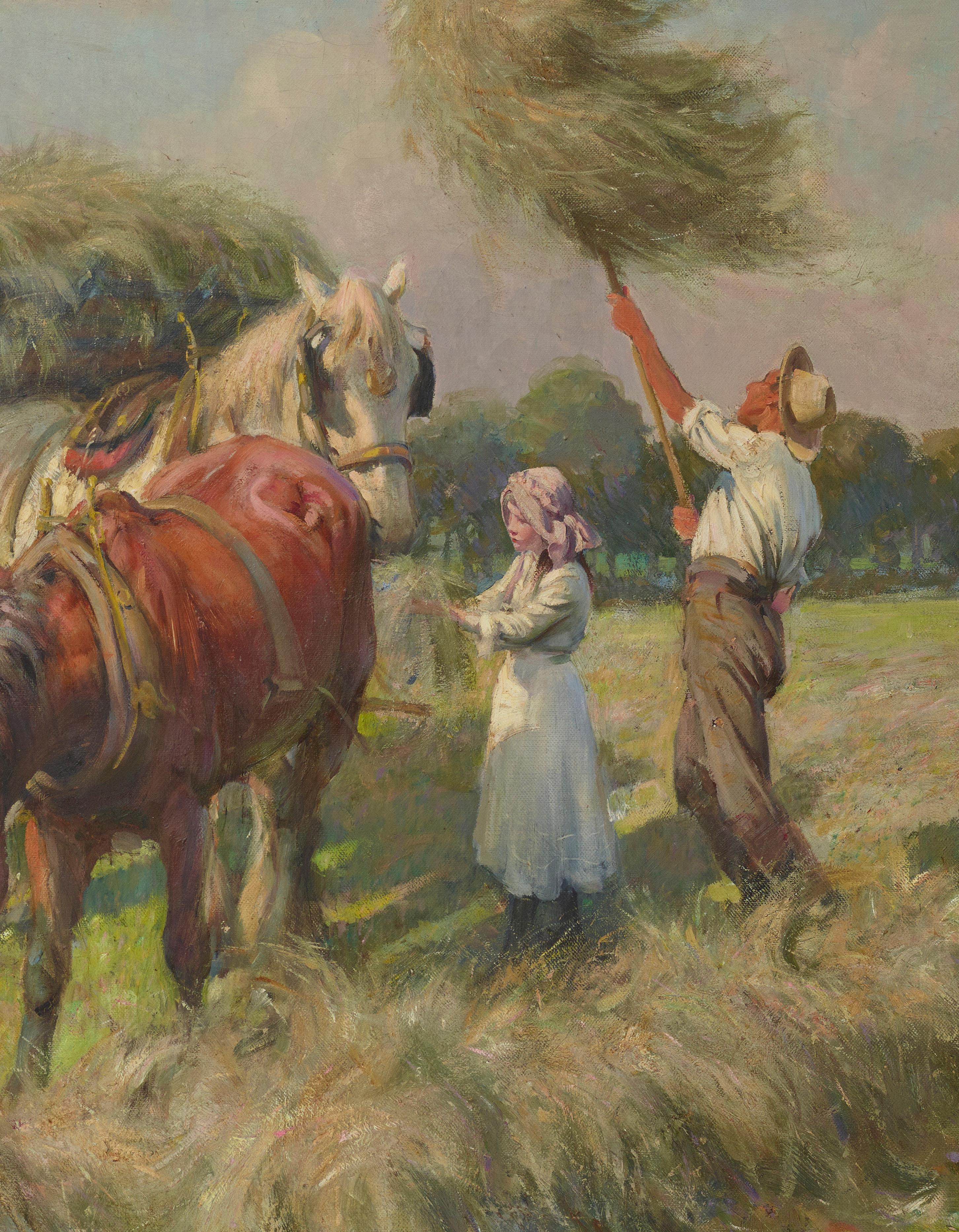

Signed and dated
£800-1,200
Signed, oil on canvas


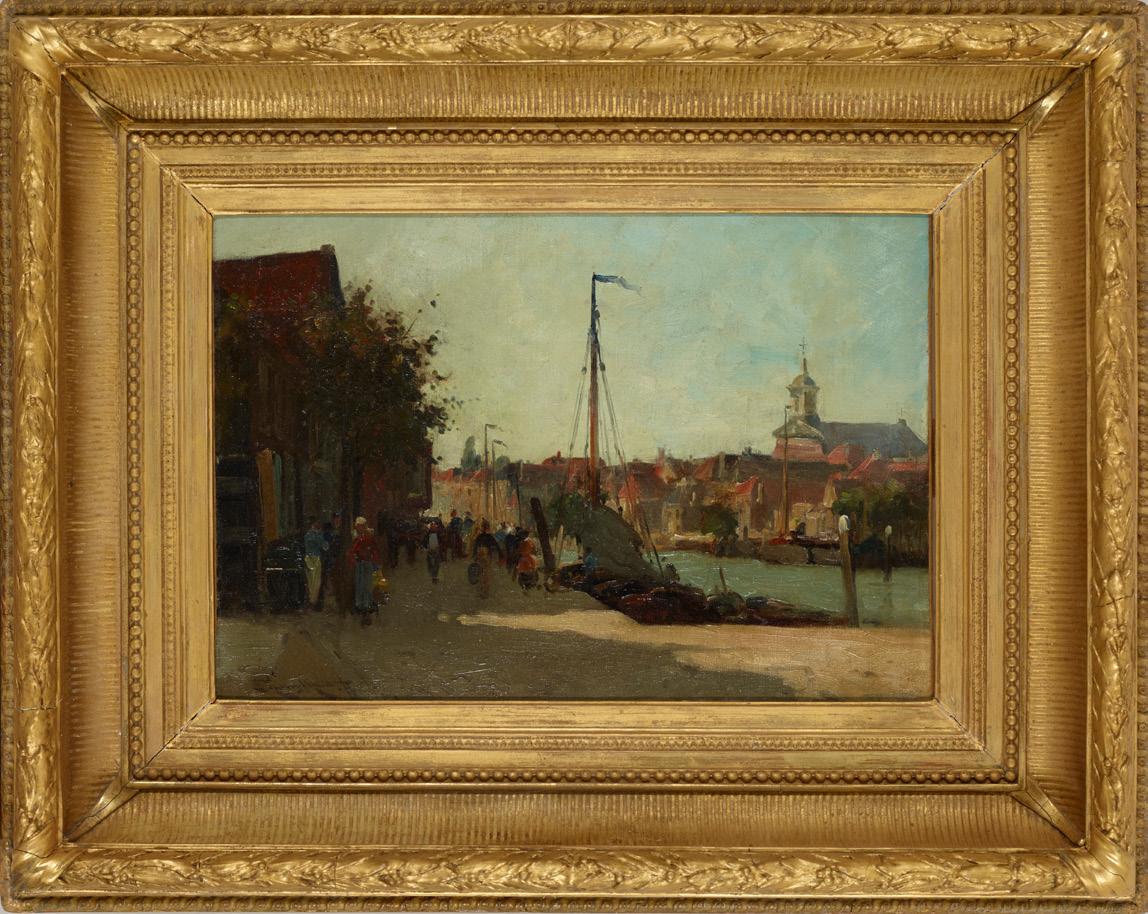

£500-800
£400-600
451 ABEL HOLD (BRITISH 1815-1891)
A STILL LIFE OF DEAD GAME
Signed and dated 1890, oil on paper laid down on canvas, and a companion pair similar (2)
42cm x 52cm (16.5in x 20.5in)
449 CHARLES VAN DEN EYCKEN (BELGIAN 1859-1923) WINDSWEPT LANDSCAPE
1887, oil on panel 38cm x 46cm (15in x 18in)
450 EDMUND AUBREY HUNT (AMERICAN 1855-1922) ON THE HARBOUR QUAY
30.5cm x 46cm (12in x 18in)
163 Other fees apply in addition to the hammer price: see the ‘Buyer’s Guide’ section on page 2
452
WILLIAM LIONEL WYLLIE
R.A. (BRITISH 1851-1931)
UNLOADING COAL
Signed, oil on canvas
46cm x 81.5cm (18in x 32in)
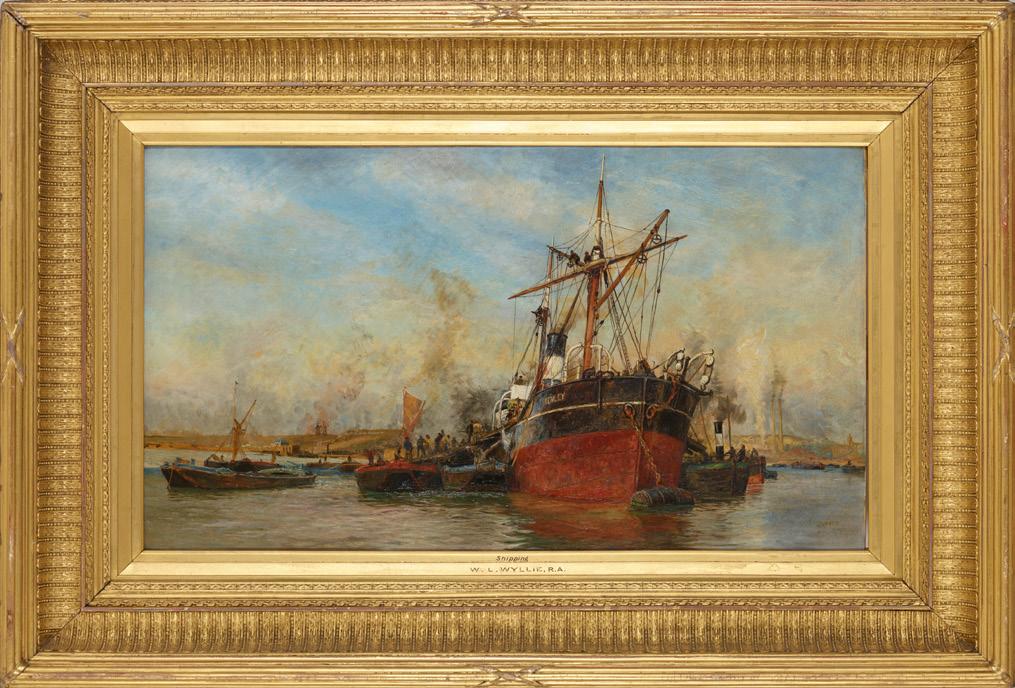
£3,000-5,000

164 Other fees apply in addition to the hammer price: see the ‘Buyer’s Guide’ section on page 2
453
ROWLAND WHEELRIGHT (BRITISH 1870-1950)
HARVEST-TIME
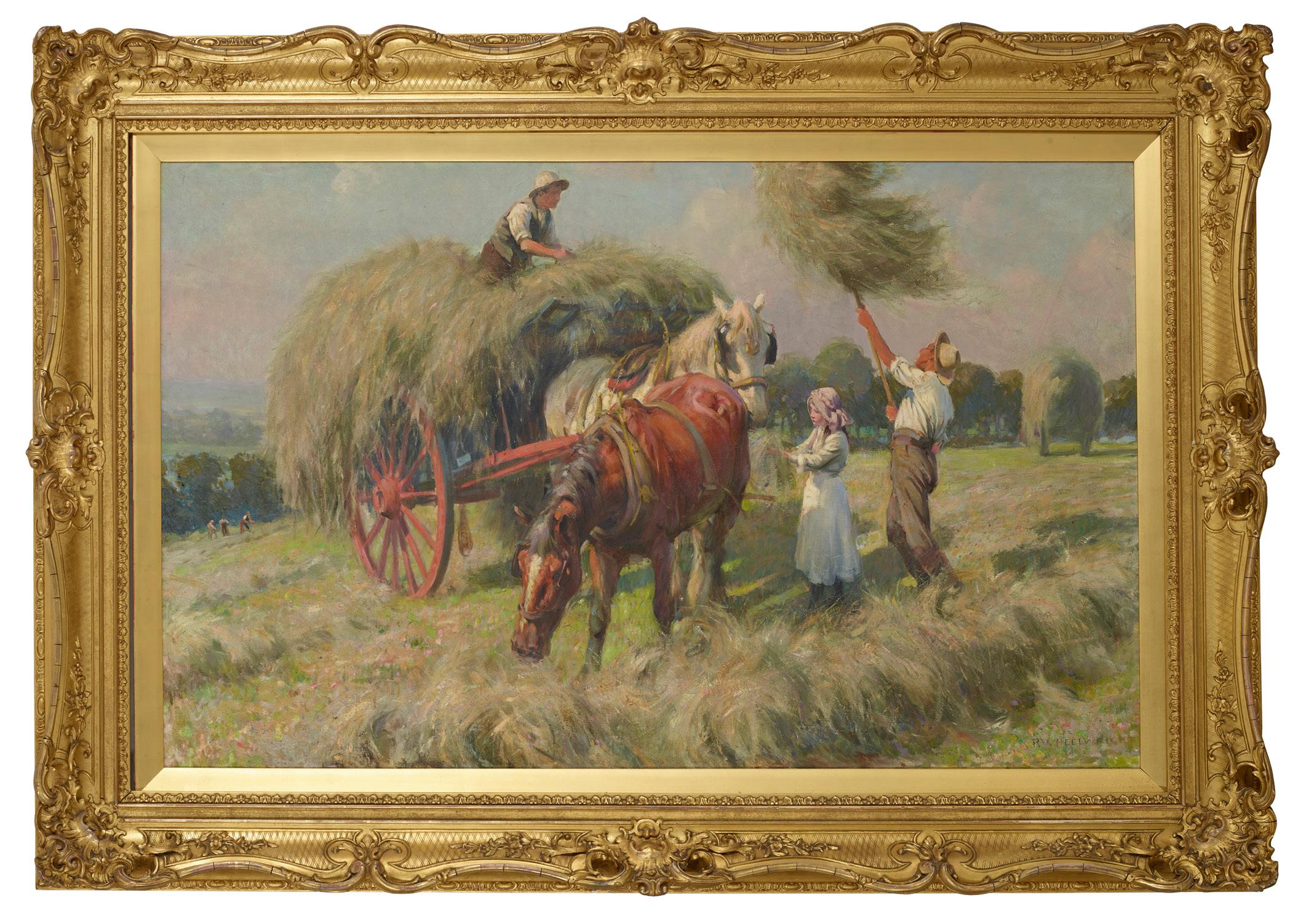
Signed, oil on canvas
76cm x 127cm (30in x 50in)
£3,000-5,000
165
454
GIROLAMO GIANNI (ITALIAN 1837-1895)
THE ENTRANCE TO VALETTA HARBOUR, MALTA
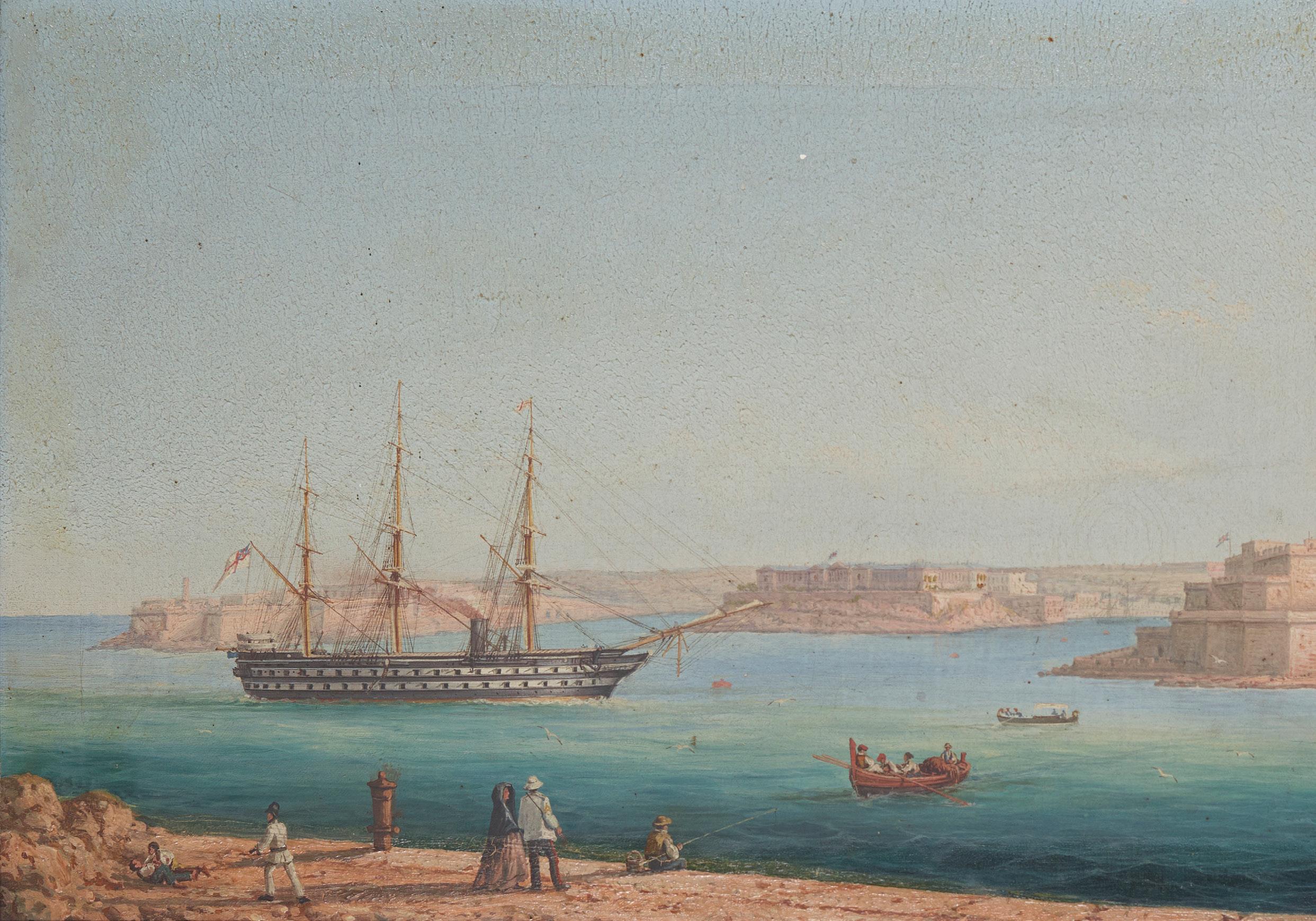
Signed and dated 1869, oil on canvas
37cm x 103cm (14.5in x 40.5in)
Provenance: Paxton House, Berwickshire, thence by descent to the vendor
£7,000-10,000
166
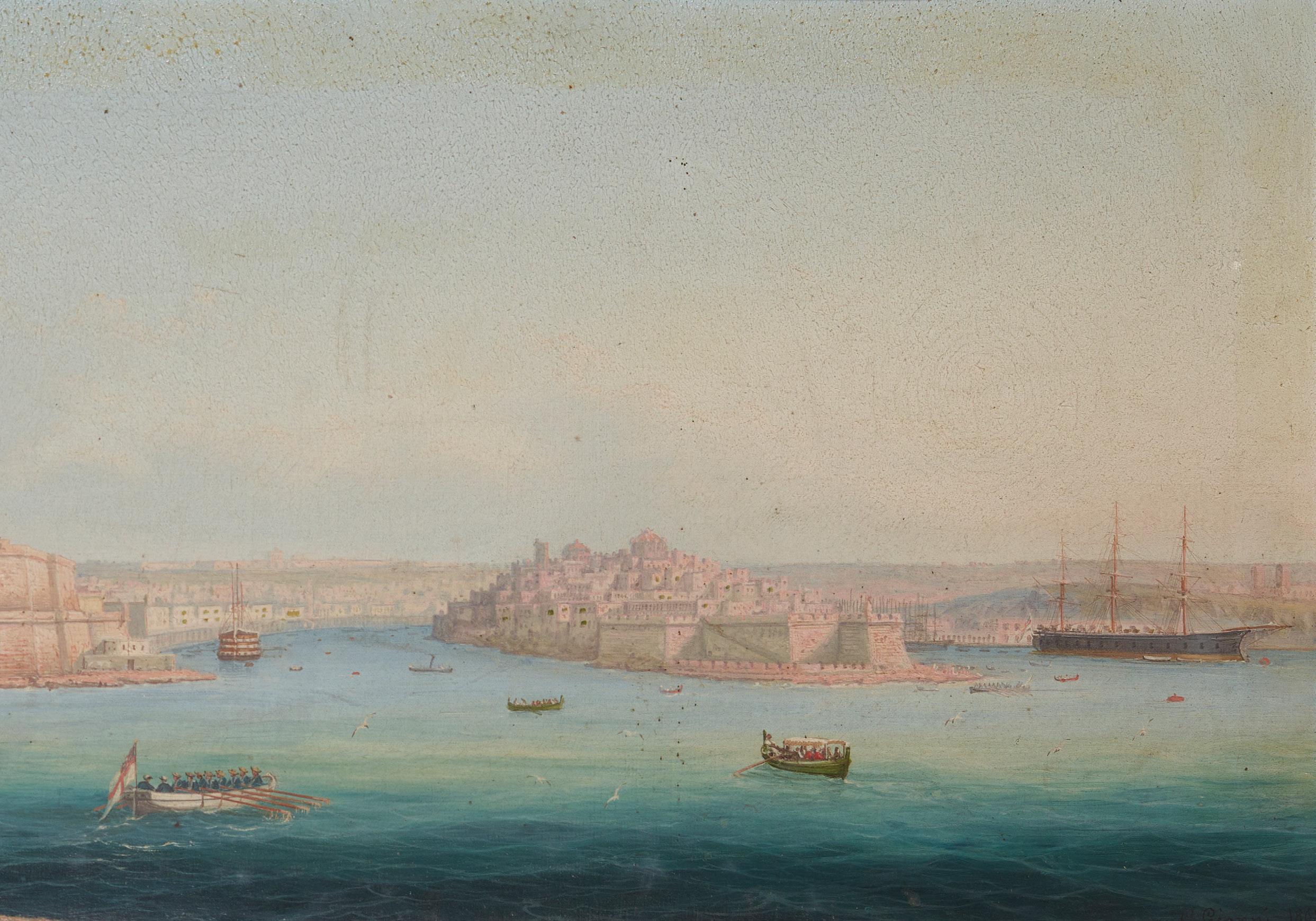
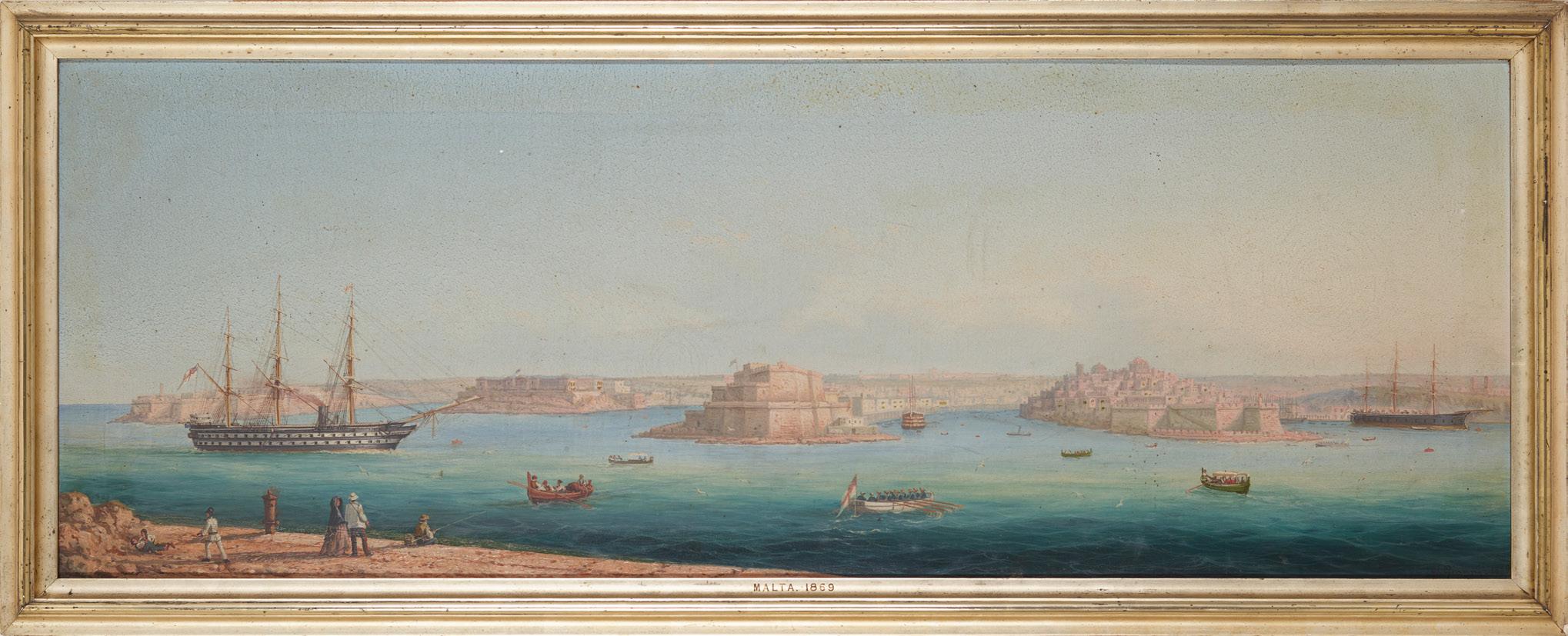
167 Other fees apply in addition to the hammer price: see the ‘Buyer’s Guide’ section on page 2
455
WILLIAM RAYMOND DOMMERSEN (DUTCH 1850-1927)
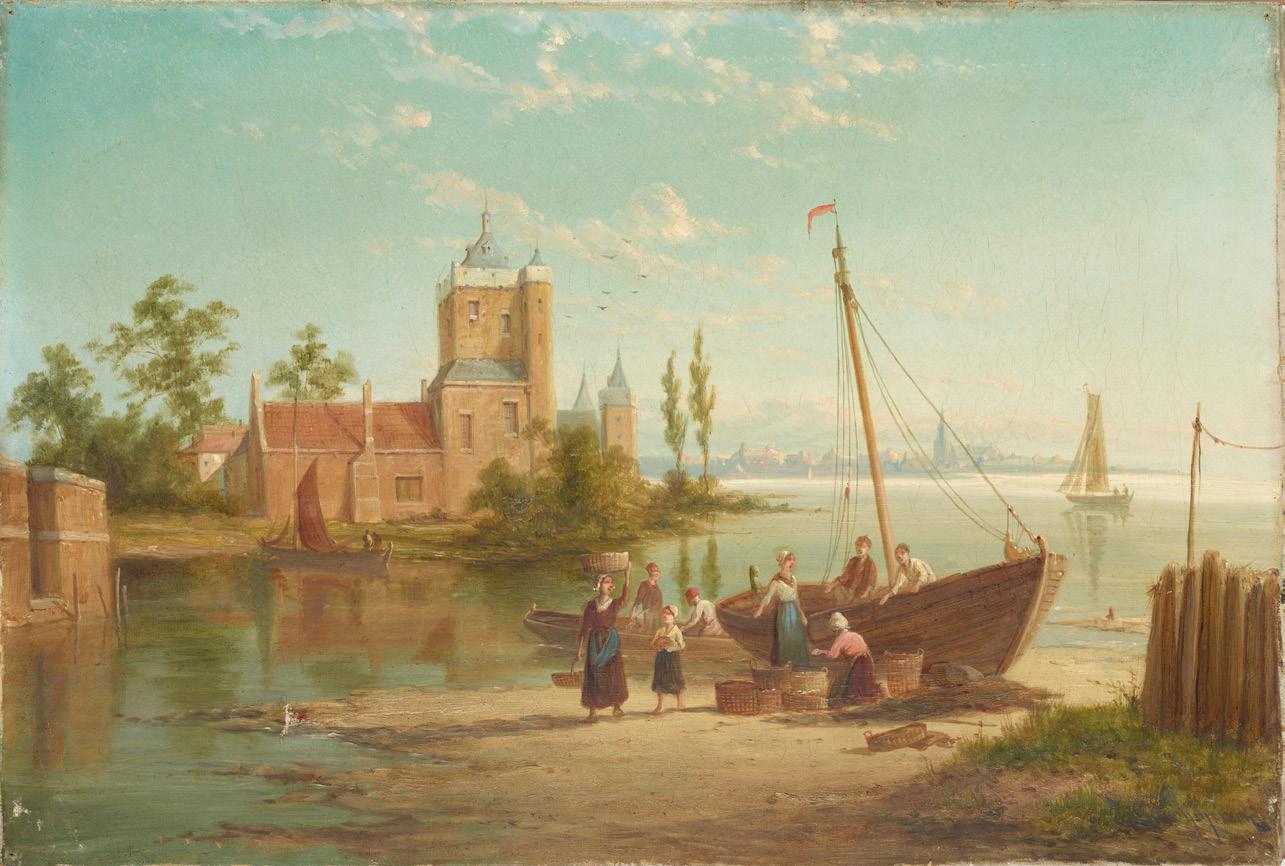
EMBARKING ON THE FERRY
Signed, and inscribed on the reverse ‘Utrecht’, oil on canvas, unframed, and a companion, a pair, ‘Amerfoord’ (2) (2)
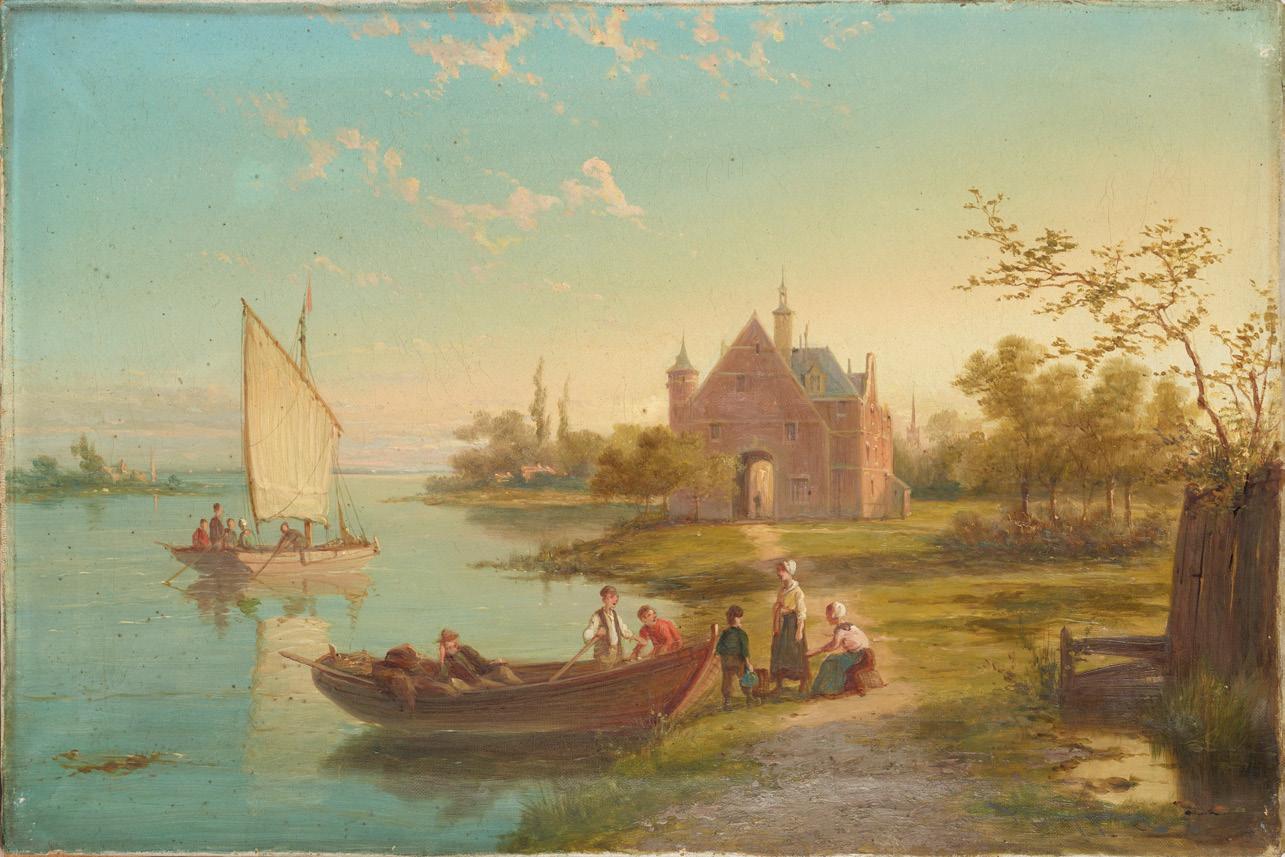
41cm x 61cm (16in x 24in)
£500-800
456 §
SIR WILLIAM RUSSELL FLINT
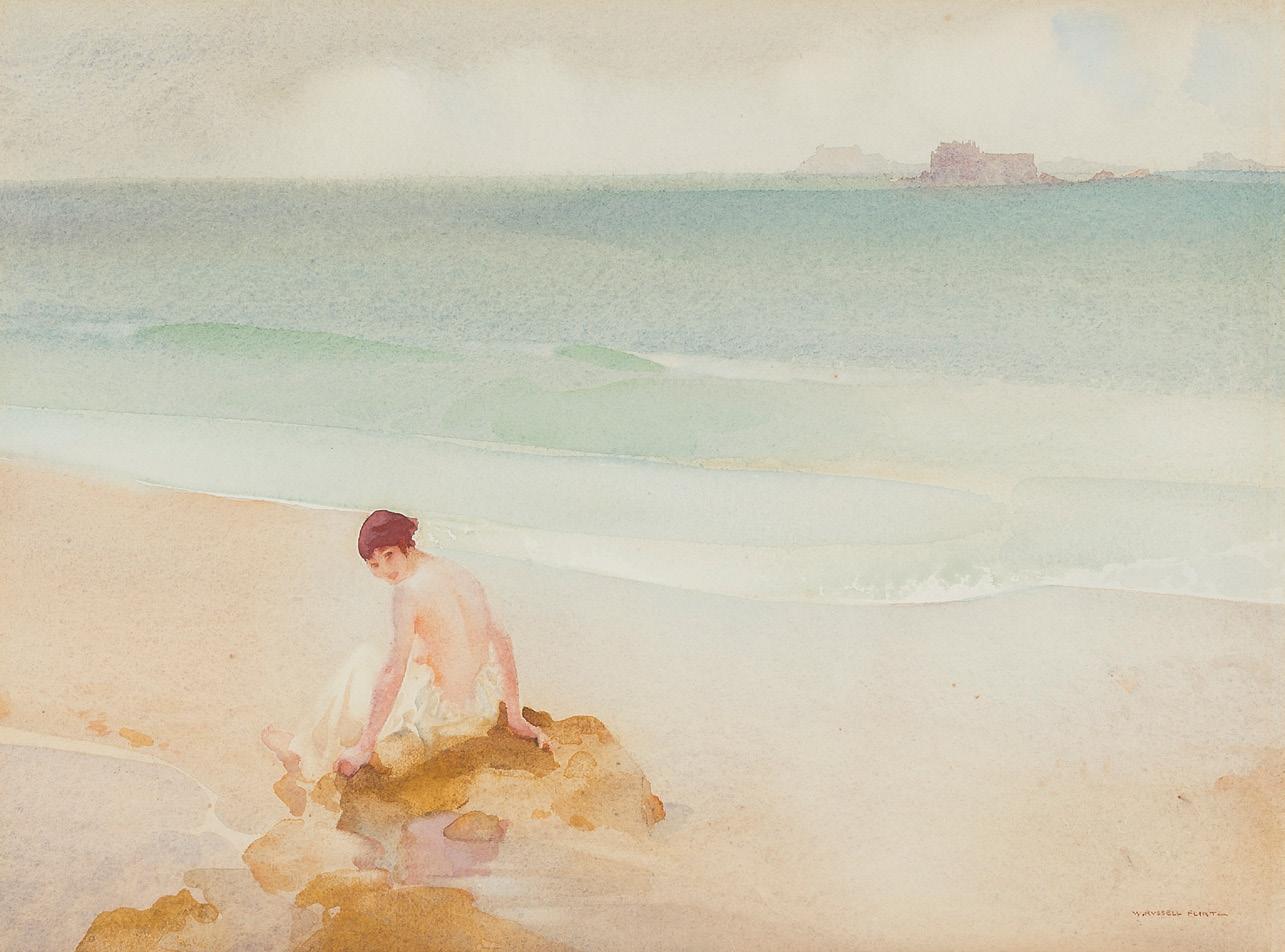
P.R.A., P.R.W.S., R.S.W., R.O.I., R.E. (SCOTTISH 1880-1969)
A WARM DRIZZLE
Signed, watercolour
24cm x 33cm (9.5in x 13in)
£1,500-2,000
168 Other fees apply in addition to the hammer price: see the ‘Buyer’s Guide’ section on page 2
457 §
SIR WILLIAM RUSSELL FLINT P.R.A., P.R.W.S., R.S.W., R.O.I., R.E. (SCOTTISH 1880-1969)
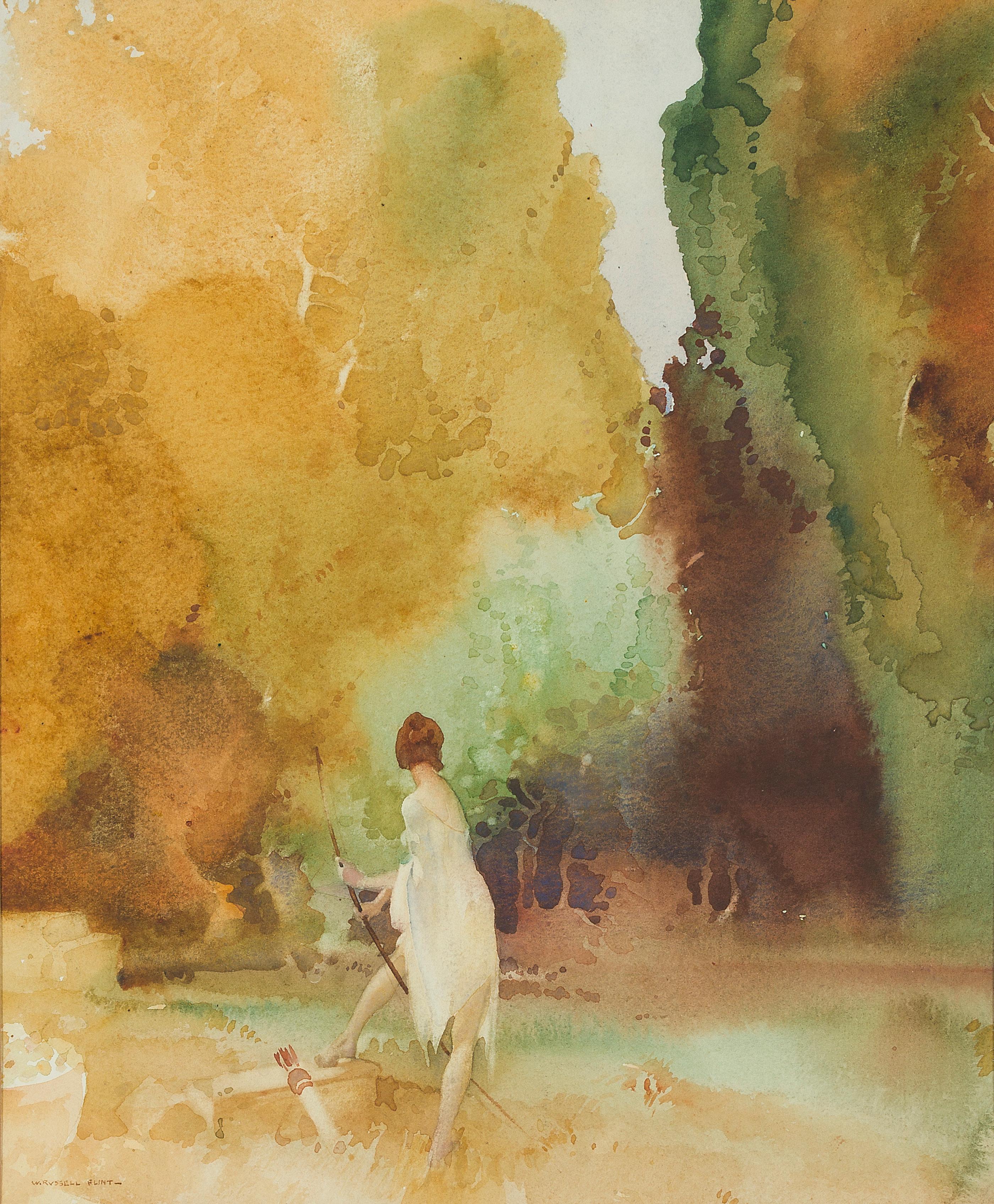
THE TIMID HUNTRESS
Signed and inscribed to backboard verso, watercolour
33cm x 28cm (13in x 11in)
£1,500-2,000
460
JULIUS OLSSEN (BRITISH 1864-1942)
A SUNLIT GARDEN PATH
Signed, oil on board
25.5cm x 36cm (10in x 14in)
£400-600
459
MORITZ VAN EYKEN (19/20TH CENTURY GERMAN)
ALLEGORY OF SUMMER
Signed and dated 1907, oil on canvas
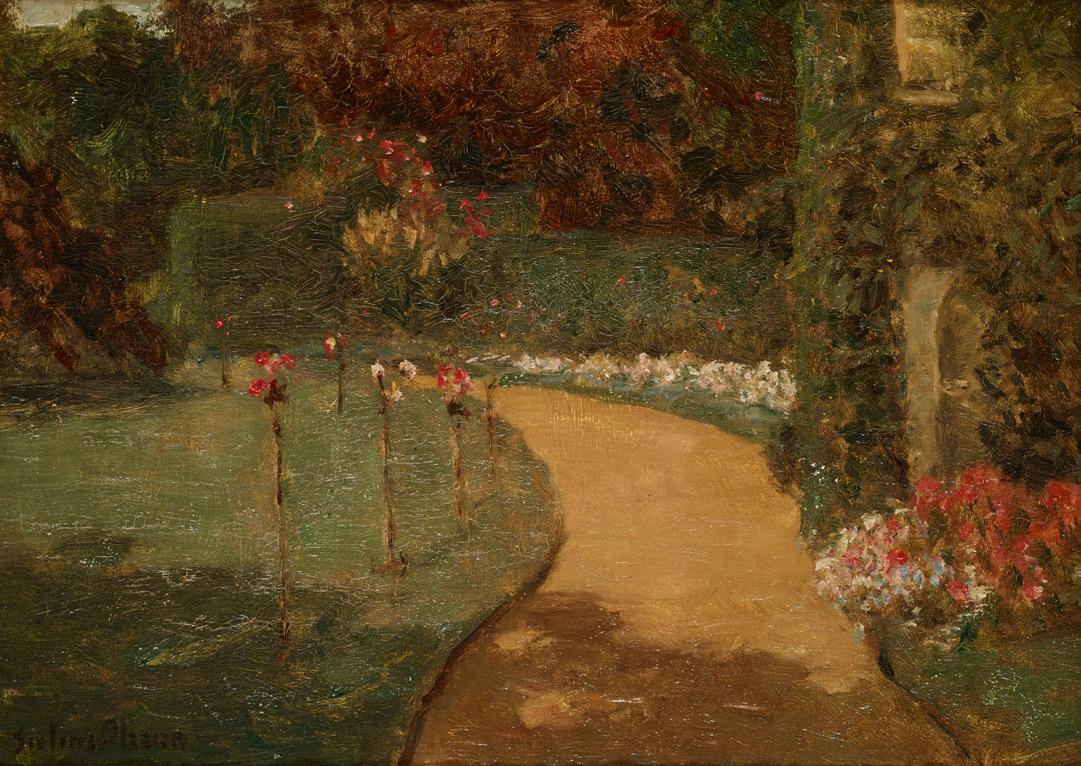
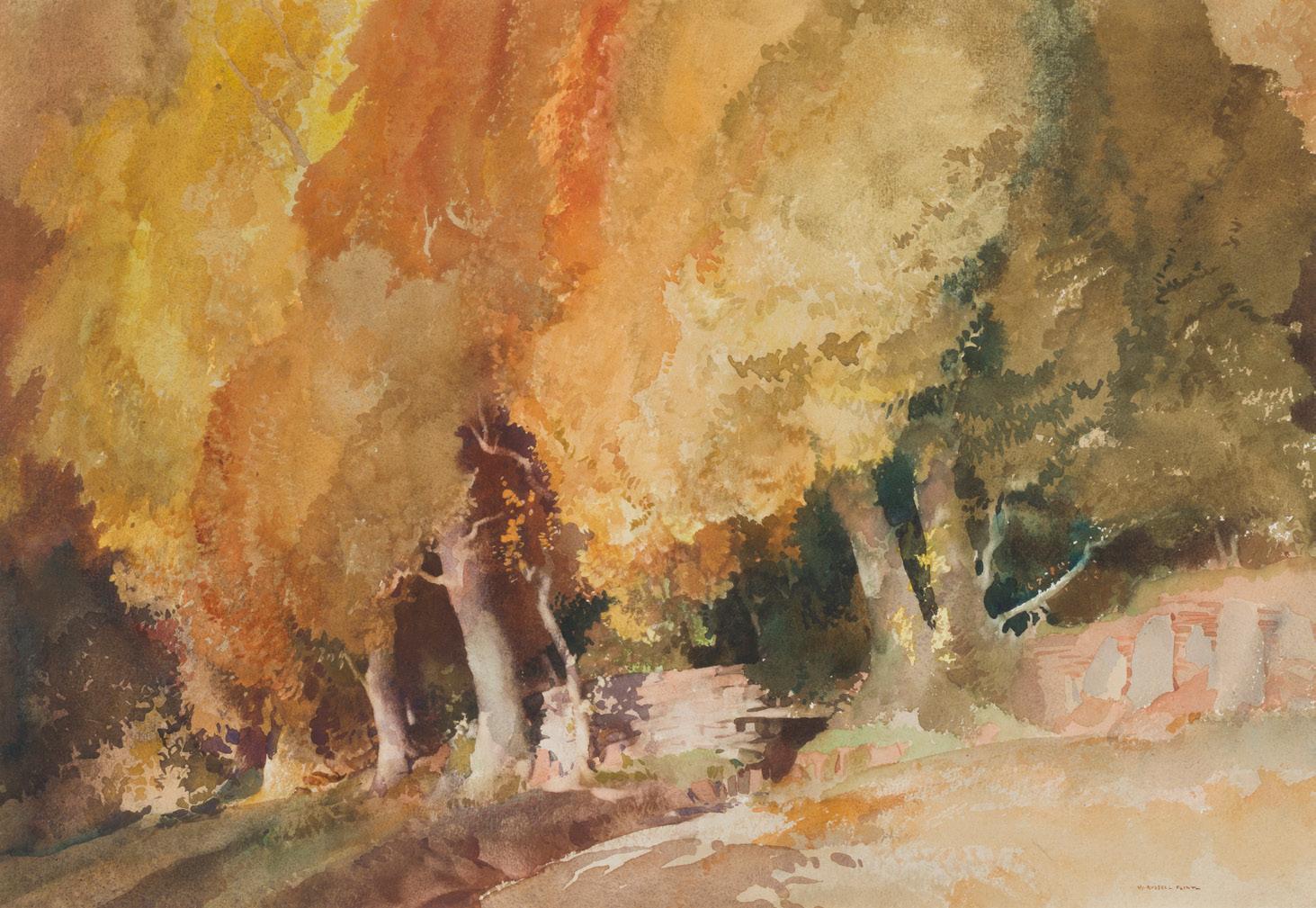

164cm x 80cm (64.5in x 31.5in)
£800-1,200
458 §
SIR WILLIAM RUSSELL
FLINT P.R.A., P.R.W.S., R.S.W., R.O.I., R.E. (SCOTTISH 1880-1969)
NORTH SIDE, LOCH EARN
Signed, watercolour
37cm x 53cm (14in x 21in)
£1,000-1,500
170
461 §
SIR WILLIAM RUSSELL FLINT P.R.A., P.R.W.S., R.S.W., R.O.I., R.E. (SCOTTISH 1880-1969)
THE SQUARE HOUSE, VAUGELAS
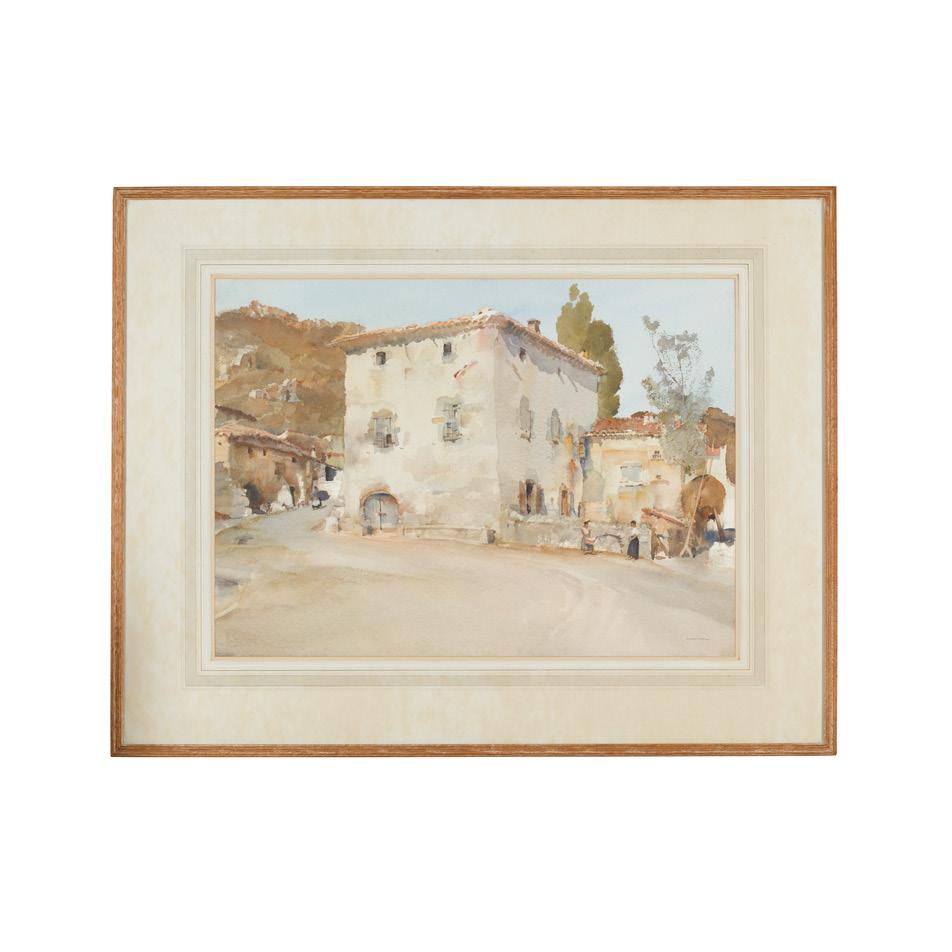
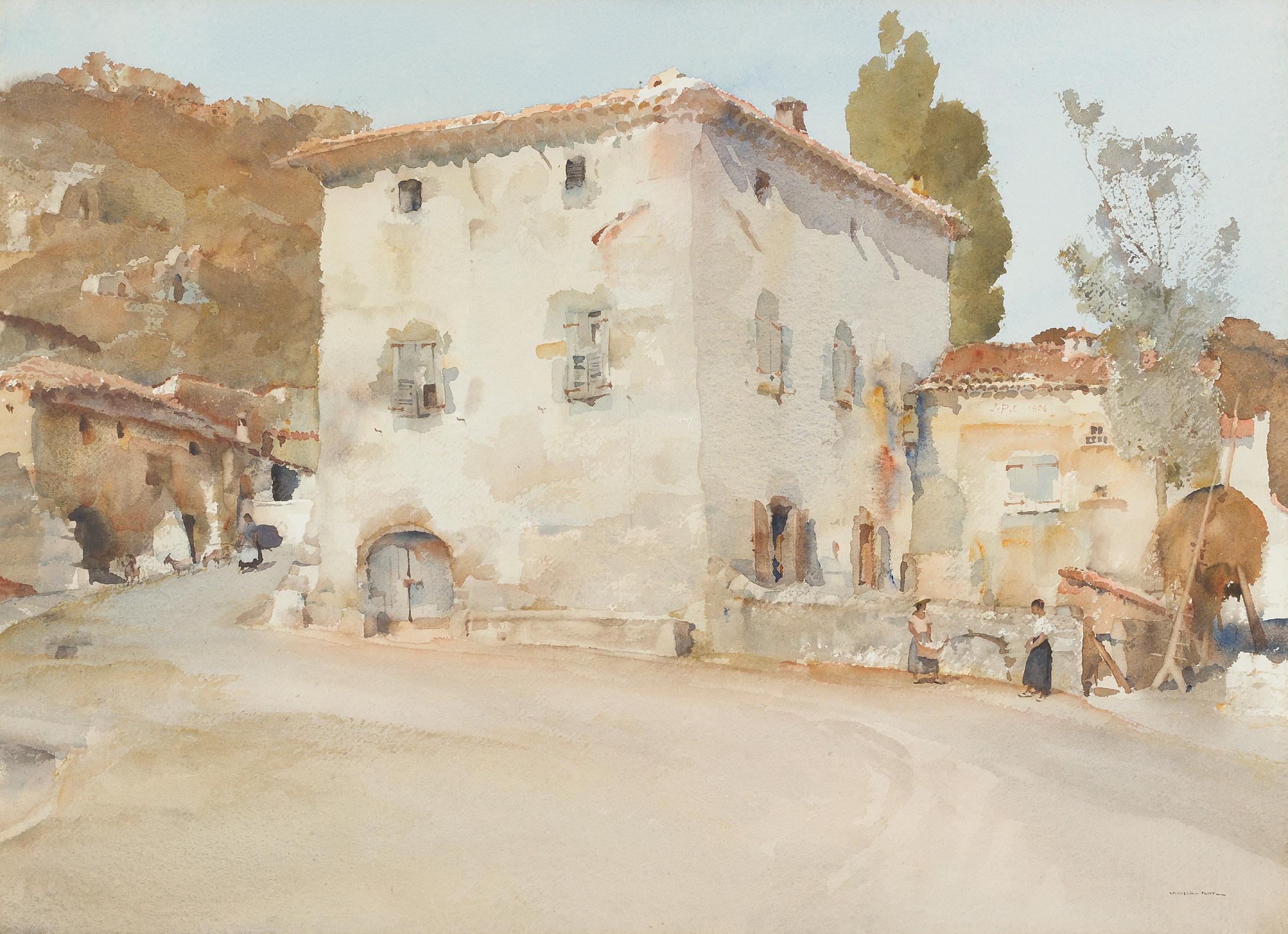
Signed and inscribed on the backboard, watercolour
51cm x 67.5cm (20in x 26.5in)
Exhibited: Royal Academy, 1946
Royal Academy, 1956, no.5
Fine Art Society Ltd., London, February 1957
Royal Academy, ‘Sir William Russell Flint’ Exhibition, 1962, no.130
£3,000-5,000
171 Other fees apply in addition to the hammer price: see the ‘Buyer’s Guide’ section on page 2
COURTYARD GOSSIP
Signed, pastel
34cm x 25.5cm (1.5in x 14in)


£500-800
462
BIRTHDAY FLOWERS
With trace of signature to canvas return verso, oil on canvas
71cm x 51cm (28in x 20in)
£800-1,200
HELEN LOUISE CODNER (BRITISH 1861-1946)
463
MARK SENIOR (BRITISH 1864-1927)
172
464 §
FRANK MOSS BENNETT (BRITISH 1874-1952)
AFTER THE HUNT
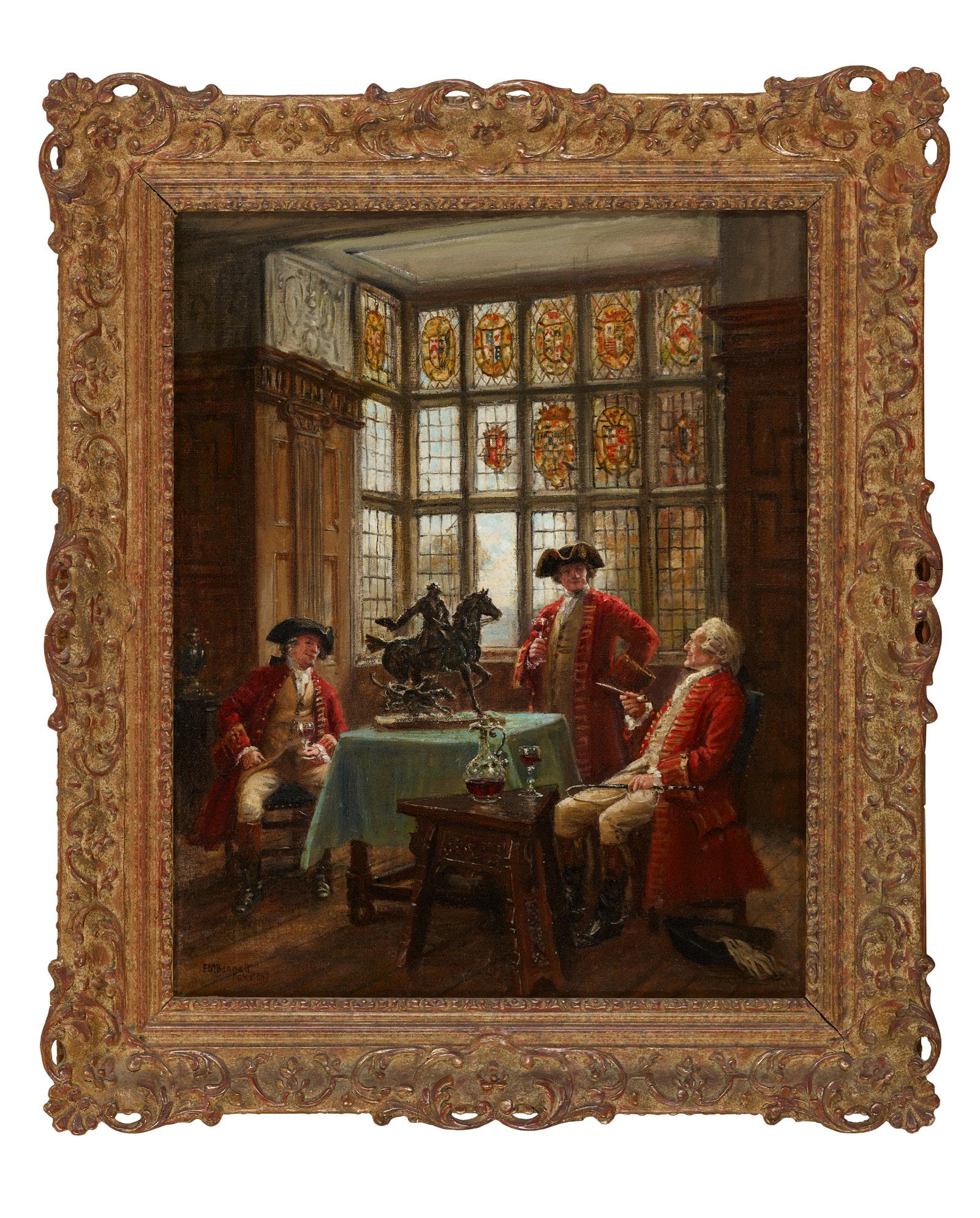
Signed, oil on canvas
51cm x 41cm (20in x 16in)
£2,000-3,000
465 §
LAWSON WOOD (BRITISH 1878-1957)
CAVALRY MAN
Signed and dated ‘47, watercolour
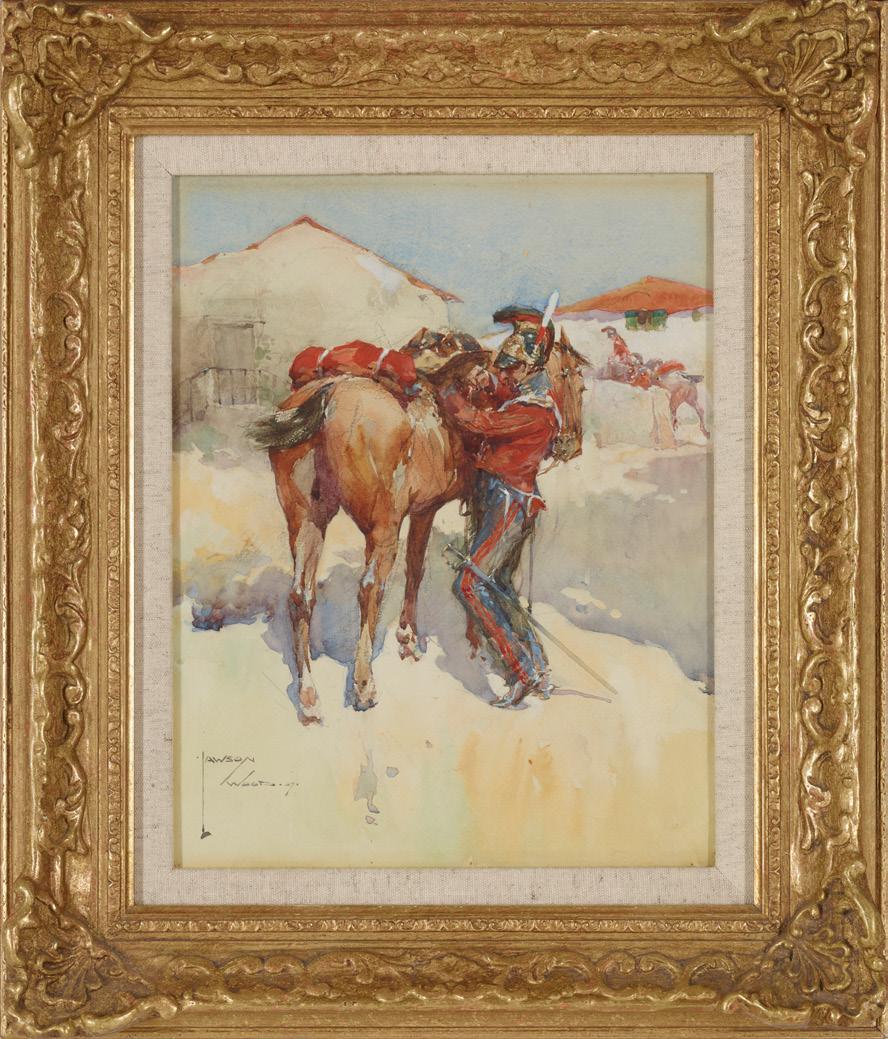
29.5cm x 23cm (11.5in x 9in)
£500-700
173 Other fees apply in addition to the hammer price: see the ‘Buyer’s Guide’ section on page 2
467
JOOP VAN DER ZOUWEN (DUTCH 20TH CENTURY)
THE CONVOY Oil on canvas

61cm x 91cm (24in x 36in)
£500-800
466 §
OSMUND PITTMAN (BRITISH 1874-1958)
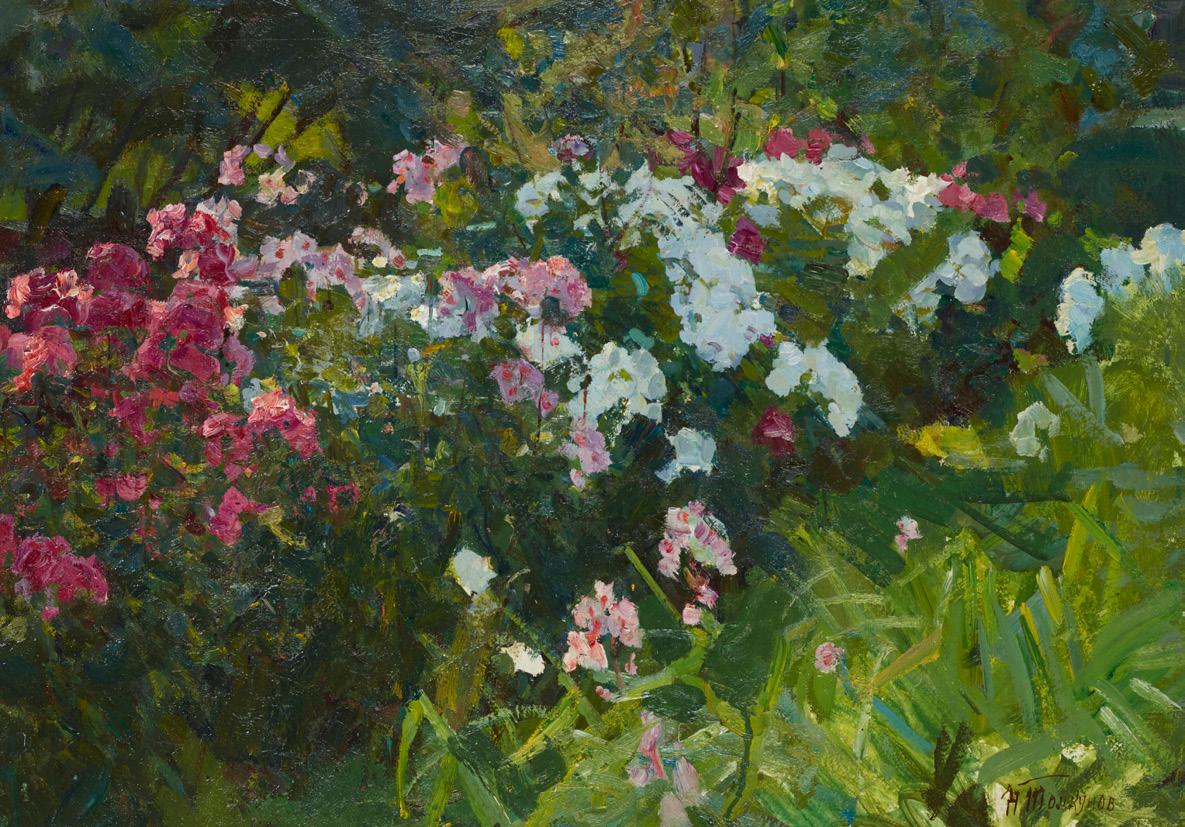
THE CUILLINS
Signed with the monogram, oil on canvas 46cm x 61cm (18in x 24in)
£1,000-1,500
468
TOLKOUNOV NIKOLAI PAVLOVITCH (RUSSIAN 1917-1996)
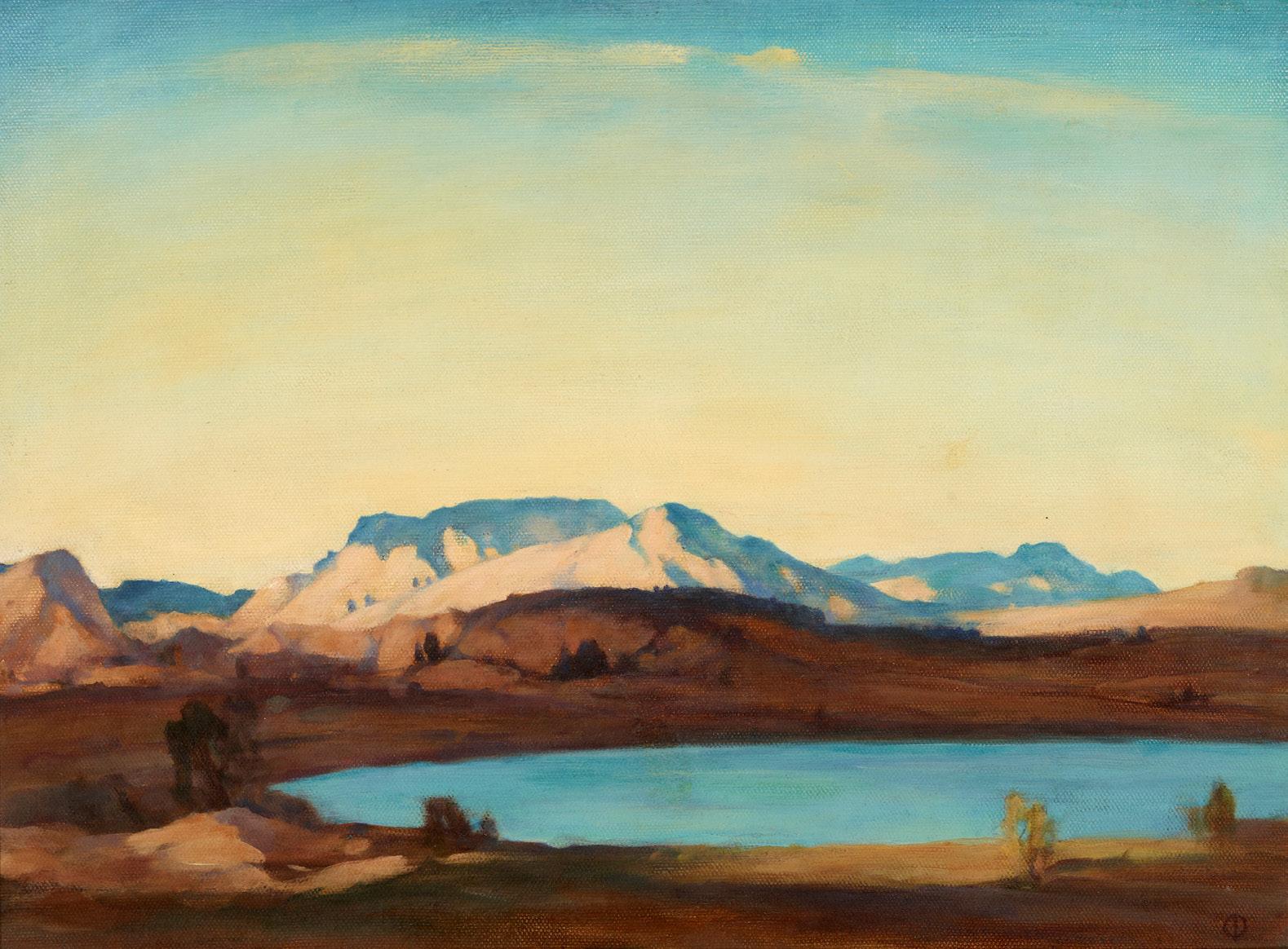
PHLOX FLOWER GARDEN
Signed, inscribed and dated 1960 on the backboard, oil on board
51cm x 71cm (20in x 28in)
Provenance: Anthony Woodd Gallery, Edinburgh
£600-900
174
469
MAURICE CANNING WILKS (IRISH 1911-1984)
CASHEL MOUNTAIN, CONNEMARA
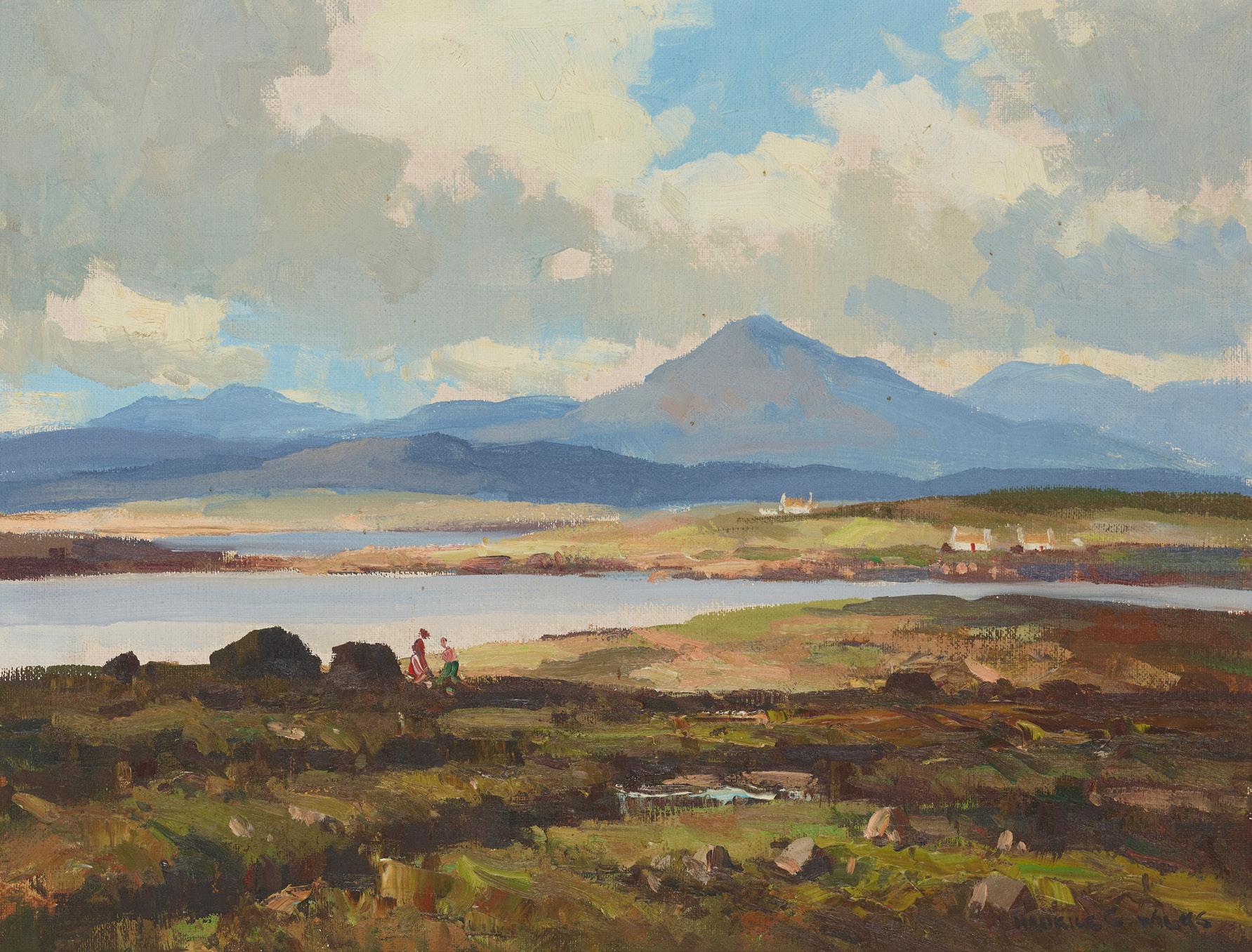
Signed, inscribed on the reverse, oil on canvas

36cm x 46cm (14in x 18in)
Provenance: John MaGee Limited, Belfast, Dec.1960
£1,500-2,000
470
DORIS CLARE ZINKEISEN (BRITISH 1898-1990)
THE ROYAL MAIL
Signed, oil on canvas
51cm x 102cm (20in x 40in)
Provenance: Frost & Reed, 0/38317
£1,000-1,500
175
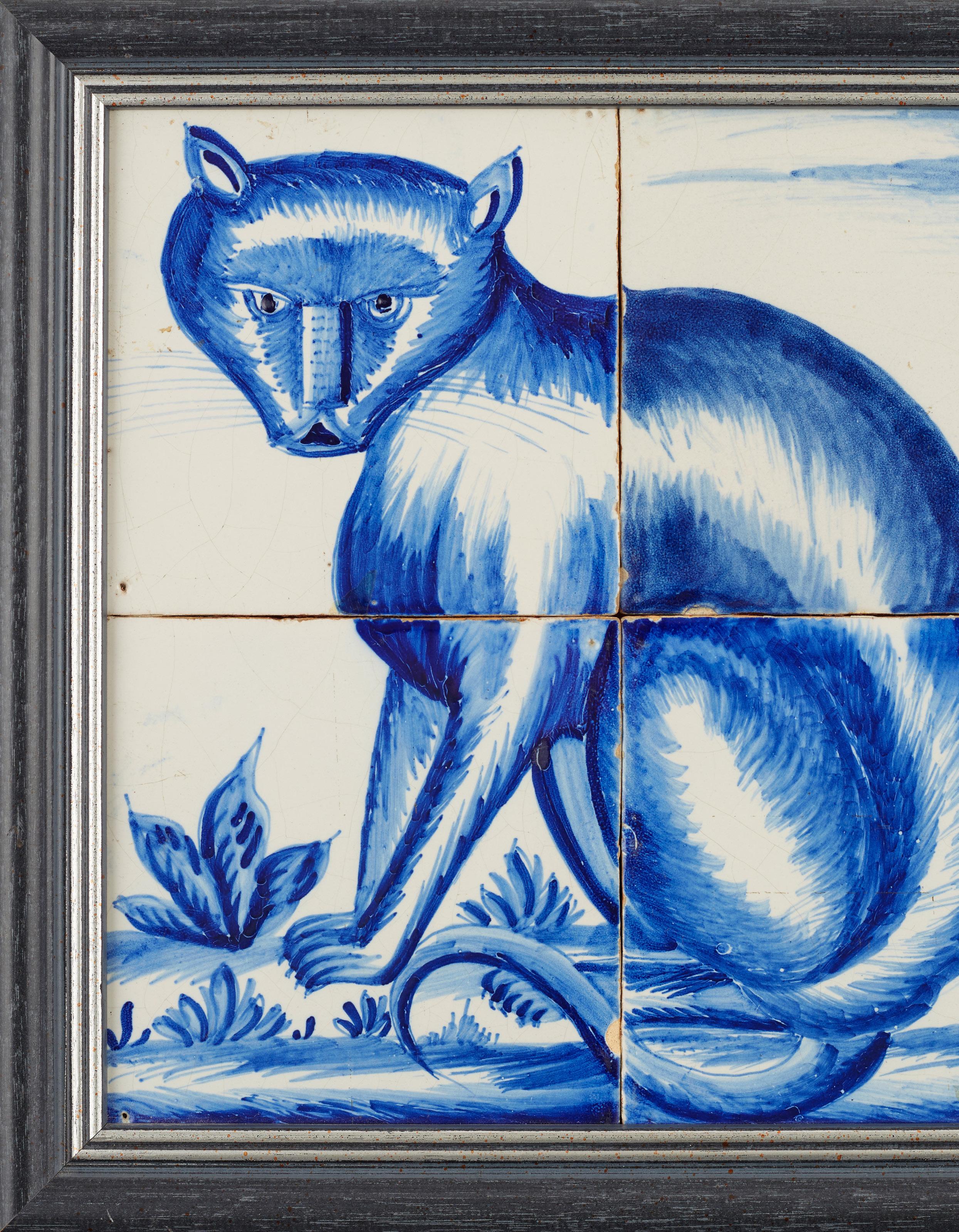
CONTINENTAL FURNITURE & WORKS OF ART
471
CONTINENTAL CARVED MARBLE CHERUB HEAD
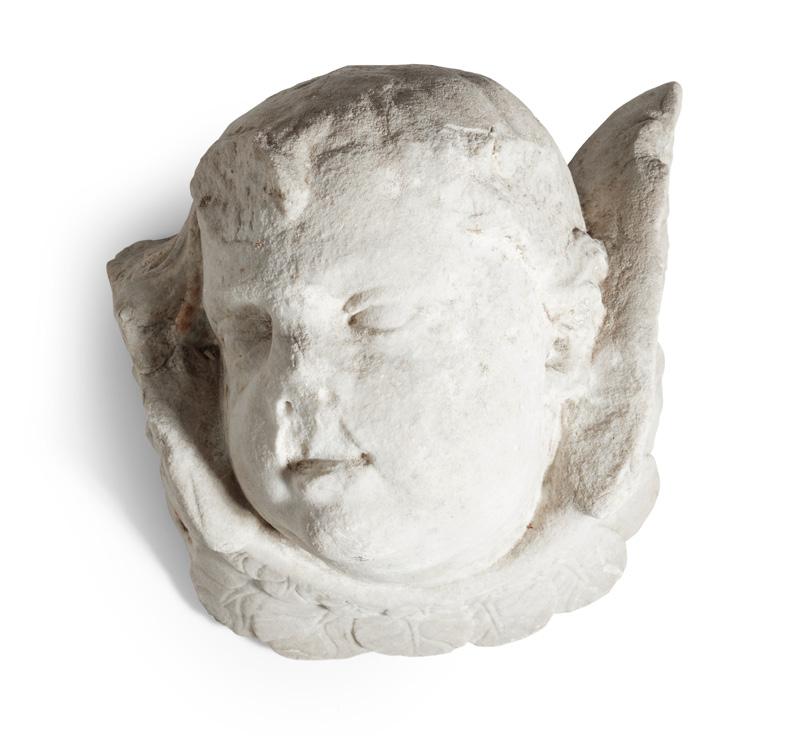
18TH CENTURY OR EARLIER
possibly Italian
20cm wide, 18cm high, 15cm deep
£300-500
474
NORTHERN ITALIAN GILT WALNUT FIGURE OF SAINT FRANCIS
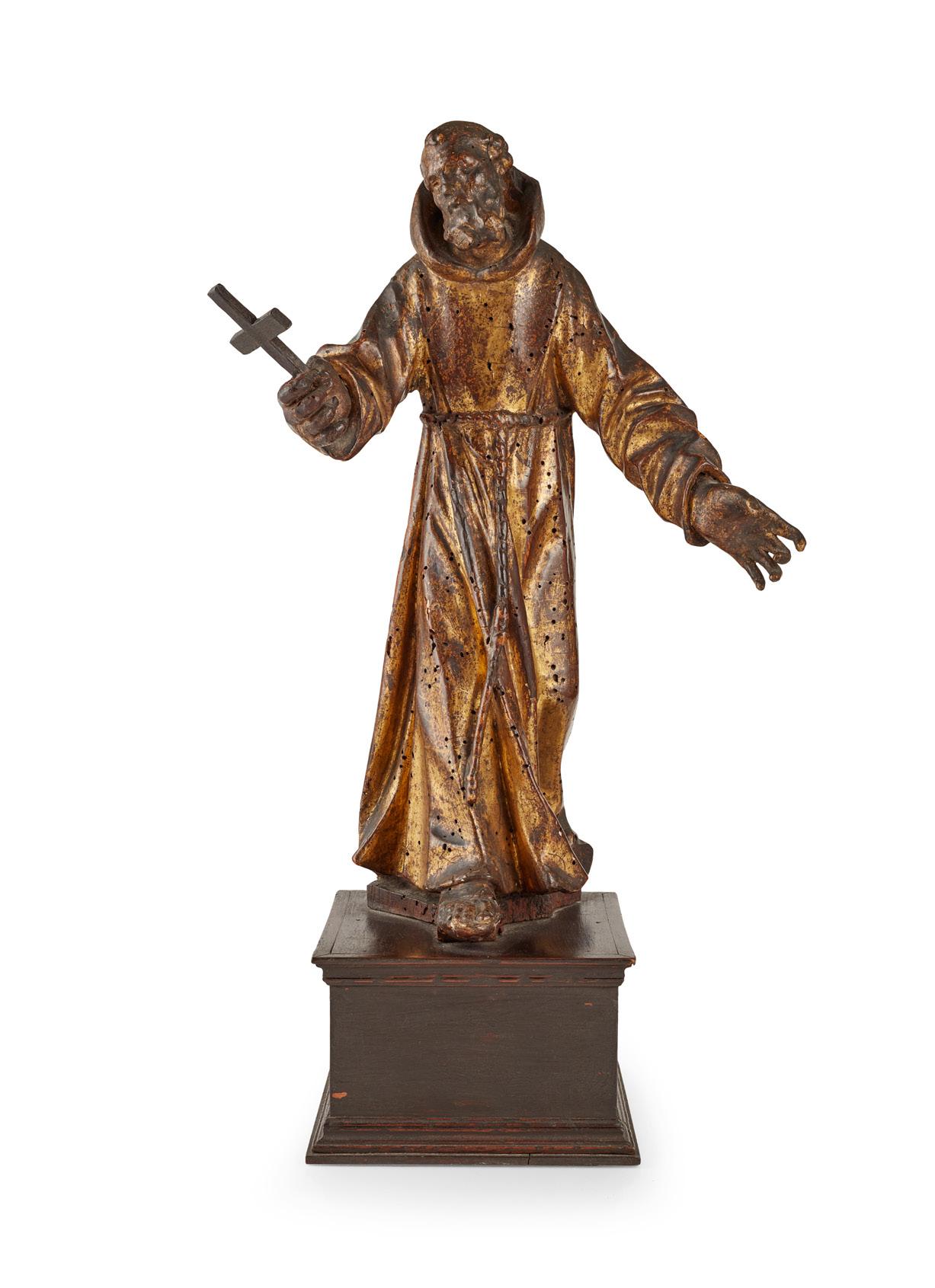
17TH CENTURY
depicted standing with his arms
outstretched holding a crucifix, in a cowl with cord around the waist, mounted on a stained wood square plinth
28cm wide, 52cm high, 22cm deep
£300-500
472
TWO ITALIAN POLYCHROMED AND PARCEL-GILT CARVED CHERUBS

19TH CENTURY
both shown full figure with outspread wings (2) 25cm wide, 16cm high, 15cm deep
£300-500
473
FRENCH BRONZE AND ENCAUSTIC INLAID CRUCIFIX
EARLY 16TH CENTURY
the figure of Christ mounted on a cross with red encaustic filled fields and quatrefoil terminals, on a knopped stem and an hexagonal floriform lobed base
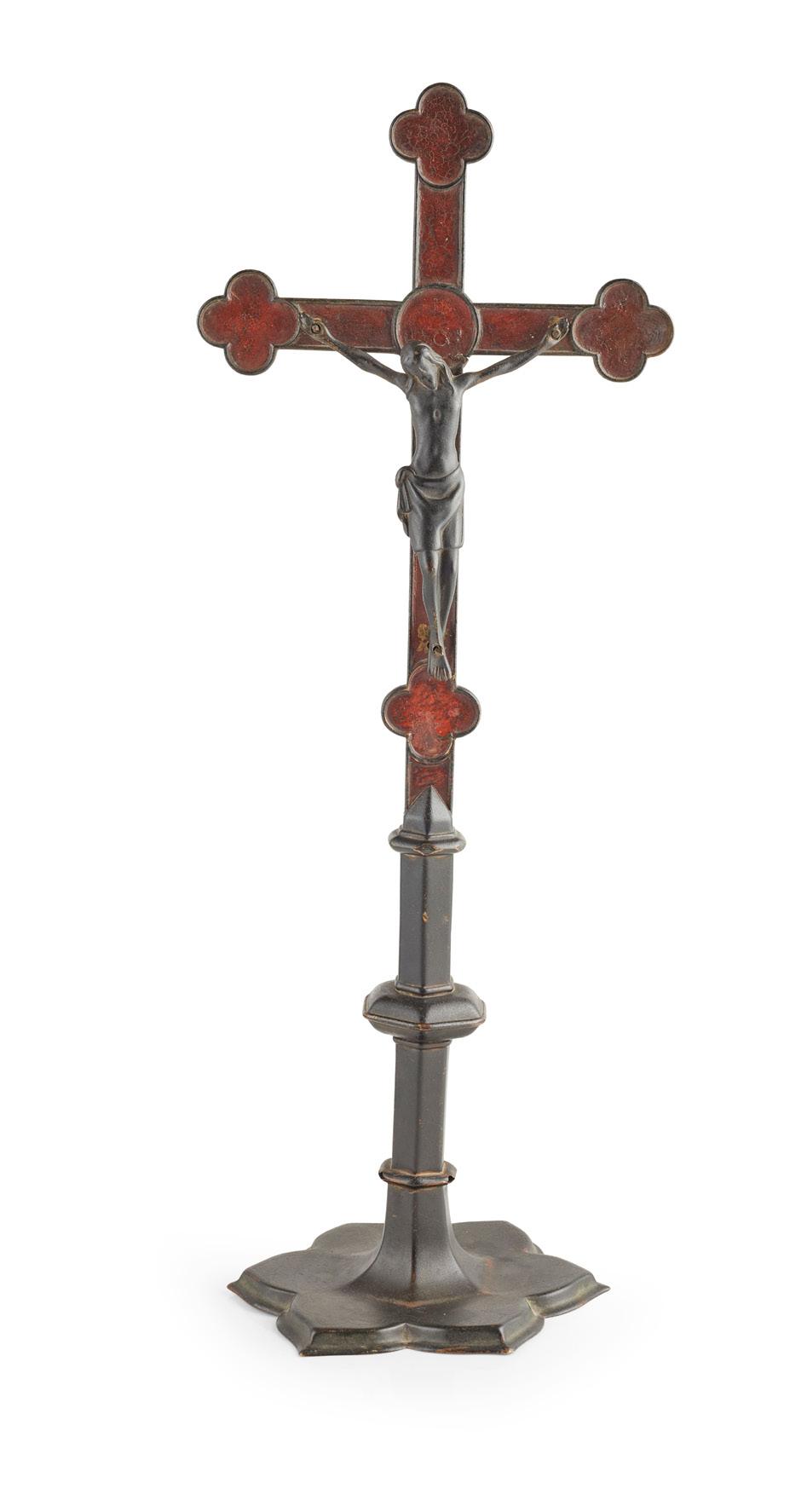
20cm wide, 55cm high, 15cm deep
£800-1,200
177 Other fees apply in addition to the hammer price: see the ‘Buyer’s Guide’ section on page 2
of slightly waisted cylindrical form, painted in blue, ochre and green, with a central horizontal band of peacock feather motifs, enclosed within blue and ochre bands, and two further bands of stylised blue decoration in the form of San Bernadino rays, dots and fish bone motifs; the shoulder with a blue dash border and further bands of ochre and blue 16.5cm diameter, 32.5cm high £8,000-12,000

There is an almost identical albarello in the Bargello National Museum in Florence. It is illustrated in Maioliches del Quattrocento a Pesaro: Frammenti di storia dell’arte ceramica, by Andrea Ciaroni, published 2004, p.26, fig.26.
Decorative features such as peacock feathers, fishbones (spina di pesce) and San Bernadino rays were previously attributed to Faenza until excavations at Pesaro uncovered sherds with decoration of this type. Timothy Wilson writes: ‘In these years Pesaro was, alongside Faenza, the most dynamic and successful maiolica producing town in Italy.’ Tin-Glaze and Image Culture, The MAK Maiolica Collection in its wider context, 2022, p. 234.
Jars of this type were made for pharmaceutical, and also commercial use. They formed a decorative display, along with dozens of others, on pharmacy or shop shelves. It is typical for jars of this period to have no contents inscription. From the late 15th century onwards, it became more common for the name of the contents to be inscribed on a vessel, and as many potters and decorators could not read or write, inscribing was a specialist task. The waisted form made the vessel easy to grip and the flanged lip made it possible to tie an oiled cloth cover around the rim.
178 Other fees apply in addition to the hammer price: see the ‘Buyer’s Guide’ section on page 2
475
PESARO MAIOLICA ALBARELLO, WORKSHOP OF MATTEO DI RANIERO FEDELI DA CAGLI AND VENTURA DI SIMONE FEDELI DAD SIENA 1460-1480
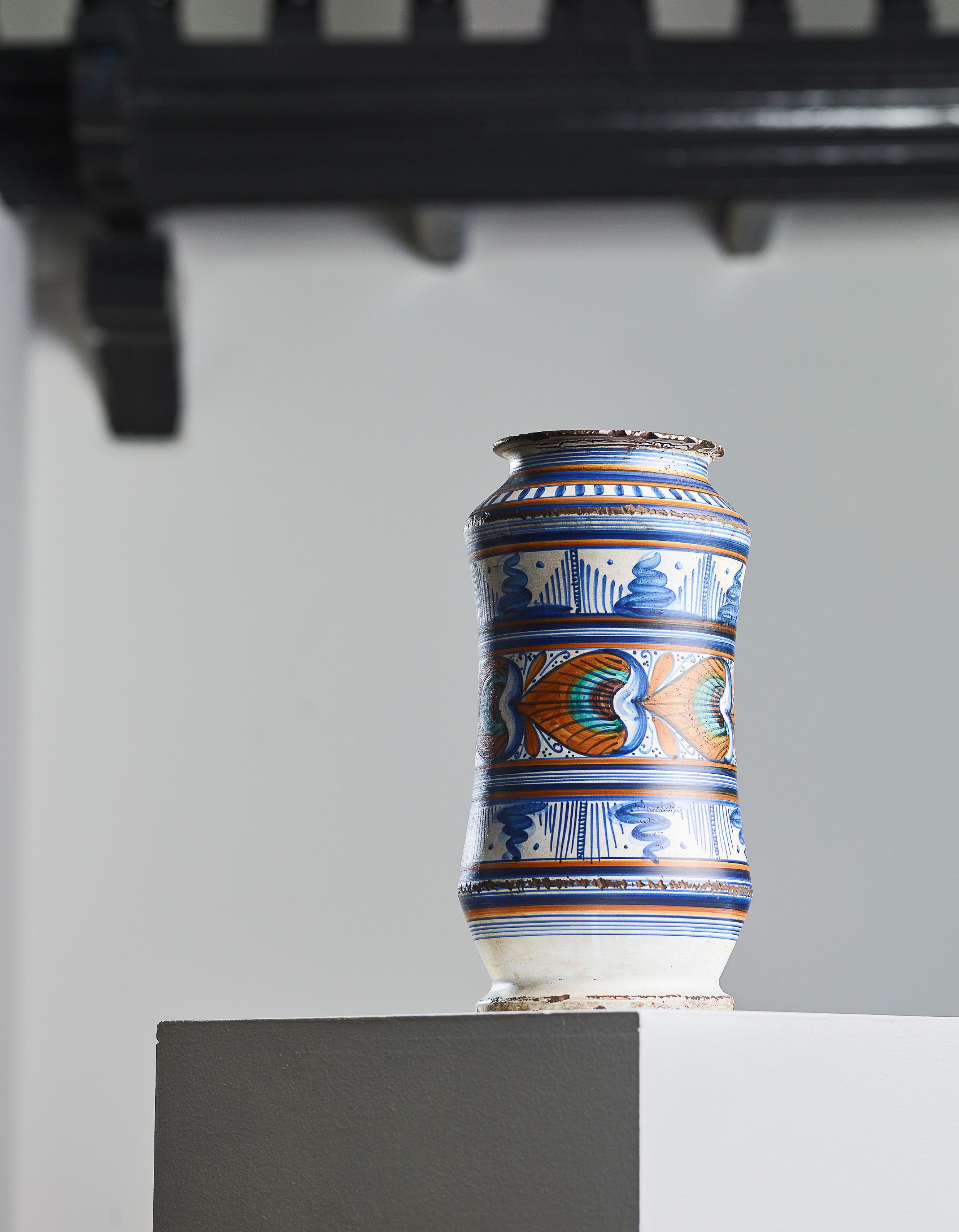
478
PAIR OF CONTINENTAL CARVED OAK AND STAINED-GLASS BOOKCASE CABINETS


19TH CENTURY
in the 17th century style, the upper cabinets with projecting cornices above arched moulded doors with leaded stained-glass panels; on lower cabinets with frieze drawers above carved and fielded panel doors, finishing on plinth bases, with chip-carving, carved figures and masks with brass ring handles (2) 90cm wide, 221cm high, 53cm deep £800-1,200
476 Y
ITALIAN PIETRA DURA PANEL
19TH CENTURY with a song bird on a rose branch, in a simulated tortoiseshell frame 16cm long, 10.5cm high excluding frame

£300-400
477
NORTH GERMAN DATED PEWTER STEIN
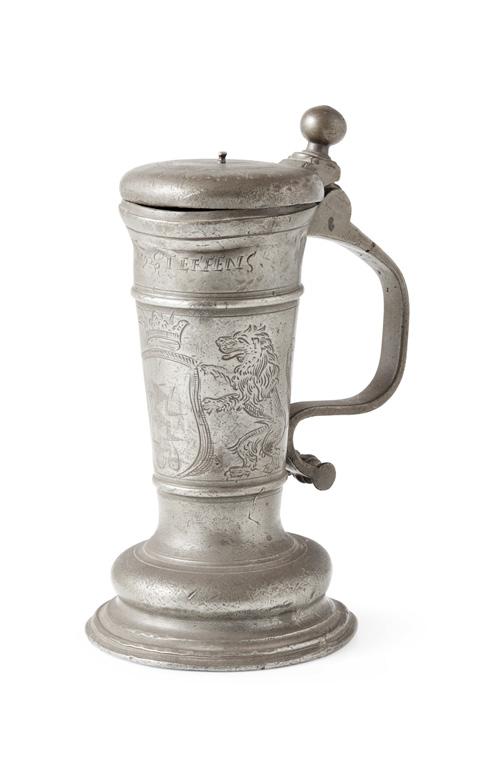
LATE 17TH CENTURY
the hinged cover engraved with a timekeeping dial and knopped thumbpiece, above a tapered body bearing an armorial and inscribed D. O. HINRICH 1692 STEFFENS, with a scrolled handle and terminating on a circular bulbous moulded foot
19cm high
£250-350
180
479
LARGE BAROQUE STYLE BRASS CHANDELIER OF RECENT MANUFACTURE
with a central baluster stem terminating in a loop pendant finial and issuing eight C scroll arms with electrified candle sockets and wide drip pans, with cream pleated shades

100cm diameter, 80cm drop
£300-500
480
CAST IRON COPY OF HENRY II OF FRANCE’S PARADE ARMOUR SHIELD
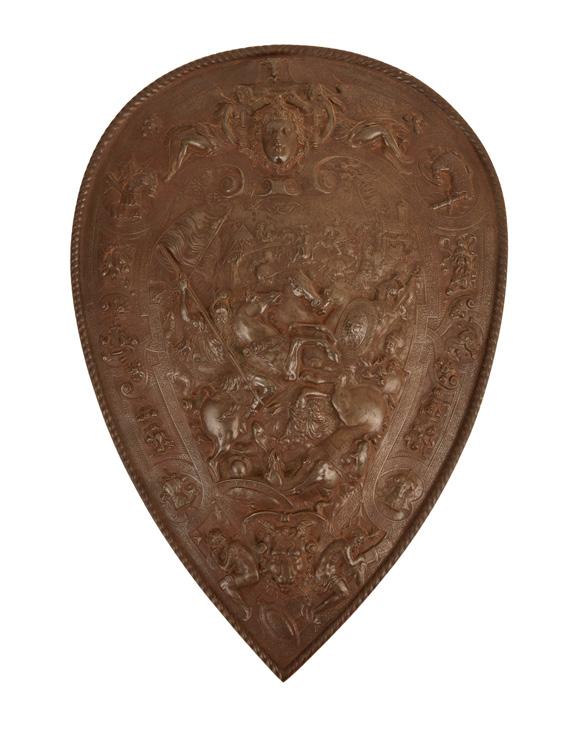
GERMANY, LATE 19TH CENTURY
after a design by Étienne Delaune, the reverse stamped ‘Gesetzlich geschützt’, numbered 3944 and with a mark of crowned crossed hammers
45cm wide, 64cm high, 7cm deep
Note: The original, circa 1555, is in the collection of the Metropolitan Museum of Art, New York
£300-500
481
FLEMISH WALNUT AND NEEDLEWORK
UPHOLSTERED OPEN ARMCHAIR
17TH CENTURY
the arch back and [padded seat in gros and petit point needlework flanked by continuous scrolling arms, raised on scrolled legs joined by a wavy front stretcher and scrolling H-form stretcher
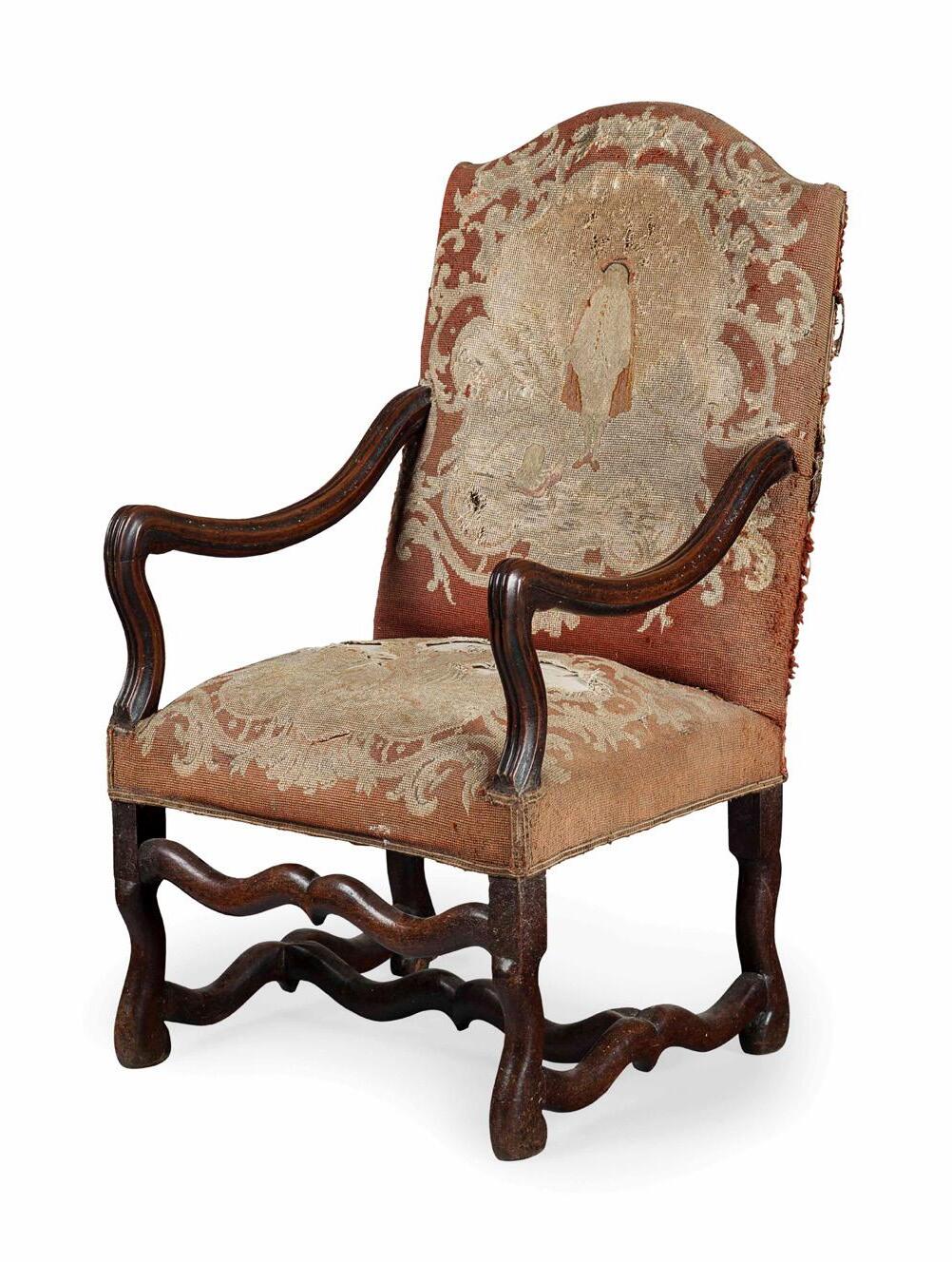
61cm wide, 112cm high, 48cm deep
£500-800
482
FLEMISH OAK, WALNUT AND EBONISED INLAID LINEN PRESS
LATE 17TH/ EARLY 18TH CENTURY
in two parts, the upper section with a crossbar surmounted by three finials above a screw mechanism and drawer; the base with a further drawer and scroll carved pierced brackets, raised on bulbous baluster legs joined by an undertier
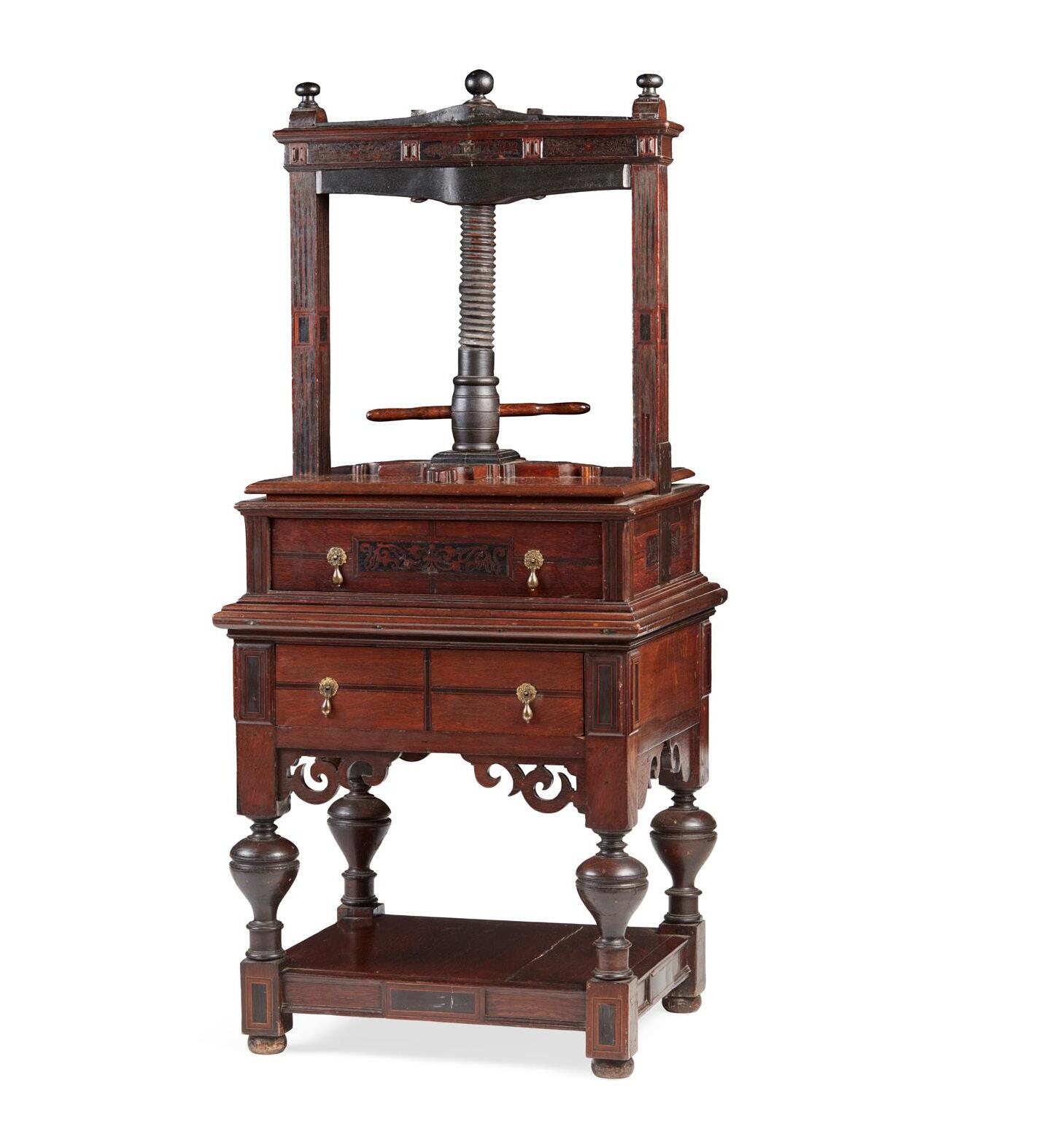
69cm wide, 158cm high, 60cm deep
£400-600
181 Other fees apply in addition to the hammer price: see the ‘Buyer’s Guide’ section on page 2
483 Y
ITALIAN MILANESE EBONY AND IVORY INLAID CENTRE TABLE, IN THE MANNER OF FERDINANDO POGLIANI

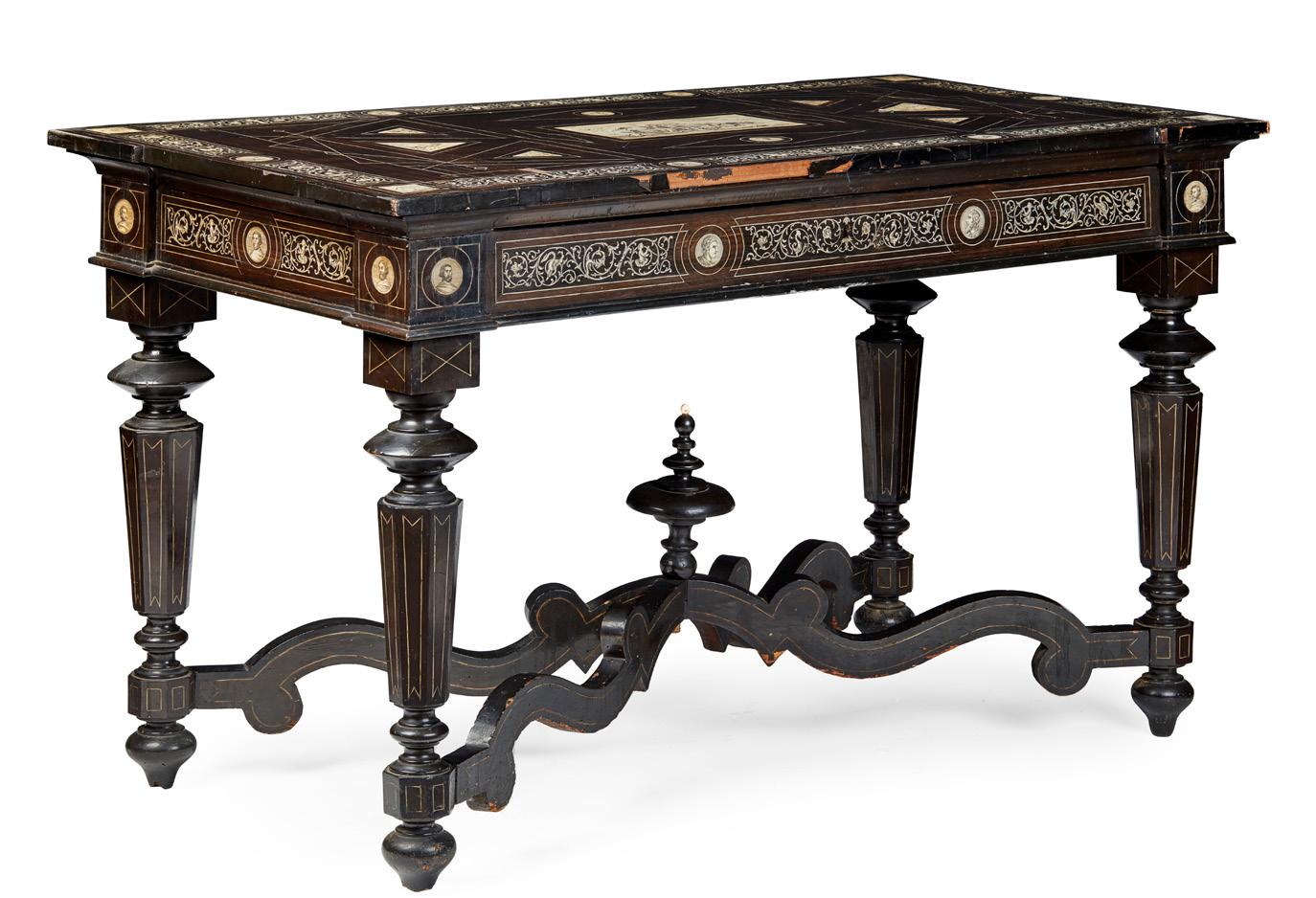
LATE 19TH CENTURY
the top inlaid with a central panel depicting Poseidon and Amphitrite with further smaller panels of putto, inlaid further with portrait roundels of famous artists, writers, and scholars within a scrolling border of arabesques, putti and griffins; above a frieze with corresponding ivory inlay and a long drawer, marked with further portrait roundels, raised on knopped facetted and tapered legs joined by a scrolling X stretcher centred by an urn finial
132cm wide, 80cm, 70cm high
Note: Sold in compliance with UK Government and APHA regulations, with (non-transferable) exemption registration reference FJ2U77W9
£800-1,200
484 PAIR OF RENAISSANCE REVIVAL EBONISED ARMCHAIRS

MID 19TH CENTURY
the part-padded backs with pierced and carved crest rails with female masks amongst foliate scrolls, flanked by turned and lobed supports, above stuffover seats and part-padded arms with carved lion head terminals, over foliate carved aprons and raised on lobed tapering legs with ceramic castors, in wine red velvet upholstery (2) 70cm wide, 143cm high, 60cm deep
£800-1,200
182
485
ITALIAN FLORENTINE FRAME MIRROR
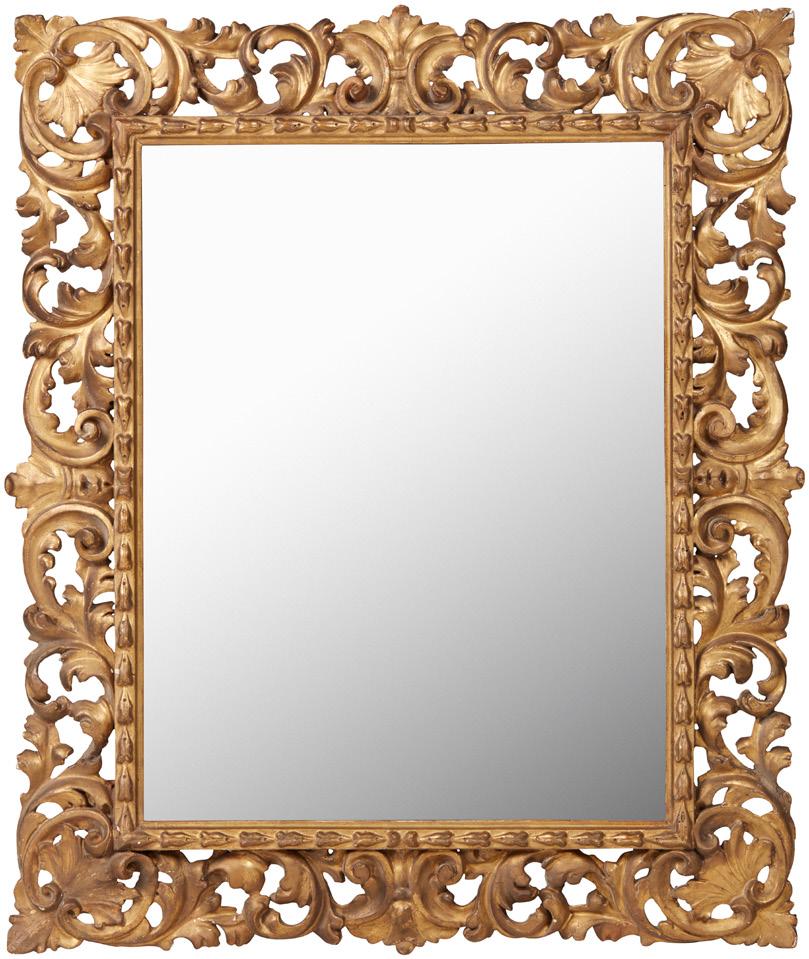
19TH CENTURY
the rectangular mirror plate in pierced and carved scrolling foliate frame 95cm high, 80cm deep
£400-600
486
PAIR OF VERDIGRIS PATINATED BRONZE CANDLESTICK LAMPS
19TH CENTURY WITH LATER PATINATION
with hexagonal-rimmed nozzles, above panelled and knopped stems, on hexagonal bases, with taupe pinchpleated shades; fitted for electricity (2) 12cm diameter, 38cm high £600-800
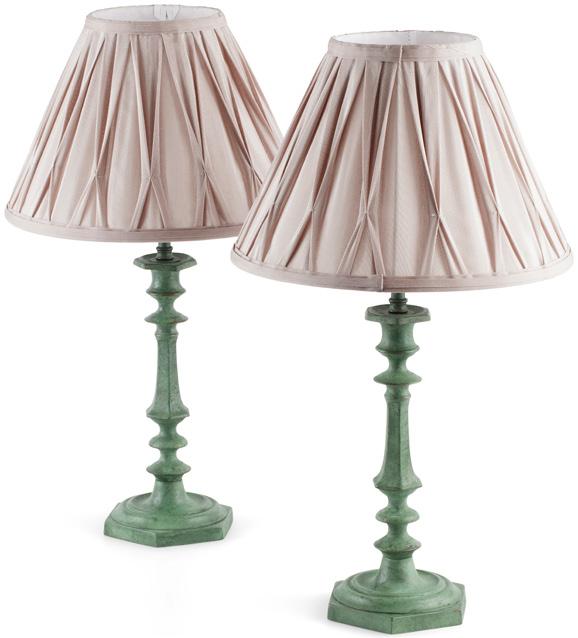
487
MINIATURE ITALIAN NEOCLASSICAL WALNUT AND FRUITWOOD PARQUETRY COMMODE

EARLY 19TH CENTURY
the quarter-veneered top and sides with strung borders, above two long drawers flanked by angles and raised on square tapered legs
31cm wide, 24.5cm high, 15cm deep
Provenance: Newton Don, Kelso; Harrietfield, Kelso; and thence by descent
£200-300
488
ITALIAN GILTWOOD AND PAINTED MARBLE TOPPED GUERIDON
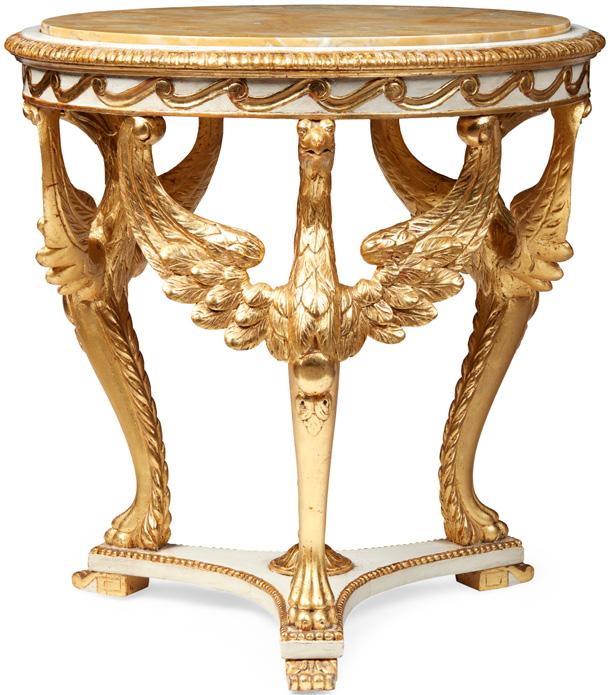
19TH CENTURY
the circular yellow marble insert top in a gadrooned moulded border above a Vitruvian scroll frieze, raised on carved eagle monopodia and concave tripartite base
57cm high, 58cm diameter
£400-600
489
PAIR OF NORTH ITALIAN GILTWOOD BERGÈRES
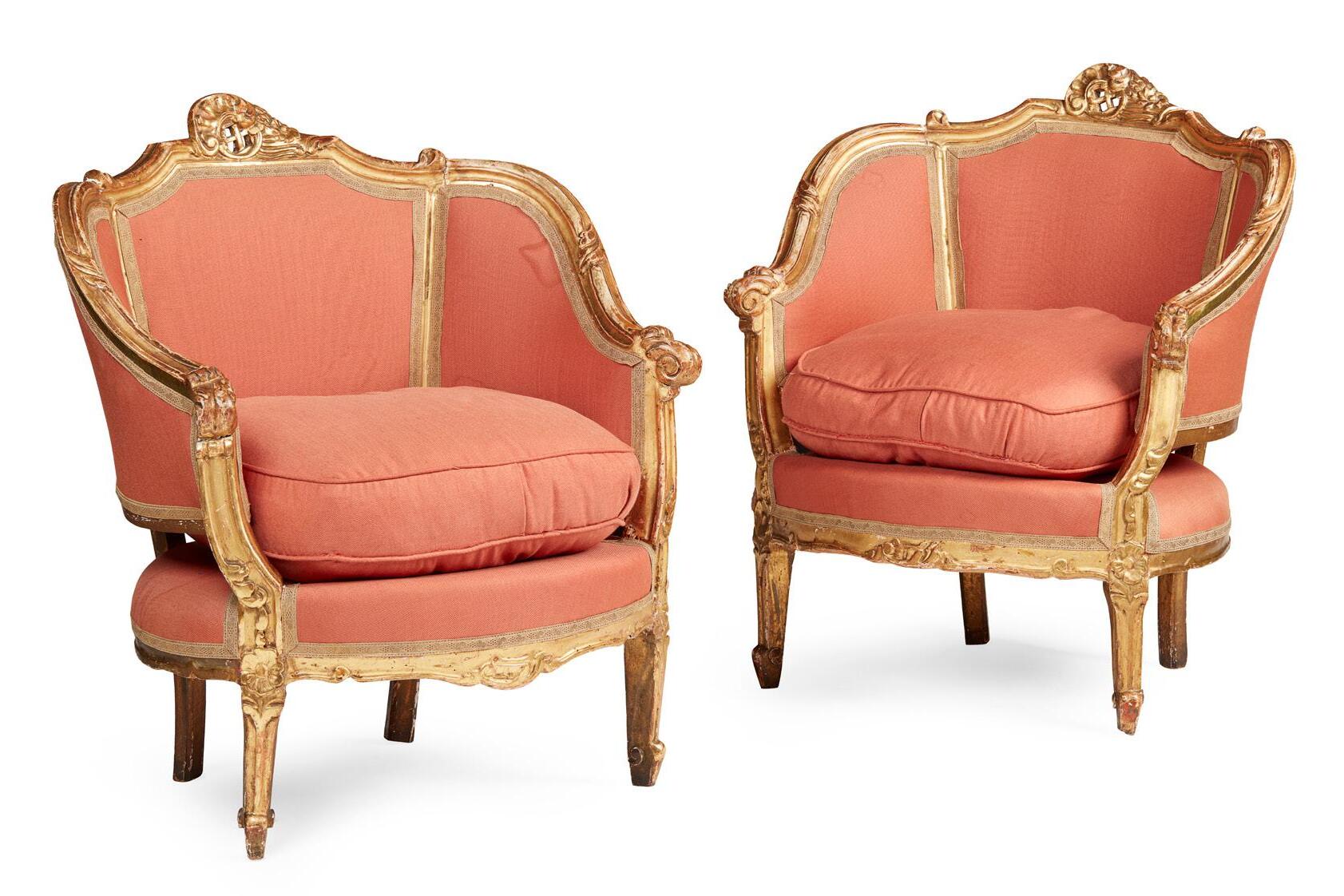
19TH CENTURY
the channel moulded frames carved with acanthus, flower heads, and a pierced centre cresting, above deep loose cushion seats raised on square tapered legs ending in scrolled toes, covered in salmon pink upholstery (2) 81cm, 94cm high, 58cm deep £600-800
183 Other fees apply in addition to the hammer price: see the ‘Buyer’s Guide’ section on page 2
490
COLLECTION OF DELFT BLUE AND WHITE TILES
18TH CENTURY
decorated with biblical scenes within a roundel, the corners with stylised foliate motifs, depicting scenes including Christ visited by the Devil with a request to turn stone into bread, Lazarus rising from the dead, the crucifixion, Peter walking on water, Christ in the home of Martha and Mary, and Christ’s resurrection (20)
approximately 13cm x 13cm (5” x 5”)
£300-500
491
COLLECTION OF DELFT BLUE AND WHITE TILES

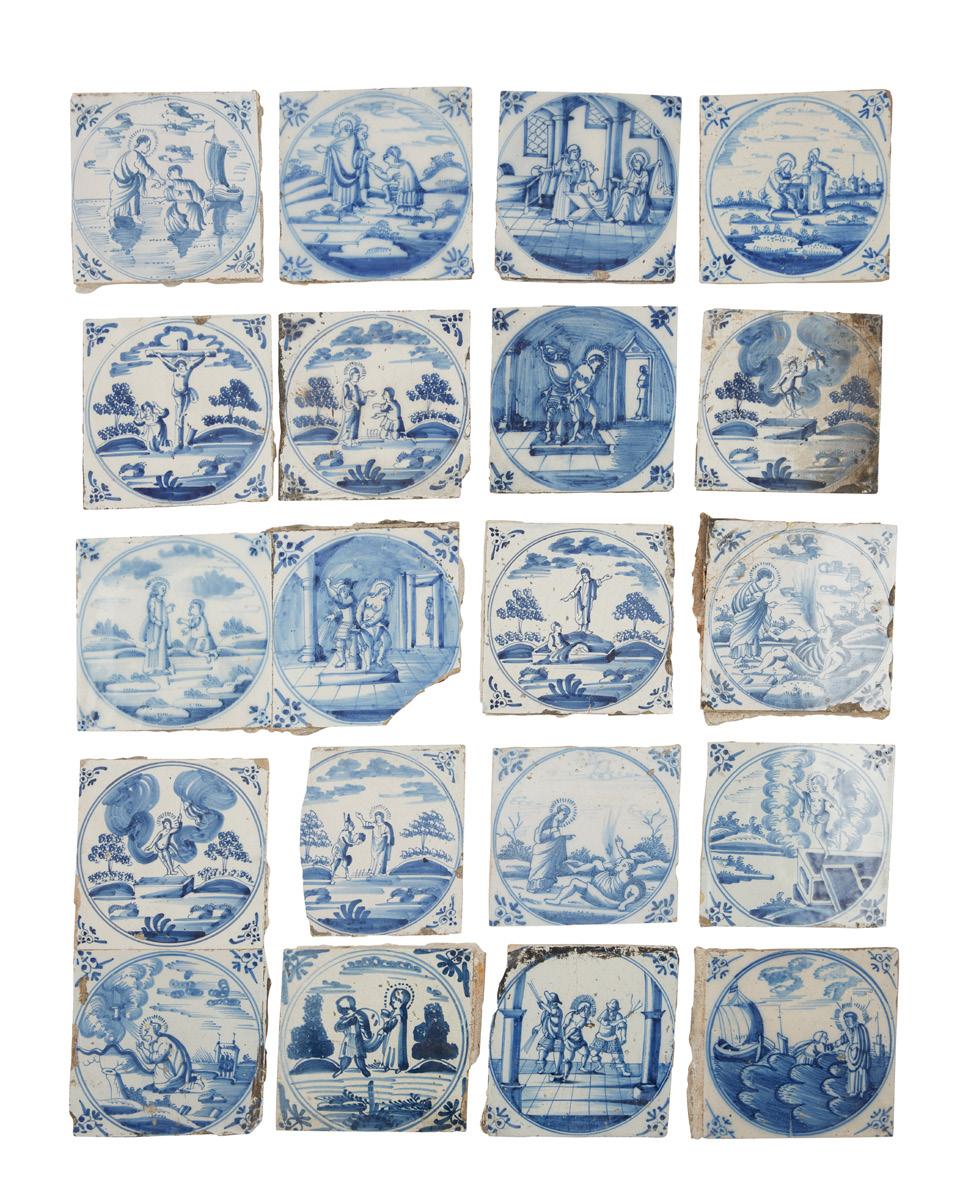
18TH CENTURY
all painted with religious scenes within a roundel, the corners with stylised foliate motifs, including scenes such as Zacchaeus up a tree, Peter walking on water, the Judas kiss, and Jesus washing his disciples’ feet (21) approximately 13cm x 13cm (5” x 5”)
£300-500
492
DELFT TILE PICTURE OF A SEATED CAT
LATE 18TH CENTURY
composed of four tiles painted in blue depicting a cat with an arched back and long thin tail seated amongst foliage, in a modern frame panel 25cm wide, 25cm high; overall 31cm wide, 31cm high £400-600
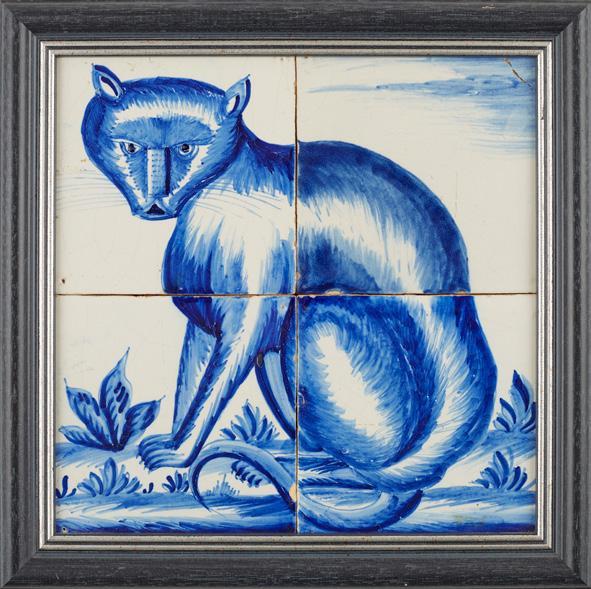
493
PAIR OF FLEMISH WALNUT SIDE CHAIRS
LATE 17TH CENTURY
the moulded arched tops with a shell detail over a vertical moulded panel with dyed leather inserts and drop-in seats, raised on square cabriole legs joined by turned H-form stretchers; one with fuchsia leather, the other orange (2)

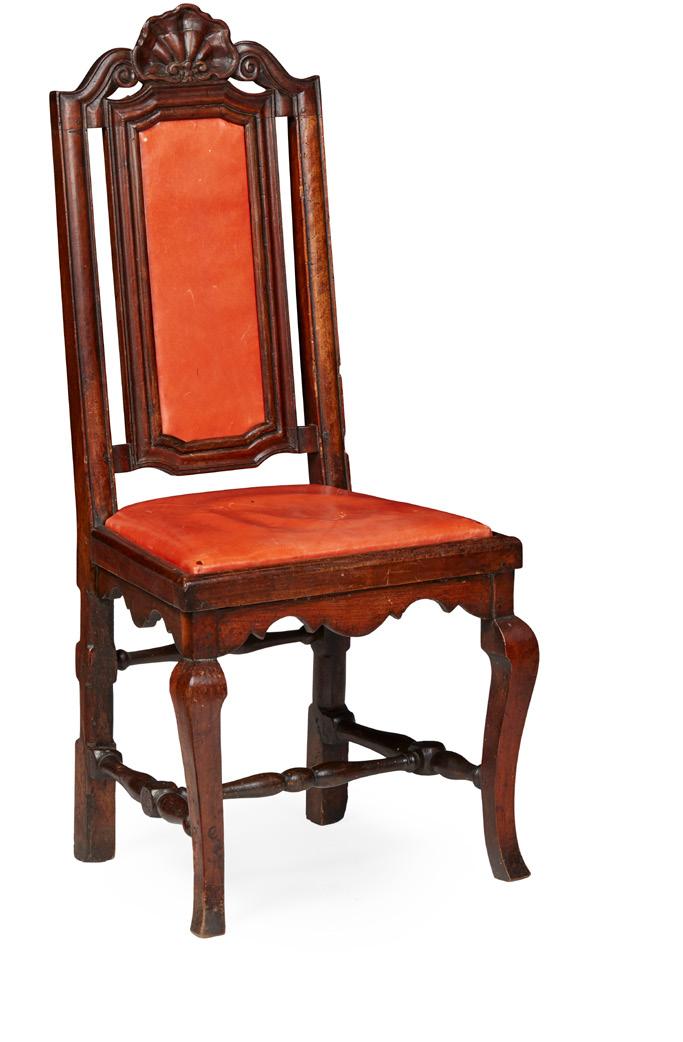
51cm wide, 113cm high, 42cm deep
£500-700
184
496
DUTCH
MARQUETRY BOMBÉ BUREAU
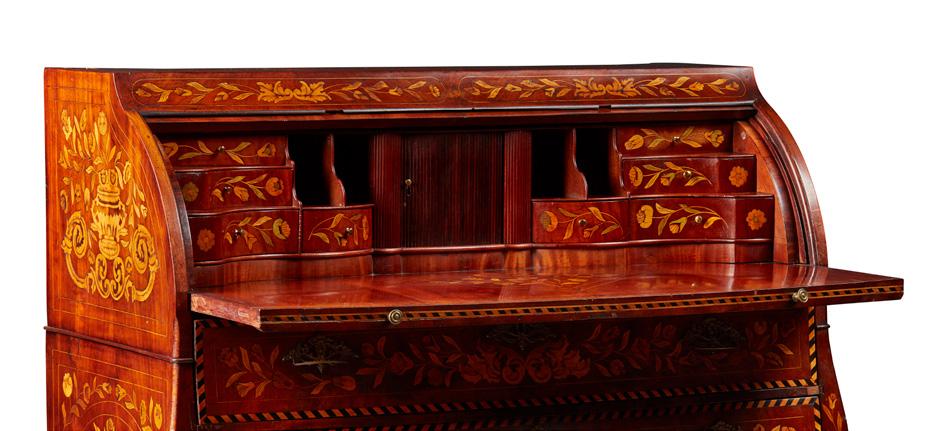

EARLY 19TH CENTURY
in two parts, the cylinder top opening to an arrangement of pigeon holes and drawers, the lower part with three bombé long drawers, raised on splayed bracket feet, the whole covered with flowering urn and flower garland marquetry
125cm wide, 114cm high, 57.5cm deep
£2,000-3,000
494 SMALL DUTCH WALNUT AND MARQUETRY SIDE
TABLE
19TH CENTURY
the demilune top with flowering urn and bird marquetry, above a single frieze drawer and raised on square tapered legs all with further floral marquetry



51.5cm wide, 73cm high, 29.5cm deep
Provenance: Private Scottish Collection, Morayshire
£300-500
495
DUTCH
WALNUT BOMBÉ CABINET
18TH CENTURY
the arch moulded cornice centred by a carved shell motif, above a pair of quarter-veneered and moulded doors opening to a shelved interior with three short drawers; the base with two short over three long drawers flanked by canted angles, raised on shaped bracket feet
184cm wide, 255cm high, 64cm deep
£1,500-2,500
185 Other fees apply in addition to the hammer price: see the ‘Buyer’s Guide’ section on page 2
497
PAIR OF DUTCH DELFT POLYCHROME BOUGH POTS
LATE 19TH CENTURY/ EARLY 20TH CENTURY each of faceted flared form, painted with an arrangement of mixed flowers above a scallop shell on a fish scale ground, the decoration within c-scroll borders with further floral embellishment, the top with a D-shaped aperture and further pierced holes; the base with painted HB initials (2)
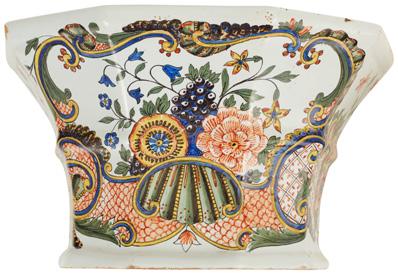
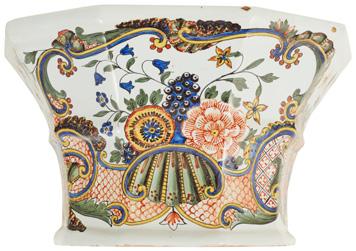
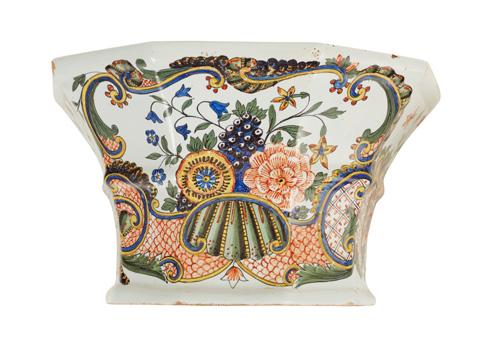
14cm high, 24cm wide
£250-350
498
GERMAN BLACK FOREST CARVED AND POLYCHROMED STAG’S HEAD AND ANTLERS
18TH CENTURY
the carved head polychromed and set with a pair of real stag antlers, mounted on a leaf carved shield

75cm wide, 100cm high, approx.
£600-800
499
LARGE PAIR OF DUTCH COMMEMORATIVE ENAMELLED GLASS DECANTERS AND STOPPERS
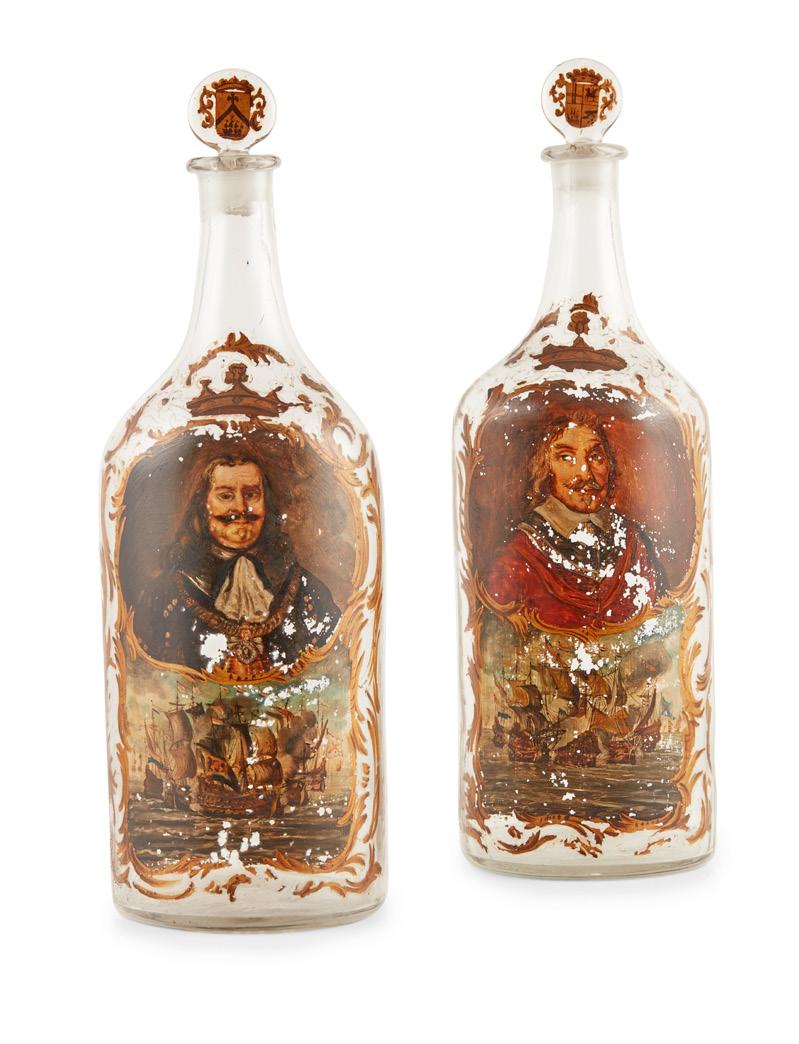
LATE 18TH/ EARLY 19TH CENTURY
of flattened back form; one painted with a portrait of Michiel Adriaenez de Ruyter, above a naval battle scene, possibly the Battle of Solebay; the other painted with a portrait of Admiral Maarten van Tromp, above a naval battle scene, probably the Battle of Downs; each with a round, flattened stopper enamelled in gilt with a shield and coronet (2)
55cm high
Provenance: Purchased from Howard Phillips Antique Glass, 11a Henrietta Place, London, October 1975
£700-1,000
500
DUTCH NEOCLASSICAL WALNUT, FRUITWOOD, AND MARQUETRY CORNER CABINET
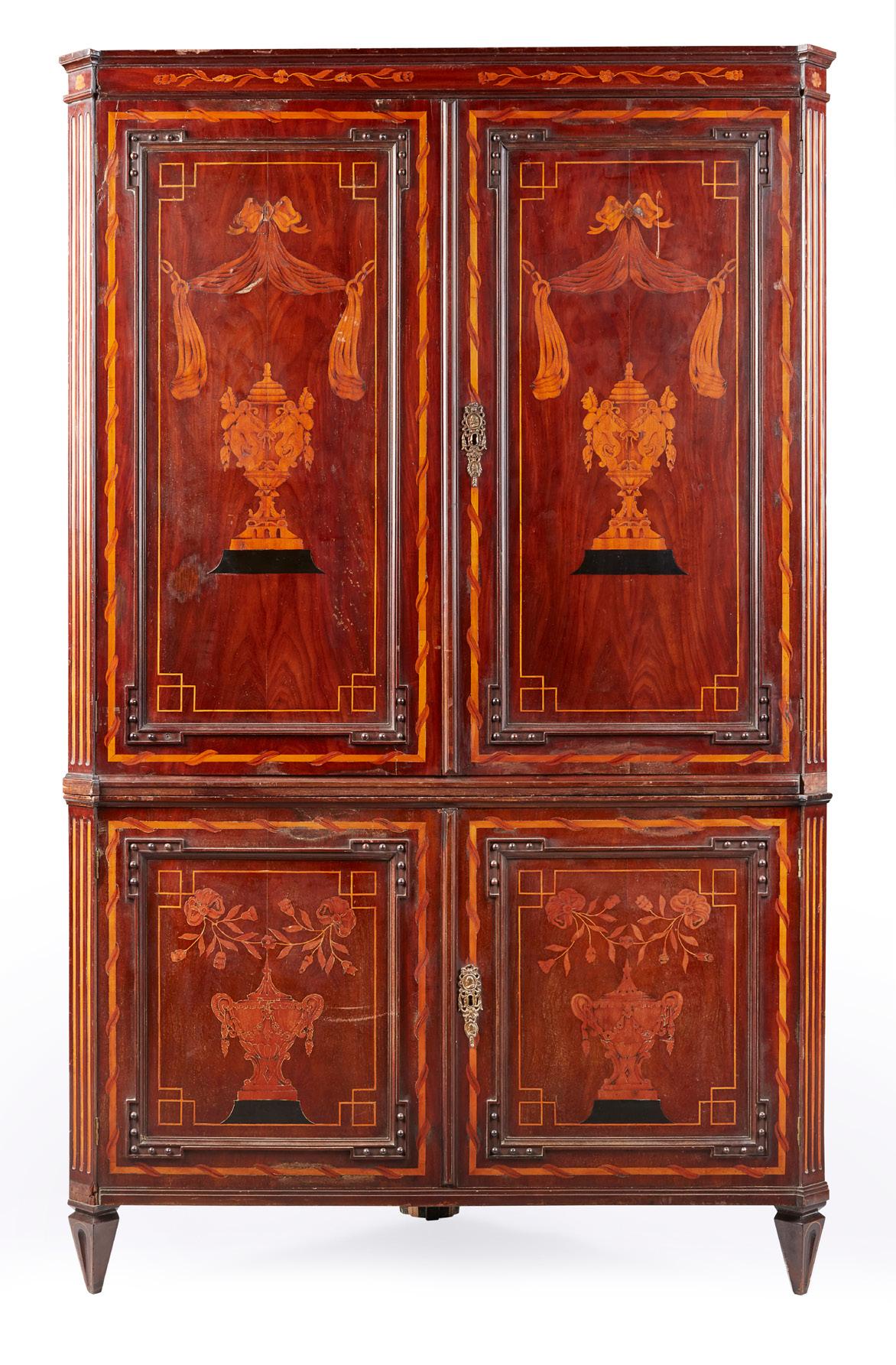
19TH CENTURY
the upper part with a pair of panel doors with urn and drapery swag marquetry, opening to shaped shelves and three short drawers; the lower part with a pair of doors with matching urn and flower marquetry and enclosing a further shaped shelf, all flanked by fluted angles and raised on tapered square feet
127cm wide, 205cm wide, 58cm deep
£1,000-1,500
186
501
DUTCH STYLE BRASS SIX-LIGHT CHANDELIER
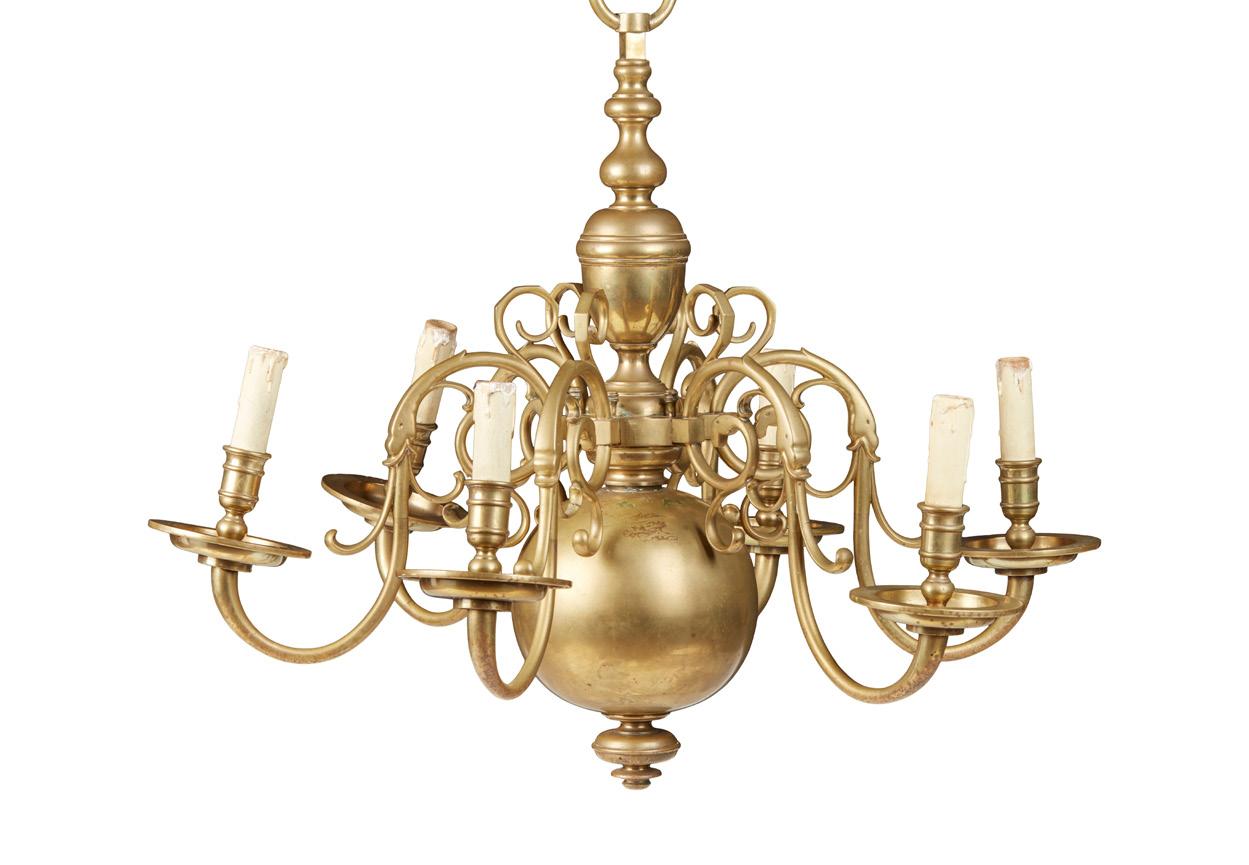
EARLY 20TH CENTURY
the knopped baluster body issuing six scrolled candle arms with candle nozzles and drip pans, wired for electricity
81cm diameter, 70cm drop
£400-600
502
UNUSUAL DUTCH REPOUSSÉ BRASS AND MIRRORED SECRÉTAIRE À ABATTANT
LATE 19TH CENTURY
the three-quarter brass gallery above a frieze with putti at play over a fall front depicting a hunting scene with an indistinct signature, opening to an interior fitted for writing, over three long drawers, on a projecting base, the remaining surfaces covered in repousse brass panels with urns, dolphins, and fruiting vines, on bun feet
78cm wide, 143cm high, 45cm deep
£400-600
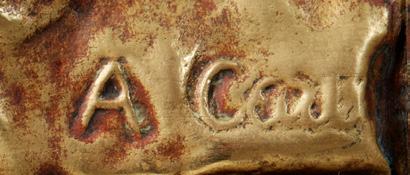
503
DUTCH MARQUETRY BOWFRONT CORNER CABINET
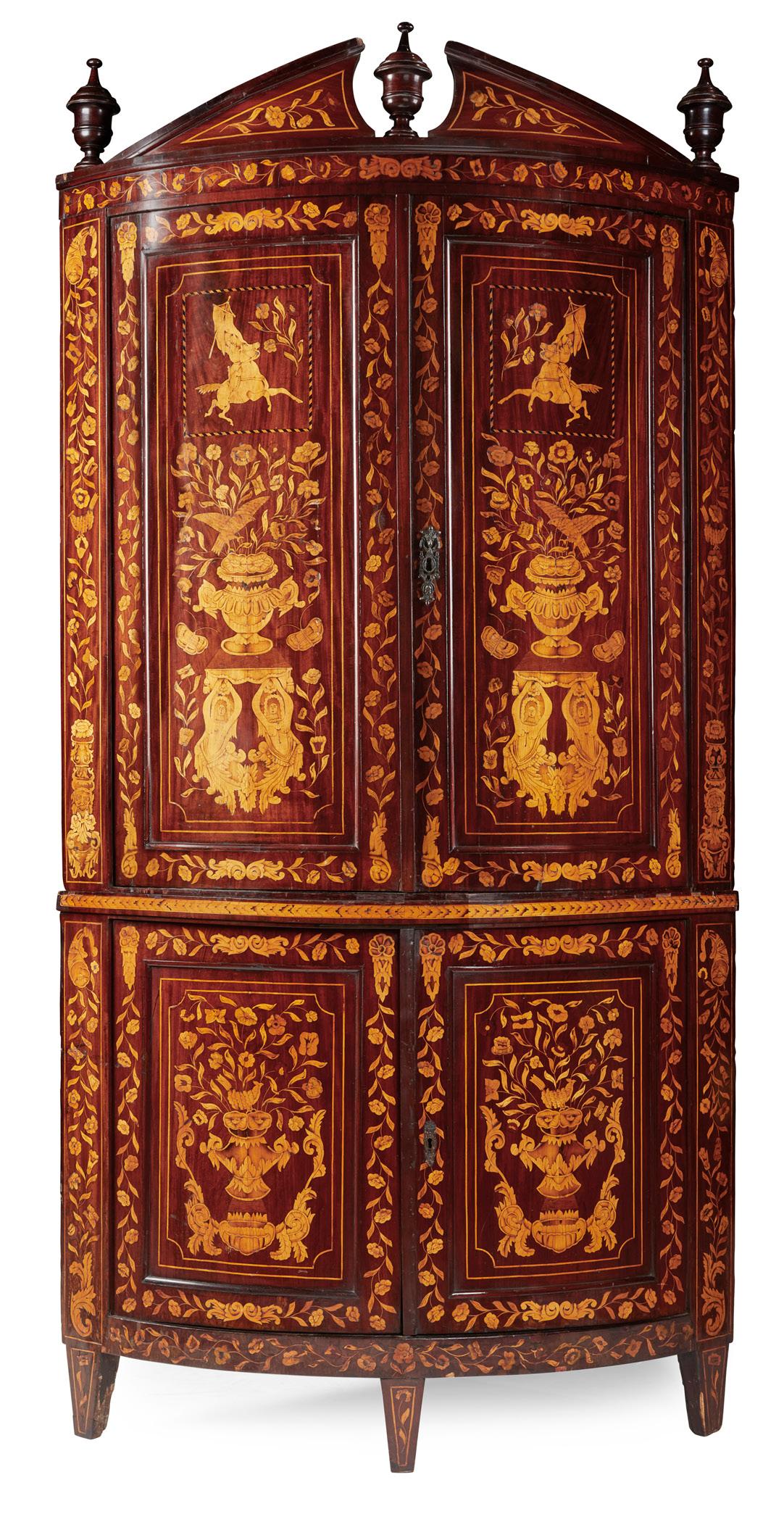

EARLY 19TH CENTURY
the broken arch pediment with urn finials above a pair of recessed panel doors, on a base with two further doors, opening to a black painted shelved interior, all profusely inlaid with flowering urns, equestrian figures, cornucopias, flower trails and foliate scrolls, raised on square tapered feet
123cm wide, 253cm high, 68cm deep
£2,500-3,500
187 Other fees apply in addition to the hammer price: see the ‘Buyer’s Guide’ section on page 2
504
FRENCH EBONY, EBONISED, AND BRONZE DISPLAY CABINET-ON-STAND
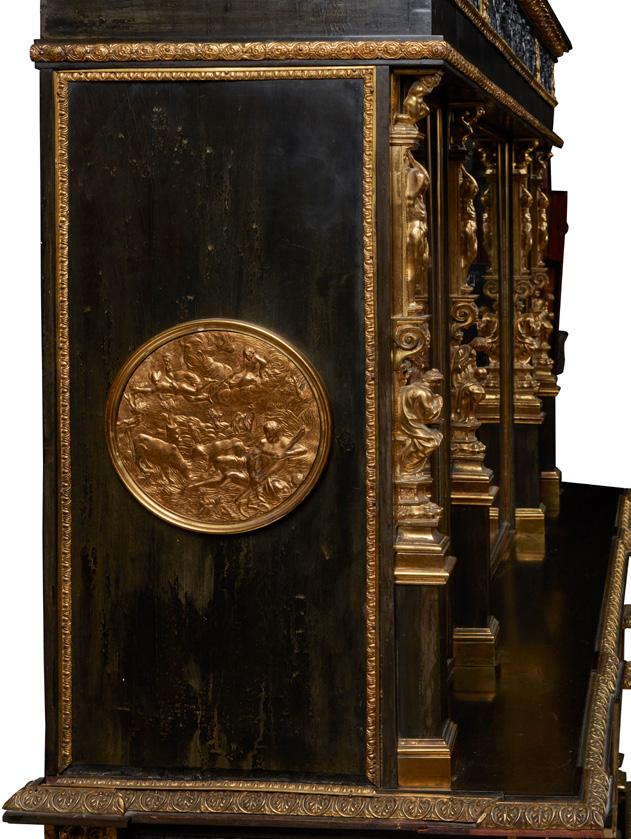
MID 19TH CENTURY
In the Louis XIV style, the top with a relief bronze frieze depicting tribute bearing classical figures divided by gilt bronze Green Man masks, above glazed bronze doors flanked and divided by figural pilasters, enclosing red velvet lined shaped shelves; the base with three drawer with further relief bronze panels depicting ribbon-tied garlands, cornucopias, hippocamps and putti, raised on square tapered legs united by twin undertiers, on gilt toupie feet
154cm wide, 181cm high, 58cm deep £2,500-3,500
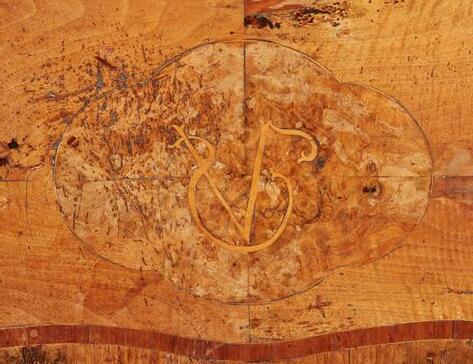
505
SOUTH GERMAN WALNUT, FRUITWOOD, PARQUETRY AND MARQUETRY SERPENTINE COMMODE
18TH CENTURY
the crossbanded top centred by a cartouche bearing the monogram ‘CV’, above three long drawers with parquetry and foliate inlay, raised on bun feet 126cm wide, 83cm high, 62cm deep £1,500-2,500
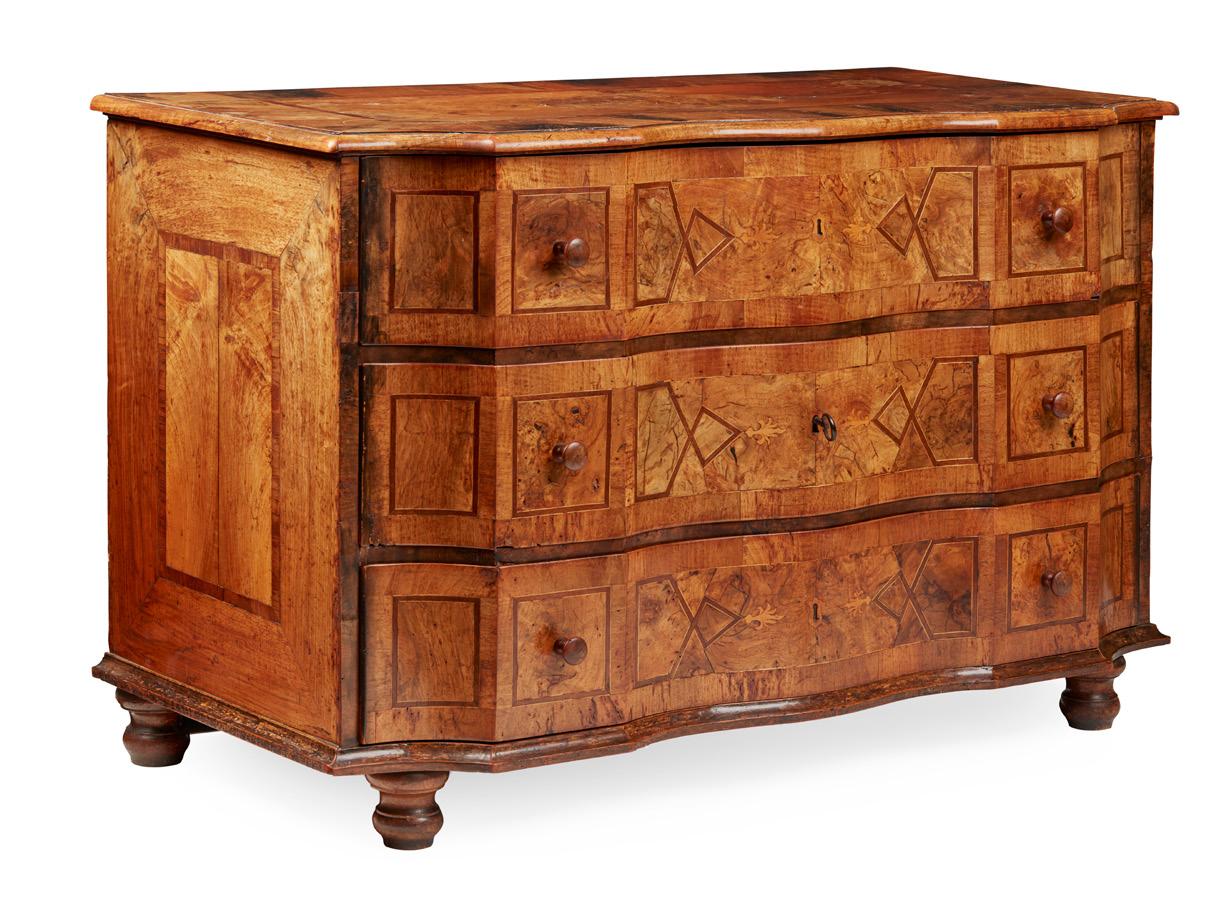
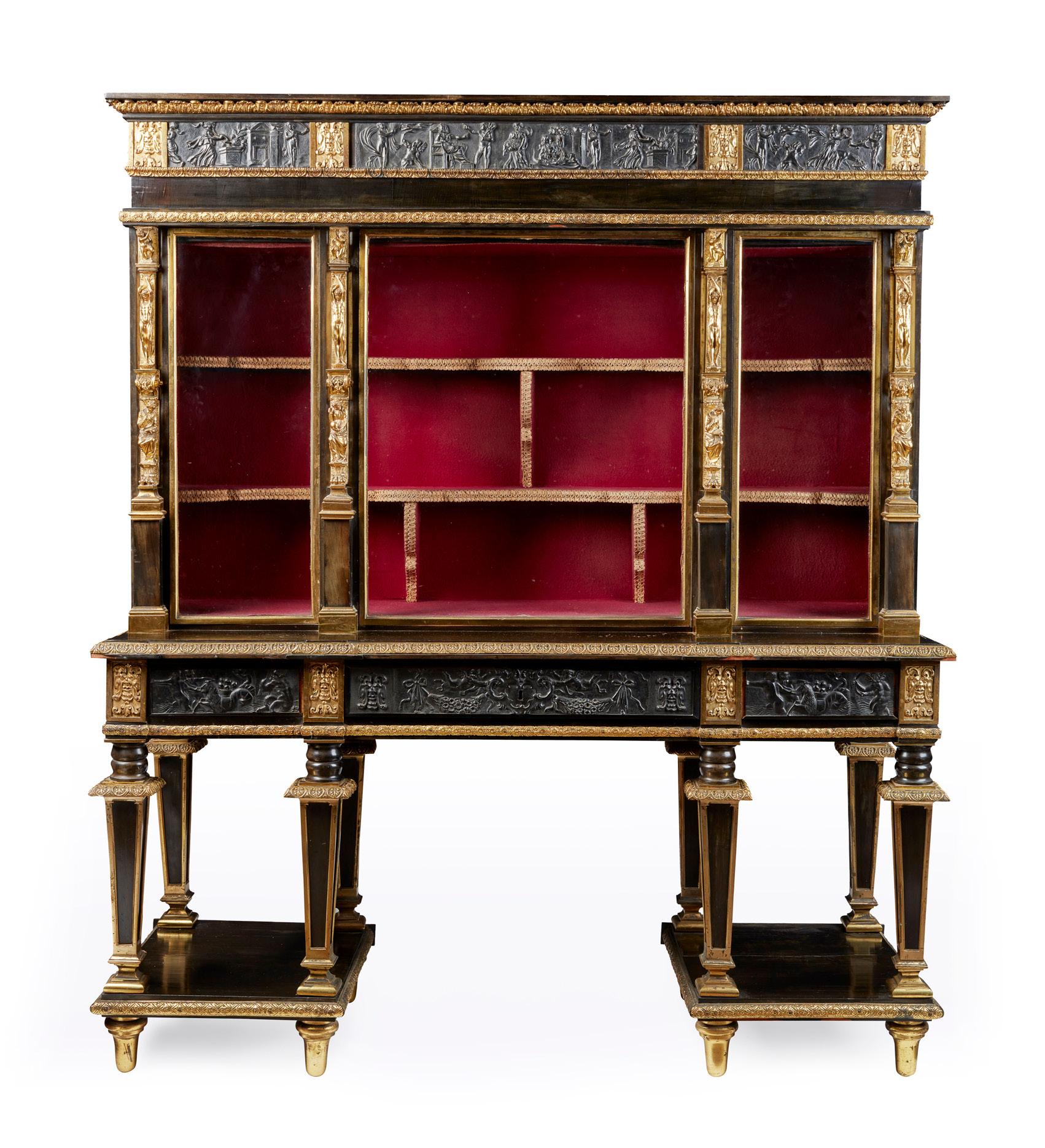
188 Other fees apply in addition to the hammer price: see the ‘Buyer’s Guide’ section on page 2
506
GILT AND PATINATED BRONZE GRECIAN STYLE LAMP
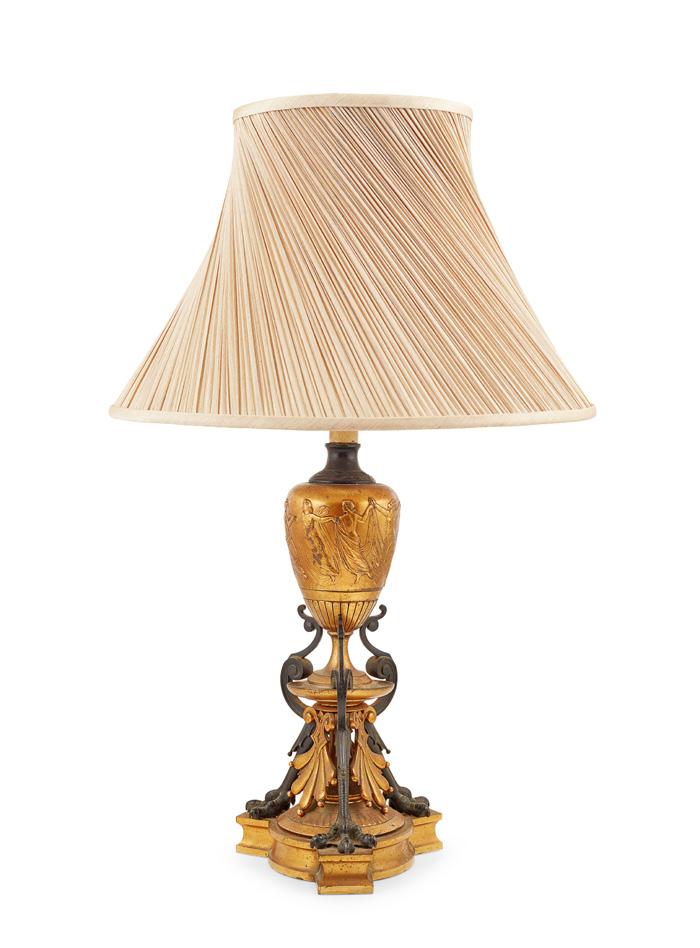
19TH CENTURY
the urn body with a relief band of dancing nymphs, supported on scrolling legs with claw feet united by palmettes, on a tripartite base, converted to electricity, with a spiral pleated taupe shade
16cm diameter, 37cm high (excluding fitting)
£300-500
507
PAIR OF LOUIS XV WALNUT AND NEEDLEWORK FAUTEUILS

MID 18TH CENTURY
the cartouche shaped backs over wide stuffover seats and part-padded arms ending in scrolled hand holds, raised on cabriole legs, in blue, green and cream needlework verdure tapestry style upholstery (2)
59cm wide, 84cm high, 48cm deep
Provenance: Ex. Roger de Rin, 76 Royal Hospital Road, London, SW3 4HN, over an older dealer label
£600-800
508
FRENCH TRANSITIONAL STYLE
KINGWOOD, PARQUETRY, AND PARCEL
GILT MARBLE TOPPED COMMODE
LATE 19TH CENTURY
the serpentine rouge marble top with a moulded edge, above four serpentine drawers flanked by fluted angles, on a shaped apron and raised on bracket feet with gilt bronze mounts
82cm wide, 91cm high, 42cm deep
Provenance: Private Scottish Collection, Morayshire
£400-600
509
FRENCH RÉGENCE WALNUT COMMODE

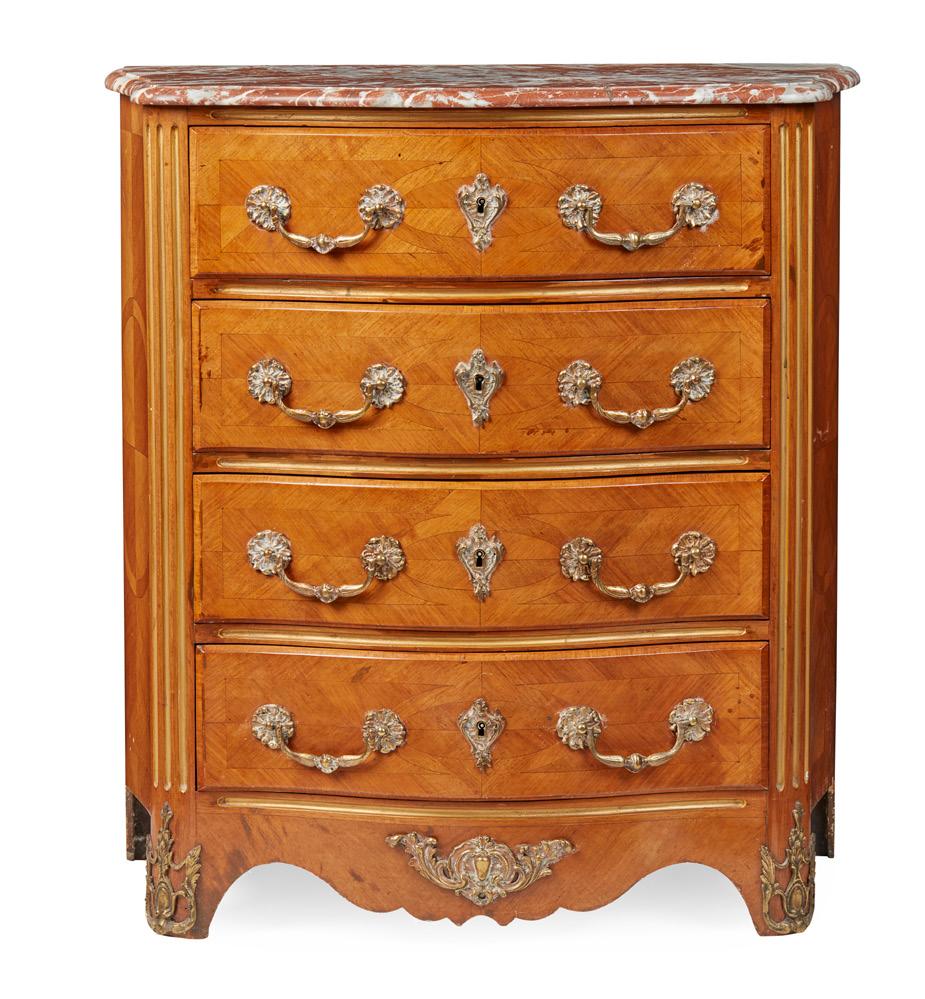
18TH CENTURY
the serpentine top with a moulded edge above two long deep drawers with moulded panels, above a shell and foliate carved apron and raised on cabriole legs
128cm deep, 94cm high, 66cm deep
£800-1,200
189
510
PAIR OF FRENCH GILTWOOD PIER MIRRORS
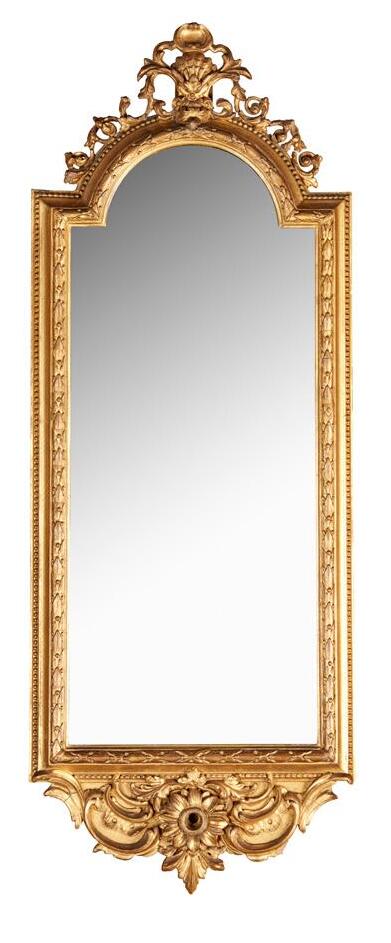

19TH CENTURY
the break arch mirror plates within laurel moulded frames surmounted by pierced scroll and shell pediments (2)
86cm high, 32cm wide
£400-600
511 Y
FRENCH KINGWOOD, ROSEWOOD, AND PORCELAIN MOUNTED WORK TABLE
19TH CENTURY
the quarter veneered and banded top centred by a porcelain plaque with a putto, opening to a void interior with a mirror and removable tray, above a sliding work box and raised on cabriole legs all banded in gilt metal mounts and ending in sabots
512
LOUIS XV STYLE KINGWOOD AND AMARANTH MARQUETRY BOMBÉ COMMODE

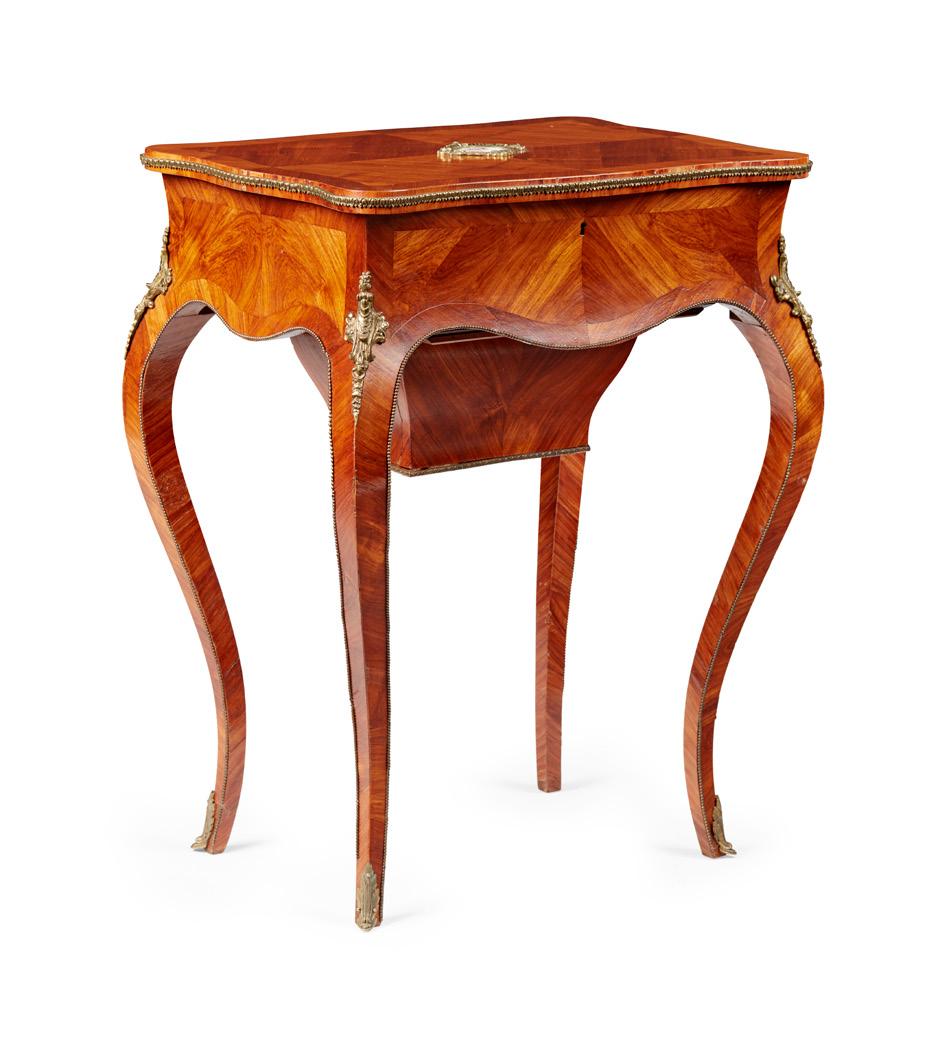
19TH CENTURY
of small size, the serpentine rouge marble top with a moulded edge above three long drawers with floral marquetry, raised on slender cabriole legs with gilt bronze mounts

70cm wide, 87cm high, 39cm deep
Provenance: Private Scottish Collection, Morayshire
£300-500
513
CONTINENTAL GILTWOOD AND POLYCHROMED SLATE CONSOLE TABLE
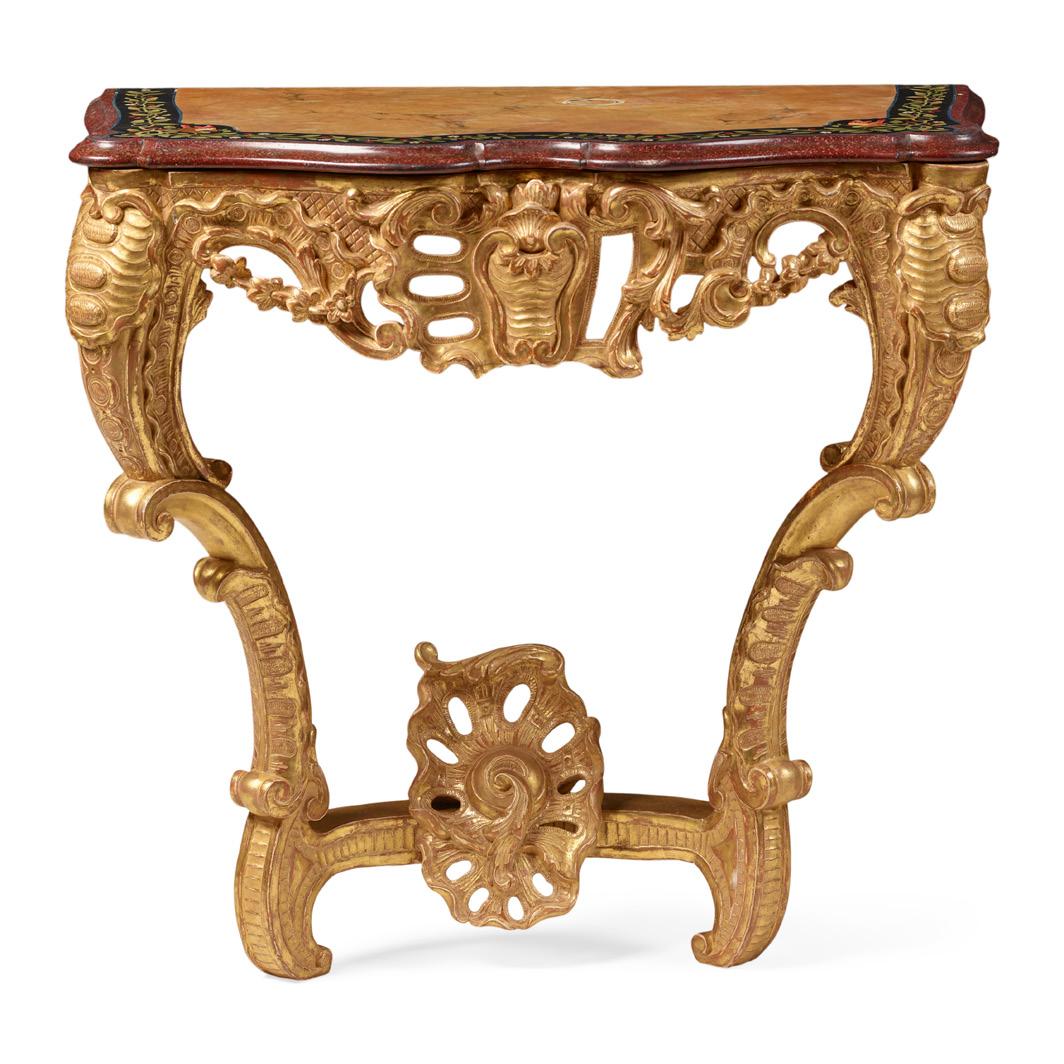
18TH CENTURY
the serpentine slate top painted to simulate porphyry, siena marble, with a pietra dura border, on a rococo giltwood base with a pierced apron raised on C scroll legs joined by a stretcher with a large shell motif
82cm wide, 83cm high, 51cm deep
£800-1,200
190
514
PAIR OF FRENCH PAINTED PORCELAIN LAMPS
LATE 19TH CENTURY
of guglet form with pastel pink porcelain bodies painted with floral and gilt decoration, with pierced gilt metal moderator oil lamp mounts later converted to electricity (2)
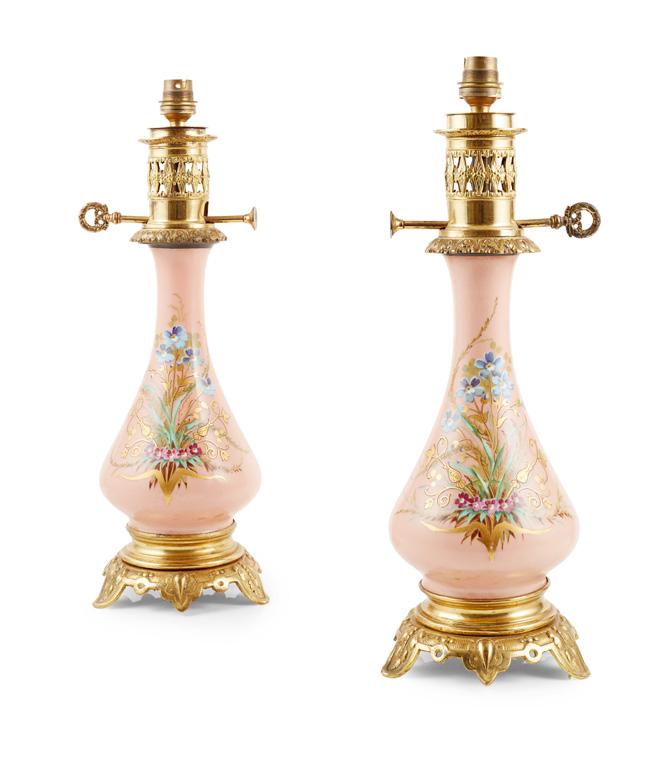
13cm in diameter, 43cm high
£300-500
516
FRENCH KINGWOOD AND MARQUETRY BUREAU DE DAME 19TH CENTURY
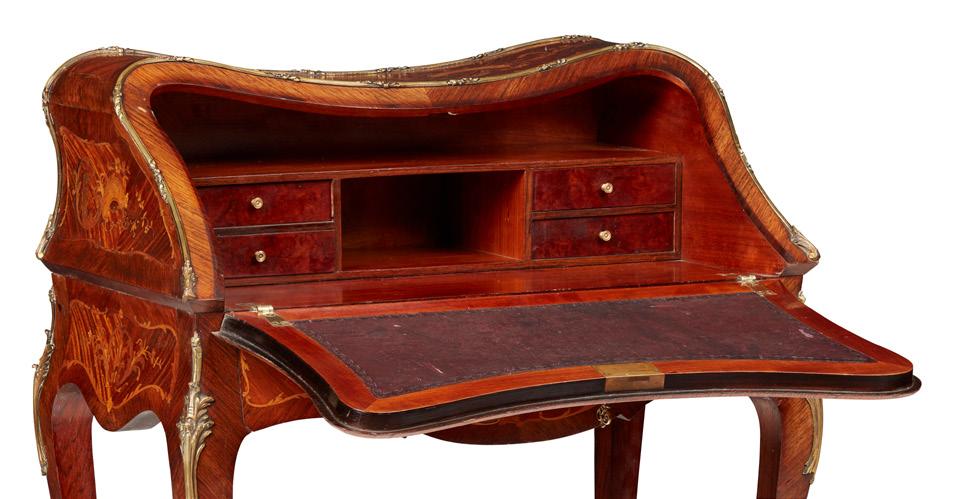
in the Louis XV style, the slant front with flower and foliate scroll marquetry, opening to a fitted interior, above a long frieze drawer bearing a brass trade label for S & H Jewell
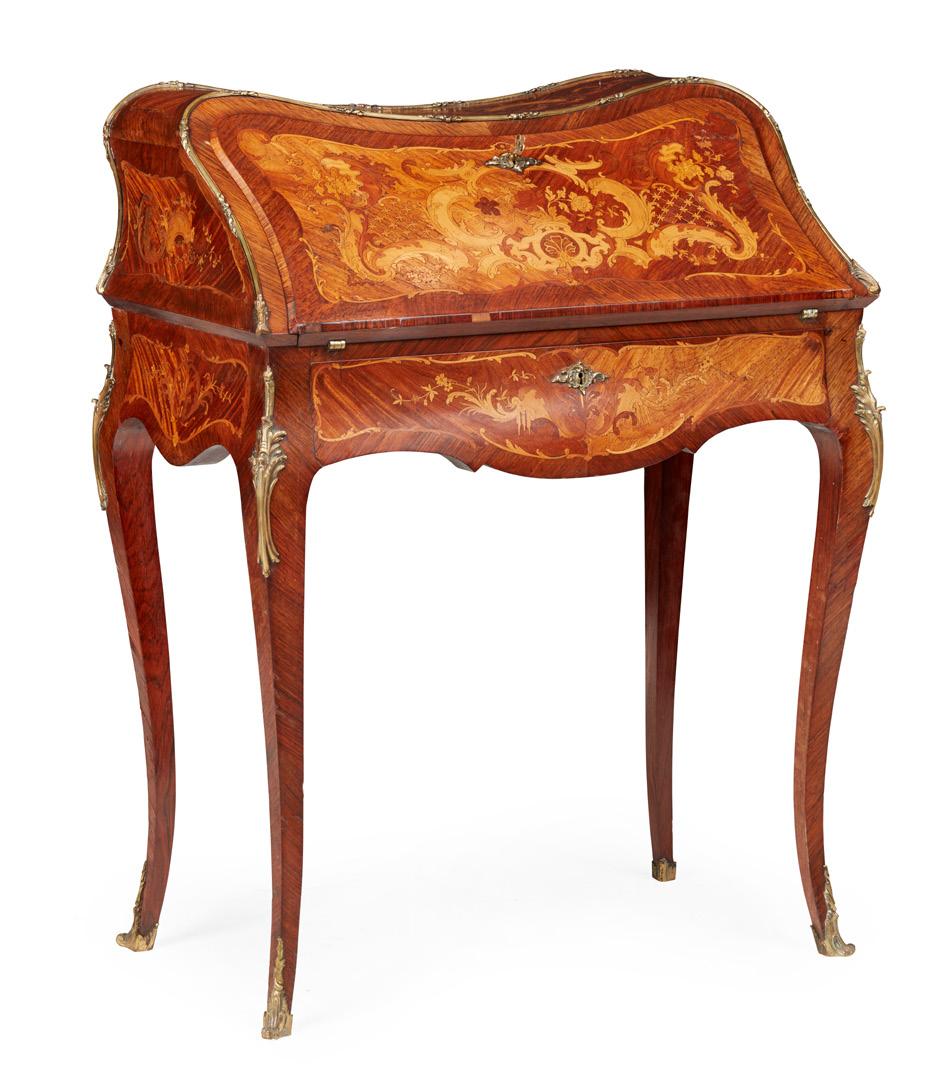
79cm wide, 102cm high, 46cm deep
£1,200-1,800
515
FRENCH KINGWOOD, PARQUETRY AND MARQUETRY DISPLAY CABINET
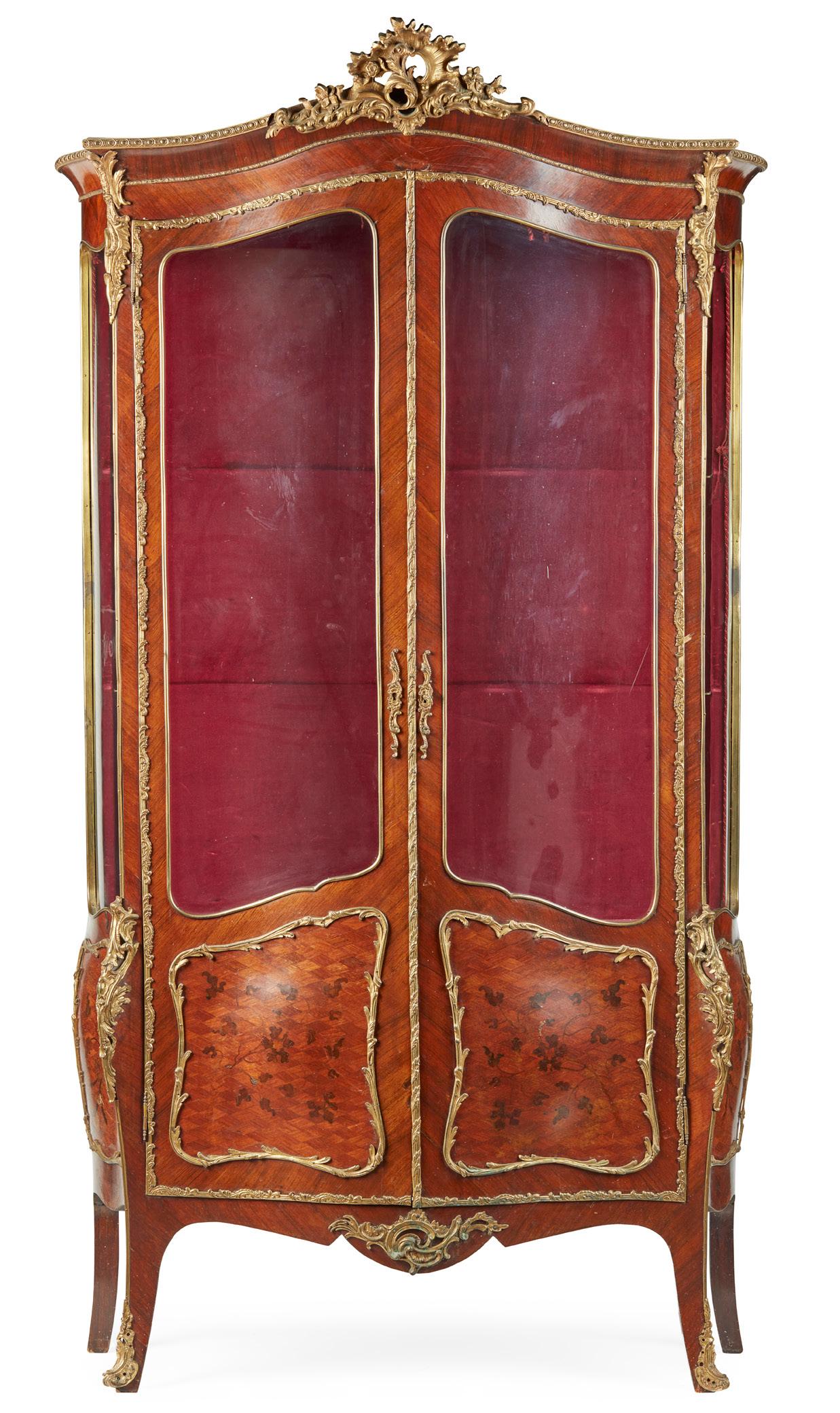
LATE 19TH CENTURY
the arched cornice above a pair of glazed doors and serpentine side lights with parquetry and floral marquetry panels below, enclosing a red plush-lined interior, the shelves lacking, with gilt metal mounts and raised on scrolling legs with sabots
108cm wide, 203cm high, 36cm deep
£1,500-2,500
191 Other fees apply in addition to the hammer price: see the ‘Buyer’s Guide’ section on page 2
517
CONTINENTAL GILTWOOD PIER MIRROR
19TH CENTURY
the divided rectangular mirror plate in a giltwood frame with ribbon-tied floral moulding, surmounted by a floral cartouche and garland cresting 105cm high, 54cm wide
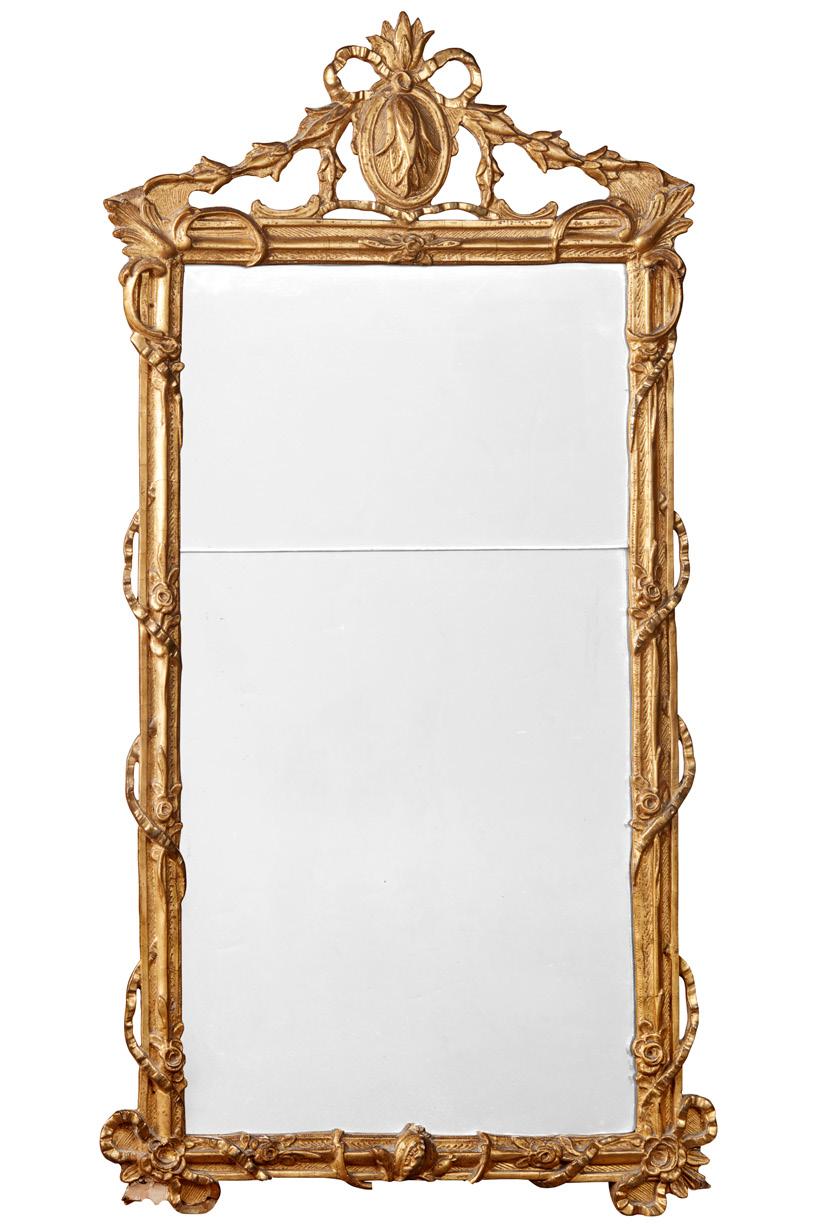
£400-600
518
FRENCH KINGWOOD AND VERNIS MARTIN DISPLAY CABINET
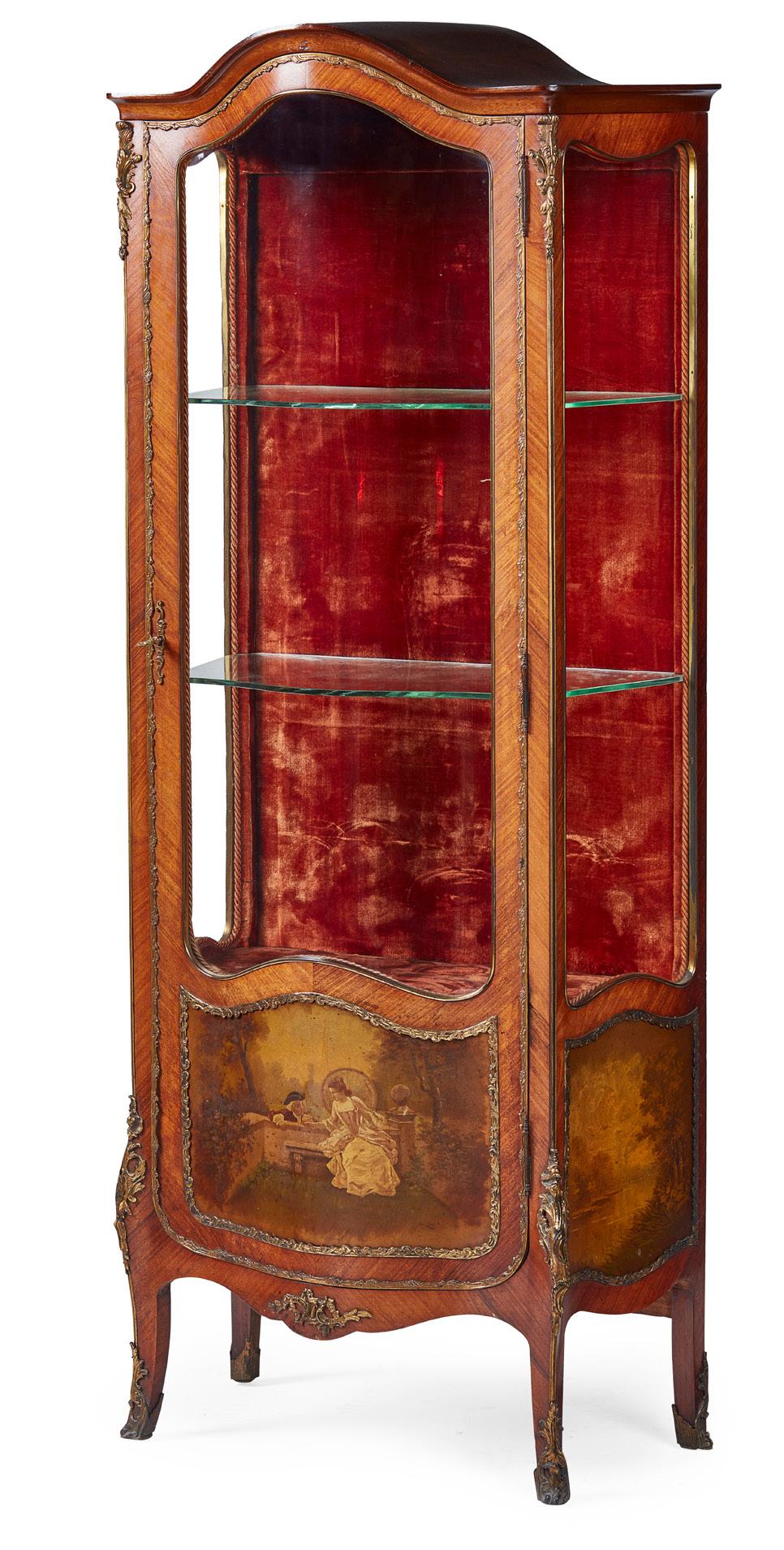
LATE 19TH CENTURY
the arch moulded cornice above a serpentine glazed door and side lights enclosing a glass shelved interior with red plush lined backboard, the door with a Vernis Martin panel depicting a rendezvous on a terrace, all outlined with gilt metal mounts and raised on splayed legs 69cm wide, 171cm high, 36cm deep £400-600
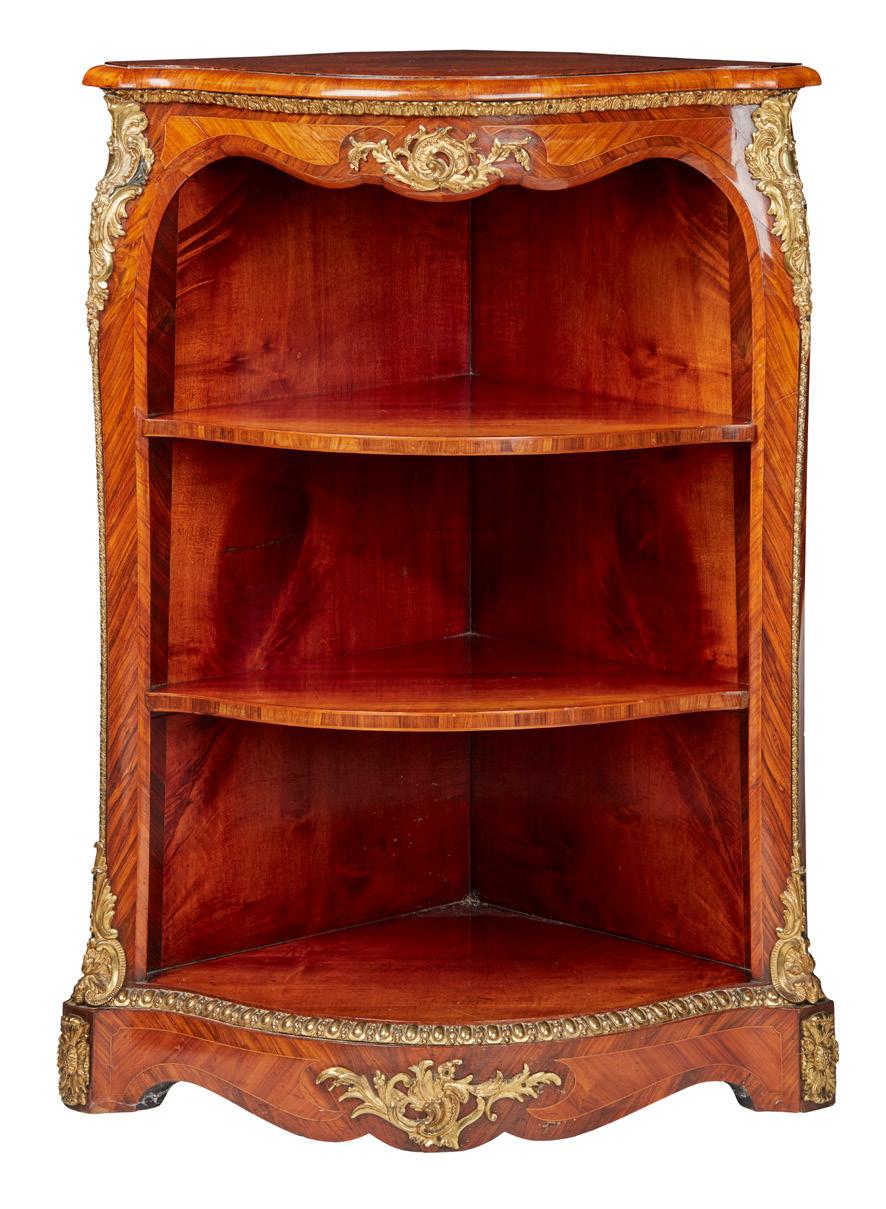
519
LOUIS XV STYLE KINGWOOD ENCOIGNURE
19TH CENTURY
the crossbanded serpentine top above open serpentine shelves on a shaped plinth base, the whole outlined with gilt metal mounts 71cm wide, 96cm high, 52cm deep
Provenance: Private Scottish Collection, Morayshire
£300-500
192
520
FRENCH CLEAR AND AMETHYST GLASS BRASS CANDELABRA, ATTRIBUTED TO MAISON BAGUES
EARLY 20TH CENTURY
the moulded glass stem with three tiers of facetted and smooth drops with floral petal appliques, surmounted by a hexagonal finial, above twin double scrolling brass arms with fluted pans on a socle base with pie crust rim

29cm wide, 46cm high, 16cm deep
£300-500
521
FRENCH KINGWOOD TWO TIER BIJOUTERIE TABLE
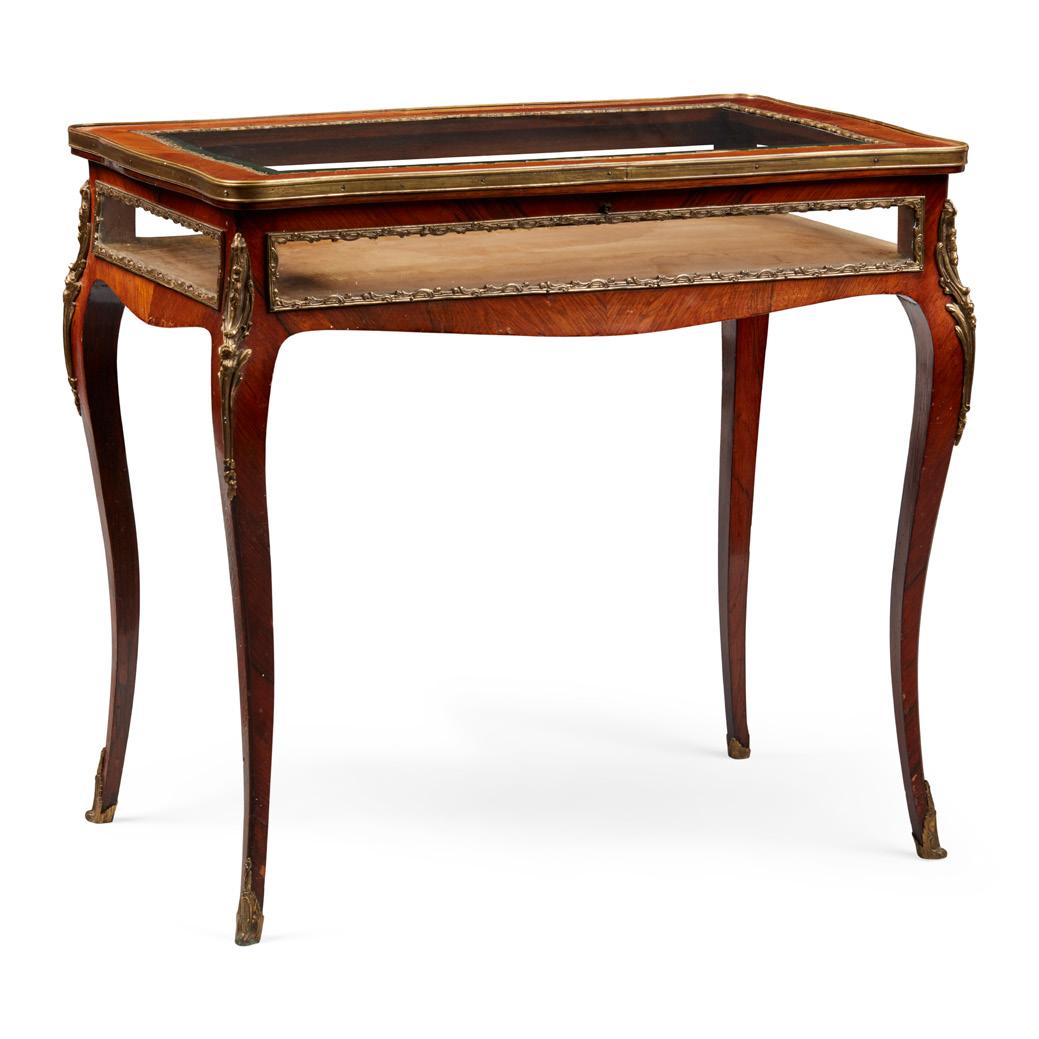
LATE 19TH CENTURY
the serpentine square hinged top with brass banding and a bevelled glass panel opening to a silk lined interior, raised on cabriole legs united by crossbanded and quarterveneered undertier, all outlined with gilt metal mounts and ending in sabots
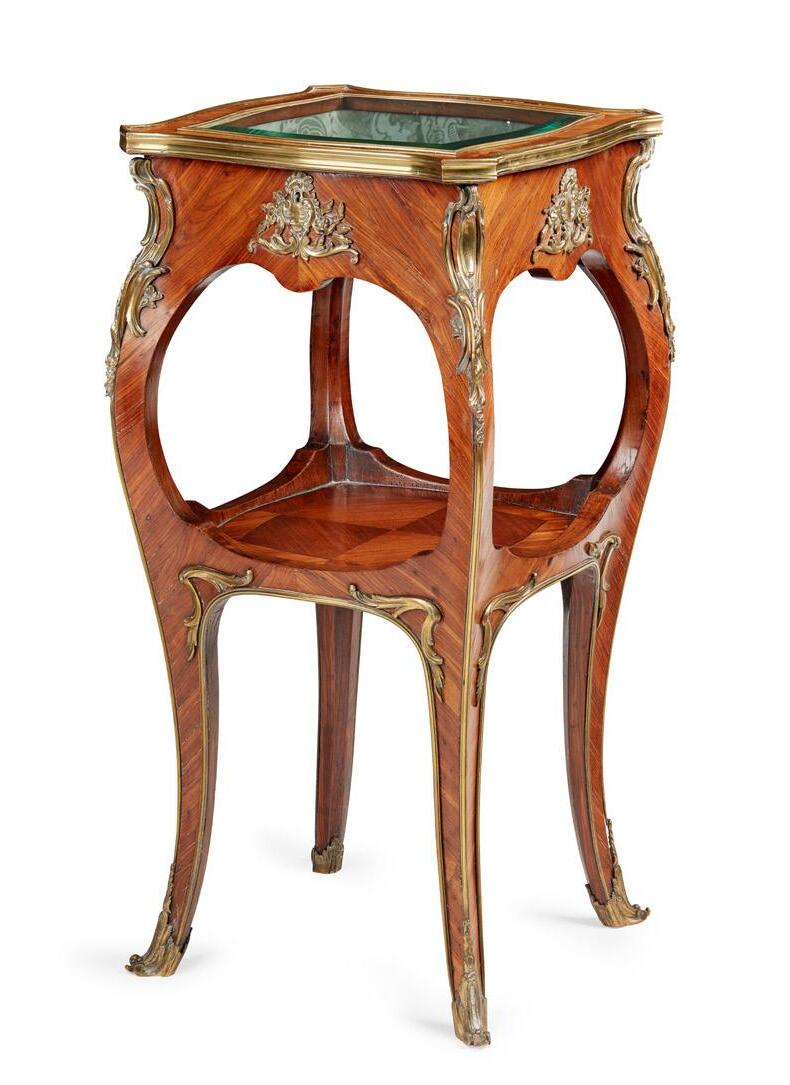
40.5cm wide, 85cm high, 40.5cm deep
Provenance: Private Scottish Collection, Morayshire
£600-800
522
FRENCH GILTWOOD BERGÈRE
19TH CENTURY
the bead and reel moulded frame with ribbon and rose cresting, above a loose cushion seat and raised on fluted tapered legs; in yellow silk upholstery
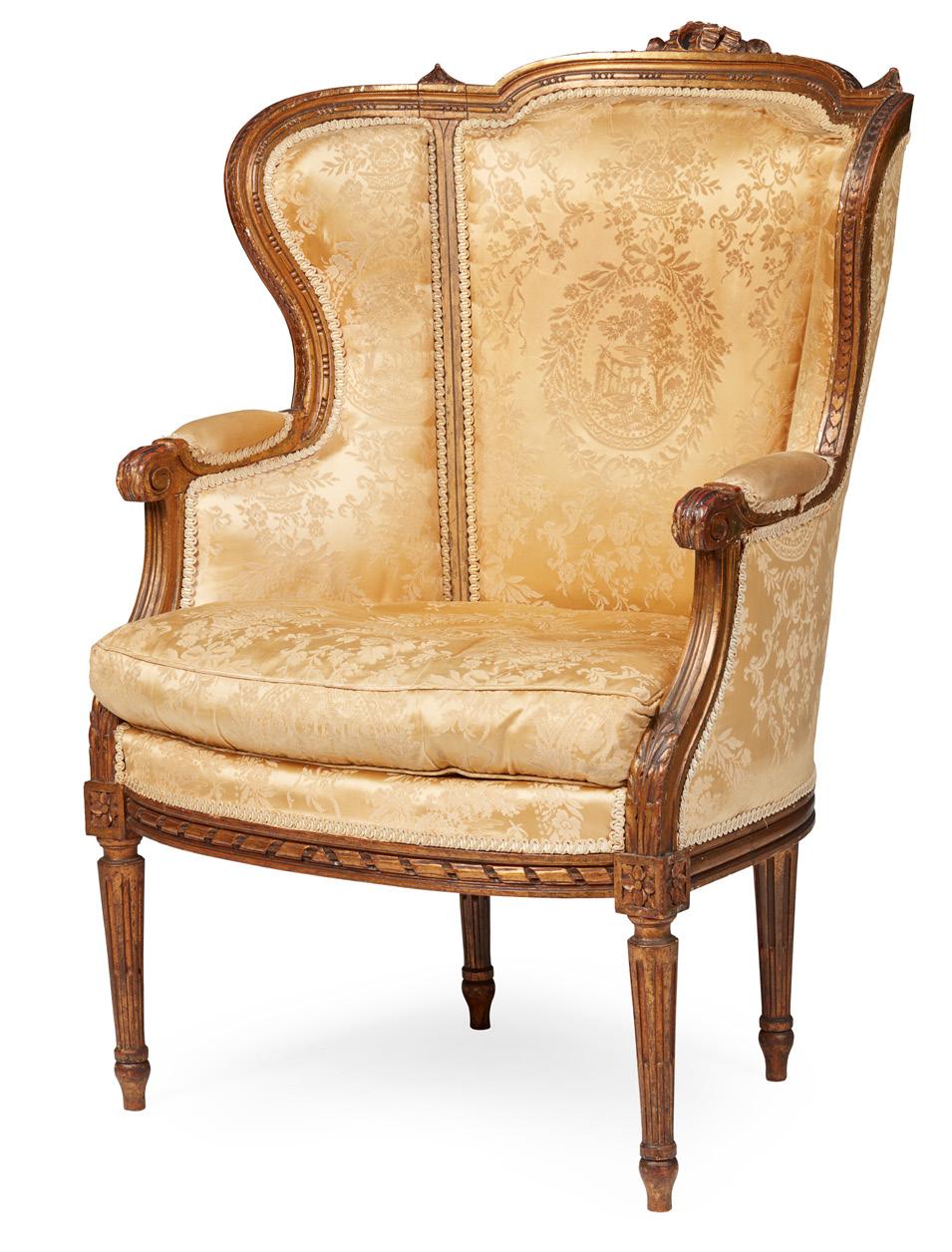
72cm wide, 103cm high, 54cm deep
£300-500
523
FRENCH KINGWOOD GILT METAL MOUNTED VITRINE TABLE
19TH CENTURY
the shaped rectangular and brass banded top with a bevelled glass panel, above glazed sides and opening to a faded gold plush lined interior, raised on cabriole legs with gilt metal mounts and ending in sabots
80cm wide, 74cm high, 51cm deep
£500-700
193 Other fees apply in addition to the hammer price: see the ‘Buyer’s Guide’ section on page 2
525
PAIR OF PAINTED SPELTER AND MARBLE FIGURAL LAMPS
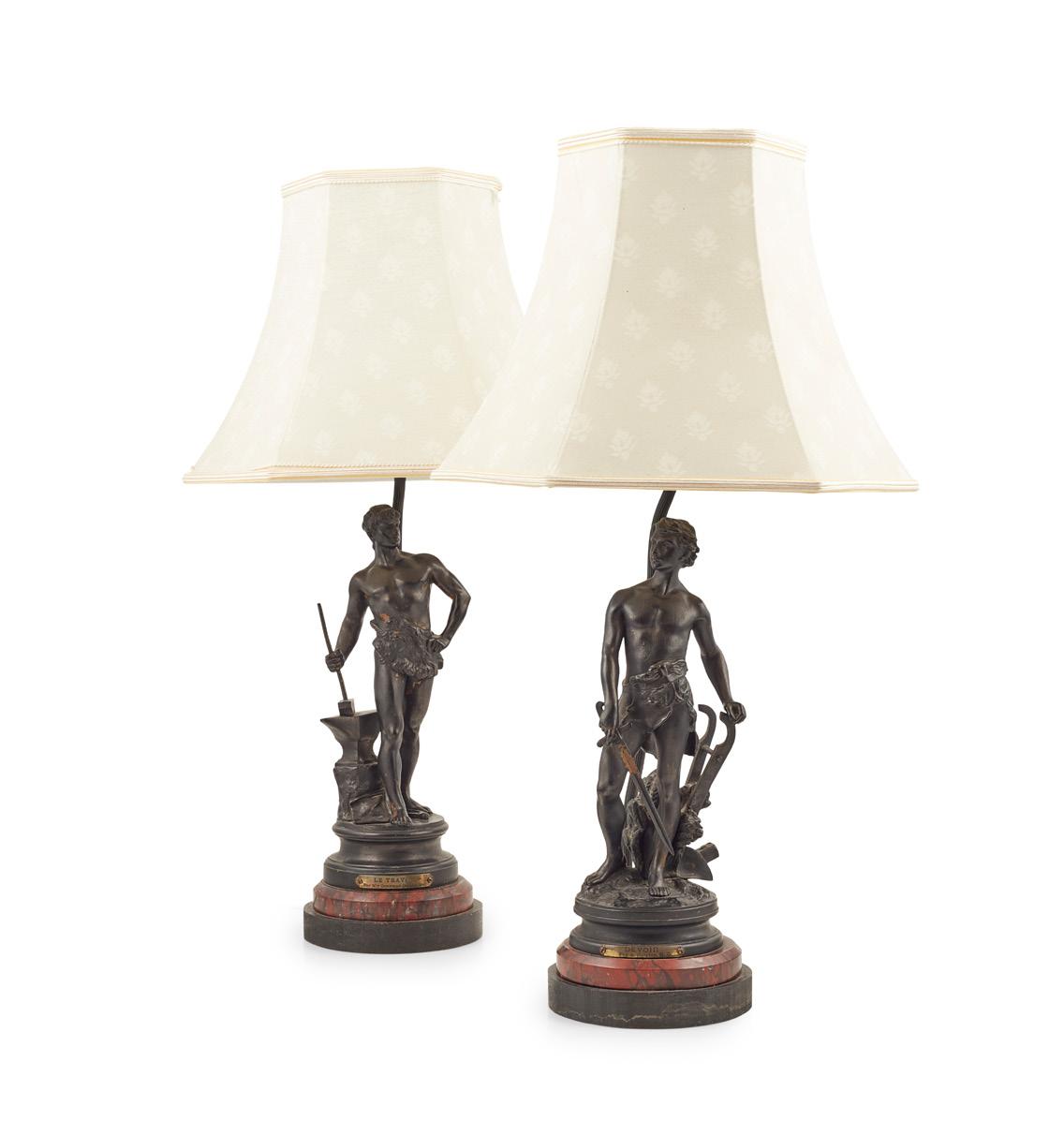
EARLY 20TH CENTURY
modelled as a young blacksmith and ploughman, after ‘Le Travail’ by Maurice Constant (French 1892-1970), and ‘Devoir’ by Adrien Étienne Gaudez (French 1845-1902), each on a black socle base with brass plaques mounted on red variegated marble and black slate stepped round bases, now mounted as lamps, with patterned cream hexagonal shades (2) 14cm in diameter, 44cm high (including fittings)
£400-600
527
MATCHED PAIR OF FRENCH MAHOGANY MARBLE TOPPED JARDINIÈRE STANDS
EARLY 20TH CENTURY with oval brass banded marble tops, one in brêche d’Alep, the other in Thives red, raised on cabriole legs with gilt metal mounts (2)
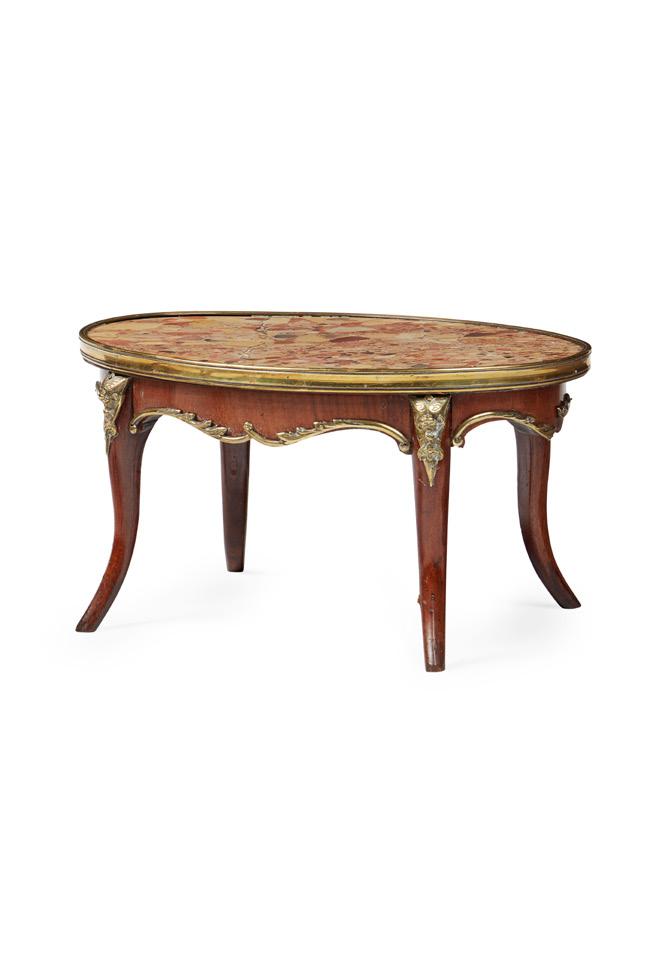
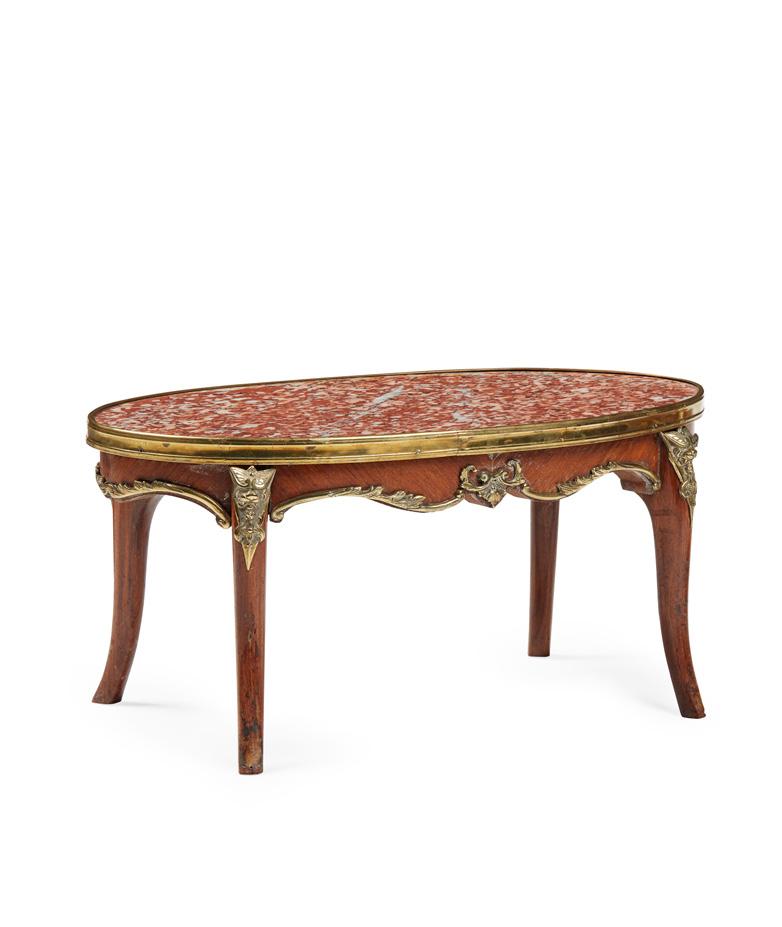
53.5cm wide, 25.5cm high, 28.5cm deep; 48.5cm wide, 26cm high, 31.5cm deep
Provenance: Private Scottish Collection, Morayshire
£250-350
526
PAIR OF MIXED MARBLE PEDESTALS
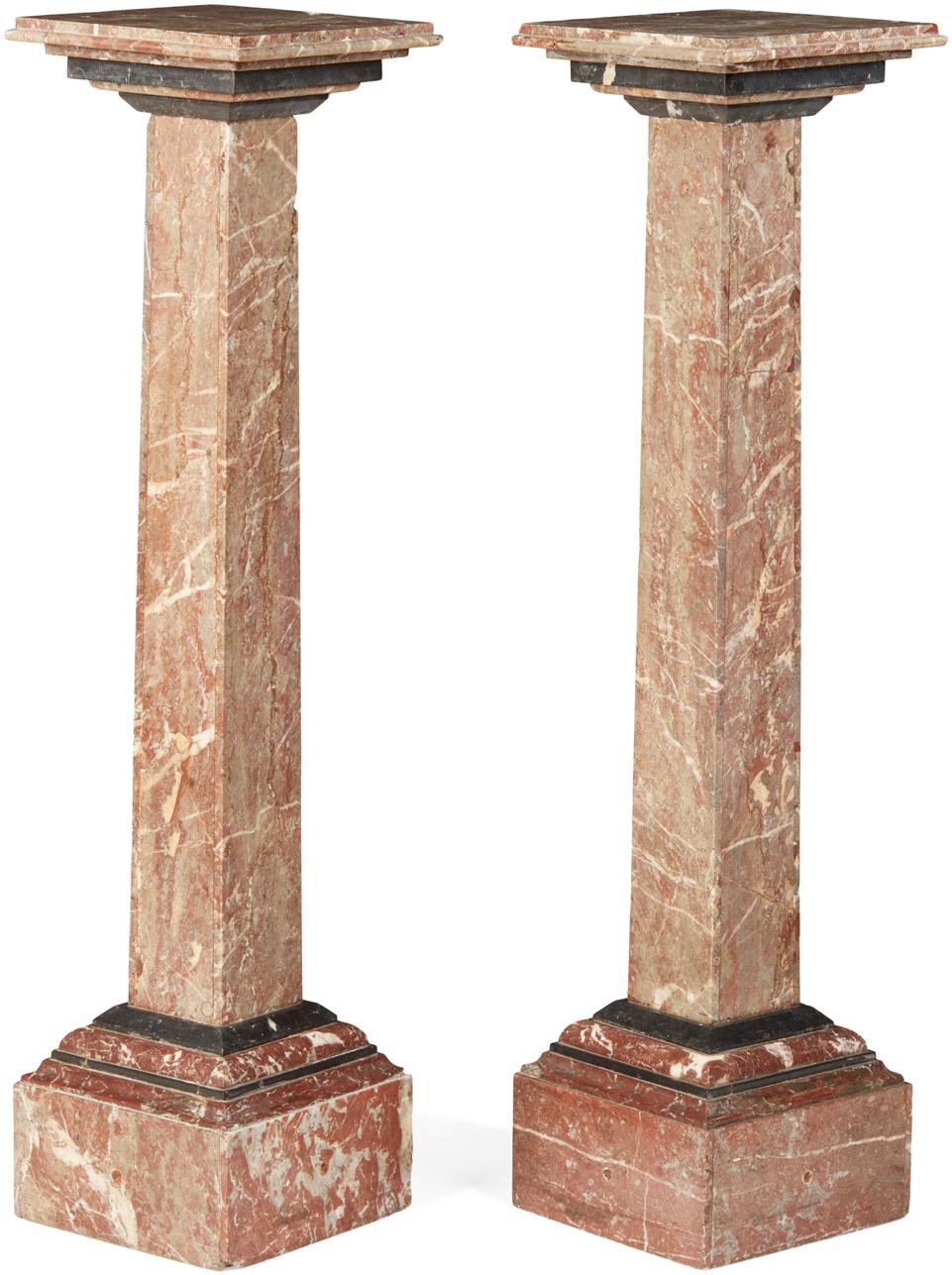
LATE 19TH CENTURY
the square platform tops above square tapered columns and stepped square moulded bases, in pink veined and black marble (2)
38cm wide, 109cm high
£400-600
524
PAIR OF LOUIS XVI STYLE GILTWOOD MIRRORS
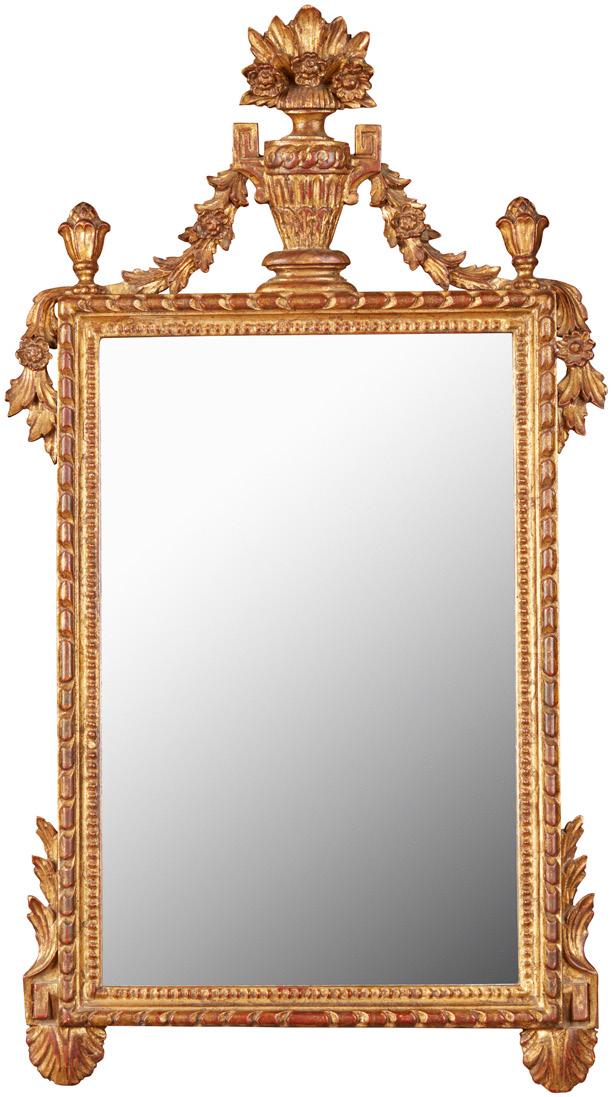

19TH CENTURY
the rectangular mirror plates in beaded frames surmounted by flower filled urns hung with garlands with berry finials to the corners (2)
47cm wide, 88cm high
£600-800
194
528 Y
FRENCH RED TORTOISESHELL AND BOULLE MARQUETRY BRACKET CLOCK

LATE 19TH CENTURY
the gilt metal relief dial with enamel cartouches and black Roman numerals and engraved Arabic five minute markers, in a waisted Boulle inlaid case surmounted by a seated figure of a putto, the case door with a figure of a putto and basket of flowers, raised on foliate scroll feet, the twin train movement stamped ‘J Marti & Cie’, numbered ‘41485’ and striking to a bell, with a matching number sunburst pendulum
31cm wide, 60cm high, 17cm deep
£600-800
529 Y
FRENCH LOUIS XVI STYLE
ROSEWOOD AND MARQUETRY CHIFFONIER
LATE 19TH/ EARLY 20TH CENTURY
in the manner of Charles Topino, the circular top with a pierced brass gallery and inlaid with a trophy of arms, above three drawers with crosshatched stringing, raised on cabriole legs united by a galleried lower tier inlaid with a inkpot, and ending in foliate sabots
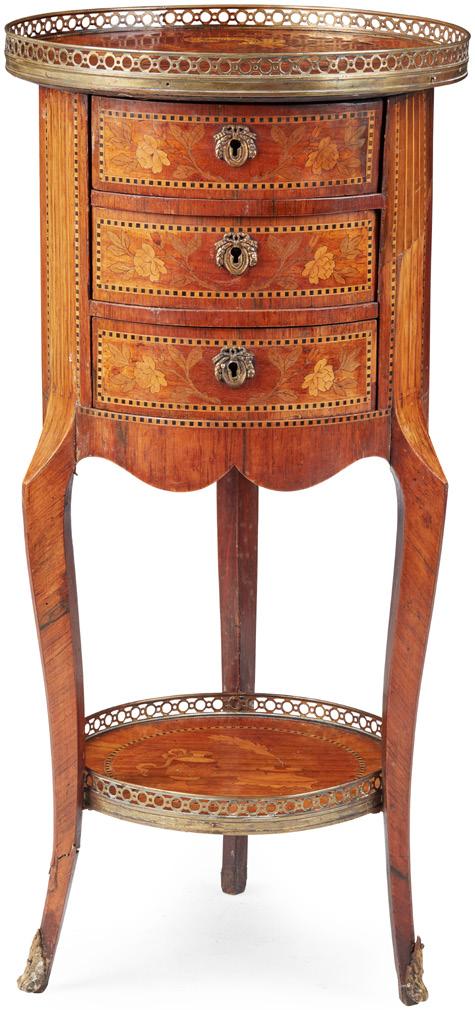
38cm diameter, 80cm high
£500-700
530
PAIR OF FRENCH LOUIS XVI STYLE GILT BRONZE AND PORCELAIN
MOUNTED CANDELABRA
LATE 19TH CENTURY
alternately with an infant satyr and Bacchanalian female infant, after Clodion, issuing floral branches, on circular bases mounted with Sèvres style bleu celeste and gilt floral panels, on a quadripartite base (2)
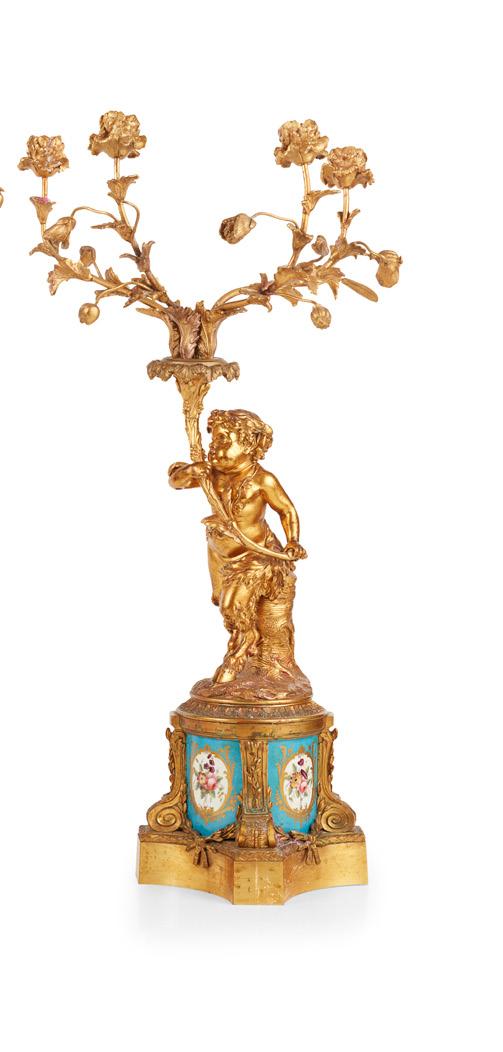

36cm wide, 68cm high
£300-500
Note: The infant satyr was designed by Clodion in 1773, while the infant Bacchic female figure was created later by Louis-Felix de Lame to replace Clodion’s original infant satyress. These subjects were very popular and widely copied in the 18th and 19th centuries.
531
PAIR OF LOUIS XVI STYLE GILTWOOD BERGÈRES

20TH CENTURY
the oval padded backs above loose cushion seats flanked by enclosed padded arms, with reeded frames and raised on fluted tapered legs carved with flowers at the blocks, covered in scrolling foliate cream upholstery (2)
66cm wide, 95cm high, 51cm deep
£500-700
195 Other fees apply in addition to the hammer price: see the ‘Buyer’s Guide’ section on page 2
534
FRENCH JAPANNED BLACK AND GILT LACQUER FOUR PANEL FOLDING SCREEN
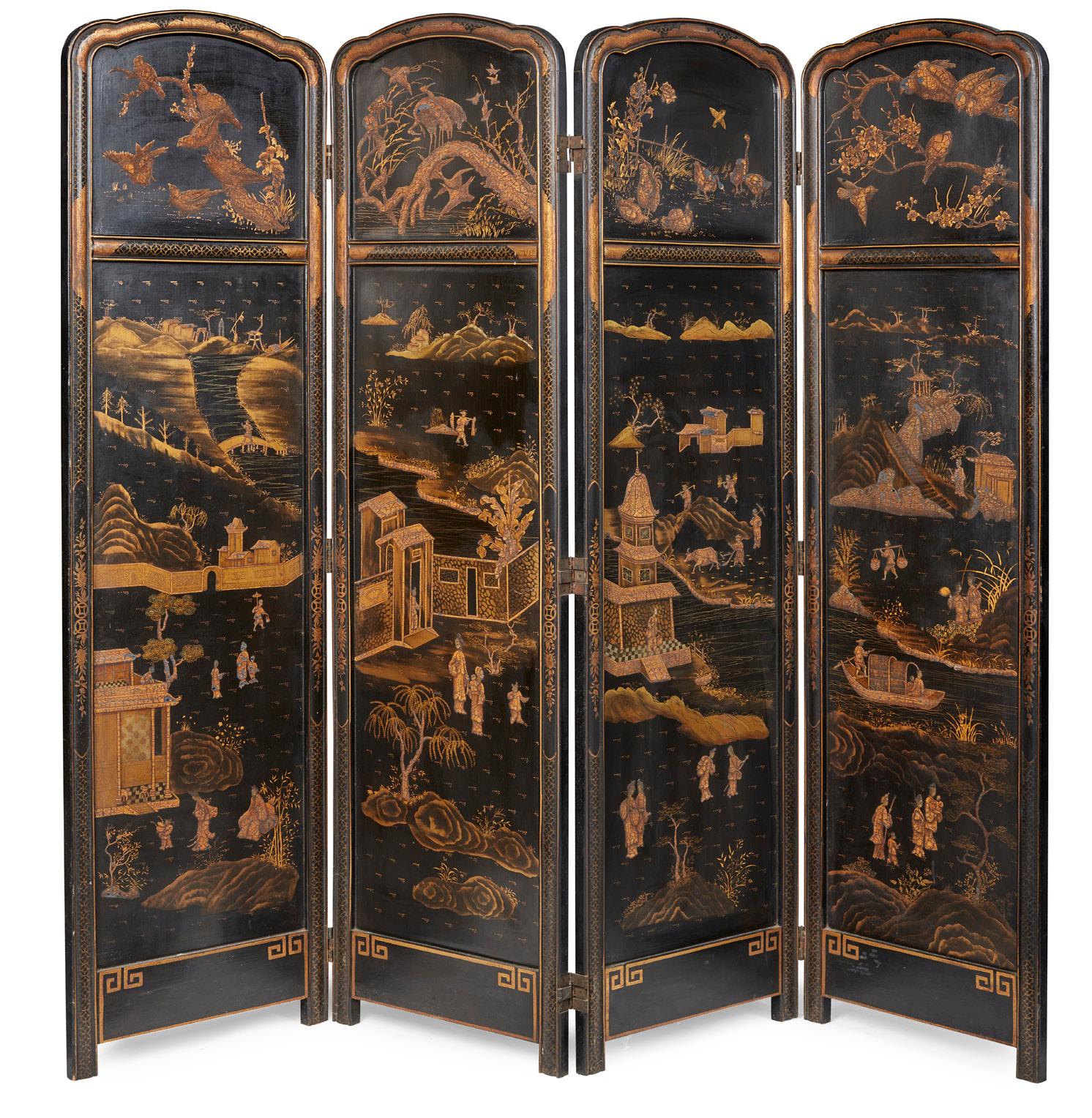
19TH CENTURY
each arched fold with two panels, the upper panels depicting birds in flowering trees and lower panels with pagodas and figures in a continuous riverside landscape, the reverse with birds and flowers
192cm wide, 175cm high
£300-500
532
CONTINENTAL BLACK AND GILT JAPANNED PEDESTAL TABLE
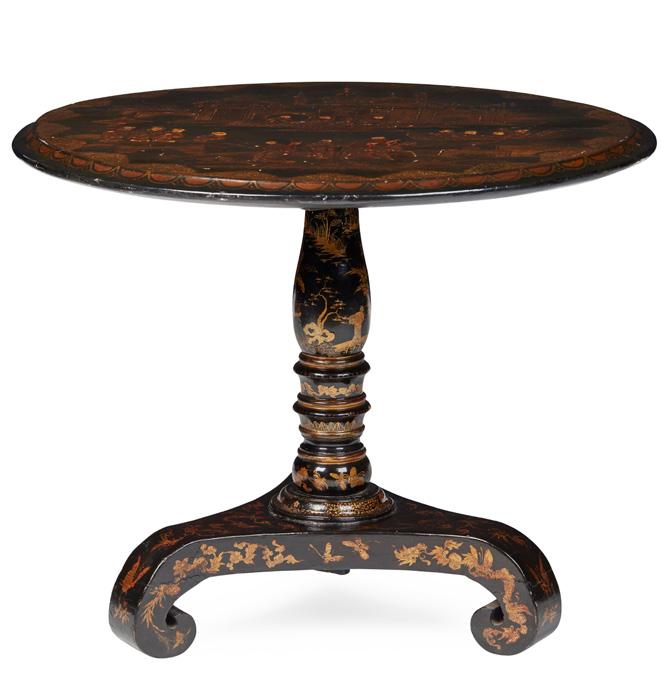
MID 19TH CENTURY
the circular top with a moulded edge, decorated in relief with a scene of figures in garden landscape with a pagoda, on a turned column and tripartite base with downswept scroll feet, further decorated with figures, flowers and insects
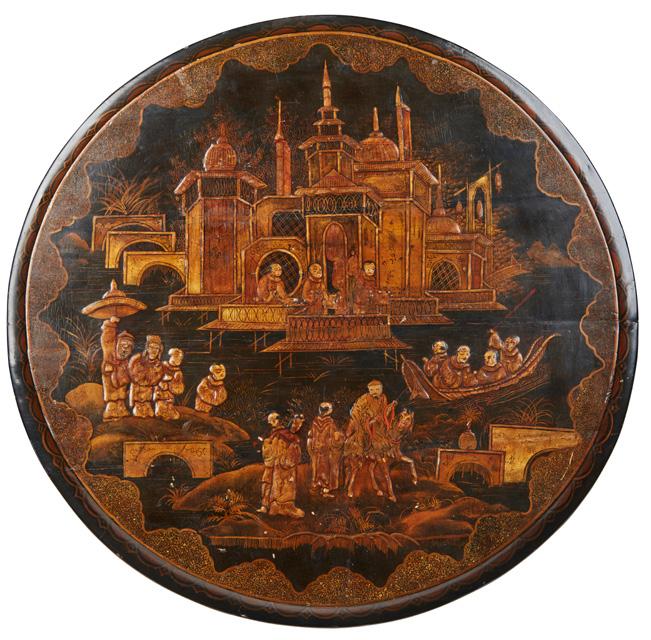
71cm diameter, 59cm high £300-500
533
EDOUARD DROUOT (FRENCH 1859-1945)
GALATEA
bronze, dark brown patina, modelled as a draped nymph with arms outstretched on a watery rocky outcrop, signed ‘E. Drouot’ 30cm wide, 65cm high, 17cm deep £800-1,200
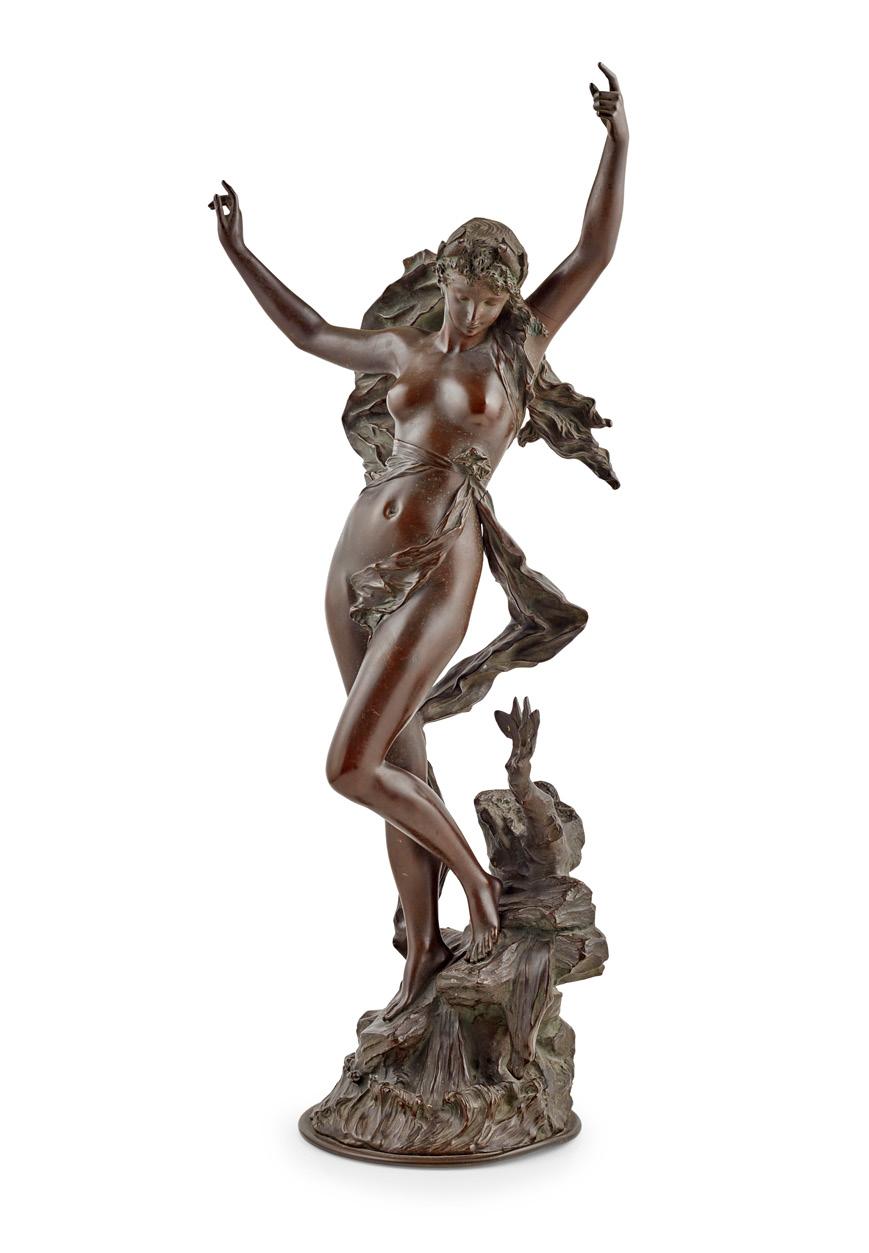
196 Other fees apply in addition to the hammer price: see the ‘Buyer’s Guide’ section on page 2
536
FRENCH SMALL BLACK LACQUER SECRÈTAIRE À ABATTANT
LATE 19TH CENTURY
the Brêche Violette marble top with a moulded edge, above a frieze drawer and fall front opening to an interior fitted for writing, with a pair of cupboard doors below, opening to shelves, on short bracket feet with sabots, the whole in black Chinoiserie lacquer
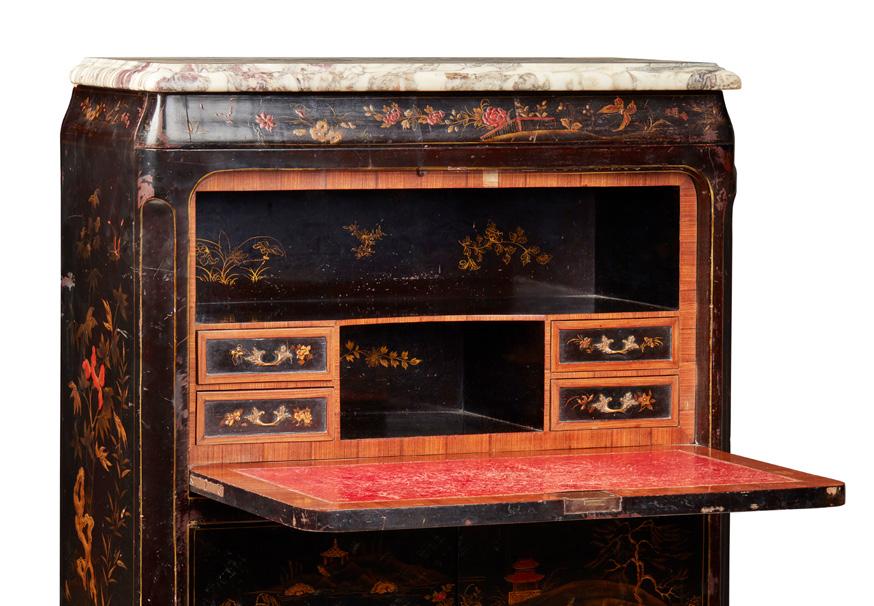
72cm wide, 115cm high, 27cm deep
£700-1,000
535
ROCOCO STYLE GILT
GESSO WALL MIRROR
EARLY 20TH CENTURY
the waisted mirror plate in a moulded gesso and composite frame with foliate, floral and scroll decoration with shell pediment
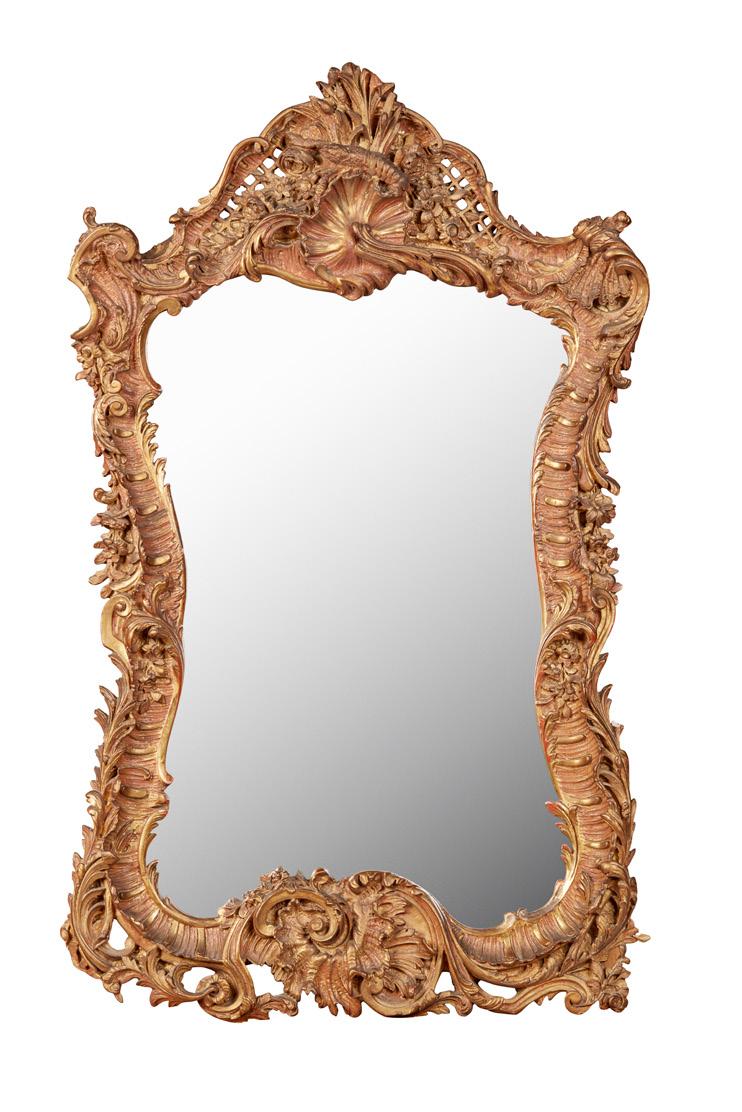
56cm wide, 96cm high
£400-600
537
JAPANESE LACQUER, PARCEL-GILT AND PAINTED CENTRE TABLE

20TH CENTURY
the shaped circular top with a Japanese lacquer insert depicting ho-ho birds and peonies within a chrysanthemum gilt border enclosed by a moulded giltwood edge, raised on foliate carved C scroll supports on a cruciform base centred by an urn finial and raised on large carved paw feet
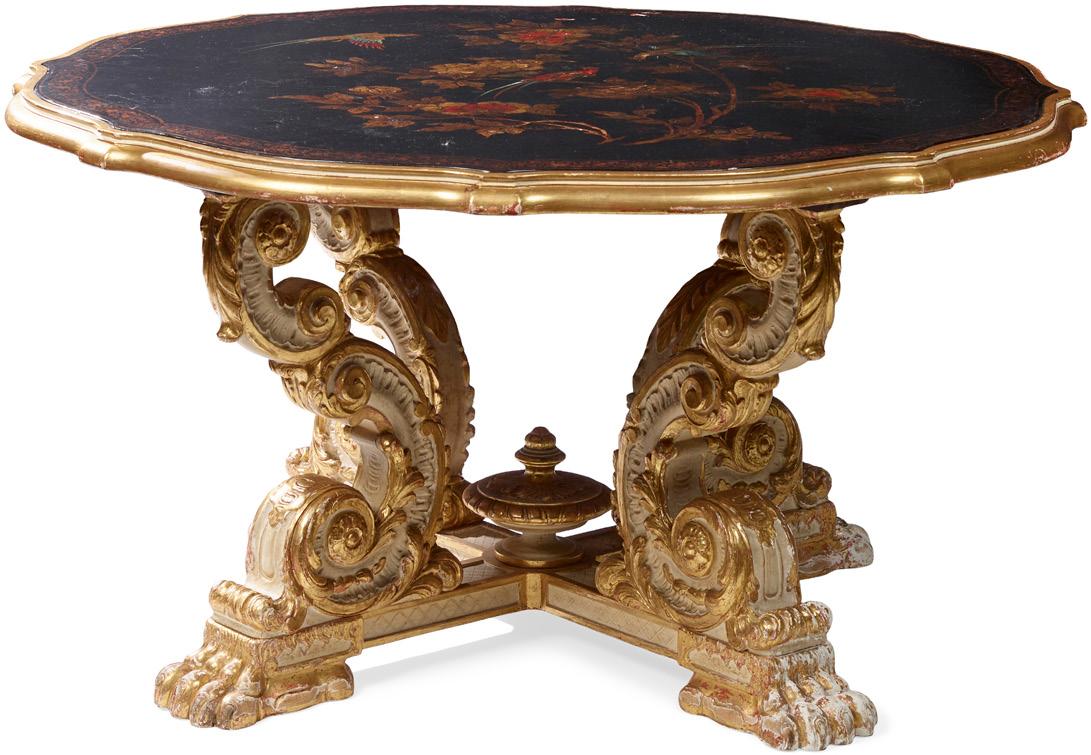


137cm diameter, 73cm high
£1,500-2,500
197
‘The importance and value of Canova’s art is now recognized as holding in balance the last echo of the Ancients and the first symptom of the restless experimentation of the modern age.’ - Art Historian Giuseppe Pavanello.
Antonio Canova (1757- 1822) was a prominent Italian Neoclassical sculptor, mostly celebrated for his work in marble. Canova began producing works in marble before the age of ten, before enrolling in the Accademia di Belle Arti di Venezia around 1772. Canova won numerous prizes and received several commissions, which led to him opening his own studio at Calle Del Traghetto at S. Maurizio in 1779. From this point, Canova travelled to and worked in several European cities, before returning to Italy in 1816, where he continued to work until his death in 1822.
Due to his success, Canova received many commissions and no longer had to rely on funerary monuments for large-scale work, and could explore large freestanding classical figures, such as his ‘Hercules and Lichas’ from 17951815, commissioned by Onorato Gaetani dell’Aquila d’Aragona. Often inspired by antiquity, Canova was known for reviving classical works in a way that avoided melodrama of antiquity and the artificiality of Neoclassicism. The tale of Hercules and Lichas
is recounted in book IX of Ovid’s Metamorphoses: Hercules puts on a shirt poisoned with Nessus’ blood, and, driven mad by the pain, thinks that his servant Lichas is to blame. Lichas tried to explain his innocence, however Hercules threw him into the waves of the Euboic Sea. The original statue is now conserved in the National Gallery of Modern Art in Rome.
Canova is often regarded as the greatest Neoclassical artist, which is evidenced by his series of important international patrons including Napoleon Bonaparte, and Popes Pius VI and VII. His work is held in many institutions including the Metropolitan Museum of Art in New York, the Louvre in Paris, and the Hermitage Museum in Saint Petersburg.
538
AFTER ANTONIO CANOVA (ITALIAN 1757-1822)
HERCULES AND LICHAS
bronze, dark brown patina, signed ‘Delafontaine, bronzier’ and with Canova signature to the base
27cm wide, 42cm high, 20.5cm deep £2,000-3,000
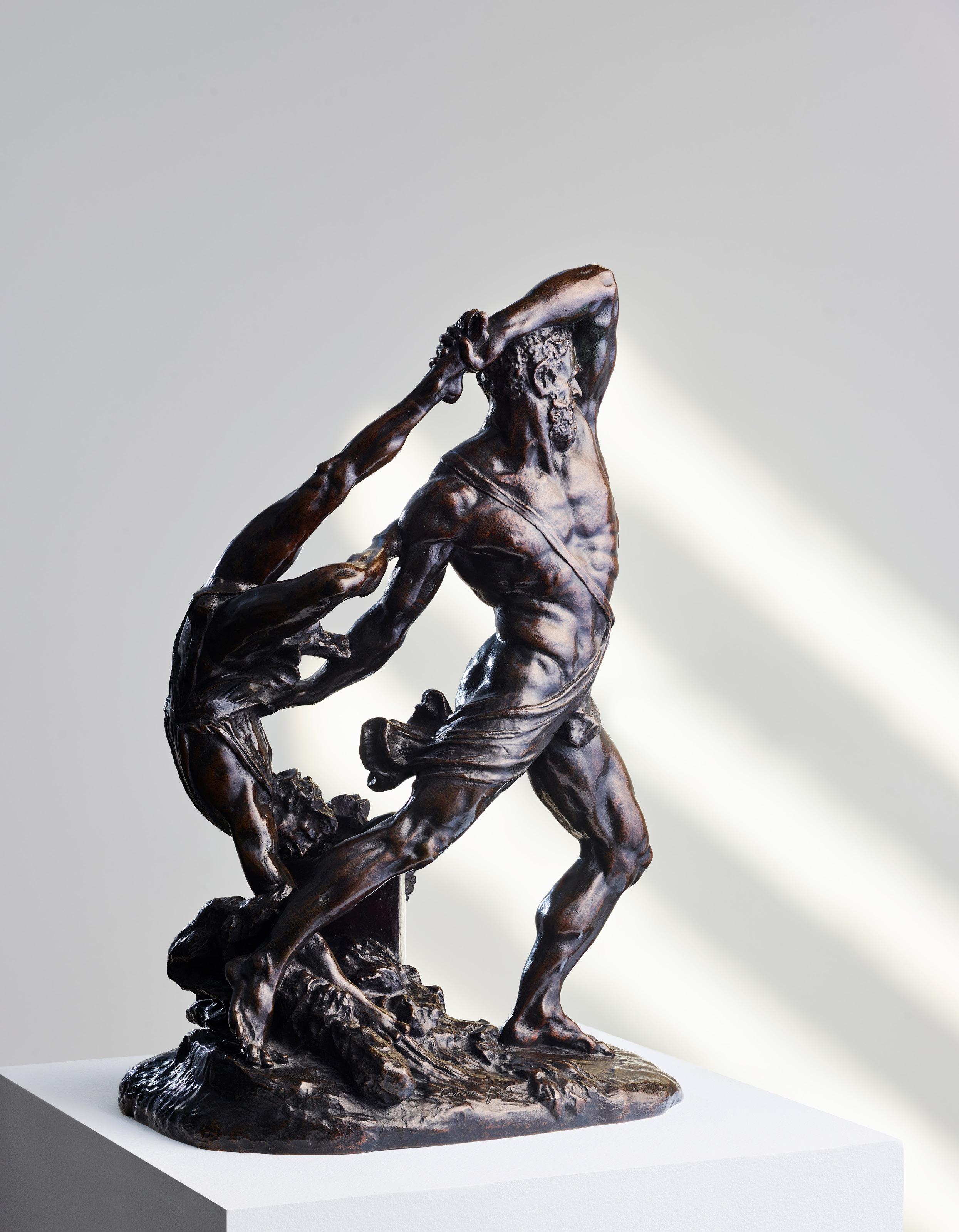
198
539
FRENCH BRONZE NOVELTY TABLE LAMP
LATE 19TH / EARLY 20TH CENTURY
dark brown patination, modelled as a young man in a turban and robe seated astride an oil lamp, warming his hands above the wick, the lamp with a scene of a satyr and satyress, set on a rectangular Nero Portoro marble plinth

13cm long, 15cm high, 7cm deep
Provenance: Private Scottish Collection, Morayshire
£300-500
540
AFTER CHRISTOPHE-GABRIEL ALLEGRAIN (FRENCH 1710-1795)
VENUS AT HER BATH
bronze, dark brown patina, unsigned
9cm wide, 27cm high, 11cm deep
Provenance: Private Scottish Collection, Morayshire
£250-350
541
FRENCH BRONZE FIGURE OF A CLASSICAL MAIDEN
LATE 19TH CENTURY
possibly after Albert Ernest Carrier-Belleuse (French 1824 - 1887), dark brown patina, the draped figure standing on a knoll of flowers and bullrushes pouring water from an urn, on a circular grey marble plinth base; unsigned

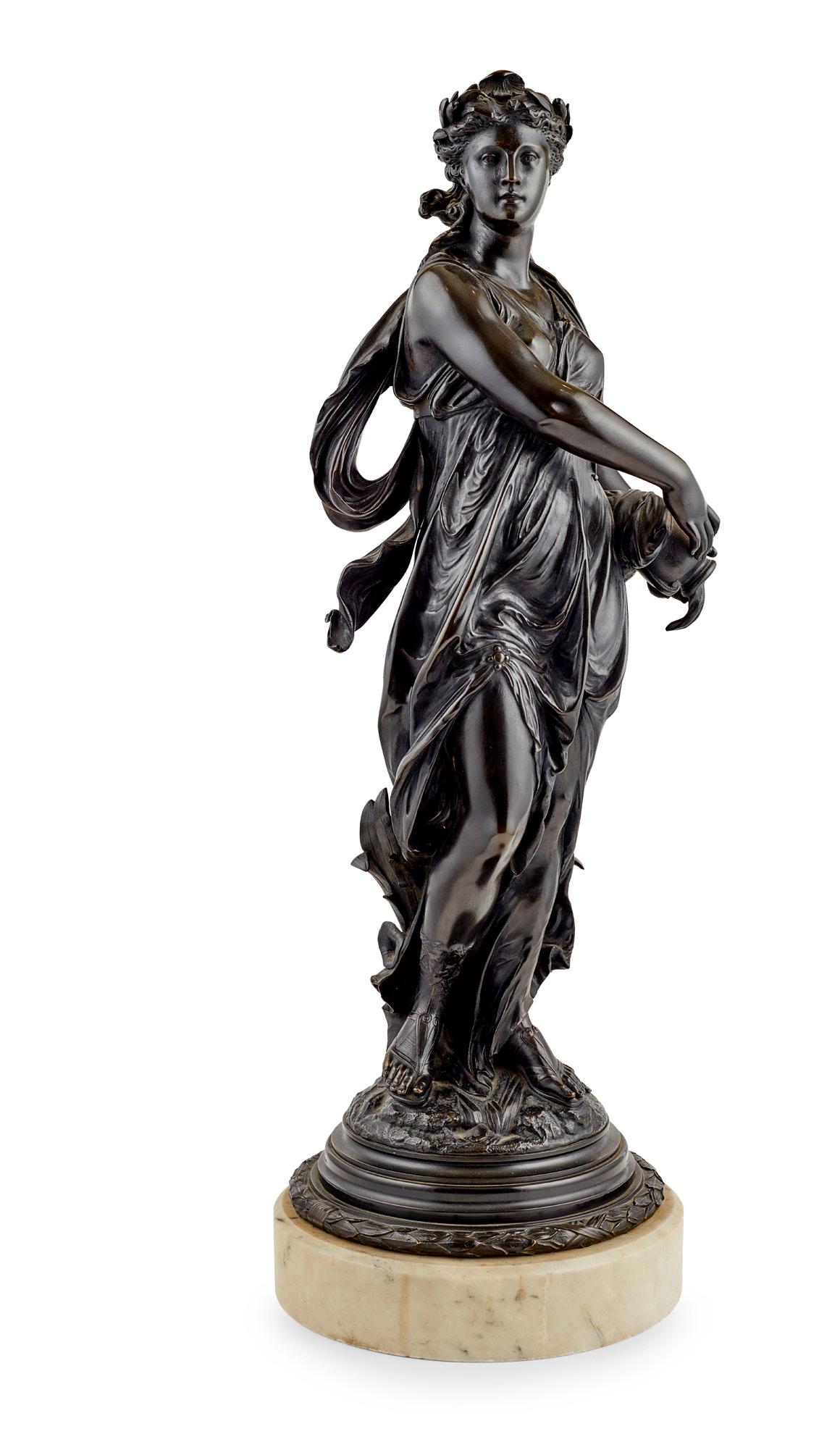
67cm high, 22cm diameter
£500-700
542
FRENCH EMPIRE
GILT BRONZE AND BRASS
FIGURAL MANTEL CLOCK
EARLY 19TH CENTURY
the gilt bronze engine turned dial with black Roman numeral white enamel chapter, in a rectangular pedestal case with a classical youth playing the flute to the side, a lyre surmount and garland and trophy appliques, on palmette cast bracket feet, the twin train brass movement with outside countwheel striking a bell
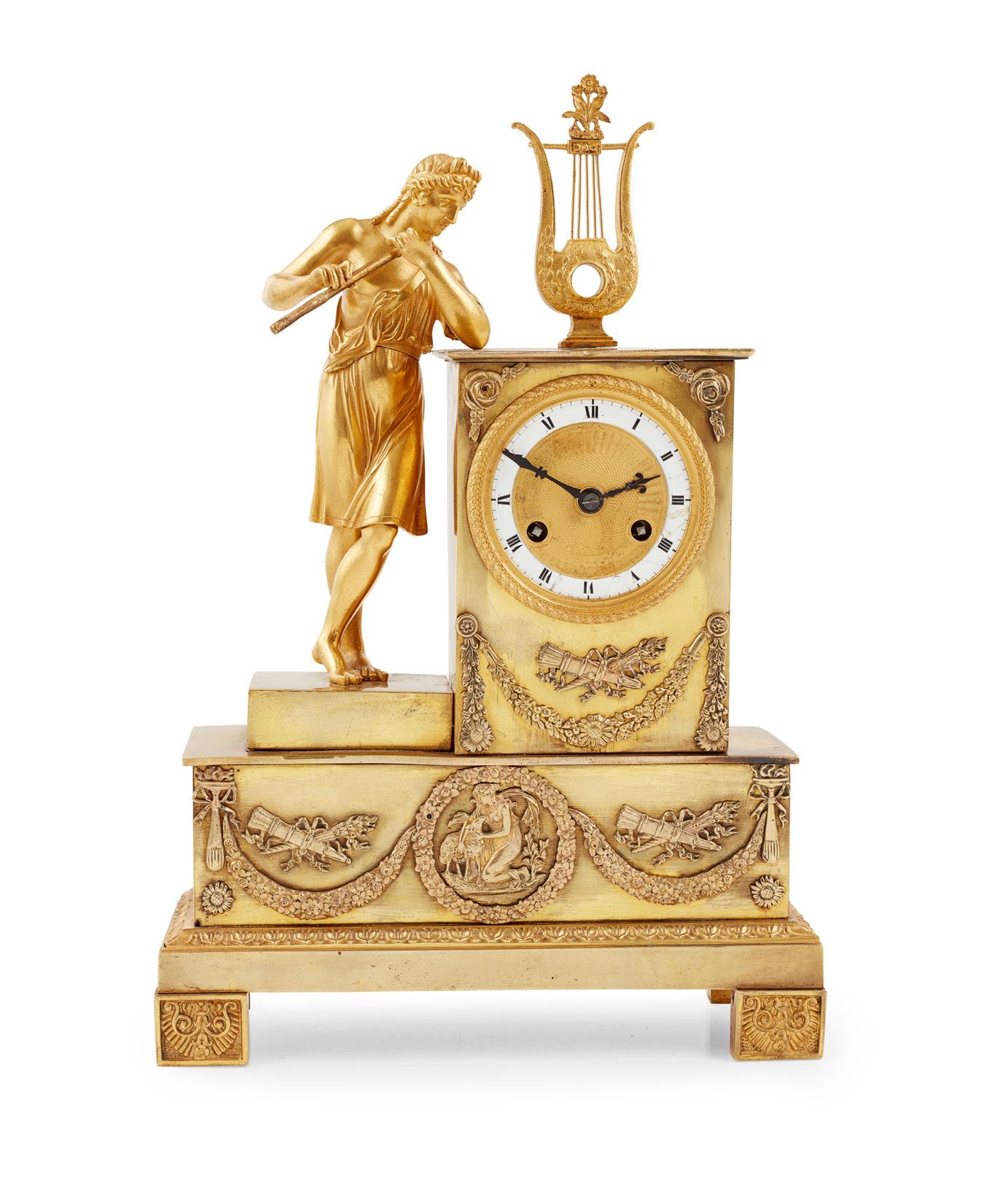
25cm wide, 37cm high, 9cm deep
£300-400
199 Other fees apply in addition to the hammer price: see the ‘Buyer’s Guide’ section on page 2
543
GROUP OF SIX MINIATURE PAINTINGS
19TH CENTURY
various sizes and materials, to include an oval portrait on ivory of the French actress Marie Dorval in a white satin gown, in a gilt frame with rope twist border; an oval portrait on card of a gentleman in a locket case with a circle of hair in the back; a small rectangular portrait on card of a gentleman with moustache and sideburns, in a metal case frame; an oval portrait on card of Leonardo da Vinci, in a gilt metal frame; a circular miniature painting of a harbour scene, on mica laid on card, dated 1812 in a gilt metal frame; and an oval miniature painting depicting three figures in a garden, in a brass frame (6)

largest 9cm high
Note: The miniature of Marie Dorval sold in compliance with UK Government and APHA regulations, with (non-transferable) exemption registration reference 4MV8EMHH
£400-600
544 Y
GROUP OF SIX PORTRAIT MINIATURES OF FAMOUS NOBLE LADIES
LATE 19TH/ EARLY 20TH CENTURY
various sizes, painted with watercolour, bodycolour, some with gilt details, on ivory or celluloid, in gilt metal frames (6)

largest 14cm x 9.5 cm overall
Note: Sold in compliance with UK Government and APHA regulations, with (non-transferable) exemption registration submission Reference 30392417779
£400-600
545 Y
LARGE PORTRAIT MINIATURE OF LOUIS XVI
19TH CENTURY
oval, on ivory, after the original by Joseph Boze, painted with watercolours and bodycolour, the sitter wearing a mauve and gold embroidered coat and the Order of the Holy Spirit, signed indistinctly, in an unmarked gold locket frame with tortoiseshell and mother-of-pearl covers, mirror interior, and a suspension loop

9.3cm excluding frame
Note: Sold in compliance with UK Government and APHA regulations, with (non-transferable) exemption registration reference WXDR5895
£400-600
546
FRENCH BRASS REPEATER CARRIAGE CLOCK

LATE 19TH CENTURY
the gilt dial with cream enamel chapter ring with black Arabic numerals, anglaise riche case of typical form with Corinthian columns and bevelled glass panels, the twin train brass movement with silvered platform escapement, striking to a coiled steel gong
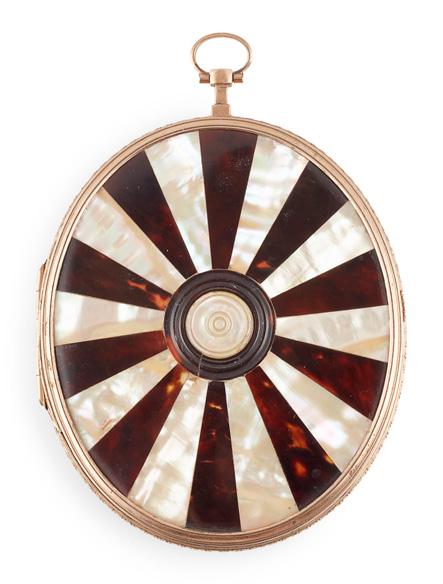
11cm wide, 21cm high [handle up], 9.5cm deep
Provenance: Private Scottish Collection, Morayshire
£300-500
200
547
THREE FRENCH PORTRAIT MINIATURES OF GENTLEMEN
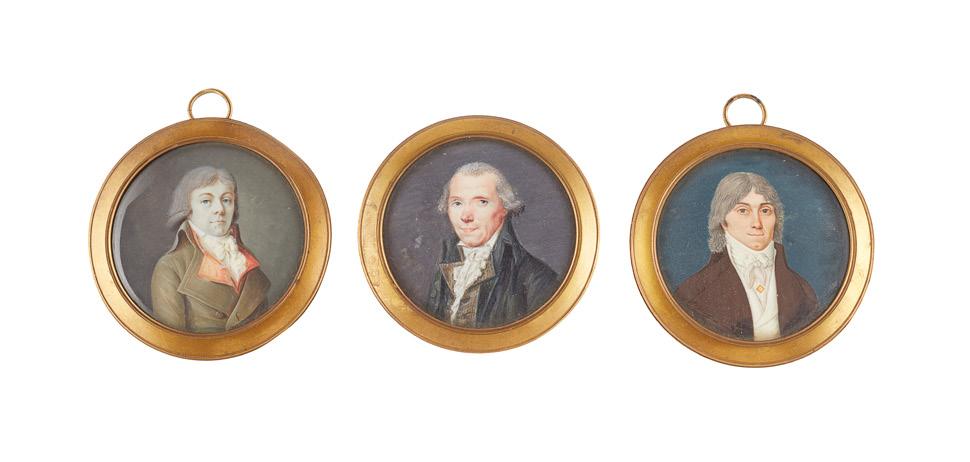
19TH CENTURY
circular, painted in watercolour, gouache, and body colour on card, in brass frames with suspension loops (3)
5.5cm diameter excluding frames
£300-500
549 Y
THREE PORTRAIT MINIATURES OF FAMOUS LADIES


LATE 19TH CENTURY
all watercolour and bodycolour on ivory, the first an oval portrait of Constance Mayer, the second a small oval portrait of the Duchesse Marie Louise de Parma; the third a circular portrait of French noblewoman, all in gilt metal frames (3) largest 8.5cm high
Note: Sold in compliance with UK Government and APHA regulations, with (non-transferable) exemption registration submission Reference 30392417779
£300-500
548 Y
THREE PORTRAIT MINIATURES
LATE 19TH CENTURY
all watercolour on ivory, the first circular, depicting a gentleman seated in a library wearing a powdered queue, black coat and white cravat, spuriously signed ‘Isabey’ and dated1802, in a silvered brass frame with suspension loop; and a pair of oval portraits of an 18th century nobleman and lady, in gilt metal frames with blue enamel borders mounted with paste jewels, signed ‘Hoffmann’ (3) largest 8.5cm diameter excluding frame
Note: Sold in compliance with UK Government and APHA regulations, with (nontransferable) exemption registration submission Reference 30392417779
£300-500
550
FRENCH GILT BRONZE REPEATER CARRIAGE CLOCK
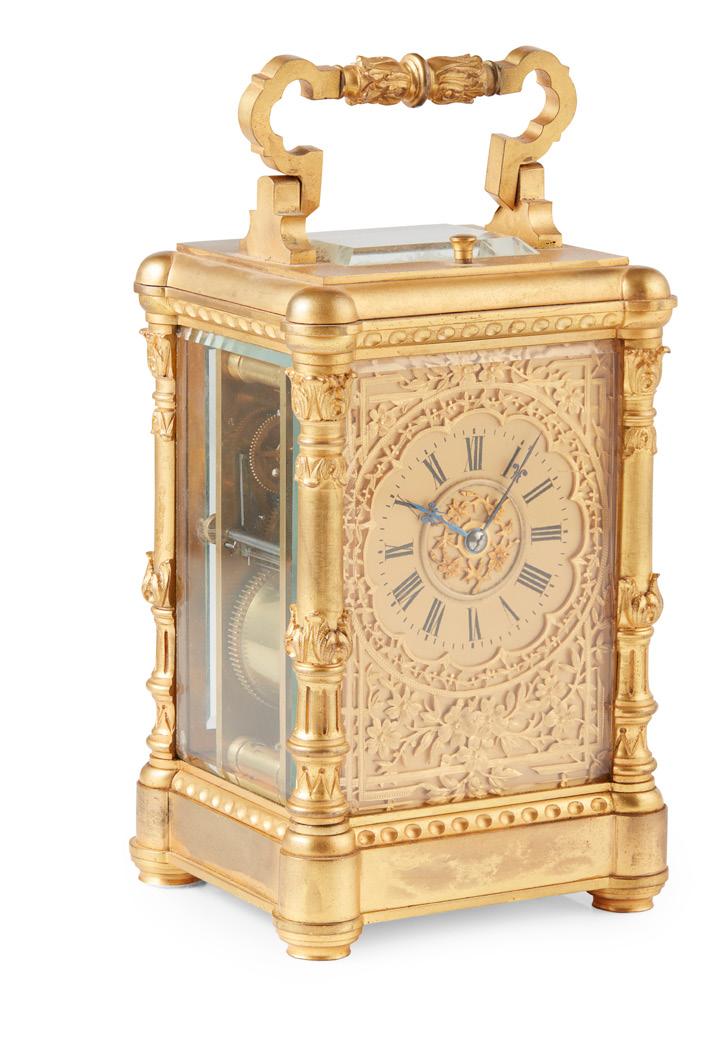
19TH CENTURY
the gilt dial with black Roman numerals in a pierced and chased floral mask, in an architectural column case with swing handle and bevelled glass panels, the twin-train brass movement with silvered platform escapement, striking the full and half hours on a coiled steel gong 10cm wide, 19.5cm high [handle up], 9cm deep
Provenance: Private Scottish Collection, Morayshire
£500-800
551
FRENCH ENAMEL CHEROOT BOX
LATE 19TH CENTURY
of rectangular form, the hinged cover and sides with scenes of ladies and gentlemen smoking and drinking, the interior and base painted with further smoking theme vignettes, with silver gilt mounts inscribed ‘Gratty From Bunny . Novr . 1883’, and retailer’s inscription ‘Paris 23 Bt des Capucines JONES & 41 St James’s St . London’, 16.5cm wide, 5.5cm high, 8.5cm deep; together with a CONTINENTAL PORCELAIN BOX, the hinged cover painted with an equestrian scene, the sides with various vignettes alternating with floral garlands, within metal mounts, underglaze blue, 7.3cm wide, 4.8cm high; and a BATTERSEA ENAMEL PILL BOX, the cover painted with a quayside scene within a scrolling cartouche on a pink ground, the sides with floral and diaper panels, the base with a gilt diaper design, within a metal mount (3)
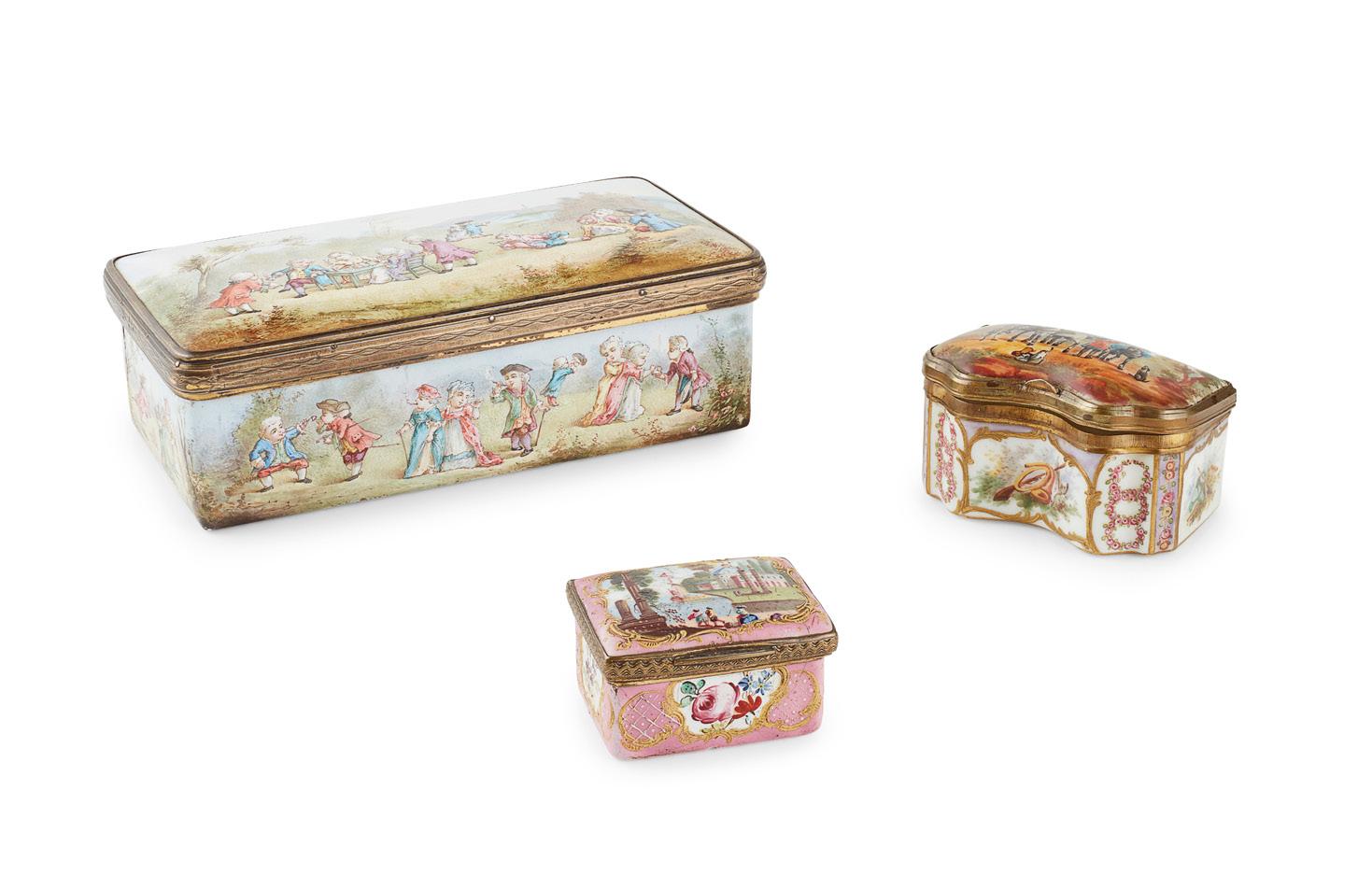
5.5cm wide, 3cm high, 4.3cm deep
£250-350
201 Other fees apply in addition to the hammer price: see the ‘Buyer’s Guide’ section on page 2
552
FRENCH KINGWOOD AND VERNIS MARTIN JARDINIÈRE STAND
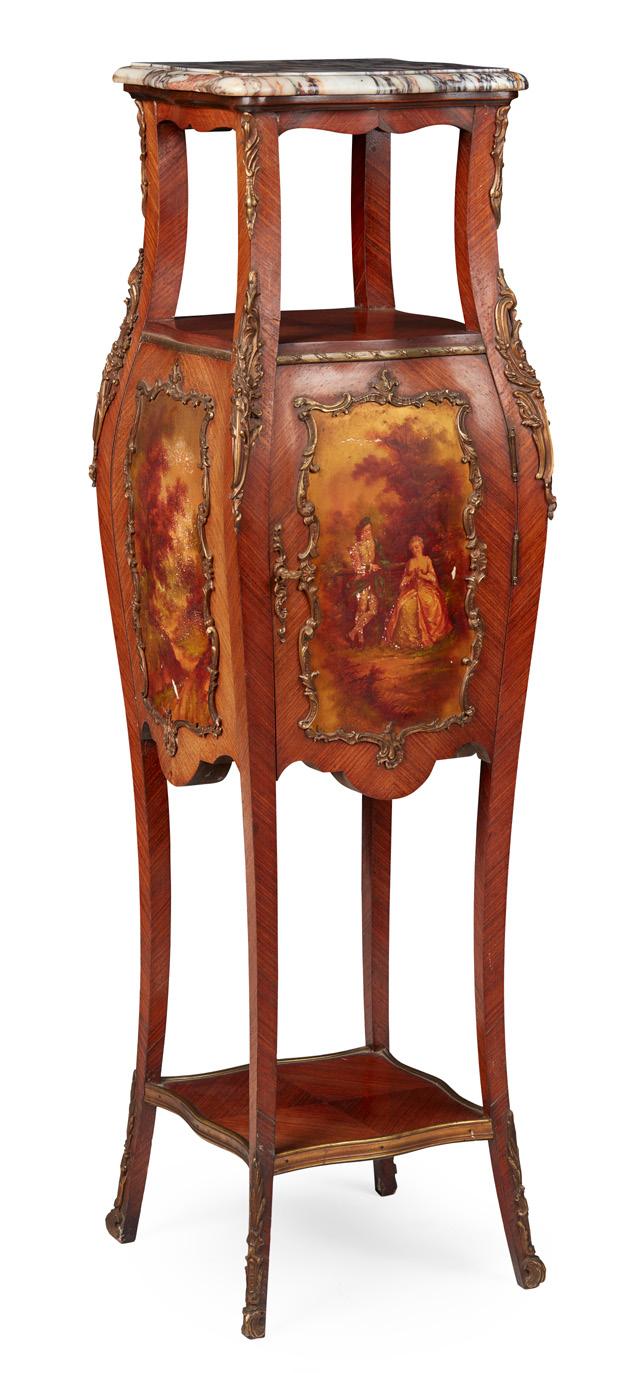
LATE 19TH/ EARLY 20TH CENTURY
the moulded purple veined white variegated marble top over a bombé body with a door and Vernis Martin panel of an amorous couple, with landscape panels to the sides, raised on cabriole legs united by a lower tier, with gilt metal mounts throughout 35cm wide, 123cm high, 35cm deep
£500-700
553
FRENCH KINGWOOD AND VERNIS MARTIN VITRINE CABINET
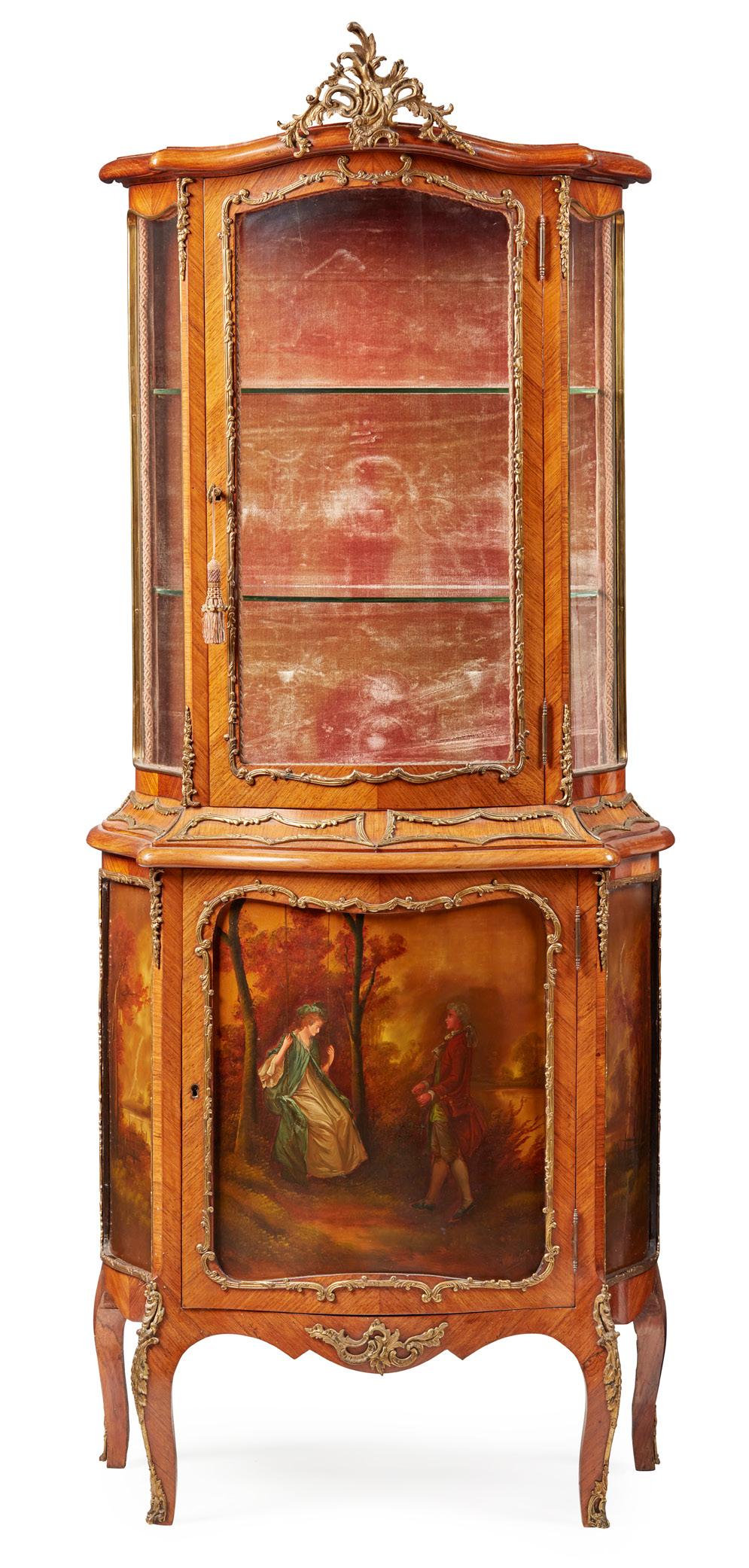
LATE 19TH CENTURY
the serpentine arched cornice above a glazed serpentine door and sides enclosing a pink plush lined interior with glass shelves, on an outset base with a Vernis Martin panel door decorated with a courting couple with riverscape panels to the sides, raised on cabriole legs, the whole with gilt metal mounts
79cm wide, 191cm high, 41cm deep
Provenance: Private Scottish Collection, Morayshire
£800-1,200
554
FRENCH KINGWOOD AND MARQUETRY SECRÉTAIRE À ABATTANT

LATE 19TH CENTURY
the later serpentine pink marble top above a frieze drawer and fallfront opening to an interior with a leather writing surface, drawers and compartments, over three further bombé drawers, all with floral marquetry inlaid panels and mounted with gilt bronze mounts
67cm wide, 130cm high, 38cm deep
Provenance: Private Scottish Collection, Morayshire
£400-600
202
555
LOUIS
EARLY 20TH CENTURY
with two graduated brass banded tiers of serpentine outline, raised on moulded cabriole legs ending in sabots
72cm wide, 87cm high, 48cm deep
Provenance: Private Scottish Collection, Morayshire
£300-500
LATE 19TH CENTURY
the ogee shaped cornice with a gilt metal rococo finial, above a glazed bombé door with a Vernis Martin panel below, opening to glass shelves and a mirror back, all outlined in gilt metal mounts and raised on splay legs with sabots
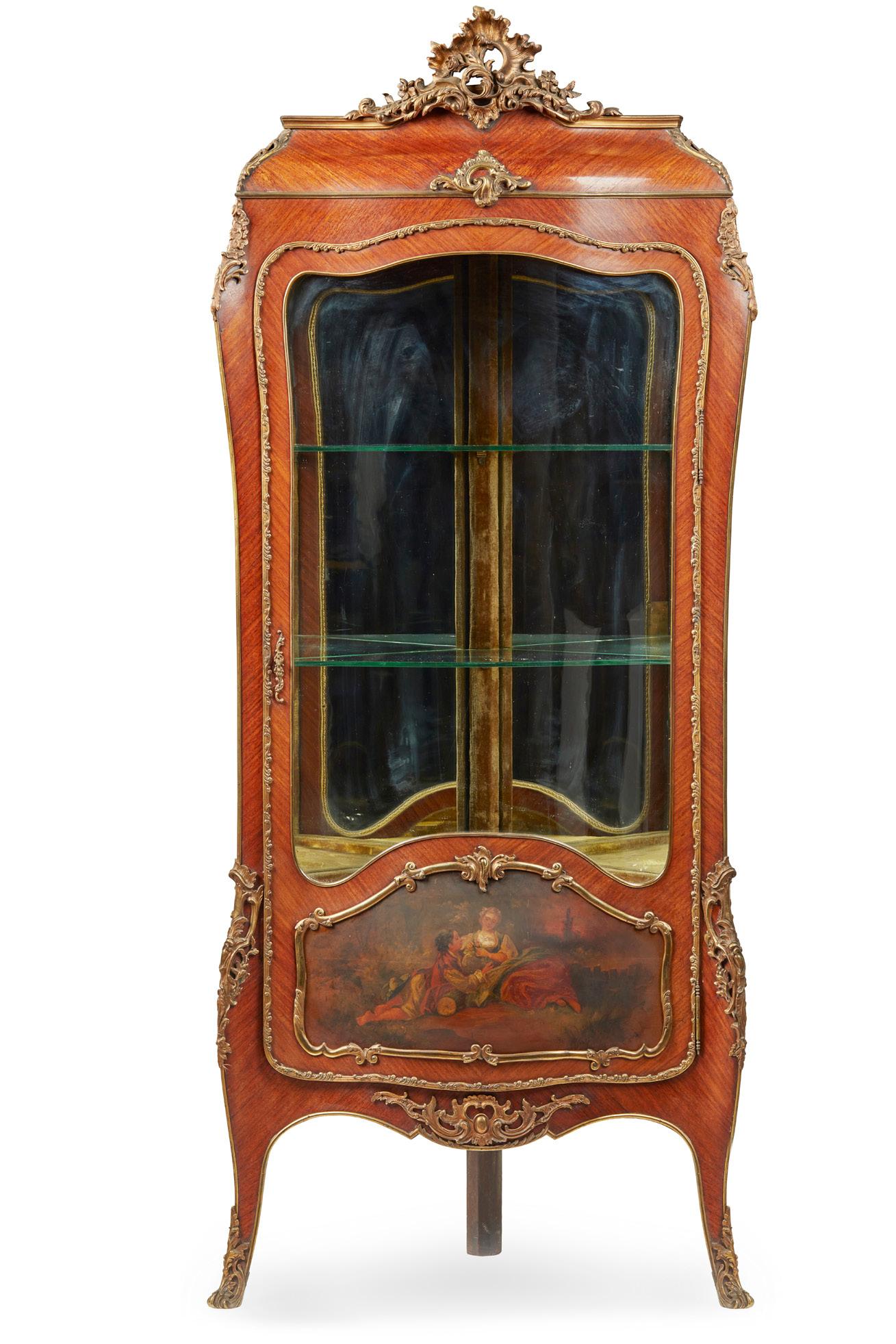
78cm wide, 189cm high, 40cm deep
£800-1,200
in the Louis XV style, the serpentine Rouge Griotte marble top with a moulded edge above three long drawers with floral marquetry, raised on slender cabriole legs with gilt bronze mounts
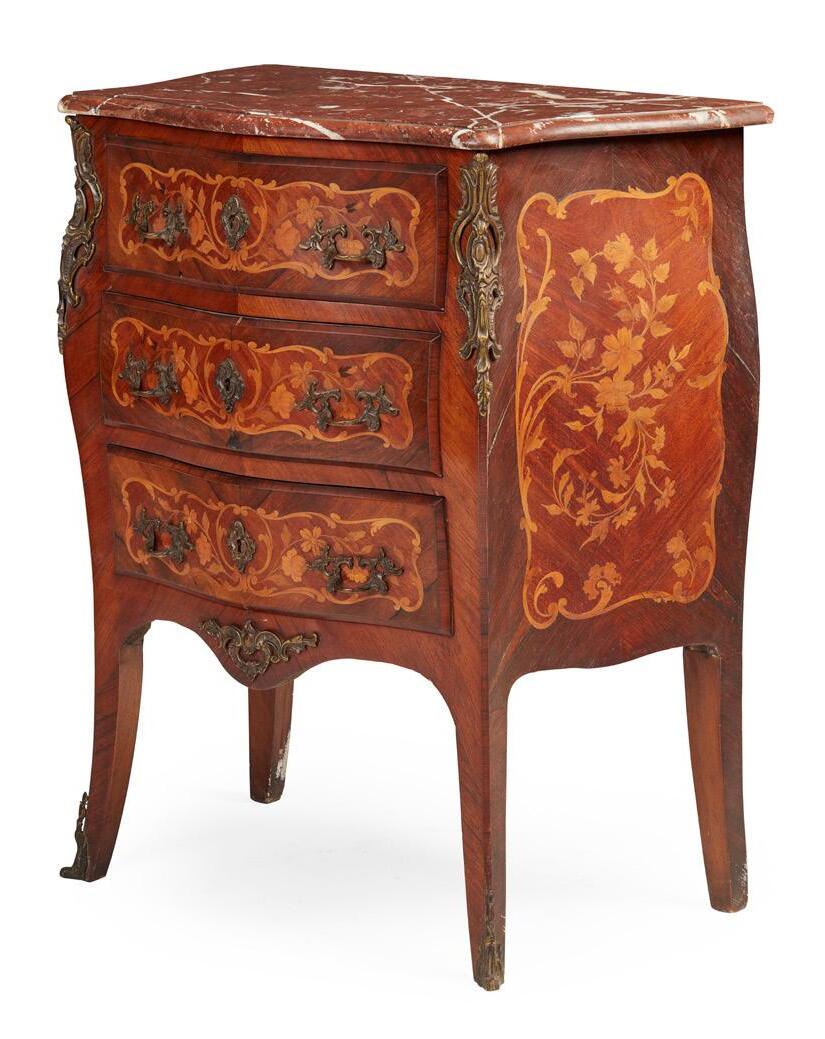

72cm wide, 86cm high, 42cm deep
£400-600
XV STYLE MAHOGANY TWO-TIER ETAGÈRE
557 FRENCH KINGWOOD, AMARANTH, AND MARQUETRY PETITE BOMBÉ COMMODE 19TH CENTURY
556
FRENCH KINGWOOD AND VERNIS MARTIN CORNER VITRINE CABINET
203 Other fees apply in addition to the hammer price: see the ‘Buyer’s Guide’ section on page 2
558
FRENCH GILT BRONZE AND CLOISONNÉ ENAMEL MANTEL CLOCK
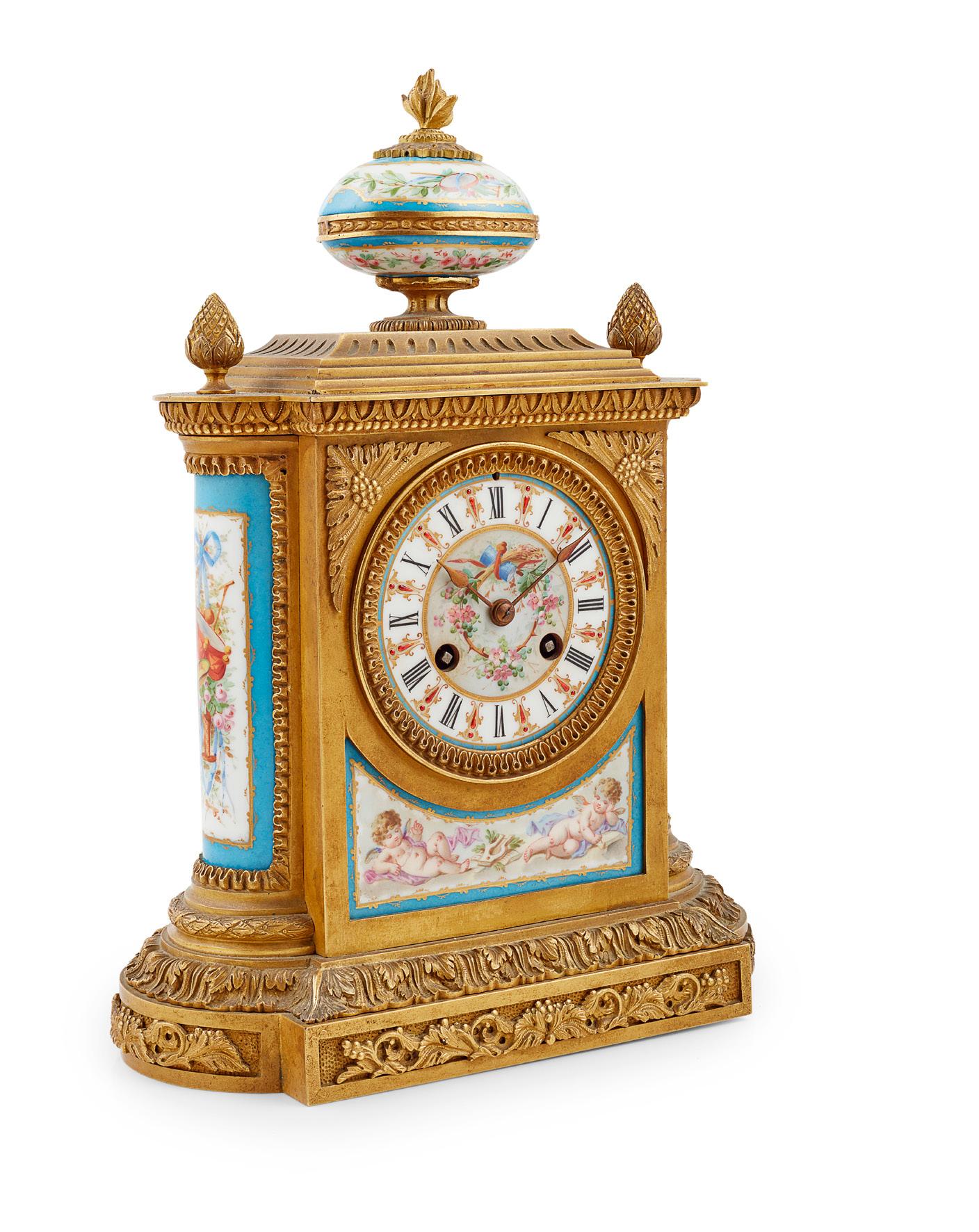
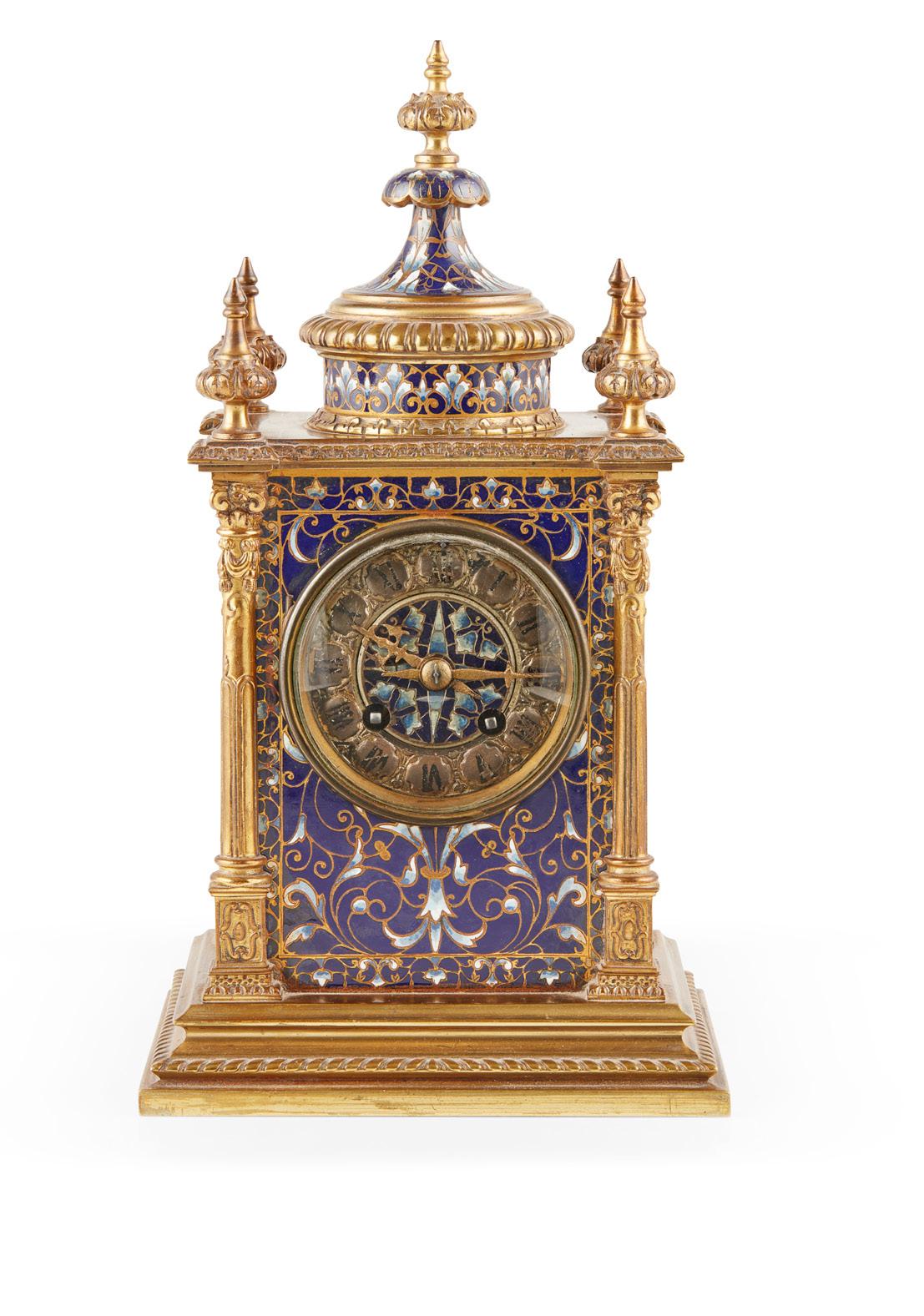
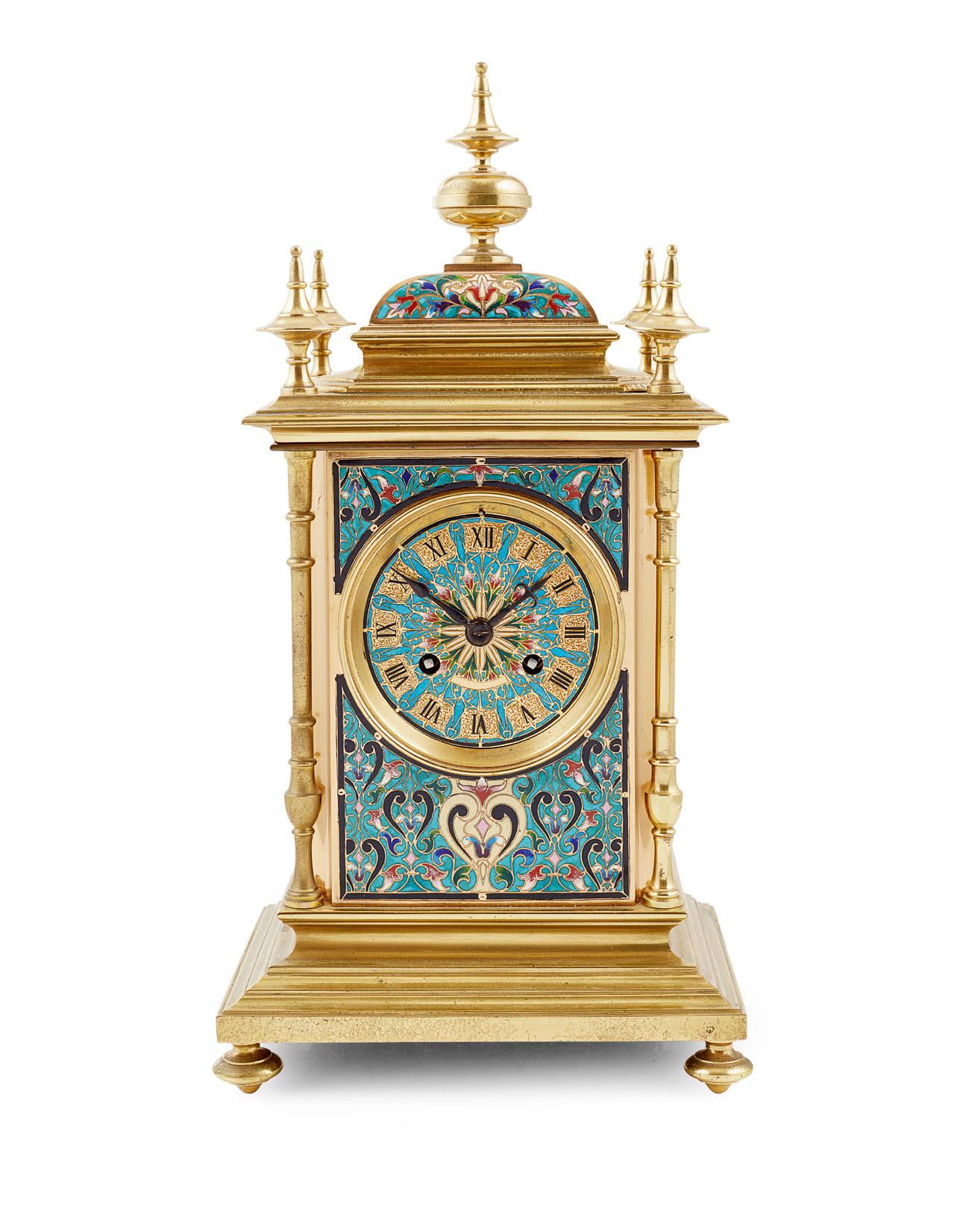
LATE 19TH CENTURY
the silvered dial with Roman numerals and an enamel mask, the architectural case with pagoda top above scrolling foliate enamel panels with pilaster supports topped with pointed acanthus finials, on a gadrooned moulded plinth base, the twin-train brass movement striking to a bell, stamped ‘’CHLES M1’ and numbered 33790, the pendulum with matching numerals
15.5cm wide, 28cm high, 12.5cm deep
£500-700
559
FRENCH BRASS AND CHAMPLEVÉ ENAMEL
MANTEL CLOCK
19TH CENTURY
the gilt and enamel dial with black Roman numerals and a repeating foliate centre, the architectural case with a bell top with five gilt finials, the side and front enamel panels cornered by turned columns, on a stepped base with turned feet, the brass twin train movement striking a bell
18cm wide, 35cm high, 15cm deep
£400-600
560
FRENCH SÈVRES STYLE PORCELAIN AND GILT BRONZE MANTEL CLOCK
19TH CENTURY
the painted and jewelled porcelain dial with black Roman numerals, in a breakfront case surmounted with a porcelain urn and berry finials, the front and side panels painted with putti, trophies and garlands, above an acanthus cast bracket base, the brass twin train movement stamped ‘J.B.D’, numbered ‘30202 16_2’ and striking a bell
24cm high, 34cm high, 13cm deep
£300-500
204
561
AFTER AUGUSTE MOREAU (FRENCH 1834-1917)
LATE 19TH / EARLY 20TH CENTURY
bronze, light burnished patina, modelled as two peasant girls with a basket of grapes, the base signed and with a Paris foundry stamp, on a circular purple veined white variegated marble base
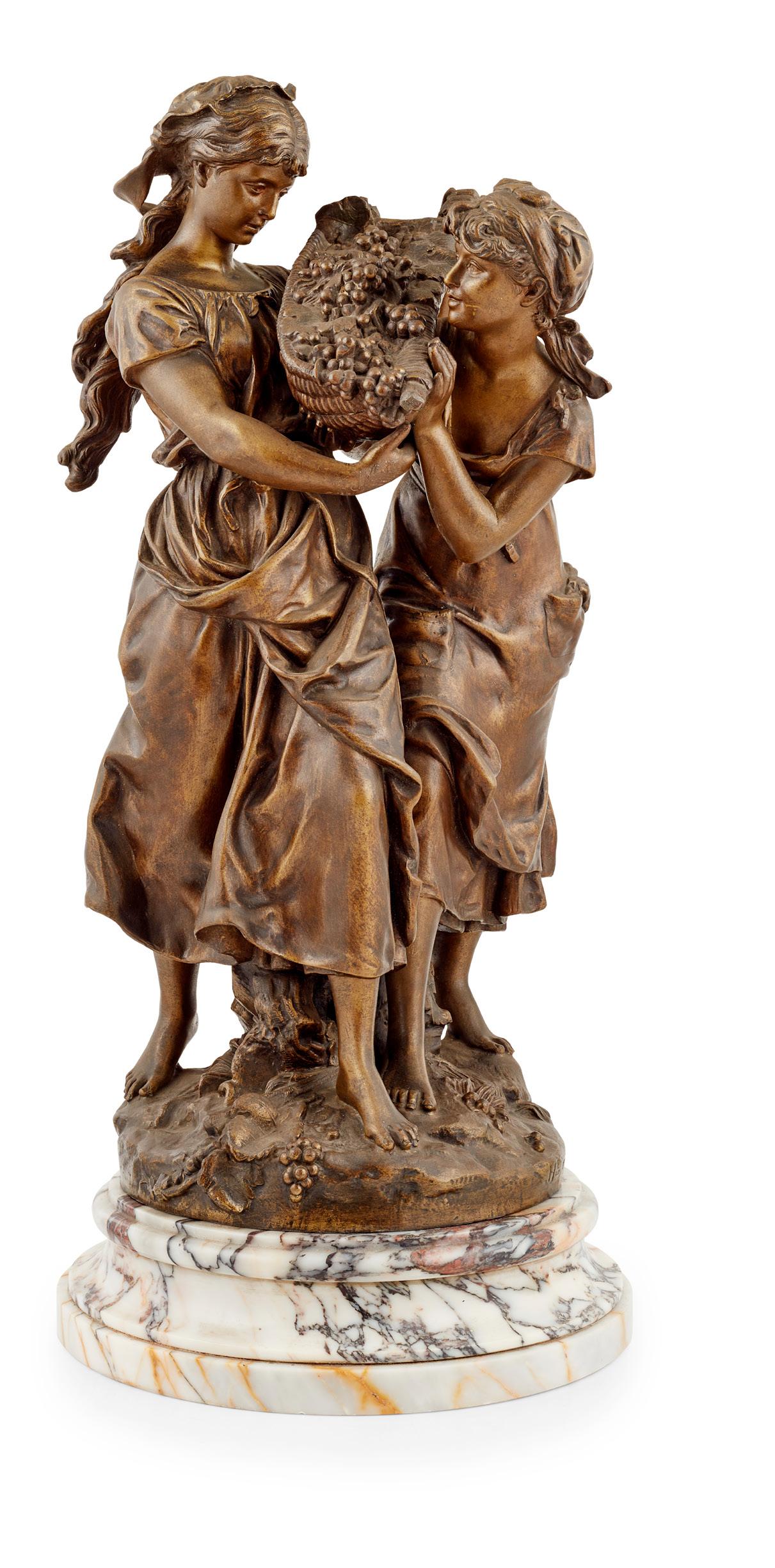
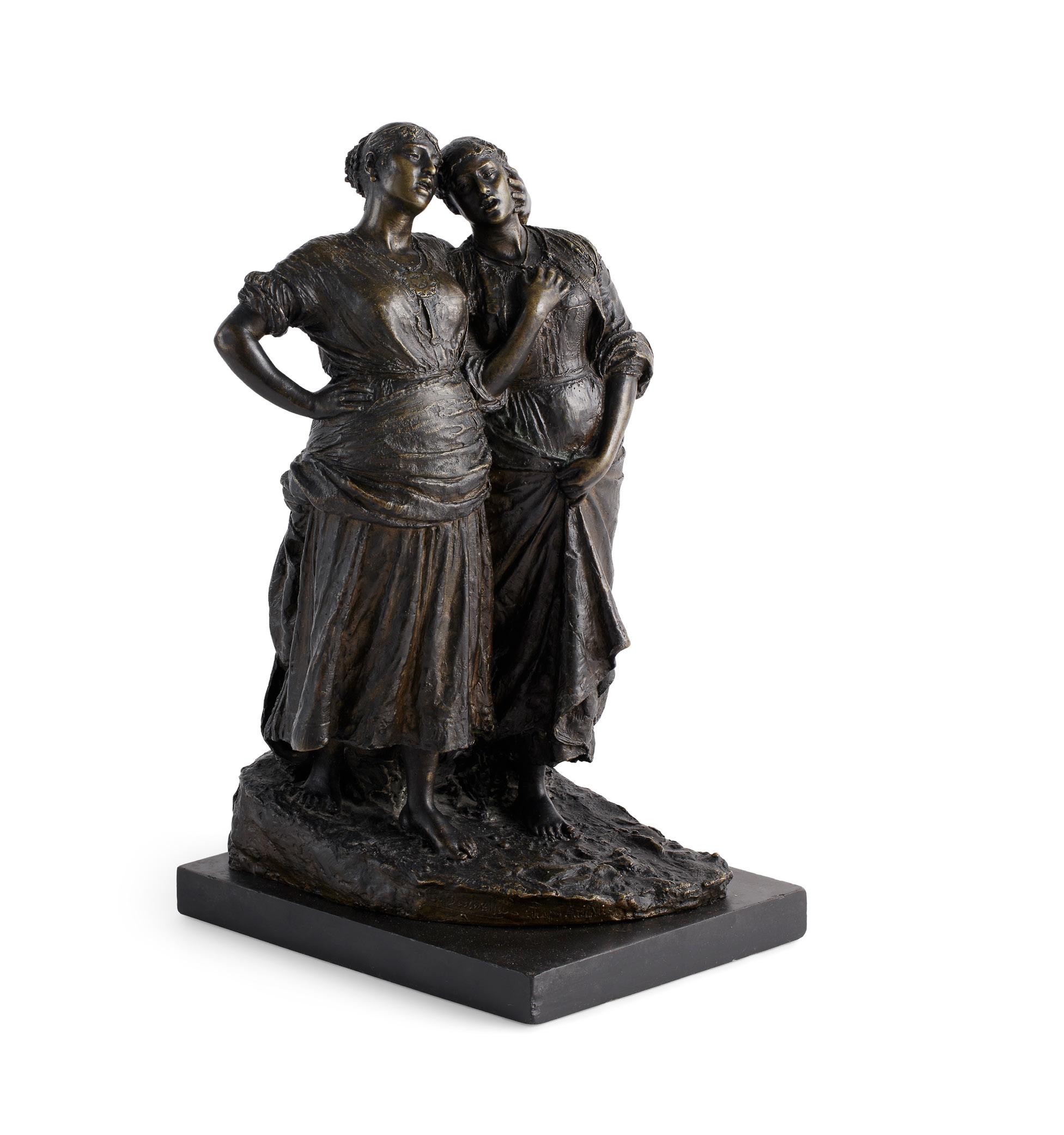
26cm in diameter, 57cm high
£600-800
562
COSTANTINO BARBELLA (ITALIAN 1852 - 1925)
ARMONIA (HARMONY)
bronze, dark brown patina, signed on the base, on a black slate plinth
15.5cm wide, 33cm high, 20cm deep
Note: Examples of this bronze were exhibited in Rome in 1883 and 1903. For further reading on this model see: A. Lancellotti, Costantino Barbella (1852-1925), Rome 1934, p. 145; F. Bellonzi, Costantino Barbella: 1852-1925, Chieti 1983, p. 54 & P. Del Cimmuto, I. Valente (edited by), Costantino Barbella: fogli di pensieri: 1852-1925, Naples 2014, p. 201.
£2,500-3,500
205 Other fees apply in addition to the hammer price: see the ‘Buyer’s Guide’ section on page 2
563
FRENCH BRASS CARRIAGE CLOCK

LATE 19TH CENTURY
the white enamel dial with black Roman numerals, column anglaise riche case with filigree friezes and bevelled glass panels, the twin train brass movement with silvered platform escapement, striking the full and half hours to a coiled steel gong
10cm wide, 19cm high [handle up], 9cm deep Provenance: Private Scottish Collection, Morayshire
£300-500
564
HANS DIETRICH (AUSTRIAN 1868-1936)
JOSEF LEWINSKY AS CARLOS IN CLAVIGO
bronze, dark brown patina, signed on the base, on a square red variegated marble plinth with bronze plaque
11cm square, 43cm high
Note: Josef Lewinsky (1835–1907) made his first appearance at the Hofburgtheater in 1858, and in 1861 was appointed a Burgtheater actor for life. He is depicted here in his role as Carlos in Johann Wolfgang von Goethe’s drama ‘Clavigo’, one of the outstanding roles of his career. He was also painted in a very similar pose in 1895 by Gustav Klimt, the painting now in the collection of The Belvedere Museum, Vienna.
£500-700
565
FRENCH BRONZE FIGURE OF A REVOLUTIONARY
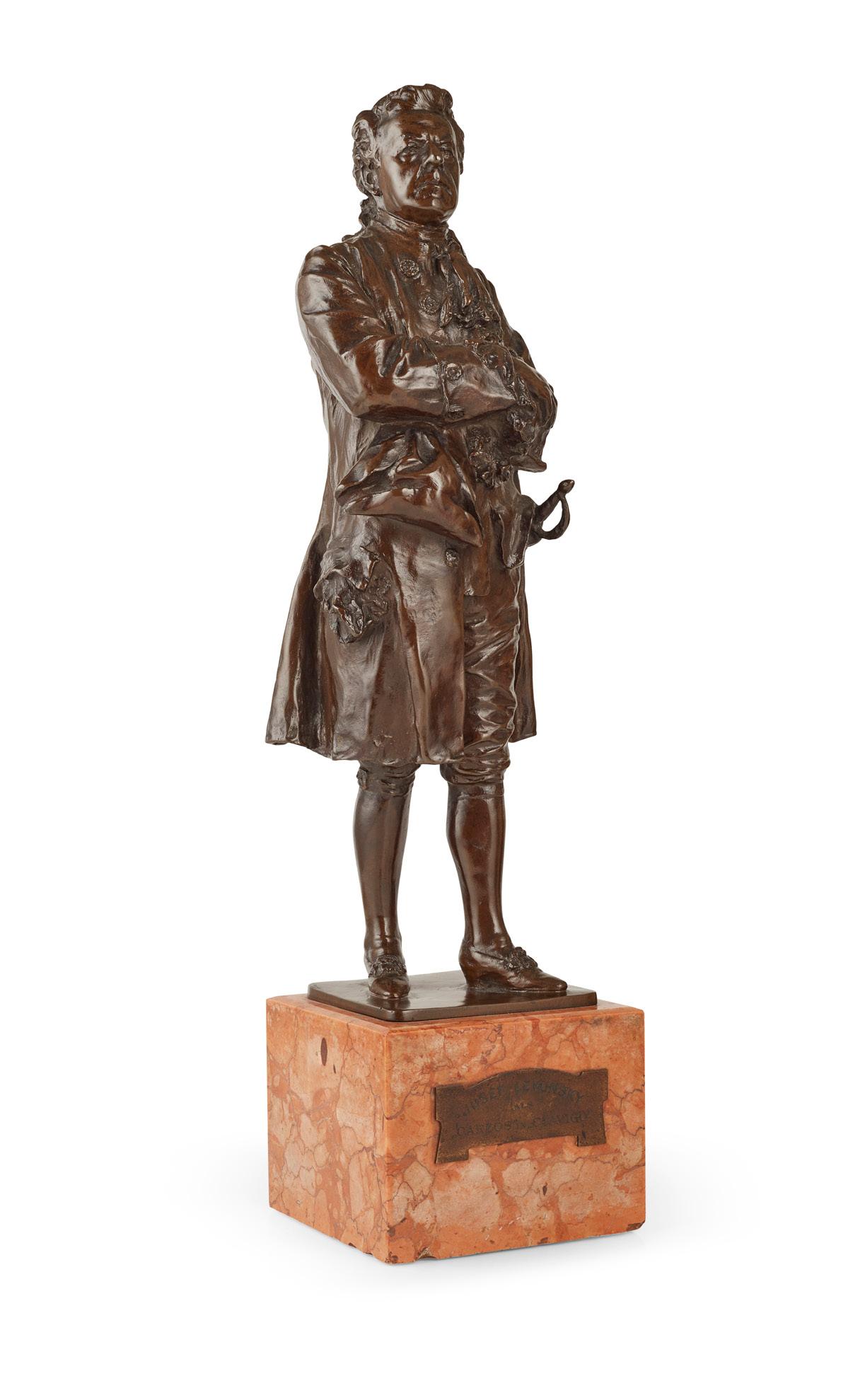
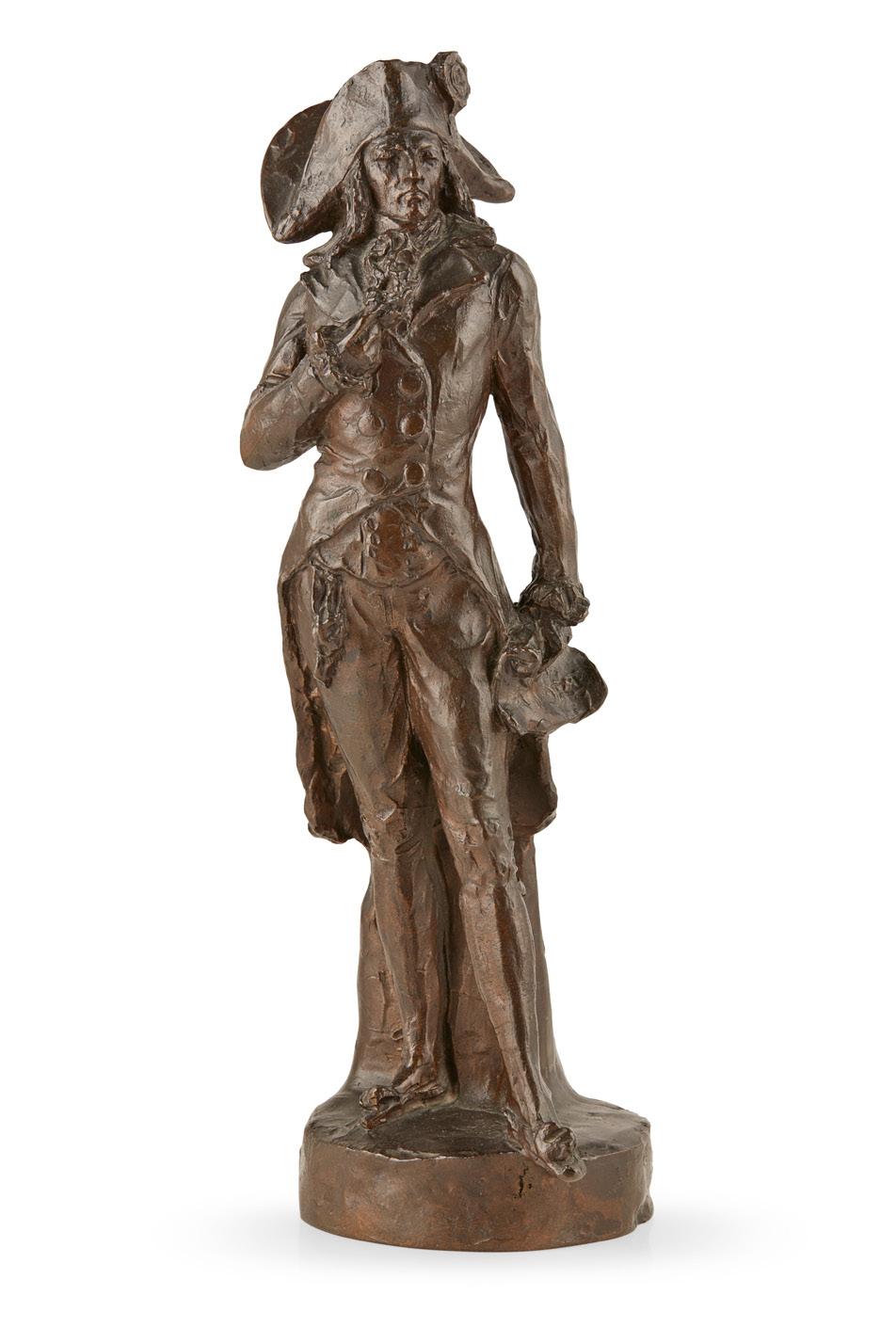
LATE 19TH CENTURY
dark brown patina, modelled as a man standing in bicorn hat and coat holding a scroll, the scroll signed ‘À Mort’
10cm in diameter, 34cm high
Note: “Mort aux tyrans, paix aux chaumines (Death to the tyrants, peace to the cottages)” was an oath taken at the foot of the statue of Liberty at the place de la Révolution by Jacobins on 21 January 1794 and marked the one-year anniversary of King Louis XVI’s death. The quote on the scroll of ‘à mort’ (to death or life-and-death) may be in reference to this or to The Reign of Terror and the numerous public executions took place in response to revolutionary fervour.
£500-700
566
FRENCH BRONZE FIGURE OF A TIGER SECOND HALF 19TH CENTURY dark brown patina, unsigned 27cm wide, 15cm high, 12cm deep
£600-800

206 Other fees apply in addition to the hammer price: see the ‘Buyer’s Guide’ section on page 2
567
TWO FRENCH GILT BRONZE CARRIAGE CLOCKS
LATE 19TH CENTURY
the first with a gilt dial with cream enamel chapter ring with black Arabic numerals with a pierced scrolling floral gilt mask, the reeded column anglais riche case with pierced friezes, swing handle and bevelled glass panels, the single train timepiece movement with platform escapement; the second a miniature, the gilt dial with cream enamel chapter ring with black Arabic numerals with a plain gilt mask, the textured column anglais riche case with filigree friezes and swing handle, the single train timepiece movement with silvered platform escapement (2) larger 8cm wide, 15.5cm high [handle up], 6.5cm deep, the smaller 6.5cm wide, 12.5cm high [handle up], 6cm deep
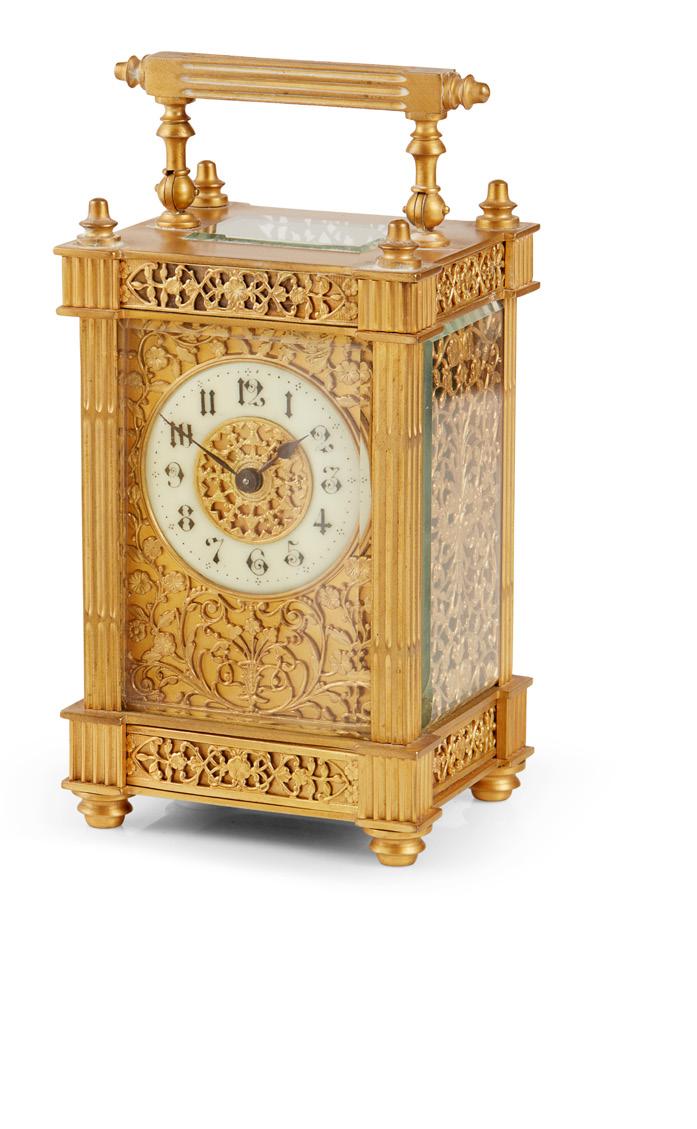
Provenance: Private Scottish Collection, Morayshire
£300-500
568
PIERRE-JULES MÊNE (FRENCH 1810–1879)
THE ARAB FALCONER bronze, dark brown patina, signed and dated 1873 to base, the falcon lacking, on an integral gilt metal socle 21cm diameter, 56cm high
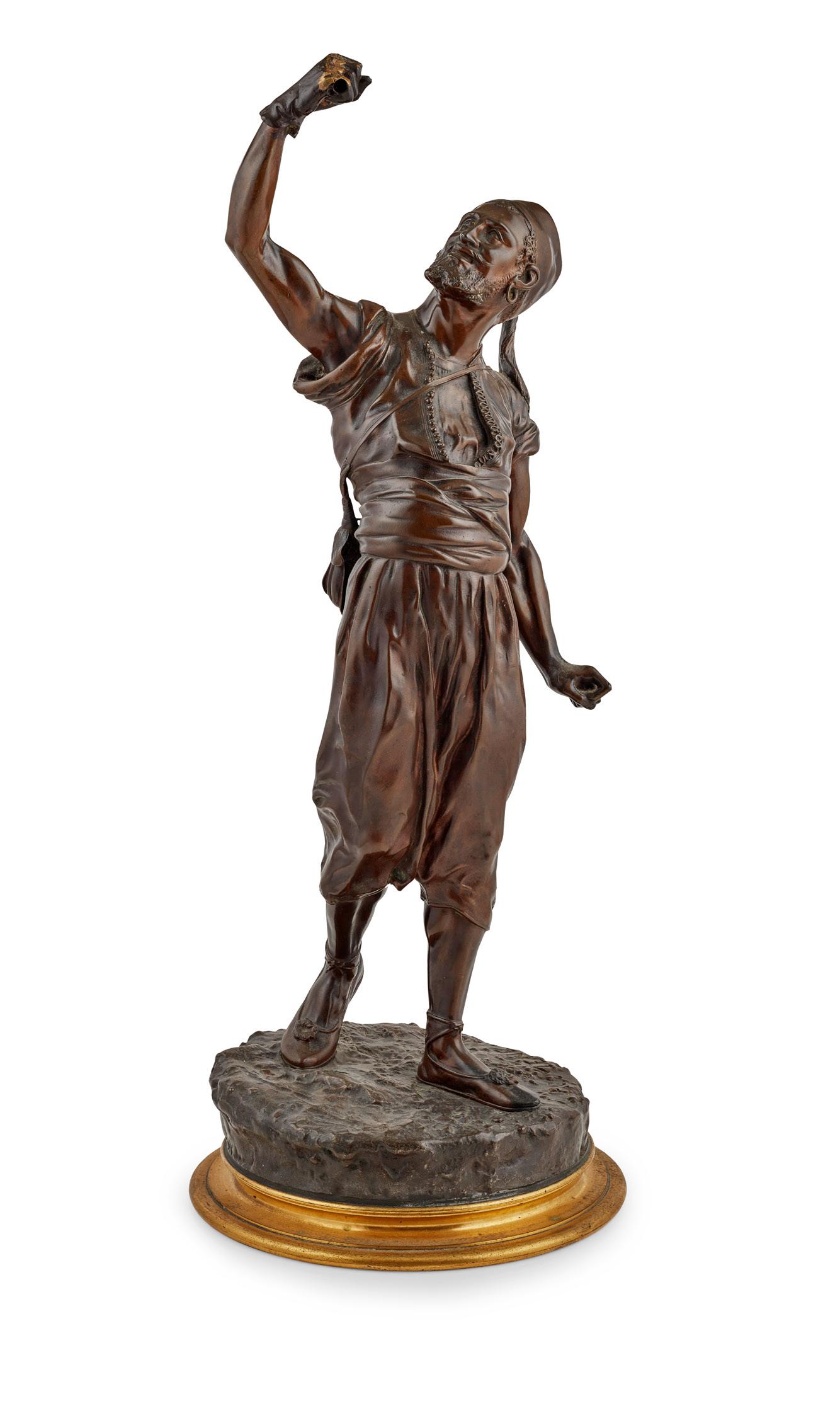
£400-600
569
FRENCH GILT BRONZE AND WHITE MARBLE MANTEL CLOCK


LATE 18TH CENTURY AND LATER
the white enamel dial with Arabic numerals, signed ‘Levol a Paris’, in an arched top case surmounted by an urn and floral garlands, the base mounted with a miniature painting of a street scene flanking by two flowering urns, raised on a inverted breakfront base and toupie feet, the later twin train brass movement by Samuel Martin with outside countwheel, stamped ‘Planchon, Paris’ and numbered ‘193’, striking a bell 21cm wide, 33cm high, 9cm deep
£300-400
207
570
PAIR OF FRENCH EMPIRE STYLE PORCELAIN VASE LAMPS

20TH CENTURY
of urn form with upright sphinx handles, the bisque porcelain the bodies highlighted with gilding, with a repeating green foliate pattern and relief portrait medallions, on socles with square bases, fitted for electricity (2) 19cm wide, 62cm high (excluding fitting)
£400-600
571
FRENCH DIRECTOIRE MAHOGANY AND BRASS

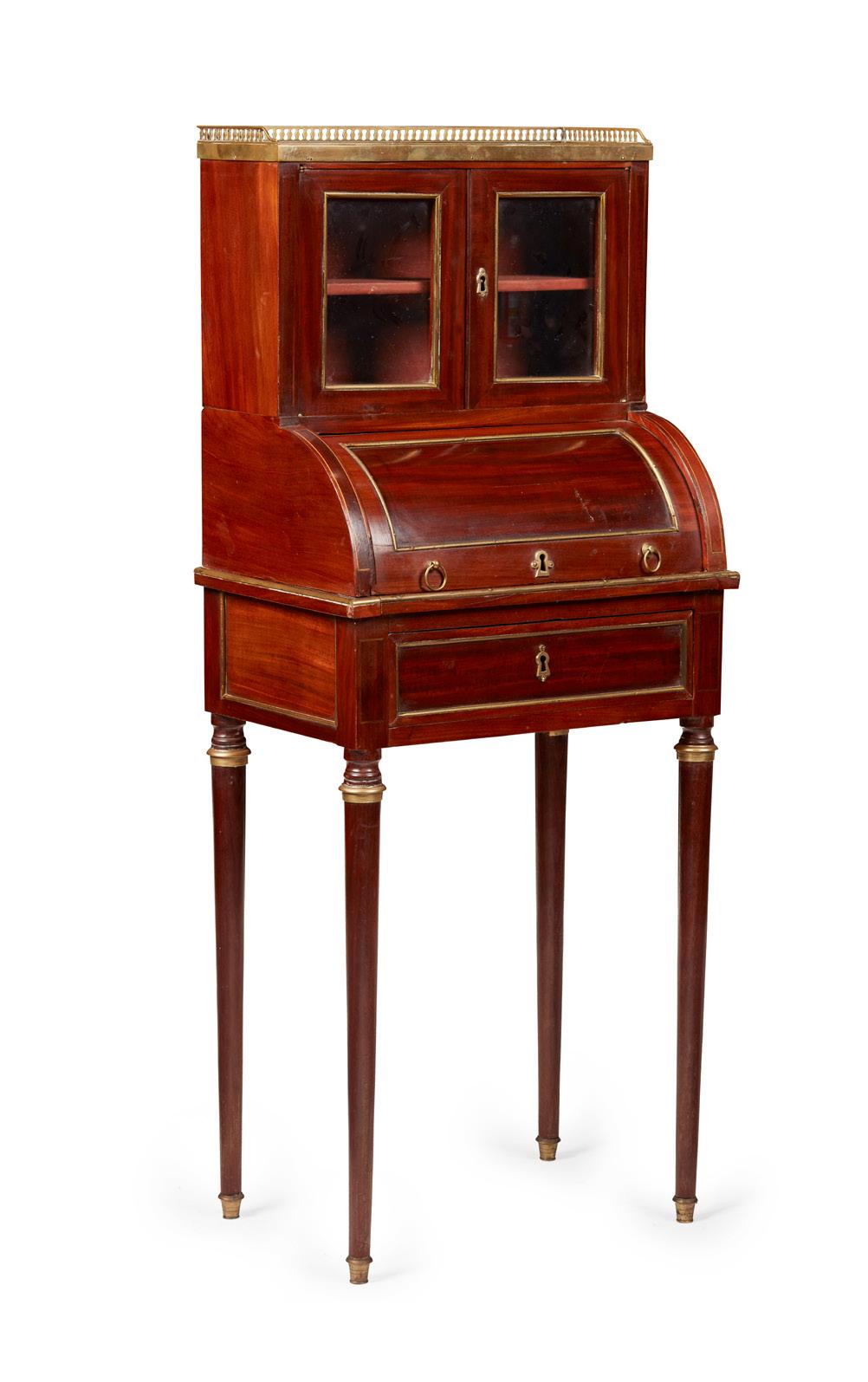
BUREAU DE DAME
LATE 18TH CENTURY
the white marble top with a pierced brass gallery above a pair of glazed doors enclosing a shelf, over a cylinder front opening to an arrangement of drawers and a writing surface, above a frieze drawer and raised on tapered legs with brass mounts
48cm wide, 118cm high, 32.5cm deep
£400-600
572
FRENCH EMPIRE STYLE MAHOGANY AND GLASS ‘HARP’ FIRE SCREEN

LATE 19TH CENTURY
the mahogany frame with gilt bronze mounts, enclosing a bevelled glass panel, raised on gilt bronze claw feet
112cm high, 62cm wide
£600-800
573
FRENCH DIRECTOIRE STYLE
MAHOGANY AND BRASS
DOUBLE-FOLD TEA AND CARD TABLE
LATE 19TH CENTURY
the demilune fold-over tops opening to a plain surface and further to a green baize playing surface with an embossed leather border, raised on square tapering legs ending in brass caps 100cm diameter [opened], 78cm high, 50cm deep
£600-800
208
574
CONTINENTAL GILTWOOD AND GESSO PIER MIRROR
18TH CENTURY
the rectangular divided mirror plates in a leaf tip and ribbon moulded frame

164cm high, 73cm wide £500-800
575
BALTIC MAHOGANY BRASS MOUNTED VITRINE CABINET
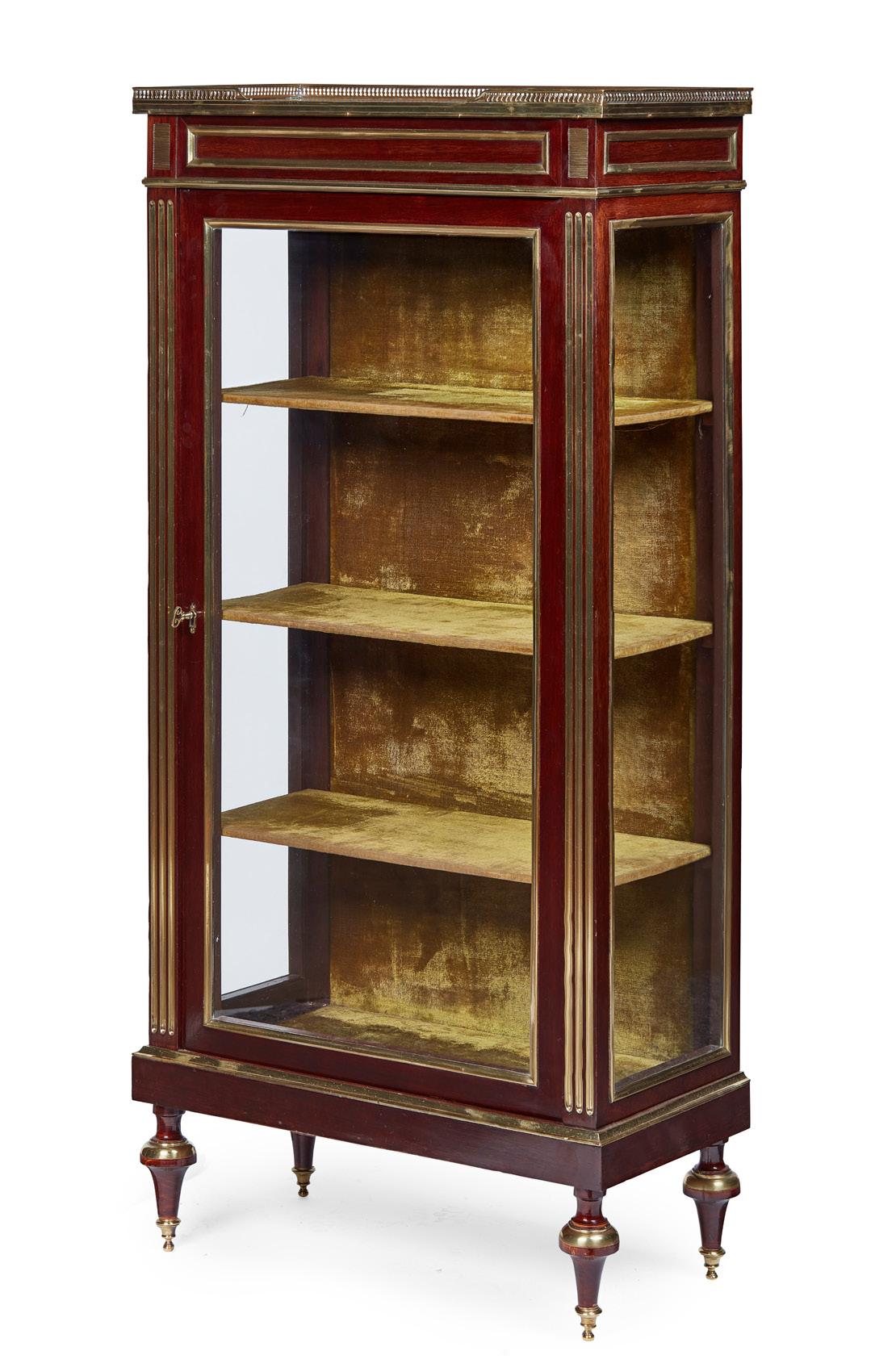
LATE 19TH CENTURY
the rouge marble top with a pierced brass gallery above brass lined frieze and glazed door and side lights, enclosing a green plush lined interior, flanked by brass lined fluted square pilasters and raised on tapered feet
66cm wide, 142cm high, 31cm deep £600-800
576
FRENCH PROVINCIAL FRUITWOOD CHAISE LONGUE 19TH CENTURY
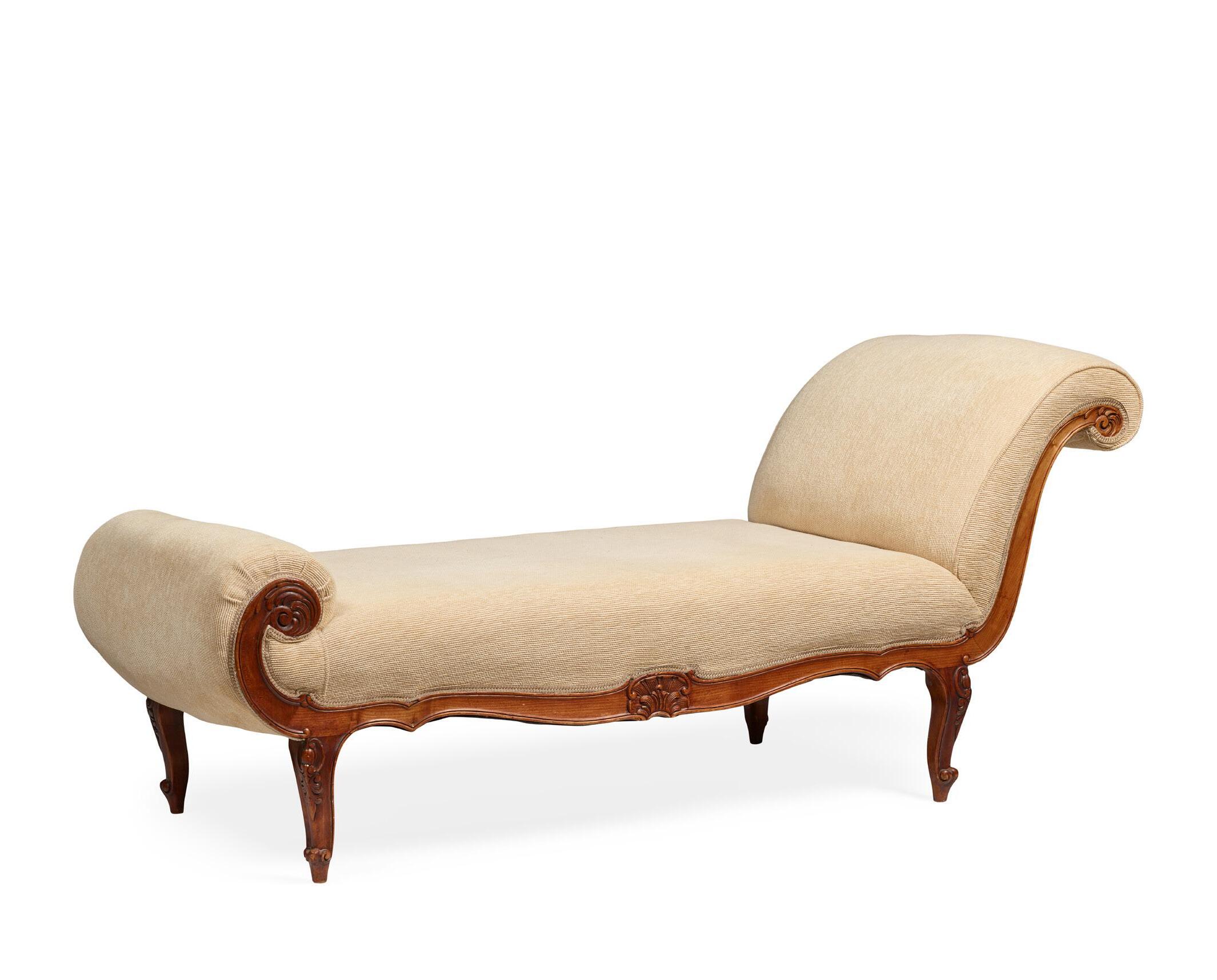
with a scrolled head rest and foot bolster, the frame carved with acanthus and shell motifs, raised on cabriole legs with scrolled toes, covered in modern ivory chenille upholstery
185cm long, 79cm high, 72cm deep
£500-700
209 Other fees apply in addition to the hammer price: see the ‘Buyer’s Guide’ section on page 2
578
FRENCH MAHOGANY MARBLE TOPPED VITRINE CABINET

EARLY 20TH CENTURY
the top with a pierced brass gallery and rouge marble insert above a bow front glazed door and sides, enclosing a green plush interior with glass shelves, raised on cabriole legs, the whole outlined with gilt metal mounts and ending in sabots
68cm wide. 141cm high, 32cm deep
Provenance: Private Scottish Collection, Morayshire
£500-700
577
SET OF SIX LOUIS PHILLIPE SPALTED BEECH SIDE CHAIRS
MID 19TH CENTURY
the oval padded backs with carved cartouches cresting, above serpentine stuffover seats, raised on facetted tapered legs, covered in dark blue plush with floral needlework panels
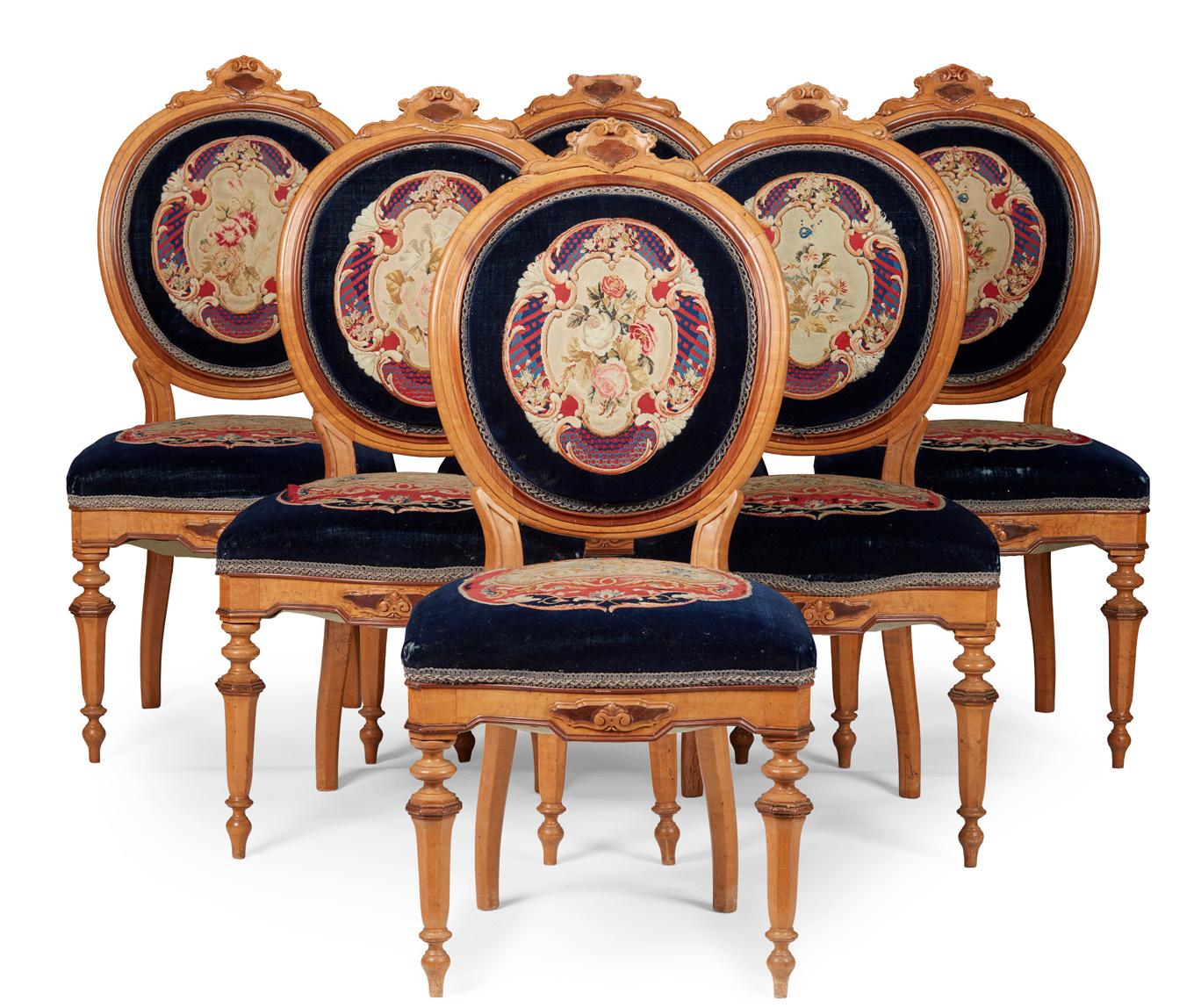
50cm wide, 103cm high, 43cm high
£400-600
NAPOLEON III EBONISED AND PREMIÈRE
PARTIE BOULLE MARQUETRY CREDENZA
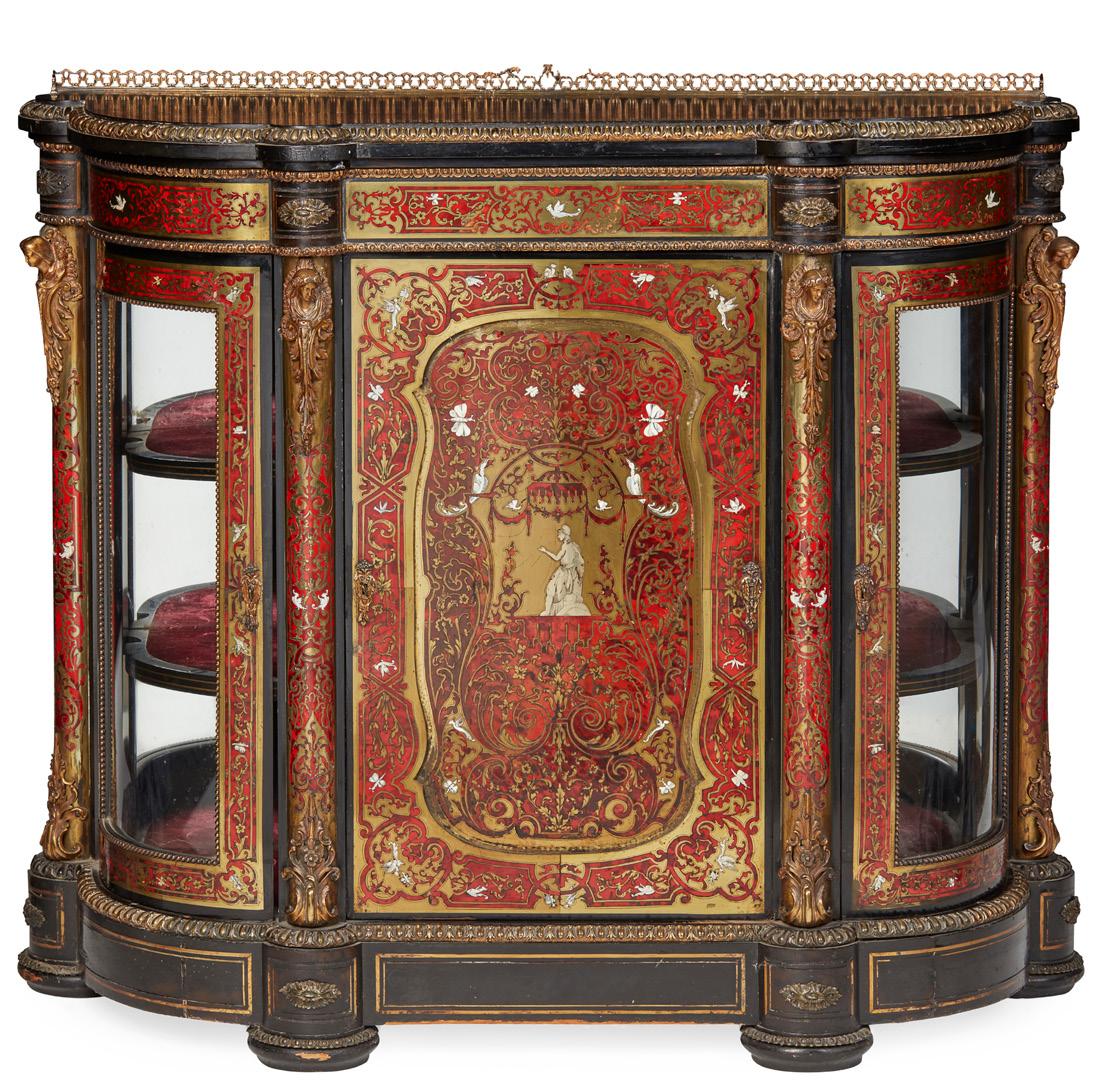
MID 19TH CENTURY
the shaped demi-lune top with a pierced brass gallery above a central recessed panel door decorated in the manner of Berain, flanked by glazed quarter-round doors enclosing shelves with mirror backs, flanked and divided by gilt bronze terms, on a shaped plinth base 111 cm wide, 102cm high, 41cm deep
Provenance: Private Scottish Collection, Morayshire
£800-1,200
579 Y
210
580
LOUIS PHILIPPE SATINWOOD, KINGWOOD, AND BRASS BANDED CENTRE TABLE
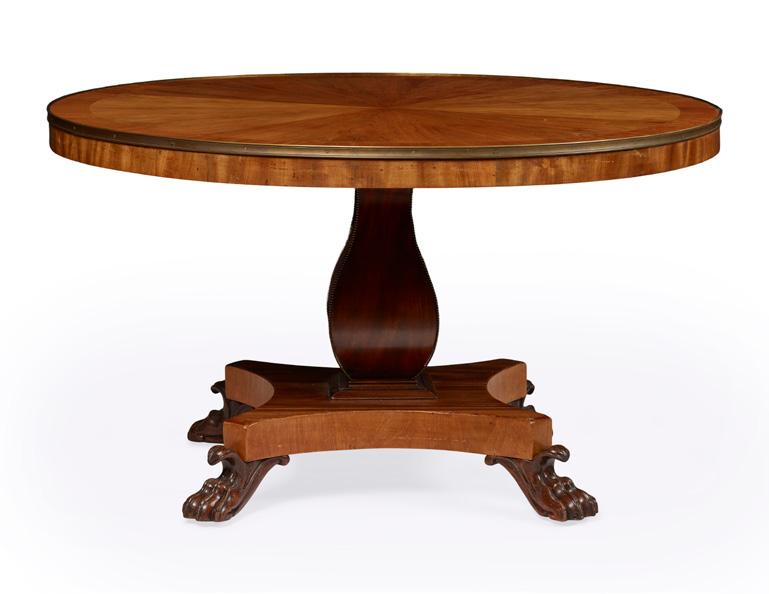
MID 19TH CENTURY
the crossbanded circular tilt top banded in brass with radial veneers, on a square baluster column and concave quadripartite platform raised on carved claw feet with brass castors
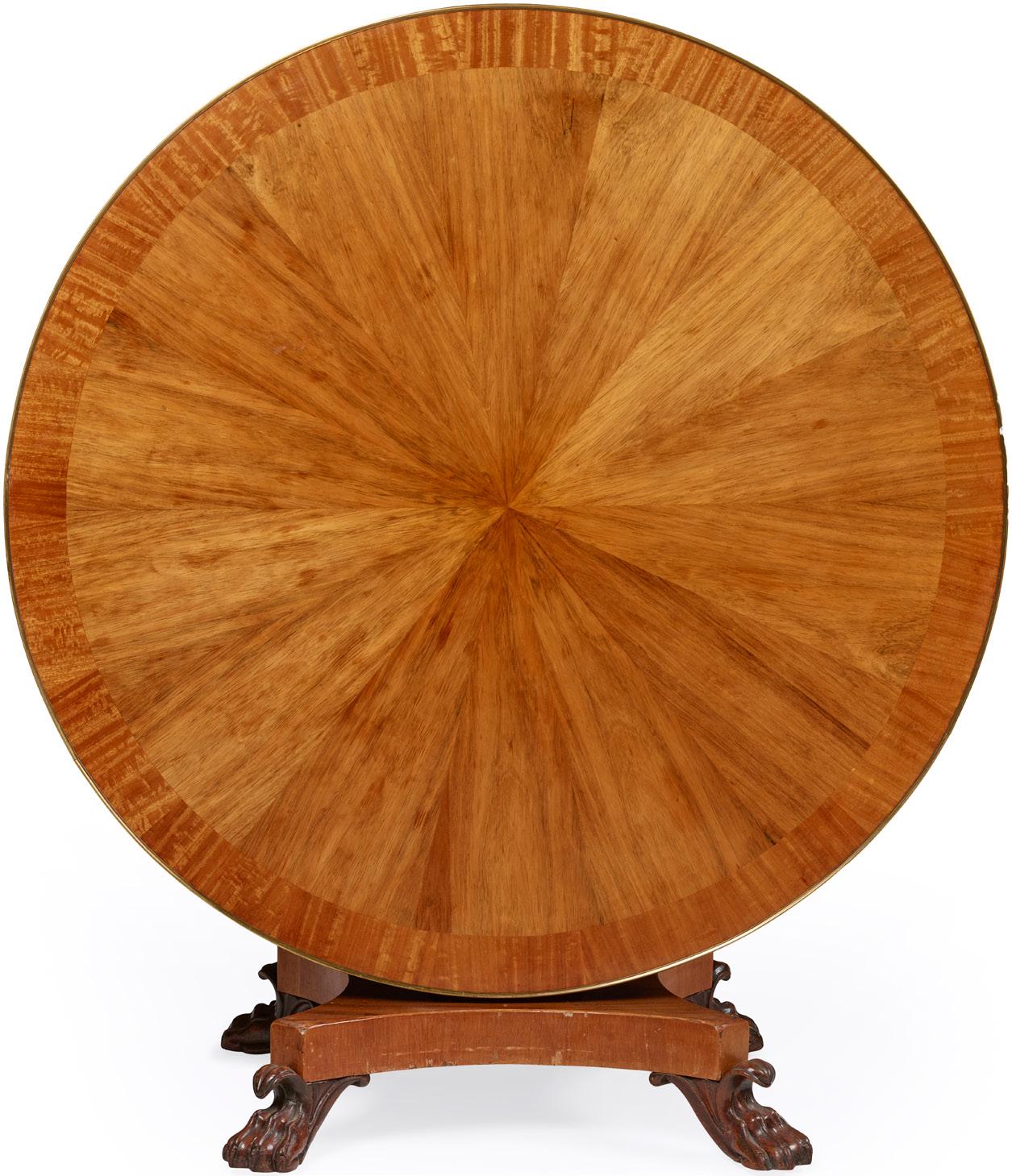

134cm diameter, 76cm high £800-1,200
581
CONTINENTAL EBONISED, MARQUETRY, AND GILT BRONZE CREDENZA
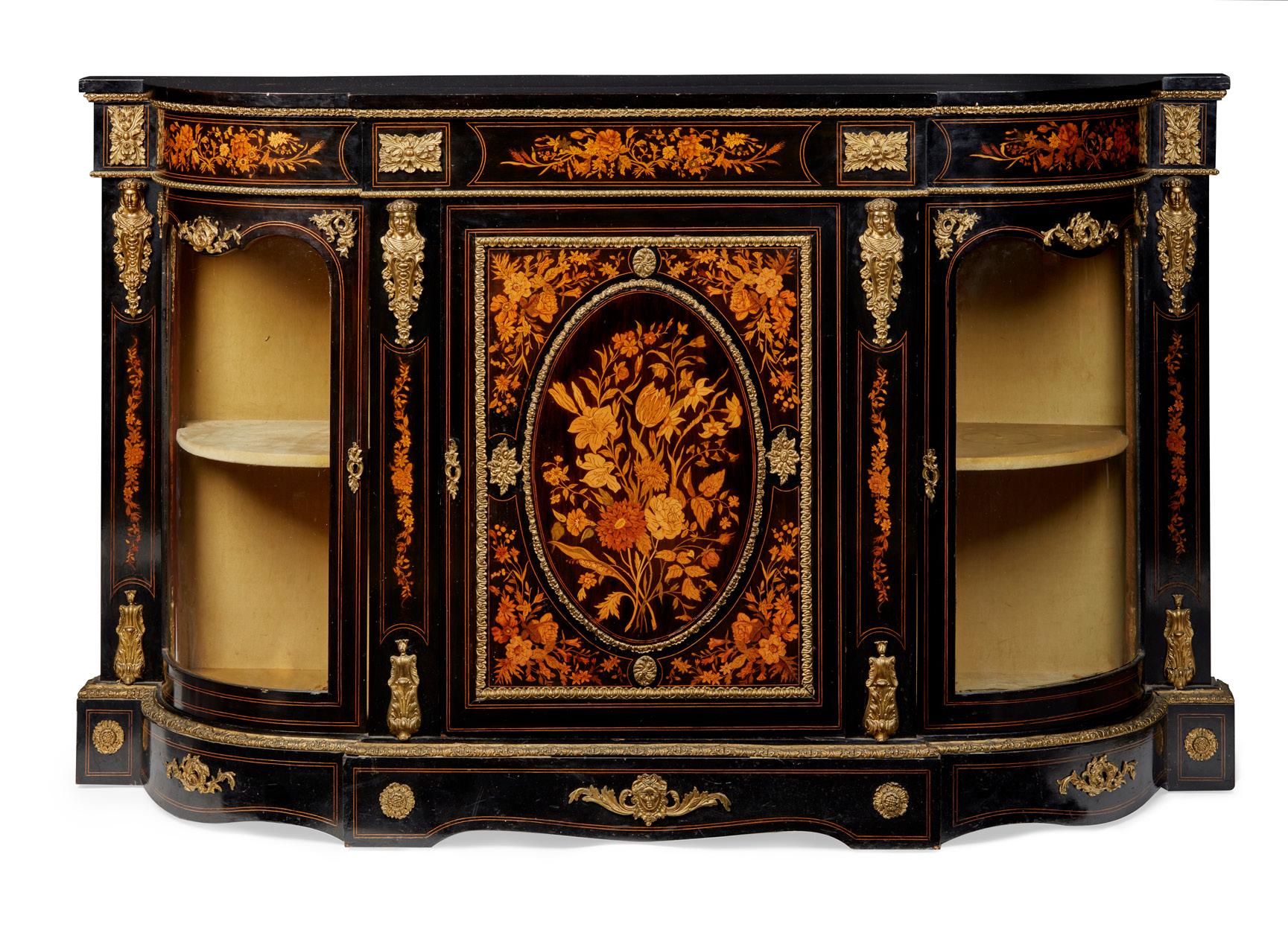
MID 19TH CENTURY
the breakfront D-shaped top above a central door with Dutch floral marquetry, flanked by curved glazed cupboards enclosing shelves with yellow plush lining, on a shaped plinth base, the whole with further floral marquetry and mounted with gilt bronze
188cm wide, 114cm high, 46cm deep £1,800-2,200
211 Other fees apply in addition to the hammer price: see the ‘Buyer’s Guide’ section on page 2
582

PAIR OF BLUE AND WHITE PORCELAIN LAMPS
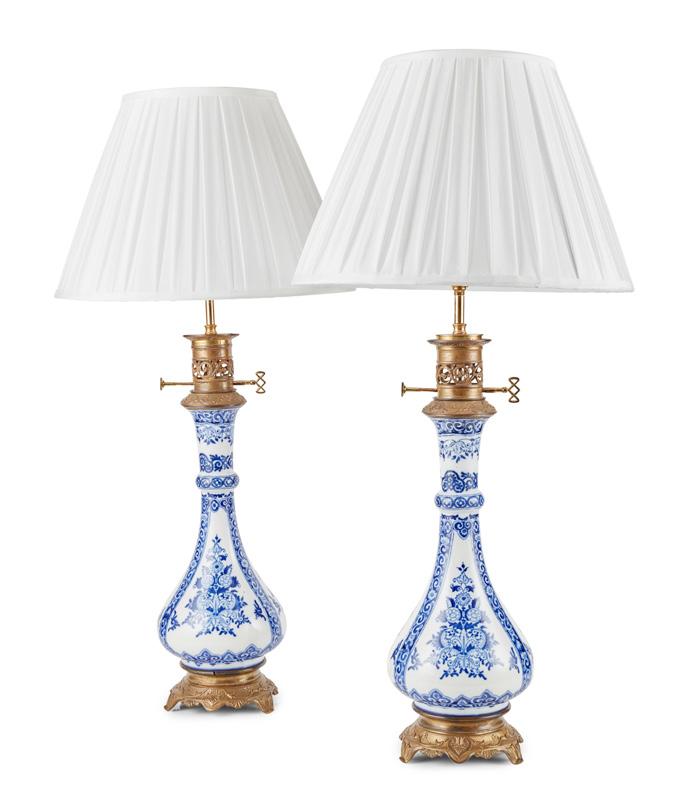
LATE 19TH CENTURY
of guglet form with blue and white transfer printed floral decoration in the Sino-Islamic style, with pierced brass moderator oil lamp mounts later converted to electricity, with white pleated silk shades (2)
17cm diameter, 62cm high
£700-1,000
583
SET OF SIX CONTINENTAL CREAM AND PARCEL GILT SIDE CHAIRS
19TH CENTURY
with a cartouche shaped back on scroll cabriole legs, woven striped upholstery (6)

50cm wide, 99cm high, 48cm deep
£600-800
584
SET OF ELEVEN CONTINENTAL CREAM AND PARCEL GILT SIDE CHAIRS
20TH CENTURY
with a cartouche shaped backs and carved floral details, on scroll cabriole legs, woven striped upholstery (11)

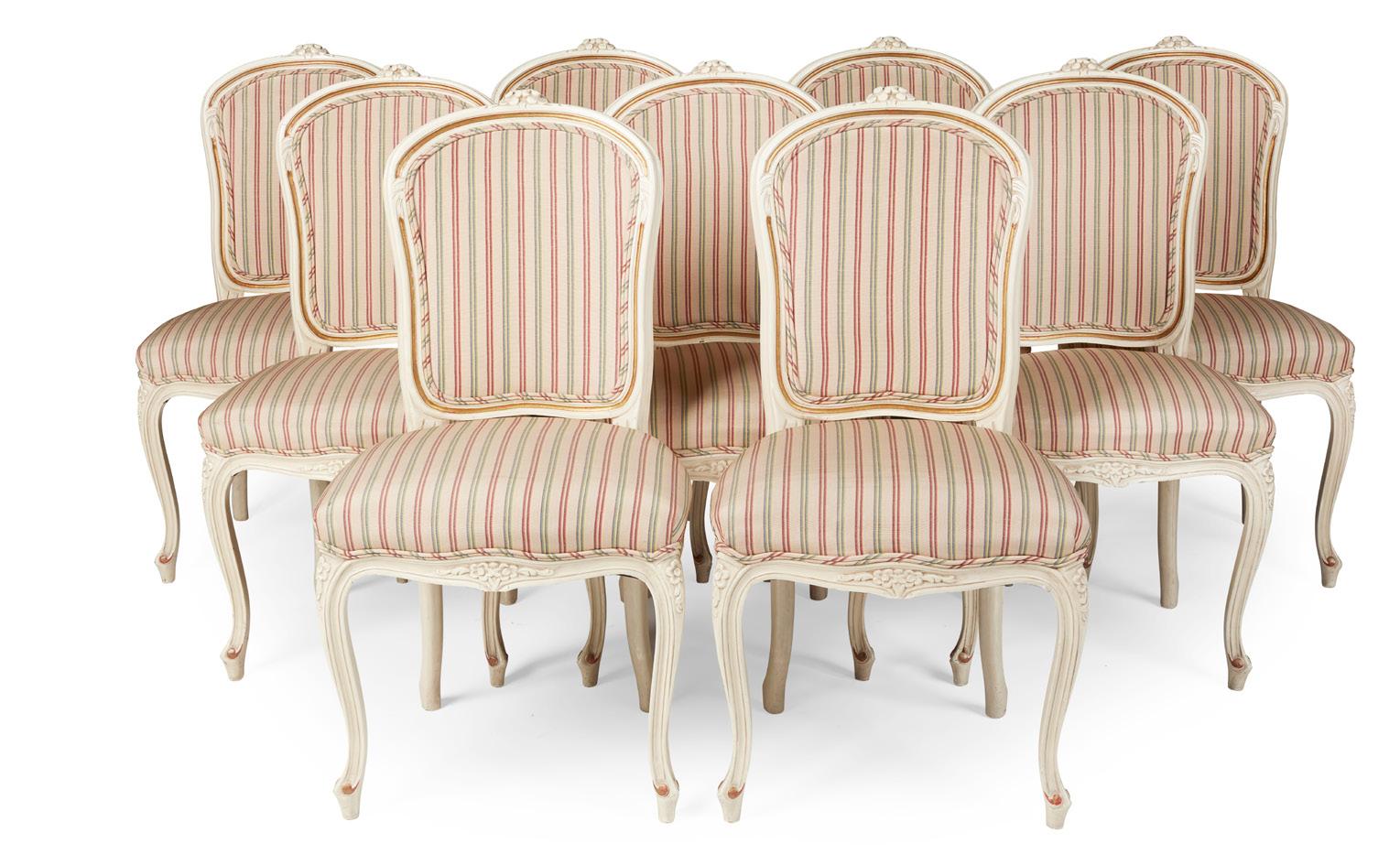
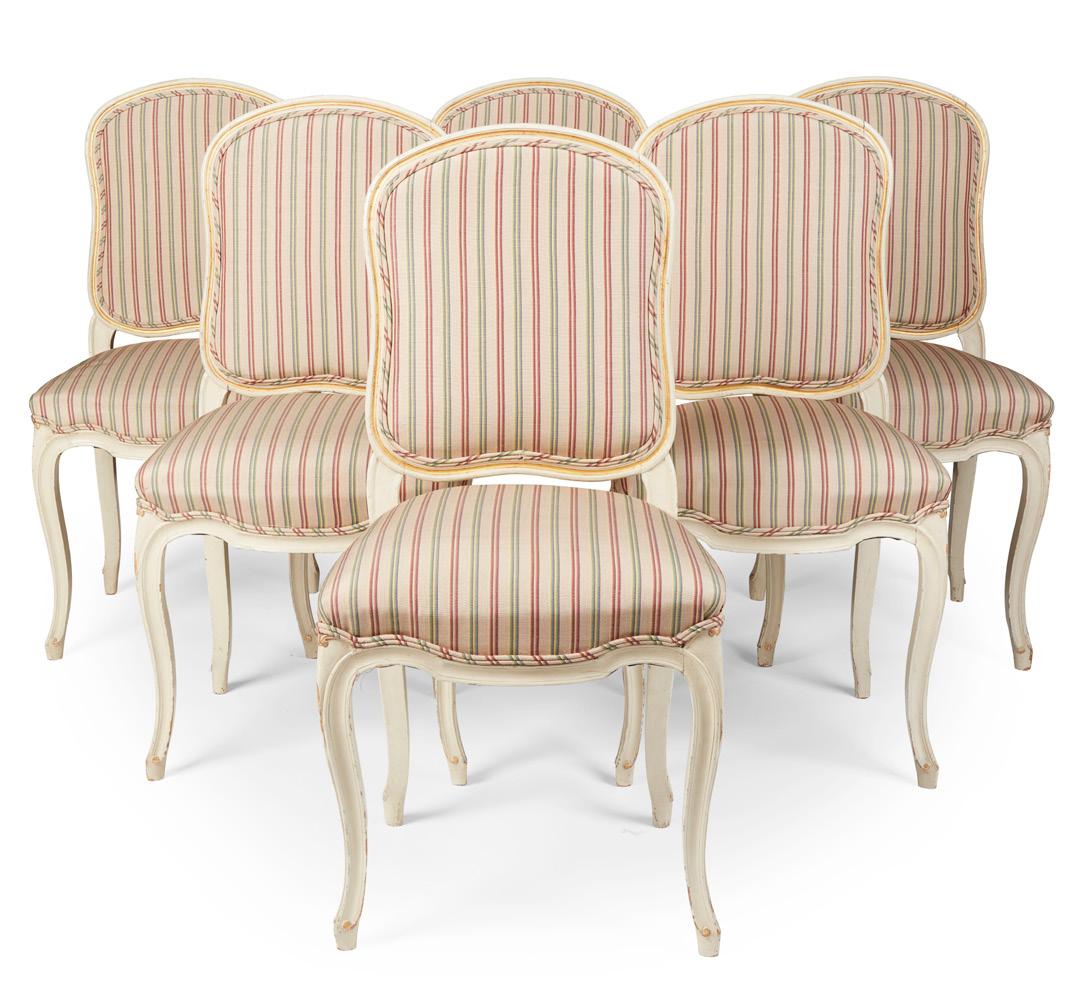
50cm wide, 96cm high, 45cm deep
£1,000-1,500
212 Other fees apply in addition to the hammer price: see the ‘Buyer’s Guide’ section on page 2
585
SET OF FOURTEEN CONTINENTAL CREAM AND PARCEL GILT CHAIRS
20TH CENTURY
oval backs with carved rope twist and floral details, on reeded tapering legs, woven striped upholstery, including two armchairs (14)
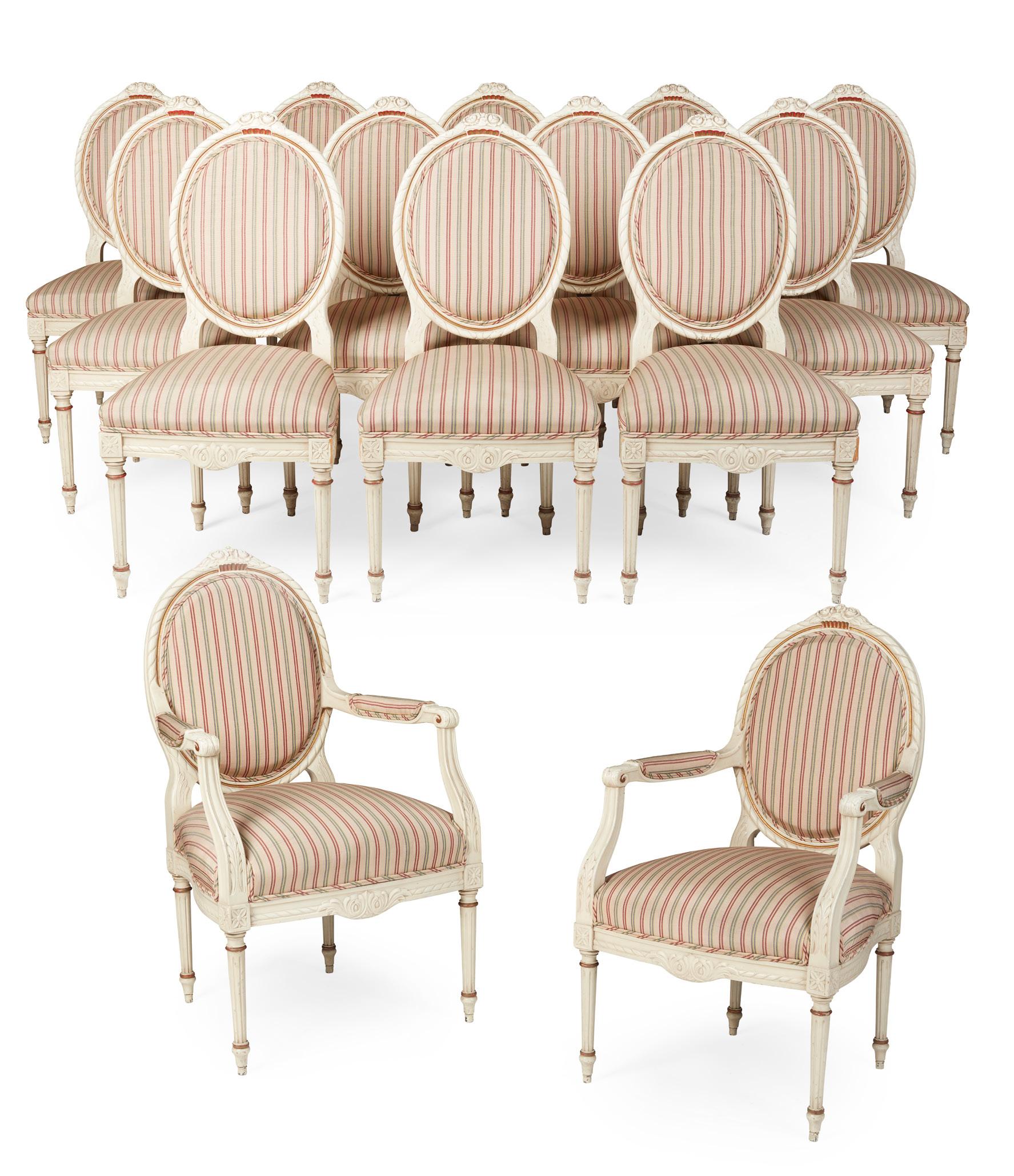
61cm wide, 104cm high, 58cm deep
£1,200-1,800
586
SET OF FOURTEEN CONTINENTAL CREAM AND PARCEL GILT CHAIRS
20TH CENTURY
oval backs with carved rope twist and floral details, on reeded tapering legs, woven striped upholstery, including two armchairs: en suite with the previous lot (14)
61cm wide, 104cm high, 58cm deep
£1,200-1,800
588
FRENCH GILT BRONZE AND ONYX PEDESTAL LATE 19TH/ EARLY 20TH CENTURY
587
PAIR OF CONTINENTAL CREAM AND PARCEL GILT ARMCHAIRS
20TH CENTURY
oval backs with carved rope twist and floral details, on reeded tapering legs, woven striped upholstery: en suite with the previous lot (2)
61cm wide, 104cm high, 58cm deep
£300-500
the square variegated yellow and cream platform top with a moulded edge, supported on plain column with a gilt metal Corinthian capital and laurel banded base, set on a square plinth with a moulded edge and gilt feet 30cm wide, 119cm high, 30cm deep
£400-600
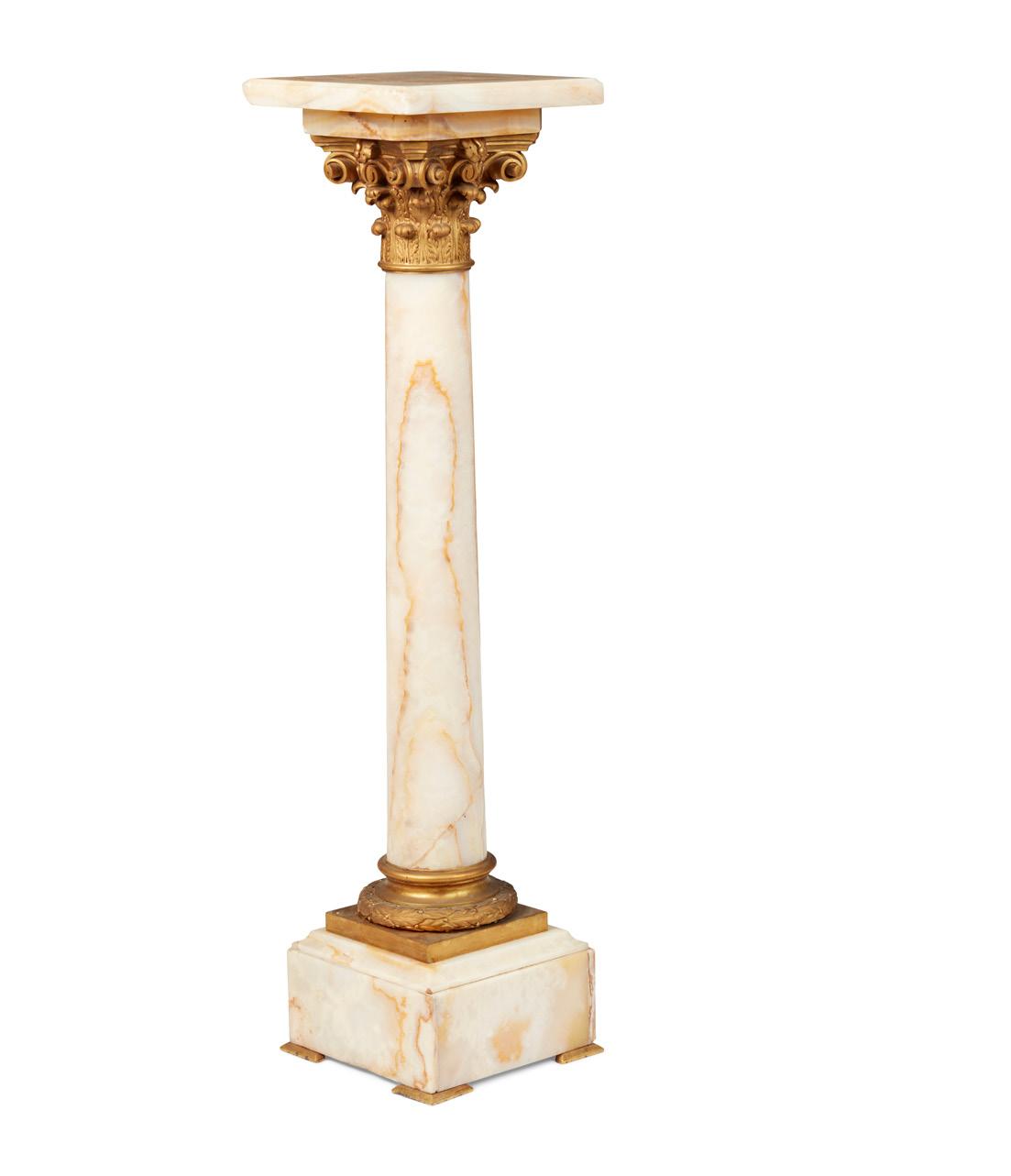
213
589
HERMÈS LEATHER SUITCASE

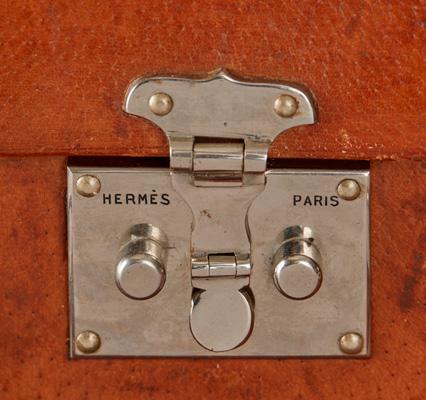
CIRCA 1925
of plain rectangular form covered in tan pigskin, chrome hardware, stamped with a black monogram ‘H.S.Q’ with a nine pearl coronet for a Comte or Comtesse, stamped ‘HERMÈS PARIS, 24 Fg St HONORÉ’ above the lock, the lock hardware stamped 80-3 59cm long, 33cm wide, 18cm high £800-1,200
590
LOUIS VUITTON STEAM TRUNK
CIRCA 1915
orange Vuittonite exterior, of large proportions, with central brass lock and two catches, with leather handles to each side, riveted edging to lid, the lid with leather belt brackets, opening to a beige canvas interior with two levels of cotton lined lift out compartments, a large tray below and three fitted trays above, orange and gilt leather ‘Paris, 70 Champs Elysees, 149 New Bond St, London’ label to inside edge of lid with purple ink-stamped number ‘789660’

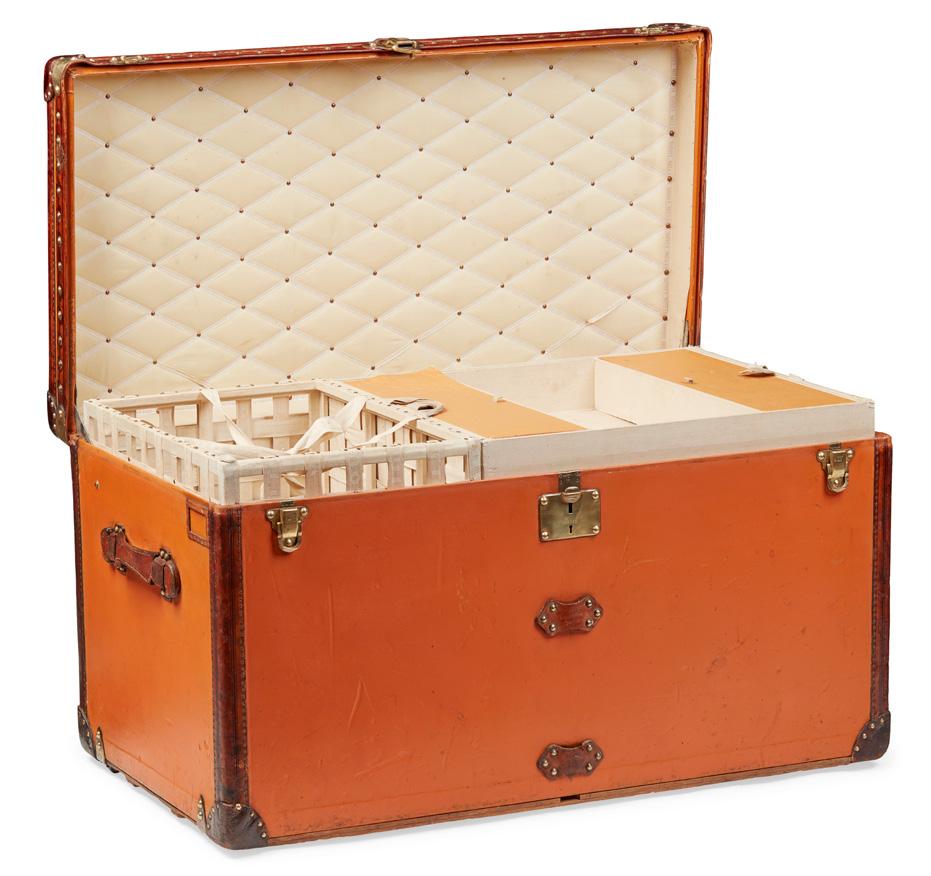
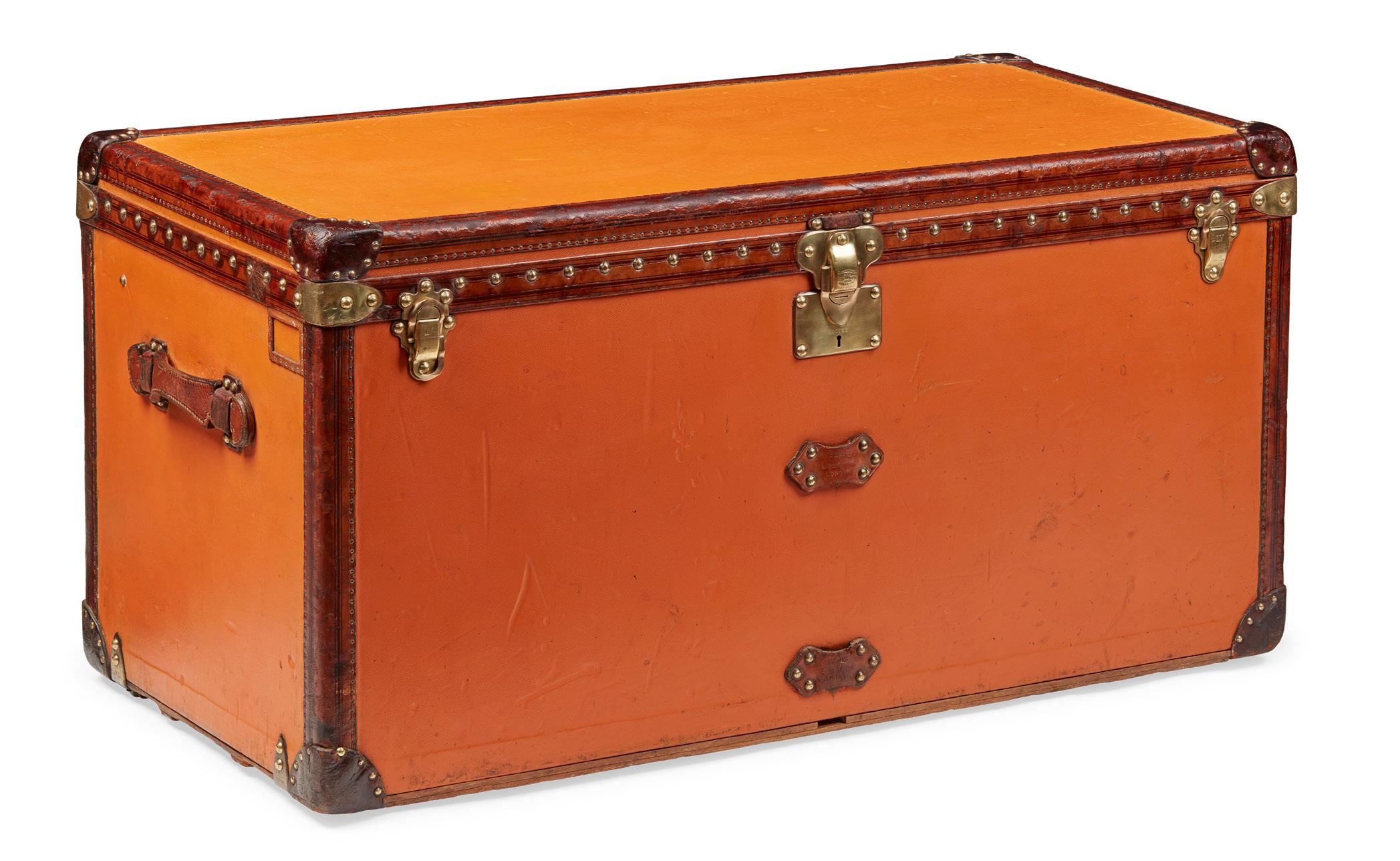
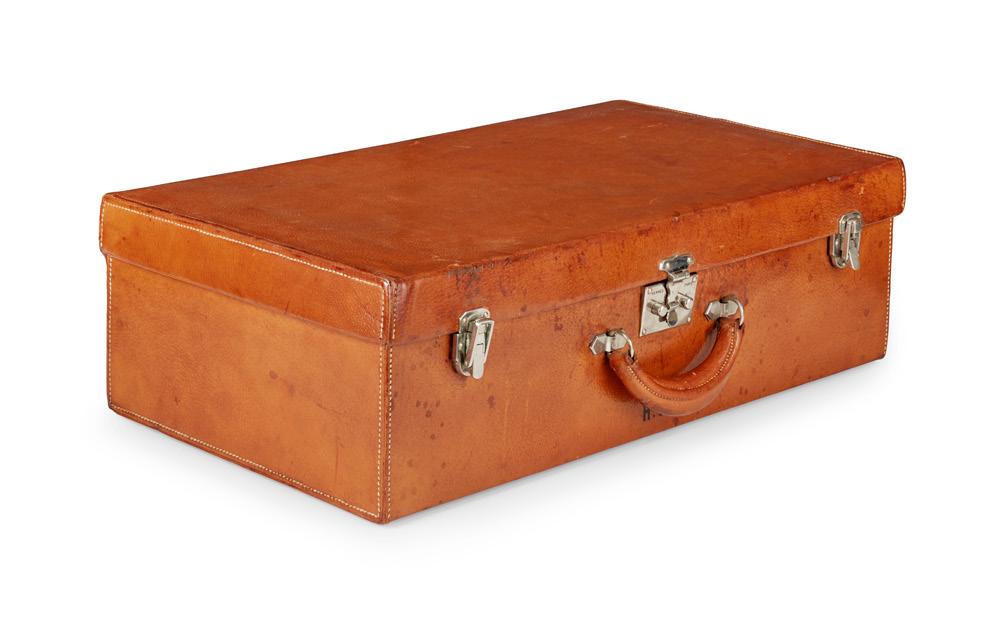
112cm wide, 60cm high, 58cm deep
£5,000-7,000
214
591
HERMÈS SAC À DÉPÊCHE OXBLOOD BRIEFCASE

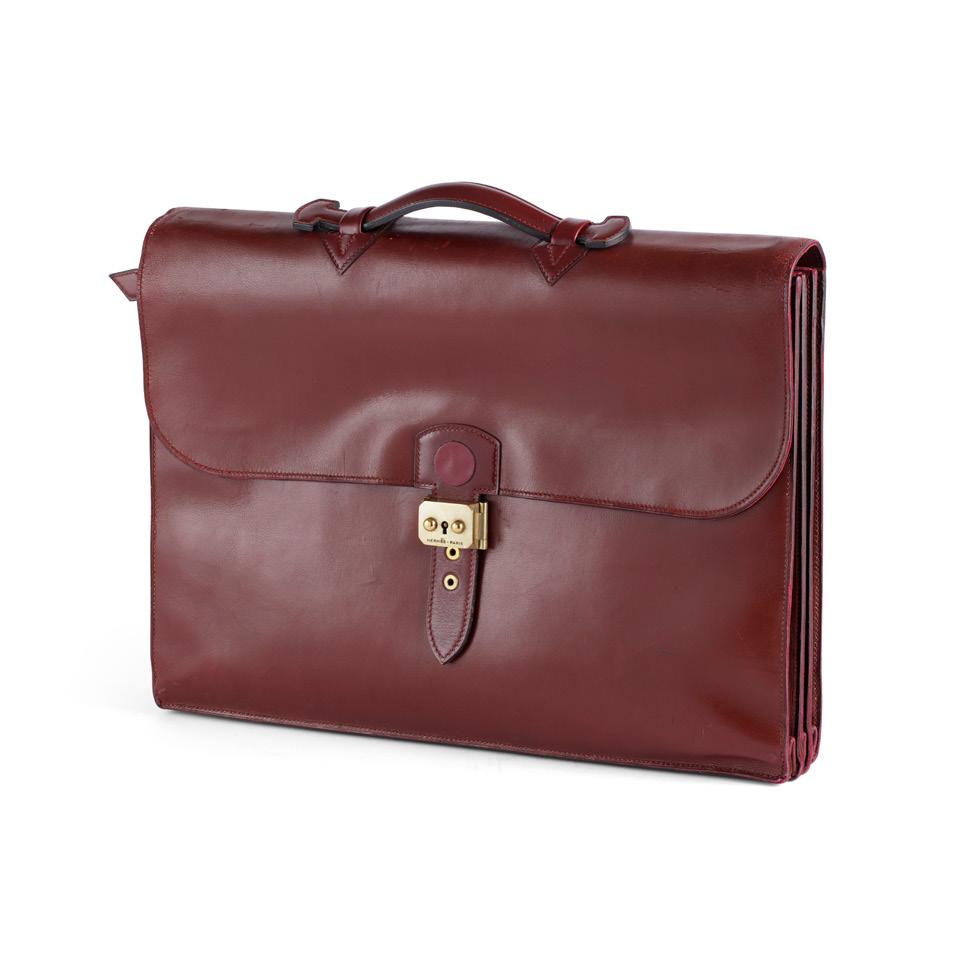
CIRCA 1960
in ‘Rouge H’ coloured leather, brass hardware, with a pale brown dustbag
41cm wide, 32cm high, 6cm deep
£800-1,200
593
LOUIS VUITTON STEAM TRUNK


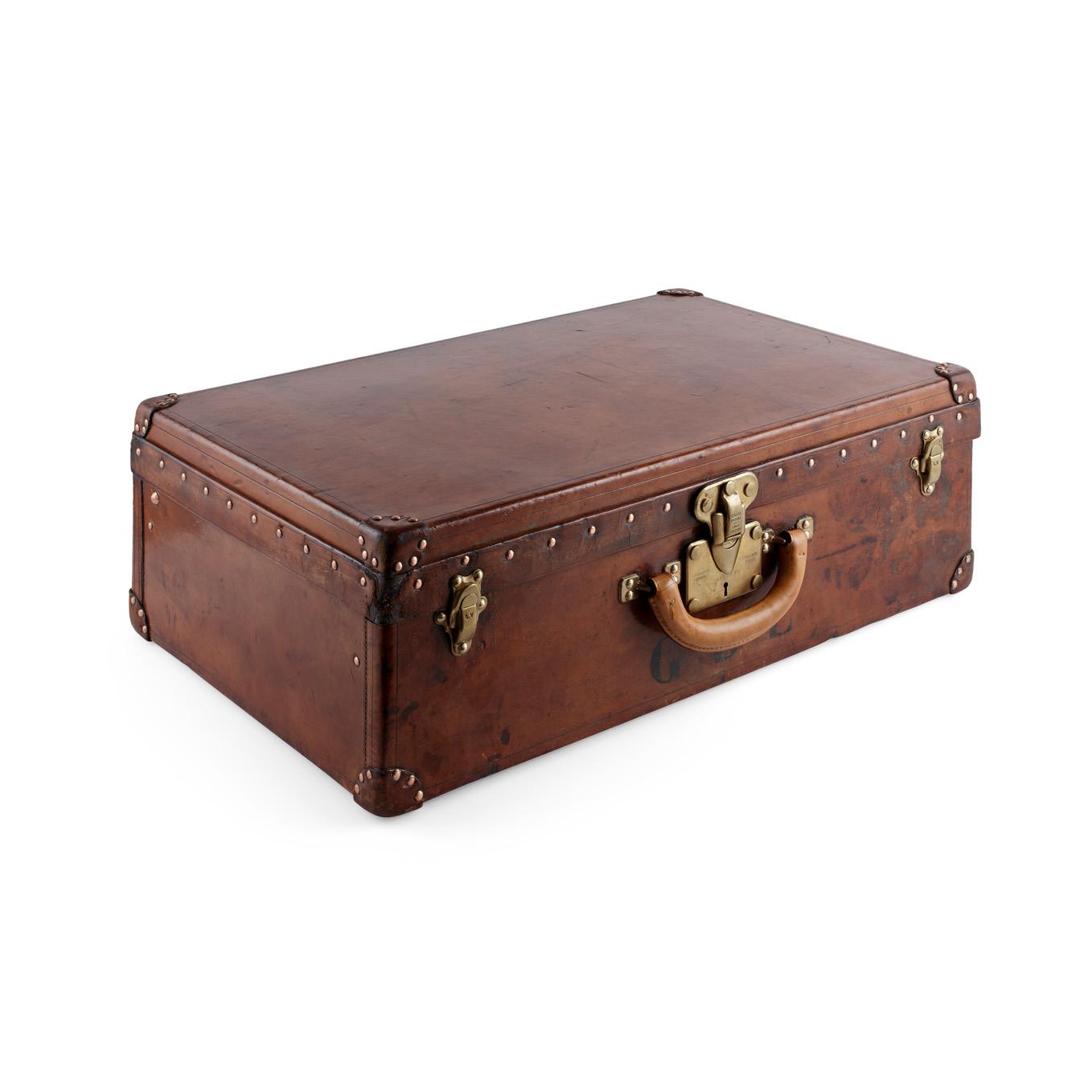
CIRCA 1890
Damier canvas exterior, with black enamel handles, catches and a square brass lock, black enamel edging and brass studded wooden battens, roller wheels to underside, opening to pink double striped paper and cloth interior with two levels of lift out trays, the lid with pink grosgrain ribbon studded star lozenge, a paper label to the back ‘Louis Vuitton, London 454, Strand, Paris 1 Rue
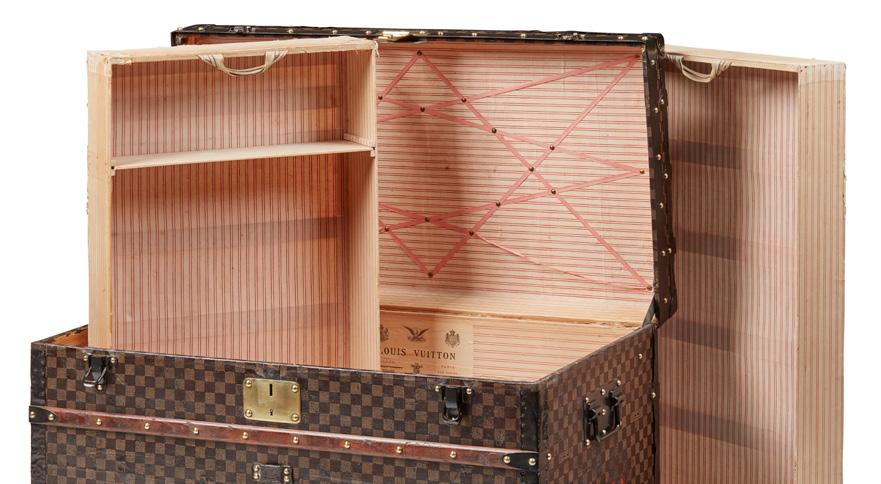
Scribe 1’ with handwritten black ink number ‘30824’
91cm wide, 50cm high, 50cm deep
£5,000-7,000
592
LOUIS VUITTON BROWN LEATHER SUITCASE

CIRCA 1910
with central brass lock and two catches, with leather handles to the top and monogrammed with initials ‘G.B.L.’ above, riveted edging to lid and corners, opening to tan pigskin interior with a lift out tray, embossed leather label to inside edge of lid with number ‘189743’
67cm wide, 22cm high, 42cm deep
£1,500-2,000
215 Other fees apply in addition to the hammer price: see the ‘Buyer’s Guide’ section on page 2
594
KPM BERLIN PORCELAIN
CASED TEA SERVICE
LATE 19TH CENTURY
comprising eleven cups and saucers; each piece painted with two panels depicting romantic scenes of courtship within gilt raised paste rocaille and foliate borders, on a pale duck egg blue ground with further scrolling gilt embellishments, within a leather bound presentation case with a fitted red velvet interior, the case bearing a rocaille scroll gilt metal plaque inscribed ‘Zur Erinnerung/ an die/ Silberne Hochzeit/
5. Juli/ 1866 - 1891’; underglaze blue baton mark, red KPM factory mark, impressed marks (qty)
the case 66cm wide, 50cm deep, saucer 13.2cm diameter, cup 5.4cm high
£500-700
595
CARL THIEME POTSCHAPPEL VASE AND COVER

LATE 19TH CENTURY
of slender ovoid form, the body painted all around with a scene of uniformed men on horseback taking refreshment at a field tent, the neck with a band of gilt diaper decoration on a pale green ground, the green ground cover embellished with gilt scrolls and with a pinecone finial, underglaze blue factory mark
39.5cm high
£250-350
596
MEISSEN DESSERT SERVICE

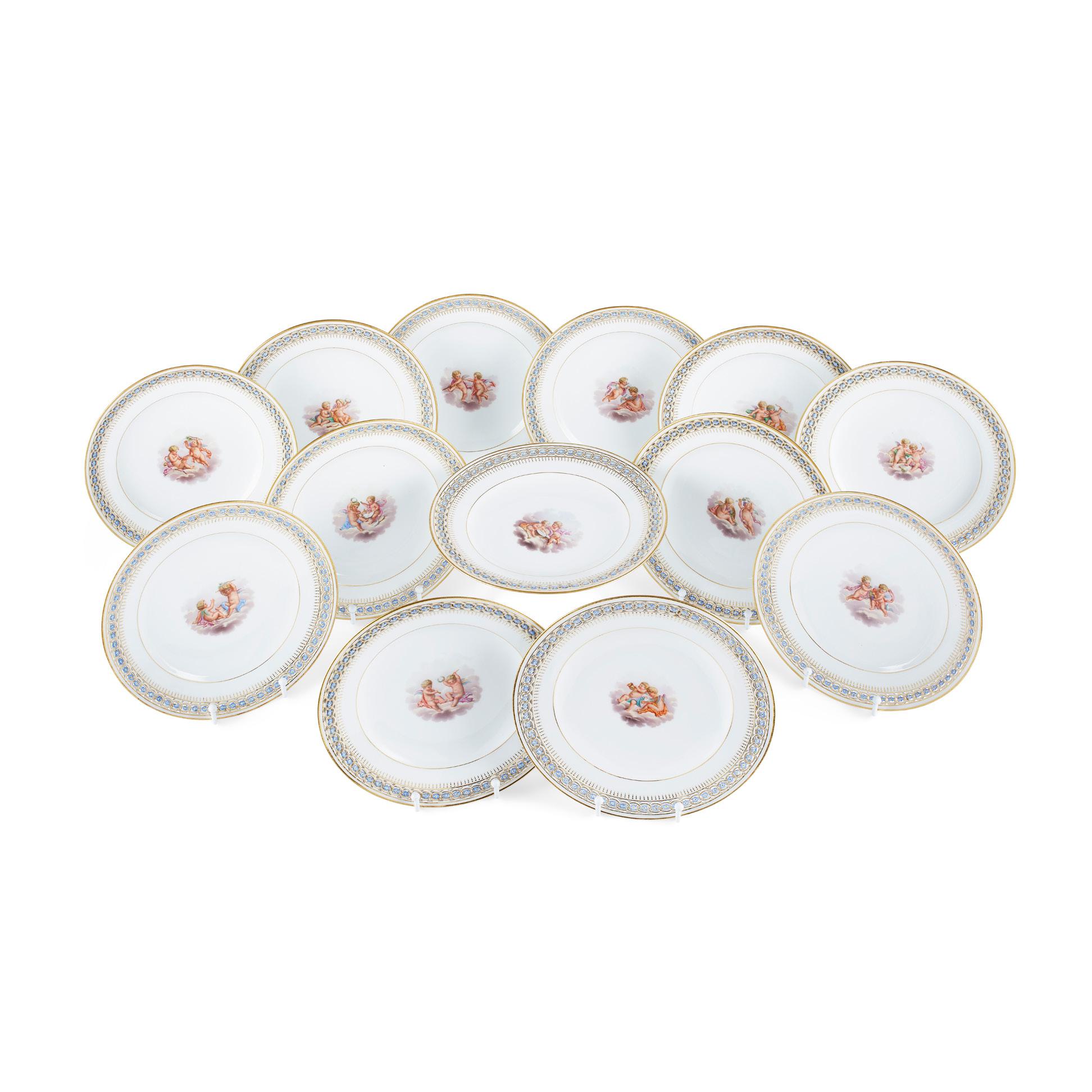
LATE 19TH CENTURY
with a pierced rims decorated with forget-me-nots within a gilt chain border, centrally painted with a pair of putti amongst the clouds, engaged in various pursuits; comprising one tall comport and twelve plates, underglaze blue crossed swords mark (13)
plates 22.2cm diameter, comport 15.5cm high
£300-500
216
597
TWO MEISSEN FIGURES
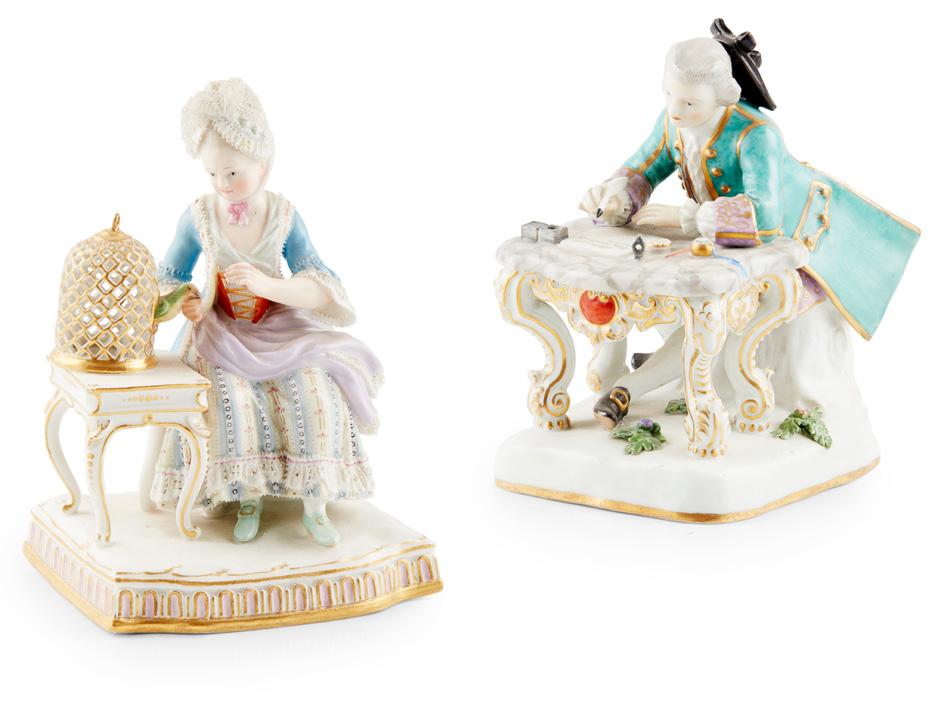
LATE 19TH CENTURY
comprising a figure from the ‘Five Senses’ representing ‘Touch’, after a model by Schönheit, underglaze blue cancelled crossed swords mark; and a figure of a man seated at a marble topped table writing a letter, after a model by Kaendler, underglaze blue crossed swords, incised 179, (2)
15.5cm high
£300-500
598
MEISSEN OUTSIDE DECORATED TÊTE-À-TÊTE CIRCA 1900
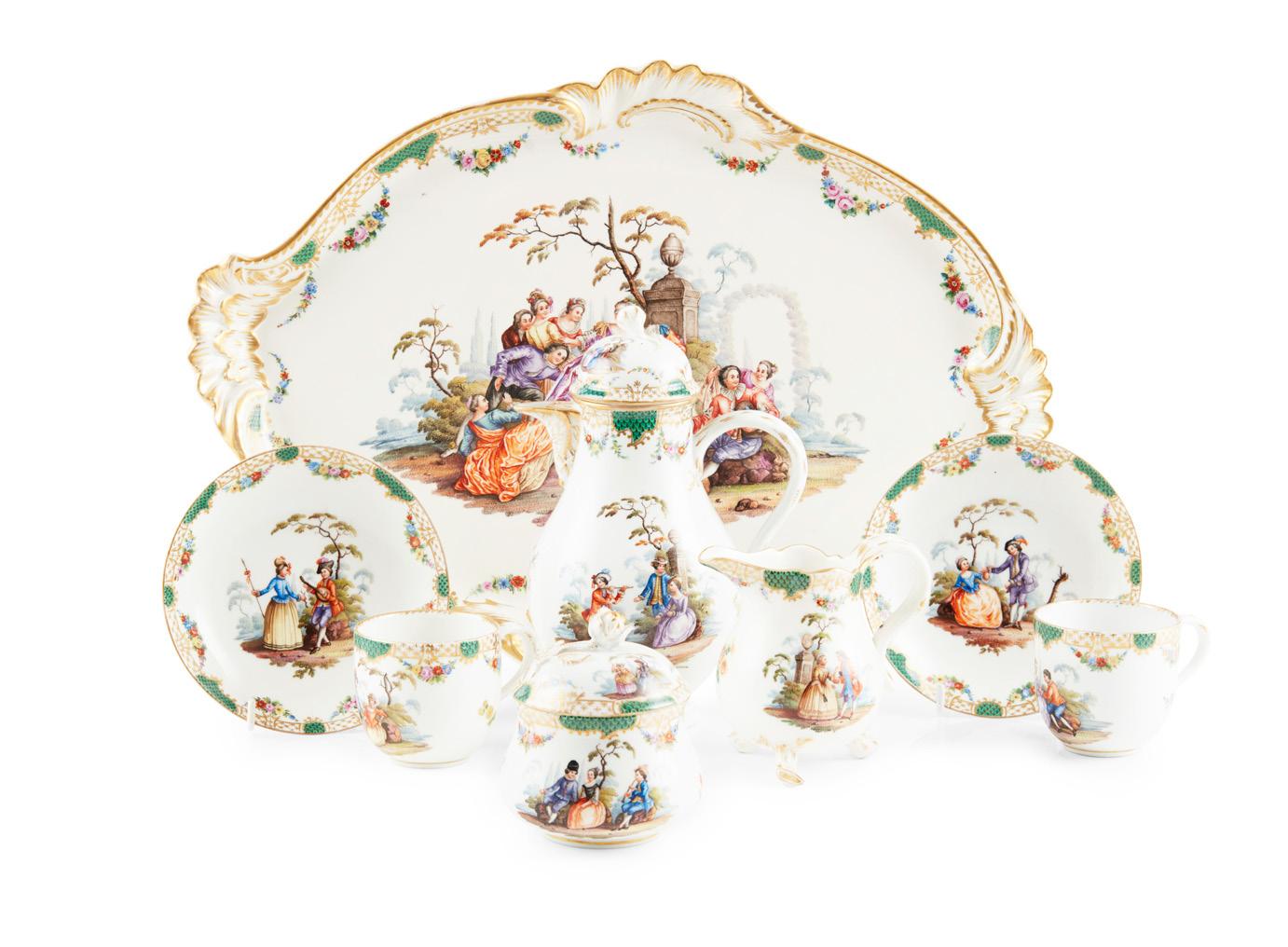
painted with romantic figurative scenes within a classical landscape setting, with gilt diaper borders incorporating green scale panels; comprising two cups; two saucers, 14cm; diameter; a cream jug; a coffee pot and cover, 21.5cm diameter; a sugar basin and cover with rose finial; and a tray with rocaille moulded handles, 46cm wide; underglaze blue cancelled crossed swords marks, tray with AR type mark (8) tray 46cm wide
Provenance: Newton Don, Kelso; Harrietfield, Kelso; and thence by descent
£600-800
599
ASSEMBLED
MEISSEN BLUE FLORAL PAINTED AND GILT TEA/COFFEE SERVICE
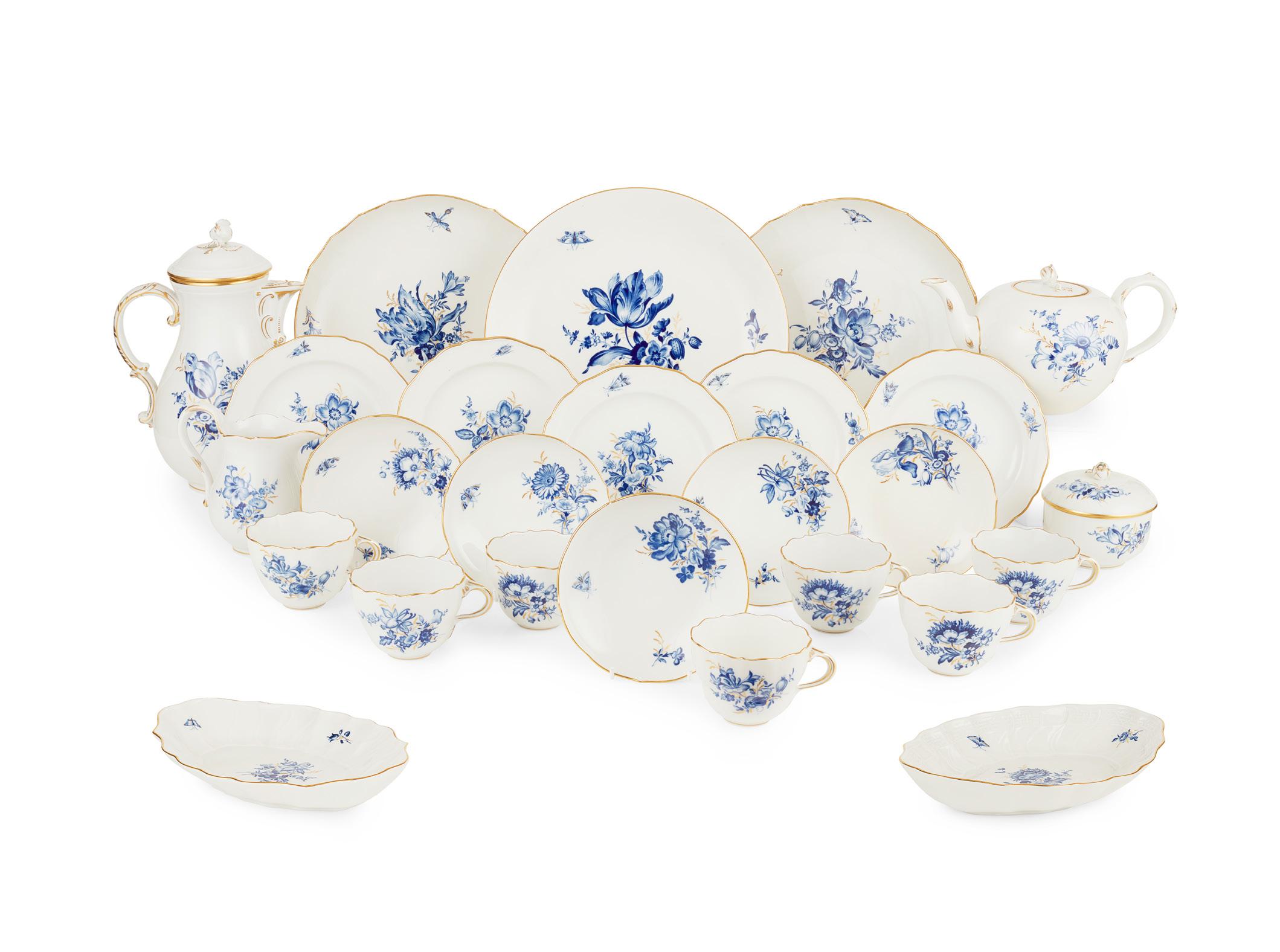
20TH CENTURY
painted with a spray of mixed flowers with further floral sprigs and insects, the decoration with leafy gilt highlights, rims in gilt, comprising a coffee pot, 27.5cm high, a teapot, 14.5cm high, a cream jug, a sugar bowl and cover, twelve cups and saucers with barbed rims, twelve side plates with scalloped rims, two large round dishes with barbed rims, 27.5cm diam, together with a large round plate, 29.6cm diam, and two lozenge shaped dishes with a wrythen moulded rim and basket weave borders, 27.5cm wide; cancelled underglaze blue crossed swords (qty)
£400-600
217 Other fees apply in addition to the hammer price: see the ‘Buyer’s Guide’ section on page 2
600
MEISSEN MODEL OF A COCKATOO
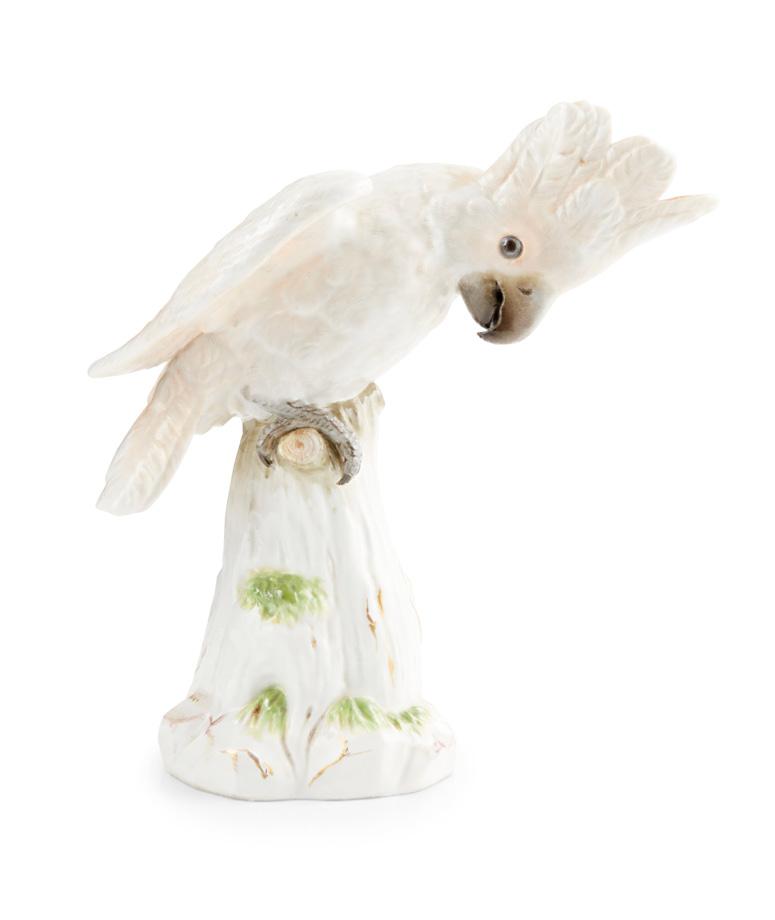
20TH CENTURY
after the model by J.J Kaendler, the bird with white and orange plumage, perched on a naturalistic tree stump, underglaze blue crossed swords, incised 57A
22.2cm high
Provenance: Private Scottish Collection, Morayshire
£200-300
601
TWO MEISSEN MODELS OF PARROTS
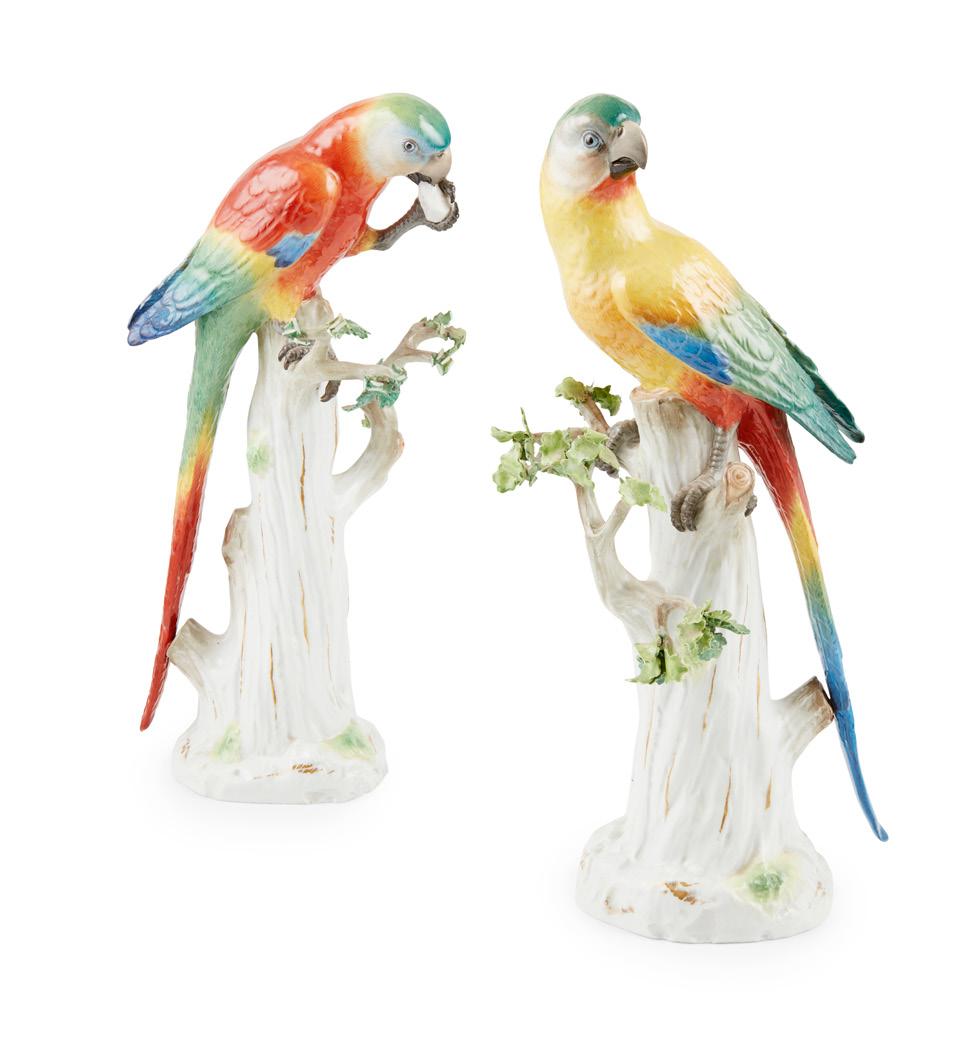
LATE 19TH/ EARLY 20TH CENTURY
naturalistically modelled perching on tree stumps issuing leafy branches, one nibbling some food from its left claw; underglaze blue crossed swords, one incised 20, the other incised 20X (2) 31.2cm high, 29cm high
Provenance: Paxton House, Berwickshire, thence by descent to the vendor £700-1,000
602
BLACK FOREST
BEAR STICK STAND
LATE 19TH CENTURY
standing upright, its head set with glass eyes and an open mouth, holding a branch-form stick holder in its paws, on a naturalistic base with metal tray insert

81cm high
£2,000-3,000
603
SWISS CARVED LINDEN WOOD
‘SCHWINGEN’ CUP AND COVER EARLY 19TH CENTURY
the foliate carved cover with finial carved as a pair of traditional Swiss wrestlers, or schwingen, on a cup carved in relief with a continuous scene with men, oxen, and a dog, raised on supports carved as three men in traditional dress and hats, on a circular foot banded with carved leaf tips
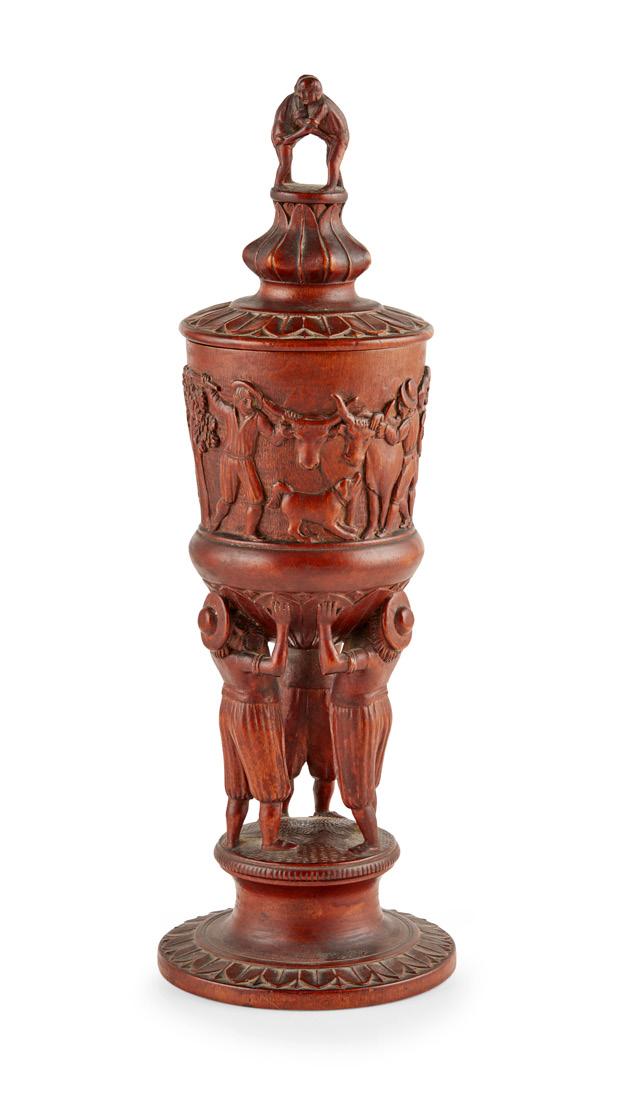
30.5cm high
£400-600
218
604
BLACK FOREST CARVED WOOD AND BRASS NOVELTY TABLE CLOCK
EARLY 20TH CENTURY
in the form of a seated pug dog with glass eyes and brass rope collar, holding a brass padlock in its mouth set with a cream enamel dial timepiece movement clock, on a plated brass circular plinth base 22cm wide, 39cm high, 35cm deep £3,000-4,000
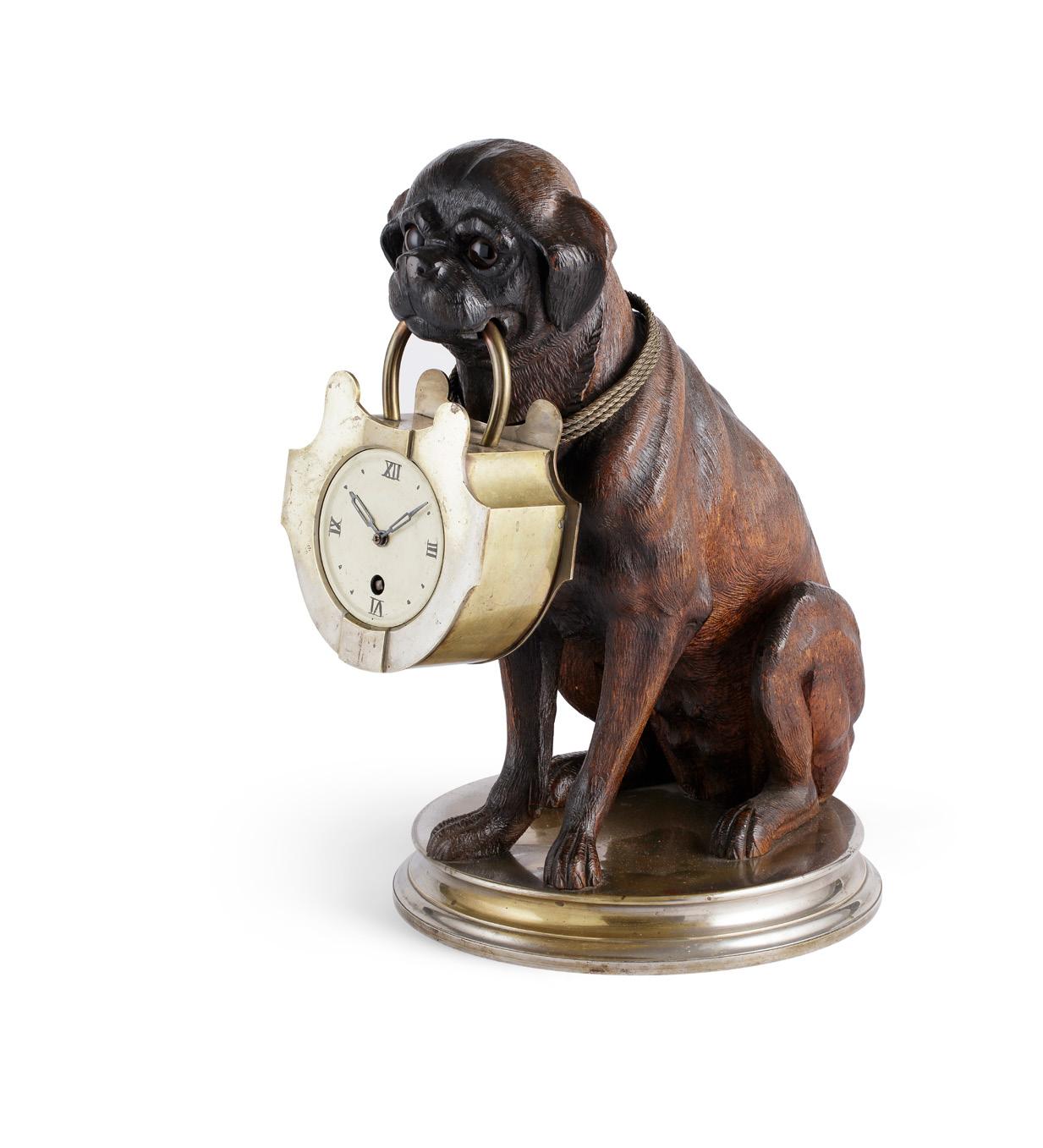
605
PAIR OF BIEDERMEIER BEADWORK, WALNUT AND EBONISED FOOTSTOOLS
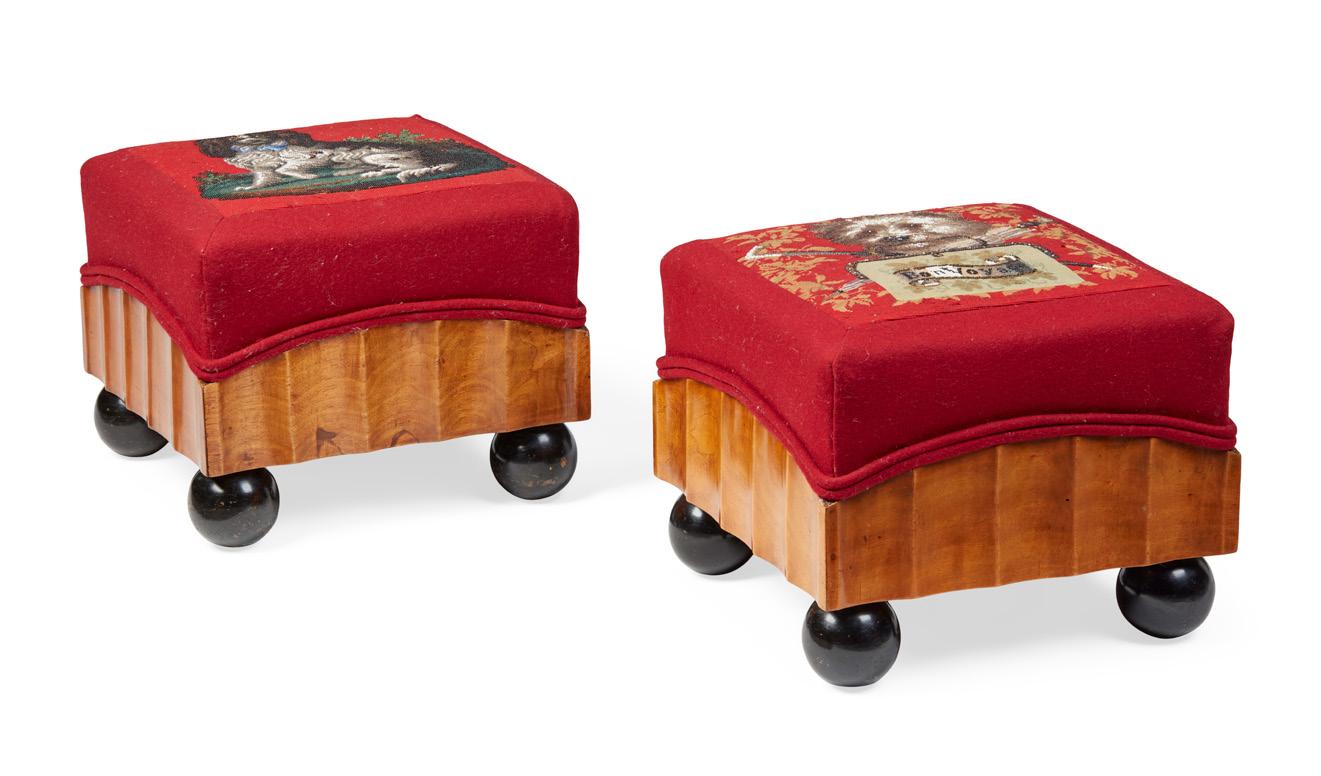
MID 19TH CENTURY
of square form, one upholstered with a beadwork panel depicting a King Charles spaniel, the other with a Cairn terrier holding an umbrella, walking stick and handbag with the motto ‘Bon Voyage’, on a red wool ground with fluted bases raised on ebonised ball feet (2) 42cm wide, 32cm high, 42cm deep £1,500-2,500
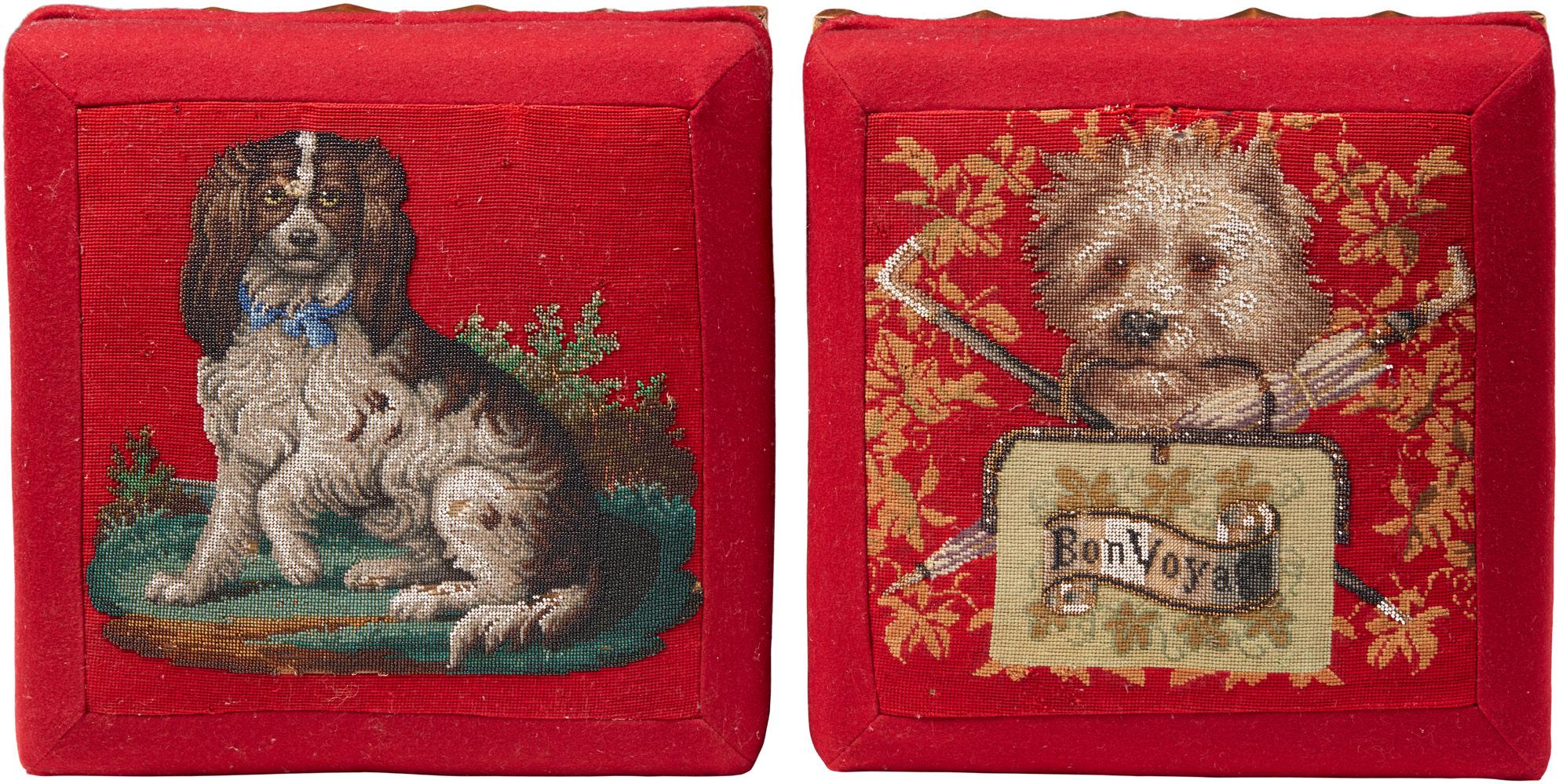
219 Other fees apply in addition to the hammer price: see the ‘Buyer’s Guide’ section on page 2
606
GERMAN CARVED OAK QUARTER STRIKING BRACKET CLOCK, BY WINTERHALDER & HOFMEIER
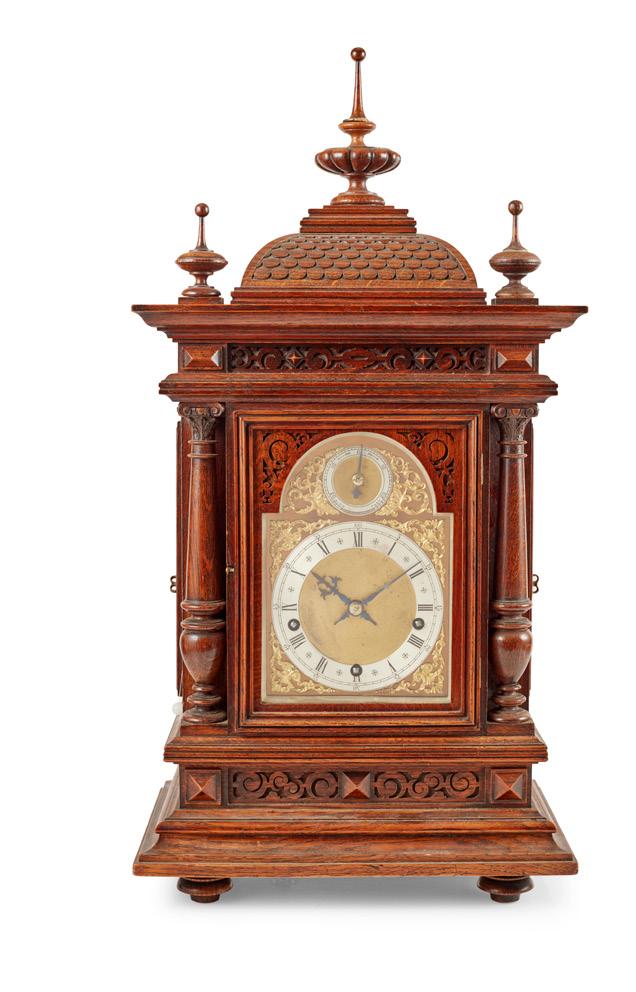
LATE 19TH CENTURY
the arched gilt dial with a silvered chapter ring with Roman numerals and Arabic five minute markers, with pierced gilt spandrels and subsidiary slow/fast dial, the architectural case with a caddy top with three turned finials, above a breakarch door flanked by columns and pierced scrolling side panels, on a moulded plinth raised on turned feet, the three-train brass movement striking the quarters on two coiled steel gongs activated by a pin wheel and also striking the full hour, with a string pull repeat to one side, the backplate stamped ‘W. & H, Sch’ for Winterhalder & Hofmeier, Schwaerzenbach
37cm wide, 72cm high, 23cm deep
£600-800
607
TWO BOHEMIAN GLASS OVERLAY ENAMELLED VASES
MID 19TH CENTURY
one of tall trumpet form in clear glass overlaid in white, the body with enamelled floral panels alternating with diaper cut panels, embellished with gilt scrolling designs, on a circular foot, 47.5cm high; the other vase of baluster form with a flared neck, in green glass overlaid with white panels, the panels enamelled with flowers alternating with diaper cut panels, embellished with gilt foliate designs, on a circular foot, 34.5cm high (2)

larger 47.5cm high
Provenance: Private Scottish Collection, Morayshire
£300-500
608
COLLECTION OF BOHEMIAN RUBY GLASS BOTTLES AND STOPPERS
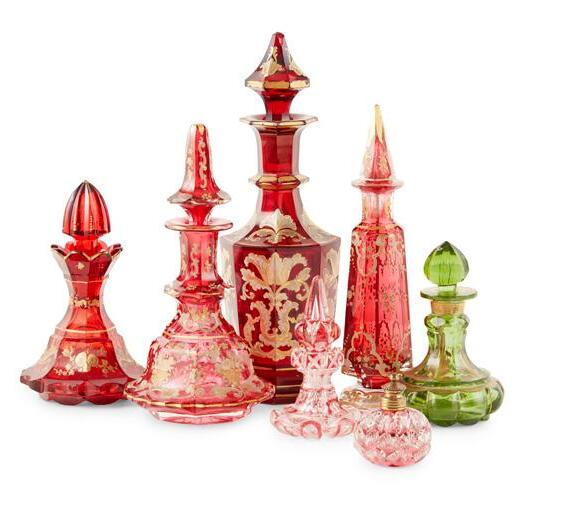
19TH CENTURY
comprising four of various forms decorated with gilt designs, also including two smaller scent bottles in clear glass with ruby overlay, one with a pointed glass stopper, the other with a screwtop gilt metal cover, with ruby overlay; tallest 24cm high, the smallest 5cm high, together with a GREEN GLASS SCENT
BOTTLE WITH STOPPER, the body with stylised gilt foliate decoration (7) largest 24cm high
Provenance: Private Scottish Collection, Morayshire
£250-350
609
AUSTRIAN EMBOSSED AND GILT LEATHER TABLE CABINET AND DESK SET, BY FRANZ BÖHM, VIENNA
EARLY 20TH CENTURY
the arch top cabinet comprising covered compartments above a pair of embossed door with oval reserves painted with scenes after Murillo, opening to a fitted interior with drawers and an open compartment containing a matching desk blotter, inkwell, ink blotter, stamp box, and notepad, raised on square legs joined by a shaped X stretcher; on an associated leather covered plinth 69cm wide, 134cm high, 35cm deep overall
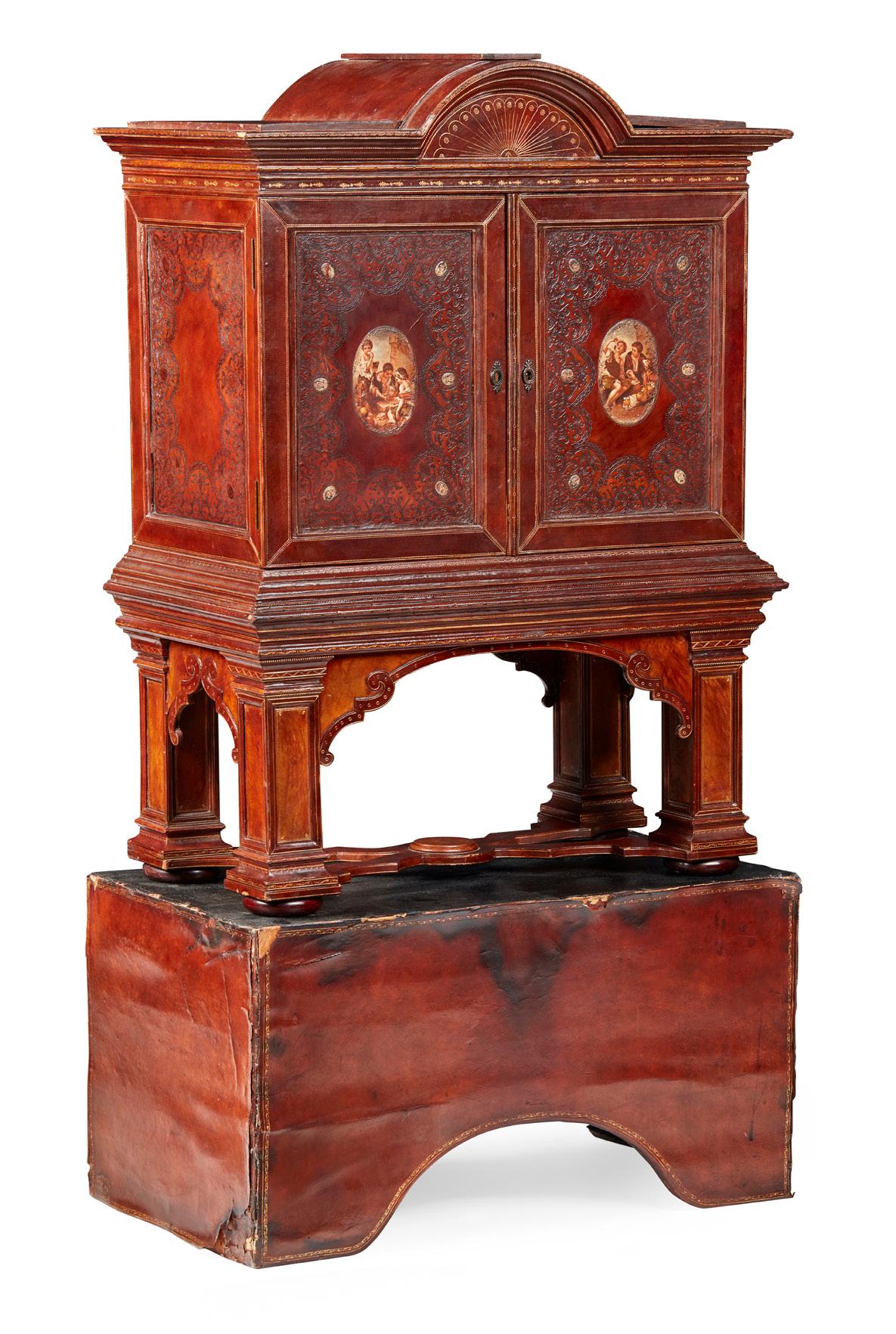
Note: This suite of desk accessories and cartonnier were made for the 1. Wiener Messe [first Vienna Fair] held in 1921 and are after the 18th century original made for the Empress Maria Theresa and formerly in the collection of Schönbrunn Palace
£600-800
220 Other fees apply in addition to the hammer price: see the ‘Buyer’s Guide’ section on page 2
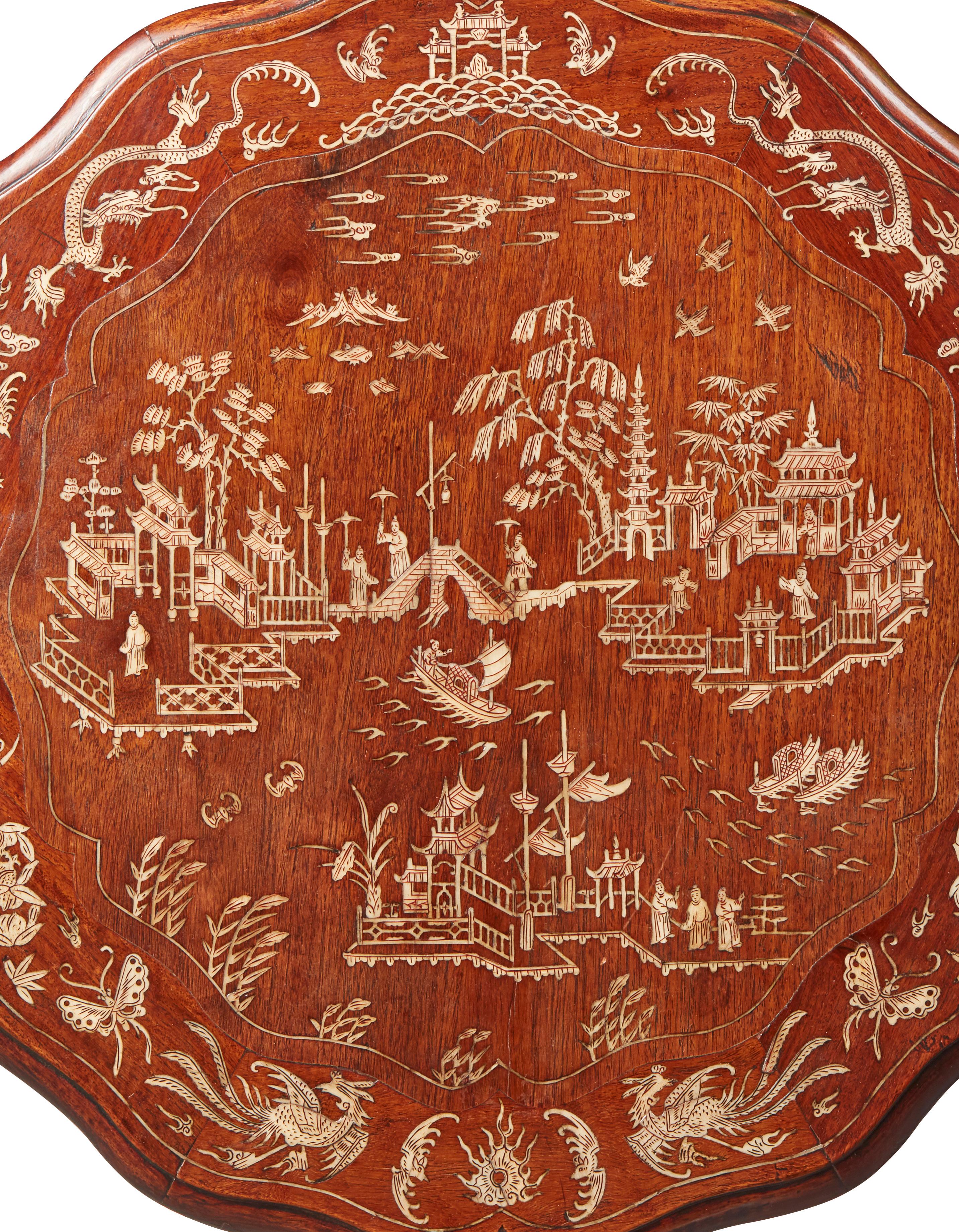
ASIAN FURNITURE & WORKS OF ART
610
PAIR OF LARGE CHINESE BLUE AND WHITE COVERED VASES

LATE 19TH CENTURY
of baluster form, the domed covers with fu-lion finials, decorated with flowering branches within plantain leaf and lappet borders, unmarked (2) 24cm diameter, 66cm high
£400-600
611 Y
STRAITS CHINESE HARDWOOD AND IVORY
OCCASIONAL TABLE
19TH CENTURY
the shaped circular top inlaid with figural landscape views within a border with dragons, phoenixes, butterflies, and bats, on a dragon carved column and platform with further inlay and raised on scroll legs

55cm diameter, 76cm high
Note: Sold in compliance with UK Government and APHA regulations, with (non-transferable) exemption registration reference SLQ8JACU
£400-600
612
JAPANESE OAK AND BRONZE DINNER GONG

LATE 19TH CENTURY
the hand-beaten bronze gong suspended in a carved frame in the form of a Japanese Torii arch, with a beater mounted to the side 76cm wide, 92cm high, 30cm deep
£300-500
613
PAIR OF CHINESE RED AND GILT PORCELAIN DRAGON VASES

20TH CENTURY
of tianqiuping form, the exterior richly painted with dragons chasing flaming pearls amongst clouds, the bases gilded with blue and white six-character Qianlong marks but not of the period (2)
26cm diameter, 40cm high
£400-600
222 Other fees apply in addition to the hammer price: see the ‘Buyer’s Guide’ section on page 2
the frame profusely carved with leafy scrolls, with an adjustable picture rest 172cm high, 75cm wide

INDIAN SILVER-INLAID STEEL TULWAR SWORD

T-shaped forte, the silver-inlaid decoration consisting of interlocking foliate trellis and lush rosettes, the curved blade with engraved decoration, the embossed leather scabbard with embossed and chased silver
Note: Captain Archibald Swinton (1731-1804) was a Scottish surgeon that went to India in the service of the East India Company. He reached Madras in 1752 and took part in the campaigns being waged between the French and English Companies for supremacy in the south. He also took part in an expedition 1756-57 to Negrais in Burma, arriving at Ganjam in Eastern India in 1759 and from there went on to Calcutta. During this time he also transferred from being a surgeon to an ensignship in the Company’s Bengal army.
When Archibald Swinton left the Company’s service at the end of 1765, he also left India with an unprecedented mastery of the Persian language, local customs and strong relationships with the Mughal nobility. Swinton was a very early collector of Indian and Mughal art and on returning to Scotland he brought with him a substantial collection Indian paintings, works of art, ivories, arms, jewels, Persian books and silver and jade handled daggers. This is documented in family papers.
 Kimmerghame, Duns, the Estate of the Late
615
ANGLO-INDIAN HARDWOOD EASEL 19TH CENTURY
£400-600
Kimmerghame, Duns, the Estate of the Late
615
ANGLO-INDIAN HARDWOOD EASEL 19TH CENTURY
£400-600
223
616 Y
PERSIAN HARDWOOD, EBONY AND IVORY INLAID OCTAGONAL TABLE
LATE 19TH/ EARLY 20TH CENTURY
the octagonal top inlaid with fleur-de-lis and scrolling foliate motifs, on a folding base with ogee arches and conforming inlay

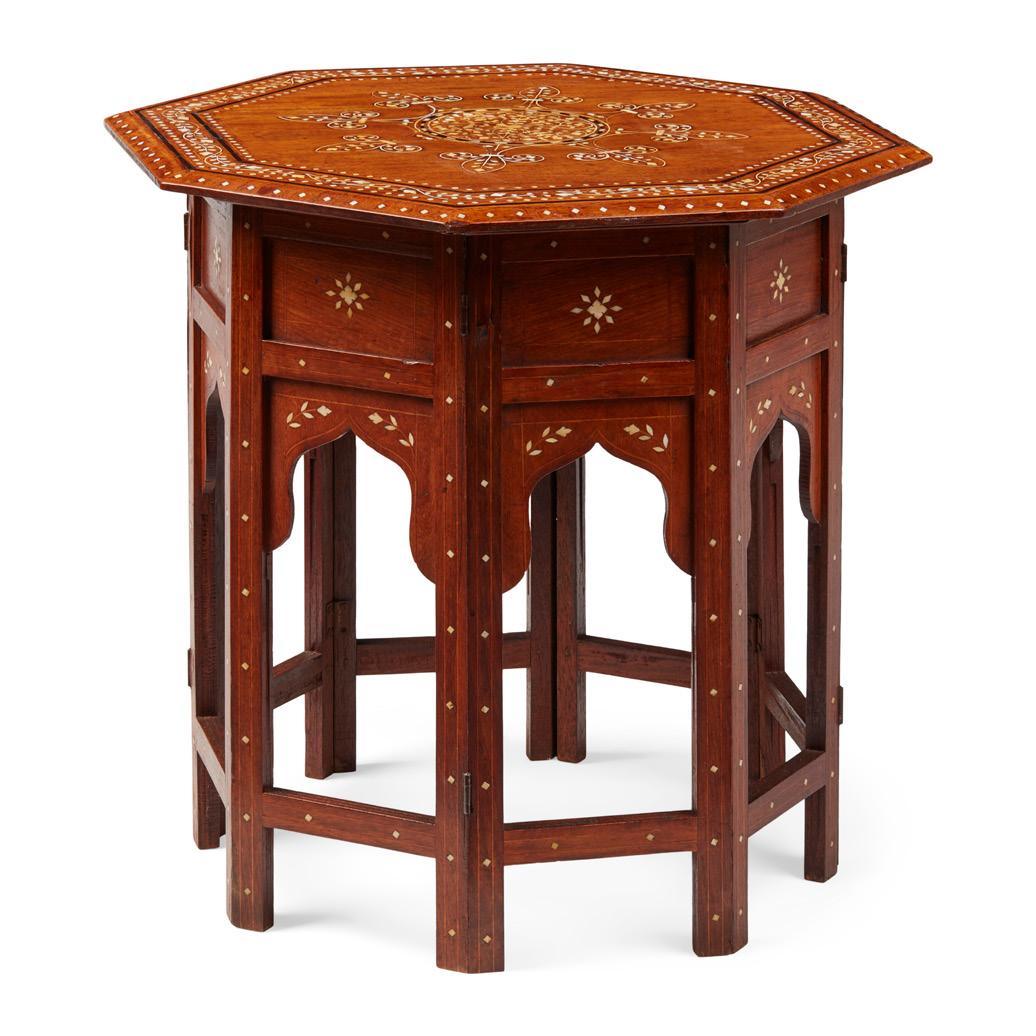
54cm diameter, 50cm high
Note: Sold in compliance with UK Government and APHA regulations, with (nontransferable) exemption registration reference MCAJC4H9
£200-300
617
ANGLO-INDIAN PADOUK TRIPOD TABLE
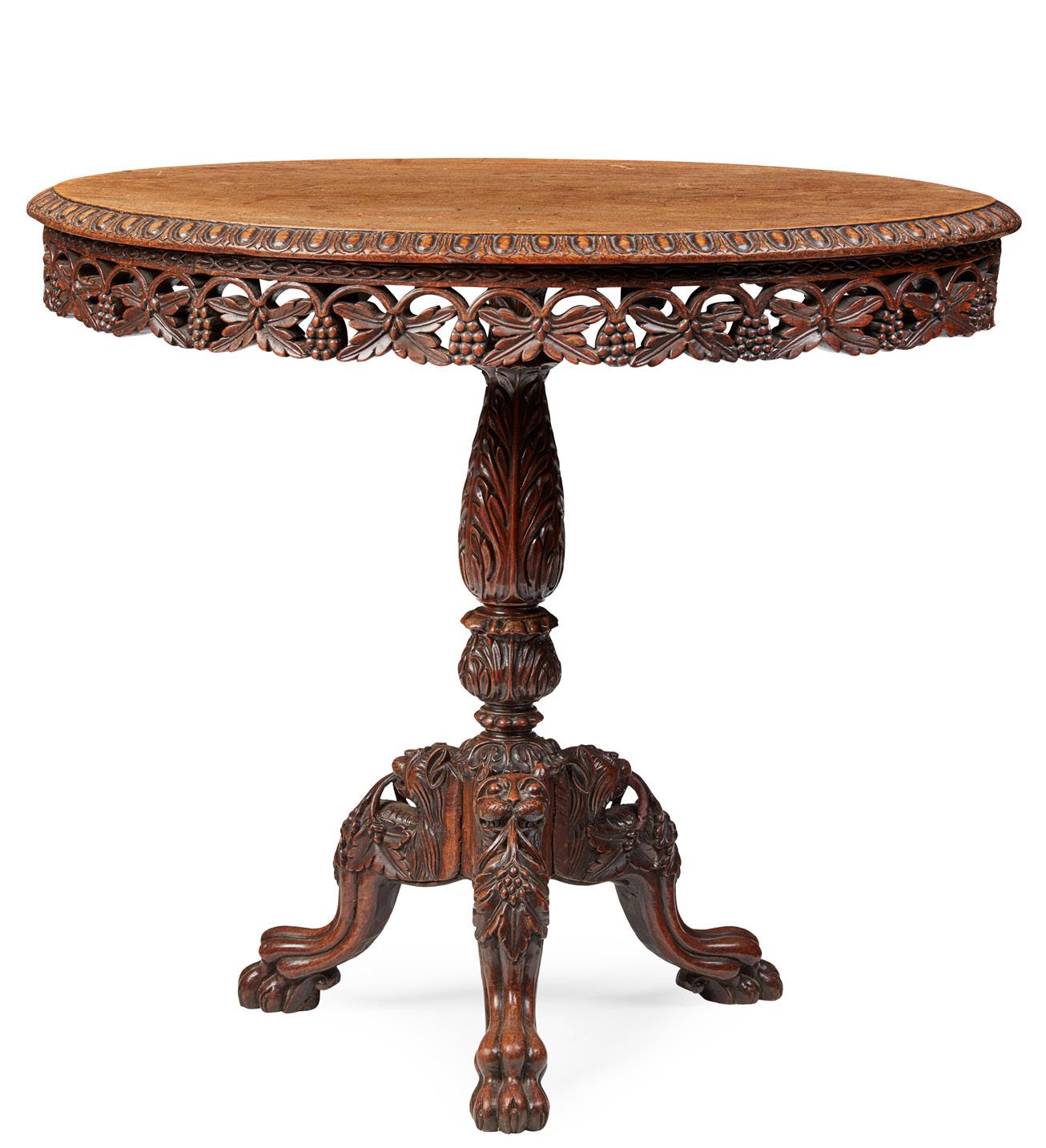
19TH CENTURY
the oval tilt top with an egg and dart edge above a pierced and carved fruiting vine frieze, raised on a foliate carved baluster support and tripod base carved with lion masks and ending in paw feet
84cm wide, 77cm high, 59cm deep
£400-600
618
ANGLO-INDIAN CARVED HARDWOOD WORKBOX
19TH CENTURY
the hinged top with a carved scrolling foliate border, opening to a compartmented tray and void interior, the sides banded in similar scrolling foliate carving, raised on cabriole legs with further foliate carving, bearing a paper maker’s label ‘ABDUL AZIZ WOOD CARVER
PAPIER MACHIE [sic] MAKER 3RD BRIDGE JAGAR KASHMIR’
50cm wide, 50cm high, 35cm deep
£300-500
224 Other fees apply in addition to the hammer price: see the ‘Buyer’s Guide’ section on page 2
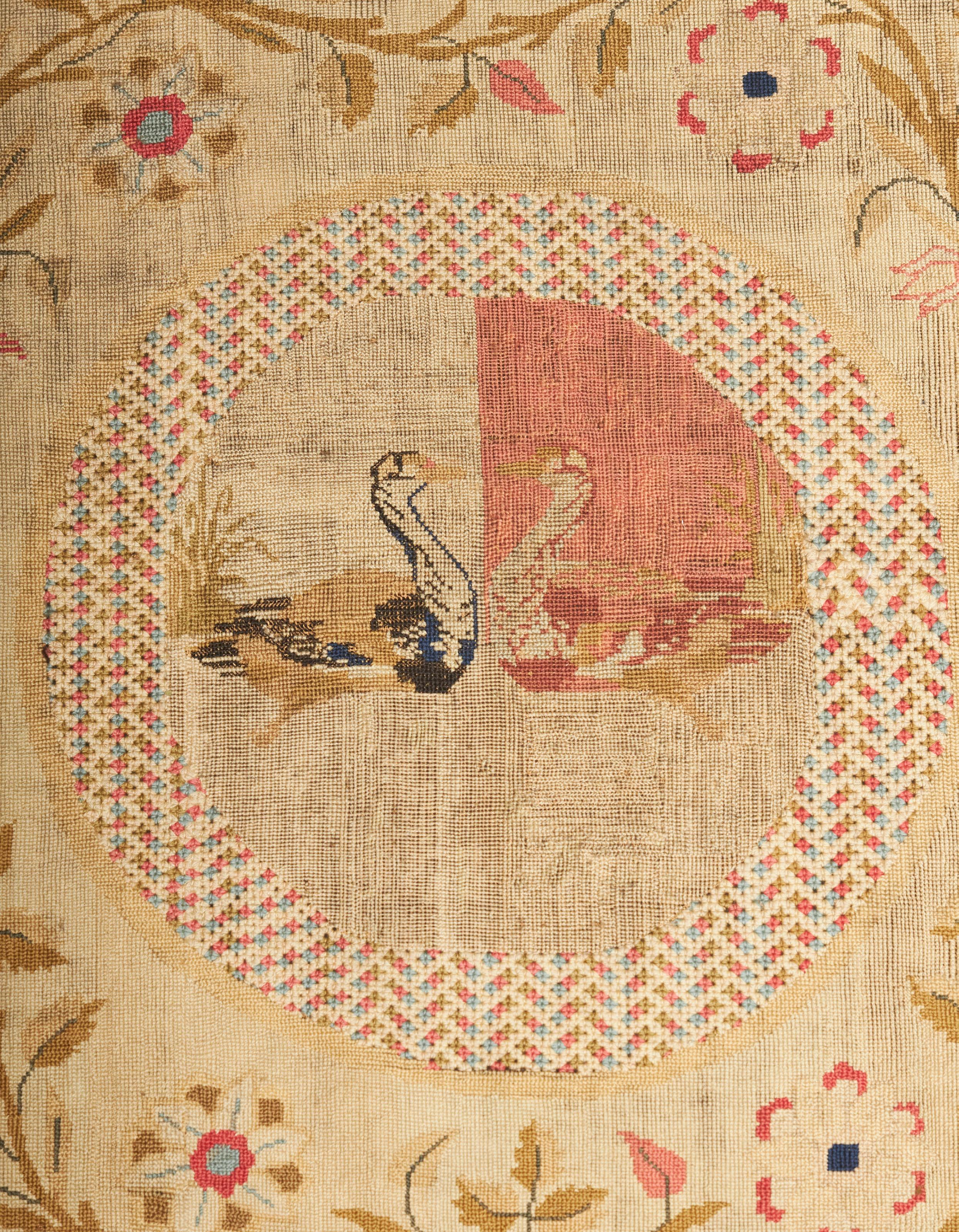
RUGS & CARPETS
619
QUM CARPET
CENTRAL PERSIA, MID 20TH CENTURY
the indigo field with allover foliate pattern, within light blue border
350cm x 240cm
£600-800
621
HERIZ CARPET
NORTHWEST PERSIA, MODERN
the brownish red field with indigo, red and ivory medallion, ivory, brown and indigo spandrels, within indigo border

335cm x 241cm
£600-800
620
TETEX CARPET
GERMANY, EARLY/MID
20TH CENTURY
of Kuba style, the indigo field with allover rosette medallion and arabesque vine pattern, within red/pink border
290cm x 200cm
Note: The Tetex carpet company in Munich was a producer of high-quality hooked copies of Persian and Caucasian carpet designs in the inter-war period.
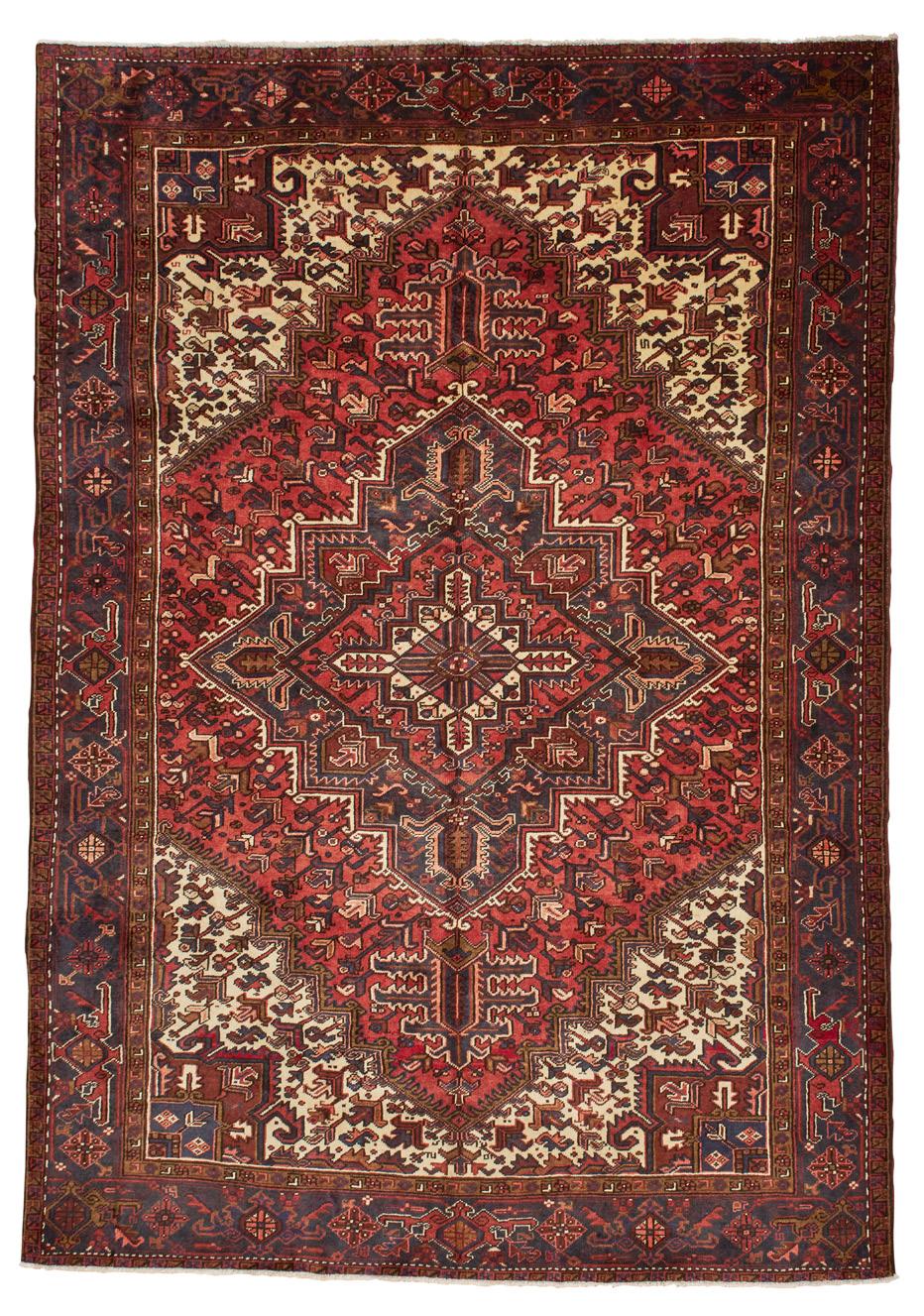
£500-700
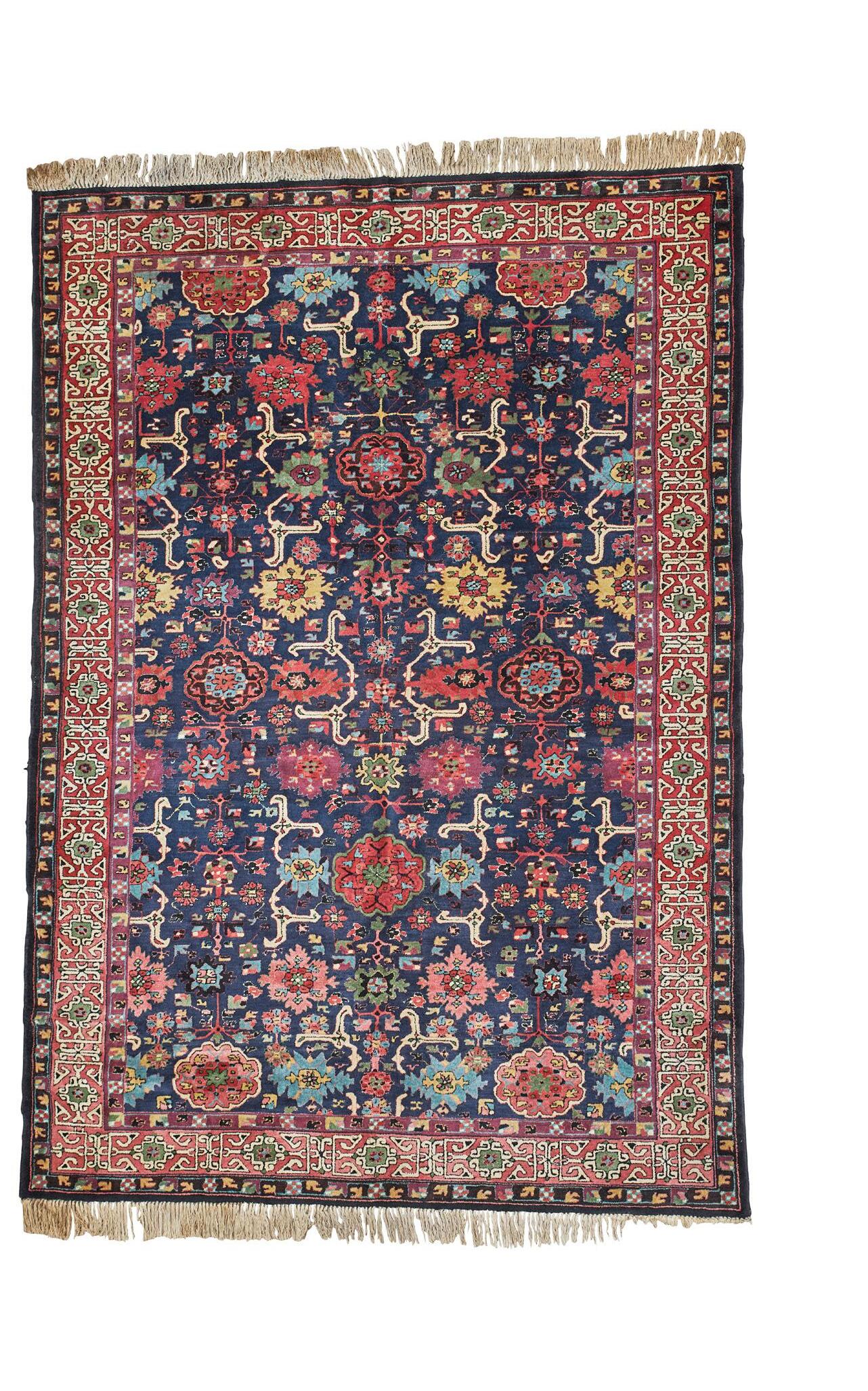
226 Other fees apply in addition to the hammer price: see the ‘Buyer’s Guide’ section on page 2
622
TABRIZ CARPET
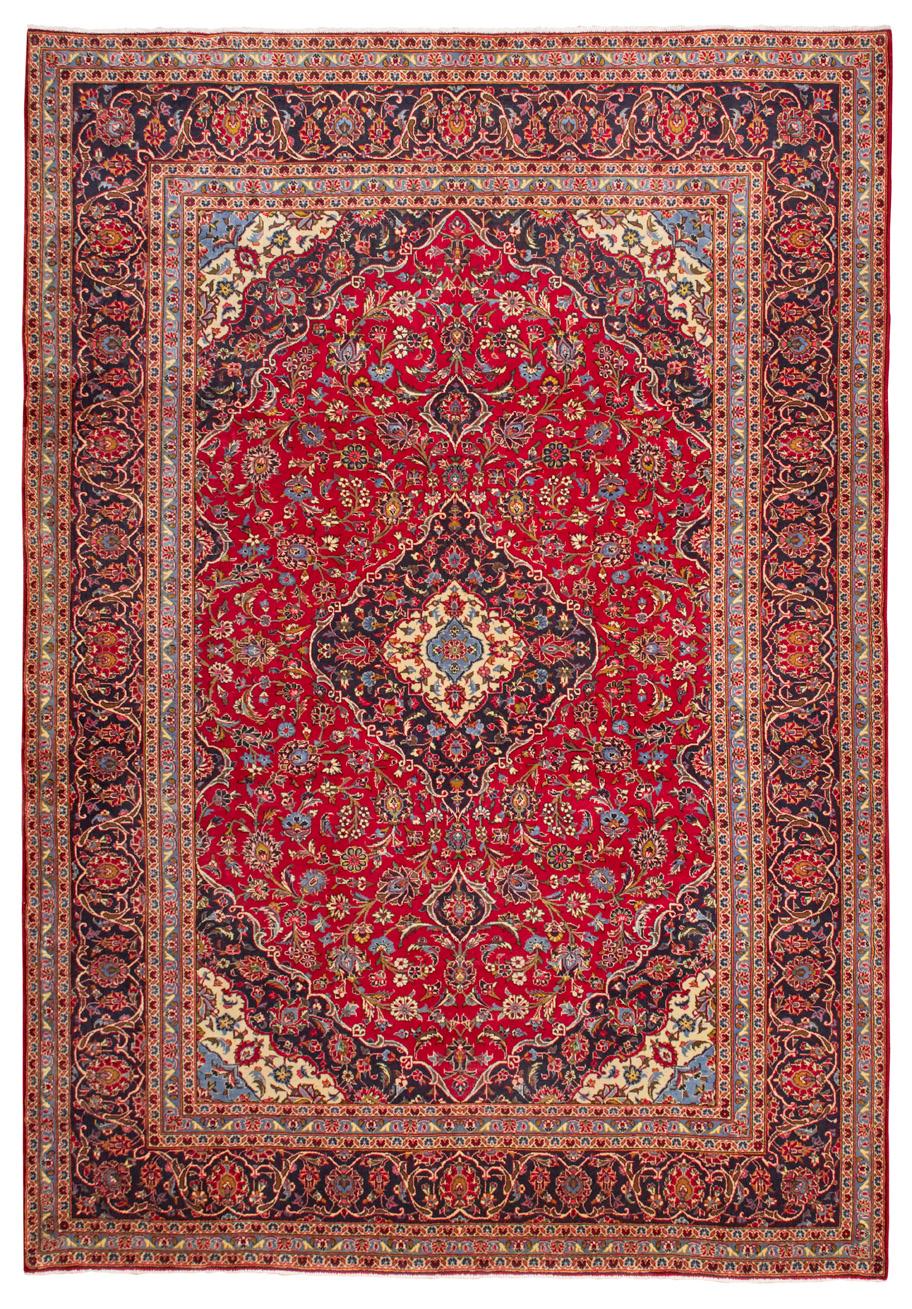
NORTHWEST PERSIA, LATE 20TH CENTURY
the red field with allover palmette pattern, within cream border
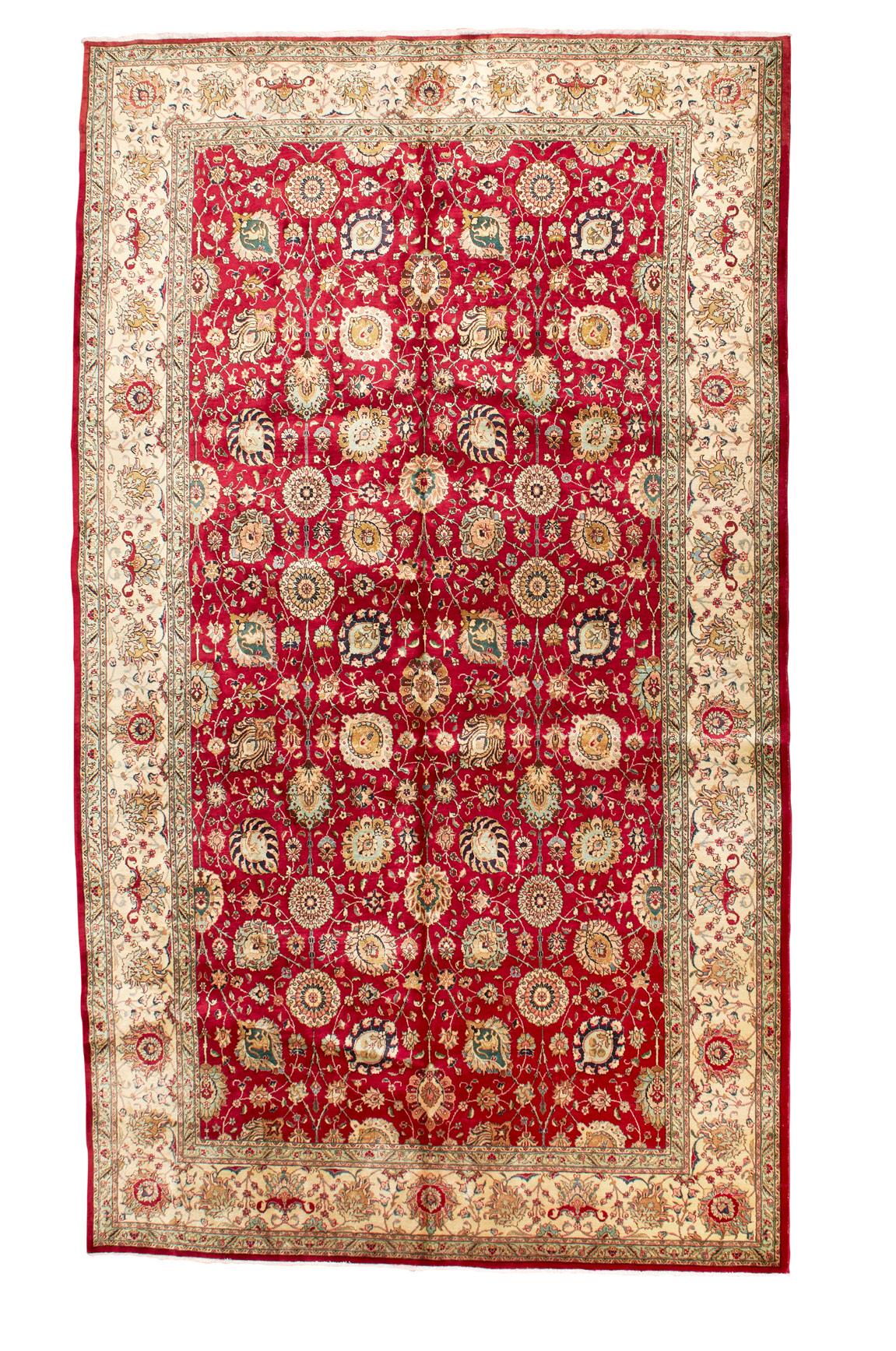
472cm x 302cm
£3,000-4,000
623
VARAMIN CARPET

CENTRAL PERSIA, EARLY/ MID 20TH CENTURY the cream field with allover rosette lattice pattern, within grey border
316cm x 202cm
£2,000-3,000
624
KASHAN CARPET
CENTRAL PERSIA, MODERN
the red field with indigo, cream and blue medallion, similar spandrels, within indigo border
360cm x 258cm
£500-700
227
625
JULKHIRS CARPET
UZBEKISTAN, EARLY 20TH CENTURY
the brown field with two columns of four guls, within brown border
310cm x 174cm
£300-500
626
BELOUCH CARPET
NORTHEAST PERSIA, LATE 19TH/EARLY 20TH CENTURY
the brown field with lozenge medallion lattice pattern, within brown border
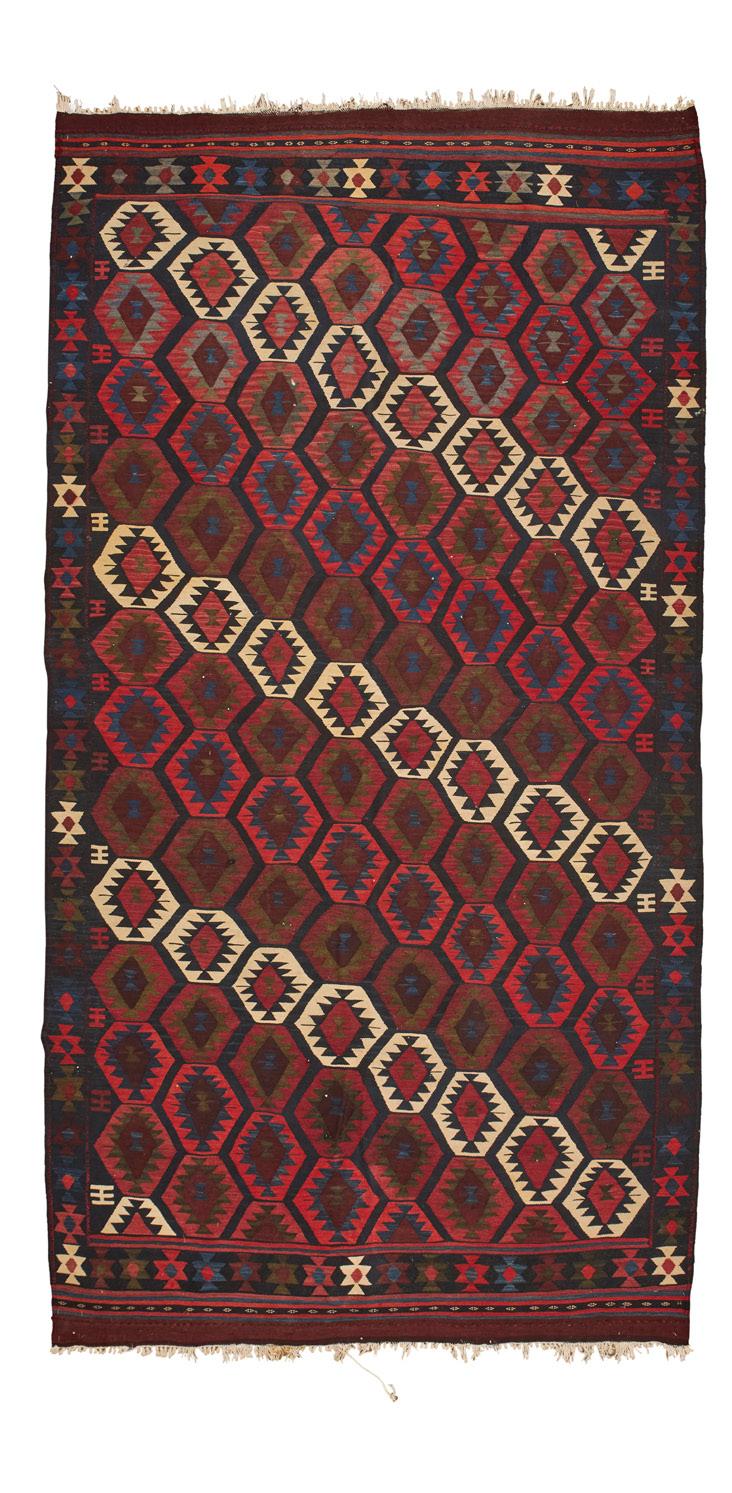
394cm x 208cm
£400-600
627
VARAMIN KILIM
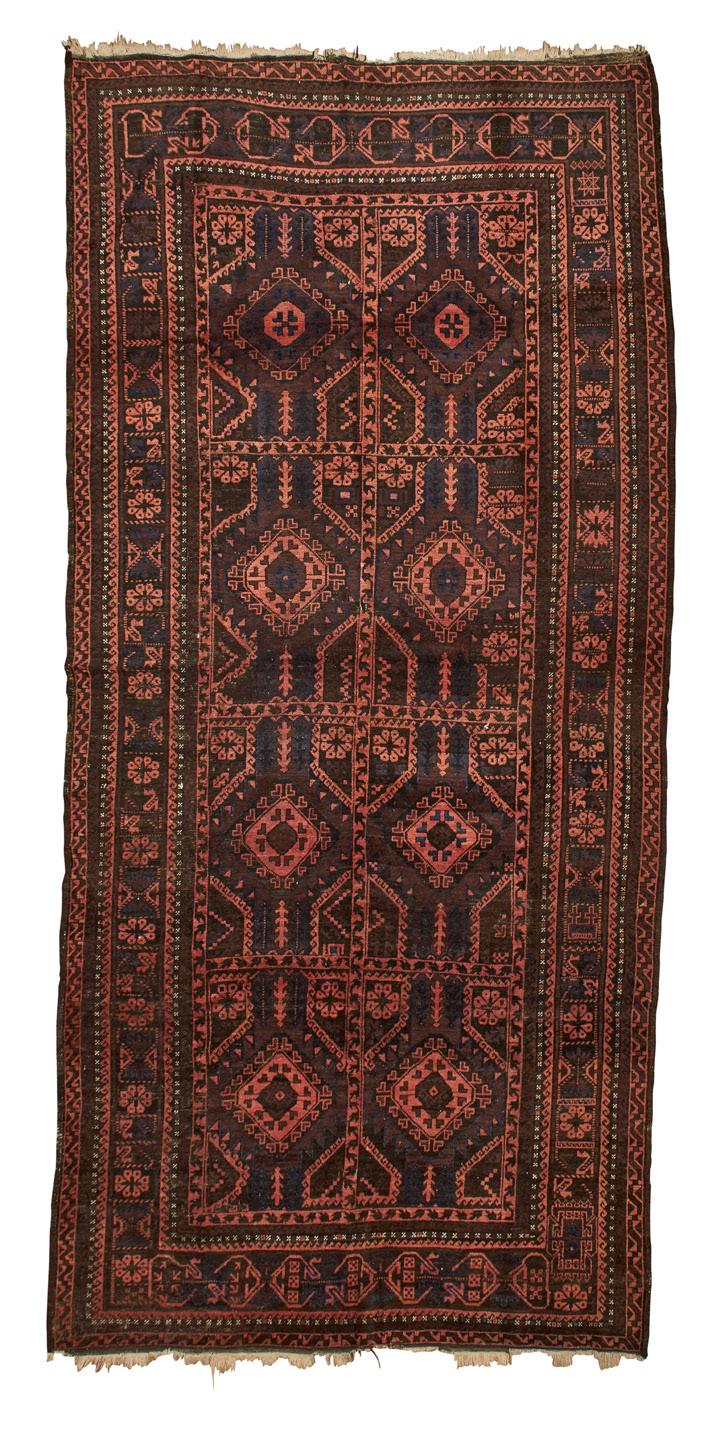

CENTRAL PERSIA, EARLY 20TH CENTURY
the indigo field with allover polychrome hexagonal lattice pattern, within indigo border
300cm x 166cm
£300-500
228
NORTHWEST PERSIA, LATE 19TH/EARLY 20TH CENTURY
the red field with indigo and yellow star medallion, ivory, red and green spandrels, within indigo border
347cm x 226cm
£1,200-1,800
JULKHIRS LONG RUG
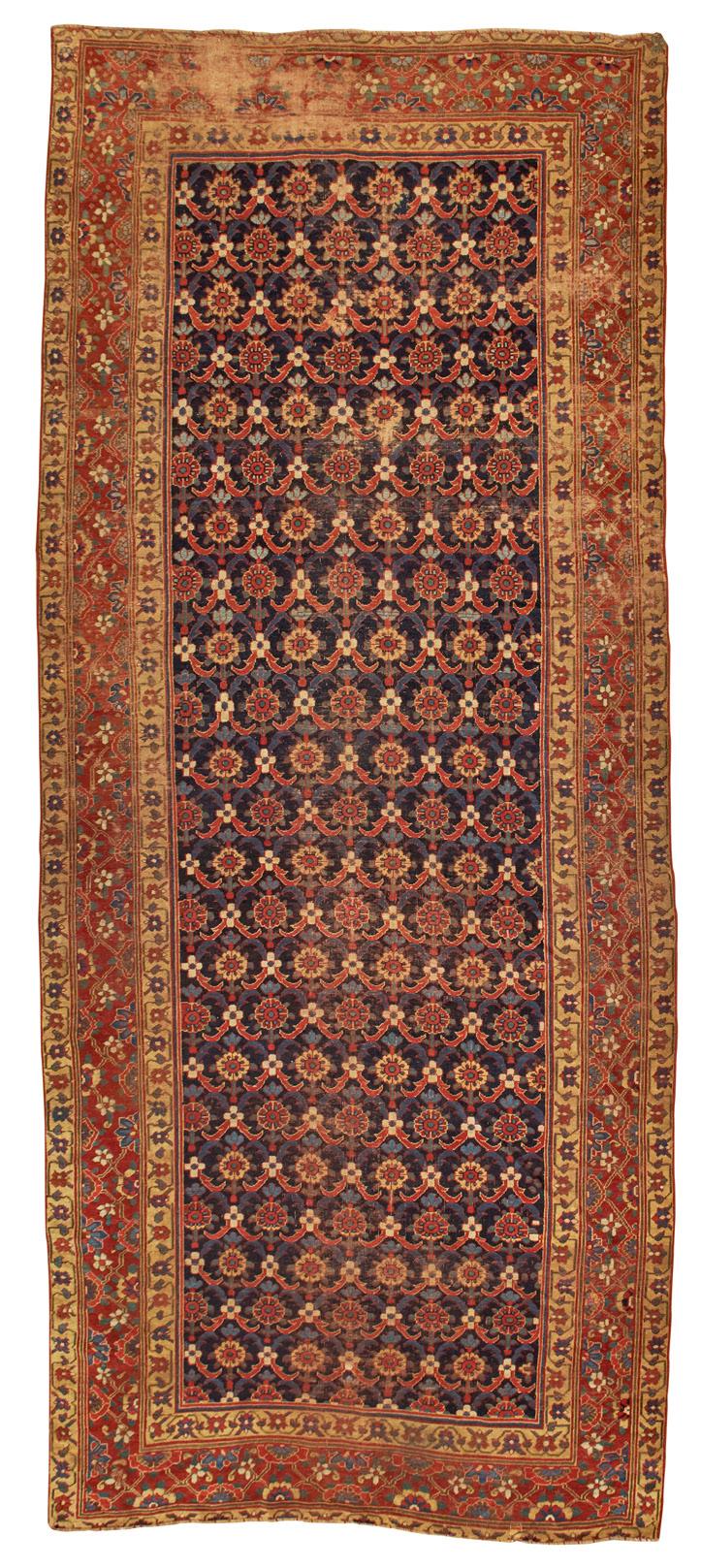
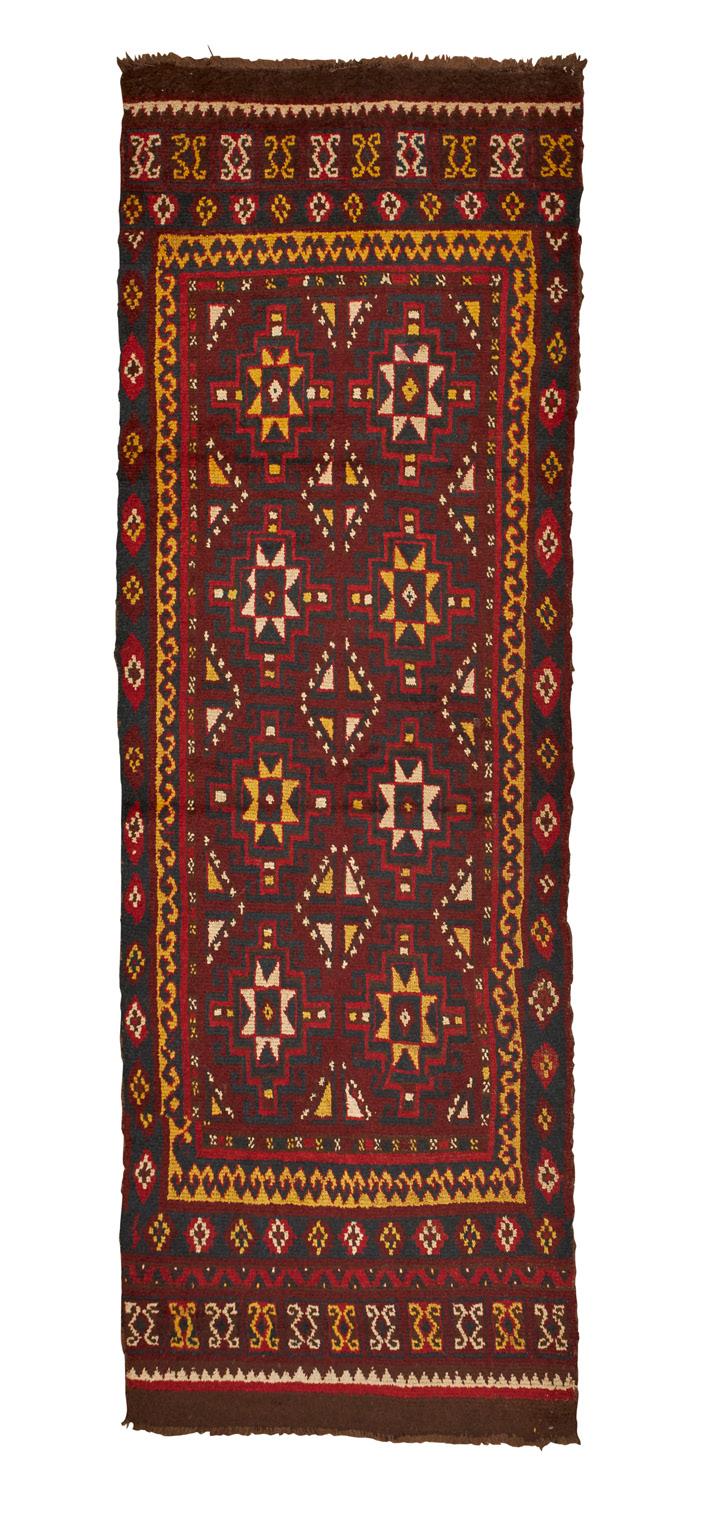
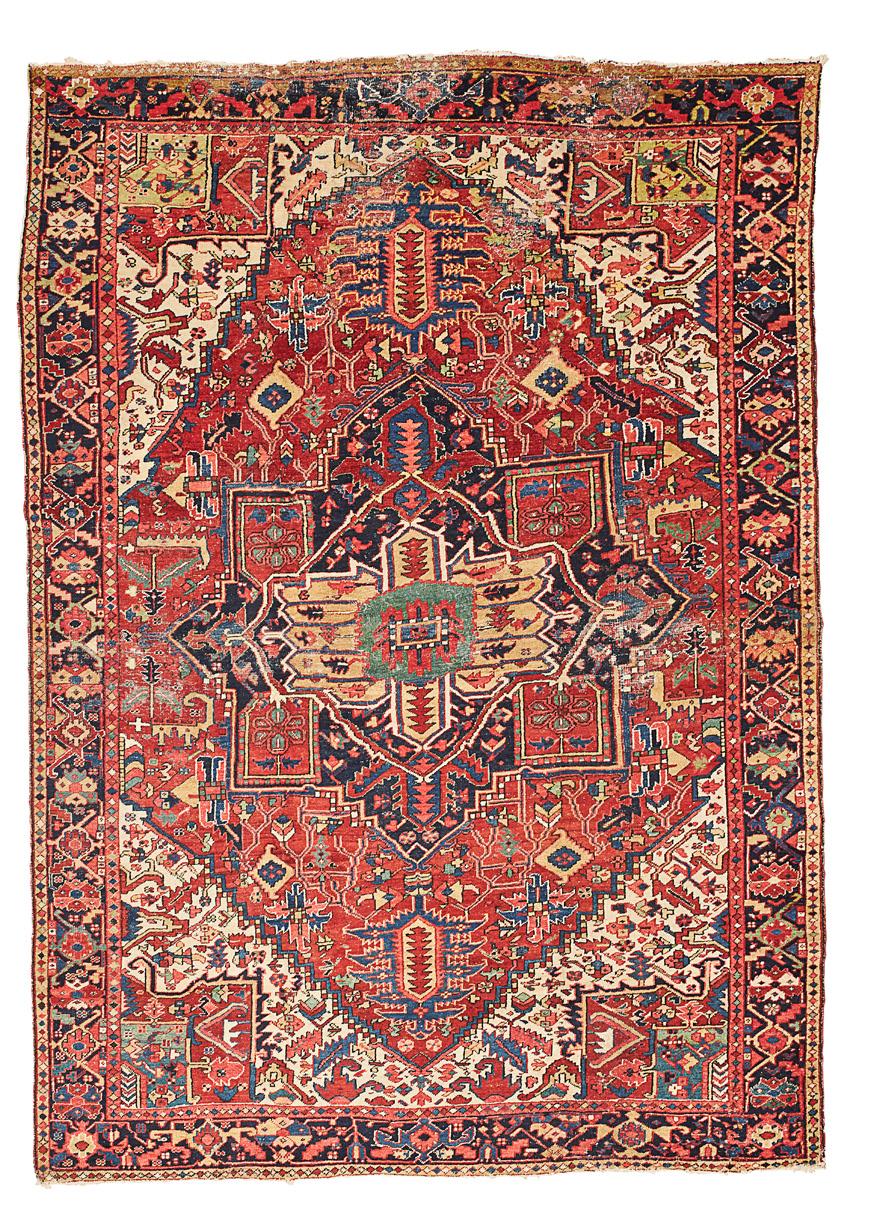
UZBEKISTAN, EARLY 20TH CENTURY
the brown field with two columns of four guls, within indigo border 324cm x 105cm
£300-500
TURKMENISTAN, LATE 19TH/ EARLY 20TH CENTURY
the indigo field with allover rosette lattice pattern, within rust red border 500cm x 228cm
£500-700
628
HERIZ CARPET
630
629 BESHIR CARPET
229 Other fees apply in addition to the hammer price: see the ‘Buyer’s Guide’ section on page 2
631
HERIZ CARPET
NORTHWEST PERSIA, LATE 19TH/EARLY 20TH CENTURY

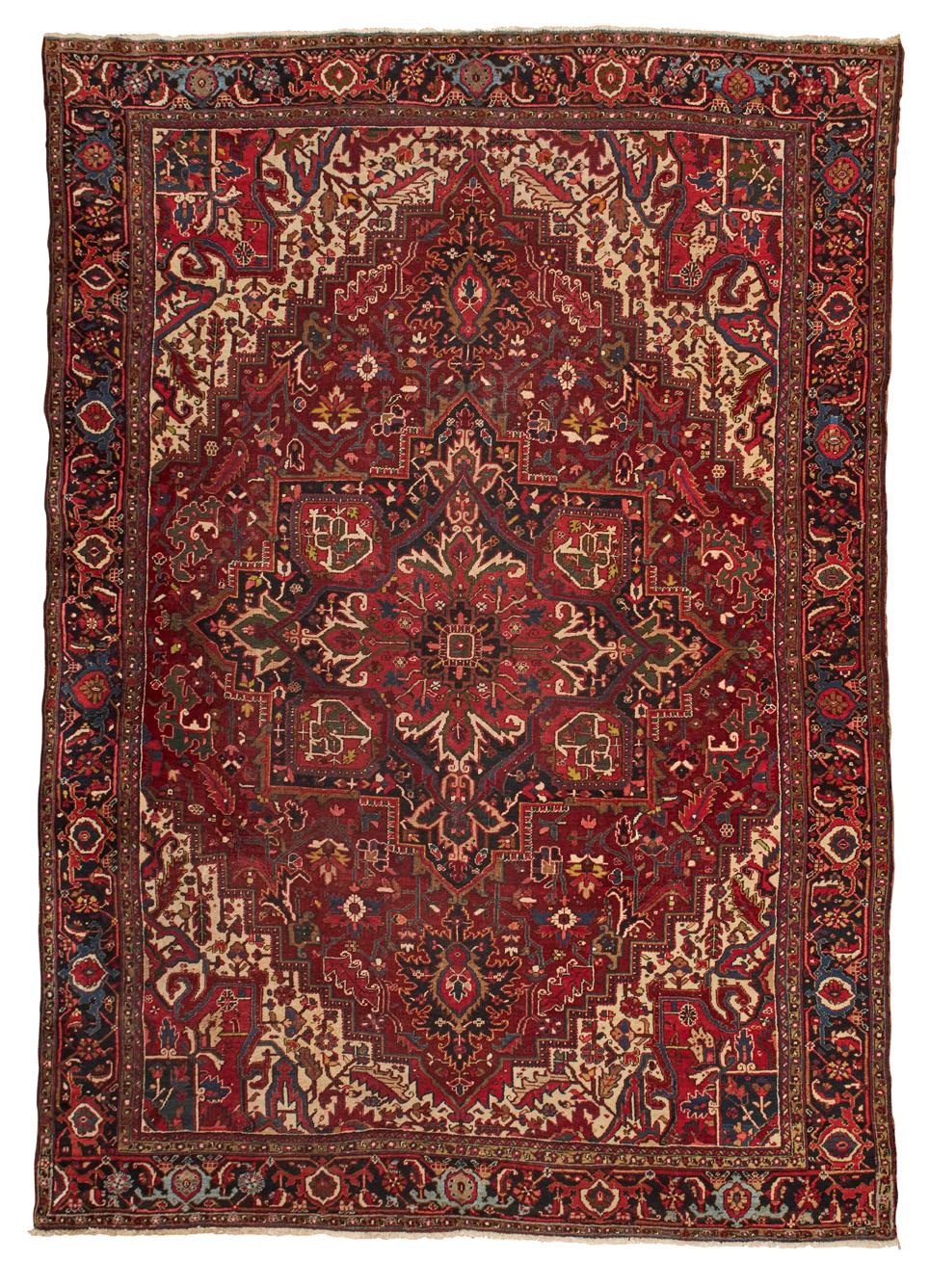

the red field with indigo and salmon pink star medallion, ivory, pink and indigo spandrels, within indigo border
338cm x 266cm
£1,500-2,500
633
HERIZ CARPET
NORTHWEST PERSIA, LATE
19TH/EARLY 20TH CENTURY
the red field with indigo and salmon pink star medallion, ivory, salmon pink and blue spandrels, within indigo border
334cm x 233cm
£1,500-2,500
632
QUM PART SILK
‘HUNTING’ CARPET
CENTRAL PERSIA, MID
20TH CENTURY
the cream field with allover figures on horseback hunting game, within red border
325cm x 204cm
£1,200-1,800
230
634
TABRIZ CARPET
NORTHWEST PERSIA, EARLY/MID 20TH CENTURY
the salmon pink field with indigo, light blue and rust medallion, within indigo border
362cm x 283cm
£1,500-2,500
635
LAVAR KIRMAN CARPET
SOUTHEAST PERSIA, LATE 19TH/EARLY 20TH CENTURY
the cream field with red and indigo medallion, similar spandrels, within narrow cream border, signature to one end
354cm x 264cm
£2,500-3,500
636
TABRIZ CARPET, SIGNED GHOL GHASEMI
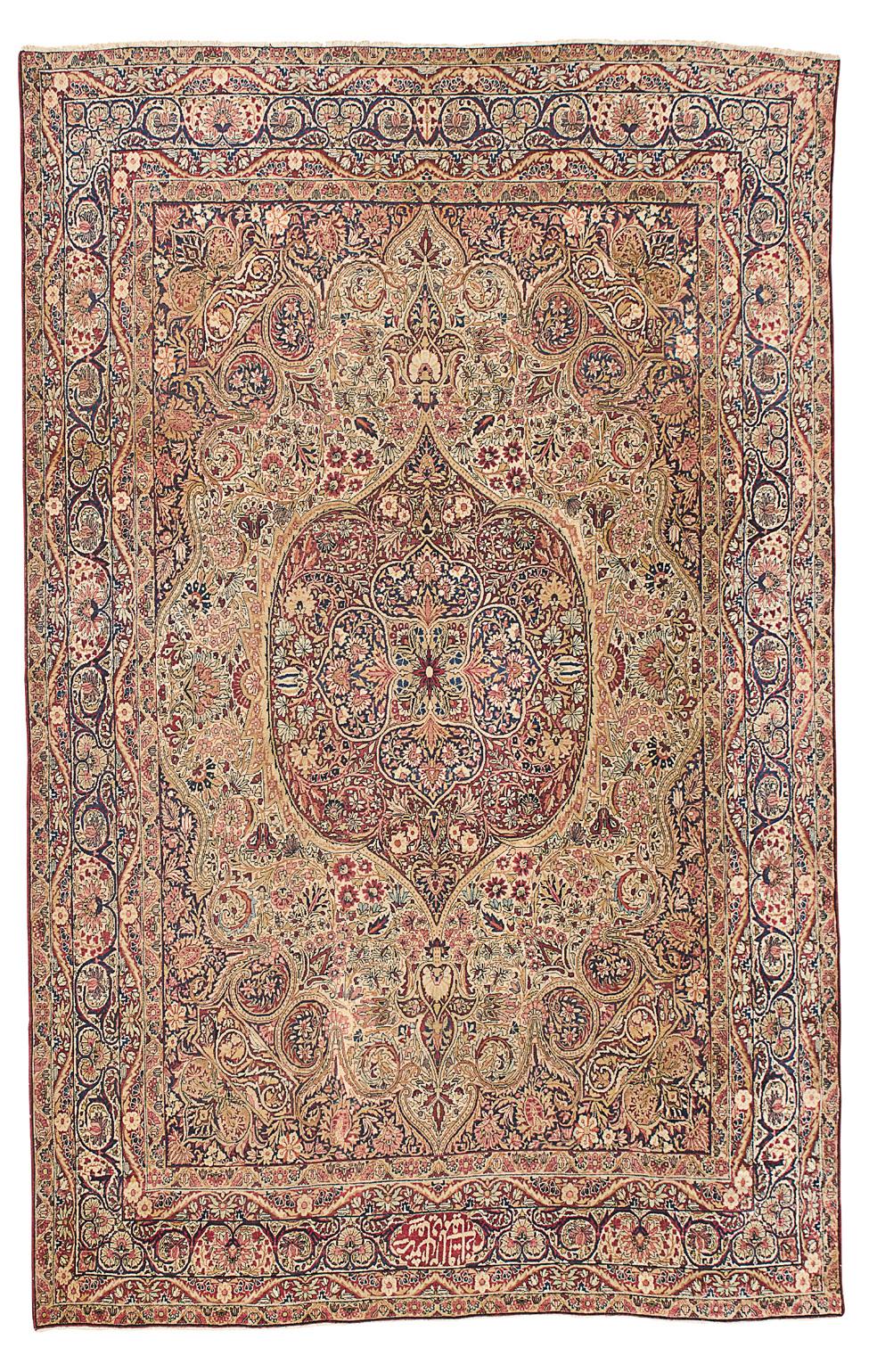
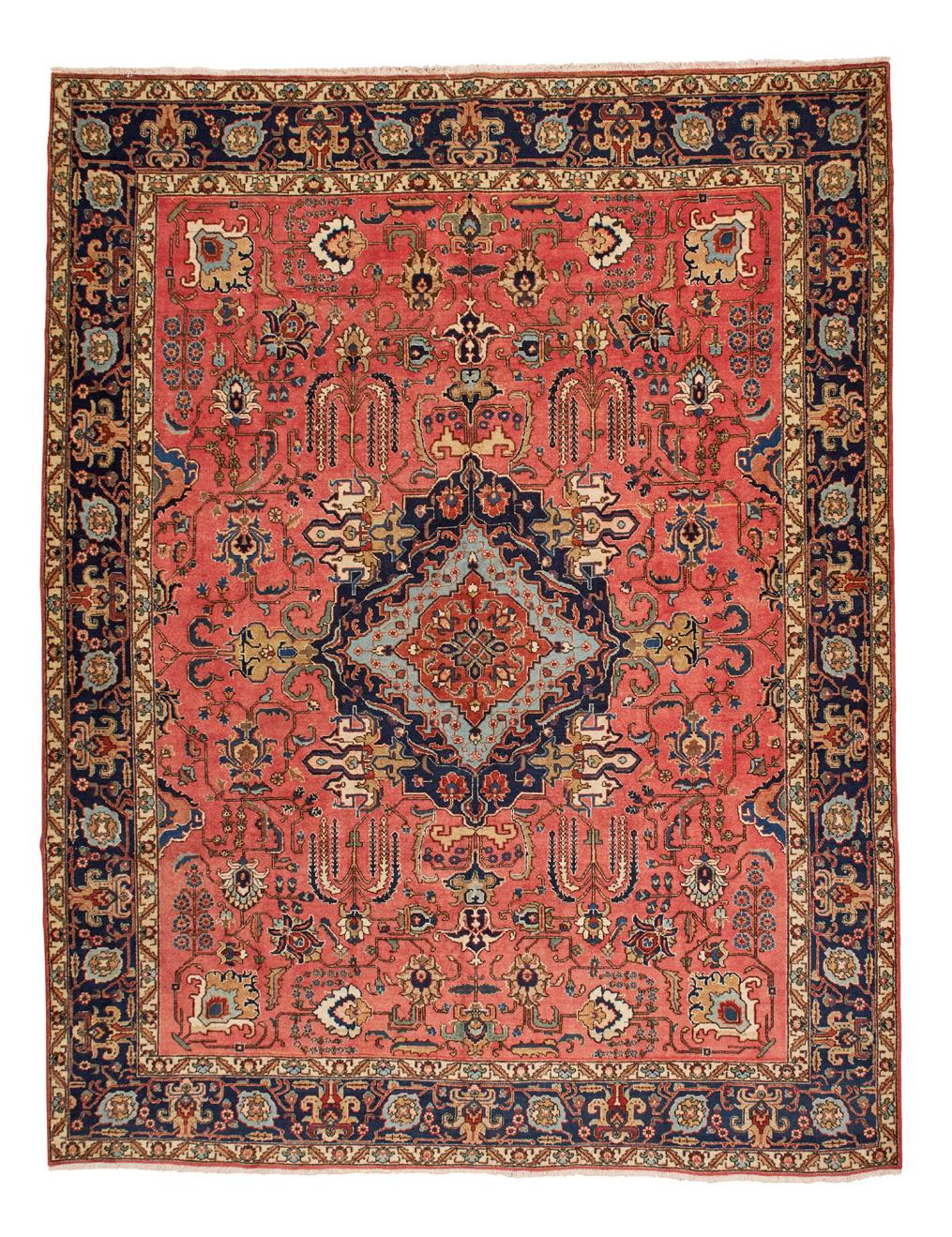
NORTHWEST PERSIA, MID 20TH CENTURY the turquoise field with allover palmette pattern, within rust brown border, signature to one end
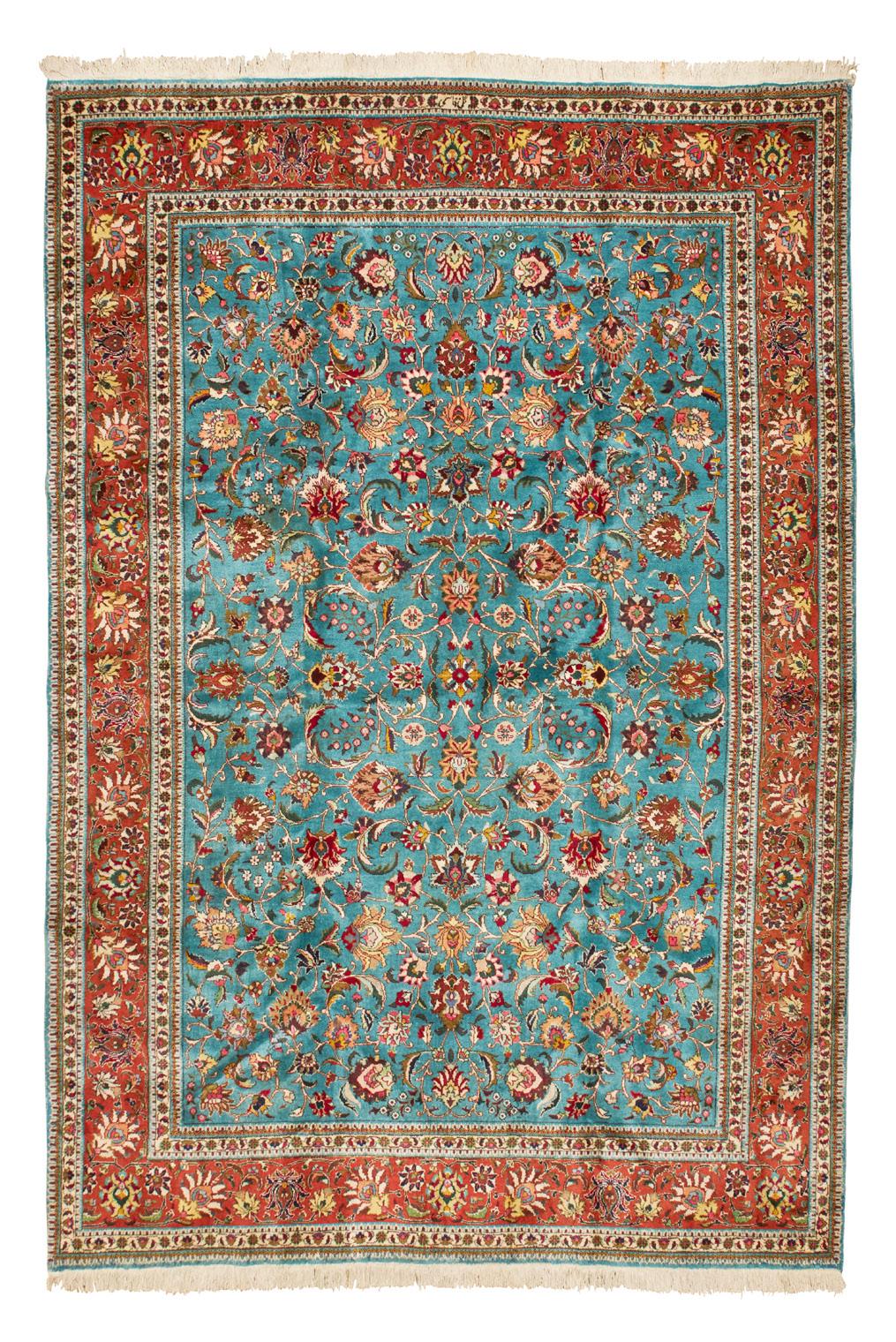
336cm x 252cm
£1,500-2,500
231 Other fees apply in addition to the hammer price: see the ‘Buyer’s Guide’ section on page 2
637
SUSANI
TASHKENT, UZBEKISTAN, LATE 19TH/EARLY 20TH CENTURY
the cream field with six large purple rosettes, dark brown scrolling surrounds, within similar border
311cm x 278cm
£400-600
638
TABRIZ STYLE CARPET MODERN
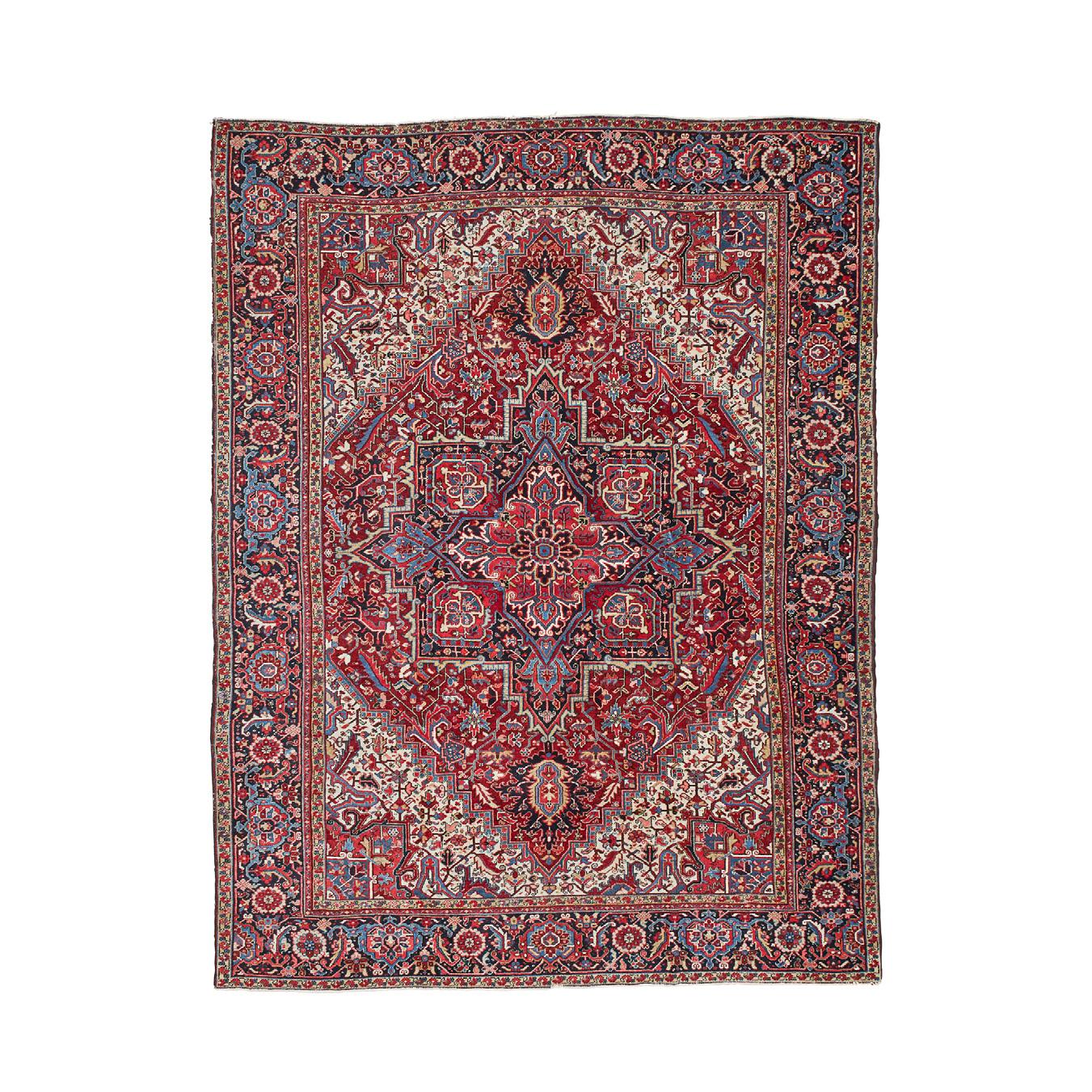
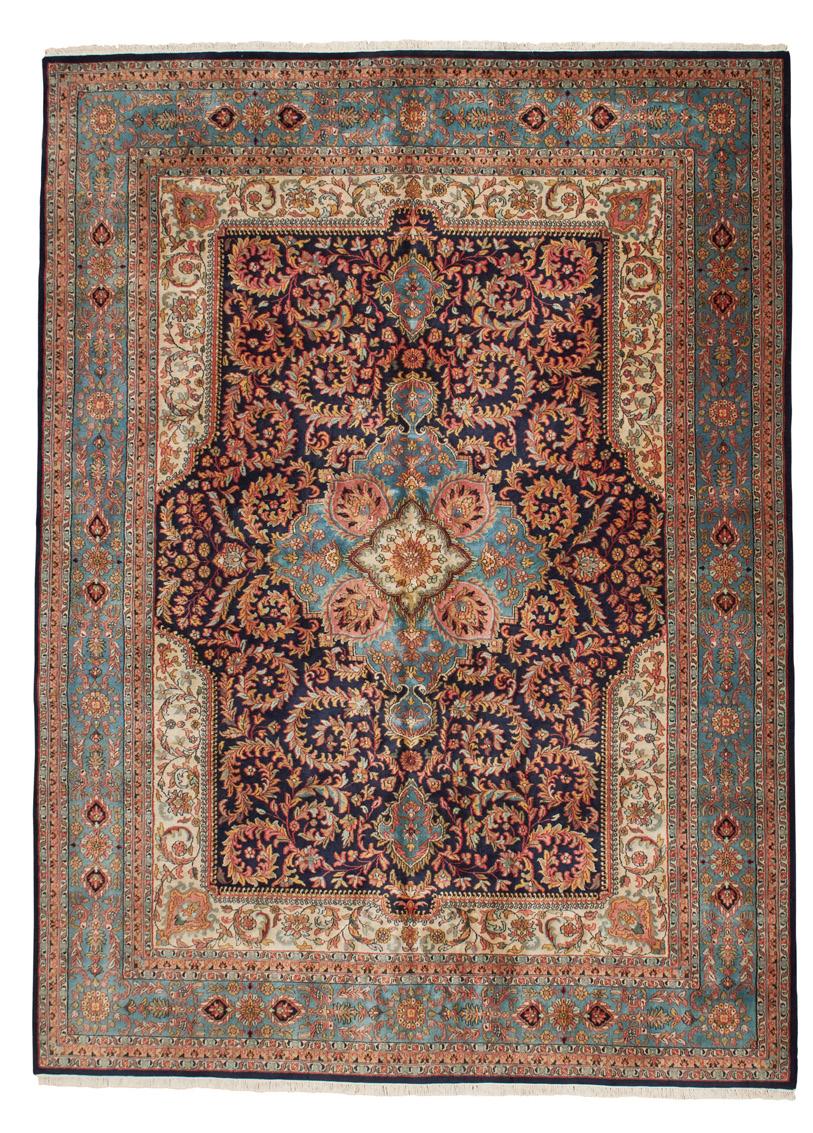

the indigo field with blue, pink and cream medallion, ivory bar spandrels, within light blue border
344cm x 246cm
£600-800
639
INDO-TABRIZ STYLE CARPET
MID/LATE 20TH CENTURY
the field with allover polychrome palmette and foliate lattice pattern, within narrow red border
363cm x 266cm
£700-1,000
640
HERIZ CARPET
NORTHWEST PERSIA, EARLY/MID 20TH CENTURY the red field with indigo star medallion, ivory and salmon pink spandrels, within indigo border
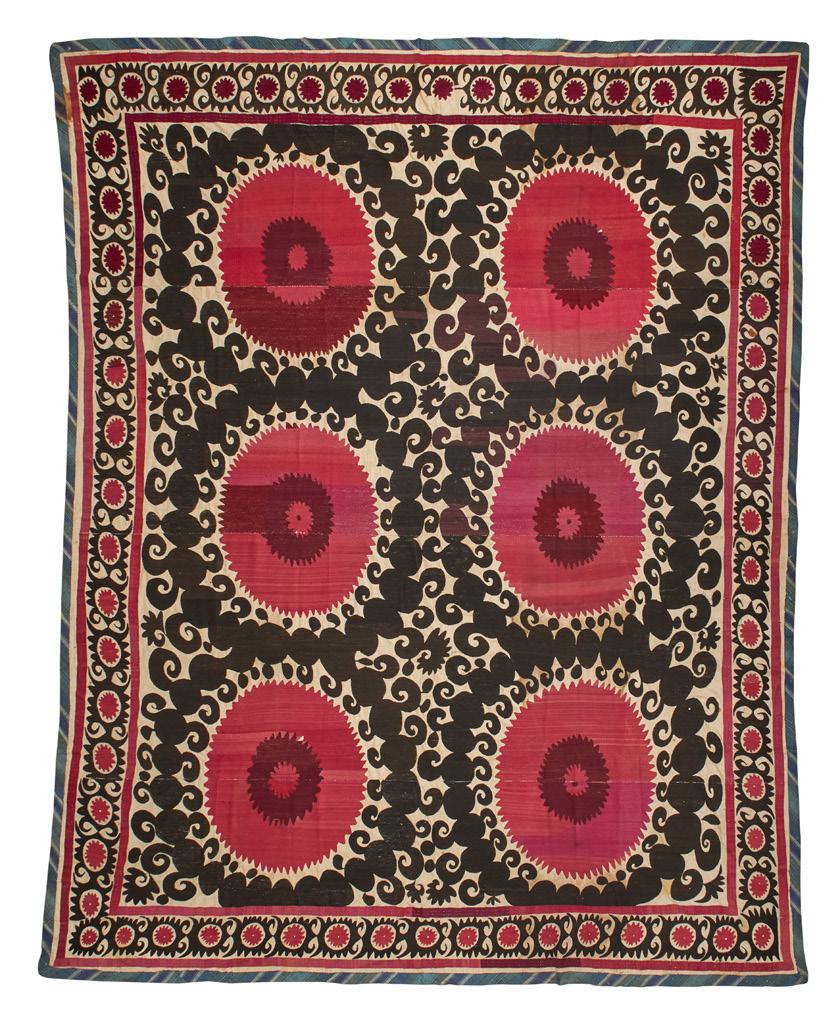
360cm x 248cm
£700-1,000
232
641 LARGE PEKING CARPET
NORTH CHINA, LATE 19TH/ EARLY 20TH CENTURY
the brown field with allover lattice pattern, light brown medallion, dragons to the corners, within brown border

800cm x 400cm
£8,000-12,000

233 Other fees apply in addition to the hammer price: see the ‘Buyer’s Guide’ section on page 2
642
TABRIZ CARPET
NORTHWEST PERSIA, EARLY/MID 20TH CENTURY
the camel field with indigo and yellow medallion, salmon pink spandrels, within camel border
390cm x 296cm
£600-800
643
TABRIZ CARPET
NORTHWEST PERSIA, LATE 20TH CENTURY
the light brown field with indigo, ivory and green medallion, blue spandrels, within indigo border
395cm x 200cm
£700-1,000
644
TABRIZ CARPET


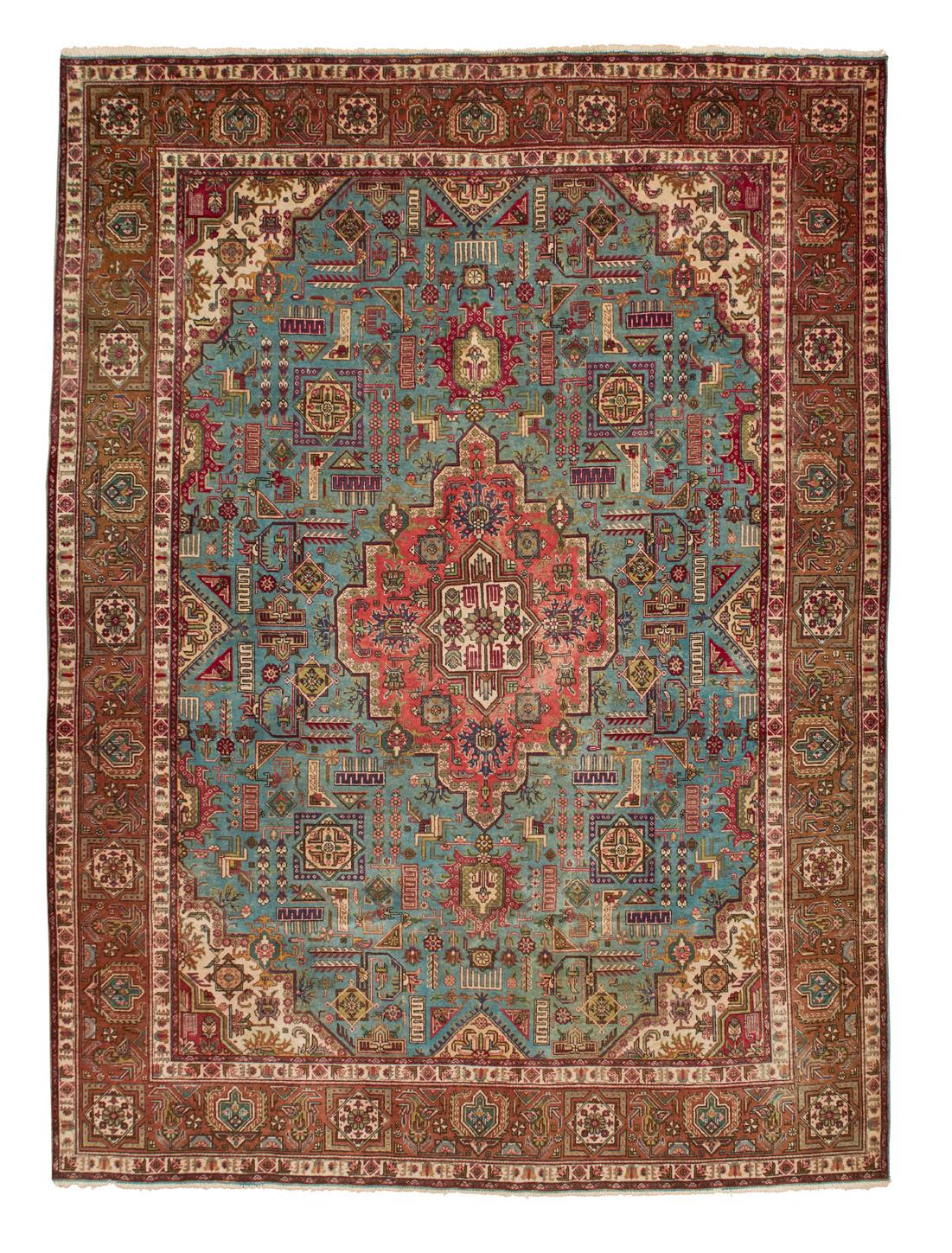
NORTHWEST PERSIA, MID/LATE 20TH CENTURY
the blue field with salmon pink medallion, ivory and red spandrels, within brown border
395cm x 302cm
£400-600
234 Other fees apply in addition to the hammer price: see the ‘Buyer’s Guide’ section on page 2
645
TABRIZ CARPET
NORTHWEST PERSIA, MID 20TH CENTURY
the red field with allover palmette pattern, within cream border
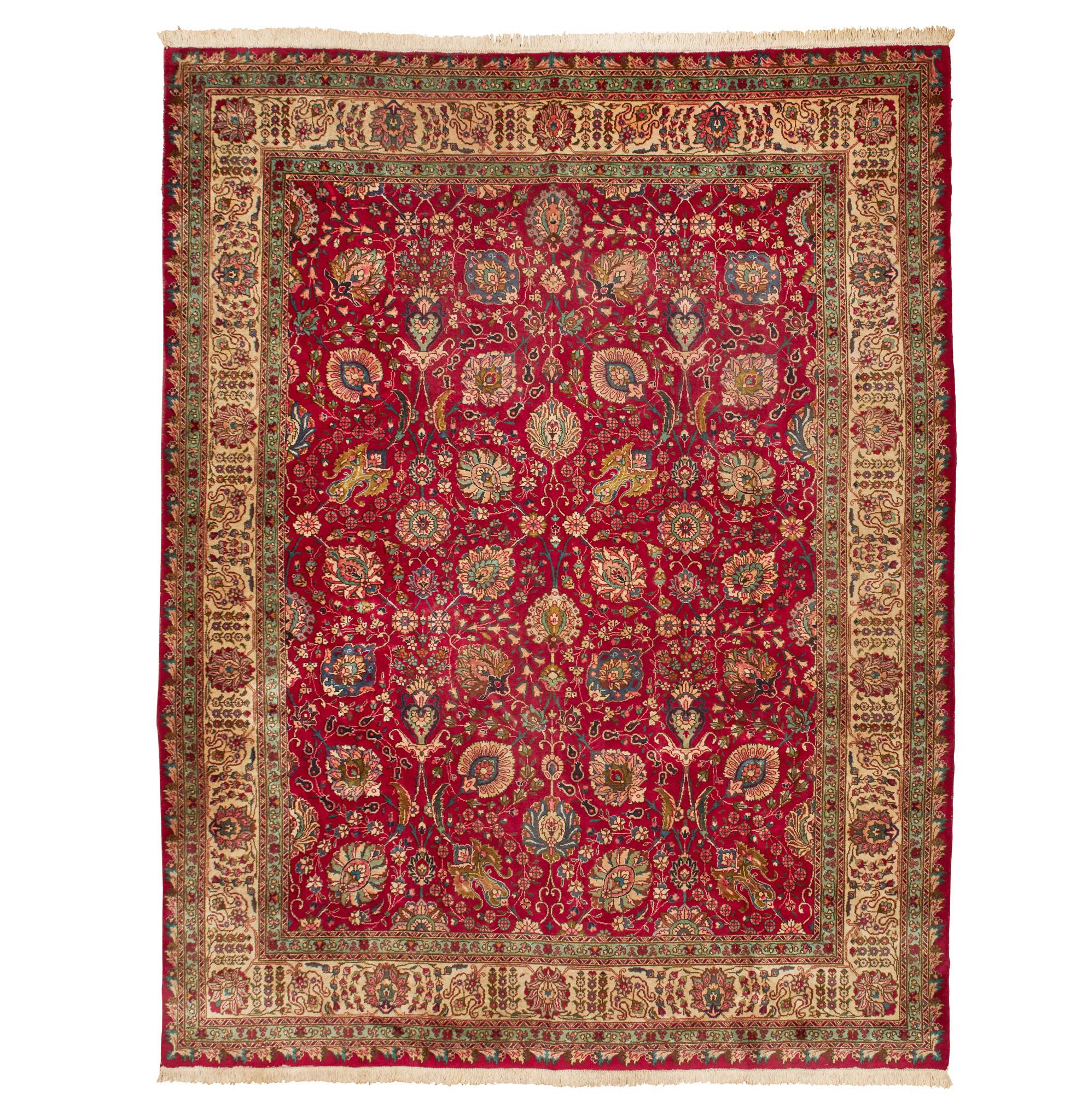
382cm x 297cm
£400-600
646
KASHAN CARPET

CENTRAL PERSIA, LATE 20TH CENTURY
the turquoise field with open arabesque medallion, similar spandrels, within olive border
445cm x 309cm
£1,000-1,500
647
HERIZ CARPET
NORTHWEST PERSIA, LATE 19TH/EARLY 20TH CENTURY
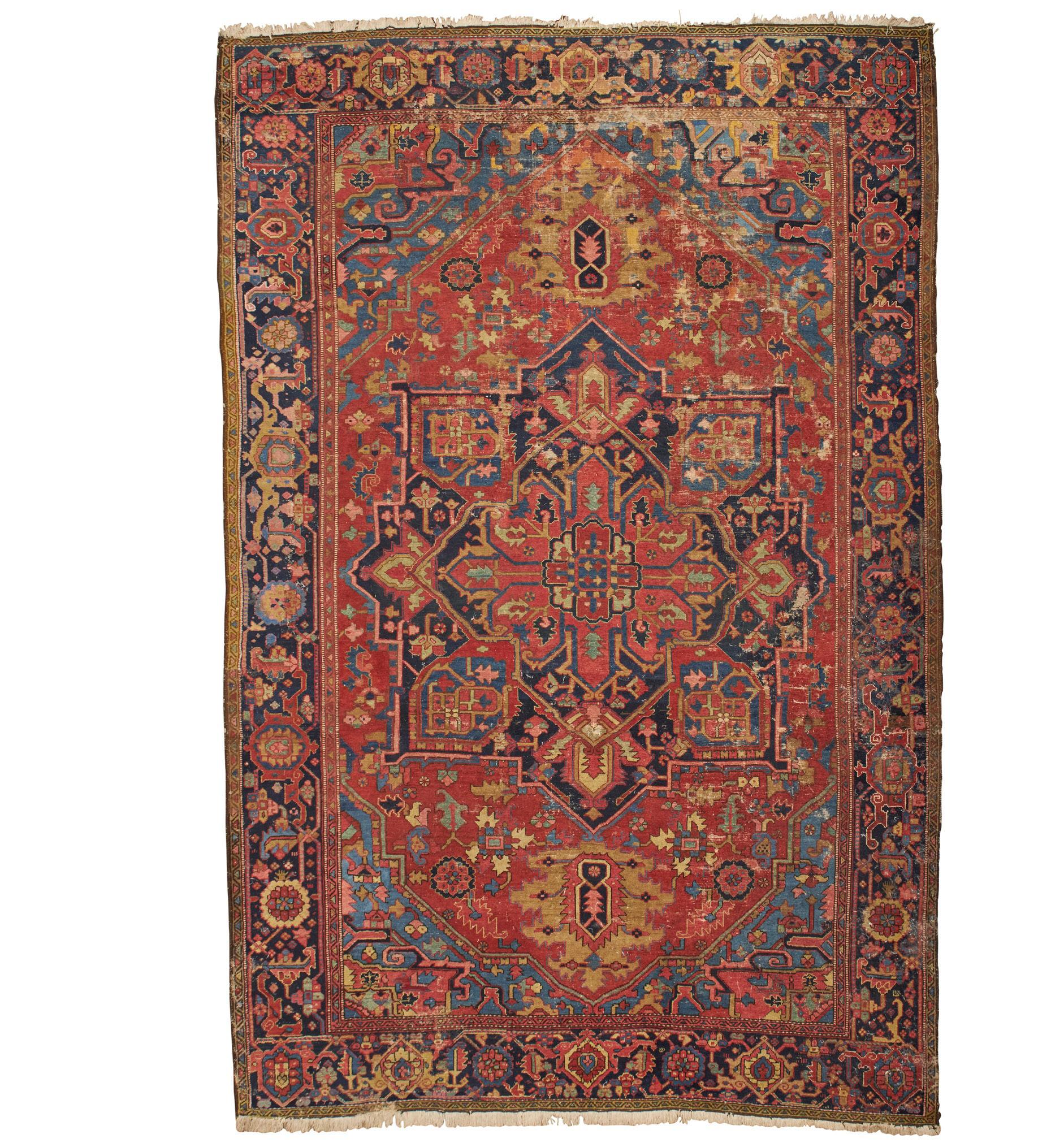
the red field with large indigo and red star medallion, blue and red spandrels, within indigo border
371cm x 295cm
£300-500
235
648
TABRIZ CARPET
NORTHWEST PERSIA, MID 20TH CENTURY
the cream field with allover palmette pattern, within light brown border
400cm x 289cm
£1,000-1,500
650
TABRIZ CARPET
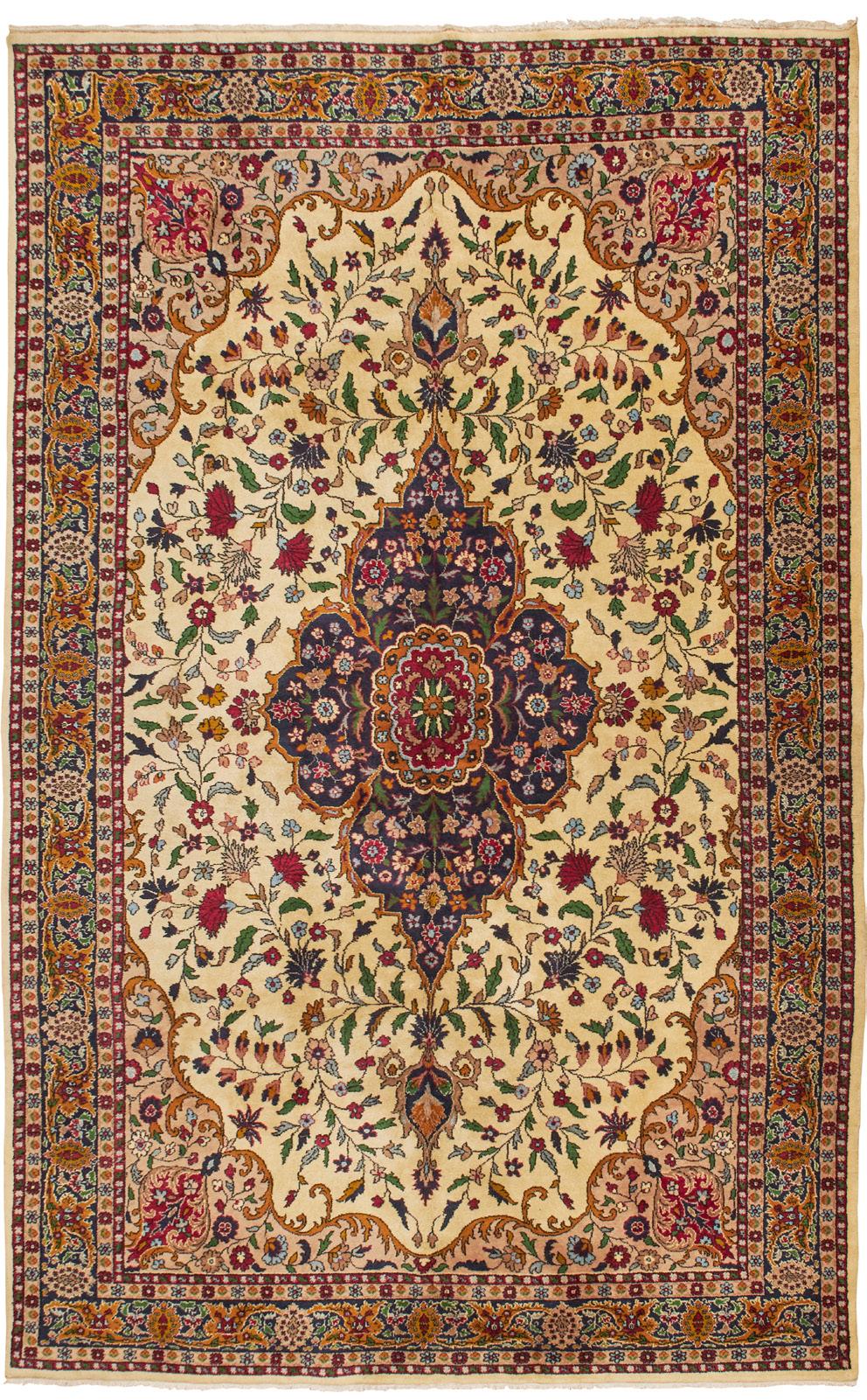
NORTHWEST PERSIA, MID 20TH CENTURY
the red field with allover palmette pattern, within cream border, signature to one end

390cm x 298cm
£500-700
649
KAYSERI CARPET
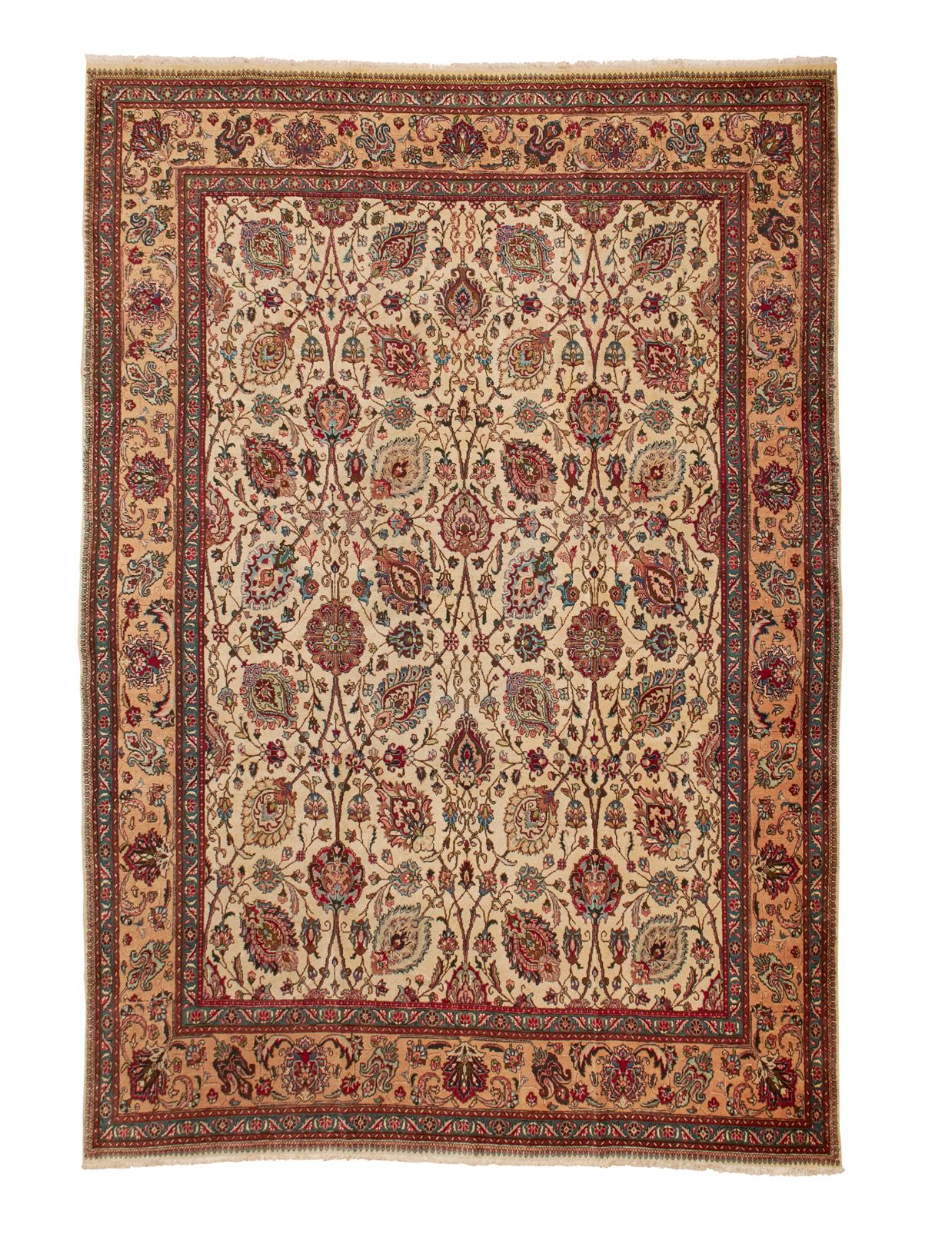
CENTRAL ANATOLIA, MID/LATE 20TH CENTURY
the cream field with elongated indigo medallion, beige spandrels, within indigo border
400cm x 247cm
£500-700
236 Other fees apply in addition to the hammer price: see the ‘Buyer’s Guide’ section on page 2
651
TABRIZ CARPET
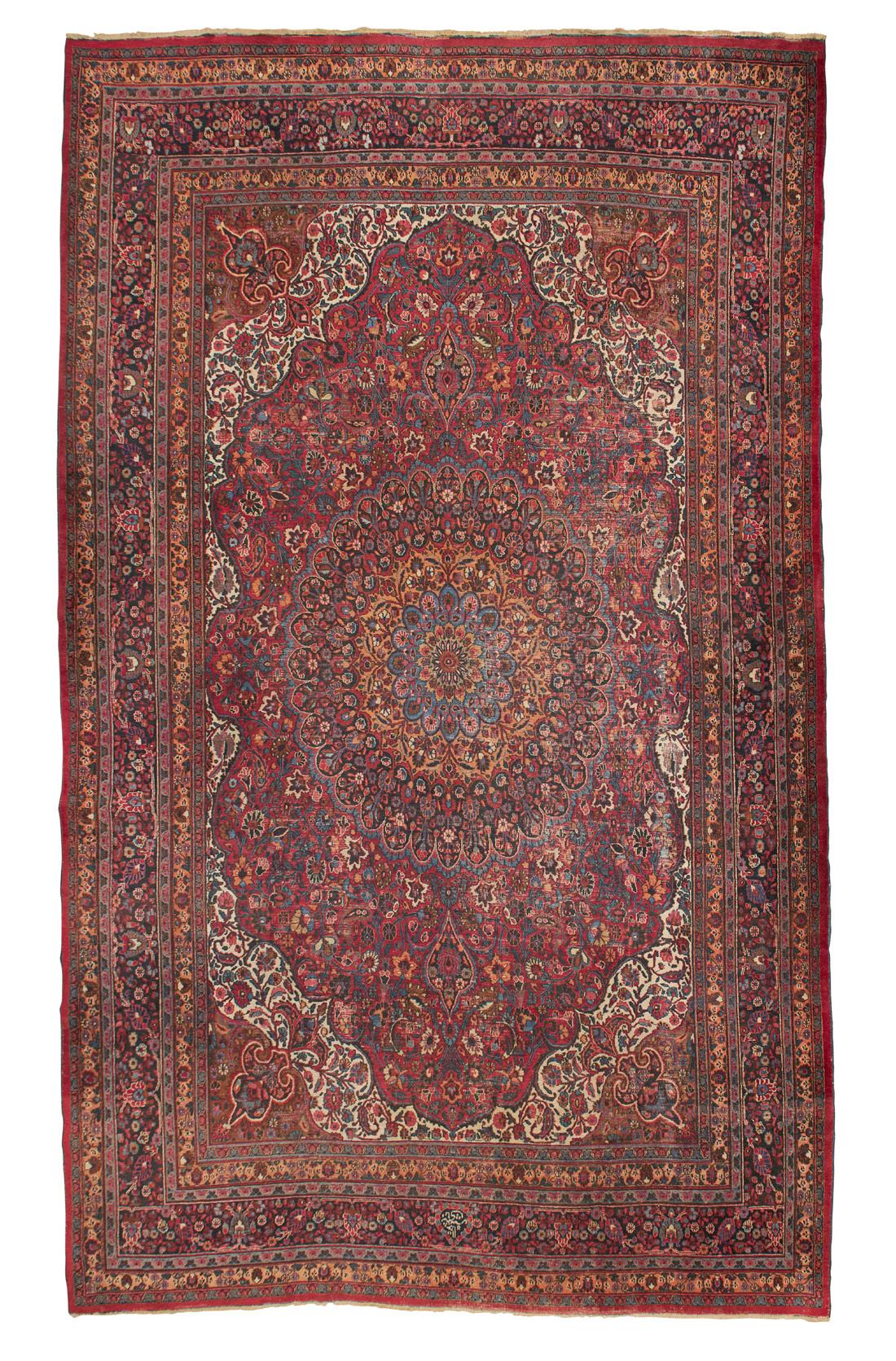

NORTHWEST PERSIA, EARLY/MID 20TH CENTURY
the indigo field with rust red medallion, cream and olive spandrels, within rust red border
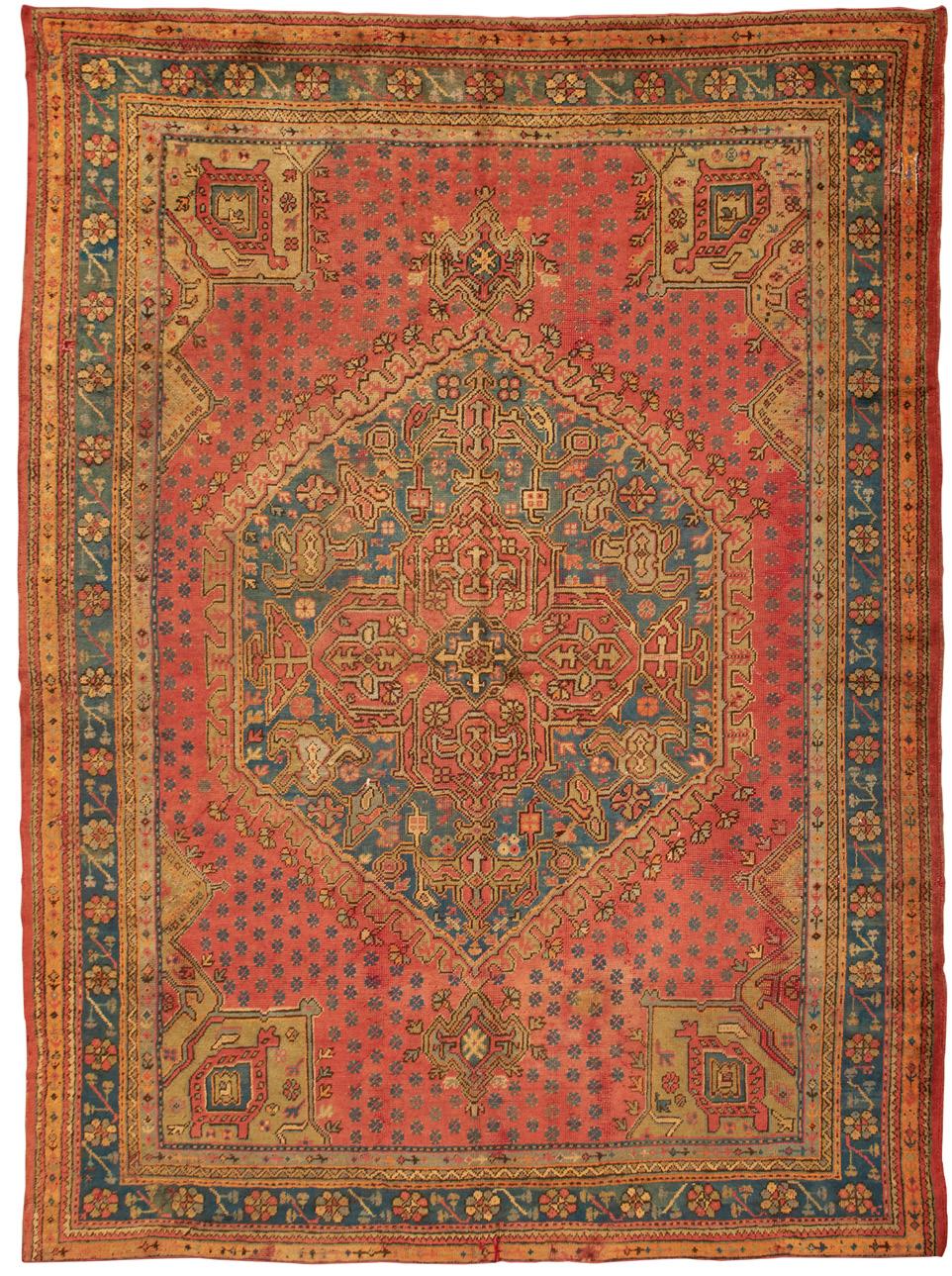
405cm x 287cm
£1,200-1,800
652
KHORASSAN CARPET
EAST PERSIA, LATE 19TH/ EARLY 20TH CENTURY
the red field with indigo and orange medallion, ivory and brown spandrels, within indigo border, signature to one end
454cm x 320cm
£3,000-4,000
653
USHAK CARPET
WEST ANATOLIA, LATE 19TH/ EARLY 20TH CENTURY
the light red field with large indigo and red medallion, olive spandrels, within narrow indigo border
411cm x 307cm
Provenance: Morland House, Morland, Penrith. Part of the Markham Family’s contents since the late 19th century
£400-600
237
654
TABRIZ CARPET
NORTHWEST PERSIA, MODERN
the washed reddish beige field with allover palmette pattern, within brown border
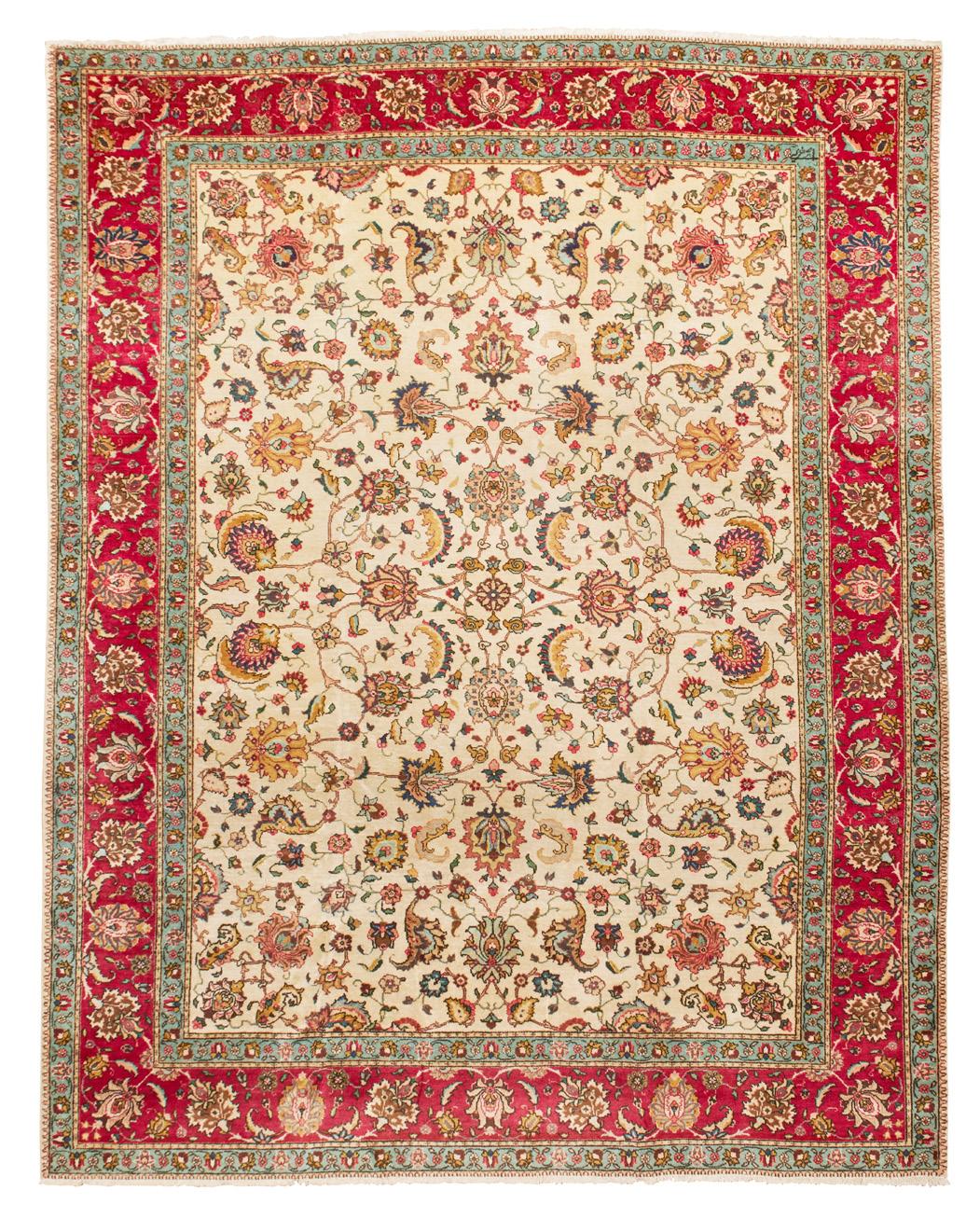
285cm x 296cm
£800-1,200
656
TABRIZ CARPET, SIGNED ASGHARI
NORTHWEST PERSIA, MID 20TH CENTURY
the cream field with allover palmette pattern, within red border, signature to one corner
364cm x 266cm
£1,000-1,500
655
TABRIZ CARPET, SIGNED AAMMI
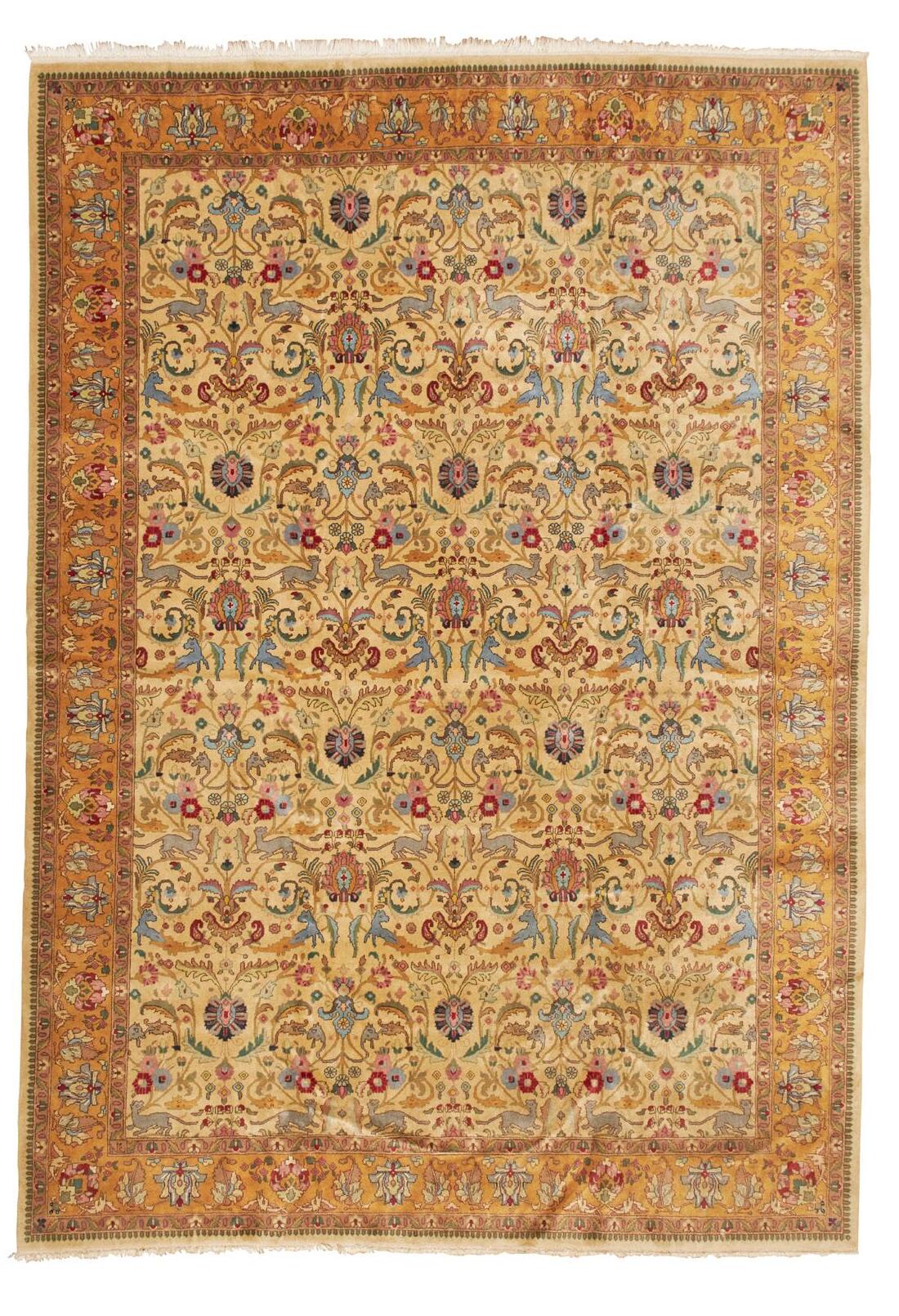
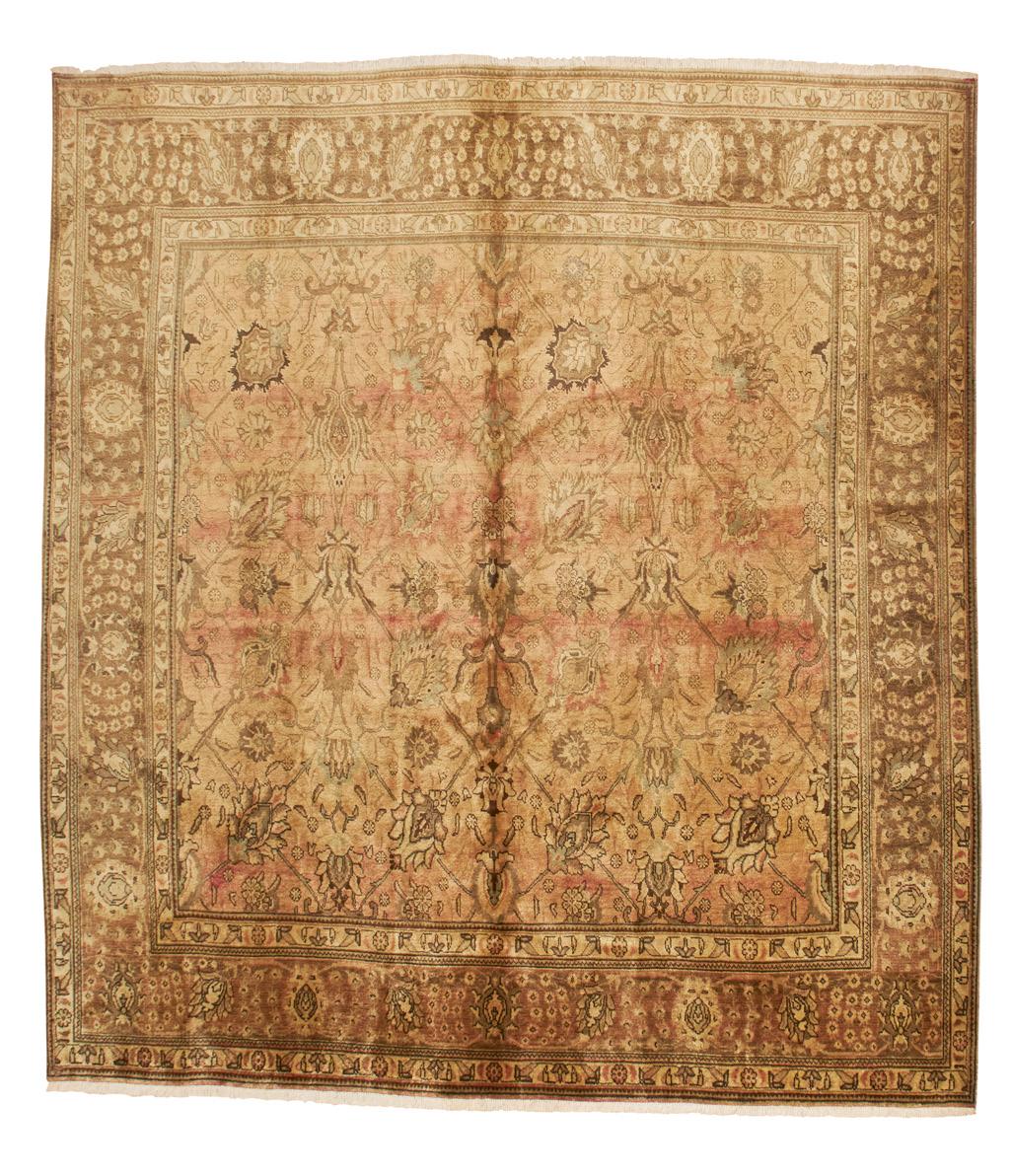
NORTHWEST PERSIA, MID 20TH CENTURY
the cream field with allover foliate and animal pattern, within ochre border, signature to one corner
343cm x 238cm
£1,000-1,500
238
657

EUROPEAN NEEDLEWORK CARPET
PROBABLY PRINCIPALLY LATE 18TH CENTURY the cream field with circular medallion of two geese, scrolling floral vine surround, within similar border 286cm x 206cm

£2,000-3,000

239 Other fees apply in addition to the hammer price: see the ‘Buyer’s Guide’ section on page 2
658
NORTHWEST PERSIAN RUNNER
LATE 19TH/EARLY 20TH CENTURY
the red field with column of indigo medallions, within triple ivory, indigo and red borders
436cm x 89cm
£300-500
659
KARAJA RUNNER
NORTHWEST PERSIA, MODERN
the red field with column of polychrome medallions, within narrow ivory border
433cm x 69cm
£500-700
660
NORTHWEST PERSIAN RUNNER
EARLY/MID 20TH CENTURY
the red field with column of lozenge medallions, within ivory border
419cm x 86cm
£300-500
661
SARAB RUNNER
NORTHWEST PERSIA, LATE 19TH/ EARLY 20TH CENTURY

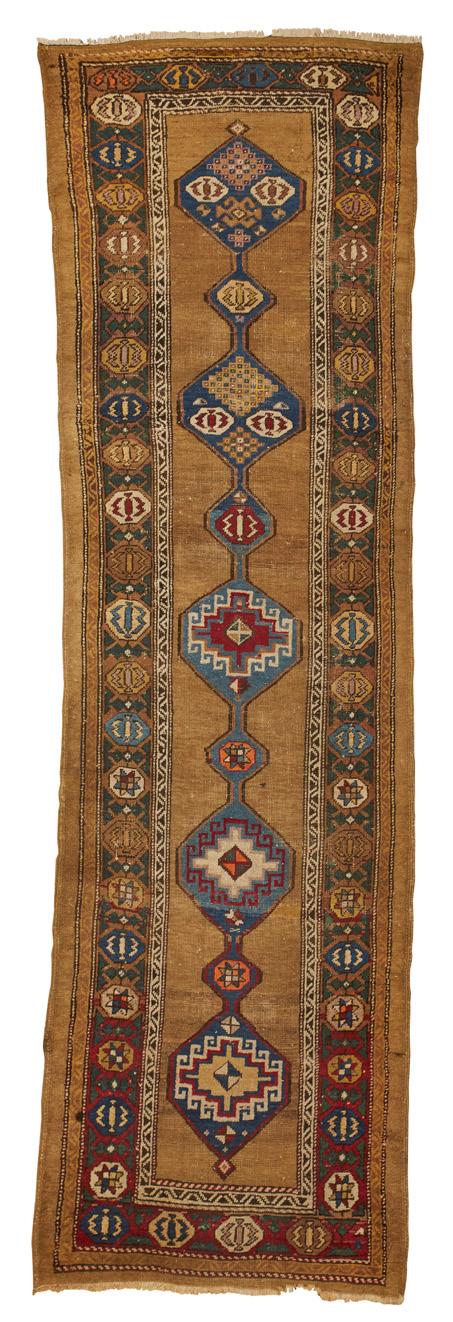


the camel field with column of indigo medallions, within brown/red border
294cm x 97cm
£300-500
240
662
KARAJA RUNNER
NORTHWEST PERSIA, MODERN
the red field with column of polychrome medallions, within indigo border


648cm x 84cm
£2,000-3,000
663
KARAJA RUNNER
NORTHWEST PERSIA, MODERN
the cream field with column of polychrome medallions, within narrow indigo border
405cm x 77cm
£800-1,200
664
BESHIR RUNNER
TURKMENISTAN, EARLY 20TH CENTURY

the red field with three lozenge medallions, within polychrome border
315cm x 145cm
£300-500
241 Other fees apply in addition to the hammer price: see the ‘Buyer’s Guide’ section on page 2
665
KIZIL AYAK PRAYER RUG

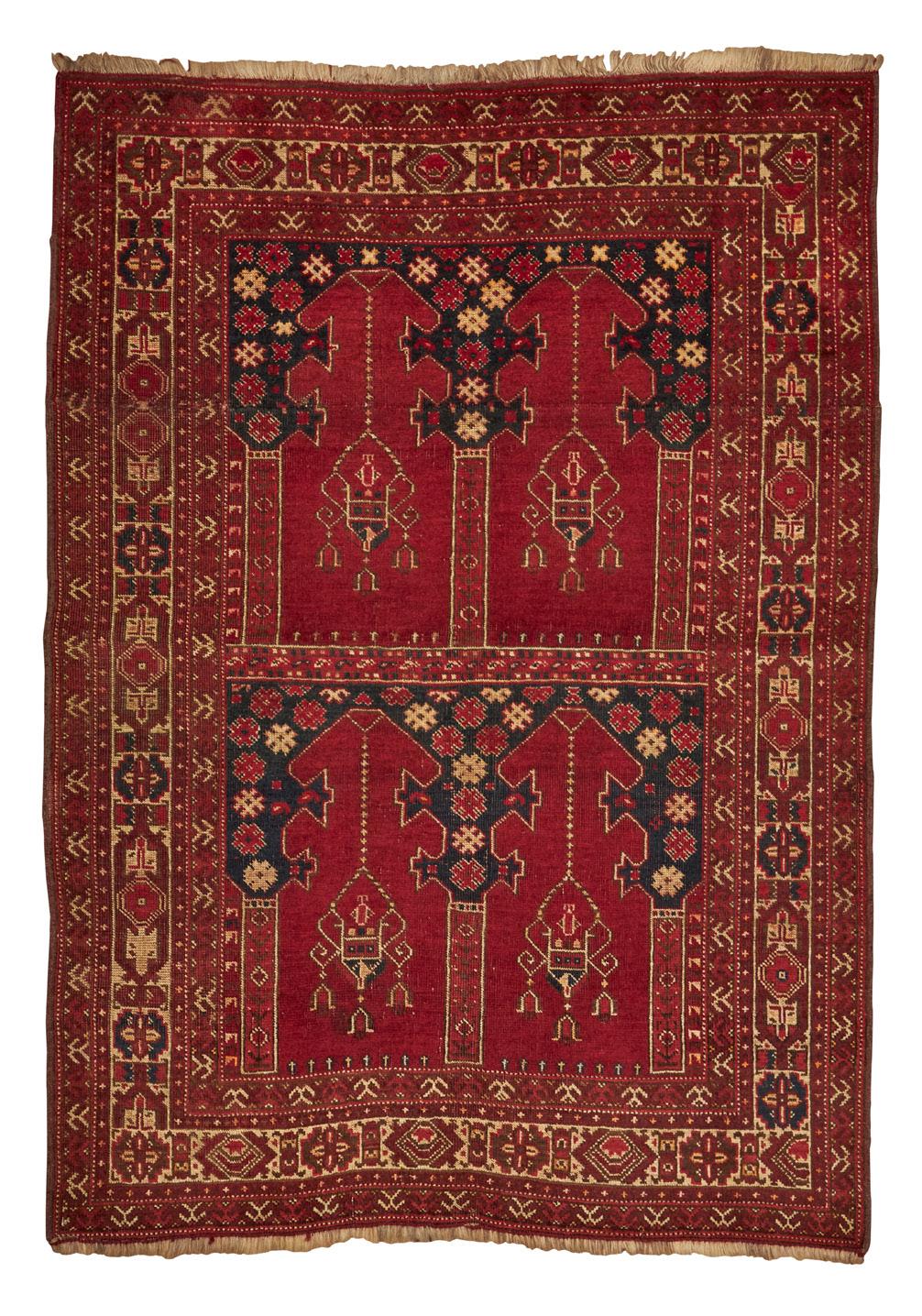
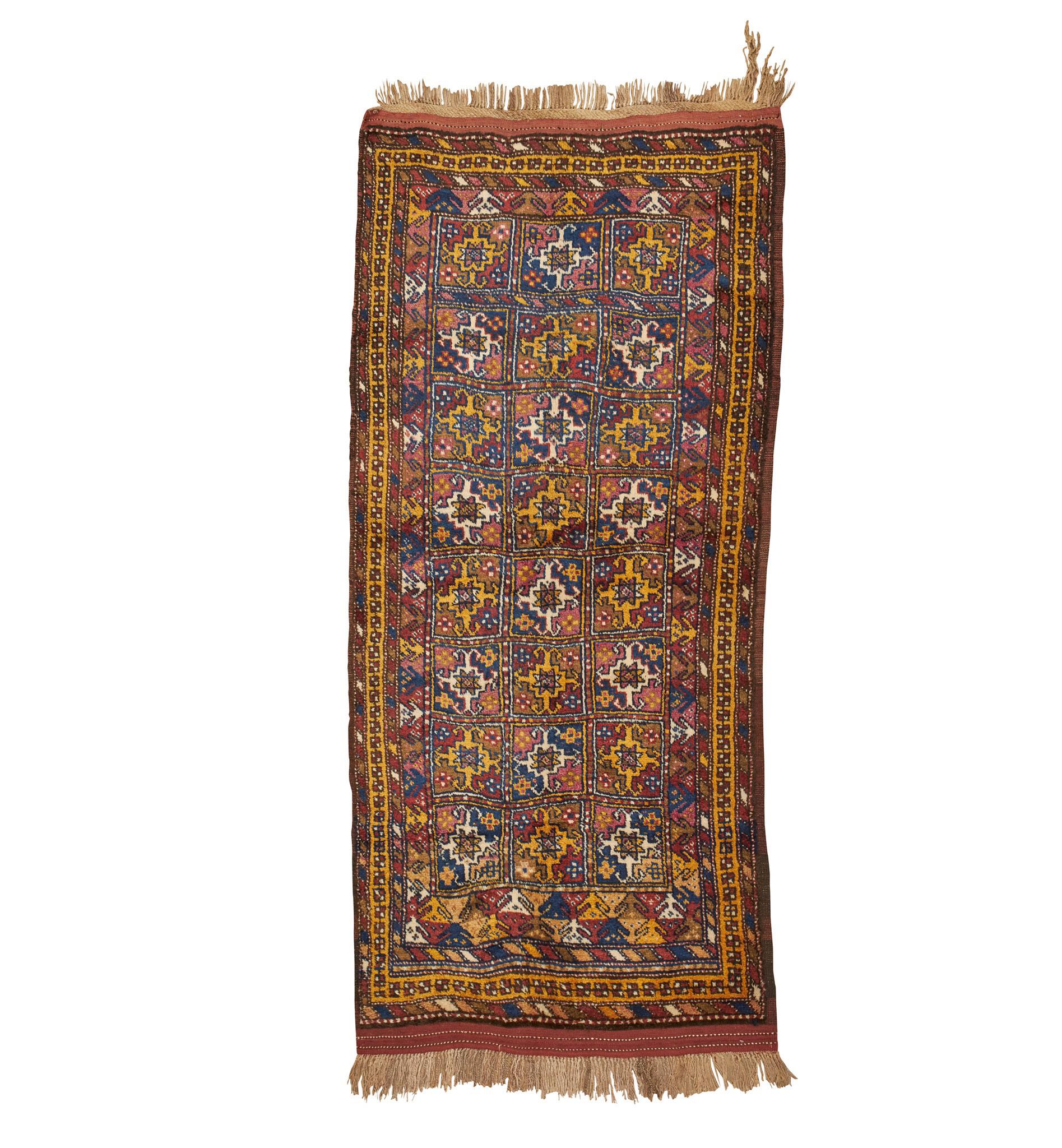
TURKMENISTAN, LATE 19TH/EARLY 20TH CENTURY
the field with four red mihrabs, indigo spandrels, within ivory border
151cm x 115cm
£300-500
667
KUBA RUG
EAST CAUCASUS, LATE 19TH/EARLY 20TH CENTURY
the indigo field with three serrated lozenge medallions, within brown border
172cm x 108cm
£300-500
666
AFGHAN
EARLY/MID 20TH CENTURY
the polychrome field with allover gul square lattice pattern, within narrow yellow border, kilim ends
262cm x 122cm
£300-500
CARPET
242
668
SENNEH RUG
WEST PERSIA, LATE 19TH/EARLY 20TH CENTURY the cream field with indigo medallion, similar spandrels, with allover harati pattern, within narrow red border
194cm x 130cm
£600-800
669
ISFAHAN PRAYER RUG

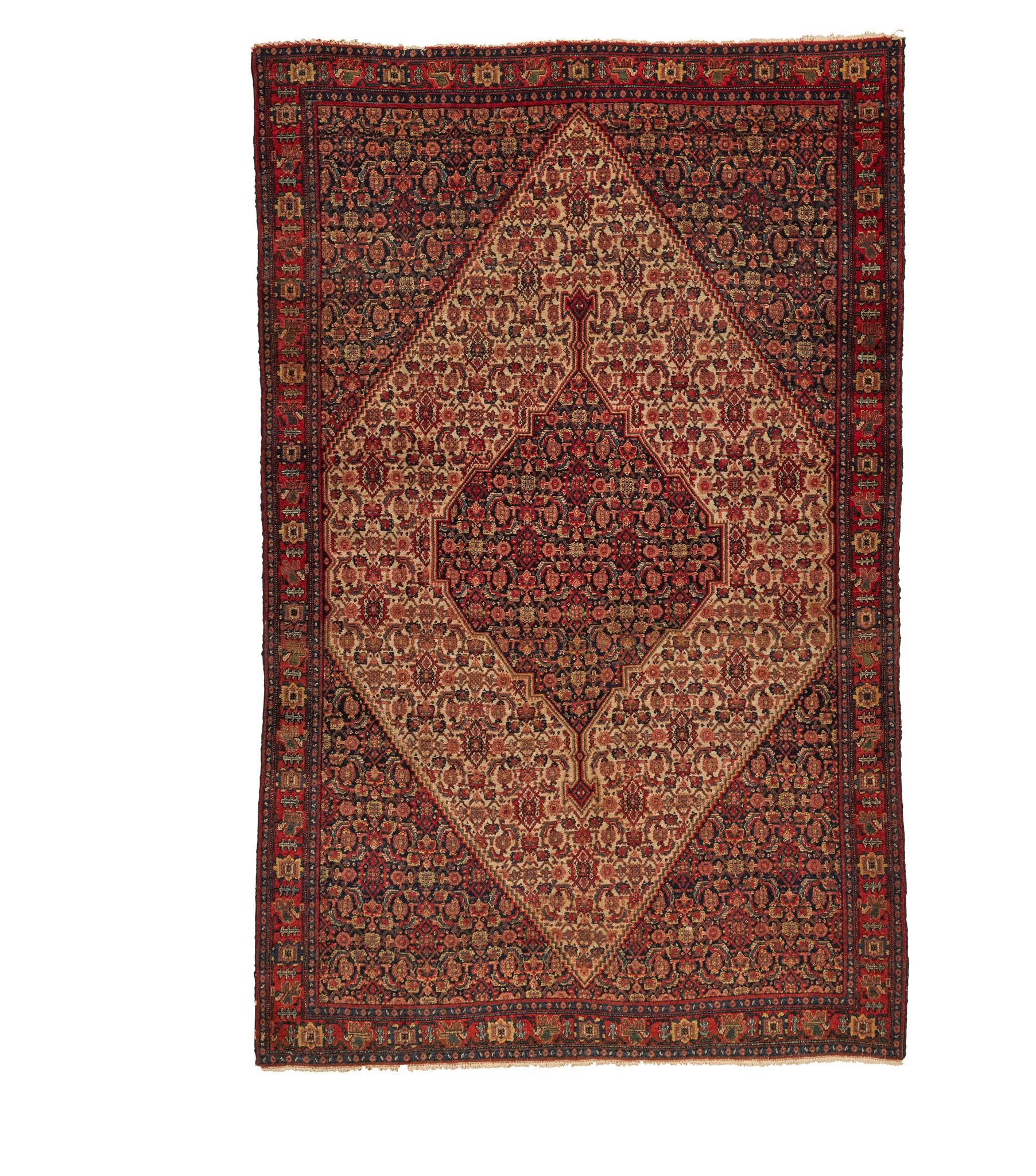
CENTRAL PERSIA, LATE
19TH/EARLY 20TH CENTURY the cream mihrab with indigo and red medallion, red spandrels, within cream border
200cm x 145cm
£700-1,000
670
ERSARI RUG
TURKMENISTAN, LATE
19TH/EARLY 20TH CENTURY the field with allover star and cross square lattice pattern, within brown border
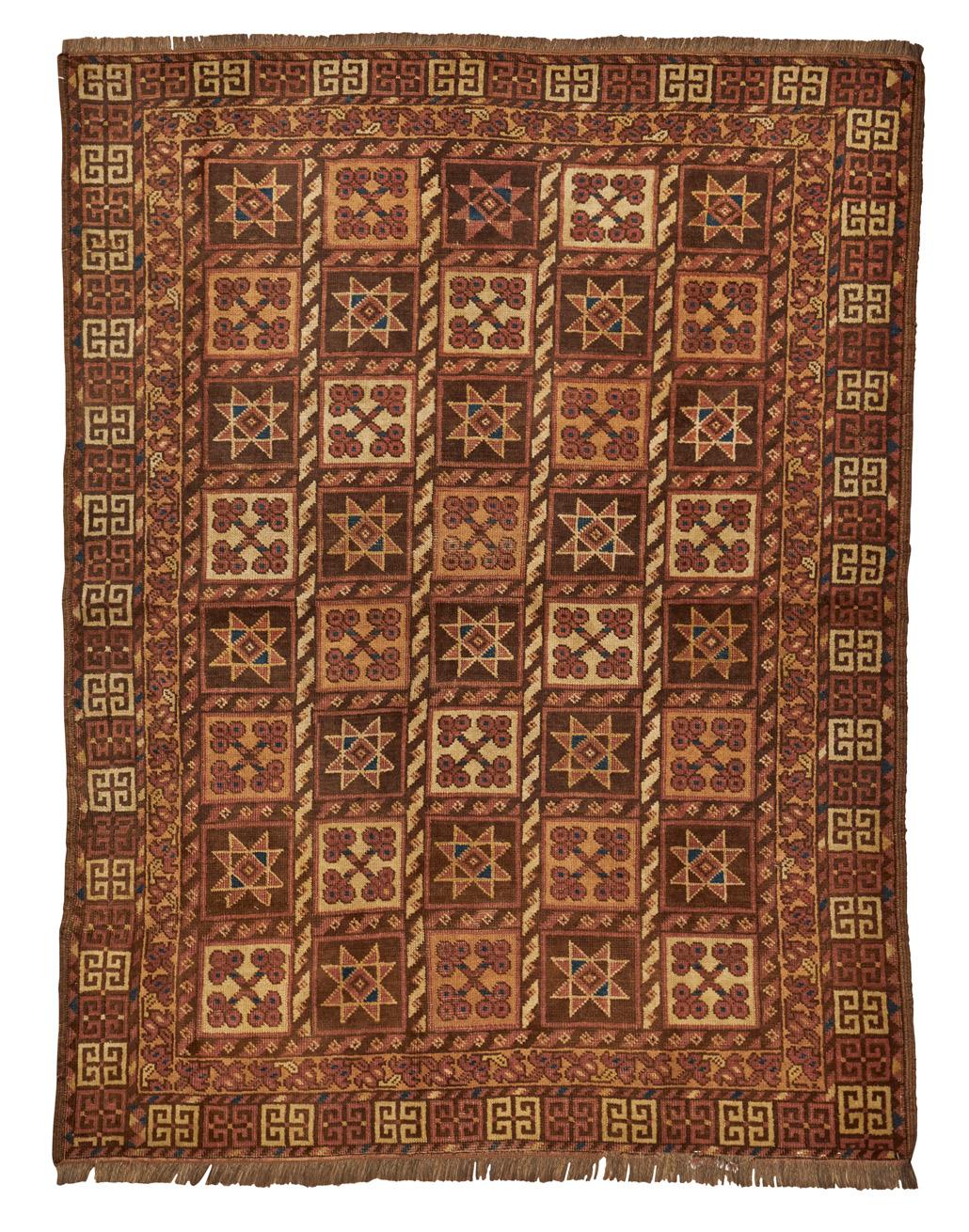
164cm x 125cm
£300-500
243 Other fees apply in addition to the hammer price: see the ‘Buyer’s Guide’ section on page 2
671
BAKHTIARI CARPET
WEST PERSIA, MODERN
the red field with cream and indigo medallion, indigo spandrels, within cream border
505cm x 379cm
£1,500-2,500
673
JOSHAGAN CARPET
CENTRAL PERSIA, MODERN
the dark red field with indigo lozenge medallion, similar spandrels, within indigo border
350cm x 245cm
£700-1,000
672
KIRMAN CARPET
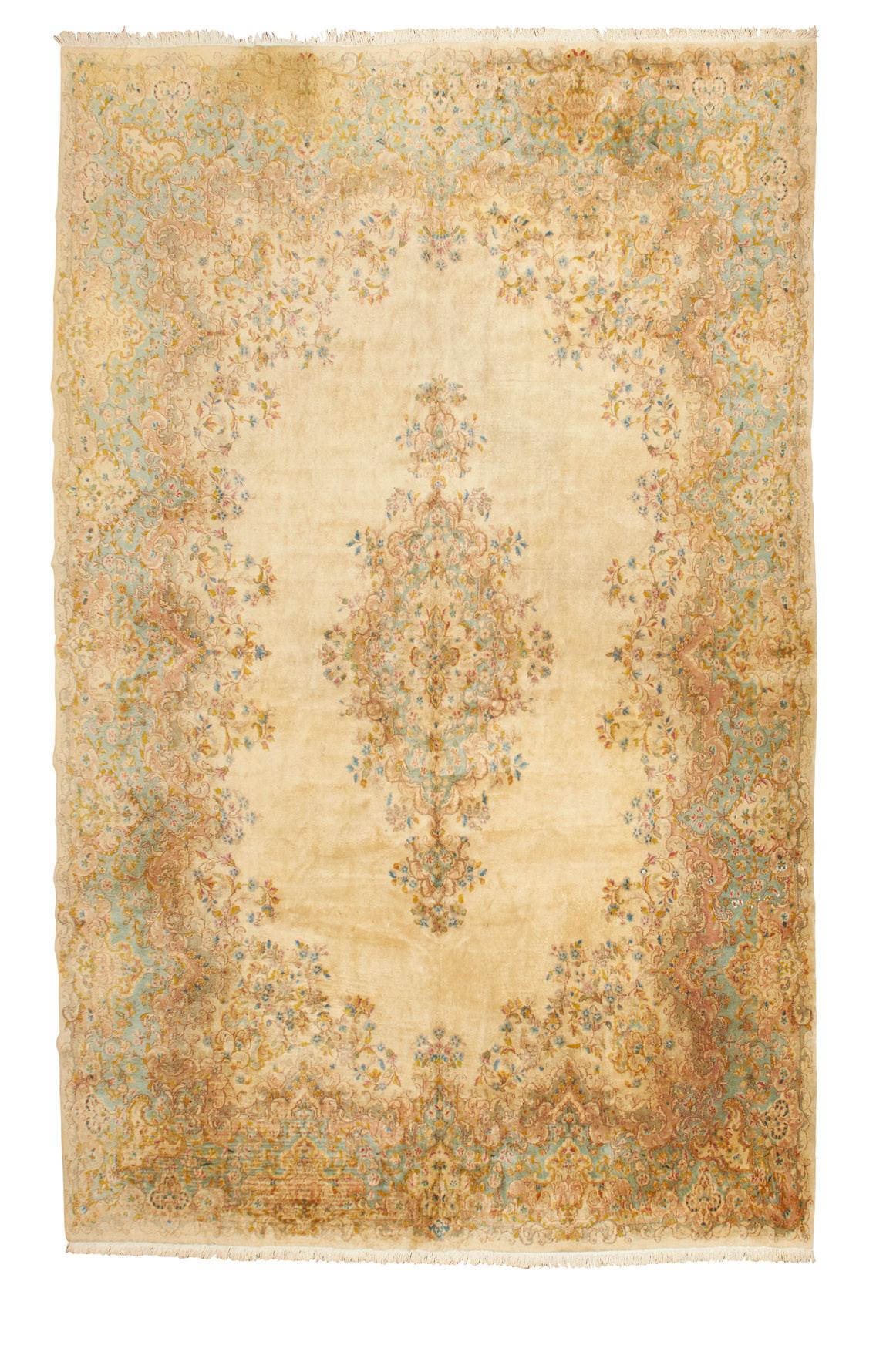
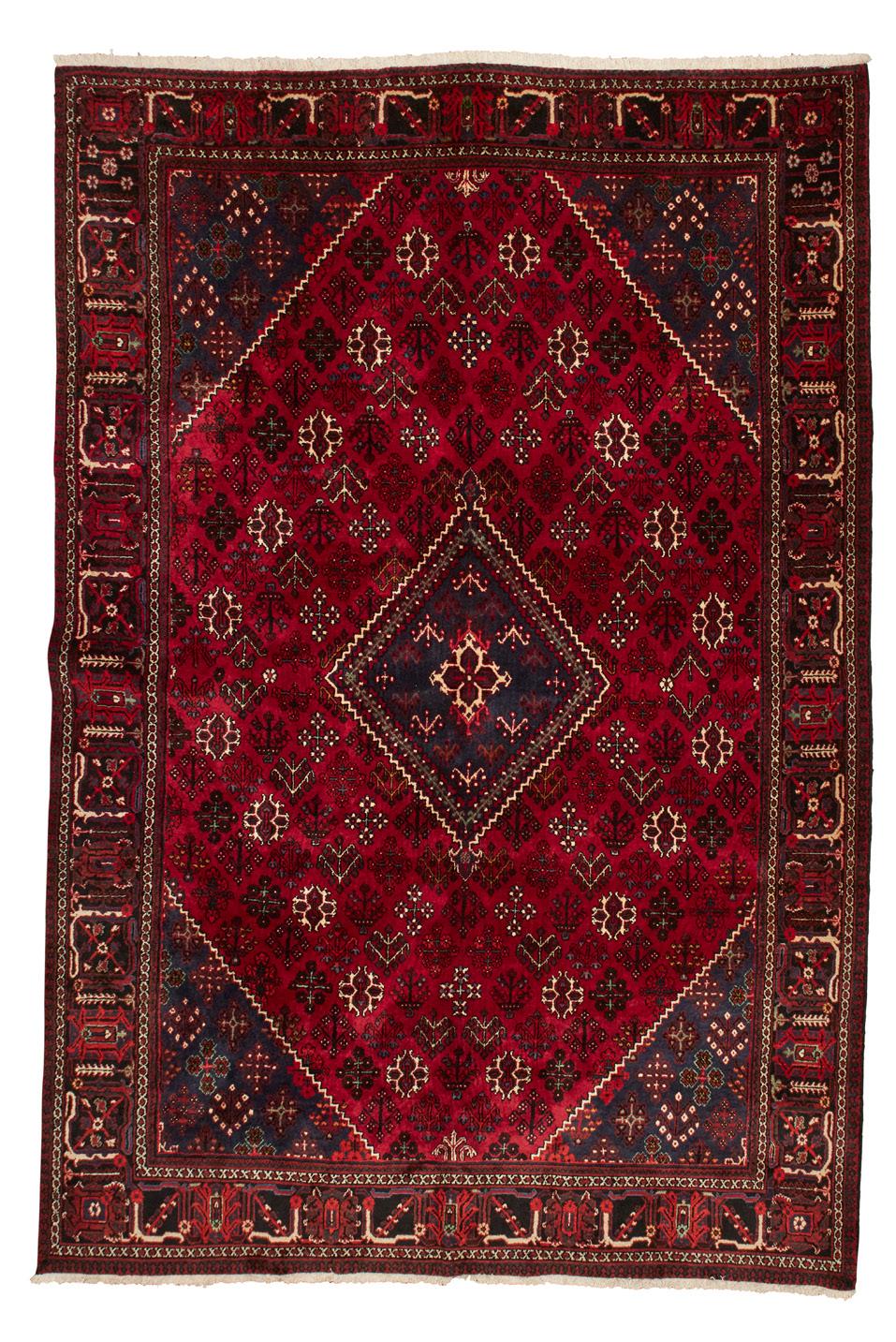
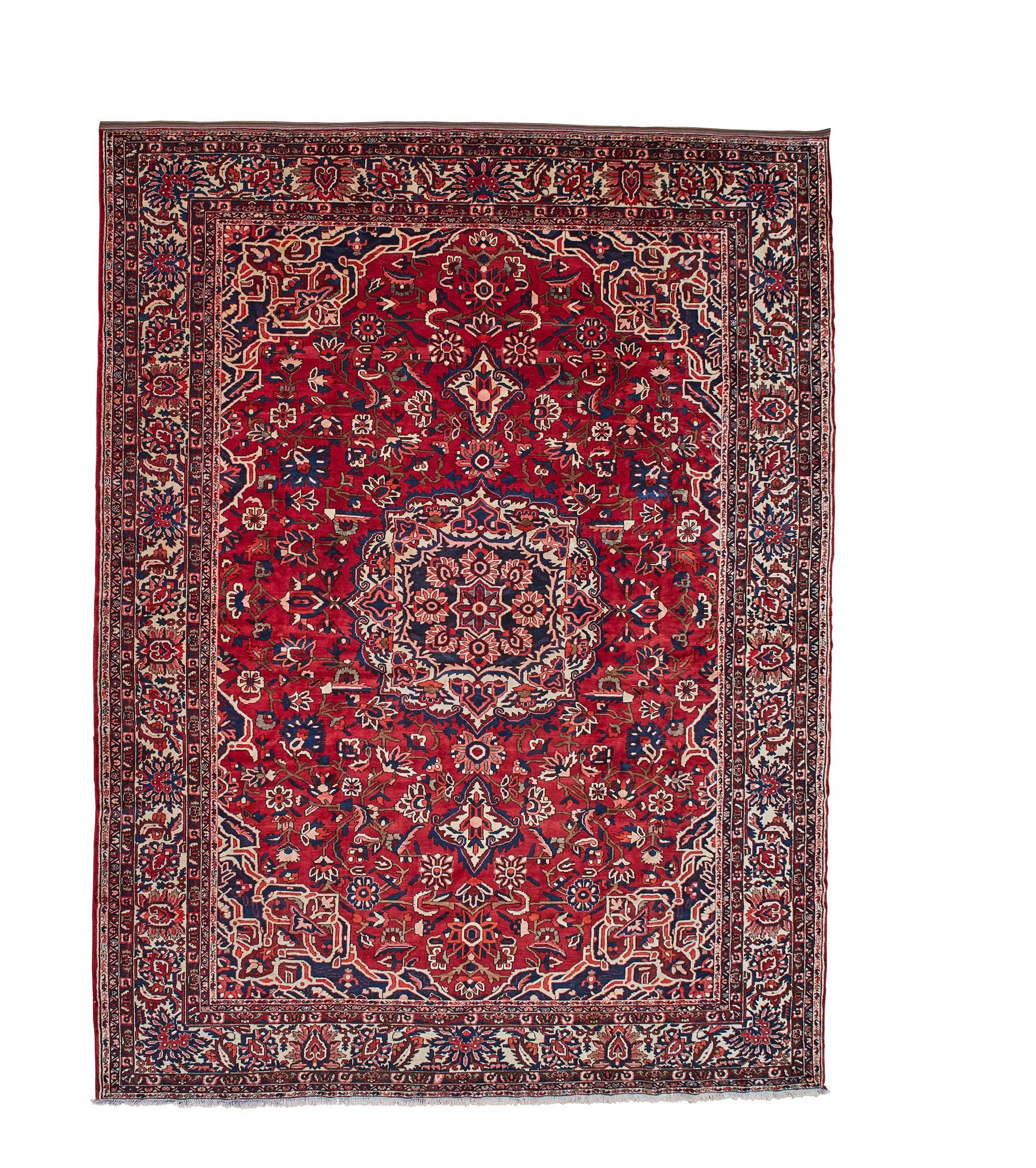
CENTRAL PERSIA, MID 20TH CENTURY
the cream field with light blue elongated medallion, within shaped blue border
435cm x 310cm
£1,000-1,500
244
674
LARGE KHORASSAN CARPET
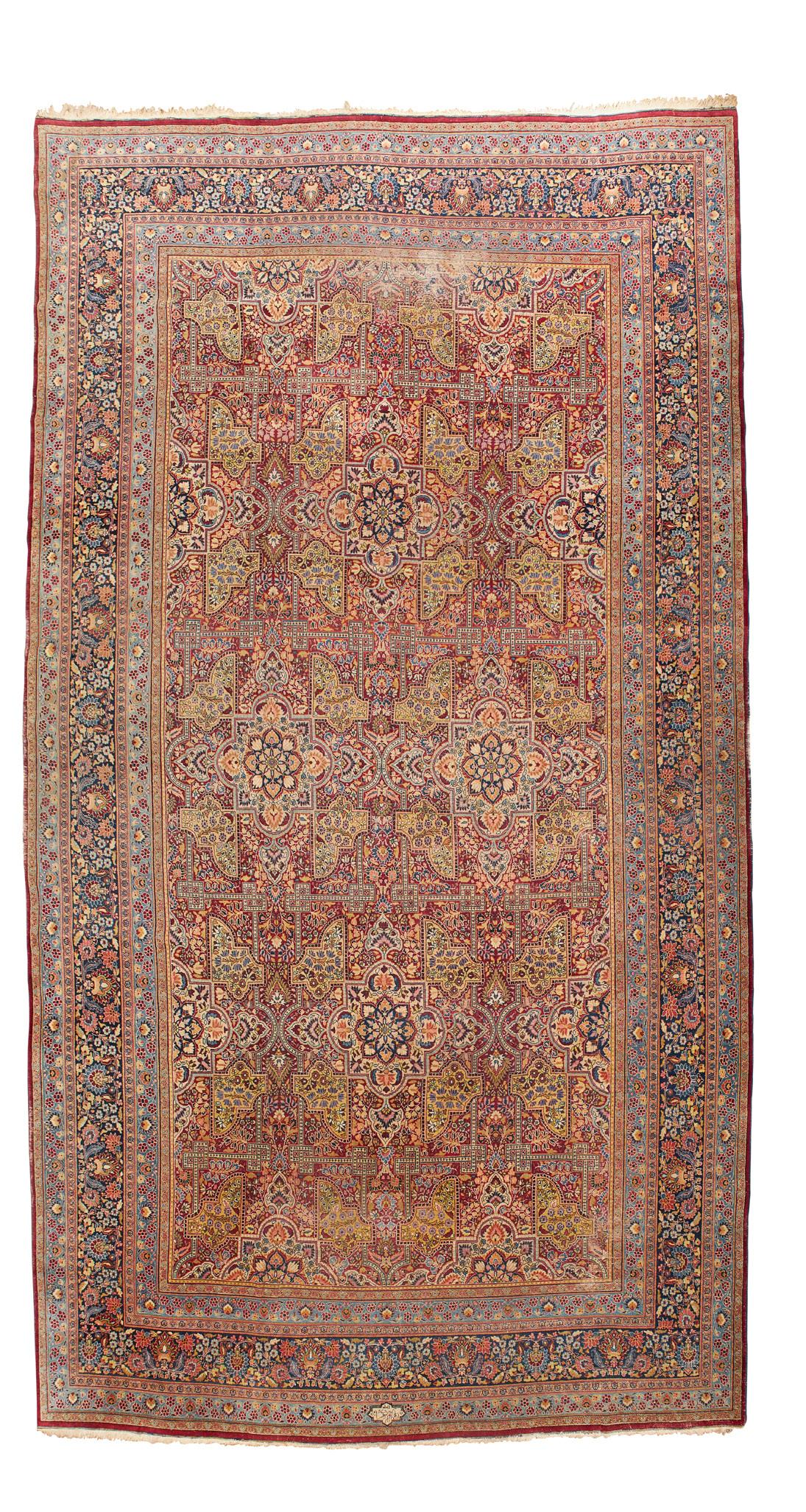
EAST PERSIA, LATE 19TH/EARLY 20TH CENTURY the red field with allover foliate lattice pattern, within indigo border, signature to one end
600cm x 358cm
£5,000-7,000
675
TABRIZ CARPET
NORTHWEST PERSIA, MID/LATE 20TH CENTURY the red field with allover palmette pattern, within cream border, signature to one end

420cm x 317cm
£1,500-2,500
245 Other fees apply in addition to the hammer price: see the ‘Buyer’s Guide’ section on page 2
676
KARAKALPAK RUG
UZBEKISTAN, EARLY 20TH CENTURY
the red field with allover lozenge lattice pattern, within cream border
218cm x 140cm
£300-500
678
QASHQAI RUG
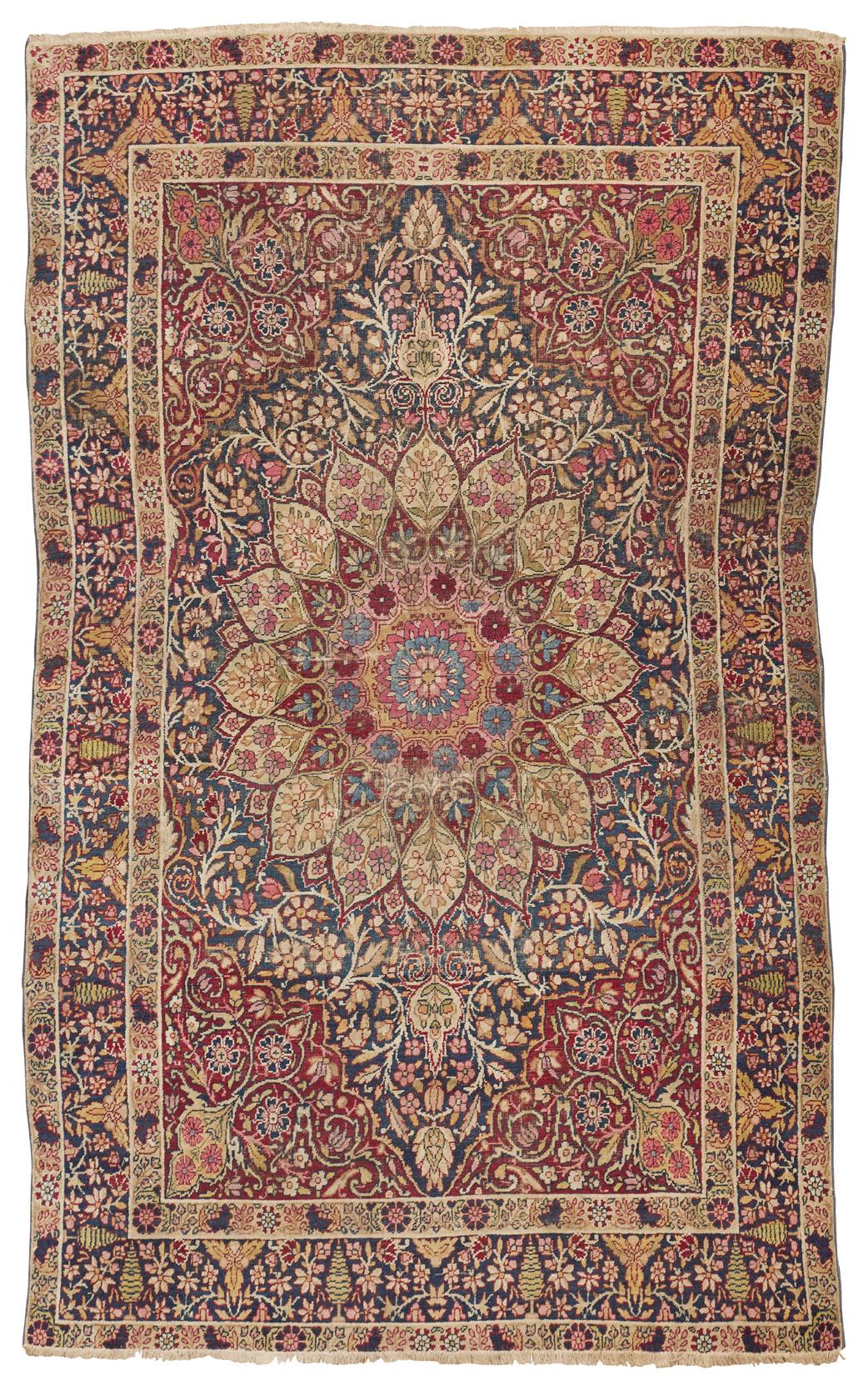
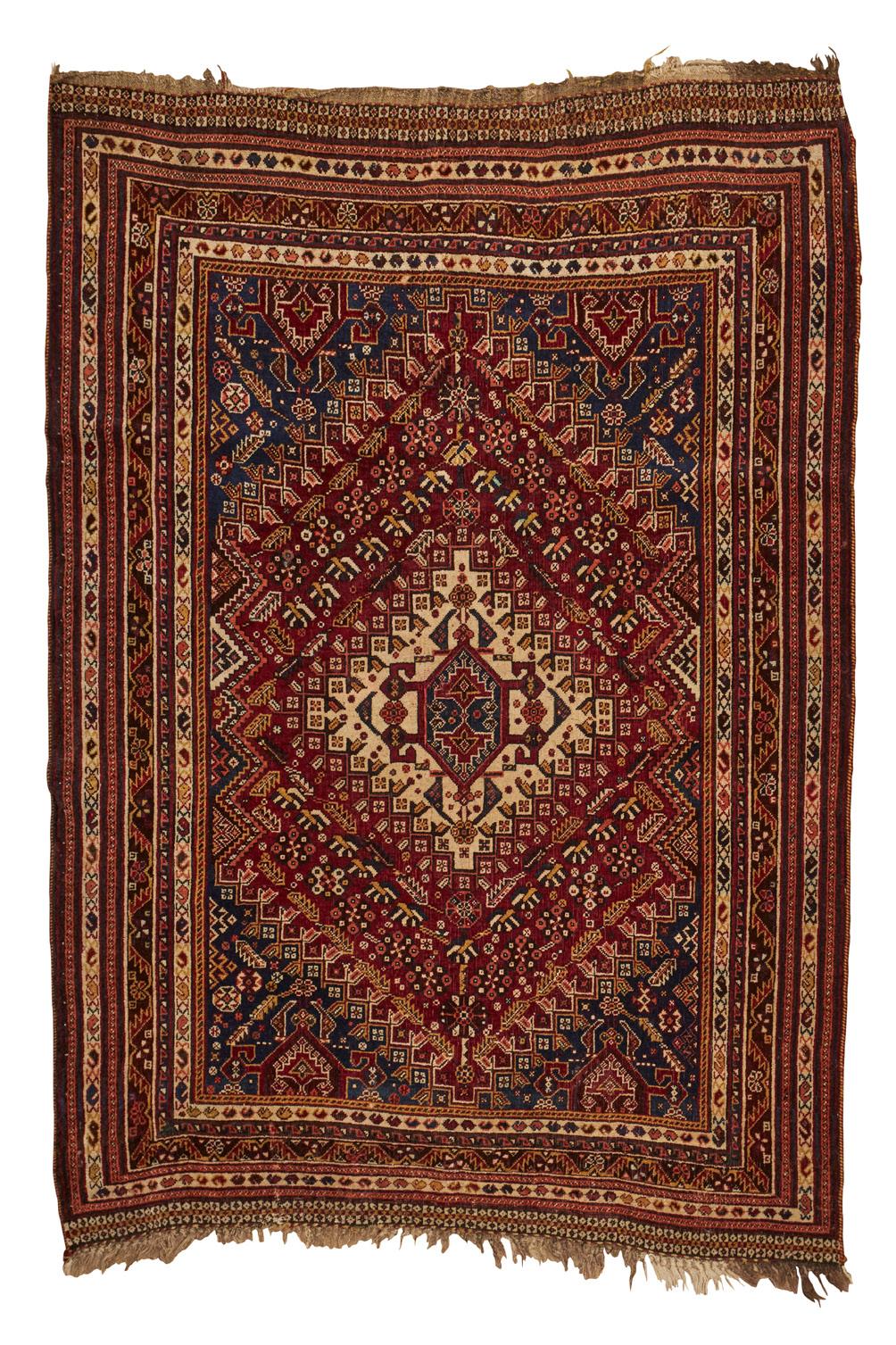
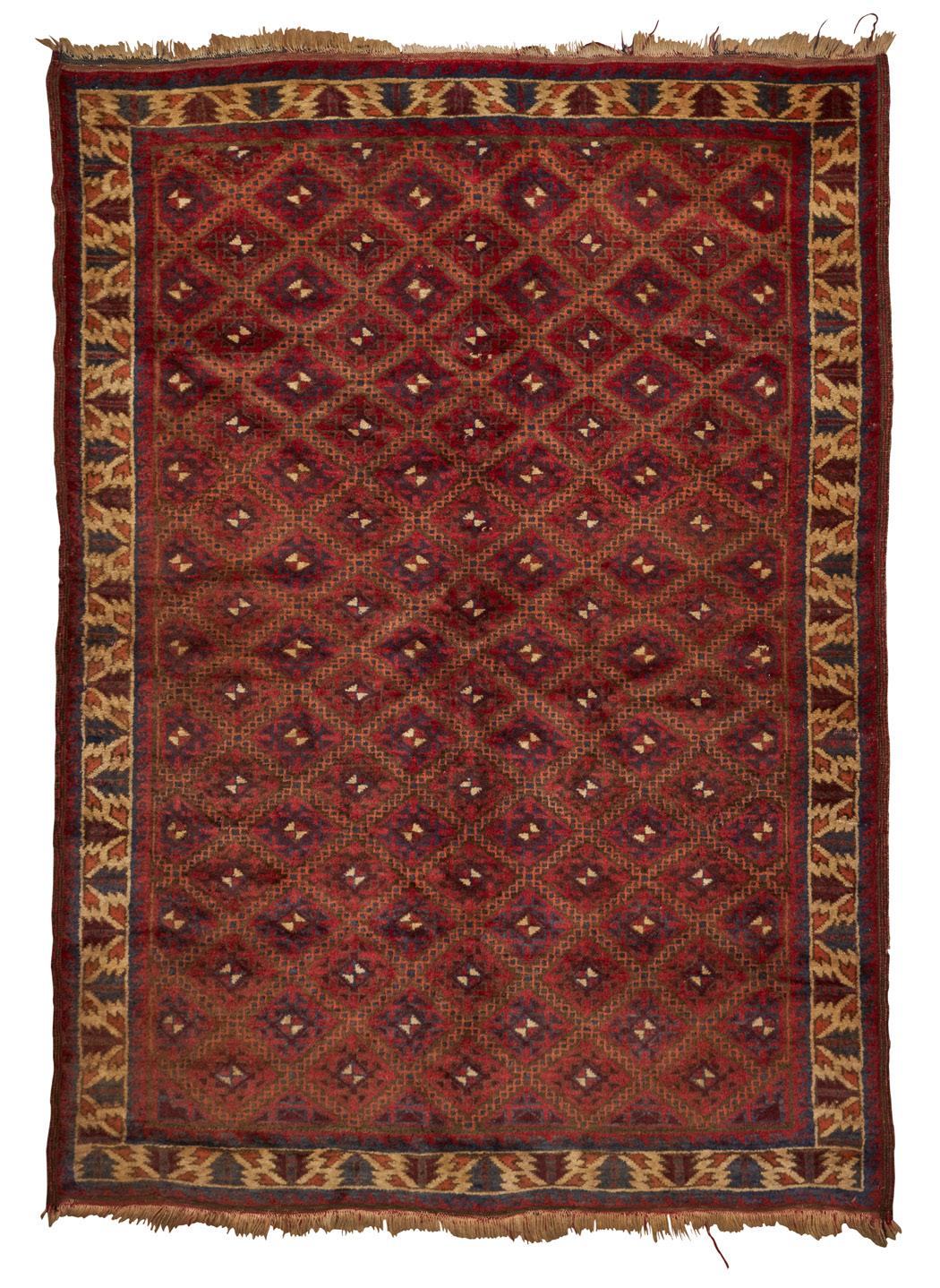
SOUTH PERSIA, LATE 19TH/ EARLY 20TH CENTURY
the rust brown field with ivory lozenge medallion, indigo spandrels, within multiple borders
203cm x 140cm
£500-700
677
LAVAR KIRMAN RUG
CENTRAL PERSIA, LATE
19TH/EARLY 20TH CENTURY
the indigo field with cream, red and pink medallion, red spandrels, within indigo border
186cm x 120cm
£300-500
246 Other fees apply in addition to the hammer price: see the ‘Buyer’s Guide’ section on page 2
679
PAIR OF KASHAN RUGS
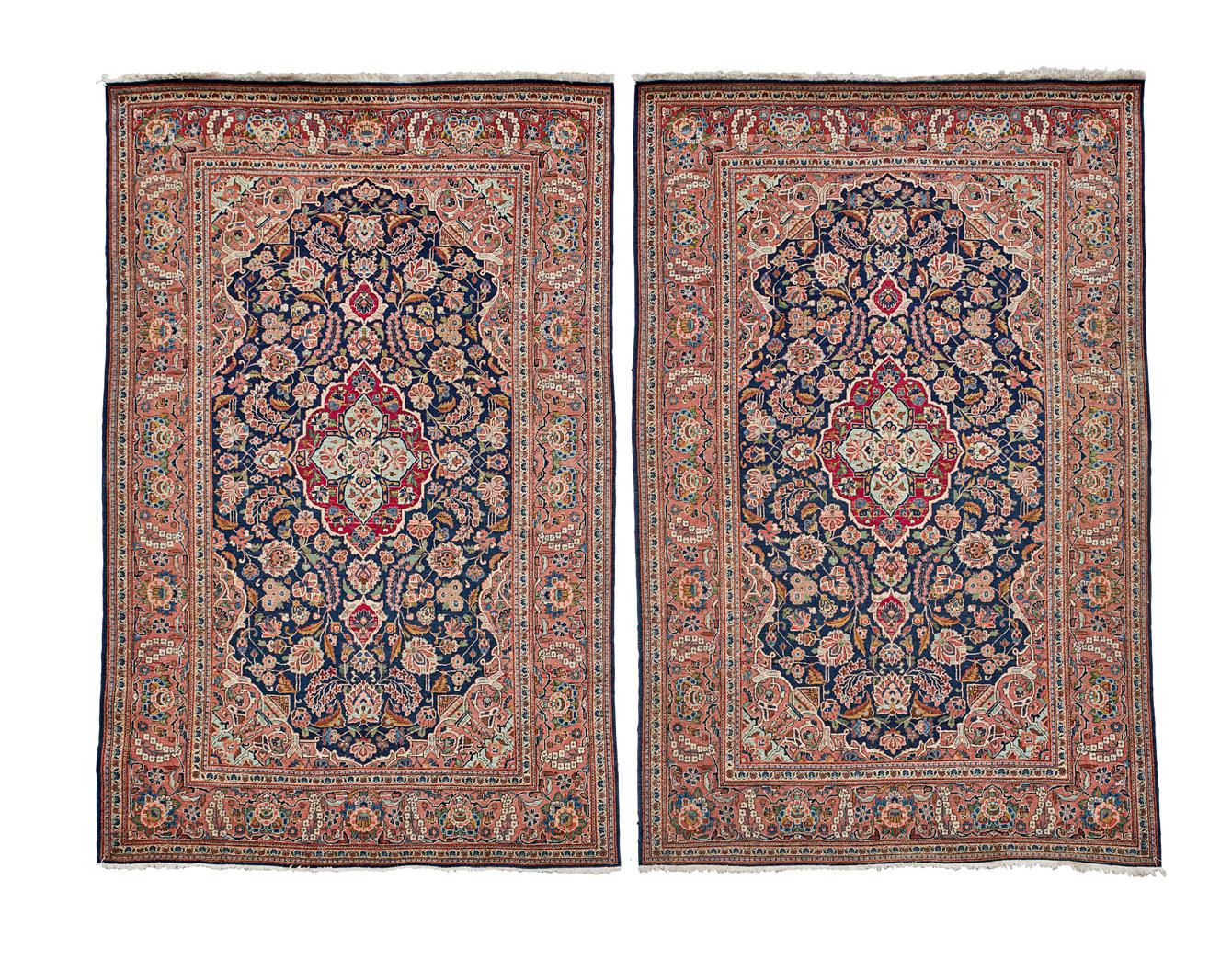
CENTRAL PERSIA, LATE 19TH/EARLY 20TH CENTURY each with indigo field with red and light blue medallion, light red spandrels, within light red border (2)

larger 210cm x 130cm
£400-600
681
TWO BELOUCH RUGS
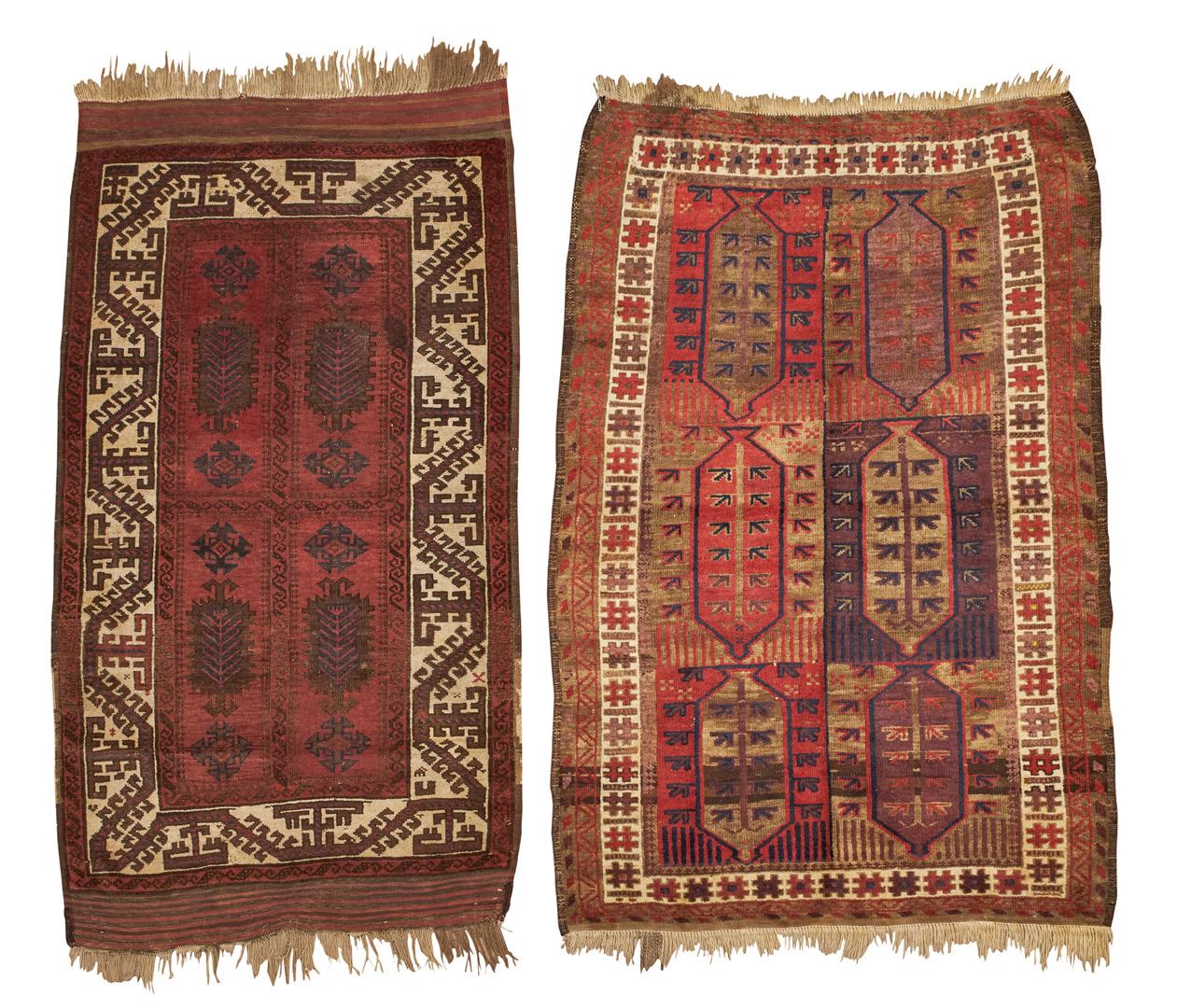
NORTHEAST PERSIA, EARLY 20TH CENTURY
one with reddish brown field with four brown foliate motifs, within ivory border; the other with lattice field with six elongated shapes, within ivory border (2)
200cm x 105cm; 188cm x 117cm
£300-500
680
KASHAN STYLE SILK RUG
LATE 20TH CENTURY
the red field with cream and light blue medallion, within cream border
152cm x 95cm
£500-700
247

TAXIDERMY
682
TAXIDERMY INDIAN ELEPHANT SKULL
EARLY 20TH CENTURY
a female specimen, mounted on a square wood plinth with a backboard support 103cm high, 75cm wide, 74cm deep
Provenance: Formerly of Beal House, Thornton-le-Street, North Yorkshire. The Contents of Beal House sold in these rooms 14th & 15th October 2020. By repute purchased by the owner Ian Colin Stewart in the 1970s from the Newark Antiques Fair. Thence gifted to the current vendor.
CITES STATUS: Indian Elephant Elephas maximus indicus CITES Appendix I - Annex A - Sold in compliance with UK Government and APHA regulations, with (non-transferable) exemption registration reference MJVWT5MB. Also sold with non-transferable transaction specific Article
10 Certificate Reference Number 628860/01
£2,000-3,000
684
TAXIDERMY ‘MONARCH’ RED DEER STAG’S HEAD TROPHY MOUNT
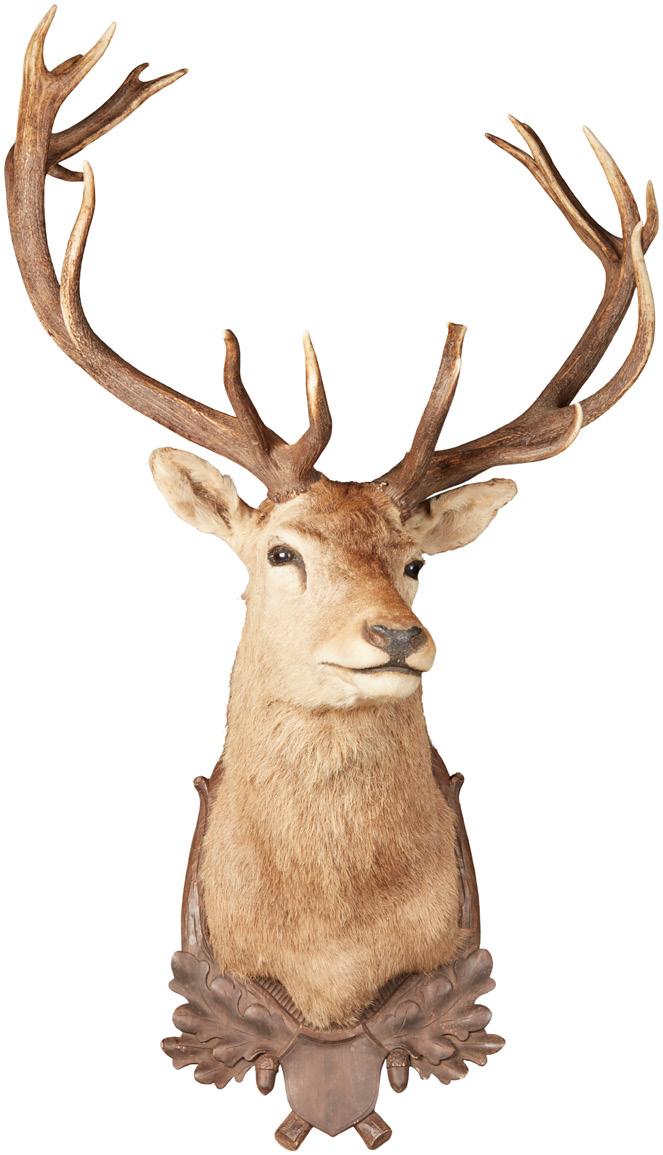
20TH CENTURY
shoulder mount with eighteen points, mounted on a carved Black Forest style shield 94cm wide, 150cm high, 80cm out from the wall
£600-800
685
TAXIDERMY BENGAL TIGER SKIN, BY VAN INGEN & VAN INGEN OF MYSORE

EARLY 20TH CENTURY
circa 1920-40, with full head mount, glass eyes and open mouth in snarling pose, with typical canvas backing, stencilled number ‘ZS243’ and ‘Van Ingen & Van Ingen, Mysore’ verso 212cm wide, 298cm long
CITES STATUS: Bengal Tiger Panthera tigris - CITES Appendix I - Annex A - Article 10 Exempt as a worked specimen in a finished state before 3 March 1947

£600-800
683
TAXIDERMY PART SKULL CAPE BUFFALO HORN MOUNT
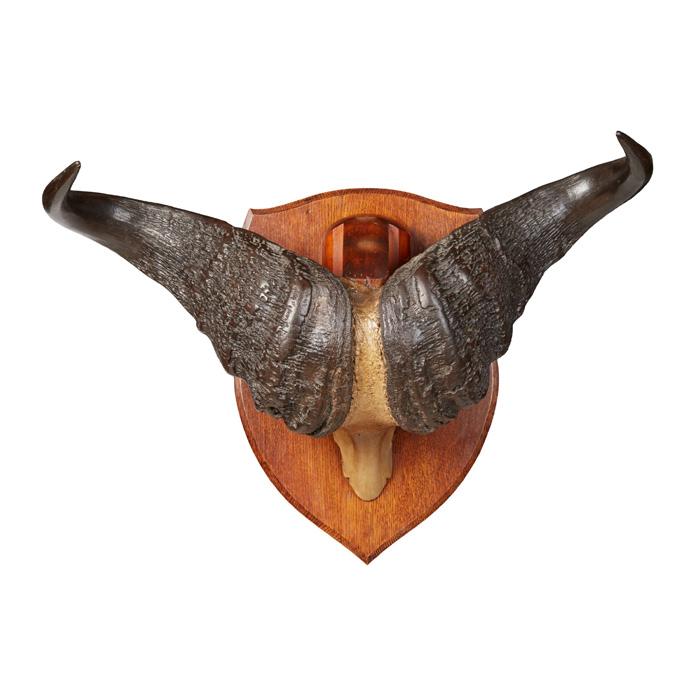
EARLY 20TH CENTURY mounted on an oak shield
66cm wide
£400-600
249 Other fees apply in addition to the hammer price: see the ‘Buyer’s Guide’ section on page 2
GARDEN

686
TWO CAST IRON STICK STANDS
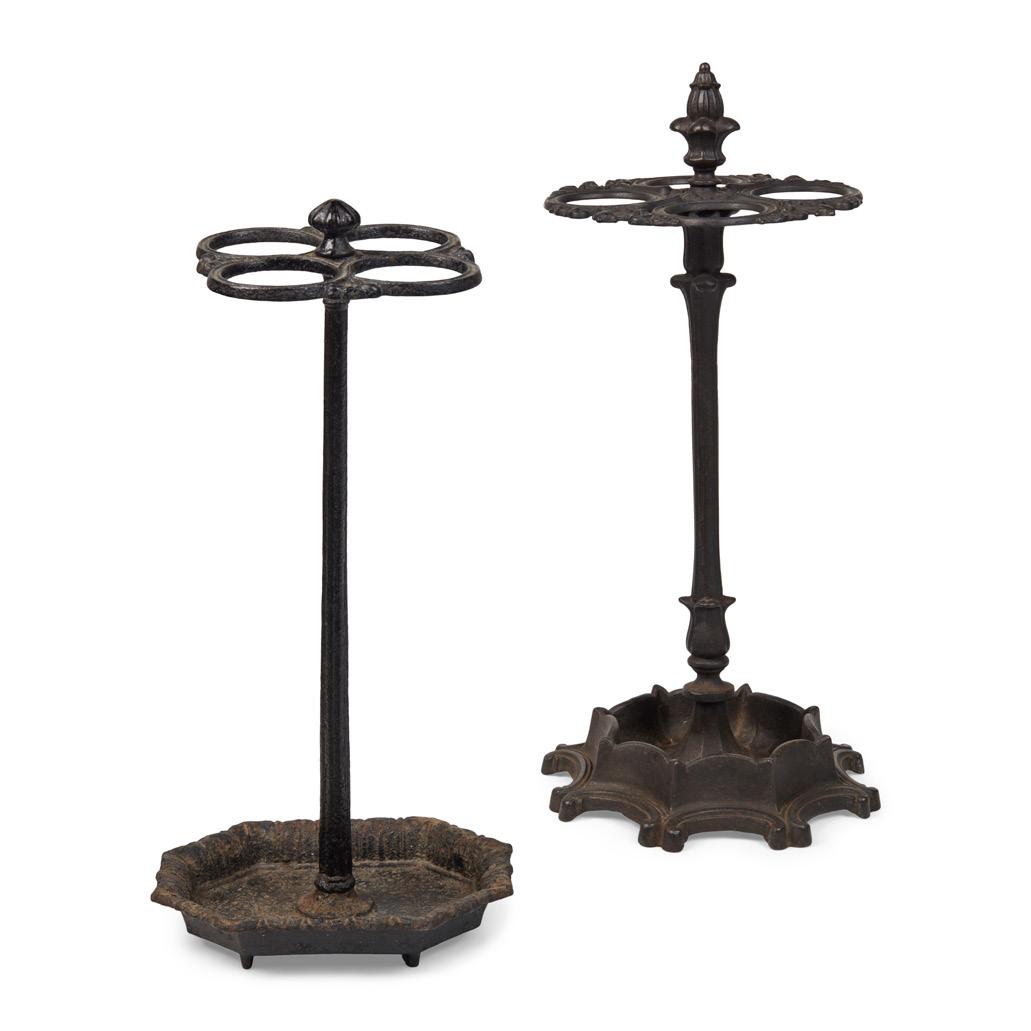
19TH CENTURY
each with four circular stick holders, one with an octagonal C scroll cast tray base, the other with an octagonal foliate cast tray base (2)
63cm and 69cm high
£300-500
687
PAIR OF SMALL COMPOSITION STONE RECUMBENT LIONS MODERN
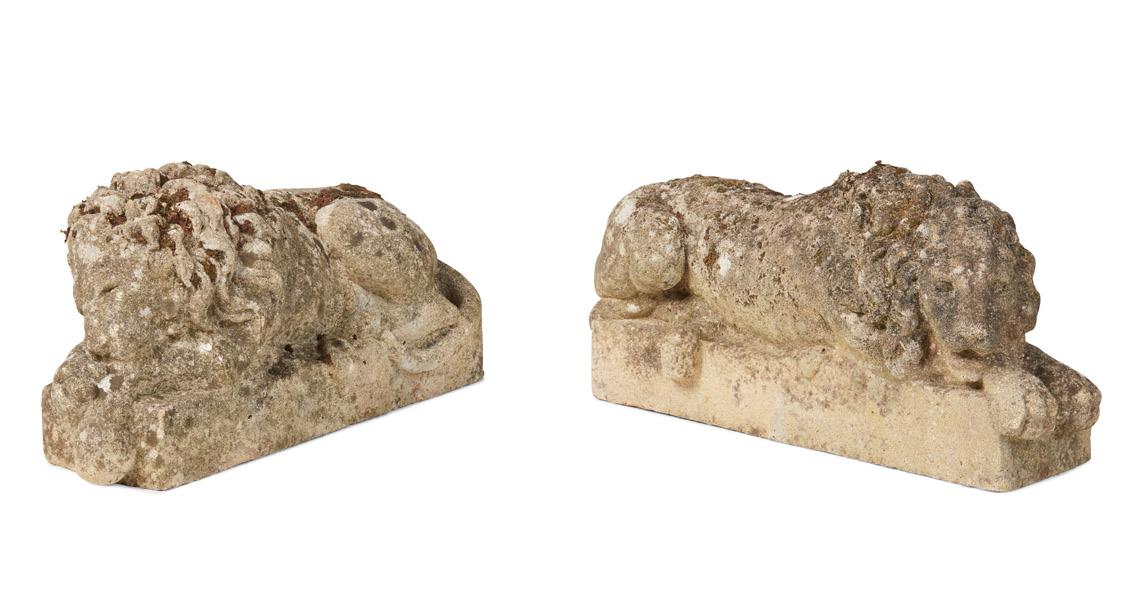
after the model by Canova, on rectangular plinth bases (2)
46cm wide, 21cm high, 16cm deep
£600-800
688
SET OF THREE COMPOSITION STONE GARDEN URNS
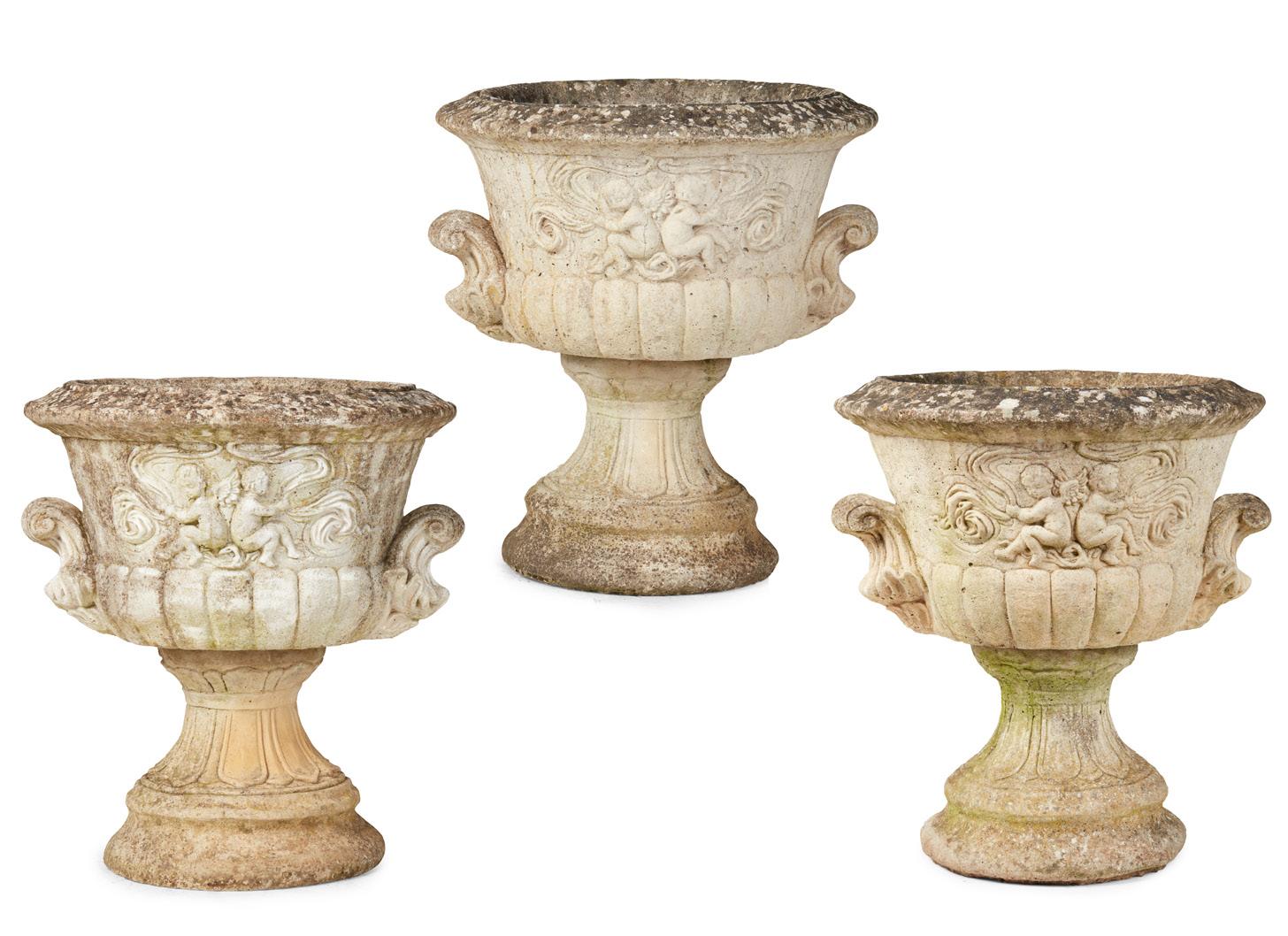
MODERN
of campana form, the friezes moulded in relief with putti flanked by scroll handles, on socle bases (3)
57cm diameter, 63cm high
£600-800
689
OVERSIZED CAST IRON BOOT SCRAPER
MID 19TH CENTURY
with a pair of rectangular posts surmounted by ball finials joined by a shaped scraper bar, mounted on a rectangular base with canted corners and a deep moulded edge and drainage holes

65cm wide, 51cm deep
£500-800
251 Other fees apply in addition to the hammer price: see the ‘Buyer’s Guide’ section on page 2
690 COMPOSITION STONE FIGURE
LATE 20TH CENTURY modelled as a woman in classical dress, on a separate square plinth figure 133cm high, 192cm overall, 38cm wide £400-600

692
691
PAIR OF SMALL COMPOSITION STONE GARDEN URNS

MODERN
of plain campana form, on socles and square plinth bases (2) 40cm diameter, 41cm high £250-350
LARGE COMPOSITION STONE GARDEN URN MODERN
with moulded rope lattice design, mounted on four paw feet on a stepped plinth base 80cm diameter, 63cm high £300-500

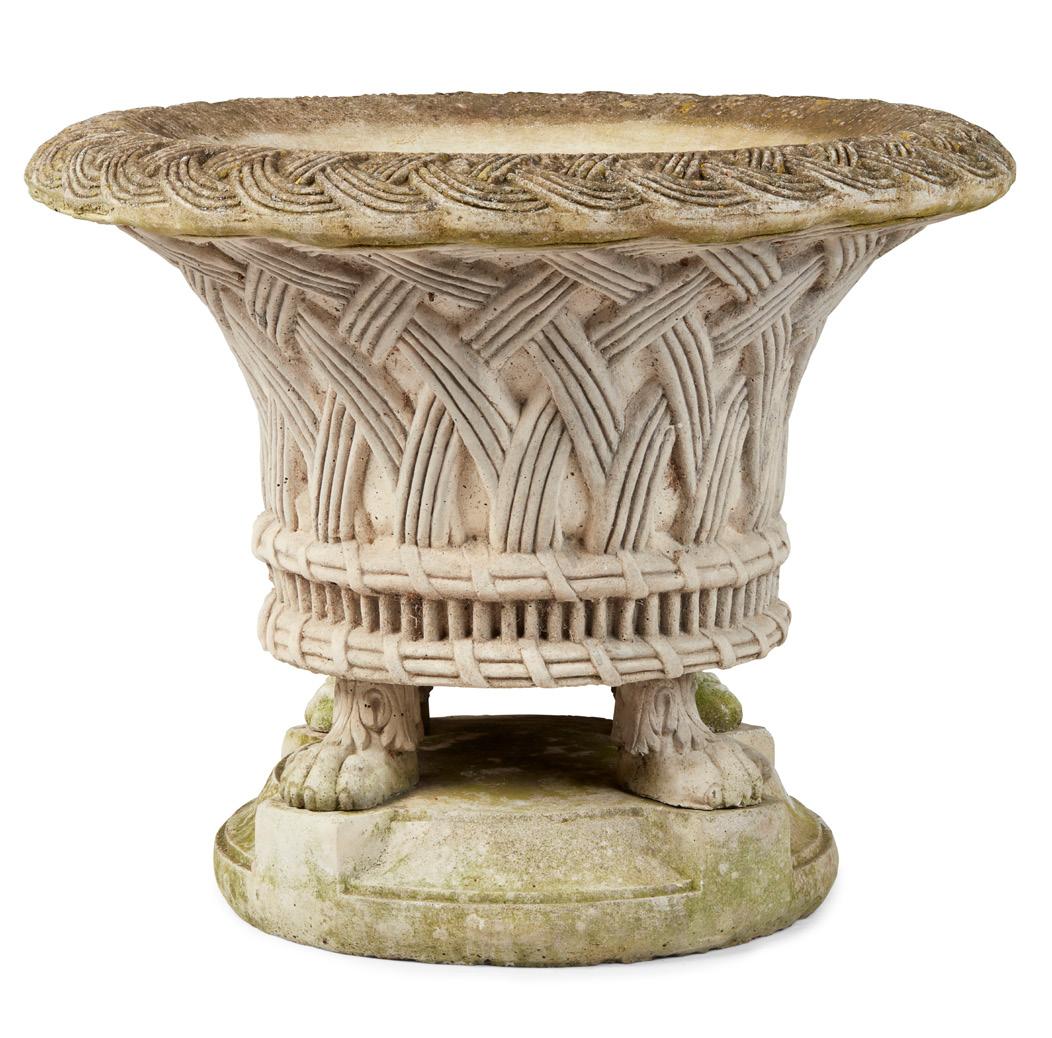
252 Other fees apply in addition to the hammer price: see the ‘Buyer’s Guide’ section on page 2
693
VICTORIAN PAINTED CAST IRON WEATHER VANE
LATE 19TH CENTURY
in the form of a horse with date panel 1896, hinged on the original support with basket finial 97cm high

£400-600
694
FRENCH CAST-IRON GOTHIC GARDEN BENCH AND ARMCHAIR, AFTER THE MODEL BY THE VAL D’OSNE FOUNDRY
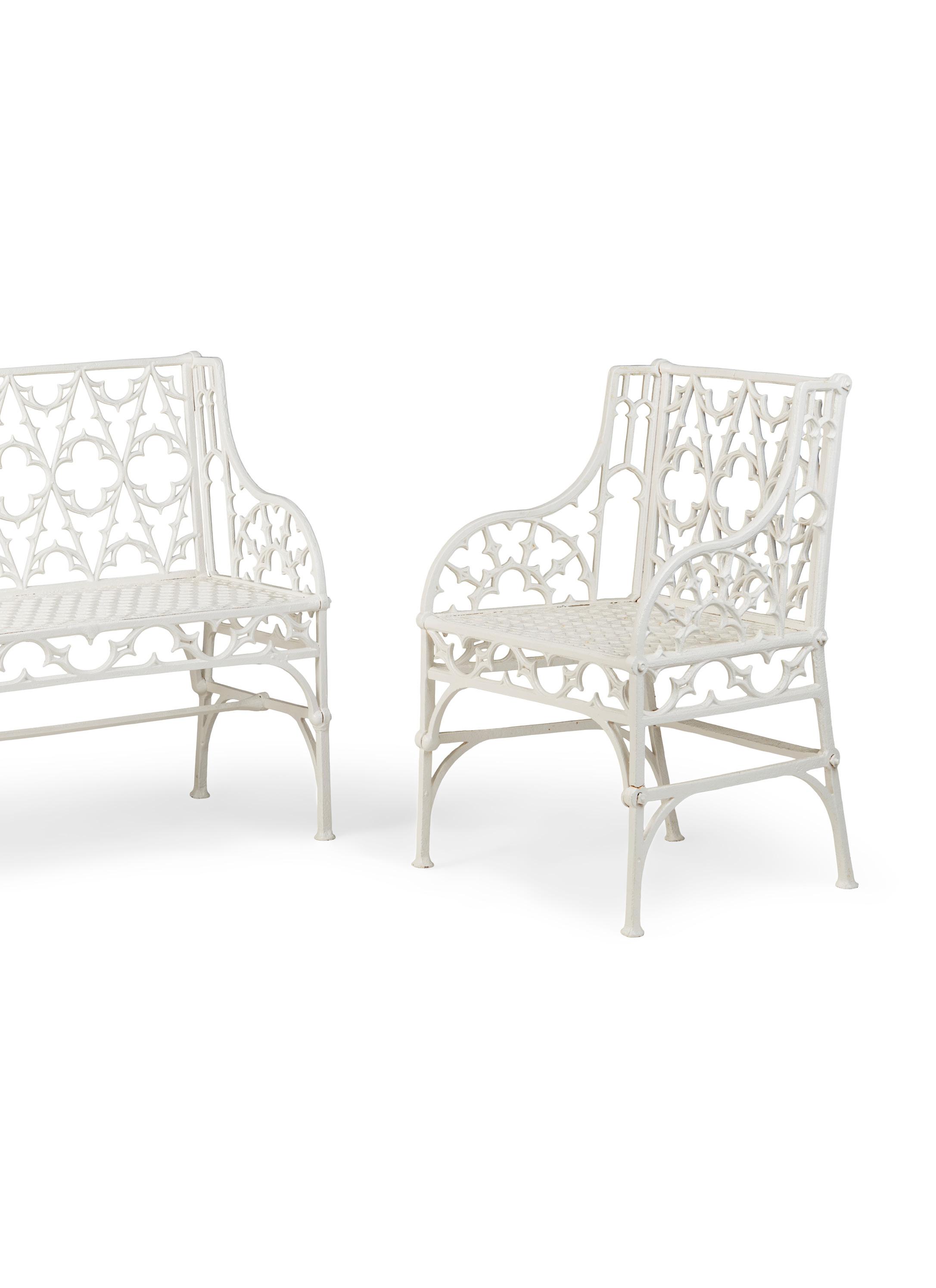
MID 19TH CENTURY
the back and arm panels with tracery arches and quatrefoils (2)
bench 99cm wide, 90cm high, 44cm deep; chair 62cm wide, 90cm high, 44cm deep £600-800
PAIR OF PAINTED COMPOSITION STONE RECUMBENT LIONS
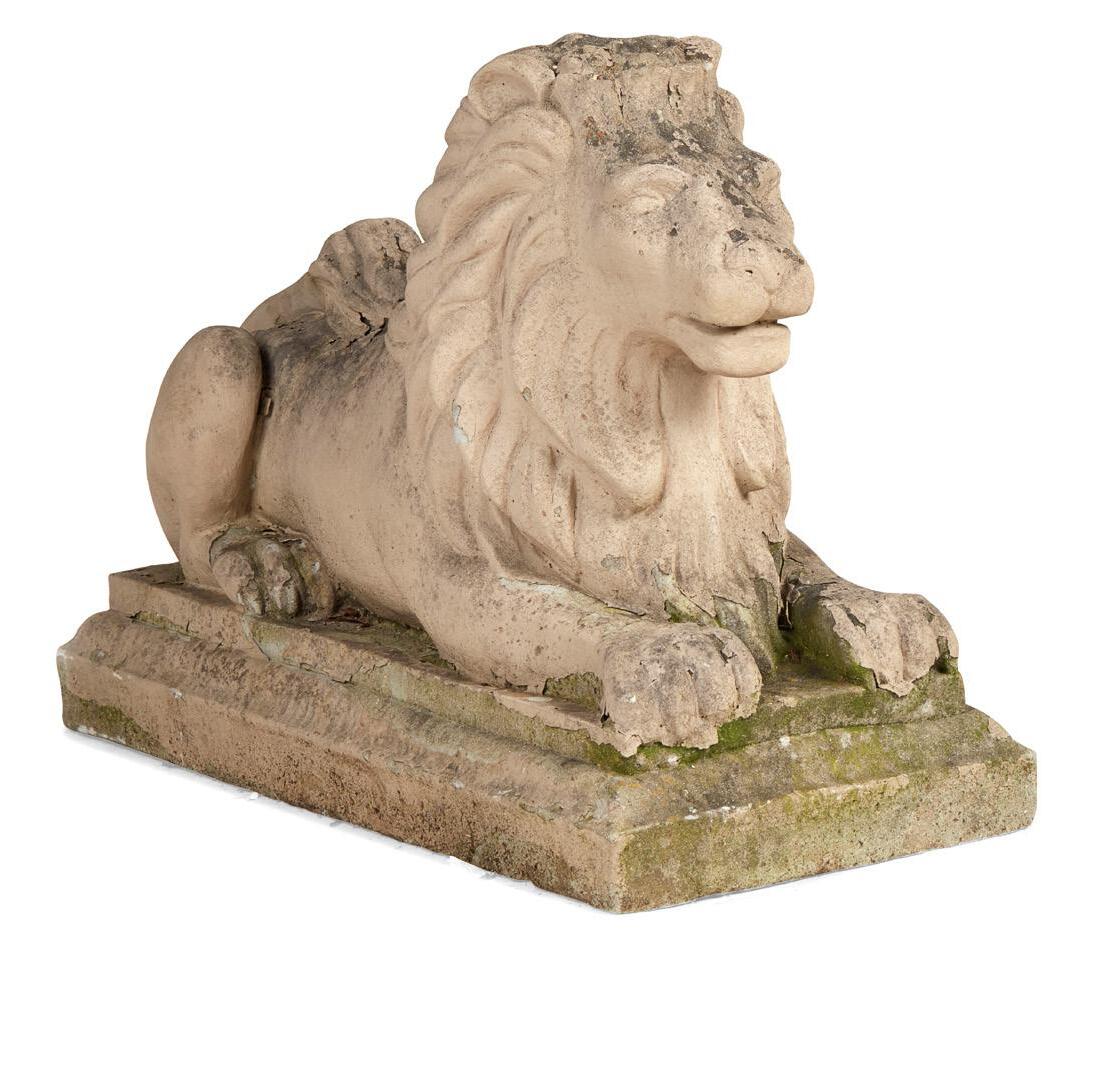
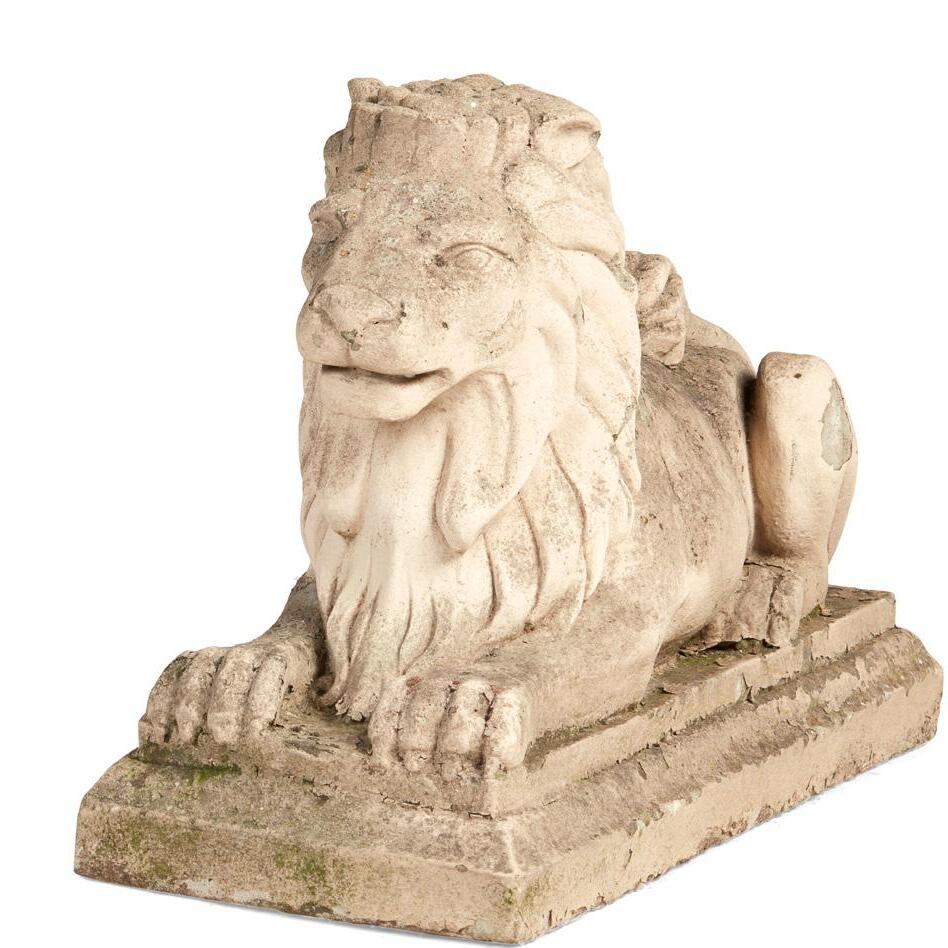
on rectangular stepped bases (2) 75cm wide, 50cm high, 30cm wide £800-1,200

696
IRISH CARVED SLATE AND BRONZE SUNDIAL

19TH CENTURY
the octagonal slate carved with calendar, scales and compass, the centre with weathered verdigris bronze gnomon and inscription ‘A horizonal dial, Constructed for The Rev. Henry Moore, Julianstown Vicarage, By D. O Connell, A.D. 1848’

34cm in diameter, 17cm high
£400-600
697
PAIR OF LARGE BRONZE RECUMBENT LIONS
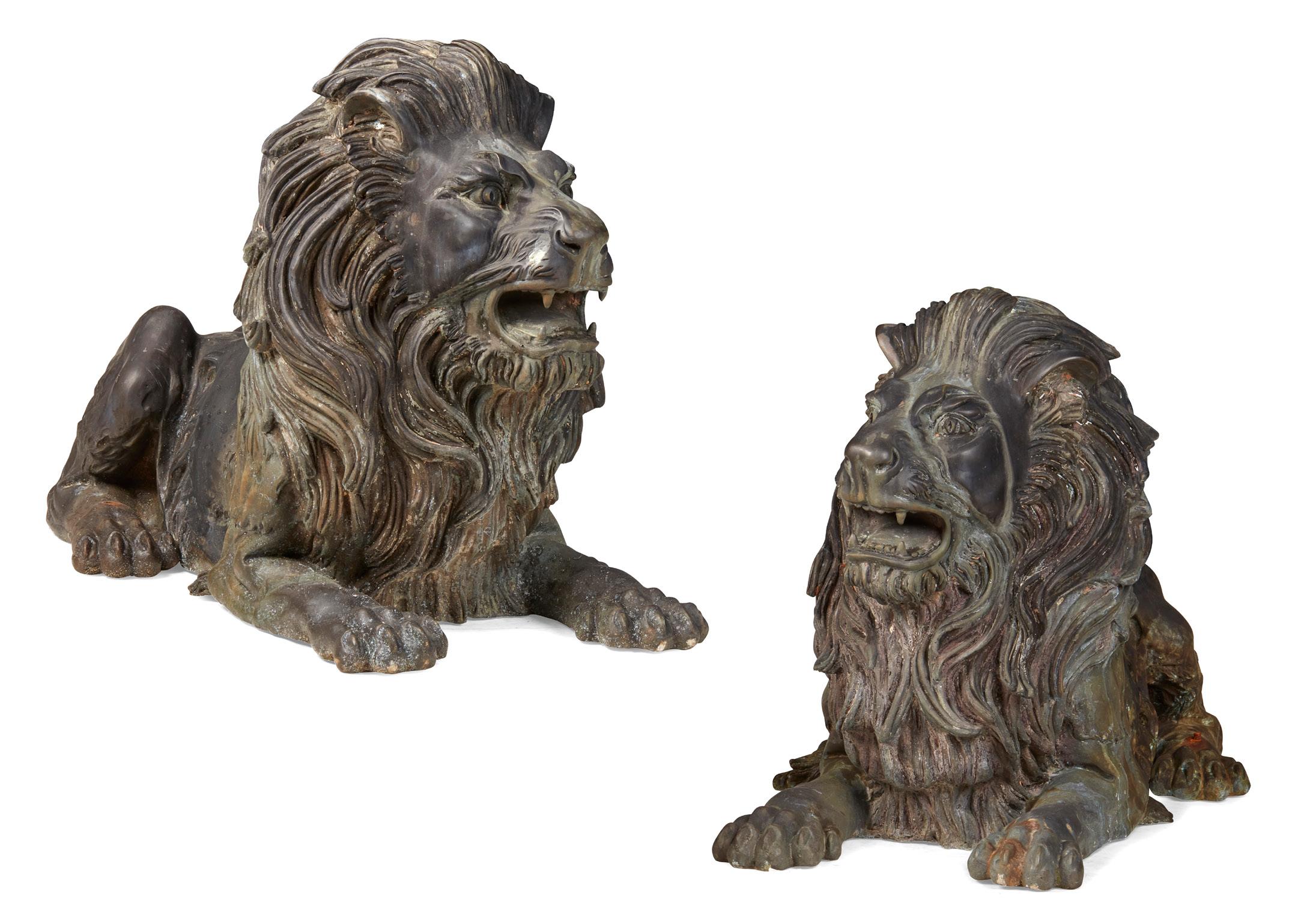
EARLY 20TH CENTURY
black patina and verdigris, modelled in mirrored snarling poses (2) 116cm wide, 70cm high, 50cm deep £3,000-4,000
698
PAIR OF PATINATED BRONZE GEESE

20TH CENTURY
realistically modelled with blue/green verdigris patination (2)
70cm and 60cm high
£500-700
END OF SALE
254 Other fees apply in addition to the hammer price: see the ‘Buyer’s Guide’ section on page 2
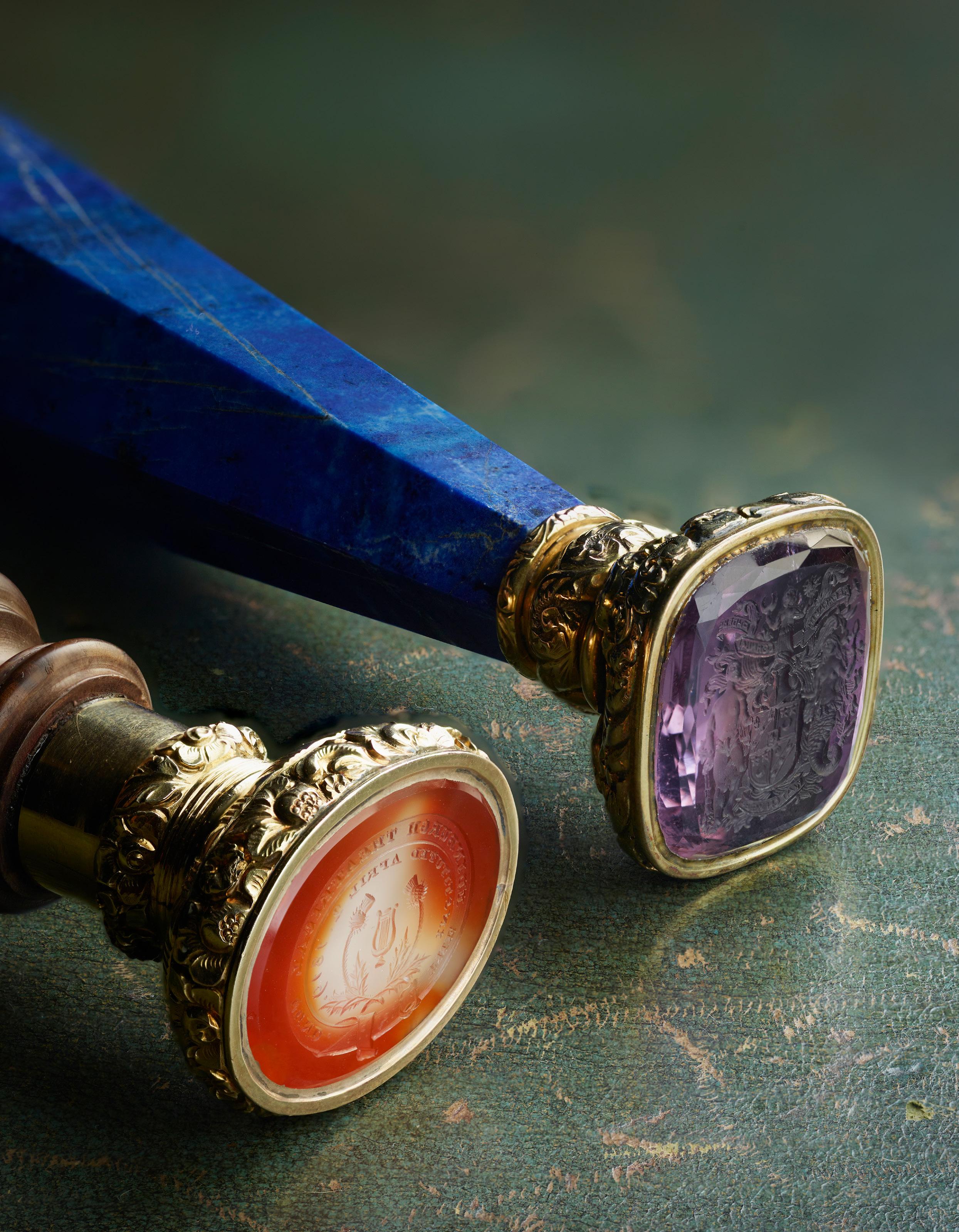
A PRIVATE COLLECTION OF SEALS: HIGHLIGHTS FROM THE MATRIX COLLECTION 19TH MAY 2023 EDINBURGH LIVE ONLINE
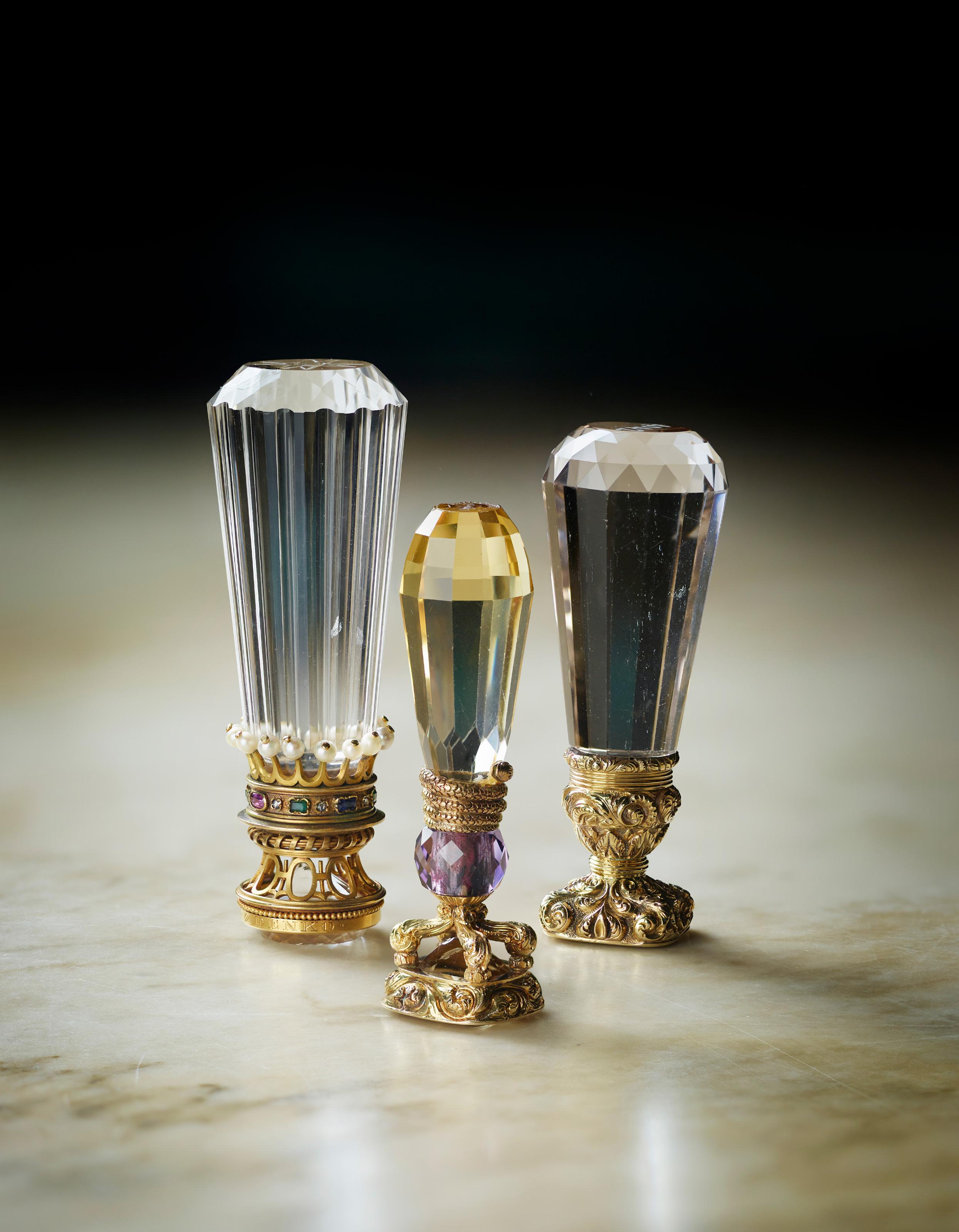
Preceding page Lots 20 & 21 [detail] Left Lots 55, 53 & 52 [detail]
A PRIVATE COLLECTION OF SEALS: HIGHLIGHTS FROM THE MATRIX COLLECTION
Sale Number LT749
info@lyonandturnbull.com
Colin T. Fraser Consultant Specialist & Head of

Sale colin.fraser@lyonandturnbull.com
BIDDING AT THIS SALE
This auction will be held live online, saleroom bidding will not be available.
Please see the guide on page 308 for online, telephone & commission bidding options.
Kier Mulholland Junior Specialist kier.mulholland@lyonandturnbull.com

VIEWING
Lyon & Turnbull 33 Broughton Place Edinburgh EH1 3RR
Saturday 13th May 12 noon-4pm
Sunday 14th May 12 noon-4pm
Monday 15th May 10am-5pm
Tuesday 16th May 10am-5pm Wednesday 17th May 10am-5pm
Thursday 18th May 10am-5pm
Day of sale from 9am by appointment
FRIDAY 19 MAY 2023 AT 10AM
CONTACT EDINBURGH +44 (0) 131 557 8844 LONDON +44 (0) 207 930 9115
A PRIVATE COLLECTION OF SEALS: HIGHLIGHTS FROM THE MATRIX COLLECTION
The Matrix Collection has been carefully compiled by the late Mr. David Morris. An avid collector in the traditional sense, his passion continued throughout his life resulting in the formation of a significant collection. Morris always showed a keen interest in Scotland, exemplified by the 1984 sale at Christie’s of the first section of his collection of Scottish Provincial silver, still to this day the most significant collection of Scottish silver ever sold. The collection contained many great rarities which were secured by institutional buyers and the largest collectors of the day, few of which have retuned to the market since.
His thirst for knowledge within his collecting fields can be also be seen within his library on silver and related crafts, considered one of the finest amassed, which was offered by Woolley & Wallis in 1995.
David’s attention to detail and interest in historic hand seals was fuelled by the desire to create more accessible material on the subject, “the wealth of interesting pieces in the reserve collections of our leading museums seldom sees the light of day.” He collected the seals for their historical interest as well as their beauty, showcased in his important publication Matrix: A Collection of British Seals
The Matrix Collection focuses on Great Britain and its international links. Looking at the domestic history but also how Great Britain influenced the rest of the world, on the Continent and further afield. The seals have the ability to show us key moments in history whether this be highlighting the important individuals who used them to correspond and officiate key moments or the foundation of noteworthy organisations. The seals go far beyond their function, they offer an insight into the political and social context of their day as well as reflecting the fashions of the owner.
Pre-dating writing, seals were used the same way as signatures are today. They authenticated documents such as charters, letters, writs and are also used to seal documents for correspondence. Consequently, they begin to reflect the owner’s personality, whether that be functional or flamboyant.
The rise in seals with handles, regularly called desk seals, occurred in the 16th and 17th centuries with the rise in the notion of a desk as a fixed piece of furniture. As silver came to the forefront at the same time, the material which lent itself to the engraving of heraldry became a favoured choice for matrix’s and mounts. Designated for the wealthier echelons of society, this addition of precious metal and stones rose alongside the popularity of the Grand Tour.
As the wealthy travelled through Europe absorbing Classical art and antiquity they acquired rare, beautiful and exotic hardstones, a turning point leading to the seals themselves truly becoming works of art. By the 19th century seals certainly became objet de vertu.
Their appeal is widespread, from personal use to that by societies and business they transcend all facets of society. The interest found by Morris in these stories was a driving factor in his collecting. The beauty, care and, no doubt, cost in creating these pieces for newly formed businesses or societies shows the importance of an armorial, insignia, and seal. Those created when an elevation or change in society by marriage or inheritance necessitated a new armorial and seal were particularly important, being some of the finest and most elaborate to survive.
Although, there is not much known about those who made them, it is generally accepted that a ‘toyman’ would have been the first point of contact for purchasing. ‘Toyshops’ in the Georgian period sold desirable luxury items, including, etuis, jewellery, watches, travelling cases, snuff boxes and much more, in gold, silver or even pinchbeck. Many hands worked on the seals with the handles from one workshop, and the engraving and matrices from another.
These portable works of art offer a glimpse into a time when armorial and insignia had far more immediate meaning, they show us art in miniature and craftsmanship at its best. Perhaps most tantalising is that each piece tells us a different story, taking us to a different time and place.
Right Lots 34, 36, 35, 32 & 33 [detail]
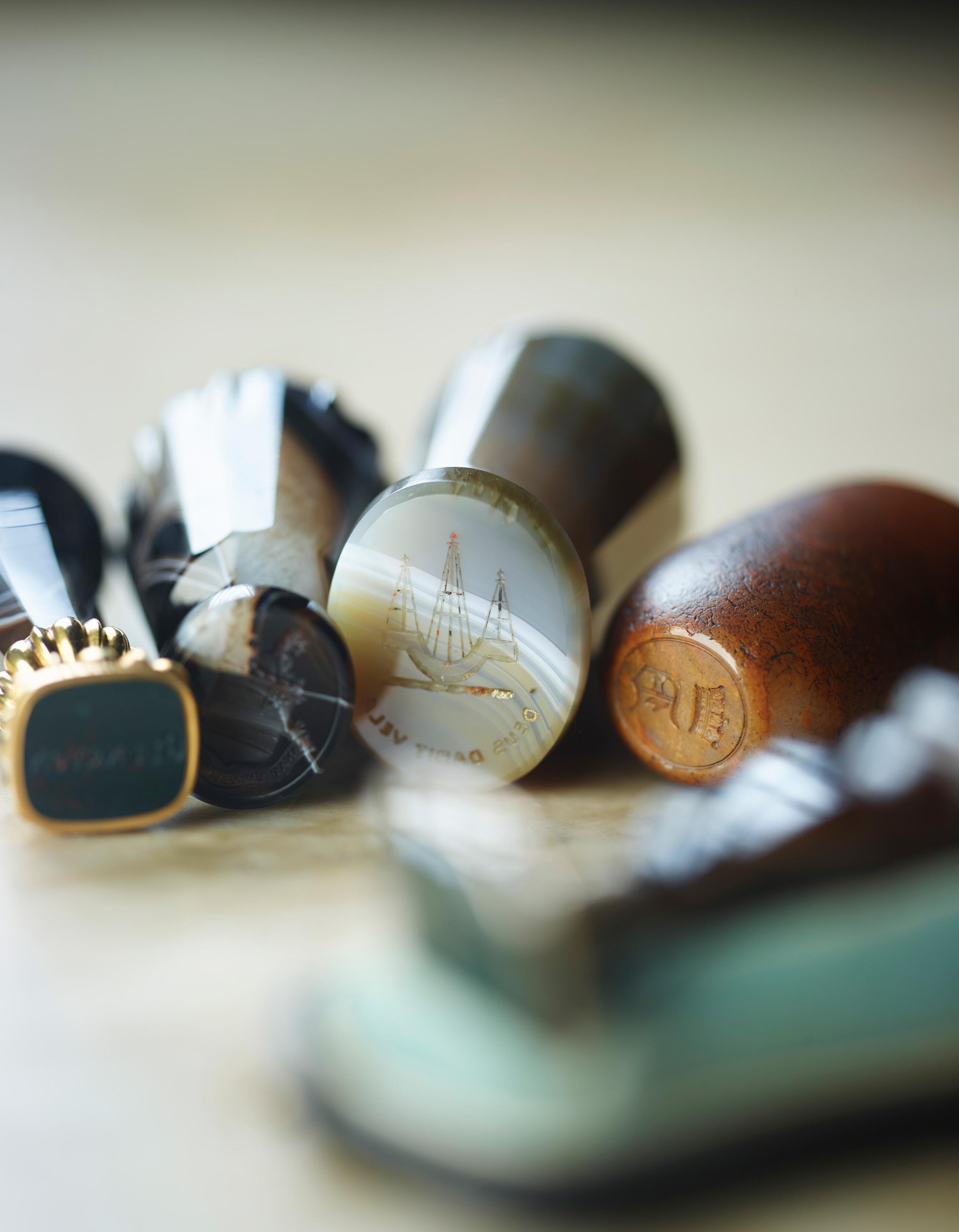
Note: This seal was made for Archibald Kennedy, 3rd Marquess of Ailsa (1847-1938), who succeeded his father in 1870. He founded the Ailsa Ship Building Company in 1885 and spent much time restoring and improving the family seat of Culzean Castle. The Kennedy family which descends from Robert the Bruce, is one of the oldest families in Scotland, and the grandeur of the castle was intended to reflect its status. The present castle on the Ayrshire coast was designed by Robert Adam for David Kennedy, 10th Earl of Cassilis, to replace a simpler house. It was built in stages between 1777 and 1792 and incorporates a drum-shaped tower overlooking the Firth of Clyde and an elegant oval staircase. The 3rd Marquess’s improvements included constructing a more practical entrance to keep out the fierce clifftop winds and rehanging the vast collection of weapons in the armoury. It is not surprising that he should choose this romantic view of the castle, taken from an engraving dated 1840 for this seal.

THE ARCHIBALD KENNEDY (1847-1938), 3RD MARQUESS OF AILSA AND EARL OF CASSILLIS, CULZEAN CASTLE DESK SEAL A FINE MID-VICTORIAN CITRINE, BLOODSTONE AND GOLD MOUNTED DESK SEAL
the facetted tapered citrine handle with engraved crest within garter with motto surmounted by coronet to pommel, the stylised leaf clasped mount enclosing a rounded square bloodstone matrix finely engraved with a view of Culzean Castle from the beach with ‘Culzean Castle’ engraved below, in a fitted case

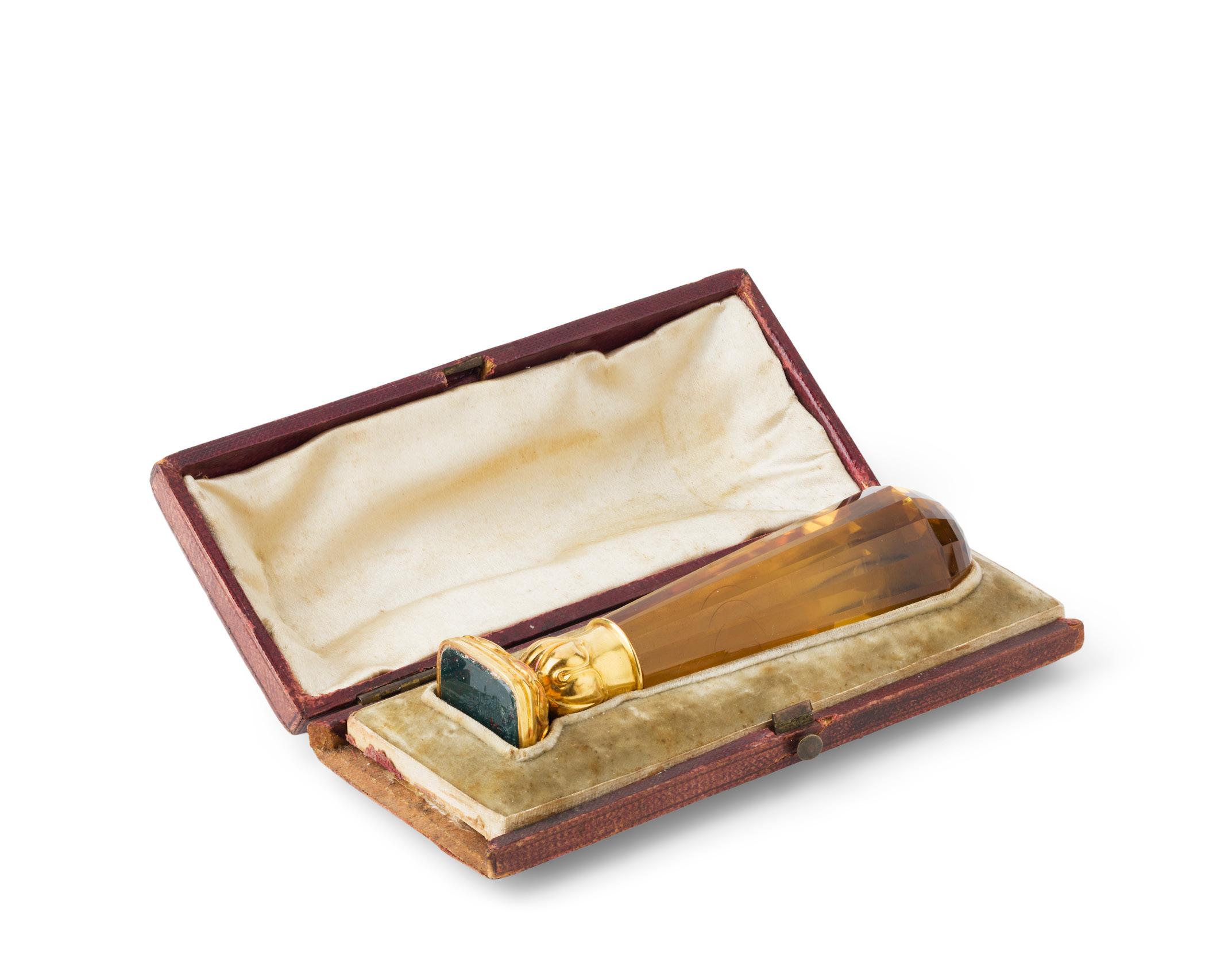
Length: 97mm, matrix 21mm x 24mm
Provenance: Shapes, Edinburgh, 4 July 2009, lot 31
Matrix: A Collection of British Seals - David Morris 2012- Seal 30, page 77 £1,200-1,800
1
260

261 Other fees apply in addition to the hammer price: see the ‘Buyer’s Guide’ section on page 2 1 4 2 3
THE DUNDAS CASTLE SWIVEL DESK SEAL
A MID-VICTORIAN GOLD AND CITRINE THREE-SIDED SWIVEL SEAL, CIRCA 1850
the facetted citrine baluster handle collet set with engraved trailing foliate gold collar, the scroll frame to three-sided oval citrine matrix, one side with a crest of a hound/ wolf’s head facing left, one inscribed DUNDAS CASTLE, the other blank
Length: 66mm (overall), matrices: 19mm x 22mm
Note: A castle has been in situ on the grounds of Dundas Castle since the early 15th century, and there is still the ‘auld keep’, which dates to 1416. The current castle was fashioned in 1818 for the Dundas family by architect William Burn.
William Burn was well-known as a country house architect and pioneered the Scots Baronial style which Dundas Castle reflects. He worked on renovations to other key estates in Scotland including Lauriston Castle and designed the Melville Monument in St. Andrew Square, Edinburgh.
Unfortunately for the Dundas family, the renovations cost so much that the estate had to be sold and in 1846 was purchased by Mr. Russell, who was the founding partner of Edinburgh law firm Russell & Aitken. It is perhaps at this time that the seal was commissioned, accounting for the ambiguity of the crest. The house has been in the possession of the current Stewart-Clark family since 1899, suggesting that this seal is perhaps a snapshot of quite a short period of history for this South Queensferry estate.
£600-900
A WILLIAM IV DIMINUTIVE GOLD AND CITRINE DESK SEAL, CIRCA 1835
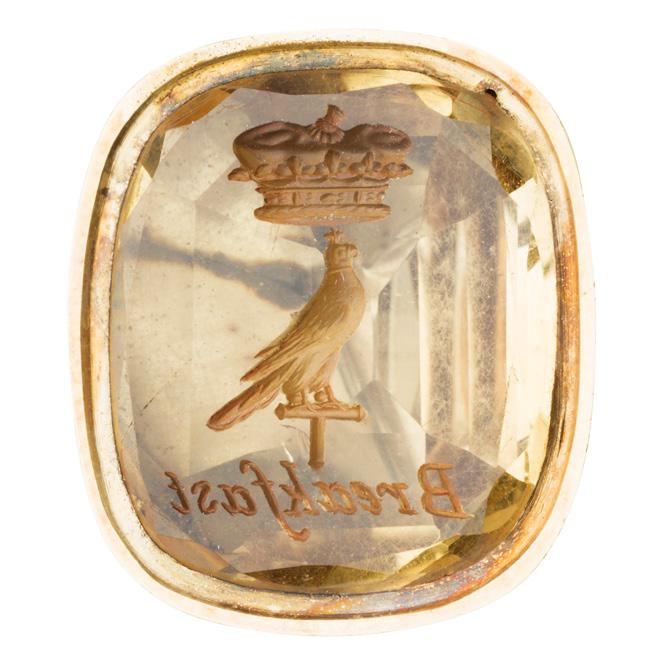
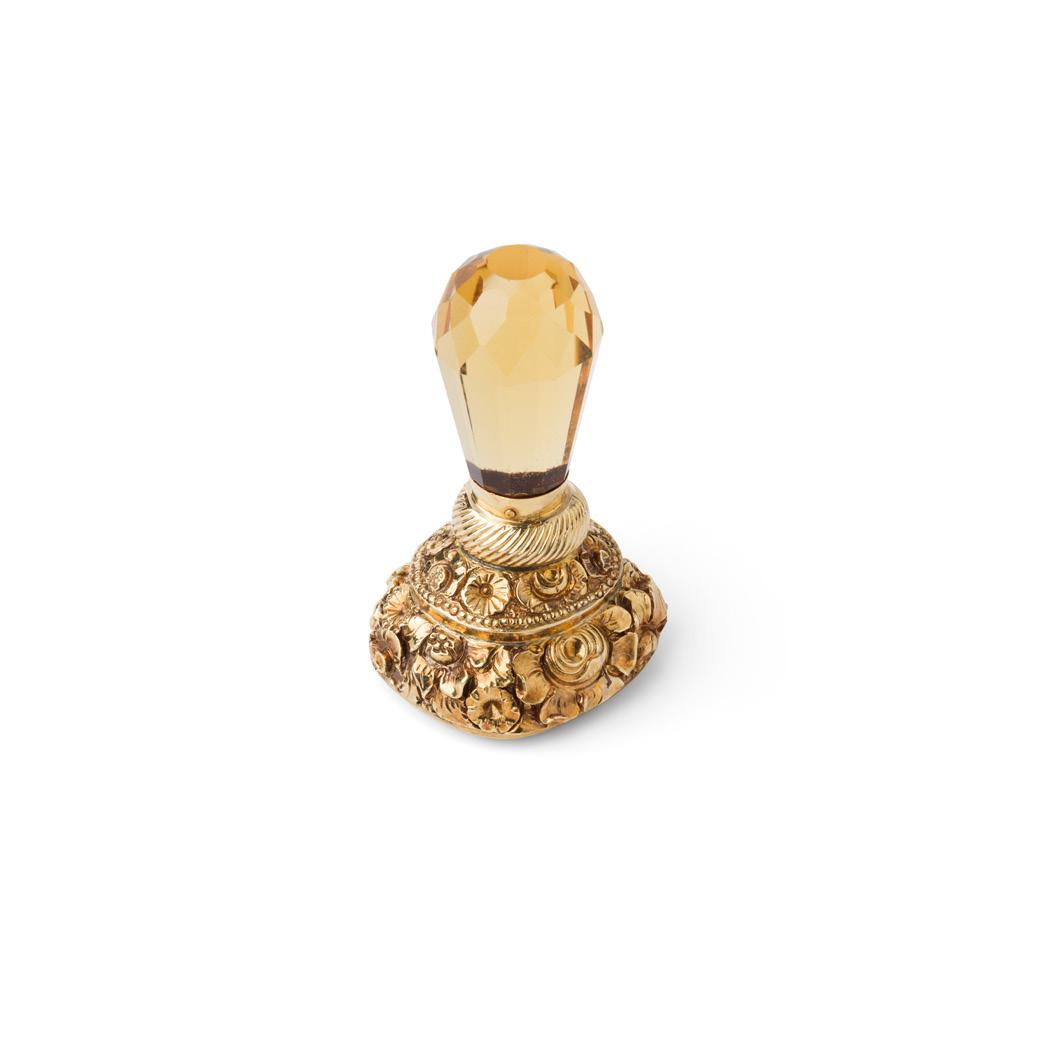
the short tapered and facetted citrine handle set to a boldly chased spiralled and floral mount enclosing a square citrine seal, the seal engraved with a Duke’s coronet above the crest of a falcon standing on a perch, with script motto
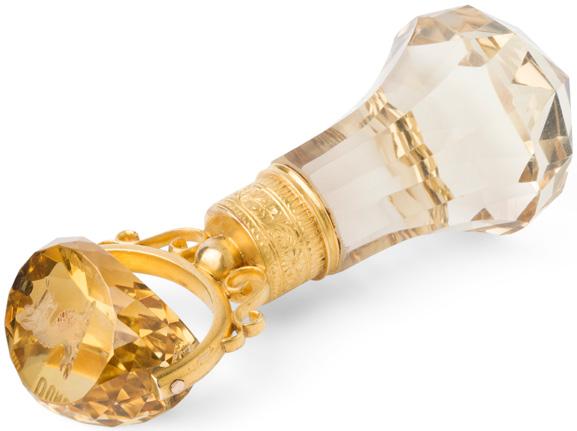
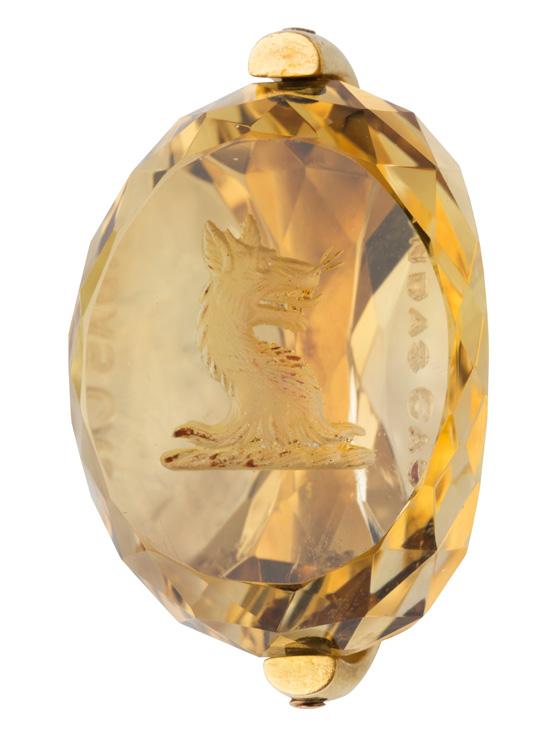
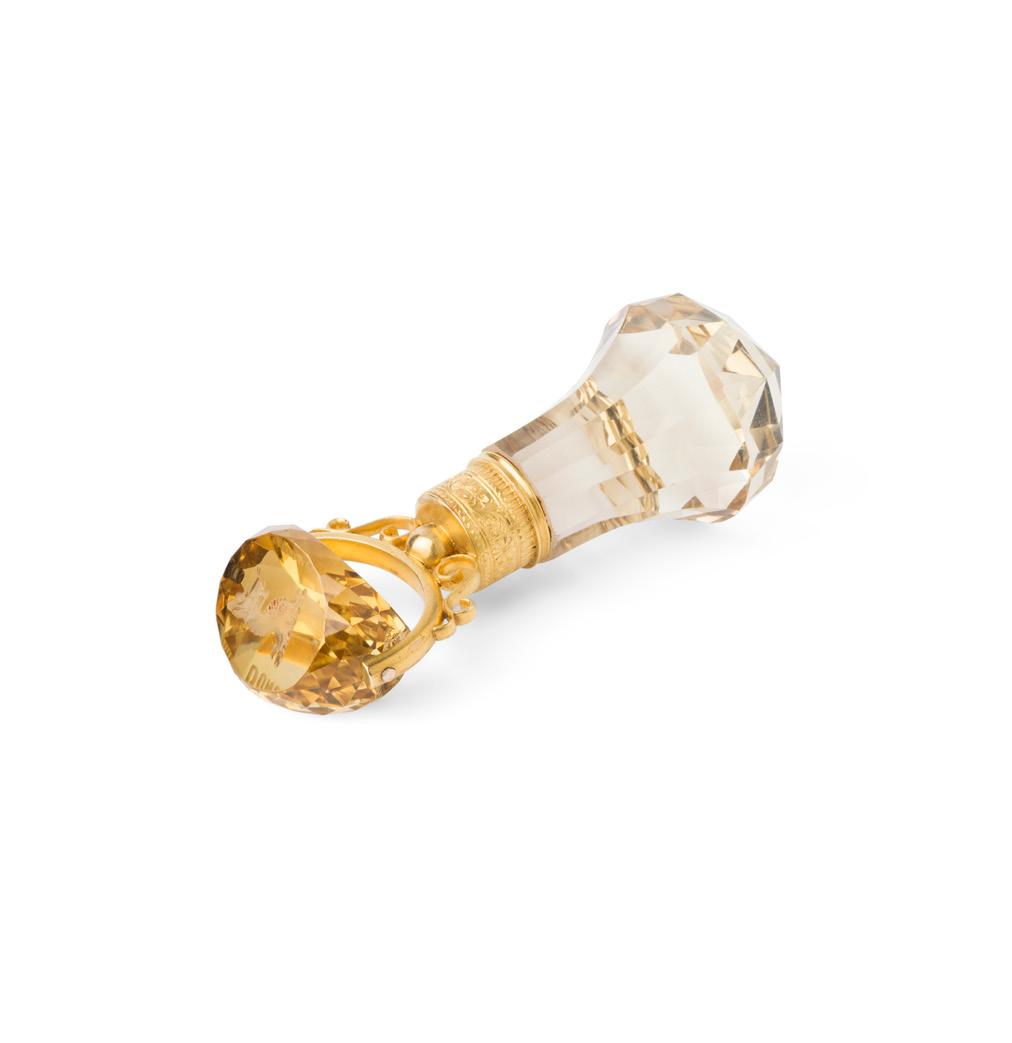
‘Breakfast’ below
Length: 33mm, matrix 20mm x 18mm
Provenance: Christie’s London, 24th May 2000, lot 259
Note: The combination of co-wrote, coronet, crest and apparent motto have not been possible to attribute to any family or person. There are various possible families connected to the crest, but none are entitled to a Ducal coronet. The motto ‘Breakfast’ equally adds confusion. It has been previously considered as a personal joke given at a time now long forgotten.
£500-800
AN EARLY 19TH-CENTURY MOMENTO-MORI MOTHER OF PEARL DESK SEAL
CIRCA 1810
the carved mother-of-pearl handle to a chased gold collar, the hinged terminal opening to a glazed compartment with a lock of hair, to a vacant bloodstone matrix
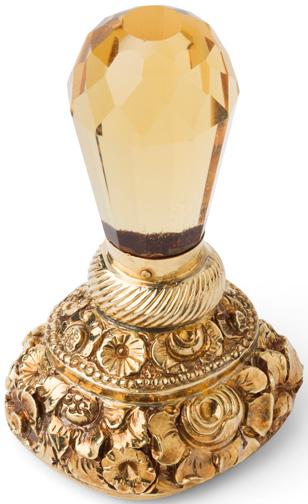

Length: 85mm, matrix: 11mm x 18mm
£700-900

2
3
4
262 Other fees apply in addition to the hammer price: see the ‘Buyer’s Guide’ section on page 2
THE PERSONAL DESK SEAL FOR GEORGE ECKFORD
A MID-19TH-CENTURY WOODEN AND STEEL DESK SEAL
the ebonised wooden handle of baluster form, the steel collar with a gadrooned waist to a circular integral matrix, engraved with an augmentation as a Knight of the Order of St. John in a border ‘SIGILLUM GEORGII ECKFORD’
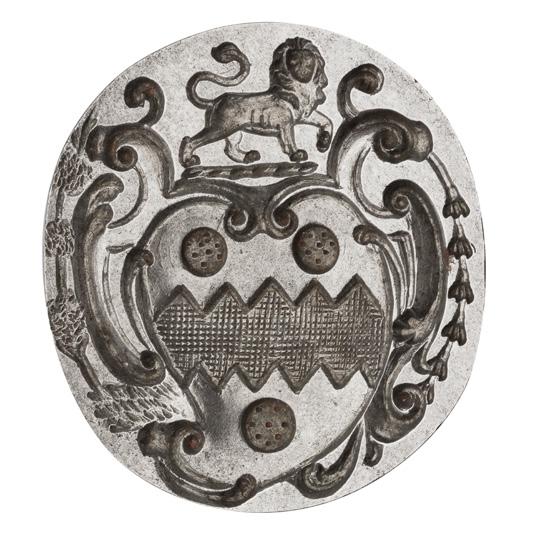
Length: 11.5cm, matrix diameter: 34mm
£200-300
THE PERSONAL DESK SEAL FOR EDWARD BURROW (1726-1800)
A LATE 18TH-CENTURY HARDWOOD DESK SEAL, CIRCA 1773
the hardwood handle of triple knopped form, to a metal collar with banded decoration, the integral matrix engraved with the arms of Burrow
Length: 10cm, matrix: 20mm x 21mm
Heraldry: Arms: Argent a fess indented sable between three bezants
Crest: A lion passant guardant armed ad langued gules
Note: Edward Burrow petitioned the then Lord Lyon King of Arms for a matriculation of arms which was dated 14th August 1773
£600-800
THE HENRY ALEXANDER (1664-1739), 5TH EARL OF STIRLING DESK SEAL
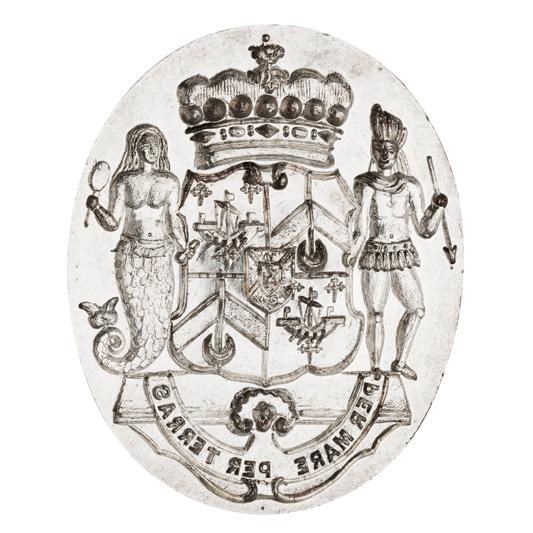
A LATE 17TH-CENTURY BOXWOOD AND SILVER DESK SEAL, CIRCA 1685
the turned baluster boxwood handle indistinctly written on in ink noting original ownership, socket set with silver collar and oval matrix with engraved armorial

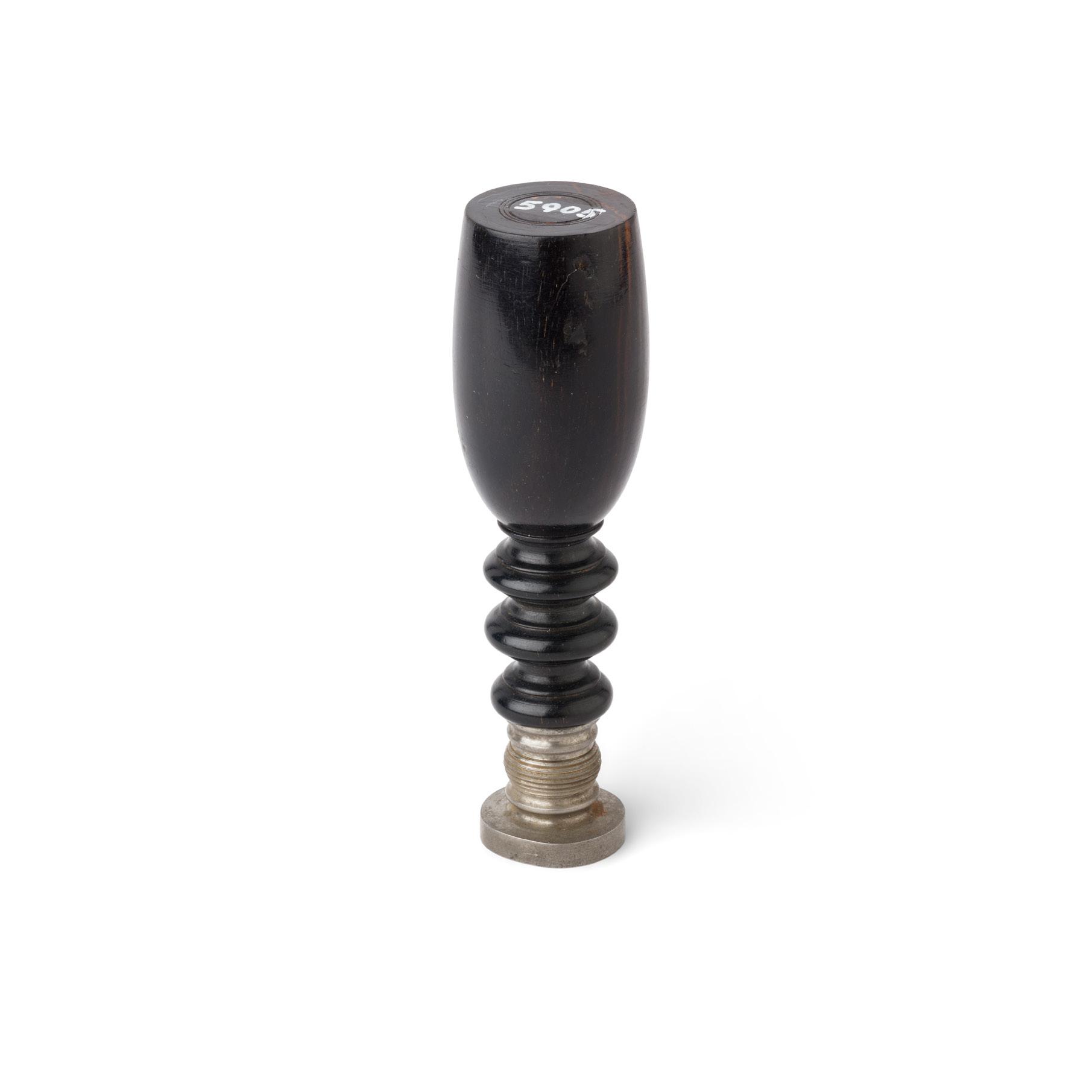

Length: 97mm, matrix: 30mm x 25mm
Note: It would appear this seal originally belonged to Henry Alexander, eldest son of the 4th Earl of Stirling. He was Viscount Canada from 1664 until succeeding his father in 1691. Stylistically, it would seem likely this seal was made on him reaching his majority in 1685.

Eldest son of Henry Alexander (1633-91) 4th Earl of Stirling, and his first wife Judith (b.1664), he was educated at Eton and resided primarily at his house in Binfield but held his Scottish roots by frequently voting as a Scottish representative peer. He was retired and granted a pension of £200 a year by 1733. On his death, the peerage became dormant, and his property was distributed between his cousin and nephews.
£800-1,200
5
6
7
263
THE STUART FAMILY OF BUTE DESK SEAL
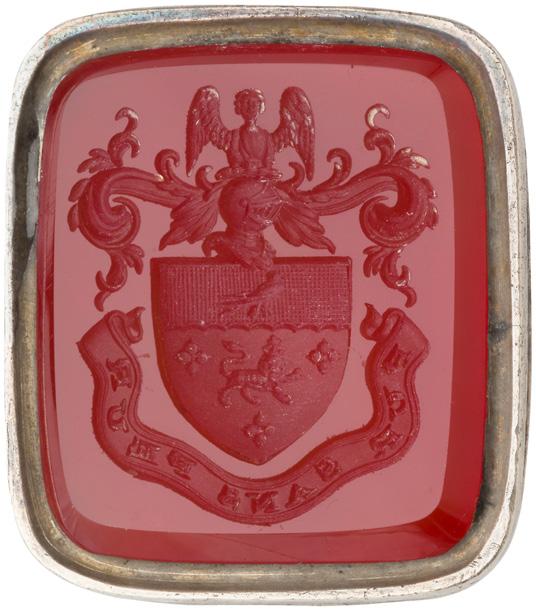
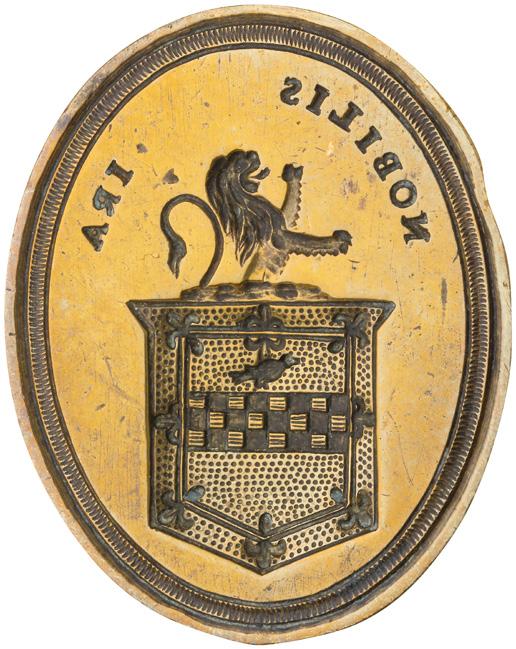

A LATE 18TH-CENTURY BOXWOOD AND BRASS DESK SEAL, CIRCA 1775
the wooden baluster handle with mushroom capped terminal, to a brass collar and integral matrix, engraved with the arms of Stuart and a martlet cadency for the fourth son and the motto NOBILIS IRA
Length: 9cm, matrix: 3.2cm x 2.7cm
Note: The Bute family can trace their lineage back to the 12th century. They have been on the Island of Bute on the West coast of Scotland for over seven hundred years and have lived on the present site for almost three centuries.
The 2nd Earl of Bute constructed the first Mount Stuart house in 1716.
But it was the 3rd Earl of Bute, (1713-1792) who first accelerated the family’s standing. In 1756 the 3rd Earl was named Groom of the Stole to the young Prince of Wales, soon to be George III. His influence helped develop both his personal philosophies and artistic tastes, with his young prince referring to Bute as his “dearest friend.” His role as First Lord of the Treasury in 1762 in effect Prime Minister this confirmed his trust.
The family’s fortune was made by the fortuitous marriage between the 4th Earl and Charlotte Jane Windsor, heiress to vast estates in South Wales, and further rewarded by his appointment, to the 1st Marquess of Bute in 1796. This relationship is mirrored with that of his purported favourite son Charles Stuart (1753-1801) who Lord Bute personally tutored. It seems possible that this seal relates to a fourth son of the Earls of Bute, likely the 4th Earl of Bute. As the fourth son, he had a military career and achieved lieutenant general by 1798. He passed away in London in 1801.
£500-800
9
THE MACMILLAN FAMILY SEAL
AN EARLY 19TH-CENTURY SILVER-GILT MATRIX, CIRCA 1815
the oval discoid seal with engraved crest and motto ‘MISERIS
SUCCURRERE DISCO’, in a rope twist border
Length: 36mm
£200-300
10
ROBERT WHITE (1802-1886) PERSONAL DESK SEAL
A MID-VICTORIAN GRANITE, SILVER AND CARNELIAN DESK SEAL, CIRCA 1869
the baluster pink granite handle with fluted domed terminal enclosing a rectangular matrix engraved with armorial and motto
Length: 85mm, matrix: 21mm x 18mm
Heraldry: Arms: Argent a lion passant guardant gules imperially crowned proper between three quatrefoils sable on a chief engrailed of the last a martlet of the first Crest: A demi-angel proper
Motto: Pur sans peur
Note: Robert White (born 16th August 1802 died, 9th June 1886), of 23 Drummond Place, Edinburgh. Robert was the second surviving son of Adam White of Fens in the County of Roxburghshire and his wife, Catherine Ogilvy. He was by profession a Writer to the Signet having been admitted to the Society of Writers to the Signet on the 13th December 1827. Robert married Anne Reid Fogo (born 9th September 1823 died 23rd October 1905), the daughter of Thomas Macmillan Fogo, MD and his wife Anne Scott at the Parish Church of St Mary and St George, Edinburgh, aforesaid on 3rd June 1852. Robert petitioned the Lyon Court for matriculation of arms which was dated 2nd April 1869 [Lyon Register Volume 8, Page 31].
£400-600 11
A BARON’S DESK SEAL
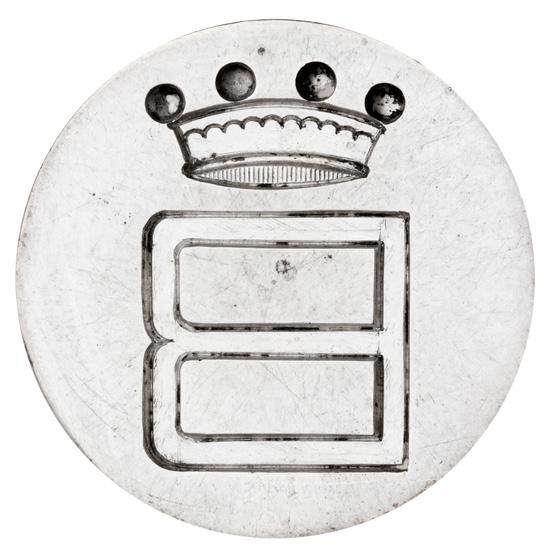
AN EARLY 20TH-CENTURY GEM-SET AND ROSE QUARTZ DESK SEAL
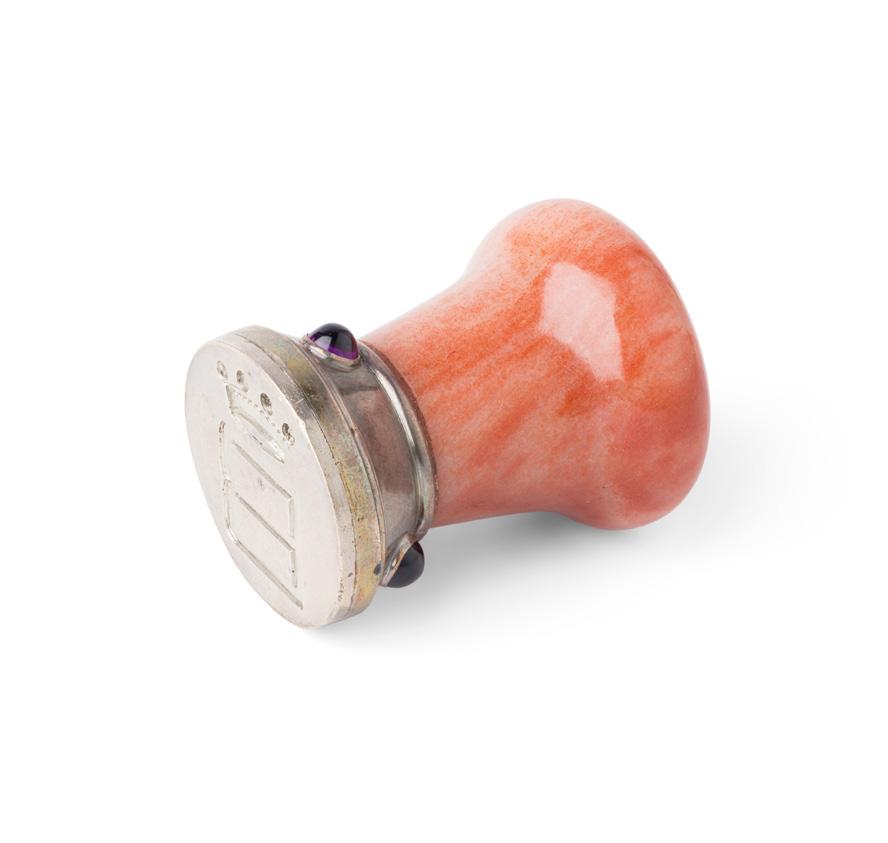
the rose-quartz handle of simple form with a domed terminal, the collar set with three foil-backed amethyst cabochons, the integral silver matrix engraved with a Baron’s coronet above the initial B Length: 48mm, matrix diameter: 32mm
£300-500
8
264 Other fees apply in addition to the hammer price: see the ‘Buyer’s Guide’ section on page 2

265
THE JAMES, 5TH EARL OF WEMYSS, LORD OF ELCHO AND METHILL (1699 – 1756) SEAL MATRIX AN IMPORTANT EARLY 18TH CENTURY SCOTTISH SILVER SEAL MATRIX, CIRCA 1720
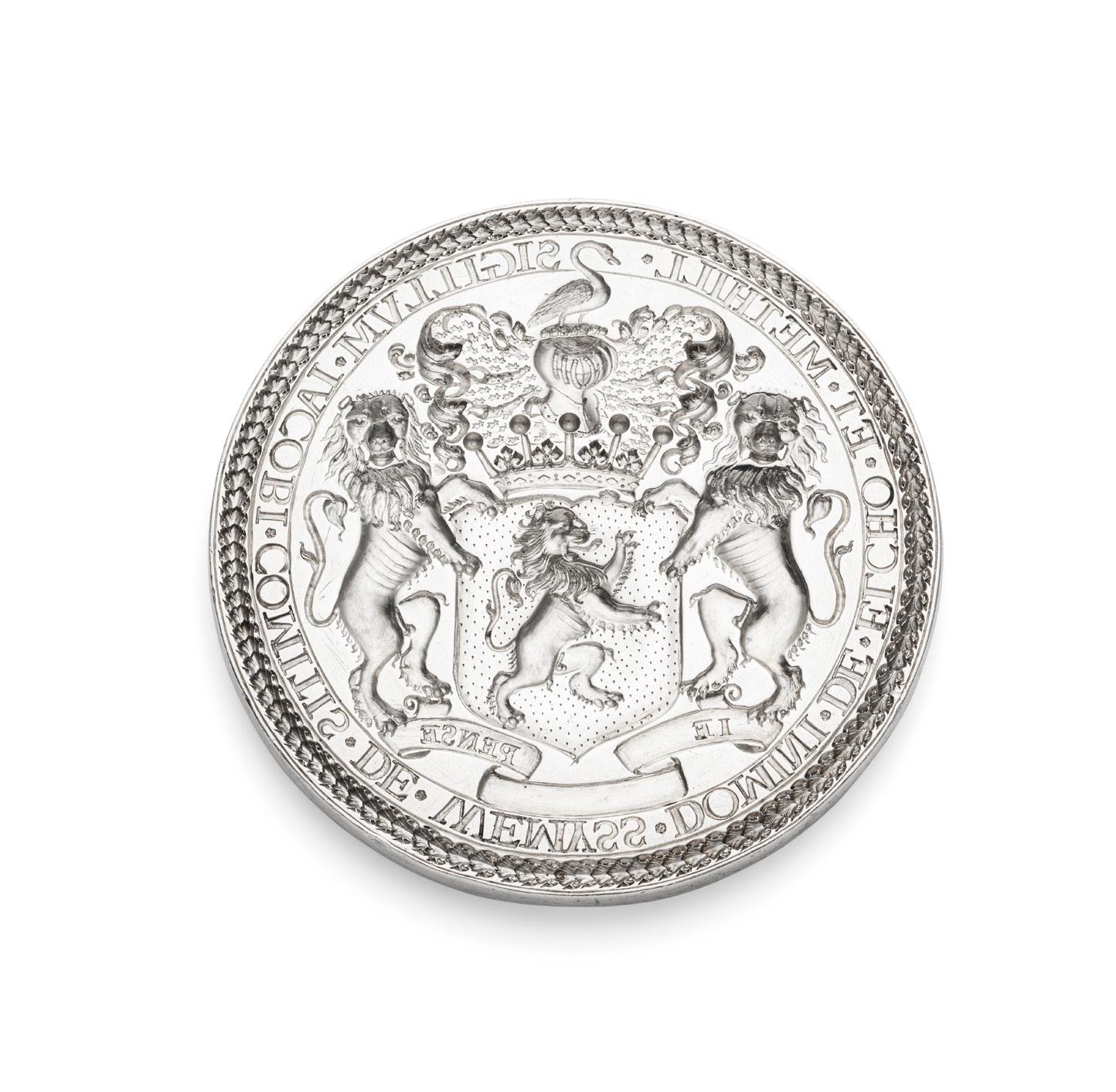
the disc shaped matrix with deeply cut armorial and motto
Diameter: 76mm, weight: 8.66oz
Provenance: Brand Inglis Ltd. Old Silver and Works of Art, 1986
Matrix: A Collection of British SealsDavid Morris 2012 - Seal 54, page 115
Heraldry: Arms: Or a lion rampant gules armed and langued azure the arms are ensigned with an earl’s coronet.
Crest: A swan proper Supporters: Two lions rampant guardant (……?)
Motto: Je pense [I think]
Note: James Wemyss was born on 30 August 1699 and was privately educated. He succeeded his father in 1720, shortly after marrying Janet Charteris. His bride, won against determined competition, was the daughter of the notorious, extremely rich gambler and money lender, Colonel Frank Charteris, who despite initial opposition to the match, ultimately bequeathed £10,000 to his son-in-law and considerably less to his daughter.
The Earl had joined the Royal Company of Archers in 1714, rising to become its Captain-General and first winner of the Company’s silver bowl trophy. Despite, or perhaps because of little interest in politics he was appointed Governor of the County of Perth in 1744, but took no active part in the Jacobite uprising in Scotland in 1745. His eldest son, David, Lord Elcho, however, commanded the lifeguard of his near-contemporary Charles Edward Stuart, the Young Pretender, to whom he had lent £3000 which was never repaid, and was obliged to flee to France. Because of this, his father was obliged to resign Wemyss Castle and the estates in favour of his third son, James Wemyss, MP for Sutherland. The 5th Earl was able to develop coal mining and salt manufacturing interests and lived for the latter part his life at Norton, Co. Durham. The loss of the provision he had made for his eldest son, combined with his estranged wife’s extravagance, had brought the Earl into financial difficulties. He died on 21 March 1756, and the title passed to the descendants of his second son, Francis.
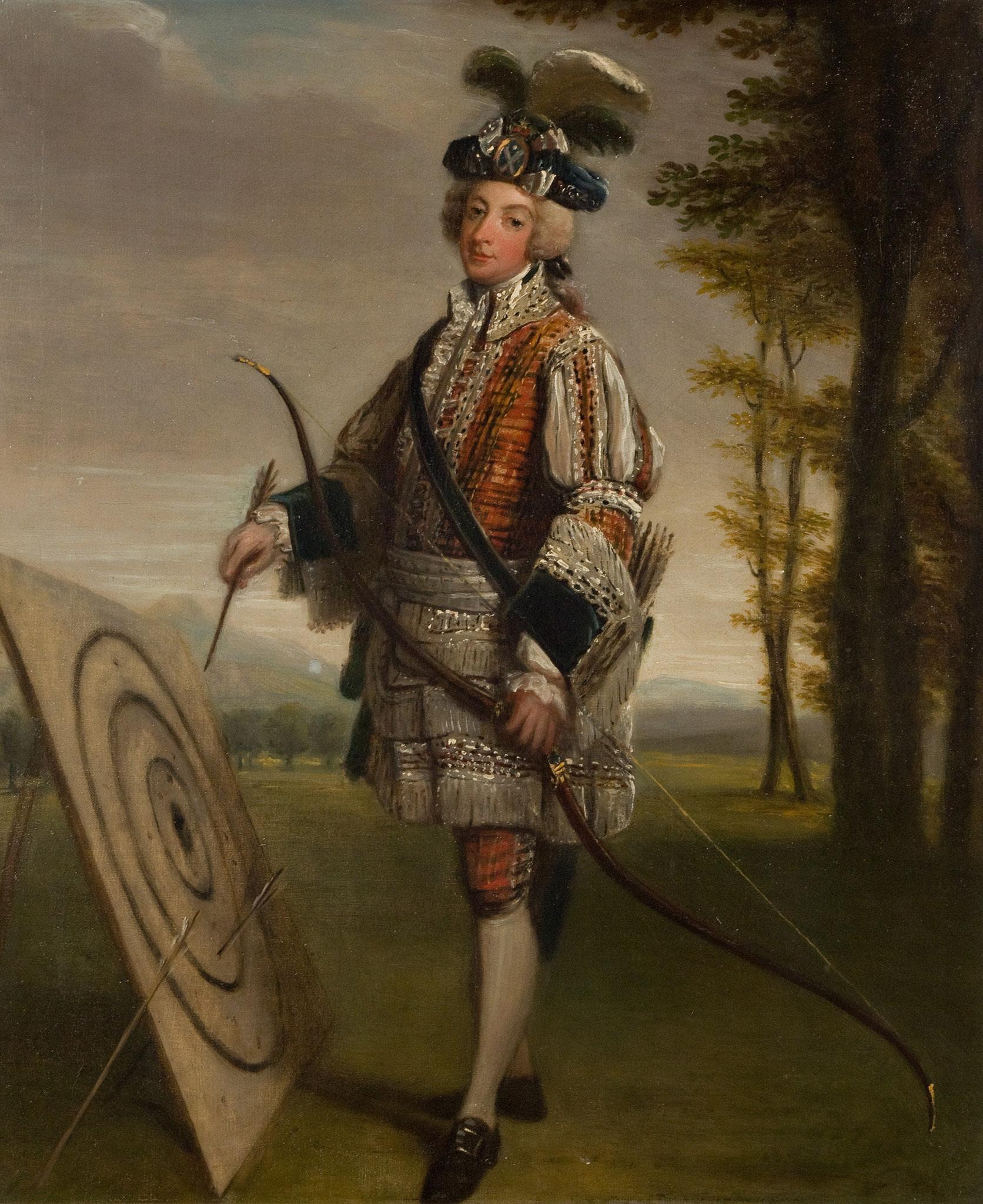
Image Courtesy of the King’s Body Guard for Scotland, The Royal Company of Archers.
£3,000-5,000
266 Other fees apply in addition to the hammer price: see the ‘Buyer’s Guide’ section on page 2 12
THE JAMES DOUGLAS, 2ND DUKE OF QUEENSBERRY (1672-1711) SEAL MATRIX
AN IMPORTANT EARLY 18TH CENTURY SCOTTISH SILVER SEAL MATRIX, CIRCA 1701
the large dished circular matrix with deeply carved and engraved armorial, the reverse, engraved with mirrored monogram JQ, with ducal coronet above Diameter 10.3cm, weight: 13.2oz

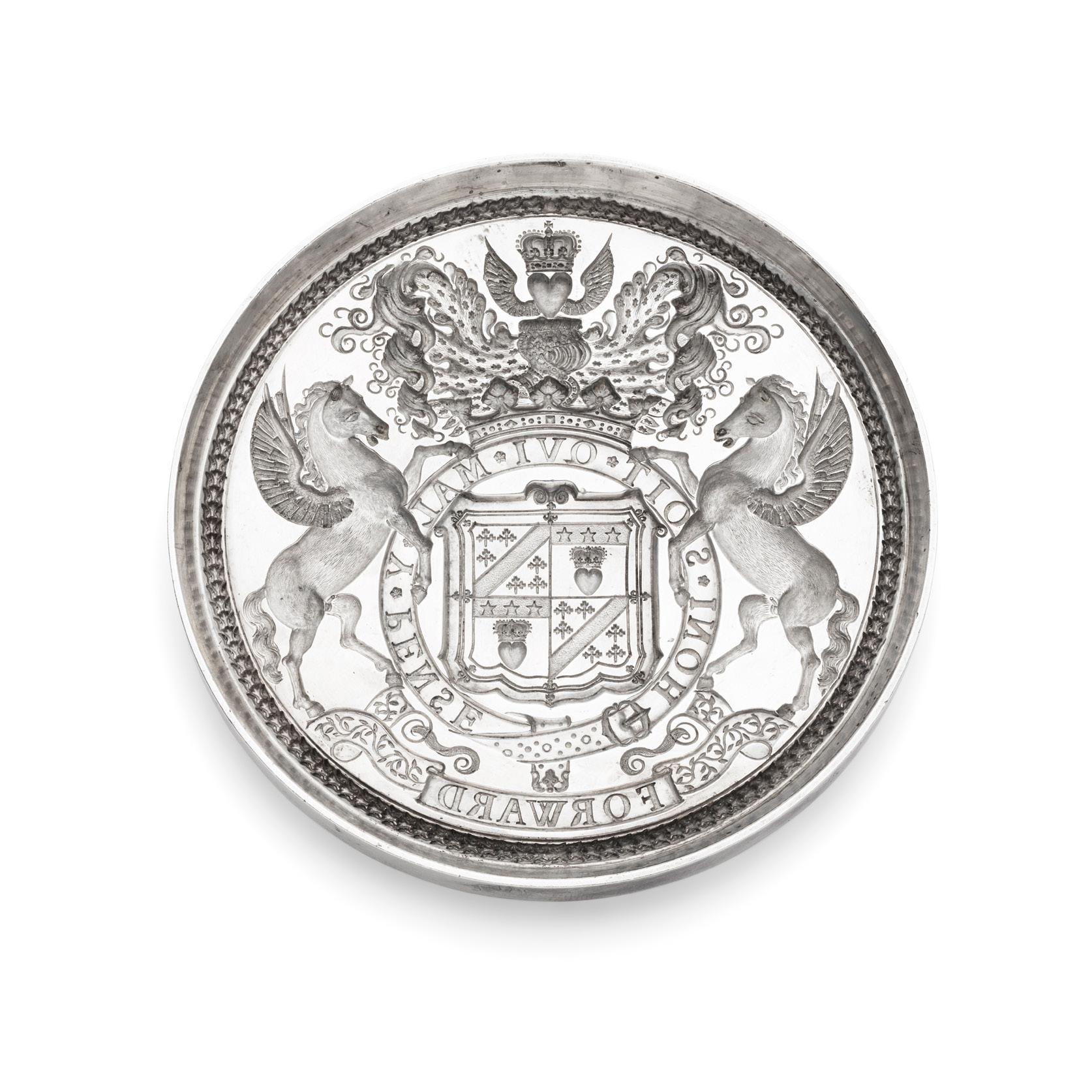
Provenance: Phillips Edinburgh, 3rd December 1998, lot 218
Matrix: A Collection of British Seals - David Morris 2012- - Seal 23, page 64

Heraldry: Arms: Quarterly 1st and 4th Argent a man’s heart gules ensigned with an imperial crown proper on a chief azure three mullets of the field (for Douglas) 2nd and 3rd Azure a bend between six cross crosslets fitchy or (or Mar) the whole within a bordure or charged with the double tressure of Scotland gules the arms are environed by the Garter and ensigned with a duke’s coronet.
Crest: A heart gules winged and ensigned with an imperial crown or (for Douglas)
Supporters: Two pegasi argent winged or Motto: Forward
£3,000-5,000
Note: James Douglas, 2nd Duke of Queensberry and 1st Duke of Dover was a highly important politician in 18th-century Scotland. The eldest son of William Douglas, 1st Duke of Queensberry and his wife Isabel Douglas. Educated at Glasgow University he was awarded title of Privy Councillor by the age of 22 in 1684.
He served in various regiments including Dundee’s Regiment of Horse and was appointed Colonel of the Scots Troop of the Horse Guard Regiment. A supporter of William III, it was under his reign he was commissioned as a Colonel, presumably for his support in the 1688 Glorious Revolution.
His political career was hugely successful and on the death of his father and his elevation to 2nd Duke of Queensberry, the titles and roles he held in the highest office would grow. He held positions such as Lord High Treasurer of Scotland (1693), Keeper of the Privy Seal of Scotland (1695 – 1702), and Extraordinary Lord of Session, Lord High Commissioner to the Scottish Parliament (1701-1703). His position close to the Royal Household was made even clearer in 1701 when he was appointed Knight of the Garter.
Although obviously a Royalist and in 1707 would be instrumental in securing the Act of Union, he did become embroiled, and some would say supported the Jacobite cause. He was tricked by Simon Fraser, Lord Lovat into trying to betray the Duke of Atholl to the Royal Court for his Jacobite support. This ultimately poor attempt and failed scheme meant Douglas stepped back from Government in 1704.
His fall from favour was short as the following year he was reinstated as Keeper of the Privy Seal among other roles. As mentioned, he ultimately helped secure the Act of Union which lost him many friends, but did mean he received a £3000 per year pension.
His rewards were not just monetary as he was given English titles to match his Scottish ones already held and was created Duke of Dover, Marquess of Beverley and Earl of Rippon in 1708. His career and indeed life would not last long after this and while serving as Secretary of State for Scotland, from 1709, he died in office in 1711.
He was succeeded by his second son Charles as his eldest, some considered ‘insane’; consequently passing over from succeeding his premier titles but was given the titular title of Marquess, befitting the son of a Duke.
267
13
ABERDEEN - A SCOTTISH PROVINCIAL DESK SEAL
A MID-18TH-CENTURY WOODEN AND SILVER DESK SEAL
the wooden baluster handle with flat terminal, to a silver mounted collar marked ABD, the integral matrix engraved with the armorial, possibly for the Houston family

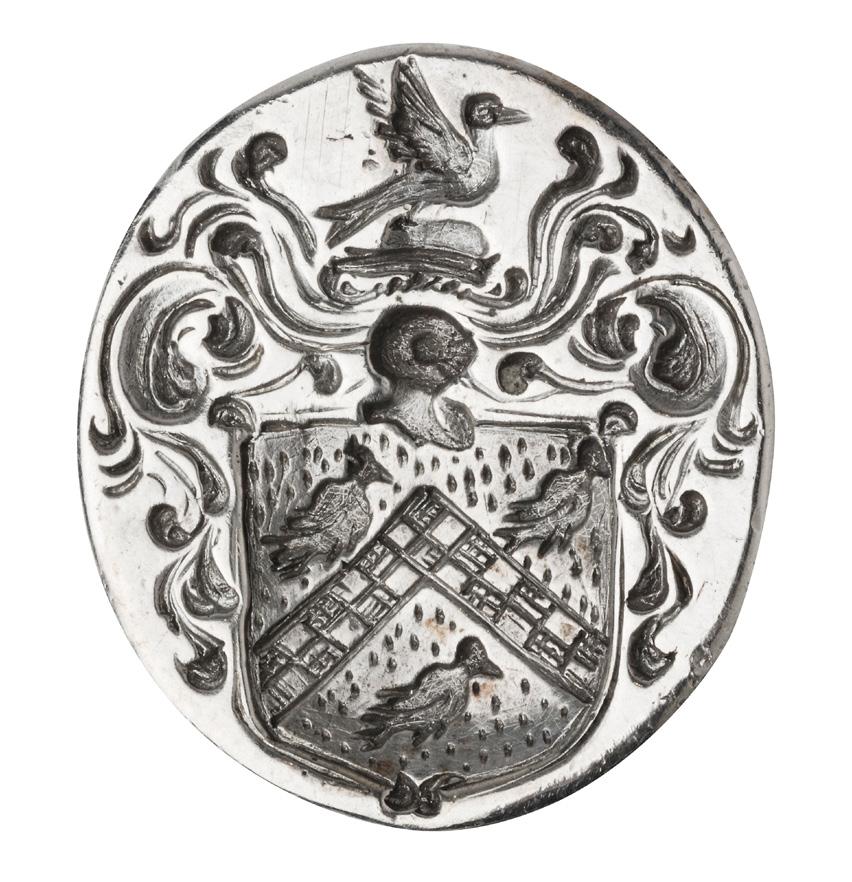
Length: 52mm, matrix: 20mm x 13mm
Provenance: ‘Silver, The Aberdeen Story’, Aberdeen Art Gallery & Museums 2012, item 192, catalogue page 169
Matrix: A Collection of British Seals - David Morris 2012- seal 25, page 68
Note: This fine mid-18th-century desk seal appears to be the earliest marked Aberdeen example. Frustratingly, with only the town mark, ascribing a maker is virtually impossible. The quality of the silver mount and finely engraved armorial, coupled with the status of the client who commissioned the piece, shows its original importance. This type of client would likely have frequented only the most respected Aberdeen makers. Looking at the style and shape of the town punch, it does seem likely it belonged to either Coline Allan or one of his contemporaries, such as George Robertson.
£1,000-1,200
A WALLACE FAMILY FIGURAL DESK SEAL
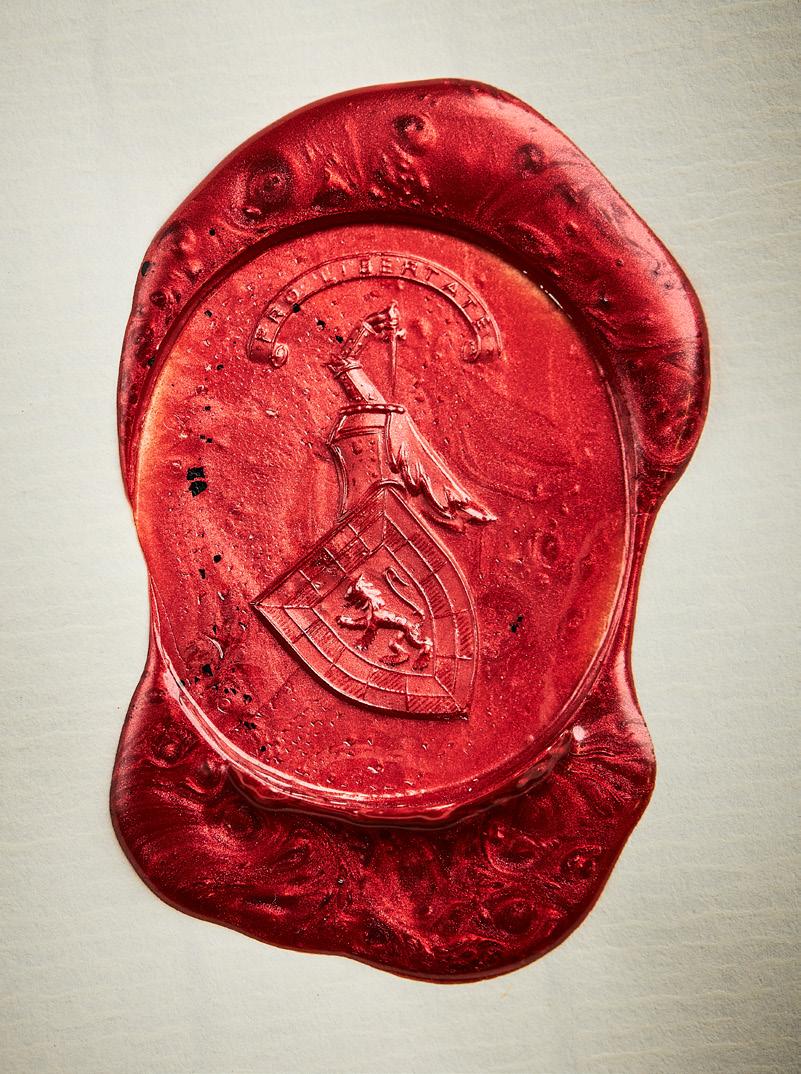
A LATE 19TH-CENTURY GILT METAL AND BLOODSTONE FIGURAL DESK SEAL, CIRCA 1870 the handle formed as the Wallace family crest of an armoured arm holding a dagger, the oval bloodstone matrix with engraved armorial, crest and motto, the matrix hinged to open a sealing wax holder, in a modern fitted case with a wax impression

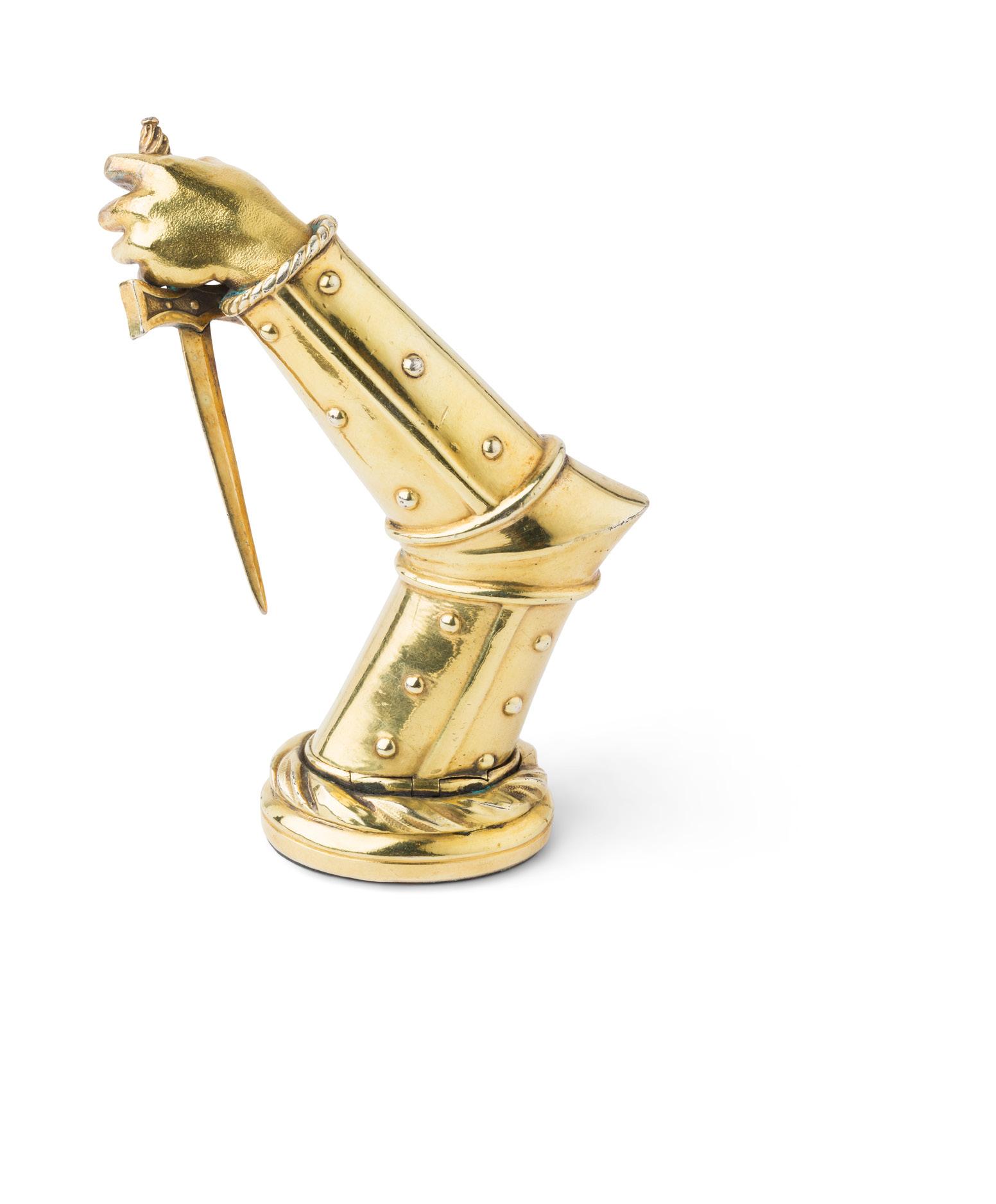
Length: 10.1cm, matrix 39mm x 35mm
£2,000-3,000
A CONTINENTAL BRONZE 17TH-CENTURY DESK SEAL
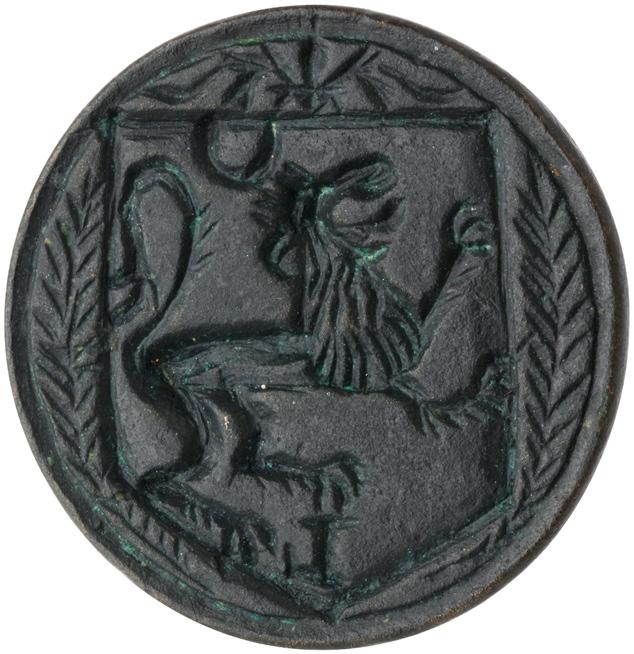
the double-ended handle of mirrored baluster form, the integral circular terminals each engraved with a lion in a shield in a border of laurels
Length: 56mm, diameter of matrices: 25mm and 19mm
£300-500

14
15
16
268
THE VON OF STRUAN FAMILY DESK SEAL AN 18TH-CENTURY JACOBITE INTEREST WOODEN AND BRASS DESK SEAL
the wooden handle of baluster form with threaded detail, the circular brass matrix engraved with the crest of Robertson with motto ’Virtutis Gloria Merces’
Length: 74mm (overall), matrix: 21mm diameter

Provenance: Discovered in a house in Lauder, circa 1965
Anderson & Garland, Northumberland, 9th May 2006
Lyon & Turnbull, Scottish Works of Art & Whisky, 14th August 2019 lot 464
Heraldry: The crest as engraved upon this 18th century brass and wooden-handled Desk Seal is that of the chiefly family of Robertson of Struan. It may be blazoned as follows:
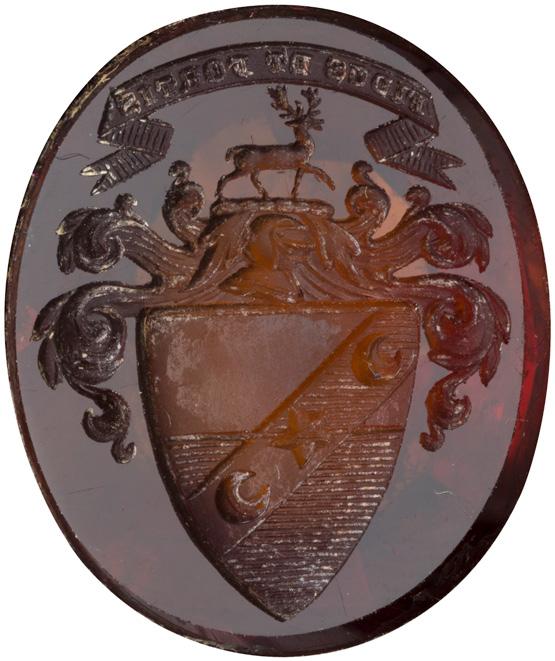
Crest: A dexter hand erect holding an imperial crown all proper
Motto: Virtutis gloria merces [Glory is the reward of valour]
Note: Alexander Robertson of Struan was a committed Jacobite. Born in 1668, he joined the Jacobite army, but was captured following its withdrawal from Dunkeld. He succeeded in escaping to France, and was subsequently attainted until 1703, when he could return to Scotland. In 1715 he again supported the Jacobite cause, raising, it is said, 500 of his clan, but was taken once more, this time at the Battle of Sheriffmuir. With the assistance of his sister, he escaped yet again, and once more fled to France. Although attainted by Act of Parliament for a second time, he could return home in 1732. In 1745, Struan was 77 years of age, yet nevertheless led 150 of his tenants to join the Prince, and, being too old himself to take up arms, returned to his home in General Cope’s carriage, which had been captured at Prestonpans, reputedly with the general’s furred nightgown and gold chain as trophies. Murray of Broughton wrote of him: “he is an old Batcheler, (sic) lived long abroad, and is reckoned a man of letters”. He was permitted to remain at Struan, and died at Carie on the Struan estate in 1749, 2000 men following his coffin 14 miles from Rannoch to Struan Kirk.
In 1725 he was reportedly created a Knight and Baronet by King James VIII. He wrote in English as well as Gaelic, and a book of his poetry was published in 1789. £600-800
18
LORD LOVAT - SIMON FRASER
13TH LORD LOVAT (1828-1887) DESK SEAL
A LATE 19TH-CENTURY MULTI-GEM SET DESK SEAL
the facetted agate handle set to either end with applied hardstones of various shapes including lapis lazuli, malachite and bloodstone, with a finial modelled as a stag, the ornately chased gold collar set further with varying hardstones, to an escutcheon shaped agate matrix engraved with a baron’s coronet above a cypher
Length: 73mm, matrix: 8mm x 8mm
£1,000-1,500
Note: Descendant and carrying the name of the famous Simon Fraser, 11th Lord Lovat (c.1667-1747), nicknamed ‘the Fox’, was a Scottish Jacobite and Chief of Clan Fraser of Lovat, known for his feuding and changes of allegiance. In 1715 he had been a supporter of the House of Hanover, but in 1745 he changed sides and supported the Stuart claim on the crown of the United Kingdom. Lovat was among the Highlanders defeated at the Battle of Culloden and convicted of treason against the Crown, following which he was sentenced to death and subsequently beheaded.
19
A SCOTT FAMILY DESK SEAL
A LATE 19TH-CENTURY SILVER MOUNTED, AGATE AND CITRINE DESK SEAL
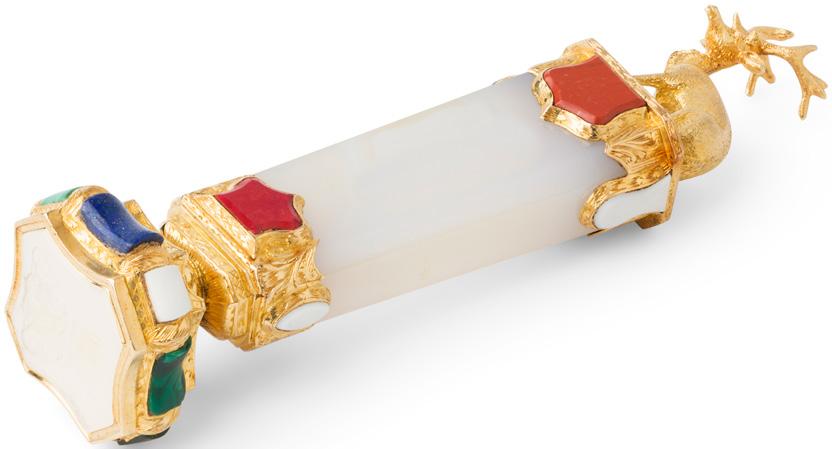
the facetted agate handle with domed terminal, to a silver mounted collar formed as a thistle to four arms, the oval-shaped, cairngorm citrine matrix engraved with the arms of the Scott family

Length: 78mm, matrix: 18mm x 15mm
Note: The arms of those of Scott. The family descends from Sir Walter Scott (15 August 1771 – 21 September 1832) ancestor of the Dukes of Buccleuch.
These arms were granted in 1864 to Dr. John Scott of Cavendish Square London (1817-1890). His son John Edward, became a trustee of the National Gallery and Wallace Collection and was created a Baronet of Castle House, Lisburn County Antrim 1899 and KCB in 1908.
The seal shows no sign of rank and must date after 1864 and before 1899, so most probably for Dr. Scott.
£250-350
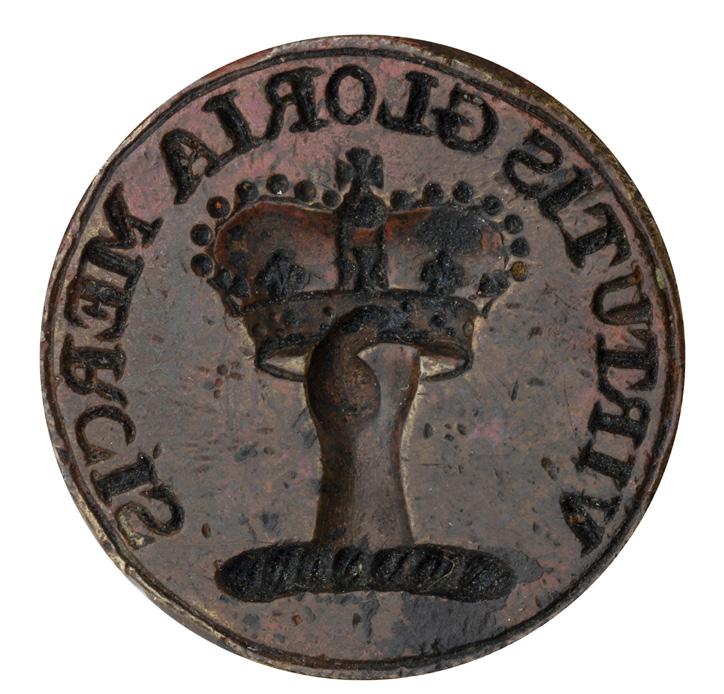
17
269 Other fees apply in addition to the hammer price: see the ‘Buyer’s Guide’ section on page 2
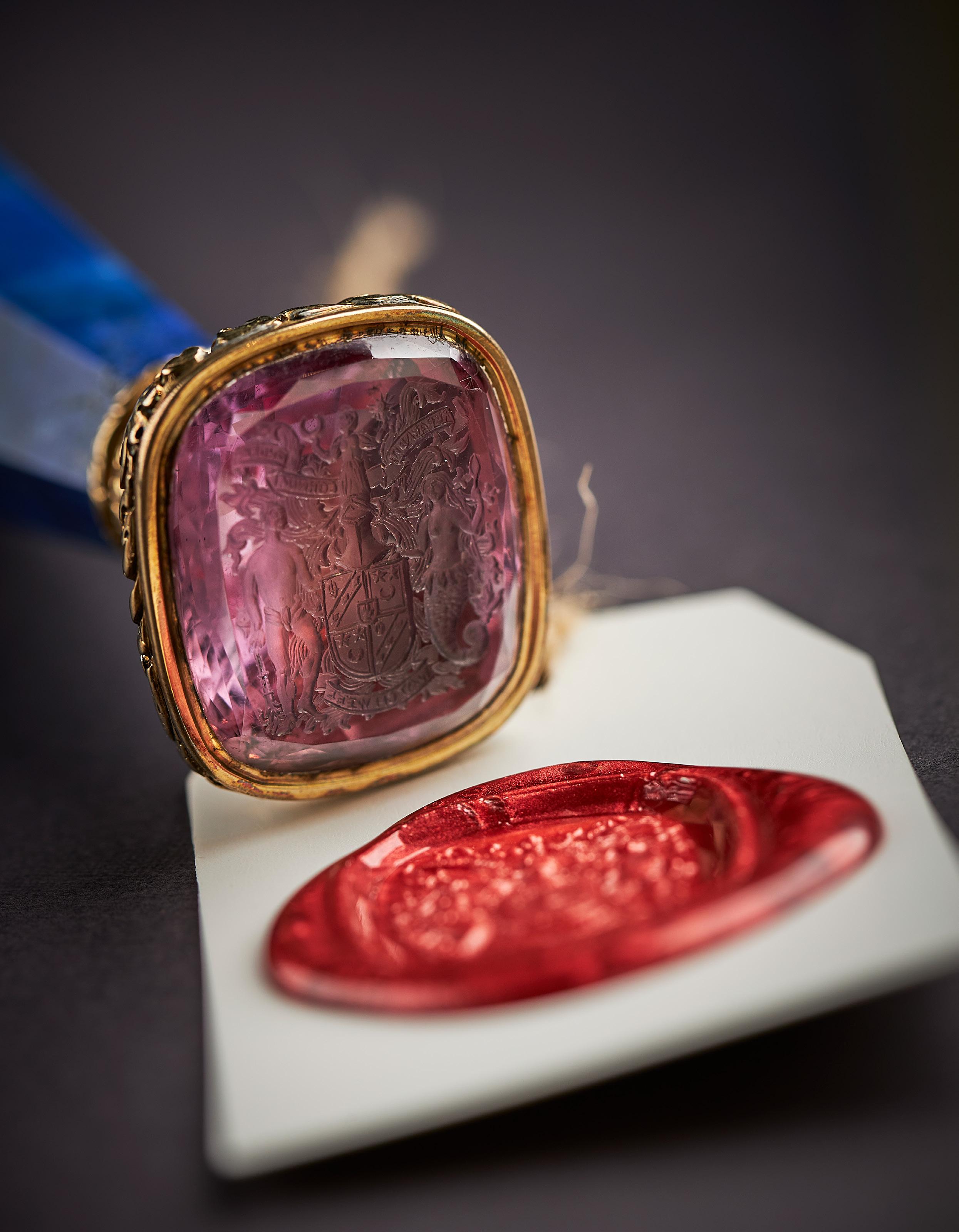
270
THE SIR WALTER SCOTT, BART (1771 - 1832) OF ABBOTSFORD DESK SEAL AN IMPORTANT EARLY 19TH-CENTURY LAPIS LAZULI, GOLD AND AMETHYST DESK SEAL, CIRCA 1820
the tapered hexagonal facetted lapis lazuli handle with carved heraldic shield with initials WS within, the chased domed mounts with foliate scrolls, flower heads and reeded detail, enclosing a rounded square amethyst with engraved full armorial

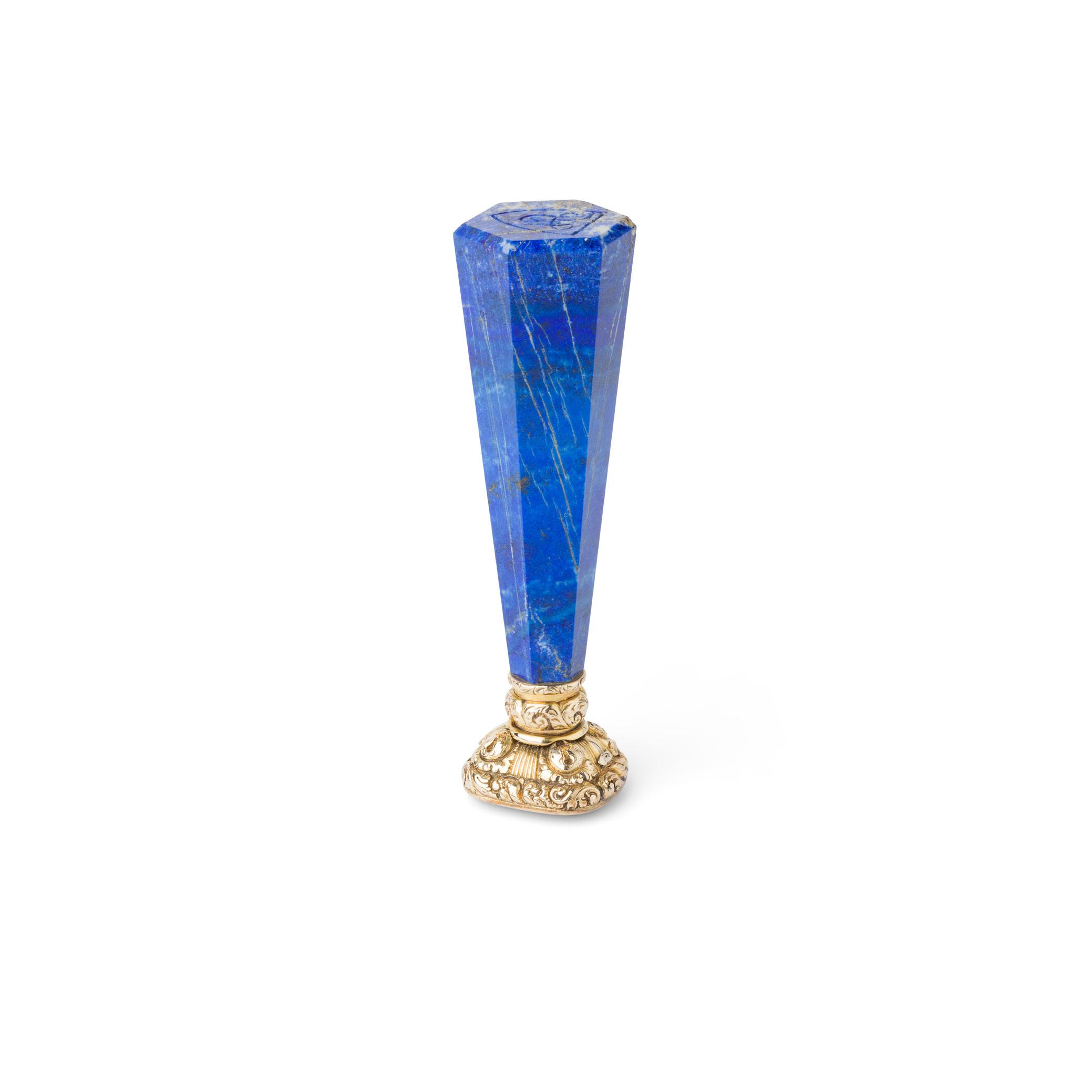
Length: 10.2cm, matrix 25mm x 22mm £12,000-18,000
Heraldry: Arms: Quarterly 1st and 4th Or two mullets in chief and a crescent in base azure within an orle of the last (for Scott) 2nd and 3rd Or on a bend azure three mascles of the field in the sinister chief point an oval buckle erect of the second (for Haliburton)
Crest: A nymph in her dexter hand the sun and in her sinister hand the moon all proper
Supporters: (Dexter) A mermaid holding in the exterior hand a mirror proper
(Sinister) A savage wreathed round the head and middle holding in the exterior hand a club proper Mottos: (Above the crest) Reparabit cornua Phoebe [The moon will replenish her horns]
(Below the crest) Watch weel [Watch well]
Note: This impressive and finely carved seal appears to date perfectly to the granting of the Baronetcy and Knighthood of Walter Scott in 1820. It is a classic example of Regency style and would have befitted Sir Walter Scott, now part of the Scottish gentry. His letter writing is well recorded and this piece likely sealed letters to not only the great and the good, but also correspondence destined for King George IV which would lead to his return to Scotland in 1824.
Scott’s personal interest in Scottish history and life is much discussed and his collection of historical arms and armour is famous, much of which still decorates his remarkable Borders home, Abbotsford. He also commissioned much of the finery needed for a new country estate befitting a Knight and a seal such as this would have been a hugely important gentleman’s accessory.
Sir Walter Scott was born in Edinburgh’s Old Town of Edinburgh in 1771. His father was a successful lawyer, his mother the daughter of a Professor of Medicine at Edinburgh University. After suffering polio in 1773, he was sent to his grandfather’s farm at Sandyknowe in Roxburghshire, living there until 1775, and, listening to stories from his grandfather and others, the young Scott developed his life-long love of Border history and folklore. On returning to Edinburgh, he attended the High School and Edinburgh University. In 1792, he became an Advocate, and was appointed Sheriff-Depute of Selkirkshire in 1799. This allowed him to travel across Scotland in search of history and material to use in his poetry and fiction, eventually publishing his monumental Minstrelsy of the Scottish Borders in 1802. It was in the Borders that Scott was happiest. It was there that he wrote the great epic poems ‘The Lay of the Last Minstrel’, ‘Marmion’ and’ Lady of the Lake’ between 1804 and 1810. With his fame, fortune and family growing, Scott turned to creating Abbotsford, which was completed in 1824.
Sir Walter Scott is one of the most successful authors of all time and is the second-most quoted writer in the Oxford English Dictionary after William Shakespeare. Scott’s creativity, wit and understanding of human nature remain on display in his works, but it is only through visiting Abbotsford and the Scottish Borders that one can truly understand the man himself.
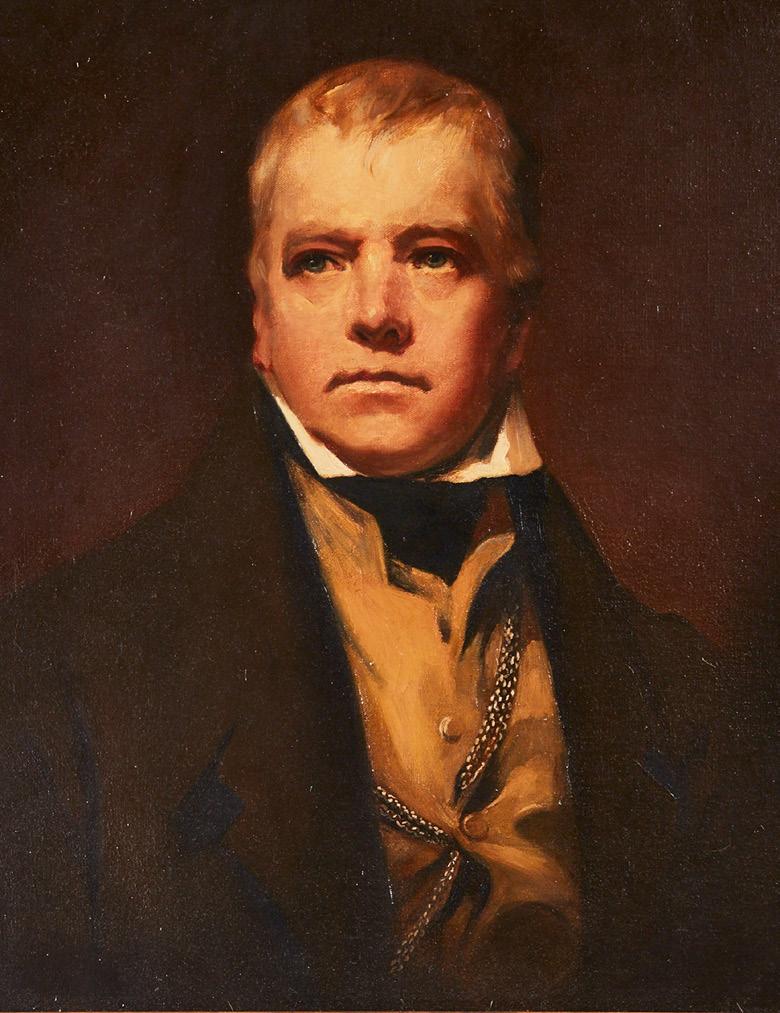
20
271 Other fees apply in addition to the hammer price: see the ‘Buyer’s Guide’ section on page 2
Portrait of Sir Walter Scott, after Sir Henry Raeburn
THE EDINBURGH THEATRICAL FUND SEAL AN IMPORTANT ENLIGHTENMENT SCOTTISH GOLD, BOXWOOD AND AGATE DESK SEAL, CIRCA 1819 the turned box-wood baluster handle with an inlaid gold circular plaque engraved ‘Presented by W. H. Murray Esquire to the Edinburgh Theatrical Fund’, the gold stem with chased floral garland on a domed oval reeded mount, enclosing a mottled red and white agate matrix, engraved with motto INSTITUTED APRIL 2, 1819 THE EDINBURGH THEATRICAL FUND within garter surrounding the crest of lyre and thistles
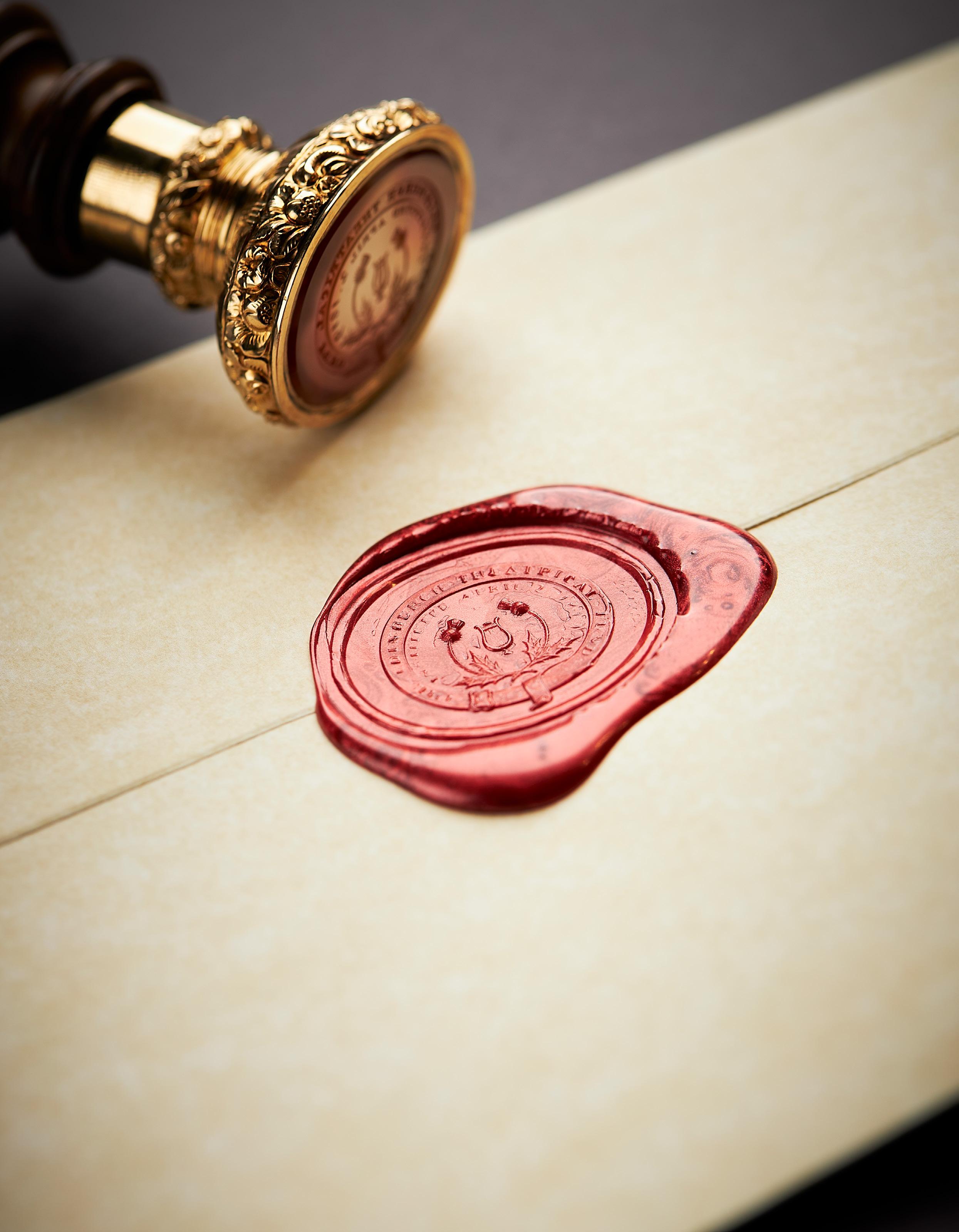
Length: 92mm, matrix: 30mm x 20mm
Provenance: Matrix: A Collection of British Seals - David Morris 2012- Seal 29, page 75 £1,500-2,500

Note: The Edinburgh Theatrical Fund for the support of indigent and retired actors was founded in 1819 by Harriet Murray Siddon (Mrs Henry Siddons, daughter-inlaw of Sarah Siddons) and her brother William Henry Wood Murray, managers of the Theatre Royal, Edinburgh. The English Theatrical Fund had been established in the previous century by David Garrick, but this was to be the first in Scotland. Unfortunately, although the actors and management performed many benefits, it was not possible to raise enough money to make the fund viable. It was therefore relaunched on 1 January 1827 with a number of distinguished patrons. A dinner was held on 23 February 1827 at the Assembly Rooms, chaired by Sir Walter Scott, to celebrate the reformed organisation. The previous night Sir Walter had noted in his diary, “Was at court til two - then lounged till Will. Murray came to speak about a dinner for the theatrical fund in order to make some arrangements. There are 300 tickets given out. I fear it will be uncomfortable and whatever the stoics may say a bad dinner throws cold water on the charity.” The distinguished author had evidently decided to enliven the occasion, since it was at this dinner that he ‘directly and finally divulged’ that he was the ‘entire and sole author of the Waverly [sic] Novels’, the authorship of which had hitherto been a subject of much animated speculation.
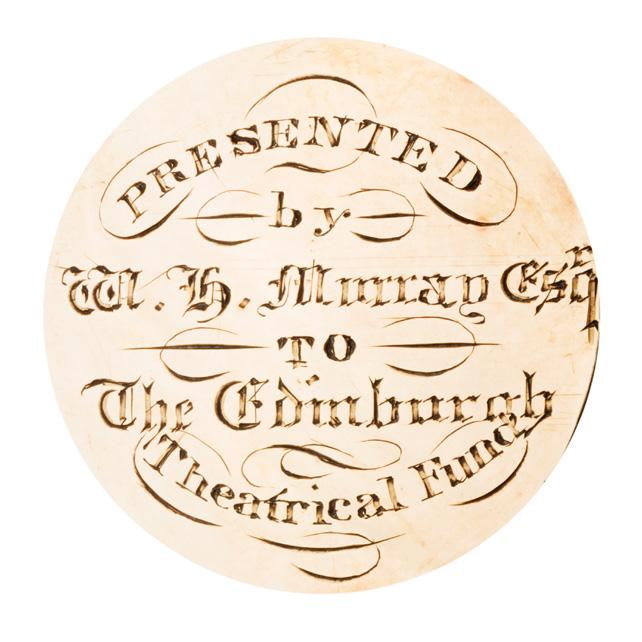
21
A SCOTTISH CLAN KIRKPATRICK DESK SEAL A 19TH-CENTURY CITRINE AND GILT MOUNTED SEAL

the facetted citrine handle to a gilt metal collar with embossed floral decoration, the rounded rectangular citrine matrix engraved with the arms of clan Kirkpatrick
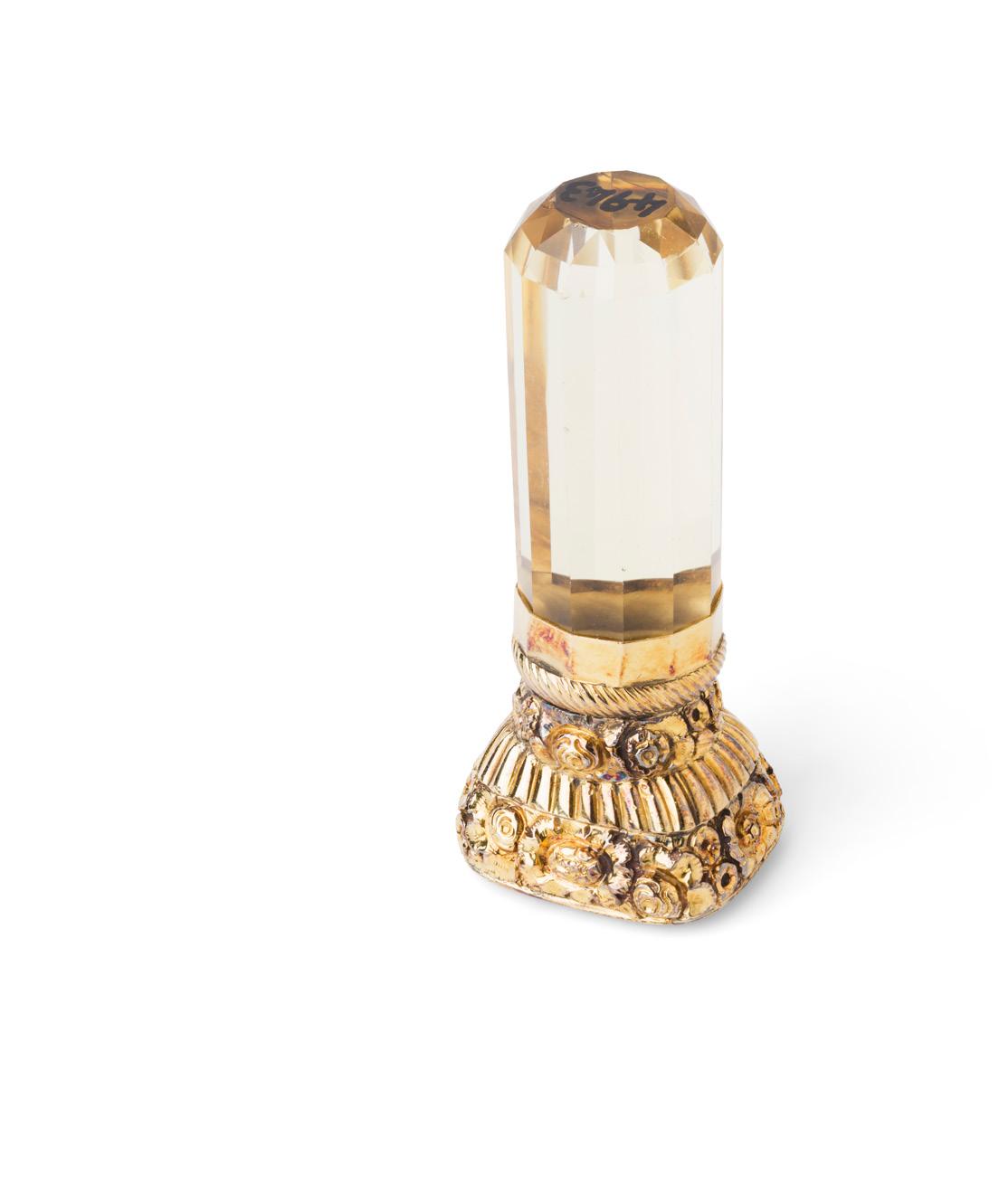
Length: 70mm (overall), matrix: 25mm by 21mm
Heraldry: Arms: Argent on a saltire charged with (……?) and chief azure the last charged with three cushions ermine Crest: A hand couped at the wrist holding a dagger in pale distilling drops of blood proper Motto: I mak sicker [I make sure]
Note: Upon the balance of probability, and without any evidence to the contrary, this seal was at one time in the possession of a gentleman of the Kirkpatrick family. Although it is presently difficult to pinpoint which branch of the family the gentleman belonged, as there are slight variants to charges found in the arms as blazoned above that differ them from chiefly or stem from the family of Kirkpatrick of Closeburn in the County of Dumfriesshire, the following hypothesis might be a credible one. As these armorial bearings do not appear to have been recorded in the Registers of Lyon Court in Edinburgh, an examination of the Books of Ulster King of Arms was undertaken and it was found that similar armorial bearings were confirmed by then Ulster King of Arms, Sir Neville Wilkinson on 20th February 1925 at Dublin Castle. The gentleman who was confirmed in these armorial bearings was the grandson of William Kirkpatrick of Donacomper in the County of Kildare, who was living probably during the early to mid-19th Century. The text of the confirmation from the Ulster King of Arms stated the family descended from a younger branch of the Kirkpatricks of Closeburn aforesaid and that the family had long used these armorial bearings but as they found not to be recorded with the Ulster King of Arms they thought it best that they should be so recorded. So, there is, therefore, a presumption that owing to the closeness of the design of both arms and crest (save for the use of the ‘crown’ on the saltire) as engraved upon the matrix and the confirmed armorial bearings that this seal was at one time in the possession of the family of Kirkpatrick of Donacomper.
The clan takes its name from the church of Saint Patrick in Dumfries and Galloway
£600-900
THE JAMES MAITLAND BALFOUR 1820-1856) OF WHITTINGEHAME DESK SEAL
A FINE VICTORIAN BLOODSTONE AND GOLD DESK SEAL, CIRCA 1843
the facetted baluster bloodstone handle to a gold collar and mount, the bloodstone matrix intaglio carved with full armorial, in original fitted case inscribed to lid for Mortimer and Hunt

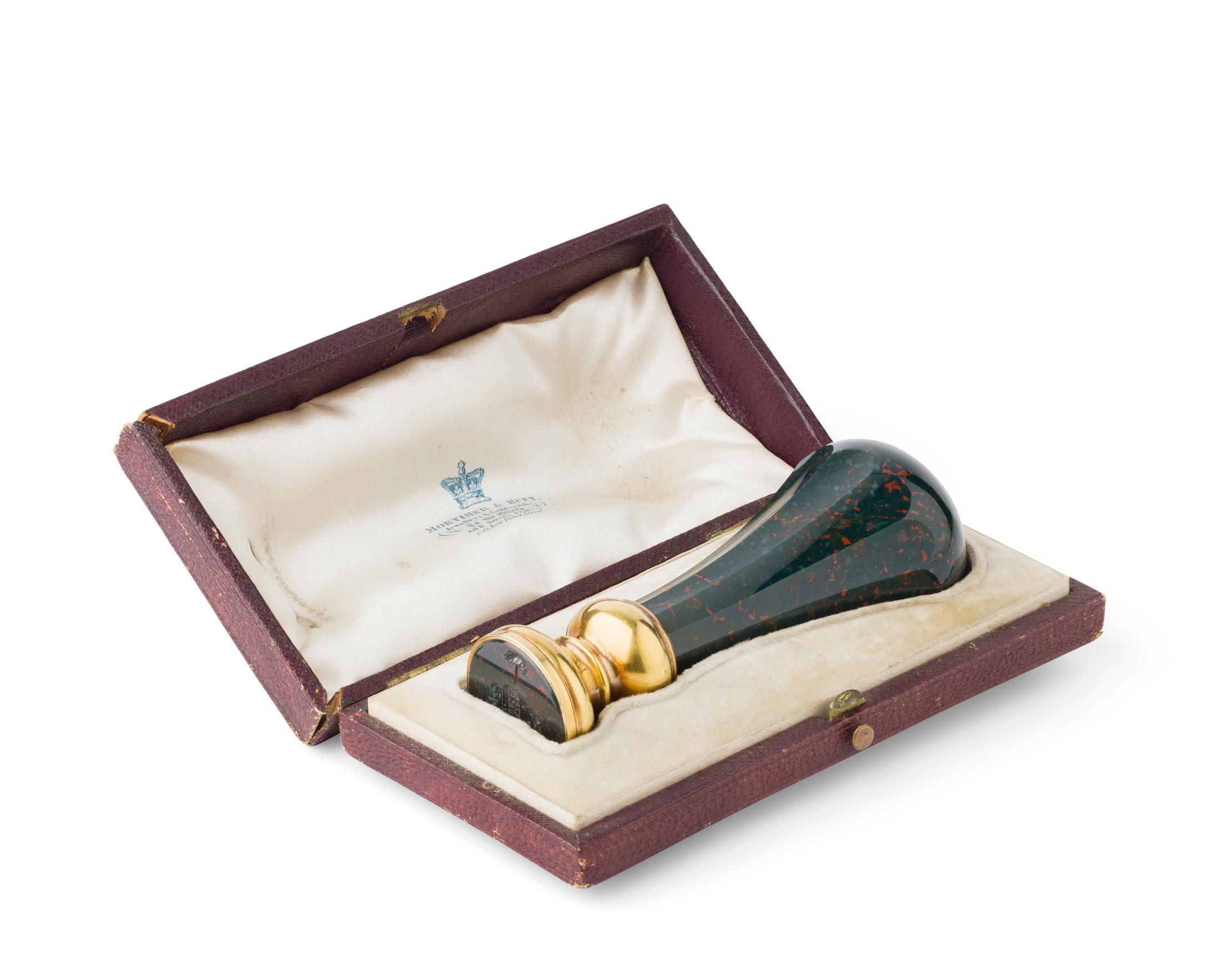
Length: 92mm, matrix: 22mm diameter
Heraldry: The arms as engraved upon the matrix are those of the family of Balfour impaling Gascoyne-Cecil. These armorial bearings undoubtedly commemorate the marriage of James Maitland Balfour of Whittingehame in the County of East Lothian and of Strathconan in the County of Rosshire (born 5th January 1820, died 23rd February 1856) and Lady Blanche Mary Harriet Gascoyne-Cecil (born 1825, died 16th May 1872).
£1,000-1,500
22
23
273 Other fees apply in addition to the hammer price: see the ‘Buyer’s Guide’ section on page 2
A FINE EARLY VICTORIAN SCOTTISH THREE-COLOUR GOLD AND SMOKEY QUARTZ DESK SEAL, CIRCA 1840 the tapered facetted handle with a gold foliate border, above a facetted spherical smoky quartz bead in chased acanthus mounts, the matrix with engraved crest in a domed mount with applied flower heads and foliate borders in vari-coloured gold, in a later fitted case Length: 75mm, matrix 18mm x 16mm

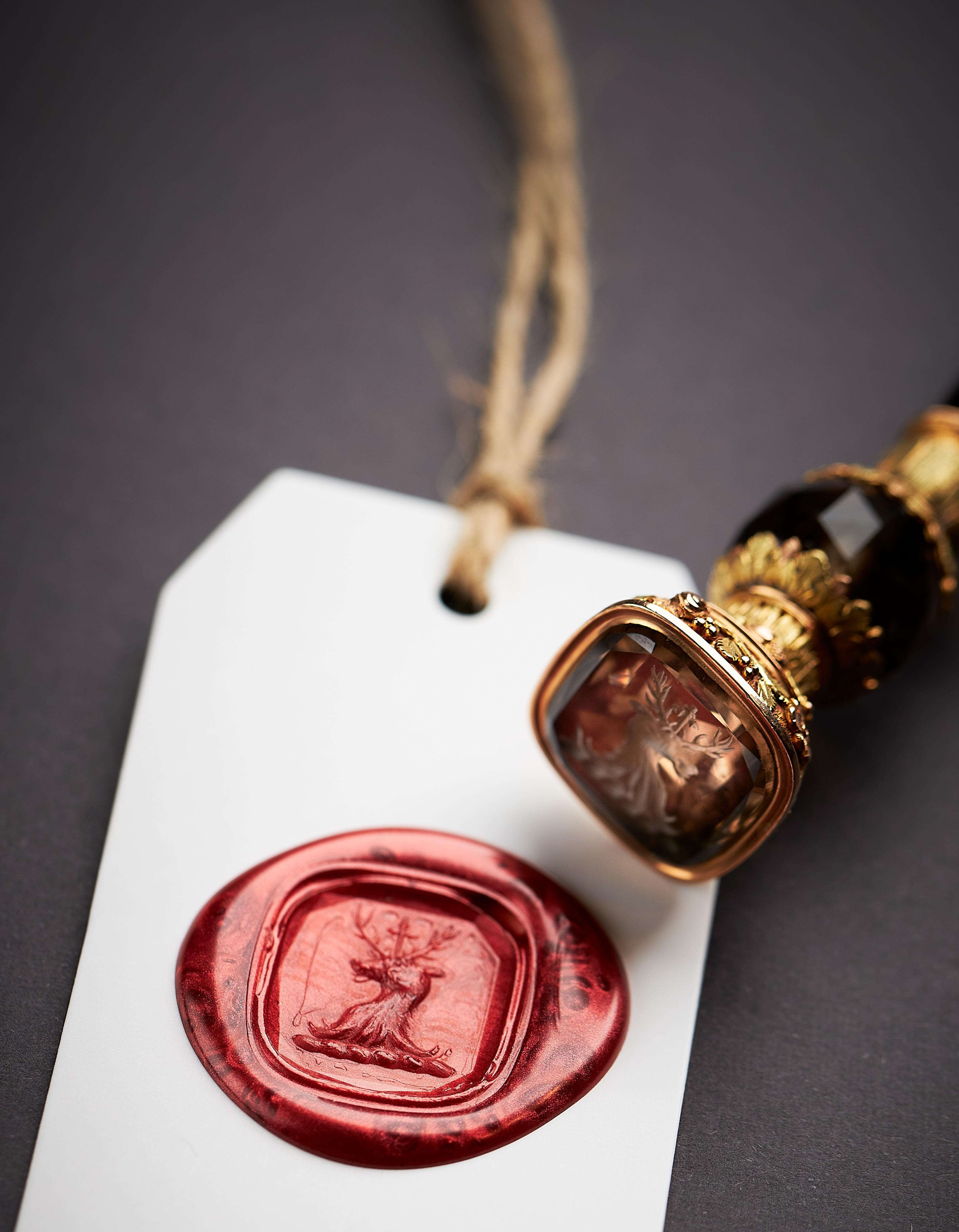
Provenance: David Lavender, London
Note: The crest of a stag’s head erased with a cross ditched between naturals is used by various Scottish families, including Cairns, Crawford of Ayrshire and others. Without a motto, it has not been possible to identify a specific family
£2,000-3,000
24
274
THE CHEAPES OF STRATHTYRUM, LATHOCKAR HOUSE SEAL
A GEORGE IV CORAL, GOLD AND AGATE SEAL, CIRCA 1830
the naturalistic coral branch stem set with twin matrices, the upper mount formed as an eagle’s claw enclosing an oval banded agate seal with script engraving Lathockar, the other outlined with a trailing foliate mount with crest and motto in garter
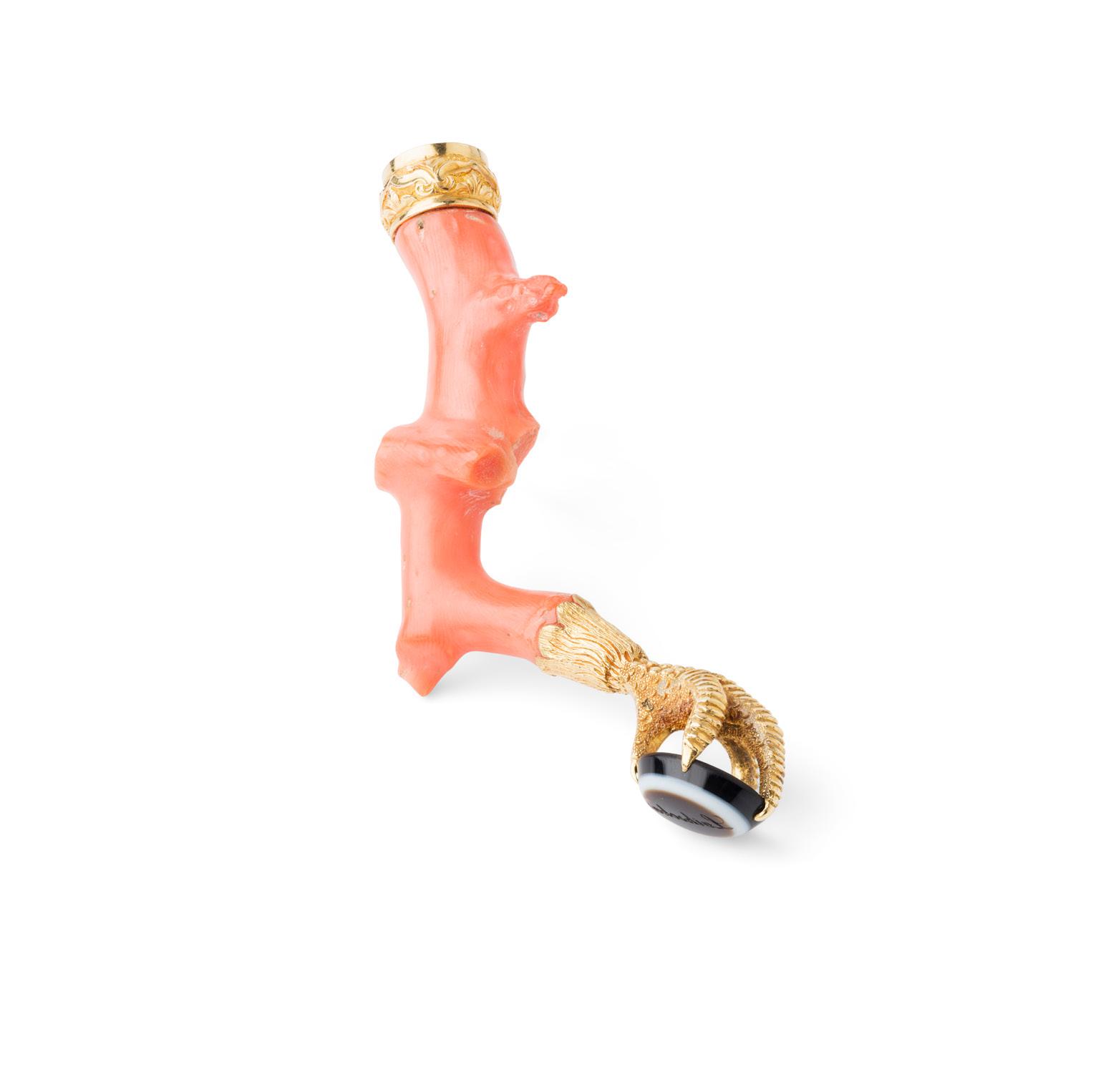
Length: 76mm, matrices diameter: 11mm x 10mm and 7mm
Note: Lathockar House, now a ruin, is three miles from Lathones in Fife Scotland
£400-600
DUKE OF BUCCLEUCH AND QUEENSBERRY FOB SEAL
AN EARLY VICTORIAN SILVER AND CARNELIAN FOB SEAL, CIRCA 1845
the simple silver seal mounted in silver with reeded suspension loop, the rectangular carnelian matrix with arms of Scott with Marquis coronet above Length: 25mm, matrix; 14mm x 20mm
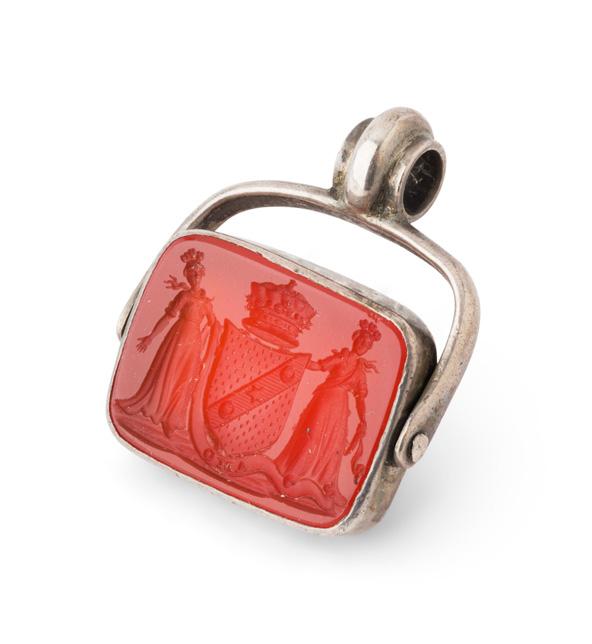
Heraldry: The Arms of Scott, Duke of Buccleuch and Queensberry
Arms: Or on a bend azure a mullet of six points between two crescents of the field
The arms appear to be ensigned with a coronet of a marquess/marquis in error whereas it should be the coronet of a Duke. Supporters: Two female figures habited from the waist downwards in blue kirtles gathered up at the knees the arms and bosoms uncovered around the shoulders flowing mantles vert suspended by the exterior hand girdles and sandals gules and their heads adorned with a plume of three ostrich feathers argent
Walter Francis Montagu Douglas Scott, the 5th Duke of Buccleuch and 7th Duke of Queensberry (born 25th November 1806 died 16th April 1884).
Walter was the fifth child of seven, and second son of Charles Montagu-Scott, the 4th Duke of Buccleuch and 6th Duke of Queensberry and his wife, The Honourable Harriet Katherine Townshend, the youngest daughter of Thomas Townshend, the 1st Viscount Sydney and his wife, Elizabeth Powys. Walter when Earl of Dalkeith, he succeeded his father as to the Dukedoms of Buccleuch and Queensberry on the 20th April 1819 when aged thirteen.
He married Lady Charlotte Anne Thynne, the youngest daughter of Thomas Thynne, the 2nd Marquess of Bath and his wife, The Honourable Isabella Elizabeth Byng, the daughter of George Byng, the 4th Viscount Torrington and his wife, Lady Lucy Boyle at the Parish Church of St George, Hanover Square, Westminster in the County of Middlesex on the 13th August 1829. He was educated at Eton College and at St John’s College, Cambridge.
In the House of Lords, the duke sat on the Conservative benches and was appointed as a Member of Her Majesty’s Privy Council in 1842. He served as the Lord Privy Seal from 1842 to 1846 and as the Lord President of the Council from January to July 1846 in Sir Robert Peel’s administration. The duke was appointed the Colonel of the Edinburgh Militia on the 6th January 1842 and he was further appointed an Aide-de-Camp to Queen Victoria for the militia on the 19th March 1857. He was appointed as a Knight of the Garter in 1835.
Walter had also been elected as a Fellow of The Royal Society in June 1883 and became the Chancellor of the University of Glasgow in 1878, an office which he held until his death in 1884. As an aside, the Duke also enjoyed playing cricket so much, that he played in at least two first-class cricket matches for Marylebone Cricket Club.
£150-180
A SCOTTISH HARDSTONE FOB SEAL, ARMS OF HILL OF LAMBHILL, CIRCA 1790

the handle formed of four scrolling arms to a lion mask terminal, the oval chalcedony matrix with armorial and motto VERITAS SUPEROBIT MONTES
Length: 42mm (overall), matrix: 28mm x 24mm
£300-500 28
A COMMEMORATIVE ACT OF UNION 1707 FOB SEAL
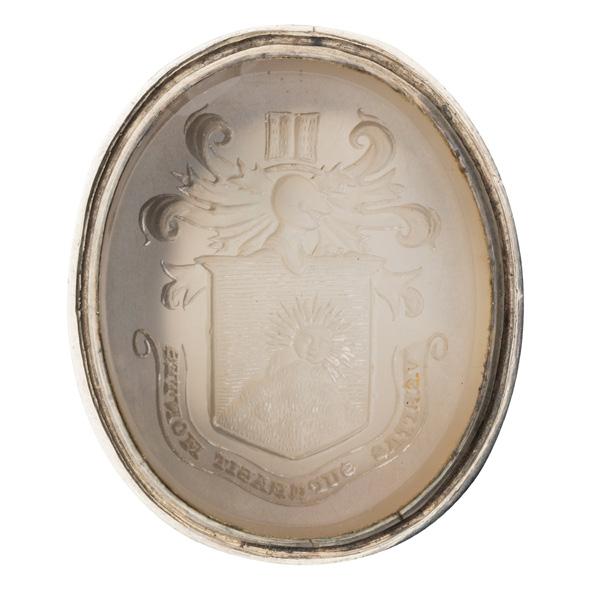
AN EARLY 18TH-CENTURY STEEL SWIVEL FOB SEAL

the stem formed of acanthus and scroll detail branches, the triple face with a depiction of a soldier, a rampant lion and a thistle and rose below a crown and UNITED Height: 50mm, matrix: 26mm x 13mm approx
£300-500
26
25 Y
27
275 Other fees apply in addition to the hammer price: see the ‘Buyer’s Guide’ section on page 2
A 19TH-CENTURY SILVER-MOUNTED AGATE DESK SEAL
the agate handle of facetted form, to a silver mounted collar with engraved foliate and floral decoration, the agate matrix, of possible Sassanian (6th-2nd BC) origin, of oval outline with an engraved depiction of a stag walking with spread antlers below a crescent moon within a linear border, a probable reference to the Classical mythology Diana the Huntress
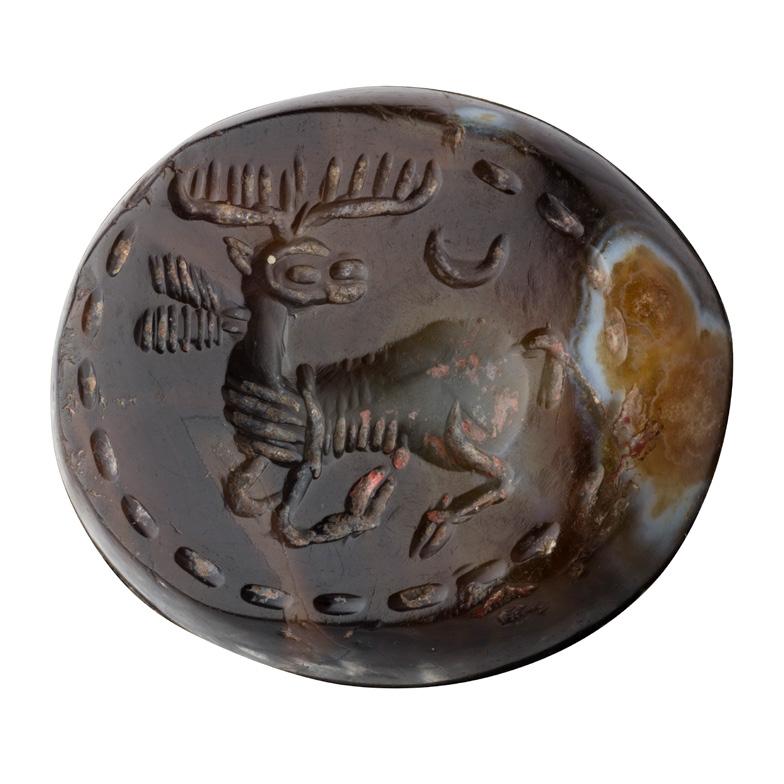
Length: 10cm, matrix: 30mm x 26mm
£400-600
THE CLAN MACAULAY SEAL
A MOTHER OF PEARL SEAL MATRIX of oval outline, with armorial engraved to the disc
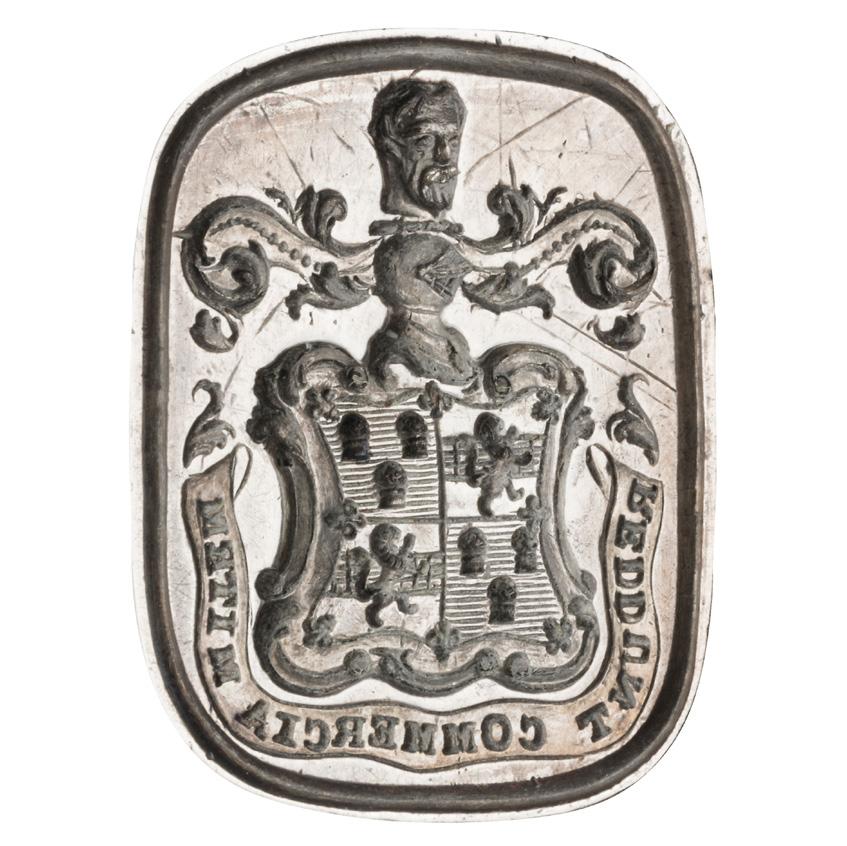
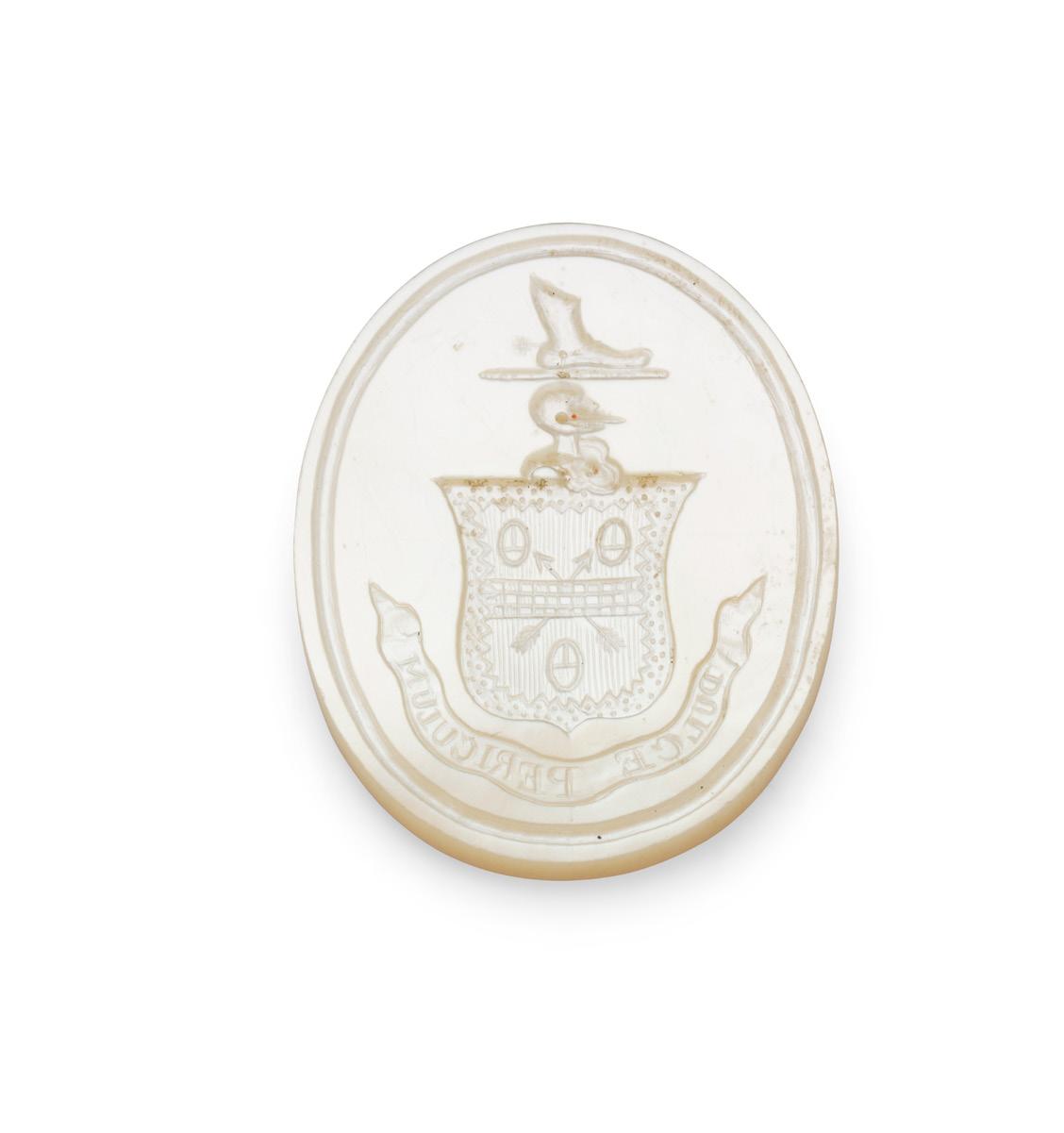
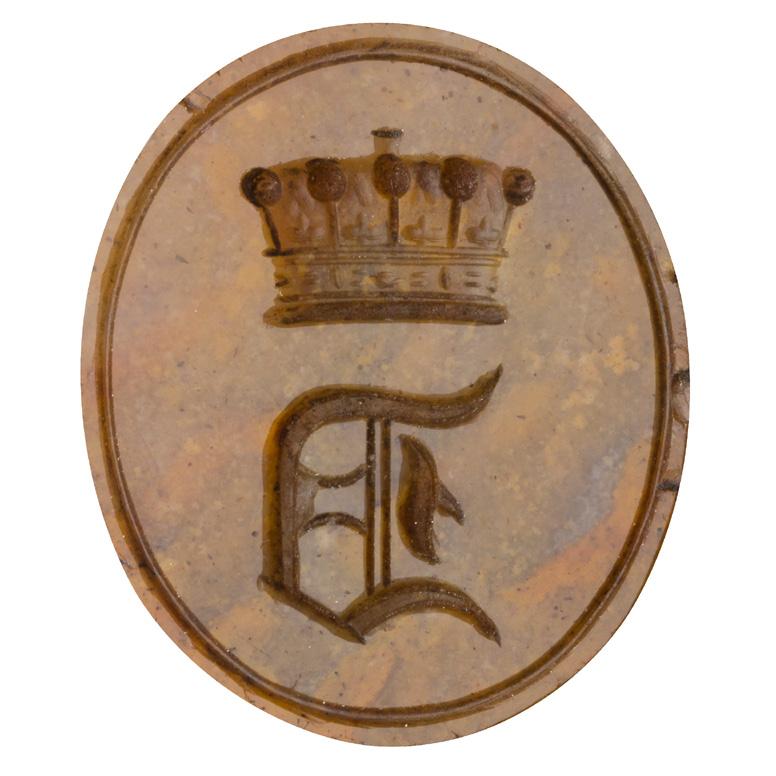
Matrix: 32mm x 24mm
£80-120 31
AN EARLY 19TH-CENTURY MOTHER OF PEARL AND SILVER DESK SEAL
CIRCA 1830
the mother of pearl handle, likely French or Italian, of flattened form with foliate carved details and pommel, the silver matrix with chased Rococo foliate scrolls, engraved with arms of Stewart quartering Comyn
Length: 89mm, matrix: 22mm x 17mm
Note: The arms are for a cadet branch of the Stewart’s of Garth, Perthshire, Scotland. Originally descended from James illegitimate son of Alexander Stewart, 4th son of King Robert II of Scotland, most commonly recognised as Earl Buchan in 1382, and known as the Wolf of Badenoch
£200-300
THE EARLS OF CRAVEN DESK SEAL
AN UNUSUAL LATE 19TH-CENTURY DOUBLE ENDED PEBBLE DESK SEAL
the oval pebble with polished terminals, each engraved, one end with an Earl’s coronet above a Gothic D, the other end, the Earl’s coronet above a crest
Length: 55mm, diameter of matrices: 14mm x 15mm, 15mm x 12mm
Crest: On a cap of maintenance a dragon passant with an Earl’s coronet above
Note: The polished agate pebble reflects the taste of the Victorian era for the natural resources of the rugged landscape that was fuelled by Queen Victoria’s love of Scotland. This can be seen in high quality pebble jewellery and works of art, but also here in a far more simple and tactile manner.
£200-300
29
30
32
276 Other fees apply in addition to the hammer price: see the ‘Buyer’s Guide’ section on page 2
A CROCKETT OF SCOTLAND FAMILY DESK SEAL
A LATE 19TH-CENTURY BANDED AGATE AND BLOODSTONE SEAL
the facetted brown banded agate, of baluster form, to a chased silver mounted collar with four acanthus scroll arms, the bloodstone matrix engraved with the crest and motto HAVE A CARE, presented in a fitted case, the base stamped for ‘BURGER-LEVEQUE/ Graveur/ 64 PALAIS ROYAL 3
Length: 81mm, matrix: 22mm x 17mm
Note: Attributed to a branch of the Scottish family Crockett, who use a variety of mottos including TAK’TENT, TAKE HEED, TAKE CARE, in connection with either a sleeping or walking hound. A Chinese export armorial porcelain dinner service with the motto TAKE HEED with a hound crest made in circa 1785 is recorded for the family
£600-900
AN EARLY VICTORIAN BANDED AGATE GOLD AND BLOODSTONE DESK SEAL, CIRCA 1850
the banded agate handle with domed terminal and facetted stems, the compressed fluted gold terminal enclosing a rounded rectangular matrix engraved Glenavon
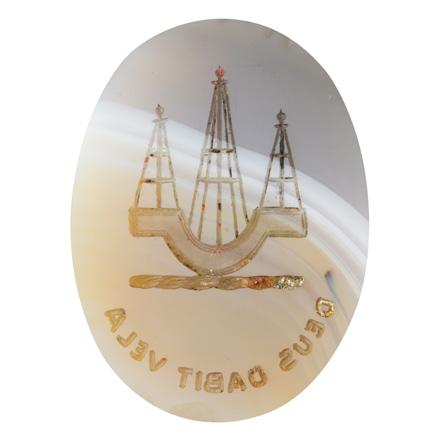
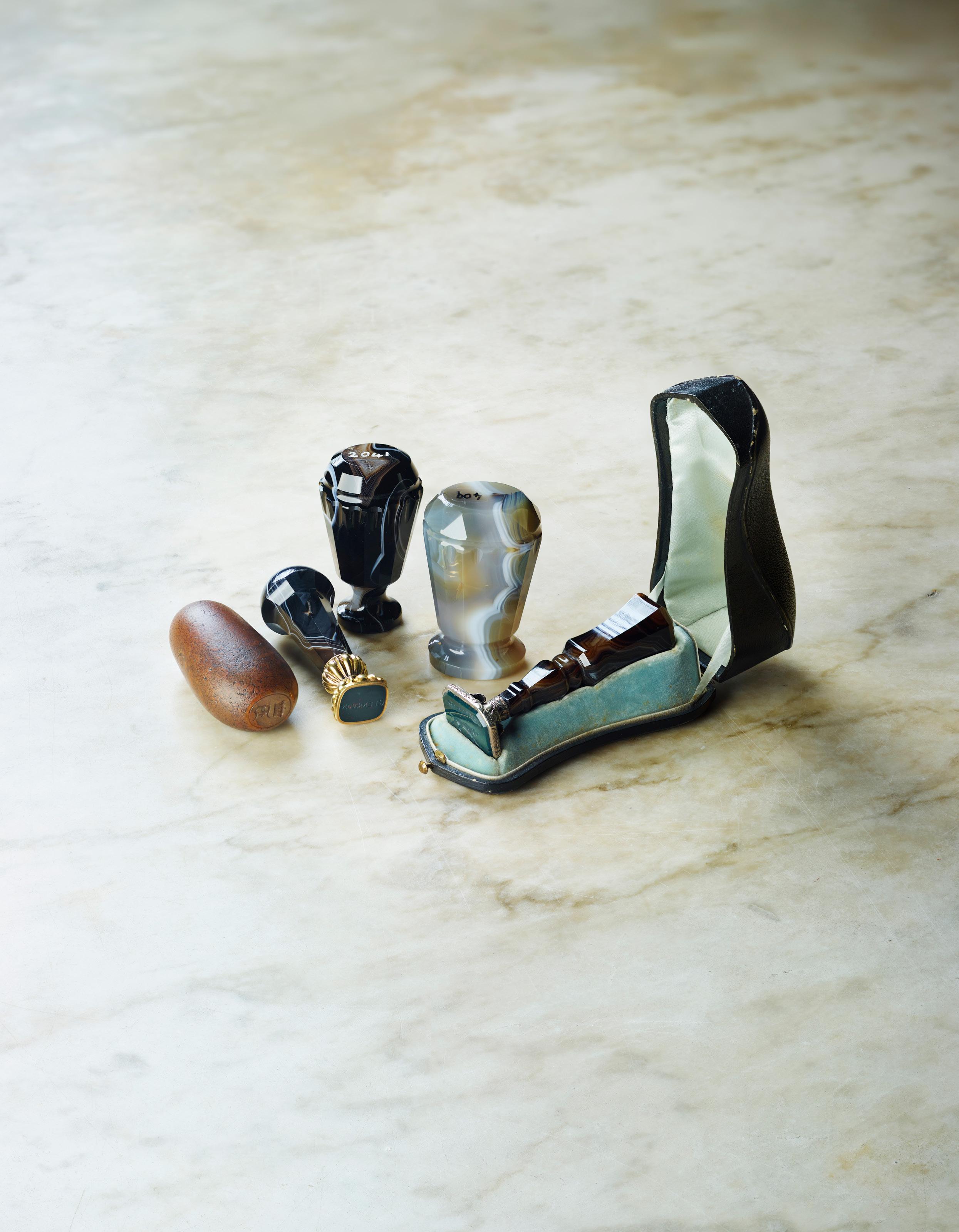
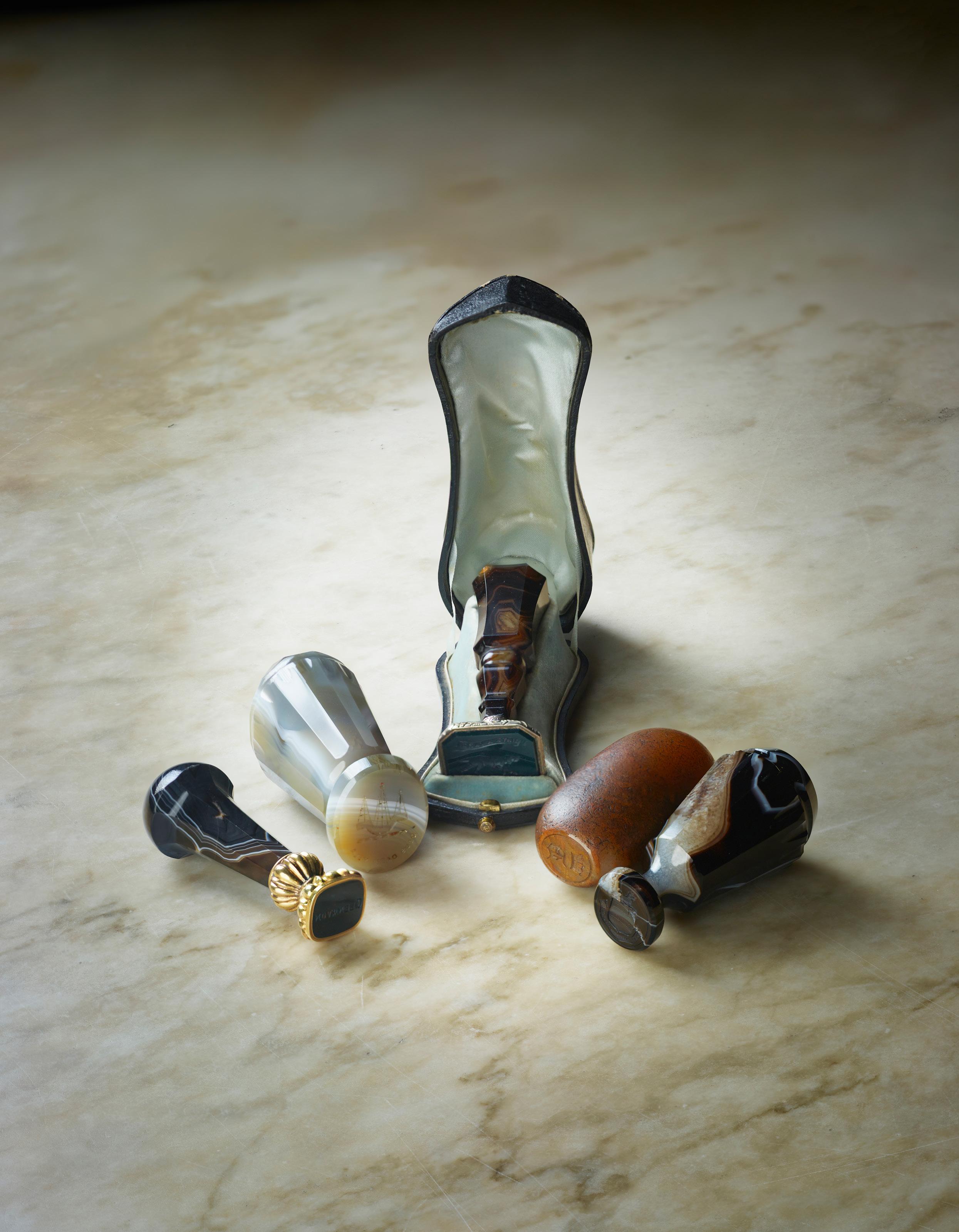
Length: 70mm, matrix: 19mm x 22mm
£300-500
THE TENNANT OF GLENCONNER FAMILY DESK SEAL
A LATE 19TH-CENTURY AGATE DESK SEAL,CIRCA 1890S
the facetted agate handle, the integral matrix engraved with the crest and motto ‘Deus Dabit Vela’
Length: 65mm (overall), matrix: 35mm x 27mm
£200-300
THE LANCASTER FAMILY SEAL
A VICTORIAN BANDED AGATE DESK SEAL, CIRCA EARLY 20TH CENTURY the banded agate seal with facetted tapered handle with waisted neck, the oval matrix with armorial shield surmounted by crest with motto in banner below

Length: 70mm, matrix: 24mm x 20mm
Heraldry: Arms: Argent two bars gules on a canton of the second a cinquefoil (……?)
Crest: A lion couchant (……?)
Motto: Ornat fortem prudentia [Prudence adorns the brave]
Upon the balance of probability and without any evidence to the contrary this seal was at one time in the possession of a gentleman of the Lancaster family.
£200-300
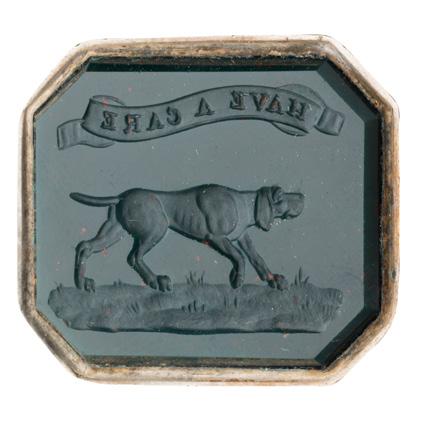
33
35
34
36
277 32 33 34 35 36
A VISCOUNT’S AGATE AND GOLD MOUNTED DESK SEAL, CIRCA 1840S
the agate handle with domed terminal and of tapering form, within a fretted collar with phoenix birds and scroll-work decoration, the escutcheon-shaped matrix engraved with a Viscount’s coronet above a cypher of two Ms
Height: 76mm, matrix: 23mm x 15mm
£1,000-1,500 38
THE JUCKES FAMILY DESK SEAL
A MID / LATE 19TH-CENTURY BANDED AGATE DESK SEAL

the facetted banded brown agate handle of baluster form, double ended with the engraved coat of arms to the base and the crest to the top

Length: 67mm, matrices: 18mm x 14mm, 22mm x 20mm
Note: The family of Juckes with these arms is recorded as quartering the arms of Clifton (not shown on this shield) for which family a baronetcy was created in 1611.
The 8th Baronet, Sir Juckes-Granville Clifton, assumed the additional surname of Juckes died in 1852; the baronetcy became extinct with the death of his son in 1869. This seal would have been made for a close relative (although not a Clifton descendant)

£150-250
39
A SCOTLAND AND ENGLAND UNION-ASSOCIATED DESK SEAL
AN 18TH-CENTURY PURPURINE DESK SEAL
the facetted glass handle with gold mounted button terminal with pierced initials M/A/M/A, the applied collar with pierced thistles and roses, to a green hardstone seal with engraved armorial
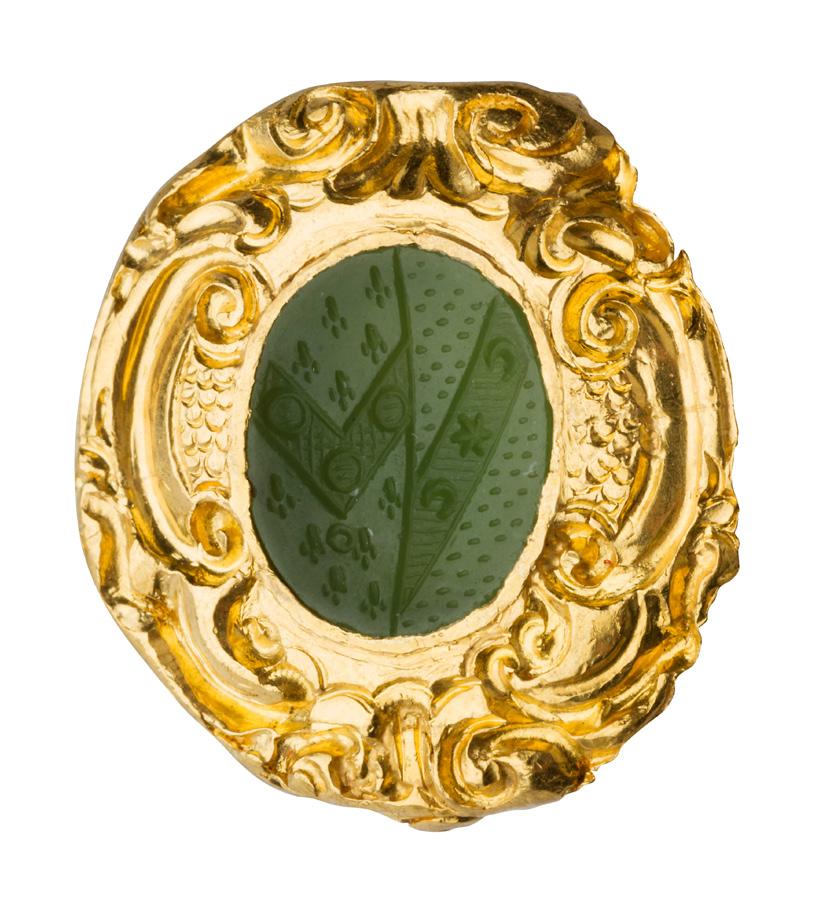
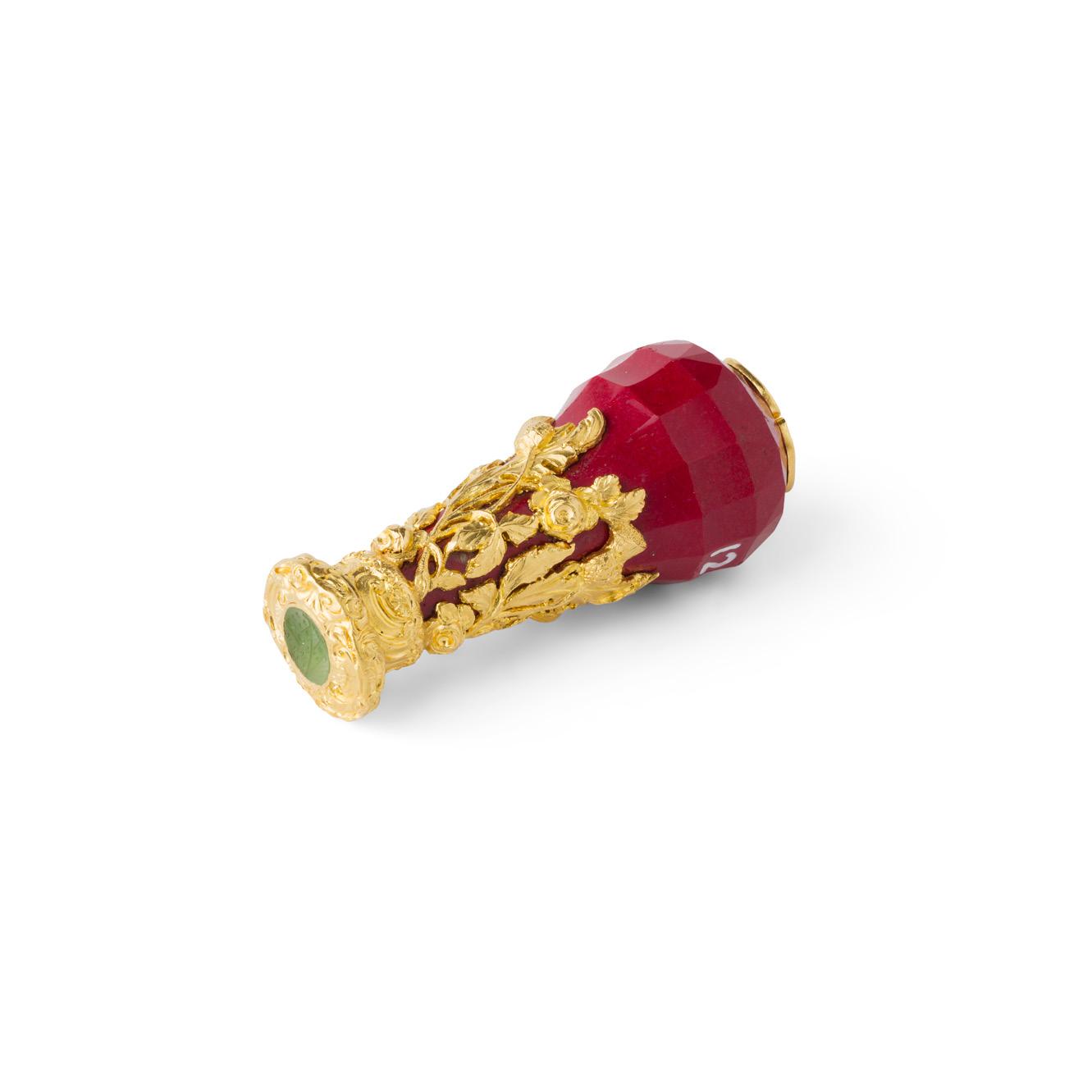
Length: 50mm, matrix: 6mm x 8mm
£800-1,200
37
278
THE SEATON HOUSE SEAL
A VICTORIAN SCOTTISH AGATE AND GOLD DESK SEAL
the facetted red banded agate baluster handle with foliate scroll terminals enclosing a black banded agate matrix engraved Seaton House Arbroath
Length: 65mm, matrix: 12mm x 10mm
£250-350
41
A SCOTTISH MATHIESON FAMILY DESK SEAL
AN EDWARDIAN SILVER GILT AND HARDSTONE SEAL, BY GEORGE PAUL, EDINBURGH 1908
the tapered silver-gilt handle profusely engraved with scroll and foliate detail, collet set with various gemstones to the terminal and inset with diamond-shaped hardstones to the stem, to a domed collar, the silver-gilt matrix with engraved crest
Length: 85mm, matrix: 21mm x 19mm
Note: Believed to be the personal seal of the 2nd Baron Mathieson
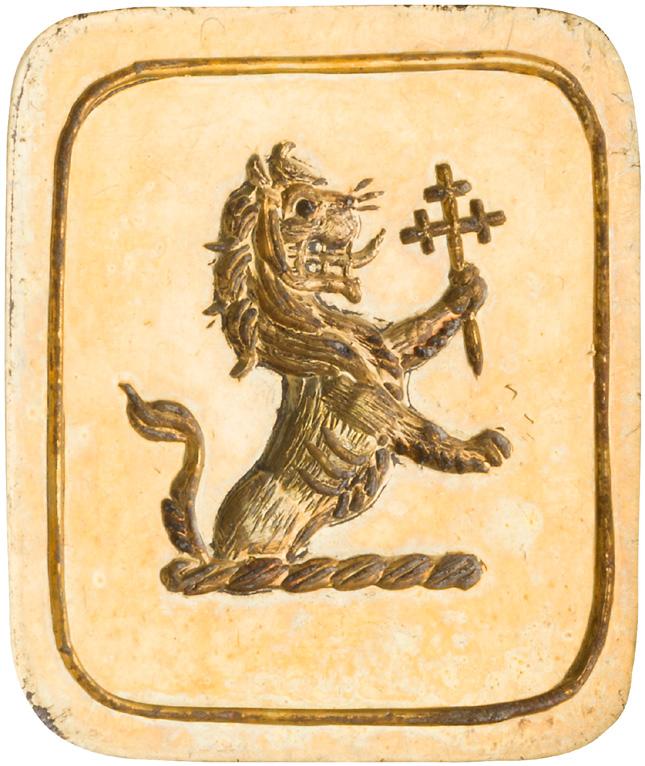
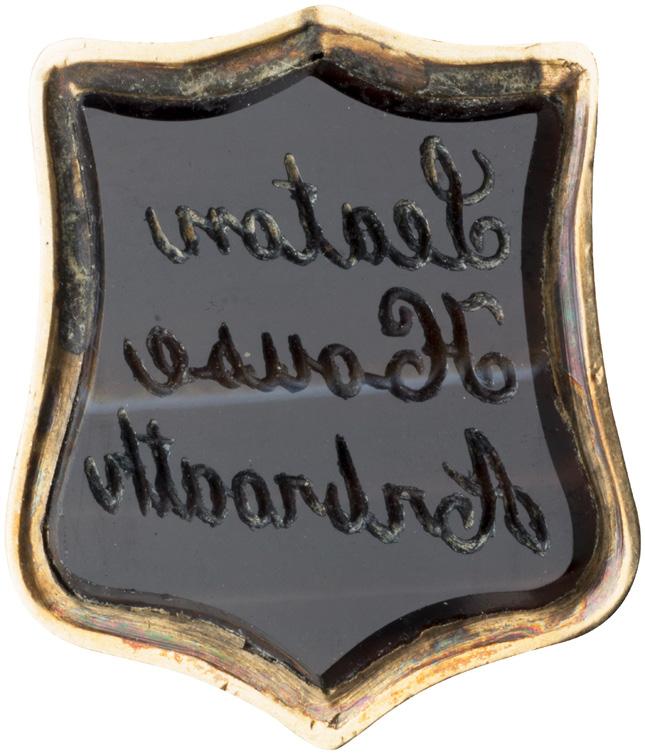
£300-500
THE MORISON OF DAIRSIE CO. FIFE FAMILY DESK SEAL
AN EARLY VICTORIAN AGATE DESK SEAL
the facetted agate handle to a gold fluted collar with shell and floral borders, the rounded rectangular chalcedony matrix engraved with armorial
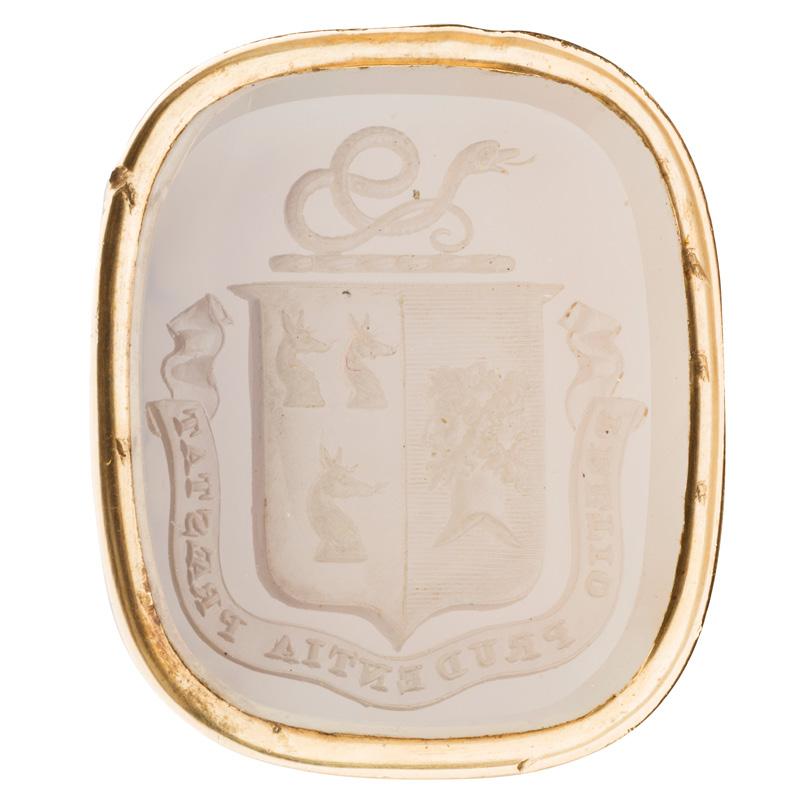
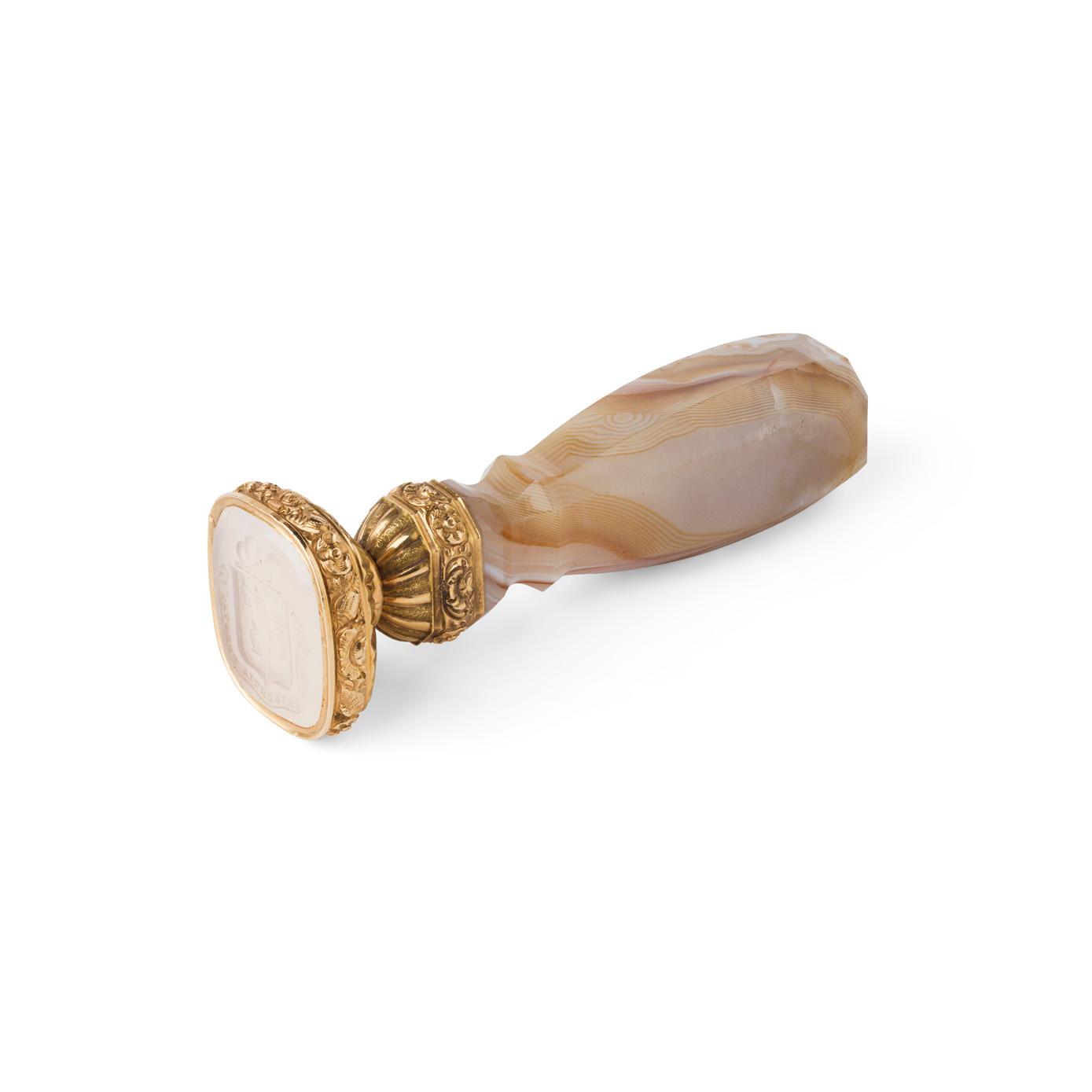
Length: 80mm, matrix: 21mm x 23mm
£1,200-1,800
40
42
279 Other fees apply in addition to the hammer price: see the ‘Buyer’s Guide’ section on page 2
A FAMILY DESK SEAL - CRIMONMOGATE HOUSE, BUCHAN ABERDEENSHIRE
A LATE 18TH-CENTURY WOODEN AND BRASS DESK SEAL
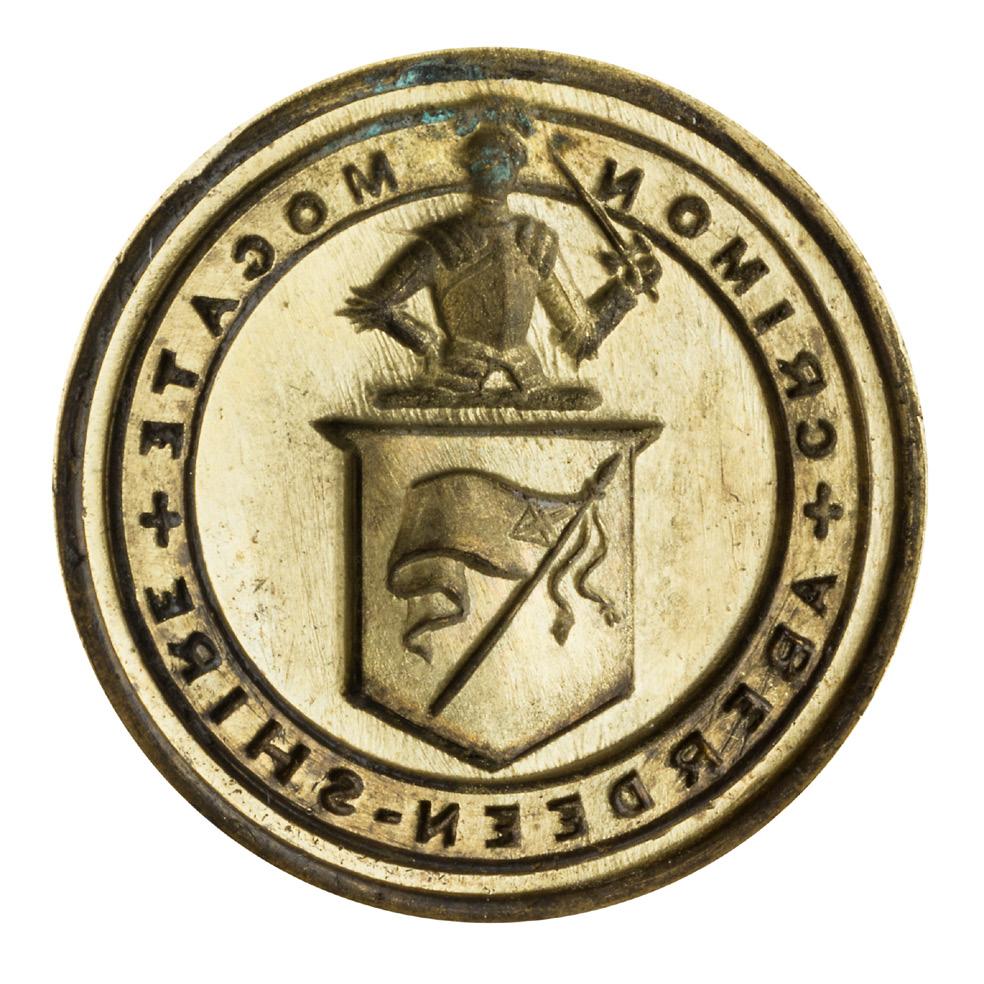
the wooden handle of baluster form, to a brass collar and matrix, engraved with armorial and legend in a border Length: 9cm, matrix diameter: 12mm

£300-500 44
A LATE 18TH-CENTURY EBONY AND STEEL DESK SEAL
the turned tapered ebony handle with socket attached, oval steel matrix with crest and motto for Murray
Length: 95mm, matrix: 18mm x 8mm
£120-180
45 Y
A VICTORIAN BOG OAK, IVORY AND BRASS DESK SEAL, CIRCA 1870
the carved wooden handle formed as a lady’s head with hood, the face formed from carved ivory, the simple brass socket set with shield-shaped matrix with armorial and motto

Length: 96mm, matrix 37mm x 30mm
Note: Although the arms in this format are not officially recorded, it would appear to be a slightly altered arms of a branch of the Crierie, Kriery or M’Crie of Scotland
With non-transferable CITES selfcertification number: B3RECNKV £250-350
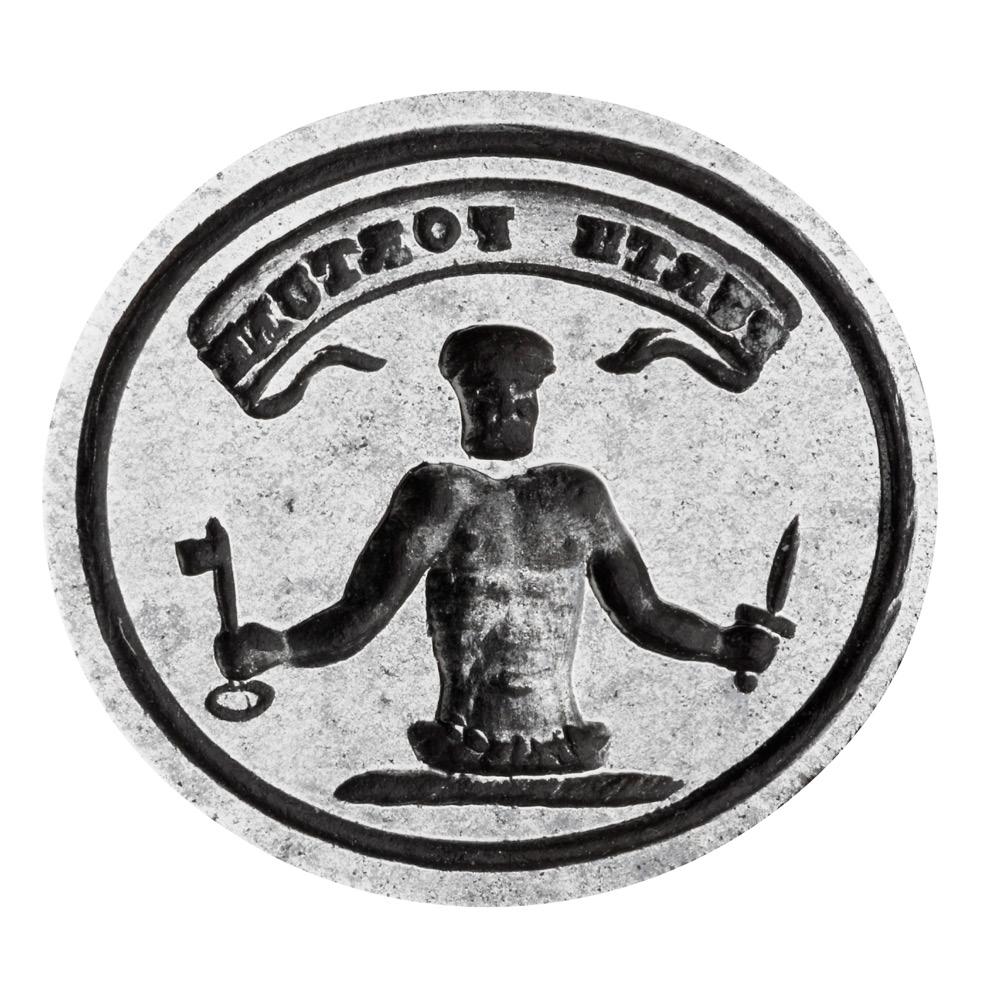
43
280 Other fees apply in addition to the hammer price: see the ‘Buyer’s Guide’ section on page 2
THE CLAN MENZIES DESK SEAL
A VICTORIAN LABURNUM, SILVER AND AGATE DESK SEAL, CIRCA 1870S
the laburnum handle of baluster form, to a simple threaded silver mounted collar, the oval matrix with the arms of Menzies
Length: 95mm, matrix: 26mm by 24mm
Note: Given the suspected age of this seal, it was probably in the possession of two successive chiefs of the clan Menzies, namely Sir Robert Menzies in the county of Perthshire (1817 to 1903), the seventh Baronet of Menzies or his son, Sir Neal James Menzies, the eight and last Baronet of Menzies (1855 to 1911)

The baronetcy fell into extinction on his death for want of a male heir. The clan is said to have descended from a mythical ‘Scottish’ King Mainus of 33BC, but is perhaps ill-founded and the clan arrived in Scotland following the 12th century Norman arrival and are descended from Robert de Maineriis of Mesnieres near Rouen in Normandy.
The first chief was Sir Robert de Meyneris, who became Chamberlain to King Alexander II in 1249 and received lands in exchange for his military service. It was in 1488 that his descendant Sir Robert Menzies built ‘The Place of Weem’, and maintained their stronghold in Strathtay for over four hundred years. They managed to maintain their standing and possessions until the estates, the Castle, and its contents were auctioned off to pay outstanding debts in 1914. With the extinction of the main line the Clan was left without a Chief on the death of Sir Neil Menzies in 1910.
In 1957 the descendants of the cousin of the first Baronet were successful in petitioning Lord Lyon King of Arms to be recognised as being allowed to use the arms of Menzies. The current Chief is Captain David Steuart Menzies of Menzies.
£500-800
47
THE CHISHOLM SILVER DESK SEAL
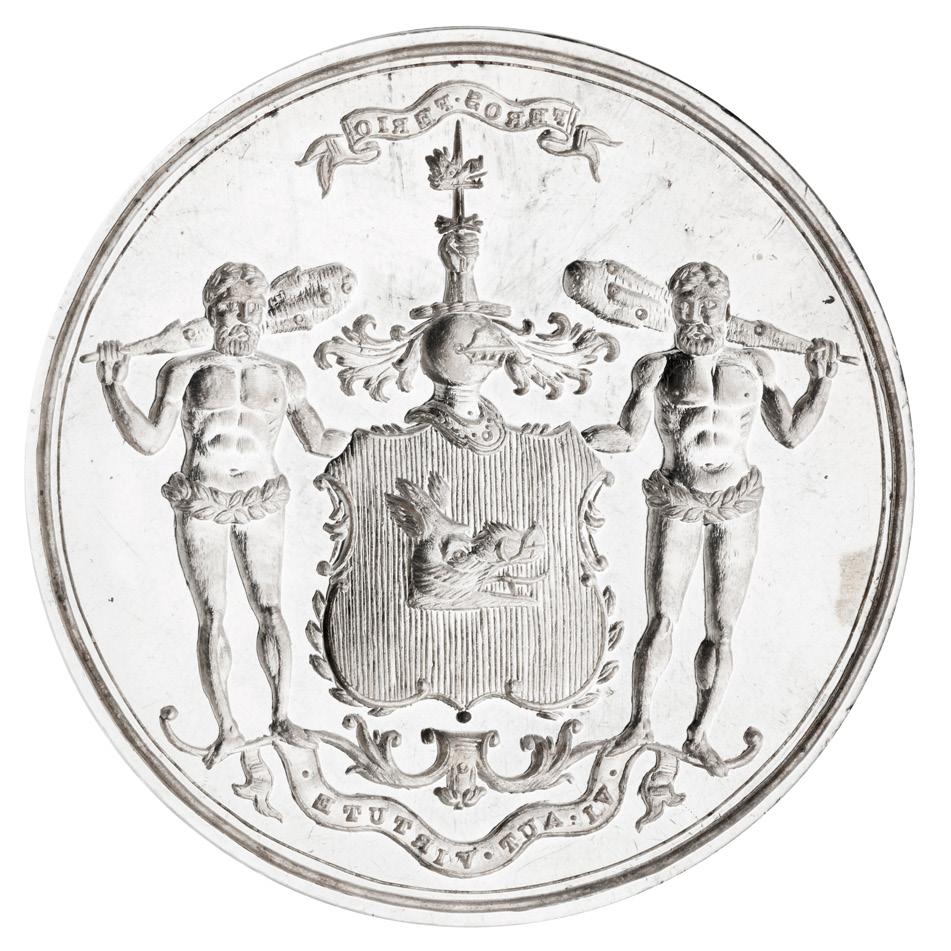
A LARGE MID-VICTORIAN SILVER DESK SEAL, CIRCA 1870 the naturalistic vine leaves trailing around an architectural column forming the handle, the domed integral matrix with scroll foliate mount, the matrix engraved with arms and supporters
Length: 75mm, matrix: 45mm diameter
Heraldry: Arms: Gules a boar’s head erased argent Crest: A dexter hand holding a dagger erect proper on the point a boar’s head couped gules
Supporters: Two savages wreathed head and middle with laurel with clubs over their shoulders proper
Mottos: (above the crest) Feros ferio [I strike the fierce] (below the arms) Vi aut virtute [By strength and valour]
£800-1,200
A SCOTT-TOLLEMACHE FAMILY DESK SEAL
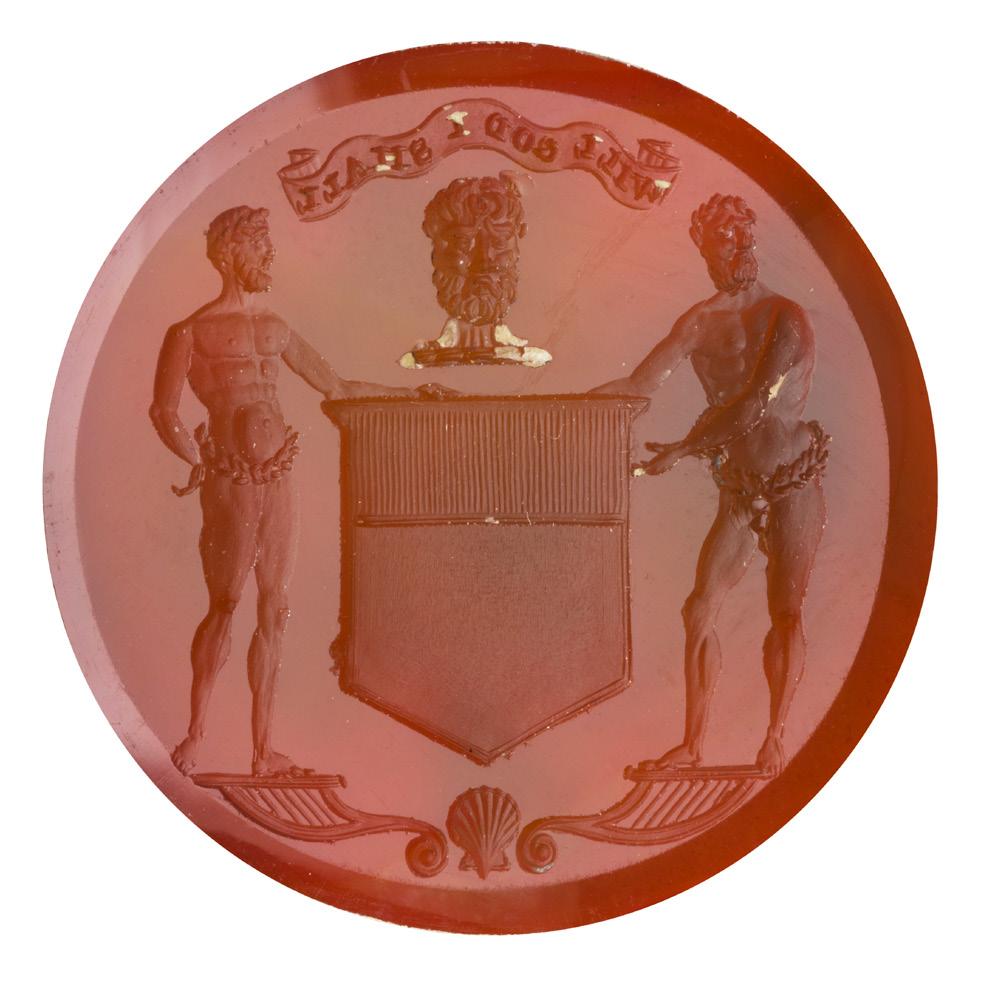
A MID / LATE 19TH-CENTURY SILVER-GILT DESK SEAL
the flared cast handle with high-relief depictions of soldiers in battle with a rope twist border, the circular matrix engraved with the arms of Scott impaling Tollemache
Length: 77mm, matrix diameter: 20mm
Provenance: Matrix: A Collection of British Seals - David Morris 2012
- Seal 28, page 72
Note: The seal was made for Charles Norman Lindsay Tollemache Scott, JP for the Stewartry of Kirkcudbright and JP for Leicestershire
Born in 1853, the eldest son of John Lindsay Scott of Mollance, he married in 1882, Lady Agnes Tollemache, daughter of the 8th Earl of Dysart. Their only daughter, Wenefryde Agatha succeeded her uncle, the 9th Earl of Dysart as Countess Dysart in her own right in 1935, it being a Scottish title and heritable in females. The baronetcy and the entailed estates went to a cousin, Sir Lyonel Tollemache.
£1,200-1,800
46
48
281
A MACLAGAN FAMILY DESK SEAL

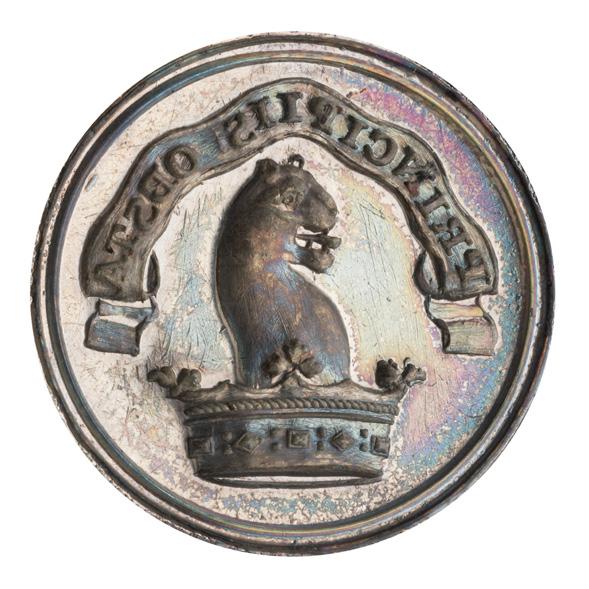

AN EARLY 19TH-CENTURY TREEN AND SILVER MOUNTED DESK SEAL
the wooden handle formed as an arm clutching a boot in its hand, to a silver collar and matrix, the circular matrix with engraved crest and motto
Length: 7cm, matrix diameter: 22mm
Heraldry: Crest: Out of ducal coronet, an ounce or beaver’s head proper Motto: PRINCIPIIS OBST
The motto is recorded for three families, of whom only one uses a similar crest, Maclagan of Edinburgh
£120-180
50
THE GLENAY FAMILY DESK SEAL
AN EARLY 18TH-CENTURY EBONY DESK SEAL
the flared ebony handle to a silver mount with threaded collar, the armorials engraved to terminal

Length: 85mm, matrix: 22mm x 25mm
£400-600
51 Y
THE EDMONSTONE FAMILY DESK SEAL
A SILVER MOUNTED TOOTH DESK SEAL, BY ASPREY & CO, LONDON 1930 the tooth with an applied silver collar, with pierced sides, the integral oval seal with an engraved crest above a heraldic shield, engraved to the sides
NGAMILAND 15 SEPT 1929
Length: 10cm, matrix: 30mm x 25mm
Note: CITES STATUS: African Lion Panthera leo - CITES Appendix II - Annex B (Added 02/01/2017) [Only the populations of India are CITES Appendix I (26/11/2019); all other populations are included in Appendix II] - Article 10 Exempt as a worked specimen in a finished state before 3 March 1947
This specimen has been carved and fitted inside this desk seal that is clearly hallmarked and dated to 1929 with the location of Ngamiland (a North-West district area of Botswana). The only big cat species large enough for this specimen to have come from is either a lion or a tiger. All species of tiger’s population range were on another continent from Ngamiland in the 1920s as were all populations of the Asiatic Lion, therefore this specimen could only have come from an African Lion. Following the CoP17 summit in Johannesburg in 2017 the trade in lion parts including bones, skins, teeth to trophy heads were banned from current wild populations but historic specimens appear to still be subject to the same jurisdiction as other specimens from Appendix II species. An Article 10 Certificate is not required to own or trade in specimens of species listed on Annex B of the CITES regulations.
£300-600
49
282
THE ADMIRAL SIR WILLIAM EDMONSTONE, 4TH BARONET CB, DL (1810 – 1888) SEAL
A 19TH-CENTURY ROCK CRYSTAL AND BLOODSTONE DESK SEAL
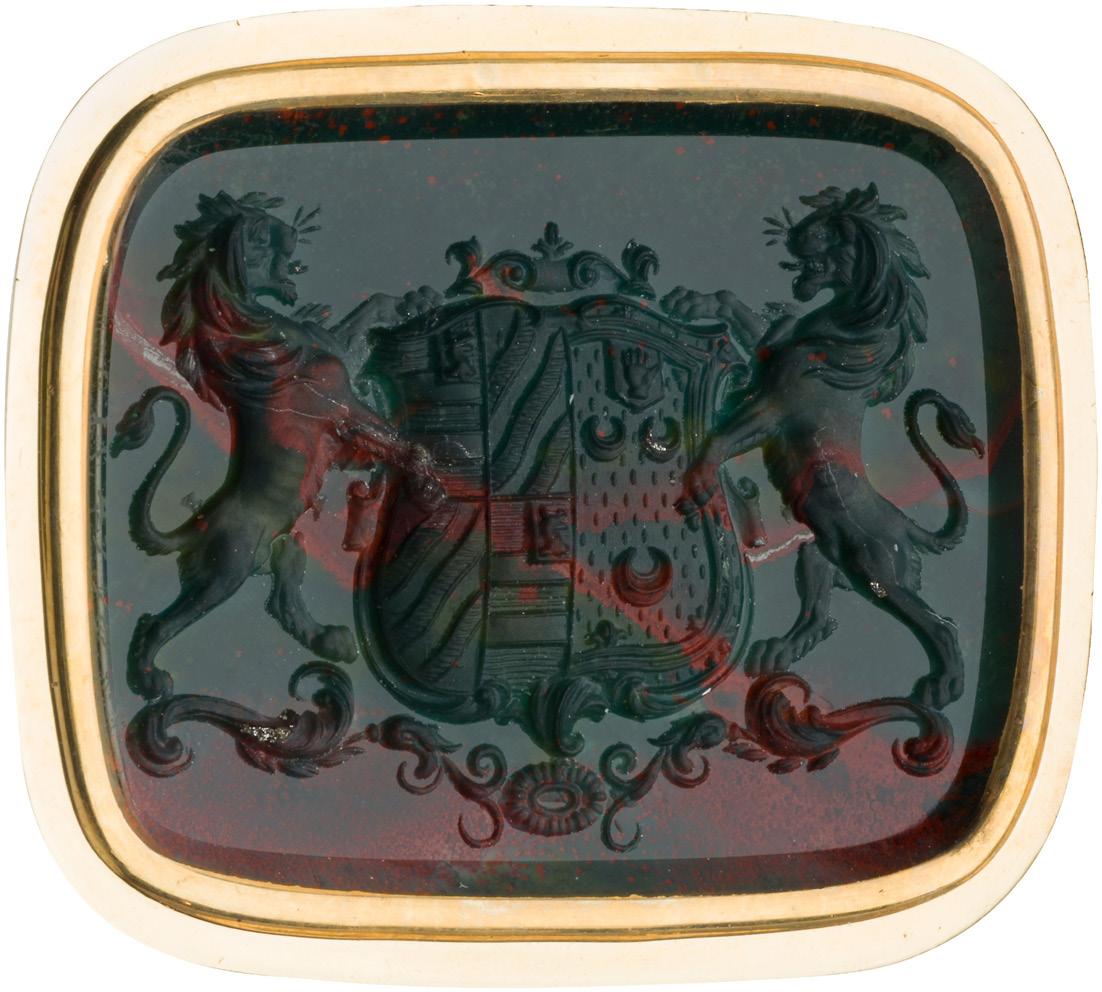
the facetted rock crystal handle of tapering form, to an ornately chased scroll and floral collar, the rounded rectangular bloodstone matrix with the arms of Edmonstone
Height: 8.5cm, matrix: 19mm x 15mm
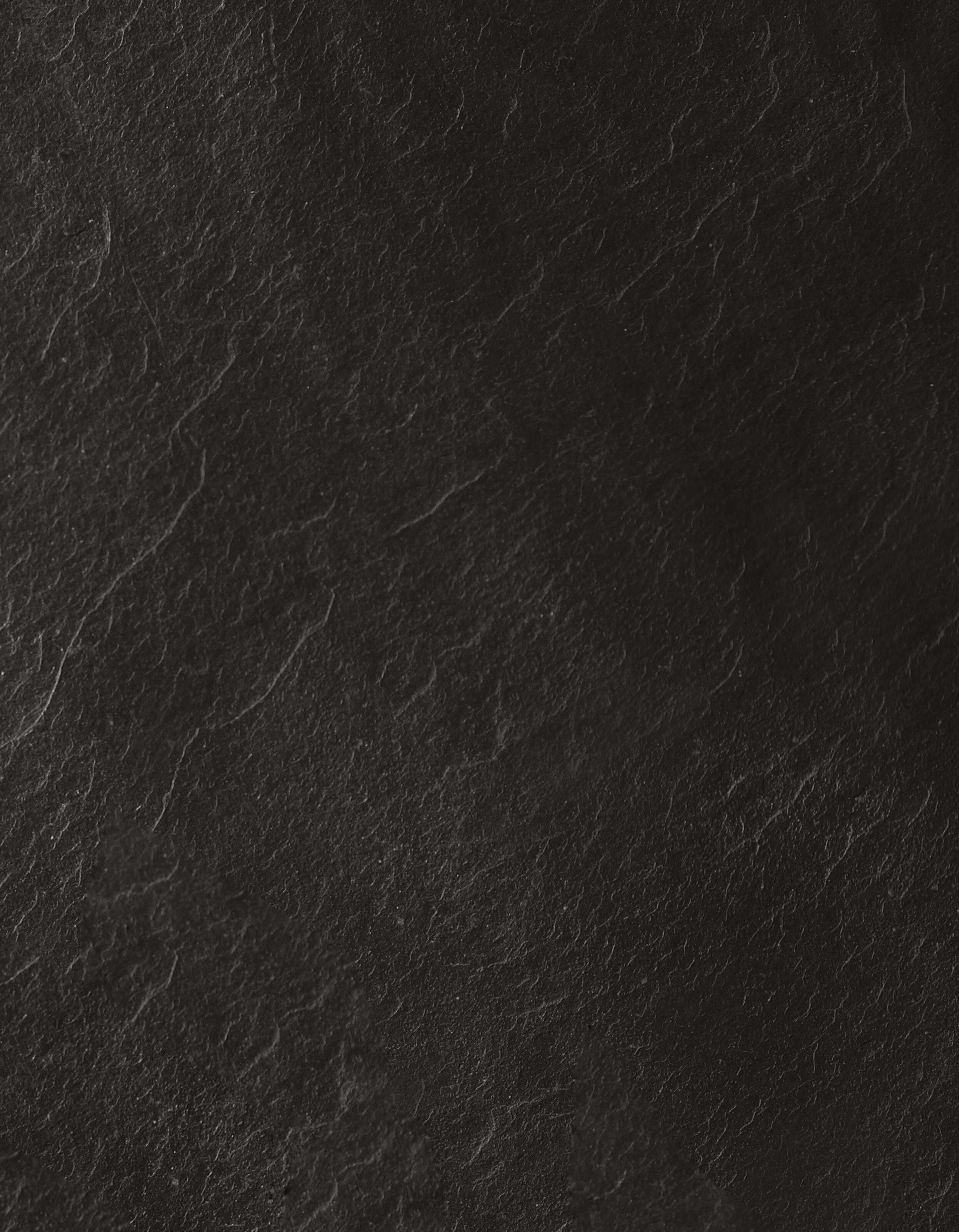
Heraldry: Creation 20 May 1774
Arms: Or three crescents, within a doublet treasure, flory-counterflory gules
Crest: Out of a ducal coronet, or a swan’s head and neck
Supporters: Two lions, rampant
Motto: Virtus auget honorem
Note: Admiral Sir William Edmonstone, 4th Baronet CB, DL (29 January 1810 – 18 February 1888)
Beginning his naval service in his youth, on his return from West Africa he was made an Aide-de-Camp to Queen Victoria and appointed a Companion of the Order of the Bath.
Following his retirement from the navy, he was elected Member of Parliament for Stirlingshire from 1874 to 1880. During this time he stayed at the family seat, Duntreath Castle, Blanefield, Stirlingshire. Other residences include Colzium near Kilsyth, London, and an Edinburgh town house.
Together with his wife Mary Elizabeth Parsons whom he married in Greece, they had eleven children, their youngest daughter Alice Keppel was the mistress of Edward VII.
Succeeded by his son Sir Archibald Edmonstone, 15th of Duntreath and 5th Bt.C.V.O. D.L., Groom in Waiting to H.M. King Edward VII 1907-10. He accompanied the King on his state visit to Leningrad in 1908. A chromolithograph, published in Vanity Fair, on 8th March 1879 by Sir Leslie Ward of Sir William is now in the collection of the National Portrait gallery accession number NPG D43893
£1,500-2,500
THE STEUART OF DALGUISE DESK SEAL
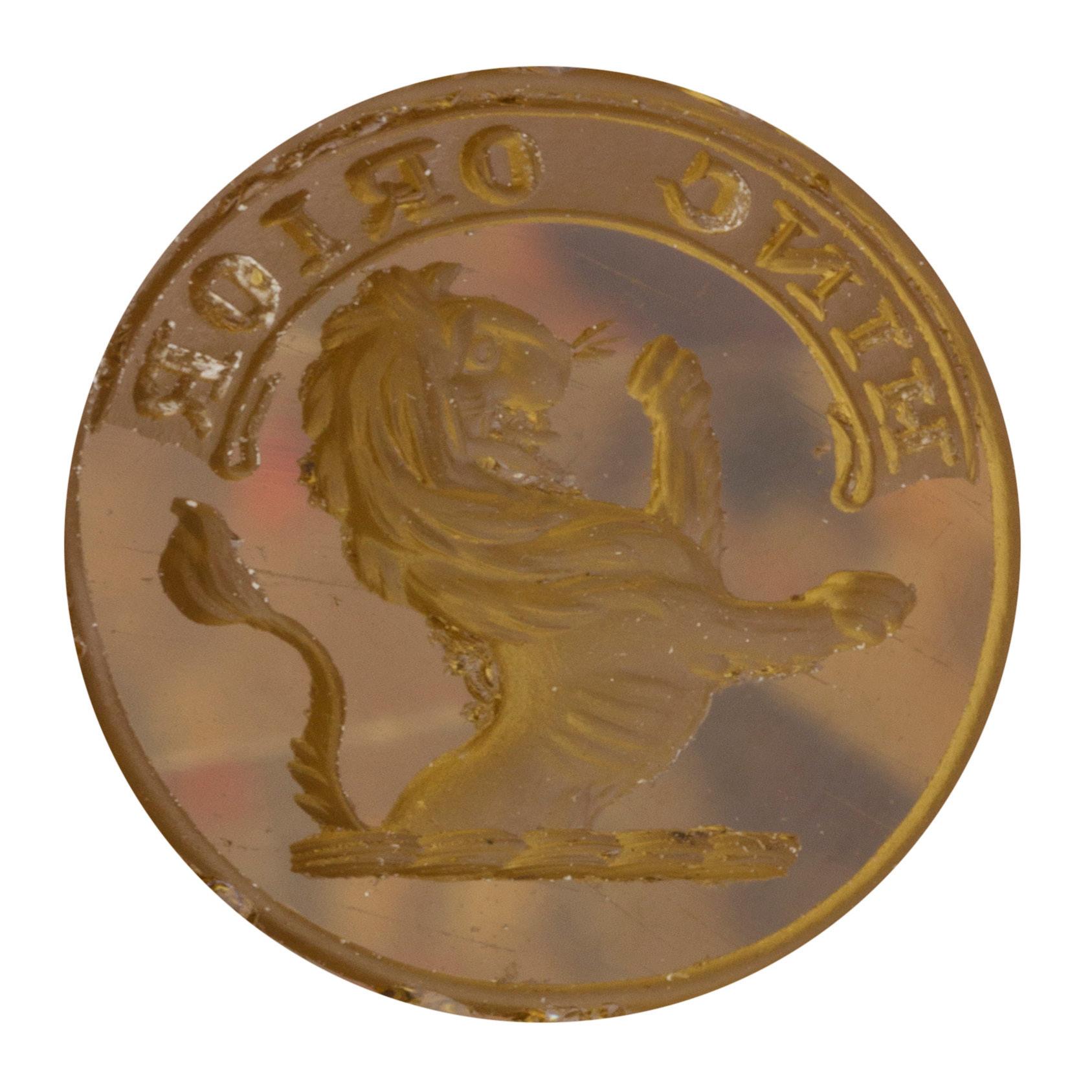
A FINE EARLY VICTORIAN CITRINE, AMETHYST AND GOLD DESK SEAL, CIRCA 1840

the tapered facetted handle with flat top section engraved with the crest of demi-lion rampant and motto HINC ORIOR in banner above, the lower section of handle with a chased coiled snake above a facetted amethyst knop, the main blank matrix in deeply chased floral mount and with arched supports
Length: 80mm, matrices: 11mm x10mm and 26mm x 20mm
Note: The crest and motto are those of Steuart of Dalguise, Perthshire. The family was descended from Sir John Stewart of Arntullie and Cardneys, and designed of Dowallie, the youngest natural son of Robert II, King of Scotland, and Marion or Mariota, daughter of John de Cardney of that ilk, and sister Robert de Cardney, bishop of Dunkeld, 1396-1436. the crest and motto can be seen in the files incorporated in the coat of arms used as the bookplate of David Steuart (1747-1824), 5th son of John Steuart of Dalguise, and later bibliophile and Lord Provost of Edinburgh.
£1,500-2,500
52
53
283 Other fees apply in addition to the hammer price: see the ‘Buyer’s Guide’ section on page 2
THE LADY MARY HAMILTON (NÉE MONTAGU), 12TH DUCHESS OF HAMILTON (18541934) DESK SEAL

A FINE VICTORIAN SILVER GILT, BLOODSTONE AND AGATE
FIGURAL SEAL, CIRCA 1875
the cast chased and engraved handle formed as a mailed gauntlet with scrolled cuff, the gripped hand holding a small pommel-shaped seal with fluted octagonal banded agate matrix, engraved with a ducal coronet with Mary below, the upper handle area of polished bloodstone with an arched pommel mount enclosing an oval banded agate matrix engraved ‘BRODICK CASTLE’, the whole contained in a fitted case with indistinguishable maker’s name to silk interior (possible Garrard)
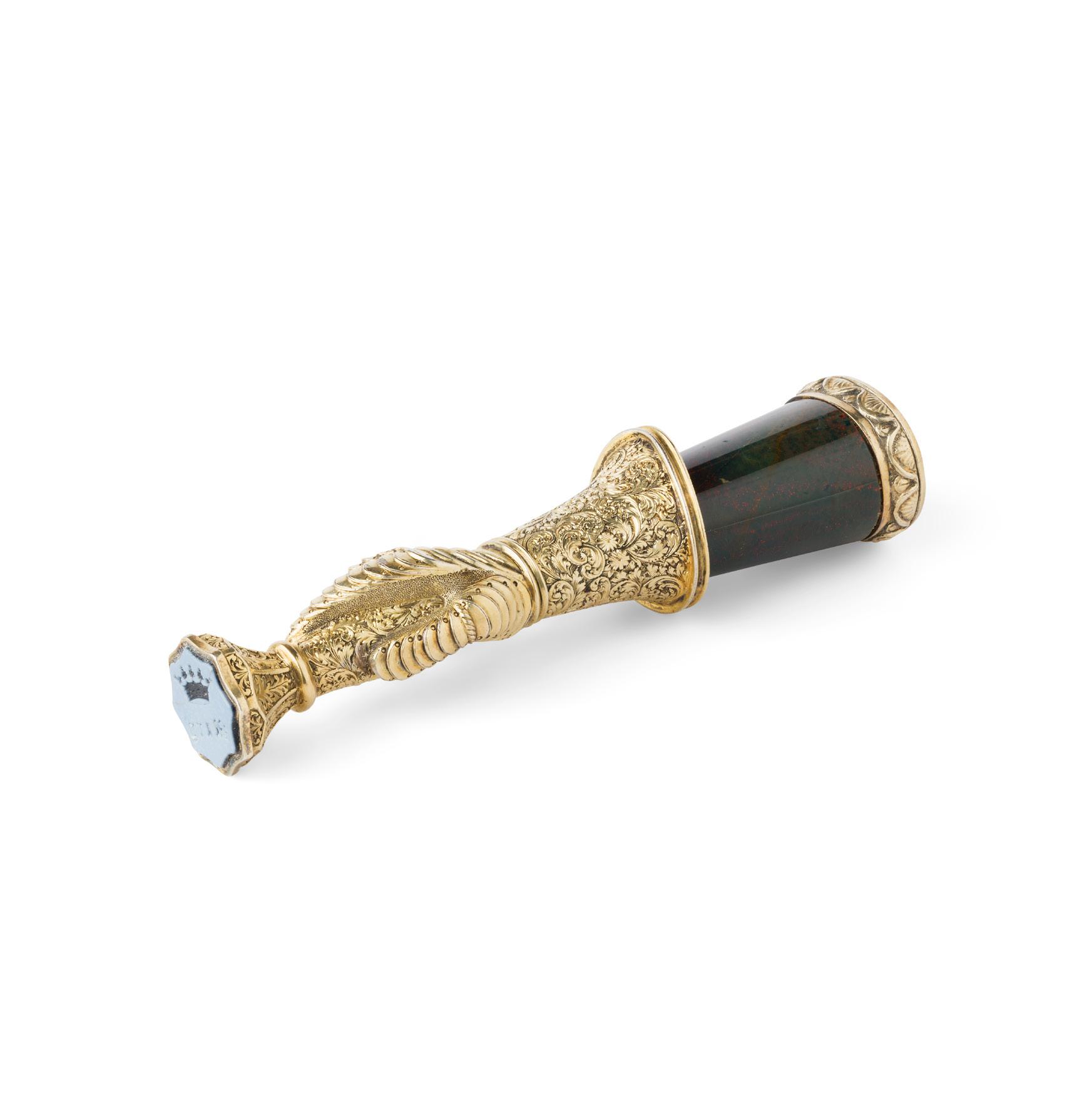
Length: 10cm, matrices: 15mm x 15mm and 19mm x 24mm
£1,500-2,500
Note: Lady Mary Hamilton (née Montagu), 12th Duchess Of Hamilton (1854-1934)
Born at Kimbolton Castle in Huntingdonshire to the 7th Duke of Manchester, Lady Mary married William Alexander Louis Stephen DouglasHamilton, 12th Duke of Hamilton (1845-1895) on 10 December 1873 and moved on the isle of Arran off the west coast of Scotland to Brodick Castle.
Originally a hunting lodge, dating back to the 13th century, Brodick was one of three fortresses/ castles on the island. It wasn’t until the 11 Duke of Hamilton in the 19th century that the family made Brodick Castle a primary residence with major renovations in 1844, almost tripling the size of the building, under the architect James Gillespie Graham.
Now under the care of the National Trust for Scotland, Brodick Castle has a wealth of family heirlooms in the house. Particularly interesting is a collection of mounted hardstones and porcelains that were collected by William Beckford. The Beckford Collection came to Brodick through Beckford’s youngest daughter, Susan Euphemia (1786-1859) as they had a better relationship than her elder sister. Susan Euphemia became the wife of Alexander, 10th Duke of Hamilton (1767-1852). She inherited much of the Beckford Collection and by descent the Collection passed to William, 12th Duke of Hamilton (d. 1895).
Lady Mary Hamilton would have therefore experienced the collection. Her admiration for history can be seen in a portrait of her dressed as
Mary Hamilton, a lady in waiting to Mary Queen of Scots. Now housed in the National Portrait Gallery accession number NPG Ax41207. Together, Mary and William had one daughter named Mary (1884-1957) who married the Duke of Montrose, cementing a fruitful alliance with another aristocratic landowning family in Scotland.
As they had no male heir, the family estates passed to a male cousin, but provisions were made their daughter, Lady Mary, and her father ensured that Brodick Castle was left to her where it continued to be an important family home right up until the 20th century.

54
284 Other fees apply in addition to the hammer price: see the ‘Buyer’s Guide’ section on page 2
THE LADY MARY DOUGLAS-HAMILTON (1850-1922) DESK SEAL
A LATE 19TH-CENTURY ROCK CRYSTAL AND MULTI-GEM SET DESK SEAL
the facetted tapered rock crystal handle with engraved M and earl’s coronet engraved to terminal, the applied metal mount formed as an earl’s coronet with pearl spikes, a set border of diamonds alternating with emeralds, rubies and sapphires, the neck with a rope twist border above a pierced border, the rock crystal matrix engraved with the arms for Furst Festetics von Tolna (1850-1933) and Lady Mary Douglas Hamilton
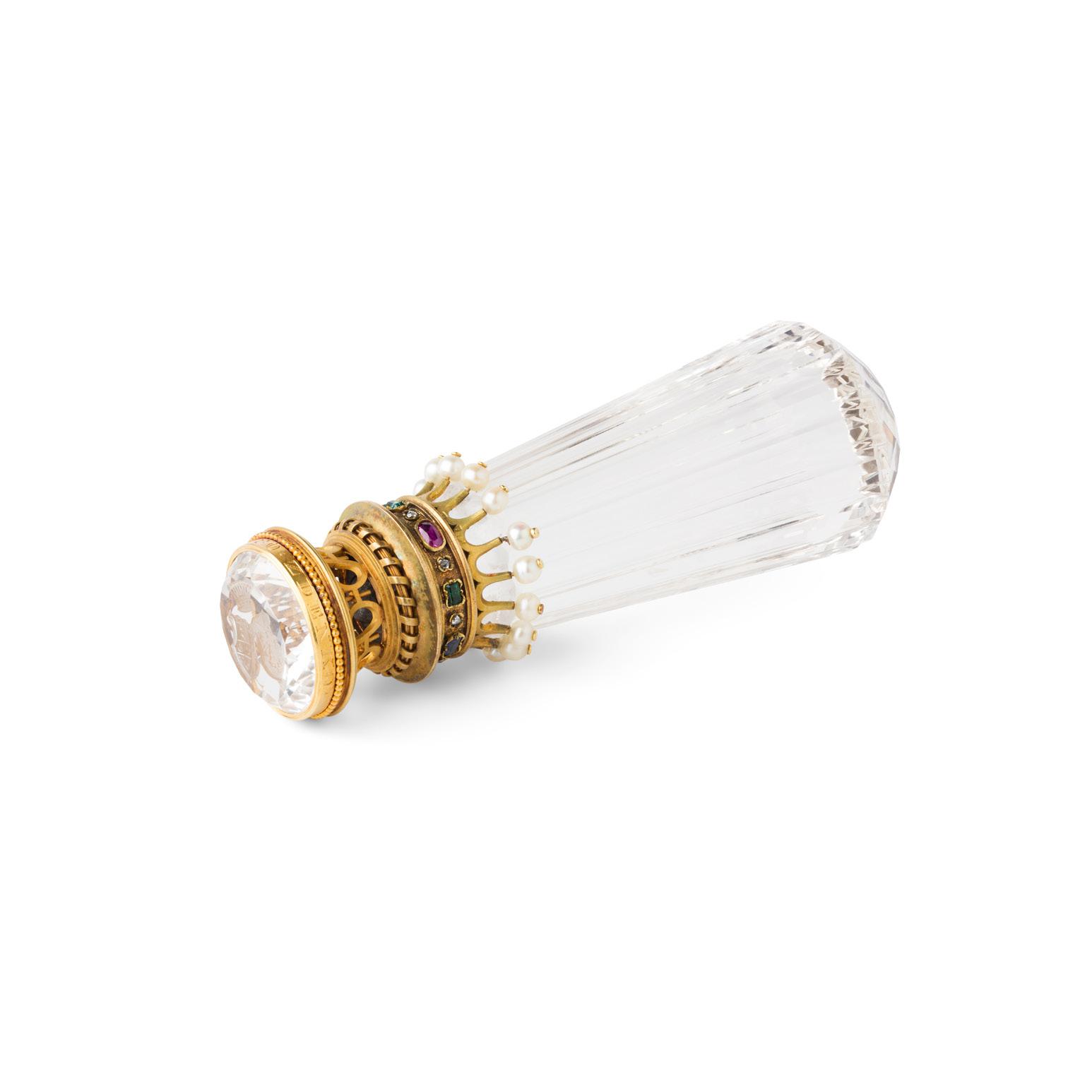
Length: 95mm, matrix diameter: 21mm
Note: This seal was to commemorate the marriage of Lady Mary-Victoria Douglas-Hamilton (1850-1922) and Tasziló II Festetics de Tolna (born Festetics), Prince, (1850 – 1933).
Born to the 11th Duke of Hamilton and Marie Amelie
Elisabeth Karoline Prinzessin von Baden, Lady MaryVictoria was the youngest of three, with two elder brothers. The eldest brother who would go on to become the 12th Duke and marry Lady Mary Montagu.
Lady Mary Victoria’s first marriage was to Prince Albert, the heir apparent of Monaco. The Grimaldi family looked for an alliance with British royalty and aristocracy and the Douglas-Hamilton family was suggested as the highestranking peer in Scotland. Their marriage in 1869 followed quickly with a son, Louis who would become Louis II and grandfather of Prince Rainier III. However, after a couple of years Lady Mary grew to dislike Monaco and their marriage was finally annulled in January 1880 which allowed the marriage to Tasziló II Festetics a Hungarian count in June of 1880.
Following their wedding in Florence they set up home in Budapest with four children, their eldest Maria would marry into the Von Furstenburg family. As Lady MaryVictoria’s mother was Princess Marie of Baden Baden there had always been a strong German connection. Prince Louis had been with his mother for his formative years but was obliged to return for Royal training at the age of 11. It would seem that he also did not enjoy living with his father and left for studies at the Saint-Cyr Military Academy and then onto the Foreign Legion.
The delicate nature of this seal reflects the true love story of Lady Mary-Victoria and Tasziló, purported to be a wedding gift from Tassilo’s sister and brother-in-law, Gina and Zdenko which accounts for the intertwined Ms to the top of the seal.
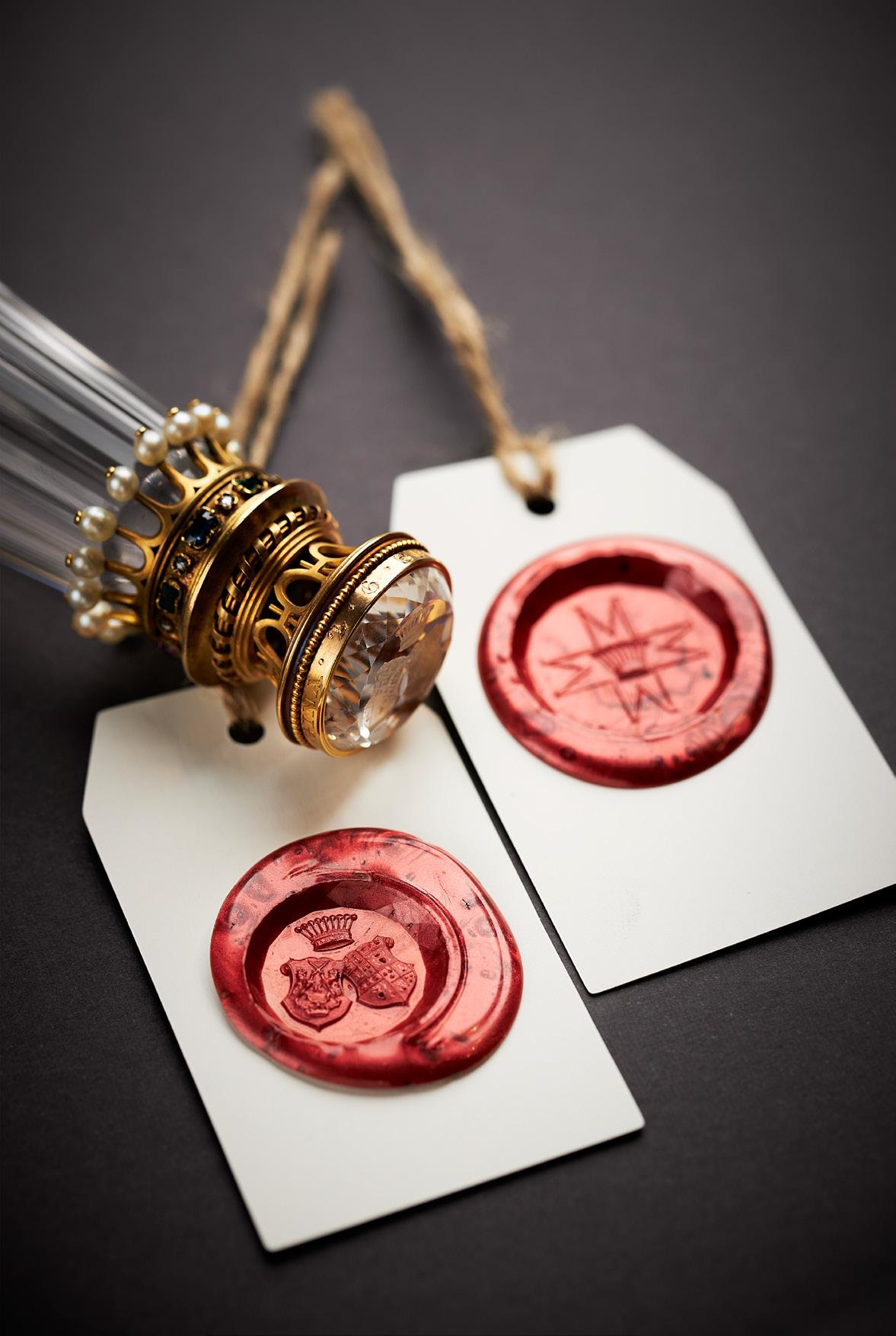
Lady Mary-Victoria passed away in 1922 and Tasziló ten years later, but they are both buried together on the Festetics estate.
£1,000-1,500
56
A SCOTTISH FAMILY DESK SEAL
A CARNELIAN DESK SEAL, CIRCA 1840

the hardstone handle of baluster outline, to a simple silver mounted collar, the oval carnelian matrix with engraved crest, possibly for Napier of Merchistoun
Length: 83mm, 22mm x 17mm
Note: Francis, 10th Lord Napier and 13th Laird of Merchistoun was born in 1819 and inherited the title and the Merchiston estate from his father in 1843 of which this seal may be to commemorate. Merchiston Castle itself had been leased out to the Governors of George Watson’s hospital in 1729 so the family never lived there. Due to a successful diplomatic career, he was rewarded with Baron of the United Kingdom and the title of Ettrick in 1872. Following his marriage to Anne Lockwood in Florence in 1845, they had four children. He died in Florence in 1898.
£250-350
55
285
57
THE GENERAL TERMINUS AND GLASGOW HARBOUR RAILWAY DESK SEAL
A TULIP WOOD AND BRASS DESK SEAL, CIRCA 1849 the wooden handle of baluster form with a flat topped terminal, to a brass matrix, engraved ‘0-4-2 tender engine’ above an inscription encircling a threemasted schooner

Length: 96mm, matrix: 24mm x 18mm
Provenance: Sheffield Railwayana Auctions 18th September 1999, lot 351
Matrix: A Collection of British Seals - David Morris 2012 - Seal 121, page 232
Note: The General Terminus and Glasgow Harbour Railway operated a line, and branches from the Pollock and Govan Railway to the River Clyde and opened in 1849. It was amalgamated with the Caledonian Railway in 1865 £300-500
57 286 Other fees apply in addition to the hammer price: see the ‘Buyer’s Guide’ section on page 2
THE GLASGOW & SOUTH WESTERN RAILWAY COMPANY SEAL MATRIX
A VICTORIAN STEEL SEAL MATRIX, 1850
the large steel matrix engraved with crest and dated 1850, with motto THE CORPORATE SEAL OF THE GLASGOW & SOUTH WESTERN RAILWAY
COMPANY, with a short stem
Length: 40mm, matrix: 44mm diameter
Provenance: Sheffield Railway Auctions, 11th December 1999 lot 352
Note: The Glasgow & Southwestern Railway, which served a triangular section of south west Scotland, including Ayrshire and the busy Firth of Clyde ports, was formed by the amalgamation of the Glasgow, Dumfries & Carlisle Railway, and the Glasgow, Paisley, Kilmarnock & Ayr Railway in 1850. The new railway adopted the emblem previously used by the latter company
£100-200
59
A PARLIAMENTARY SEAL FOR THE GENERAL TERMINUS AND GLASGOW HARBOUR RAILWAY 1846
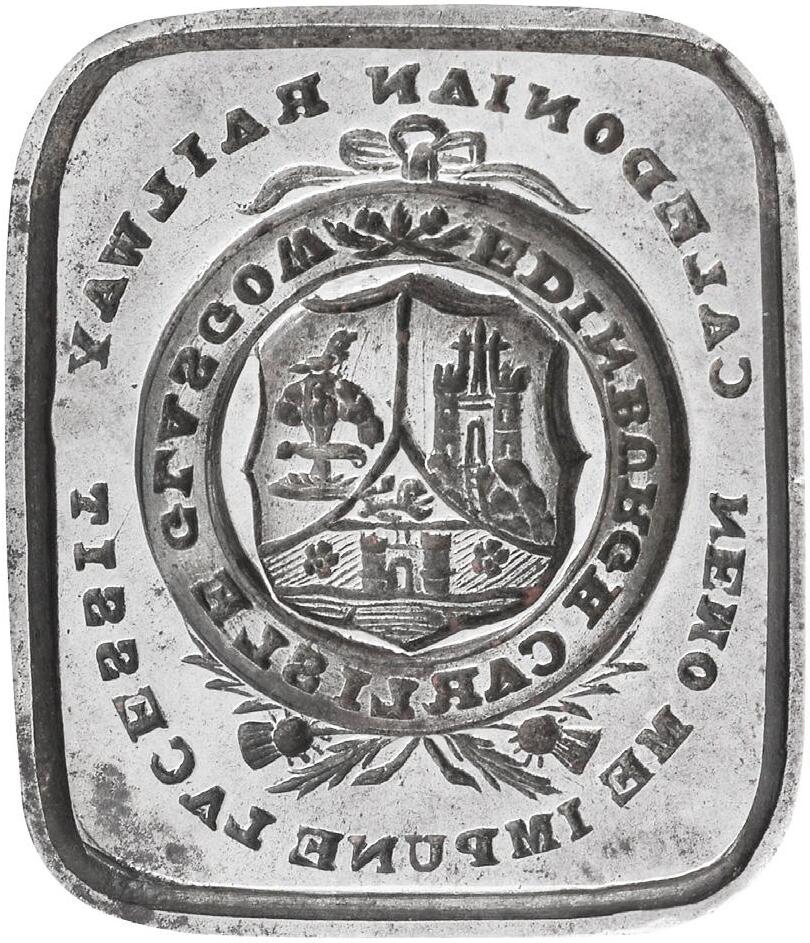

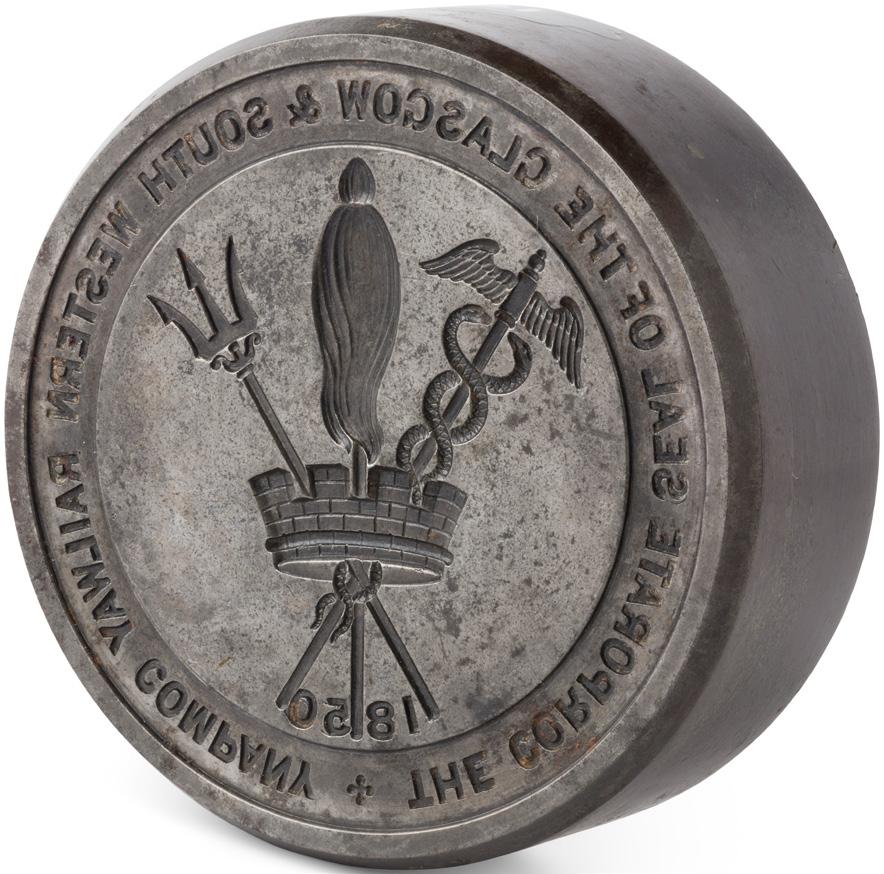
A MID-19TH-CENTURY WOODEN AND BRASS DESK SEAL
the turned wooden handle of baluster form, to a brass collar, the integral matrix with engraved transport depictions and ‘GENERAL TERMINUS AND GLASGOW HARBOUR RAILWAY COMPANY 1846’
Length: 91mm, matrix diameter: 38mm
Provenance: Lot 145 Great Central Railwayana Auctions, 13th October 2012
Note: The General Terminus and Glasgow harbour railway was authorised in 1846, opening in part by the end of 1848, its main function was to be the transportation of the booming collieries from Lanarkshire and Ayrshire, depositing the coal for further transport on the south bank of River Clyde. It also had an instrumental use in linking already established railway lines together, these included Pollock and Govan, Glasgow and Paisley joint railway, and Kilmarnock and Ayr railway, as well as those using the Clydesdale junction railway. The line would continue until 1854 when parts of it were amalgamated with the Caledonian railway and a final amalgamation would take place in 1865.
£400-600
60
THE CALEDONIAN RAILWAY SEAL
AN EARLY 19TH-CENTURY WOODEN AND STEEL DESK SEAL, CIRCA 1865 the turned hardwood handle with reeded lower section to a square steel matrix, engraved with armorial with garter and inscribed EDINBURGH CARLISLE GLASGOW, the whole surmounted by Caledonian Railway and motto Nemo Me Impune Lacasset below
Length: 93mm, matrix: 23mm x 20mm
Provenance: Great Central Railway Auctions, 13th October 2012, lot 222
Note: The Caledonian Railway, which acted as the first continuous travel between Glasgow and London, was formed in 1845 with the objective of connecting Glasgow with the English railways. The Caledonian railway evolved from English concerns of linking cities through rail travel, their main line which opened in 1848 positioned the Caledonian Railway at the peak of Scottish rail companies. Due to the Railways Act of 1921 the Caledonian Railway became a constituent of the newly formed London, Midland and Scottish Railway, formed in 1923.
In 1865 they adopted a version of the Scottish arms as their crest, later adding a further ribbon below their motto bearing the words Caledonian Railway Company The motto translates to No one provokes me with impunity and derives from the Royal Stuart dynasty.
£300-500
58
287
THE GENERAL MANAGER OF THE CALEDONIAN RAILWAY SEAL MATRIX
A MID / LATE 19TH-CENTURY STEEL SEAL MATRIX, CIRCA 1865
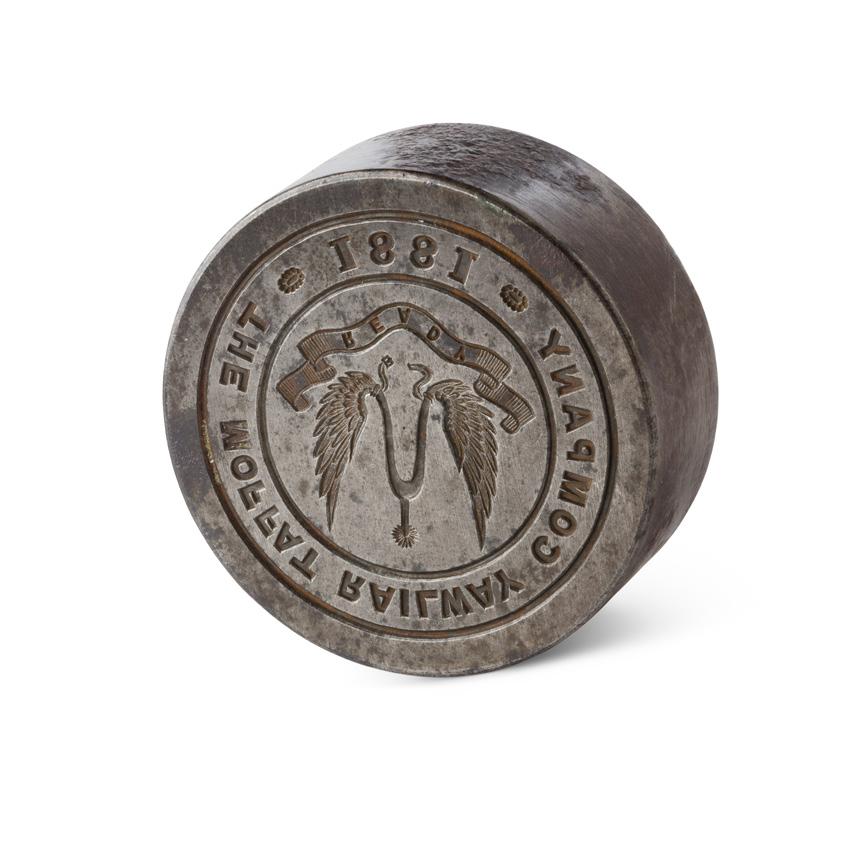
the cylindrical matrix with a short stem, engraved to edge, TOP, the matrix engraved with the pre-union Scottish Royal arms and motto CALEDONIAN RAILWAY around Length: 26mm, matrix: 28mm diameter
Provenance: Sheffield Railway Auctions, 11th December 1999 lot 353
Note: The Caledonian Railway was the first line to link Glasgow with England via Carlisle from 1849 and the company rapidly expanded, taking over many smaller rival lines. Of its General Managers, perhaps the best known is the last, Donald Matheson, who was not only General Manager of Caledonian from 1910-1922 but oversaw its incorporation into the London, Midland and Scottish Railway, becoming General Manager of the new company until his retirement in 1926. It was he also who conceived the idea of creating the Gleneagles golf courses and grand hotel.
The Caledonian Railway’s adoption of the pre-Union Scottish arms as its emblem was unofficial and not authorised by the Lord Lyon King of Arms
£100-200
THE WISHAW & COLTNESS RAILWAY COMPANY SEAL
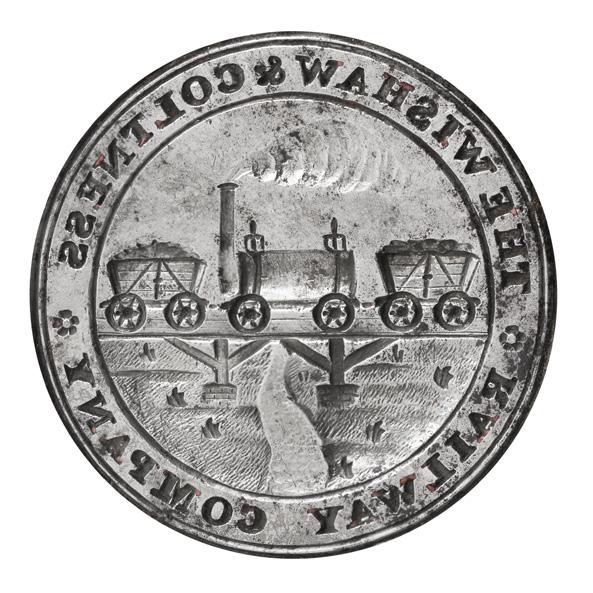
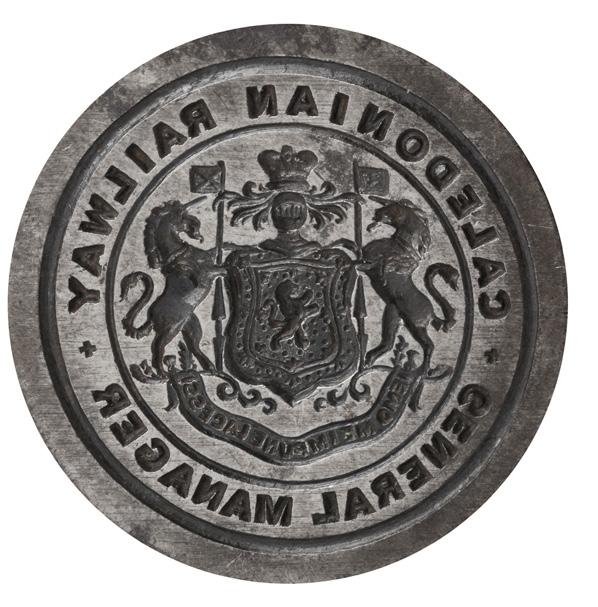
A GEORGE IV / EARLY VICTORIAN LABURNUM AND STEEL SEAL, CIRCA 1840
the slender baluster handle of polished laburnum, with simple circular steel seal engraved with motto Wishaw & Coltness Railway Company around a scene of an engine pulling carts over a bridge
Length: 10.2cm, matrix diameter: 27mm
Provenance: Great Central Railway Auctions, 13th October 2012, lot 307
Note: The Wishaw & Coltness Railway Company was one of the earliest railway companies formed in Scotland. It was formed by act of parliament in 1829 to raise £80,000 on an estimate of £50,000 in construction costs. Shortages of funds led to further Acts and was funded in the end to a much higher level than expected. The company operated over an 11-mile route from Chapel Colliery at Coltness to join the Monkland and Kirkintilloch Railway. Originally built to a Scotch gauge of 4ft 6 inches as a single track line engineered by Thomas Grainger. By 1849 it was to become part of the larger Caledonian Railway and is now part of the West Coast Main Line
£300-500
63
THE MOFFAT RAILWAY COMPANY DESK SEAL
A LATE 19TH-CENTURY STEEL DESK SEAL, CIRCA 1881
the circular disc engraved a central crest and motto within the legend in a border, with pierced spigot to reverse
Diameter of matrix: 41mm
Provenance: Sheffield Railway Auctions, 11th December 1999, lot 351
Note: The construction of a single-track branch line from Moffat to Beattock, which was situated on the main line between Carlisle and Glasgow, by the Moffat railway Company, authorised in 1881 and the line opened in 1883.
It was leased to the Caledonian Railway in 1884 and taken over completely in 1889.
The town of Moffat had no armorial bearings so displayed the Johnstone crest of a winged spur and the motto: Nunquam non apparatus (never unready). Moffat had been created a Burgh of Regality in favour of James Johnstone of Corhead in 1684 and this was confirmed to James Johnstone, 3rd Earl of Annandale in 1662
£150-180
64
THE TRUSTEES OF THE HARBOUR OF INVERNESS DESK SEAL
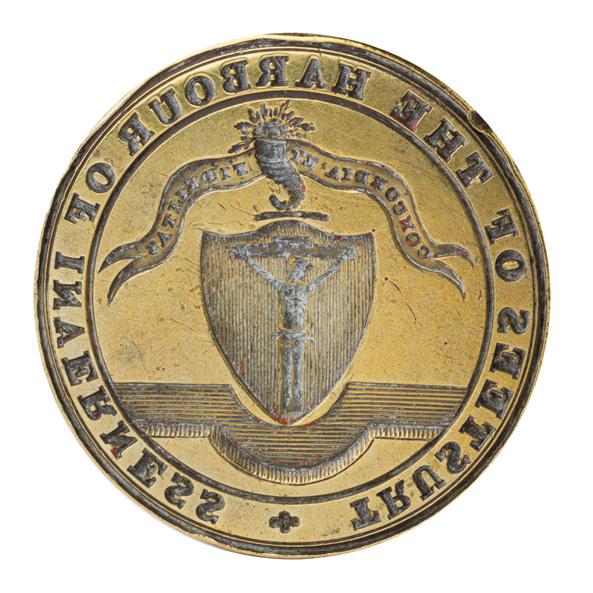
A VICTORIAN WOODEN AND BRASS DESK SEAL, CIRCA 1850
the cylindrical wood to a brass disc, engraved with the coat of arms for Inverness in a border of the legend
Length: 50mm, matrix diameter: 39mm
Note: The Port of Inverness is operated as a Trust Port under the control of Inverness Harbour Trust which was constituted by an Act of Parliament in 1847. The port’s historic records go all the way back to 1249. The port traded with Scandinavia and the rest of the United Kingdom, shipping many natural resources from the fertile highlands.
£400-600
61
62
288 Other fees apply in addition to the hammer price: see the ‘Buyer’s Guide’ section on page 2
THE COMPANY OF PROPRIETORS OF THE FORTH & CLYDE CANAL NAVIGATION DESK SEAL
A LATE 18TH-CENTURY BRASS DESK SEAL, CIRCA 1770
the circular brass disc engraved with a depiction of a Classical figure and Royal banner for Scotland, with the canal in the background and a cornucopia in the forefront, within an engraved border
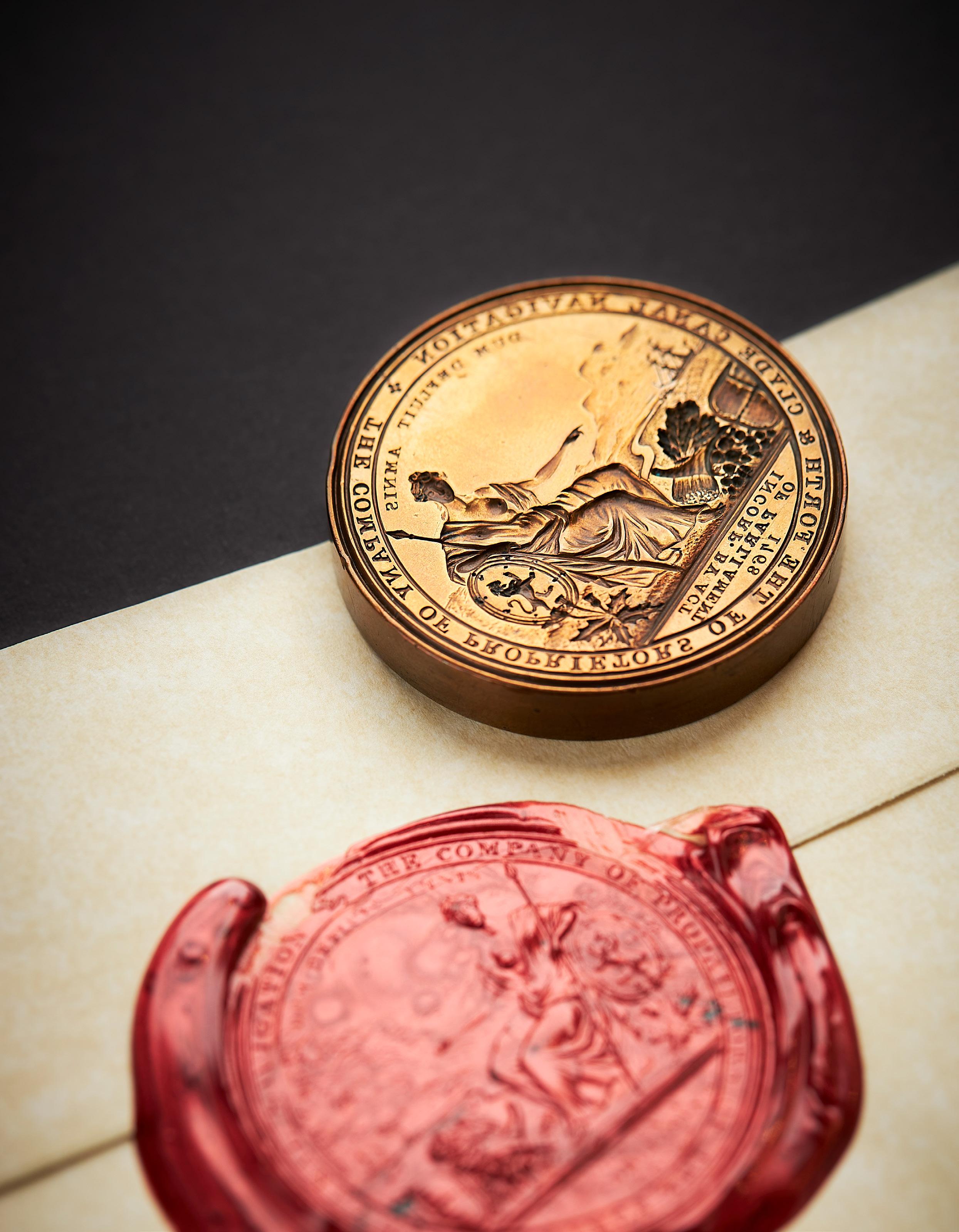
Diameter: 44mm
Provenance: Matrix: A Collection of British Seals - David Morris 2012 - Seal 114, page 220
Note: The Forth & Clyde Canal Company, which by act of parliament was incorporated as the Company of Proprietors of the Forth and Clyde Navigators in 1768, were responsible for the construction of a canal route between the Firth of Forth and the Firth of Clyde, allowing navigation from Edinburgh to Glasgow. The Canal was very successful and tested trials for steamboats towards the end of the 18th century, hosting the first practical steamboat, the Charlotte Dundas. It was acquired by the Caledonian Railway in 1842 and later closed in 1960.
£400-600
65
289
THE BANFF LITERARY SOCIETY SEAL
AN EARLY 19TH-CENTURY LABURNUM AND BRASS SEAL, CIRCA 1810
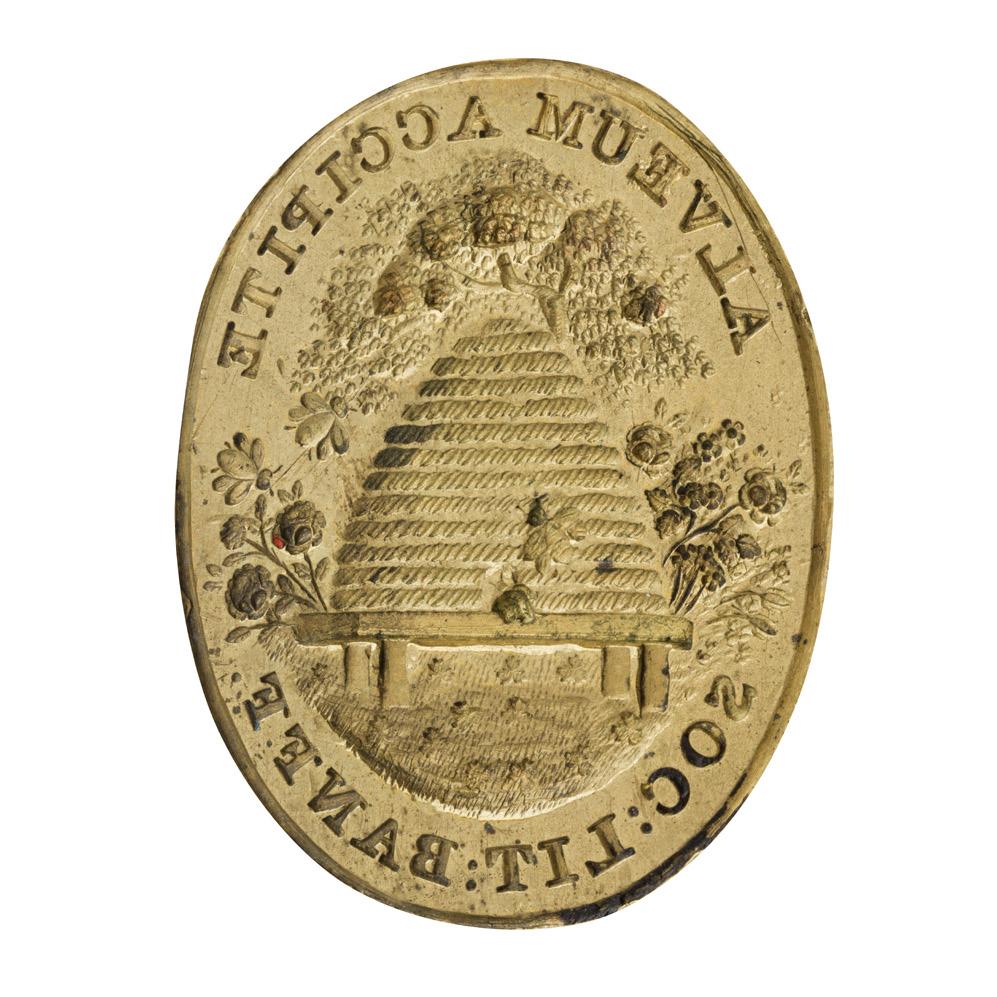
the turned laburnum baluster handle socket mounted to an oval brass matrix, engraved with a bee skep within flowers and trees with motto ALVEUM ACCIPITE SOC:LIT:BANFF around
Length: 92mm, matrix: 39mm x 32mm
Note: Banff is a town in Aberdeenshire. The Banff Literary Society was instituted by five local youths in 1810, and the purpose of the society was to form a library and to hold meetings where essays could be read aloud, and literary topics could be discussed. The library held an extensive collection of technical literature on farming and practical philosophy of the highest intellectual content, amongst a plethora of other literature. The library was handed over to the town at the end of the 19th century.
£250-350
THE PAISLEY PHILOSOPHICAL INSTITUTION DESK SEAL
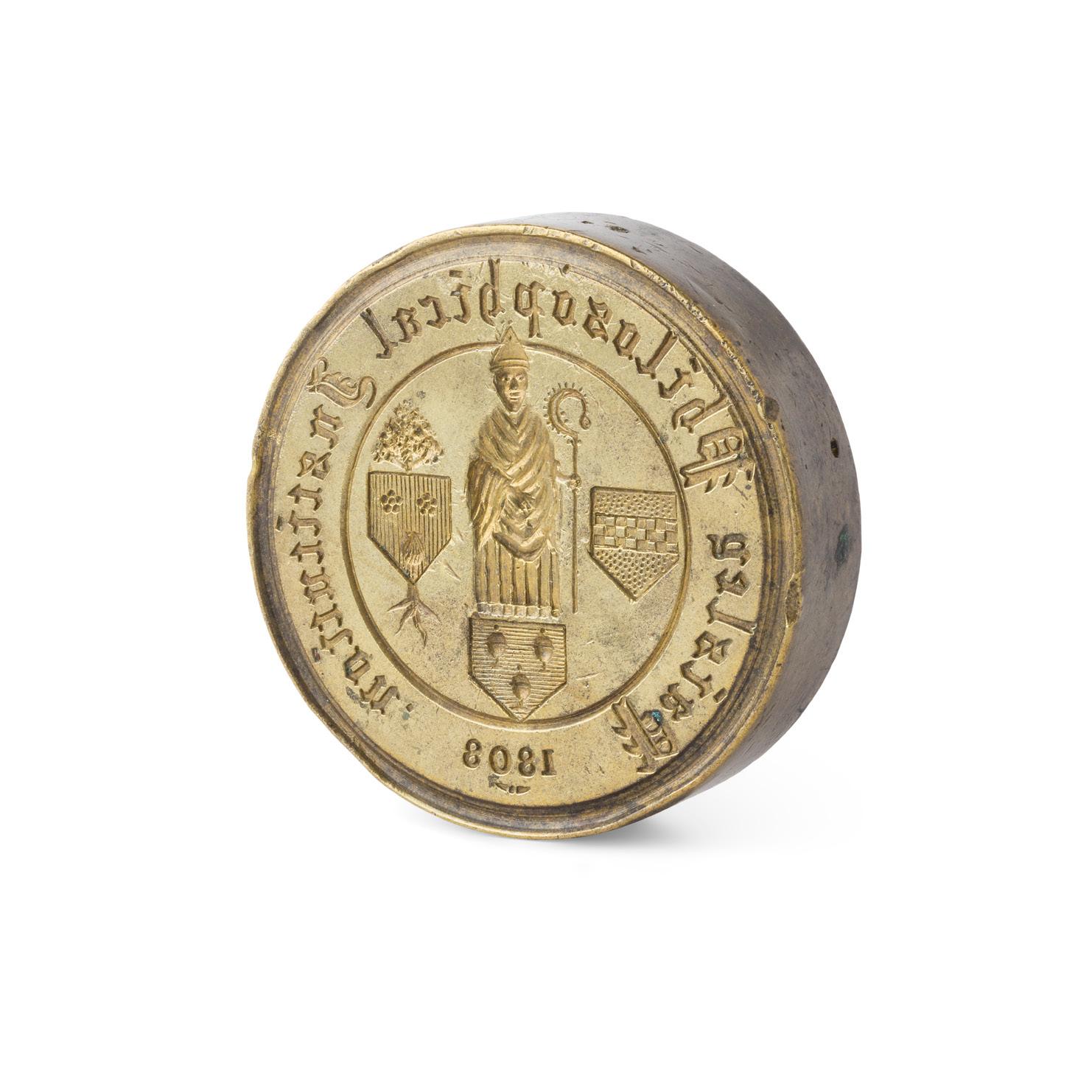
AN EARLY 19TH-CENTURY BRONZE DESK SEAL
the circular disc matrix engraved with the coat of arms of Paisley in a border, with spigot to reverse Diameter of matrix: 39mm

£200-300
THE SCOTTISH EDUCATION DEPARTMENT DESK SEAL
AN EARLY 20TH-CENTURY WOOD AND STEEL DESK SEAL, CIRCA 1920
the ebonised wooden baluster handle mounted with short-stemmed steel stem and oval matrix, the matrix engraved with post-1837 British Royal armorial, inscribed SCOTTISH EDUCATION DEPARTMENT EDINBURGH around
Length: 10cm, matrix: 26mm x 23mm
Note: The Scottish Education Act of 1872 made education compulsory and allowed the newly-formed, Scotch Education Department to take over the responsibility of running schools from the burgh or parish. It originally had its offices in London but moved in 1918 to Edinburgh and changed its name from Scotch to Scottish Education Department.
£200-300
66
67
68
290 Other fees apply in addition to the hammer price: see the ‘Buyer’s Guide’ section on page 2
THE SEAL OF THE INCORPORATION OF HAMMERMEN OF SOUTH LEITH
A VICTORIAN WOODEN AND BRASS HAND SEAL, CIRCA 1870
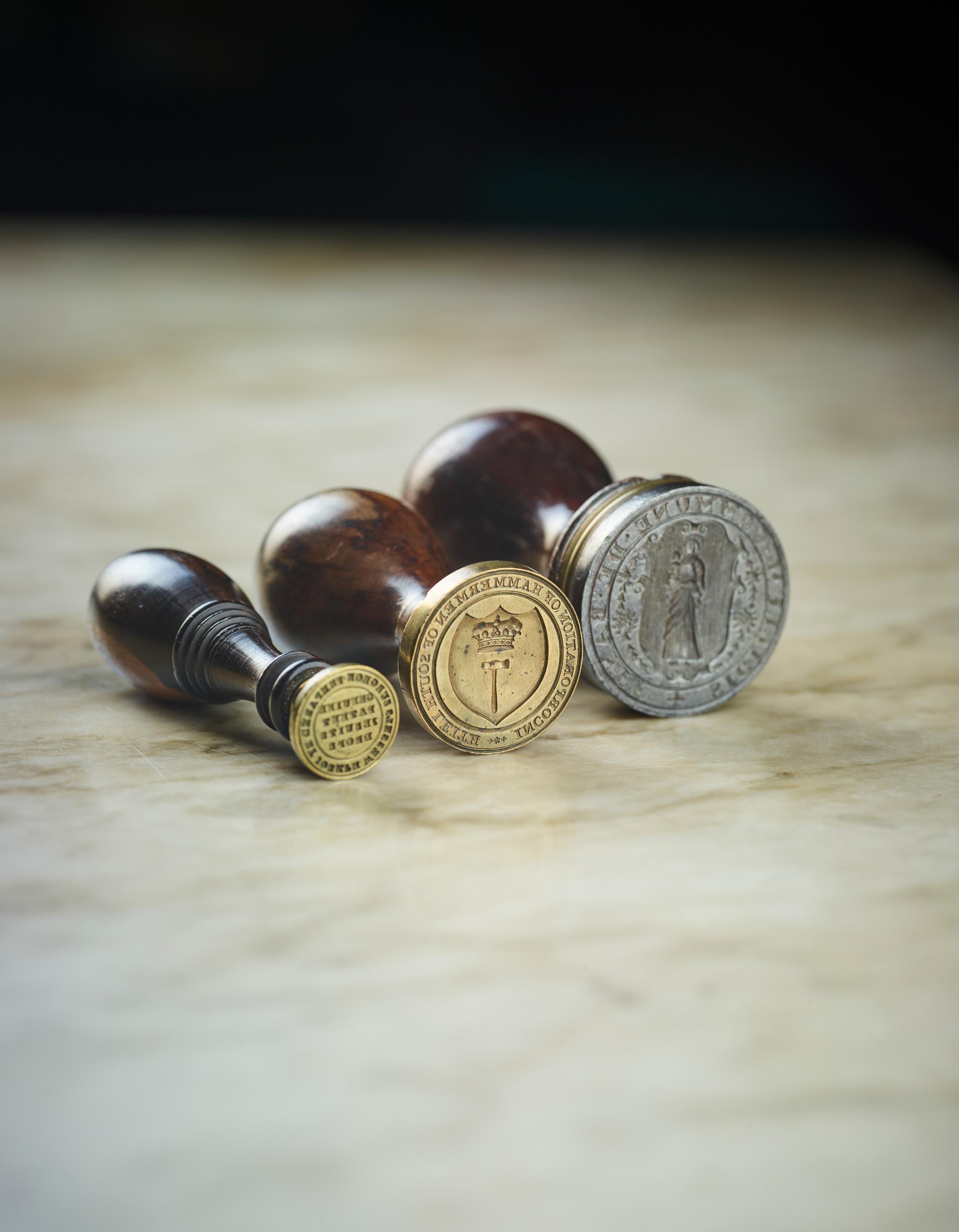
the flat-topped turned baluster wooden handle with stepped lower section to a simple brass circular matrix, engraved INCORPORATION OF HAMMERMEN OF SOUTH LEITH around a heraldic shield with marquess’s coronet above a hammer
Length: 82mm, matrix: 35mm diameter
Note: The Incorporation of Hammermen encompassed those working in metal; Blacksmiths, Goldsmiths, Pewterers, Lorimers, Saddlers, Cutlers, Buckle makers as well as Armourers.
They were referred to as trade incorporations after the Reformation, in order to move away from the pre-reformation guild system.
Still closely linked to the Church, the incorporations were heavily linked to the local community.
South Leith became a separate parish in 1609 and was therefore regarded as a separate entity from Edinburgh.
Classed as a suburb at the time, rather than a leafy commuter town as known today, suburbs were outside of the jurisdiction, in this case, devised by the Edinburgh incorporations, thus prohibiting members becoming Freemen of the city of Edinburgh as well as Leith.
It must however be noted that Leith itself was a successful commercial port with whaling to Newfoundland beginning in 1616.
By 1911, Christian Salvesen & Co of Leith who had begun whaling operations in the Antarctic in 1908 had the largest whaling fleet in the world.
The Leith Banking Company which was set up in 1792 shows the clear success that Leith was enjoying and this must have been helped by the wet docks of 1799.
In 1833 Leith even became an independent burgh with its own Town Council but in 1920 Leith finally merged with the Edinburgh Council.
The members of the Incorporation of Hammermen of South Leith would have been well-respected and fundamental members of the local community. £250-350
A ROYAL SCOTTISH CORPORATION DESK SEAL
A MID-19TH-CENTURY STEEL DESK SEAL
the cylindrical disc engraved with a depiction of the figure of charity, with three naked children, with both the Royal banner of Scotland to one side and a crown to the other above a thistle, with the legend in a border, marked to the underside, WYON/ REGENT ST. LONDON for Alfred Benjamin Wyon (1837-1884) with screw detachment
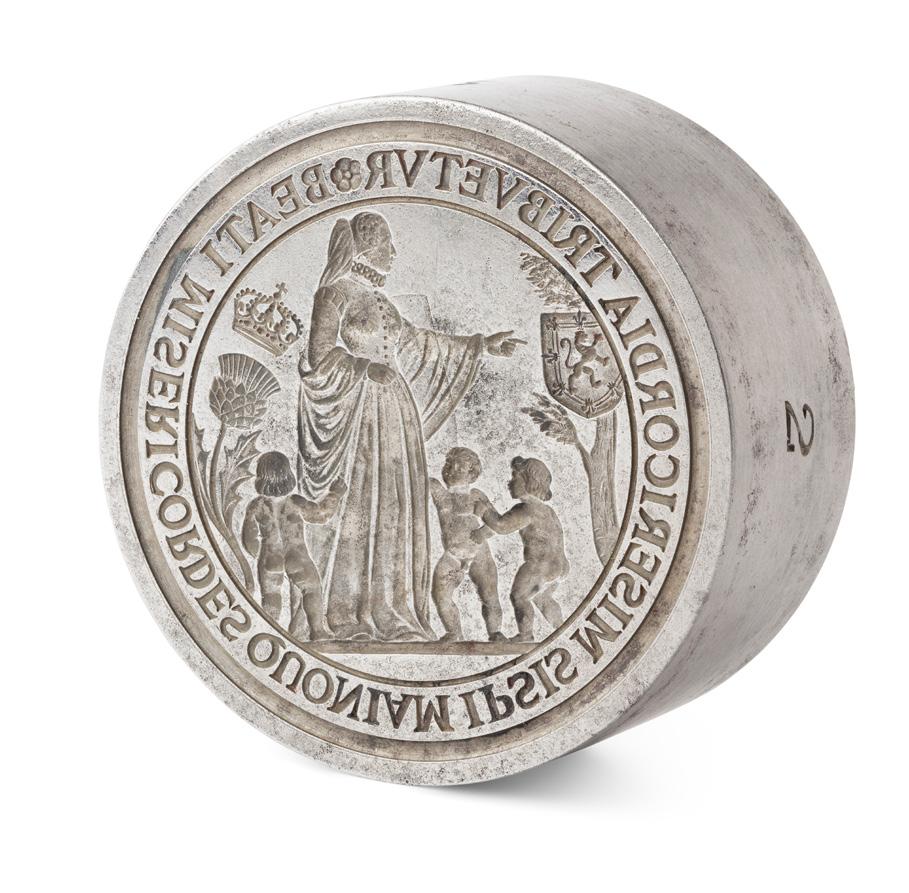
Diameter: 52mm
Note: The Royal Scottish Corporation is the working name of the ‘The Scottish Hospital of the Foundation of King Charles II’
First incorporated by Royal Charter in 1665 and dating its origins to 1603, it is the oldest Scottish charity outside of Scotland and one of the oldest in London and the UK.
Education has always been a priority, initially training orphans and ablebodied Scots for ‘manual occupations’ and the ‘advancement of trade’.
Still in existence today, the charity focuses on helping Scots in London
£300-500
69
70
71 69 75 291
THE ROYAL BURGH OF BANFF DESK SEAL
A MID-18TH-CENTURY MAHOGANY AND STEEL DESK SEAL
the handle modelled as a chess pawn with a reeded collar, the circular steel matrix engraved with the arms of the Royal Burgh of Banff, the inscription to border ‘SIGILLUM COMMUNE DE BANFF’
Length: 10cm, matrix diameter: 48mm
Provenance: Matrix: A Collection of British Seals - David Morris 2012Seal 24, page 66

£500-800
72
GLASGOW - A SCOTTISH DESK SEAL
A STEEL DESK SEAL
of circular form, engraved to the disc with the Glasgow coat of arms and motto

Diameter: 31mm
£80-120
73
PERTHSHIRE
- A SCOTTISH PROVINCIAL DESK SEAL
A WOODEN AND BRASS DESK SEAL
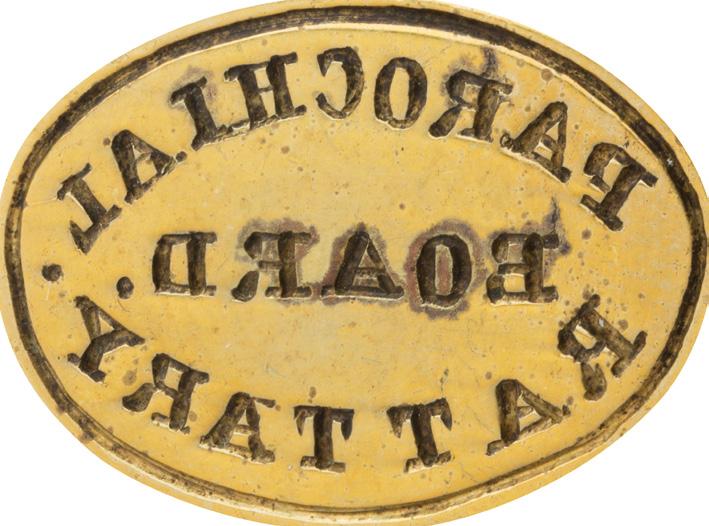
the baluster handle to a brass collar and matrix, engraved PAROCHIAL BOARD RATTRAY
Length: 80mm, matrix: 19mm x 7mm
£120-180
74
THE ABERDEEN, NEW BRUNSWICK, CANADA POST OFFICE DESK SEAL
A LATE 19TH-CENTURY WOODEN AND MIXED METAL DESK SEAL, CIRCA 1880 the turned wooden handle of baluster form, to a brass collar and pewter matrix, engraved ‘Aberdeen Post Office NB’ as a garter with crown to the middle
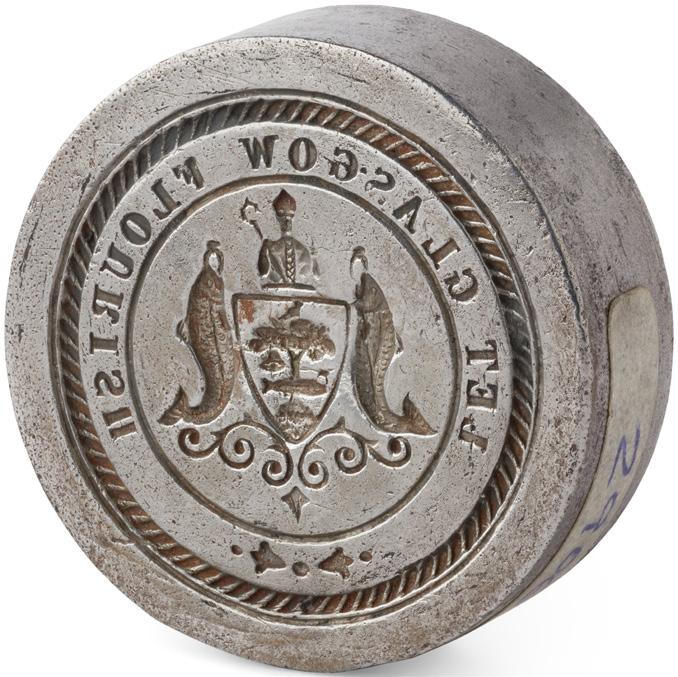
Length: 10.5cm, matrix: 27mm x 22mm
Provenance: Matrix: A Collection of British Seals - David Morris 2012 - Seal 141, page 264
Note: Aberdeen is a Civil Parish in Carleton County, New Brunswick, Canada. the communities within it currently comprise of Argyle, Juniper, Juniper Station, Knowlesville and Glassville. Glassville takes its name from Reverend Charles Gordon Glassville, who studied at the University of Aberdeen and came to New Brunswick, serving as a Presbyterian minister in the 1850s. He also encouraged more settlers from Scotland.
More than 130 emigrants left the port of Greenock, Scotland on May 9, 1861, on board the barque “Irvine”, destined for the new settlement of Glassville. By June 27, 1861, they arrived at the Partridge Island quarantine station in Saint John Harbour and then travelled to Glassville to join the community which had already been established additional families joined the first settlers. The settlement grew quickly and had a post office from 1861, and by 1871 was the centre of five communities with a population of 200. By 1898, in addition to a post office, Glassville had six stores, a hotel, a Presbyterian church and a population of about 300.
£300-500
71
292
A MEDICINAL DESK SEAL - WALKER’S JESUITS DROPS
A LATE-18TH-CENTURY WOODEN AND BRASS DESK SEAL
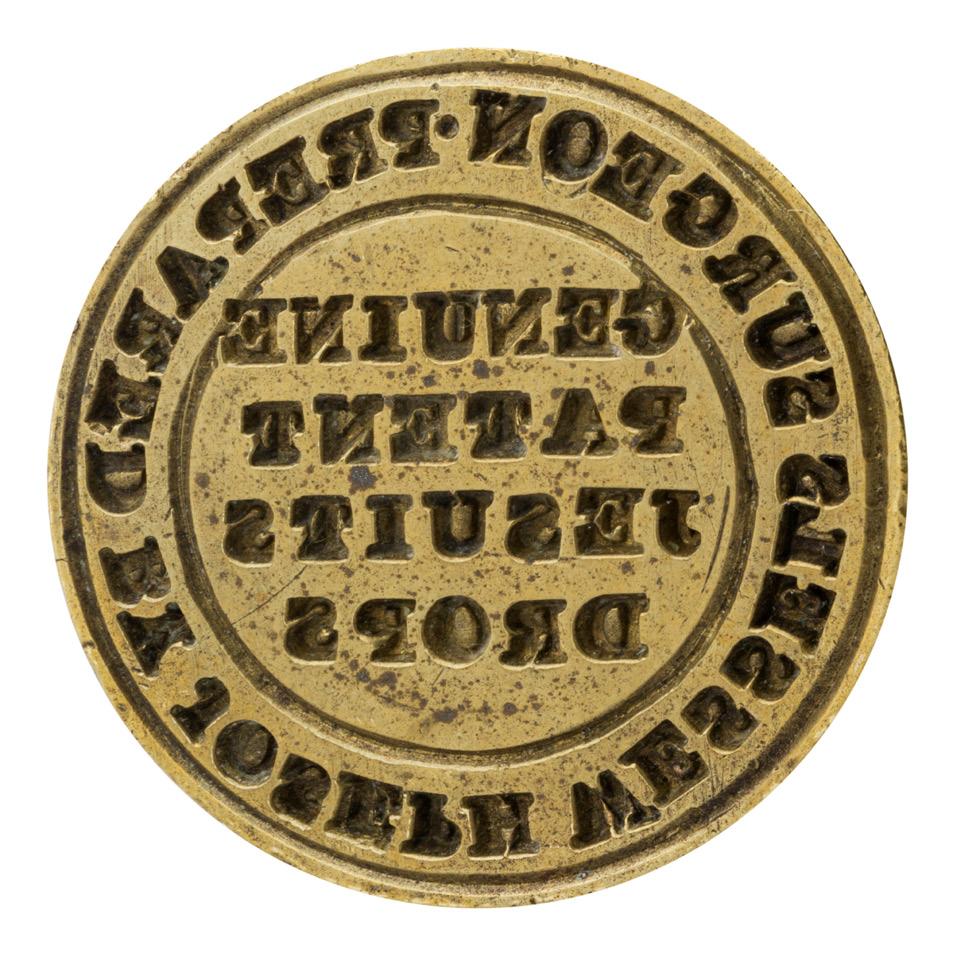
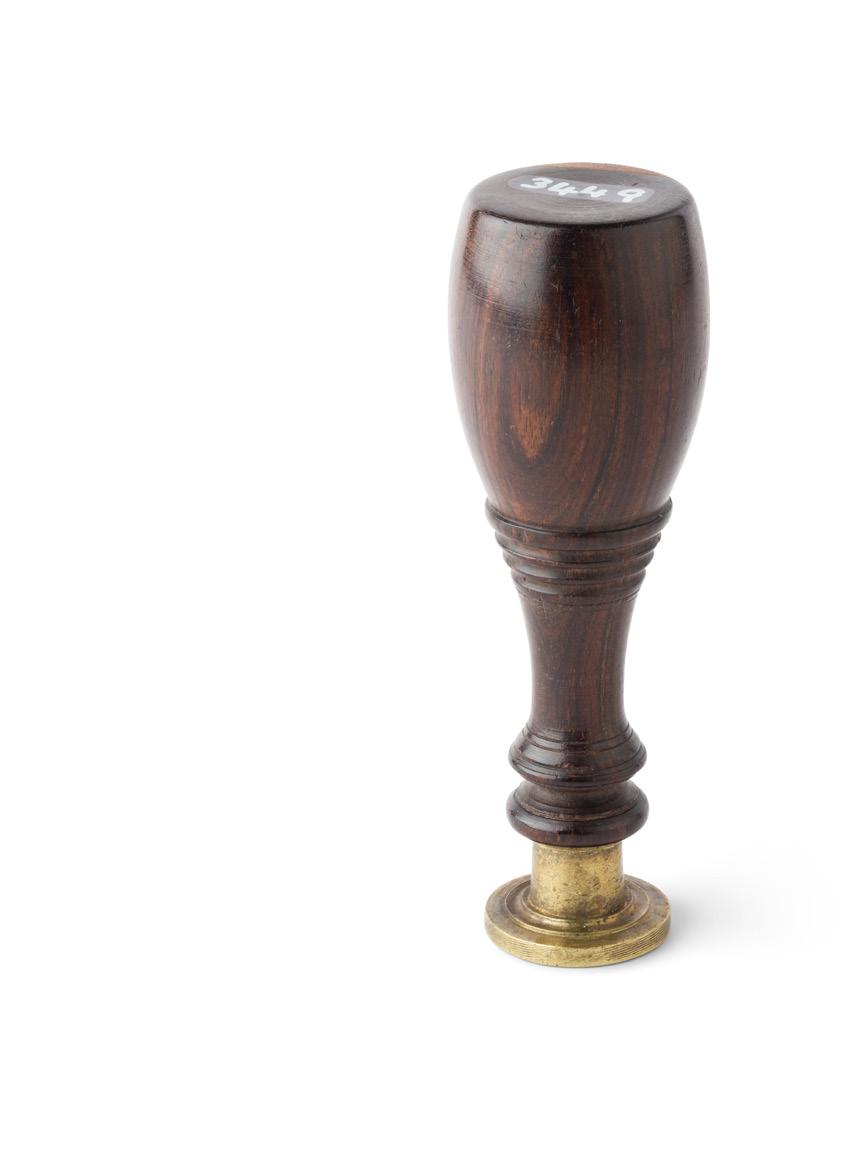
the baluster handle to a brass collar and matrix, engraved with ‘PREPARED BY JOSEPH WESSELS SURGEON GENUINE PATENT JESUITS DROPS’
Length: 88mm, matrix diameter: 20mm
Note: Printed in The Edinburgh Advertiser, Tuesday 11th February 1772, an advertisement for Dr. Walker’s Patent Genuine Jesuit Drops ’CAUTION to the PUBLIC.
By the King’s Patent
DR. WALKER’S PATENT GENUINE JESUITS DROPS ...at 2s. 6d. each bottle; and specific purging remedy, at 2s 6d. per pot which are the most certain, cheap, pleasant, safe, effectual and immediate cure ever discovered for gleets, and seminal weaknesses...’
Robert Walker obtained the King’s Royal Letters Patent for his remedy in 1755, and rested heavily on the religious connotation of Jesuits, to promote his medicinal relief, similar to the Carmelite nuns before him and their carmelite drops. Dr. Walker’s concoction was in fact an elixir to alleviate venereal disease. After his death, surgeon Joseph Wessels adopted the marketing with Wessel’s Jesuit Drops, on sale as late as the 1870s.
£400-600
THE SCOTTISH AUSTRALIAN INVESTMENT COMPANY SEAL
A LATE 19TH-CENTURY STEEL DESK SEAL
the circular disk engraved with the Royal Standard for Scotland in between two unicorns and below a crown, with the legend surrounding, ‘THE SCOTTISH AUSTRALIAN INVESTMENT COMPANY LIMITED, ESTABLISHED IN 1840, LONDON AND AUSTRALIA, SOUTH AUSTRALIA
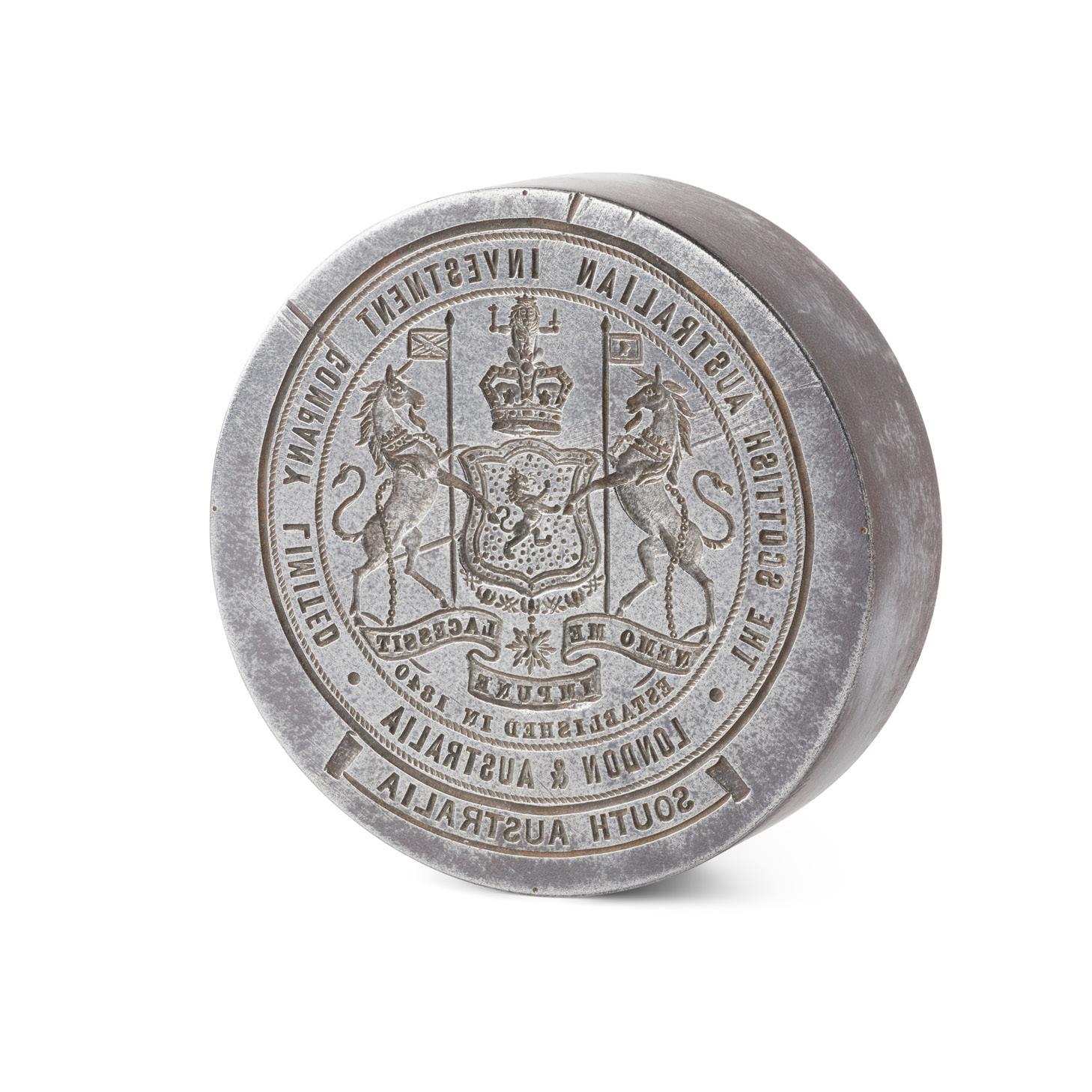
Diameter of matrix: 65mm
Note: The Scottish Australian Company was formed in Aberdeen in 1840 and later incorporated in England in 1856. It commenced activities after its formation, making substantial investments in the mining and pastoral industries in particular. The company had 416 ‘co-partners’ within the first year of its inception. During this period Aberdeen was enjoying a period of prosperity due to the immense success of the linen industry which meant there was ample capital to invest in Australia. This resulted in the Scottish Australian Investment Company becoming incredibly successful. The company had offices in both Sydney at O’Connell Street and 24 Gresham Street in London. In 1859 a subsidiary of the company was created, the Scottish Australian Mining Company, which was also incredibly successful.
£400-800
75
76
293 Other fees apply in addition to the hammer price: see the ‘Buyer’s Guide’ section on page 2
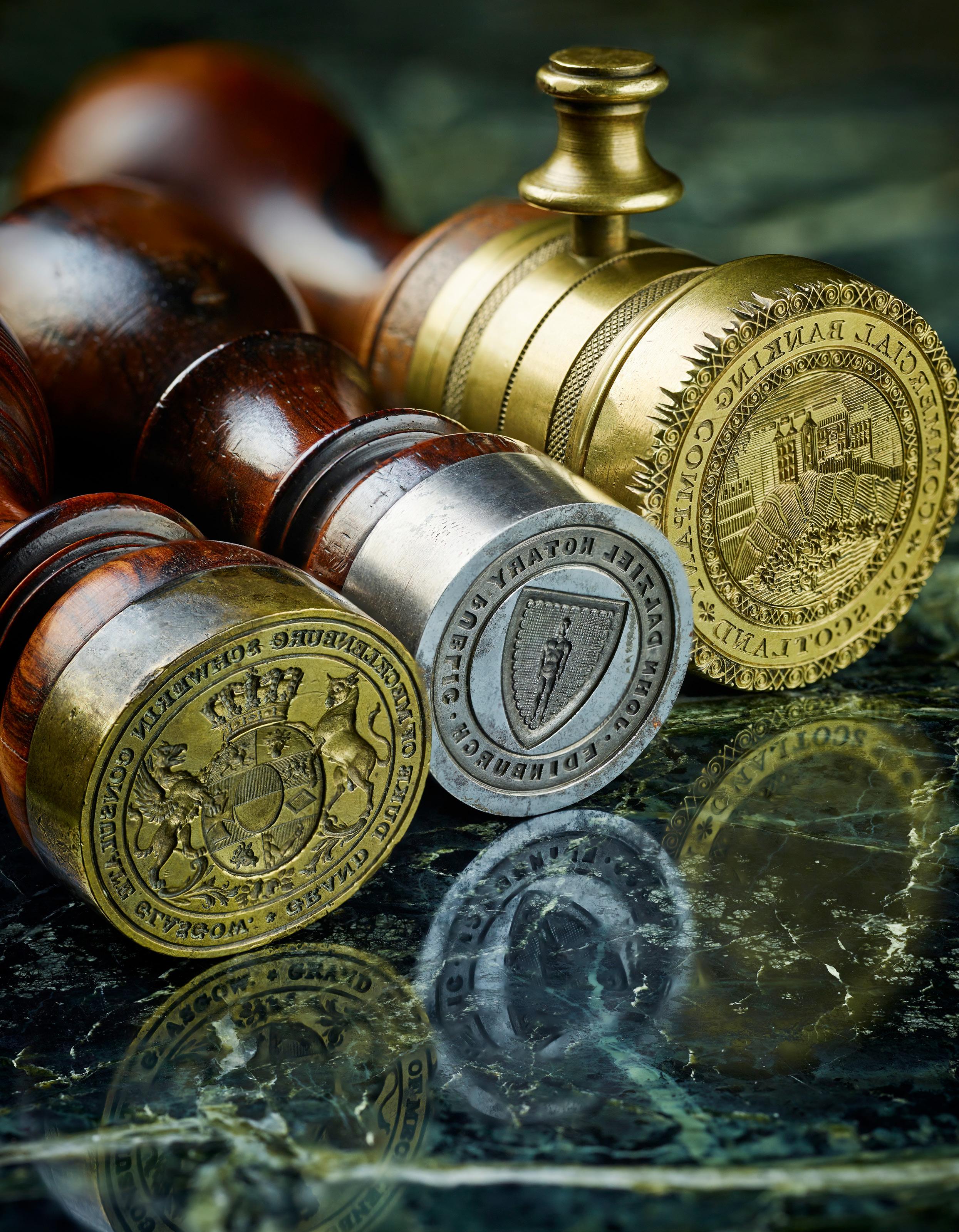
294
THE
COMMERCIAL BANK OF SCOTLAND LTD SEAL
AN EARLY 19TH-CENTURY LIGNUM VITAE AND BRASS DESK SEAL
the baluster wooden handle, with a brass collar neck, the engraved brass circular terminal with a possible depiction of Edinburgh’s Royal Mile area, in a border, engraved with COMMERCIAL BANKING COMPANY OF SCOTLAND, a pin to the neck allows the border of the collar to be removed
Length: 23cm
Note: The wording of ‘Commercial Banking Company’ dates this seal between 1810 and 1832 when the bank changed its name to Commercial Bank of Scotland.
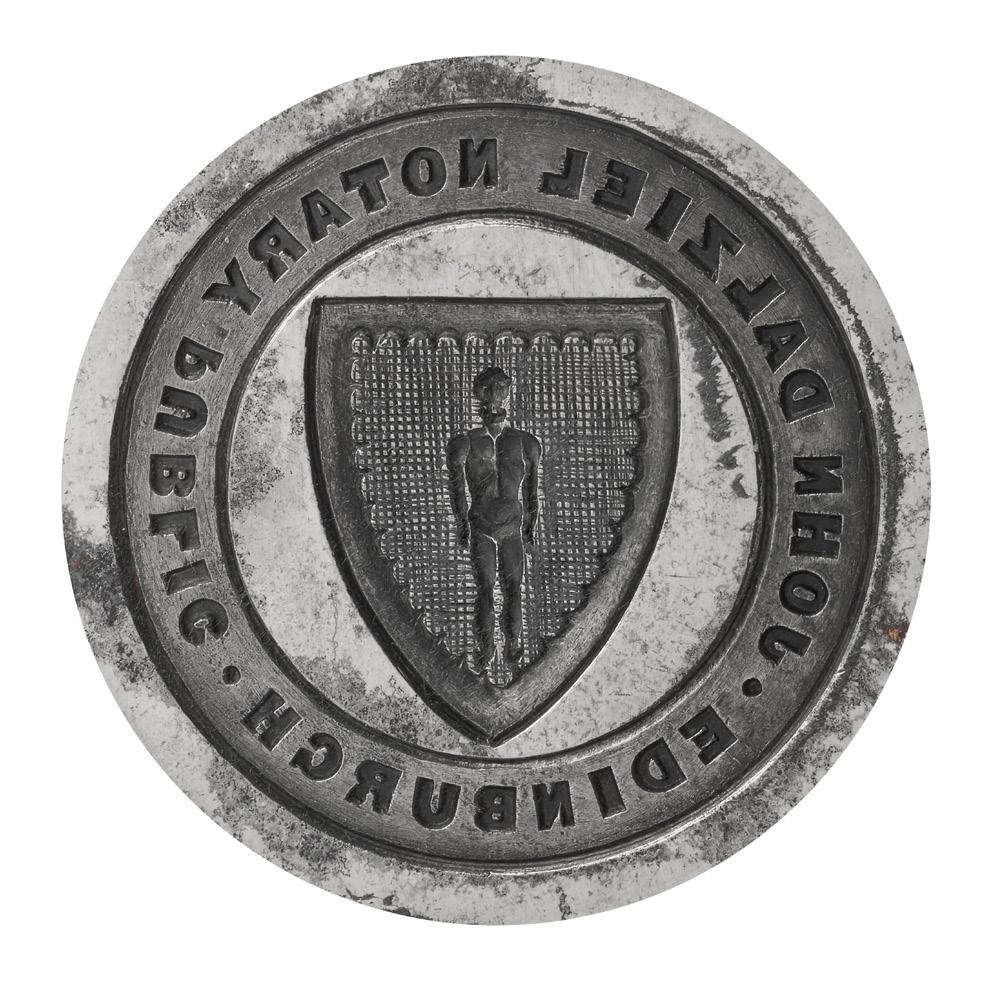
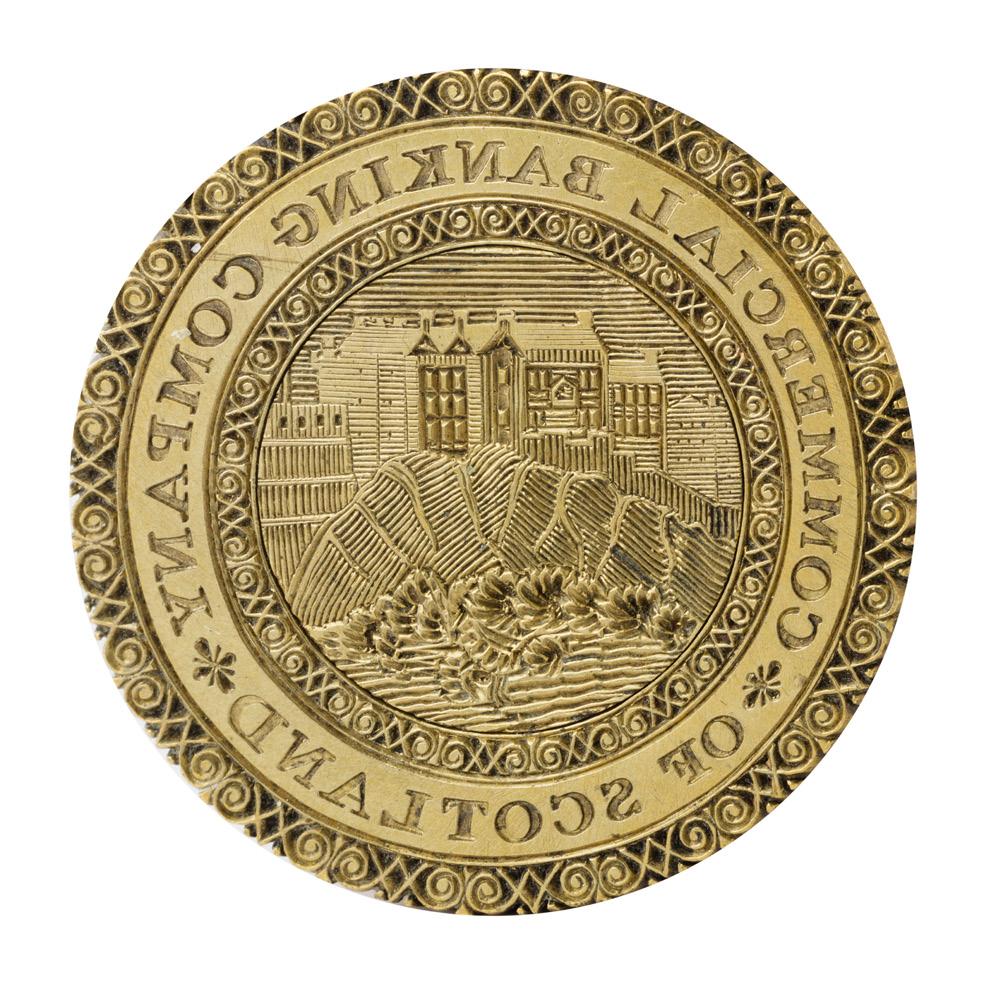
Furthermore, the image on the seal possibly relates to the relocated head offices in 1814 at the top of the High Street, from Picardy Place in Leith
The Commercial Bank of Scotland Ltd was founded in 1810 and obtained a royal charter in 1831. The bank grew substantially during the nineteenth and twentieth centuries until 1950 when it merged with the National Bank of Scotland to become the National Commercial Bank of Scotland. The commercial bank was formed as a result of public dissatisfaction with the three charter banks, the Bank of Scotland, the British Linen Bank, and the Royal Bank of Scotland. By 1940, the Commercial Bank of Scotland had the largest network in Scotland, amassing a system of 385 branches. The post-war period was one of radical change for Scottish banks with mergers and fresh links with English banks. In 1958, the Commercial Bank of Scotland merged with the National Bank of Scotland and later became subsumed by the Royal Bank of Scotland.
£300-500
78
THE GRAND DUKE OF MECKLENBURG SCHWERIN CONSULATE DESK SEAL

A LATE VICTORIAN OLIVE WOOD AND BRASS DESK SEAL, CIRCA 1880
the large turned olive wood baluster handle with reeded details, the oval brass matrix with the Grand Ducal arms and supporters with the Royal Crown above, the motto Grand Duke of Mecklenburg Schwerin Consulate Glasgow around
Length: 10.1cm, matrix: 31mm x 35mm
£400-600
Note: The Grand Duchy of Mecklenburg-Schwerin was established in 1815 from the old Duchy in Northern German. It remained in existence until the German Revolution of 1918 when it became a free state. As a German Grand Duchy, it maintained a number of Consulates in Britain including the main branch in London, located at 124 Fenchurch Street.
79
JOHN DALZIEL (1860-1883) - A PERSONAL NOTARY DESK SEAL
A LATE 19TH-CENTURY MAHOGANY DESK SEAL
the baluster handle with concave terminal, the steel collar to an integral matrix, engraved with a crest in a border ‘JOHN DALZIEL NOTARY
PUBLIC EDINBURGH’
Length: 97mm, matrix diameter: 30mm
£250-350
77
295 Other fees apply in addition to the hammer price: see the ‘Buyer’s Guide’ section on page 2
THE ARCHBISHOP SPOTTISWOODE (1565-1639) SEAL

A 17TH-CENTURY BASE METAL SEAL
the seal of navette outline, with a depiction of St. Andrew with the Saltire in a border SIGILLVM * R *
D * IOHANNIS * ARCHIEPISCOPI * SANCTI * ANDREA, with an integral crescent handle to the reverse
Length: 95mm
£800-1,200
Note: Archbishop John Spottiswood was a highly important figure within the Scottish Church and worked at the highest levels of society.
Born in 1565 the eldest son of a Minister, he was educated at Glasgow University. He would take over from his father in the Parish of Calder in 1583 only two years after leaving Glasgow.
His rise within society is noted by 1601 when he was a Chaplin to the Duke of Lennox in the embassy to the French Court. He was with King James VI and I in England on his accession, once again showing his close relationship with Court.
He was nominated to the seat of Glasgow the same year but not consecrated until 1610. His religious views appear to have changed over time, softening from his initial ardent strict Presbyterian attitudes. Some may consider this softening of views with his closer alignment to the Royal Court and the views he chose to share often supported the views of the King. He was a supporter in the suppression of kirk powers that encroached
on Royal authority and indeed aimed to align the Scottish practices with the English Church.
In 1610 he presided as moderator and during this time the supremacy of Presbytery was abolished, it was not long after this his consecration was made official by the Bishops of London, Ely, Rochester and Worcester. He was made Archbishop of St Andrews and primate of Scotland in 1618.
He would continue a close and highly important relationship with the Royal Court and in 1633 would crown Charles I at the Palace of Holyrood in Edinburgh.
He published within his lifetime and, while not all would agree with his greatness must be considered an instrumental figure in 17th-century Scottish life and religion.
See National Portrait Gallery Collection for a contemporary portrait
John Spottiswoode by Wenceslaus Hollar - etching, circa 1655; published 1668 NPG D9946
80
296
81
THE ST. ANDREW’S CHILDREN’S CHURCH SEAL

A VICTORIAN STEEL SEAL MATRIX, CIRCA 1860
the cylindrical steel body with a navette shaped raised matrix, the motto SAINT ANDREW’S CHILDREN’S CHURCH around a saltire with laurel leaves Length: 45mm (overall), matrix: 35mm x 21mm
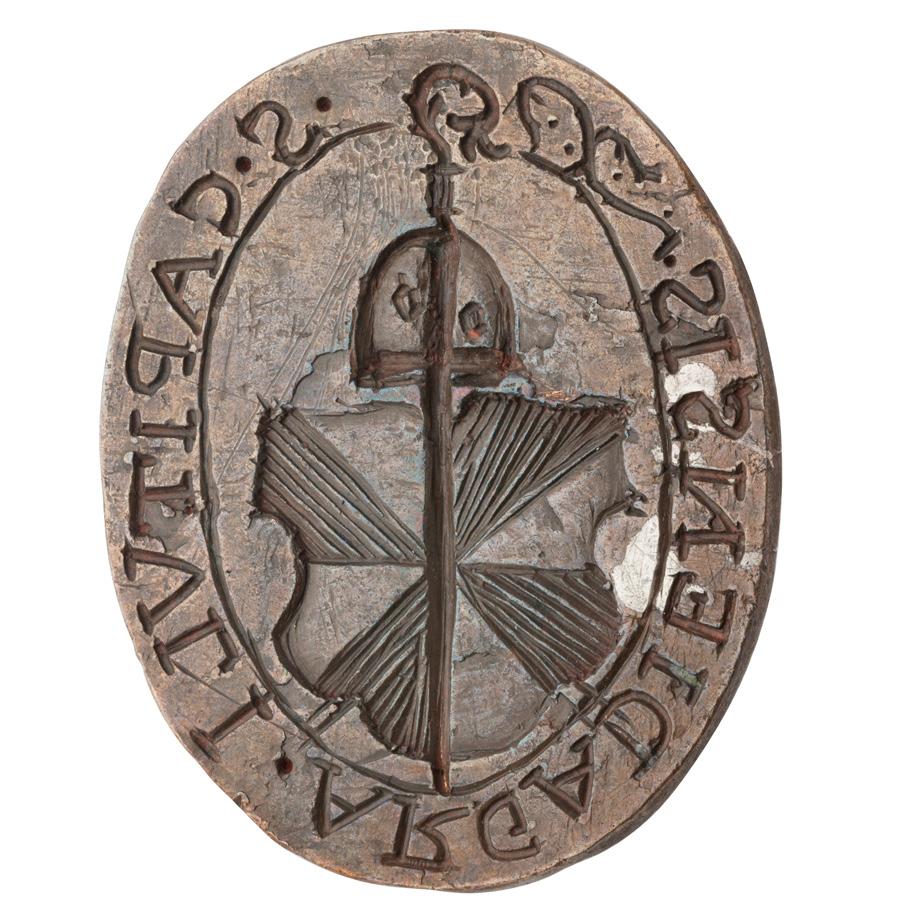
£100-200
82
AN EARLY BISHOP OF ARGYLL SEAL
A MEDIEVAL COPPER DESK SEAL
the integral matrix of oval outline engraved with the arms of Campbell of Argyll, in a border ‘S(gillium) CAPITULI ARGADIENSIS’, to a stylised handle with loop Matrix: 53mm x 43mm
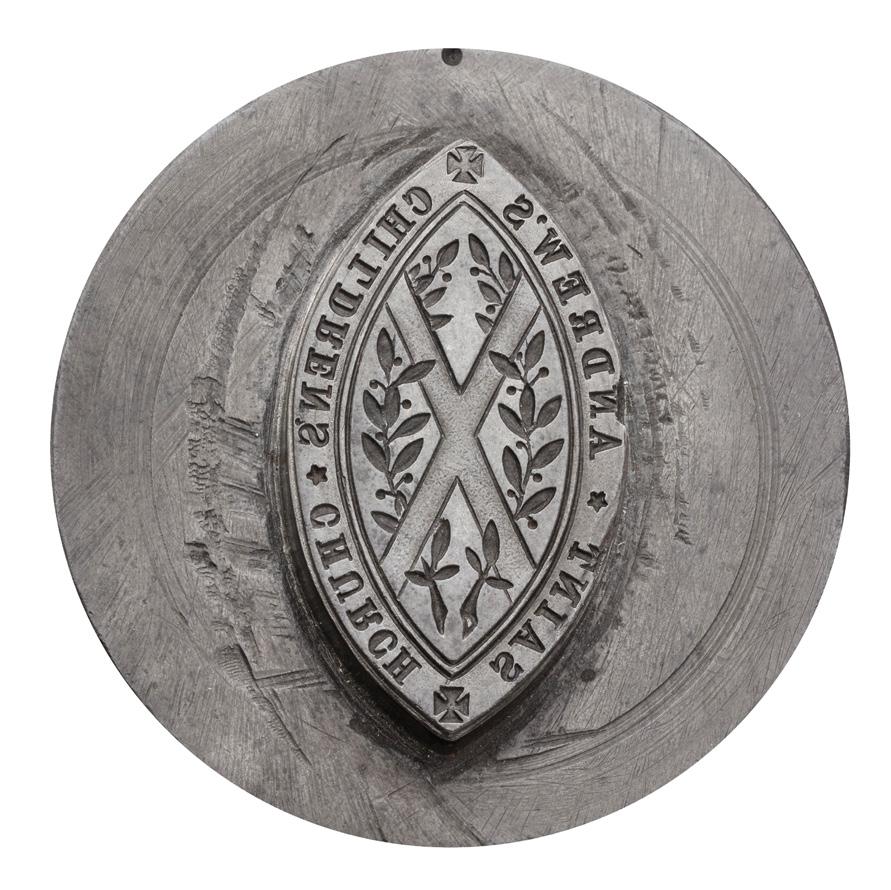
Heraldry: The Arms of Campbell, Bishop of Argyll Arms: Gyronny or and sable
The arms are ensigned with proto mitre and surmounted with a crozier to denote the office of bishop. The seal also as the inscription around the edge of the matrix which reads ‘‘S(IGLLIUM) CAPITULI ARGADIENSIS’.
Note: The Latin translation ‘Seal of the Cathedral’s Capitulum of Argyle’ Upon examination of the lists of early Bishops of Argyll, there appear to be two candidates for the ownership of this seal. The first being Neil Campbell (died circa 1613 or 1627). It is thought that he was the Neil Campbell who graduated from the University of St Andrews with a Master of Arts in 1575 and that he became parson of Kilmartin and precentor of Lismore Cathedral in 1574. The second candidate for the ownership of this seal was Neil’s son, John who served as the Bishop of Argyll from the 1st June 1608 for about four and half years, dying in January 1613. £600-800
83
THE GLASGOW CATHEDRAL OR HIGH KIRK OF GLASGOW DESK SEAL AN EARLY TO MID 19TH-CENTURY CENTURY WOODEN AND BRASS DESK SEAL
the baluster handle with turned detail to terminal, the brass matrix of oval outline, with the coat of arms of the city of Glasgow in a border engraved WARDEN’S OFFICE CATHEDRAL
Length: 86mm, matrix: 15mm x 13mm
Note: The oldest cathedral in Scotland, the building of Glasgow Cathedral began in 1136 and took around 350 years to complete.
The cathedral is dedicated to the 6th century Christian missionary Saint Mungo, who became the patron saint of Glasgow, and whose tomb lies at the centre of the building’s Lower Church.
The motto for Glasgow, ‘Let Glasgow flourish’ is inspired by Mungo’s original call “Let Glasgow flourish by the preaching of the word”.
The 16th-century Scottish Reformation took its toll on the church and it wasn’t until I579 when the members of the Glasgow Trades House stepped in to defend the cathedral from further depredation that the church was saved.
£250-350
297 Other fees apply in addition to the hammer price: see the ‘Buyer’s Guide’ section on page 2
84
MAJOR GORGES MARCUS IRVINE (1760-1847) DESK SEAL

AN EARLY 19TH-CENTURY EBONY AND BRASS SEAL
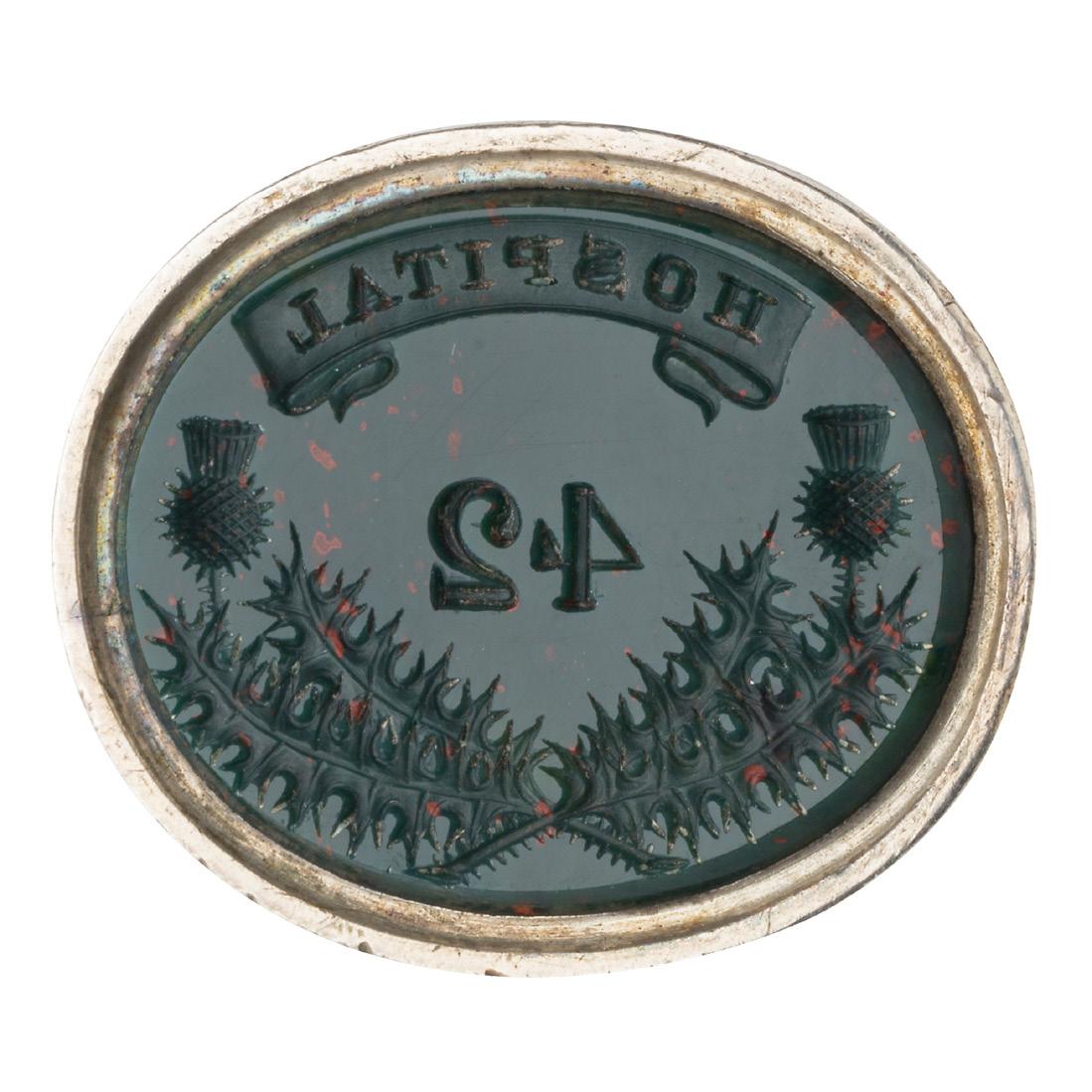
the ebony baluster handle with bulbous head, to a brass matrix, engraved with the arms of Irvine
Length: 97mm, matrix: 21mm x 26mm
Heraldry: Arms: Or a fess gules between three holly leaves proper Crest: A dexter in armour fesswise issuant out of a cloud the hand proper holding a thistle also proper Motto: Dum memory ipse mei (While I am mindful of myself)
Note: Major Gorges Marcus Irvine was born on 26th November 1760 in Castle Irvine, Country Fermanagh, Ireland, to William Irvine and Sophia (Lowther) Irvine. He was the eldest surviving son and inheritor of the Irvine estate. The Irvine family mottos were sub umbra sub sole virescens, meaning ‘flourishing both in sunshine and in shade’, and dum memor ipse mei, seen on the seal, translating to ‘while I am mindful of myself’.
£250-350
85
COLONEL SIR JOHN PRINGLE
DALRYMPLE 5TH BARONET OF HAILES (1774-1829) SEAL
AN EARLY 19TH-CENTURY HARDWOOD AND BRASS SEAL
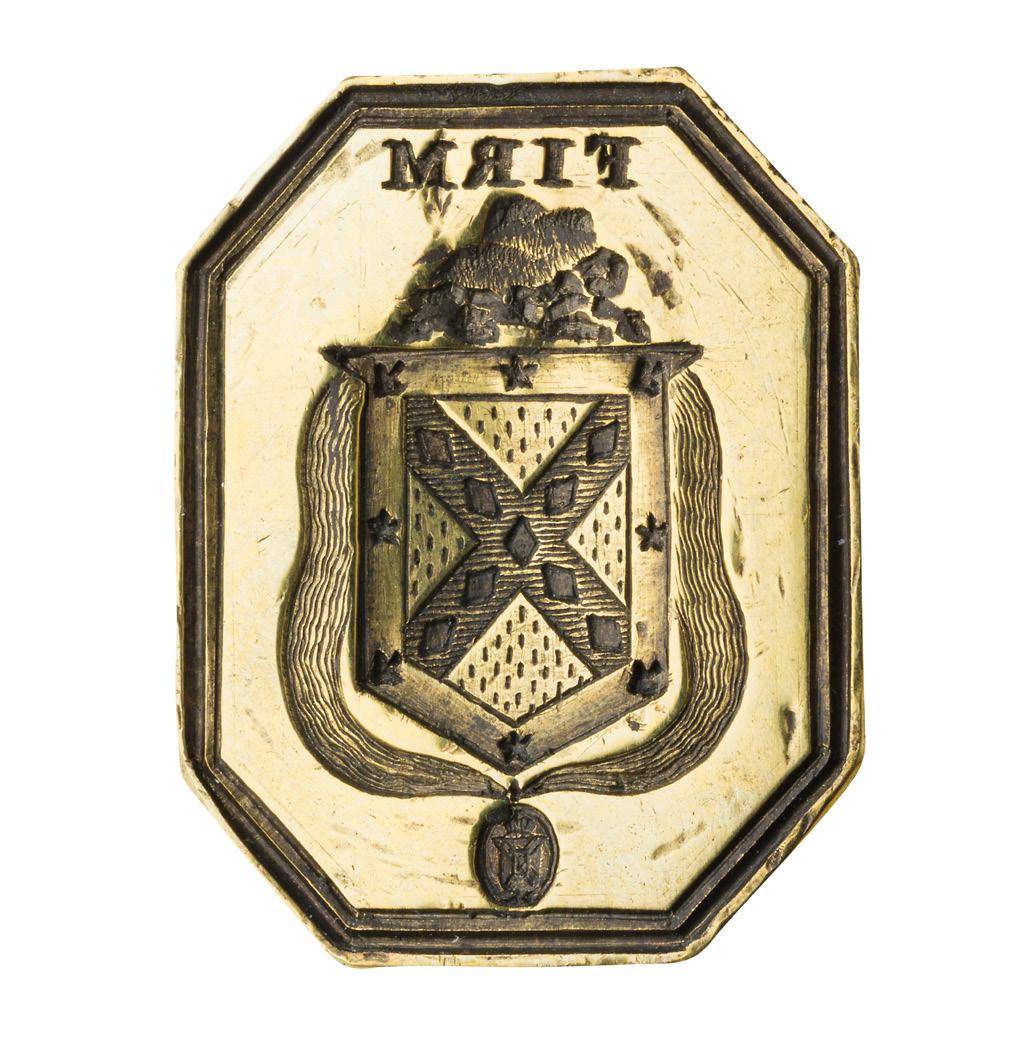
the simple turned hardwood handle of tapering form, to a brass collar and matrix, engraved with the arms of Dalrymple of Hailes
Length: 10.5cm, matrix: 23mm x 20mm
Heraldry: Arms: Or on a saltire azure nine lozenges of the field a bordure of the second charged with four boars’ head coupled alternating with a like number of mullets of the field
The arms environed with the ribbon and badge of a baronet of Nova Scotia (or Scotland)
Crest: A rock proper
Motto: Firm
£500-700
Note: The Dalrymple family was a prestigious Scottish family, with members partaking in roles integral to Scottish society such as Historians, Advocates, and Lord Provost of Edinburgh. They were also possessors of the Baronetcy of Hailes, in 1709 the first Baronet of Hailes purchased Whitehills House, in East Lothian, renaming it Newhailes. Newhailes House is an 18th-century villa and was once famous for having one of the largest libraries in Europe.
John Pringle Dalrymple (1774-1829) was the fifth Baron. At the age of 18, he entered the military service as an ensign of the 90th Regiment of Foot (90th (Perthshire Volunteers) Regiment of Foot). He was awarded Knight of the Order of the Bath, on December 28th, 1807
A painting by George Watson (17671837) of John Pringle Dalrymple from the collection of the Newhailes Estate, and is now part of the National Trust for Scotland collection.
86
A VICTORIAN HARDSTONE DESK SEAL, CIRCA 1870
the ebony handle of baluster form, to a knopped stem, with silver gadrooned collar, the oval bloodstone matrix engraved with a banner inscribed HOSPITAL above numerals 42, flanked by sprays of thistles
Length: 87mm (overall), matrix: 20mm x 16mm
Note: Although the exact origin of this seal remains unknown it seems possible that it is connected with the 42nd (Royal Highland) Regiment of Foot, latterly, The Black Watch, and was for one of their hospitals built up around or after the many important battles. Some of their campaigns and postings were for many years so setting up infrastructure such as hospitals and equipping it with official paperwork, seals etc would have been standard practice and shows how important the hospitals were to the battalions. The displayed thistles are very like those seen on other military items and indeed can be seen on their cap badge. Although original ownership has been impossible to prove it does seem likely.
£500-800
298 Other fees apply in addition to the hammer price: see the ‘Buyer’s Guide’ section on page 2
A SCOT’S GUARD REGIMENTAL DESK SEAL

A LATE 19TH-CENTURY EBONISED WOOD AND CARNELIAN DESK SEAL
the wooden handle with a simple domed terminal, the metal collar to a carnelian matrix engraved with the badge of the Order of the Thistle mounted on an eight-point star as used by the Scot’s Guards regiment
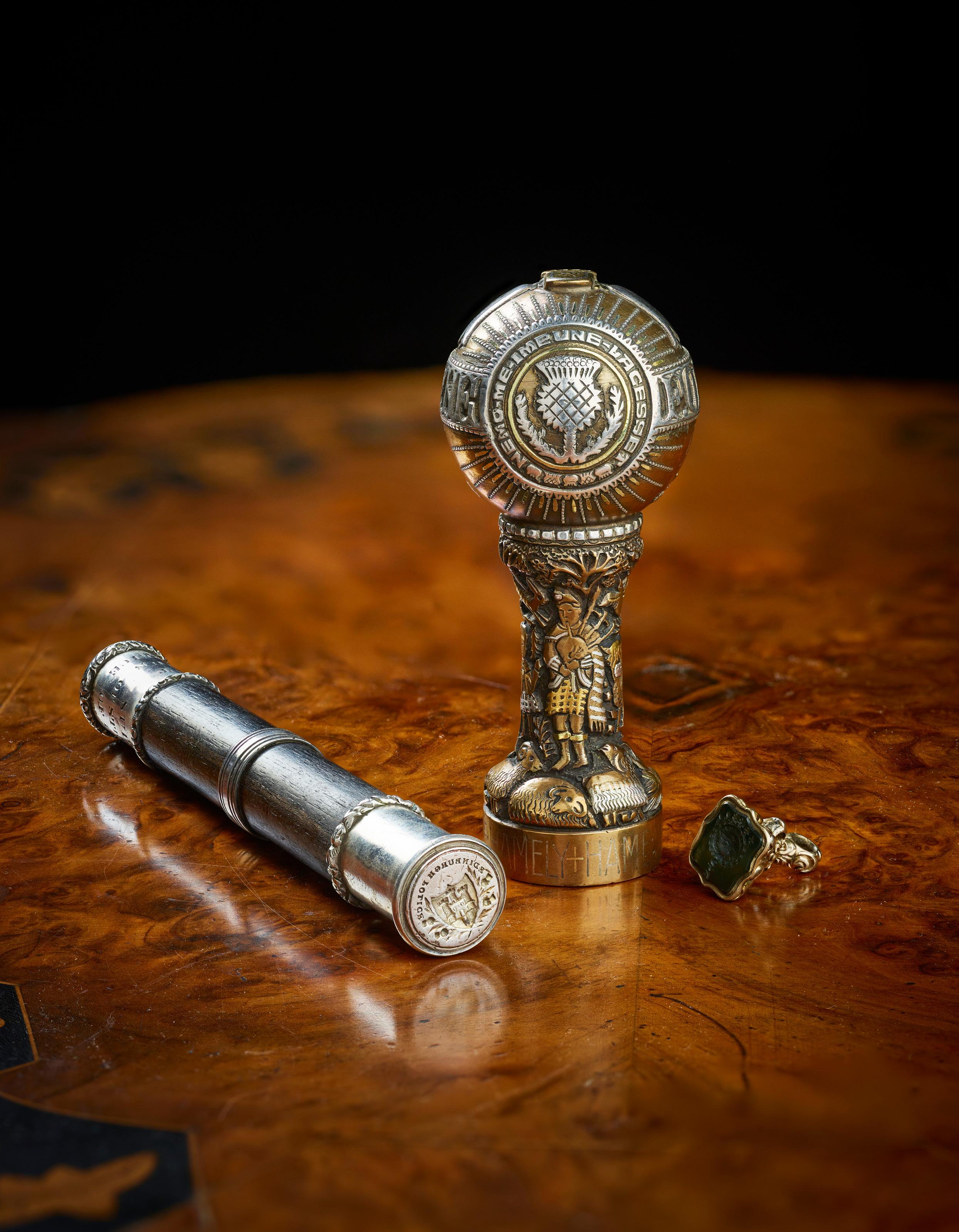
Length: 84mm, matrix: 14mm x 6mm
Note: See Lyon & Turnbull, lot 162 in Select Jewellery and Watches, 2nd May 2019, for a pair of cufflinks with the Scot’s Guards badge
£400-600
A SCOTTISH MOTTO AND ORDER OF THE THISTLE ASSOCIATED DESK SEAL
AN EARLY 20TH-CENTURY MIXED METAL DESK SEAL the handle formed as a sphere with various Scottish motifs, an embossed thistle in a border ‘NEMO ME IMPUNE

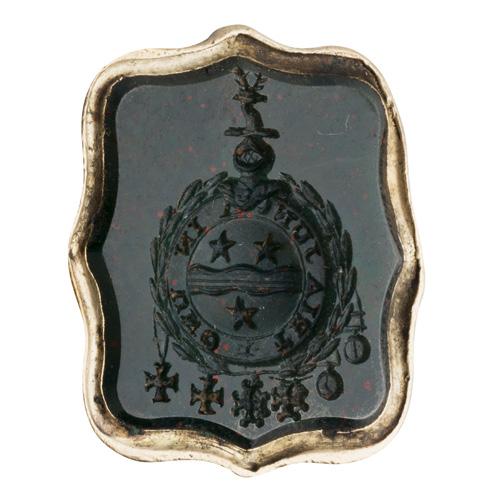
LACESSIT’, the stem and base heavily decorated with Scottish motifs and animals, the base engraved HAME IS AY HAME BE IT EVER SAE HAMELY’, the integral matrix engraved with an A in the flower of a thistle Length: 97mm, matrix diameter: 30mm
£400-600
89
THE FOB SEAL OF INSPECTOR-GENERAL SIR JAMES NICHOLS DICK
A VICTORIAN GILT METAL AND BLOODSTONE FOB SEAL, CIRCA 1880 the fluted and scrolling mount enclosing a shield-shaped chased bloodstone matrix, finely engraved with arms, crest and motto within a laurel leaf garland and with six medal pendants suspended below Length: 23mm, matrix: 9mm x 6mm
Note: The engraved arms of Inspector-General Sir James Nichols Dick K.C.B, C.B, L.K.Q.C.P, L.R.C.S, entered naval medical service in 1853, becoming Inspector General in 1884 before retiring in 1892. He served in both the Crimean and Abyssinian wars and was a Senior Medical Officer at the Royal Naval Hospital of Malta in 1882. He would go on to serve in the same role at the Royal Naval Hospital Haslar 1884-1887 and latterly apportioned Director General of the Naval Medical Department in 1888.
£150-250
87
88
88 89 91 299
90
AN EARLY VICTORIAN EDINBURGH POLICE COMBINATION SILVER MOUNTED TIPSTAFF AND SEAL, CIRCA 1840 the simple ebony cylindrical shaft with reeded mount to centre, with socket mounted pommel caps the upper with VR cypher with Royal crown above, the upper flat engraved with a seal of the city arms flanked by thistles and Edinburgh Police above, the lower mount engraved FIRST LIEUTENANT OF EDINBURGH POLICE
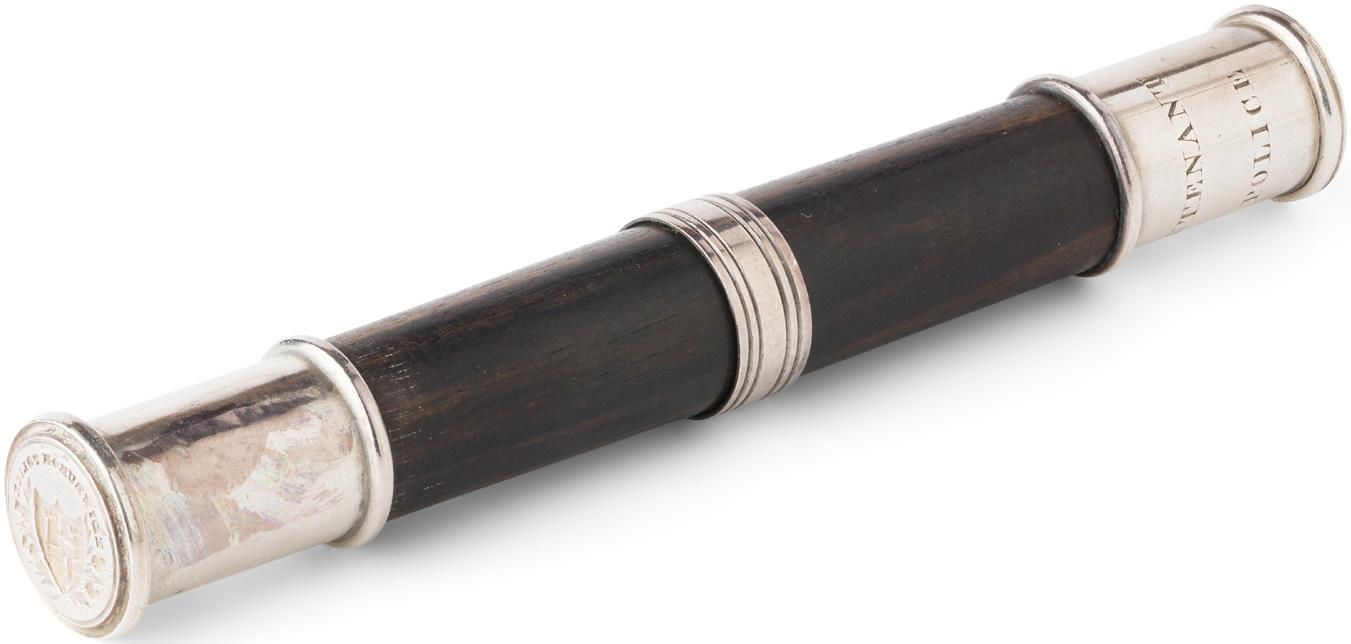
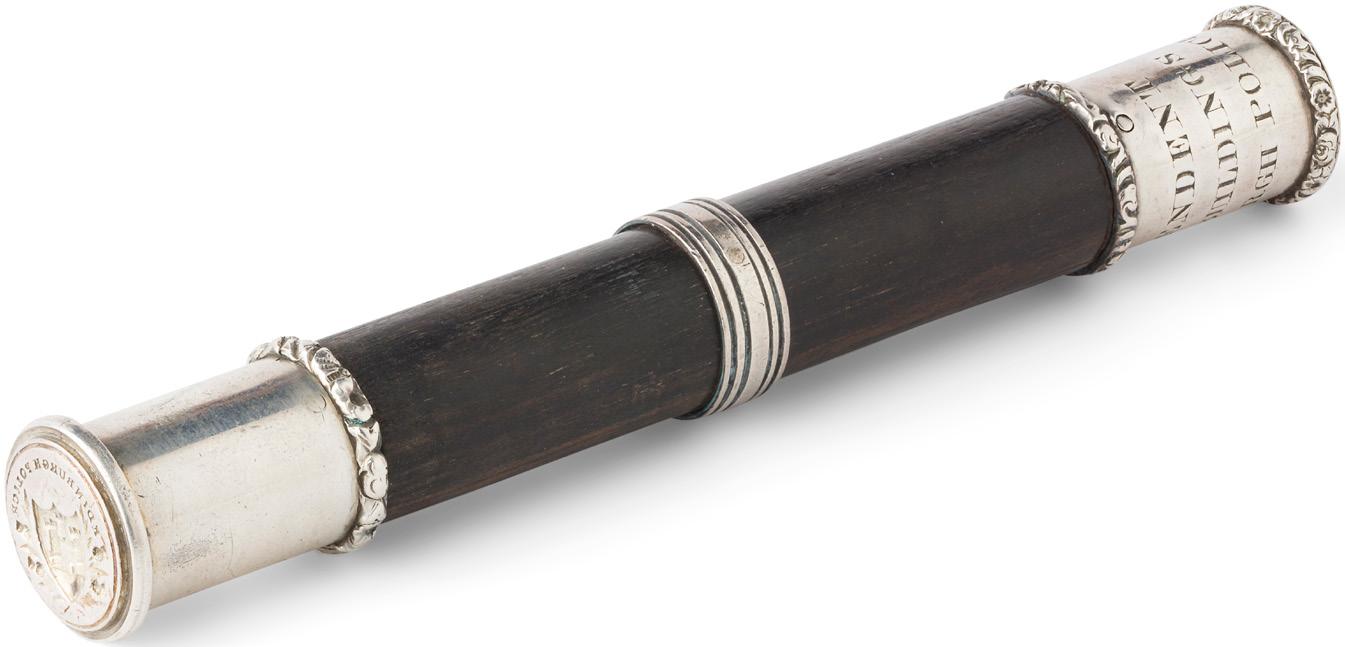
Length: 12.7cm, matrix 20mm diameter
Provenance: Matrix: A Collection of British Seals - David Morris 2012 - Seal 27, page 71
£600-800
91
AN EARLY VICTORIAN EDINBURGH POLICE COMBINATION SILVER MOUNTED TIPSTAFF AND SEAL, CIRCA 1840 the simple ebony cylindrical shaft with reeded mount to centre, with socket mounted pommel caps the upper with VR cypher with Royal crown above, the upper flat engraved with a seal of the city arms flanked by thistles and Edinburgh Police above, the lower mount engraved SUPERINTENDENT OF STREETS & BUILDINGS OF EDINBURGH POLICE
Length: 12.7cm, matrix 20mm diameter

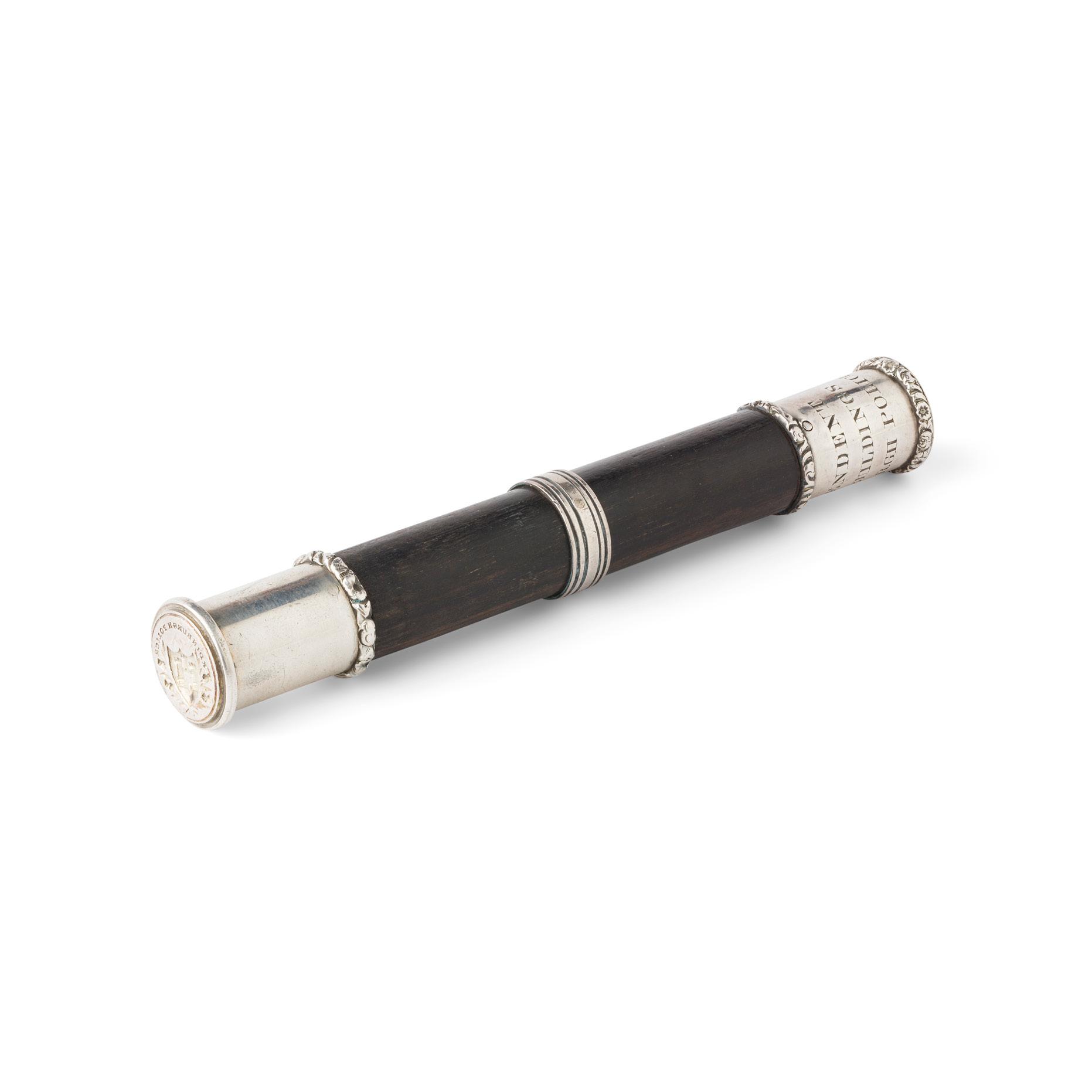

Provenance: Matrix: A Collection of British Seals - David Morris 2012- Seal 27, Pg 71
£600-800
Note: Tipstaves were carried by police officers from the late eighteenth century onwards as a badge of office, the forerunner of the modern warrant card. Originally the shaft was hollow to contain the document of authority.
The Edinburgh Police Act of 1805 replaced the old constabulary police system throughout the city, some 24 years before Sir Robert Peel founded the Metropolitan Police in London and brought in with it a uniform. The Edinburgh Police Force was administered until 1865 by a Police commission, and not by the town council. The rank of Lieutenant, used from 1812 in Scotland, came above inspector and below assistant superintendent, being roughly equivalent to an English chief inspector. It would appear that specific historic areas have used Tipstaffs for centuries to denote positions of authority but they do not typically combine a seal matrix.
While having the appropriate armorial or royal cipher is common to the end mount caps these two examples are among a very small number, if not the only, examples recorded with a seal matrix.

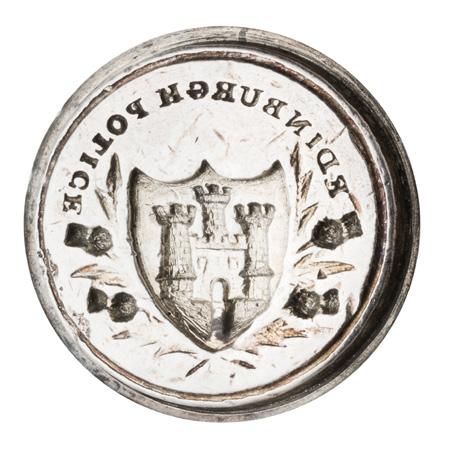
Other fees apply in addition to the hammer price: see the ‘Buyer’s Guide’ section on page 2
91 90
THE GLENURY ROYAL DISTILLERY SEAL
AN EARLY 19TH-CENTURY WOODEN AND BRASS DESK SEAL
the wooden handle of baluster form, with a knopped stem, the brass matrix circular outline, crown to centre in a border engraved ‘GLENURY ROYAL DISTILLERY’
Length: 9.5cm, matrix diameter: 29mm
Note: Glenury Royal Distillery was founded in 1825 by Captain James Barclay. Unlike the few other distilleries to have the title of ‘Royal’ it used this title from its earliest days as the founder was a friend of King William IV, rather than being awarded it by patronage over the years. This now closed Highland distillery in Stonehaven would be run by Barclay until 1858 when it would be sold in the first of many changes of ownership up to its eventual closure in 1985. The distillery, although in production most of its life did not release much if any, single malt whisky when it was active in the market instead of being a workhorse of the blending market. Very few official releases have been produced and these have always been in limited editions, including 40 and 50-year-old expressions.
£150-180
93
THE BUCK DISTILLERY DESK SEAL
A WOODEN, COPPER AND BRASS SEAL, BANFFSHIRE, CIRCA 1826 the turned wooden handle of baluster form, the applied brass terminal with engraved italic initials JS, the circular copper matrix engraved ‘BUCK DISTILLERY Js.SMITH’
Length: 99mm, matrix: 35mm x 35mm
Note: Buck Distillery was one of the early and few legally licensed distilleries in the Cabrach. The remote part of Speyside was renowned for its many illicit stills and no doubt its remote and unforgiving landscape gave rise to and success of many of these distillers. Buck Distillery was one of the few legal exceptions.
Likely a traditional farm distillery run parallel to the main business of farming it was granted a license in 1826 after the new licenses scheme came in only three years earlier in 1823. It survived until 1833 on the death of the founder James Smith.
Little is known of this long-lost distillery and it seems likely, other than the record of the license, this seal is the only relic of the distillery to survive.

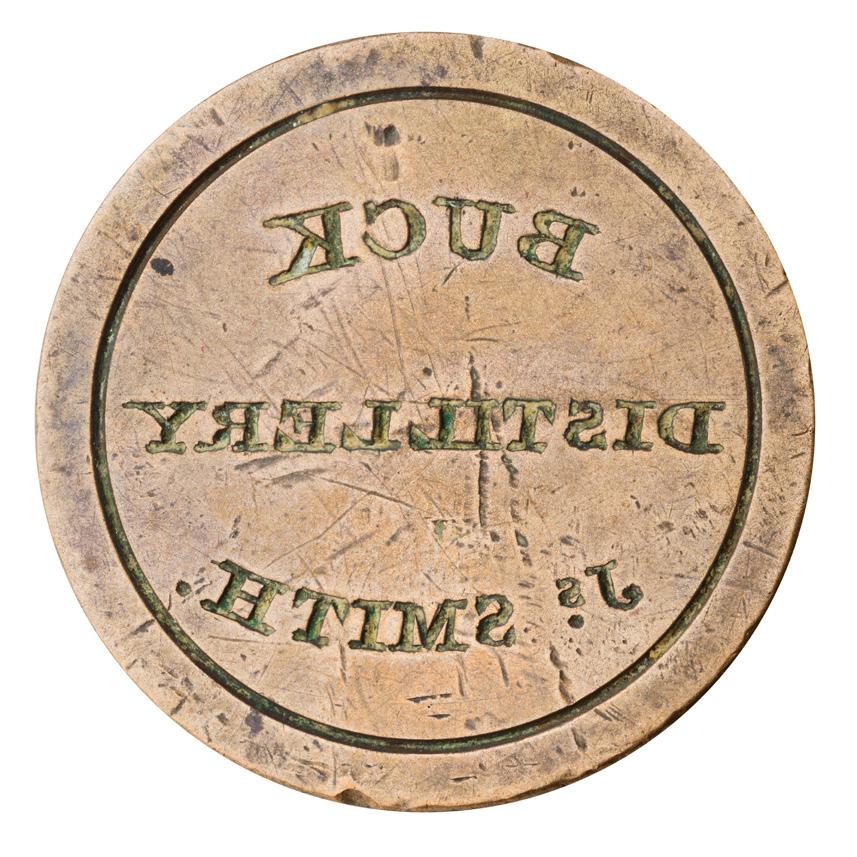
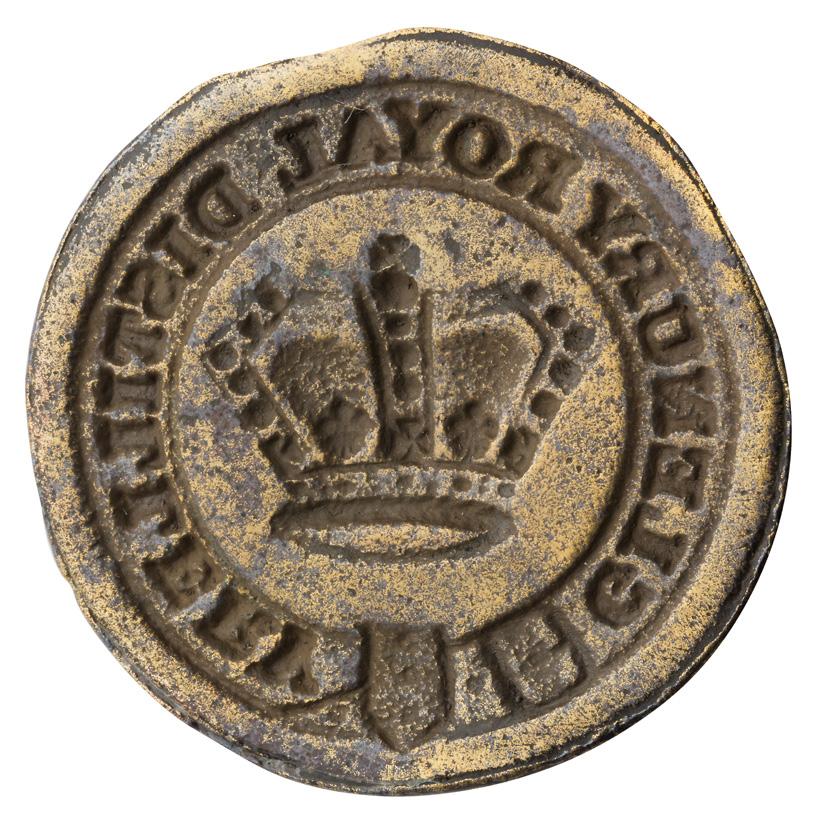
£200-300
94
THE COCKBURN & CAMPBELL ‘WHISKY’ SEAL
AN 18TH-CENTURY BRASS DESK SEAL
the brass circular disk engraved with ‘COCKBURN & CAMPBELL/ WHISKY’, to the reverse, marked ‘FARROW & JACKSON/ LONDON’ with screw fitting
Diameter of matrix: 52mm
£150-180
95
A VICTORIAN BRASS COMBINATION SPIRIT MERCHANT’S SEAL
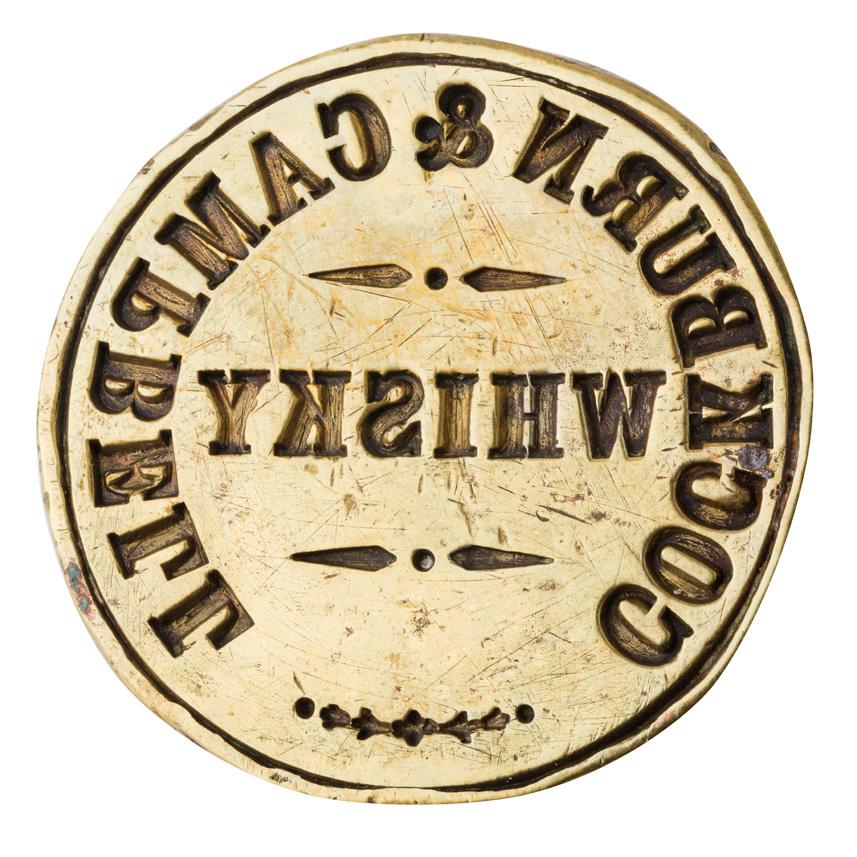
CIRCA 1850
the brass baluster handle with twin matrices, the large pommel matrix engraved ‘Alexr Taylor Restauranteur & Spirit Merchant, 179 Trongate Glasgow’ screws off to reveal compartment containing four interchangeable matrices for WHISKY, SHERRY, RUM, CLARET and PORT, the smaller matrix engraved to outer border ‘Alexr Taylor Glasgow’ the inner section interchangeable
Length: 12cm, diameter of matrices 32mm and 25mm
£300-500
301 92
A MASONIC DESK SEAL - LODGE OF ST. MAHUTS LESMAHAGOW

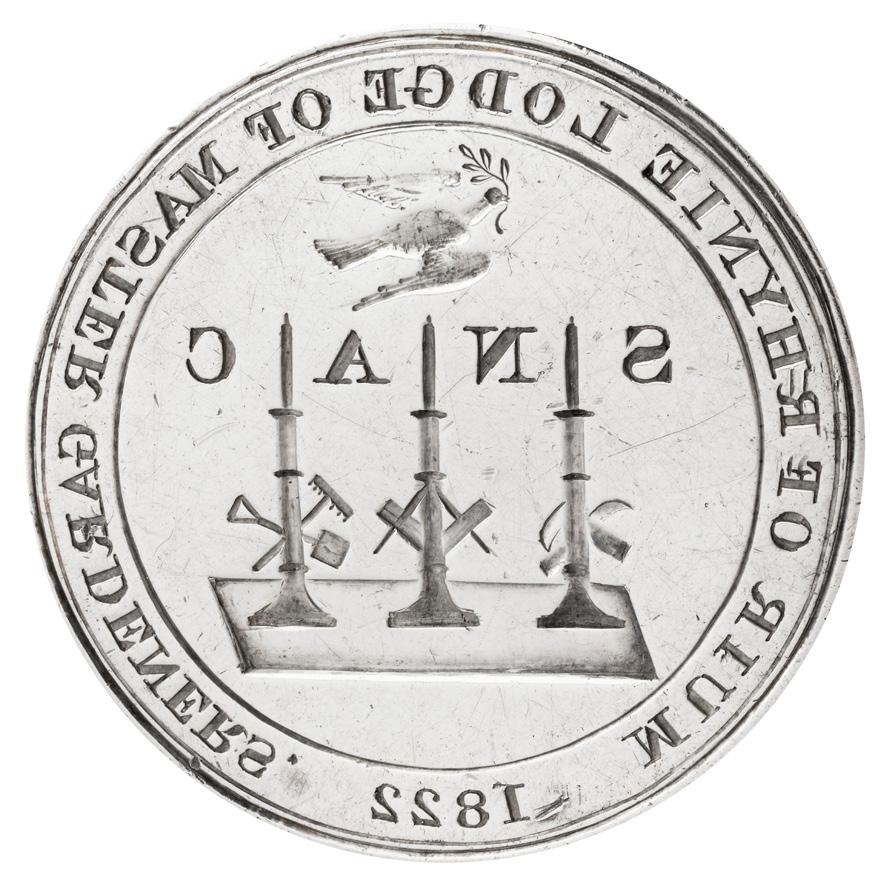
A LATE 18TH-CENTURY WOODEN AND BRASS DESK SEAL
the baluster handle with a turned flat top, the brass circular matrix engraved with Masonic symbols and ‘No 22’, the border engraved ‘ST MAHUTS LODGE LESMAHAGOW’

Length: 85mm, matrix diameter: 35mm
£150-250
97
THE GREENOCK DISTRICT LODGE OF THE LOYAL ORANGE INSTITUTION OF GREAT BRITAIN SEAL
A MID-VICTORIAN BRASS AND LABURNUM DESK SEAL, CIRCA 1850 the turned baluster laburnum handle to a large circular brass matrix, engraved with an image of King William on horseback with Wm III, 1690 below, surrounded but motto Loyal Orange Institution of Great British, Greenock District Lodge No 3

Length: 12.3cm, matrix diameter: 41mm
Note: Although the origin of Orangism in Scotland can be traced much further back it was only by the mid 1850’s that the number of Lodges numbered greater than ten, Greenock Lodge being one of the early established and on this numbered as Lodge 3, although in some sources given as Lodge 8.
£400-600
98
ABERDEENSHIRE - A SCOTTISH PROVINCIAL MASONIC DESK SEAL
AN EARLY 19TH-CENTURY WOODEN AND SILVER DESK SEAL
unmarked, the turned wooden handle (replaced) to the domed seal with foliate collar and reeded decoration to reverse of matrix, the matrix reverse engraved for ‘Muir of Rhynie Lodge of Master Gardeners 1822’ and with emblems to the centre of crossed tools and dove of peace in flight
Length: 11cm, diameter of matrix: 47mm
Provenance: Lyon & Turnbull 17th August 2009, lot 364 (lacking handle)
Matrix: A Collection of British Seals - David Morris 2012 - Seal 31, page 78
Note: The inscription reads MUIR of RHYNIE LODGE OF MASTER GARDENERS / 1822. The seal is of the lodge of Master Gardeners in Muir of Rhynie, between the Firths of Dornoch and Cromarty in Aberdeenshire. The Muir of Rhynie Lodge was founded in 1812 and appears to have some closed sometime after 1834. Societies of Gardeners have existed in Scotland from the seventeenth century Initially formed by working gardeners to promote and encourage their profession by spreading horticultural knowledge and disseminating new plants, (many known as ‘Free Gardeners’) welcomed members from other professions and during the nineteenth century evolved into a combination of friendly society and Masonic Lodge. Some Gardeners’ Lodges joined together into orders, but others, such as this one, remained independent with their own complicated rituals. In general, the symbolism is based on the biblical story of the Creation and the Garden of Eden. The coded initials PGTE represented the four rivers of Eden, Pishon, Gihon, Tigris, and Euphrates) and the initials ANS represented Adam, Noah, and Solomon, with depictions of suitable images such as Noah’s dove or Adam and Eve standing hand in hand. As in Masonry, these would be combined with the gardening tools of the trade on the lodge’s regalia, which would be made locally to the required specifications. In the case of the Muir of Rhynie Lodge, unusually the gardening tools are crossed with three candlesticks, presumably representing enlightenment, and the initials SNA are accompanied by the so-far unidentified letter C. In other lodges, the letters can be found accompanied by a D for ‘dove’ or an O for ‘olive’
£800-1,200
96
302 Other fees apply in addition to the hammer price: see the ‘Buyer’s Guide’ section on page 2
99
ABERDEEN - A SCOTTISH PROVINCIAL FOB SEAL - MASONIC INTEREST
A LATE 19TH-CENTURY GOLD MOUNTED SMOKEY QUARTZ FOB SEAL
marked J.C. ABDN for James Crichton, or James Carr the oval facetted smoky quartz matrix with monogrammed initials in collet mount with pierced and engraved Masonic square and compass suspension

Length: 30mm, matrix: 25mm x 14mm
Note: For discussion on the confusion between these two makers and their connection to the J.C. makers mark, see Silver, The Aberdeen Story, Aberdeen Art Gallery & Museum, page 162 £600-800
100
THE UNION LODGE, DUNFERMLINE DESK SEAL - MASONIC INTEREST
A LATE 19TH-CENTURY WOODEN AND BRASS DESK SEAL

the wooden handle of baluster form, the brass collar to a circular matrix engraved with the triple flowers; thistle, rose and shamrock of the Union within a motto and inscription
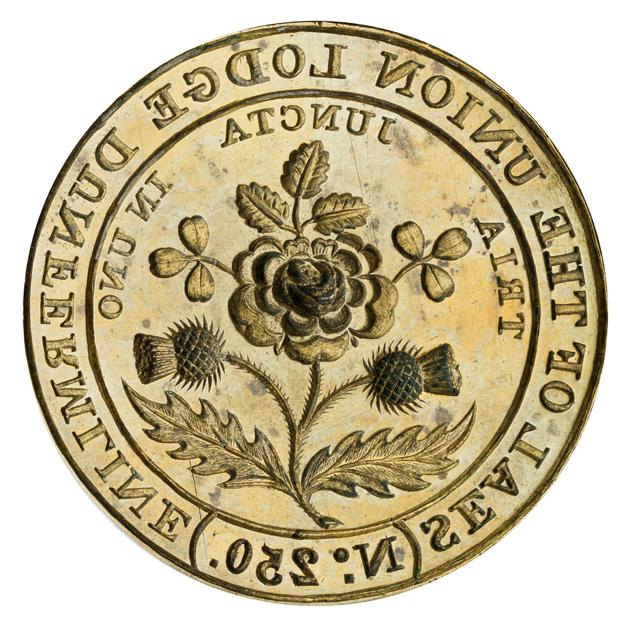
Length: 95mm, matrix diameter: 47mm
Note: The Union Lodge, Dunfermline, Fife, was chartered on 1st November 1813. It became No. 250 between 1822 and 1826 and continued to use this number at least until 1951
£250-350
END OF SALE
99 303
CONDITIONS OF SALE
FOR BUYERS (UK)
These Conditions of Sale and the Saleroom Notices as well as specific Catalogue terms, set out the terms on which we offer the Lots listed in this Catalogue for sale. By registering to bid and/or by bidding at auction You agree to these terms, we recommend that You read them carefully before doing so. You will find a list of definitions and a glossary at the end providing explanations for the meanings of the words and expressions used. Special terms may be used in Catalogue descriptions of particular classes of items (Books, Jewellery, Paintings, Guns, Firearms, etc.) in which case the descriptions must be interpreted in accordance with any glossary appearing in the Catalogue. These notices and terms will also form part of our terms and conditions of sales.
In these Conditions the words “Us”, “Our”, “We” etc. refers to Lyon & Turnbull Ltd, the singular includes the plural and vice versa as appropriate. “You”, “Your” means the Buyer. Lyon & Turnbull Ltd. acts as agent for the Seller. Lyon & Turnbull Ltd. acts as agent for the Seller. On occasion where Lyon & Turnbull Ltd. own a lot in part or full the property will be identified in the catalogue with the symbol (��) next to its lot number.
A. BEFORE THE SALE 1. DESCRIPTIONS OF LOTS
Whilst we seek to describe Lots accurately, it may be impractical for us to carry out exhaustive due diligence on each Lot. Prospective Buyers are given ample opportunities to view and inspect before any sale and they (and any independent experts on their behalf) must satisfy themselves as to the accuracy of any description applied to a Lot. Prospective Buyers also bid on the understanding that, inevitably, representations or statements by us as to authorship, genuineness, origin, date, age, provenance, condition or Estimated selling price involve matters of opinion. We undertake that any such opinion shall be honestly and reasonably held and only accept liability for opinions given negligently or fraudulently. Subject to the foregoing neither we the Auctioneer or our employees or agents accept liability for the correctness of such opinions and no warranties, whether relating to description, condition or quality of Lots, express, implied or statutory, are given. Please note that photographs/ images provided may not be fully representative of the condition of the Lot and should not be relied upon as indicative of the overall condition of the Lot. All dimensions and weights are approximate only.
2. OUR RESPONSIBILITY FOR OUR DESCRIPTION OF LOTS
We do not provide any guarantee in relation to the nature of a Lot apart from our authenticity warranty contained in paragraph E.2 and to the extent provided below.
(a) Condition Reports: Condition Reports are provided on our Website or upon request. The absence of a report does not imply that a Lot is without imperfections. Large numbers of such requests are received shortly before each sale and department specialists and administration will endeavour to respond to all requests although we offer no guarantee. Any statement in relation to the Lot is merely an expression of opinion of the Seller or us and should not be relied upon as an inducement to bid on the Lot. Lots are available for inspection prior to the sale and You are strongly advised to examine any Lot in which You are interested prior to the sale. Our Condition Reports are not prepared by professional conservators, restorers or engineers. Our Condition Report does not form any contract between us and the Buyer. The Condition Reports do not affect the Buyer’s obligations in any way.
(b) Estimates: Estimates are placed on each Lot to help Buyers gauge the sums involved for the purchase of a particular Lot. Estimates do not include the Buyer’s Premium or VAT. Estimates are a matter of opinion and prepared in advance. Estimates may be subject to change and are for guidance only and should not be relied upon.
(c) Catalogue Alterations: Lot descriptions and Estimates are prepared in advance of the sale and may be subject to change. Any alterations will be announced on the Catalogue alteration sheet, made available prior to the sale. It is the responsibility of the Buyer to make themselves aware to any alterations which may have occurred.
3. WITHDRAWAL
Lyon & Turnbull may, at its discretion, withdraw any Lot at any time prior to or during the sale of the Lot. Lyon & Turnbull has no liability to You for any decision to withdraw.
4. JEWELLERY, CLOCKS & OTHER ITEMS
(a) Jewellery:
(i) Coloured gemstones (such as rubies, sapphires and emeralds) may have been treated to enhance their look, through methods such as heating and oiling. These methods are accepted practice but may make the gemstone less strong and/or require special care in future.
(ii) All types of gemstones may have been improved by some method. You may request a gemmological report for any Lot which does not have a report if the request is made to us at least
three weeks before the date of the sale and You pay the fee for the report in advance of receiving said report.
(iii) We do not obtain a gemmological report for every gemstone sold in our sales. Where we do get gemmological reports from internationally accepted gemmological laboratories, such reports may be described in the Sale Particulars. Reports will describe any improvement or treatment only if we request that they do so, but will confirm when no improvement or treatment has been made. Because of differences in approach and technology, laboratories may not agree whether a particular gemstone has been treated, the amount of treatment or whether treatment is permanent. The gemmological laboratories will only report on the improvements or treatments known to the laboratories at the date of the report.
(iv) For jewellery sales, all Estimates are based on the information in any gemmological report or, if no gemmological report is available, You should assume that the gemstones may have been treated or enhanced.
(b) Clocks & Watches: All Lots are sold “as seen”, and the absence of any reference to the condition of a clock or watch does not imply the Lot is in good condition and without defects, repairs or restorations. Most clocks and watches will have been repaired during their normal lifetime and may now incorporate additional/newer parts. Furthermore, we make no representation or warranty that any clock or watch is in working order. As clocks and watches often contain fine and complex mechanisms, Buyers should be aware that a general service, change of battery or further repair work, for which the Buyer is solely responsible, may be necessary. Buyers should also be aware that we cannot guarantee a watch will remain waterproof if the back is removed. Buyers should be aware that the importing watches such as Rolex, Frank Muller and Corum into the United States is highly restricted. These watches cannot be shipped to the USA and only imported personally. Clocks may be sold without pendulums, weights or keys.
(c) Alcohol: may only be sold to persons aged of 18 years and over. By registering to bid, You affirm that You are at least that age. All collections must be signed for by a person over the age of 18. We Reserve the right to ask for ID from the person collecting. Buyers of alcohol must make appropriate allowances for natural variations of ullages, conditions of corks and wine. We can provide no guarantees as to how the alcohol may have been stored. There is always a risk of cork failure and allowance by the Buyer must be made. Alcohol is sold “as is” and quality of the alcohol is entirely at the risk of the Buyer and no warranties are given.
(d) Books-Collation: If on collation any named item in the sale Catalogue proves defective, in text or illustration the Buyer may reject the Lot provided he returns it within 21 days of the sale stating the defect in writing. This, however, shall not apply in the case of unnamed items, periodicals, autographed letters, music M.M.S., maps, drawings nor in respect of damage to bindings, stains, foxing, marginal worm holes or other defects not affecting the completeness of the text nor in respect of Defects mentioned in the Catalogue, or at the time of sale, nor in respect of Lots sold for less than £300.
(e) Electrical Goods: are sold as “works of art” only and if bought for use must be checked over for compliance with safety regulations by a qualified electrician first. Use of such goods is entirely at the risk of the Buyer and no warranties as to safety of the goods are given.
(f) Upholstered items: are sold as “works of art” only and if bought for use must be checked over for compliance with safety regulations (items manufactured prior to 1950 are exempt from any regulations). Use of such goods is entirely at the risk of the Buyer and no warranties as to safety of the goods are given. We provide no guarantee as to the originality of any wood/material contained within the item.
B. REGISTERING TO BID
1. NEW BIDDERS
(a) If this is Your first time bidding at Lyon & Turnbull or You are a returning Bidder who has not bought anything from us within the last two years You must register at least 48 hours before an auction to give us enough time to process and approve Your registration. We may, at our discretion, decline to permit You to register as a Bidder. You will be asked for the following:
(i) Individuals: Photo identification (driving licence, national identity card or passport) and, if not shown on the ID document, proof of Your current address (for example, a current utility bill or bank statement)
(ii) Corporate clients: Your Certificate of Incorporation or equivalent document(s) showing Your name and registered address together with documentary proof of directors and beneficial owners, and;
(iii) Trusts, partnerships, offshore companies and other business structures please contact us directly in advance to discuss requirements.
(b) We may also ask You to provide a financial reference and/or a deposit to allow You to bid. For help, please contact our Finance Department on +44(0)131 557 8844.
2. RETURNING BIDDERS
We may at our discretion ask You for current identification as described in paragraph B.1.(a) above, a finance
304
22.3
reference or a deposit as a condition of allowing You to bid. If You have not bought anything from us in the last two years, or if You want to spend more than on previous occasions, please contact our Finance Department on +44(0)131 557 8844.
3. FAILURE TO PROVIDE THE RIGHT DOCUMENTS
If in our opinion You do not satisfy our Bidder identification and registration procedures including, but not limited to, completing any anti-money laundering and/or anti-terrorism financing checks we may require to our satisfaction, we may refuse to register You to bid, and if You make a successful bid, we may cancel the contract between You and the Seller.
4. BIDDING ON BEHALF OF ANOTHER PERSON
(a) As an authorised Bidder: If You are bidding on behalf of another person, that person will need to complete the registration requirements above before You can bid, and supply a signed letter authorising You to bid for him/ her.
(b) As agent for an undisclosed principal: If You are bidding as an agent for an undisclosed principle (the ultimate Buyer(s)) You accept personal liability to pay the Purchase Price and all other sums due, unless it has been agreed in writing with us before commencement of the auction that the Bidder is acting as an agent on behalf of a named third party acceptable to us and we will seek payment from the named third party.
5. BIDDING IN PERSON
If You wish to bid in the saleroom You must register for a numbered bidding paddle before You begin bidding. Please ensure You bring photo identification with You to allow us to verify Your registration.
6. BIDDING SERVICES
The bidding services described below are a free service offered as a convenience to our clients and we are not responsible for any error (human or otherwise), omission or breakdown in providing these services.
(a) Phone bids
Your request for this service must be made no later than 12 hours prior to the auction. We will accept bids by telephone for Lots only if our staff are available to take the bids. If You need to bid in a language other than English You should arrange this Well before the auction. We do not accept liability for failure to do so or for errors and omissions in connections.
(b) Internet Bids
For certain auctions we will accept bids over the internet. For more information please visit our Website. We will use reasonable efforts to carry out online bids and do not accept liability for equipment failure, inability to access the internet or software malfunctions related to execution of online bids/ live
bidding.
(c) Written Bids
While prospective Buyers are strongly advised to attend the auction and are always responsible for any decision to bid for a particular Lot and shall be assumed to have carefully inspected and satisfied themselves as to its condition we shall, if so instructed, clearly and in writing execute bids on their behalf. Neither the Auctioneer nor our employees nor agents shall be responsible for any failure to do so. Where two or more commission bids at the same level are recorded we Reserve the right in our absolute discretion to prefer the first bid so made. Bids must be expressed in the currency of the saleroom. The Auctioneer will take reasonable steps to carry out written bids at the lowest possible price, taking into account the Reserve. If You make a written bid on a Lot which does not have a Reserve and there is no higher bid than Yours, we will bid on Your behalf at around 50% of the lower Estimate or, if lower, the amount of Your bid.
C. DURING THE SALE
1. ADMISSION TO OUR AUCTIONS
We shall have the right at our discretion, to refuse admission to our premises or attendance at our auctions by any person. We may refuse admission at any time before, during or after the auction.
2. RESERVES
Unless indicated by an insert symbol (∆), all Lots in this Catalogue are offered subject to a Reserve. A Reserve is the confidential Hammer Price established between us and the Seller. The Reserve is generally set at a percentage of the low Estimate and will not exceed the low Estimate for the Lot.
3. AUCTIONEER’S DISCRETION
The maker of the highest bid accepted by the Auctioneer conducting the sale shall be the Buyer and any dispute shall be settled at the Auctioneer’s absolute discretion. The Auctioneer may move the bidding backwards of forwards in any way he or she may decide or change the order of the Lots. The Auctioneer may also; refuse any bid, withdraw any Lot, divide any Lot or combine any two or more Lots, reopen or continuing bidding even after the hammer has fallen.
4. BIDDING
The Auctioneer accepts bids from:
(a) Bidders in the saleroom;
(b) Telephone Bidders, and internet Bidders through Lyon & Turnbull Live or any other online bidding platform we have chosen to list on and;
(c) Written bids (also known as absentee bids or commission bids) left with us by a Bidder before the auction.
5. BIDDING INCREMENTS
Bidding increments shall be at the Auctioneer’s sole discretion.
6. CURRENCY CONVERTER
The saleroom video screens and bidding platforms may show bids in some other major currencies as Well as sterling. Any conversion is for guidance only and we cannot be bound be any rate of exchange used. We are not responsible for any error (human or otherwise) omission or breakdown in providing these services.
7. SUCCESSFUL BIDS
Unless the Auctioneer decides to use their discretion as set out above, when the Auctioneer’s hammer falls, we have accepted the last bid. This means a contract for sale has been formed between the Seller and the successful Bidder. We will issue an invoice only to the registered Bidder who made the successful bid. While we send out invoices by post/or email after the auction, we do not accept responsibility for telling You whether or not Your bid was successful. If You have bid by written bid, You should contact us by telephone or in person as soon as possible after the auction to get details of the outcome of our bid to avoid having to pay unnecessary storage charges.
8. RELEVANT LEGISLATION
You agree that when bidding in any of our sales that You will strictly comply with all relevant legislation including local laws and regulations in force at the time of the sale for the relevant saleroom location.
D. THE BUYER’S PREMIUM, TAXES AND ARTIST’S RESALE ROYALTY
1. THE PURCHASE PRICE
For each Lot purchased a Buyer’s Premium of 26% of the Hammer Price of each Lot up to and including £20,000, plus 25% from £20,001 to £500,000, plus 20% from £500,001 thereafter. VAT at the appropriate rate is charged on the Buyer’s Premium. No VAT is payable on the Hammer Price or premium for printed books or unframed maps bought at auction. Live online bidding may be subject to an additional premium (level dependent on the live bidding service provider chosen). This additional premium is subject to VAT at the appropriate rate as above.
2. VALUE ADDED TAX
Value Added Tax is charged at the appropriate rate prevailing by law at the date of sale and is payable by Buyers of relevant Lots.
(a) Lots affixed with (†): Value Added Tax on the Hammer Price is imposed by law on all items affixed with a dagger
(†). This imposition of VAT maybe because the Seller is registered for VAT within the European Union and is not operating under a Margin Scheme.
(b) Lots affixed with (*): A reduced rate of Value Added Tax on the Hammer Price of 5% is payable. This indicates that a Lot has been imported from outwit the European Union. This reduced rate is applicable to Antique
items.
(c) Lots affixed with [Ω]: Standard rate of Value Added Tax on the Hammer Price and premium is payable. This applies to items that have been imported from outwit the European Union and do not fall within the reduced rate category outlined above.
3. ARTIST’S RESALE ROYALTY (DROIT DE SUITE)
This symbol § indicates works which may be subject to the Droit de Suite or Artist’s Resale Right, which took effect in the United Kingdom on 14th February 2006. We are required to collect a royalty payment for all qualifying works of art. Under new legislation which came into effect on 1st January 2012 this applies to living artists and artists who have died in the last 70 years. This royalty will be charged to the Buyer on the Hammer Price and in addition to the Buyer’s Premium. It will not apply to works where the Hammer Price is less than €1,000 (euros). The charge for works of art sold at and above €1,000 (euros) and below €50,000 (euros) is 4%. For items selling above €50,000 (euros), charges are calculated on a sliding scale. All royalty charges are paid to the Design and Artists Copyright Society (‘DACS’) and no handling costs or additional fees are retained by the Auctioneer. Resale royalties are not subject to VAT. Please note that the royalty payment is calculated on the rate of exchange at the European Central Bank on the date of the sale. More information on Droit de Suite is available at www.dacs.org.uk.
E. WARRANTIES
1. SELLER’S WARRANTIES
For each Lot, the Seller gives a warranty that the Seller;
(a) Is the owner of the Lot or a joint owner of the Lot acting with the permission of the other co-owners, or if the Sellers is not the owner of or a joint owner of the Lot, has the permission of the owner to sell the Lot, or the right to do so in law, and;
(b) Had the right to transfer ownership of the Lot to the Buyer without any restrictions or claims by anyone else. If either other above warranties are incorrect, the Seller shall not have to pay more than the Purchase Price (as defined in the glossary) paid by You to us. The Seller will not be responsible to You for any reason for loss of profits or business, expected savings, loss of opportunity or interest, costs, damages, other damages or expense. The Seller gives no warranty in relation to any Lot other than as set out above and, as far as the Seller is allowed by law, all warranties from the Seller to You, and all obligations upon the Seller which may be added to this agreement by law, are excluded.
2. AUTHENTICITY GUARANTEE
We guarantee that the authorship, period, or origin (collectively,
305
“Authorship”) of each Lot in this Catalogue is as stated in the BOLD or CAPITALISED type heading in the Catalogue description of the Lot, as amended by oral or written saleroom notes or announcements. We make no warranties whatsoever, whether express or implied, with respect to any material in the Catalogue other than that appearing in the Bold or Capitalised heading and subject to the exclusions below.
In the event we, in our reasonable opinion, deem that the conditions of the authenticity guarantee have been satisfied, it shall refund to the original purchaser of the Lot the Hammer Price and applicable Buyer’s Premium paid for the Lot by the original purchaser. This Guarantee does not apply if:
(a) The Catalogue description was in accordance with the opinion(s) of generally accepted scholar(s) and expert(s) at the date of the sale, or the Catalogue description indicated that there was a conflict of such opinions; or
(b) the only method of establishing that the Authorship was not as described in the Bold or Capitalised heading at the date of the sale would have been by means or processes not then generally available or accepted; unreasonably expensive or impractical to use; or likely (in our reasonable opinion) to have caused damage to the Lot or likely to have caused loss of value to the Lot; or
(c) There has been no material loss in value of the Lot from its value had it been in accordance with its description in the Bold or Capitalised type heading. This Guarantee is provided for a period of one year from the date of the relevant auction, is solely for the benefit of the original purchaser of the Lot at the auction and may not be transferred to any third party. To be able to claim under this Authenticity Guarantee, the original purchaser of the Lot must:
(a) notify us in writing within one month of receiving any information that causes the original purchaser of record to dispute the accuracy of the Bold or Capitalised type heading, specifying the Lot number, date of the auction at which it was purchased and the reasons for such dispute; and
(b) return the Lot to our registered office in the same condition as at the date of sale to the original purchaser of record and be able to transfer good title to the Lot, free from any third party claims arising after the date of such sale.
We have discretion to waive any of the above requirements. We may require the original purchaser of the Lot to obtain, at the original purchaser of Lot’s cost, the reports of two independent and recognised experts in the field. The reports must be mutually acceptable to us and the original purchaser of the Lot. We shall not be bound by any reports produced by the original purchaser of the Lot, and Reserves the
right to seek additional expert advice at its own expense. It is specifically understood and agreed that the rescission of a sale and the refund of the original Purchase Price paid (the successful Hammer Price, plus the Buyer’s Premium) is exclusive and in lieu of any other remedy which might otherwise be available as a matter of law. Lyon & Turnbull and the Seller shall not be liable for any incidental or consequential damages incurred or claimed, including without limitation, loss of profits or interest.
3. YOUR WARRANTIES
(a) You warrant that the funds used for settlement are not connected with any criminal activities, including tax evasion and You are neither; under investigation, have been charged with or convicted of money laundering, terrorist activities or other crimes.
(b) Where You are bidding on behalf of another person You warrant that:
(i) You have conducted appropriate customer due diligence on the ultimate Buyer(s) of the Lot(s) in accordance with all relevant anti-money laundering legislation, consent to us relying on this due diligence, and You will retain for a period of not less than five years the documentation evidencing the due diligence. You will make such documentation promptly available for immediate inspection by a third party auditor upon our written request to do so;
(ii) The arrangements between You and the ultimate Buyer(s) in relation to the Lot or otherwise do not, in whole or in part, facilitate tax crimes, and;
(iii) You do not know, and have no reason to suspect that the funds used for settlement are connected with the proceeds of any criminal activity, including tax evasion, or that the ultimate Buyer(s) are under investigation or have been charged with or convicted of money-laundering, terrorist activities, or other crimes.
F. PAYMENT
1. MAKING PAYMENT
(a) Within 7 days of a Lot being sold You will pay to us the Total Amount Due in cash or by such other method as is agreed by us. We accept cash, bank transfer (details on request), debit cards and Visa or MasterCard credit cards. Please note that we do not accept cash payments over £5,000 per Buyer per year.
(b) Any payments by You to us can be applied by us towards any sums owing by You to us howsoever incurred and without agreement by You or Your agent, whether express or implied.
(c) We will only accept payment from the registered Bidder. Once issued, we cannot change the Buyer’s name on an invoice or re-issue the invoice in a different name.
(d) The ownership of any Lots purchased shall not pass to You until You have made payment in full to us
of the Total Amount Due. The risk in and the responsibility for the Lot will transfer to You from whichever is the earlier of the following:
(i) When You collect the Lot; or
(ii) At the end of the 30th day following the date of the auction, or, if earlier, the date the Lot is taken into care by a third party unless we have agreed otherwise with You in writing.
(e) You shall at Your own risk and expense take away any Lots that You have purchased and paid for not later than 7 working days following the day of the auction or upon the clearance of any cheque used for payment whichever is later. We can provide You with a list of shippers. However, we will not be responsible for the acts or omissions of carriers or packers whether or not recommended by us.
(f) No purchase can be claimed or removed until it has been paid for.
(g) It is the Buyer’s responsibility to ascertain collection procedures, particularly if the sale is not being held at our main sale room and the potential storage charges for Lots not collected by the appropriate time.
2. IN THE EVENT OF NONPAYMENT
If any Lot is not paid for in full and taken away in accordance with these Conditions or if there is any other breach of these Conditions, we, as agent for the Sellers and on their behalf, shall at our absolute discretion and without prejudice to any other rights we may have, be entitled to exercise one or more of the following rights and remedies:
(a) To proceed against You for damages for breach of contract;
(b) To rescind the contract for sale of that Lot and/or any other Lots sold by us to You;
(c) To resell the Lot(s) (by auction or private treaty) in which case You shall be responsible for any resulting deficiency in the Total Amount Due (after crediting any part payment and adding any resale costs).
(d) To remove, store and insure the Lot in the case of storage, either at our premises or elsewhere and to recover from You all costs incurred in respect thereof;
(e) To charge interest at a rate of 5% a year above the Bank of Scotland base rate from time to time on all sums outstanding for more than 7 working days after the sale;
(f) To retain that or any other Lot sold to You until You pay the Total Amount Due;
(g) To reject or ignore bids from You or Your agent at future auctions or to impose conditions before any such bids shall be accepted;
(h) To apply any proceeds of sale of other Lots due or which become due to You towards the settlement of the Total Amount Due by You and to exercise a lien over any of Your
property in our possession for any purpose until the debt due is satisfied. You will be deemed to have granted such security to us and we may retain such property as collateral security for Your obligations to us; we may decide to sell Your property in any way we think appropriate. We will use the proceeds of the sale against any amounts You owe us and we will pay any amount left from that sale to You. If there is a shortfall, You must pay us the balance; and
(i) Take any other action we see necessary or appropriate.
G. COLLECTION & STORAGE
(1) It is the Buyer’s responsibility to ascertain collection procedures, particularly if the sale is not being held at our main sale room and the potential storage charges for Lots not collected by the appropriate time. Information on collection is set out in the Catalogue and our Website
(2) Unless agreed otherwise, You must collect purchased Lots within seven days from the auction. Please note the Lots will only be released upon full payment being received.
(3) If You do not collect any Lot within seven days following the auction we can, at our discretion;
(i) Charge You storage costs at the rates set out on our Website.
(ii) Move the Lot to another location or an affiliate or third party and charge You transport and administration costs for doing so and You will be subject to the third party storage terms and pay for their fees and costs.
(iii) Sell the Lot in any way we think reasonable.
H. TRANSPORT & SHIPPING
1. TRANSPORT AND SHIPPING
We will include transport and shipping information with each invoice sent to You as well as displayed on our Website. You must make all transport and shipping arrangements.
2. EXPORT OF GOODS
Buyers intending to export goods should ascertain;
(a) Whether an export licence is required; and
(b) Whether there is any specific prohibition on importing goods of that character, e.g. items that may contain prohibited materials such as ivory or rhino horn. It is the Buyer’s sole responsibility to obtain any relevant export or import licence. The denial of any licence or any delay in obtaining licences shall neither justify the recession of any sale not any delay in making full payment for the Lot.
3. CITES: ENDANGERED PLANTS AND ANIMALS LEGISLATION
Please be aware that all Lots marked with the symbol Y may be subject to CITES regulations when exporting these items outside the EU. These regulations may be found at http:// www.defra.gov.uk/ahvla-en/imports-
306
We accept no liability for any Lots which may be subject to CITES but have not be identified as such.
I. OUR LIABILITY TO YOU
(a) We give no warranty in relation to any statement made, or information give, by us, our representatives or employees about any Lot other than as set out in the authenticity warranty and as far as we are allowed by law, all warranties and other terms which may be added to this agreement by law are exclude. The Seller’s warranties contained in paragraph E.1 are their own and we do not have a liability in relation to those warranties.
(b) (i) We are not responsible to You for any reason whether for breaking this agreement or any other matter relating to Your purchase of, or bid for, any Lot other than in the event of fraud or fraudulent misrepresentation by us other than as expressly set out in these conditions of sale; or
(ii) We do not give any representation, warranty or guarantee or assume any liability for a kind in respect of any Lot with regard to merchantability, fitness for a particular purpose, description, size, quality, condition, attribution, authenticity, rarity, importance, medium, provenance, exhibition history, literature or historical relevance, except as required by local law, any warranty of any kind is excluded by this paragraph.
(c) in particular, please be aware that our written and telephone bidding services, Lyon & Turnbull Live, Condition Reports, currency converter and saleroom video screens are free services and we are not responsible for any error (human or otherwise) omission or breakdown in these services.
(d) We have no responsibility to any person other than a Buyer in connection with the purchase of any Lot
(e) If in spite of the terms of this paragraph we are found to be liable to You for any reason, we shall not have to pay more than the Purchase Price paid by You to us. We will not be responsible for any reason for loss of profits, business, loss of opportunity or value, expected savings or interest, costs damages or expenses.
J. OTHER TERMS
1. OUR ABILITY TO CANCEL
In addition to the other rights of cancellation contained in this agreement, we can cancel the sale of a Lot if;
(i) Any of our warranties are not correct, as set out in paragraph E3,
(ii) We reasonably believe that completing the transaction is or may be unlawful; or
(iii) We reasonably believe that the sale places us or the Seller under any liability to anyone else or may damage our reputation.
2. RECORDINGS
We may videotape and record proceedings at any auction. We will keep any personal information confidential, except to the extent disclosure is required by law if You do not wish to be videotaped, You may make arrangements to bit by telephone or a written bid or bid on Lyon & Turnbull Live instead. Unless we agree otherwise in writing, You may not videotape or record proceedings at any auction.
3. COPYRIGHT
We own the copyright in respect of all images, illustrations and written material produced by or for us relating to a Lot. (Including Catalogue entries unless otherwise noted in the Catalogue) You cannot use them without our prior written permission. We do not offer any guarantee that You will gain any copyright or other reproductions to the Lot.
4. ENFORCING THIS AGREEMENT
If a court finds that any part of this agreement is not valid or is illegal or impossible to enforce, that part of the agreement will be treated as deleted and the rest of this agreement will remain in force.
5. TRANSFERRING YOUR RIGHTS AND RESPONSIBILITIES
You may not grant a security over or transfer Your rights of responsibilities under these terms on the contract of sale with the Buyer unless we have given our written permission. This agreement will be binding on Your successors or estate and anyone who takes over Your rights and responsibilities.
6. REPORTING ON WWW.LYONANDTURNBULL.COM
Details of all Lots sold by us, including Catalogue disruptions and prices, may be reported on www.lyonandturnbull. com. Sales totals are Hammer Price plus Buyer’s Premium and do not reflect any additional fees that may have been incurred. We regret we cannot agree to requests to remove these details from our Website.
7. SALE BY PRIVATE TREATY
(a) The same Conditions of Sale (Buyers) shall apply to sales by private treaty.
(b) Private treaty sales made under these Conditions are deemed to be sales by auction and subject to our agreed charges for Sellers and Buyers.
(c) We undertake to inform the Seller of any offers it receives in relation to an item prior to any Proposed Sale, excluding the normal method of commission bids.
(d) For the purposes of a private treaty sale, if a Lot is sold in any other currency than Sterling, the exchange rate is to be taken on the date of sale.
8. THIRD PARTY LIABILITY
All members of the public on our premises are there at their own risk and must note the lay-out of
the premises, safety and security arrangements. Accordingly, neither the Auctioneer nor our employees or agents shall incur liability for death or personal injury or similarly for the safety of the property of persons visiting prior to, during or after a sale.
9. DATA PROTECTION
Where we obtain any personal information about You, we shall use it in accordance with the terms of our Privacy Policy (subject to any additional specific consent(s) You may have given at the time Your information was disclosed). A copy of our Privacy Policy can be found on our Website www. lyonandturnbull.com or requested from Client Services, 33 Broughton Place, Edinburgh, EH1 3RR or by email from data enquiries@lyonandturnbull. com.
10. FORCE MAJEURE
We shall be under no liability if they shall be unable to carry out any provision of the Contract of Sale for any reason beyond their control including (without limiting the foregoing) an act of God, legislation, war, fire, flood, drought, failure of power supply, lock-out, strike or other action taken by employees in contemplation or furtherance of a dispute or owing to any inability to procure materials required for the performance of the contract.
11. LAW AND JURISDICTION
(a) Governing Law: These Conditions of Sale and all aspects of all matters, transactions or disputes to which they relate or apply shall be governed by, and interpreted in accordance with, Scots law
(b) Jurisdiction: The Buyer agrees that the Courts of Scotland are to have exclusive jurisdiction to settle all disputes arising in connection with all aspects of all matters or transactions to which these Conditions of Sale relate or apply.
K. DEFINITIONS & GLOSSARY
The following words and phrases used have (unless the context otherwise requires) the meaning to given to them below. The go Glossary is to assist You to understand words and phrases which have a specific legal meaning which You may not be familiar with.
1. DEFINITIONS
“Auctioneer” Lyon & Turnbull Ltd
(Registered in Scotland No: 191166
| Registered address: 33 Broughton Place, Edinburgh, EH1 3RR) or it’s authorised representative conducting the sale, as appropriate;
“Bidder” a person who has completed a Bidding Form
“Bidding Form” our Bidding Registration Form our Absentee Bidding Form or our Telephone Bidding Form.
Buyer” the person to whom a Lot is knocked down by the Auctioneer. The Buyer is also referred to by the words
“You” and “Your”
“Buyer’s Premium” the sum calculated on the Hammer Price at the rates stated in Catalogue.
“Catalogue” the Catalogue relating to the relevant Sale, including any representation on our Website
“Condition Report” the report on the physical condition of a Lot provided to a Bidder or potential Bidder by us on behalf of the Seller.
“Estimate” a statement of our opinion of the range within the hammer is likely to fall.
“Hammer Price” the level of bidding reached (at or above any Reserve) when the Auctioneer brings down the hammer;
“High Cumulative Value of Lot” several Lots with a total lower Estimate value of £30,000 or above;
“High Value Lot” a Lot with a lower Estimate of £30,000 or above;
“Lot” each Item offered for sale by Lyon & Turnbull;
“Purchase Price” is the aggregate of Hammer Price and any applicable Buyer’s Premium, VAT on the Hammer Price (where applicable), VAT on the Buyer’s Premium and any other applicable expenses;
“Reserve” the lowest price below which an item cannot be sold whether at auction or by private treaty;
“Sale” the auction sale at which a Lot is to be offered for sale by us.
“Seller” the person who offers the Lot for Sale. We act as agent for the Seller.
“Total Amount Due” the Hammer Price in respect of the Lot sold together with any premium, Value Added Tax or other taxes chargeable and any additional charges payable by a defaulting Buyer under these Conditions;
“VAT” value added tax at the prevailing rate at the date of the sale in the United Kingdom.
“Website” Lyon & Turnbull’s Website at www.lyonandturnbull.com
2. GLOSSARY
The following have specific legal meaning which You may not be familiar with. The following glossary is intended to give You an understanding of those expressions but is not intended to restrict their legal meanings:
“Artist’s Resale Right” the right of the creator of a work of art to receive a payment on Sales of that work subsequent to
“Knocked Down” when a Lot is sold to a Bidder, indicated by the fall of the hammer at the Sale.
“Lien” a right for the person who has possession of the Lot to retain possession of it.
“Risk” the possibility that a Lot may be lost, damaged, destroyed, stolen, or deteriorate in condition or value.
“Title” the legal and equitable right to the ownership of a Lot.
exports/cites
22.3 307
GUIDE TO BIDDING & PAYMENT REGISTRATION
All potential buyers must register prior to placing a bid. Registration information may be submitted in person at our registration desk, by email, or on our website. Please note that first-time bidders, and those returning after an extended period, will be asked to supply the following documents in order to facilitate registration:
1 – Government issued photo ID (Passport/Driving licence)
2 – Proof of address (utility bill/bank statement).
We may, at our option, also ask you to provide a bank reference and/or deposit.
By registering for the sale, the buyer acknowledges that he or she has read, understood and accepted our Conditions of Sale.
BIDDING IN THE SALEROOM
At the Sale Registered bidders will be assigned a bidder number and given a paddle for use at the sale. Once the first bid has been placed, the auctioneer asks for higher bids in increments determined by the auctioneer. To place your bid, simply raise your paddle until the auctioneer acknowledges you. Please ensure that the auctioneer repeats your bidder number correctly when confirming the sale. If there is any doubt at this stage as to the hammer price or buyer it must be brought to the auctioneer’s attention immediately. All lots will be invoiced to the name and address given on your registration form, which is non-transferable.
BIDDING OUTSIDE THE SALEROOM BY PHONE
A limited number of telephone lines are available for bidding by phone through a Lyon & Turnbull representative. Phone lines must be reserved in advance. All bid requests must be received an hour before the sale. All telephone bids must be confirmed in writing, listing the relevant lots and appropriate number to be called. We recommend that a covering bid is also left in the event that we are unable to make the call. We cannot guarantee that lines will be available, or that we will be able to call you on the day, but will endeavour to undertake such bids to the best of our abilities. This service is available entirely at our discretion and at the bidder’s risk.
IN WRITING
Bid forms are available at the sale and/ or the back of the catalogue. These should be submitted in person, by post, or by fax as soon as possible prior to the sale and we will bid on your behalf up to the limit indicated. In the event of receiving two identical bids the first one received will take precedence All bids must be received an hour before the sale. This service is provided entirely at the bidder’s risk.
ON THE INTERNET - ABSENTEE BIDDING
Leave a bid online through our website, call us on 0131 557 8844 or email info@lyonandturnbull.com
- BID LIVE ONLINE
Bid live online, for free, with Lyon & Turnbull Live. Just click the button from the auction calendar, sale page or any lot page online to register.
PAYMENT
Our accounts teams will continue to be available to process payments and answer queries. We will be able to accept online payments through our website and bank transfer. On-site payment facilities are available by appointment.
Payment is due within seven (7) days of the sale. Lots purchased will not be released until full payment has been received. Payment may be made by the following methods:
BANK TRANSFER

Account details are included on any invoices we issue or upon request from our accounts department.
ONLINE CREDIT OR DEBIT CARD PAYMENTS
We no longer accept card payments by phone. Please use our online payment service (provided by Opayo).
You will find a link to this service in any email invoice issued or you can visit the payments section of our website.
CASH
No cash payments will be accepted for this auction.
COLLECTION OF PURCHASED LOTS
Please refer to page 2 of this catalogue.
Inside Back Cover: Lot 69 [detail]
308


LONDON | EDINBURGH | GLASGOW LYONANDTURNBULL.COM











 Nick Curnow Paintings & Drawings
Douglas Girton Head of Sale
Katherine Wright Ceramics & Glass
Gavin Strang Rugs & Carpets
Jamie Russell Furniture & Clocks
Kerstin Schaeffer Junior Specialist: Works of Art & Antiquities
Harry Fletcher Furniture, Clocks & Works of Art
Nick Curnow Paintings & Drawings
Douglas Girton Head of Sale
Katherine Wright Ceramics & Glass
Gavin Strang Rugs & Carpets
Jamie Russell Furniture & Clocks
Kerstin Schaeffer Junior Specialist: Works of Art & Antiquities
Harry Fletcher Furniture, Clocks & Works of Art


















































































































































 GEORGE III
MAHOGANY PEDESTAL PARTNER’S DESK
PAIR OF LATE GEORGE III MAHOGANY PELTA BACK HALL CHAIRS LATE 18TH CENTURY
STYLE GILTWOOD MIRROR
GEORGE III
MAHOGANY PEDESTAL PARTNER’S DESK
PAIR OF LATE GEORGE III MAHOGANY PELTA BACK HALL CHAIRS LATE 18TH CENTURY
STYLE GILTWOOD MIRROR











































































































































































































































































































































 371 Y
369 Y
371 Y
369 Y























































































































































































































































































































 Kimmerghame, Duns, the Estate of the Late
615
ANGLO-INDIAN HARDWOOD EASEL 19TH CENTURY
£400-600
Kimmerghame, Duns, the Estate of the Late
615
ANGLO-INDIAN HARDWOOD EASEL 19TH CENTURY
£400-600
























































































































































































































































